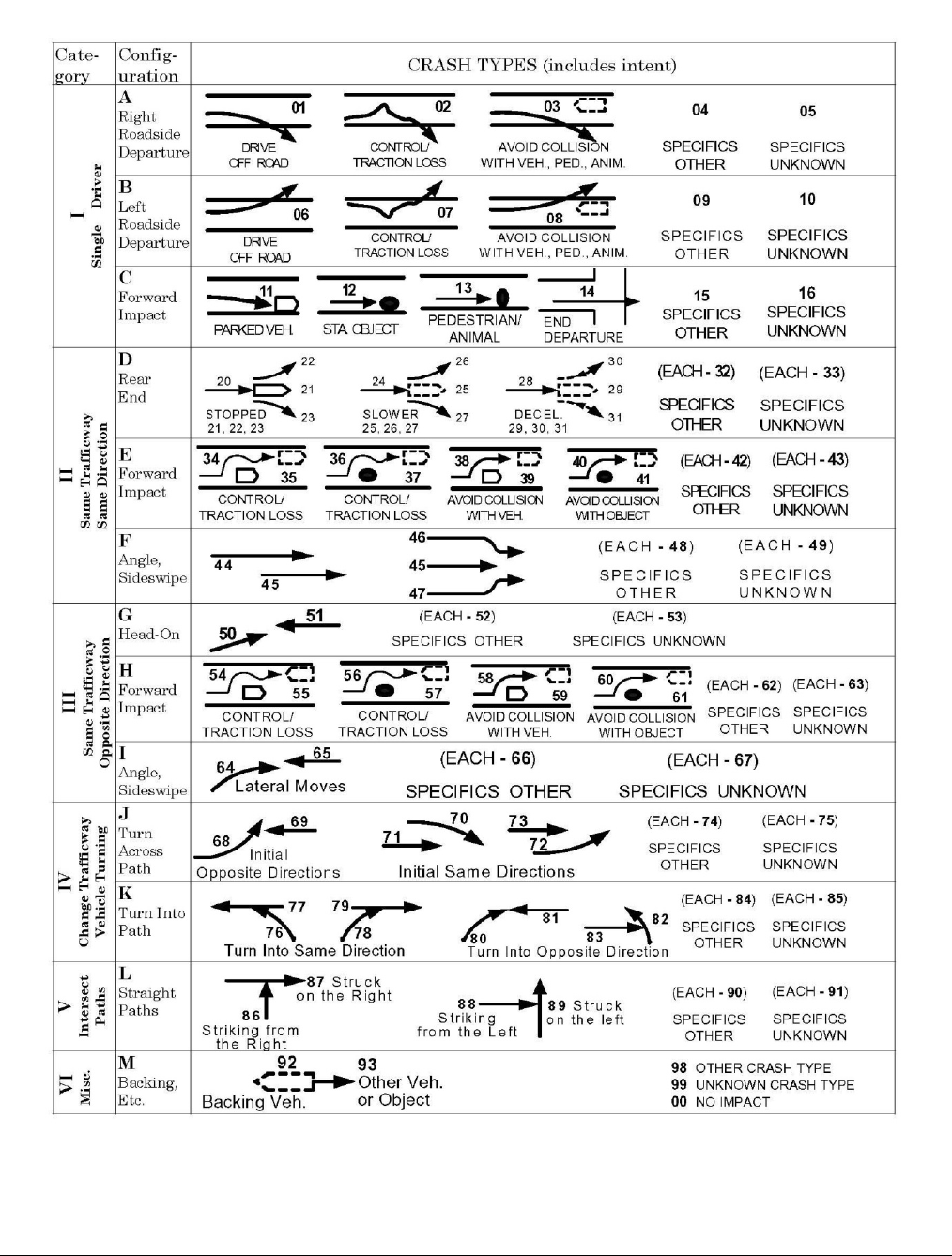2014 FARS/NASS GES Coding And Validation Manual 2015 FARS NASS C&V
User Manual:
Open the PDF directly: View PDF ![]() .
.
Page Count: 1076 [warning: Documents this large are best viewed by clicking the View PDF Link!]
- Crash vs. Accident
- 2015 Manual Changes
- Element Definitions
- List of Elements and Location Codes
- 100 Submission Instructions
- Coding Forms
- 200 Form Coding Instructions
- 300 Data Element Coding Instructions
- State Number (C1, V1, D1, PC1, P1, NM1)
- Consecutive Number (C2, V2, D2, PC2, P2, NM2)
- Crash Level
- C3 - Number of Forms Submitted for Persons Not in Motor Vehicles
- C4 - Number of Vehicle Forms Submitted
- C5 - Number of Motor Vehicle Occupant Forms Submitted
- C6 - County
- C7 - City
- C8 - Crash Date
- C9 - Crash Time
- C10 - Trafficway Identifier
- C11 - Route Signing
- C12 - Land Use and Functional System
- C13 - Ownership
- C14 - National Highway System
- C15 - Special Jurisdiction
- C16 - Milepoint
- C17 - Global Position
- C18 - Crash Events
- C19 - First Harmful Event
- C20 - Manner of Collision
- C21 - Relation to Junction
- C22 - Type of Intersection
- C23 - Relation to Trafficway
- C24 - Work Zone
- C25 - Light Condition
- C26 - Atmospheric Conditions
- C27 - School Bus Related
- C28 - Rail Grade Crossing Identifier
- C29 - Notification Time EMS
- C30 - Arrival Time EMS
- C31 - EMS Time at Hospital
- C32 - Related Factors - Crash Level
- C33 - Interstate Highway
- C34 - Stratum
- C35 - Police Jurisdiction
- Additional State Information
- Vehicle Level
- V3 - Vehicle Number - Vehicle Level
- V4 - Number of Occupants
- V5 - Unit Type
- V6 - Hit-and-Run
- V7 - Registration State
- V8 - Registered Vehicle Owner
- Vehicle Make/Vehicle Model Overview
- V9 - Vehicle Make
- V10 - Vehicle Model
- Alphabetical Listing of Makes
- Numerical Listing of Makes
- V11 - Body Type
- V12 - Vehicle Model Year
- V13 - Vehicle Identification Number
- V14 - Vehicle Trailing
- V15 - Jackknife
- V16 - Motor Carrier Identification Number
- V17 - GVWR/ GVCR
- V18 - Vehicle Configuration
- V19 - Cargo Body Type
- V20 - Hazardous Materials Involvment/Placard
- V21 - Bus Use
- V22 - Special Use
- V23 - Emergency Motor Vehicle Use
- V24 - Travel Speed
- V25 - Underride Override
- V26 - Rollover
- V27 - Location of Rollover
- V28 - Areas of Impact - Initital Contact Point / Damaged Areas
- V29 - Extent of Damage
- V30 - Vehicle Removal
- V31 - Sequence of Events
- V32 - Most Harmful Event
- V33 - Related Factors - Vehicle Level
- V34 - Fire Occurrence
- V35 - Vehicle License Plate Number
- Driver Level
- D3 - Vehicle Number - Driver Level
- D4 - Driver Presence
- D5 - Driver's License State
- D6 - Driver's Zip Code
- D7 - Non-CDL License Type / Status
- D8 - Commericial Motor Vehicle License Status
- D9 - Compliance with CDL Endorsements
- D10 - License Compliance with Class of Vehicle
- D11 - Compliance with License Restrictions
- D12 - Driver Height
- D13 - Driver Weight
- D14 - Previous Recorded Crashes
- D15 - Previous Recorded Suspensions and Revocations
- D16 - Previous DWI Convictions
- D17 - Previous Speeding Convictions
- D18 - Previous Other Moving Violation Convictions
- D19 - Date of First Crash, Suspension, Conviction
- D20 - Date of Last Crash, Suspension, Conviction
- D21 - Violations Charged
- D22 - Speeding Related
- D23 - Condition (Impairment) at Time of Crash
- D24 - Related Factors - Driver Level
- D25 - Driver License Number
- Precrash Data Overview
- Precrash Level
- PC3 - Vehicle Number - Precrash Level
- PC4 - Contributing Circumstances, Motor Vehicle
- PC5 - Trafficway Description
- PC6 - Total Lanes in Roadway
- PC7 - Speed Limit
- PC8 - Roadway Alignment
- PC9 - Roadway Grade
- PC10 - Roadway Surface Type
- PC11 - Roadway Surface Conditions
- PC12 - Traffic Control Device
- PC13 - Device Functioning
- PC14 - Driver's Vision Obscured By
- PC15 - Driver Maneuvered to Avoid
- PC16 - Driver Distracted By
- PC17 - Pre-Event Movement (Prior to Recognition of Critical Event)
- PC18 - Critical Event - Precrash (Category)
- PC19 - Critical Event - Precrash (Event)
- PC20 - Attempted Avoidance Maneuver
- PC21 - Pre-Impact Stability
- PC22 - Pre-Impact Location
- PC23 - Crash Type
- Person Level (MV Occupant)
- P3 - Vehicle Number - Person Level (MV Occupant)
- P4 - Person Number
- P5 - Age
- P6 - Sex
- P7 - Person Type
- P8 - Injury Severity
- P9 - Seating Position
- P10 - Restraint System/Helmet Use
- P11 - Any Indication of Mis-Use of Restraint System/Helmet Use
- P12 - Air Bag Deployed
- P13 - Ejection
- P14 - Ejection Path
- P15 - Extrication
- P16 - Police Reported Alcohol Involvement
- P17 - Method of Alcohol Determination by Police
- P18 - Alcohol Test
- P19 - Police Reported Drug Involvement
- P20 - Method of Drug Determination by Police
- P21 - Drug Test
- P22 - Transported to First Medical Facility By
- P23 - Died At Scene/En Route
- P24 - Death Date
- P25 - Death Time
- P26 - Related Factors - Person (MV Occupant) Level
- Person Level (Not a MV Occupant)
- NM3 - Person Number
- NM4 - Number of Motor Vehicle Striking Non-Motorist
- NM5 - Age
- NM6 - Sex
- NM7 - Person Type
- NM8 - Injury Severity
- NM9 - Pedestrian/ Bike Typing
- NM10 - Non-Motorist Location at Time of Crash
- NM11 - Non-Motorist Action/ Circumstances
- NM12 - Non-Motorist Contributing Circumstances
- NM13 - Non-Motorist Safety Equipment
- NM14 - Condition (Impairment) At Time of Crash
- NM15 - Police Reported Alcohol Inolvement
- NM16 - Method of Alcohol Determination by Police
- NM17 - Alcohol Test
- NM18 - Police Reported Drug Involvement
- NM19 - Method of Drug Determination by Police
- NM20 - Drug Test
- NM21 - Transported to First Medical Facility By
- NM22 - Died at Scene/En Route
- NM23 - Death Date
- NM24 - Death Time
- NM25 - Related Factors - Person (Not a Motor Vehicle Occupant) Level
- Supplemental
- Appendix

DOT HS 812 296 July 2016
2015 FARS/NASS GES
Coding and Validation
Manual
CRASH vs. ACCIDENT
The National Highway Traffic Safety Administration (NHTSA) has adopted the policy to
use the term, Crash. Accordingly the term, Crash, is used throughout this manual.
As used in this coding manual, “Crash” shall always refer to a Motor Vehicle Traffic
Accident as rigorously defined in ANSI Standard, D16.1 – The Manual on Classification
of Motor Vehicle Traffic Accidents. Incidents or scenarios involving collision events,
and those involving non-collision events, as defined in ANSI D16.1, are included.
Collision events include those involving a motor vehicle and fixed objects (poles, walls,
buildings, barriers, bridge supports, etc.) and those involving a motor vehicle and non-
fixed objects (pedestrians, animals, pedal cyclists, other motor vehicles, etc).
Besides scenarios involving a collision, a crash also shall include non-collision
scenarios such as the following:
• A single motor vehicle on a roadway catches fire
• A motor vehicle runs off of a trafficway and is immersed in a body of water
• An occupant of a motor vehicle is injured by falling from that vehicle while it is in
motion or on a roadway
• An occupant of a motor vehicle is injured by shifting cargo or flying objects within
that vehicle during emergency handling / braking
• A vehicle suffers damage from a pavement irregularity (loose plate, high
manhole, pot hole, etc)
• And others
Consult ANSI D16.1, Manual on Classification of Motor Vehicle Traffic Accidents (The
ANSI Manual) for a more precise and complete presentation of these concepts. As a
minimum, the following ANSI D16.1 terms should be well understood to properly select
and classify cases for FARS and GES. The paragraph reference numbers from the
ANSI Manual are provided to aid look-up.
2.2.1 Trafficway 2.4.9 Transport Accident
2.4.1 Harmful Event 2.4.12 Motor Vehicle Accident
2.4.2 Deliberate Intent 2.4.17 Road Vehicle Accident
2.4.3 Legal Intervention 2.4.18 Traffic Accident
2.4.4 Unstabilized Situation 2.4.22 Motor Vehicle Traffic Accident
2.4.5 Cataclysm 2.4.27 Fatal Accident
2.4.6 Accident

s
l
(
(
2015 FARS / NASS GES MANUAL CHANGES SUMMARY
Below is a list of elements that have substantial changes for 2015. These changes, as well as others, are
highlighted throughout the manual by bold/italic type.
IT IS RECOMMENDED THAT YOU REVIEW THE ENTIRE MANUAL FOR ALL CHANGES
ELEMENT # ELEMENT
NAME
NEW/
REVISED
VALUES
NEW/
REVISED
REMARKS COMMENTS
C5 Number of
Motor Vehicle
Occupant
Forms
Submitted
X Updated remarks clarifying person level form
ubmission for Bus and Train occupants.
Updated remarks regarding coding person
evel forms for all occupants of a vehicle.
C8 Crash Time X Added remarks clarifying the coding of
CRASH TIME.
New C10
Old C13 Trafficway
Identifier Moved Element from C13 to C10.
C11 Roadway
Function Class Deleted Element.
New C11
Old C12 Route Signing Moved Element from C12 to C11.
C12 a/b Land Use and
Functional
System (FARS
Only)
X X
Added new element - format - 2 subfields, 1
numeric occurring 1 time and 2 numeric
occurring 1 time.
Added new attributes for Land Use (a): 1
Rural), 2 (Urban), 6 (Trafficway Not in
State Inventory), 8 (Not Reported) and 9
Unknown).
Added new attributes for Functional System
(b): 01 (Interstate), 02 (Principal Arterial –
Other Freeways and Expressways), 03
(Principal Arterial – Other), 04 (Minor
Arterial), 05 (Major Collector), 06 (Minor
Collector), 07 (Local), 96 (Trafficway Not in
State Inventory), 98 (Not Reported), and 99
(Unknown).

ELEMENT # ELEMENT
NAME
NEW/
REVISED
VALUES
NEW/
REVISED
REMARKS COMMENTS
New C13 Ownership
(FARS Only) X X
Added new element - format - 2 numeric.
Added attributes: 01 (State Highway
Agency), 02 (County Highway Agency), 03
(Town or Township Highway Agency), 04
(City or Municipal Highway Agency), 11
(State Park, Forest or Reservation
Agency), 12 (Local Park, Forest or
Reservation Agency), 21 (Other State
Agency), 25 (Other Local Agency), 26
(Private [other than Railroad]), 27
(Railroad), 31 (State Toll Road), 32 (Local
Toll Authority), 40 (Other Public
Instrumentality [i.e., Airport]), 50 (Indian
Tribe Nation), 60 (Other Federal Agency),
62 (Bureau of Indian Affairs), 63 (Bureau of
Fish and Wildlife), 64 (U.S. Forest Service),
66 (National Park Service), 67 (Tennessee
Valley Authority), 68 (Bureau of Land
Management), 69 (Bureau of Reclamation),
70 (Corps of Engineers), 72 (Air Force), 74
(Navy/Marines), 80 (Army), 96 (Trafficway
Not in State Inventory), 98 (Not Reported)
and 99 (Unknown).
New C14
Old C10 National
Highway
System
Moved Element from C10 to C14.
New C15
Old C16 Special
Jurisdiction Moved Element from C16 to C15.
New C16
Old C14 Milepoint Moved Element from C14 to C16.
New C17
Old C15 Global Position Moved Element from C15 to C17.
New C18
Old C17 Crash Events X Moved Element from C17 to C18.
Updated Remarks for attributes: 07 (Other
Non-Collision), 18 (Other Object [Not Fixed]),
34 (Ditch), 35 (Embankment), 42 (Tree
[Standing Only]), 44 (Pavement Surface
Irregularity [ruts, potholes, grates, etc.]), 58
(Ground), 54 (Collision with Motor Vehicle In-
Transport Strikes or is Struck by Cargo,
Persons or Objects Set-in-Motion from/by
Another Motor Vehicle In-Transport), 60
(Cargo/Equipment Loss or Shift), 72
(Cargo/Equipment Loss or Shift [harmful to
this vehicle]) and 73 (Object Fell From Motor
Vehicle In-Transport).

ELEMENT # ELEMENT
NAME
NEW/
REVISED
VALUES
NEW/
REVISED
REMARKS COMMENTS
Added a remark regarding the coding of non-
specific harmful events.
Added remarks regarding the coding of
damaged property on the PAR.
New C19
Old C18 First Harmful
Event X
Moved Element from C18 to C19.
Updated Remarks for attributes: 07 (Other
Non-Collision), 18 (Other Object [Not Fixed]),
34 (Ditch), 35 (Embankment), 42 (Tree
[Standing Only]), 44 (Pavement Surface
Irregularity [ruts, potholes, grates, etc.]), 54
(Collision with Motor Vehicle In-Transport
Strikes or is Struck by Cargo, Persons or
Objects Set-in-Motion from/by Another Motor
Vehicle In-Transport), 58 (Ground) and 73
(Object Fell From Motor Vehicle In-Transport).
Added a remark regarding the coding of non-
specific harmful events.
New C20
Old C19 Manner of
Collision X
Updated remarks for attribute - 11 (Other).
Moved Element from C19 to C20.
New C21
Old C20 Relation to
Junction Moved Element from C20 to C21.
New C22
Old C21 Type of
Intersection Moved Element from C21 to C22.
New C23
Old C22 Relation to
Trafficway Moved Element from C22 to C23.
New C24
Old C23 Work Zone Moved Element from C23 to C24.
New C25
Old C24 Light Condition X Updated remarks for attribute - 7 (Other).
Moved Element from C24 to C25.
New C26
Old C25 Atmospheric
Conditions X
Updated remarks for attribute - 08 (Other).
Added remarks clarifying the coding of the
attribute "Cloudy" and handling of
"Temperature indication" within the case
materials.
Moved Element from C25 to C26.
New C27
Old C26 School Bus
Related Moved Element from C26 to C27.
New C28
Old C27 Rail Grade
Crossing
Identifier
Moved Element from C27 to C28.

ELEMENT # ELEMENT
NAME
NEW/
REVISED
VALUES
NEW/
REVISED
REMARKS COMMENTS
New C29
Old C28 Notification
Time EMS X
Updated remarks for attribute: 8888 (Not
Applicable [Not Notified]).
Moved Element from C28 to C29.
New C30
Old C29 Arrival Time
EMS
Moved Element from C29 to C30.
New C31
Old C30 EMS Time at
Hospital
Moved Element from C30 to C31.
New C32
Old C31 Related Factors
- Crash Level X
Updated remarks and manual layout for this
element.
Moved Element from C31 to C32.
New C33
Old C32 Interstate
Highway
Moved Element from C32 to C33.
New C34
Old C33 Stratum Moved Element from C33 to C34.
New C35
Old C34 Police
Jurisdiction
Moved Element from C34 to C35.
V4 Number of
Occupants X
Updated remarks regarding injured/non-
injured information gathered by states.
Updated remarks regarding bus and railway
vehicle occupants.
V7 Registration
State X
Updated remarks for attribute - 98 (Other
Registration).
V16 Motor Carrier
Identification
Number
X
Added remarks to attribute: 88/8s (None).
V17 Gross Vehicle
Weight Rating X
Updated remarks regarding references of
PCVINA to reflect MDE change to
VINDecoder.
V18 Vehicle
Configuration X
Added remarks to attribute: 19 (Truck More
than 10,000lbs, Cannot Classify).
V19 Cargo Body
Type X
Added remarks to attribute: 96 (No Cargo
Body Type).
V22 Special Use X
Updated remarks for definition.

ELEMENT # ELEMENT
NAME
NEW/
REVISED
VALUES
NEW/
REVISED
REMARKS COMMENTS
V28 Areas of Impact
- Initial Impact /
Most Damaged
Areas
X
Updated remarks to attribute: 14
(Undercarriage) (for Initial Impact Only).
Updated remarks for Damaged Areas
(Subfield 2) definition.
V31 Sequence of
Events X
Updated remarks for attributes: 07 (Other
Non-Collision), 18 (Other Object [Not Fixed]),
34 (Ditch), 35 (Embankment), 42 (Tree
[Standing Only]), 44 (Pavement Surface
Irregularity [ruts, potholes, grates, etc.]), 54
(Collision with Motor Vehicle In-Transport
Strikes or is Struck by Cargo, Persons or
Objects Set-in-Motion from/by Another Motor
Vehicle In-Transport), 58 (Ground), 60
(Cargo/Equipment Loss or Shift), 72,
(Cargo/Equipment Loss or Shift [harmful to
this vehicle]) and 73 (Object Fell From Motor
Vehicle In-Transport).
Added a remark regarding the coding of non-
specific harmful events.
V32 Most Harmful
Event X
Updated remarks for attributes: 07 (Other
Non-Collision), 12 (Collision with a Motor
Vehicle In-Transport), 18 (Other Object [Not
Fixed]), 34 (Ditch), 35 (Embankment), 42
(Tree [Standing Only]), 44 (Pavement
Surface Irregularity [ruts, potholes, grates,
etc.]), 54 (Collision with Motor Vehicle In-
Transport Strikes or is Struck by Cargo,
Persons or Objects Set-in-Motion from/by
Another Motor Vehicle In-Transport), 58
(Ground) and 73 (Object Fell From Motor
Vehicle In-Transport).
Added a remark regarding the coding of non-
specific harmful events.
Updated Remarks for coding hierarchy.
Added Remarks regarding procedures for
coding Parked and Working Motor Vehicles.
V33 Related Factors
- Vehicle Level X
Updated Remarks and manual layout for this
element.
D4 Driver Presence X Delete Remarks from the beginning of this
element: "If coded 0 (No Driver Present/Not
Applicable) or 9 (Unknown), Related
Factors-Driver Level are coded “00”.
D14 Previous
Recorded
Crashes
X
Changed qualifying events time period from
the previous three years to the previous
five years.

ELEMENT # ELEMENT
NAME
NEW/
REVISED
VALUES
NEW/
REVISED
REMARKS COMMENTS
D15 Previous
Recorded
Suspensions
and
Revocations
X
Changed qualifying events time period from
the previous three years to the previous
five years.
D16 Previous DWI
Convictions X
Changed qualifying events time period from
the previous three years to the previous
five years.
D17 Previous
Speeding
Convictions
X
Changed qualifying events time period from
the previous three years to the previous
five years.
D18 Change
Previous Other
Harmful MV
Conviction to
Previous Other
Moving
Violation
Convictions
X
Changed Element Name.
Changed qualifying events time period from
the previous three years to the previous
five years.
Added remarks regarding non-traffic related
issues or offenses.
D19 Date of First
Crash,
Suspension,
Conviction
X
Changed qualifying events time period from
the previous three years to the previous
five years.
Added remarks regarding non-traffic related
issues or offenses.
D20 Date of Last
Crash,
Suspension,
Conviction
X
Changed qualifying events time period from
the previous three years to the previous
five years.
Added remarks regarding non-traffic related
issues or offenses.
D21 Violations
Charged X Added new attribute: 10 (Use of
Telecommunications Device).
D24 Related Factors
- Driver Level X X
Updated remarks and manual layout for this
element.
Updated attributes: 28 (Failure to Keep in
Proper Lane Improper Lane Usage), 33
(Passing Where Prohibited by Posted Signs,
Pavement Markings, Hill or Curve, or School
Bus Displaying Warning Not to Pass), 34
(Passing on Wrong Right Side), 36
(Operating the Vehicle in an Erratic, Reckless
or Negligent Manner Operating at Erratic or
Suddenly Changing Speeds) and 59
(Getting Off/Out of or On/In to a Vehicle).
Deleted attribute: 57 (Locked Wheel).

ELEMENT # ELEMENT
NAME
NEW/
REVISED
VALUES
NEW/
REVISED
REMARKS COMMENTS
Updated Note at the beginning of the remarks
section regarding the coding of this element.
PC6 Total Lanes in
Roadway X
Added remarks regarding counting
channelized lanes.
Added diagrams for channelized lanes.
PC7 Speed Limit X Added new attributes to range: 05-80 95
Actual Speed Limit (in 5 mph increments)
PC8 Roadway
Alignment X
Added remarks regarding hierarchy for coding
this element.
PC10 Roadway
Surface Type X
Added remarks to attribute: 7 (Other).
PC11 Roadway
Surface
Conditions
X
Added remarks to attribute: 08 (Other)
PC12 Traffic Control
Device X
Added examples to attribute: 28 (Other
Regulatory Signs) and 98 (Other).
PC17 Pre-Event
Movement
(Prior to
Recognition of
Critical Event)
X
Updated remarks to attributes: 08 (Leaving a
Parking Position), 09 (Entering a Parking
Position), 10 (Turning Right), 11 (Turning
Left), 12 (Making a U-Turn) and 13 (Backing
Up [Other Than for Parking]).
PC19 Critical Event -
Precrash
(Event)
X X
Modify attribute name: 52 (Traveling in Same
Direction With Lower or Steady Speed).
Added remarks for attributes: 05 (Poor Road
Conditions [Puddle, Pot Hold, Ice, Etc.]
[Specify:]), 52 (Traveling in Same Direction
While Decelerating) and 80 (Pedestrian in
Road).
Updated remarks under Pedestrian or
Pedalcyclist or Other Non-Motorist.
PC21 Pre-Impact
Stability X
Added remarks for attributes: 2 (Skidding
Longitudinally Rotation Less Than 30
degrees), 7 (Other Vehicle Loss-of-Control
[Specify:]) and 9 (Precrash Stability
Unknown).
PC23 Crash Type X Updated remarks for attributes: 02 (Right
Roadside Departure: Control/Traction Loss),
07 (Left Roadside Departure: Control/Traction
Loss) and 13 (Forward Impact: Pedestrian/
Animal).

ELEMENT # ELEMENT
NAME
NEW/
REVISED
VALUES
NEW/
REVISED
REMARKS COMMENTS
P9 Seating
Position X
Updated Seating Position Diagram for Van-
Based Bus.
Updated remarks for seating position for
motorcycles.
Updated remarks for attribute: 11 (Front Seat,
Left Side).
P10 Restraint
System /
Helmet Use
X
Added remarks to attribute: 97 (Other).
P13 Ejection X Added remarks explaining ejection.
P14 Ejection Path X X Modify attribute and remarks: 0 (Not
Ejected/Not Applicable) to (Ejection Path
Not Applicable) and 9 (Unknown/Unknown
Path) to (Ejection Path Unknown).
P17 Method of
Alcohol
Determination
by Police
X
Updated remarks for attribute: 1 (Evidential
Test [breath, blood, urine]).
Added remarks to attribute: 8 (Other [e.g.,
Saliva Test]).
P18 Alcohol Test X X Format change: From 3 sets, 1 set, 1
numeric, 1 set, 2 numeric to 3 sets, 1 set, 1
numeric, 1 set, 2 numeric, 1 set, 3 numeric.
Modify attribute name (Subfield 2): 02 (
Breathalyzer [BAC]) to (Breath Test [AC]).
Modify attribute numbering (Subfield 3) from 2
digit to 3 digit: 000-930 (Actual Value), 940
(.94 or Greater), 996 (Test Not Given), 997
(AC Test Performed, Results Unknown), 998
(Positive Reading with No Actual Value), 995
(Not Reported) and 999 (Unknown if Tested).
Updated remarks for Alcohol Test Coding
Hierarchy.
Added remarks to attribute: 08 (Other Test
Type).
P20 Method of Drug
Determination
by Police
X
Updated remarks for attribute: 1 (Evidential
Test [blood, urine]).
Added remarks to attribute: 7 (Other).
P21 Drug Test X Added remarks to attribute: 8 (Other Test
Type).
P22 Transported to
First Treatment
Facility By
X
Updated remarks for attribute: 0 (Not
Transported) and 6 (Other).
Added clarification for cases when the person
is moved to a safer location.

ELEMENT # ELEMENT
NAME
NEW/
REVISED
VALUES
NEW/
REVISED
REMARKS COMMENTS
P26 Related Factors
- Person MV
Occupant Level
X X
Updated remarks and manual layout for this
element.
Updated attributes: 28 (Failure to Keep in
Proper Lane Improper Lane Usage), 29
(Intentional Illegal Driving on Road Shoulder,
in Ditch, on Sidewalk or on Median), 33
(Passing Where Prohibited by Posted Signs,
Pavement Markings, Hill or Curve, or School
Bus Displaying Warning Not to Pass Line)
and 82 (Pedestrian, Pedal Cyclists or
Persons on Personal Conveyances Other
Non-Motorist).
Deleted Attribute: 58 (Locked Wheel).
NM9 Pedestrian/
Bike Typing -
Pedestrian
Position
X
Updated remarks for attribute: 2 (Crosswalk
Area).
Added diagram for unmarked crosswalk
areas.
NM9 Pedestrian/
Bike Typing -
Pedestrian
Crash Type
X
Updated remarks for attributes: 250 (Play
Vehicle-Related), 760 (Pedestrian Failed to
Yield) and 770 (Motorist Failed to Yield) [Not
at Intersection Only].
NM10 Non-Motorist
Location at
Time of Crash
X
Added remarks to attribute: 28 (Other).
NM13 Non-Motorist
Safety
Equipment
X
Updated remarks and attributes: 3 -
Reflective Equipment/Clothing (jacket,
backpack, etc) and Protective Pads Used
(elbows, knees, shins, etc.).
Added remarks to attribute: 1 (None Used), 2
(Helmet), 7 (Other Safety Equipment) and 9
(Unknown if Used).
Added coding guidance worksheet with
instructions for use.
NM16 Method of
Alcohol
Determination
by Police
X
Updated remarks for attribute: 1 (Evidential
Test [breath, blood, urine]).
Added remarks to attribute: 8 (Other [e.g.,
Saliva Test]).
NM17 Alcohol Test X X Format change: From 3 sets, 1 set, 1
numeric, 1 set, 2 numeric to 3 sets, 1 set, 1
numeric, 1 set, 2 numeric, 1 set, 3 numeric.
Modify attribute name (Subfield 2): 02 (
Breathalyzer [BAC]) to (Breath Test [AC]).
Modify attribute numbering (Subfield 3) from 2
digit to 3 digit: 000-930 (Actual Value), 940
(.94 or Greater), 996 (Test Not Given), 997
(AC Test Performed, Results Unknown), 998

ELEMENT # ELEMENT
NAME
NEW/
REVISED
VALUES
NEW/
REVISED
REMARKS COMMENTS
(Positive Reading with No Actual Value), 995
(Not Reported) and 999 (Unknown if Tested).
Updated remarks for Alcohol Test Coding
Hierarchy.
Added remarks to attribute: 08 (Other Test
Type).
NM19 Method of Drug
Determination
by Police
X
Updated remarks for attribute: 1 (Evidential
Test [blood, urine]).
Added remarks to attribute: 7 (Other).
NM20 Drug Test X Added remarks to attribute: 8 (Other Test
Type).
NM21 Transported to
First Treatment
Facility By
X
Updated remarks for attribute: 0 (Not
Transported) and 6 (Other).
Added clarification for cases when the person
is moved to a safer location.
NM25 Related Factors
- Person Not a
MV Occupant
Level
X X
Updated remarks and manual layout for this
element.
Updated Attribute: 82 (Pedestrian, Pedal
Cyclists or Persons on Personal
Conveyances Other Non-Motorist).
NEED HELP IN CODING? CONTACT NISR AT: codingquestions@nisrinc.com

2015 FARS/NASS GES Element Definitions
2015
Element
Number
Element Name FARS, GES,
Case
Structure
Definitions
CRASH LEVEL ELEMENTS
C1 State Number FARS Only This element identifies the state in
which the crash occurred.
C2 Consecutive Number FARS Only This element identifies the unique
case number assigned by the data
entry system.
C3 Number of Forms
Submitted for Persons
Not in MV
Case
Structure This element records the number of
Person Forms (Not a Motor Vehicle
Occupant) that are applicable to this
case.
C4 Number of Vehicle Forms
Submitted Case
Structure This element records all contact
motor vehicles which the officer has
reported on the Police Accident
Report (PAR) as a unit involved in
the crash.
C5 Number of Person Forms
Submitted Case
Structure This element records the number of
Person Forms (Motor Vehicle
Occupant) that are applicable to this
case.
C6 County FARS Only This element refers to the location of
the unstabilized event with regard to
the County.
C7 City FARS Only This element refers to the location of
the unstabilized event with regard to
the City.
C8 Crash Date FARS/GES This element identifies the date on
which the crash occurred.
C9 Crash Time FARS/GES This element identifies the time at
which the crash occurred.
C10 Trafficway Identifier FARS Only This element captures the identity
(name) of the trafficway on which the
crash occurred.
C11 Route Signing FARS Only This element identifies the route
signing of the trafficway on which the
crash occurred.

2015
Element
Number
Element Name FARS, GES,
Case
Structure
Definition
C12 (a/b) Land Use and
Functional System FARS Only Land Use: The classification of
the segment of the trafficway on
which the crash occurred based
on FHWA-approved adjusted
Census boundaries of small
urban and urbanized areas.
Functional System: This element
identifies the functional
classification of the segment of
the trafficway on which the crash
occurred.
C13 Ownership FARS Only This element identifies the entity
that has legal ownership of the
segment of the trafficway on
which the crash occurred.
C14 National Highway System FARS Only This element identifies whether or
not this crash occurred on a
trafficway that is part of the National
Highway System.
C15 Special Jurisdiction FARS Only This element identifies if the location
on the trafficway where the crash
occurred qualifies as a Special
Jurisdiction even though it may be
patrolled by state, county or local
police (e.g., all State highways
running through Indian reservations
are under the jurisdiction of the
Indian reservation).
C16 Milepoint FARS Only This element identifies the milepoint
nearest to the location where the
crash occurred.
C17 Global Position FARS Only This element identifies the location
of the crash using Global Position
coordinates.
C18 Crash Events FARS/GES The Crash Events table records in
chronological sequence, the set of
events resulting from an unstabilized
situation that constitutes a motor
vehicle traffic crash.
C19 First Harmful Event FARS/GES The First Harmful Event is defined
as the first injury or damage
producing event of the crash.

2015
Element
Number
Element Name FARS, GES,
Case
Structure
Definition
C20 Manner of Collision FARS/GES This element identifies the
orientation of two motor vehicles in-
transport when they are involved in
the First Harmful Event of a collision
crash. If the First Harmful Event is
not a collision between two motor
vehicles in-transport it is classified
as such.
C21 (a/b) Relation to Junction FARS/GES The coding of this data element is
done in two subfields and based on
the location of the first harmful event
of the crash. It identifies the crash's
location with respect to presence in
an interchange area and the crash’s
location with respect to presence in
or proximity to components typically
in junction or interchange areas.
C21 Type of Intersection FARS/GES This element identifies and allows
separation of various intersection
types.
C22 Relation to Trafficway FARS/GES This element identifies the location
of the crash as it relates to its
position within or outside the
trafficway based on the First Harmful
Event.
C23 Work Zone FARS/GES This data element captures that this
was a “Work Zone Accident” as
defined in ANSI D16.1, 7th Edition.
If the crash qualifies as a "Work
Zone Accident" then the type of work
activity is identified.
C24 Light Condition FARS/GES This element records the type/level
of light that existed at the time of the
crash as reported in the case
materials.
C25 Atmospheric Condition FARS/GES This element identifies the prevailing
atmospheric conditions that existed
at the time of the crash as recorded
on the crash report form.
C26 School Bus Related FARS/GES This data element indicates if a
school bus, or motor vehicle
functioning as a school bus, is
related to the crash.

2015
Element
Number
Element Name FARS, GES,
Case
Structure
Definition
C27 Rail Grade Crossing
Identifier FARS Only This element identifies if the crash
occurred in or near a Rail Grade
Crossing.
C28 Notification Time EMS FARS Only Notification Time EMS is the time
Emergency Medical Service was
notified.
C29 Arrival Time EMS FARS Only Arrival Time Ems is the time
Emergency Medical Service arrived
on the crash scene.
C30 EMS Time at Hospital FARS Only EMS Time At Hospital is the time
Emergency Medical Service arrived
at the treatment facility to which it
was transporting victims of the
crash.
C31 Related Factors - Crash
Level FARS/GES This element identifies factors
related to the crash expressed by
the investigating officer.
C32 Interstate Highway GES Only This element identifies whether or
not the crash occurred on an
interstate highway. Interstate
highway is a Federal Highway
Administration classification.
C33 Stratum GES Only The number of the category in which
the PAR was originally listed in GES
PAR Program or Stratification
Record.
C34 Police Jurisdiction GES Only The number (range 1 through 120)
of the police jurisdiction from which
the PAR was originally sampled.
VEHICLE LEVEL ELEMENTS
V1 State Number FARS Only This element identifies the state in
which the crash occurred.
V2 Consecutive Number FARS Only This element identifies the unique
case number assigned by the data
entry system.
V3 Vehicle Number Case
Structure
FARS/GES
This element identifies the number
assigned to this vehicle in the crash.
V4 Number of Occupants FARS/GES This element identifies the number
of occupants in each vehicle.

2015
Element
Number
Element Name FARS, GES,
Case
Structure
Definition
V5 Unit Type FARS/GES
(handled thru
PV element)
This element identifies the type of
unit that applies to this motor vehicle
at the time it became an involved
vehicle in the crash and was
reported as a unit on the Police
Accident Report (PAR).
V6 Hit-And-Run FARS/GES This element refers to cases where
a vehicle is a contact vehicle in the
crash and does not stop to render
aid (this can include drivers who flee
the scene on foot).
V7 Registration State FARS Only This element identifies the state in
which this vehicle was registered.
V8 Registered Vehicle
Owner FARS Only This element is used to determine
the type of registered owner of the
vehicle.
V9 Vehicle Make FARS/GES This element identifies the make
(manufacturer) of this vehicle.
V10 Vehicle Model FARS/GES This element identifies the model of
this vehicle within a given make.
V11 Body Type FARS/GES This element identifies a
classification of this vehicle based
on its general body configuration,
size, shape, doors, etc.
V12 Vehicle Model Year FARS/GES This element identifies the
manufacturer's model year of this
vehicle.
V13 Vehicle Identification
Number FAR/GES This element records the vehicle
identification number (VIN) of this
vehicle.
V14 Vehicle Trailing FARS/GES This element identifies whether or
not this vehicle had any attached
trailing units or was towing another
motor vehicle.
V15 Jackknife FARS/GES This element identifies if this vehicle
experienced a "jackknife" anytime
during the unstabilized situation.
V16 Motor Carrier
Identification Number FARS/GES This element records the issuing
authority and motor carrier
identification number if applicable to
this vehicle.

2015
Element
Number
Element Name FARS, GES,
Case
Structure
Definition
V17 GVWR/GCWR FARS/GES This element identifies the gross
vehicle weight rating of this vehicle
when applicable.
V18 Vehicle Configuration FARS/GES This element identifies the general
configuration of this vehicle when
applicable.
V19 Cargo Body Type FARS/GES This element identifies the primary
cargo carrying capability of this
vehicle when applicable.
V20 Hazardous Material
Involvement/Placard FARS/GES This element identifies the presence
of hazardous cargo for this vehicle
and records information about the
hazardous cargo when present.
V20 (1) Hazardous Material
Involvement/Placard -
HM1
FARS/GES This element indicates whether the
vehicle was carrying hazardous
materials - involvement.
V20 (2) Hazardous Material
Involvement/Placard -
HM2
FARS/GES This element indicates the presence
of hazardous materials and whether
the vehicle displayed a hazardous
materials placard.
V20 (3) Hazardous Material
Involvement/Placard -
HM3
FARS/GES This element indicates the 4-digit
identification number.
V20 (4) Hazardous Material
Involvement/Placard -
HM4
FARS/GES This element indicates the single-
digit hazardous material class
number for the vehicle.
V20 (5) Hazardous Material
Involvement/Placard -
HM5
FARS/GES This element indicates whether or
not any hazardous cargo was
released from the cargo tank or
compartment.
V21 Bus Use FARS/GES This data element describes the
common type of bus service this
vehicle was being used for at the
time of the crash or the primary use
for the bus if not in service at the
time of the crash.
V22 Special Use FARS/GES This data element identifies if a
special use is applicable to this
vehicle at the time it was involved
in the crash.

2015
Element
Number
Element Name FARS, GES,
Case
Structure
Definition
V23 Emergency Motor
Vehicle Use FARS/GES Emergency Motor Vehicle Use
indicates operation of any motor
vehicle that is legally authorized by a
government authority to respond to
emergencies with or without the use
of emergency warning equipment,
such as a police vehicle, fire truck or
ambulance while actually engaged in
such response.
V24 Travel Speed FARS/GES This element records the speed the
vehicle was traveling prior to the
occurrence of the crash as reported
by the investigating officer.
V25 Underride/Override FARS Only This element indicates whether an
underride or override occurred
during the crash involving this
vehicle.
V26 Rollover FARS/GES This element identifies whether a
rollover or overturn occurred during
the crash involving this vehicle.
V27 Location of Rollover FARS/GES This element identifies the location
of the trip point or start of the
vehicle's roll.
V28 Areas of Impact - Initial
Contact Point FARS/GES This subfield identifies the area on
this vehicle that produced the first
instance of injury to non-motorists or
occupants of this vehicle, or that
resulted in the first instance of
damage to other property or to this
vehicle.
V28 Areas of Impact -
Damaged Areas FARS/GES This subfield identifies all the areas
on this vehicle that were damaged in
the crash as reflected in the case
materials.
V29 Extent of Damage FARS/GES This element indicates the amount of
damage sustained by this vehicle in
this crash as indicated in the case
materials based on an operational
damage scale.
V30 Vehicle Removal FARS/GES This data element describes the
mode in which the vehicle left the
scene of the crash.

2015
Element
Number
Element Name FARS, GES,
Case
Structure
Definition
V31 Sequence of Event FARS/GES The events in sequence related to
this motor vehicle, regardless of
injury and/or property damage. Code
each event for this vehicle in the
order in which they occur, time wise,
from the Police Accident Report
(PAR) narrative and diagram.
V32 Most Harmful Event FARS/GES This element identifies the event that
resulted in the most severe injury or,
if no injury, the greatest property
damage involving this motor vehicle.
V33 Related Factors - Vehicle
Level FARS/GES This element identifies factors
related to this vehicle expressed by
the investigating officer.
V34 Fire Occurrence FARS/GES This element identifies whether or
not a fire in any way related to the
crash occurred in this vehicle.
DRIVER LEVEL ELEMENTS
D1 State Number FARS Only This element identifies the state in
which the crash occured.
D2 Consecutive Number FARS Only This element identifies the unique
case number assigned by the data
entry system.
D3 Vehicle Number - Driver
Level Case
Structure This element identifies the vehicle
number associated with this driver.
D4 Driver Presence FARS/GES This element identifies whether or
not a driver was present in this
vehicle at the onset of the
unstabilized situation.
D5 Driver’s License Number FARS Only This element identifies the state of
issue for the license held by this
driver.
D6 Driver’s Zip Code FARS/GES This element identifies the zip code
of this driver's area of residence.
D7 Non-CDL License
Type/Status FARS Only This element identifies in two
subfields the type license held by
this driver and the status of the
license at the time of the crash.

2015
Element
Number
Element Name FARS, GES,
Case
Structure
Definition
D8 Commercial Motor
Vehicle License Status FARS Only This element indicates the status for
a driver’s Commercial Driver’s
License (CDL) if applicable.
D9 Compliance with License
Endorsements FARS Only This element indicates whether the
vehicle driven at the time of the
crash requires endorsement(s) on a
Commercial Driver’s License (CDL)
and whether this driver is complying
with the CDL endorsements.
D10 License Compliance with
Class of Vehicle FARS Only This element refers to the type of
license possessed or not possessed
by the driver for the class of vehicle
being driven at the time of the crash.
D11 Compliance with License
Restrictions FARS Only This element identifies if a driver
was compliant with restrictions on
their license.
D12 Driver Height FARS Only This element identifies a driver's
height.
D13 Driver Weight FARS Only This element identifies a driver's
weight.
D14 Previous Recorded
Crashes FARS Only This element records any previous
crashes for this driver. Counts only
events occurring within three years
from the crash date.
D15 Previous Recorded
Suspensions and
Revocations
FARS Only This element records any previous
license suspensions or revocations
for this driver. Counts only events
occurring within three years from the
crash date.
D16 Previous DWI
Convictions FARS Only This element records any previous
DWI convictions for this driver.
Counts only events occurring within
three years from the crash date.
D17 Previous Speeding
Convictions FARS Only This element records any previous
Speeding convictions for this driver.
Counts only events occurring within
three years from the crash date.
D18 Previous Other Moving
Violation Convictions FARS Only This element records any other
previous moving violations or
convictions for this driver. Counts
only events occurring within three
years from the crash date.

2015
Element
Number
Element Name FARS, GES,
Case
Structure
Definition
D19 Date of FIRST Crash,
Suspension, Conviction FARS Only This element identifies the date of
the first crash, suspension, or
conviction. Counts only dates of
events occurring within three years
from the crash date.
D20 Date of LAST Crash,
Suspension, Conviction FARS Only This element identifies the date of
the last crash, suspension, or
conviction. Counts only dates of
events occurring within three years
from the crash date.
D21 Violations Charged FARS/GES This element identifies all violations
charged to this driver in this crash.
D22 Speeding Related FARS/GES This element identifies if the driver's
speed was related to the crash as
identified by law enforcement.
D23 Condition (Impairment) at
Time of Crash FARS/GES This element identifies physical
impairments to this driver or non-
motorist which may have contributed
to the cause of the crash as
identified by law enforcement.
D24 Related Factors - Driver
Level FARS/GES This element identifies factors
related to this driver expressed by
the investigating officer.
PRECRASH LEVEL ELEMENTS
PC1 State Number FARS Only This element identifies the state in
which the crash occurred.
PC2 Consecutive Number FARS Only This element identifies the unique
case number assigned by the data
entry system.
PC3 Vehicle Number -
Precrash Level Case
Structure This element identifies the number
assigned to this vehicle in the crash.
PC4 Contributing
Circumstances, Motor
Vehicle
FARS/GES This element describes the possible
pre-existing motor vehicle defects or
maintenance conditions that may
have contributed to the crash.

2015
Element
Number
Element Name FARS, GES,
Case
Structure
Definition
PC5 Trafficway Description FARS/GES This element identifies the value
indicated in the case materials which
best describes the trafficway flow
just prior to this vehicle’s critical
precrash event.
PC6 Total Lanes in Roadway FARS/GES This element identifies the value
indicated in the case materials which
best describes the number of travel
lanes just prior to this vehicle’s
critical precrash event.
PC7 Speed Limit FARS/GES This element identifies the value
indicated in the case materials which
best represents the speed limit just
prior to this vehicle’s critical precrash
event.
PC8 Roadway Alignment FARS/GES This element identifies the value
indicated in the case materials which
best represents the roadway
alignment prior to this vehicle’s
critical precrash event.
PC9 Roadway Grade FARS/GES This element identifies the value
indicated in the case materials which
best represents the roadway grade
prior to this vehicle’s critical precrash
event.
PC10 Roadway Surface Type FARS Only This element identifies the value
indicated in the case materials which
best represents the roadway surface
type prior to this vehicle’s critical
precrash event.
PC11 Roadway Surface
Conditions FARS/GES This element identifies the value
indicated in the case materials which
best represents the roadway surface
condition prior to this vehicle’s
critical precrash event.
PC12 Traffic Control Device FARS/GES This element identifies the attribute
indicated in the case materials which
best describes the traffic controls in
the vehicle's environment just prior
to this vehicle's critical precrash
event.

2015
Element
Number
Element Name FARS, GES,
Case
Structure
Definition
PC13 Device Functioning FARS/GES This element identifies the
functionality of the traffic control
device recorded for this vehicle in
the element Traffic Control Device.
PC14 Driver’s Vision Obscured
By FARS/GES This data element records
impediments to a driver’s visual field
that were noted in the case
materials.
PC15 Driver Maneuvered to
Avoid FARS/GES This data element identifies the
thing(s) the driver attempted to avoid
while the vehicle was on the road
portion of the trafficway, just prior to
the first harmful event for this
vehicle.
PC16 Driver Distracted By FARS/GES This element identifies the
attribute(s) which best describe this
driver’s attention to driving prior to
the driver’s realization of an
impending critical event or just prior
to impact if realization of an
impending critical event does not
occur. Distraction from the primary
task of driving occurs when drivers
divert their attention from the driving
task to some other activity. Also,
driving while daydreaming or lost in
thought is identified as distracted
driving by NHTSA. Physical
conditions/impairments (fatigue,
alcohol, medical condition, etc.) or
psychological states (anger,
emotional, depressed, etc.) are not
identified as distractions by NHTSA.
PC17 Pre-Event Movement
(Prior to Recognition of
Critical Event)
FARS/GES This element identifies the attribute
that best describes this vehicle's
activity prior to the driver's
realization of an impending critical
event or just prior to impact if the
driver took no action or had no time
to attempt any evasive maneuvers.

2015
Element
Number
Element Name FARS, GES,
Case
Structure
Definition
PC18 Critical Event - Precrash
(Category) FARS/GES This element identifies the category
of the event that was critical to this
vehicle being involved in the crash.
PC19 Critical Event - Precrash
(Event) FARS/GES This element identifies the critical
event which made the crash
imminent (i.e., something occurred
which made the collision possible).
PC20 Attempted Avoidance
Maneuver FARS/GES This element identifies movements/
actions taken by the driver, within a
critical crash envelope, in response
to a Critical Precrash Event.
PC21 Pre-Impact Stability FARS/GES This element assesses the stability
of the vehicle after the critical event,
but before the impact.
PC22 Pre-Impact Location FARS/GES This element assesses the location
of the vehicle after the critical event,
but before the impact.
PC23 Crash Type FARS/GES This element describes the type of
crash this in-transport vehicle was
involved in based on the First
Harmful Event and the precrash
circumstances.
Person (MV Occupant) Level Elements
P1 State Number FARS Only This element identifies the state in
which the crash occurred.
P2 Consecutive Number FARS Only This element identifies the unique
case number assigned by the data
entry system.
P3 Vehicle Number - Person
Level Case
Structure This element identifies the vehicle
number associated with this motor
vehicle occupant.
P4 Person Number Case
Structure This element identifies a number for
the motor vehicle occupant in
consecutive order for the vehicle
they occupied.
P5 Age FARS/GES This element identifies the persons
age, in years, with respect to the
person's last birthday.
P6 Sex FARS/GES This element identifies the sex of the
person involved in the crash.

2015
Element
Number
Element Name FARS, GES,
Case
Structure
Definition
P7 Person Type FARS/GES This element describes the role of
this person involved in the crash.
P8 Injury Severity FARS/GES This element describes the severity
of the injury to this person in the
crash.
P9 Seating Position FARS/GES This element identifies the location
of this person in or on the vehicle.
P10 Restraint System/Helmet
Use FARS/GES This element records the restraint
equipment in use by the occupant,
or the helmet in use by a
motorcyclist, at the time of the crash.
P11 Any Indication of Mis-Use
of Restraint System/
Helmet Use
FARS/GES This element indicates any mis-use
of the restraint system or helmet
used by this person.
P12 Air Bag Deployed FARS/GES This element is used to record air
bag availability and deployment for
this person as reported in the case
materials.
P13 Ejection FARS/GES This element describes the ejection
status and degree of ejection for this
person, excluding motorcycle
occupants.
P14 Ejection Path FARS Only This element identifies the path by
which this person was ejected from
the vehicle.
P15 Extrication FARS Only This element identifies if equipment
or other force was used to remove
this person from the vehicle.
P16 Police Reported Alcohol
Involvement FARS/GES This data element reflects only the
judgment of law enforcement as to
whether alcohol was involved or not
for this person.
P17 Method of Alcohol
Determination (By Police) FARS Only This element describes the method
by which the police made the
determination as to whether alcohol
was involved or not for this person.
P18 Alcohol Test Type FARS/GES This element identifies if an alcohol
test was given to this person.
P18 Alcohol Test Status FARS/GES This element identifies the type of
the alcohol test that was used for
this person.
P18 Alcohol Test Result FAR/GES This element identifies the alcohol
test result for this person.

2015
Element
Number
Element Name FARS, GES,
Case
Structure
Definition
P19 Police Reported Drug
Involvement FARS/GES This data element reflects only the
judgment of law enforcement as to
whether drugs were involved or not
for this person.
P20 Method of Drug
Determination (By Police) FARS Only This element identifies the method
by which the police made the
determination as to whether drugs
were involved or not for this person.
P21 Drug Test Type FARS/GES This element identifies if a chemical
test for the presence of drugs was
given to this person.
P21 Drug Test Status FARS/GES This element identifies the type of
chemical test for the presence of
drugs that was used for this person.
P21 Drug Test Result FARS/GES This element identifies the result of a
chemical test for the presence of
drugs for this person.
P22 Transported to First
Medical Facility By FARS/GES This element identifies the method of
transportation this person was
provided to receive treatment at the
first hospital or medical facility.
P23 Died at Scene/Enroute FARS Only This element identifies if this person
died at the scene of the crash or en
route to a hospital or treatment
facility.
P24 Death Date FARS Only This element records the month, day
and year of this person’s death.
P25 Death Time FARS Only This element identifies factors
related to motor vehicle occupants
other than driver's expressed by the
investigating officer.
P26 Related Factors - Person
(MV Occupant) Level FARS/GES This element identifies factors
related to motor vehicle occupants
other than driver's expressed by the
investigating officer.
SP1 Death Certificate Number FARS Only This element identifies the four-digit
GSA code for the City where the
death occurred, the two-digit state
number and the six-digit sequence
number from the death certificate as
assigned by the State Vital Statistics
or Vital Records Department.

2015
Element
Number
Element Name FARS, GES,
Case
Structure
Definition
SP2 Fatal Injury at Work FARS Only This element indicates if the death
certificate identified this person as
being "at work" at the time of the
crash.
SP3 Race/Hispanic Origin FARS Only This element indicates the race and
Hispanic origin of this person from
the death certificate.
Person (Not A MV Occupant) Level Elements
NM1 State Number FARS Only This element identifies the state in
which the crash occurred.
NM2 Consecutive Number FARS Only This element identifies the unique
case number assigned by the data
entry system.
NM3 Person Number Case
Structure This element identifies a number for
persons that are not in a motor
vehicle in consecutive order.
NM4 Number of Motor
Vehicles Striking Non-
Motorist
FARS/GES This data element captures the in-
transport vehicle that made contact
with this non-motorist.
NM5 Age FARS/GES This element identifies the persons
age, in years, with respect to the
person's last birthday.
NM6 Sex FARS/GES This element identifies the sex of the
person involved in the crash
NM7 Person Type FARS/GES This element describes the role of
this person involved in the crash.
NM8 Injury Severity FARS/GES This element describes the severity
of the injury to this person in the
crash.
NM9 Pedestrian/Bike Typing FARS/GES This element describes, through a
series of on-screen prompts, the
sequence of events and precipitating
actions leading to crashes between
motor vehicles and pedestrians or
bicyclists.
NM9 -
PB27 Marked Crosswalk
Present - Pedestrian FARS/GES This element identifies if a marked
crosswalk was present at the crash
site.
NM9 -
PB27 Marked Crosswalk
Present - Bicyclist FARS/GES This element identifies if a marked
crosswalk was present at the crash
site.

2015
Element
Number
Element Name FARS, GES,
Case
Structure
Definition
NM9 -
PB28 Sidewalk Present -
Pedestrian FARS/GES This element identifies if a sidewalk
was present at the crash site.
NM9 -
PB28 Side Walk Present -
Bicyclist FARS/GES This element identifies if a sidewalk
was present at the crash site.
NM9 -
PB29 School Zone - Pedestrian FARS/GES This element identifies if the crash
occurred in a school zone.
NM9 -
PB29 School Zone - Bicyclist FARS/GES This element identifies if the crash
occurred in a school zone.
NM9 -
PB30 Crash Type - Pedestrian FARS/GES This element summarizes the
circumstances of the crash for this
pedestrian.
NM9 -
PB30B Crash Type - Bicyclist FARS/GES This element summarizes the
circumstances of the crash for this
bicyclist.
NM9 -
PB31 Crash Location -
Pedestrian FARS/GES This element summarizes the
circumstances of the crash for this
pedestrian.
NM9 -
PB31B Crash Location - Bicyclist FARS/GES This element identifies if the crash
location with respect to an
intersection.
NM9 -
PB32 Pedestrian Position FARS/GES This element identifies the location
of the pedestrian with respect to the
trafficway when contacted.
NM9 -
PB32B Bicyclist Position FARS/GES This element identifies the location
of the bicyclist with respect to the
trafficway when contacted.
NM9 -
PB33 Pedestrian Initial
Direction FARS/GES This element identifies the compass
direction of travel of the pedestrian
prior to being contacted.
NM9 -
PB33B Bicyclist Direction FARS/GES This element identifies the travel
direction of the bicyclist with respect
to the flow of traffic prior to being
contacted.
NM9 -
PB34 Motorist Initial Direction FARS/GES This element identifies the compass
direction of travel of the motorist
prior to being involved in the crash.
NM9 -
PB35 Motorist Maneuver FARS/GES This element identifies if the motorist
was engaged in a turning maneuver
at an intersection prior to being
involved in the crash.
NM9 -
PB36 Intersection Leg FARS/GES This element identifies on which leg
of an intersection the crash
occurred.

2015
Element
Number
Element Name FARS, GES,
Case
Structure
Definition
NM9 -
PB37 Pedestrian Scenario FARS/GES This element summarizes the
movements of the pedestrian and
motorist in an intersection area.
NM9 -
PB38 Crash Group - Pedestrian FARS/GES This element provides general
groupings of the more specific
individual Crash Types - Pedestrian.
NM9 -
PB38B Crash Group - Bicyclist FARS/GES This element provides general
groupings of the more specific
individual Crash Types - Bicyclist.
NM10 Non-Motorist Location At
Time of Crash FARS/GES This element identifies the location
of the non-motorist with respect to
the roadway at the time of the crash.
NM11 Non-Motorist Action/
Circumstances FARS/GES This element describes the action(s)
of the non-motorist immediately prior
to their involvement in the crash.
NM12 Non-Motorist Contributing
Circumstances FARS/GES This element identifies the location
of the non-motorist with respect to
the roadway at the time of the crash.
NM13 Non-Motorist Safety
Equipment FARS/GES This element indicates the safety
equipment that was used by the
non-motorist involved in the crash.
NM14 Condition (Impairment) at
Time of Crash FARS/GES This element attempts to identify any
physical impairment to this non-
motorist which may have contributed
to the cause of the crash.
NM15 Police Reported Alcohol
Involvement FARS/GES This data element reflects only the
judgment of law enforcement as to
whether alcohol was involved or not
for this person.
NM16 Method of Alcohol
Determination (By Police) FARS Only This element describes the method
by which the police made the
determination as to whether alcohol
was involved or not for this person.
NM17 Alcohol Test Type FARS/GES This element identifies if an alcohol
test was given to this person.
NM17 Alcohol Test Status FARS/GES This element identifies the type of
the alcohol test that was used for
this person.
NM17 Alcohol Test Result FAR/GES This element identifies the alcohol
test result for this person.

2015
Element
Number
Element Name FARS, GES,
Case
Structure
Definition
NM18 Police Reported Drug
Involvement FARS/GES This data element reflects only the
judgment of law enforcement as to
whether drugs were involved or not
for this person.
NM19 Method of Drug
Determination (By Police) FARS Only This element identifies the method
by which the police made the
determination as to whether drugs
were involved or not for this person.
NM20 Drug Test Type FARS/GES This element identifies if a drug test
was given to this person.
NM20 Drug Test Status FARS/GES This element identifies the type of
drug test that was used for this
person.
NM20 Drug Test Result FARS/GES This element identifies the drug test
result for this person.
NM21 Transported to First
Medical Facility By FARS/GES This element identifies the method of
transportation this person was
provided to receive treatment at the
first hospital or medical facility.
NM22 Died at Scene/Enroute FARS Only This element identifies if this person
died at the scene of the crash or en
route to a hospital or treatment
facility.
NM23 Death Date FARS Only This element records the month, day
and year of this person’s death.
NM24 Death Time FARS Only This element identifies factors
related to motor vehicle occupants
other than driver's expressed by the
investigating officer.
NM25 Related Factors - Person
(Not a MV Occupant)
Level
FARS/GES This element identifies factors
related to motor vehicle occupants
other than driver's expressed by the
investigating officer.
SP1 Death Certificate Number FARS Only This element identifies the four-digit
GSA code for the City where the
death occurred, the two-digit state
number and the six-digit sequence
number from the death certificate as
assigned by the State Vital Statistics
or Vital Records Department.

2015
Element
Number
Element Name FARS, GES,
Case
Structure
Definition
SP2 Fatal Injury at Work FARS Only This element indicates if the death
certificate identified this person as
being "at work" at the time of the
crash.
SP3 Race/Hispanic Origin FARS Only This element indicates the race and
Hispanic origin of this person from
the death certificate.

2015 1
LIST OF ELEMENTS AND LOCATION CODES
ALL LEVELS Page Page
Submission Instructions 5 Person Level (MV Occupant) Form 11
Crash Level Form 7 Person Level (Not a MV Occupant) 12
Vehicle Level Form 8 Form
Driver Level Form 9 Form Coding Instructions 13
Precrash Level (Vehicle/Driver) Form 10 Data Element Coding Instructions 17
Element Page Element Page
C1
V1
D1
PC1
P1
NM1
*State Number 19 C2
V2
D2
PC2
P2
NM2
*Consecutive Numbers 23
CRASH LEVEL
Element
C3 Number of Forms Submitted
For Persons Not In Motor
Vehicles
C4 Number of Vehicle Forms
Submitted
C5 Number of Motor Vehicle
Occupant Forms Submitted
C6 *County
C7 *City
C8 Crash Date
C9 Crash Time
C10 *Trafficway Identifier
C11 *Route Signing
C12 *Land Use and Functional
System
C13 *Ownership
C14 *National Highway System
C15 *Special Jurisdiction
C16 *Milepoint
C17 Global Position
C18 Crash Events
Page
25
27
31
33
33
35
37
41
45
49
55
59
61
63
65
69
Element Page
C19 First Harmful Event 99
C20 Manner of Collision 119
C21 Relation to Junction 125
C22 Type of Intersection 139
C23 Relation to Trafficway 143
C24 Work Zone 153
C25 Light Condition 155
C26 Atmospheric Conditions 159
C27 School Bus Related 163
C28 *Rail Grade Crossing 167
Identifier
C29 *Notification Time EMS 169
C30 *Arrival Time EMS 173
C31 *EMS Time at Hospital 177
C32 Related Factors – Crash 181
Level
C33 **Interstate Highway 191
C34 **Stratum 193
C35 **Police Jurisdiction 199
Additional State Information 201
* FARS ONLY Elements ** GES ONLY Elements

VEHICLE LEVEL
Element
V3 Vehicle Number
V4 Number of Occupants
V5 Unit Type
V6 Hit-and-Run
V7 Registration State
V8 *Registered Vehicle Owner
Vehicle Make Model Overview
V9 Vehicle Make
V10 Vehicle Model
V11 Body Type
V12 Vehicle Model Year
V13 Vehicle Identification Number
V14 Vehicle Trailing
V15 Jackknife
V16 Motor Carrier Identification
Number
V17 Gross Vehicle Weight Rating
/Gross Combination Weight
Rating
V18 Vehicle Configuration
V19 Cargo Body Type
Page
203
205
207
219
221
225
229
233
237
341
365
367
371
379
381
387
391
397
Element Page
V20 Hazardous Material 403
Involvement/Placard
V21 Bus Use 411
V22 Special Use 415
V23 Emergency Motor Vehicle 419
Use
V24 Travel Speed 423
V25 *Underride/Override 425
V26 Rollover 429
V27 Location of Rollover 431
V28 Areas of Impact 435
V29 Extent of Damage 447
V30 Vehicle Removal 451
V31 Sequence of Events 455
V32 Most Harmful Event 477
V33 Related Factors – Vehicle 493
Level
V34 Fire Occurrence 499
DRIVER LEVEL
Element
D3 Vehicle Number
D4 Driver Presence
D5 Driver’s License State
D6 Driver’s Zip Code
D7 *Non-CDL License Type
Status
D8 *Commercial Motor Vehicle
License Status
D9 *Compliance with CDL
Endorsements
D10 *License Compliance with
Class of Vehicle
D11 *Compliance with License
Restrictions
D12 *Driver Height
D13 *Driver Weight
D14 *Previous Recorded Crashes
Page
503
505
509
513
515
525
529
533
537
541
543
545
D15
D16
D17
D18
D19
D20
D21
D22
D23
D24
Element Page
*Previous Recorded Suspen- 545
sions and Revocations
*Previous DWI Convictions 545
*Previous Speeding 545
Convictions
*Previous Other Moving 545
Violation Convictions
*Date of FIRST Crash, 551
Suspension, Conviction
*Date of LAST Crash, 551
Suspension, Conviction
Violations Charged 555
Speeding Related 561
Condition (Impairment) 563
at Time of Crash
Related Factors – Driver 567
Level
* FARS ONLY Elements ** GES ONLY Elements
2 2015

PRECRASH LEVEL
Element
Precrash Overview
PC3 Vehicle Number
PC4 Contributing Circumstance,
Motor Vehicle
PC5 Trafficway Description
PC6 Total Lanes in Roadway
PC7 Speed Limit
PC8 Roadway Alignment
PC9 Roadway Grade
PC10 *Roadway Surface Type
PC11 Roadway Surface Conditions
PC12 Traffic Control Device
PC13 Device Functioning
PC14 Driver’s Vision Obscured
By
Page
585
603
605
609
613
617
621
623
625
627
631
639
641
PC15
PC16
PC17
PC18
PC19
PC20
PC21
PC22
PC23
Element
Driver Maneuvered to
Avoid
Driver Distracted By
Pre-Event Movement
(Prior to Recognition
of Critical Event)
Critical Event – Precrash
(Category)
Critical Event – Precrash
(Event)
Attempted Avoidance
Maneuver
Pre-Impact Stability
Pre-Impact Location
Crash Type
Page
645
649
655
663
665
679
683
685
689
PERSON (MOTOR VEHICLE OCCUPANT) LEVEL
Element
P3 Vehicle Number
P4 Person Number
P5 Age
P6 Sex
P7 Person Type
P8 Injury Severity
P9 Seating Position
P10 Restraint System/Helmet Use
P11 Any Indication of Mis-Use
of Restraint System/Helmet
Use
P12 Air Bag Deployed
P13 Ejection
P14 *Ejection Path
P15 *Extrication
P16 Police Reported Alcohol
Involvement
Page
721
723
725
729
731
735
741
747
753
755
759
761
763
765
P17
Element
*Method of Alcohol
Page
769
P18
Determination By Police
Alcohol Test 773
P19 Police Reported Drug
Involvement
781
P20
P21
P22
P23
P24
*Method of Drug Deter-
mination By Police
Drug Test
Transported to First Medical
Facility By
*Died at Scene/En Route
*Death Date
785
789
809
813
815
P25 *Death Time 817
P26 Related Factors – Person 819
(MV Occupant) Level
SP1 *Death Certificate Number 925
SP2
SP3
*Fatal Injury at Work
*Race/Hispanic Origin
927
929
Appendix 949
* FARS ONLY Elements ** GES ONLY Elements
2015 3

PERSON (NOT A MOTOR VEHICLE OCCUPANT) LEVEL
Element
NM3 Person Number
NM4 Number of Motor Vehicle
Striking Non-Occupant
NM5 Age
NM6 Sex
NM7 Person Type
NM8 Injury Severity
NM9 Pedestrian/Bike Typing
NM10 Non-Motorist Location at
Time of Crash
NM11 Non-Motorist Action/
Circumstances
NM12 Non-Motorist Contributing
Circumstances
NM13 Non-Motorist Safety
Equipment
NM14 Condition (Impairment)
at Time of Crash
Page
831
833
839
841
843
851
855
865
875
881
887
891
NM15
NM16
NM17
NM18
NM19
NM20
NM21
NM22
NM23
NM24
NM25
Element Page
Police Reported Alcohol 893
Involvement
*Method of Alcohol Deter- 895
mination By Police
Alcohol Test 897
Police Reported Drug 899
Involvement
*Method of Drug Deter- 901
mination By Police
Drug Test 903
Transported to First Medical 907
Facility By
*Died at Scene/En Route 909
*Death Date 911
*Death Time 913
Related Factors – Person 915
(Not a MV Occupant)
Level
SP1 *Death Certificate Number 925
SP2 *Fatal Injury at Work 927
SP3 *Race/Hispanic Origin 929
Appendix 949
* FARS ONLY Elements ** GES ONLY Elements
4 2015

2015 5
100. SUBMISSION INSTRUCTIONS
101. HOW TO SUBMIT
Each case must have at least one person level form with INJURY SEVERITY
attribute Fatal Injury.
2015 Data
Enter data directly from coded FARS forms, using procedures described in the
FARS MICROCOMPUTER DATA ENTRY MANUAL.
2016 Data
Enter data directly from coded FARS forms (Exhibit 100-A), using procedures
described in the FARS Microcomputer Data Entry Manual (MDE Manual).
102. WHEN TO SUBMIT
Make submissions at anytime during the week via the Microcomputer.
103. DATA SOURCES
1. Use the ANSI D16.1 Manual on Classification of Motor Vehicle Traffic
Accident for definitions in coding the FARS forms.
2. Obtain information from death certificates for persons who die as a result
of injuries sustained in a motor vehicle crash.
3. Use the State Driver Licensing Files, Vehicle Registration Files, Highway
Department Files, Crash Reports and Vital Statistics Reports.
4. See the FARS MDE manual for instructions on obtaining data and
responding to requests for data on vehicles and drivers not registered or
licensed in your state.
5. The message system should be used to obtain data on involved Out-of-
State drivers and vehicles.

6. Hierarchy for Case Materials:
a. An Early Notification Report can get corrected/replaced/ clarified by
b. A Police Accident Report (PAR) can get corrected/replaced/
clarified by
c. A Supplemental Police Accident Report (PAR) can get corrected/
replaced/clarified by
d. A Reconstruction Report
6 2015

2015 13
200. FORM CODING INSTRUCTIONS
201. GENERAL INSTRUCTIONS
.1 Codes
.11 All codes are numeric except TRAFFICWAY IDENTIFIER,
ADDITIONAL STATE INFORMATION, RAIL GRADE CROSSING
IDENTIFIER, VEHICLE IDENTIFICATION NUMBER and MOTOR
CARRIER IDENTIFICATION NUMBER.
.12 All codes are on the forms except: OWNERSHIP, GLOBAL POSITION,
CRASH EVENTS, FIRST HARMFUL EVENT, RAIL GRADE
CROSSING IDENTIFIER, RELATED FACTORS, VEHICLE MAKE,
VEHICLE MODEL, BODY TYPE, MOTOR CARRIER IDENTIFICATION
NUMBER, SEQUENCE OF EVENTS, MOST HARMFUL EVENT,
VIOLATIONS CHARGED, TRAFFIC CONTROL DEVICE, CRITICAL
EVENT – PRECRASH (EVENT), CRASH TYPE, NON-MOTORIST
LOCATION AT TIME OF CRASH, PEDESTRIAN/BIKE TYPING,
DEATH CERTIFICATE NUMBER, FATAL INJURY AT WORK and
RACE/HISPANIC ORIGIN. See the appropriate data element pages for
these codes.
.13 The code for attribute Unknown is always nine. Unknown should only
be used when all sources for obtaining information on an element have
been searched and the information is missing or stated unknown. In an
element that includes the attribute Not Reported, Unknown is only
used for stated unknowns.
.14 The code for attribute Not Applicable or its equivalent is always
zero(s), except for data elements C29-C31 where Not Applicable (Not
Notified) is 8888, P13 where Not Applicable is 8, P24/NM23 where
Not Applicable (non-fatal) is 88888888 and P25/NM24 where Not
Applicable (non-fatal) is 8888, SP2 where Not Applicable (not a
fatality) is 8.
.15 The code for attribute None is always zero except for Alcohol Test
Result.
.2 Coding Forms

.21 Blanks are used only in fields to be later updated with four exceptions:
.211 If DRIVER PRESENCE is coded “0” or “9” all other driver information
except RELATED FACTORS-DRIVER LEVEL must be blank.
.212 If VIN is less than seventeen characters, do not zero-fill, leave
remaining characters blank. If a State is not allowed to code the entire
VIN, code the partial VIN and zero-fill the characters that cannot be
completed.
.213 If TRAFFICWAY IDENTIFIER is less than 30 characters, do not zero-fill
or 9-fill. Leave remaining characters blank. The second TRAFFICWAY
IDENTIFIER field is also left blank for non-junction crashes.
.214 If MOTOR CARRIER IDENTIFICATION NUMBER is less than 9
characters, do not zero-fill or 9-fill. Leave remaining characters blank.
.22 All codes are right-justified except VIN, TRAFFICWAY IDENTIFIER
and MOTOR CARRIER IDENTIFICATION NUMBER.
.3 Vehicle, Driver, Precrash and both Person Level Forms. These forms
are automatically numbered by the system.
.31 Vehicles are numbered consecutively beginning with “001.”
.32 For each vehicle, persons are numbered consecutively beginning with
“001.” Order is not important. The driver does not have to be “001.”
.33 Persons not in motor vehicles are numbered consecutively beginning
with “01.” Order is not important.
.4 Miscellaneous
.41 The number of changes per case is not limited.
.42 Request of other States for information should always follow the format
of the MDE systems Out-Of-State Data Request whether the MDE
System itself or the mail is used.
.43 Refer all coding questions through the CODING ASSISTANCE
PROGRAM.
.44 Copies of all cases or other actions submitted must be retained for 3
years after the data collection year.
.45 If a State will not allow transmittal of complete VIN, send a
memorandum to the COTR informing him of this fact.
14 2015

.5 Special Case - Coding Fatal Traffic Crashes for which there is only a
death certificate.
.51 Be sure the death occurred within thirty (30) days of the crash. If you
don’t know, do not submit the case. If it occurred after 30 days, do not
submit.
.52 For the cases you do submit, you must complete Forms HS-214,
HS-214A, HS-214B, HS-214C, HS-214D, HS-214E unless you have
been granted an exemption.
.6 Code the required elements as follows:
The following elements must be coded. If any of these elements are
left blank or if an edit check is violated which involves the coding of one
of these elements, you will not have a usable FARS case.
Crash Level (Form HS-214)
Crash Date - Appropriate Day, Month and Year
Crash Time - Appropriate hour and minute if known,
9999 if not known
Number of Forms
Submitted for Persons
Not In Motor Vehicles - 00-99
Number of Vehicle Forms
Submitted - 001-999
Number of Motor
Vehicle Occupant 000-999
Forms Submitted -
Crash Events - Table completed in MDE
First Harmful Event - Appropriate attribute derived from table,
99 if not known
Vehicle Level (Form HS-214A)
Vehicle Number - 001-999
Number of Occupants - 01-96 if known,
99 if unknown
Unit Type - 1-4
Driver Level (Forms HS-214B)
Vehicle Number -
Driver Presence -
001-999
Appropriate attribute if known,
9 if unknown
2015 15

Precrash Form (Form HS-214C)
Vehicle Number - 001-999 if occupant
Crash Type - 01-99
Person Level (Motor Vehicle Occupant) (Form HS-214D)
Vehicle Number - 001-999 if occupant
Person Number - 001-999
Person Type - 01-03, 09 for occupants
Person Level (Not a Motor Vehicle Occupant) (Form HS-214E)
Person Number - 001-999
Number of Motor Vehicle
Striking Non-Motorist - 001-999
Person Type - 04-08, 10, 19 for non-occupants
.61 Code all other elements with the proper attribute if information is
known. If no information is known, code the items Unknown or Not
Reported. There are three exceptions to this, Rollover, Emergency
Motor Vehicle Use and Fire Occurrence should all use the attribute “0”
(No Rollover, Not Applicable and No or Not Reported, respectively).
202. DELETION INSTRUCTIONS
See FARS Microcomputer Data Entry Manual for instructions on how to delete a
case.
203. REQUEST FOR CASE LISTING INSTRUCTIONS
See FARS Microcomputer Data Entry Manual for instructions on how to list a
case.
16 2015

2015 17
300. DATA ELEMENT CODING INSTRUCTIONS
301. SECTION ORGANIZATION
.1 For each element on the FARS forms, an instruction page follows in
the order of the elements on the forms. In an element that is
duplicated on more the one form, the instructions are provided in the
first occurrence of the element with reference to the second
occurrence.
.11 The letters in the upper right hand corner refer to the forms:
‘C’ – Crash Level Form
‘V’ – Vehicle Level Form
‘D’ – Driver Level Form
PC’ – Precrash Level (Vehicle/Driver) Form
‘P’ – Person Level (MV Occupant) Form
‘NM’ – Person Level (Not a MV Occupant) Form
.12 The Format section gives the type element and whether it must be
coded for an original case or whether it can be changed.
.13 The Element Value section lists the attributes for the element and their
associated codes.
.14 The Remarks section contains coding instructions, special instructions,
etc., for the element.

C1, V1, D1
PC1, P1, NM1
STATE NUMBER
(FARS Only)
FORMAT: 2 numeric
SAS NAME: Accident.STATE
ELEMENT VALUES:
01 Alabama 31 Nebraska
02 Alaska 32 Nevada
04 Arizona 33 New Hampshire
05 Arkansas 34 New Jersey
06 California 35 New Mexico
08 Colorado 36 New York
09 Connecticut 37 North Carolina
10 Delaware 38 North Dakota
11 District of Columbia 39 Ohio
12 Florida 40 Oklahoma
13 Georgia 41 Oregon
15 Hawaii 42 Pennsylvania
16 Idaho 43 Puerto Rico
17 Illinois 44 Rhode Island
18 Indiana 45 South Carolina
19 Iowa 46 South Dakota
20 Kansas 47 Tennessee
21 Kentucky 48 Texas
22 Louisiana 49 Utah
23 Maine 50 Vermont
24 Maryland 51 Virginia
25 Massachusetts 52 Virgin Islands
26 Michigan 53 Washington
27 Minnesota 54 West Virginia
28 Mississippi 55 Wisconsin
29 Missouri 56 Wyoming
30 Montana
Definition: This element identifies the state in which the crash occurred.
Remarks: None.
2015 19

C1, V1, D1
PC1, P1, NM1
Consistency Checks:
IF
(200P)
(220P)
(2300)
(A010)
(A020)
(A940)
CITY is greater than 0000 and less
than 9997, and COUNTY is greater
than 000 and less than 997,
LIGHT CONDITION equals 4, and
STATE is not equal to 02,
LIGHT CONDITION equals 5, and
STATE is not equal to 02,
STATE equals 02, and LIGHT
CONDITION equals 4,
STATE equals 02, and LIGHT
CONDITION equals 5,
STATE NUMBER equals 02, 11, 52,
(A945) STATE NUMBER equals 15,
(A950)
(A955)
(A960)
(A961)
STATE NUMBER equals 09, 10, 25,
34, 36, 41, 43, 44, 50, 55,
STATE NUMBER equals 01, 05, 06,
12, 13, 17, 18, 19, 21, 24, 26, 27, 28,
29, 33, 37, 39, 42, 45, 47, 51, 53, 54,
STATE NUMBER equals 04, 08, 16,
20, 22, 23, 31, 35, 38, 40, 48, 49, 56,
STATE NUMBER equals 30, 32, 46,
(G01P) STATE is ____, and GLOBAL
POSITION - LATITUDE (degrees) is
not equal to 77, 88, 99,
(G02P)
(G03P)
(G04P)
STATE is ____, and GLOBAL
POSITION - LATITUDE (degrees)
equals ( 1d ),
STATE is ____, and GLOBAL
POSITION - LATITUDE (degrees)
equals ( 2d ),
STATE is ____, and GLOBAL
POSITION - LONGITUDE (degrees) is
not equal to 777, 888, 999,
(G05P) STATE is ____, and GLOBAL
POSITION - LONGITUDE (degrees)
equals ( 3d ),
THEN
COUNTY and CITY must be valid codes
for the STATE.
CRASH TIME must equal 0300-0900,
9999.
CRASH TIME must equal 1600-2200,
9999.
CRASH TIME should equal 0300-1000,
9999.
CRASH TIME should equal 1500-2359,
9999.
maximum SPEED LIMIT (not including
98 or 99) should equal 55.
maximum SPEED LIMIT (not including
98 or 99) should equal 60.
maximum SPEED LIMIT (not including
98 or 99) should equal 65.
maximum SPEED LIMIT (not including
98 or 99) should equal 70.
maximum SPEED LIMIT (not including
98 or 99) should equal 75.
maximum SPEED LIMIT (not including
98 or 99) should equal 80.
LATITUDE (degrees) must be equal to,
or greater than ( 1d ), and LATITUDE
(degrees) must not be greater than
( 2d ).
LATITUDE (minutes) must be equal to,
or greater than ( 1s ).
LATITUDE (minutes) must not be
greater than ( 2s ).
LONGITUDE (degrees) must be equal
to, or greater than, ( 3d ), and
LONGITUDE (degrees) must not be
greater than ( 4d ).
LONGITUDE (minutes) must be equal
to, or greater than ( 3s ).
20 2015

C1, V1, D1
PC1, P1, NM1
IF THEN
(G06P)
(V983)
(V984)
STATE is ____, and GLOBAL
POSITION - LONGITUDE (degrees)
equals ( 4d ),
VEHICLE TRAILING equals 3,
STATE does not equal 04, 08, 16, 18,
20, 30-32, 38-41, 46, 49,
LONGITUDE (minutes) must not be
greater than ( 4s ).
STATE should equal 04, 08, 16, 18, 20,
30-32, 38-41, 46, 49.
VEHICLE TRAILING should not equal 3.
Consistency Check (FARS ONLY):
(U370) UNLIKELY: EXTENT OF DAMAGE equals 8 if STATE NUMBER does not
equal 34, 48, 49 or 53.
2015 21

C2, V2, D2
PC2, P2, NM2
CONSECUTIVE NUMBER
(FARS Only)
FORMAT: 4 numeric
SAS NAME: Accident.ST_CASE
ELEMENT VALUES:
0001-9999 Assigned Number
Definition: This element identifies the unique case number assigned by the data entry
system.
Remarks:
Please complete FARS forms with the MDE assigned case number.
2015 23

C3
NUMBER OF FORMS SUBMITTED FOR PERSONS
NOT IN MOTOR VEHICLES
FORMAT: 2 numeric
SAS NAME: Accident.PEDS
ELEMENT VALUES:
00-99 Actual Number
Definition: This element records the number of Person Forms (Not a Motor Vehicle Occupant)
that are applicable to this case.
Remarks:
This count will match exactly the persons counted in the case structure field “Number of
Persons Not in Motor Vehicles” (formerly called “Number of Non-Motorist Forms Submitted”).
Occupants of any motor vehicle in-transport, parked/stopped off roadway motor vehicles,
working motor vehicles, or motor vehicles in motion outside the trafficway will not be counted in
this field.
The count for this field includes:
1. Occupants of a Non-Motor Vehicle Transport Device (persons riding in an animal-drawn
conveyance, on an animal, injured occupants of railway trains) - Person Type (NM7)
attribute 04 (Occupant of a Non-Motor Vehicle Transport Device).
2. Pedestrians, Bicyclists and Other Cyclists - Person Type (NM7) attributes: “05, 06 and
07.”
3. Other Persons on Personal Conveyances (i.e., skaters, wheel chair occupants) – Person
(Not a Motor Vehicle Occupant) form Person Type attribute 08 (Person on Personal
Conveyances).
4. Any injured persons outside the trafficway that are not in a motor vehicle (in buildings) -
Person (Not a Motor Vehicle Occupant) form Person Type attribute 10 (Persons In/On
Buildings).
Consistency Checks:
IF THEN
(5Y0F) FIRST HARMFUL EVENT equals
08, 09, 15,
NUMBER OF FORMS SUBMITTED
FOR PERSONS NOT IN MOTOR
VEHICLES must not equal 00.
(CSI4) NUMBER OF FORMS SUBMITTED FOR PERSONS NOT IN MOTOR
VEHICLES must equal the actual number of persons not in motor vehicles in this
case.
2015 25

C3
IF THEN
(PB34) NUMBER OF FORMS SUBMITTED
FOR PERSONS NOT IN MOTOR
VEHICLES equals 01, and FIRST
HARMFUL EVENT equals 08, and
RELATION TO JUNCTION (b) equals
02,
PEDESTRIAN/BIKE TYPING -CRASH
TYPE - PEDESTRIAN must not equal
320, 330, 360, 680, 830, 890, 900 or
910.
(PB35) NUMBER OF FORMS SUBMITTED
FOR PERSONS NOT IN MOTOR
VEHICLES equals 01, and FIRST
HARMFUL EVENT equals 08, and
RELATION TO JUNCTION (b) equals
02,
PEDESTRIAN/BIKE TYPING -CRASH
LOCATION - PEDESTRIAN must equal
1.
26 2015

C4
NUMBER OF VEHICLE FORMS SUBMITTED
FORMAT: 3 numeric
SAS NAME: Accident.VE_TOTAL
ELEMENT VALUES:
001-999
Definition: This element records all contact motor vehicles which the officer has reported on
the Police Accident Report (PAR) as a unit involved in the crash.
Remarks:
Included are: in-transport vehicles, not in-transport vehicles (parked/stopped off
roadway/working motor vehicles) or vehicles located outside the trafficway boundaries.
When identifying contact vehicles for this count:
1. Remember all vehicles that are part of the unstabilized situation are part of the crash.
Therefore, when recording the number of vehicles involved, the vehicles need not make
contact with one another. They need only have a harmful event as part of the
unstabilized situation. For example, two vehicles are traveling through an intersection
when a pedestrian steps into the roadway. The first vehicle strikes the pedestrian and
the second vehicle swerves to avoid the first, loses control and overturns. Both vehicles
in this situation are “contact” vehicles; therefore, this is a two-vehicle crash.
2. Even though there are no injuries in the vehicle or the amount of damage sustained is
below the state threshold, if the vehicle is involved in a harmful event it is still a contact
vehicle within the entire crash and should be included in this count even if the vehicle
information section is not completed on the PAR.
IMPORTANT:
Remember, you must have at least one motor vehicle “In-Transport” involved in the crash for
this to be a reportable case.
GES SPECIAL INSTRUCTION:
When one motor vehicle is towing another, the number of motor vehicles entered depends on
the type of linkage between the vehicles. A fixed linkage is defined as one which has the
property of keeping the towed unit separated from the power unit by a distance which is
essentially constant. Included within this definition are cradle linkages where the towed unit
has two or more wheels off the ground. A non-fixed linkage (such as a rope or a chain)
requires the towed unit to be manually controlled.
2015 27

C4
If the PAR indicates (probably in the narrative section) the linkage between the units is fixed,
consider the towed unit as cargo throughout the entire crash sequence, regardless of
subsequent events/impacts sustained by the towed unit. In other words, a vehicle towed by a
fixed linkage: (1) is never considered as an in-transport vehicle, and (2) will be considered as
cargo associated with the power unit.
If the linkage between the units is non-fixed, each vehicle is considered to be in-transport, and
only the vehicle(s) involved in the crash sequence can be counted. If no information is
available regarding type of linkage, assume fixed linkage.
Consistency Checks:
IF THEN
(050P) PERSON TYPE equals 04-08, 19, NUMBER OF MOTOR VEHICLE
and NUMBER OF VEHICLE FORMS STRIKING NON-MOTORIST must equal
SUBMITTED equals 001, 001.
(1A0P) RELATED FACTORS-CRASH LEVEL NUMBER OF VEHICLE FORMS
equals 14, SUBMITTED must be greater than 001.
(2Z0F) any SEQUENCE OF EVENTS equals NUMBER OF VEHICLE FORMS
12, 14, 45, 54, 55, SUBMITTED must be greater than 001.
(428P) CRASH TYPE equals 20-91, NUMBER OF VEHICLE FORMS
SUBMITTED must be greater than 001.
(429P) NUMBER OF VEHICLE FORMS CRASH TYPE must equal 00, 01-16, 92,
SUBMITTED equals 001, 98, 99.
(42AP) NUMBER OF MOTOR VEHICLES CRITICAL EVENT – PRECRASH
FORMS SUBMITTED equals 001, (EVENT) should equal 01-06, 08-14 or
and RELATION TO TRAFFICWAY 19.
equals 02, 04, 06-08, and
ATTEMPTED AVOIDANCE
MANEUVER equals 00 or 01,
(431P) NUMBER OF VEHICLE FORMS
SUBMITTED equals 002, and
UNDERRIDE/OVERRIDE equals 1-8,
9 for one vehicle,
UNDERRIDE/OVERRIDE for the other
vehicle must equal 0.
(432P)
(670F)
NUMBER OF VEHICLE FORMS
SUBMITTED equals 001,
FIRST HARMFUL EVENT equals
UNDERRIDE/OVERRIDE must equal
0.
NUMBER OF VEHICLE FORMS
12, 14, 45, 54, 55, SUBMITTED must be greater than 001.
(A080) DRIVER PRESENCE equals 0, and one RELATED FACTORS-DRIVER
FIRST HARMFUL EVENT equals 12, LEVEL should equal 20.
and NUMBER OF VEHICLE FORMS
SUBMITTED equals 002,
(A090) NUMBER OF VEHICLE FORMS there should be at least one vehicle with
SUBMITTED is greater than 001, TRAVEL SPEED of 001-151, 997-999,
or blanks.
28 2015

C4
IF THEN
(AZDQ) DRIVER MANEUVERED TO AVOID NUMBER OF VEHICLE FORMS
equals 04, SUBMITTED must be greater than 001.
(CSI1) NUMBER OF VEHICLE FORMS must equal the actual number of Vehicle Level
forms for this case.
(CSI2) There must be exactly one Driver Level form corresponding to each Vehicle
Level form.
2015 29

C5
NUMBER OF MOTOR VEHICLE OCCUPANT
FORMS SUBMITTED
FORMAT: 3 numeric
SAS NAME: Accident.PERSONS
ELEMENT VALUES:
000-999
Definition: This element records the number of Person Forms (Motor Vehicle
Occupant) that are applicable to this case.
Remarks:
A Person Level form must be submitted for all persons involved in the crash, having
any information provided on the PAR, such as injury severity, seating position,
gender, restraint usage, ejection, and airbag deployment status, except for:
1) Bus passengers with INJURY SEVERITY equal to 9 (Unknown) or 0 (No
Apparent Injury). (excluding van-based bus passengers); and
2) Railway train occupants with INJURY SEVERITY equal to 9 (Unknown) or 0 (No
Apparent Injury).
Always submit a Person Level (MV Occupant) form for the bus driver regardless
of injury and any injured bus passengers. Injured railway train occupants are
submitted on a Person Level (Not a MV Occupant) form. Persons ejected or who fall
from a motor vehicle in-transport are still considered occupants of that vehicle for the
duration of the unstabilized situation.
Submit a Person Level form for persons in a hit-and-run vehicle. If no information is
known, code all elements as Unknown.
FARS SPECIAL INSTRUCTION:
Before 2003, the policy was not to submit a Person Level form for uninjured occupants
of van-based buses. This policy has changed beginning in 2003. Always submit a
Person Level form for all occupants of van-based vehicles, including van-based buses.
Consistency Check:
(CSI3) NUMBER OF MOTOR VEHICLE OCCUPANT FORMS SUBMITTED must equal
the actual number of Person Level (Motor Vehicle Occupant) forms for this case.
2015 31

C6/C7
COUNTY/CITY
(FARS Only)
FORMAT: one set 3 numeric, one set 4 numeric
SAS NAME: Accident.COUNTY, Person.COUNTY, Accident.CITY
ELEMENT VALUES:
County: City:
000 Not Applicable 0000 Not Applicable
001-996 GSA Codes 0001-9996 GSA Codes
997 Other 9997 Other
998 Not Reported 9898 Not Reported
999 Unknown 9999 Unknown
Definition: This element refers to the location of the unstabilized event.
Remarks:
COUNTY and CITY are considered one field. Both must be submitted at the same time.
If COUNTY only is known, CITY may be 9999 (Unknown).
Code CITY as 0000 (Not Applicable) if the crash does not occur within city limits.
Code CITY as 9997 (Other) if CITY is other than those given by the GSA Codes.
Code CITY as 9999 (Unknown) if crash location is unknown.
Code COUNTY as 997 (Other) if COUNTY is other than those given by the GSA Codes.
Code COUNTY as 999 (Unknown) if location is unknown.
In general, Not Applicable should be used when there is no GSA code for the crash location.
Other should be used when the Analyst knows there is a GSA code for the location, but the
attribute does not appear on the master GSA code list provided by Headquarters. Both
situations should be reported to Headquarters.
Not Reported
If a state’s crash report manual instructs to leave blank data blocks that are not applicable,
then a blank in those data blocks are NOT considered “Not Reported”.
2015 33

C6/C7
Code Not Reported in these two situations:
1. No field or coding block exists on the state’s crash report to provide the information to
code this element AND no other information is available to code the element (e.g.,
narrative, diagram, case materials)
2. A field or coding block exists on the state’s crash report that would provide the
information needed to code this element, but it has been left blank, AND no other
information is available to code the element (e.g., narrative, diagram, case materials).
Consistency Checks:
IF THEN
(200P)
(210P)
CITY is greater than 0000 and less
than 9997, and COUNTY is greater
than 000 and less than 997,
CITY is greater than 0000 and less
than 9997,
COUNTY and CITY must be valid codes
for the STATE.
COUNTY must not equal 999.
34 2015

C8
CRASH DATE
FORMAT: 2 sets of 2 numeric and 1 set of 4 numeric
SAS NAME: Accident.DAY, Vehicle.DAY, Person.DAY, parkwork.PDAY, Accident.MONTH,
Accident.DAY_WEEK, Accident.YEAR; Vehicle.MONTH; Person.MONTH;
parkwork.PMONTH
ELEMENT VALUES:
01-12 Month
01-31 Day )$562QO\
Current (pre-printed) Year
Definition: This element identifies the date on which the crash occurred.
Remarks:
If the PAR indicates that the crash (usually a hit-and-run) occurred between some PM and AM
time (e.g., 8:00 PM and 6:00 AM) on either a preceding or following day, code the crash as
occurring on the following day. If a range of days is indicated (e.g., between Sunday and
Friday), code the last date of the range (e.g., Friday).
FARS SPECIAL INSTRUCTION:
In cases where the crash date is reported as Unknown on the PAR, refer to the death
certificate for the death date to establish the crash date.
GES SPECIAL INSTRUCTION:
The date of the crash is rolled up from NASS sampling program.
If the date of the crash is unknown, use the date the crash was reported. If the time of the
crash is unknown, record the time as 9999.
If the month cannot be determined from the PAR, enter the month of the Ending Contact Date
from the Inventory Record.
If the crash date on the PAR does not match the crash date shown on the data entry screen
and it is determined that the crash date on the PAR is correct, the crash date is corrected.
2015 35

C8
Consistency Checks:
IF THEN
(1C0P) the MODEL YEAR is not equal to the vehicle MODEL YEAR must not be
9998 or 9999, greater than CRASH YEAR plus ONE.
(3K0P) DATE OF LAST CRASH, SUSPENSION, CONVICTION must be less than or equal
to CRASH DATE.
(3U0P) DEATH DATE equals CRASH DATE, DEATH TIME must not be less than CRASH
and CRASH TIME is not equal to TIME.
9999,
(4V1F) INJURY SEVERITY equals 4, DEATH DATE and DEATH TIME for this
person must be within 720 hours of the
CRASH DATE and CRASH TIME.
(4V2F) CRASH MONTH equals 12, and DEATH YEAR must equal CRASH YEAR
DEATH MONTH equals 01, plus 1.
(4V3F) CRASH MONTH equals 12, DEATH MONTH must equal 01, 12, 88, 99.
(4V4F) CRASH MONTH equals 02-11, and DEATH MONTH must equal CRASH
DEATH MONTH is not equal to 88 or MONTH or CRASH MONTH plus 1.
99,
(4V5F) CRASH MONTH equals 01, and DEATH MONTH must equal CRASH
DEATH MONTH is not equal to 88 or MONTH or CRASH MONTH plus 1 or
99, CRASH MONTH plus 2.
(5K0P) The Year of DATE OF FIRST CRASH, SUSPENSION, CONVICTION must be within
five years of the Year of CRASH DATE.
(6V0P) DEATH DATE must not be less than CRASH DATE.
(7V0F) DEATH YEAR equals 9999, CRASH MONTH must not be 01-11.
(921P) MAKE is not 97, 98, 99, and equals MODEL YEAR must equal ___, or CRASH
___, and MODEL equals ___, YEAR plus 1.
(A030) CRASH MONTH equals 05-09, ATMOSPHERIC CONDITIONS should not
equal 03, 04, 11, 12.
(A040) CRASH MONTH equals 05-09, ROADWAY SURFACE CONDITIONS
should not equal 03, 04, 10.
(FP4F) CRASH DATE is blank, case status is flawed.
(V620) CRASH MONTH is between January the VEHICLE MODEL YEAR should NOT
and March, be greater than the CRASH YEAR unless it
equals 9998 or 9999 (contact Coding
Assistance).
Consistency Checks (FARS Only):
IF THEN
(P520) CRASH DATE and DEATH DATE are
the same, and CRASH TIME and
DEATH TIME are the same,
TRANSPORTED TO FIRST MEDICAL
FACILITY BY should equal 0, and DIED
AT SCENE/EN ROUTE should equal 7.
36 2015

C9
CRASH TIME
FORMAT: 4 numeric
SAS NAME: Accident.Hour, Accident.Minute; Vehicle.HOUR, Vehicle.MINUTE,
Person.HOUR, Person.MINUTE, parkwork.PHOUR, parkwork.PMINUTE
ELEMENT VALUES:
0000-2359 Valid military time (Code midnight as “0000”)
9999 Unknown
Definition: This element identifies the time at which the crash occurred.
Remarks:
Enter the time at which the crash occurred as shown on the PAR. This is the preferred
time in all cases. If the crash time is not reported, unknown or known to be in error,
then all available information in the case materials should be used to determine Crash Time. If
the hour cannot be determined, then enter 9999 (Unknown).
If the PAR indicates the crash occurred during some time interval of greater than one hour
(e.g., 8:00 PM to 6:00 AM, or 8:00 AM to 5:00 PM), enter 9999 (Unknown). However, if the
interval is one hour or less, code the midpoint of the interval.
Examples:
8:00 PM to 9:00 PM, enter 2030
8:30 PM to 9:30 PM, enter 2100
8:50 PM to 9:30 PM, enter 2110
When the time is available but AM versus PM is not shown on the PAR, base the time on
LIGHT CONDITION (e.g., time is 10:00, LIGHT CONDITION is 2 (Dark - Not Lighted); code
as 2200).
Midnight or 12 AM is coded as 0000 in military time and is the start of a new day. One minute
after midnight is 12:01 and is coded as 0001.
AM - Starts at 00:00 Midnight
PM - Starts at 12:00 Noon
If the case materials state the crash occurred at the beginning or early moments of the day,
midnight is coded as 0000.
2015 37

C9
FARS SPECIAL INSTRUCTION:
If the day of the crash and the day of EMS Notification do not have the same date, then be
sure to use attribute 18 (Date of Accident and Date of EMS Notification Were Not the
Same Day) in RELATED FACTORS - CRASH LEVEL.
How to Code Midnight:
In general, code midnight as 0000. However, there may be confusion over which day midnight
falls into. CRASH TIME is recorded between 00:00-23:59. Midnight is coded as 0000 to
represent the beginning of a new day. This may not be the practice followed in your sources.
Therefore, you have to determine which part of the day is being considered in your sources.
End of Day:
If your data sources give you a CRASH DATE and are consistent in talking about the end of
that day, when they give the time of the crash as midnight, 12:00-midnight, 24:00 or 00:00,
then you should code Crash Time as 2359.
Beginning of Day:
If your sources give a CRASH DATE and are consistent in referring to the beginning or early
moments of that day when they give a crash time, code midnight as 0000.
See remarks-NOTIFICATION/ARRIVAL TIME EMS, EMS ARRIVAL AT HOSPITAL.
GES SPECIAL INSTRUCTION:
The time of the crash is rolled up from NASS sampling program. If the time of the crash is
unknown, record the time as 9999 (Unknown).
If the time of the crash on the PAR does not match the crash time shown on the data entry
screen and it is determined that the crash time on the PAR is correct, then the crash time
should be changed to reflect the time listed on the PAR.
Consistency Checks:
IF THEN
(220P)
(2300)
(3U0P)
LIGHT CONDITION equals 4, and
STATE is not equal to 02,
LIGHT CONDITION equals 5, and
STATE is not equal to 02,
DEATH DATE equals CRASH DATE,
and CRASH TIME is not equal to
9999,
CRASH TIME must equal 0300-0900,
9999.
CRASH TIME must equal 1600-2200,
9999.
DEATH TIME must not be less than
CRASH TIME.
38 2015

C9
IF
(4V1F) INJURY SEVERITY equals 4,
(A010)
(A020)
(A041)
STATE equals 02, and LIGHT
CONDITION equals 4,
STATE equals 02, and LIGHT
CONDITION equals 5,
CRASH MONTH equals 05-09,
(A050) CRASH TIME equals 0900-1600,
(A060) CRASH TIME equals 2300-0400,
(A070) NOTIFICATION TIME EMS is not
8888, 9998 or 9999,
THEN
DEATH DATE and DEATH TIME for this
person must be within 720 hours of the
CRASH DATE and CRASH TIME.
CRASH TIME should equal 0300-1000,
9999.
CRASH TIME should equal 1500-2359,
9999.
SEQUENCE OF EVENTS, FIRST
HARMFUL EVENT, MOST HARMFUL
EVENT should not equal 48.
LIGHT CONDITION should not equal
2-6.
LIGHT CONDITION should not equal 1,
4, 5, 9.
NOTIFICATION TIME EMS should not
be more than 120 minutes later than
CRASH TIME.
(FP5F) CRASH TIME is blank, case status is flawed.
(P56P) DIED AT SCENE/EN ROUTE equals
7,
Consistency Checks (FARS Only):
IF
(P520) CRASH DATE and DEATH DATE are
the same, and CRASH TIME and
DEATH TIME are the same,
DEATH TIME should be within 30
minutes of the CRASH TIME.
THEN
TRANSPORTED TO FIRST MEDICAL
FACILITY BY should equal 0, and DIED
AT SCENE/EN ROUTE should equal 7.
2015 39

C10
TRAFFICWAY IDENTIFIER
(FARS Only)
FORMAT: 2 sets, 30 alphanumeric
SAS NAME: Accident.TWAY_ID; Accident.TWAY_ID2
ELEMENT VALUES:
Actual Posted Number, Assigned Number, or Common Name (if no posted or
assigned number) except:
9s Unknown
Definition: This element captures the identity (name) of the trafficway on which the crash
occurred.
Remarks:
Beginning in 2004, a second trafficway identifier was added to accommodate intersection and
intersection-related crashes where the officer provides the identifier for the second trafficway.
(See diagram below.)
For Non-Junction Crashes:
Code the trafficway identifier from the police report or highway department in the top row.
Leave the bottom row blank.
For Intersection Crashes (Not Within an Interchange Area):
Code the trafficway identifier for the trafficway with the highest function class in the top row.
Code the second trafficway identifier at the intersection, if provided by the police, in the bottom
row. If the vehicles are traveling on different roadways of equal class, assign the crash to the
roadway on which the motor vehicle precipitating the crash is traveling and record this roadway
in the top row.
For Intersection-Related Crashes (Not Within an Interchange Area):
Code the trafficway identifier for the trafficway provided by the police in the top row. This does
not necessarily have to be the highest functional class. In all cases, this will be the trafficway
2015 41

C10
where the first harmful event occurred or the Unstabilized Situation began. Code the second
trafficway identifier at the intersection, if provided by the police, in the bottom row.
For Intersection Crashes Within an Interchange Area:
If the first harmful event occurs within the intersection of a ramp and the surface roadway:
Code the trafficway identifier provided on the police report or highway log in the top row
(this does not necessarily have to be the highest function class).
Code Route Signing for the trafficway in the top row.
It is important to code the Land Use and Functional System, Ownership and National
Highway System for the highest class of trafficway at this intersection.
Use the bottom row to record the second trafficway identifier provided by the police for
this intersection.
For Intersection-Related Crashes Within an Interchange Area:
Code the trafficway identifier for the trafficway provided by the police in the top row. In many
cases, this will be the trafficway where the first harmful event occurred or the Unstabilized
Situation began. Code the second trafficway identifier at the intersection, if provided by the
police, in the bottom row.
For Ramp Crashes:
If the crash occurs on the ramp or is related to the ramp, include the word “RAMP” and/or the
ramp ID number after the trafficway’s identifier (e.g., I-10 RAMP).
General Guidelines for Coding Trafficway Identifier:
This data is obtained from the State Highway Department, or if same as that used by the State
Highway Department, from the police accident report. Enter all alphabetic characters with
CAPITAL LETTERS. If less than 30 characters, left-justify and do not zero-fill.
Use standard abbreviations for the street name suffix (ex. AVE, BLVD, CT, FWY) (see
FARShelf for full list of USPS street abbreviations).
Do not enter the street address where the crash occurred. For example, 245 Elm St.
would be entered as ELM ST.
Do not enter milepoints here following the trafficway even if provided on the report.
Milepoints are entered in the element Milepoint.
Do not enter a cross street referenced by the investigating officer for a non-junction
crash. For example if the report states, “the crash occurred on Main Street, 0.6 miles
south of Girard Avenue”, Girard Avenue does not go in Trafficway Identifier 2.
Trafficway Identifier 2 is reserved for intersection and intersection-related crashes.
If a trafficway is known to have both a route identifier and a common name record the
route identifier first followed by the common name (Example: State Route 3 is also
Indian Head Highway would be coded as SR-3 Indian Head Hwy).
42 2015

C10
Obtained from the State Highway Department, or if same as that used by the State Highway
Department, from the police accident report.
If Route Signing is 1 (Interstate), you must enter “I-” in the first two spaces of Trafficway
Identifier.
If Route Signing is 2 (US Highway), you must enter “US-” in the first three spaces of
Trafficway Identifier.
If Route Signing is 3 (State Highway), you must enter “SR-” in the first three spaces of
Trafficway Identifier.
If Route Signing is 4 (County Road), you must enter “CR-” in the first three spaces of
Trafficway Identifier followed by the route number OR name if there is no number.
Immediately after the route designation (I-, US- or SR-), you should enter the corresponding
highway number. For example, Interstate 70 should be coded as “I-70” and US 66 should be
coded as “US-66.” You must use a dash in the highway designation between the capital
letters and the number.
If one trafficway is both, a State Highway and an Interstate Highway, Route Signing must
always be coded “1-Interstate.” You should always try to obtain the route number and
milepoint that correspond to the Route Signing (Interstate).
(a) If the Trafficway Identifier and Milepoint are available for only the State Highway
then code Route Signing as 1 (Interstate), enter “I-” in the first two spaces of Trafficway
Identifier followed by the full State Highway Identifier as normal (including any letters.)
Code the State Highway Milepoint under the element Milepoint.
E.g.; If California business loop (CA215) is also Interstate 15, then code
“I-SR215” or “I-CA215.”
(b) If the Trafficway Identifier and Milepoint are available for both the State Highway and
the Interstate Highway, enter “I-” in the first two spaces of Trafficway Identifier followed
by the Interstate number. You may then also enter the State Highway Identifier
anywhere after the Interstate route number. Code the Interstate Milepoint under the
element Milepoint.
E.g.; “I-15” (SR215) or “I-15” (CA215)
Similarly, if a State Highway is also a US Highway, Route Signing must always be coded “2-
US Highway.” You should always try to obtain the route number and milepoint that correspond
to the Route Signing (US Highway).
(a) If the Trafficway Identifier and Milepoint are available only for the State Highway,
then code Route Signing as 2 (US Highway), enter “US-” in the first three spaces of
Trafficway Identifier followed by the full State Highway Identifier as normal (including
any letters). Code the State Highway Milepoint under the element Milepoint.
E.g.; If Florida Route 25 is also US Route 27, then code “US-SR25” or “US-FL25.”
2015 43

C10
(b) If the Trafficway Identifier and Milepoint are available for both the US Highway and
the State Highway, enter “US-” in the first three spaces of Trafficway Identifier followed
by the US route number. You may then also enter the State Highway Identifier
anywhere after the US route number. Code the US Route Milepoint under the element
Milepoint.
E.g.; “US-27” (SR25) or “US-27” (FL25).
Overlapping Roadways of Equal Function Class
For situations where you are presented with a roadway with two equal functional class
identifiers for the same roadway, such as a stretch of roadway that is both US-10 and US-25,
record both trafficways in Trafficway Identifier #1 using the “slash” format. The lower number
trafficway should appear before the slash (e.g., “US-10/25”). This would also apply to
Interstates, State and County roadways with two designations of equal class.
Consistency Checks:
IF THEN
(1F1P)
(340P)
RELATION TO JUNCTION (b) does
not equal 02, 03,
ROUTE SIGNING equals 1,
the second TRAFFICWAY IDENTIFIER
should be blank.
the first position of TRAFFICWAY
IDENTIFIER #1 must be “I” and the
(341P)
(350P)
the first position of TRAFFICWAY
IDENTIFIER #1 equals “I” and the
second position equals “-”,
ROUTE SIGNING equals 2,
second position must be “-”.
ROUTE SIGNING must equal 1 or 7.
the first two positions of TRAFFICWAY
IDENTIFIER #1 must be “US” and the
(351P)
(360P)
the first two positions of
TRAFFICWAY IDENTIFIER #1 equals
“US” and third position equals “-”,
ROUTE SIGNING equals 3,
third position must be “-”.
ROUTE SIGNING must equal 2 or 7.
the first two positions of TRAFFICWAY
IDENTIFIER #1 must be “SR” and the
(361P)
(362P)
the first two positions of
TRAFFICWAY IDENTIFIER #1 equals
“SR” and third position equals “-”,
ROUTE SIGNING equals 4,
third position must be “-”.
ROUTE SIGNING must equal 3 or 7.
the first two positions of TRAFFIC-WAY
IDENTIFIER #1 must be “CR” and the
(781P) TYPE OF INTERSECTION equals
02-07, 10,
third position must be “-”.
TRAFFICWAY IDENTIFIER (b) should
not be blank.
(AC0A) RELATION TO JUNCTION (b) equals
02, 03,
the second TRAFFICWAY IDENTIFIER
should not be all blank.
44 2015

C11
ROUTE SIGNING
(FARS Only)
FORMAT: 1 numeric
SAS NAME: Accident.ROUTE
ELEMENT VALUES:
1 Interstate
2 U.S. Highway
3 State Highway
4 County Road
5 Local Street - Township
6 Local Street - Municipality
7 Local Street - Frontage Road
8 Other
9 Unknown
Definition: This element identifies the route signing of the trafficway on which the crash
occurred.
Remarks:
Before coding this element, be certain of which trafficway is to be coded. This element is
coded with respect to the trafficway in the top row of Trafficway Identifier. If there is any
question, refer to the remarks section of Trafficway Identifier for a hierarchy for selecting the
appropriate trafficway to be coded.
CODING FRONTAGE ROADS
If the crash occurs on a frontage road which is part of a larger, higher order trafficway (such as
Interstate, U.S. Highway or State Route), use the following guideline to code the highway
elements:
Code Trafficway Identifier and Land Use and Functional System (b) for the 01
(Interstate), 02 (Principal Arterial - Other Freeways and Expressways) or 04 (Minor
Arterial)
Code Route Signing 7 (Local Street - Frontage Road)
Make sure to include the highway designation in Trafficway Identifier when using 7 (Local
Street - Frontage Road). See Trafficway Identifier.
If the Frontage Road is a separate trafficway, code all highway elements for that trafficway.
Frontage Road is not used.
2015 45

C11
8 (Other) includes ‘Other Limited Access’ and ‘Other Major Artery.’
Federal Highway Administration classification obtainable from the State Highway
Department must be used. No other classification source is acceptable. Refer problems in
obtaining the F.H.W.A. classification to Regional State Assignee.
Consistency Checks:
IF THEN
(260P)
(320P)
(330P)
(340P)
ROUTE SIGNING equals 1,
LAND USE AND FUNCTIONAL
SYSTEM (b) equals 01, and ROUTE
SIGNING does not equal 7,
NATIONAL HIGHWAY SYSTEM
equals 0, 9,
ROUTE SIGNING equals 1,
NATIONAL HIGHWAY SYSTEM must
equal 1.
NATIONAL HIGHWAY SYSTEM must
equal 1.
ROUTE SIGNING must not equal 1.
the first position of TRAFFICWAY
IDENTIFIER #1 must be “I” and the
(341P)
(350P)
the first position of TRAFFICWAY
IDENTIFIER #1 equals “I” and the
second position equals “-”,
ROUTE SIGNING equals 2,
second position must be “-”.
ROUTE SIGNING must equal 1 or 7.
the first two positions of TRAFFICWAY
IDENTIFIER #1 must be “US” and the
(351P)
(360P)
the first two positions of
TRAFFICWAY IDENTIFIER #1 equals
“US” and third position equals “-”,
ROUTE SIGNING equals 3,
third position must be “-”.
ROUTE SIGNING must equal 2 or 7.
the first two positions of TRAFFICWAY
IDENTIFIER #1 must be “SR” and the
(361P)
(362P)
the first two positions of
TRAFFICWAY IDENTIFIER #1 equals
“SR” and third position equals “-”,
ROUTE SIGNING equals 4,
third position must be “-”.
ROUTE SIGNING must equal 3 or 7.
the first two positions of TRAFFIC-WAY
IDENTIFIER #1 must be “CR” and the
(A280)
(A290)
ROUTE SIGNING equals 1,
ROUTE SIGNING equals 1, and
RELATION TO JUNCTION (a) equals
0,
third position must be “-”.
SPECIAL JURISDICTION should not
equal 1-5, 8, 9.
RELATION TO JUNCTION (b) should
not equal 02-04, 06, 08, 16.
(A291) RELATION TO JUNCTION (b) equals
07,
ROUTE SIGNING should not equal 5, 6.
46 2015

C11
IF THEN
(A300) ROUTE SIGNING equals 1, TRAFFICWAY DESCRIPTION should
equal 2, 3, 6 for at least one vehicle.
(A310) ROUTE SIGNING equals 1, and TOTAL LANES IN ROADWAY should
RELATION TO JUNCTION (a) equals not equal 1 for any vehicle.
0,
(A320) ROUTE SIGNING equals 1, and SPEED LIMIT should not equal 05-40 for
RELATION TO JUNCTION (a) equals any vehicle.
0,
(A330) ROUTE SIGNING equals 1, 2, ROADWAY SURFACE TYPE should
equal 1, 2, 8 for at least one vehicle.
(A350) ROUTE SIGNING equals 1, FIRST HARMFUL EVENT should not
equal 10.
(A360) RELATION TO JUNCTION(b) equals ROUTE SIGNING should not equal 4.
07,
(A700) SPEED LIMIT is greater than 65 for ROUTE SIGNING should equal 1-4.
every vehicle,
(A820) FIRST HARMFUL EVENT equals 46, ROUTE SIGNING should not equal 1.
and RELATION TO JUNCTION (a)
equals 1, and RELATION TO
JUNCTION (b) does not equal 02, 03,
05,
(A840) ROUTE SIGNING equals 7, LAND USE AND FUNCTIONAL
(A850) LAND USE AND FUNCTIONAL
SYSTEM (b) should equal 01-03.
NATIONAL HIGHWAY SYSTEM should
SYSTEM (b) equals 02, and ROUTE
SIGNING equals 2,
equal 1.
(A882) RELATION TO TRAFFICWAY equals ROUTE SIGNING should not equal 1.
07,
(A920) NATIONAL HIGHWAY SYSTEM LAND USE AND FUNCTIONAL
equals 0, 9, SYSTEM (b) should not equal 02, and
ROUTE SIGNING should not equal 2.
2015 47

2015 49
C12
LAND USE AND FUNCTIONAL SYSTEM
(FARS Only)
FORMAT: 1 numeric occurring 1 time, 2 numeric occurring 1 time
SAS NAME: RUR_URB; FUNC_SYS
ELEMENT VALUES:
C12a: Land Use
1 Rural
2 Urban
6
8
9
Trafficway Not in State Inventory
Not Reported
Unknown
01
C12b: Functional System
Interstate
02
03
04
Principal Arterial – Other Freeways and Expressways
Principal Arterial – Other
Minor Arterial
05
06
Major Collector
Minor Collector
07 Local
96
98
99
Trafficway Not in State Inventory
Not Reported
Unknown
Definition (Land Use): The classification of the segment of the trafficway on which the
crash occurred based on FHWA-approved adjusted Census boundaries of small urban
and urbanized areas.
Definition (Functional System): This element identifies the functional classification of
the segment of the trafficway on which the crash occurred.
Remarks:
Before coding this element, be certain of which trafficway is to be coded. This element
is coded with respect to the trafficway selected in NATIONAL HIGHWAY SYSTEM,
OWNERSHIP, ROUTE SIGNING and in the top row of TRAFFICWAY IDENTIFIER. The
exception would be an intersection accident in an interchange. Please see the remarks
below and in TRAFFICWAY IDENTIFIER for a hierarchy for selecting the appropriate
trafficway to be coded.

C12
Code the value that represents the FHWA approved Land Use and Functional System.
Federal Highway Administration classification obtainable from the State Highway
Department must be used.
No other classification source is acceptable. Refer problems in obtaining the F.H.W.A.
classification to the state DOT planning office.
Land Use:
6 (Trafficway Not in State Inventory) is used when a qualifying motor vehicle traffic
accident occurs on a trafficway that is not included in the state higway inventory.
Examples include accidents that occur on parking lot ways or other privately owned
landways open to the public for transportation.
8 (Not Reported) is used when the crash occurred on a reportable trafficway but the
information to record LAND USE is missing or unavailable.
9 (Unknown) is used when the crash occurred on a reportable trafficway, but it is
unknown if the crash location is within the boundaries of an urban area. If LAND USE is
unknown, FUNCTIONAL SYSTEM, OWNERSHIP and NATIONAL HIGHWAY SYSTEM can
still be coded with known values. For example, it may be known that the crash occurred
somewhere along on an interstate. Thus the trafficway is owned by the state and is part
of the NHS. However, it may not be known if the location was within urban boundaries
or not.
Functional System:
96 (Trafficway Not in State Inventory) is used when a qualifying motor vehicle traffic
accident occurs on a trafficway that is not included in the state higway inventory.
Examples include accidents that occur on parking lot ways or other privately owned
landways open to the public for transportation.
98 (Not Reported) is used when the crash occurred on a reportable trafficway but the
information to record FUNCTIONAL SYSTEM is missing or unavailable.
99 (Unknown) is used when the crash occurred on a reportable trafficway, but the
functional classification of the segment of the trafficway on which the crash occurred
can’t be determined or the applicable segment can’t be determined. If FUNCTIONAL
SYSTEM is unknown, LAND USE, OWNERSHIP and NATIONAL HIGHWAY SYSTEM can
still be coded with a known value. For example, it may be known that the crash
occurred within or outside urban boundaries (LAND USE). However, the trafficway may
change classification along its length and the segment of the trafficway on which the
crash occurred may not be known.
50 2015

2015 51
C12
NON-JUNCTION CRASHES
Assign the crash to the trafficway on which the first harmful event occurred. If the first
harmful event occurred on private property, assign the crash to the trafficway on which
the vehicle was traveling when the Unstabilized Situation began.
INTERSECTION CRASHES (Not Within an Interchange)
In an at-intersection crash, assign the crash to the highest function class of trafficway
at the intersection.
If the vehicles are traveling on different roadways of equal class, assign the crash to the
roadway on which the motor vehicle precipitating the crash is traveling.
INTERSECTION CRASHES (Within an Interchange)
Interchange crashes that occur in an intersection of a ramp that connects a higher and
a lower class trafficway should be assigned to the highest-class trafficway. For
example: vehicle #1 strikes vehicle #2 in the intersection of the I-270 ramp and US-10.
Code FUNCTIONAL SYSTEM as 01 (Interstate).
Ramps are part of the highest class of trafficway to which they connect. Therefore, if a
crash occurs on a ramp, including in the merge/diverge lanes, and it is not an
Intersection crash, it is assigned to the highest class of trafficway to which the ramp
connects. Example: vehicle #1 overturns on the ramp of I-270 and US-10. Code
FUNCTIONAL SYSTEM 01 (Interstate). This includes intersection-related and
entrance/exit ramp related crashes for RELATION TO JUNCTION.
OTHER CRASHES (Within an Interchange)
For other crashes that occur within an interchange, other than intersection crashes,
code Functional System for the trafficway on which the vehicles were traveling.
Example, vehicle #1 strikes vehicle #2 on US-10 bridge within the I-270 interchange (not
in the intersection of any ramp, or on any ramp). Code FUNCTIONAL SYSTEM for US-10
and not I-270.
QUESTIONABLE CASES
In any questionable case, the higher function class takes precedence.

C12
Consistency Checks:
IF
(1T0P) SPEED LIMIT for every vehicle is
greater than 55, and not equal to 98 or
99,
(300P) NATIONAL HIGHWAY SYSTEM
equals 0, 9,
(320P) LAND USE AND FUNCTIONAL
SYSTEM (b) equals 01, and ROUTE
SIGNING does not equal 7,
(A110) FIRST HARMFUL EVENT equals 10,
(A11A) FUNCTIONAL SYSTEM (b) equals
01,
(A12A) either FUNCTIONAL SYSTEM (b) or
OWNERSHIP equals 96,
(A13A) LAND USE (a) equals 6,
(A14A) FUNCTIONAL SYSTEM (b) equals
96,
(A15A) FUNCTIONAL SYSTEM (b) equals
99,
(A150) LAND USE AND FUNCTIONAL
SYSTEM (b) equals 01, 02, and
RELATION TO JUNCTION (a) equals
0,
(A160) LAND USE AND FUNCTIONAL
SYSTEM (b) equals 01-06,
(A170) ROADWAY SURFACE TYPE equals
3-5 for every vehicle,
(A180) LAND USE AND FUNCTIONAL
SYSTEM (b) equals 01,
(A190) LAND USE AND FUNCTIONAL
SYSTEM (b) equals 02,
(A200) RELATION TO JUNCTION (b) equals
07,
THEN
LAND USE AND FUNCTIONAL
SYSTEM (a) should not equal 2 or 6,
and LAND USE AND FUNCTIONAL
SYSTEM (b) should not equal 06, 07,
or 96.
LAND USE AND FUNCTIONAL
SYSTEM (b) must not equal 01.
NATIONAL HIGHWAY SYSTEM must
equal 1.
LAND USE AND FUNCTIONAL
SYSTEM (b) should not equal 01-03.
OWNERSHIP must equal 01 or 31.
both must equal 96.
FUNCTIONAL SYSTEM (b) must equal
96.
LAND USE a must equal 6.
LAND USE (a) should equal 9,
OWNERSHIP should equal 99, and
NATIONAL HIGHWAY SYSTEM
should equal 9.
RELATION TO JUNCTION (b) should
not equal 02-04, 06, 08.
ROADWAY SURFACE TYPE should
equal 1, 2, 8 or 9 for at least one vehicle.
LAND USE AND FUNCTIONAL
SYSTEM (b) should not equal 01-06.
SPECIAL JURISDICTION should not
equal 1-5, 8, 9.
SPECIAL JURISDICTION should not
equal 4.
LAND USE AND FUNCTIONAL
SYSTEM (b) should not equal 06, 07
or 96.
52 2015

2015 53
C12
IF THEN
(A210) LAND USE AND FUNCTIONAL
SYSTEM (b) equals 01, 02, and
RELATION TO JUNCTION (a) equals
0,
(A220) LAND USE AND FUNCTIONAL
SYSTEM (b) equals 01, 02, and
RELATION TO JUNCTION (a) equals
0,
(A230) SEQUENCE OF EVENTS equals 10,
(A240) LAND USE AND FUNCTIONAL
SYSTEM (b) equals 01, and
RELATION TO JUNCTION (a) equals
0,
(A250) LAND USE AND FUNCTIONAL
SYSTEM (b) equals 01-03, and
RELATION TO JUNCTION (a) equals
1, and RELATION TO JUNCTION (b)
does not equal 03, 05, 20,
(A720) LAND USE AND FUNCTIONAL
SYSTEM (b) equals 01, 02,
(A810) FIRST HARMFUL EVENT equals 46,
and RELATION TO JUNCTION (a)
equals 1, and RELATION TO
JUNCTION (b) does not equal 02, 03,
05,
(A840) ROUTE SIGNING equals 7,
(A850) LAND USE AND FUNCTIONAL
SYSTEM (b) equals 02, and ROUTE
SIGNING equals 2,
(A860) NATIONAL HIGHWAY SYSTEM
equals 1,
(A883) RELATION TO TRAFFICWAY equals
07,
(A900) SPEED LIMIT equals 60, 65 for every
vehicle,
(A910) LAND USE AND FUNCTIONAL
SYSTEM (b) equals 04-07 or 96,
(A920) NATIONAL HIGHWAY SYSTEM
equals 0, 9,
TRAFFIC CONTROL DEVICE should
not equal 01-04, 07, 20, 23, 40, 50, 65.
SPEED LIMIT should not equal 05-40 for
any vehicle.
LAND USE AND FUNCTIONAL
SYSTEM (b) should not equal 01-03.
TRAVEL SPEED should not equal
005-040 for any vehicle.
TOTAL LANES IN ROADWAY should
not equal 1 for the vehicles involved in
the first harmful event.
TRAFFICWAY DESCRIPTION should
equal 2, 3, 6 for at least one vehicle.
LAND USE AND FUNCTIONAL
SYSTEM (b) should not equal 01.
LAND USE AND FUNCTIONAL
SYSTEM (b) should equal 01-03.
NATIONAL HIGHWAY SYSTEM should
equal 1.
LAND USE AND FUNCTIONAL
SYSTEM (b) should equal 01-03.
LAND USE AND FUNCTIONAL
SYSTEM (b) should not equal 01.
LAND USE AND FUNCTIONAL
SYSTEM (b) should not equal 04-07 or
96 .
NATIONAL HIGHWAY SYSTEM should
equal 0, 9.
LAND USE AND FUNCTIONAL
SYSTEM (b) should not equal 02, and
ROUTE SIGNING should not equal 2.

C12
IF THEN
(U684)
(U685)
(U686)
UNLIKELY LAND USE (a) equals 8.
UNLIKELY FUNCTIONAL SYSTEM (b) equals 98.
UNLIKELY LAND USE and FUNCTIONAL SYSTEM (a/b) equals 9, 99.
54 2015

2015 55
C13
OWNERSHIP
(FARS Only)
FORMAT: 2 numeric
SAS NAME: RD_OWNER
ELEMENT VALUES:
01
02
03
04
11
12
21
25
26
27
State Highway Agency
County Highway Agency
Town or Township Highway Agency
City or Municipal Highway Agency
State Park, Forest or Reservation Agency
Local Park, Forest or Reservation Agency
Other State Agency
Other Local Agency
Private (other than Railroad)
Railroad
31 State Toll Road
32
40
50
Local Toll Authority
Other Public Instrumentality (i.e., Airport)
Indian Tribe Nation
60
62
Other Federal Agency
Bureau of Indian Affairs
63 Bureau of Fish and Wildlife
64 U.S. Forest Service
66 National Park Service
67
68
69
Tennessee Valley Authority
Bureau of Land Management
Bureau of Reclamation
70
72
Corps of Engineers
Air Force
74
80
96
98
99
Navy/Marines
Army
Trafficway Not in State Inventory
Not Reported
Unknown
Definition: This element identifies the entity that has legal ownership of the segment of
the trafficway on which the crash occurred.

C13
Remarks:
Before coding this element, be certain of which trafficway is to be coded. This element
is coded with respect to the trafficway selected in NATIONAL HIGHWAY SYSTEM,
LAND USE AND FUNCTIONAL SYSTEM, ROUTE SIGNING and in the top row of
TRAFFICWAY IDENTIFIER. The exception would be an intersection accident in an
interchange. Please see the remarks section of TRAFFICWAY IDENTIFIER for a
hierarchy for selecting the appropriate trafficway to be coded.
Code the level of government that best represents the highway owner irrespective of
whether agreements exist for maintenance or other purposes.
"State" means owned by one of the 50 States, the District of Columbia, or the
Commonwealth of Puerto Rico including quasi-official State commissions or
organizations;
"County, local, municipal, town, or township" means owned by one of the
officially recognized governments established under State authority;
"Federal" means owned by one of the branches of the U.S. Government or
independent establishments, government corporations, quasi-official agencies,
organizations, or instrumentalities;
"Other" means any other group not already described above or nongovernmental
organizations with the authority to build, operate, or maintain toll or free highway
facilities.
Only private roads that are open to public travel (e.g., toll bridges) are to be
reported in HPMS.
96 (Trafficway Not in State Inventory) is used when a qualifying motor vehicle traffic
accident occurs on a trafficway that is not included in the state higway inventory.
Examples include accidents that occur on parking lot ways or other privately owned
landways open to the public for transportation.
98 (Not Reported) is used when the crash occurred on a reportable trafficway but the
information to record Ownership is missing or unavailable.
99 (Unknown) is used when the crash occurred on a reportable trafficway, but it can’t be
determined which entity has legal ownership of the segment of the trafficway on which
the crash occurred or the applicable segment can’t be determined. If OWNERSHIP is
unknown, LAND USE and FUNCTIONAL SYSTEM and NATIONAL HIGHWAY SYSTEM
can still be coded with known values. For example, it may be known that the crash
occurred in an urban area on a minor collector that is not part of the NHS. However, the
location detail may not be sufficient to determine ownership (e.g., 03 (Town or
Township Highway Agency) or 04 (City or Municipal Highway Agency)).
Federal Highway Administration classification obtainable from the State Highway
Department must be used.
56 2015

2015 57
C13
No other classification source is acceptable. Refer problems in obtaining the F.H.W.A.
classification to the state DOT planning office.
Consistency Checks:
IF THEN
(A11A) FUNCTIONAL SYSTEM (b) equals
01,
OWNERSHIP must equal 01 or 31.
(A12A)
(A15A)
either FUNCTIONAL SYSTEM (b) or
OWNERSHIP equals 96,
FUNCTIONAL SYSTEM (b) equals
99,
both must equal 96.
LAND USE (a) should equal 9,
OWNERSHIP should equal 99, and
NATIONAL HIGHWAY SYSTEM
should equal 9.

2015 59
C14
NATIONAL HIGHWAY SYSTEM
(FARS Only)
FORMAT: 1 numeric
SAS NAME: Accident.NHS
ELEMENT VALUES:
0 This section IS NOT on the NHS
1 This section IS ON the NHS
9 Unknown if this section is on the NHS
Definition: This element identifies whether or not this crash occurred on a trafficway that is
part of the National Highway System.
Remarks:
The National Highway System includes the Interstate System, and consists of principal arterial
system routes and some Strategic Highway Network connectors functionally classified below
principal arterial.
Federal Highway Administration classification obtainable from the State Highway Department
must be used. No other classification source is acceptable. Refer problems in obtaining the
F.H.W.A. classification to Regional State Assignee.
Consistency Checks:
IF THEN
(260P) ROUTE SIGNING equals 1, NATIONAL HIGHWAY SYSTEM must
equal 1.
(300P) NATIONAL HIGHWAY SYSTEM LAND USE AND FUNCTIONAL
equals 0, 9, SYSTEM (b) must not equal 01.
(320P) LAND USE AND FUNCTIONAL NATIONAL HIGHWAY SYSTEM must
SYSTEM (b) equals 01, and ROUTE equal 1.
SIGNING does not equal 7,
(330P) NATIONAL HIGHWAY SYSTEM ROUTE SIGNING must not equal 1.
equals 0, 9,
(A15A) FUNCTIONAL SYSTEM (b) equals LAND USE (a) should equal 9,
99, OWNERSHIP should equal 99, and
NATIONAL HIGHWAY SYSTEM
should equal 9.

C14
IF
(A850) LAND USE AND FUNCTIONAL
SYSTEM (b) equals 02, and ROUTE
SIGNING equals 2,
(A860) NATIONAL HIGHWAY SYSTEM
equals 1,
(A910) LAND USE AND FUNCTIONAL
SYSTEM (b) equals 04-07 or 96,
(A920) NATIONAL HIGHWAY SYSTEM
equals 0, 9,
THEN
NATIONAL HIGHWAY SYSTEM should
equal 1.
LAND USE AND FUNCTIONAL
SYSTEM (b) should equal 01-03.
NATIONAL HIGHWAY SYSTEM should
equal 0, 9.
LAND USE AND FUNCTIONAL
SYSTEM (b) should not equal 02, and
ROUTE SIGNING should not equal 2.
60 2015

2015 61
C15
SPECIAL JURISDICTION
(FARS Only)
FORMAT: 1 numeric
SAS NAME: Accident.SP_JUR
ELEMENT VALUES:
0 No Special Jurisdiction
1 National Park Service
2 Military
3 Indian Reservation
4 College/University Campus*
5 Other Federal Properties*
8 Other
9 Unknown
Definition: This element identifies if the location on the trafficway where the crash occurred
qualifies as a Special Jurisdiction even though it may be patrolled by state, county or local
police (e.g., all State highways running through Indian reservations are under the jurisdiction of
the Indian reservation).
Remarks:
Road must be under the regulation of Special Jurisdiction, although it may be patrolled by
state, county or local police forces.
There is a difference between a National Park and National Forest. Only areas described as
National Parks should be 1 (National Park Service). State parks should be coded as 8
(Other) and National Forests should be coded as 0 (No Special Jurisdiction).
State highways running through Indian Reservations must be coded as 3 (Indian
Reservation).
* These values are unlikely occurrences and will raise an error flag.
Consistency Checks:
IF THEN
(A180) LAND USE AND FUNCTIONAL SPECIAL JURISDICTION should not
SYSTEM (b) equals 01, equal 1-5, 8, 9.
(A190) LAND USE AND FUNCTIONAL SPECIAL JURISDICTION should not
SYSTEM (b) equals 02, equal 4.

C15
IF THEN
(A280) ROUTE SIGNING equals 1, SPECIAL JURISDICTION should not
equal 1-5, 8, 9.
(U010) UNLIKELY: SPECIAL JURISDICTION equals 4, 5.
62 2015

2015 63
C16
MILEPOINT
(FARS Only)
FORMAT: 5 numeric
SAS NAME: Accident.MILEPT
ELEMENT VALUES:
0000.0 None
Actual to Nearest Tenth Mile
9999.8 Not Reported
9999.9 Unknown
Definition: This element identifies the milepoint nearest to the location where the crash
occurred.
Remarks:
Refer to the remarks section under LAND USE AND FUNCTIONAL SYSTEM for the hierarchy
of selecting the trafficway to be coded.
Code the MILEPOINT for the respective TRAFFICWAY IDENTIFIER.
Obtained from the Police Accident Report (PAR) or from the State Highway Department. Code
the actual Milepoint to the nearest .1 mile with decimal. Right justify if less than 5 digits. For
example, if Milepoint is 10, you must code “0010.0.”
9999.8 (Not Reported)
If a state’s crash report manual instructs to leave blank data blocks that are not applicable,
then a blank in those data blocks are NOT considered “Not Reported”.
Code 9999.8 (Not Reported) in these two situations:
1. No field or coding block exists on the state’s crash report to provide the information
to code this element AND no other information is available to code the element (e.g.,
narrative, diagram, case materials)
2. A field or coding block exists on the state’s crash report that would provide the
information needed to code this element, but it has been left blank, AND no other
information is available to code the element (e.g., narrative, diagram, case
materials).

2015 65
C17
GLOBAL POSITION
(FARS ONLY)
FORMAT: 8 numeric, 9 numeric
SAS NAME: Accident.Latitude/Accident.Longitud
ELEMENT VALUES:
Latitude (dd.mm.ss.ss) (degrees/minutes/seconds)
Longitude (ddd.mm.ss.ss) (degrees/minutes/seconds)
7s Not Reported
8s Not Available
9s Unknown
Definition: This element identifies the location of the crash using Global Position coordinates.
Remarks:
“Global Position” refers to the geographic location of the crash. It is expressed in Degrees,
Minutes and Seconds of Latitude; and Degrees, Minutes and Seconds of Longitude:
Latitude: dd mm ss.ss (Degrees/Minutes/Seconds)
Longitude: ddd mm ss.ss (Degrees/Minutes/Seconds)
In some instances your source documents may display Longitude as a negative (-) number.
You may disregard the minus (-) sign.
Right-Justify Degrees and Minutes:
Note that Longitude Degrees can be up to three digits. Code Degrees less than three digits in
the right-most positions and “0’s” to the left. Code Latitude or Longitude Minutes less than
two digits in the right-most position with “0’s” to the left. Examples: Longitude “77 degrees – 7
minutes - no seconds” is coded 077 07 00.00; Longitude “80 degrees - no minutes - no
seconds” is coded 080 00 00.00; Latitude “30 degrees - one minute - 30 seconds” is coded 30
01 30.00.
Latitude and Longitude Seconds:
Code the value of Latitude or Longitude Seconds to two significant places after the decimal.
If the Latitude or Longitude Seconds precision is less than two decimal positions, enter “0’s”
in the right-most positions of Seconds. Always right-justify any data before the decimal point
with added “0’s” to the left (e.g., 5.1 seconds is 05.10 with no spaces before the decimal point).
7s (Not Reported)
If a state’s crash report manual instructs to leave blank data blocks that are not applicable,
then a blank in those data blocks are NOT considered “Not Reported”.

C17
Code 7s (Not Reported) in these two situations:
1. No field or coding block exists on the state’s crash report to provide the information
to code this element AND no other information is available to code the element (e.g.,
narrative, diagram, case materials)
2. A field or coding block exists on the state’s crash report that would provide the
information needed to code this element, but it has been left blank, AND no other
information is available to code the element (e.g., narrative, diagram, case
materials).
9s (Unknown) is selected if the investigating officer reported that the global position of the
crash was not known.
FARS SPECIAL INSTRUCTION:
The state Police Accident Report (PAR) may include the geographic location in a format
compatible with this element, or the State Highway Department may be able to provide it from
a state Geographic Information System (GIS) or Global Positioning System (GPS).
A Geo-locator tool is available on the FARS microcomputer to assist generating latitude and
longitude when they are not available through state sources.
If data is unknown, code all “9’s.” For example, if you are in a state that does record
geographic location coordinates, but you don’t have those coordinates, and the Geo-locator
tool cannot provide the coordinates, the data is unknown.
Code the complete valid Latitude and Longitude, if available, if not blank and if not unknown.
You must code valid Latitude or Longitude minutes and seconds when coding a valid value
for Latitude or Longitude degrees. (For example: Latitude - 38 99 99.99 is invalid.)
GES SPECIAL INSTRUCTION:
This data element is only coded if it is present on the PAR and in Lat/Long format, otherwise
code as Not Reported.
Consistency Checks:
IF THEN
(G01P)
(G02P)
STATE is ____ and GLOBAL
POSITION - LATITUDE (degrees) is
not equal to 77, 88, 99,
STATE is ____, and GLOBAL
POSITION - LATITUDE (degrees)
equals ( 1d ),
LATITUDE (degrees) must be equal to,
or greater than ( 1d ), and LATITUDE
(degrees) must not be greater than
( 2d ).
LATITUDE (minutes) must be equal to,
or greater than ( 1s ).
66 2015

2015 67
C17
IF THEN
(G03P)
(G04P)
(G05P)
(G06P)
(G07P)
(G08P)
(G09P)
(G10P)
(G11P)
(G12P)
(G0AP)
(G0BP)
STATE is ____, and GLOBAL
POSITION - LATITUDE (degrees)
equals ( 2d ),
STATE is ____ and GLOBAL
POSITION - LONGITUDE (degrees) is
not equal to 777, 888, 999,
STATE is ____, and GLOBAL
POSITION - LONGITUDE
(degrees) equals ( 3d ),
STATE is ____, and GLOBAL
POSITION - LONGITUDE (degrees)
equals ( 4d ),
any part of GLOBAL POSITION -
LATITUDE (degrees, minutes or
seconds) is all 8’s,
any part of GLOBAL POSITION -
LONGITUDE (degrees, minutes or
seconds) is all 8’s,
any part of GLOBAL POSITION -
LATITUDE (degrees, minutes or
seconds) is all 9’s,
any part of GLOBAL POSITION -
LONGITUDE (degrees, minutes or
seconds) is all 9’s,
any part of GLOBAL POSITION -
LATITUDE (degrees, minutes or
seconds) is blank,
any part of GLOBAL POSITION -
LONGITUDE (degrees, minutes or
seconds) is blank,
any part of GLOBAL POSITION -
LONGITUDE (degrees, minutes or
seconds) is all 7’s,
any part of GLOBAL POSITION -
LATITUDE (degrees, minutes or
seconds) is all 7’s,
LATITUDE (minutes) must not be
greater than ( 2s ).
LONGITUDE (degrees) must be equal
to, or greater than ( 3d ), and
LONGITUDE (degrees) must not be
greater than ( 4d ).
LONGITUDE (minutes) must be equal
to, or greater than ( 3s ).
LONGITUDE (minutes) must not be
greater than ( 4s ).
all parts of LATITUDE must be all 8’s.
all parts of LONGITUDE must be all 8’s.
all parts of LATITUDE must be all 9’s.
all parts of LONGITUDE must be all 9’s.
all parts of LATITUDE must be blank.
all parts of LONGITUDE must be blank.
all parts of LONGITUDE must be all 7’s.
all parts of LATITUDE must be all
7’s.

2015 69
C18
CRASH EVENTS
FORMAT: (Completed in MDE)
SAS NAME: (See Below)
Remarks:
The Crash Events table records in chronological sequence, the set of events resulting from an
unstabilized situation that constitutes a motor vehicle traffic crash. The “crash” is concluded in
time when all events which originate from the unstabilized situation are stabilized. The Crash
Events table is designed to provide a coded description of all qualifying events which occurred
in the crash.
With this coded chronological sequence of qualified crash events, traffic safety analysts can
review the entire series of events involving in-transport motor vehicles. Various areas of
concern to the highway safety community can be easily assessed using this data. For
instance, the injury severity in crashes can be assessed relative to the number and type of
impacts involved. Likewise, certain collision configurations that may create a greater
hazardous condition for the occupants can be identified. Other possible areas of analysis
would be the mix of vehicles sizes or the types of objects the different classes of vehicles
impact.
To complete the Crash Events table, each event for each vehicle is recorded in the order in
which they occur, time-wise, based on the description of the crash from the crash report
narrative, diagram or other relevant case materials. Crash Events includes both harmful and
non-harmful events that occur in the crash. Recording of Crash Events ends at the last
harmful event of the entire crash. Therefore, a non-harmful event (e.g., Crossing the
Centerline) that occurs following the last harmful event of the crash will not be included.
The Crash Events table is completed based on the actions of the in-transport motor vehicle(s)
in the case. Consequently, other involved traffic units (parked motor vehicle, pedestrian, etc.)
are only identified in the events for the in-transport motor vehicle that contacted it. If the crash
report includes an event that involves only not in-transport motor vehicles and/or non-
motorists, that specific event is not entered as an event in the coded crash sequence.
Examples Include:
Not in-transport vehicle impacts pedestrian, other not in-transport vehicle, or fixed object
Pedestrian or pedalcyclist impacts an object, a not in-transport vehicle, other non-
motorist
*Note: Data recorded in the Crash Events table is used to derive the following data
elements:
1. First Harmful Event (FHE) – the first injury or damage producing event in each crash.

C18
2. Areas of Impact / Initial (AOI/Initial) – the first Areas of Impact value for each vehicle
3. Sequence of Events (SOE) – all events (harmful and non-harmful) associated with each
in-transport motor vehicle in the table.
For items identified in a “damaged property” section on the report, include all items
listed associated with the applicable vehicle in the best order that can be determined. If
the actual order cannot be determined, use the listed order of items. In a multi-vehicle
crash, if it cannot be determined which vehicle is associated with the damaged property
listed; assign these items to the vehicle most likely to be associated with this property.
If this cannot be established, omit these events.
C18 Table Columns
Vehicle
Number
(This Vehicle)
Areas of
Impact
(This Vehicle)
Sequence of
Events (SOE)
Vehicle
Number (Other
Vehicle)
Areas of
Impact (Other
Vehicle)
EVENT NUMBER
FORMAT: (Completed in MDE)
SAS NAME: Cevent.EVENTNUM; Vevent.EVENTNUM
ELEMENT VALUES:
001-999 Actual Number
Remarks:
This is a computer assigned number beginning with ‘001.’ The event number(s) show the
chronological sequence of the qualifying harmful and non-harmful events in the crash.
Qualifying events are those which involve an in-transport motor vehicle or an object set-in-
motion by an in-transport motor vehicle.
In the MDE system this will be the row position and not displayed as a column in the entry
table.
VEHICLE NUMBER (THIS VEHICLE)
FORMAT: (Completed in MDE)
SAS NAME: Cevent.VNUMBER1; Vevent.VNUMBER1
70 2015

2015 71
C18
ELEMENT VALUES:
001-999 Actual Number
Remarks:
Enter the number of the in-transport motor vehicle associated with the event in the Sequence
of Events column of the Crash Events Table. Vehicles are assigned the PAR’s vehicle number
unless a vehicle number from the PAR is not used in the case (e.g., non-contact vehicle).
AREAS OF IMPACT (THIS VEHICLE)
FORMAT: (Completed in MDE)
SAS NAME: Cevent.AOI1; Vevent.AOI1
ELEMENT VALUES:*
00 Non-Collision
01-12 Clock Points
13 Top
14 Undercarriage
61 Left
62 Left-Front Side
63 Left-Back Side
81 Right
82 Right-Front Side
83 Right-Back Side
18 Cargo/Vehicle Parts Set-In-Motion
19 Other Objects Set-In-Motion
98 Not Reported
99 Unknown
Remarks:
Identifies the contact point (if applicable) for the vehicle coded in Vehicle Number (This
Vehicle) associated with this event. If the event is a Collision event, code the value that
identifies the impact area or indicates this vehicle set an object in motion. If the event is a
Non-Collision event, use the attribute Non-Collision. If the event is a Non-Harmful event, then
skip entry of an Areas of Impact (This Vehicle) value for that event.
This field uses the same values as the Vehicle Level data element Areas of Impact – Initial
Contact Point. The Vehicle Level data element Areas of Impact - Initial Contact Point is derived
from the Crash Events Table and will always be the first recorded areas of impact value for
each vehicle in the table.

C18
Areas of Impact-Initial Contact Point Element Values Diagram
00 (Non Collision [Initial Contact Point])
If the first harmful event involving this vehicle in the Crash Events Table is a non-collision
event then Initial Contact Point will be 00 (Non-Collision).
“01-12” refer to the points on a clock. The sides of the vehicle are divided into 5 equal
segments, 01 through 05 for the right side and 07 through 11 for the left side. The front (12),
back (06), top (13) and undercarriage (14) complete the outside surfaces of the vehicle. Use
the diagrams at the end of the element for examples of how the 5 equal side segments are
created on several vehicle types.
As procedure, start by looking for one of the “clock” values 01-12 or specific situation values
00, 13, 14, 18. If sufficient detail is not available to choose one of these values, move out to
the next set of values to try to identify the appropriate codes (i.e., 62-63, 82-83, then 61, 81).
Lastly, for missing information pertaining to known harmful events, a 98 (Not Reported)
attribute is available.
61-63 and 81-83:
Codes, 62-63 and 82-83 are used when there is not sufficient detail available in the case
materials to identify a more specific area of impact , 01-05 and 07-11, but one of the quadrants
can be identified (i.e., 62 (Left-Front Side) , 63 (Left-Back Side), 82 (Right-Front Side) or 83
(Right-Back Side)). Also use these attributes if the case materials indicate that the damage
area is “between” or overlapping two known clock points. (e.g., if the damage area is midway
between or overlapping clock points 10 and 11, use 62 (Left-Front Side)).
72 2015

2015 73
C18
Codes 61 and 81 are used when there is not sufficient detail available in the case materials to
identify a more specific area of impact, 62-63 or 82-83, but one of the sides can be identified
(i.e., 61 (Left) or 81 (Right)).
Guideline for Resolving Ambiguous Information
If the language in the narrative is ambiguous AND the diagram or other case information don’t
provide resolution, use the area indicated first in the narrative wording to select the Area of
Impact to code. See examples table below.
Description Coding
Front, left 12
Left, front 62
Front, corner 12
Right, rear 83
Back, right side 06
It is important to note that area of impact refers mainly to the area of the vehicle that sustained
the damage and does not depend upon the attitude of the vehicle (e.g., damage to a grille is
still damage at 12 o-clock even if it was caused by sliding sideways past a utility pole).
However, 13 (Top) may raise questions. The front and rear windows of some vehicles may
also be viewed from the top. It may also be difficult to code impacts to the hood and rear deck
of a vehicle.
With 13 (Top) the direction of force sometimes has to be considered. The following are
guidelines for using 13 (Top).
1. If the area was damaged by an impact that was received horizontally to an upright
vehicle, use one of the codes “01 to 12, 61-63, 81-83.”
2. If the area was damaged by an impact that was received from a vertical direction above
the upright vehicle, use 13 (Top).
3. If the impact was received or direction of force was at an angle of less than 15 degrees
above the horizontal, it is considered horizontal.
4. With a vehicle in other than upright attitudes, remember, it is the area of the vehicle
which was damaged that is important.
14 (Undercarriage) refers to non-horizontal impacts to the undercarriage or swiping or
snagging of undercarriage components (axles, exhaust system, etc.). Tire/Wheel
impacts are coded to the AREA OF IMPACT (01-12, 61-63, 81-83).
Special Instructions Involving Motorcycles:
For cases involving a motorcycle where the area of initial contact is described as “front
tire/wheel” or “front end” code as 12 (Front) or “rear tire/wheel” or “rear end” code as 06
(Back) if the impact was received on a horizontal plane.

C18
If the only event for a vehicle is a non-collision event, the Area of Impact - Initial is coded 00
(Non-Collision). If following a non-collision event, a vehicle has a collision event; Area of
Impact, Initial Contact Point is still coded 00 (Non-Collision).
Hitting the ground during a non-collision crash is not considered an “impact” for this subfield.
Set-In-Motion Attributes:
“Loads” of a vehicle includes persons or property upon or set-in-motion by the vehicle, persons
boarding or alighting from the vehicle, and persons or property attached to and in position to
move with the vehicle. A vehicle that propels part of its load or has set something in motion;
striking another vehicle, person or property causing injury or damage; may not have a normal
impact point; only the load has made contact with the person or other property. However, a
value must be coded. A load or object should not receive a Sequence of Events 63 (Ran Off
Roadway-Right ), 64 (Ran Off Roadway-Left), 65 (Cross Median), 68 (Cross Centerline)
or 69 (Re-entering Roadway) because these events apply to the vehicle itself and not to the
load or object that was propelled.
18 (Cargo/Vehicle Parts Set-In-Motion) is selected when the harmful event involves an
impact between a fixed/non-fixed object or vehicle and cargo or parts from an in-transport
motor vehicle which are set-in-motion. That is, use this code when the object set-in-motion is
cargo (e.g., mattress, logs, tools, unsecured objects on the in-transport motor vehicle) or a part
of an in-transport motor vehicle (e.g., hubcap or mirror).
Examples:
Vehicle 1 (log truck) swerves to avoid a braking vehicle (Vehicle 2). A log becomes
dislodged from Vehicle 1 and lands on Vehicle 2’s top.
Vehicle 1 Area of Impact, Initial Contact Point would be coded as 18 (Cargo/Vehicle
Parts Set-In-Motion).
Vehicle 2 Area of Impact, Initial Contact Point would be coded as 13 (Top).
19 (Other Objects Set-In-Motion) is used when the harmful event involves an object
set-in-motion by an in-transport motor vehicle which is NOT cargo or part of the in-transport
motor vehicle (e.g., kicked-up stone, motorcycle rider, parked vehicle, stop sign) or it is
UNKNOWN whether the object was the cargo or a part of an in-transport motor vehicle.
Examples:
Vehicle 1 kicks up a stone which impacts Vehicle 2's windshield.
Vehicle 1 Area of Impact, Initial Contact Point would be coded as 19 (Other Objects
Set-In-Motion).
Vehicle 2 Area of Impact, Initial Contact Point would be coded as 12 (Front).
74 2015

2015 75
C18
98 (Not Reported)
If a state’s crash report manual instructs to leave blank data blocks that are not applicable,
then a blank in those data blocks are NOT considered “Not Reported”.
Code 98 (Not Reported) in these two situations:
1. No field or coding block exists on the state’s crash report to provide the information to
code this element AND no other information is available to code the element (e.g.,
narrative, diagram, case materials)
2. A field or coding block exists on the state’s crash report that would provide the
information needed to code this element, but it has been left blank, AND no other
information is available to code the element (e.g., narrative, diagram, case materials).
Areas of Impact - Initial Contact Point Examples of Not Reported:
The case materials lack the detail to identify the initial contact point at all (e.g., narrative
only states the vehicle departed the roadway and impacted a tree).
The case materials lack the detail to identify the initial contact point among a number of
possible choices for the first harmful event for the vehicle (e.g., crash report field
indicates front and right side damage from separate impacts and does not clarify which
area is associated with the initial impact).
99 (Unknown) is used if the investigating officer reported that the Initial Contact Point was
unknown.
SEQUENCE OF EVENTS
FORMAT: (Completed in MDE)
SAS NAME: Cevent.SOE; Vevent.SOE
ELEMENT VALUES:
Non-Harmful Events:
61 Equipment Failure (blown tire, brake failure, etc.)
62 Separation of Units
63 Ran Off Roadway-Right
64 Ran Off Roadway-Left
79 Ran off Roadway - Direction Unknown
71 End Departure
65 Cross Median
68 Cross Centerline
66 Downhill Runaway
67 Vehicle Went Airborne
69 Re-entering Roadway

C18
70 Non-harmful, Swaying Trailer/Jackknife
60 Cargo/Equipment Loss or Shift (non-harmful)
Non-Collision Harmful Events:
01 Rollover/Overturn
02 Fire/Explosion
03 Immersion or Partial Immersion
04 Gas Inhalation
51 Jackknife (harmful to this vehicle)
06 Injured in Vehicle (Non-Collision)
44 Pavement Surface Irregularity (Ruts, Potholes, Grates, etc.)
07 Other Non-Collision
72 Cargo/Equipment Loss or Shift (harmful to this vehicle)
16 Thrown or Falling Object
05 Fell/Jumped from Vehicle
Collision with Motor Vehicle In-Transport:
12 Motor Vehicle In-Transport
54 Motor Vehicle In-Transport Strikes or is Struck by Cargo, Persons or Objects Set-in-
Motion from/by Another Motor Vehicle In-Transport
55 Motor Vehicle In Motion Outside the Trafficway
Collision with Object Not Fixed:
08 Pedestrian
09 Pedalcyclist
10 Railway Vehicle
11 Live Animal
49 Ridden Animal or Animal-Drawn Conveyance
18 Other Object (Not Fixed)
15 Non-Motorist on Personal Conveyance
14 Parked Motor Vehicle
45 Working Motor Vehicle
73 Object Fell From Motor Vehicle In-Transport
Collision with Fixed Object:
17 Boulder
19 Building
58 Ground
20 Impact Attenuator/Crash Cushion
50 Bridge Overhead Structure
21 Bridge Pier or Support
23 Bridge Rail (Includes Parapet)
24 Guardrail Face
52 Guardrail End
25 Concrete Traffic Barrier
57 Cable Barrier
76 2015

2015 77
C18
26 Other Traffic Barrier
59 Traffic Sign Support
46 Traffic Signal Support
30 Utility Pole/Light Support
31 Other Post, Other Pole or Other Supports
32 Culvert
33 Curb
34 Ditch
35 Embankment
38 Fence
39 Wall
40 Fire Hydrant
41 Shrubbery
42 Tree (Standing Only)
48 Snow Bank
53 Mail Box
43 Other Fixed Object
99 Unknown
Remarks:
This data element is derived from the Crash Events Table. Recording of Crash Events ends at
the last harmful event of the entire crash. Therefore, a non-harmful event (e.g., Crossing the
Centerline) that occurs following the last harmful event of the crash will not be included.
Correction to the Sequence Events order must be made by revision to the Crash Events Table.
Non-Harmful Event:
61 (Equipment Failure) (blown tire, brake, etc.) Examples of equipment failure include blown
tires, brake failures, etc.
62 (Separation of Unit) is used when a trailing unit separates from its power unit or another
trailing unit(s). This applies to truck tractors with trailer(s), single-unit trucks with a trailer and
other vehicles pulling a trailer (e.g., car pulling a boat or motor home).
63 (Ran Off Roadway-Right) is used if the vehicle runs off the right side of the roadway.
Identification of running off roadway can be determined from the case materials. This attribute
can be used anytime in the event sequence before or after any harmful events. This attribute
does not apply to the "load" in cases involving Areas of Impact 18 (Cargo/Vehicle Parts Set-
In-Motion) or 19 (Other Objects Set-In-Motion).
64 (Ran Off Roadway-Left) is used if the vehicle runs off the left side of the roadway.
Identification of running off roadway can be determined from the case materials. This attribute
can be used anytime in the event sequence before or after any harmful events. This attribute
does not apply to the "load" in cases involving Areas of Impact 18 (Cargo/Vehicle Parts Set-
In-Motion) or 19 (Other Objects Set-In-Motion).

C18
64 Ran Off Roadway, Left
63 Ran Off Roadway, Right
79 (Ran off Roadway-Direction Unknown) is used when it cannot be determined from the
case materials and there are no witness statements available to determine whether a vehicle
ran off the roadway right or left.
Coding Guidelines for Running Off Roadway (Right or Left)
For Divided Highways:
On a divided highway, a vehicle can run off the roadway by leaving the roadway and entering
the median. When this occurs involving a vehicle on the correct side of a divided highway, the
proper “Ran Off Roadway” attribute is always 64 (Ran Off Roadway - Left). 64 (Ran Off
Roadway - Left) will also apply in situations where the vehicle traverses the median and
continues across the opposing roadway.
For vehicles turning at “T-intersections”:
For “T-intersections” when the vehicle loses control when in a turn, choose right or left based
upon the direction of travel for the vehicle’s proper travel lane for their intended travel path.
For vehicles traveling straight through “T-Intersections” use 71 (End Departure). See
diagrams below.
71 (End Departure) is used if the vehicle leaves the roadway by traveling straight through the
top of a “T-intersection” of a two-way trafficway or top of an intersecting one-way roadway.
This code should also apply to vehicles traveling off the end of dead end roadways or into the
barrier of a closed trafficway. See diagrams on the following page.
78 2015

2015 79
C18
71 – End Departure
65 (Cross Median) is used when a vehicle departs its roadway and traverses the median and
enters the shoulder or travel lanes on the opposite side of a divided highway. This attribute
does not apply to the "load" in cases involving Areas of Impact 18 (Cargo/Vehicle Parts Set-
In-Motion) or 19 (Other Objects Set-In-Motion).
68 (Cross Centerline) is used when a vehicle crosses over the centerline of a two-way,
undivided highway. The centerline must be delineated with paint or raised markers. This is
also used for unstabilized situations involving vehicles that depart from their initial travel
lane(s) and enter the continuous left-turn lane, having a harmful event that is located within the
marked boundaries of the continuous left-turn lane. This attribute also applies to vehicles that
traverse the continuous left-turn lane area, having a harmful event that is located in the
opposing travel lane(s). This attribute does not apply to the "load" in cases involving Areas of
Impact 18 (Cargo/Vehicle Parts Set-In-Motion) or 19 (Other Objects Set-In-Motion).
66 (Downhill Runaway) refers to any vehicle that cannot decelerate on a downhill grade.
67 (Vehicle Went Airborne) must only be used if the officer indicates by narrative or diagram
that the vehicle left the ground (excludes vehicles going airborne during a rollover event).
Examples: the vehicle drove off a cliff, the vehicle was launched into the air after striking
another vehicle or after traversing a berm.
69 (Re-entering Roadway) is used when a vehicle that departed the roadway portion of the
trafficway returns to the same roadway (e.g., a motor vehicle in transport runs off the roadway
right, strikes the guardrail face, then re-enters the roadway and collides with another motor
vehicle in transport). This attribute does not apply to the "load" in cases involving Areas of
Impact 18 (Cargo/Vehicle Parts Set-In-Motion) or 19 (Other Objects Set-In-Motion).
70 (Non-harmful, Swaying Trailer/Jackknife) applies to a condition that occurs to an
articulated vehicle, (any vehicle with a trailing unit(s) connected by a hitch; e.g., truck tractor or
single-unit truck with one or more trailers, articulated bus, car pulling a boat on a trailer, etc.)
while in motion. The condition reflects a loss of control of the vehicle by the driver in which the
trailer(s) yaws from its normal straight-line path behind the power unit.

C18
60 (Cargo/Equipment Loss or Shift [non-harmful]) refers specifically to the loss or shift of
items carried on or in a motor vehicle or its trailing unit, and not to the vehicle, it's parts or
trailing unit, itself. This attribute should never be used:
1. to refer to a “collision” event (see 54 (Motor Vehicle In-Transport Strikes or is Struck
by Cargo, Persons or Objects Set-in-Motion from/by Another Motor Vehicle In-
Transport))
2. to a harmful event related to the loss or shift of cargo in/on a vehicle causing damage to
that vehicle, its cargo, or injury to its occupants (see 72 (Cargo/Equipment Loss or
Shift [harmful to this vehicle])).
Examples:
A load of logs on a tractor semi-trailer shifts as the truck rounds a curve resulting in an
overturn. The shift of the load of logs would be a 60 (Cargo/Equipment Loss or
Shift [non-harmful])
A spare tire falls from a vehicle. The loss of the spare tire would be a 60 (Cargo/
Equipment Loss or Shift [non-harmful])
An axle on a vehicle breaks and the wheel then separates from the vehicle would
be a 61 (Equipment Failure).
Non-Collision events involving motorcycles and vehicles with a “load”:
Non-Collision events may occur before or after a collision event. They should not be coded as
a separate event if they occur as part of a collision event.
Examples:
A motorcycle strikes a deer, overturns and the rider becomes separated from the
vehicle. Code the collision event, not the non-collision “Rollover/Overturn” and “Vehicle
Occupant Fell from Vehicle” that occur as part of the collision event.
One tractor/trailer rear-ends another tractor/trailer. The impact pushes the lead
vehicle’s load into the back of the tractor cab with part falling onto the roadway. Code
the collision event, not the non-collision “cargo-loss or shift” that occurred as part of the
collision event.
Non-Collision Harmful Events:
01 (Rollover/Overturn) is used when a motor vehicle rotates (rollover) at least one quarter
turn onto its side or end.
80 2015

2015 81
C18
NOTES regarding 01 (Rollover/Overturn):
For motorcycles, laying the motorcycle down on its side is sufficient to use attribute 01
(Rollover/Overturn) as a harmful event if damage or injury is produced, even though
the data element Rollover is not applicable to motorcycles.
58 (Ground) is not to be entered when the harmful event is 01 (Rollover/Overturn).
A vehicle rolls over 3 quarter turns. This is one rollover event involving 3 quarter turns.
If there is a 01 (Rollover/Overturn) that begins in another location but involves a ditch
or embankment in the case (e.g., “rolled through the ditch”, “rolled down the embank-
ment”, “came to rest against the embankment”), then the rule applies where if there is
no damage associated with an impact with the fixed object during the rollover, it is not
included in the Crash Events. If there is indication that damage resulted from an impact
with the fixed object, it is included in the Crash Events. This follows the same logic as
striking a tree or another vehicle during an overturn.
For a vehicle that rolls over, impacts a fence and continues to rollover. Only two events
would be coded for that circumstance. The first event would be the rollover followed by
an impact with the fence. In order for more than one rollover event to appear in a
vehicles sequence of events, the vehicle must return to its wheels, and track for a
period of time before experiencing a separate rollover event. This would be a rare
occurrence and must be clearly identified in the case materials.
Note: For medium/heavy trucks with attached trailers by fixed linkage, when either the power
unit or the trailer rolls over, the entire vehicle will be considered a rollover.
GES SPECIAL INSTRUCTION:
For articulated light vehicles, that are not commercial do not code a Rollover/Overturn
if only the trailer portion of the combination overturns.
02 (Fire/Explosion) is used for a vehicle fire or explosion that occurs during the crash
sequence or as a result of the crash.
As it pertains to the occurrence of 02 (Fire/Explosion), the crash circumstances are not
considered stabilized until the threat of damage to this vehicle, or injury consequences to this
vehicle's occupants, has ceased. Therefore, the crash sequence is not considered stabilized
until all occupants have exited the vehicle and the scene has been declared safe by police or
other authority. Fires that occur at a later time to vehicles abandoned at the scene (e.g., in
open fields, on hillsides, etc.) or to vehicles removed from the scene to another location (tow
yard, curbside, etc.) are not considered part of the crash sequence.
03 (Immersion or Partial Immersion) is used when an in-transport motor vehicle enters a
body of water and results in injury or damage. This code would also be used if the vehicle
came to rest in water and the depth cannot be ascertained from case materials. NOTE: In
immersion fatalities the injury to the person may be noted as “drowning”.
04 (Gas Inhalation) includes injury or death as a result of toxic fumes, such as carbon
monoxide fumes leaking from a motor vehicle in-transport.

C18
51 (Jackknife [harmful to this vehicle]) applies to a condition that occurs to an articulated
vehicle, (any vehicle with a trailing unit(s) connected by a hitch; e.g., truck tractor or single-unit
truck with one or more trailers, articulated bus, car pulling a boat on a trailer, etc.) while in
motion. The condition reflects a loss of control of the vehicle by the driver in which the
trailer(s) yaws from its normal straight-line path behind the power unit, striking the power unit,
causing damage to the power unit or trailer. Jackknife should only be coded as a harmful
event if there is clear indication of damage to the jackknifed vehicle or injury to its occupants
caused by the jackknife.
06 (Injured in Vehicle [Non-Collision]) is used when an occupant is injured during an
unstabilized situation without a collision, excluding cargo/equipment loss or shift. Examples:
Driver slams on brake, causing an unrestrained passenger to be injured. Driver makes a
sharp turn causing driver to strike head on side window, knocking driver unconscious.
44 (Pavement Surface Irregularity [ruts, potholes, grates, etc.]) is used when the
pavement surface irregularity is on a roadway. Other examples include indication of
contact with a dip, depression, low spot, trough, etc.) If the impact is with a surface
irregularity (e.g. ruts, potholes) not on a roadway use the 58 (Ground). For a vehicle that
"bottoms out" on the roadway (causing damage) due to speed but not because of a
pavement surface irregularity, use attribute 07 (Other Non-Collision).
07 (Other Non-Collision). Non-collision not captured in the listed non-collision attributes.
Examples:
Damage to the vehicle produced by its own dislodged vehicle parts (including hood
flying up and contacting the windshield).
A vehicle “bottoms out” on the roadway (causing damage) due to speed but not
because of a pavement surface irregularity. For impacts on the roadway due to
pavement surface irregularities should be coded 44 (Pavement Surface
Irregularity [ruts, potholes, grates, etc.]).
16 (Thrown or Falling Object) is used when any object (1) is thrown (intentionally or
unintentionally) and impacts an in-transport vehicle, or (2) falls onto, into, or in the path of an
in-transport motor vehicle. If a tree limb falls from a tree and is contacted by a car, enter 16
(Thrown or Falling Object). If a person maliciously throws an object off an overpass into
traffic below, enter 16 (Thrown or Falling Object). This excludes contacts made by loads or
objects set in-motion by a motor vehicle (see 54 (Motor Vehicle In-Transport Strikes or is
Struck by Cargo, Persons or Objects Set-in-Motion from/by Another Motor Vehicle In-
Transport)).
72 (Cargo/Equipment Loss or Shift [harmful to this vehicle]) refers specifically to the loss
or shift of items carried on or in a motor vehicle or its trailing unit, and not to the vehicle, its
parts or trailing unit, itself. This attribute is only used when the injury- or damage-producing
event in the crash is the loss or shift of cargo in/on a vehicle causing damage to that vehicle,
its cargo, or injury to its occupants. This attribute should never be used to refer to a “collision”
82 2015

2015 83
C18
event (see 54 (Motor Vehicle In-Transport Strikes or is Struck by Cargo, Persons or
Objects Set-in-Motion from/by Another Motor Vehicle In-Transport))
Example:
A pickup truck brakes rapidly to avoid a collision. This causes a piece of lumber in the pickup
bed to smash through the rear window.
05 (Fell/Jumped from Vehicle) is used when an occupant of this vehicle falls or jumps (not
suicide) from the vehicle causing injury. For example, an occupant of a motor vehicle in-
transport leans against the car door, it opens and the occupant falls out; or a person riding on
a vehicle’s exterior (hood, roof, running board, etc.) falls or jumps, and is injured by the fall. If
an occupant falls or jumps from a vehicle and is struck by that vehicle, use this attribute.
Collision with Motor Vehicle In-Transport:
12 (Motor Vehicle In-Transport) is used when the injury- or damage-producing event is two
motor vehicles in-transport making contact within the trafficway boundaries. In-transport
means that the motor vehicle is in-motion or on the roadway portion of a trafficway.
54 (Motor Vehicle In-Transport Strikes or is Struck by Cargo, Persons or Objects Set-in-
Motion from/by Another Motor Vehicle In-Transport) is used when the injury- or damage-
producing event is two motor vehicles in-transport making contact by something set-in-motion
by one of the vehicles. In these circumstances, both vehicles will have this attribute
extracted and included in their SEQUENCE OF EVENTS.
In crashes involving harmful events caused by objects set-in-motion by a motor vehicle in-
transport, remember that a vehicle’s load is considered to be part of the vehicle.
Examples:
If cargo falls from a truck (in-transport) and strikes another motor vehicle in-transport,
this is treated as a two-vehicle crash. Therefore, the proper code for both vehicles is 54
(Motor Vehicle In-Transport Strikes or is Struck by Cargo, Persons or Objects Set-
in-Motion from/by Another Motor Vehicle In-Transport) and the AREA OF IMPACT
(THIS VEHICLE) column is coded 18 (Cargo/Vehicle Parts Set-In-Motion).
If an in-transport vehicle strikes an at-rest object in the roadway that was
previously cargo or part of another motor vehicle in-transport, the SEQUENCE OF
EVENTS for that event is 73 (Object Fell From Motor Vehicle In-Transport). If that
object is then propelled into another motor vehicle in-transport, the proper
SEQUENCE OF EVENTS attribute for this next event is 54 (Motor Vehicle In-
Transport Strikes or is Struck by Cargo, Persons or Objects Set-in-Motion
from/by Another Motor Vehicle In-Transport) and the AREA OF IMPACT (THIS
VEHICLE) column is coded 19 (Other Objects Set-In-Motion).

C18
If an in-transport vehicle strikes an at-rest object in the roadway that was not
cargo or part of another motor vehicle in-transport, the SEQUENCE OF EVENTS
for that event is 18 (Other Object [Not Fixed]). If that object is then propelled into
another motor vehicle in-transport, the proper SEQUENCE OF EVENTS code for
this next event is 54 (Motor Vehicle In-Transport Strikes or is Struck by Cargo,
Persons or Objects Set-in-Motion from/by Another Motor Vehicle In-Transport)
and the AREA OF IMPACT (This Vehicle) column is coded 19 (Other Objects Set-
In-Motion).
This attribute does not apply when the cargo, persons or objects set-in-motion by an in-
transport motor vehicle strikes something other than another in-transport motor
vehicle. In this case, use the applicable "collision with non-fixed object", or "collision
with fixed object" code for the object struck by the cargo, person or object set-in-
motion.
Examples:
If cargo falls from a truck (in-transport) and strikes another vehicle that is not in-
transport, the proper SEQUENCE OF EVENTS attribute is 14 (Parked Motor
Vehicle) or 45 (Working Motor Vehicle) depending on which type of not in-transport
vehicle was contacted by the load and the AREA OF IMPACT (THIS VEHICLE)
column is coded 18 (Cargo/Vehicle Parts Set-In-Motion).
If cargo falls from a truck (in-transport) and strikes a pedestrian, the proper SEQUENCE
OF EVENTS attribute would be 08 (Pedestrian) and the AREA OF IMPACT (THIS
VEHICLE) column is coded 18 (Cargo/Vehicle Parts Set-In-Motion).
If a pedestrian is struck by an at-rest object propelled by an in-transport vehicle
(e.g., parked motor vehicle, stop sign, etc.), the proper SEQUENCE OF EVENTS
attribute for this harmful event is 08 (Pedestrian) and the AREA OF IMPACT (THIS
VEHICLE) column is coded 19 (Other Objects Set-In-Motion).
55 (Motor Vehicle In Motion Outside the Trafficway) is used when the injury- or damage-
producing event is two motor vehicles in-transport making contact outside the trafficway
boundaries in a motor vehicle traffic crash.
Example:
A vehicle loses control attempting to turn into a gas station and strikes another vehicle pulling
away from the pump in the station lot.
Collision with Object Not Fixed:
08 (Pedestrian) is used for all those not on a personal conveyance. A person pushing a
vehicle should be coded 08 (Pedestrian). A person being carried by another person should
also be considered a 08 (Pedestrian).
84 2015

2015 85
C18
09 (Pedalcyclist) is used for any person on a non-motorized other road vehicle propelled by
pedaling. Examples include a bicycle, tricycle, unicycle or pedal car.
10 (Railway Vehicle) is any land vehicle that is (1) designed primarily for, or in use for, moving
persons or property from one place to another on rails and (2) not in use on a land way other
than a railway.
Inclusions: Exclusions:
— Street car on private way — Street car operating on trafficway
11 (Live Animal) is used for collisions with live animals (domesticated or wild) that are not
themselves being used as transportation or to draw a wagon, cart or other transport device
(see ANSI D16.1). Default to 11 (Live Animal) if it cannot be determined if the struck animal
is alive, dead or if it was being ridden or drawing a transport device.
Use 49 (Ridden Animal or Animal-Drawn Conveyance) for ridden animals and animals
drawing transport devices. See 18 (Other Object [Not Fixed]) for an animal carcass lying in
the roadway.
18 (Other Object [Not Fixed]) is used when a motor vehicle in-transport strikes a non-fixed
object that is known NOT to have been the cargo or part of another motor vehicle in-transport
or when it is UNKNOWN whether the object was the cargo or part of another motor vehicle in-
transport (i.e., refers to objects such as a dead body, animal carcass, construction cones or
barrels, an unattached trailer, a bicycle without a rider or downed tree limbs or power lines,
debris from a prior crash). For objects that have become separated from a motor vehicle in-
transport not as a result of a prior crash, use attribute 73 (Object Fell from Motor Vehicle
In-Transport).
15 (Non-Motorist on Personal Conveyance) is used for pedestrians using personal
conveyances. A personal conveyance is a device, other than a transport device, used by a
pedestrian for personal mobility assistance or recreation. These devices can be motorized or
human powered, but not propelled by pedaling.
Inclusions:
1) Rideable toys
- Roller Skates, in-line skates
- Skateboards
- Skates
- Baby carriage
- Scooters
- Toy Wagons
2) Motorized rideable toys
- Motorized skateboard
- Motorized toy car
3) Devices for personal mobility assistance
- Segway-style devices
- Motorized and non-motorized wheelchair
- Handicapped scooters
Exclusions:
- Golf cart
- Low Speed Vehicles (LSVs)
- Go-carts
- Minibike
- “Pocket” motorcycles
- Motor scooters
- Moped

C18
14 (Parked Motor Vehicle) is used when the impact occurred between a motor vehicle in-
transport and a motor vehicle neither on a roadway nor in motion. A vehicle stopped off the
roadway, its door open over a roadway, is not in-transport.
45 (Working Motor Vehicle) is used to indicate the motor vehicle contacted was in the act of
performing construction, maintenance or utility work related to the trafficway when it became
an involved unit. This “work” may be located within open or closed portions of the trafficway
and motor vehicles performing these activities can be within or outside the trafficway
boundaries. This code does not include private construction/maintenance vehicles, or vehicles
such as garbage trucks, delivery trucks, taxis, emergency vehicles, tow trucks, etc.
Examples:
1. Asphalt/steam roller working in a highway construction zone paving the roadway or
flattening dirt.
2. State highway maintenance crew painting lane lines on the road, mowing grass on the
roadside or median, repairing potholes, removing debris from the roadway, etc.
3. Utility truck or a “cherry picker”, performing maintenance on power lines along the roadway
or maintaining a traffic signal.
4. A private excavating company contracted by the State digging the foundation for a new
overpass.
5. A state, county, or privately owned snow plow, plowing ice/snow as part of a highway
maintenance activity.
6. Street sweeper sweeping the street.
7. A vehicle in a mobile work convoy displaying arrow boards or other signaling devices
warning motorists of the work activity.
8. A law enforcement vehicle which is participating strictly in a stationary construction or
mobile maintenance activity as a traffic slowing, control, signaling or calming influence.
FARS SPECIAL INSTRUCTION:
NOTE: Before 2004, this code was called Transport Device Used as Equipment. It
included other working activities in addition to construction, maintenance and utility work on
trafficways. From 2004 forward, code “45” excludes working activities other than highway
construction, maintenance or utility vehicles (e.g., garbage truck picking up trash,
mail/delivery trucks while making deliveries, personal vehicles plowing snow, etc. These
are considered motor vehicles In-transport). Use Related Factors-Vehicle Level code 42
(Other Working Vehicle [Not Construction, Maintenance, Utility, Police, Fire, or EMS
Vehicle]) to identify these vehicles.
A question may arise when a police, fire or emergency medical vehicle is struck on the
roadway while at the scene of a crash, at a traffic stop, or as traffic control. The question
becomes, “has its function changed from being a motor vehicle in-transport to a working
vehicle?” The answer is “no.” Treat these situations as a motor vehicle in-transport striking
another motor vehicle in-transport. Use Related Factors-Vehicle Level code 41 (Police, Fire,
or EMS Vehicle Working at the Scene of an Emergency or Performing Other Traffic
86 2015

2015 87
C18
Control Activities) to identify that this vehicle was struck while performing these work
activities.
73 (Object Fell From Motor Vehicle In-Transport) is used when a motor vehicle in- transport
impacts a non-fixed object at rest that is known to have been the cargo or part of another
motor vehicle in-transport. Do not use this attribute for debris from a prior crash.
For example if cargo that fell from a vehicle and was at rest in the roadway is struck this
attribute would apply. If the cargo was at rest in the roadway as a result of a prior
accident, use attribute 18 (Other Object [Not Fixed]).
Collision with Fixed Object:
The attributes 58 (Ground), 33 (Curb), 34 (Ditch) and 35 (Embankment) are grouped under
the Collision with Fixed Object subset because they are intended to be harmful events in the
crash (i.e. – they are associated with an impact that produces injury or damage).
When coding these events there must be fields on the PAR or verbiage in the narrative such
as "struck", "hit", "impacted", etc. that identify these as harmful.
For cases where the indication of the harmful event came from the narrative, there may not be
a corresponding indication of damage in any PAR field. In these instances code the harmful
event as stated in the narrative and include the corresponding attribute under Areas of Impact.
If there is no indication of damage from contact with the fixed object in fields on the PAR and
the narrative language does not identify it as a harmful event (e.g., “came to rest on the
embankment" or "drove through" or "drove across" the ditch and/or the embankment, or "drove
over" the curb do not code 33 (Curb), 34 (Ditch) or 35 (Embankment) in the Sequence of
Events.
Guidelines for PAR Combination Attributes:
If there is no clarification in the case materials, default to the first attribute listed in the
combination. For example, if a PAR attribute identifies "Earth Embankment/Rockcut /Ditch",
code "Embankment" unless the narrative clearly indicates one of the other attributes (e.g.
"rockcut" or "ditch").
17 (Boulder) is a rock of sufficient mass that when struck by a motor vehicle moves very little
and remains basically intact.
19 (Building) is used when the vehicle impacts a roofed and walled structure built for
permanent use. The type of construction material used is not of interest, nor is the use of the
building.
58 (Ground) is used when the impact is with an earthen or paved surface off of the roadway.
58 (Ground) is not to be entered when the harmful event is 01 (Rollover/Overturn).

C18
Indication of furrowing, gouging, or digging in of the tires/wheels is not sufficient to
code the collision event 58 (Ground). For example, if the PAR narrative states; “the
trucks tires dug into the turf causing the vehicle to rollover” the harmful event should
be 01 (Rollover/Overturn).
20 (Impact Attenuator/Crash Cushion) is a device for controlling the absorption of energy
released during vehicle collision (crash cushion). Its most common application involves the
protection of fixed roadside objects such as bridge piers, elevated gores at exit ramps, etc.
Examples include barrels filled with water or sand, and plastic collapsible structures.
23
–
Brid
g
e Rail
(
Includes Para
p
et
)
21 – Bridge Pier
or Support
21 – Bridge Pier or Support
50 – Bridge
Overhead Structure
(when struck
from below)
50 (Bridge Overhead Structure) is used when striking the bottom of a bridge while traveling
on a trafficway underneath it.
21 (Bridge Pier or Support) is a square or round column of stone, concrete, brick, steel or
wood for supporting a bridge between abutments. This attribute includes the bridge abutments
which are supporting the ends of a bridge. Abutments are generally designed for retaining or
supporting the embankment under bridge ends and composed of stone, concrete, brick or
wood (includes the wing-walls).
88 2015

2015 89
C18
23 (Bridge Rail [Includes Parapet]) is a wooden, brick, stone, concrete or metal fence-like
structure which runs along the outermost edge of the roadway or sidewalk on the bridge or a
rail constructed along the top of a parapet. Balustrade is often used synonymously with
parapet.
Bridges do not need to support another roadway. It may be an overpass for a train or
even for a viaduct (water conduit).
24 (Guardrail Face) is a low barrier that has the primary longitudinal structure composed of
metal (plates, mesh, box beam, etc.). A guardrail is differentiated from 25 (Concrete Traffic
Barrier) by the material making up the greatest part of the longitudinal portion of the structure.
In the case of guardrails, this is metal whereas in concrete barriers this is concrete (including
concrete rails). If the crash report does not differentiate between guardrail face and end,
default to guardrail face.
Guardrails, which serve as bridge rails, should be coded as 23 (Bridge Rail [Includes
Parapet]).
52 (Guardrail End) is coded if a vehicle strikes the end of a guardrail. Guardrails can have a
separate flat or rounded piece of metal attached to the end of an expanse of guardrail face.
25 (Concrete Traffic Barrier) refers to the longitudinal traffic barriers constructed of concrete.
This includes all temporary concrete barriers regardless of location (i.e., temporary Jersey
Barrier on a bridge being used to control traffic during bridge repair/construction). Concrete
walls (vertical side surfaces) do not apply here; see 39 (Wall).
57 (Cable Barrier) refers to a flexible barrier system which uses several cables typically
supported by steel posts. These barriers are designed to help lessen impact or keep vehicles
within the confines of the road.
26 (Other Traffic Barrier) is used for all other longitudinal barriers such as wood or rock and
unknown barrier composition type.
59 (Traffic Sign Support) is used when the post supporting a traffic sign, or the sign itself, is
hit by a motor vehicle in-transport. This includes mile marker posts and signs above the
trafficway.
46 (Traffic Signal Support) is used when the post supporting a traffic signal, or the signal
itself, is hit by a motor vehicle in-transport.
30 (Utility Pole/Light Support) refers to supports for highway lighting systems, not including
other private lighting systems (e.g., parking lot lights). 30 (Utility Pole/Light Support) is used
for electrical, telephone, cable & other utility pole-type supports.

C18
31 (Other Post, Other Pole or Other Supports) is used for posts other than highway signs.
(e.g., reflectors on poles along side of roadway, parking meters, flag poles, etc.). For mail box
posts, use 53 (Mail Box).
32 (Culvert) is a man-made drain or channel crossing under a road, sidewalk, etc.
33 (Curb) is a concrete or asphalt structure that borders the roadway. It provides drainage
control and pavement edge delineation. The face of the curb may be sloped or vertical.
Ensure that the PAR provides some indication that damage has occurred when a vehicle
strikes a curb. This attribute includes collisions with curbing that forms raised islands, medians,
or separators. For example, if the report identifies the vehicle struck/collided with a traffic
island, channelizing island, raised median or separator use 33 (Curb) not 43 (Other Fixed
Object).
34 (Ditch) includes any man-made structure for drainage purposes. A ditch ends where a
culvert begins and resumes on the opposite side of the culvert. Reference to a “ditchbank”,
“embankment of the ditch”, or “ditch embankment” should be coded under 34 (Ditch).
35 (Embankment) is a raised structure to hold back water, to carry a roadway or the result of
excavation or washout (including erosion) which may be faced with earth (or rock, stone or
concrete). A 35 (Embankment) can usually be differentiated from a 39 (Wall) by its incline
whereas a wall is usually vertical. However, there are exceptions to this; such as a retaining
wall that may be inclined or a vertical embankment that is caused by a natural event such as a
washout.
In crashes involving a field approach or driveway crossing, use attribute 35
(Embankment) when no specific components (e.g., culverts or ditches) are identified.
38 (Fence) includes the fence posts. A Fence can be made of wood, chain link, stone, etc
39 (Wall) is a primarily vertical structure composed of concrete, metal, timber or stone which is
not part of a building or a fence but typically is used for retaining earth, abating noise, and
separating areas (but not for containment as in the primary function of a fence). Also included
as a 39 (Wall) are headwalls (or endwalls) that are sometimes provided on culvert ends
principally to protect the sides of the embankment around the culvert opening against erosion.
This does not include wing-walls, which are attached to ends of bridge abutments and extend
back at an angle from the roadway. Wingwalls should be coded as 21 (Bridge Pier or
Support).
40 (Fire Hydrant) refers to the roadside device used by fire departments to provide water for
fighting fires. Usually made of steel, these devices are also referred to as fire plugs or fire
stand pipes in some areas.
41 (Shrubbery) refers to vegetation which is usually of a woody multi-stemmed variety and in
most instances is low growing rather than tall. May also be called bushes. Some common
examples are boxwood, hawthorn and mountain laurel.
90 2015

2015 91
C18
42 (Tree [Standing Only]) is used when a vehicle strikes a standing tree. This includes
impacts from overhanging branches, tree stumps or large cactus (Saguaro). If a vehicle
strikes a tree lying in the roadway, use 18 (Other Object [Not Fixed]). If a tree falls on a
vehicle as it is passing by, use 16 (Thrown or Falling Object).
48 (Snow Bank) is used when snowfall and/or road plowing creates essentially fixed barriers
of snow/ice which are not snow-covered earth or rock embankments.
53 (Mail Box) refers to a private residence mail/newspaper box including the post. A cluster of
private mailboxes is included in this attribute. This element does not include U.S. Mailbox,
which are typically blue and are for general public use. Code a U.S. Mailbox as 43 (Other
Fixed Object).
43 (Other Fixed Object) is used when the object is fixed (considered a permanent structure)
and is not described by any of the other fixed object attributes. This attribute excludes
collisions with curbing that forms raised islands, medians, or separators (See also 33 (Curb).)
Examples:
Bus shelters Guy wires supporting utility poles
Pedestrian walkways U. S. Mailbox for public use
Toll booths
Other examples would include property damage to standing crops, yards and other vegetation
(excluding: 41 (Shrubbery), 42 (Tree [Standing Only]), and 58 (Ground)) if noted on the
crash report.
When the case materials identify a non-specific object impact, apply the following
guidelines. If the case materials only identifies the harmful event as:
"Fixed Object", then use 43 (Other Fixed Object)
"Sign", then use 59 (Traffic Sign Support)
"Post", then use 31 (Other Post, Other Pole or Other Supports)
"Sign Post", then use 59 (Traffic Sign Support)
"Bridge", then use 23 (Bridge Rail [Includes Parapet]) when the vehicle is on top
of the bridge, when the vehicle is going under the bridge, then use 21 (Bridge Pier
or Support)
"Barrier", then use 26 (Other Traffic Barrier)
99 (Unknown) is used when police indicate unknown.

C18
Consistency Checks:
IF
(A042) CRASH EVENTS-SEQUENCE OF
EVENTS equals 17, 19-21, 23-26,
30-35, 38-43, 52, 53, 57 for a vehicle,
(A612) PERSON TYPE equals 04, and
NUMBER OF MOTOR VEHICLE
STRIKING NON-MOTORIST equals
____,
(A619) the total count of PERSON TYPES
is equal to 05 for the vehicle in
NUMBER OF MOTOR VEHICLE
STRIKING NON-MOTORIST is ____,
(A61A) the total count of PERSON TYPES
is equal to 08 for the vehicle in
NUMBER OF MOTOR VEHICLE
STRIKING NON-MOTORIST is ____,
(A61B) the total count of PERSON TYPES
is equal to 10 for the vehicle in
NUMBER OF MOTOR VEHICLE
STRIKING NON-MOTORIST is ____,
THEN
at least one previous CRASH EVENTS-
SEQUENCE OF EVENTS should equal
63, 64, 71 or 79 for that vehicle.
at least one SEQUENCE OF EVENTS
must equal 10 or 49 for that vehicle
number in the CRASH EVENTS table.
the number of events equal to 08 in
the CRASH EVENTS table should
equal ____ for that vehicle.
the number of events equal to 15 in
the CRASH EVENTS table should
equal ____ for that vehicle.
the number of events equal to 08 in
the CRASH EVENTS table should
equal ____ for that vehicle.
VEHICLE NUMBER (OTHER VEHICLE)
FORMAT: (Completed in MDE)
SAS NAME: Cevent.VNUMBER2; Vevent.VNUMBER2
ELEMENT VALUES:
001-999 Actual Number
Remarks:
This identifies the vehicle number of the vehicle contacted by the motor vehicle in-transport
recorded in “Vehicle Number (This Vehicle).” This field is applicable only when the event is a
collision between two motor vehicles (i.e., Sequence of Events codes 12, 54, 55, 14 or 45). If
the event is not a collision between two motor vehicles, then Vehicle Number (Other Vehicle)
is not applicable and left blank.
92 2015

2015 93
C18
AREAS OF IMPACT (OTHER VEHICLE)
FORMAT: (Completed in MDE)
SAS NAME: Cevent.AOI2; Vevent.AOI2
ELEMENT VALUES:
00 Non-Collision
01-12 Clock Points
13 Top
14 Undercarriage
61 Left
62 Left-Front Side
63 Left-Back Side
81 Right
82 Right-Front Side
83 Right-Back Side
18 Cargo/Vehicle Parts Set-In-Motion
19 Other Objects Set-In-Motion
98 Not Reported
99 Unknown
Remarks:
Identifies the contact point (if applicable) for the vehicle coded in Vehicle Number (This
Vehicle) associated with this event. If the event is a Collision event, code the value that
identifies the impact area or indicates this vehicle set an object in motion. If the event is a
Non-Collision event, use the attribute Non-Collision. If the event is a Non-Harmful event, then
skip entry of an Areas of Impact (This Vehicle) value for that event.
This field uses the same values as the Vehicle Level data element Areas of Impact – Initial
Contact Point. The Vehicle Level data element Areas of Impact - Initial Contact Point is derived
from the Crash Events Table and will always be the first recorded areas of impact value for
each vehicle in the table.

C18
Areas of Impact-Initial Contact Point Element Values Diagram
00 (Non Collision [Initial Contact Point])
If the first harmful event involving this vehicle in the Crash Events Table is a non-collision
event then Initial Contact Point will be 00 (Non-Collision).
“01-12” refer to the points on a clock. The sides of the vehicle are divided into 5 equal
segments, 01 through 05 for the right side and 07 through 11 for the left side. The front (12),
back (06), top (13) and undercarriage (14) complete the outside surfaces of the vehicle. Use
the diagrams at the end of the element for examples of how the 5 equal side segments are
created on several vehicle types.
As procedure, start by looking for one of the “clock” values 01-12 or specific situation values
00, 13, 14, 18. If sufficient detail is not available to choose one of these values, move out to
the next set of values to try to identify the appropriate codes (i.e., 62-63, 82-83, then 61, 81).
Lastly, for missing information pertaining to known harmful events, a 98 (Not Reported)
attribute is available.
61-63 and 81-83:
Codes, 62-63 and 82-83 are used when there is not sufficient detail available in the case
materials to identify a more specific area of impact , 01-05 and 07-11, but one of the quadrants
can be identified (i.e., 62 (Left-Front Side) , 63 (Left-Back Side), 82 (Right-Front Side) or 83
(Right-Back Side)). Also use these attributes if the case materials indicate that the damage
area is “between” or overlapping two known clock points. (e.g., if the damage area is midway
between or overlapping clock points 10 and 11, use 62 (Left-Front Side)).
94 2015

2015 95
C18
Codes 61 and 81 are used when there is not sufficient detail available in the case materials to
identify a more specific area of impact, 62-63 or 82-83, but one of the sides can be identified
(i.e., 61 (Left) or 81 (Right)).
Guideline for Resolving Ambiguous Information
If the language in the narrative is ambiguous AND the diagram or other case information don’t
provide resolution, use the area indicated first in the narrative wording to select the Area of
Impact to code. See examples table below.
Description Coding
Front, left 12
Left, front 62
Front, corner 12
Right, rear 83
Back, right side 06
It is important to note that area of impact refers mainly to the area of the vehicle that sustained
the damage and does not depend upon the attitude of the vehicle (e.g., damage to a grille is
still damage at 12 o-clock even if it was caused by sliding sideways past a utility pole).
However, 13 (Top) may raise questions. The front and rear windows of some vehicles may
also be viewed from the top. It may also be difficult to code impacts to the hood and rear deck
of a vehicle.
With 13 (Top) the direction of force sometimes has to be considered. The following are
guidelines for using 13 (Top).
1. If the area was damaged by an impact that was received horizontally to an upright
vehicle, use one of the codes “01 to 12, 61-63, 81-83.”
2. If the area was damaged by an impact that was received from a vertical direction above
the upright vehicle, use 13 (Top).
3. If the impact was received or direction of force was at an angle of less than 15 degrees
above the horizontal, it is considered horizontal.
4. With a vehicle in other than upright attitudes, remember, it is the area of the vehicle
which was damaged that is important.
14 (Undercarriage) refers to non-horizontal impacts to the undercarriage or swiping or
snagging of undercarriage components (axles, exhaust system, etc.). Tire/Wheel
impacts are coded to the AREA OF IMPACT (01-12, 61-63, 81-83).
Special Instructions Involving Motorcycles:
For cases involving a motorcycle where the area of initial contact is described as “front
tire/wheel” or “front end” code as 12 (Front) or “rear tire/wheel” or “rear end” code as 06
(Back) if the impact was received on a horizontal plane.

C18
If the only event for a vehicle is a non-collision event, the Area of Impact - Initial is coded 00
(Non-Collision). If following a non-collision event, a vehicle has a collision event; Area of
Impact, Initial Contact Point is still coded 00 (Non-Collision).
Hitting the ground during a non-collision crash is not considered an “impact” for this subfield.
Set-In-Motion Attributes:
“Loads” of a vehicle includes persons or property upon or set-in-motion by the vehicle, persons
boarding or alighting from the vehicle, and persons or property attached to and in position to
move with the vehicle. A vehicle that propels part of its load or has set something in motion;
striking another vehicle, person or property causing injury or damage; may not have a normal
impact point; only the load has made contact with the person or other property. However, a
value must be coded. A load or object should not receive a Sequence of Events 63 (Ran Off
Roadway-Right), 64 (Ran Off Roadway-Left), 65 (Cross Median), 68 (Cross Centerline) or
69 (Re-entering Roadway) because these events apply to the vehicle itself and not to the
load or object that was propelled.
18 (Cargo/Vehicle Parts Set-In-Motion) is selected when the harmful event involves an
impact between a fixed/non-fixed object or vehicle and cargo or parts from an in-transport
motor vehicle which are set-in-motion. That is, use this code when the object set-in-motion is
cargo (e.g., mattress, logs, tools, unsecured objects on the in-transport motor vehicle) or a part
of an in-transport motor vehicle (e.g., hubcap or mirror).
Examples:
Vehicle 1 (log truck) swerves to avoid a braking vehicle (Vehicle 2). A log becomes
dislodged from Vehicle 1 and lands on Vehicle 2’s top.
Vehicle 1 Area of Impact, Initial Contact Point would be coded as 18 (Cargo/Vehicle
Parts Set-In-Motion).
Vehicle 2 Area of Impact, Initial Contact Point would be coded as 13 (Top).
19 (Other Objects Set-In-Motion) is used when the harmful event involves an object
set-in-motion by an in-transport motor vehicle which is NOT cargo or part of the in-transport
motor vehicle (e.g., kicked-up stone, motorcycle rider, parked vehicle, stop sign) or it is
UNKNOWN whether the object was the cargo or a part of an in-transport motor vehicle.
Examples:
Vehicle 1 kicks up a stone which impacts Vehicle 2's windshield.
Vehicle 1 Area of Impact, Initial Contact Point would be coded as 19 (Other Objects
Set-In-Motion).
Vehicle 2 Area of Impact, Initial Contact Point would be coded as 12 (Front).
96 2015

2015 97
C18
98 (Not Reported)
If a state’s crash report manual instructs to leave blank data blocks that are not applicable,
then a blank in those data blocks are NOT considered “Not Reported”.
Code 98 (Not Reported) in these two situations:
1. No field or coding block exists on the state’s crash report to provide the information to
code this element AND no other information is available to code the element (e.g.,
narrative, diagram, case materials)
2. A field or coding block exists on the state’s crash report that would provide the
information needed to code this element, but it has been left blank, AND no other
information is available to code the element (e.g., narrative, diagram, case materials).
Areas of Impact - Initial Contact Point Examples of Not Reported:
The case materials lack the detail to identify the initial contact point at all (e.g., narrative
only states the vehicle departed the roadway and impacted a tree).
The case materials lack the detail to identify the initial contact point among a number of
possible choices for the first harmful event for the vehicle (e.g., crash report field
indicates front and right side damage from separate impacts and does not clarify which
area is associated with the initial impact).
99 (Unknown) is used if the investigating officer reported that the Initial Contact Point was
unknown.

2015 99
C19
FIRST HARMFUL EVENT
FORMAT: 2 numeric
SAS NAME: Accident.HARM_EV; Vehicle.HARM_EV; Person.HARM_EV;
parkwork.PHARM_EV
ELEMENT VALUES:
Non-Collision Harmful Events:
01 Rollover/Overturn
02 Fire/Explosion
03 Immersion or Partial Immersion
04 Gas Inhalation
51 Jackknife (harmful to this vehicle)
06 Injured in Vehicle (Non-Collision)
44 Pavement Surface Irregularity (Ruts, Potholes, Grates, etc.)
07 Other Non-Collision
16 Thrown or Falling Object
72 Cargo/Equipment Loss or Shift (harmful to this vehicle)
05 Fell/Jumped from Vehicle
Collision with Motor Vehicle In-Transport:
12 Motor Vehicle In-Transport
54 Motor Vehicle In-Transport Strikes or is Struck by Cargo, Persons or Objects Set-in-
Motion from/by Another Motor Vehicle In-Transport
55 Motor Vehicle In Motion Outside the Trafficway
Collision with Object Not Fixed:
08 Pedestrian
09 Pedalcyclist
10 Railway Vehicle
11 Live Animal
49 Ridden Animal or Animal Drawn Conveyance
18 Other Object (Not Fixed)
15 Non-Motorist on Personal Conveyance
14 Parked Motor Vehicle
45 Working Motor Vehicle
73 Object Fell From Motor Vehicle In-Transport
Collision with Fixed Object:
17 Boulder
19 Building
58 Ground
20 Impact Attenuator/Crash Cushion

C19
50 Bridge Overhead Structure
21 Bridge Pier or Support
23 Bridge Rail (Includes Parapet)
24 Guardrail Face
52 Guardrail End
25 Concrete Traffic Barrier
57 Cable Barrier
26 Other Traffic Barrier
59 Traffic Sign Support
46 Traffic Signal Support
30 Utility Pole/Light Support
31 Other Post, Other Pole or Other Supports
32 Culvert
33 Curb
34 Ditch
35 Embankment
38 Fence
39 Wall
40 Fire Hydrant
41 Shrubbery
42 Tree (Standing Only)
48 Snow Bank
53 Mail Box
43 Other Fixed Object
99 Unknown
Definition: The First Harmful Event is defined as the first injury- or damage-producing event
of the crash.
Remarks:
Non-Collision events involving motorcycles and vehicles with a “load”:
Non-Collision events may occur before or after a collision event. They should not be coded as
a separate event if they occur as part of a collision event.
Examples:
A motorcycle strikes a deer, overturns and the rider becomes separated from the
vehicle. Code the collision event, not the non-collision “Rollover/Overturn” and “Vehicle
Occupant Fell from Vehicle” that occur as part of the collision event.
One tractor/trailer rear-ends another tractor/trailer. The impact pushes the lead
vehicle’s load into the back of the tractor cab with part falling onto the roadway. Code
the collision event, not the non-collision “cargo-loss or shift” that occurred as part of the
collision event.
100 2015

2015 101
C19
01 (Rollover/Overturn) is used when a motor vehicle rotates (rollover) at least one quarter
turn onto its side or end. For motorcycles, laying the motorcycle down on its side is sufficient
to code 01 (Rollover/Overturn) as a harmful event if damage or injury is produced, even
though the data element Rollover is not applicable to motorcycles. 58 (Ground) is not to be
entered when the harmful event is 01 (Rollover/Overturn).
If there is a 01 (Rollover/Overturn) that begins in another location but involves a ditch or
embankment in the case (e.g., “rolled through the ditch”, “rolled down the embankment”, “came
to rest against the embankment”), then the rule applies where if there is no damage associated
with an impact with the fixed object during the rollover, it is not included in the Crash Events. If
there is indication that damage resulted from an impact with the fixed object, it is included in
the Crash Events. This follows the same logic as striking a tree or another vehicle during an
overturn.
Note: For medium/heavy trucks with attached trailers by fixed linkage, when either the power
unit or the trailer rolls over, the entire vehicle will be considered a rollover.
GES SPECIAL INSTRUCTION:
For articulated light vehicles, that are not commercial do not code a 01
(Rollover/Overturn) if only the trailer portion of the combination overturns.
02 (Fire/Explosion) is used for a vehicle fire or explosion that occurs during the crash
sequence or as a result of the crash.
As it pertains to the occurrence of 02 (Fire/Explosion), the crash circumstances are not
considered stabilized until the threat of damage to this vehicle, or injury consequences to this
vehicle's occupants, has ceased. Therefore, the crash sequence is not considered stabilized
until all occupants have exited the vehicle and the scene has been declared safe by police or
other authority. Fires that occur at a later time to vehicles abandoned at the scene (e.g., in
open fields, on hillsides, etc.) or to vehicles removed from the scene to another location (tow
yard, curbside, etc.) are not considered part of the crash sequence.
03 (Immersion or Partial Immersion) is used when an in-transport motor vehicle enters a
body of water and results in injury or damage. This code would also be used if the vehicle
came to rest in water and the depth cannot be ascertained from case materials. NOTE: In
immersion fatalities the injury to the person may be noted as “drowning”.
04 (Gas Inhalation) includes injury or death as a result of toxic fumes, such as carbon
monoxide fumes leaking from a motor vehicle in-transport.
51 (Jackknife [harmful to this vehicle]) applies to a condition that occurs to an articulated
vehicle, (any vehicle with a trailing unit(s) connected by a hitch; e.g., truck tractor or single-unit
truck with one or more trailers, articulated bus, car pulling a boat on a trailer, etc.) while in
motion. The condition reflects a loss of control of the vehicle by the driver in which the
trailer(s) yaws from its normal straight-line path behind the power unit, striking the power unit,

C19
causing damage to the power unit or trailer. Jackknife should only be coded as a harmful
event if there is clear indication of damage to the jackknifed vehicle or injury to its occupants
caused by the jackknife.
06 (Injured in Vehicle [non-collision]) is used when an occupant is injured during an
unstabilized situation without a collision, excluding cargo/equipment loss or shift. Examples:
Driver slams on brake, causing an unrestrained passenger to be injured. Driver makes a
sharp turn causing driver to strike head on side window, knocking driver unconscious.
44 (Pavement Surface Irregularity [ruts, potholes, grates, etc.]) is used when the
pavement surface irregularity is on a roadway. Other examples include indication of
contact with a dip, depression, low spot, trough, etc.) If the impact is with a surface
irregularity (e.g. ruts, potholes) not on a roadway use the 58 (Ground). For a vehicle that
"bottoms out" on the roadway (causing damage) due to speed but not because of a
pavement surface irregularity, use attribute 07 (Other Non-Collision).
07 (Other Non-Collision). Non-collision not captured in the listed non-collision attributes.
Examples:
Damage to the vehicle produced by its own dislodged vehicle parts (including hood
flying up and contacting the windshield).
A vehicle “bottoms out” on the roadway (causing damage) due to speed but not
because of a pavement surface irregularity. For impacts on the roadway due to
pavement surface irregularities should be coded 44 (Pavement Surface
Irregularity [ruts, potholes, grates, etc.]).
16 (Thrown or Falling Object) is used when any object (1) is thrown (intentionally or
unintentionally) and impacts an in-transport vehicle, or (2) falls onto, into, or in the path of an
in-transport motor vehicle. If a tree limb falls from a tree and is contacted by a car, enter 16
(Thrown or Falling Object). If a person maliciously throws an object off an overpass into
traffic below, enter 16 (Thrown or Falling Object). This excludes contacts made by loads or
objects set in-motion by a motor vehicle (see 54 (Motor Vehicle In-Transport Strikes or is
Struck by Cargo, Persons or Objects Set-in-Motion from/by Another Motor Vehicle In-
Transport)).
72 (Cargo/Equipment Loss or Shift [harmful to this vehicle]) refers specifically to the loss
or shift of items carried on or in a motor vehicle or its trailing unit, and not to the vehicle, its
parts or trailing unit, itself. This attribute is only used when the injury- or damage-producing
event in the crash is the loss or shift of cargo in/on a vehicle causing damage to that vehicle,
its cargo, or injury to its occupants. This attribute should never be used to refer to a “collision”
event (see 54 (Motor Vehicle In-Transport Strikes or is Struck by Cargo, Persons or
Objects Set-in-Motion from/by Another Motor Vehicle In-Transport)).
102 2015

2015 103
C19
Example:
A pickup truck brakes rapidly to avoid a collision. This causes a piece of lumber in the pickup
bed to smash through the rear window.
05 (Fell/Jumped from Vehicle) is used when an occupant of this vehicle falls or jumps (not
suicide) from the vehicle causing injury. For example, an occupant of a motor vehicle in-
transport leans against the car door, it opens and the occupant falls out; or a person riding on
a vehicle’s exterior (hood, roof, running board, etc.) falls or jumps, and is injured by the fall. If
an occupant falls or jumps from a vehicle and is struck by that vehicle, use this attribute.
Collision with a Motor Vehicle In-Transport
12 (Motor Vehicle In-Transport) is used when the injury- or damage-producing event is two
motor vehicles in-transport making contact within the trafficway boundaries. In-transport
means that the motor vehicle is in-motion or on the roadway portion of a trafficway.
54 (Motor Vehicle In-Transport Strikes or is Struck by Cargo, Persons or Objects Set-in-
Motion from/by Another Motor Vehicle In-Transport) is used when the injury- or damage-
producing event is two motor vehicles in-transport making contact by something set-in-motion
by one of the vehicles. In these circumstances, both vehicles will have this attribute
extracted and included in their SEQUENCE OF EVENTS.
In crashes involving harmful events caused by objects set-in-motion by a Motor Vehicle in-
transport, remember that a vehicle’s load is considered part of the vehicle.
Examples:
If cargo falls from a truck (in-transport) and strikes another motor vehicle in-transport,
this is treated as a two-vehicle crash. Therefore, the proper code for both vehicles is 54
(Motor Vehicle In-Transport Strikes or is Struck by Cargo, Persons or Objects Set-
in- Motion from/by Another Motor Vehicle In-Transport) and the AREA OF IMPACT
(THIS VEHICLE) column is coded 18 (Cargo/Vehicle Parts Set-In-Motion).
If an in-transport vehicle strikes an at-rest object in the roadway that was
previously cargo or part of another motor vehicle in-transport, the SEQUENCE OF
EVENTS for that event is 73 (Object Fell From Motor Vehicle In-Transport). If that
object is then propelled into another motor vehicle in-transport, the proper
SEQUENCE OF EVENTS attribute for this next event is 54 (Motor Vehicle In-
Transport Strikes or is Struck by Cargo, Persons or Objects Set-in-Motion
from/by Another Motor Vehicle In-Transport) and the AREA OF IMPACT (THIS
VEHICLE) column is coded 19 (Other Objects Set-In-Motion).
If an in-transport vehicle strikes an at-rest object in the roadway that was not
cargo or part of another motor vehicle in-transport, the SEQUENCE OF EVENTS
for that event is 18 (Other Object [Not Fixed]). If that object is then propelled into
another motor vehicle in-transport, the proper SEQUENCE OF EVENTS code for

C19
this next event is 54 (Motor Vehicle In-Transport Strikes or is Struck by Cargo,
Persons or Objects Set-in-Motion from/by Another Motor Vehicle In-Transport)
and the AREA OF IMPACT (This Vehicle) column is coded 19 (Other Objects Set-
In-Motion).
This attribute does not apply when the cargo, persons or objects set-in-motion by an
in-transport motor vehicle strikes something other than another in-transport motor
vehicle. In this case, use the applicable "collision with non-fixed object", or
"collision with fixed object" code for the thing struck by the cargo, person, or object
set-in-motion.
Examples:
If cargo falls from a truck (in-transport) and strikes another vehicle that is not in-
transport, the proper SEQUENCE OF EVENTS attribute is 14 (Parked Motor
Vehicle) or 45 (Working Motor Vehicle) depending on which type of not in-
transport vehicle was contacted by the load and the AREA OF IMPACT (THIS
VEHICLE) column is coded 18 (Cargo/Vehicle Parts Set-In-Motion).
If cargo falls from a truck (in-transport) and strikes a pedestrian, the proper
SEQUENCE OF EVENT attribute would be 08 (Pedestrian) and the AREA OF
IMPACT (THIS VEHICLE) column is coded 18 (Cargo/Vehicle Parts Set-In-
Motion).
If a pedestrian is struck by an at-rest object propelled by an in-transport
vehicle (e.g., parked motor vehicle, stop sign, etc.), the proper SEQUENCE OF
EVENTS attribute for this harmful event is 08 (Pedestrian) and the AREA OF
IMPACT (THIS VEHICLE) column is coded 19 (Other Objects Set-In-Motion).
55 (Motor Vehicle in Motion Outside the Trafficway) is used when the injury- or damage-
producing event is two motor vehicles in-transport making contact outside the trafficway
boundaries in a motor vehicle traffic crash.
Example:
A vehicle loses control attempting to turn into a gas station and strikes another vehicle pulling
away from the pump in the station lot.
Collision with Object Not Fixed
08 (Pedestrian) is used for all those not on a personal conveyance. A person pushing a
vehicle should be coded 08 (Pedestrian). A person being carried by another person should
also be considered a 08 (Pedestrian).
09 (Pedalcyclist) is used for any person on a non-motorized other road vehicle propelled by
pedaling. Examples include a bicycle, tricycle, unicycle or pedal car.
104 2015

2015 105
C19
10 (Railway Vehicle) is any land vehicle that is (1) designed primarily for, or in use for, moving
persons or property from one place to another on rails and (2) not in use on a land way other
than a railway.
Inclusions: Exclusions:
- Street car on private way - Street car operating on trafficway
11 (Live Animal) is used for collisions with live animals (domesticated or wild) that are not
themselves being used as transportation or to draw a wagon, cart or other transport device
(see ANSI D16.1). Default to 11 (Live Animal) if it cannot be determined if the struck animal
is alive, dead or if it was being ridden or drawing a transport device.
Use 49 (Ridden Animal or Animal-Drawn Conveyance) for ridden animals and animals
drawing transport devices. See 18 (Other Object [Not Fixed]) for an animal carcass lying in
the roadway.
18 (Other Object [Not Fixed]) is used when a motor vehicle in-transport strikes a non-fixed
object that is known NOT to have been the cargo or part of another motor vehicle in-transport
or when it is UNKNOWN whether the object was the cargo or part of another motor vehicle in-
transport (i.e., refers to objects such as a dead body, animal carcass, construction cones or
barrels, an unattached trailer, a bicycle without a rider or downed tree limbs or power lines,
debris from a prior crash). For objects that have become separated from a motor vehicle in-
transport not as a result of a prior crash, use attribute 73 (Object Fell from Motor Vehicle
In-Transport).
15 (Non-Motorist on Personal Conveyance) is used for pedestrians using personal
conveyances. A personal conveyance is a device, other than a transport device, used by a
pedestrian for personal mobility assistance or recreation. These devices can be motorized or
human powered, but not propelled by pedaling.
Inclusions:
1) Rideable toys
- Roller Skates, in-line skates
- Skateboards
- Skates
- Baby carriage
- Scooters
- Toy Wagons
2) Motorized rideable toys
- Motorized skateboard
- Motorized toy car
3) Devices for personal mobility assistance
- Segway-style devices
- Motorized and non-motorized
wheelchair
- Handicapped scooters
Exclusions:
- Golf cart
- Low Speed Vehicles (LSVs)
- Go-carts
- Minibike
- “Pocket” motorcycles
- Motor scooters
- Moped
14 (Parked Motor Vehicle) is used when the impact occurred between a motor vehicle in-
transport and a motor vehicle neither on a roadway nor in motion. A vehicle stopped off the
roadway, its door open over a roadway, is not in-transport.

C19
45 (Working Motor Vehicle) is used to indicate the motor vehicle contacted was in the act of
performing construction, maintenance or utility work related to the trafficway when it became
an involved unit. This “work” may be located within open or closed portions of the trafficway
and motor vehicles performing these activities can be within or outside the trafficway
boundaries. This code does not include private construction/maintenance vehicles, or vehicles
such as garbage trucks, delivery trucks, taxis, emergency vehicles, tow trucks, etc.
Examples:
1. Asphalt/steam roller working in a highway construction zone paving the roadway or
flattening dirt.
2. State highway maintenance crew painting lane lines on the road, mowing grass on the
roadside or median, repairing potholes, removing debris from the roadway, etc.
3. Utility truck or a “cherry picker”, performing maintenance on power lines along the roadway
or maintaining a traffic signal.
4. A private excavating company contracted by the State digging the foundation for a new
overpass.
5. A state, county or privately owned snow plow, plowing ice/snow as part of a highway
maintenance activity.
6. Street sweeper sweeping the street.
7. A vehicle in a mobile work convoy displaying arrow boards or other signaling devices
warning motorists of the work activity.
8. A law enforcement vehicle which is participating strictly in a stationary construction or
mobile maintenance activity as a traffic slowing, control, signaling or calming influence.
NOTE: Before 2004, this code was called Transport Device Used as Equipment. It
included other working activities in addition to construction, maintenance and utility work on
trafficways. From 2004 forward, code “45” excludes working activities other than highway
construction, maintenance or utility vehicles (e.g., garbage truck picking up trash,
mail/delivery trucks while making deliveries, personal vehicles plowing snow, etc. These
are considered motor vehicles In-transport). Use Related Factors-Vehicle Level 42 (Other
Working Vehicle [Not Construction, Maintenance, Utility, Police, Fire, or EMS
Vehicle]) to identify these vehicles.
A question may arise when a police, fire or emergency medical vehicle is struck on the
roadway while at the scene of a crash, at a traffic stop, or as traffic control. The question
becomes, “has its function changed from being a motor vehicle in-transport to a working
vehicle?” The answer is “no.” Treat these situations as a motor vehicle in-transport striking
another motor vehicle in-transport. Use Related Factors-Vehicle Level 41 (Police, Fire, or
EMS Vehicle Working at the Scene of an Emergency or Performing Other Traffic Control
Activities) to identify that this vehicle was struck while performing these work activities.
73 (Object Fell From Motor Vehicle In-Transport) is used when a motor vehicle in- transport
impacts a non-fixed object at rest that is known to have been the cargo or part of another
motor vehicle in-transport. Do not use this attribute for debris from a prior crash.
106 2015

2015 107
C19
For example if cargo that fell from a vehicle and was at rest in the roadway is struck this
attribute would apply. If the cargo was at rest in the roadway as a result of a prior
accident, use attribute 18 (Other Object [Not Fixed]).
Collision with Fixed Object
The attributes 58 (Ground), 33 (Curb), 34 (Ditch) and 35 (Embankment) are grouped under
the Collision with Fixed Object subset because they are intended to be harmful events in the
crash (i.e. – they are associated with an impact that produces injury or damage).
When coding these events there must be fields on the PAR or verbiage in the narrative such
as "struck", "hit", "impacted", etc. that identify these as harmful.
For cases where the indication of the harmful event came from the narrative, there may not be
a corresponding indication of damage in any PAR field. In these instances code the harmful
event as stated in the narrative and include the corresponding attribute under Areas of Impact.
If there is no indication of damage from contact with the fixed object in fields on the PAR and
the narrative language does not identify it as a harmful event (e.g., “came to rest on the
embankment" or "drove through" or "drove across" the ditch and/or the embankment, or "drove
over" the curb do not code 33 (Curb), 34 (Ditch) or 35 (Embankment) in the Sequence of
Events.
Guidelines for PAR Combination Attributes:
If there is no clarification in the case materials, default to the first attribute listed in the
combination. For example, if a PAR attribute identifies "Earth Embankment/Rockcut /Ditch",
code "Embankment" unless the narrative clearly indicates one of the other attributes (e.g.
"rockcut" or "ditch").
17 (Boulder) is a rock of sufficient mass that when struck by a motor vehicle moves very little
and remains basically intact. It may be considered as a fixed object.
19 (Building) is used when the vehicle impacts a roofed and walled structure built for
permanent use. The type of construction material used is not of interest, nor is the use of the
building.
58 (Ground) is used when the impact is with an earthen or paved surface off of the roadway.
58 (Ground) is not to be entered when the harmful event is 01 (Rollover/Overturn).
Indication of furrowing, gouging, or digging in of the tires/wheels is not sufficient to
code the collision event 58 (Ground). For example, if the PAR narrative states; “the
trucks tires dug into the turf causing the vehicle to roll over” the harmful event should
be 01 (Rollover/Overturn).

C19
20 (Impact Attenuator/Crash Cushion) is a device for controlling the absorption of energy
released during vehicle collision (crash cushion). Its most common application involves the
protection of fixed roadside objects such as bridge piers, elevated gores at exit ramps, etc.
Examples include barrels filled with water or sand, and plastic collapsible structures.
50 (Bridge Overhead Structure) is used when striking the bottom of a bridge while traveling
on a trafficway underneath it.
21 (Bridge Pier or Support) is a square or round column of stone, concrete, brick, steel or
wood for supporting a bridge between abutments. This attribute includes the bridge abutments
which are supporting the ends of a bridge. Abutments are generally designed for retaining or
supporting the embankment under bridge ends and composed of stone, concrete, brick or
wood (includes the wing-walls).
23 (Bridge Rail [Includes Parapet]) is a wooden, brick, stone, concrete or metal fence-like
structure which runs along the outer]\most edge of the roadway or sidewalk on the bridge or a
rail constructed along the top of a parapet. Balustrade is often used synonymously with
parapet.
Bridges do not need to support another roadway. It may be an overpass for a train or
even for a viaduct (water conduit).
23
–
Brid
g
e Rail
(
Includes Para
p
et
)
21 – Bridge Pier
or Support
21 – Bridge Pier or Support
50 – Bridge
Overhead Structure
(when struck
from below)
24 (Guardrail Face) is a low barrier that has the primary longitudinal structure composed of
metal (plates, mesh, box beam, etc.). A guardrail is differentiated from 25 (Concrete Traffic
108 2015

2015 109
C19
Barrier) by the material making up the greatest part of the longitudinal portion of the structure.
In the case of guardrails, this is metal whereas in concrete barriers this is concrete (including
concrete rails). If the crash report does not differentiate between guardrail face and end,
default to guardrail face.
Guardrails, which serve as bridge rails, should be coded as 23 (Bridge Rails [includes
Parapet]).
52 (Guardrail End) is used if a vehicle strikes the end of a guardrail. Guardrails can have a
separate flat or rounded piece of metal attached to the end of an expanse of guardrail face.
25 (Concrete Traffic Barrier) refers to the longitudinal traffic barriers constructed of concrete.
This includes all temporary concrete barriers regardless of location (i.e., temporary Jersey
Barrier on a bridge being used to control traffic during bridge repair/construction). Concrete
walls (vertical side surfaces) do not apply here; see 39 (Wall).
57 (Cable Barrier) refers to a flexible barrier system which uses several cables typically
supported by steel posts. These barriers are designed to help lessen impact or keep vehicles
within the confines of the road.
26 (Other Traffic Barrier) is used for all other longitudinal barriers such as wood or rock and
unknown barrier composition type.
59 (Traffic Sign Support) is used when the post supporting a traffic sign, or the sign itself, is
hit by a motor vehicle in-transport. This includes mile marker posts and signs above the
trafficway.
46 (Traffic Signal Support) is used when the post supporting a traffic signal, or the signal
itself, is hit by a motor vehicle in-transport.
30 (Utility Pole/Light Support) refers to supports for highway lighting systems, not including
other private lighting systems (e.g., parking lot lights). 30 (Utility Pole/Light Support) is used
for electrical, telephone, cable & other utility pole-type supports.
31 (Other Post, Other Pole or Other Supports) is used for posts other than highway signs.
(e.g., reflectors on poles along side of roadway, parking meters, flag poles, etc.). For mail box
posts, use 53 (Mail Box).
32 (Culvert) is a man-made drain or channel crossing under a road, sidewalk, etc.
33 (Curb) is a concrete or asphalt structure that borders the roadway. It provides drainage
control and pavement edge delineation. The face of the curb may be sloped or vertical.
Ensure that the PAR provides some indication that damage has occurred when a vehicle
strikes a curb. This attribute includes collisions with curbing that forms raised islands, medians,
or separators. For example, if the report identifies the vehicle struck/collided with a traffic

C19
island, channelizing island, raised median or separator use 33 (Curb) not 43 (Other Fixed
Object).
34 (Ditch) includes any man-made structure for drainage purposes. A ditch ends where a
culvert begins and resumes on the opposite side of the culvert. Reference to a “ditchbank”,
“embankment of the ditch”, or “ditch embankment” should be coded under 34 (Ditch).
35 (Embankment) is a raised structure to hold back water, to carry a roadway or the result of
excavation or washout (including erosion) which may be faced with earth (or rock, stone or
concrete). A 35 (Embankment) can usually be differentiated from a 39 (Wall) by its incline
whereas a wall is usually vertical. However, there are exceptions to this; such as a retaining
wall that may be inclined or a vertical embankment that is caused by a natural event such as a
washout.
In crashes involving a field approach or driveway crossing, use attribute 35
(Embankment) when no specific components (e.g., culverts or ditches) are identified.
38 (Fence) includes the fence posts. A Fence can be made of wood, chain link, stone, etc.
39 (Wall) is a primarily vertical structure composed of concrete, metal, timber or stone which is
not part of a building or a fence but typically is used for retaining earth, abating noise, and
separating areas (but not for containment as in the primary function of a fence). Also included
as 39 (Wall) is headwalls (or endwalls) that are sometimes provided on culvert ends principally
to protect the sides of the embankment around the culvert opening against erosion. This does
not include wing-walls, which are attached to ends of bridge abutments and extend back at an
angle from the roadway. Wingwalls should be coded as 21 (Bridge Pier or Support).
40 (Fire Hydrant) refers to the roadside device used by fire departments to provide water for
fighting fires. Usually made of steel, these devices are also referred to as fire plugs or fire
stand pipes in some areas.
41 (Shrubbery) refers to vegetation which is usually of a woody multi-stemmed variety and in
most instances is low growing rather than tall. May also be called bushes. Some common
examples are boxwood, hawthorn and mountain laurel.
42 (Tree [Standing Only]) is used when a vehicle strikes a standing tree. This includes
impacts from overhanging branches, tree stumps or large cactus (Saguaro). If a vehicle
strikes a tree lying in the roadway, use 18 (Other Object [Not Fixed]). If a tree falls on a
vehicle as it is passing by, use 16 (Thrown or Falling Object).
48 (Snow Bank) is used when snowfall and/or road plowing creates essentially fixed barriers
of snow/ice which are not snow-covered earth or rock embankments.
53 (Mail Box) refers to a private residence mail/newspaper box including the post. A cluster of
private mailboxes is included in this attribute. This element does not include U.S. Mailbox,
110 2015

2015 111
C19
which are typically blue and are for general public use. Code a U.S. Mailbox as 43 (Other
Fixed Object).
43 (Other Fixed Object) is used when the object is fixed (considered a permanent structure)
and is not described by any of the other fixed object attributes. This attribute excludes
collisions with curbing that forms raised islands, medians, or separators (See also 33 (Curb).)
Examples:
Bus shelters Guy wires supporting utility poles
Pedestrian walkways U. S. Mailbox for public use
Toll booths
Other examples would include property damage to standing crops, yards and other vegetation
(excluding: 41 (Shrubbery), 42 (Tree [Standing Only]), and 58 (Ground)) if noted on the
crash report.
When the case materials identify a non-specific object impact, apply the following
guidelines. If the case materials only identifies the harmful event as:
"Fixed Object", then use 43 (Other Fixed Object)
"Sign", then use 59 (Traffic Sign Support)
"Post", then use 31 (Other Post, Other Pole or Other Supports)
"Sign Post", then use 59 (Traffic Sign Support)
"Bridge", then use 23 (Bridge Rail [Includes Parapet]) when the vehicle is on top
of the bridge, when the vehicle is going under the bridge, then use 21 (Bridge Pier
or Support)
"Barrier", then use 26 (Other Traffic Barrier)
99 (Unknown) is used when police indicate unknown.
Consistency Checks:
IF THEN
(42CP) there are two vehicles involved in the those two vehicles’ CRASH TYPES
FIRST HARMFUL EVENT, must belong to the same CRASH TYPE
Configuration.
(440F) FIRST HARMFUL EVENT equals there must be at least one Person Level
08, 09, 15, and RELATION TO (Not a MV Occupant) form with NON-
TRAFFICWAY equals 01, MOTORIST LOCATION AT TIME OF
CRASH equal to 01-03, 09-11, 13, 16,
23, 98 or 99.
(450F) FIRST HARMFUL EVENT equals there must be at least one Person Level
08, 09, 15, and RELATION TO (Not a MV Occupant) form with NON-
TRAFFICWAY equals 07, MOTORIST LOCATION AT TIME OF
CRASH equal to 14.

C19
IF THEN
(460F)
(470F)
(480F)
FIRST HARMFUL EVENT equals
08, 09, 15, and RELATION TO
TRAFFICWAY equals 02,
FIRST HARMFUL EVENT equals
08, 09, 15, and RELATION TO
TRAFFICWAY equals 03, 08, 10,
FIRST HARMFUL EVENT equals
08, 09, 15, and RELATION TO
TRAFFICWAY equals 04, 06,
there must be at least one Person Level
(Not a MV Occupant) form with NON-
MOTORIST LOCATION AT TIME OF
CRASH equal to 02, 20.
there must be at least one Person Level
(Not a MV Occupant) form with NON-
MOTORIST LOCATION AT TIME OF
CRASH equal to 20, 22, 98, 99.
there must be at least one Person Level
(Not a MV Occupant) form with NON-
MOTORIST LOCATION AT TIME OF
CRASH equal to 09, 16, 20, 21, 24, 25,
28, 98, 99.
(490F)
(500F)
FIRST HARMFUL EVENT equals
08, 09, 15, and RELATION TO
TRAFFICWAY equals 05,
FIRST HARMFUL EVENT equals
01-11, 14-21, 23-26, 30-35, 44-53,
57-59, 72, 73,
there must be at least one Person Level
(Not a MV Occupant) form with NON-
MOTORIST LOCATION AT TIME OF
CRASH equal to 24, 25.
MANNER OF COLLISION must not
equal 01, 02, 06-11, 98, 99.
(510F)
(520F)
FIRST HARMFUL EVENT equals 12,
54, 55,
FIRST HARMFUL EVENT equals 10,
MANNER OF COLLISION must not
equal 00.
TRAFFIC CONTROL DEVICE must not
equal 01-04, 07-09, 20-50, 98 for the
vehicle involved in the first harmful
event.
(530F)
(531F)
(540F)
FIRST HARMFUL EVENT equals
08, 09, 15, and RELATION TO
TRAFFICWAY equals 99,
FIRST HARMFUL EVENT equals
08, 09, 15, and RELATION TO
TRAFFICWAY equals 11,
FIRST HARMFUL EVENT equals 02,
there must be at least one Person Level
(Not a MV Occupant) form with NON-
MOTORIST LOCATION AT TIME OF
CRASH equal to 09, 98, 99.
there must be at least one Person Level
(Not a MV Occupant) form with NON-
MOTORIST LOCATION AT TIME OF
CRASH equal to 11.
the vehicle involved in the first harmful
event must have FIRE OCCURRENCE
(550F)
(560F)
(570F)
FIRST HARMFUL EVENT equals 08,
FIRST HARMFUL EVENT equals 09,
FIRST HARMFUL EVENT equals
05, 06,
equal to 1.
at least one person must have PERSON
TYPE equal 05, 10.
at least one person must have PERSON
TYPE equal to 06, 07.
at least one PERSON TYPE equal to
01-03, 09 must have INJURY
SEVERITY equal to 1-5 or blank.
112 2015

2015 113
C19
IF THEN
(580F) FIRST HARMFUL EVENT equals 14,
and RELATED FACTORS - PERSON
(MV OCCUPANT) LEVEL does not
equal 32, 89 for at least one occupant
in the not in-transport motor vehicle
involved in the first harmful event,
RELATION TO TRAFFICWAY should
not equal 01.
(590F) FIRST HARMFUL EVENT equals 15, at least one Person Level form must
have a PERSON TYPE of 08.
(5Y0F) FIRST HARMFUL EVENT equals
08, 09, 15,
NUMBER OF FORMS SUBMITTED
FOR PERSONS NOT IN MOTOR
(670F)
(9C0P)
(A041)
FIRST HARMFUL EVENT equals
12, 14, 45, 54, 55,
FIRST HARMFUL EVENT equals 55,
CRASH MONTH equals 05-09,
VEHICLES must not equal 00.
NUMBER OF VEHICLE FORMS
SUBMITTED must be greater than 001.
there must be at least one vehicle with
UNIT TYPE equal to 1.
SEQUENCE OF EVENTS, FIRST
HARMFUL EVENT, MOST HARMFUL
(A080) DRIVER PRESENCE equals 0, and
FIRST HARMFUL EVENT equals 12,
and NUMBER OF VEHICLE FORMS
EVENT should not equal 48.
one RELATED FACTORS-DRIVER
LEVEL should equal 20.
(A100)
SUBMITTED equals 002,
FIRST HARMFUL EVENT is not equal
to 02, 04, 05, 10, 16, 18,
there should be one vehicle with
TRAVEL SPEED of 001-151, 997-999,
or blanks.
(A110)
(A350)
(A370)
(A380)
FIRST HARMFUL EVENT equals 10,
ROUTE SIGNING equals 1,
FIRST HARMFUL EVENT equals 99,
FIRST HARMFUL EVENT equals 01
and this vehicle is involved in the first
harmful event, and BODY TYPE does
LAND USE AND FUNCTIONAL
SYSTEM (b) should not equal 01-03.
FIRST HARMFUL EVENT should not
equal 10.
MANNER OF COLLISION should not
equal 00, 01-11.
LOCATION OF ROLLOVER should
equal _____ respectively.
not equal 80-89 for this vehicle, and
RELATION TO TRAFFICWAY equals
_____,
(A390) FIRST HARMFUL EVENT equals 17,
19-21, 23-26, 30-35, 38-43, 52, 53,
57,
RELATION TO TRAFFICWAY should
not equal 01, 02, 07, 11.
(A3C0) FIRST HARMFUL EVENT equals
02-07,16, 44, 51, 72,
CRASH TYPE must equal 00 for the
vehicle involved in the first harmful
event.

C19
IF THEN
(A3D0) FIRST HARMFUL EVENT equals
01-07, 16, 44, 51, 72,
CRASH TYPE must not equal 20-91.
(A3E0) CRASH TYPE equals 13, FIRST HARMFUL EVENT must equal
08, 09, 11, 15 or 49.
(A41A) FIRST HARMFUL EVENT equals 02,
04, 07, 16, 44 or 54,
CRITICAL EVENT - PRECRASH
(EVENT) should equal 98 for the
vehicles involved in the FIRST
HARMFUL EVENT.
(A420)
(A421)
(A480)
FIRST HARMFUL EVENT equals 10,
FIRST HARMFUL EVENT equals 24,
25, 30, 33, 34, 35, 40, 46, 52, 57, 59,
CRASH TYPE equals 00,
RELATION TO JUNCTION (b) should
equal 06.
RELATION TO TRAFFICWAY should
equal 03, 04, 08 or 10.
FIRST HARMFUL EVENT must equal
02-07, 16, 44, 51, 72.
(A4A0)
(A4BP)
CRASH TYPE equals 01-16,
FIRST HARMFUL EVENT equals 54
or 55,
FIRST HARMFUL EVENT must not
equal 12.
CRASH TYPE must equal 98 for the
vehicles involved in the first harmful
event.
(A4DP) CRASH TYPE equals 20-91, FIRST HARMFUL EVENT must equal
12.
(A4EP) CRASH TYPE equals 11, FIRST HARMFUL EVENT must equals
14.
(A60F) FIRST HARMFUL EVENT equals 14, CRASH TYPE must equal 01-11, 14,
15, 92, 98, 99.
(A61F) FIRST HARMFUL EVENT equals
08, 09, 11, 15, 49, and RELATION TO
CRASH TYPE should equal 13 for the
vehicle involved in the first harmful
TRAFFICWAY equals 01, 02, 07, 11,
and PRE-EVENT MOVEMENT
event.
(PRIOR TO RECOGNITION OF
CRITICAL EVENT) is not equal to 00,
13 for the vehicle involved in the first
harmful event,
(A61G) the FIRST HARMFUL EVENT equals
08, and PERSON TYPE equals 05,
and NON-MOTORIST LOCATION AT
CRASH TYPE should not equal 13 for
this vehicle.
THE TIME OF CRASH equals 21, 22,
24, 25, 28, and the NUMBER OF
MOTOR VEHICLE STRIKING NON-
MOTORIST is involved in the first
harmful event,
114 2015

2015 115
C19
IF THEN
(A61H) the FIRST HARMFUL EVENT equals
09, and PERSON TYPE equals 06,
07, and NON-MOTORIST LOCATION
AT THE TIME OF CRASH equals 21,
22, 24, 25, 28, and the NUMBER OF
MOTOR VEHICLE STRIKING NON-
MOTORIST is involved in the first
harmful event,
(A61J) the FIRST HARMFUL EVENT equals
15, and PERSON TYPE equals 08,
and NON-MOTORIST LOCATION AT
THE TIME OF CRASH equals 21, 22,
24, 25, 28, and the NUMBER OF
MOTOR VEHICLE STRIKING NON-
MOTORIST is involved in the first
harmful event,
(A61K) the FIRST HARMFUL EVENT equals
49, and PERSON TYPE equals 04,
and NON-MOTORIST LOCATION AT
THE TIME OF CRASH equals 21, 22,
24, 25, 28, and the NUMBER OF
MOTOR VEHICLE STRIKING NON-
MOTORIST is involved in the first
harmful event,
(A62F) FIRST HARMFUL EVENT equals 18,
43 or 73, and RELATION TO
TRAFFICWAY equals 01 or 11,
(A63F) FIRST HARMFUL EVENT equals 01,
(A65F) FIRST HARMFUL EVENT equals 14,
and RELATED FACTORS - PERSON
(MV OCCUPANT) LEVEL equals 32
or 89 for an occupant of the parked
vehicle involved in the first harmful
event,
(A66F) FIRST HARMFUL EVENT equals 14,
and CRASH TYPE equals 01-10 or
14,
CRASH TYPE should not equal 13 for
this vehicle.
CRASH TYPE should not equal 13 for
this vehicle.
CRASH TYPE should not equal 13 for
this vehicle.
CRASH TYPE should equal 12 or 15 for
the vehicle involved in the first harmful
event.
CRASH TYPE should equal 01-10,
98, 99 for the vehicle involved in the first
harmful event.
CRASH TYPE should equal 15, 92 or
98 for the in-transport vehicle
involved in the First Harmful Event.
RELATED FACTORS - PERSON (MV
OCCUPANT) LEVEL must not equal
32 or 89 for any occupant of the
parked vehicle involved in the First
Harmful Event

C19
IF THEN
(A67F) FIRST HARMFUL EVENT equals 14,
and CRASH TYPE equals 15,
RELATED FACTORS - PERSON (MV
OCCUPANT) LEVEL should equal 32
or 89 for an occupant of the parked
vehicle.
(A770) FIRST HARMFUL EVENT equals 46, TRAFFIC CONTROL DEVICE should
equal 01-04 for the vehicle involved in
the first harmful event.
(A780) FIRST HARMFUL EVENT equals 46, TRAFFIC CONTROL DEVICE should
not equal 00 for the vehicle involved in
the first harmful event.
(A790)
(A800)
(A801)
(A810)
FIRST HARMFUL EVENT equals 46,
FIRST HARMFUL EVENT equals 46,
FIRST HARMFUL EVENT equals 12,
FIRST HARMFUL EVENT equals 46,
and RELATION TO JUNCTION (a)
equals 1, and RELATION TO
JUNCTION (b) does not equal 02, 03,
05,
RELATION TO JUNCTION (b) should
not equal 01, 07.
RELATION TO TRAFFICWAY should
not equal 01, 02, 05, 07, 11.
RELATION TO TRAFFICWAY must
not equal 5.
LAND USE AND FUNCTIONAL
SYSTEM (b) should not equal 01.
(A820) FIRST HARMFUL EVENT equals 46,
and RELATION TO JUNCTION (a)
equals 1, and RELATION TO
JUNCTION (b) does not equal 02, 03,
05,
ROUTE SIGNING should not equal 1.
(A830) FIRST HARMFUL EVENT equals 46, SPEED LIMIT should be less than 55 for
the vehicle involved in the first harmful
event.
(AC1A) FIRST HARMFUL EVENT equals 54, MANNER OF COLLISION should equal
11.
(AM1P)
(AZ2P)
FIRST HARMFUL EVENT equals 54,
FIRST HARMFUL EVENT does not
equal 02-07, 16, 44, 51, 72, and
CRITICAL EVENT-PRECRASH
one RELATED FACTORS-CRASH
LEVEL must equal 14.
CRASH TYPE must equal 14 for the
vehicle involved in the first harmful
event.
(EVENT) equals 14, and
ATTEMPTED AVOIDANCE
(FA0F)
MANEUVER equals 01,
FIRST HARMFUL EVENT equals blank, case status is flawed.
116 2015

2015 117
C19
IF THEN
(PB34) NUMBER OF FORMS SUBMITTED PEDESTRIAN/BIKE TYPING - CRASH
FOR PERSONS NOT IN MOTOR TYPE - PEDESTRIAN must not equal
VEHICLES equals 01, and FIRST 320, 330, 360, 680, 830, 890, 900, or
HARMFUL EVENT equals 08, and 910.
RELATION TO JUNCTION (b) equals
02,
(PB35) NUMBER OF FORMS SUBMITTED PEDESTRIAN/ BIKE TYPING - CRASH
FOR PERSONS NOT IN MOTOR LOCATION - PEDESTRIAN must equal
VEHICLES equals 01, and FIRST 1.
HARMFUL EVENT equals 08, and
RELATION TO JUNCTION (b) equals
02,
(U020) UNLIKELY: FIRST HARMFUL EVENT equals 02, 04, 06, 51, 72.
(U030) UNLIKELY: FIRST HARMFUL EVENT equals 12, 55, and MANNER OF
COLLISION equals 10, 11.
(U640) UNLIKELY: FIRST HARMFUL EVENT equals 99
(V750) UNDERRIDE/OVERRIDE equals 1-3, FIRST HARMFUL EVENT or at least
one SEQUENCE OF EVENTS (for this
vehicle) should equal 12, 55.
(V760) UNDERRIDE/OVERRIDE equals 4-6, FIRST HARMFUL EVENT or at least
one SEQUENCE OF EVENTS (for this
vehicle) should equal 14, 45.
(V79P) ROLLOVER equals 2, and FIRST CRASH TYPE must equal 01-10, 14, 15
HARMFUL EVENT equals 01, or 98 for the vehicle involved in the first
harmful event.
Consistency Check (GES Only):
IF THEN
(A3K0) FIRST HARMFUL EVENT equals 10, INTERSTATE HIGHWAY should not
equal 1.

2015 119
C20
MANNER OF COLLISION
FORMAT: 2 numeric
SAS NAME: Accident.MAN_COLL; Vehicle.MAN_COLL; Person.MAN_COLL;
parkwork.PMAN_COLL
ELEMENT VALUES:
00 Not a Collision with a Motor Vehicle In-Transport
01 Front-to-Rear
02 Front-to-Front
06 Angle
07 Sideswipe-Same Direction
08 Sideswipe-Opposite Direction
09 Rear-to-Side
10 Rear-to-Rear
11 Other
98 Not Reported
99 Unknown
Definition: This element identifies the orientation of two motor vehicles in-transport when they
are involved in the First Harmful Event of a collision crash. If the First Harmful Event is not a
collision between two motor vehicles in-transport it is classified as such.
Remarks:
00 (Not Collision with a Motor Vehicle In-Transport) is used when the first harmful event is
not an impact between two in-transport motor vehicles.
01 (Front-to-Rear) is used when a collision occurs between the rear of one vehicle and the
front of another vehicle. If this attribute is selected, the points of impact for the vehicles
involved in the first harmful event must be front to back.
02 (Front-to-Front) is used when a collision occurs between the front end of one vehicle and
the front end of another vehicle. If this attribute is selected, the points of impact for the
vehicles involved in the first harmful event must both be front.
06 (Angle) is a crash where two motor vehicles impact at an angle. For example, the front of
one motor vehicle impacts the side of another motor vehicle. If this attribute is selected, the
points of impact for the vehicles involved in the first harmful event must not be front to front,
front to back, back to back or back to side.
07 (Sideswipe - Same Direction) is used when the case materials report that a sideswipe
occurred while the two vehicles were traveling in the same direction.

C20
Clarification for coding sideswipe attributes 07 and 08:
Sideswipe codes are used for both vehicles when the initial engagement has no significant
involvement of the front or rear surface areas where the impact swipes along the side surfaces
of the vehicles parallel to their direction of travel. If it is unclear if the collision was an angle or
a sideswipe, then code it 06 (Angle). Endswipes and side-to-side angle impacts are coded as
11 (Other). (See diagram below.)
08 (Sideswipe - Opposite Direction) is used when the case materials report that a sideswipe
occurred while the two vehicles were traveling in opposite directions.
09 (Rear-To-Side) is used when a collision occurs between the rear of one vehicle and the
side of another vehicle. If this attribute is selected, the points of impact for the vehicles
involved in the first harmful event must back for one and side for the other.
10 (Rear-To-Rear) is used when a collision occurs between the rear of one vehicle and the
rear of another vehicle. If this attribute is selected, the points of impact for the vehicles involved
in the first harmful event must both be back.
11 (Other) should be used for any collision between two motor vehicles in-transport where the
collision is not described by attributes “01-10,” including set-in-motion situations.
Examples include:
One vehicle’s “end” swipes (endswipe) another vehicle instead of their “sides” swiping.
One vehicle slides into another vehicle at an angle such that they impact side-to-side.
One vehicle is airborne and makes contact with its front or undercarriage to the other
vehicle’s hood or top.
Cargo or other load on one motor vehicle in-transport shifts and lands or is thrown
into/onto another vehicle.
120 2015

2015 121
C20
The tire of one motor vehicle in-transport throws a stone through the windshield of
another vehicle.
A vehicle occupant or motorcyclist falls or is thrown from a vehicle striking or is struck
by another vehicle.
If a PAR data element is coded with the attribute “Other” but the officer does not specify
what this refers to:
1. Code 11 (Other) if the PAR attribute choices can be matched to or include all the
attributes in FARS/GES.
2. Code 98 (Not Reported) if the PAR choices cannot be matched to or include all
the attributes in FARS/GES.
98 (Not Reported)
If a state’s crash report manual instructs to leave blank data blocks that are not applicable,
then a blank in those data blocks are NOT considered “Not Reported”.
Code 98 (Not Reported) in these two situations:
1. No field or coding block exists on the state’s crash report to provide the information
to code this element AND no other information is available to code the element (e.g.,
narrative, diagram, case materials)
2. A field or coding block exists on the state’s crash report that would provide the
information needed to code this element, but it has been left blank, AND no other
information is available to code the element (e.g., narrative, diagram, case
materials).
99 (Unknown) is used when police indicate unknown.
Consistency Checks:
IF THEN
(420P) MANNER OF COLLISION equals there must be at least two vehicle forms
07,08, with AREAS OF IMPACT-INITIAL
CONTACT POINT equal to 01-05,
07-11, 61-63, 81-83, 98, 99.
(421P) MANNER OF COLLISION equals 01, AREAS OF IMPACT-INITIAL CONTACT
POINT for one vehicle in the first harmful
event must equal 12, and AREAS OF
IMPACT-INITIAL CONTACT POINT for
the other vehicle in the first harmful
event must equal 06.

C20
IF
(422P) MANNER OF COLLISION equals 02,
(423P) MANNER OF COLLISION equals 06,
(424P) MANNER OF COLLISION equals 09,
(425P) MANNER OF COLLISION equals 10,
(426P) MANNER OF COLLISION equals 02,
(427P) MANNER OF COLLISION equals 06,
(500F) FIRST HARMFUL EVENT equals
01-11, 14-21, 23-26, 30-35, 44-53,
57-59, 72, 73,
(510F) FIRST HARMFUL EVENT equals 12,
54, 55,
(9BAP) MANNER OF COLLISION equals 07,
and PRE-EVENT MOVEMENT
(PRIOR TO RECOGNITION OF
CRITICAL EVENT) equals 10 or 11
for neither one of the vehicles involved
in the first harmful event,
THEN
AREAS OF IMPACT-INITIAL CONTACT
POINT for one vehicle in the first harmful
event must equal 12, and AREAS OF
IMPACT- INITIAL CONTACT POINT for
the other vehicle in the first harmful
event must equal 12.
AREAS OF IMPACT-INITIAL CONTACT
POINT for one vehicle in the first harmful
event must equal 01, 11, 12, 98, 99, and
AREAS OF IMPACT-INITIAL CONTACT
POINT for the other vehicle in the first
harmful event must equal 01-05,
07-11, 61-63, 81-83 98, 99.
AREAS OF IMPACT-INITIAL CONTACT
POINT for one vehicle in the first harmful
event should equal 06, and AREAS OF
IMPACT-INITIAL CONTACT POINT for
the other vehicle in the first harmful
event should equal 01-05, 07-11, 61-63,
81-83, 98, 99.
AREAS OF IMPACT- INITIAL
CONTACT POINT for one vehicle in the
first harmful event should equal 06, and
AREAS OF IMPACT- INITIAL
CONTACT POINT for the other vehicle
in the first harmful event should equal
06, 98, 99.
CRASH TYPE must not equal 64-67 for
the vehicles involved in the first harmful
event.
CRASH TYPE must not equal 20-43 or
50-53 for the vehicles involved in the first
harmful event.
MANNER OF COLLISION must not
equal 01, 02, 06-11, 98, 99.
MANNER OF COLLISION must not
equal 00.
CRASH TYPE should equal 44-49,
98, 99 for the vehicles involved in the
first harmful event.
122 2015

2015 123
C20
IF THEN
(9BCP) MANNER OF COLLISION equals 08, CRASH TYPE should equal 64-67,
and PRE-EVENT MOVEMENT 98, 99 for the vehicles involved in the
(PRIOR TO RECOGNITION OF first harmful event.
CRITICAL EVENT) equals 10 or 11
for neither one of the vehicles involved
in the first harmful event,
(9BDP) MANNER OF COLLISION equals 01, CRASH TYPE should not equal 44-49
for the vehicles involved in the first
harmful event.
(A370) FIRST HARMFUL EVENT equals 99, MANNER OF COLLISION should not
equal 00, 01-11.
(AC1A) FIRST HARMFUL EVENT equals 54, MANNER OF COLLISION should equal
11.
(BZ80) MANNER OF COLLISION equals 00, CRASH TYPE must equal 00, 01-16, 92,
98, 99 for the vehicle in the first harmful
event.
(U030) UNLIKELY: FIRST HARMFUL EVENT equals 12, 55, and MANNER OF
COLLISION equals 10, 11.

2015 125
C21
RELATION TO JUNCTION
FORMAT: 1 numeric occurring 1 time, 2 numeric occurring 1 time
SAS NAME: Accident.RelJct1, Accident.RelJct2
ELEMENT VALUES:
C21a: Within Interchange Area?
0 No
1 Yes
8 Not Reported
9 Unknown
C21b: Specific Location
01 Non-Junction
02 Intersection
03 Intersection-Related
05 Entrance/Exit Ramp Related
20 Entrance/Exit Ramp
06 Railway Grade Crossing
07 Crossover-Related
04 Driveway Access
08 Driveway Access Related
16 Shared-Use Path Crossing
17 Acceleration/Deceleration Lane
18 Through Roadway
19 Other location within interchange area
98 Not Reported
99 Unknown
Definition: The coding of this data element is done in two subfields and based on the location
of the first harmful event of the crash. It identifies the crash's location with respect to presence
in an interchange area and the crash’s location with respect to presence in or proximity to
components typically in junction or interchange areas.
Remarks:
Subfield 1 (C21a): Within Interchange Area?
Interchange: An interchange is a system of interconnecting roadways in conjunction with one or
more grade separations, providing for the movement of traffic between two or more roadways on
different levels.

C21
0 (No) is used if the first harmful event of the crash occurs outside of the boundaries of an
interchange.
1 (Yes) is used if the location of the first harmful event of the crash is within an interchange area.
8 (Not Reported)
If a state’s crash report manual instructs to leave blank data blocks that are not applicable, then
a blank in those data blocks are NOT considered “Not Reported”.
Code 8 (Not Reported) in these two situations:
1. No field or coding block exists on the state’s crash report to provide the information to
code this element AND no other information is available to code the element (e.g.,
narrative, diagram, case materials)
2. A field or coding block exists on the state’s crash report that would provide the
information needed to code this element, but it has been left blank, AND no other
information is available to code the element (e.g., narrative, diagram, case materials).
9 (Unknown) is used when police indicate unknown.
Subfield 2 (C21b): Specific Location
01 (Non-Junction) is used for crashes where the first harmful event occurs outside an
interchange area and does not occur in or related to a junction, ramp, rail grade crossing,
crossover, or shared-use path or trail. This attribute includes crashes that occur on a parking lot
way (access road) at the connection of a parking aisle. (See diagram at the end of the remarks
section for this element.)
02 (Intersection) is used when the first harmful event occurs in an area which: (1) contains a
crossing or connection of two or more roadways not classified as a driveway access, and (2) is
embraced within the prolongation of the lateral curb lines or, if none, the lateral boundary lines of
the roadways. Where the distance along a roadway between two areas meeting these criteria is
less than 10 meters, the two areas and the roadway connecting them are considered to be parts
of a single intersection. See the examples of intersections on the following pages.
FARS SPECIAL INSTRUCTION:
In an Intersection, within Interchange Area: if the first harmful event occurs within the
intersection of a ramp and the surface roadway: It is important to always code National
Highway System and Land Use and Functional System for the highest class of
trafficway at this intersection.
03 (Intersection-Related) means that the first harmful event: (1) occurs on an approach to or
exit from an intersection and (2) results from an activity, behavior or control related to the
movement of traffic units through the intersection.
126 2015

2015 127
C21
Note:
For crashes where the first harmful event occurs in a crosswalk at an intersection area,
use 03 (Intersection-Related).
For Traffic Circles and Roundabouts, enter 02 (Intersection) when the first harmful event
occurs within the area formed by the prolongation of curb or edge lines of the approach
legs of the intersection, regardless of whether or not the collision was in any way related
to an intersection. Use 03 (Intersection-Related) if the first harmful event occurs in the
central island or any directional island which serves the rotary intersection.
05 (Entrance/Exit Ramp Related) is used when the first harmful event occurs off the
entrance/exit ramp roadway, but is related to the use of or entry onto the ramp.
Note: If the first harmful event occurs on the ramp outside of an intersection of the ramp and the
surface roadway and is related to the movement of traffic through the intersection then use 03
(Intersection-Related).
20 (Entrance/Exit Ramp) is used when the first harmful event occurs on an entrance or exit
ramp roadway and is not the result of an activity, behavior or control related to the movement of
traffic units through an intersection. This would include all the areas between the gore and
entrance/exit ramp intersection.
06 (Railway Grade Crossing) is used when the first harmful event occurred in the area formed
by the at-grade connection of a railroad bed and a roadway. Crashes occurring outside a railway
grade crossing due to traffic congestion associated with a railway grade crossing are considered
non-junction.
07 (Crossover-Related) is used when the first harmful event occurs in a crossover or on
approach to or exit from a crossover and related to the use of the crossover.
Note: A crossover is the area of the median of a divided trafficway where motor vehicles are
permitted to cross the opposing lane or traffic or execute a U-turn.
04 (Driveway Access) is used when the first harmful event occurs:
1. on a driveway access (See ANSI D16.1 Manual 2.5.9)
2. or involves a road vehicle entering or leaving by way of a driveway access where at least
one traffic unit (vehicle, pedalcyclist or pedestrian) is physically on the driveway access
within the trafficway.
This attribute includes crashes occurring on sidewalks within the driveway access.
Examples:
A car turning into a private residence driveway strikes a bicyclist riding on the sidewalk
that crosses over the driveway access.
A tractor trailer backing out of a business entrance onto the trafficway, while partially on
the driveway access, is struck by a car on the roadway.

C21
08 (Driveway Access Related) is used when the first harmful event:
1. occurs on the trafficway,
2. does not occur on a 04 (Driveway Access), but
3. results from an activity, behavior or control related to the movement of traffic units onto or
out of a driveway (See ANSI D16.1 Manual 2.5.9.1).
Examples:
A vehicle attempting to turn left into a driveway from the eastbound lanes is struck
broadside by another vehicle traveling in the westbound lanes,
A vehicle that has just entered the trafficway from a driveway is struck in the rear before it
can gain speed.
Note: When a driveway access junction is within an intersection and the crash would meet the
criteria of driveway access or driveway access related, enter 02 (Intersection) if the first harmful
event was within the boundaries of the intersection or 03 (Intersection-Related) if it was not, but
related to the intersection.
Note: If there is not sufficient detail available to differentiate between driveway access and
driveway access related, but it is known that the vehicle was coming out of (or going into) a
driveway, default to 08 (Driveway Access Related). See diagram below.
16 (Shared-Use Path Crossing) is used when the first harmful event occurs at the crossing of a
roadway and a shared-use path (see below for the definition of a shared use path). At least one
non-motorist has to be physically in the crossing of the roadway and the shared-use path and
the crash has to be related to the use of it. If the crossing of a roadway and a shared-use path
overlaps/coincides with a crosswalk in a non-intersection area (e.g., mid block), then select 16
(Shared-Use Path Crossing).
Note: A shared-use path is a bikeway physically separated from motorized vehicular traffic by an
open space or barrier and either within the highway right of way or an independent right of way.
Shared-use paths will also be used by pedestrians, skaters, wheelchairs, joggers and other non-
motorist users. A shared-use path is not a sidewalk and where a shared-use path crosses
another land way is similar to, but not a crosswalk. A shared-use path crossing may
overlap/coincide with a crosswalk.
17 (Acceleration/Deceleration Lane) is used when the first harmful event occurs on the
roadway in an interchange area on an auxiliary or speed-change lane that allows vehicles to
accelerate to highway speeds before entering the through roadway or decelerate to safe speeds
to negotiate a ramp without interrupting traffic flow on the through roadway exited.
18 (Through Roadway) is used when the first harmful event occurs on the roadway within an
interchange area but does not occur:
In an intersection or related to an intersection - 02 (Intersection) or 03 (Intersection -
Related).
128 2015

2015 129
C21
On a 20 (Entrance/Exit Ramp) or related to the use of the ramp - 05 (Entrance/Exit
Ramp Related)
In a 17 (Acceleration/Deceleration Lane)
19 (Other location within interchange area) is used when the first harmful event occurs within
an Interchange, off of the roadway (e.g. median, shoulder, roadside) and is not related to the use
of or the entry onto a ramp.
Examples:
A vehicle on the 18 (Through Roadway) portion of the interchange departs the roadway
and overturns in the median.
A vehicle leaves the 18 (Through Roadway) portion of the interchange and strikes a
vehicle parked on the shoulder.
98 (Not Reported)
If a state’s crash report manual instructs to leave blank data blocks that are not applicable, then
a blank in those data blocks are NOT considered “Not Reported”.
Code 98 (Not Reported) in these two situations:
1. No field or coding block exists on the state’s crash report to provide the information to
code this element AND no other information is available to code the element (e.g.,
narrative, diagram, case materials)
2. A field or coding block exists on the state’s crash report that would provide the
information needed to code this element, but it has been left blank, AND no other
information is available to code the element (e.g., narrative, diagram, case materials).
99 (Unknown) is used when police indicate unknown.

C21
Valid Combinations for Subfield 1 and Subfield 2
Subfield 1 (C21a): Within Interchange? Subfield 2 (C21b): Specific Location
Yes No Not
Reported
Unknown Code Attribute
- X - - 01 Non-Junction
X X X X 02 Intersection
X X X X 03 Intersection-Related
X X X X 05 Entrance/Exit Ramp Related
- X - - 06 Railway Grade Crossing
X X X X 07 Crossover Related
X X X X 04 Driveway Access
X X X X 08 Driveway Access Related
X X X X 16 Shared-use Path or Trail
X - - - 17 Acceleration/Deceleration Lane
X - - - 18 Through Roadway
X - - - 19 Other Location, within Interchange Area
X X X X 20 Entrance/Exit Ramp
X X X X 98 Not Reported
X X X X 99 Unknown
The diagram below will help identify Relation to Junction codes 05 (Entrance/Exit Ramp
Related), 17 (Acceleration/Deceleration Lane), 18 (Through Roadway), 19 (Other Location
Within Interchange Area) in an Interchange Area and 20 (Entrance/Exit Ramp).
Figure 5 – Intersection (See 2.5.10)
130 2015

30 Meters
(100 Feet)
GORE
GORE
GORE
Boundar
y
Of
Traffic Wa
y
Ramp
Ramp
Ramp
Ramp
Ramp
Roadway
(
100 feet
)
30 Meters
C21
The diagram below will help identify if the crash occurred within and Interchange Area for
Relation to Junction (C21a) – Within Interchange Area
INTERCHANGE ACCIDENTS
Accidents which occur within the shaded area
are interchange accidents
From ANSI D16.1 - 2007 (PG. 30)
132 2015

2015 133
C21
Consistency Checks:
IF THEN
(1F1P) RELATION TO JUNCTION (b) does the second TRAFFICWAY IDENTIFIER
not equal 02, 03, should be blank.
(1Y0P) RELATION TO JUNCTION (b) equals RAIL GRADE CROSSING IDENTIFIER
06, must not equal 0000000.
(250P) RELATION TO JUNCTION (b) equals TRAFFICWAY DESCRIPTION should
01, 02, 04, 06, 07, 16-19, 98, 99, and equal 2, 3 for at least one vehicle
RELATION TO TRAFFICWAY equals involved in the first harmful event.
03,
(254P) RELATION TO TRAFFICWAY equals TRAFFICWAY DESCRIPTION must
01, and RELATION TO JUNCTION equal 6 for at least one vehicle involved
(b) equals 20, in the first harmful event.
(3E00) CRITICAL EVENT – PRECRASH RELATION TO JUNCTION (b) should
(EVENT) equals 65-68 or 70-73 for a not equal 01 or 18.
vehicle involved in the first harmful
event,
(730P) RELATION TO JUNCTION (b) equals RELATION TO TRAFFICWAY must not
07, equal 04-07, 10, 11, 99.
(740P) RELATION TO JUNCTION (b) equals TRAFFICWAY DESCRIPTION must
07, equal 2, 3 for at least one vehicle.
(750P) RELATION TO JUNCTION (b) equals RAIL GRADE CROSSING IDENTIFIER
07, must equal 0000000.
(770P) RELATION TO TRAFFICWAY equals RELATION TO JUNCTION (b) must
07, equal 01, 03, 08, 19, 98, 99.
(772P) RELATION TO TRAFFICWAY equals RELATION TO JUNCTION (a) must not
07, equal 1.
(773P) RELATION TO JUNCTION (b) equals RELATION TO JUNCTION (a) must
01, equal 0.
(773Q) RELATION TO JUNCTION(b) equals RELATION TO JUNCTION (a) should
04, 06, 07, or 16, not equal 1.
(775P) RELATION TO JUNCTION (b) equals RELATION TO JUNCTION (a) must
17 or 18 or 19, equal 1.
(778P) RELATION TO JUNCTION (b) equals TYPE OF INTERSECTION must equal
01, 04-08, 16-20, 01.
(77AP) CRASH TYPE equals 14, RELATION TO JUNCTION (b) must not
equal 02.
(77BP) CRASH TYPE equals 68-91, RELATION TO JUNCTION (b) should
not equal 01.
(77CP) CRASH TYPE equals 14, RELATION TO JUNCTION (b) should
equal 01, 03, 19.
(77DP) RELATION TO TRAFFICWAY equals RELATION TO JUNCTION (b) should
07, and RELATION TO JUNCTION not equal 03, 08.
(a) equals 1,

C21
IF
(780P) RELATION TO TRAFFICWAY equals
10,
(782P) TYPE OF INTERSECTION equals
02-07, 10,
(783P) RELATION TO JUNCTION (b) equals
98, 99,
(784P) TYPE OF INTERSECTION equals 01,
(A131) RELATION TO JUNCTION (b) equals
02, 04, 06, 16, 17, or 20,
(A141) RELATION TO JUNCTION (b) equals
18,
(A150) LAND USE AND FUNCTIONAL
SYSTEM (b) equals 01, 02, and
RELATION TO JUNCTION (a) equals
0,
(A1B0) TRAFFIC CONTROL DEVICE equals
20, 21 for a vehicle involved in the first
harmful event,
(A1E0) RELATION TO JUNCTION (b) equals
19,
(A1E1) RELATION TO JUNCTION (b) equals
20,
(A200) RELATION TO JUNCTION (b) equals
07,
(A210) LAND USE AND FUNCTIONAL
SYSTEM (b) equals 01, 02, and
RELATION TO JUNCTION (a) equals
0,
(A220) LAND USE AND FUNCTIONAL
SYSTEM (b) equals 01, 02, and
RELATION TO JUNCTION (a) equals
0,
(A240) LAND USE AND FUNCTIONAL
SYSTEM (b) equals 01, and
RELATION TO JUNCTION (a) equals
0,
(A250) LAND USE AND FUNCTIONAL
SYSTEM (b) equals 01-03, and
RELATION TO JUNCTION (a) equals
1, and RELATION TO JUNCTION (b)
does not equal 03, 05, 20,
THEN
RELATION TO JUNCTION (b) must not
equal 02, 04, 08.
RELATION TO JUNCTION (b) must
equal 02, 03.
TYPE OF INTERSECTION should equal
01, 98, 99.
RELATION TO JUNCTION (b) must not
equal 02, 03.
RELATION TO TRAFFICWAY must
equal 01.
RELATION TO TRAFFICWAY must
equal 01 or 11.
RELATION TO JUNCTION (b) should
not equal 02-04, 06, 08.
RELATION TO JUNCTION (b) should
not equal 01, 18.
RELATION TO TRAFFICWAY must not
equal 01, 05, 11, 98, 99.
RELATION TO TRAFFICWAY must
equal 01.
LAND USE AND FUNCTIONAL
SYSTEM (b) should not equal 06, 07
or 96.
TRAFFIC CONTROL DEVICE should
not equal 01-04, 07, 20, 23, 40, 50, 65.
SPEED LIMIT should not equal 05-40 for
any vehicle.
TRAVEL SPEED should not equal
005-040 for any vehicle.
TOTAL LANES IN ROADWAY should
not equal 1 for the vehicles involved in
the first harmful event.
134 2015

2015 135
C21
IF THEN
(A290) ROUTE SIGNING equals 1, and
RELATION TO JUNCTION (a) equals
0,
RELATION TO JUNCTION (b) should
not equal 02-04, 06, 08 16.
(A291) RELATION TO JUNCTION (b) equals
07,
ROUTE SIGNING should not equal 5, 6.
(A293) WORK ZONE equals 1-3, and
RELATION TO JUNCTION (b) equals
02, 03,
TRAFFIC CONTROL DEVICE should
equal 01-03, 20, 40, 97 or 98 for the
vehicle(s) involved in the first harmful
event.
(A294) WORK ZONE equals 1-3, and
RELATION TO JUNCTION (b) equals
01, 04, 05, 08, 17-19,
TRAFFIC CONTROL DEVICE should
equal 00, 21, 28, 40, 50, 97 or 98 for the
vehicle(s) involved in the first harmful
event.
(A310) ROUTE SIGNING equals 1, and
RELATION TO JUNCTION (a) equals
0,
TOTAL LANES IN ROADWAY should
not equal 1 for any vehicle.
(A320) ROUTE SIGNING equals 1, and
RELATION TO JUNCTION (a) equals
0,
SPEED LIMIT should not equal 05-40 for
any vehicle.
(A360) RELATION TO JUNCTION (b) equals
07,
ROUTE SIGNING should not equal 4.
(A420)
(A430)
FIRST HARMFUL EVENT equals 10,
PRE-EVENT MOVEMENT (PRIOR
TO RECOGNITION OF CRITICAL
EVENT) equals 10-11 for a vehicle
involved in the first harmful event,
RELATION TO JUNCTION (b) should
equal 06.
RELATION TO JUNCTION (b) should
not equal 01, 18.
(A440) RELATION TO JUNCTION (b) equals
06,
TRAFFIC CONTROL DEVICE should
equal 65 for any vehicle involved in the
first harmful event.
(A481) TRAFFICWAY DESCRIPTION
equals 6, and RELATION TO
JUNCTION (b) does not equal 02,
03,
TOTAL LANES IN ROADWAY should
equal 1, 2, 8, 9.
(A4C0) RELATION TO JUNCTION (b) equals
04,
at least one PRE-EVENT MOVEMENT
(PRIOR TO RECOGNITION OF
CRITICAL EVENT) for the vehicles
involved in the first harmful event should
(A610) RELATION TO TRAFFICWAY equals
01, and RELATION TO JUNCTION
(b) equals 05,
equal 10, 11, 13 or 98.
TRAFFICWAY DESCRIPTION should
equal 6 for at least one vehicle involved
in the first harmful event.

C21
IF THEN
(A611) TRAFFICWAY DESCRIPTION equals
6 for at least one vehicle involved in
the first harmful event,
RELATION TO JUNCTION (b) should
equal 02, 03, 05, 17-20.
(A790)
(A810)
FIRST HARMFUL EVENT equals 46,
FIRST HARMFUL EVENT equals 46,
and RELATION TO JUNCTION (a)
equals 1, and RELATION TO
JUNCTION (b) does not equal 02, 03,
05,
RELATION TO JUNCTION (b) should
not equal 01, 07.
LAND USE AND FUNCTIONAL
SYSTEM (b) should not equal 01.
(A820) FIRST HARMFUL EVENT equals 46,
and RELATION TO JUNCTION (a)
equals 1, and RELATION TO
JUNCTION (b) does not equal 02, 03,
05,
ROUTE SIGNING should not equal 1.
(A890) RELATION TO JUNCTION (b) equals
01,
TRAFFIC CONTROL DEVICE should
not equal 01-03 for any vehicle involved
in the first harmful event.
(AC0A) RELATION TO JUNCTION (b) equals
02, 03,
the second TRAFFICWAY IDENTIFIER
should not be all blank.
(AZ5P) CRITICAL EVENT-PRECRASH
(EVENT) equals 70-73 for a vehicle
involved in the first harmful event,
RELATION TO JUNCTION (b) should
equal 04 or 08.
(D530) any VIOLATIONS CHARGED equals
36 for a vehicle involved in the first
harmful event,
RELATION TO JUNCTION (b) should
equal 06.
(PB04) PEDESTRIAN/BIKE TYPING -
CRASH TYPE - PEDESTRIAN for a
person involved in the first harmful
event equals 211, 212, 461, 465, 680,
830, 890, 900 or 910,
RELATION TO JUNCTION (b) must not
equal 02. Note: this edit is restricted to
vehicles which are involved in only one
event with pedestrian(s).
(PB07) PEDESTRIAN/BIKE TYPING -
CRASH TYPE - BICYCLE for a
person involved in the first harmful
event equals 311, 312, 313, 321, 322
or 323
RELATION TO JUNCTION (b) must
equal 04 or 08. Note: this edit is
restricted to vehicles which are involved
in only one event with bicyclist(s)
(PB08) PEDESTRIAN/BIKE TYPING -
CRASH TYPE - BICYCLE for a
person involved in the first harmful
event equals 141-144, 147, 151-157
or 159,
RELATION TO JUNCTION (b) must
equal 02 or 03. Note: this edit is
restricted to vehicles which are involved
in only one event with bicyclist(s).
136 2015

2015 137
C21
IF THEN
(PB34) NUMBER OF FORMS SUBMITTED
FOR PERSONS NOT IN MOTOR
VEHICLES equals 01, and FIRST
HARMFUL EVENT equals 08, and
RELATION TO JUNCTION (b) equals
02,
(PB35) NUMBER OF FORMS SUBMITTED
FOR PERSONS NOT IN MOTOR
VEHICLES equals 01, and FIRST
HARMFUL EVENT equals 08, and
RELATION TO JUNCTION (b) equals
02,
(PC30) PRE-IMPACT LOCATION for a
vehicle involved in the first harmful
event equals 4, 5, and RELATION
TO JUNCTION (b) does not equal
04, 05,
Consistency Checks (GES Only)
IF
(A3G0) INTERSTATE HIGHWAY equals 1,
and RELATION TO JUNCTION (a)
equals 1, and RELATION TO
JUNCTION (b) is not equal to 03 or 05
or 20,
(A3H0) INTERSTATE HIGHWAY equals 1,
and RELATION TO JUNCTION (a)
equals 1, and RELATION TO
JUNCTION (b) is not equal to 03 or 05
or 20,
(A3I0) INTERSTATE HIGHWAY equals 1,
(A3J0) INTERSTATE HIGHWAY equals 1,
and RELATION TO JUNCTION (a)
equals 1, and RELATION TO
JUNCTION (b) is not equal to 03 or 05
or 20,
(A930) INTERSTATE HIGHWAY equals 1,
and RELATION TO JUNCTION (a)
equals 1, and RELATION TO
JUNCTION (b) is not equal to 03 or 05
or 20,
PEDESTRIAN/BIKE TYPING - CRASH
TYPE - PEDESTRIAN must not equal
320, 330, 360, 680, 830, 890, 900, or
910.
PEDESTRIAN/BIKE TYPING - CRASH
LOCATION - PEDESTRIAN must equal
1.
RELATION TO TRAFFICWAY should
not equal 01 or 11.
THEN
TOTAL LANES IN ROADWAY should
not equal 1 for at least one vehicle
involved in the first harmful event.
TRAFFICWAY DESCRIPTION should
not equal 4 for at least one vehicle
involved in the first harmful event.
RELATION TO JUNCTION (b) should
not equal 02, 04, 06, 08 or 16.
SPEED LIMIT should not equal 01-40 for
at least one vehicle involved in the first
harmful event.
TRAFFIC CONTROL DEVICE should
not equal 01-03, 20, 23 or 65 for at least
one vehicle involved in the first harmful
event.

2015 139
C22
TYPE OF INTERSECTION
FORMAT: 2 numeric
SAS NAME: Accident.Typ_Int
ELEMENT VALUES:
01 Not an Intersection
02 Four-Way Intersection
03 T-Intersection
04 Y-Intersection
05 Traffic Circle
06 Roundabout
07 Five-Point, or More
10 L-Intersection
98 Not Reported
99 Unknown
Definition: This element identifies and allows separation of various intersection types.
Remarks:
The data element value selected should be based on the location of the first harmful event and
is only applicable to intersection or intersection-related crashes. If it is known that a rotary type
of intersection was involved but it is not known if it was a traffic circle or a roundabout, default to
a traffic circle.
Intersection refers to an area which 1) contains a crossing or connection of two or more
roadways not classified as driveway access and 2) is embraced within the prolongation of the
lateral curb lines, or, if none, the lateral boundary lines of the roadways. Where the distance
along a roadway between two areas meeting these criteria is less than 33 feet, the two areas
and the roadway connecting them are considered to be parts of a single intersection. (See ANSI
D.16 - 2.5.10)
01 (Not an Intersection) identifies that this crash was not intersection or intersection-related.
02 (Four-Way Intersection) refers to two roadways which cross or connect.
03 (T-Intersection) refers to an intersection where two roadways connect and one roadway
does not continue across the other roadway. The roadways form a “T”.
04 (Y-Intersection) refers to an intersection where three roadways connect and none of the
roadways continue across the other roadways. The roadways form a “Y”.

C22
05 (Traffic Circle) refers to an intersection of roads where motor vehicles must travel around a
circle to continue on the same road or leave on any intersecting road.
A 05 (Traffic Circle) must meet the following criteria:
Entering traffic is controlled by a stop sign, traffic signal or by no traffic control
Parking is allowed within the circle
Pedestrians are allowed access to the central island
Circle traffic can be required to yield to entering traffic
06 (Roundabout) refers to an intersection of roads where motor vehicles must travel around a
circle to continue on the same road or leave on any intersecting road. (See diagram on following
page.)
A 06 (Roundabout) must meet the following criteria:
Entering traffic is controlled by a yield sign only
Circulating traffic has the right of way
Pedestrian access is allowed behind the yield sign line
No parking is allowed in the circle
07 (Five-Point, or More) refers to an intersection where more than two roadways cross or
connect.
10 (L-Intersection) refers to a two-armed intersection in which one roadway intersects with
another roadway but neither roadway extends beyond the other roadway. (Note: this should be
configured as an intersection where the arms consist of two different named trafficways.)
98 (Not Reported)
If a state’s crash report manual instructs to leave blank data blocks that are not applicable, then
a blank in those data blocks are NOT considered “Not Reported”.
Code 98 (Not Reported) in these two situations:
1. No field or coding block exists on the state’s crash report to provide the information to
code this element AND no other information is available to code the element (e.g.,
narrative, diagram, case materials)
2. A field or coding block exists on the state’s crash report that would provide the
information needed to code this element, but it has been left blank, AND no other
information is available to code the element (e.g., narrative, diagram, case materials).
99 (Unknown) is used when police indicate unknown.
140 2015

2015 141
C22
Consistency Checks:
IF
(251P) RELATION TO TRAFFICWAY equals
98, 99,
(778P) RELATION TO JUNCTION (b) equals
01, 04-08, 16-20,
(781P) TYPE OF INTERSECTION equals
02-07, 10,
(782P) TYPE OF INTERSECTION equals
02-07, 10,
(783P) RELATION TO JUNCTION (b) equals
98, 99,
(784P) TYPE OF INTERSECTION equals 01,
THEN
TYPE OF INTERSECTION should equal
98, 99.
TYPE OF INTERSECTION must equal
01.
TRAFFICWAY IDENTIFIER (b) should
not be blank.
RELATION TO JUNCTION (b) must
equal 02, 03.
TYPE OF INTERSECTION should equal
01, 98, 99.
RELATION TO JUNCTION (b) must not
equal 02, 03.

2015 143
C23
RELATION TO TRAFFICWAY
FORMAT: 2 numeric
SAS NAME: Accident.REL_ROAD
ELEMENT VALUES:
Blanks
01 On Roadway
02 On Shoulder
03 On Median
04 On Roadside
05 Outside Trafficway
06 Off Roadway – Location Unknown
07 In Parking Lane/Zone
08 Gore
10 Separator
11 Continuous Left-Turn Lane
98 Not Reported
99 Unknown
Definition: This element identifies the location of the crash as it relates to its position within or
outside the trafficway based on the First Harmful Event.
Remarks:
01 (On Roadway) - The roadway is that part of a trafficway designed, improved and ordinarily
used for motor vehicle travel or, where various classes of motor vehicles are segregated, that
part of a trafficway used by a particular class. Separate roadways may be provided for
northbound and southbound traffic or for trucks and automobiles. Roadway may be noted as
the “travel lanes” and, if present, includes the area between the painted “fog lines”.
Additionally, a driveway access area is considered part of the roadway of the trafficway to
which it connects. This attribute may also be used for cases involving a parked vehicle
opening a door into moving traffic, extended mirrors into the travel lane.
02 (On Shoulder) (if present) is that part of a trafficway contiguous with the roadway for
emergency use, for accommodation of stopped vehicles, and for lateral support of the roadway
structure. A shoulder should be improved or maintained for these purposes. Not all roadways
have shoulders.
03 (On Median) is defined as that area of a divided trafficway between parallel roads
separating travel in opposite directions. The principal functions of a median are to provide the
desired freedom from interference of opposing traffic, to provide a recovery area for out-of-
control vehicles, to provide a stopping area in case of emergencies, and to minimize headlight

C23
glare. Medians may be depressed, raised or flush. Flush medians can be as little as 4-feet
wide between roadway edge lines. Painted roadway edge lines four (4) or more feet wide
denote medians. Medians of lesser width must have a barrier to be considered a median.
Continuous Left-turn Lanes are not considered Medians (see 11 (Continuous Left-Turn
Lane)).
04 (On Roadside) refers to a location off the roadway, but inside the right-of-way. It is the
outermost part of the trafficway which lay between the outer property line or other barrier and
the edge of the first road encountered in the trafficway. Bicycle lanes and shared use path or
trails contiguous with the roadway and sidewalks are also included. For cases involving a
vehicle that goes off the roadway into a "tree line", "wood line", "brush line", etc. that is
adjacent to the roadway, code as 04 (On Roadside) unless there is specific information
available in the case materials that identify the First Harmful Event was beyond the boundaries
of the trafficway (e.g., a "tree line" in a homeowners front yard). In addition, use this attribute if
the first harmful event occurs in a raised or painted center island (directional or channeling) of
a traffic circle, roundabout or junction.
05 (Outside Trafficway) is used for areas not open to the public as a matter of right or custom
for moving persons or property. This includes property beyond the roadside outside the
boundaries of the trafficway. Also, a portion of the trafficway closed for construction is not a
trafficway and would be considered 05 (Outside Trafficway).
06 (Off Roadway - Location Unknown) refers to a location off the roadway, but its
relationship to the trafficway boundaries/right-of-way is not known. This should only be used
when no reasonable assessment can be made as to the location of the FHE because the
information in the case is too ambiguous.
07 (In Parking Lane/Zone) refers to an area on the roadway, or next to the roadway, on which
parking is permitted in marked or unmarked spaces. This includes curbside and edge of-
roadway parking (for example, legal residential parking, city-street parking, etc.). Sometimes a
strip of roadway can be designated for parking at certain hours of the day (parking lane) and
for regular travel at other hours (travel lane). This code should NOT be used during hours
when parking is NOT permitted (see 01 (On Roadway)).
08 (Gore) is an area of land where two roadways diverge or converge. The area is bounded
on two sides by the edges of the roadway, which join at the point of divergence or
convergence. The direction of traffic must be the same on both of these roadways. The area
includes shoulders or marked pavement if any, between the roadways. The third side is 60
meters (approximately 200 feet) from the point of divergence or convergence or, if any other
road is within 70 meters (230 feet) of that point, a line 10 meters (33 feet) from the nearest
edge of such road.
Gore Inclusions:
Areas at rest area or exit ramps
Areas at truck weight station entry or exit ramps
Areas where two main roadways diverge or converge
144 2015

2015 145
C23
Areas where a ramp and another roadway or two ramps, diverge or converge
Areas where a frontage road and another roadway or two frontage roads diverge or
converge
Gore Exclusions:
Islands for channelizing of vehicle movements
Islands for pedestrian refuge
10 (Separator) is the area of a trafficway between parallel roads separating travel in the same
direction or separating a frontage road from other roads. A 10 (Separator) may be a physical
barrier or a depressed, raised, flush or vegetated area between roads.
11 (Continuous Left-Turn Lane) is a two-way left turn lane positioned between opposing
straight-through travel lanes.
98 (Not Reported)
If a state’s crash report manual instructs to leave blank data blocks that are not applicable,
then a blank in those data blocks are NOT considered “Not Reported”.
Code 98 (Not Reported) in these two situations:
1. No field or coding block exists on the state’s crash report to provide the information
to code this element AND no other information is available to code the element (e.g.,
narrative, diagram, case materials)
2. A field or coding block exists on the state’s crash report that would provide the
information needed to code this element, but it has been left blank, AND no other
information is available to code the element (e.g., narrative, diagram, case
materials).
99 (Unknown) is used when police indicate unknown.
Additional Guidance for Relation to Trafficway
For collision events when the vehicle is overlapping adjacent areas:
For fixed object collisions (FHE), base “Relation to Trafficway” on the location of the
object struck.
Fixed objects that are associated with the trafficway such as curbs, ditches, guardrails,
sign supports, utility poles, etc. are not located in the travel lanes or on the shoulder.
Therefore, when these fixed objects are contacted in the FHE, Relation to Trafficway
should be coded as 04 (On Roadside), regardless of the location of the entire vehicle.
Non-fixed object collisions (e.g., striking a vehicle on the shoulder or pedestrian on the
sidewalk) when the striking vehicle is overlapping two locations (e.g., roadway and
shoulder) are also coded with respect to the object contacted, not the striking vehicle.

C23
For Rollover/Overturn crashes when the vehicle is overlapping two locations (e.g., roadway
and shoulder) when the roll begins:
When a vehicle begins an overturn and is overlapping two locations at the onset of
the overturn, use the LAST area the vehicle entered as the location. For example,
Roadside would be correct for a case where the documentation identifies a vehicle
runs off the roadway, partially through the shoulder, and the front wheels enter the
roadside.
Default rules for the location of Ditches, Culverts, Embankments and Fences:
Unless there is clear reason to believe otherwise in the case materials, ditches,
culverts and embankments are design features common to trafficways. Therefore, if
included as the FHE the appropriate Relation to Trafficway is 04 (On Roadside).
Unless there is clear reason to believe otherwise in the case materials (e.g., a snow
fence in the median), a fence either surrounds private property outside the trafficway
or marks the property line boundary ending the trafficway. Therefore, if included as
the FHE the appropriate Relation to Trafficway is 05 (Outside Trafficway).
Consistency Checks:
IF THEN
(250P) RELATION TO JUNCTION (b) equals
01, 02, 04, 06, 07, 16-19, 98, 99, and
RELATION TO TRAFFICWAY equals
03,
TRAFFICWAY DESCRIPTION should
equal 2, 3 for at least one vehicle
involved in the first harmful event.
(251P) RELATION TO TRAFFICWAY equals
98, 99,
TYPE OF INTERSECTION should equal
98, 99.
(252P)
(253P)
RELATION TO TRAFFICWAY equals
01, 02, 03, 04, 07, 08, 10, 11, 98 or
99,
RELATION TO TRAFFICWAY equals
03,
UNIT TYPE for VEHICLE NUMBER
(OTHER VEHICLE) involved in the first
harmful event must not equal 3.
CRASH TYPE should equal 06-10, 98 or
99 for the in-transport vehicles involved
in the first harmful event.
(254P)
(255P)
(256P)
RELATION TO TRAFFICWAY equals
01, and RELATION TO JUNCTION
(b) equals 20,
RELATION TO TRAFFICWAY equals
01 or 11,
RELATION TO TRAFFICWAY equals
01 or 11,
TRAFFICWAY DESCRIPTION must
equal 6 for at least one vehicle involved
in the first harmful event.
UNIT TYPE for VEHICLE NUMBER
(THIS VEHICLE) involved in the first
harmful event must equal 1.
UNIT TYPE for VEHICLE NUMBER
(OTHER VEHICLE) involved in the first
harmful event should equal 1 or 4.
146 2015

2015 147
C23
IF THEN
(257P)
(42AP)
RELATION TO TRAFFICWAY equals
05,
NUMBER OF MOTOR VEHICLES
FORMS SUBMITTED equals 001, and
RELATION TO TRAFFICWAY equals
02, 04, 06-08, and ATTEMPTED
UNIT TYPE for VEHICLE NUMBER
(OTHER VEHICLE) involved in the first
harmful event must equal 1, 3 or 4.
CRITICAL EVENT – PRECRASH
(EVENT) should equal 01-06, 08-14 or
19.
AVOIDANCE MANEUVER equals 00
or 01,
(440F) FIRST HARMFUL EVENT equals
08, 09, 15, and RELATION TO
TRAFFICWAY equals 01,
there must be at least one Person Level
(Not a MV Occupant) form with NON-
MOTORIST LOCATION AT TIME OF
CRASH equal to 01-03, 09-11, 13, 16,
23, 98 or 99.
(450F)
(460F)
(470F)
(480F)
FIRST HARMFUL EVENT equals
08, 09, 15, and RELATION TO
TRAFFICWAY equals 07,
FIRST HARMFUL EVENT equals
08, 09, 15, and RELATION TO
TRAFFICWAY equals 02,
FIRST HARMFUL EVENT equals
08, 09, 15, and RELATION TO
TRAFFICWAY equals 03, 08, 10,
FIRST HARMFUL EVENT equals
08, 09, 15, and RELATION TO
TRAFFICWAY equals 04, 06,
there must be at least one Person Level
(Not a MV Occupant) form with NON-
MOTORIST LOCATION AT TIME OF
CRASH equal to 14.
there must be at least one Person Level
(Not a MV Occupant) form with NON-
MOTORIST LOCATION AT TIME OF
CRASH equal to 02, 20.
there must be at least one Person Level
(Not a MV Occupant) form with NON-
MOTORIST LOCATION AT TIME OF
CRASH equal to 20, 22, 98, 99.
there must be at least one Person Level
(Not a MV Occupant) form with NON-
MOTORIST LOCATION AT TIME OF
CRASH equal to 09, 16, 20, 21, 24, 25,
28, 98, 99.
(490F)
(530F)
(531F)
FIRST HARMFUL EVENT equals
08, 09, 15, and RELATION TO
TRAFFICWAY equals 05,
FIRST HARMFUL EVENT equals
08, 09, 15, and RELATION TO
TRAFFICWAY equals 99,
FIRST HARMFUL EVENT equals
08, 09, 15, and RELATION TO
TRAFFICWAY equals 11,
there must be at least one Person Level
(Not a MV Occupant) form with NON-
MOTORIST LOCATION AT TIME OF
CRASH equal to 24, 25.
there must be at least one Person Level
(Not a MV Occupant) form with NON-
MOTORIST LOCATION AT TIME OF
CRASH equal to 09, 98, 99.
there must be at least one Person Level
(Not a MV Occupant) form with NON-
MOTORIST LOCATION AT TIME OF
CRASH equal to 11.

C23
IF THEN
(580F) FIRST HARMFUL EVENT equals 14,
and RELATED FACTORS - PERSON
(MV OCCUPANT) LEVEL does not
equal 32, 89 for at least one occupant
in the not in-transport motor vehicle
involved in the first harmful event,
(730P) RELATION TO JUNCTION (b) equals
07,
(770P) RELATION TO TRAFFICWAY equals
07,
(772P) RELATION TO TRAFFICWAY equals
07,
(77DP) RELATION TO TRAFFICWAY equals
07, and RELATION TO JUNCTION
(a) equals 1,
(780P) RELATION TO TRAFFICWAY equals
10,
(A1E0) RELATION TO JUNCTION (b) equals
19,
(A1E1) RELATION TO JUNCTION (b) equals
20,
(A131) RELATION TO JUNCTION (b) equals
02, 04, 06, 16, 17 or 20,
(A141) RELATION TO JUNCTION (b) equals
18,
(A380) FIRST HARMFUL EVENT equals 01
and this vehicle is involved in the first
harmful event, and BODY TYPE does
not equal 80-89 for this vehicle, and
RELATION TO TRAFFICWAY equals
_____,
(A390) FIRST HARMFUL EVENT equals 17,
19-21, 23-26, 30-35, 38-43, 52, 53,
57,
(A421) FIRST HARMFUL EVENT equals 24,
25, 30, 33, 34, 35, 40, 46, 52, 57, 59,
(A4B0) CRASH TYPE equals 01-10 or 14
(A4B2) CRASH TYPE equals 11,
RELATION TO TRAFFICWAY should
not equal 01.
RELATION TO TRAFFICWAY must not
equal 04-07, 10, 11, 99.
RELATION TO JUNCTION (b) must
equal 01, 03, 08, 19, 98, 99.
RELATION TO JUNCTION (a) must not
equal 1.
RELATION TO JUNCTION (b) should
not equal 03, 08.
RELATION TO JUNCTION (b) must not
equal 02, 04, 08.
RELATION TO TRAFFICWAY must not
equal 01, 05, 11, 98, 99.
RELATION TO TRAFFICWAY must
equal 01.
RELATION TO TRAFFICWAY must
equal 01.
RELATION TO TRAFFICWAY must
equal 01 or 11.
LOCATION OF ROLLOVER should
equal _____ respectively.
RELATION TO TRAFFICWAY should
not equal 01, 02, 07, 11.
RELATION TO TRAFFICWAY should
equal 03, 04, 08 or 10.
RELATION TO TRAFFICWAY must
not equal 01, 02, 07 or 11. If the first
harmful event occurs on a different
road than the road it departed, see 98
(Other Crash Type).
RELATION TO TRAFFICWAY must
not equal 01, 03, 04, 05, 08, 10 or 11.
148 2015

2015 149
C23
IF THEN
(A4B3)
(A4B4)
(A610)
(A61F)
CRASH TYPE equals 12 or 13,
CRASH TYPE equals 12 or 13,
RELATION TO TRAFFICWAY equals
01, and RELATION TO JUNCTION
(b) equals 05,
FIRST HARMFUL EVENT equals
08, 09, 11, 15, 49, and RELATION TO
RELATION TO TRAFFICWAY must
not equal 03, 05, 08 or 10.
RELATION TO TRAFFICWAY should
not equal 4 unless the First Harmful
Event occurs in a bicycle lane.
TRAFFICWAY DESCRIPTION should
equal 6 for at least one vehicle involved
in the first harmful event.
CRASH TYPE should equal 13 for the
vehicle involved in the first harmful
TRAFFICWAY equals 01, 02, 07, 11,
and PRE-EVENT MOVEMENT
event.
(PRIOR TO RECOGNITION OF
CRITICAL EVENT) is not equal to 00,
13 for the vehicle involved in the first
harmful event,
(A620) CRASH TYPE equals 06-10, and
TRAFFICWAY DESCRIPTION equals
3,
RELATION TO TRAFFICWAY should
equal 03.
(A62F) FIRST HARMFUL EVENT equals 18
43 or 73, and RELATION TO
CRASH TYPE should equal 12 or 15 for
the vehicle involved in the first harmful
(A800)
(A801)
(A881)
(A882)
TRAFFICWAY equals 01 or 11,
FIRST HARMFUL EVENT equals 46,
FIRST HARMFUL EVENT equals 12,
RELATION TO TRAFFICWAY equals
11,
RELATION TO TRAFFICWAY equals
07,
event.
RELATION TO TRAFFICWAY should
not equal 01, 02, 05, 07, 11.
RELATION TO TRAFFICWAY must
not equal 5.
TRAFFICWAY DESCRIPTION should
equal 5 for at least one vehicle.
ROUTE SIGNING should not equal 1.
(A883)
(PB05)
(PB12)
(PC20)
RELATION TO TRAFFICWAY equals
07,
PEDESTRIAN/BIKE TYPING -
CRASH TYPE - PEDESTRIAN for a
person involved in the first harmful
event equals 311, 312 or 313,
PEDESTRIAN/BIKE TYPING -
CRASH TYPE - PEDESTRIAN for a
person involved in the first harmful
event equals 510, 520 or 590,
RELATION TO TRAFFICWAY equals
02-08 or 10,
LAND USE AND FUNCTIONAL
SYSTEM (b) should not equal 01.
RELATION TO TRAFFICWAY must
equal 01 or 11. Note: this edit is
restricted to vehicles which are involved
in only one event with pedestrian(s).
RELATION TO TRAFFICWAY must not
equal 01 or 11. Note: this edit is
restricted to vehicles which are involved
in only one event with pedestrian(s).
PRE-IMPACT LOCATION of the
vehicle(s) involved in the first harmful
event should equal 0, 4, 5 or 9.

C23
IF THEN
(PC30)
(PC40)
PRE-IMPACT LOCATION for a
vehicle involved in the first harmful
event equals 4, 5, and RELATION TO
JUNCTION (b) does not equal 04,
05,
PRE-IMPACT LOCATION for a
vehicle involved in the first harmful
event equals 1-3, 6,
RELATION TO TRAFFICWAY should
not equal 01 or 11.
RELATION TO TRAFFICWAY should
equal 01 or 11.
150 2015

2015 153
C24
WORK ZONE
FORMAT: 1 numeric
SAS NAME: Accident.Wrk_Zone
ELEMENT VALUES:
0 None
1 Construction
2 Maintenance
3 Utility
4 Work Zone, Type Unknown
Definition: This data element captures that this was a “Work Zone Accident” as defined in
ANSI D16.1, 7th Edition. If the crash qualifies as a "Work Zone Accident" then the type of
work activity is identified.
Remarks:
If the crash is a work zone crash, work zone type must be clearly distinguished within the case
materials; otherwise 4 (Work Zone, Type Unknown) should be used.
The use of these codes does not imply that the crash was caused by the construction,
maintenance or utility activity.
Work Zone:
A work zone is defined as an area of a trafficway where construction, maintenance or utility
work activities are identified by warning signs/signals/ indicators, including those on transport
devices (e.g., signs, flashing lights, channelizing devices, barriers, pavement markings,
flagmen, warning signs and arrow boards mounted on the vehicles in a mobile maintenance
activity) that mark the beginning and end of a construction, maintenance or utility work activity.
It extends from the first warning sign, signal or flashing lights to the END ROAD WORK sign or
the last traffic control device pertinent for that work activity. Work zones also include roadway
sections where there is ongoing, moving (mobile) work activity such as lane line painting or
roadside mowing only if the beginning of the ongoing, moving (mobile) work activity is
designated by warning signs or signals.
Work Zone Crash:
A work zone crash is a motor vehicle traffic crash in which the first harmful event occurs within
the boundaries of a work zone or on an approach to or exit from a work zone, resulting from an
activity, behavior or control related to the movement of the traffic units through the work zone.

C24
See 7th Edition of ANSI D16.1 definitions of “Work Zone” and “Work Zone Accident” for
inclusions and exclusions.
To determine which attribute is appropriate, the duration of the work must be considered. If
the work is short-term (i.e., takes less than one period of daylight and is not performed during
hours of darkness), 2 (Maintenance) or 3 (Utility) are applicable. If the maintenance or utility
work is long-term, 1 (Construction) must be used.
0 (None) is used when there is no indication that the crash is a work zone crash as defined
above.
1 (Construction) is used when the available information indicates that there is long-term
stationary construction such as building a new bridge, adding travel lanes to the roadway,
extending an existing trafficway, etc. Highway construction includes construction of
appurtenances such as guardrails or ditches, surveying activity, installation of utilities within
the right-of-way, etc.
2 (Maintenance) is used when the available information indicates that there are work
activities, including moving work activities, such as striping the roadway, median and roadside
grass mowing/landscaping, pothole repair, snowplowing, etc., where there are warning signs
or signals marking the beginning of the moving work area.
3 (Utility) is used when the available information indicates that there is short-term stationary
work such as repairing/maintaining electric, gas, water lines or traffic signals. The utility
company must perform the work.
4 (Work Zone, Type Unknown) is used when there is insufficient information to distinguish
between 1 (Construction), 2 (Maintenance) or 3 (Utility).
Consistency Checks:
IF THEN
(A293) WORK ZONE equals 1-3, and
RELATION TO JUNCTION (b) equals
02, 03,
TRAFFIC CONTROL DEVICE should
equal 01-03, 20, 40, 97 or 98 for the
vehicle(s) involved in the first harmful
event.
(A294) WORK ZONE equals 1-3, and
RELATION TO JUNCTION (b) equals
01, 04, 05, 08, 17-19,
TRAFFIC CONTROL DEVICE should
equal 00, 21, 28, 40, 50, 97 or 98 for the
vehicle(s) involved in the first harmful
event.
(A470) WORK ZONE equals 0, and
TRAFFICWAY DESCRIPTION equals
1-3, 5,
TOTAL LANES IN ROADWAY should
not equal 1.
(AL2P) SEQUENCE OF EVENTS equals 45, WORK ZONE should equal 1-4.
154 2015

2015 155
C25
LIGHT CONDITION
FORMAT: 1 numeric
SAS NAME: Accident.LGT_COND
ELEMENT VALUES:
1 Daylight
2 Dark - Not Lighted
3 Dark - Lighted
6 Dark - Unknown Lighting
4 Dawn
5 Dusk
7 Other
8 Not Reported
9 Unknown
Definition: This element records the type/level of light that existed at the time of the crash as
reported in the case materials.
Remarks:
2 (Dark - Not Lighted) is used when the available information describes a condition where no
“natural” light exists and no overhead “man-made” lighting is present on the roadway where
the crash occurs.
3 (Dark - Lighted) is used when the available information describes a condition where no
“natural” light exists but there is overhead “man-made” lighting on the roadway where the
crash occurs. Lighted areas will generally include streets within cities or towns and some
interchange areas. This does not include lighting from store fronts, houses, parking lots, etc.
6 (Dark - Unknown Lighting) is used if it cannot be determined if 2 (Dark - Not Lighted) or 3
(Dark - Lighted) applies.
Sometimes the case materials will have conflicting information because more than one light
condition is indicated in the coded boxes and/or the narrative. If necessary, use the crash
time to aid in determing the “best” attribute.
4 (Dawn) describes the transition period going from “dark of night” to a daylight condition. This
is typically the 30-minute period before the sun rises.
5 (Dusk) describes the transition period going from a daylight condition to the “dark of night”.
This is typically the 30 minute period after the sun sets.

C25
Rules for determining applicable attribute:
1. If 4 (Dawn) or 5 (Dusk) are marked then use the crash time to select either 4
(Dawn) or 5 (Dusk).
2. If 3 (Dark - Lighted) and 4 (Dawn) are marked then use 4 (Dawn).
3. If 3 (Dark - Lighted) and 5 (Dusk) are marked then use 5 (Dusk).
4. If Dark and 5 (Dusk) are marked then use 5 (Dusk).
5. If Dark and 4 (Dawn) are marked then use 4 (Dawn).
6. If more than 2 attributes are checked then use 9 (Unknown).
7 (Other) is used when the conditions above do not apply.
If a PAR data element is coded with the attribute “Other” but the officer does not specify
what this refers to:
1. Code 7 (Other) if the PAR attribute choices can be matched to or include all the
attributes in FARS/GES.
2. Code 8 (Not Reported) if the PAR choices cannot be matched to or include all the
attributes in FARS/GES.
8 (Not Reported)
If a state’s crash report manual instructs to leave blank data blocks that are not applicable,
then a blank in those data blocks are NOT considered “Not Reported”.
Code 8 (Not Reported) in these two situations:
1. No field or coding block exists on the state’s crash report to provide the information
to code this element AND no other information is available to code the element (e.g.,
narrative, diagram, case materials)
2. A field or coding block exists on the state’s crash report that would provide the
information needed to code this element, but it has been left blank, AND no other
information is available to code the element (e.g., narrative, diagram, case
materials).
9 (Unknown) is used when the investigating officer indicates that the lighting condition was
unknown.
Consistency Checks:
IF THEN
(220P)
(2300)
LIGHT CONDITION equals 4, and
STATE is not equal to 02,
LIGHT CONDITION equals 5, and
STATE is not equal to 02,
CRASH TIME must equal 0300-0900,
9999.
CRASH TIME must equal 1600-2200,
9999.
156 2015

2015 157
C25
IF THEN
(A010) STATE equals 02, and LIGHT CRASH TIME should equal 0300-1000,
CONDITION equals 4, 9999.
(A020) STATE equals 02, and LIGHT CRASH TIME should equal 1500-2359,
CONDITION equals 5, 9999.
(A050) CRASH TIME equals 0900-1600, LIGHT CONDITION should not equal
2-6.
(A060) CRASH TIME equals 2300-0400, LIGHT CONDITION should not equal 1,
4, 5, 9.
(U390) UNLIKELY: LIGHT CONDITION equals 8.

2015 159
C26
ATMOSPHERIC CONDITIONS
FORMAT: 2 numeric - occurring 2 times.
SAS NAME: Accident.Weather; Accident.Weather1; Accident.Weather2
ELEMENT VALUES:
00 No Additional Atmospheric Conditions
01 Clear
10 Cloudy
02 Rain
03 Sleet or Hail
12 Freezing Rain or Drizzle
04 Snow
11 Blowing Snow
05 Fog, Smog, Smoke
06 Severe Crosswinds
07 Blowing Sand, Soil, Dirt
08 Other
98 Not Reported
99 Unknown
Definition: This element identifies the prevailing atmospheric conditions that existed at the
time of the crash as recorded on the crash report form.
Remarks:
If the case materials indicate more than two atmospheric conditions, select the two conditions
that most affect visibility. If the case materials record a combination of attributes use two
atmospheric condition attributes to reflect this situation. (e.g. clear/cloudy would be recorded
as 01 (Clear) and 10 (Cloudy).)
Temperature is not an atmospheric condition for the purposes of this element.
When coding this element, do not interpret indication of Rain, Sleet or Snow as also
Cloudy. Cloudy must be explicitly stated in the case materials.
00 (No Additional Atmospheric Conditions) should only be used for the second
Atmospheric Condition subfield, when there is no second Atmospheric Condition listed on your
case materials.
01 (Clear) includes partial cloudiness if sunlight is not diminished. If your case materials
indicate no adverse conditions, use 01 (Clear).

C26
10 (Cloudy) usually refers to “overcast” but may include partial cloudiness if light is
diminished.
02 (Rain) refers to precipitation other than snow, hail or sleet. Mist should be coded as 02
(Rain).
03 (Sleet or Hail) would apply to conditions where precipitation is falling as ice (sleet or hail)
12 (Freezing Rain or Drizzle) would apply when precipitation is falling as liquid (rain) and then
freezing on the roadway.
04 (Snow) is used when precipitation is falling as frozen flakes at the time of the crash.
11 (Blowing Snow) applies to snow that is falling and/or to snow that has fallen to the ground
and is set aloft by wind.
05 (Fog, Smog, Smoke) refers to a natural or man-made condition that causes reduced
visibility.
06 (Severe Crosswinds) refers to winds traveling at an angle with respect to the travel lanes
at velocities significant enough to create a risk that vehicles could be diverted from their path
or high profile vehicles could be blown over. These are winds that are strong enough to affect
vehicle stability.
07 (Blowing Sand, Soil, Dirt) refers to particulate matter set aloft by winds creating a
condition of reduced visibility which constitutes a hazard for vehicles operating in the area.
This attribute should be used for “dust storms.” This attribute should not be used in
conjunction with 06 (Severe Crosswinds) unless the winds are affecting vehicle stability in
addition to reducing visibility.
08 (Other) atmospheric conditions not described above.
If a PAR data element is coded with the attribute “Other” but the officer does not specify
what this refers to:
1. Code 08 (Other) if the PAR attribute choices can be matched to or include all the
attributes in FARS/GES.
2. Code 98 (Not Reported) if the PAR choices cannot be matched to or include all
the attributes in FARS/GES.
98 (Not Reported)
If a state’s crash report manual instructs to leave blank data blocks that are not applicable,
then a blank in those data blocks are NOT considered “Not Reported”.
160 2015

2015 161
C26
Code 98 (Not Reported) in these two situations:
1. No field or coding block exists on the state’s crash report to provide the information
to code this element AND no other information is available to code the element (e.g.,
narrative, diagram, case materials)
2. A field or coding block exists on the state’s crash report that would provide the
information needed to code this element, but it has been left blank, AND no other
information is available to code the element (e.g., narrative, diagram, case
materials).
99 (Unknown) is used when police indicate unknown.
Consistency Checks:
IF THEN
(A030) CRASH MONTH equals 05-09, ATMOSPHERIC CONDITIONS should
not equal 03, 04, 11, 12.
(A1A0) ROADWAY SURFACE CONDITIONS ATMOSPHERIC CONDITIONS should
equals 01 for a vehicle involved in the not equal 02-04, 11, 12.
first harmful event,
(A510) any ATMOSPHERIC CONDITIONS ROADWAY SURFACE CONDITIONS
equals 02-04, 11, 12, should not equal 01, 07, 08, 99 for any
vehicle.
(AT00) An ATMOSPHERIC CONDITIONS 01-08, 10-12, 98, 99 can be used only once
per crash.
(AT10) the first ATMOSPHERIC the second ATMOSPHERIC
CONDITIONS equals 99, CONDITIONS must equal 00.
(AT20) the first ATMOSPHERIC the second ATMOSPHERIC
CONDITIONS equals 01-08, 10-12, CONDITIONS must not equal 99.
99,
(AT30) First ATMOSPHERIC CONDITIONS must not equal 00.
(AT40) the first ATMOSPHERIC the second ATMOSPHERIC
CONDITIONS equals 01, CONDITIONS must equal 00 or 10.

2015 163
C27
SCHOOL BUS RELATED
FORMAT: 1 numeric
SAS NAME: Accident.SCH_BUS, Person.SCH_BUS
ELEMENT VALUES:
0 No
1 Yes
Definition: This data element indicates if a school bus, or motor vehicle functioning as a
school bus, is related to the crash.
Remarks:
The “school bus” can be:
with or without a passenger(s) on board
involved as a contact motor vehicle, or
indirectly involved as a non-contact motor vehicle
A school bus is a motor vehicle used for the transportation of any school pupil at or below the
12th-grade level to or from a public or private school or school-related activity. A motor vehicle
is not a school bus while on trips which involve the transportation exclusively of other
passengers or exclusively for other purposes.
A motor vehicle is a school bus only if it is externally identifiable by the following
characteristics:
1. Its color is yellow
2. The words “school bus” appear on the front and rear
3. Flashing red lights are located on the front and rear
4. Lettering on both sides identifies the school or school district served, or the company
operating the bus
0 (No) is used when there is no indication of a school bus, or motor vehicle functioning as a
school bus, being involved in the crash.
1 (Yes) is used when there is any indication that a school bus, or vehicle functioning as a
school bus, is involved in any component of the crash.
For directly involved or contacted vehicles, 1 (Yes) must be selected if the Special Use data
element equals 02 (Vehicle Used as a School Bus).

C27
To capture those instances where the vehicle is involved indirectly (non-contact vehicle) the
following rules apply:
If the case materials indicate “School Bus” the assumption is that the Law Enforcement
agency conformed to the definition of school bus, thus 1 (Yes) School Bus Related.
If there is no indication that a school bus was indirectly involved 0 (No) must be
selected.
Examples of School Bus Related (indirectly):
1. A police reported “school bus” stops on the roadway. Subsequently an approaching
motor vehicle swerves to avoid the stopped bus and contacts another motor vehicle
head-on.
2. A police report indicates that a “child” exited a “school bus” and was crossing in front of
the stopped bus when a vehicle passed the bus on the left side and struck the child.
3. A line of cars is stopped for a school bus which is discharging passengers. A motor
vehicle approaches and is unable to stop in time and strikes the last stopped motor
vehicle in the line.
Examples of NOT School Bus Related:
1. An empty school bus, having completed its route, is parked along side the road. A
motor vehicle approaching from the rear loses control and strikes the bus.
2. A “Bus” is reported as stopped in traffic and a vehicle swerves to avoid the bus and
contacts another vehicle. In this example, there is no positive indication of a “school
bus” being involved.
Consistency Checks:
IF THEN
(3D0P) SPECIAL USE for any vehicle equals SCHOOL BUS RELATED must equal 1.
02,
(PB22) SCHOOL BUS RELATED equals 1, PEDESTRIAN/BIKE TYPING - CRASH
and PERSON TYPE equals 05 or 08, TYPE - PEDESTRIAN should equal 342.
(PB23) PEDESTRIAN/BIKE TYPING - SCHOOL BUS RELATED should equal
CRASH TYPE - PEDESTRIAN equals 1.
342, and PERSON TYPE equals 05 or
08,
164 2015

2015 165
C27
IF THEN
(V330) SCHOOL BUS RELATED equals 1, BODY TYPE of at least one of the
involved vehicles should equal 50
(School Bus), or SPECIAL USE for at
least one involved vehicle should equal
02 - Vehicle Used as School Bus, and
BUS USE for at least one vehicle should
equal 01.
(V440) BODY TYPE equals 50, SCHOOL BUS RELATED should equal
1.

2015 167
C28
RAIL GRADE CROSSING IDENTIFIER
(FARS Only)
FORMAT: 6 numeric followed by 1 alphabetic
SAS NAME: Accident.RAIL
ELEMENT VALUES:
0000000 Not Applicable
nnnnnnA Six Numeric, Followed by One Alphabetic Valid F.R.A. Codes
9999999 Unknown
Definition: This element identifies if the crash occurred in or near a Rail Grade Crossing.
Remarks:
Code complete identifier. The format must always be six numbers followed by a letter. (Two
exceptions: 0000000 (Not Applicable) and 9999999 (Unknown).)
Identifiers are obtainable from your Federal Railroad Administration representative.
0000000 (Not Applicable) is used for crashes that do not involve a rail grade crossing.
Code when any part of the crash occurs at a rail grade crossing. Include crashes in which a
vehicle is waiting at a rail grade crossing but does not necessarily travel over the tracks.
Inform your COTR if you have any problems obtaining identifiers.
Consistency Checks:
IF THEN
(1Y0P) RELATION TO JUNCTION(b) equals RAIL GRADE CROSSING IDENTIFIER
06, must not equal 0000000.
(650P) TRAFFIC CONTROL DEVICE equals RAIL GRADE CROSSING IDENTIFIER
65 for any vehicle, must not equal 0000000.
(750P) RELATION TO JUNCTION(b) equals RAIL GRADE CROSSING IDENTIFIER
07, must equal 0000000.

2015 169
C29
NOTIFICATION TIME EMS
(FARS Only)
FORMAT: 4 numeric
SAS NAME: Accident.NOT_HOUR; Accident.NOT_MIN
ELEMENT VALUES:
8888 Not Applicable (Not Notified)
0000-2359 Valid Military Times
0099-2399 Known Hours but Unknown Minutes
9998 Unknown if Notified
9999 Unknown EMS Notification Time
Definition: Notification Time EMS is the time Emergency Medical Service was notified.
Remarks:
Every effort should be made to determine the Notification Time EMS, Arrival Time EMS, and
EMS Time At Hospital.
Code the official EMS times as received. Do not alter the times because of discrepancies
with the crash time.
All EMS time formats are in hours and minutes. If you receive an EMS time that includes the
seconds’ position, truncate to the reported minutes. Example: 10:51:35 would be 10:51.
If the day of the crash and the day of EMS Notification have different dates, then be sure to
use the 18 (Date of Crash and Date of EMS Notification Were Not the Same Day) in
Related Factors-Crash Level. Code Notification Time EMS and Arrival Time EMS no matter
how much time has elapsed since the Crash Time.
8888 (Not Applicable [Not Notified])
Enter this code only if EMS was never notified as part of an emergency transport.
If it is known that EMS transport was called for non-emergency transport
purposes (e.g., to transport a body to the morgue) then use this code.
DO NOT use this code if the EMS was officially canceled. Cancellation is coded under
Arrival Time EMS and EMS Time At Hospital.
If the EMS was notified then canceled, code the actual notification time and 9997
(Officially Canceled) under ARRIVAL TIME EMS and EMS TIME AT HOSPITAL.

C29
0000 - 2359 (Valid Military Times), 0099 - 2399 (Known Hours but Unknown Minutes)
Code Notification Time of the first EMS unit to arrive on the scene. If unknown minutes, code
the actual hour and “99” for the minutes. Code midnight as “0000.” One minute after midnight
is coded “0001.” See remarks “How to Code Midnight” under Crash Time.
9998 (Unknown if Notified)
Enter this attribute if you cannot determine whether or not any EMS was ever notified.
9999 (Unknown EMS Notification Time)
Enter this attribute if EMS was notified but the time of notification is unknown.
Helicopters that transport victims to treatment facilities are coded as EMS units, but not police
who may be trained to render emergency aid. This guidance is not meant to exclude
helicopters that are used to transport victims for treatment that may be owned by police
departments.
Consistency Checks:
IF THEN
(A070) NOTIFICATION TIME EMS is not NOTIFICATION TIME EMS should not
8888, 9998 or 9999, be more than 120 minutes later than
CRASH TIME.
(A540) NOTIFICATION TIME EMS is not ARRIVAL TIME EMS should not be
8888, 9998, or 9999, and ARRIVAL more than 120 minutes later than
TIME EMS is not 8888, 9997, 9998, NOTIFICATION TIME EMS.
9999,
(A560) NOTIFICATION TIME EMS is not EMS TIME AT HOSPITAL should not be
8888, 9998, or 9999, and EMS TIME more than 180 minutes later than
AT HOSPITAL is not 8888, 9997, NOTIFICATION TIME EMS.
9998, 9999,
(E01P) NOTIFICATION TIME EMS equals ARRIVAL TIME EMS must equal 9998,
9998, and EMS TIME AT HOSPITAL must
equal 8888 or 9998.
(E03P) ARRIVAL TIME EMS equals 8888, NOTIFICATION TIME EMS and EMS
TIME AT HOSPITAL must equal 8888.
(E04P) NOTIFICATION TIME EMS equals ARRIVAL TIME EMS and EMS TIME AT
8888, HOSPITAL must equal 8888.
(E07P) ARRIVAL TIME EMS equals 9997, NOTIFICATION TIME EMS must not
equal 8888, 9998.
(E08P) NOTIFICATION TIME EMS is not ARRIVAL TIME EMS must not equal
8888, 9998, and EMS TIME AT 9997 or 9998.
HOSPITAL is not 8888, 9996, 9997,
9998,
170 2015

2015 171
C29
IF THEN
(P093) all persons TRANSPORTED TO
FIRST MEDICAL FACILITY BY
equals 2, 4,
NOTIFICATION TIME EMS, ARRIVAL
TIME EMS, EMS TIME AT HOSPITAL
must equal 8888.

2015 173
C30
ARRIVAL TIME EMS
(FARS Only)
FORMAT: 4 numeric
SAS NAME: Accident.ARR_HOUR; Accident.ARR_MIN
ELEMENT VALUES:
8888 Not Applicable (Not Notified)
0000-2359 Valid Military Times
0099-2399 Known Hours but Unknown Minutes
9997 Officially Canceled
9998 Unknown if Arrived
9999 Unknown EMS Scene Arrival Time
Definition: Arrival Time EMS is the time Emergency Medical Service arrived on the crash
scene.
Remarks:
This excludes any transport by anyone other than EMS. (Example: Law Enforcement or
POV).
Every effort should be made to determine the Notification Time EMS, Arrival Time EMS, and
EMS Time At Hospital.
Code the official EMS times as received. Do not alter the times because of discrepancies
with the crash time.
All EMS time formats are in hours and minutes. If you receive an EMS time that includes the
seconds’ position, truncate to the reported minutes. Example: 10:51:35 would be 10:51.
Code Notification Time EMS and Arrival Time EMS no matter how much time has elapsed
since the Crash Time.
8888 Not Applicable [Not Notified])
Enter this attibute only if EMS was never notified. DO NOT use this code if the EMS was
notified then canceled.

C30
0000 - 2359 (Valid Military Times), 0099 - 2399 (Known Hours but Unknown Minutes)
Code the arrival time of the first EMS unit to arrive on the scene. If unknown minutes, code the
actual hour and “99” for the minutes. Code midnight as “0000.” One minute after midnight is
coded “0001”. See remarks “How to Code Midnight” under Crash Time.
9997 (Officially Canceled)
Enter this attribute if EMS was officially canceled.
9998 (Unknown if Arrived)
Enter this attribute if there is no indication of official cancellation, but there is uncertainty or
doubt that EMS ever arrived on the scene or not.
9999 (Unknown EMS Scene Arrival Time)
Enter this code if EMS did arrive on scene, but the time of arrival is unknown.
Consistency Checks:
IF THEN
(A540) NOTIFICATION TIME EMS is not ARRIVAL TIME EMS should not be
8888, 9998, or 9999, and ARRIVAL more than 120 minutes later than
TIME EMS is not 8888, 9997, 9998, NOTIFICATION TIME EMS.
9999,
(A550) ARRIVAL TIME EMS is not 8888, EMS TIME AT HOSPITAL should not be
9997, 9998, or 9999, and EMS TIME more than 60 minutes later than
AT HOSPITAL is not 8888, 9997, ARRIVAL TIME EMS.
9998, 9999,
(E01P) NOTIFICATION TIME EMS equals ARRIVAL TIME EMS must equal 9998,
9998, and EMS TIME AT HOSPITAL must
equal 8888 or 9998.
(E02P) ARRIVAL TIME EMS equals 9998, EMS TIME AT HOSPITAL must equal
8888 or 9998.
(E03P) ARRIVAL TIME EMS equals 8888, NOTIFICATION TIME EMS and EMS
TIME AT HOSPITAL must equal 8888.
(E04P) NOTIFICATION TIME EMS equals ARRIVAL TIME EMS and EMS TIME AT
8888, HOSPITAL must equal 8888.
(E05P) EMS TIME AT HOSPITAL equals ARRIVAL TIME EMS must equal 9997.
9997,
(E06P) ARRIVAL TIME EMS equals 9997, EMS TIME AT HOSPITAL must equal
9997.
(E07P) ARRIVAL TIME EMS equals 9997, NOTIFICATION TIME EMS must not
equal 8888, 9998.
174 2015

2015 175
C30
IF THEN
(E08P) NOTIFICATION TIME EMS is not
8888, 9998, and EMS TIME AT
ARRIVAL TIME EMS must not equal
9997 or 9998.
HOSPITAL is not 8888, 9996, 9997,
9998,
(P093) all persons TRANSPORTED TO
FIRST MEDICAL FACILITY BY
NOTIFICATION TIME EMS, ARRIVAL
TIME EMS, EMS TIME AT HOSPITAL
equals 2, 4, must equal 8888.

2015 177
C31
EMS TIME AT HOSPITAL
(FARS Only)
FORMAT: 4 numeric
SAS NAME: Accident.HOSP_HR; Accident.HOSP_MN
ELEMENT VALUES:
8888 Not Applicable (Not Transported)
0000-2359 Valid Military Times
0099-2399 Known Hours but Unknown Minutes
9996 Terminated Transport
9997 Officially Canceled
9998 Unknown if Transported
9999 Unknown EMS Hospital Arrival Time
Definition: EMS Time At Hospital is the time Emergency Medical Service arrived at the
treatment facility to which it was transporting victims of the crash.
Remarks:
This excludes any transport by anyone other than EMS. (Example: Law Enforcement or
POV).
Every effort should be made to determine the Notification Time EMS, Arrival Time EMS, and
EMS Time At Hospital.
Code the official EMS times as received. Do not alter the times because of discrepancies
with the crash time.
All EMS time formats are in hours and minutes. If you receive an EMS time that includes the
seconds’ position, truncate to the reported minutes. Example: 10:51:35 would be 10:51.
Questions arise when there is more than one EMS unit or when there is more than one injured
person. Code EMS Time At Hospital according to the following guidelines:
8888 (Not Applicable [Not Transported])
Use this attribute if all the injuries are on-scene fatalities (no one is transported for treatment.)
Also use this attribute if there are live victims, but no one is transported to a treatment facility
by EMS.

C31
0000 - 2359 (Valid Military Time), 0099 - 2399 (Known Hours but Unknown Minutes)
Code the EMS time at hospital of the unit transporting the most severely injured victim. The
most severely injured victim includes (and usually is) the victim who dies en route to the
treatment facility or later, but not the one who dies on-scene.
If unknown minutes, code the actual hour and “99” for the minutes. Code midnight as “0000.”
One minute after midnight is coded “0001.” See remarks. “How to Code Midnight” under
Crash Time.
9996 (Terminated Transport)
Enter this attribute if there is indication that EMS was notified, arrived at the scene but while in
transit terminated the trip to hospital because the person died en route. This attribute should
not be used when there is a hospital arrival time available for a person dead on arrival at the
hospital.
9997 (Officially Canceled)
Enter this attribute if EMS was officially canceled before on scene.
9998 (Unknown if Transported)
Enter this attribute if there is no indication of official cancellation, but there is un-certainty or
doubt that any victims were transported for treatment or not.
9999 (Unknown EMS Hospital Arrival Time)
Enter this attribute if EMS transported victims for treatment, but the time of arrival at the
hospital or treatment facility is unknown.
Consistency Checks:
IF THEN
(A550)
(A551)
(A560)
ARRIVAL TIME EMS is not 8888,
9997, 9998, or 9999, and EMS TIME
AT HOSPITAL is not 8888, 9997,
9998, 9999,
EMS TIME AT HOSPITAL equals
8888, 9997, 9998,
NOTIFICATION TIME EMS is not
8888, 9998, or 9999, and EMS TIME
AT HOSPITAL is not 8888, 9997,
9998, 9999,
EMS TIME AT HOSPITAL should not be
more than 60 minutes later than
ARRIVAL TIME EMS.
TRANSPORTED TO FIRST MEDICAL
FACILITY BY should not equal 1, 3, 5 for
any PERSON.
EMS TIME AT HOSPITAL should not be
more than 180 minutes later than
NOTIFICATION TIME EMS.
178 2015

2015 179
C31
IF THEN
(E01P) NOTIFICATION TIME EMS equals
9998,
ARRIVAL TIME EMS must equal 9998,
and EMS TIME AT HOSPITAL must
(E02P) ARRIVAL TIME EMS equals 9998,
equal 8888 or 9998.
EMS TIME AT HOSPITAL must equal
8888 or 9998.
(E03P)
(E04P)
(E05P)
ARRIVAL TIME EMS equals 8888,
NOTIFICATION TIME EMS equals
8888,
EMS TIME AT HOSPITAL equals
9997,
NOTIFICATION TIME EMS and EMS
TIME AT HOSPITAL must equal 8888.
ARRIVAL TIME EMS and EMS TIME AT
HOSPITAL must equal 8888.
ARRIVAL TIME EMS must equal 9997.
(E06P) ARRIVAL TIME EMS equals 9997, EMS TIME AT HOSPITAL must equal
9997.
(E08P) NOTIFICATION TIME EMS is not
8888, 9998, and EMS TIME AT
ARRIVAL TIME EMS must not equal
9997 or 9998.
HOSPITAL is not 8888, 9996, 9997,
9998,
(P091) TRANSPORTED TO FIRST
MEDICAL FACILITY BY equals 1, 3,
5,
EMS TIME AT HOSPITAL should not
equal 8888, 9997, 9998.
(P093) all persons TRANSPORTED TO
FIRST MEDICAL FACILITY BY
NOTIFICATION TIME EMS, ARRIVAL
TIME EMS, EMS TIME AT HOSPITAL
(P510)
(P530)
(P54P)
equals 2, 4,
EMS TIME AT HOSPITAL equals
8888, 9997, 9998,
EMS TIME AT HOSPITAL equals
9996,
DIED AT SCENE/EN ROUTE equals
8,
must equal 8888.
DIED AT SCENE/EN ROUTE should not
equal 8 for any PERSON.
DIED AT SCENE/EN ROUTE must
equal 8 for at least one person.
EMS TIME AT HOSPITAL should not
equal 8888, 9997, 9998.

2015 181
C32
RELATED FACTORS – CRASH LEVEL
FORMAT: 2 numeric occurring 3 times
SAS NAME: Accident.CF1; Accident.CF2; Accident.CF3
ELEMENT VALUES:
00 None
*01 Inadequate Warning of Exits, Lanes Narrowing, Traffic Controls, etc.
*02 Shoulder Design or Condition
03 Other Maintenance or Construction-Created Condition
*04 No or Obscured Pavement Marking
05 Surface Under Water
*06 Inadequate Construction or Poor Design of Roadway, Bridge, etc.
07 Surface Washed Out (caved-in, road slippage)
Special Circumstances:
13 Aggressive Driving / Road Rage by Non-Contact Vehicle Driver
14 Motor Vehicle Struck by Falling Cargo, or Something That Came Loose From, Or
Something That was Set-in-Motion by a Vehicle.
15 Non-Occupant Struck by Falling Cargo, or Something That Came Loose From, or
Something that was Set-in-Motion by a Vehicle
16 Non-Occupant Struck Vehicle
17 Vehicle Set-in-Motion by Non-Driver
*18 Date of Crash and Date of EMS Notification Were Not the Same Day
19 Recent Previous Crash Scene Nearby
20 Police Pursuit Involved
21 Within Designated School Zone
*22 Speed Limit is a Statutory Limit as Recorded or was Determined as This State’s
“Basic Rule”
23 Indication of a Stalled/Disabled Vehicle
24 Unstabilized Situation Began and All Harmful Events Occurred Off of the Roadway
25 Toll Booth / Plaza Related
26 Backup Due to Prior Non-Recurring Incident
27 Backup Due to Prior Crash
28 Backup Due to Regular Congestion
99 Unknown
* FARS ONLY ATTRIBUTES
Definition: This element identifies factors related to the crash expressed by the investigating
officer.

C32
Remarks:
Code information provided by the investigating officer in the narrative or contributing
factors/circumstances field on the crash report.
For attributes 01-07, if the officer states ‘the witness said," these should not be coded. Care
must be used in coding these attributes. The Police Accident Report (PAR) should state that
the environmental condition was a factor or existed at this location; cannot be inferred.
Attributes 13-28 - SPECIAL CIRCUMSTANCES, are exceptions to the prior remarks. These
are codes for unusual factors that occurred during the crash. If you can determine that any of
these factors did happen, then these codes should be used.
This element can be coded in conjunction with other elements even if similar information is
identified; for example, if a traffic control is temporarily down, it can be coded under both
DEVICE FUNCTIONING and RELATED FACTORS-CRASH LEVEL 01 (Inadequate Warning
of Exits, Lanes Narrowing, Traffic Controls, etc.).
In the case that more than three factors are identified, you may omit factors that are
coded/identifiable in other elements.
00 (None) is used when no applicable related factors are noted in the case materials.
Zero-fill all fields. Also, use 00 (None) to complete the remaining fields when you will be
recording less than three crash related factors. DO NOT leave any remaining fields blank.
*01 (Inadequate Warning of Exits, Lanes Narrowing, Traffic Controls, etc.) is used when
the case materials identify that there was inadequate warning provided to motorists
associated with the trafficway. In the case of more than three applicable factors, this
attribute takes precedence over 06 (Inadequate Design) and 03 (Other Maintenance or
Construction-Created Condition). Do not use this attribute in situations that would include
construction sites or work areas (see 03 (Other Maintenance or Construction-Created
Condition).
Examples include:
Inadequate warning due to obscured signs
Inadequate warning because signs were temporarily down
Lack of necessary signage (e.g., merge or diverge warning, downhill grade).
*02 (Shoulder Design or Condition) is used when the case materials identify problem
conditions pertaining to the actual design or condition of the shoulder. In the case of more
than three applicable factors, this attribute takes precedence over 06 (Inadequate Design)
and 03 (Other Maintenance or Construction-Created Condition).
182 2015

2015 183
C32
Examples include:
Soft or collapsing shoulders
Inadequate shoulder width
Shoulder is at a different level from the roadway (e.g., drop-off, lifted, not flat).
03 (Other Maintenance or Construction-Created Condition) is used when the case
materials identify problem conditions pertaining to "inadequate maintenance" of the
roadway (e.g., potholes, ruts in roadway) or conditions cited by the officer that are related to
construction activity (e.g., addition of barricades, change in traffic patterns, merging lanes,
etc.)
*04 (No or Obscured Pavement Marking) is used when the case materials identify
problem conditions pertaining to any pavement marking situations. In the case of more
than three applicable factors, this attribute takes precedence over 06 (Inadequate Design)
and 03 (Other Maintenance or Construction-Created Condition).
Examples include:
New asphalt that has covered old pavement markings
Areas where pavement marking has worn off.
The case materials mention ice/snow/mud was obscuring the pavement markings.
05 (Surface Under Water) is used when the case materials identify that the roadway
surface is under water beyond normal accumulation (i.e., depth of water). Also use this
attribute when the case materials mention situations where the roadway is permanently
under water (i.e., fords). In the case of more than three applicable factors, this attribute
takes precedence over 06 (Inadequate Design or Poor Design of Roadway, Bridge, etc.)
and 03 (Other Maintenance or Construction-Created Condition).
*06 (Inadequate Construction or Poor Design of Roadway, Bridge, etc.) is used when the
case materials identify problems with the roadway design. This attribute does not
include shoulder-related situations, pavement marking situations or situations with inadequate
warnings (See attributes 01 (Inadequate Warning of Exits, Lanes Narrowing, Traffic
Controls, etc.), 02 (Shoulder Design or Condition) and 04 (No or Obscured Pavement
Marking)).
Examples include:
Original design of the trafficway (i.e., roadway bridges, medians, guardrails, traffic
barriers) is poor
Blind intersections due to highway design, not due to visual obstructions (i.e.,
shrubbery) etc.
Improper banking
Lack of a lane for merging

C32
Inadequate road surface (dirt, gravel surfaces, etc.); however, this must not be inferred;
must be explicitly stated in police report as a “factor”
07 (Surface Washed Out [caved-in, road slippage]) is used when the case materials
identify the roadway was previously washed out, caved-in, or had slipped due to prior
events associated with the environment (e.g. flooding, earthquakes, etc.)
13 (Aggressive Driving/Road Rage by Non-Contact Vehicle Driver) is only used for
situations where the investigating officer indicates that a non-contact vehicle (“phantom
vehicle”) was being operated aggressively. The officer must use the term “Aggressive” in
describing a driver’s behavior. This can be indicated in the case materials under
related/contributing factors/circumstances or in the narrative. You may encounter the term
“Road Rage” used to describe aggressive driving behavior. Always be cautious with this term
as the two terms are not technically interchangeable. For contact vehicles, see Driver Level-
Related Factor 08 (Aggressive Driving/Road Rage).
14 (Motor Vehicle Struck by Falling Cargo, or Something That Came Loose From, Or
Something that was Set-In-Motion by a Vehicle) is used when the case materials identify
that a vehicle became a contact vehicle in the crash as a result of being struck by cargo
or objects that fell from another vehicle or by something that was set-in-motion by
another vehicle. The term “set-in-motion” generally applies to non-fixed or fixed
objects struck and propelled by a vehicle (including pedestrians or parked vehicles).
This can also include a circumstance where one vehicle overrides another and then
directs or controls the overridden vehicle’s movement.
Examples include:
Cargo falls from a truck (in-transport) and lands on another motor vehicle in-
transport or a parked vehicle.
A car runs off the roadway at an intersection, hits a stop sign and propels the
stop sign into a vehicle traveling on the intersecting roadway.
A motorcycle rider overturns in a curve, the rider is separated from the vehicle
and the rider slides across the centerline into a vehicle traveling in the opposing
lanes.
A tractor trailer overrides a passenger car and with the car still pinned under the
truck, the combined vehicles continue on to contact other objects.
15 (Non-Occupant Struck by Falling Cargo, or Something That Came Loose From, or
Something that was Set-in-Motion by a Vehicle) is used when the case materials identify
that a non-occupant (e.g. pedestrian, bicyclist, person on personal conveyance) was
struck by cargo or objects that fell from a motor vehicle or by something that was set-
in-motion by motor vehicle. The term “set-in-motion” generally applies to non-fixed or
fixed objects struck and propelled by a vehicle (including pedestrians or parked
vehicles).
184 2015

2015 185
C32
Examples include:
Cargo falls from a truck (in-transport) and lands on a bicyclist on the shoulder.
A car runs off the roadway at an intersection, hits a stop sign and propels the
stop sign into skateboarder waiting to cross the intersection.
A car strikes a deer in the roadway and propels the deer into person jogging on
the sidewalk.
16 (Non-Occupant Struck Vehicle) is used when the case materials identify that a non-
occupant (e.g. pedestrian, bicyclist, person on personal conveyance) “struck” or “ran
into” a motor vehicle (usually the side or back of the vehicle). This does not include non-
occupants which are struck in the vehicle's path of travel.
Examples include:
A bicyclist runs into the mirror of a parked car and falls into the path of a motor
vehicle in-transport.
A runner collides with the side of a vehicle that comes to a sudden stop and the
runner is subsequently struck by another vehicle.
17 (Vehicle Set-In-Motion by Non-Driver) is used when the case materials identify the
crash involved a passenger's action.
Examples include:
Passenger shifting gears on the vehicle.
Passenger hitting the accelerator
Passenger turning the ignition key or hitting the ignition button.
NOTE: This attribute is different from Related Factors-Person Level 05 (Interfering With the
Driver).
*18 (Date of Crash and Date of EMS Notification Were Not the Same Day) is used when
the crash victim(s) is not discovered immediately or when the effects of the crash are not
immediately known.
19 (Recent Previous Crash Scene Nearby) is used when the case materials identify that
a previous crash somehow influenced or contributed to the occurrence of this crash.
Examples include:
A change in the traffic patterns
An obstruction on the roadway
A reduction in traffic speed
Occupants and/or vehicles on the roadway

C32
20 (Police Pursuit Involved) is used when the case materials identify a police pursuit had
been initiated by the police and was active at the time of the crash. This attribute is also
used when a pursuit had been initiated and terminated, but the pursuit action is still related
to the crash. This applies for both air and ground pursuing vehicles. To identify the
individual(s) involved in the pursuit, please see Related Factors-Driver Level for 37 (Police
Pursuing this Driver or Police Officer in Pursuit).)
Definition of Police Pursuit: A pursuit is an event that is initiated when a law enforcement
officer, operating an authorized emergency vehicle, gives notice to stop (either through the use
of visual or audible emergency signals or a combination of emergency devices) to a motorist
who the officer is attempting to apprehend, and that motorist fails to comply with the signal by
either maintaining his/her speed, increasing speed, or taking other evasive action to elude the
officer’s continued attempts to stop the motorist. A pursuit is terminated when the motorist
stops, or when the attempt to apprehend is discontinued by the officer or at the direction of a
competent authority.
21 (Within Designated School Zone) is used when the case materials identify the crash
occurred in an area signed or marked as a "School Zone". This may or may not be a school-
bus-related. "School Zones" are zones near or at a school which exist during months and
hours when zone signing is in effect.
*22 (Speed Limit is a Statutory Limit as Recorded or was Determined as This State's
"Basic Rule") is used when the case materials identify there is no posted speed limit but
the state law sets the maximum speed limit on a local road or street.
23 (Indication of a Stalled/Disable Vehicle) is used when the case materials identify that
a stalled or mechanically disabled vehicle was somehow related to the crash. It includes
both contact and non-contact vehicles that are stalled/disabled for mechanical reasons not
due to crash-related damage.
Examples include:
A pedestrian is struck when walking from their stalled vehicle.
A vehicle is stalled in the travel lanes causing another vehicle to lose control and crash.
24 (Unstabilized Situation Began and All Harmful Events Occurred Off of the Roadway)
is used when the case materials identify the unstabilized situation began within the
trafficway but off the roadway and all harmful events occurred off the roadway.
Examples include:
A vehicle stopped on the roadside begins to accelerate to re-enter the roadway and
runs into a ditch and overturns.
An ATV is driving along the roadside and strikes a tree stump.
A vehicle strikes a pedestrian while driving down the road shoulder.
186 2015

2015 187
C32
25 (Toll Booth/Plaza Related) is used when the case materials identify that the crash
occurred at or in the vicinity of a toll booth (manned or unmanned) or a toll plaza. These are
crashes that occur in the upstream approach to the toll booth/plaza area and continues as the
approach area (where the toll road begins to widen) leading up to the toll booths and in the
departure area where the road begins to narrow leading back to the normal number of lanes
comprising the toll road downstream departure area.
26 (Backup Due to Prior Non-Recurring Incident) is used when the case materials
identify that the crash occurred in or related to an area of the trafficway where there was
congestion on the roadway caused by an unusual and unplanned event.
Examples include:
A tractor trailer transporting a trailer designated as a Wide Load
Debris in the roadway causing a backup.
Backup due to traffic going to or coming from a funeral procession, sporting event,
parade or traffic signal outage.
27 (Backup Due to Prior Crash) is used when the case materials identify there was an
accumulation of traffic caused by vehicles slowing or stopping due to traffic flow being
impacted by a prior crash. The distance from the prior crash does not matter; only the
relevance to this crash.
28 (Back up Due to Regular Congestion) is used when the case materials identify the
crash occurred in or related to an area of trafficway where there was congestion due to heavy
traffic during rush hour.
99 (Unknown) is used when the circumstances surrounding the crash are unknown and
reported as Unknown by the investigating officer. In these circumstances, nine-fill all fields.
If 99 (Unknown) is used for any field, ALL fields must be Unknown. DO NOT leave any
remaining fields blank.
* FARS ONLY ATTRIBUTES
Consistency Checks:
IF THEN
(1A0P) RELATED FACTORS-CRASH LEVEL NUMBER OF VEHICLE FORMS
equals 14, SUBMITTED must be greater than 001.
(1A1P) RELATED FACTORS-CRASH LEVEL ROADWAY SURFACE CONDITIONS
equals 05, must equal 06 for at least one vehicle.
(640F) TRAFFIC CONTROL DEVICE equals RELATED FACTORS-CRASH LEVEL
23 for any vehicle, should equal 21.

C32
IF THEN
(641F)
(642F)
(840P)
(850P)
(860P)
RELATED FACTORS-CRASH LEVEL
equals 21,
TRAFFIC CONTROL DEVICE equals
00 for any vehicle,
any RELATED FACTORS-CRASH
LEVEL equals 99,
the first RELATED FACTORS-
CRASH LEVEL equals 00,
any RELATED FACTORS-CRASH
LEVEL is blank,
TRAFFIC CONTROL DEVICE should
not equal 00 for every vehicle.
RELATED FACTORS-CRASH LEVEL
should not equal 21.
all RELATED FACTORS-CRASH
LEVEL must equal 99.
all RELATED FACTORS-CRASH
LEVEL must be 00. If the second
equals 00, then the third must also.
all RELATED FACTORS-CRASH
LEVEL must be blanks.
(870P) A RELATED FACTORS-CRASH LEVEL 01-07, 13-28 can be used only once per
crash.
(880F)
(890F)
(8L8S)
(8L8T)
RELATED FACTORS-CRASH LEVEL
equals 16,
RELATED FACTORS-CRASH LEVEL
equals 15,
AREAS OF IMPACT (THIS VEHICLE)
equals 18 or 19 in the CRASH
EVENTS and the corresponding event
in that row equals 14, 45 or 54,
RELATED FACTORS-CRASH LEVEL
equals 14,
there must be a Person Level (Not a MV
Occupant) form with PERSON TYPE
equal to 04-08, 19.
there must be a Person Level (Not a MV
Occupant) form with PERSON TYPE
equal to 04-08, 10, 19.
RELATED FACTORS-CRASH LEVEL
must equal 14.
there must exist at least one event in the
CRASH EVENTS where AREAS OF
IMPACT (THIS VEHICLE or OTHER
VEHICLE) equals 18 or 19 and the
corresponding event in that row equals
14, 45 or 54.
(8L8U)
(8L8V)
(AM1P)
(D470)
AREAS OF IMPACT (THIS VEHICLE)
equals 18 or 19 in the CRASH
EVENTS and the corresponding event
in that row equals 08, 09, 15, 49,
RELATED FACTORS-CRASH LEVEL
equals 15,
FIRST HARMFUL EVENT equals 54
or 73, or SEQUENCE OF EVENTS
equals 54, 73 for any vehicle,
any RELATED FACTORS-DRIVER
LEVEL equals 37,
RELATED FACTORS-CRASH LEVEL
must equal 15.
there must exist at least one event in the
CRASH EVENTS where AREAS OF
IMPACT (THIS VEHICLE) equals 18 or
19, and the corresponding event in that
row equals 08-10, 15, 18 or 49.
one RELATED FACTORS-CRASH
LEVEL must equal 14.
at least one RELATED FACTORS-
CRASH LEVEL should equal 20.
188 2015

2015 189
C32
IF THEN
(D500)
(PB63)
VIOLATIONS CHARGED equals 05,
PEDESTRIAN/BIKE TYPING -
CRASH TYPE - PEDESTRIAN equals
230,
at least one RELATED FACTORS-
CRASH LEVEL should equal 20.
at least one RELATED FACTORS -
CRASH LEVEL should equal 19 or 23.

2015 191
C33
INTERSTATE HIGHWAY
(GES Only)
FORMAT: 1 numeric
SAS NAME: Accident.Int_Hwy
ELEMENT VALUES:
0 No
1 Yes
9 Unknown
Definition: This element identifies whether or not the crash occurred on an interstate
highway. Interstate highway is a Federal Highway Administration classification.
Remarks:
The Interstate Highway System includes those trafficways that are within the national system
for interstate transport and defense purposes. Interstates typically have limited access and
multiple lanes of travel.
Crashes which occur on ramps leading to or away from an Interstate should be coded 1 (Yes).
Enter 0 (No) when the PAR indicates that the crash occurred on any of the following: US
Highway, State Highway, County Road, Township Road or Municipal Road.
Enter 1 (Yes) when the PAR indicates the crash occurred on an interstate highway. Some
PARs use a specific block to indicate interstate. Interstate can also be identified by the prefix
“I” used in the roadway name.
Consistency Checks (GES) Only:
IF THEN
(A3G0) INTERSTATE HIGHWAY equals 1, TOTAL LANES IN ROADWAY should
and RELATION TO JUNCTION (a) not equal 1 for at least one vehicle
equals 1, and RELATION TO involved in the first harmful event.
JUNCTION (b) is not equal to 03 or 05
or 20,
(A3H0) INTERSTATE HIGHWAY equals 1, TRAFFICWAY DESCRIPTION should
and RELATION TO JUNCTION (a) not equal 4 for at least one vehicle
equals 1, and RELATION TO involved in the first harmful event.
JUNCTION (b) is not equal to 03 or 05
or 20,

C33
IF THEN
(A3I0)
(A3J0)
INTERSTATE HIGHWAY equals 1
INTERSTATE HIGHWAY equals 1,
and RELATION TO JUNCTION (a)
equals 1, and RELATION TO
JUNCTION (b) is not equal to 03 or 05
or 20,
RELATION TO JUNCTION (b) should
not equal 02, 04, 06, 08 or 16.
SPEED LIMIT should not equal 01-40
for at least one vehicle involved in the
first harmful event.
(A3K0)
(A930)
FIRST HARMFUL EVENT equals 10,
INTERSTATE HIGHWAY equals 1,
and RELATION TO JUNCTION (a)
equals 1, and RELATION TO
JUNCTION (b) is not equal to 03 or 05
or 20,
INTERSTATE HIGHWAY should not
equal 1.
TRAFFIC CONTROL DEVICE should
not equal 01-03, 20, 23 or 65 for at least
one vehicle involved in the first harmful
event.
192 2015

2015 193
C34
STRATUM
(GES Only)
FORMAT: 1 numeric
SAS NAME: Accident.Stratum
ELEMENT VALUES:
1 Category 1-Stratum L
2 Category 2
3 Category 3
4 Category 4
5 Category 1-Stratum M
6 Category 1-Stratum N
Definition: The number of the category in which the PAR was originally listed in GES PAR
Program or Stratification Record.
Remarks:
Only NASS crashes are included in the GES. See the current NASS GES Researcher's
Manual, for the definition of a NASS crash.
Categories 1-Stratum L, M and N apply if the NASS crash involves at least one “passenger
vehicle” (i.e., a passenger car, sport utility vehicle, van, or pickup truck) which is “towed” (i.e.,
towed from the crash scene due to damage). Crashes involving medium or heavy trucks are
excluded from these categories.
Category 1-Stratum L is used if an occupant of a towed, passenger vehicle is killed. Stratum
L also applies when the crash involves one passenger vehicle, the passenger vehicle is towed
and one of the occupants receives an A injury and is transported to a medical facility for
treatment or the crash involves two or more passenger vehicles, at least two passenger
vehicles are towed and one of the occupants of the towed passenger vehicles receives an A
injury and is transported to a medical facility for treatment.
Category 1-Stratum M is used if the NASS crash does not qualify for Category 1-Stratum L,
but at least one occupant of a towed passenger vehicle is injured and transported to a medical
facility for treatment.
Category 1-Stratum N is used if the NASS crash does not qualify for Category 1-Stratum L
or Category 1-Stratum M, but a passenger vehicle is towed and no medium or heavy trucks
are involved.

C34
Category 2 applies if the NASS crash does not qualify for Category 1-Stratum L, M or N; but
involves at least one medium or heavy truck and either a vehicle which is towed due to
damage or at least one involved person which has a police reported injury of “K”, “A”, “B”, or
“C.”
Category 3 applies if the NASS crash does not qualify for Category 1-Stratum L, M or N or
Category 2; none of the vehicles involved in the crash are medium or heavy trucks and at
least one person involved in the crash has a police reported injury of “K”, “A”, or “B.”
Category 4 applies if the crash does not qualify for Category 1-Stratum L, M or N; Category
2 or Category 3. Further clarification: No one in the crash can receive a “K”, “A” or “B” injury.
A person can receive a C injury only if there are no medium/heavy trucks involved in the crash.
Stabilization:
At times, one police report will contain more than one crash. This will happen when events
constituting a crash have stabilized (ANSI D16.1 1996, Section 2.4.4) and units involved in the
first sequence are subsequently involved in another crash sequence which is recorded on the
same police report. If more than one crash is recorded on a police report, based on the ANSI
definition of stabilized, then use the following protocol to determine which of the crashes to
code.
First, identify all NASS crashes. Exclude from consideration those which are not NASS
crashes.
Second, select the situation (A, B, or C below) which is applicable to the PAR under
consideration and follow the protocol provided.
Situation A
If exactly one crash qualifies for Category 1-Stratum L, M or N; choose this crash to code.
Situation B
If more than one crash qualifies for Categories 1-Stratum L, M and N; follow the 2 steps
below to select the crash to code. Ignore all crashes not applicable to Categories 1-Stratum
L, M and N.
(1) If more than one crash is classified as L, M or N; choose L over M, M over N.
(2) If there are two or more crashes of the same classification (e.g., two crashes are classified
in Category 1-Stratum N), then the criteria below apply:
(a) If injury is involved and the relative degree of injury between crashes can be determined,
the crash with the highest injury severity is chosen.
194 2015

2015 195
C34
(b) If injury is involved and the relative degree of injury between crashes is approximately
equal, the first of the highest equal injury crashes is chosen.
(c) If injury is involved and the relative degree of injury between crashes cannot be determined,
the first crash is chosen.
(d) If there are no injuries, then the first crash is chosen.
Situation C
If no crash qualifies for Category 1-Stratum L, M or N and there is more than one crash
applicable to Categories 2, 3 or 4; follow the criteria in Situation B, step 2 above to select the
crash to code.
Consistency Check (GES Only):
IF THEN
(5A1P) BODY TYPE equals 60-79, and UNIT FINAL STRATUM should not equal 1, 3,
TYPE equals 1, 5 or 6.
(5A2P) FINAL STRATUM equals 2, there must exist at least one vehicle
where BODY TYPE equals 60-79, and
UNIT TYPE equals 1.
(5A3P) FINAL STRATUM equals 1, 5 or 6, there should exist at least one vehicle
where BODY TYPE equals 01-49, and
UNIT TYPE equals 1, and VEHICLE
REMOVAL equals 2.

C34
IF
(5A4P) FINAL STRATUM equals 1,
(5A5P) FINAL STRATUM equals 5,
(5A6P) FINAL STRATUM equals 2,
(5A7P) FINAL STRATUM equals 3,
(5A8P) FINAL STRATUM equals 4,
(5A9P) FINAL STRATUM equals 4, and
INJURY SEVERITY equals 1,
THEN
there should exist:
1) at least one vehicle where BODY
TYPE equals 01-49, and UNIT TYPE
equals 1, and VEHICLE REMOVAL
equals 2, and INJURY SEVERITY
equals 4 for at least one occupant of that
vehicle; or
2) one and only one vehicle where
BODY TYPE equals 01-49, and UNIT
TYPE equals 1, and VEHICLE
REMOVAL equals 2, and INJURY
SEVERITY equals 3 for at least one
occupant of that vehicle; or
3) 2 or more vehicles where BODY
TYPE equals 01-49, and UNIT TYPE
equals 1, and at least 2 vehicles where
BODY TYPE equals 01-49, and UNIT
TYPE equals 1, and VEHICLE
REMOVAL equals 2, and INJURY
SEVERITY equals 3 for at least one
occupant of a vehicle where BODY
TYPE equals 01-49, and UNIT TYPE
equals 1, and VEHICLE REMOVAL
equals 2.
there should exist at least one vehicle
where BODY TYPE equals 01-49, and
UNIT TYPE equals 1, and VEHICLE
REMOVAL equals 2, and INJURY
SEVERITY equals 1, 2, 3 or 5 for at
least one occupant of that vehicle.
there 1) should exist at least one vehicle
where UNIT TYPE equals 1, and
VEHICLE REMOVAL equals 2; or 2)
INJURY SEVERITY should equal
1-5 for at least one person in the crash.
INJURY SEVERITY must equal 2-4 for
at least one person in the crash.
INJURY SEVERITY must not equal 2-4
for any person in the crash.
there should exist no vehicles where
BODY TYPE equals 60-79, and UNIT
TYPE equals 1.
196 2015

2015 197
C34
IF THEN
(VH88) UNIT TYPE equals 1, and VEHICLE STRATUM should not equal 4.
REMOVAL equals 2, and BODY
TYPE equals 01-49 or 60-79,
(VH89) UNIT TYPE equals 1, and VEHICLE STRATUM should not equal 3.
REMOVAL equals 2, and BODY
TYPE equals 01-49,
(VH90) UNIT TYPE equals 1, and VEHICLE FINAL STRATUM must not equal 4.
REMOVAL equals 2, and BODY
TYPE equals 01-49 or 60-79,
(VH91) UNIT TYPE equals 1, and VEHICLE FINAL STRATUM must not equal 3.
REMOVAL equals 2, and BODY
TYPE equals 01-49,

2015 199
C35
POLICE JURISDICTION
(GES Only)
FORMAT: 3 numeric
SAS NAME: Accident.PJ
ELEMENT VALUES:
001-128 Range
Definition: The number (range 1 through 120) of the police jurisdiction from which the PAR
was originally sampled.
Remarks:
This is the police jurisdiction from which the PAR is selected; it is written at the top of the PAR
and is prefaced by the character “PJ”. The police jurisdiction may also be shown as the
second of three numbers separated by -‘s. The first number in the set of three is the primary
sampling unit; the second is the police jurisdiction; and the third is the PAR number. The
jurisdiction number written on the PAR must match the number shown in the “GES Input Form”
PAR/Jurisdiction field.

2015 201
ADDITIONAL STATE INFORMATION
FORMAT: Alphanumeric
SAS NAME: None
ELEMENT VALUES:
Blanks
Any Alphanumeric Characters
Remarks:
This space is reserved for each individual state’s use.
Suggested uses depend on potential needs of the state.
This space may contain:
1. Police Accident Report number.
2. Additional crash location information.
If HPMS number is available, it may be inserted here.

V3
VEHICLE NUMBER – VEHICLE LEVEL
FORMAT: 3 numeric
SAS NAME: Vehicle.Veh_No; Parkwork.VEH_NO
ELEMENT VALUES:
001-999
Definition: This element identifies the number assigned to this vehicle in the crash.
Remarks:
Each motor vehicle in a crash must be assigned a unique number. The numbers assigned to
vehicles must be consecutive, starting with ‘001’ with no missing numbers.
Motor vehicles are assigned the PAR's vehicle number unless a number is skipped because of
a non-contact vehicle included on the PAR with a vehicle number or a non-motorist included
with a unit number.
Consistency Checks:
IF THEN
(060P) NUMBER OF MOTOR VEHICLE the NUMBER OF MOTOR VEHICLE
STRIKING NON-MOTORIST is not STRIKING NON-MOTORIST must equal
equal to 000, 999, some VEHICLE NUMBER in the case,
and the UNIT TYPE must equal 1.
(CSI5) VEHICLE NUMBER at the Person VEHICLE NUMBER at the Person Level
Level is greater than 000, must equal a VEHICLE NUMBER at the
Vehicle Level.
(CSI6) For each VEHICLE NUMBER, PERSON NUMBERS must be consecutive,
beginning with 001 and with no gaps.
(PBA0) PEDESTRIAN/ BIKE TYPING - PRE-EVENT MOVEMENT (PRIOR TO
CRASH TYPE - BICYCLE equals 111, RECOGNITION OF CRITICAL EVENT)
211, 212, and VEHICLE NUMBER - should equal 11.
VEHICLE LEVEL equals NUMBER
OF MOTOR VEHICLE STRIKING
NON-MOTORIST,
2015 203

V3
IF THEN
(PBA1) PEDESTRIAN/ BIKE TYPING -
CRASH TYPE - BICYCLE equals 112,
151, 213, 214, 217 or 218, and
VEHICLE NUMBER - VEHICLE
PRE-EVENT MOVEMENT (PRIOR TO
RECOGNITION OF CRITICAL EVENT)
should equal 10.
LEVEL equals NUMBER OF MOTOR
VEHICLE STRIKING NON-
MOTORIST,
204 2011

V4
NUMBER OF OCCUPANTS
FORMAT: 2 numeric
SAS NAME: Vehicle.Numoccs; Parkwork.PNUMOCCS
ELEMENT VALUES:
00 None
01-95 Actual Value* if Total Known except:
96 Ninety-Six or more
99 Unknown
Definition: This element identifies the number of occupants in each vehicle.
Remarks:
This data element must be coded for each motor vehicle involved in the crash. Code the total
number of occupants (injured and uninjured) in this motor vehicle.
In bus crashes, the total number of occupants, including the driver, must be entered.
00 (None) is used when this motor vehicle is unoccupied.
99 (Unknown) is used when the number of occupants for the motor vehicle is unknown. This
code may also be used when this motor vehicle is a “hit-and-run” vehicle, unless evidence
clearly establishes the number of occupants present.
Also use 99 (Unknown) when the State reports information only on drivers and INJURED
passengers and the total number of occupants is unknown.
In those states where data are collected ONLY on INJURED persons and drivers, BUT the
actual number of motor vehicle occupants is known, code this element with the number of
motor vehicle occupants and complete Person Level forms for ALL INVOLVED individuals.
Bus and railroad crashes are exceptions. For bus crashes (Body Types 50-52, 55, 58,59), the
total number of occupants, including the driver, should be recorded, but Person Level (MV
Occupant) forms should only be submitted for occupants known to be injured and for the
driver, whether the driver is known to be injured or not.
NOTE: This does NOT apply to small van-based buses (Body Type 21). Always submit a
person level form for all occupants of van-based vehicles, including small van-based buses.
* Values greater than 30 are unlikely and will raise a “U” flag.
2015 205

V4
Consistency Checks:
IF THEN
(2F0F) NUMBER OF OCCUPANTS equals
00,
DRIVER PRESENCE must equal 0.
(4C1P) NUMBER OF OCCUPANTS is 01-96,
and BODY TYPE equals 01-05,
07-09, 14, 15, 17, 19, 94, 95, 97, and
NUMBER OF OCCUPANTS must not be
greater than 20.
VEHICLE TRAILING does NOT equal
0,
(4C2P) NUMBER OF OCCUPANTS is 01-96,
and BODY TYPE equals 06, 11, 16,
and VEHICLE TRAILING does NOT
NUMBER OF OCCUPANTS must not be
greater than 22.
(4C3P)
equal 0,
NUMBER OF OCCUPANTS is 01-96,
and BODY TYPE equals 12, and
VEHICLE TRAILING does NOT equal
0,
NUMBER OF OCCUPANTS must not be
greater than 25.
(4C4P) NUMBER OF OCCUPANTS is 01-96,
and BODY TYPE equals 80-83, 88,
89, and VEHICLE TRAILING does
NUMBER OF OCCUPANTS must not be
greater than 5.
(4C5P)
NOT equal 0,
NUMBER OF OCCUPANTS is 01-96,
and BODY TYPE equals 42, 73, and
VEHICLE TRAILING does NOT equal
0,
NUMBER OF OCCUPANTS must not be
greater than 30.
(4C6P) NUMBER OF OCCUPANTS is 01-96,
and BODY TYPE equals 60-65, 71,
72, 79, and VEHICLE TRAILING does
NUMBER OF OCCUPANTS must not be
greater than 55.
(4C7P)
NOT equal 0,
NUMBER OF OCCUPANTS is 01-96,
and BODY TYPE equals 66, and
VEHICLE TRAILING does NOT equal
0,
NUMBER OF OCCUPANTS must not be
greater than 77.
(4C8P) NUMBER OF OCCUPANTS is 01-96,
and BODY TYPE equals 91, and
VEHICLE TRAILING does NOT equal
0,
NUMBER OF OCCUPANTS must not be
greater than 10.
(4C9P) NUMBER OF OCCUPANTS is 01-96,
and BODY TYPE equals 90, and
VEHICLE TRAILING does NOT equal
0,
NUMBER OF OCCUPANTS must not be
greater than 20.
(4C0P) NUMBER OF OCCUPANTS is 01-96,
and BODY TYPE equals 99, and
VEHICLE TRAILING does NOT equal
0,
NUMBER OF OCCUPANTS must not be
greater than 10.
206 2015

V4
IF THEN
(4F1P) NUMBER OF OCCUPANTS is less
than 97, and BODY TYPE equals
01-05, 07-10, 13, 17, 80-83, 88-90,
NUMBER OF OCCUPANTS must not
be greater than 15.
91-95, 97, and VEHICLE TRAILING
(4F2P) equals 0,
NUMBER OF OCCUPANTS is less
than 97, and BODY TYPE equals 06,
11, and VEHICLE TRAILING equals
0,
NUMBER OF OCCUPANTS must not be
greater than 22.
(4F3P)
(4F4P)
(4F5P)
NUMBER OF OCCUPANTS is 01-96,
and BODY TYPE equals 12, and
VEHICLE TRAILING equals 0,
NUMBER OF OCCUPANTS is 01-96,
and BODY TYPE equals 80-83,88,89,
and VEHICLE TRAILING equals 0,
NUMBER OF OCCUPANTS is 01-96,
and BODY TYPE equals 15, 16, 42,
73, and VEHICLE TRAILING equals
0,
NUMBER OF OCCUPANTS must not be
greater than 25.
NUMBER OF OCCUPANTS must not be
greater than 5.
NUMBER OF OCCUPANTS must not be
greater than 30.
(4F6P) NUMBER OF OCCUPANTS is 01-96,
and BODY TYPE equals 60-65, 71,
72, 79, and VEHICLE TRAILING
NUMBER OF OCCUPANTS must not be
greater than 55.
(4F7P)
(4F8P)
(4F9P)
(4F9Q)
equals 0,
NUMBER OF OCCUPANTS is 01-96,
and BODY TYPE equals 66, and
VEHICLE TRAILING equals 0,
NUMBER OF OCCUPANTS is 01-96,
and BODY TYPE equals 91, and
VEHICLE TRAILING equals 0,
NUMBER OF OCCUPANTS is 01-96,
and BODY TYPE equals 90, and
VEHICLE TRAILING equals 0,
NUMBER OF OCCUPANTS is less
than 97, and BODY TYPE equals 06,
11, 12, 14-16, 19, and VEHICLE
NUMBER OF OCCUPANTS must not be
greater than 50.
NUMBER OF OCCUPANTS must not be
greater than 10.
NUMBER OF OCCUPANTS must not be
greater than 20.
NUMBER OF OCCUPANTS should not
be greater than 15.
(4F0P)
(5F0F)
(BJ4P)
TRAILING equals 0,
NUMBER OF OCCUPANTS is 01-96,
and BODY TYPE equals 99, and
VEHICLE TRAILING equals 0,
NUMBER OF OCCUPANTS equals
00-96, and BODY TYPE does not
equal 50-52, 55, 58, 59,
any DRIVER DISTRACTED BY
equals 03,
NUMBER OF OCCUPANTS must not be
greater than 10.
the number of Person Level forms for
that vehicle must be equal to the
NUMBER OF OCCUPANTS.
NUMBER OF OCCUPANTS must be
greater than 01.
2015 207

V4
IF THEN
(V170) NUMBER OF OCCUPANTS is less
than 97, and VEHICLE TRAILING
equals 0, and BODY TYPE equals
01-05, 07-09, 14, 15, 17, 19, 94, 95,
NUMBER OF OCCUPANTS should not
be greater than 8.
97,
(V180) NUMBER OF OCCUPANTS is less
than 97, and VEHICLE TRAILING
equals 0, and BODY TYPE equals 06,
11,
NUMBER OF OCCUPANTS should not
be greater than 12.
(V190)
(V200)
NUMBER OF OCCUPANTS is 01-96,
and VEHICLE TRAILING equals 0,
and BODY TYPE equals 12,
NUMBER OF OCCUPANTS is 01-96,
and VEHICLE TRAILING equals 0,
and BODY TYPE equals 80-83,
88, 89,
NUMBER OF OCCUPANTS should not
be greater than 15.
NUMBER OF OCCUPANTS should not
be greater than 2.
(V210) NUMBER OF OCCUPANTS is 01-96,
and VEHICLE TRAILING equals 0,
and BODY TYPE equals 15, 16, 42,
73,
NUMBER OF OCCUPANTS should not
be greater than 12.
(V220) NUMBER OF OCCUPANTS is 01-96,
and VEHICLE TRAILING equals 0,
and BODY TYPE equals 60-65, 71,
72, 79,
NUMBER OF OCCUPANTS should not
be greater than 12.
(V230)
(V240)
(V250)
(V260)
(V290)
(V340)
NUMBER OF OCCUPANTS is 01-96,
and VEHICLE TRAILING equals 0,
and BODY TYPE equals 66,
NUMBER OF OCCUPANTS is 01-96,
and VEHICLE TRAILING equals 0,
and BODY TYPE equals 91,
NUMBER OF OCCUPANTS is 01-96,
and VEHICLE TRAILING equals 0,
and BODY TYPE equals 90,
NUMBER OF OCCUPANTS is, 01-96,
and VEHICLE TRAILING equals 0,
and BODY TYPE equals 99,
BODY TYPE equals 90,
NUMBER OF OCCUPANTS is 01-96,
and BODY TYPE equals 01-05,
07-09, 14, 15, 17, 19, 97, and
NUMBER OF OCCUPANTS should not
be greater than 5.
NUMBER OF OCCUPANTS should not
be greater than 2.
NUMBER OF OCCUPANTS should not
be greater than 8.
NUMBER OF OCCUPANTS should not
be greater than 5.
NUMBER OF OCCUPANTS should
equal 01.
NUMBER OF OCCUPANTS should not
be greater than 8.
VEHICLE TRAILING does NOT equal
0,
208 2015

V4
IF
(V350) NUMBER OF OCCUPANTS is 01-96,
and BODY TYPE equals 06, 11, 16,
and VEHICLE TRAILING does NOT
equal 0,
(V360) NUMBER OF OCCUPANTS is 01-96,
and BODY TYPE equals 12, and
VEHICLE TRAILING does NOT equal
0,
(V370) NUMBER OF OCCUPANTS is 01-96,
and BODY TYPE equals 80-83,
88, 89, and VEHICLE TRAILING does
NOT equal 0,
(V380) NUMBER OF OCCUPANTS is 01-96,
and BODY TYPE equals 42, 73, and
VEHICLE TRAILING does NOT equal
0,
(V390) NUMBER OF OCCUPANTS is 01-96,
and BODY TYPE equals 60-65,
71, 72, 79, and VEHICLE TRAILING
does NOT equal 0,
(V400) NUMBER OF OCCUPANTS is 01-96,
and BODY TYPE equals 66, and
VEHICLE TRAILING does NOT equal
0,
(V410) NUMBER OF OCCUPANTS is less
than 01-96, and BODY TYPE equals
91, and VEHICLE TRAILING does
NOT equal 0,
(V420) NUMBER OF OCCUPANTS is 01-96,
and BODY TYPE equals 90, and
VEHICLE TRAILING does NOT equal
0,
(V430) NUMBER OF OCCUPANTS is 01-96,
and BODY TYPE equals 98, 99, and
VEHICLE TRAILING does NOT equal
0,
THEN
NUMBER OF OCCUPANTS should not
be greater than 12.
NUMBER OF OCCUPANTS should not
be greater than 15.
NUMBER OF OCCUPANTS should not
be greater than 2.
NUMBER OF OCCUPANTS should not
be greater than 12.
NUMBER OF OCCUPANTS should not
be greater than 12.
NUMBER OF OCCUPANTS should not
be greater than 5.
NUMBER OF OCCUPANTS should not
be greater than 2.
NUMBER OF OCCUPANTS should not
be greater than 8.
NUMBER OF OCCUPANTS should not
be greater than 5.
2015 209

V5
UNIT TYPE
FORMAT: 1 numeric
SAS NAME: Vehicle.UNITTYPE; Parkwork.PTYPE
ELEMENT VALUES:
1 Motor Vehicle In-Transport (Inside or Outside the Trafficway)
2 Motor Vehicle Not In-Transport Within the Trafficway
3 Motor Vehicle Not In-Transport Outside the Trafficway
4 Working Motor Vehicle (Highway Construction, Maintenance, Utility only)
Definition: This element identifies the type of unit that applies to this motor vehicle at the time
it became an involved vehicle in the crash and was reported as a unit on the Police Accident
Report (PAR).
Remarks:
IMPORTANT:
Remember, you must have at least one motor vehicle “In-Transport” involved in the crash for
this to be a reportable case.
NOTE: For Unit Type attributes “2-4,” you must only submit selected elements on the Vehicle
Level. V15, V24, and V31 are not coded. Also, all elements on the Driver level must be left
blank, except D4 (DRIVER PRESENCE) and D24 (RELATED FACTORS-DRIVER LEVEL).
Related Factors-Driver Level must be coded all “00.”
1 (Motor Vehicle In-Transport [Inside or Outside the Trafficway]) is used to indicate that
this is a motor vehicle in-transport. “In-Transport” means any part of the vehicle’s primary
outline as defined by the four sides of the vehicle (excluding open doors or mirrors) or load, if
any, is within the roadway (travel lanes) or the vehicle is in motion anywhere within or outside
the trafficway boundaries. If it can't be determined if a not in-transport, non-working motor
vehicle is within or outside the trafficway, default to 3 (Motor Vehicle Not In-Transport
Outside the Trafficway).
Examples:
1. Motor vehicle in traffic on the highway.
2. Motionless motor vehicle abandoned on the roadway travel lanes.
3. Motor vehicle on roadway stopped at traffic signal.
4. Motor vehicle driving or in motion on the shoulder, median or roadside.
5. Motor vehicle driving down a private driveway.
2015 211

V5
6. Motor vehicle in motion, outside the trafficway boundaries (e.g., vehicle pulling up to a
pump in a gas station; not within trafficway; vehicle in motion in a parking lot aisle;
lawn tractor driving in a field adjacent to the trafficway; ATV driving on a dirt track next
to trafficway; etc.).
7. A tractor trailer with its load hanging over the roadway edge line.
8. A pickup truck on the shoulder with lumber extending into the travel lanes.
2 (Motor Vehicle Not In-Transport Within the Trafficway) is used to indicate that this is a
motor vehicle not in-transport located within the trafficway boundaries when it became an
involved unit. The trafficway boundaries are from property line to property line.
Examples:
1. Motor vehicle parked in designated curbside parking lane.
2. Motor vehicle parked in designated curbside parking lane with an open door crossing
into the travel lane.
3. Motor vehicle stopped completely on the shoulder, median or roadside.
3 (Motor Vehicle Not In-Transport Outside the Trafficway) is used to indicate that this is a
motor vehicle not in-transport located outside the trafficway boundaries when it became an
involved unit by being struck by a motor vehicle in-transport. If it can't be determined if a not
in-transport, non-working motor vehicle is within or outside the trafficway, default to 3 (Motor
Vehicle Not In-Transport Outside the Trafficway).
Examples:
1. Motor vehicle parked in a private driveway, parking lot space, or other private property
(outside the trafficway boundaries).
2. Any vehicle (not in motion) used for private construction occurring outside the
trafficway boundaries.
4 (Working Motor Vehicle [Highway Construction, Maintenance, Utility only]) is used to
indicate that this is a motor vehicle that was in the act of performing highway construction,
maintenance or utility work related to the trafficway when it became an involved unit. This
“work” may be located within open or closed portions of the trafficway and motor vehicles
performing these activities can be within or outside the trafficway boundaries. This code does
not include private construction/maintenance vehicles, or vehicles such as garbage trucks,
delivery trucks, taxis, emergency vehicles (except example #8 below), tow trucks, etc.
Examples:
1. Asphalt/steam roller working in a highway construction zone paving the roadway or
flattening dirt.
2. State highway maintenance crew painting lane lines on the road, mowing grass on the
roadside or median, repairing potholes, removing debris from the roadway, etc.
212 2015

V5
3. Utility truck or a “cherry picker”, performing maintenance on power lines along the
roadway or maintaining a traffic signal.
4. A private excavating company contracted by the State digging the foundation for a new
overpass.
5. A state, county, or privately owned snow plow, plowing ice/snow as part of a highway
maintenance activity.
6. Street sweeper sweeping the street.
7. A vehicle in a mobile work convoy displaying arrow boards or other signaling devices
warning motorists of the work activity.
8. A law enforcement vehicle which is participating strictly in a stationary construction or
mobile maintenance activity as a traffic slowing, control, signaling or calming influence.
When not in the act of performing “work” and involved in the crash, these highway
construction, maintenance or utility vehicles can be:
1) In-Transport when traveling from one construction site to the next (Unit Type 1 (Motor
Vehicle In-Transport [Inside or Outside the Trafficway])
2) Not In-Transport Within the Trafficway when stopped on the shoulder or within a
highway work zone (Unit Type 2 (Motor Vehicle Not In-Transport Within the
Trafficway)).
3) Not In-Transport Outside the Trafficway when parked and refueling at a depot (Unit
Type 3 (Motor Vehicle Not In-Transport Outside the Trafficway)).
4) In-Transport Outside the Trafficway when relocating off the trafficway from a work
activity area to another off-trafficway parking location.
Consistency Checks:
IF THEN
(060P) NUMBER OF MOTOR VEHICLE
STRIKING NON-MOTORIST is not
equal to 000, 999,
(252P)
(255P)
RELATION TO TRAFFICWAY equals
01, 02, 03, 04, 07, 08, 10, 11, 98 or
99,
RELATION TO TRAFFICWAY equals
01 or 11,
(256P) RELATION TO TRAFFICWAY equals
01 or 11,
(257P) RELATION TO TRAFFICWAY equals
05,
the NUMBER OF MOTOR VEHICLE
STRIKING NON-MOTORIST must
equal some VEHICLE NUMBER in
the case, and the UNIT TYPE must
equal 1.
UNIT TYPE for VEHICLE NUMBER
(OTHER VEHICLE) involved in the first
harmful event must not equal 3.
UNIT TYPE for VEHICLE NUMBER
(THIS VEHICLE) involved in the first
harmful event must equal 1.
UNIT TYPE for VEHICLE NUMBER
(OTHER VEHICLE) involved in the first
harmful event should equal 1 or 4.
UNIT TYPE for VEHICLE NUMBER
(OTHER VEHICLE) involved in the first
harmful event must equal 1, 3 or 4.
2015 213

V5
IF THEN
(2H1F) UNIT TYPE equals 1, and DRIVER DRIVER’S VISION OBSCURED BY
PRESENCE equals 0 or 9, must equal 95.
(3BAP) UNIT TYPE equals 1, and DRIVER CRASH TYPE must equal 00, 04, 09,
PRESENCE equals 0, 15, 32, 42, 48, 52, 62, 66, 74, 84, 90,
93 or 98.
(3C0P) UNIT TYPE equals 1, and EXTENT VEHICLE REMOVAL should equal 2,
OF DAMAGE equals 6, 8, 9.
(42BP) there is only one vehicle involved in the number of vehicles where CRASH
the First Harmful Event where UNIT TYPE is coded 00, 1-16, 92, 93 or 99
TYPE equals 1, (excluding from the vehicles being
counted, those where CRASH TYPE
equals 98) must not equal 0 or be
greater than 1.
(4Z1P) UNIT TYPE equals 1, and FIRE at least one SEQUENCE OF EVENTS
OCCURRENCE equals 1, must equal 02.
(5A0P) UNIT TYPE equals 1, and BODY ROLLOVER and LOCATION OF
TYPE equals 80, 81, 83, 88, 89, and ROLLOVER must equal 0.
any RELATED FACTORS - VEHICLE
LEVEL does not equal 30,
(9A2P) UNIT TYPE equals 2, 3, REGISTERED VEHICLE OWNER must
equal 6.
(9A3P) UNIT TYPE equals 2-4, DRIVER PRESENCE must equal 0.
(9A5P) PERSON TYPE equals 03, UNIT TYPE must equal 2-4.
(9B3P) UNDERRIDE/OVERRIDE equals 7, there must be at least one vehicle with
UNIT TYPE equal to 1.
(9B4P) UNDERRIDE/OVVERIDE equals 8, there must at least one vehicle with
UNIT TYPE equal 2-4.
(9B5P) UNIT TYPE equals 2, 3, UNDERRIDE/OVERRIDE must equal 0.
(9B7P) UNIT TYPE equals 2-4, PERSON TYPE of all occupants of this
vehicle must equal 03.
(9B9P) any SEQUENCE OF EVENTS equals there must be at least one other vehicle
55, with UNIT TYPE equal to 1.
(9C4P) UNIT TYPE equals 1, and DRIVER DRIVER MANEUVERED TO AVOID
PRESENCE equals 0 or 9, must only equal 95.
(9C0P) FIRST HARMFUL EVENT equals 55, there must be at least one vehicle with
UNIT TYPE equal to 1.
(9C1P) UNIT TYPE equals 4, RELATED FACTORS-VEHICLE LEVEL
must not equal 39.
(AL3P) UNIT TYPE equals 2-4, MOST HARMFUL EVENT must not
equal 54 for this vehicle.
(AL4P) there is one and only one parked MOST HARMFUL EVENT for the parked
vehicle (UNIT TYPE equals 2 or 3) in vehicle must not equal 14.
the crash,
214 2015

V5
IF THEN
(AL5P) UNIT TYPE equals 1, at least one event in the SEQUENCE
OF EVENTS must equal the MOST
HARMFUL EVENT.
(AL6P) MOST HARMFUL EVENT equals __, at least one event in the SEQUENCE
and UNIT TYPE equals 1, OF EVENTS must equal __.
(AL7P)
(AZ20)
UNIT TYPE equals 2-4,
UNIT TYPE equals 1, and DRIVER
MOST HARMFUL EVENT should not
equal 04-07, 16, 51, 72.
PRE-EVENT MOVEMENT (PRIOR TO
PRESENCE equals 0 or 9, RECOGNITION OF CRITICAL EVENT)
must equal 00.
(BJ1P) UNIT TYPE equals 1, and DRIVER DRIVER DISTRACTED BY must equal
PRESENCE equals 0 or 9, 16.
(BJ2P) UNIT TYPE equals 1, and DRIVER DRIVER DISTRACTED BY must not
PRESENCE equals 1, equal 16 or blank.
(BJ3P) UNIT TYPE equals 1, and DRIVER DRIVER PRESENCE must equal 0 or 9.
DISTRACTED BY equals 16,
(FP2F) UNIT TYPE equals 1, and CRASH TYPE equals blank, case status is flawed.
(FP3F) UNIT TYPE is blank, case status is flawed.
(FP6F) UNIT TYPE equals 1, and CRITICAL EVENT – PRECRASH (CATEGORY)
equals blank, case status is flawed.
(FP7F) UNIT TYPE equals 1, and CRITICAL EVENT – PRECRASH (EVENT) equals
blank, case status is flawed.
(V74P) UNIT TYPE equals 1, and at least one SEQUENCE OF EVENTS
ROLLOVER equals 1, 2, 9, or must equal 01 for this vehicle.
LOCATION OF ROLLOVER equals
1-7, 9,
(VH25) UNIT TYPE equals 4, REGISTERED VEHICLE OWNER
should not equal 6, 9.
(VH70) UNIT TYPE equals 2-4, elements V15, V24, V31 must all be left
blank.
(VH75) UNIT TYPE equals 4, VEHICLE CONFIGURATION should not
equal 05, 20, 21, 10.
(VH80) UNIT TYPE equals 4, CARGO BODY TYPE should not equal
06, 07, 11, 12, 22.
Consistency Checks (GES Only):
IF THEN
(5A1P)
(5A2P)
BODY TYPE equals 60-79, and
UNIT TYPE equals 1,
FINAL STRATUM equals 2,
FINAL STRATUM should not equal 1, 3,
5 or 6.
there must exist at least one vehicle
where BODY TYPE equals 60-79, and
UNIT TYPE equals 1.
2015 215

V5
IF THEN
(5A3P) FINAL STRATUM equals 1, 5 or 6, there should exist at least one vehicle
where BODY TYPE equals 01-49, and
UNIT TYPE equals 1, and VEHICLE
REMOVAL equals 2.
(5A4P) FINAL STRATUM equals 1, there should exist:
1) at least one vehicle where BODY
TYPE equals 01-49, and UNIT TYPE
equals 1, and VEHICLE REMOVAL
equals 2, and INJURY SEVERITY
equals 4 for at least one occupant of that
vehicle; or
2) one and only one vehicle where
BODY TYPE equals 01-49, and UNIT
TYPE equals 1, and VEHICLE
REMOVAL equals 2, and INJURY
SEVERITY equals 3 for at least one
occupant of that vehicle; or
3) 2 or more vehicles where BODY
TYPE equals 01-49, and UNIT TYPE
equals 1, and at least 2 vehicles where
BODY TYPE equals 01-49, and UNIT
TYPE equals 1, and VEHICLE
REMOVAL equals 2, and INJURY
SEVERITY equals 3 for at least one
occupant of a vehicle where BODY
TYPE equals 01-49, and UNIT TYPE
equals 1, and VEHICLE REMOVAL
equals 2.
(5A5P) FINAL STRATUM equals 5, there should exist at least one vehicle
where BODY TYPE equals 01-49, and
UNIT TYPE equals 1, and VEHICLE
REMOVAL equals 2, and INJURY
SEVERITY equals 1, 2, 3 or 5 for at
least one occupant of that vehicle.
(5A6P) FINAL STRATUM equals 2, there 1) should exist at least one vehicle
where UNIT TYPE equals 1, and
VEHICLE REMOVAL equals 2; or 2)
INJURY SEVERITY should equal
1-5 for at least one person in the crash.
(5A9P) FINAL STRATUM equals 4, and there should exist no vehicles where
INJURY SEVERITY equals 1, BODY TYPE equals 60-79, and UNIT
TYPE equals 1.
216 2015

V5
IF THEN
(VH88) UNIT TYPE equals 1, and VEHICLE STRATUM should not equal 4.
REMOVAL equals 2, and BODY
TYPE equals 01-49 or 60-79,
(VH89) UNIT TYPE equals 1, and VEHICLE STRATUM should not equal 3.
REMOVAL equals 2, and BODY
TYPE equals 01-49,
(VH90) UNIT TYPE equals 1, and VEHICLE FINAL STRATUM must not equal 4.
REMOVAL equals 2, and BODY
TYPE equals 01-49 or 60-79,
(VH91) UNIT TYPE equals 1, and VEHICLE FINAL STRATUM must not equal 3.
REMOVAL equals 2, and BODY
TYPE equals 01-49,
2015 217

V6
HIT-AND-RUN
FORMAT: 1 numeric
SAS NAME: Vehicle.Hit_Run, Parkwork.PHit_Run
ELEMENT VALUES:
0 No
1 Yes
9 Unknown
Definition: This element refers to cases where a vehicle is a contact vehicle in the crash and
does not stop to render aid (this can include drivers who flee the scene on foot).
Remarks:
In many states, the investigating officer will note this in the narrative or check the appropriate
box on the PAR. In some cases, the driver can be cited for failing to render assistance.
Review the case materials carefully for references to hit-and-run or failure to render aid.
It does not matter whether the hit-and-run vehicle was striking or struck. The hit-and-run
vehicle(s) is (are) the one(s) that “departed prior to investigation by the police,” or that vehicle
which is “abandoned” at the scene when its occupant(s) fled from the area. If the police report
indicates that the vehicle was involved in a collision which was investigated, but there is no
information on that vehicle or the driver/owner because of departure prior to police arrival on-
scene, then hit-and-run is indicated.
0 (No) is used if there is no reason to believe a hit-and-run occurred involving this vehicle or its
driver. Example: If a vehicle is involved in a multi-vehicle collision and one of the other
contact vehicles leaves the scene.
Examples include:
1. if occupants of a vehicle are taken or go directly from the scene to a medical treatment
facility or physician. However if doubt exists concerning the departure for treatment,
assume hit-and-run.
2. a driver who leaves the scene but furnishes name, address, vehicle make, model and
model year such that it is recorded in the available information and the available
information does not indicate hit-and-run.
3. vehicles which set an object in motion such that (a) the object is contacted, before it
stabilizes, by another in-transport motor vehicle, and (b) the vehicle which set the object in
motion leaves the scene without providing the pertinent information (compare with
exception two above), and (c) the available information does not indicate hit-and-run.
2015 219

V6
1 (Yes) is used when it has been determined that this vehicle’s driver left the scene with or
without their vehicle.
A hit-and-run occurred when this vehicle’s driver left the scene after:
striking a pedestrian or other type of non-motorist.
striking a parked/stopped off roadway motor vehicle (with or without occupants).
being struck while parked or in-transport.
If Hit-and-Run is 1 (Yes), Driver and Person Level (MV Occupant) forms must be submitted for
the driver and occupants of this vehicle involved in the crash regardless of the fact that it was a
hit-and-run.
When the presence of a hit-and-run vehicle is indicated and the available information does not
provide the number of occupants, the number of occupants coded must equal 1 (the driver). In
cases where the hit-and-run vehicle and its driver are not identified, code all the elements on
the Vehicle, Driver and Person Level as 9 (Unknown). Otherwise, if some information is
known about the vehicle and/or driver, code all the elements for which information exists and
leave the rest as 9 (Unknown).
9 (Unknown) is used when the police indicate “Unknown.”
Consistency Checks:
IF THEN
(8K0P) VIOLATIONS CHARGED equals HIT-AND-RUN must not equal 0.
07, 08,
(U340) UNLIKELY: HIT-AND-RUN equals 0 or 9 and SEX equals 9.
(U360) UNLIKELY: HIT-AND-RUN equals 0 or 9 and AGE equals 999.
(U070) UNLIKELY: More than one vehicle with HIT-AND-RUN equal to 1.
(V860) HIT-AND-RUN equals 0, and BODY VEHICLE CONFIGURATION should
TYPE equals 61-64, equal 01, 02, 04, and CARGO BODY
TYPE should equal 01-10, 12, 96-98
(V880) HIT-AND-RUN equals 0, and BODY VEHICLE CONFIGURATION should
TYPE equals 66, equal 05-08, 19, and CARGO BODY
TYPE should equal 01-04, 06-12, 96-98.
(VH87) HIT-AND-RUN equals 0, and AREAS the corresponding code should be
OF IMPACT-INITIAL CONTACT included in DAMAGED AREAS or
POINT equals 01-14, DAMAGED AREAS should equal 15.
220 2015

V7
REGISTRATION STATE
(FARS Only)
FORMAT: 2 numeric
SAS NAME: Vehicle.REG_STAT; Parkwork.PREG_STAT
ELEMENT VALUES:
00 Not Applicable 35 New Mexico
01 Alabama 36 New York
02 Alaska 37 North Carolina
03 American Samoa 38 North Dakota
04 Arizona 39 Ohio
05 Arkansas 40 Oklahoma
06 California 41 Oregon
08 Colorado 42 Pennsylvania
09 Connecticut 43 Puerto Rico
10 Delaware 44 Rhode Island
11 District of Columbia 45 South Carolina
12 Florida 46 South Dakota
13 Georgia 47 Tennessee
14 Guam 48 Texas
15 Hawaii 49 Utah
16 Idaho 50 Vermont
17 Illinois 51 Virginia
18 Indiana 52 Virgin Islands
19 Iowa 53 Washington
20 Kansas 54 West Virginia
21 Kentucky 55 Wisconsin
22 Louisiana 56 Wyoming
23 Maine 91 Not Reported
24 Maryland 92 No Registration
25 Massachusetts 93 Multiple State Registration
26 Michigan 94 U.S. Government Tags (includes
27 Minnesota military)
28 Mississippi 95 Canada
29 Missouri 96 Mexico
30 Montana 97 Other Foreign Country*
31 Nebraska 98 Other Registration (includes
32 Nevada Native American Indian Nations)
33 New Hampshire 99 Unknown
34 New Jersey
2015 221

V7
Definition: This element identifies the state in which this vehicle was registered.
Remarks:
For a vehicle with an expired registration code the state where the vehicle was registered at
the time of expiration.
91 (Not Reported)
If a state’s crash report manual instructs to leave blank data blocks that are not applicable,
then a blank in those data blocks are NOT considered “Not Reported”.
Code 91 (Not Reported) in these two situations:
1. No field or coding block exists on the state’s crash report to provide the information
to code this element AND no other information is available to code the element (e.g.,
narrative, diagram, case materials)
2. A field or coding block exists on the state’s crash report that would provide the
information needed to code this element, but it has been left blank, AND no other
information is available to code the element (e.g., narrative, diagram, case
materials).
For combination vehicles, use the registration state of the power unit only.
00 (Not Applicable) is used for vehicles that are exempt from registration.
Use state codes for all state registered vehicles, including state government vehicles.
However, if your state does not register government-owned vehicles, use 00 (Not Applicable).
92 (No Registration) applies to vehicles that are required by state law to be registered and
are NOT registered.
93 (Multiple State Registration) is used for commercial vehicles that are registered in more
than one state under a valid reciprocal agreement (such as the International Registration Plan
(IRP)).
94 (U.S. Government) is used to indicate the license was issued by the U.S. Government,
such as military or State Department Foreign Service.
If a PAR data element is coded with the attribute “Other” but the officer does not specify
what this refers to:
1. Code 98 (Other Registration) if the PAR attribute choices can be matched to or
include all the attributes in FARS/GES.
2. Code 91 (Not Reported) if the PAR choices cannot be matched to or include all
the attributes in FARS/GES.
222 2015

V7
99 (Unknown) is used when the registration information for a vehicle cannot be identified.
Example unidentified hit-and-run vehicle’s registration reported as “Unknown” by police.
Consistency Checks:
IF THEN
(9K0P) HM2 equals 2, REGISTRATION STATE must not equal
00.
(AQ0P)
(AV0P)
(D330)
REGISTRATION STATE equals 00,
92,
REGISTERED VEHICLE OWNER
equals 3, 4,
DRIVER PRESENCE equals 0, and
REGISTRATION STATE is not equal
to 00, 92, 99,
REGISTERED VEHICLE OWNER must
equal 0, 5, 6.
REGISTRATION STATE must not equal
99.
REGISTERED VEHICLE OWNER
should equal 3-6.
(U040) UNLIKELY: REGISTRATION STATE equals 97.
(V060) SPECIAL USE equals 04,
(V070) HM1 equals 2,
(V550) REGISTRATION STATE equals
93, 94,
(V560) SPECIAL USE equals 04,
(V600) REGISTERED VEHICLE OWNER
equals 9,
(V630) REGISTRATION STATE equals 00,
92,
(V670) REGISTERED VEHICLE OWNER
equals 1, 2,
(V960) REGISTRATION STATE equals 99,
Consistency Check (FARS Only):
IF
REGISTRATION STATE should equal
94.
REGISTRATION STATE should not
equal 92.
REGISTERED VEHICLE OWNER
should equal 3, 4.
REGISTERED VEHICLE OWNER
should equal 3, and REGISTRATION
STATE should equal 94.
REGISTRATION STATE should equal
99.
REGISTERED VEHICLE OWNER
should NOT equal 5.
REGISTRATION STATE should NOT
equal 99.
REGISTERED VEHICLE OWNER
should equal 5, 6, 9.
THEN
(6G0P) RELATED FACTORS-VEHICLE REGISTRATION STATE must not equal
LEVEL equals 32, 00, 92.
(U450) UNLIKELY: REGISTRATON STATE equals 91.
(V592) RELATED FACTORS-VEHICLE REGISTRATION STATE should not
LEVEL equals 37, equal 00, 92.
2015 223

V8
REGISTERED VEHICLE OWNER
(FARS Only)
FORMAT: 1 numeric
SAS Name: Vehicle.OWNER, parkwork.POWNER
ELEMENT VALUES:
0 Not Applicable, Vehicle Not Registered
1 Driver (in this crash) Was Registered Owner
2 Driver (in this crash) Not Registered Owner (other private owner listed)
3 Vehicle Registered as Business/Company/Government Vehicle
4 Vehicle Registered as Rental Vehicle
5 Vehicle Was Stolen (reported by police)
6 Driverless/Motor Vehicle Parked/Stopped Off Roadway
9 Unknown
Definition: This element is used to determine the type of registered owner of the vehicle.
Remarks:
The type of ownership, “loan vs. lease,” does not change the coding. An individual or
company should be the Registered Vehicle Owner, regardless of the bank holding the loan or
lease. Banks and leasing companies should be the Registered Vehicle Owner for their own
fleets only.
0 (Not Applicable, Vehicle Not Registered) applies to vehicles that are not registered, both
exempt from registration and illegally not registered. (See 5 (Vehicle Was Stolen [reported
by police]) for stolen vehicles.)
2 (Driver (in this crash) Not Registered Owner [other private owner listed]) is used for
private owners other than the driver. Also, if the driver is a spouse of the owner but is not a co-
owner.
4 (Vehicle Registered as Rental Vehicle) applies for rental vehicles, such as: Hertz, Ryder
trucks, etc.
5 (Vehicle Was Stolen [reported by police]) takes precedence over codes “0, 2, 3, 4, 6,”
when multiple conditions exist.
6 (Driverless/Motor Vehicle Parked/Stopped Off Roadway) is used for both in-transport and
not in-transport motor vehicles. This attribute should always be used if Unit Type is coded as
“2” or “3,” even if other applicable conditions exist. This attribute is also used to indicate that
this is a “driverless” motor vehicle in-transport (e.g., driverless vehicle stopped in a travel lane).
2015 225

V8
If indicating this is a “driverless” motor vehicle in-transport, this attribute does not take
precedence over codes “0, 3, 4, 5,” when multiple conditions exist.
9 (Unknown) is used when information on the registered owner is unknown or unclear; and in
certain cases when the driver cannot be determined, but the registered owner is known.
Consistency Checks:
IF THEN
(9A2P) UNIT TYPE equals 2, 3, REGISTERED VEHICLE OWNER must
equal 6.
(AQ0P) REGISTRATION STATE equals 00, REGISTERED VEHICLE OWNER must
92, equal 0, 5, 6.
(AR0P) SPECIAL USE equals 04, REGISTERED VEHICLE OWNER must
not equal 0, 1, 2, 4.
(AS0P) RELATED FACTORS-VEHICLE REGISTERED VEHICLE OWNER must
LEVEL equals 32, not equal 0.
(AV0P) REGISTERED VEHICLE OWNER REGISTRATION STATE must not equal
equals 3, 4, 99.
(CB0P) REGISTERED VEHICLE OWNER DRIVER PRESENCE must equal 0.
equals 6,
(D330) DRIVER PRESENCE equals 0, and REGISTERED VEHICLE OWNER
REGISTRATION STATE is not equal should equal 3-6.
to 00, 92, 99,
(V550) REGISTRATION STATE equals REGISTERED VEHICLE OWNER
93, 94, should equal 3, 4.
(V560) SPECIAL USE equals 04, REGISTERED VEHICLE OWNER
should equal 3, and REGISTRATION
STATE should equal 94.
(V570) HM1 equals 2, REGISTERED VEHICLE OWNER
should not equal 0, 1, 2, 4.
(V580) HM1 equals 2, REGISTERED VEHICLE OWNER
should equal 3.
(V600) REGISTERED VEHICLE OWNER REGISTRATION STATE should equal
equals 9, 99.
(V630) REGISTRATION STATE equals 00, REGISTERED VEHICLE OWNER
92, should NOT equal 5.
(V670) REGISTERED VEHICLE OWNER REGISTRATION STATE should NOT
equals 1, 2, equal 99.
(V960) REGISTRATION STATE equals 99, REGISTERED VEHICLE OWNER
should equal 5, 6, 9.
(VH25) UNIT TYPE equals 4, REGISTERED VEHICLE OWNER
should not equal 6, 9.
226 2015

V8
Consistency Check (FARS Only):
IF THEN
(V590)
(V593)
RELATED FACTORS-VEHICLE
LEVEL equals 32,
RELATED FACTORS-VEHICLE
LEVEL equals 37,
REGISTERED VEHICLE OWNER
should equal 1-3.
REGISTERED VEHICLE OWNER
should not equal 0.
2015 227

VEHICLE MAKE/VEHICLE MODEL OVERVIEW
FARS SPECIAL INSTRUCTION:
VEHICLE MAKE, VEHICLE MODEL, BODY TYPE, VEHICLE MODEL YEAR as shown
on crash reports must be verified with registration data. In the case of inconsistencies,
registration data takes precedence over crash report data. Note that vehicle information
should be gathered only from state records. Do not use any other sources to determine
any of these elements, that is; you should not use sources such as the NATB
Passenger Vehicle Identification Manual.
VEHICLE MAKE attributes are organized into general groups. These groups are:
01-28 Domestic Passenger Car
29 Other Domestic Passenger Car
30-67 Import Passenger Car
69 Other Import Passenger Car
70-77 Motored Cycle/Moped
80-89 Truck/Bus
90-94 Bus
97 Not Reported
98 Other Make (where MAKE “29” or “69” are not applicable)
99 Unknown Make
VEHICLE MODEL refers to the series of vehicles for a make, e.g., Pintos, Galaxies, Mustangs
are Models of Ford. It does not refer to the various styles within a model unless they are listed
in the codes for VEHICLE MODEL.
VEHICLE MODEL attributes are organized into general groups. These groups are:
001-399 Passenger Car (automobile)
400-499 Light Trucks (including truck based utility vehicles, light duty pickup trucks,
standard pickup trucks, vans, mini vans, van-based station wagons, van-based
buses, van derivatives, and truck-based station wagons).
598 Low Speed Vehicle (LSV) / Neighborhood Electric Vehicle (NEV)
599 Unknown Low Speed Vehicle (LSV) / Neighborhood Electric Vehicle (NEV)
700-739 Motored Cycles (including motorcycles, mini-bikes, motor scooters, dirt bikes,
and mopeds).
850 Motor Home (truck based)
870 Medium/Heavy Van-Based Vehicle
880-897 Trucks (including all trucks over 10,000 lbs. GVWR except those pick-up type
trucks mentioned under BODY TYPE code “30, 31” [Pickup]).
898 Other, Unknown, truck over 10,000 lbs. GVWR.
980-996 All buses except those that are van-based.
988 Other bus over 10,000 lbs. GVWR.
989 Unknown Bus
2015 229

997 Not Reported
998 Other Vehicle
999 Unknown Vehicle
Note that for both VEHICLE MAKE and VEHICLE MODEL the use of the terms “other” and
“unknown” have very specific meanings. “Other” refers to a VEHICLE MAKE or VEHICLE
MODEL that is known but is not explicitly listed. “Unknown” refers to the situation where no
specific named VEHICLE MAKE or VEHICLE MODEL is known. Selection of the proper “other”
or “unknown” code can only be made with consideration of the vehicle BODY TYPE in
accordance with the applicable BODY TYPE for given combinations of “other” and/or
“unknown” VEHICLE MAKE and VEHICLE MODEL.
4WD, FWD, or Four-Wheel Drive does not automatically imply on/off road vehicle (Utility
Vehicles), body types “14” and “15.”
Reconstructed/Altered Vehicles: In cases where someone builds a “homemade” vehicle
from drastically mixed parts, there may be no clear MAKE or MODEL. In addition, the state
may issue an Identification Number in place of the Standard VIN. In such cases, code the VIN
as all “0’s”; code MAKE, MODEL, and MODEL YEAR as “9’s.” Code BODY TYPE as
appropriate. Be sure to use RELATED FACTORS-VEHICLE LEVEL code Reconstructed/
Altered Vehicle.
In reconstructed/altered vehicles where the modifications are less drastic and you can
determine the MAKE, MODEL and VIN, code these elements appropriately and be sure to use
Related Factors-Vehicle Level code Reconstructed/Altered Vehicle.
If any detail is known regarding the vehicle’s Make/Model/Body/Year, code what is known and
then code the other elements as unknown. For example, you know it’s a Ford 4-door
passenger car but the specific model and year are not reported. Code Vehicle Make as 12
(Ford), Vehicle Model as 399 (Unknown (Automobile)), Body Type as 04 (4-Door Sedan,
Hard Top), and Vehicle Model Year as 9999 (Unknown)
Code Not Reported only when Vehicle Make, Vehicle Model, Body Type and Vehicle Model
Year are all Not Reported.
Not Reported
If a state’s crash report manual instructs to leave blank data blocks that are not applicable,
then a blank in those data blocks are NOT considered “Not Reported”.
Code Not Reported in these two situations:
1. No field or coding block exists on the state’s crash report to provide the information
to code this element AND no other information is available to code the element (e.g.,
narrative, diagram, case materials)
230 2015

2. A field or coding block exists on the state’s crash report that would provide the
information needed to code this element, but it has been left blank, AND no other
information is available to code the element (e.g., narrative, diagram, case
materials).
2015 231

V9
VEHICLE MAKE
FORMAT: 2 numeric
SAS NAME: Vehicle.Make, Person.Make; Parkwork.PMAKE
ELEMENT VALUES:
01 American Motors
02 Jeep/Kaiser-Jeep/Willys-Jeep
03 AM General
06 Chrysler
07 Dodge
08 Imperial
09 Plymouth
10 Eagle
12 Ford
13 Lincoln
14 Mercury
18 Buick/Opel
19 Cadillac
20 Chevrolet
21 Oldsmobile
22 Pontiac
23 GMC
24 Saturn
25 Grumman
26 Coda
29 Other Domestic Manufacturers
30 Volkswagen
31 Alfa Romeo
32 Audi
33 Austin/Austin Healey
34 BMW
35 Datsun/Nissan
36 Fiat
37 Honda
38 Isuzu
39 Jaguar
40 Lancia
41 Mazda
42 Mercedes-Benz
43 MG
44 Peugeot
45 Porsche
46 Renault
47
48
49
50
51
52
53
54
55
56
57
58
59
60
61
62
63
64
65
67
69
70
71
72
73
74
75
76
77
80
81
82
83
84
85
86
87
88
Saab
Subaru
Toyota
Triumph
Volvo
Mitsubishi
Suzuki
Acura
Hyundai
Merkur
Yugo
Infiniti
Lexus
Diahatsu
Sterling
Land Rover
Kia
Daewoo
Smart
Scion
Other Import
BSA
Ducati
Harley-Davidson
Kawasaki
Moto-Guzzi
Norton
Yamaha
Victory
Brockway
Diamond Reo/Reo
Freightliner
FWD
International Harvester/Navistar
Kenworth
Mack
Peterbilt
Iveco/Magirus
2015 233

V9
89 White/Autocar White/GMC 94 Thomas Built
90 Bluebird 97 Not Reported
91 Eagle Coach 98 Other Make
92 Gillig 99 Unknown Make
93 MCI
Definition: This element identifies the make (manufacturer) of this vehicle.
Remarks:
SEE ADDITIONAL REMARKS BEFORE VEHICLE MAKE – V9
Note that for both Vehicle Make and Vehicle Model, the use of the terms “other” and
“unknown” have very specific meanings. “Other” refers to a make or model which is known but
is not explicitly listed. “Unknown” refers to the situation where no specific make or model is
known. Examples: 399 (Unknown (Automobile)), 499 (Unknown (Light Truck)), 739
(Unknown cc (ATV)), 884 (Medium/Heavy Truck - Unknown Engine Location), 999
(Unknown).
Selection of the proper "other" or "unknown" code can only be made with consideration of the
vehicle’s body type. For example, if a medium/heavy truck or bus make is known and is not
listed, Vehicle Make, is coded OTHER MAKE (med/heavy truck/bus or “other”) and the
appropriate model code is used. If the make is unknown but the body type is known as a
“school bus”, for instance, Vehicle Make, is coded 99 (Unknown Make) and Vehicle Model, is
coded 989 (Unknown (Bus).
99 (Unknown Make) is used for a "hit-and-run" vehicle unless reliable evidence indicates the
vehicle's make.
97 (Not Reported)
If a state’s crash report manual instructs to leave blank data blocks that are not applicable,
then a blank in those data blocks are NOT considered “Not Reported”.
Code 97 (Not Reported) in these two situations:
1. No field or coding block exists on the state’s crash report to provide the information
to code this element AND no other information is available to code the element (e.g.,
narrative, diagram, case materials)
2. A field or coding block exists on the state’s crash report that would provide the
information needed to code this element, but it has been left blank, AND no other
information is available to code the element (e.g., narrative, diagram, case
materials).
If a vehicle make or vehicle model is encountered that is not listed, headquarters is notified.
234 2015

V9
Consistency Checks:
IF
(920P) any one of the fields MAKE, MODEL,
BODY TYPE, and MODEL YEAR,
equals Not Reported [MAKE (97),
MODEL (997), BODY TYPE (98), and
MODEL YEAR (9998)],
(921P) MAKE is not 97, 98, 99, and equals
___, and MODEL equals ___,
(930P) any one of the fields MAKE, MODEL,
BODY TYPE, and MODEL YEAR,
does not equal Not Reported [MAKE
(97), MODEL (997), BODY TYPE
(98), and MODEL YEAR (9998)],
(960P) MAKE is not 98, 99, and equals ___,
and MODEL equals ___,
(U480) UNLIKELY: VEHICLE MAKE equals 97.
(V922) MAKE equals 98, 99, and MODEL
equals ___,
(V961) MAKE equals 98, 99, and MODEL
equals ___,
THEN
the other three must also equal Not
Reported.
MODEL YEAR must equal ___, or
CRASH YEAR plus 1.
the other three must also not be coded
as Not Reported.
BODY TYPE must equal ___.
MODEL YEAR should equal ___.
BODY should equal ___.
2015 235

V10
VEHICLE MODEL
FORMAT: 3 numeric
SAS NAME: Vehicle.Model; Person.Model; Parkwork.PMODEL
ELEMENT VALUES:
001-397 Automobiles
398 Other (Automobile)
399 Unknown (Automobile)
401-497 Light Trucks
498 Other (Light Trucks)
499 Unknown (Light Trucks)
598 Other (Low Speed Vehicle (LSV) / Neighborhood Electric Vehicle (NEV))
599 Unknown (Low Speed Vehicle (LSV) / Neighborhood Electric Vehicle (NEV))
701-706 Motorcycles
709 Unknown cc (Motorcycles)
731-734 All Terrain Vehicles
739 Unknown cc (ATV)
801- 809 Other Make (Medium/Heavy Trucks)
850 Motor Home
870 Medium/Heavy Van-Based Vehicle
880 Medium/Heavy Pickup (pickup-style only – over 10,000 lbs)
881 Medium/Heavy Trucks – CBE
882 Medium/Heavy Trucks – COE (low entry)
883 Medium/Heavy Trucks – COE (high entry)
884 Medium/Heavy Trucks – Unknown engine location
890 Medium/Heavy Trucks – COE (entry position unknown)
898 Other (Medium/Heavy Trucks)
901-908 Other Make (Buses)
981-987 Buses
988 Other (Bus)
989 Unknown (Bus)
997 Not Reported
998 Other (Vehicle)
999 Unknown
Definition: This element identifies the model of this vehicle within a given make.
Remarks:
SEE ADDITIONAL REMARKS BEFORE VEHICLE MAKE – V9
2015 237

V10
Note that for both Vehicle Make and Vehicle Model, the use of the terms “other” and
“unknown” have very specific meanings. “Other” refers to a make or model which is known but
is not explicitly listed. “Unknown” refers to the situation where no specific make or model is
known. Examples: 399 (Unknown (Automobile)), 499 (Unknown (Light Trucks)), 739
(Unknown cc (ATV)), 884 (Medium/Heavy Trucks - Unknown Engine Location), 999
(Unknown).
Selection of the proper "other" or "unknown" code can only be made with consideration of the
vehicle’s body type. For example, if a medium/heavy truck or bus make is known and is not
listed, Vehicle Make, is coded OTHER MAKE (med/heavy truck/bus or “other”) and the
appropriate model code is used. If the make is unknown but the body type is known as a
“school bus”, for instance, Vehicle Make, is coded 99 (Unknown Make) and Vehicle Model, is
coded 989 (Unknown (Bus).
Unknown Make is used for a "hit-and-run" vehicle unless reliable evidence indicates the
vehicle's make.
997 (Not Reported)
If a state’s crash report manual instructs to leave blank data blocks that are not applicable,
then a blank in those data blocks are NOT considered “Not Reported”.
Code 997 (Not Reported) in these two situations:
1. No field or coding block exists on the state’s crash report to provide the information to
code this element AND no other information is available to code the element (e.g.,
narrative, diagram, case materials)
2. A field or coding block exists on the state’s crash report that would provide the
information needed to code this element, but it has been left blank, AND no other
information is available to code the element (e.g., narrative, diagram, case materials).
If a vehicle make or vehicle model is encountered that is not listed, headquarters is notified.
Consistency Checks:
IF THEN
(920P) any one of the fields MAKE, MODEL, the other three must also equal Not
BODY TYPE, and MODEL YEAR, Reported.
equals Not Reported [MAKE (97),
MODEL (997), BODY TYPE (98), and
MODEL YEAR (9998)],
(921P) MAKE is not 97, 98, 99, and equals MODEL YEAR must equal ___, or
___, and MODEL equals ___, CRASH YEAR plus 1.
238 2015

V10
IF THEN
(930P) any one of the fields MAKE, MODEL, the other three must also not be coded
BODY TYPE, and MODEL YEAR, as Not Reported.
does not equal Not Reported [MAKE
(97), MODEL (997), BODY TYPE
(98), and MODEL YEAR (9998)],
(960P) MAKE is not 98, 99, and equals ___, BODY TYPE must equal ___.
and MODEL equals ___,
(U460) UNLIKELY: VEHICLE MODEL equals 997.
(V922) MAKE equals 98, 99, and MODEL MODEL YEAR should equal ___.
equals ___,
(V961) MAKE equals 98, 99, and MODEL BODY should equal ___.
equals ___,
2015 239

ALPHABETICAL LISTING OF MAKES
FARS MAKE MAKE/ NCIC FARS MAKE MAKE/ NCIC
MAKE MODEL CODE* MAKE MODEL CODE*
CODE TABLE CODE TABLE
PAGE # PAGE #
54 Acura 245 (ACUR) 98-905 DINA 336 (DINA)
31 Alfa Romeo 246 (ALFA) 98-803 Divco 336 (DIVC)
03 AM General 246 (AMGN) 07 Dodge 262 (DODG)
01 American Motors 247 (AMER) 71 Ducati 319 (DUCA)
69-031 Aston Martin 315 (ASTO) 10 Eagle 266 (EGIL)
32 Audi 247 (AUDI) 91 Eagle Coach 333
33 Austin/Austin 250 (AUST) 29-398 Excaliber 315 (EXCL)
Healey 69-035 Ferrari 316 (FERR)
29-001 Avanti 314 (AVTI) 36 Fiat 266 (FIAT)
98-802 Auto-Union-DKW 336 (AUTU) 69-398 Fisker 318
69-042 Bentley 317 (BENT) 12 Ford 267 (FORD)
69-052 Bertone 317 (BERO) 82 Freightliner 325 (FRHT)
90 Bluebird 333 (BLUI) 83 FWD 326 (FWD)
34 BMW 251 (BMW) 69-398 Gazelle 318 (GZL)
69-032 Bricklin 315 (BRIC) 92 Gillig 334
80 Brockway 323 (BROC) 23 GMC 271 (GMC)
70 BSA 319 (BSA) 25 Grumman 274 (GRUM)
69-064 Bugatti 318 72 Harley- 319 (HD)
18 Buick 252 (BUIC) Davidson
19 Cadillac 254 (CADI) 69-036 Hillman 316 (HILL)
98-903 Carpenter 336 98-806 Hino 336 (HINO)
69-062 Caterham 317 37 Honda 274 (HOND)
29-002 Checker 315 (CHEC) 29-398 Hudson 315 (HUDS)
20 Chevrolet 256 (CHEV) 55 Hyundai 276 (HYUN)
06 Chrysler 259 (CHRY) 08 Imperial 277 (CHRY)
69-033 Citroen 315 (CITR) 58 Infiniti 278 (INFI)
26 Coda 261 84 International 327 (INTL)
98-904 Collins Bus 336 Harvester
64 Daewoo 261 (DAEW) 38 Isuzu 279 (ISU )
60 Daihatsu 262 (DAIH) 88 Iveco/Magirus 330 (IVEC)
35 Datsun 294 (DATS) 39 Jaguar 280 (JAGU)
69-034 DeLorean 315 (DELO) 69-037 Jensen 316 (JENS)
29-398 Desoto 315 (DESO) 02 Jeep 281 (AMER)
69-048 Desta 317 02 Kaiser-Jeep 281 (AMER)
81 Diamond Reo 324 (DIAR) 73 Kawasaki 320 (KAWK)
or Reo 85 Kenworth 328 (KW)
2015 241
Click your mouse on vehicle name below to go to that vehicle in the chart.

FARS
MAKE
MAKE MAKE/
MODEL
NCIC
CODE*
FARS
MAKE
MAKE MAKE/
MODEL
NCIC
CODE*
CODE TABLE CODE TABLE
PAGE # PAGE #
63 Kia 282 (KIA) 69-049 Reliant (British) 317 (RELA)
69-058 Koenigsegg 317 46 Renault 302 (RENA)
69-053 Lada 317 (LADA) 69-042 Rolls Royce 317 (ROL)
69-038 Lamborghini 316 (LAMO) 47 Saab 302 (SAA)
40 Lancia 283 (LNCI) 29-004 Saleen 315
62 Land Rover 283 (LNDR) 24 Saturn 303 (STRN)
59 Lexus 284 (LEXS) 98-807 Scania 336 (SCAN)
13 Lincoln 285 (LINC) 67 Scion 304 (SCIO)
69-039 Lotus 316 (LOTU) 69-044 Simca 317 (SIM)
86 Mack 329 (MACK) 69-398 Singer 318 (SIN)
69-061 Mahindra 317 65 Smart 304 (SMRT)
69-040 Maserati 316 (MASE) 69-057 Spyker 317
69-056 Maybach 317 (MAYB) 61 Sterling 304 (STLG)
41 Mazda 286 (MAZD) 98-809 Sterling 336 (STLG)
69-063 McLaren 318 29-001 Studabaker 314 (STU )
93 MCI 334 (MCIN) 29-398 Stutz 315 (STUZ)
42 Mercedes-Benz 288 (MERZ) 48 Subaru 305 (SUBA)
14 Mercury 290 (MERC) 69-045 Sunbeam 317 (SUNB)
56 Merkur 292 (MERK) 53 Suzuki 306 (SUZI)
98-302 Meyers Motors 335 29-005 Tesla 315
98-906 Mid Bus 336 98-301 Think 335
69-054 Mini-Cooper 317 (MNNI) 94 Thomas Built 334 (THMS)
43 MG 292 (MG) 49 Toyota 308 (TOYT)
52 Mitsubishi 292 (MITS) 50 Triumph 310 (TRIU)
69-055 Morgan 317 (MORG) 69-046 TVR 317 (TVR)
69-041 Morris 316 (MORR) 98-808 UD 336 (UD)
74 Moto-Guzzi 320 (MOGU) 98-908 Van Hool 337
84 Navistar 327 (NAVI) 77 Victory 321 (VCTY)
98-902 Neoplan 336 (NEOP) 30 Volkswagen 310 (VOLK)
35 Nissan 294 (NISS) 51 Volvo 312 (VOLV)
75 Norton 321 (NORT) 98-804 Western Star 336 (WSTR)
21 Oldsmobile 296 (OLDS) 89 White/Autocar 332 (WHIT)
18 Opel 253 (OPEL) 89 White/GMC 332 (WHGM)
98-907 Orion 337 (ONTR) 02 Willys-Jeep 281 (AMER)
98-805 Oshkosh 336 (OSHK) 76 Yamaha 321 (YAMA)
29-398 Packard 315 (PACK) 57 Yugo 314 (YUGO)
29-003 Panoz 315 (PANZ)
87 Peterbilt 331 (PTRB)
44 Peugeot 297 (PEUG)
09 Plymouth 298 (PLYM)
22 Pontiac 299 (PONT)
45 Porsche 301 (PORS)
242 2015
Click your mouse on vehicle name below to go to that vehicle in the chart.

NUMERICAL LISTING OF MAKES
FARS MAKE MAKE/ NCIC FARS MAKE MAKE/ NCIC
MAKE MODEL CODE* MAKE MODEL CODE*
CODE TABLE CODE TABLE
PAGE # PAGE #
01 American Motors 247 (AMER) 41 Mazda 286 (MAZD)
02 Jeep 281 (AMER) 42 Mercedes-Benz 288 (MERZ)
02 Kaiser-Jeep 281 (AMER) 43 MG 292 (MG)
02 Willys-Jeep 281 (AMER) 44 Peugeot 297 (PEUG)
03 AM General 246 (AMGN) 45 Porsche 301 (PORS)
06 Chrysler 259 (CHRY) 46 Renault 302 (RENA)
07 Dodge 262 (DODG) 47 Saab 302 (SAA)
08 Imperial 277 (CHRY) 48 Subaru 305 (SUBA)
09 Plymouth 298 (PLYM) 49 Toyota 308 (TOYT)
10 Eagle 266 (EGIL) 50 Triumph 310 (TRIU)
12 Ford 267 (FORD) 51 Volvo 312 (VOLV)
13 Lincoln 285 (LINC) 52 Mitsubishi 292 (MITS)
14 Mercury 290 (MERC) 53 Suzuki 306 (SUZI)
18 Buick 252 (BUIC) 54 Acura 245 (ACUR)
18 Opel 253 (OPEL) 55 Hyundai 276 (HYUN)
19 Cadillac 254 (CADI) 56 Merkur 292 (MERK)
20 Chevrolet 256 (CHEV) 57 Yugo 314 (YUGO)
21 Oldsmobile 296 (OLDS) 58 Infiniti 278 (INFI)
22 Pontiac 299 (PONT) 59 Lexus 284 (LEXS)
23 GMC 271 (GMC) 60 Daihatsu 262 (DAIH)
24 Saturn 303 (STRN) 61 Sterling 304 (STLG)
25 Grumman 274 (GRUM) 62 Land Rover 283 (LNDR)
26 Coda 261 63 Kia 282 (KIA)
30 Volkswagen 310 (VOLK) 64 Daewoo 261 (DAEW)
31 Alfa Romeo 246 (ALFA) 65 Smart 304 (SMRT)
32 Audi 248 (AUDI) 67 Scion 304 (SCIO)
33 Austin/Austin 250 (AUST) 70 BSA 319 (BSA)
Healey 71 Ducati 319 (DUCA)
34 BMW 251 (BMW) 72 Harley- 319 (HD)
35 Datsun 294 (DATS) Davidson
35 Nissan 294 (NISS) 73 Kawasaki 320 (KAWK)
36 Fiat 266 (FIAT) 74 Moto-Guzzi 320 (MOGU)
37 Honda 274 (HOND) 75 Norton 321 (NORT)
38 Isuzu 279 (ISU ) 76 Yamaha 321 (YAMA)
39 Jaguar 280 (JAGU) 77 Victory 321 (VCTY)
40 Lancia 283 (LNCI) 80 Brockway 323 (BROC)
2015 243
Click your mouse on vehicle name below to go to that vehicle in the chart.

FARS
MAKE
MAKE MAKE/
MODEL
NCIC
CODE*
FARS
MAKE
MAKE MAKE/
MODEL
NCIC
CODE*
CODE TABLE CODE TABLE
PAGE # PAGE #
81 Diamond Reo or 324 (DIAR) 69-044 Simca 317 (SIM)
Reo 69-045 Sunbeam 317 (SUNB)
82 Freightliner 325 (FRHT) 69-046 TVR 317 (TVR)
83 FWD 326 (FWD) 69-048 Desta 317
84 International 327 (INTL) 69-049 Reliant (British) 317 (RELA)
Harvester 69-052 Bertone 317 (BERO)
84 Navistar 327 (NAVI) 69-053 Lada 317 (LADA)
85 Kenworth 328 (KW) 69-054 Mini-Cooper 317 (MNNI)
86 Mack 329 (MACK) 69-055 Morgan 317 (MORG)
87 Peterbilt 331 (PTRB) 69-056 Maybach 317 (MAYB)
88 Iveco/Magirus 330 (IVEC) 69-057 Spyker 317
89 White/Autocar 332 (WHIT) 69-058 Koenigsegg 317
89 White/GMC 332 (WHGM) 69-061 Mahindra 317
90 Bluebird 333 (BLUI) 69-062 Caterham 317
91 Eagle Coach 333 69-063 McLaren 318
92 Gillig 334 69-064 Bugatti 318
93 MCI 334 (MCIN) 69-398 Fisker 318
94 Thomas Built 334 (THMS) 69-398 Gazelle 318 (GZL)
29-001 Avanti 314 (AVTI) 69-398 Singer 318 (SIN)
29-001 Studabaker 314 (STU ) 98-301 Think 335
29-002 Checker 315 (CHEC) 98-302 Meyers Motors 335
29-003 Panoz 315 (PANZ) 98-802 Auto-Union- 336 (AUTU)
29-004 Saleen 315 DKW
29-005 Tesla 315 98-803 Divco 336 (DIVC)
29-398 Desoto 315 (DESO) 98-804 Western Star 336 (WSTR)
29-398 Excaliber 315 (EXCL) 98-805 Oshkosh 336 (OSHK)
29-398 Hudson 315 (HUDS) 98-806 Hino 336 (HINO)
29-398 Packard 315 (PACK) 98-807 Scania 336 (SCAN)
29-398 Stutz 315 (STUZ) 98-808 UD 336 (UD)
69-031 Aston Martin 315 (ASTO) 98-809 Sterling 336 (STLG)
69-032 Bricklin 315 (BRIC) 98-902 Neoplan 336 (NEOP)
69-033 Citroen 315 (CITR) 98-903 Carpenter 336
69-034 DeLorean 315 (DELO) 98-904 Collins Bus 336
69-035 Ferrari 316 (FERR) 98-905 DINA 336 (DINA)
69-036 Hillman 316 (HILL) 98-906 Mid Bus 336
69-037 Jensen 316 (JENS) 98-907 Orion 337 (ONTR)
69-038 Lamborghini 316 (LAMO) 98-908 Van Hool 337
69-039 Lotus 316 (LOTU)
69-040 Maserati 316 (MASE)
69-041 Morris 316 (MORR)
69-042 Bentley 317 (BENT)
69-042 Rolls Royce 317 (ROL)
244 2015
Click your mouse on vehicle name below to go to that vehicle in the chart.

2015 245
PASSENGER CARS
MAKE: Acura (54) (ACUR)
Model Codes
AUTOMOBILES
Includes Model Years Body Types
031 Integra GS, LS, RS, GS-R, Type R 1986-2001,
9999
03-05,07,09
032 Legend L, LS, GS, Special Edition,
GS-R
1986-95,9999 02,04,08,09
033 NSX (For 1991-2005
only. For 2016 on see
model 043.)
034 Vigor
035 TL
036 RL/RLX
NSX-T
3.2, 3.5, 3.7, SH-AWD
(AT/MT)
3.5, 3.7
1991-2005,
9999
1992-94,9999
1996-2014,
9999
1996-2015,
9999
02
04
04
04
037 CL 2.2, 2.3, 3.0, 3.2, Type S 1997-2003,
9999
02
038 RSX
039 TSX
040 ZDX
041 ILX
043 NSX (2016 on. For
1991-2005 see model
2.0, Type S
2.4, 3.5, Hybrid, Special
Edition, V6
3.7, SH-AWD
2.0, 2.4, Hybrid
2002-06,9999
2004-14,9999
2010-13,9999
2013-16,9999
2016
03
04, 06, 09
05
04
02
033.)
044 TLX
398 Other (automobile)
2.4, 3.6 V-6 2015
1986-2016,
9999
04
02-09
399 Unknown (automobile) 1986-2016,
9999
02-09
LIGHT TRUCKS
401 SLX 1996-2000,
9999
14
402 RDX
421 MDX
2.3, SH-AWD 2007-16,9999
2001-16,9999
14
15
499 Unknown (light truck) 1996-2016,
9999
19
999 Unknown (ACURA) 1986-2016,
9999
49

MAKE: Alfa Romeo (31) (ALFA)
Model Codes Includes Model Years Body Types
AUTOMOBILES
031 Spider (Spyder) Roadsters, Veloce, 1933-94,9999 01,02,09
Quadrifoglio, Duetto,
Graduate, 1600/1750/1900/
2000 roadsters, Giulia,
Giulietta, Giulietta Veloce,
Tipo
032 Sports Sedan 4-door sedans (except 164); 1933-89,9999 04
Milano, Giulietta, Super,
Berlina, Alfetta, Giulia
1750/1900/2000/2600
sedans, Alpha 90
033 Sprint/Special 2-door coupes; Alfetta GT, 1933-80,9999 02
Monteal, 1750/1900/2000/
2600 GTV, Sprint GT, GT
Veloce, Giulia, Giulietta,
Super, GTA, GTV, GTZ, TZ2
034 GTV-6 1981-86,9999 02
035 164 (Alpha 164) LS, Q, Quadrifoglio 1990-95,9999 04
036 4c Launch Edition, Base 2014-16,9999 02
037 Giulia 2016 04
398 Other (automobile) Alfa, Montreal 1933-95, 01-04,08,09
2014-16,9999
399 Unknown (automobile) 1933-95, 01-04,08,09
2014-16,9999
MAKE: AM General (03) (AMGN)
Model Codes Includes Model Years Body Types
LIGHT TRUCKS
401 Dispatcher Post Office (Jeep) 1965-94,9999 14
402 Hummer H3 (Base, Luxury, 2006-11,9999 14
Adventure, Limited Edition),
x, Alpha
421 Hummer (SUV from 1993- Slantback-HMSB, H1, H2 1992-2003, 15
2003; see 431 for 2004 9999
on) (for Pickup, see
model 481)
431 Hummer (2004 on; see H1 (Base, Luxury, 2004-11,9999 16
model 421 for 1993-2003) Adventure), H2 (Base,
Luxury, Adventure),
Limousine
441 MV-1 SE, DX, LX, Taxi 2013-15,9999 20
466 Dispatcher DJ-series-Post Office Van 1965-91,9999 22
481 Hummer (Pickup) (for
SUV see model 421 for
1993-2003; see 431 for
2004 on)
H1, H2 (Base, Luxury,
Adventure, Limited Edition),
Alpha
1992-2011,
9999
31
246 2015

2015 247
MAKE: AM General (Cont.) (03) (AMGN)
Model Codes Includes Model Years Body Types
LIGHT TRUCKS (Cont.)
482 Hummer H3T (Adventure, Luxury, 2009-11,9999 31
Alpha)
498 Other (light truck) 1940-2011, 14-16,19,20, 22,
2013-15,9999 31-33, 39-42, 45,
48
499 Unknown (light truck) 1940-2011, 14-16,19, 20,
2013-15,9999 22,31-33, 39-42,
45, 48, 49
MEDIUM/HEAVY TRUCKS
884 Medium/Heavy Truck Military off-road 1965-2011, 60-64,71,72,78
9999
898 Other (medium/heavy truck) 1965-94,9999 60-64,71,72,78
BUSES
983 Bus: Rear engine, Transit 1965-94,9999 52
Flat front
988 Other (bus) 1965-94,9999 50-52,58,59
989 Unknown Bus Type 1965-94,9999 50-52,58,59
OTHER VEHICLE
998 Other (vehicle) 1965-94,9999 92,93,97
999 Unknown (AM GENERAL) 1965-2011, 49,79,99
2013-15, 9999
MAKE: American Motors* (01) (AMER)
Model Codes Includes Model Years Body Types
AUTOMOBILES
001 Rambler American Rogue, 220, 330, 440, 440- 1954-69,9999 01,02,04,06,
H, Scrambler Deluxe, 08,09
Custom, Super, Classic,
Brougham, SC
002 Rebel Mariner, Briarcliff, 1967-70,9999 01,02,04,06,
Westerner, The Machine, 08,09
SST, 550, Grant, King
002 Matador Brougham, X, Oleg Cassini, 1971-78,9999 02,04,06,08,09
Barcelona, Police, The
Machine
002 Marlin Black, Radar, Tahiti, Marlin 1965-67,9999 02,08,09
II
003 Ambassador 800, 880, 990, SST, DPL, 1958-74,9999 02,04,06,08,09
Brougham, DDL, Limited
004 Pacer D/L, X, Limited 1975-80,9999 02,03,06,09
005 AMX (2-seater only) 1968-70,9999 02,03,09

248 2015
MAKE: American Motors* (Cont.) (01) (AMER)
Model Codes Includes Model Years Body Types
AUTOMOBILES (Cont.)
006 Javelin SST, AMX (1971-1974) 1968-74,9999 02,03,09
007 Hornet SST, Sportabout, AMX D/L, 1970-77,9999 02-04,06,08,09
SC-360, Gucci Edition, Levi
Trim Package, X
007 Concord AMX Limited, D/L, Levi 1978-83,9999 01-04,06,08,09
Trim, Sport, Base,
Sundancer
008 Gremlin Base, X, Levi Trim, GT, 1970-78,9999 03,09
AMX
008 Spirit GT, AMX, D/L, SST 1979-83,9999 02,03,09
009 Eagle Sport, Series 30, 1980-88,9999 01-04,06,08,09
Sundancer, Limited
010 Eagle SX-4 50 Series, Kammback, 1981-84,9999 02,03,09
Sport
398 Other (automobile) 1940-88,9999 01-04,06,08,09
399 Unknown (automobile) 1940-88,9999 01-04,06,08,09
* NOTE: Alliance, Encore, Premier (including L, DL, and Limited) is coded under Renault (46).
MAKE: Audi (32) (AUDI)
Model Codes Includes Model Years Body Types
AUTOMOBILES
031 Super 90 1966-72,9999 02,04,06,08,09
032 100 S, CS, LS, GL, Quattro 1970-77; 02,04,06,08,09
(1989-on) 1989-94,9999
033 Fox 1973-79,9999 02,04,06,08,09
034 4000 Quattro, Coupe, Coupe GT, 1980-93,9999 02,04,08,09
CS, S
035 5000 Quattro, CS, S, CS Turbo 1978-93,9999 04,06,09
Quattro, T
036 80/90 Quattro, Coupe Quattro 1988-95,9999 04
037 200 Turbo Quattro 1989-92,9999 04,06,09
038 V-8 Quattro 100 series 1990-94,9999 04
039 Coupe Quattro 4000 series 1990-91,9999 02,03,09
040 S4 (1992-1994; Quattro, Avant Quattro 1992-95; 01,04,06,09
2000-2011 only. See (Wagon), 3.0, 4.2 Saloon, 2000-11,9999
model 055 for 2012 Avant (2.7), RS4, Special
on)/S6 (1992-1994; 2000- Edition, V10, 5.6, 5.2
2011 only. See model
056 for 2013 on.)
041 Cabriolet (1994-1998) 1994-98,9999 01

2015 249
MAKE: Audi (Cont.) (32) (AUDI)
Model Codes Includes Model Years Body Types
AUTOMOBILES (Cont.)
042
043
044
045
046
047
048
049
050
051
052
054
055
056
A6
A4
A8
TT/TTS
S8
Allroad (2001-05 only.
See 403 for 2013 on)
A3
A5
R8
A7
S5
RS5
S4 (2012 on only. See
model 040 for 1992-1994;
2000-2011)
S6 (2013 on. See model
040 for 1992-1994; 2000-
2011)
Avant Quattro Wagon (3.0L,
3.0T), Quattro (2.7T, 4.2),
FrontTrak (2.8, 3.0L), RS6,
3.2, S Line, 3.0T (Premium,
Premium Plus, Prestige),
2.0T (Premium, Premium
Plus), Special Edition
Avant Wagon (1.8T, 2.0T,
2.8, 3.0, 3.2), Avant Quattro
Wagon, FrontTrak (1.8, 2.8,
3.0),Quattro (1.8T, 2.0T,
3.0, 3.2), Special Edition, S
Line, 2.0T(Premium,
Premium Plus, Prestige)
4.2 Quattro, L, W12, NWB,
3.0T, 4.0T, TDI
FWD, Quattro AWD, 180,
225 Quattro Roadster,
FrontTrak (180), 1.8L, 2.0,
3.2L, S Line, RS (Premium,
Premium Plus, Prestige),
2.0T (Premium Plus,
Prestige), RS
4.2 Quattro, 5.2, 4.0 TFSI
QuattroWagon, 2.7T, 4.2
2.0T/FSI, 3.2 S Line
(Premium, Premium Plus),
TDI, 1.8, Prestige
2.0, 2.0T, 3.2, (Premium,
Premium Plus, Prestige)
4.2, 5.2, Spyder, GT
(Spyder), (V8, V10, V10
Plus)
Premium, Premium Plus,
Prestige, (3.0 TFSI/TDI)
4.2, 3.0T (Premium Plus,
Prestige)
4.2 Prestige, V8
3.0T Prestige, Premium
Plus
4.0TFSI Prestige
1995-2015,
9999
1996-2015,
9999
1997-2015,
9999
2000-15,9999
2001-03;
2007-09;
2012-15, 9999
2001-05, 9999
2006-15,9999
2008-15,9999
2008-15,9999
2008-10,
2012-15, 9999
2008-15,9999
2013-15,9999
2012-15,9999
2013-15,9999
04, 06, 09
01,04,06,09
04
01-03, 09
02,04,09
06
01, 03, 05, 09
01,02,09
01,02,09
04, 05, 09
01,02,09
01,02,09
04
04

250 2015
MAKE: Audi (Cont.) (32) (AUDI)
Model Codes Includes Model Years Body Types
AUTOMOBILES (Cont.)
057 S7 4.0, Prestige 2013-15,9999 04, 05, 09
058 RS7 4.0 TFSI 2014-15,9999 05
059 S3 Premium Plus, Prestige 2015 05
398 Other (automobile) 1970-2015, 01-06,08,09
9999
399 Unknown (automobile) 1970-2015, 01-06,08,09
9999
LIGHT TRUCKS
401 Q7 3.6/4.2, 3.0T, TDI 2007-15,9999 14
(Premium, Premium Plus,
Prestige) Hybrid, S Line,
402 Q5 2.0T, 3.2, 3.0T (Premium, 2008-15,9999 14
Premium Plus, Prestige),
Hybrid
403 Allroad (2013 on. For 2.0T (Premium, Premium 2013-15,9999 14
2001-2005 see model Plus, Prestige)
047.)
404 SQ5 Premium Plus, Prestige 2014-15,9999 14
405 Q3 2.0 TFSI (Premium Plus, 2015 14
Prestige)
499 Unknown (light truck) 2007-15,9999 14
999 Unknown (AUDI) 1966-2015, 49, 99
9999
MAKE: Austin/Austin Healey (33) (AUST)
Model Codes Includes Model Years Body Types
AUTOMOBILES
031 Marina GT 1973-75,9999 01-04,08,09
032 America 1968-72,9999 02
033 Healey Sprite Mark II, MKIV/Princess 1958-70,9999 01,04,09
(Special Order)
034 Healey 100/3000 M, S, Mark III 1953-67,9999 01
035 Mini/Mini Cooper/Mini 850, S 1960-69,9999 01,02,06,09
Moke
398 Other (automobile) A35, A40, Westminster, 1947-75,9999 01-04,06,08,09
Cambridge, Somerset,
Seven, Hereford, Sports,
Sheerline, Atlantic,
Countryman, Dorset, Devon
399 Unknown (automobile) 1947-75,9999 01-04,06,08,09

2015 251
MAKE: BMW (34) (BMW)
Model Codes Includes Model Years Body Types
AUTOMOBILES
031 1600/1800/2000/2002 Ti, Tii, Tilux, TR, CS, 1955-76,9999 01-04,08,09
1600-2, SA, Turbo, A, 1500,
2600, 501, 502
032 Coupe (before 1975) 2800CS, 3.0CS, 3.0csi, 1956-76,9999 01-03,09
3.0csl, 3200, 503, 507, M1,
1802, 2000c/cs, 2002
033 Bavarian Sedan 2500, 2800, 2.8 Barvarian 1969-74,9999 04
034 3-series 3.0s/si, 318i/is/ti/ic, 320i, 1971-2015, 01-04,06,08,09
323iS/iC/i/Ci,325e/es/i/iS/ii/ 9999
C/Ci/Cic/xi/iT/xiT, Sport
Wagon (iT/xiT), 328 d/i/iS/ti/
iC/Ci/x/xi, xDrive, 330i/Ci/
Cic/xi, 335i/is/xi/d, xDrive,
ActiveHybrid, M3, Gran
Tourismo
035 5-series 524i,525i/xi,528i/iT/xi, 1975-2015, 04-06,09
xDrive, 530i/iT/xi,533i, 9999
535d/i/xi,xDrive, 550i,
xDrive 540/i/iA/iT, TD Sport
Wagon,525i/iT, (wagon
1992-93), M5, 545i, 550i/ix,
Gran Turismo, ActiveHybrid
5
036 6-series 630, 633, 635, csi, M6, L6, 1976-89, 01,02,04,09
640i, 645Ci, 650i/ix, Neiman 2004-15,9999
Marcus Edition, xDrive
037 7-series 733i, 735i, L7, 740 d/i/L/iL 1978-2015, 04
/iA/Li Protection,750 i/iL/Li/ 9999
Lxi/ix Protection,745i/Li,
760i/Li, Alpina B7,
Individual, ActiveHybrid 7,
xDrive
038 8-series 840Ci/cia, 850i/iS/Ci/Cia 1991-97,9999 02
039 Z3 2.3/2.8/2.5i/3.0i Roadster, 1996-2003, 01-03, 09
MRoadster, MCoupe, 9999
2.8/3.0i Coupe
040 Z8 2000-03,9999 01
041 V5 2007-08,9999 06
042 Z4 2.5i, 2.8i, 3.0i/si, 3.5i/is, 2003-15,9999 01,02,09
Z4M/s/sDrive
043 1-Series 128i, 135i/is, Electric 2008-14,9999 01,02,09
044 X6 35i, 50i, ActiveHybrid, M, 2008-15,9999 05
xDrive
045 i3 Base, Range Extender 2014-15,9999 03
046 i8 2014-15,9999 02
047 4-Series 428i, 435i, xDrive, M4 2014-15,9999 01, 02, 04, 09
048 2-Series 228i, M235i 2015 01, 02, 09

252 2015
MAKE: BMW (Cont.) (34) (BMW)
Model Codes Includes Model Years Body Types
AUTOMOBILES (Cont.)
049 X4 28i, 35i 2015 05
398 Other (automobile) 1955-2015, 01-04,06,08,09
9999
399 Unknown (automobile) 1955-2015, 01-04,06,08,09
9999
LIGHT TRUCKS
401 X5 3.0i/si, 4.0is, 4.4i, 4.6is, 2000-15,9999 14
4.8is, M, 35d, Premium,
35d/i, 50i, Sport Activity,
Premium
402 X3 25i, 28 d/i, 3.0i/xDrive, 35i, 2004-15,9999 14
4.8is, M Sports Package
403 X1 28i/is, 35i, xDrive 2012-15, 9999 14
499 Unknown (light truck) 2000-15,9999 14
MOTORCYCLES
703 125-349cc 1948-66,9999 80
705 450-749cc 1950-2003; 80
2006-15,9999
706 750cc and over 1969-2015, 80
9999
709 Unknown cc 1948-2015, 80
9999
999 Unknown (BMW) 1948-2015, 49, 99
9999
MAKE: Buick (18) (BUIC)
Model Codes Includes Model Years Body Types
AUTOMOBILES
001 Special/Skylark GS (350, 400, 455), Deluxe 1936-73, 9999 01,02,04,06,
GS California, Sport 08,09
Wagon, Custom
Roadmaster (1946-59),
Skylark Edition
002 LeSabre/Centurion/ Estate Wagon, Invicta, 1959-2005, 01,02,04,06,
Wildcat Custom, Limited, T-Type, 9999 08,09
Ltd, C.M.I, LE, Celebration
Edition, Best Seller
003 Electra/Electra 225/Park Limited, Park Avenue, Ultra, 1959-2005, 01,02,04,06,
Avenue (1991-on) Base, Prestige, SE 9999 08,09
004 Roadmaster Estate Wagon, Limited 1991-96,9999 04,06,09

2015 253
MAKE: Buick (Cont.) (18) (BUIC)
Model Codes Includes Model Years Body Types
AUTOMOBILES (Cont.)
005
007
008
010
012
015
018
019
020
021
022
023
024
025
031
032
033
034
398
399
Riviera
Century
Apollo/Skylark
Regal (RWD only)
Skyhawk
Skylark (76-85)
Somerset/Skylark
Regal (2011 on)
Regal (FWD)
Reatta
LaCrosse
Lucerne
Enclave (2008-12 model
years only. For 2013 on
see model 421.)
Verano
Opel Kadett
Opel Manta
Opel GT
Opel Isuzu
Other (automobile)
Unknown (automobile)
S-Type, T-Type, Coupe
Anniversrary Edition, Silver
Arrow
Luxus, T-Type, FWD (82-
on), Custom, Regal (72-77),
Limited, LE, SE, Base,
Special
Skylark (75), S/R
Turbo, Luxus, Grand
National GNX, T-Type
S-Type, Roadhawk, T-Type,
GT
S/R, S, Limited, Sport,
T-Type
Skylark (86-on),
Sommerset, GS, Regal,
Custom, Limited, T-Type
GS, CXL, Turbo, Premium I/
II, Base
Limited, Custom, Gold,
Grand Sport GS, LS, Sport
CX, CXL (FWD/AWD),
CXS, Super, Leather,
Premium I/II, Touring
CX, CXL V6, CXL V8, CXS,
Super, Special Edition
CX, CXL (FWD/AWD)
Base, Convenience,
Leather, Turbo, Premium
1900, Luxus, Ralley, Sports
Coupe
Deluxe, Sport
1963-93;
1995-99,9999
1954-2005,
9999
1973-76,9999
1978-88,9999
1975-80;
1982-89,9999
1975-85,9999
1985-98,9999
2011-15,9999
1987-2004,
9999
1988-91,9999
2005-15,9999
2006-11,9999
2008-12,9999
2012-15,9999
1965-72,9999
1966-75,9999
1969-75,9999
1976-79,9999
1965-2015,
9999
1950-2015,
9999
01,02,09
01,02,04,06,
08,09
02-04,08,09
02,04,06,08,09
02-04,06,08,09
02-04,08,09
02,04,08,09
04
02,04,08,09
01,02,09
04
04
06
04
02,04,06,08,09
02,04,06,08,09
02
02,04,08,09
01-04,06,08,09
01-04,06,08,09
LIGHT TRUCKS
401 Rendezvous CX, CXL, Ultra, Plus 2002-07,9999 14
402 Rainier CXL, CXL Plus 2004-07,9999 14

254 2015
MAKE: Buick (Cont.) (18) (BUIC)
Model Codes Includes Model Years Body Types
LIGHT TRUCKS (Cont.)
404 Encore Convenience, Leather, 2013-15,9999 14
Premium, Base
421 Enclave (2013 on. See Convenience, Leather, 2013-15,9999 15
model 024 for 2008-12 Premium
model years.)
441 Terraza CX, CXL 2005-07,9999 20
498 Other (light truck) 2002-07, 14, 15, 20
2013-15,9999
499 Unknown (light truck) 2002-07, 14,15, 20
2013-15,9999
999 Unknown (BUICK) 1946-2015, 49
9999
MAKE: Cadillac (19) (CADI)
Model Codes Includes Model Years Body Types
AUTOMOBILES
003 Deville/Fleetwood (except Coupe de Ville, Sedan de 1940-2005, 01,02,04,08,09
Limousine) Ville, Fleetwood Brougham, 9999
Fleetwood 60 Special,
d’Elegance, Concours,
DHS, DTS
004 Limousine Fleetwood 75, Formal, 1940-2015, 12
Deville-based, DTS 9999
005 Eldorado Biarritz, El-doro, Touring 1967-2003, 01,02,09
Coupe, ESC, ETC 9999
006 Commercial Series Ambulance/Hearse, 1940-2015, 09-12
Professional 9999
009 Allante’ 1987-93,9999 01,02,09
014 Seville Elegante, STS, SLS 1976-2004, 04
9999
016 Cimarron D’Oro 1982-88,9999 04
017 Catera Sport 1997-2001, 04
9999
018 CTS/CTC Luxury, Luxury Sport, V- 2003-15,9999 02-04,06,09
Series, 2.8L, 3.0L, 3.6L,
6.2L Supercharged,
Premium, Performance,
Standard, Luxury
019 XLR Neiman Marcus Edition, 2004-09,9999 01
V-Series, Standard,
Platinum

2015 255
MAKE: Cadillac (Cont.) (19) (CADI)
Model Codes Includes Model Years Body Types
AUTOMOBILES (Cont.)
020 SRX V6, V8, Sports Package, 2004-15,9999 06
2.8L Turbo, 3.0L, Luxury,
Performance, Premium,
Standard
021 STS V6, V8, V-Series, Luxury, 2005-11,9999 04
Premium, Standard,
Platinum, 3.6L
022 DTS Luxury I, II, III, V8, 3.6L, 2006-11,9999 04
Performance, Platinum
023 XTS Standard, Luxury, Premium, 2013-15,9999 04, 09, 11, 12
Platinum, V-Sport,
Limousine, Funeral
Hearst
024 ATS 2.0L/2.5L/3.6L (Standard, 2013-15,9999 02,04,09
Luxury, Performance,
Premium, Turbo)
025 ELR 2014-15,9999 02
398 Other (automobile) 1965-2015 01,02,04,06,
9999 08,09,11, 12
399 Unknown (automobile) 1950-2015, 01,02,04,06,
9999 08,09,11, 12
LIGHT TRUCKS
421 Escalade/ESV (from 2004 4WD, 2WD, Standard, 1999-2000; 15
on; see 431 for 2003 only) Platinum, Limousine, 2002-15,9999
Hybrid, Luxury, Premium
431 Escalade ESV (2003 only) Luxury, Premium, Platinum 2003, 9999 16
480 Escalade EXT (from 2002 4WD, 2WD 2002-06,9999 31
-2006; for 2007 on see
481)
481 Escalade EXT (from 2007 4WD, 2WD, Luxury, 2007-13, 9999 31
on; see 480 for 2002- Premium, Standard
2006)
498 Other (light truck) 1999-2000; 15, 16, 31
2002-15, 9999
499 Unknown (light truck) 1999-2000; 19,39,49
2002-15,9999
999 Unknown (CADILLAC) 1940-2015, 49
9999

256 2015
MAKE: Chevrolet (20) (CHEV)
Model Codes Includes Model Years Body Types
AUTOMOBILES
001 Chevelle/Malibu Classic, Councours, 1963-83,9999 01,02,04,06,
(thru ’83) Laguna**, S-3, Greenbriar, 08,09
Estate, 300, SS-396/454,
Deluxe
002 Impala/Caprice (For SS Biscayne, Belair, Super 1955-96; 01,02,04,06,
from 2014 on, use 20- Sport, Classic, Classic 2000-15,9999 08,09
021.) Brougham, Townsman,
Brookwood, Kingswood,
LS, LT, LTZ, Sport, SS,
Luxury
004 Corvette Stingray, C5, Z06, Z06-R 1953-82; 01-03,09
50th Anniversary Edition, 1984-2015,
Commemorative Edition, 9999
Indy Pace Car, ZR1, Grand
Sport, 427
006 Corvair Monza, Corsa, 500, Yenko 1960-69,9999 01,02,04,06,
08,09
007 El Camino Royal Knight, SS 1958-94,9999 10
008 Nova (-’79) Chevy II, LN, LE, Concours, 1962-79,9999 01-04,06,09
SS-350/396, Rally
009 Camaro SS, RS, LT, Berlinetta, 1967-2002, 01-03,09
Iroc-Z, Z/28, LS, LT, ZL1 2010-15,9999
010 Monte Carlo (thru ’88) LS, SS, Aerocoupe, 1970-88,9999 02
Landau, Z34
011 Vega GT, Cosworth 1971-77,9999 02-04,06,08,09
012 Monza Spyder, 2 + 2, Towne 1974-80,9999 02-04,06,08,09
Coupe
013 Chevette S, Scooter, CS 1976-87,9999 03-05,07,09
015 Citation X-11, Citation II 1980-85,9999 02-05,07,09
016 Cavalier CS, RS, Z24, LS, Sport, 1982-2005, 01-04,06,08,09
Special Value Package 9999
017 Celebrity CS, Eurosport, VR 1982-90,9999 02,04,06,08,09
019 Beretta/Corsica GT, GTZ, LT, LTZ, PX, QX, 1982-96,9999 02,04,05,08,09
KX, LX, MX, Z26
020 Lumina Z-34, Euro, LTZ, LS 1990-2001, 02,04,06,08,09
9999
021 SS (For 2014 on. For LS, LT, LTZ 2014-15,9999 04
Impala/Caprice SS use
model 20-002.)
022 Cobalt LS, LT, LTZ, SS, SS, Base 2005-11,9999 02,04,09
Supercharged, Sport, VL
023 HHR LS, 1LT, 2LT, SS, Panel 2006-11,9999 06
024 Traverse (2009-2012 LS, LT, LTZ 2009-12,9999 06
only. For 2013 on see
model 423.)
025 Cruze LS, LT, LTZ, ECO, Turbo 2011-15,9999 02, 04, 09
Diesel

2015 257
MAKE: Chevrolet (Cont.) (20) (CHEV)
Model Codes Includes Model Years Body Types
AUTOMOBILES (Cont.)
026 Volt 2011-16,9999 05
027 Caprice PPV 2011-15,9999 04
028 Sonic Base, LS, LT, LTZ, RS 2012-15,9999 04,05,09
029 Spark LS, LT, EV 2013-15,9999 05
031 Spectrum 1985-89,9999 02-05,08,09
032 Nova/Geo Prism/Prism CL, NUMMI-built vehicles, 1985-2002, 02-05,07-09
LSi 9999
033 Sprint/Geo Sprint (Cultus - foreign) 1985-89,9999 03,05,07,09
034 Geo Metro/Metro Lsi, Xfi 1989-2001, 01,03-05,07,09
9999
035 Geo Storm Gsi 1985-93,9999 02,03,09
036 Monte Carlo (1995 on) FWD, LS, Z34, LS, LT, LTZ, 1995-2007, 02
SS, Sport Edition 9999
037 Malibu/Malibu Maxx Base, LS, LT, LTZ, SS, 1997-2015, 04-06,09
Hybrid, ECO, Classic 9999
038 SSR Signature Series, LS, LS5, 2003-06,9999 10
1SS, 2SS, 3SS
039 Aveo/Aveo 5 Base, LS, LT, Special Value 2004-11,9999 04,05,09
398 Other (automobile) Fleetmaster, Fleetline, 1930-2016, 01-11
Styline Special, One-fifty, 9999
Bel-Air, Del Ray, Biscayne
399 Unknown (automobile) 1930-2016, 01-11
9999
**Nomad, Malibu , Laguna and other similar terms may be used on all models as a reflection of
trim type.
LIGHT TRUCKS
401 S-10 Blazer/TrailBlazer S-10 p/u based,LS,LT,ZR2 1982-2005, 14
(2002 only; for 2003 on, TrailBlazer, Xtreme, ZR2, 9999
see 403) LS, LT, LTZ, EXT
402 Geo Tracker/Tracker Lsi, LT, ZR2 1989-2004, 14
9999
403 TrailBlazer (from 2003 on; LS, LT, LTZ, North Face 2003-09,9999 14
for 2002, see 401) Edition, EXT, SS (LS/LT)
404 Equinox LS, LT, LTZ, Sport 2005-16,9999 14
405 Captiva Sport, LS, LT, LTZ 2012-15,9999 14
406 Trax 2015 14
421 Fullsize Blazer/Tahoe K-series, fullsized p/u based, 1969-2015, 15
LS, LT, LTD, LTZ, 4WD, 9999
Z71, Hybrid
422 Suburban (from 2004 on; LS, LT, LTZ, Z71 2004-15,9999 15
see 431 for 1950-2003)
423 Traverse (2013 on. For LS, LT, LTZ 2013-15,9999 15
2009-2012 see model
024.)

258 2015
MAKE: Chevrolet (Cont.) (20) (CHEV)
Model Codes Includes Model Years Body Types
LIGHT TRUCKS (Cont.)
431 Suburban (from 1950- all models (C1500/2500, 1950-2003, 16
2003;see 422 for 2004 on) K1500/2500), LS, LT, Z71 9999
441 Astro Van Minivan, Cargo, Passenger, 1985-2005, 20
LT, LS, Conversion 9999
442 Lumina APV Minivan, MPV 1990-96,9999 20
443 Venture Cargo, Passenger, Plus, LS, 1997-2005, 20
LT, Value, Value Plus, 9999
Extended, W. B. Edition,
Entertainer
444 Uplander Base, LS, LT, LT(AWD), LT 2005-08,9999 20
Entertainer
445 City Express LS, LT 2015 20
461 G-series van Beauville, Chevy Van, Sport 1957-2015, 21,22,28,29
Van, G10-G30, Express, 9999
G1500/2500/3500, LT, LS
466 P-series van 1965-99,9999 22,28,29
470 Van derivative Parcel Van, Hi-cube 1965-2015, 28,29
9999
471 S-10/T-10 Pickup 4 x 4, Fleetside, Extended, 1982-2005, 30,32,40,42
Crew, LS, S-10, Xtreme, 9999
ZR2, ZR5, electric pickup*
472 LUV Imported pickup 1972-91,9999 30,32,40,42
473 Colorado Z71, Z85, Sport, LS, LT, 2004-12, 30
Work, Value 2015,9999
481 C, K, R, V-Series C10-C30, K10-K30, 1940-2015, 31,32,39,40,42
pickup/Silverado R10-R30, V10-V30, 9999
Silverado: 1500 (C-K, HD),
2500 (C-K, HD), 3500 (CK),
ST, LS, LT, Z71, Fleetside,
Sportside, CrewCab, SS,
Hybrid, LTZ, WT, High
Country
482 Avalanche 1500/2500 Premium, North 2002-13,9999 31
Face Edition, Z71, Z66, LS,
LT, LTZ, Black Diamond
498 Other (light truck) 1940-2016, 14-16,19-22,
9999 28-32, 39,40,42,
45,48
499 Unknown (light truck) 1932-2016, 14-16,19-22,
9999 28-32,39,40,42,
45,48,49
MOTOR HOME
850 Motor Home Truck-based 1949-2015, 65,73
9999
MEDIUM/HEAVY TRUCKS
870 Medium/Heavy Van-Based Express 3500/4500 1957-2015, 55, 61-64
Vehicle 9999

2015 259
MAKE: Chevrolet (Cont.) (20) (CHEV)
Model Codes Includes Model Years Body Types
MEDIUM/HEAVY TRUCKS (Cont.)
880 Medium/Heavy Pickup 1953-2015, 67
(pickup-style only – over 9999
10,000 lbs)
881 Medium/Heavy – CBE C50/60/65; M60/65; 1955-2015, 60-64,66,
H70/80/90; J70/80/90; 9999 71,72,78
Bison 90; Kodiak (C4500)
all other CBE
882 Medium/Heavy – COE T60/65, all other COE low 1960-2015, 60-64,66,
low entry entry 9999 71,72,78
883 Medium/Heavy – COE Titan 90, all other COE high 1971-80,9999 60-64,66,
high entry entry 71,72,78
884 Medium/Heavy – 1951-2015, 60-64,66,
Unknown engine location 9999 71,72,78
890 Medium/Heavy – COE 1965-2015, 60-64,66,
entry position unknown 9999 71,72,78
898 Other (medium/heavy 1949-2015, 60-64,66,
truck) 9999 71,72,78
BUSES
981 Bus**: Conventional S-60 series 1967-2015, 50-52,58,59
(Engine out front) 9999
988 Other (bus) 1965-2015, 50-52,58,59
9999
989 Unknown (bus) 1965-2015, 50-52,58,59
9999
998 Other (vehicle) 1934-2015, 92,93,97
9999
999 Unknown (CHEVROLET) 1933-2016, 49,79,99
9999
** Use code “989” (bus) if the frontal plane or the engine location is unknown.
MAKE: Chrysler/Daimler Chrysler (06) (CHRY)
Model Codes Includes Model Years Body Types
AUTOMOBILES
009 Cordoba Crown, 300, LS 1975-83,9999 02
010 New Yorker (thru 78)/ Town and Country, 1946-89,9999 01,02,04,06,
Newport/5th Avenue/ Brougham, Custom, Royal, 08,09,11,12
Imperial (1979-83) 300 (thru 1971) Frank
(excludes all FWD) Sinatra editions (FS), Royal
Limo, Windsor Wagon/
Ambulance
014 New Yorker/E-Class/ FWD vehicles, Turbo, Salon 1980-93,9999 02,04,08,09
Imperial (1990-93)/
Fifth Avenue

260 2015
MAKE: Chrysler/Daimler Chrysler (Cont.) (06) (CHRY)
Model Codes Includes Model Years Body Types
AUTOMOBILES (Cont.)
015 Laser Turbo, XE, XT 1984-86,9999 03
016 LeBaron Premium, Salon (RWD), 1977-94,9999 01-09
Landau, LX, Town and
Country cars and wagon,
Medallion, FWD except
GTS or GTC Sport Coupe
017 LeBaron GTS/GTC GT, GTS-Turbo, GTC- 1982-95,9999 01-09
Sport Coupe
018 200 Limited, LX, Touring, S, 2011-15,9999 01,04,09
Super S, C
021 SRT Viper Standard, GTS, TA, GT3-R, 2013-14,9999 02
GTS-R
031 TC (Maserati Sport) Turbo Convertible 1988-91,9999 01-03,09
035 Conquest TSI, Turbo 1987-89,9999 03
041 Concorde LX, Lxi, Limited 1993-2004, 04
9999
042 LHS New Yorker (1994-on) 1994-97; 04
1999-2001,
9999
043 Sebring JX, Jxi, LX, Lxi,GTC, Tsi, 1995-2011, 01,02,04,08,09
Limited, Plus, Platinum, 9999
Touring, Signature Series
044 Cirrus LX, Lxi 1995-2000, 04
9999
050 Executive Sedan and Limo 1983-87,9999 04,09,11,12
051 300M/300/300C/300S Special, Platinum, Touring, 1999-2015, 04
Limited, SRT, Signature 9999
Series, SRT8, LX, SRT,
Heritage, Great American,
Walter P. Chrysler, Glacier,
Executive Series, Luxury,
Motown Edition, John
Varvatos Edition
052 PT Cruiser Base, Touring, Limited, GT, 2001-10,9999 01,06,09
Turbo, Dream Cruiser,
Platinum, Series 4,
Signature Series, Street
Cruiser, Pacific Coast
Highway, LX, Sunset Blvd.
053 Prowler (for 2002) Roadster, Black Tie Edition 2002 01
(1997,1999-01 see
Plymouth)
054 Pacifica Premium, Luxury, Touring, 2004-08,9999 06
Signature Series, LX
055 Crossfire Limited, SRT6, Standard 2004-08,9999 01,02,09

2015 261
MAKE: Chrysler/Daimler Chrysler (Cont.) (06) (CHRY)
Model Codes Includes Model Years Body Types
AUTOMOBILES (Cont.)
398 Other (automobile) 1946-2015, 01-09,11,12
9999
399 Unknown (automobile) 1946-2015, 01-09,11,12
9999
LIGHT TRUCKS
421 Aspen Limited, Signature, Hybrid 2007-09,9999 15
441 Town and Country Minivan, SX, L, LX, Lxi, 1990-2015, 20
Ltd., SWB, LWB, AWD, 9999
FWD, eL, eX, Touring,
Platinum, Signature Series,
Limited, 30th Anniversary, S
442 Voyager (2000 on; Base, Popular, Value, LX, 2000-03,9999 20
1984-00 see Plymouth) eC
499 Unknown (light truck) 1990-2015, 15,20,29
9999
999 Unknown (CHRYSLER) 1946-2015, 49
9999
MAKE: Coda (26)
Model Codes Includes Model Years Body Types
AUTOMOBILES
001 Coda 2012-13,9999 04,05,09
398 Other (automobile) 2012-13,9999 04,05,09
399 Unknown (automobile) 2012-13,9999 04,05,09
MAKE: Daewoo (64) (DAEW)
Model Codes Includes Model Years Body Types
AUTOMOBILES
031 Lanos S, SE, SX, Sport
032 Nubira SX, CDX, SE
033 Leganza SE, SX, CDX
398 Other (automobile)
399 Unknown (automobile)
1999-2002,
9999
1999-2002,
9999
1999-2002,
9999
1999-2002,
9999
1999-2002,
9999
03,04,09
04,06,09
04
03, 04, 05, 06,
07,09
03-07,09

262 2015
MAKE: Daihatsu (60) (DAIH)
Model Codes Includes Model Years Body Types
AUTOMOBILES
031 Charade 1988-94,9999 03,04,09
LIGHT TRUCKS
401 Rocky 1990-92,9999 14
999 Unknown (DAIHATSU) 1988-94,9999 03, 04,09,14
MAKE: Dodge (07) (DODG)
Model Codes Includes Model Years Body Types
AUTOMOBILES
001 Dart (1960-76 only. For 170, 270, Custom, GT, 1960-76,9999 01,02,04,06,
2013 on; see model Swinger, Demon, 340, 360, 08,09
029.) Special, Sport, Special
Edition
002 Coronet/Magnum/ Brougham, Custom, 1964-79,9999 01,02,04,06,
Charger (thru 1978) Superbee, 500, Crestwood, 08,09
Deluxe, XE, R/T, 440, SE,
Police
003 Polara/Monaco/ Royal Custom, Special, Police, 1964-78,9999 01,02,04,06,
Monaco Taxi, Crestwood, Brougham 08,09
004 Viper RT/10, GTS, ACR, SRT-10 1992-2010, 01,02,09
2015, 9999
005 Challenger (1970-74 R/T, T/A, Rallye 1970-74,9999 01,02,09
only; see model 028 for
2008 on)
006 Aspen Custom, Special Edition, 1976-80,9999 02,04,06,08,09
Police, R/T, Sport
007 Diplomat Medallion, S, Salon, SE 1977-89,9999 02,04,06,08,09
008 Omni/Charger (1983-87; 024, DeTomaso, Miser, 1978-90,9999 03,05,07,09
for 2006 on see vehicle Charger 2.2, GLH, Custom,
model 024) Shelby, GLHS, America,
Expo, SE
009 Mirada 1980-83,9999 02
010 St Regis Police, Taxi 1979-81,9999 04
011 Aries (K) Custom, SE, LE 1981-89,9999 02,04,06,08,09
012 400 LS 1982-83,9999 01,02,04,08,09
013 Rampage (car-based 2.2, GT, Sport 1982-84,9999 10
pickup)
014 600 ES, Turbo, SE 1983-88,9999 01,02,04,08,09
015 Daytona Turbo Z, C/S Competition, 1984-93,9999 03
Shelby Z/CSX, Pacifica,
IROC R/T
016 Lancer Pacifica, Turbo, ES, Shelby 1985-89,9999 02-09
017 Shadow ES, Turbo, America 1987-94,9999 01-03,05,07,09

2015 263
MAKE: Dodge (Cont.) (07) (DODG)
Model Codes Includes Model Years Body Types
AUTOMOBILES (Cont.)
018 Dynasty 1988-93,9999 02,04,08,09
019 Spirit ES, Shelby, R/T 1989-95,9999 01,02,04,08,09
020 Neon Competition, Highline, SE, 1995-2005, 02,04,08,09
ES, ACR R/T, SRT-4, SXT 9999
021 Magnum SE, SXT, R/T, SRT8 2005-08,9999 06
024 Charger (2006 on; see Daytona, SRT8, R/T, SE, 2006-15,9999 04
model 008 for 1983-87) SXT, Super Bee, 3.5L,
Rallye, Plus, Max, Road
and Track, Blacktop, 100th
Anniversary, Red Line
025 Caliber SE, SXT, R/T, SRT4, Sport, 2007-12,9999 05
Heat, Mainstreet, Rush,
Uptown, Express
026 Avenger SE, SXT, R/T, Heat, 2008-15,9999 04
Express, Blacktop
027 Journey SE, SXT, R/T, Heat, Hero, 2009-15,9999 06
Uptown, Express, Crew,
Mainstreet, Lux, American
Value Package, Blacktop,
AVP, SXT Plus, Limited,
Crossroad
028 Challenger (2008 on; for SRT (392, Hellcat), SE, R/T 2008-15,9999 02
1970-74 see model 005) (Plus, Classic, Scat Pack) ,
Plum Crazy Edition,
Classic, SXT, SXT Plus,
Rallye Redline, Blacktop,
Shaker, 100th Anniversary
029 Dart (2013 on. See Limited, Rallye, SE, SXT, 2013-15,9999 04
model 001 for 1960-1976 Special Edition, Mopar '13,
model years.) Aero, GT, Blacktop
033 Challenger all import 1978-83,9999 02
034 Colt (includes 2WD GT, Custom, Carousel, 1974-94,9999 02-09
Vista) Premier, Deluxe, E, DL,
GTS, Turbo, RS
035 Conquest Turbo 1984-89,9999 03
039 Stealth RT, ES 1991-96,9999 02,03,09
040 Monaco 1990-92,9999 02,04,08,09
041 Intrepid ES, R/T, S, SE, SXT 1993-2004, 04
9999
042 Avenger (see model 026 ES 1995-2000, 02
for 2008 on) 9999
043 Stratus ES, SE, R/T, Plus, SXT 1995-2007, 02,04,08,09
9999
398 Other (automobile) 1946-2015, 01-10,12
9999
399 Unknown (automobile) 1946-2015, 01-10,12
9999

MAKE: Dodge (Cont.) (07) (DODG)
Model Codes Includes Model Years Body Types
LIGHT TRUCKS
401 RaiderSport Sport 1986-94,9999 14
402 Durango (1998-2003 Sport, R/T, SLT, SXT, Plus, 1998-2003, 14
only; see model 422 for Blacktop 9999
2004 on)
403 Nitro SLT, SXT, R/T, SE, Heat, 2007-11,9999 14
Detonator, Shock
421 Ramcharger 1974-93,9999 15
422 Durango (2004 on; see ST, SLT, Limited, SXT, 2004-15,9999 15
402 for 1998-2003 Adventurer, Hybrid,
models) Express, Crew, LUX,
Citadel, R/T, Blacktop, Plus,
441 Vista Van
Rallye
4x4 (Only) 1984-91,9999 20
442 Caravan/Grand Caravan Mini Ram Van, 112 & 19 1984-2015, 20
WB, SE, ES, LE, Sport, EX, 9999
eC, eL, AWD, Sport, EPIC-
elec* SXT, C/V, Special
Edition, Cargo, Hero,
American Value Package,
R/T, Crew, Blacktop, AVP,
30th Anniversary
443 Ram C/V Tradesman 2014-15,9999 20
444
461
Promaster City
B-Series Van/fRam Van/
Cargo, Passenger
Sportsman, Royal,
2015
1963-2003,
20
21,28,40-42,48
Ram Wagon Maxiwagon, Ram, B1500- 9999
B3500, Tradesman, Ram
Maxivan (1500, 2500,
3500), Ram Wagon (1500,
2500, 3500) Conversion,
Cargo Van (1500: van, non-
maxi van, maxi van; 2500:
non-maxi, maxi van; 3500:
non-maxi), Dodge Wagon
(1500, 2500, 3500)
462 Sprinter Cargo, Passenger 2003-09,9999 21,28
463 Ram Promaster Cargo, Chassis, Cutaway 2014-15,9999 21,28
470 Van Derivative Kary Van, Parcel Van 1971-2015, 28,29
9999
471 D50, Colt pickup, Ram 1979-93,9999 30,32
50/Ram 100
472 Dakota R/T, Limited Edition, Quad 1987-2012, 30-33,39,40
Cab, Club Cab, Plus, SLT, 9999
ST, SXT, Sport, Laramie,
TRX, SE, Big Horn, Lone
Star, TRX4
264 2015

2015 265
MAKE: Dodge (Cont.) (07) (DODG)
Model Codes Includes Model Years Body Types
LIGHT TRUCKS (Cont.)
481 D, W-Series pickup Custom, Royal, Ram, Miser, 1955-93,9999 31,32,40,42
D100-D350, W100-W350
482 Ram Pickup 1500 (Limited, Longhorn, 1994-2015, 31,32,40,42
Laramie, Sport , Big Horn, 9999
SLT, Express, ST,
Tradesman, Outdoorsman)
2500 (Limited, Laramie,
Longhorn, Power Wagon,
Big Horn, ST, SLT,
Outdoorsman), 3500
(Limited, Laramie,
Longhorn, Power Wagon,
Big Horn, ST, SLT,
Outdoorsman), Quad Cab,
SLT, SLT+, ST, SRT-10,
Laramie, Rumble Bee,
Power Wagon, Daytona,
TRX Off-Road, Sport, Black
Ram, Red Wings Edition,
Lone Star
498 Other (light truck) 1979-2015, 14,15,19,20-22,
9999 28-33,39-42,45,
48
499 Unknown (light truck) 1949-2015, 14,15,19,20-22,
9999 28-33,39-42,45,
48,49
MOTOR HOME
850 Motor Home Truck-based 1952-2015, 65,73
9999
MEDIUM/HEAVY TRUCKS
870 Medium/Heavy Van- Sprinter, Promaster 1971-2009, 55,61-64
Based Vehicle 2014-15,9999
880 Medium/Heavy Pickup 1953-2015, 67
(pickup-style only – over 9999
10,000 lbs)
881 Medium/Heavy – CBE 1966-2015, 60-64,66,
9999 71,72,78
882 Medium/Heavy – COE 1967-77,9999 60-64,66,
low entry 71,72,78
883 Medium/Heavy – COE 1967-77,9999 60-64,66,
high entry 71,72,78
884 Medium/Heavy – 1962-2015, 60-64,66,
Unknown engine 9999 71,72,78
Location

266 2015
MAKE: Dodge (Cont.) (07) (DODG)
Model Codes Includes Model Years Body Types
MEDIUM/HEAVY TRUCKS (Cont.)
890 Medium/Heavy – COE 1965-77,9999 60-64,66,
entry position 71,72,78
unknown
898 Other (medium/heavy 1930-2015, 60-64,66,
truck) 9999 71,72,78
BUSES
981 Bus**: Conventional (not van based) 1966-77,9999 50-52, 58, 59
(Engine out front)
988 Other (bus) 1965-77,9999 50-52, 58, 59
989 Unknown (bus) 1965-77,9999 50-52, 58, 59
**Use code “989”(bus) if the frontal plane or the engine location is unknown.
OTHER VEHICLE
998 Other (vehicle) 1965-2015, 92,93,97
9999
999 Unknown (DODGE) 1952-2015, 49,79,99
9999
MAKE: Eagle* (10) (EGIL)
Model Codes Includes Model Years Body Types
AUTOMOBILES
034 Summit (excludes wagon) DL, LX, ES, ESi 1989-96,9999 02-04,08,09
037 Talon FWD, Tsi, Tsi-FWD, Esi 1990-98,9999 02,03,09
040 Premier LX, ES, ES Limited 1988-92,9999 02,04,08,09
041 Vision Esi, Tsi 1993-97,9999 04
044 Medallion DL, LX 1988-89,9999 04,06,09
045 Summit Wagon FWD, AWD, DX, LX 1992-96,9999 06
(Mitsubishi)
398 Other (automobile) 1988-98,9999 02-04,06,08,09
399 Unknown (automobile) 1988-98,9999 02-04,06,08,09
*Note: Eagle model listed under American Motors.
MAKE: Fiat (36) (FIAT)
Model Codes Includes Model Years Body Types
AUTOMOBILES
031 124 (Coupe/Sedan) Sport 1967-75,9999 01,02,04,06,
08,09
032 124 Spider/Racer Spider 2000/1500 1968-83,9999 01,02,09
033 Brava/131 1975-82,9999 02,04,06,08,09
034 850 (Coupe/Spider) 1967-73,9999 01,02,09
035 128 1972-79,9999 01,02,04,06,
08,09
036 X-1/9 1975-83,9999 01,02,09

2015 267
MAKE: Fiat (Cont.) (36) (FIAT)
Model Codes Includes Model Years Body Types
AUTOMOBILES (Cont.)
037 Strada 1979-83,9999 03,05,07,09
038 500/500c Abarth, Pop, Sport, Lounge, 2012-15,9999 02,03,09
e, Cabrio, Turbo, Cattiva,
Gucci, eSport, GQ Edition,
1957 Edition
398 Other (automobile) 600, 1100 1967-83, 01-09
2011-15,9999
399 Unknown (automobile) 1967-83, 01-09
2011-15, 9999
LIGHT TRUCKS
401 500L Pop, Easy, Trekking, 2014-15,9999 14
Lounge
402 500X Pop, Easy, Trekking, 2016 14
Lounge, Trekking Plus
499 Unknown (light truck) 2014-16,9999 14, 19
MEDIUM/HEAVY TRUCKS
882 Medium/Heavy – COE 1967-83,9999 60-64,66,
low entry 71,72,78
883 Medium/Heavy – COE 1967-83,9999 60-64,66,
high entry 71,72,78
890 Medium/Heavy – COE 1967-83,9999 60-64,66,
entry position 71,72,78
unknown
898 Other (medium/heavy 1967-83,9999 60-64,66,
truck) 71,72,78
OTHER VEHICLE
998 Other (vehicle) 1967-83,9999 92,93,97
999 Unknown (FIAT) 1967-83; 99
2011-16, 9999
MAKE: Ford (12) (FORD)
Model Codes Includes Model Years Body Types
AUTOMOBILES
001 Falcon FuturaSprint, GT, Futura 1960-70,9999 02,04,06,08,09
002 Fairlane Torino (1968-70), 500, 1955-70,9999 01,02,04,06,
Brougham 08,09

268 2015
MAKE: Ford (Cont.) (12) (FORD)
Model Codes Includes Model Years Body Types
AUTOMOBILES (Cont.)
003 Mustang/Mustang II Mach(I), Boss (302), 1964-2015, 01-03,09
Grande, Cobra (SVT), Ghia, 9999
SVO, GT (Premium, Base,
Cal Spec. Pkg.), LX, Shelby
(GT500, GT500KR),
Deluxe, Premium, Bullitt, V6
(Base, Premium, Pony),
Fastback (GT, Premium,
Ecoboost)
004 Thunderbird (all sizes) Landau, Heritage, Turbo 1955-98; 01,02,04,08,09
coupe, Elan, Fila, Sport, LX, 2002-05,9999
SC, Deluxe, Premium,
Pacific Coast Edition, 50th
Anniversary Edition
005 LTD II S, Squire, Brougham 1977-79,9999 02,04,06,08,09
006 LTD/Custom/Galaxy (all XL, Landau, Ranch Wagon, 1963-86,9999 01,02,04,06,
sizes) Country Squire, S, 500, 08,09
Brougham, XL, GT
007 Ranchero Falcon/Fairlane based 1960-79,9999 10
Torino/LTD II based
008 Maverick Grabber 1969-78,9999 02,04,08,09
009 Pinto Pony, MPG, ESS 1971-80,9999 02,03,06,09
010 Torino/Gran Torino/Elite GT, Cobra, Sport, Squire, 1971-76,9999 01,02,04,06,
Brougham 08,09
011 Granada ESS, Ghia 1975-82,9999 02,04,06,08,09
012 Fairmont Futura, Sport Coupe 1978-83,9999 02,04,06,08,09
013 Escort/EXP/ZX2 L, GL, GLX, SS, GT, LX, 1981-2003, 02-09
LXE, SE, ZX2, Deluxe, 9999
Preimium, Standard
015 Tempo L, GL, GLX, Sport, 4X4 1984-94,9999 02,04,08,09
016 Crown Victoria LX, LTD Crown Victoria, LX 1981-2011, 02,04,06,08,09
Sport 9999
017 Taurus/Taurus X MT-5, L, GL, LX, SHO, G, 1986-2015, 04,06,09
SE, SVG, SES, SEL, 9999
Limited, Eddie Bauer,
Police Interceptor
018 Probe GL, LX, GT 1988-97,9999 03
021 Five Hundred SE, SEL, Limited 2005-07,9999 04
022 Freestyle SE, SEL, Limited 2005-07,9999 06
023 Fusion I4 S/SE/SEL, V6 SE/SEL, 2006-15,9999 04
S, SE, Sport, Hybrid (S,
SE), Titanium (Hybrid,
Energi) Energi (SE)
024 Edge SE, SEL, SEL Plus, Limited, 2007-15,9999 06
Sport
025 Flex SE, SEL, Limited, Titanium 2009-15,9999 06
026 City 2000-02, 9999 02, 04, 09, 94

2015 269
MAKE: Ford (Cont.) (12) (FORD)
Model Codes Includes Model Years Body Types
AUTOMOBILES (Cont.)
027
031
032
033
034
035
036
037
038
398
399
C-Max
English Ford
Fiesta
Festiva
Laser
Contour
Aspire
Focus
GT
Other (automobile)
Unknown (automobile)
LIGHT TRUCKS
401
402
421
422
423
441
442
Bronco (thru 1977)/
Bronco II/Explorer/
Explorer Sport
Escape
Bronco-full-size (1978-on)
Expedition
Excursion
Aerostar
Windstar
Hybrid, Energi, SE, SEL
Cortina, Anglia, Zephyr/
Zodiac Mark III
Sport, Ghia, S, SE, SES,
SEL, Titanium, ST
L, GL
Sport, LX, SE, SVT
ZX3, LX, SE, ZTS, SVT,
ZX4, ZX4, ST, ZX5, ZXW,
S, SES, SEL, SE, Titanium,
Electric, ST
Deluxe, Ford Six, Mainline,
Crestline, Futura, Galaxie,
Model A
Eddie Bauer, XL, XLT,
Explorer (1990 on) XLS,
Explorer Sport (Value,
Choice Premium), NBX,
Adrenalin, Ironman, Police
Interceptor, Base, Limited,
Platinum
XLS (Value, Sport, V6
Choice/Premium), XLT
(Choice, Premium, Sport),
Hybrid (Base, Limited), No
Boundaries, Limited, S, SE,
SEL, Titanium
Eddie Bauer, Custom, XL,
XLT
EL, XLS, XLT (4x4,4x2),
Eddie Bauer (4x4,4x2),
NBX, Sport, NBX, Limited,
King Ranch, Funk Master
Flex Edition, XL, Platinum
XLT, Limited (LTD),
Ultimate, Premium, XLS,
Eddie Bauer
XLT, Cargo Van
GL, LX, XLT, Splash, Cargo
Limited, SE, SEL
2013-15,9999
1946-70,9999
1978-80,
2011-15, 9999
1988-93,9999
1993-94,9999
1994-2001,
9999
1994-97,9999
2000-15,9999
2004-08,9999
1923-2015,
9999
1923-2015,
9999
1966-77;
1983-2016,
9999
2001-15,9999
1978-96,9999
1996-2015,
9999
2000-05,9999
1985-97,9999
1995-2003,
9999
05
02,04,06,08,09
03-05,09
03
02,03,09
04
03,05,07,09
02-06,09
01
01-11, 94
01-11, 94
14
14
15
15
16
20
20

MAKE: Ford (Cont.) (12) (FORD)
Model Codes Includes Model Years Body Types
LIGHT TRUCKS (Cont.)
443 Freestar Base, LX, SE, S, SEL, SES, 2004-07,9999 20
Limited
444 Transit Connect XL, XLT, Premium, EV 2010-15, 9999 20
461 E-Series Van/Econoline Clubwagon (XL, XLT), 1960-2015, 21,22,28,29
Chateau, (XL,XLT), Parcel 9999
Van, Econoline Wagon
E-150 (XL/XLT/Premium);
E-350 XL/XLT/ Extended),
E-250 (EXT)
462 Transit Van, Wagon (XL, XLT) 2014-15,9999 21, 28,29
470 Van Derivative 1960-2015, 28,29
9999
471 Ranger Supercab, 4x4, STX, SL, 1982-2012, 30-32,40,42
SLT, Splash, XL (Standard/ 9999
Super Cab), XLT, Tremor
(Standard/Super Cab/Off-
Road/FX4), Edge (Regular/
Super Cab), EV* (electric),
Level II, Sport
473 Explorer Sport Trac 2WD/4WD, Value, Choice, 2001-11,9999 30
Premium, XLS, XLT,
Adrenalin, Limited
481 F-Series pickup F100, F150-F350, (XL, XLT, 1940-2015, 31,32,39,40,42
Crew Cab, Super Cab, 9999
Regular Cab, Lariat, Super
Duty, Flareside, Styleside,
SVT Lightning, Fireside,
Harley-Davidson Edition,
King Ranch, SuperCrew,
STX, Heritage Edition,
Sport Edition, FX4, FX2),
F450 (10,000 GVWR and
under) (see model 880 for
F450 >10,000 GVWR),
Amarillo Package, Platinum,
Cabala's, STX, SVT Raptor,
Limited
498 Other (light truck) 1972-2016, 14-16,20,21
9999 28-32,40-42,
45, 48
499 Unknown (light truck) 1928-2016, 14-16,19-22,
9999 28-32,39-42,45,
48-49
MOTOR HOME
850 Motor Home Truck-based, F-550 1956-2015,
9999
65,73
270 2015

2015 271
MAKE: Ford (Cont.) (12) (FORD)
Model Codes Includes Model Years Body Types
MEDIUM/HEAVY TRUCKS
870 Medium/Heavy Van- Econoline E350, E450, 1956-2015, 55, 61-64
Based Vehicle Transit 9999
880 Medium/Heavy Pickup Super Duty 350, F450/550, 1953-2016, 67
(pickup-style only – over Lariat, XL, XLT, King Ranch 9999
10,000 lbs.)
881 Medium/Heavy – CBE F-5 thru F-8, L-series, FT- 1953-2016, 60-64,66,
series, Super Duty F-Series: 9999 71,72,78
450/550/650/750/800 (does
not include pickup style)
882 Medium/Heavy – COE C/CT series, LCF 1964-2016, 60-64,66,
low entry 9999 71,72,78
883 Medium/Heavy – COE C/CLT series, LCF 1967-2016, 60-64,66,
high entry 9999 71,72,78
884 Medium/Heavy – 1956-2016, 60-64,66,
Unknown engine 9999 71,72,78
location
890 Medium/Heavy – COE 1956-2016, 60-64,66,
entry position unknown 9999 71,72,78
898 Other (medium/heavy 1965-2016, 60-64,66,
truck) 9999 71,72,78
BUSES
981 Bus**: Conventional B-series (not van based), 1964-2015, 50,52, 58,59
(Engine out front) F Series 9999
988 Other (bus) 1940-2015, 50,52, 58,59
9999
989 Unknown (bus) 1940-2015, 50, 52, 58, 59
9999
OTHER VEHICLE
998 Other (vehicle) 1940-2016, 92,93,97
9999
999 Unknown (FORD) 1923-2016, 49,79,99
9999
** Use code “989” (bus) if the frontal plane or the engine location is unknown.
MAKE: GMC (23) (GMC )
Model Codes Includes Model Years Body Types
AUTOMOBILES
007 Caballero 1965-87,9999 10
008 Acadia (2007-2012 only. SLE, SLT, Denali, SL 2007-12,9999 06
For 2013 on see model
423.)
399 Unknown (automobile) 1965-2012, 06,10
9999

272 2015
MAKE: GMC (Cont.) (23) (GMC )
Model Codes Includes Model Years Body Types
LIGHT TRUCKS
401 Jimmy/Typhoon/Envoy S-15 based, (100.5 WB),
T15, SLE, SL, SLS, SLT,
1983-2009,
9999
14
XL, XUV, Denali
402 Terrain SLE, SLT, Denali 2010-15, 9999 14
421 Full-size Jimmy/Yukon Fullsize pickup based, K5,
K18, SL, SLE, SLT, SLS,
1969-2015,
9999
15
Diamond Edition, Yukon
422
423
Suburban/Yukon XL
(2004 on; see 431 for
1950- 2003)
Acadia (2013 on. For
2007-2012 see model
Denali, Denali, Hybrid
Yukon XL (Denali -1500-
2500), SLE, SLT, Hybrid
FWD/AWD, Denali, SLE,
SLT
2004-15,9999
2013-15,9999
15
15
431
441
008.)
Suburban/Yukon XL
(1950-2003 only; see
422 for 2004 on)
Safari (Minivan)
all models, SLE, C16, C26,
K16, K26, C1500-2500,
K1500-2500, Yukon XL
(Denali -1500-2500)
SLT, SLX, SLE, M15, L15,
SL
1950-2003,
9999
1985-2005,
9999
16
20
461 G-series van/Savana Rally Van, Vandura, G15-
G35, Savana (G1500-3500)
SLT, Extended, SLE, LS,
1965-2015,
9999
21,22,28,29
466 P-series van
LT, Uplifter, WT, Cargo
1965-2015, 22,28,29
9999
470 Van derivative Hicube, Magna Van, Value
Van, Parcel Van
1965-2015,
9999
28,29
471 S15/T15/Sonoma 4 X 4, Syclone, SL, SLS,
SLE, Extended/Crew Cab,
ZR2, ZRX, ZR5
1982-2004,
9999
30,32,40,42
472 Canyon Base, SLE, SL, SLT, Z71,
Z85, Work Truck
2004-15, 9999 30
481 C, K, R, V-series pickup/
Sierra
Excluding Yukon, C15-C35,
K15-K35, R15-R35, V15-
1940-2015,
9999
31,32,39,40,42
V35, Sierra, C/K1500, 2500,
3500, Sportside, X81, SL,
Special, SLE, Classic,
Extended Cab, Denali,
1500HD/2500HD, C3,
Hybrid, SLT, Work Truck,
5SA

2015 273
MAKE: GMC (Cont.) (23) (GMC )
Model Codes Includes Model Years Body Types
LIGHT TRUCKS (Cont.)
498 Other (light truck)
499 Unknown (light truck)
MOTOR HOME
850 Motor Home
MEDIUM/HEAVY TRUCKS
870 Medium/Heavy Van- Savana 3500, 4500
Based Vehicle
880 Medium/Heavy Pickup
(pickup-style only – over
10,000 lbs)
881 Medium/Heavy – CBE W5000/6000/7000 series,
Kodiak Brigadier/General
models, Top Kick
882 Medium/Heavy – COE W6000/W7000, all other
low entry COE, low entry, W/WT
Series
883 Medium/Heavy – COE Astro 95, all other COE,
high entry high entry, T Series
884 Medium/Heavy –
Unknown engine location
890 Medium/Heavy – COE
entry position unknown
898 Other
(medium/heavy truck)
BUSES
981 Bus**: Conventional B6000
(Engine out front)
988 Other (bus)
989 Unknown (bus)
OTHER VEHICLE
998 Other (vehicle)
999 Unknown (GMC)
1930-2015,
9999
1951-2015,
9999
1950-2015,
9999
1965-2015,
9999
1953-2015,
9999
1967-2015,
9999
1968-2015,
9999
1969-2015,
9999
1948-2015,
9999
1967-2015,
9999
1930-2015,
9999
1950-2015,
9999
1965-2015,
9999
1950-2015,
9999
1965-2015,
9999
1940-2015,
9999
14-16,20-22,
28,29, 40,42,
45, 48
14-16,19-22,
28,29,39,40,
42,45,48,49
65,73
55,61-64
67
60-64,66,
71,72,78
60-64,66,
71,72,78
60-64,66,
71,72,78
60-64,66,
71,72,78
60-64,66,
71,72,78
60-64,66,
71,72,78
50-52,58,59
50,58,59
50-52,58,59
92,93,97
49,79,99
** Use code “989”(bus) if the frontal plane or the engine location is unknown.

MAKE: Grumman/Grumman-Olson (25) (GRUM)
Model Codes Includes Model Years Body Types
LIGHT TRUCKS
401 LLV
441 Step-in van
498 Other (light truck)
499 Unknown (light truck)
MEDIUM/HEAVY TRUCKS
881
882
883
884
890
898
BUSES
983
988
989
999
Medium/Heavy – CBE
Medium/Heavy - COE
low entry
Medium/Heavy - COE
high entry
Medium/Heavy - engine
location unknown
Medium/Heavy - entry
position unknown
Other (medium/heavy
truck)
Bus: Flat front, rear
engine
Other (bus)
Unknown (bus)
Postal vehicle
Multi-stop, step van
Transit
Unknown (GRUMMAN/GRUMMAN-OLSON)
1987-2004,
9999
1987-2004,
9999
1987-2004,
9999
1987-2004,
9999
1987-2004,
9999
1987-2004,
9999
1987-2004,
9999
1987-2004,
9999
1987-2004,
9999
1987-2004,
9999
1950-2004,
9999
1950-2004,
9999
1950-2004,
9999
1950-2004,
9999
22
22
22
22
60-64,66,
71,72,78
60-64,66,
71,72,78
60-64,66,
71,72,78
60-64,66,
71,72,78
60-64,66,
71,72,78
60-64,66,
71,72,78
50-52,58,59
50-52,58,59
50-52,58,59
79,99
** Use code “989”(bus) if the frontal plane or the engine location is unknown.
MAKE: Honda (Acura: See “54”) (37) (HOND)
Model Codes
AUTOMOBILES
Includes Model Years Body Types
031 Civic/CRX, del Sol 1300, 1500, CVCC, DX, EX,
VX, CX, FE, CRX, CRX Si,
S, Si, HF, LX, 4WD Wagon,
GX (NGV), HX, VTEC, VP,
Si, Civic, Hybrid, Special
Edition, EX-L, DX-VP, LX-S,
Natural Gas
1973-2015,
9999
02-09
274 2015

2015 275
MAKE: Honda (Acura: See “54”) (Cont.)(37) (HOND)
Model Codes Includes Model Years Body Types
AUTOMOBILE (Cont.)
032 Accord LX (V-6, ULEV), LXI, DX, 1976-2015, 02-09
CVCC,SE-I,LX-I,V-6, SJE, 9999
SME, SMH, SMK, EX
(Wagon, ULEV, V-6), SE
(ULEV), Special Edition,
Hybrid, Value Package,
LX-S, LX-P, EX-L,
Crosstour (EX, EX-L,
EX(V6), EX-L (V6)),
Premium, Plug-In Hybrid,
Sport, Hybrid(EX-L,
Touring), Touring
033 Prelude S, Si, VTEC, SNF, SH, SE 1979-2001, 02
9999
034 600 Coupe, Sedan 1968-72, 9999 02
035 S2000 Roadster, CR 2000-09, 9999 01
036 EV Plus* *Electric vehicle (EV+) 1997-2000, 03
9999
037 Insight *(Gasoline-Electric), 2000-06, 03,05,09
MT/CVT, LX, EX 2010-14, 9999
038 FCX Hydrogen Vehicle, Clarity 2004-14, 9999 03-05,09
039 Fit Base, DX, LX, Sport, EV, 2006-15, 9999 05
EX, EX-L
041 CR-Z EX, Hybrid, Sport 2010-15, 9999 03
398 Other (automobile) 1968-2015, 01-09
9999
399 Unknown (automobile) 1968-2015, 01-09
9999
LIGHT TRUCKS
401 Passport LX, EX, DX, EX-L 1994-2002, 14
9999
402 CR-V LX, EX, Special Edition 1997-2015, 14
(SE), SC, EX-L 9999
403 Element DX, EX, EX-P, LX, SC, Dog 2003-11, 9999 14
Friendly
421 Pilot EX, EX-L, LX, SE, Value 2003-16,9999 15
Package, Touring
441 Odyssey LX, EX, EX-L (Res, NAVI), 1995-2015, 20
Touring, Touring Elite 9999
471 Ridgeline RT, RTL, RTS, RTX, Sport 2006-14, 9999 30
499 Unknown (light truck) 1994-2016, 14,15,19,20,30,
9999 49

276 2015
MAKE: Honda (Acura: See “54”) (Cont.)(37) (HOND)
Model Codes Includes Model Years Body Types
MOTORCYCLES
701 0-50 cc 1978-2015, 80, 81,83,88,
9999 89
702 51-124 cc 1965-2015, 80, 81,83,88,
9999 89
703 125-349 cc 1965-2015, 80, 83, 88, 89
9999
704 350-449 cc 1965-2015, 80, 83, 88,89
9999
705 450-749 cc 1970-2015, 80, 83, 88, 89
9999
706 750 cc or greater 1970-2015, 80,82, 83, 88,
9999 89
709 Unknown cc 1965-2015, 80, 81, 83, 88,
9999 89
ALL TERRAIN VEHICLES
732 51-124cc includes all ATVs/ATCs/ 1972-2015, 90
TRXs designed solely for 9999
733 125-349cc off-road use and have 3 or 1972-2015, 90
4 wheels. 9999
734 350cc or greater 1996-2015, 90
9999
739 Unknown cc 1972-2015, 90
9999
OTHER VEHICLE
998 Other (vehicle) Go Carts 1968-2015, 95, 97*
9999
* Refer to Body Type attribute 97 (Other Vehicle Type) for remarks regarding side-by-side ATVs
999 Unknown (HONDA) 1965-2016, 49,99
9999
MAKE: Hyundai (55) (HYUN)
Model Codes Includes Model Years Body Types
AUTOMOBILES
031 Pony Pony Excel (Foreign) 1979-88,9999 02,03,09
032 Excel GL, GLS, GS 1984-94,9999 03-05,07,09
033 Sonata GL, GLS, LX, SE, Limited, 1989-2015, 04
Hybrid, 2.0T, Sport 9999
034 Scoupe LS, Turbo 1991-95,9999 02
035 Elantra GLS, GL, GT, Limited, SE, 1992-2015, 02, 04-06,09
Touring (GLS, SE), GS, 9999
Sport
036 Accent L, GL, GS, Gsi, GT, GLS, 1995-2015, 03-05,07,09
SE, Blue 9999

2015 277
MAKE: Hyundai (Cont.) (55) (HYUN)
Model Codes Includes Model Years Body Types
AUTOMOBILES (Cont.)
037 Tiburon FX, GT, GS, SE, Limited 1997-2008, 02,03,09
9999
038 XG300(2001)/ L 2001-05,9999 04
XG350(2002 on)
039 Azera SE, Limited, GLS 2006-15,9999 04
040 Equus Signature, Ultimate 2011-15,9999 04
041 Genesis 3.8, 4.6, 2.0T, R-Spec, 2009-15,9999 02,04,09
Grand Touring, Premium,
Track, 5.0 R-Spec,
Ultimate
042 Veloster Base, Turbo, Re-Mix, R- 2012-15,9999 03
Spec, RE-FLEX Edition
398 Other (automobile) 1984-2015, 02-09
9999
399 Unknown (automobile) 1984-2015, 02-09
9999
LIGHT TRUCKS
401 Santa Fe GL, GLS, LX, Limited, SE, 2001-15,9999 14
Sport, 2.0T
402 Tucson GL, GLS, LX, Limited, SE 2005-15,9999 14
403 Veracruz (2007 only) GLS, Limited, SE 2007 14
421 Veracruz (2008 on; see GLS, Limited, SE 2008-12,9999 15
403 for 2007 only)
441 Entourage GLS, Limited, SE 2007-09,9999 20
499 Unknown (light truck) 2001-15,9999 14,15,19,20
999 Unknown (HYUNDAI) 1979-2015, 49, 99
9999
MAKE: Imperial (08) (CHRY)
Model Codes Includes Model Years Body Types
AUTOMOBILES
010 Imperial LeBaron, Mark Cross, 1954-75,9999 01.02,04,08.09
Crown Imperial
398 Other (automobile) 1965-75,9999 01-09
399 Unknown (automobile) 1965-75,9999 01-09

278 2015
MAKE: Infiniti (58) (INFI)
Model Codes Includes Model Years Body Types
AUTOMOBILES
031 M30 1990-92,9999 01,02,09
032 Q45 Standard Touring, Q45t, 1990-2006, 04
Luxury , Sport, Premium 9999
033 G20 G20t, Touring, Standard, 1991-96; 04
Luxury 1999-2002,
9999
034 J30 1993-97,9999 04
035 I30 Standard, Touring, Luxury 1996-2001, 04
9999
036 I35 Touring, Luxury 2002-04,9999 04
037 G25/G35/G37 x, 6MT, Journey, Sport, 2003-13,9999 01,02,04,09
Special Edition, IPL
038 M35/M37/M45/M56 Sport, x, Hybrid 2003-13,9999 04
039 FX35/FX37/FX45/FX50 2003-13,9999 06
040 EX35 Journey 2008-13,9999 06
041 Q50 Base (3.7 Premium/AWD/ 2014-15,9999 04
Hybrid) S (3.7 Premium/
AWD/Hybrid), Eau Rogue
042 Q60 Journey, AWD, 6MT, IPL 2014-15,9999 01, 02, 09
(Base and 6MT), S
043 Q70 L, Hybrid 2014-15,9999 04
044 QX50 Base, AWD, Journey 2014-15,9999 06
045 Q40 2015 04
398 Other (automobile) 1990-2015, 01.02,04,06,
9999 08.09
399 Unknown (automobile) 1990-2015, 01.02,04,06,
9999 08,09
LIGHT TRUCKS
401 QX4 Luxury 1997-2003, 14
9999
402 JX35 Luxury, AWD 2013 14
403 QX60 3.5, AWD, Hybrid 2014-15,9999 14
404 QX70 3.7, 5.0, AWD 2014-15,9999 14
421 QX56 2004-13,9999 15
422 QX80 Base, AWD 2014-15,9999 15
499 Unknown (light truck) 1997-2015, 14,15,19
9999
999 Unknown (INFINITI) 1990-2015, 49, 99
9999

2015 279
MAKE: Isuzu (38) (ISU )
Model Codes Includes Model Years Body Types
AUTOMOBILES
031 I-Mark S, RS, Turbo, DOHC
032 Impulse Turbo, RS
033 Stylus
398 Other (automobile)
399 Unknown (automobile)
LIGHT TRUCKS
401 Trooper/Trooper II Deluxe, LS, S, LTD
402 Rodeo/ Rodeo Sport S, LS, LSE
403 Amigo
404 VehiCROSS VXO
405 Axiom XS
421 Ascender LS, S, Limited, Luxury
441 Oasis S, LS
471 P’up (pickup) 4 X 4
472 Hombre S, XS, XS Space Cab
473 i-280/i-290 S, LS, Luxury
474 i-350/i-370 LS, Limited, S
498 Other (light truck)
499 Unknown (light truck)
MEDIUM/HEAVY TRUCKS
881 Medium/Heavy – CBE
882 Medium/Heavy – COE NOR, NPR,NQR, N Series
low entry
883 Medium/Heavy – COE, FRR, FRRI, FSR, FTR,
high entry FVR, F Series
884 Medium/Heavy –
Unknown engine location
890 Medium/Heavy – COE
entry position
unknown
898 Other (medium/heavy
truck)
1981-90,9999
1983-92,9999
1991-94,9999
1981-94,9999
1981-94,9999
1984-2002,
9999
1991-2004,
9999
1989-94;
1998-2000,
9999
1999-2001,
9999
2002-04,9999
2003-08,9999
1996-99,9999
1976-95,9999
1996-2000,
9999
2006-2008,
9999
2006-2008,
9999
1981-2008,
9999
1981-2008,
9999
1981-2004,
9999
1981-2015,
9999
1981-2015,
9999
1981-2015,
9999
1981-2015,
9999
1981-2015,
9999
02-04,08,09
02,03,09
04
02-04,08,09
02-04,08,09
14
14
14
14
14
15
20
30,32
30,32,40,42
30
30
14,15, 20,30,
32,40,42
14,15,19,20,30,
32,39,40,42,
48,49
60-64,66,
71,72,78
60-64,66,
71,72,78
60-64,66,
71,72,78
60-64,66,
71,72,78
60-64,66,
71,72,78
60-64,66,
71,72,78,97

280 2015
MAKE: Isuzu (Cont.) (38) (ISU )
Model Codes Includes Model Years Body Types
BUSES
981 Bus**: Conventional 1981-2015, 50-52,58,59
(Engine out front) 9999
982 Bus: Front engine, Flat 1981-2015, 50-52,58,59
front 9999
983 Bus: Rear engine Flat 1981-2015, 50-52,58,59
front 9999
988 Other (bus) 1981-2015, 50-52,58,59
9999
989 Unknown (bus) 1981-2015, 50-52,58, 59
9999
** Use code “989” (bus) if the frontal plane or the engine location is unknown.
999 Unknown (ISUZU) 1981-2015, 49,79,99
9999
MAKE: Jaguar (39) (JAGU)
Model Codes Includes Model Years Body Types
AUTOMOBILES
031 XJ-S, XK8 Coupe S, SC, GT, H.E. 1976-2008, 01,02,09
9999
032 XJ/XJL/XJ6/12/XJR/XJ8/ Mk II, Mk X, XJ,3.85, 3.8, 1949-2015, 02,04,08,09
XJ8L Sedan/Coupe 340/420 Sedan; XJ8(LWB, 9999
L,Vanden Plas, Sport);
XJ6(L), C, L, Vanden Plas,
III, GT, Super 8, Limited,
Portfolio, Supersport,
Supercharged, Ultimate,
Standard Wheelbase,
Long Wheelbase
033 XK-E V12, Roadster, 120,140, 1946-74,9999 01-03,09
150, 2+2
034 S-Type 3.0, 4.0, 4.2, Base, Sport, L, 2000-08,9999 04
R, VDP Edition
035 XKR/XK Victory Edition, Portfolio, 2000-15,9999 01-03,09
175 Limited Edition, Black
Pack, XKR-S, Touring, GT,
Final Fifty
036 X-Type 2.5, 3.0, Sport, VDP Edition 2002-08,9999 04,06,09
037 XF/XF-R 4.2 Luxury, S, Premium 2008-15,9999 04
Luxury, Supercharged, 3.0,
2.0T, Portfolio, Sport
038 F-Type S, V8, Project 7 2014-16,9999 01, 03, 09
398 Other (automobile) 1949-2016, 01-04,06,08,09
9999
399 Unknown (automobile) 1949-2016, 01-04,06,08,09
9999

2015 281
MAKE: Jeep* (Includes Willys**/Kaiser-Jeep) (02) (AMER)
Model Codes Includes Model Years Body Types
AUTOMOBILES
001 Compass
LIGHT TRUCKS
401 CJ-2/CJ-3/CJ-4
402 CJ-5/CJ-6/CJ-7/CJ-8
403 YJ series/Wrangler
404 Cherokee (1984-on) (For
Grand Cherokee for
2014 on use 02-422.)
405 Liberty
406 Commander
407 Patriot
408 Renegade
421 Cherokee (thru 1983)
Base, Sport, Limited,
Latitude, Altitude, High
Altitude
Military
Scrambler, Renegade,
Golden Eagle, Laredo,
Wrangler,
SE, Sport (Base, S),
Sahara, X, Rubicon (Base,
Hard Rock), Unlimited
(Altitude, Dragon, Freedom,
Polar, Rubicon X. Willys
Wheeler), Islander, Call of
Duty: Black Ops Edition,
Moab, Altitude, Freedom,
Rio Grande, 60th/65th
Anniversary Edition, Apex,
Columbia, Golden Eagle,
Rocky Mountain, Willys,
Willys Wheeler (Base, W)
Limited, Laredo, Pioneer,
Sport, Grand Cherokee,
TSi, Briarwood, Country,
RHD, SE, Classic,
Overland, Special Edition,
SRT8, Summit, Laredo X,
Overland Summit, Altitude,
Trail Hawk, Sport, Latitude
Sport, Limited Edition,
Renegade, Columbia
Edition, Rocky Mountain
Edition, CRD, Special
Edition, Latitude, Jet
Base, Limited, Overland,
Sport, Rocky Mountain
Sport, Limited, Latitude, X,
Altitude, High Altitude,
Freedom Edition
Trail Hawk, Latitude
Wide Track, Chief,
Commando, Jeepster
2007-15,9999 06
1940-66,9999 14
1967-93,9999 14
1986-95; 14
1997-2015,
9999
1984-2015, 14
9999
2002-13,9999 14
2006-10,9999 14
2007-15,9999 14
2015 14
1969-83,9999 15

282 2015
MAKE: Jeep* (Includes Willys**/Kaiser-Jeep) (Cont.) (02) (AMER)
Model Codes Includes Model Years Body Types
LIGHT TRUCK (Cont.)
422 Grand Cherokee (For Laredo (Base/E), Limited, 2014-15,9999 15
2014 on. Use model 404 Overland, Summit, SRT
for model years prior to
2013.)
431 Grand Wagoneer Custom, Brougham Limited, 1971-91; 15
Wagoneer 1993,9999
481 Pick-up J-10, J-20, Honcho 1940-93,9999 31,32,40,42
482 Comanche Chief 1986-92,9999 31,32,40,42
498 Other (light truck) 1940-2015, 14,15,19,31,32,
9999 40-42,45,48,49
499 Unknown (light truck) 1940-2015, 14,15,19,31,32,
9999 39-42,45,48,49
999 Unknown (JEEP) 1940-2015, 49
9999
* Note that Jeep DJ-series are coded under MAKE 03, MODEL 466
** Willys Jeep can be coded 401 or 999.
MAKE: KIA (63) (KIA)
Model Codes Includes Model Years Body Types
AUTOMOBILES
031 Sephia RS, LS, GS 1994-01,9999 04
032 Rio/Rio5 Cinco (Wagon), LX, SX, EX 2001-15,9999 04-06,09
033 Spectra/Spectra5 GS, GSX, GX, LS, LX, EX, 2000-09,9999 04,05,09
SX
034 Optima LX, SE, V6, EX, SX, SX 2001-15,9999 04
Turbo, Hybrid, Limited, SXL
035 Amanti 2004-10,9999 04
036 Rondo EX, LX 2007-10,9999 06
037 Soul Base, sport, +, !, White 2009-15,9999 06
Tiger, EV
038 Forte 2.0 (EX, LX, SX) 2.4 (SX), 2010-15,9999 02,04,05,09
Koup (EX, LX, SX) 5 (EX,
SX)
039 Cadenza Premium, Limited 2012-15, 9999 04
040 K900 Luxury 2015 04
398 Other (automobile) 1994-2015, 02,04-06,08,09
9999
399 Unknown (automobile) 1994-2015, 02,04-06,08,
9999 09
LIGHT TRUCKS
401 Sportage EX, LX, 4WD, Limited, SX, 1995-2003, 14
Base 2005-15,9999

2015 283
MAKE: KIA (Cont.) (63) (KIA)
Model Codes Includes Model Years Body Types
LIGHT TRUCKS (Cont.)
402 Sorento EX, LX, LX-V6, SX, SX-V6, 2003-16, 9999 14
Limited
421 Borrego EX, LX, LTD 2008-10,9999 15
441 Sedona EX, LX, L, SX, Limited 2002-12, 20
2014-15,9999
498 Other (light truck) 1995-2016 14,15,19, 20
9999
499 Unknown (light truck) 1995-2016, 14,15,19, 20
9999
999 Unknown (KIA) 1994-2016, 49
9999
MAKE: Lancia (40) (LNCI)
Model Codes Includes Model Years Body Types
AUTOMOBILES
031 Beta Sedan – HPE Zagato 1976-82,9999 02,04,06,08,09
032 Zagato 1976-82,9999 01,02,09
033 Scorpion (Mote Carlo- Europe Only) 1977 02
398 Other (automobile) Stratos, Fulvia, Flavia, 1946-82,9999 01-09
Appia, Aurelia, Aprilia
399 Unknown (automobile) 1946-82,9999 01,02,04,06,
08,09
*NOTE: Lancia did not import in 1980. 1982 - last year imported
MAKE: Land Rover (62) (LNDR)
Model Codes Includes Model Years Body Types
LIGHT TRUCKS
401 Discovery SD, SE, SE7, LE, LSE, 1994-2004, 14
Series II, Kalahari Edition, 9999
S, HSE, G-4 Edition
402 Defender 90 1993-95; 14
1997, 9999
403 Freelander (2004 on; see HSE, SE, S, SE3, G4 2004-05,9999 14
422 for 2002-03.) Edition
404 Range Rover Evoque Pure (Premium, Plus), 2012-15,9999 14
Prestige, Dynamic
405 Discovery Sport HSE (Base, Luxury), SE 2015 14

MAKE: Land Rover (Cont.) (62) (LNDR)
Model Codes Includes Model Years Body Types
LIGHT TRUCKS (Cont.)
421 Range Rover County, County SE, Great 1987-2015, 15
Divide, Hunter, LSE, County 9999
LWB, 4.0SE, 4.6HSE, S,
SE, HSE, Westminster,
Limited Edition, Sport (SE,
HSE, Supercharged,
Autobiography),
Supercharged, HSE-LUX,
Autobiography (Base,
Black)
422 Freelander (2002-03 HSE, SE, S, SE3 2002-03,9999 15
only; see 403 for 2004
on)
423 LR3/LR4 HSE, SE, LUX, Plus, V8, 2005-15,9999 15
Limited Edition
424 LR2 i6, TD4, HSE, LUX, Plus 2007-15,9999 15
498 Other (light truck) Land Rover (1948-1990), 1948-2015, 14,15
Range Rover (before 1987) 9999
499 Unknown (light truck) 1948-2015, 14,15,19
9999
MAKE: Lexus (59) (LEXS)
Model Codes Includes Model Years Body Types
AUTOMOBILES
031 ES-250/300/300h/330/ Black Diamond Edition, 1990-2015, 04
350 Premium Plus, Ultra Luxury, 9999
Hybrid
032 LS-400/430/460/L/600h/L LS-F Sport 1990-2015, 04
9999
033 SC-400/300 2-Door Coupe 1992-2000, 02
9999
034 GS-300/350/400/430/ Hybrid, F Sport 1993-2015, 04
450h/460 9999
035 IS-250/300/350/500 SportCross, Sport, F, C 2001-15,9999 01,04,05,09
036 SC-430 Special Edition, Pebble 2002-10,9999 01
Beach
037 HS 250h Premium 2010-12,9999 04
038 CT 200h F Sport 2011-15,9999 05
039 LFA Standard, Special 2012-15,9999 01,02,09
040
398
RC
Other (automobile)
300, 350h, F Sport 2015
1990-2015,
9999
02
01,02,04,05,09
399 Unknown (automobile) 1990-2015,
9999
01,02,04,05,
08,09
284 2015

2015 285
MAKE: Lexus (Cont.) (59) (LEXS)
Model Codes Includes Model Years Body Types
LIGHT TRUCKS
401 RX300/350 2WD, 4WD 1999-03,9999 14
402 GX470 Sport, Premium 2003-09,9999 14
403 RX330/350/400h/450h Hybrid, Thundercloud, Mark 2004-15,9999 14
Levinson Package, F Sport
404 GX460 Sport, Premium 2010-15, 9999 14
405 NX 200t, 300h, F Sport 2015 14
421 LX450/470/570 1996-2015, 15
9999
499 Unknown (light truck) 1996-2015, 14,15,19
9999
999 Unknown (LEXUS) 1990-2015, 49
9999
MAKE: Lincoln (13) (LINC)
Model Codes Includes Model Years Body Types
AUTOMOBILES
001 Continental (thru ’81)/ Continental, (thru ’81), 1940-2011, 01,02,04,08,09,
Town Car Signature/Designer Series, 9999 11,12
Town Car (’81 on, body 04
only), Cartier, Executive, L,
Premium, Ballistic
Protection Edition, Ultimate,
Designer Series, Limited
002 Mark I, II, III, IV, V, VI, VII, VIII 1956-98,9999 01,02,04,08,09
LSC, Signature/Designer
Series
005 Continental (’82 on) Signature/Designer Series, 1982-2002, 02,04,08,09,12
Luxury 9999
011 Versailles 1977-80,9999 04
012 LS Convenience, Premium, 2000-06,9999 04
Sport, Luxury, Ultimate
013 Zephyr/MKZ FWD, AWD, Hybrid, 2.0L, 2006-15,9999 04
3.7L, EcoBoost, Premiere,
Select
014 MKX FWD, AWD 2007-16,9999 06
015 MKS EcoBoost, 3.7L FWD/AWD 2008-15,9999 04
016 MKT EcoBoost, TownCar, 3.5L, 2010-15,9999 06,09,11,12
3.7L
398 Other (automobile) Cosmopolitan, Capri, 1940-2016, 01-12
Premiere 9999
399 Unknown (automobile) 1940-2016, 01-12
9999

286 2015
MAKE: Lincoln (Cont.) (13) (LINC)
Model Codes Includes Model Years Body Types
LIGHT TRUCKS
401 Aviator Premium, Luxury, Ultimate, 2003-06,9999 14
Kitty Hawk Edition
402 MKC FWD, AWD 2015 14
421 Navigator 2WD, 4WD, Premium, 1997-2015, 15
Luxury, Ultimate, L, 5.4L 9999
481 Blackwood 2002 31
482 Mark LT 2WD, 4WD 2006-08,9999 31
498 Other (light truck) 1997-2015, 14,15, 31
9999
499 Unknown (light truck) 1997-2015, 14,15, 49
9999
999 Unknown (LINCOLN) 1990-2016, 49
9999
MAKE: Mazda (41) (MAZD)
Model Codes Includes Model Years Body Types
AUTOMOBILES
031 RX2 1970-74,9999 02,04,06,08,09
032 RX3 1970-78,9999 02,04,06,08,09
033 RX4 1974-78,9999 02,04,06,08,09
034 RX7 S, GS, GSL, SE 1979-96,9999 01-03,09
035 323/GLC/Protégé/ DX, Protégé (1990-on), DX, 1977-2003, 03-07,09
Protégé 5 LX, ES, Mazdaspeed 9999
036 Cosmo 1976-78,9999 02
037 626 GT,GS,GSL,SE,DX,LX,ES 1979-2002, 02,04,05,08,09
9999
038 808 1972-77,9999 02,04,06,08,09
039 Mizer 1976 02,04,06,08,09
040 R-100 1950-72,9999 02
041 616/618 1968-72,9999 02,04,08,09
042 1800 1968-72,9999 04,06,09
043 929 1988-95,9999 04
044 MX-6 Turbo, LS, M-Edition 1988-97,9999 02
045 Miata/MX-5 Miata (LS), SE, SV, 1990-97; 01
Mazdaspeed, Sport, Touring, 1999-2016,
Grand Touring, Club, Special, 9999
Special Edition, PRHT
046 MX-3 GS 1992-95,9999 02
047 Millenia L, S, P, Millennium Edition 1995-02,9999 04
048 MP3 Limited Edition 2001 04
049 RX-8 Sport AT, Shinka, Touring, 2003-14,9999 04
Grand Touring, R3, Plus

2015 287
MAKE: Mazda (Cont.) (41) (MAZD)
Model Codes Includes Model Years Body Types
AUTOMOBILES (Cont.)
050 Mazda6 Grand Touring, Sport, 2003-15,9999 04-06,09
Mazdaspeed6, Grand Sport,
SV, Plus, Touring
051 Mazda3 i, (Sport, Touring, Grand 2004-15,9999 04-06,09
Touring, SV) s (Touring,
Grand Touring), SP23, Value,
Mazdaspeed3,
052 Mazda5 Sport, Touring, Grand 2006-10, 06
Touring 2012-15, 9999
053 CX-7 i, s, Sport, Touring, Grand 2007-12,9999 05
Touring, SV
054 CX-9 (2007-12 only. Sport, Touring, Grand 2007-12,9999 06
For 2013 on see model Touring
421.)
055 Mazda2 Sport, Touring 2011-15,9999 05
398 Other (automobile) 1200, 616 1950-2016, 02,03,09
9999
399 Unknown (automobile) 1950-2016, 01-09
9999
LIGHT TRUCKS
401 Navajo 1991-94,9999 14
402 Tribute DX, DX-V6, LX-V6, ES-V6, 2001-12,9999 14
ES, LX, i, s, Hybrid, Sport,
Grand Touring, Touring
403 CX-5 Sport, Touring, Grand 2013-15,9999 14
Touring
421 CX-9 (2013 on. See Sport, Touring, Grand 2013-15,9999 15
model 054 for 2007-12 Touring
model years.)
441 MPV LX, ES, DX, All Sport, 1989-98; 20
LX-SV 2000-06,9999
471 Pickup/ B-Series B2000, B2200, B2300, SE-5, 1972-2009, 30,32,40,42
Pickup LX, SE (2WD, 4WD), SX, DS, 9999
Cab Plus, B2500/B2600/
B3000/B4000, Dual Sport
Cab
498 Other (light truck) 1965-2015, 14,15, 20,30,32,
9999 40,42
499 Unknown (light truck) 1965-2015, 14,15, 20,30,32,
9999 39,40,42,48,49
999 Unknown (MAZDA) 1950-2016, 49
9999

288 2015
MAKE: Mercedes Benz (42) (MERZ)
Model Codes Includes Model Years Body Types
AUTOMOBILES
031 200/220/230/240/ Sedan and 5-passenger “C” 1950-97,9999 01,02,04,06,
250/260/280/300/ only; SE,CD,D,SD,TD,TE, 08,09,12
320/420 CE,E; DOES NOT include
280 SE (1975 on) or 300
SD-see code 037;C-Class
up to 1993, E-Class up to
1997
032 230/280 SL 2-seater only 1964-71,9999 01,02,09
033 300/350/380/450/500/ 2-seater only; 300/500 SL 1972-94,9999 01,02,09
560 SL (1990 on)
034 350/380/420/450/560 1973-94,9999 02
SLC
035 280/300 SEL 1967-72,9999 02,04,08
036 300/380/420/450/500/ 1973-94,9999 02,04,06,08,09
560/SEL & 500/560, 600
SEC & 300/350 SDL
037 300/380/450 SE 280 S, 280 SE (1975 on), 1968-94,9999 01,02,04,08,09
300 SD Sedan/350 SD
038 600, 6.9 Sedan Pullman 1978-87,9999 04,12
039 190 D, E, 2.3, 2.5 1984-93,9999 04,06,09
040 300 CE Cabriolet 1993-94,9999 01
041 400/500E 1992-94,9999 01,02,04,06,
08,09
042 C Class (94 on) C220/C230 (Kompressor)/ 1994-2015, 02,04,06,09
C240/250/280/300/320/350/ 9999
400 (W)/C32/ 36/43/55/63
AMG, Sport, Luxury
043 S Class (95 on) S320/350/400(V)/420/430/ 1995-2015, 02,04,08,09
450/500/550(V)/600(V), 55/ 9999
63/65 (AMG), Hybrid, 4-M
044 SL Class (95 on) SL320/400/500/550(R)/ 1995-2015, 01,02,09
600(R), Silver Arrow 9999
Edition, SL55/63/65 AMG
045 SLK SLK230/250/280/300/320/ 1998-2015, 01
350 (Sport), Kompressor, 9999
SLK 32/55 (AMG), Special
Edition
046 CL Class CL500/550/600, CL55/63/ 1998-2014, 02
65 AMG 9999
047 CLK CLK 320/350/430/500/550, 1998-2009, 01,02, 09
Cabriolet, CLK 55/63/65 9999
AMG
048 E Class (97 on) 250/300/TD, 320/350 (4- 1996-2015, 01,02,04,06,09
M,A,C,S,W)/400/420/430/ 9999
500/550 (4-M,A,C, W),
55/63/63S AMG, 320CDI,
Hybrid

2015 289
MAKE: Mercedes Benz (Cont.) (42) (MERZ)
Model Codes Includes Model Years Body Types
AUTOMOBILES (Cont.)
049 SLR McLaren, 722 Edition 2005-10,9999 01,02, 09
050 R Class R320/350/500, R63 AMG 2006-12,9999 06
051 CLS Class CLS400/500/550, 2006-15,9999 04
CLS55/63/ 63S AMG
052 SLS Class AMG (C/GT) 2011-15,9999 01, 02, 09
053 B Class 2014-15,9999 05
054 CLA Class 250, 45 (AMG) 2014-15,9999 04
055 GLA Class 250, 45 (AMG) 2015 05
056 AMG GT S 450 2016 02
398 Other (automobile) 1946-2016, 01-12
9999
399 Unknown (automobile) 1946-2016, 01-12
9999
LIGHT TRUCKS
401 M/ML Class ML250/320/350/400/430/ 1998-2015, 14
450/500/550, 55/63 AMG 9999
Special Edition, Hybrid, 4-M
402 G Class G500/550, G55/63 (AMG) 2002-15,9999 14
403 GLK Class 220/250/280/320/350 2010-15,9999 14
421 GL Class GL320/350/450/550, GL63 2007-15,9999 15
(AMG)
461 Sprinter (2004-2010 on see 2002-03, 21,22,28,29
“Freightliner” and “Dodge”) 2010-15, 9999
470 Van derivative Kurbstar 1982-2015, 28,29
9999
498 Other (light truck) 1946-2015, 14-16,19,21,22,
9999 31,32,40-42,45,48
499 Unknown (light truck) 1946-2015, 14-16,19,21,22,
9999 28,29, 31,32,
40-42,45,48,49
MEDIUM/HEAVY TRUCKS
870 Medium/Heavy Van- Sprinter 2002-03, 55, 61-64
Based Vehicle 2010-15, 9999
881 Medium/Heavy – CBE 1965-91,9999 60-64,78
882 Medium/Heavy – COE low entry 1965-91,9999 60-64,78
883 Medium/Heavy – COE high entry 1965-91,9999 60-64,78
884 Medium/Heavy – Unknown engine location 1965-91,9999 60-64,78
890 Medium/Heavy – COE entry position unknown 1965-91,9999 60-64,78
898 Other (medium/heavy truck) 1965-91,9999 60-64,78
BUSES
981 Bus**: Conventional 1965-91,9999 50-52,58,59
(Engine out front)
988 Other (bus) 1965-91,9999 50-52,58,59

MAKE: Mercedes Benz (42) (MERZ)
Model Codes Includes Model Years Body Types
AUTOMOBILES
989 Unknown (bus) 1965-91,9999 91-93,97
OTHER VEHICLE
998 Other (vehicle) 1965-2015, 49,79,99
9999
999 Unknown (MERCEDES BENZ) 1950-2016, 49,79,99
9999
** Use code “989”(bus) if the frontal plane or the engine location is unknown.
MAKE: Mercury (Merkur: See “56”) (14) (MERC)
Model Codes
AUTOMOBILES
002 Cyclone
Includes
GT, CJ, Spoiler
Model Years
1964-70,9999
Body Types
01,02,09
003 Capri-domestic (for 1967 RS, Turbo, GS, Black 1979-86; 01,03,09
see 008) Magic, 5.0 1989-94,9999
004 Cougar (For 1967-1997. Villager, Brougham, RS, LS, 1967-97,9999 01,02,04,06,
See 038 for 1999-2002) GS, Eliminator, XR-7 08,09
/XR7 (1967-1997)
006 Marquis/Monterey (car Marauder (prior to 2003, 1952-2011, 01,02,04,06,
version; for van version 2003 on see code 039), 9999 08,09
2004 on see code 444) Montclair, X-100, 5-55,
/Grand Marquis Parklane, S-55, Custom,
Brougham Grand Marquis
(GS, LS), Medalist,
Turnpike, Colony Park, GS,
LS, LSE, Limited Edition,
Palm Beach Edition
008 Comet Caliente, Capri (1967), GT, 1960-79,9999 01,02,04,06,
Voyager, 202, 404, Villager 08,09
Wagon
009 Bobcat Runabout, Villager Wagon 1975-80,9999 03,06,09
010 Montego (prior to 1976; GT, MX, Villager, 1968-76,9999 01,02,04,06,
for 2005 on see code Brougham, Comet 08,09
020) (1968-1970)
011 Monarch Ghia 1975-80,9999 02,04,08,09
012 Zephyr GS, Z-7 1978-83,9999 02,04,06,08-,9
013 Lynx/LN7 L, LS, GS, RS, XR-3 1981-87,9999 03,05-07,09
015 Topaz L, LS, GS, 4x4, XR5, LTS, 1984-94,9999 02,04,08,09
Sport
017 Sable LS, GS (Premium), GS 1986-2005, 04,06,09
Plus, Platinum Edition, 2008-09,9999
Premier, Base
290 2015

2015 291
MAKE: Mercury (Merkur: See “56”) (Cont.) (14) (MERC)
Model Codes Includes Model Years Body Types
AUTOMOBILES (Cont.)
020 Montego (2005 on) Luxury, Premier 2005-07,9999 04
021 Milan I-4, V6 (Base/Premier), 2006-11,9999 04
Hybrid
031 Capri-foreign Capri II, 2+2 1970-77,9999 03
033 Pantera-foreign deTomaso 1972-74,9999 01-10
036 Tracer L, GL, LTS, GS, LS 1988-99,9999 03-06,09
037 Mystique GS, LS 1995-2000, 04
9999
038 Cougar (1999-2002) V-6, I-4, S, Sport, CR, XR 1999-2002, 02,03,09
9999
039 Marauder M75, 300A 2003-04,9999 04
398 Other (automobile) 1962-2011, 01-10
9999
399 Unknown (automobile) 1952-2011, 01-10
9999
LIGHT TRUCKS
401 Mountaineer Convenience, Luxury, 1996-2010, 14
Premier (4.0/4.6L) 9999
402 Mariner Convenience, Luxury, 2005-11,9999 14
Premier, Hybrid
443 Villager LS, GS, Nautica, Estate, 1993-2002, 20
Sport, Sport Plus, Popular 9999
444 Monterey (van version; Convenience, Luxury, 2004-07,9999 20
for car version prior to Premier
2004 see code 006)
498 Other (light truck) 1993-2011, 14, 20
9999
499 Unknown (light truck) 1993-2011, 49
9999
999 Unknown (MERCURY) 1950-2011, 49
9999

292 2015
MAKE: Merkur (56) (MERK)
Model Codes Includes Model Years Body Types
AUTOMOBILES
031 XR4Ti Turbo 1985-89,9999 03
032 Scorpio Turbo 1988-90,9999 05
398 Other (automobile) 1985-90,9999 03-05,07,09
399 Unknown (automobile) 1985-90,9999 03-05,07,09
MAKE: MG (43) (MG)
Model Codes Includes Model Years Body Types
AUTOMOBILES
031 Midget GAN I/II/III/4/5, MK I, MK II, 1962-80,9999 01
MKIII
032 MGB MK I/II/IV, 600 Limited, V-8 1955-80,9999 01,02,09
033 MGB GT, MK III 1967-74,9999 02,03,09
034 MGA 1500, 1600, YT,TC,TD/II, 1945-62,9999 01,02,09
MK I/II, A
035 TA/TC/TD/TF Y-Type, 430, TDC 1945-62,9999 01,02,09
036 MGC GT 1968-69,9999 01,02,09
037 Magnette/Sports Sedans ZB,ZA/YA/YB, MK III, MK 1945-66,9999 02,04,08,09
IV, 1100, 1300
398 Other (automobile) 1945-80,9999 01-04,08,09
399 Unknown (automobile) 1945-80,9999 01-04,08,09
MAKE: Mitsubishi (52) (MITS)
Model Codes Includes Model Years Body Types
AUTOMOBILES
031 Starion 2+2, LE, Turbo, ESI 1982-89,9999 03
032 Tredia L, LS, Turbo 1982-88,9999 04
033 Cordia L, Turbo 1982-88,9999 03
034 Galant ECS, Sigma (thru 88), ES, 1985-2012, 04
LS, DE, GTS-V6, I-4, 9999
Special Edition, Ralliart,
Sport Edition, SE, FE
035 Mirage (For 1985-2002. L, Turbo,GS,LS,DS,DE,ES 1985-2002, 02-04,08,
For 2014 on use model 9999 09
048.)
036 Precis 1987-94,9999 03,05,07,09
037 Eclipse GS, DOHL, Turbo, GS-T, 1990-2012, 01-03, 09
GSX, Spyder, RS, GT, 9999
GTS, Remix Edition, SE,
Sport. Special Edition

2015 293
MAKE: Mitsubishi (Cont.) (52) (MITS)
Model Codes Includes Model Years Body Types
AUTOMOBILES (Cont.)
038 Sigma (prior ‘89 see 034) 1989-90,9999 04
039 3000 GT SL, VR-4, Spyder 1991-99,9999 01-03, 09
040 Diamante LS, ES, LE,VR-X 1992-2004, 04, 06, 09
9999
041 iMEV ES, SE 2012-15,9999 05
045 Expo Wagon LRV, Sport 1992-95,9999 06
046 Lancer/Lancer ES, LS, O-Z, Rally, 2002-15,9999 04-06, 09
Sportback/Lancer Evolution VII/VIII/IX/X,
Evolution Sport, Ralliart LS, MR
Edition, DE, GSR, GTS,
Touring, SE, GT
047 Outlander ES, LS, SE, XLS, Limited, 2003-15,9999 06
GT, Sport, SE-S, GT-S
048 Mirage (2014 on. For DE, ES 2014-15,9999 05
1985-2002 use 52-035.)
398 Other (automobile) 500, 1000, Debonair, 1960-2015, 01-09
Galant (1969) 9999
399 Unknown (automobile) 1960-2015, 01-09
9999
LIGHT TRUCKS
401 Montero/Montero Sport, LS, SR, XLS, ES, 1983-2006, 14
Sport LTD, 20th Anniversary 9999
Edition, SE
402 Endeavor LS, SE, XLS, Limited 2004-12,9999 14
441 Mini-Van LS 1987-90,9999 20
471 Pickup Mighty Max, SPX, 4x4 1983-96,9999 30,32,40,42
472 Raider LS, Durocross, XLS 2006-10,9999 31
498 Other (light truck) 1983-2012, 14,20,30-32,40,42
9999
499 Unknown (light truck) 1983-2012, 14,20,30-32,40,42,
9999 48,49
MEDIUM/HEAVY TRUCKS
882 Medium/Heavy – COE FUSO FE/FG/FH/FK/FM 1983-2015, 60-64,66,71,72,78
low entry 9999
898 Other (medium/heavy 1983-2015, 60-64,66,71,72,78
truck) 9999
BUSES
981 Bus**: Conventional 1981-2004, 50-52,58,59
(Engine out front) 9999

294 2015
MAKE: Mitsubishi (Cont.) (52) (MITS)
Model Codes Includes Model Years Body Types
BUS (Cont.)
982 Bus: Front engine, Flat 1981-2004, 50-52,58,59
Front 9999
983 Bus: Rear engine, Flat 1981-2004, 50-52,58,59
front 9999
988 Other (bus) 1981-2004, 50-52,58,59
9999
989 Unknown (bus) 1981-2004, 50-52,58,59
9999
** Use code “989”(bus) if the frontal plane or the engine location is unknown
999 Unknown (MITSUBISHI) 1983-2015, 49,79,99
9999
MAKE: Nissan/Datsun (35) (NISS) - (DATS)
Model Codes Includes Model Years Body Types
AUTOMOBILES
031 F-10 1977-78,9999 03,05-07,09
032 200SX/240SX SE, SE-R, LE 1977-98,9999 01-03,09
033 210/1200/B210 110 series, Honeybee 1971-82,9999 02-04,06,08,09
034 Z-car, ZX 240/260/280Z&ZX, 300 ZX, 1970-96,9999 01-03,09
2+2, Turbo
035 310 SPL 1979-82,9999 02,03,05,07,09
036 510 PL,WPL 1968-73; 02-09
1978-81,9999
037 610 PL, HL 1973-76,9999 02-04,06,08,09
038 710 PL 1974-77,9999 02-04,06,08,09
039 810/Maxima SE (Titanium Special), 1977-2015, 04,06,09
GXE, GLE, 3.5SE/SL/SEL 9999
/S/SV, Platinum Edition
040 Roadster SPL311, SRL311, 1500, 1950-70,9999 01
1600, 2000, convertible,
Fairlady
041 311/411 1000, Bluebird, PL311/ 1959-67,9999 04,06,09
PL312/PL410/PL411/
RL411
042 Stanza XE 1982-93,9999 03-07,09
043 Sentra E, XE, GXE, S, SE, SE-R 1982-2015, 02,04,06,08,09
(Spec V), GLE, CA, 2.5LE, 9999
1.8, 1.8S, 2.0/S/SL/SR,
Special Edition, Platinum
Edition, Spec-V, FE, SV,
FE+S, Nismo
044 Pulsar NX, EXA (1986 on) 1983-90,9999 02,03,05,07,09
045 Micra 1987-94,9999 01-05,07-09
046 NX 1600/2000 T-bar coupe 1991-94,9999 02,03,09

2015 295
MAKE: Nissan/Datsun (Cont.) (35) (NISS) - (DATS)
Model Codes Includes Model Years Body Types
AUTOMOBILES (Cont.)
047
048
049
050
051
052
053
055
398
399
Altima
350Z/370Z
Murano
Versa
Rogue
Cube
GT-R
Leaf
Other (automobile)
Unknown (automobile)
LIGHT TRUCKS
401
402
403
421
441
442
443
444
446
Pathfinder
Xterra
Juke
Pathfinder Armada
Van
Axxess
Quest
Altra EV*
NV200/eNV200
XE, GXE, SE, GLE, 2.5
S/SL/SR/SV, 3.5
S/SE/SL/SR/ SV, SE-R,
Hybrid
Enthusiast, Performance,
Touring, Track, Base, 35th
Anniversary, Grand
Touring, Nismo, 40th
Anniversary, Sport, Sport
Tech, Nismo Tech,
Touring Sport
SE, SL, S, LE, SV,
CrossCabriolet, Platinum,
S Plus
1.8S/SL, 1.6 S/SV/SL, Plus,
Note, S Plus, SR
S, SL, SV, Krom/Special
Edition
1.8 S/SL, Krom Edition,
Indigo Edition
Base, Premium, Black
Edition, Track Edition,
Nismo
S, SL, SV
110 sedan, K110
MPV, 4X4, XE, LE, SE, S,
Off-Road, FE+, SV, Silver
Edition, Hybrid
XE (I-4), SE, (S/C), SE-R,
Spec V, X, S, Off-Road,
Pro-4X
S, SL, SV, Nismo, Nismo
RS
LE, SE, SE Off-Road,
Titanium, Platinum, SV, SL
XE, GXE
XE, GXE, SE, GLE, 3.5
S/SE/SL, Special Edition,
SV, LE, Platinum
(electric vehicle*)
S, SV
1993-2015,
9999
2003-15,9999
2003-15,9999
2007-15,9999
2008-15,9999
2009-14,9999
2009-15,9999
2011-15,9999
1955-2015,
9999
1955-2015,
9999
1986-2015,
9999
2000-15,9999
2011-15,9999
2004-15,9999
1987-91,9999
1989-90,9999
1993-2002;
2004-09,
2011-15,9999
1998-2005,
9999
2013-15,9999
02,04, 09
01,02,09
01,06,09
04,05, 09
06
06
02
05
01-10
01-10
14
14
14
15
20
20
20
20
20

296 2015
MAKE: Nissan/Datsun (Cont.) (35) (NISS) - (DATS)
Model Codes Includes Model Years Body Types
LIGHT TRUCKS (Cont.)
461 NV 1500, 2500, 3500 2011-15,9999 21,22, 28, 29
471 Datsun/Nissan Pickup 120,620 series, King Cab, 1955-97,9999 30,32,40,42
1955-1997) Hardbody, XE, SE
472 Frontier (1998 on) XE, SE, S/C (Regular Cab, 1998-2015, 30,32,40,42
King Cab, Desert Runner, 9999
Crew Cab), Open-Sky,
SVE, Nismo, Pro-4X, LE,
SV, SL, S, Diesel Runner
473 Titan (from 2004-06; see E, LE, SE, XE 2004-06,9999 31
481 for 2007 on)
481 Titan (from 2007 on; see LE, SE, XE, PRO-4X, S, 2007-16,9999 31
473 for 2004-06) SV, SL, XD
498 Other (light truck) Patrol (1960) 1955-2016, 14,15,20,21, 22,
9999 30-32
499 Unknown (light truck) 1955-2016, 14,15,19,20, 29,
9999 30,32,39,40,42,
48,49
MEDIUM/HEAVY TRUCKS
870 Medium/Heavy Van- NV 2011-15,9999 55,61-64
Based Vehicle
883 Medium/Heavy – COE 1986-2015, 60-64,66,
high entry 9999 71,72,78
898 Other (medium/heavy 1986-2015, 60-64,66,
truck) 9999 71,72,78
999 Unknown (NISSAN/DATSUN) 1950-2016, 49,79,99
9999
MAKE: Oldsmobile (21) (OLDS)
Model Codes Includes Model Years Body Types
AUTOMOBILES
001 Cutlass (RWD-only) Supreme, S, LS, Salon, 1960-88,9999 01,02,04,06,
Brougham Vista Cruiser, 08,09
F85 (thru 1972), Rallye 350,
Hurst Olds, 442, Calais
(thru 1985), Classic (88)
002 Delta 88/LSS Royale, Custom, Delta, 1949-99,9999 01-04,06,08,09
Jetstar 88, Delmont 88,
Starfire (Thru 1966),
Custom Cruiser, Jetfire,
Eighty-Eight (LS, 50th Anniv.
Edition)
003 Ninety-Eight/Regency Luxury, Futuramic, 1949-99,9999 01,02,04,08,09
Brougham
005 Toronado XS,XSR, Trofeo, Brougham 1966-92,9999 02
Custom

2015 297
MAKE: Oldsmobile (Cont.) (21) (OLDS)
Model Codes Includes Model Years Body Types
AUTOMOBILES (Cont.)
006 Commercial Series Ambulance/Hearse 1940-2003, 09-12
9999
012 Starfire SX, GT, ST 1975-80,9999 01-03,09
015 Omega X-body type, Brougham 1973-85,9999 02-04,08,09
016 Firenza S, LS, SX, Cruiser, GT 1982-88,9999 03-06,07,09
017 Ciera Cutlass Ciera, Cutlass 1982-96,9999 01,02,04,06,
Cruiser, Brougham, ES, 08.09
I (International)
018 Calais GT, ES, 500 1985-91,9999 02,04,08,09
020 Cutlass (FWD) Supreme (Excludes 1988-99,9999 01,02,04,08,09
Ciera),GLS, GL
021 Achieva/Alero SC, SL, GX, GL (1,2,4), 1992-2004, 02,04,08,09
GLS 9999
022 Aurora 3.5L, 4.0L,Collector’s Series 1995-99; 04
2001-03,9999
023 Intrigue GL, GX, GLS 1997-2002, 02,04,08,09
9999
398 Other (automobile) 66/68/70/90, Dynamic 70 1930-2004, 01-12
9999
399 Unknown (automobile) 1930-2004, 01-12
9999
LIGHT TRUCKS
401 Bravada 2WD, 4WD, Collector’s 1991-94; 14
Series 1996-2004,
9999
441 Silhouette GL, GLS, Series I, Series II, 1990-2004, 20
GS Premier Edition, 9999
Collector’s Series
499 Unknown (light truck) 1932-2004, 14,20,49
9999
999 Unknown (OLDSMOBILE) 1932-2004, 49
9999
MAKE: Peugeot (44) (PEUG)
Model Codes Includes Model Years Body Types
AUTOMOBILES
031 304 1971-72,9999 04-06,09
032 403 Station Wagon 1955-67,9999 01,04,06,09
033 404 Station Wagon 1961-70,9999 01,04,06,09
034 504/505 STI, STX, Turbo, S, STI, 1970-91,9999 04-06,09
STX, GL, GLS Liberte,
Station Wagon, DSL, DL,
GLX
035 604 SL, D 1977-84,9999 04
036 405 Mi-16, DL, S 1989-91,9999 04,06,09

MAKE: Peugeot (Cont.) (44) (PEUG)
Model Codes Includes Model Years Body Types
AUTOMOBILES (Cont.)
398 Other (automobile) 202, 203 1945-91,9999 01-09
399 Unknown (automobile) 1945-91,9999 01-09
MOTORCYCLES
701 0-50 cc 1965-83,9999 81
702 51-124cc 1965-83,9999 81
709 Unknown cc 1965-83,9999 81
999 Unknown (PEUGEOT) 1960-91,9999 99
MAKE: Plymouth (09) (PLYM)
Model Codes Includes Model Years Body Types
AUTOMOBILES
001 Valiant/Scamp/Duster 100, 200, Brougham, 1960-76,9999 01,02,04,06,
(thru 1976) Signet, Custom, Special, 08,09
340, 360, Twister
002 Satellite/Belvedere Belvedere I/II, GTX, 1951-74,9999 01,02,04,06,
Roadrunner (through 1974), 08-12
Brougham, Sebring,
Sebring Plus, Superbird
003 Fury (Fury Gran thru ’78) I, II, III, Roadrunner (1975), 1957-78,9999 01,02,04,06,
Suburban, Salon, VIP, 08,09
Sport
004 Gran Fury (’80 on) Sedan, Coupe, Salon 1980-89,9999 02,04,06,08,09
005 Barracuda Formula, S, 340, Gran 1964-74,9999 01,02,09
Coupe, AAR, Cuda
006 Volare’ Custom, Premier, 1976-80,9999 02,04,06,08,09
Roadrunner (1976 on),
Police
007 Caravelle Turbo, SE 1985-88,9999 04
008 Horizon/Turismo TC-3, Turismo 2.2, Miser, 1978-90,9999 03,05,07,09
America, Custom, SE,
Duster (1985 on), Expo
011 Reliant (K) SE, LE, Reliant America, 1981-89,9999 02,04,06,08,09
Limited
013 Scamp-(car-based p/u) GT, 2.2 1982-84,9999 10
017 Sundance RS, Turbo, Sundance 1987-94,9999 03,05,07,09
Duster, America
019 Acclaim LX, LE 1989-95,9999 04
020 Neon (2002 and on, see Sport, Competition, Highline 1995-2001, 02,04,08,09
Dodge) 9999
031 Cricket 1971-72,9999 04,06,09
032 Arrow GS, GT, Fire Arrow 1976-80,9999 03
033 Sapporo all imported 1978-83,9999 02,03,09
298 2015

MAKE: Plymouth (Cont.) (09) (PLYM)
Model Codes Includes Model Years Body Types
AUTOMOBILES (Cont.)
034 Champ/Colt import Turbo, Custom, GL, SE, DL, 1979-94,9999 02-09
(includes 2WD Vista) E Station wagon (1984 on)
035 Conquest TSI 1984-87,9999 03
037 Laser RS, Turbo 1989-94,9999 02,03,09
038 Breeze 1996-2000, 04
9999
039 Prowler (1997, 1999- Roadster, Black Tie Edition 1997; 01
2001 only. For 2002 on, 1999-2001,
see Chrysler) 9999
398 Other (automobile) Regant, Fleet, Savoy, 1930-95,9999 01-12
Concord, Cambridge
399 Unknown (automobile) 1965-2001, 01-12
9999
LIGHT TRUCKS
421 Trailduster 1974-93,9999 15
441 Vista Van 4X4 (only) 1987-94,9999 20
442 Voyager (minivan) (2000 SE, LX, Grand Voyager, SE 1984-2001, 20
and on, see Chrysler) Expresso, EPIC-electric* 9999
461 Van-fullsize (B-series) Voyager (thru 1983), Sport, 1965-95,9999 21
Premier
471 Arrow pickup (foreign) 1975-91,9999 30,32
498 Other (light truck) 1965-2001, 15,20,21,28,29,
9999 30,32,42,45,48
499 Unknown (light truck) 1974-2001, 15,20,21,29, 30,
9999 32, 48, 49
OTHER VEHICLE
998 Other (vehicle) 1965-2001, 92,93,97
9999
999 Unknown (PLYMOUTH) 1957-2001, 49
9999
MAKE: Pontiac (22) (PONT)
Model Codes
AUTOMOBILES
001 Lemans (See model 031
for 1988 on)/Tempest
(thru 1970)
Includes
Safari, T-37, Luxury, Grand
Sport, GTO (thru 1973),
GT-37, Sprint, Judge,
Grand AM (73-75), Grand
Lemans
Model Years
1961-81,9999
Body Types
01,02,04,06,
08,09
2015 299

300 2015
MAKE: Pontiac (Cont.) (22) (PONT)
Model Codes Includes Model Years Body Types
AUTOMOBILES (Cont.)
002 Bonneville/Catalina/ Brougham, Grand Safari, 1954-2005, 01,02,04,06,
Parisienne Safari, Grandville, 2+2, 9999 08,09
Executive, Starchief, SE,
SSE, SSEi, G, SLE, GXP
005 Fiero 2M4, 2M6, GT, SE 1984-89,9999 02
008 Ventura/GTO II, SJ, Sprint, GTO (74-77), 1971-77; 02-04,09
Custom, Base, LS2 2004-06,9999
009 Firebird/Trans AM Esprit, Formula, GTA, 1967-2002, 01-03,09
Redbird, Yellowbird, 9999
Skybird, SE, Bandit,
TransAm
010 Grand Prix (RWD) J, LJ, SJ, Brougham, 2+2, 1962-87,9999 01,02,09
GT, STE, SE
011 Astre Safari, SJ, Custom 1975-77,9999 02,03,06,09
012 Sunbird (thru 1980;1985 Safari, Sport, Formula 1976-80,9999 01-09
on see model 016)
013 T-1000/1000 2T 1981-87,9999 03,05,07,09
015 Phoenix LJ, SJ 1977-84,9999 02-05,07-09
016 Sunbird (1985-1994 only) LE, SE, GT, 2000 1982-2005, 01-09
/J-2000/Sunfire (1995 Convertible, 2J, S, SE, GT, 9999
on) 1SA, 1SB, 1SC, 1SV
017 6000 STE, SE, LE 1982-91,9999 02,04,06,08,09
018 Grand AM SE, LE, GT, GT1, SE1, 1973-2005, 02,04,08,09
SE2, SC/T Package 9999
019 G5 Base, GT 2007-10,9999 02
020 Grand Prix (FWD) LE, SE, STE, GT, McLaren 1988-2008, 01,02,04,08,09
Turbo, GTP, Limited 9999
Edition, 40th Anniversary
Edition, GXP
022 G6 Base, GT, GTP, Value 2005-10,9999 01,02,04,09
Leader, GXP
023 Solstice GXP 2006-10,9999 01,02, 09
024 G8 GT, GXP 2008-10,9999 04
025 G3 2009-10,9999 04,05,09
031 Lemans (1988 on) LE, SE, Tempest Canadian 1988-93,9999 01-09
032 Vibe GT, AWD, HB 2003-10,9999 06
398 Other (automobile) Torpedo, Streamliner, 1946-2010, 01-10
Chieftain Star Chief, Super 9999
Chief
399 Unknown (automobile) 1926-2010, 01-10
9999
LIGHT TRUCKS
401 Aztek GT, SE, 1SA, 1SB, 1SC, 2001-05,9999 14
Rally Edition
403 Torrent GXP 2006-09,9999 14

MAKE: Pontiac (Cont.) (22) (PONT)
Model Codes Includes Model Years Body Types
LIGHT TRUCKS (Cont.)
441 Trans Sport/ SE, Montana, Extended, 1990-2009, 20
Montana/SV6 Versatrak, 1SV, 1SA, 1SX, 9999
1SY, 1SE, Chrome Sport,
499 Unknown (light truck) 1990-2009, 14,20,49
9999
999 Unknown (PONTIAC) 1951-2010, 49
9999
MAKE: Porsche (45) (PORS)
Model Codes Includes Model Years Body Types
AUTOMOBILES
031 911/996 L, S, E, T, SC, Carrera (2, 1965-2015, 01,02,09
4, Cabriolet, Targa), GT, 9999
Slopenose, 4S, Targa,
Speedster, Turbo, B series,
S-Coupe, Cabriolet (S),
GT2, GT3 (RS), GT
032 912 1600, E, T 1966-69; 01,02,09
1976,9999
033 914 1.7, 1.8, 2.0, S, 914/4/6 1970-76,9999 01
034 924 Turbo, S 1977-88,9999 01-03,09
035 928 S, S4, GT, GTS 1978-95,9999 02,03,09
036 930 Turbo 1979 02
037 944 Turbo, S, S2 1983-91,9999 01-03,09
038 959 Not Imported to U.S. 1989-94,9999 01-03,09
039 968 1992-95,9999 01,02,09
040 986/Boxster Boxster, Boxster Cabriolet, 1997-2015, 01
S Roadster, S Anniversary, 9999
Limited Edition, Spyder,
Black Edition, GTS
041 Cayman S, Hybrid, Black Edition, R, 2006-15,9999 02
GTS, GT4
042 Panamera S, 4, 4S, Turbo, Turbo S, 2010-15,9999 05
Hybrid, GTS, S, Platinum
Edition, Executive
043 918 Spyder, Weissach Pkg 2013-15,9999 01,02,09
398 Other (automobile) Spyder, Speedster (prior to 1948-2015, 01-03,05,09
’65), 356 (A,B,C) Grund, 9999
America, Super, 1500
399 Unknown (automobile) 1948-2015, 01-03,05,09
9999
2015 301

302 2015
MAKE: Porsche (Cont.) (45) (PORS)
Model Codes Includes Model Years Body Types
LIGHT TRUCKS
401 Macan S, S Diesel, Turbo 2014-15,9999 14
421 Cayenne Turbo, S, Titanium, GTS 2003-15,9999 15
(PD Edition),Transsyberia,
Hybrid, Diesel
499 Unknown (light truck) 2003-15,9999 14, 15
999 Unknown (PORSCHE) 1965-2015, 99
9999
MAKE: Renault (46) (RENA)
Model Codes Includes Model Years Body Types
AUTOMOBILES
031 LeCar R-5, R5TL, GTL, TL, DLX 1976-83,9999 02-05,07-09
032 Dauphine/10/R-8 all models, R-1190, 1955-71,9999 01,02,04,08,09
Caravelle R8 -1100
033 12 R-12L, R-12TL/GTL 1972-77,9999 04,06,09
034 15 R-15TL 1973-76,9999 02,03,09
035 16 R-16, R-1152 1969-72,9999 06
036 17 R17, Gordini Coupe, R17TL 1972-80,9999 01,02,09
037 18i/Sportwagon R18i, Deluxe, DLX 1981-86,9999 04,06,09
038 Fuego TL, TS, GTL, GTS, Turbo 1982-85,9999 02, 03,09
039 Alliance/Encore GTA, L, DL, Limited, X-37 1983-87,9999 01-05,07-09
Convertible
041 Alpine GT, GTA Coupe, Not 1971-90,9999 02,03,09
imported to U.S.
044 Medallion ** DL, LX 1987 04,06,09
045 Premier** 1987 04
398 Other (automobile) Juvaquatre, 4CV, Fregate, 1946-90,9999 01-11
Domaine
399 Unknown (automobile) 1946-90,9999 01-11
** Note: Medallion and Premier listed under Eagle after 1987.
MAKE: Saab (47) (SAA)
Model Codes Includes Model Years Body Types
AUTOMOBILES
031 99/99E/900 S,GL, GLE, L, LE, 2CM, 1969-98,9999 01-05,07-09
4CM Turbo, Cabriolet, 2EM,
4EM, CM, SE
032 Sonnett II, III, 97 1967-74,9999 02
033 95/96 V-4, M, S, M-S, Special 1959-73,9999 02,06,09
034 9000 S, Turbo, CS, CD, CDE, E, 1985-98,9999 04,05,09
AERO,CSE

2015 303
MAKE: Saab (Cont.) (47) (SAA)
Model Codes Includes Model Years Body Types
AUTOMOBILES (Cont.)
035 9-3/9-3x SE (Hot), Viggen, Linear 1999-2012, 01,03-07,09
Arc, Vector, Aero, 2.0T, 9999
SportCombi, Combi, Estate
036 9-5 SE, Aero, 2.3T, Set, Arc, 1999-2012, 02,04,06,08,09
Linear, Aero, SportCombi, 9999
2.5T, Turbo X, Vector
037 9-2x Linear, Aero 2005-06,9999 05
038 9-4x 2009-12,9999 06
398 Other (automobile) Monte Carlo 850, GT850, 1950-2012, 01-09
GT750, 92/93 9999
399 Unknown (automobile) 1950-2012, 01-09
9999
LIGHT TRUCKS
401 9-7x Arc, Linear, 4.2i, 5.3i, 2005-11,9999 14
Altitude Edition, Aero
999 Unknown (SAAB) 1950-2012, 49
9999
MAKE: Saturn (24) (STRN)
Model Codes Includes Model Years Body Types
AUTOMOBILES
001 SL SL, SL1, SL2 1991-2002, 04
9999
002 SC SC1, SC2 1991-2002, 02, 09, 17
9999
003 SW SW1, SW2 1993-2001, 06
9999
004 EV1/EGV1* Electric Vehicle (Gen II) 1997-2003, 02
9999
005 LS LS, LS1, LS2, L100/L200/ 2000-05,9999 04
L300, L300-1/2/3
006 LW LW1, LW2, LW200/ LW300- 2000-04,9999 06
1/2/3
007 Ion Quad-coupe, I3, Red Line 2003-07,9999 04, 09, 17
008 Sky Red Line 2007-10,9999 01
009 Aura XE, XR, Hybrid 2007-10,9999 04
010 Outlook XE, XR 2007-10,9999 06
011 Astra XE, XR, Sport 2008-10,9999 03,05,09
398 Other (automobile) 1991-2010, 02-06,08,09, 17
9999
399 Unknown (automobile) 1991-2010, 02-06,08,09, 17
9999

304 2015
MAKE: Saturn (Cont.) (24) (STRN)
Model Codes Includes Model Years Body Types
LIGHT TRUCKS
401 Vue Red Line, 4, V6, Green 2002-10,9999 14
Line, XE, XR-4, XR-V6
441 Relay 2, 3 2005-07,9999 20
499 Unknown (light truck) 2002-10,9999 14,20
999 Unknown (SATURN) 1991-2010, 49
9999
MAKE: Scion (67) (SCIO)
Model Codes Includes Model Years Body Types
AUTOMOBILES
031 xB (2012 on. See 1.0, 2.0 Series, Limited 2012-15,9999 06
Toyota for 2004-2011) Edition, 10th Anniversary
032 tC (2012 on. See Toyota 1.0 Series, Limited Edition, 2012-15,9999 03
for 2005-2011) 8.0 Series, 10th
Anniversary
033 xD (2012 on. See Limited Edition, 10th 2012-14,9999 05
Toyota for 2007-2011) Anniversary
034 iQ (2012 on. See Toyota 10th Anniversary 2012-14,9999 03
for 2010-2011)
035 FR-S 10th Anniversary 2013-15,9999 02
398 Other (automobile) 2012-15,9999 02, 03, 05, 06,09
399 Unknown (automobile) 2012-15,9999 02, 03, 05, 06,09
MAKE: Smart (65) (SMRT)
Model Codes Includes Model Years Body Types
AUTOMOBILES
031 Fortwo Pure, Passion, BRABUS, 2008-15,9999 01,02,09
Electric Car
398 Other (automobile) 2008-15,9999 01,02,09
399 Unknown (automobile) 2008-15,9999 01,02,09
MAKE: Sterling (61) (STLG)
Model Codes Includes Model Years Body Types
AUTOMOBILES
031 827 Li, SL, S, SLI 1987-91,9999 04,05,09
398 Other (automobile) 825, S, SL, Oxford Edition 1987-91,9999 04,05,09
399 Unknown (automobile) 1987-91,9999 04,05,09

2015 305
MAKE: Subaru (48) (SUBA)
Model Codes Includes Model Years Body Types
AUTOMOBILES
031 Loyale (1990 on)/DL/ 4-wheel drive, S, 1300, 1400, 1972-94,9999 02-09
FE/G/GF/GL/GLF/ 1600, 1800, A15L, A44L,
STD Touring Wagon, Turbo
032 Star FF -1 Star, 1100 1971 02,04,06,08,09
033 360 1958-70,9999 02
034 Legacy/Outback(prior L, LS, LSI, 4WD, Outback 1990-2015, 04-06,09
to 2003 only; see 045 (Limited, Ltd, Sport, VDC, L.L. 9999
for 2003 on) Bean Edition), GT, Brighton,
Sport Utility Sedan (Ltd.), 30th
Anniv. Outback, H-6, 35th
Anniv., 2.5, 2.5i/GT, spec. B,
3.0R, Limited, Premium, 3.6R
035 XT/XT6 4WD Turbo, convertible, DL, 1985-91,9999 01,02,09
GL
036 Justy DL, GL, 4WD 1987-94,9999 03,05,07,09
037 SVX LS, LSL, XR, Lsi 1992-97,9999 02
038 Impreza L, LS, Brighton, Outback Sport, 1993-2015, 02,04-06,08,09
RS, L-Sport, LX, 2.5i/RS/S/TS/ 9999
GT, WRX, WRX Sport/STI/SS/
TR, Limited Edition, Premium,
SE, STI, STI-S, 2.0i (Premium,
Limited, Sport)
039 RX 1986-89,9999 03,04,09
043 Brat DL, GL 1978-87,9999 10
044 Baja Sport, Turbo 2003-07,9999 10
045 Outback (2003 on; H6-VDC, 35th Anniversary 2003-15,9999 04-06,09
see 034 for prior to Edition, 2.5, 2.5i, 2.5XT, 3.0R,
2003) Special Edition, VDC Limited,
Sport, L.L. Bean Edition, 3.0R.
Premium, 3.6R
046 BRZ Premium, Limited 2013-15,9999 03
047 WRX (2015 on; see Premium, Limited, STi, STi 2015 04
038 for prior to 2015) Limited
398 Other (automobile) 1968-2015, 01-10
9999
399 Unknown (automobile) 1968-2015, 01-10
9999
LIGHT TRUCKS
401 Forester L, S, 2.5i, 2.0XT, 2.5X, 2.5XS, 1997-2015, 14
2.5XT, L.L. Bean Edition, 9999
Limited (Plus), Sport, Premium,
Touring
402 B9 Tribeca Base, Limited, Special Edition, 2006-14,9999 14
Premium, Touring, 3.6R
403 XV Crosstrek 2.0i Premium/Limited, Hybrid 2013-15,9999 14
(Premium)

306 2015
MAKE: Subaru (Cont.) (48) (SUBA)
Model Codes Includes Model Years Body Types
LIGHT TRUCKS (Cont.)
499 Unknown (light truck) 1997-2015, 14
9999
999 Unknown (SUBARU) 1958-2015, 49
9999
MAKE: Suzuki (53) (SUZI)
Model Codes Includes Model Years Body Types
AUTOMOBILES
031 Swift/SA310 Gti, GTX, GLX, GA, GT, GL 1989-2001, 03-05,07,09
2010,9999
032 Esteem GL, GLX, GLX+ 1995-2002, 04,06,09
9999
033 Aerio S,G,LX,SX (Wagon), Luxury 2002-07,9999 04,06,09
034 Forenza S, LX, EX, Premium, 2004-08,9999 04,06,09
Convenience, Popular
035 Verona S, LX, EX, Luxury 2004-06,9999 04
036 Reno S, LX, EX, Premium, 2005-08,9999 05
Convenience
040 SX4/SX4 Crossover Base, Sport, Convenience, 2007-13,9999 04,05,09
Touring, L, S, SD, SE, GTS,
LE, SportBack, JX, Premium,
Tech Value Package
041 Kizashi GTS, S, SE, SLS, Sport 2010-13,9999 04
398 Other (automobile) 800 Fronte, Alto 1981-2013, 03-07,09
9999
399 Unknown (automobile) 1981-2013, 03-07,09
9999
LIGHT TRUCKS
401 Samurai Standard, Deluxe, JL 1986-96,9999 14
402 Sidekick/Vitara/ Vitara JS, JX, JLX, JLS, Sport, Grand 1989-2004, 14
V6 Vitara (1999-2002 only; see 9999
model 404 for 2003 on) (JS,
JLX, JLS, Ltd.)
XL-7 (2002 only; see model
405 for 2003 on) LX
403 X-90 1996-98,9999 14
404 Grand Vitara (2003 JS, JLX, JLS, Limited, GX, LX, 2003-13,9999 14
on; see model 402 for XV6, Premium, Xsport, Luxury,
models prior to 2003) Special Edition, Ultra
Adventure Edition
405 XL-7 (2003 on; see Standard, Touring, Limited, 2003-09,9999 14
402 for 2002 model GX, LX, Premium, Luxury
year)

2015 307
MAKE: Suzuki (Cont.) (53) (SUZI)
Model Codes Includes Model Years Body Types
LIGHT TRUCK(Cont.)
481 Equator
498 Other (light truck)
499 Unknown (light truck)
MOTORCYCLES
701 0-50cc
702 51-124cc
703 125-349cc
704 350-449cc
705 450-749cc
706 750cc-over
709 Unknown cc
ALL TERRAIN VEHICLES
731 0-50cc
732 51-124cc
733 125-349cc
734 350cc or greater
739 Unknown cc
999 Unknown (SUZUKI)
Comfort, Premium, Sport,
RMZ-4
Jimmy
includes all ATVs
designed solely for
off-road use and have 3
or 4 wheels.
2009-13,9999
1981-2013,
9999
1981-2013,
9999
1970-2013,
9999
1970-2015,
9999
1969-2015,
9999
1970-93;
2000-15,9999
1969-2015,
9999
1970-2015,
9999
1969-2015,
9999
1969-87;
2002-04,9999
1969-2004,
9999
1969-2015,
9999
1969-93;
1998-2015,
9999
1969-2015,
9999
1969-2015,
9999
31
14, 31
14, 31
80,81,83,88,89
80,81,83,88,89
80,83,88,89
80,83,88,89
80,83,88,89
80,83,88,89
80-83,88,89
90
90
90
90
90, 97*
49, 99
* Refer to Body Type attribute 97 (Other Vehicle Type) for remarks regarding side-by-side
ATVs

MAKE: Toyota (49) (TOYT)
Model Codes Includes Model Years Body Types
AUTOMOBILES
031 Corona Mark II, Custom, 1900, 2000, 1966-83,9999 02,04,06,08,09
Deluxe
032 Corolla 1100, 1200, 1600, SR-5, LE, 1969-2016, 02-09
DX, CE, Deluxe, Custom, FX, 9999
FX16, Sport, GTS, VE, S,
XRS, XLE, CE, L, Special
Edition, LE Eco
033 Celica 1900, 2000, GT, ST, GTS, VE, 1971-2006, 01-03,09
GT-S 9999
034 Supra Celica Supra, Soarer, Turbo 1979-98,9999 03
035 Cressida 1978-92,9999 04-06,09
036 Crown 2300, 2600, Toyopets 1958-71,9999 02,04,06,08,09
037 Carina 2000 1972-73,9999 02
038 Tercel Corolla Tercel, 4WD, EZ, DX, 1980-99,9999 02-09
LE, DLX, CE
039 Starlet 1981-84,9999 03
040 Camry LE, Deluxe, XLE, DLX, SE, All- 1983-2016, 02,04-06,08,09
Trac, CE, SE, Limited Edition, 9999
L, Hybrid (CVT/LE/XLE/SE),
041 MR-2/MR Spyder
XSE, Special Edition
Super Charged 1984-95; 01,02,09
2000-07,9999
042 Paseo Turbo, T-bar 1992-97,9999 01,02,09
043 Avalon XL, XLS, Limited, Touring, 1995-2016, 04
044 Solara
XLE, Hybrid, Premium, Sport
Camry Solara (SE, SLE,
9999
1999-2009, 01,02,09
Sport) 9999
045 ECHO 2000-05,9999 02,04,09
046 Prius * *Electric hybrid, Touring, II, III,
IV, V(2/3/4/5), (CVT), 3rd
Generation (2/3/4/5), Plug-In
2001-15,9999 03-06,09
(Base/Advanced), c (1/2/3/4),
Persona Series
047 Matrix Base, XR, XRS, STD, S, SD, L 2003-13,9999 06
048 Scion xA RS 1.0 2004-06,9999 05
049 Scion xB (2004-2011 1.0, 2.0 Series 2004-11,9999 06
only. See 67-031 for
2012 on.)
050 Scion tC (2005-2011 1.0 Series 2005-11,9999 03
only. See 67-032 for
2012 on.)
051 Yaris Liftback, S, CE, HB, LB, LE, 2007-15,9999 03-05, 09
RS, SE, L
052 Scion xD (2007-2011 2007-11,9999 05
only. See 67-033 for
2012 on.)
308 2015

MAKE: Toyota (Cont.) (49) (TOYT)
Model Codes Includes Model Years Body Types
AUTOMOBILES (Cont.)
053 Venza LE, XLE, Limited 2009-15,9999 05
054 Scion iQ (2010-2011 2010-11,9999 04
only. See 67-034 for
2012 on.)
055 Mirai 2016 04
398 Other (automobile) 2000 GT Coupe (1960s), 1960-2016, 01-10
Sports 800, Vipor, Tiara 9999
399 Unknown (automobile) 1960-2016, 01-10
9999
LIGHT TRUCKS
401 4-Runner SR5, Limited, Sport, Trail 1984-2015, 14
9999
402 RAV4* L, LE, EVs-electric*, Sport, 1996-2015, 14
Limited, Hybrid, XLE 9999
403 Highlander Limited, Hybrid, Sport, SE, 2001-15,9999 14
Plus, LE, LE Plus, XLE
404 FJ Cruiser Baja 1000, FJ, SE, TRD, AT, 2007-14,9999 14
MT
421 Land Cruiser 4WD 1964-2015, 15
9999
422 Sequoia SR5, Limited, Platinum, 2001-15,9999 15
441 Minivan (1984-90)/ LE, Cargo, DX, XLE 1984-97,9999 20
Previa (1991 on)
442 Sienna CE, LE, XLE, Symphony, 1998-2015, 20
Limited, SE, L 9999
471 Pickup SR-5,Extra Cab, Sport, LN44, 1974-95,9999 30-32,40,42
Chinook, Wonder Wagon
472 Tacoma SR5, Xtracab, Limited, 1995-2016, 30,32,40,42
PreRunner, Side Step, Double 9999
Cab, S-Runner, 2.7L, 4.0L
X-Runner, T/X, T/X Pro,
Access Cab
481 T-100 DX, SR5, Limited, Xtracab 1993-98,9999 31,32,40,42
482 Tundra SR5 (Access Cab), LTD, 1999-2016, 31,32, 40,42
(Access Cab), Double Cab, 9999
Darrell Waltrip Special Edition,
CrewMax, 4.0L, 4.6L, 5.7L,
Limited, SR, 1794 Edition
498 Other (light truck) 1970-2016, 14,15,19,20,
9999 29,30,31,32,39
499 Unknown (light truck) 1973-2016, 14,15,19,20,30-32,
9999 39,40,42,48,49
999 Unknown (TOYOTA) 1966-2016, 49
9999
2015 309

310 2015
MAKE: Triumph (50) (TRIU)
Model Codes Includes Model Years Body Types
AUTOMOBILES
031 Spitfire I, II, III, IV, 1500 1962-81,9999 01,02,09
032 GT-6 MK3 1967-73,9999 01,02,09
033 TR4 TR2, TR3, TR4A 1958-68,9999 01,02,09
034 TR6 1969-76,9999 01,02,09
035 TR7/TR8 1975-81,9999 01,02,09
036 Herald Vitesse 1960-74,9999 01,02,06,09
037 Stag 1971-73,9999 01,02,09
398 Other (automobile) 1800,2000,Mayflower, 1946-81,9999 01,02,04,08,09
Renown,1200
399 Unknown (automobile) 1946-81,9999 01,02,04,08,09
MOTORCYCLES
701 0-50cc 1965-83,9999 80
702 51-124cc 1965-83,9999 80
703 125-349cc 1950-74,9999 80
704 350-449cc 1950-71,9999 80
705 450-749cc 1950-2015, 80
9999
706 750cc or greater 1950-2015, 80
9999
709 Unknown cc 1950-2015, 80
9999
799 Unknown (motored cycle) 1950-2015, 80
9999
999 Unknown (TRIUMPH) 1950-2015, 99
9999
MAKE: Volkswagen (30) (VOLK)
Model Codes Includes Model Years Body Types
AUTOMOBILES
031 Karmann Ghia 1954-75,9999 01,02,09
032 Beetle 1300/1500 Flat windshield, 94.5 WB 1948-77,9999 01,02,09
033 Super Beetle Curved windshield 95.3 WB 1971-80,9999 01,02,09
034 411/412 Squareback/Fastback 1971-74,9999 03,04,09
035 Squareback/Fastback Type 3, 1600 1965-74,9999 02
036 Rabbit L, GTI, Sport, LS, Custom, 1975-84, 01,03,05-07,09
DL, Deluxe, S 2007-09,9999
037 Dasher 1974-81,9999 03,05-07,09
038 Scirocco 16V 1975-88,9999 02

2015 311
MAKE: Volkswagen (Cont.) (30) (VOLK)
Model Codes Includes Model Years Body Types
AUTOMOBILES (Cont.)
040 Jetta/Jetta SportsWagen
041 Quantum
042 Golf/Cabriolet/Cabrio/
GTI/ GLI
043 Rabbit Pickup
044 Fox
045 Corrado
046 Passat (CC - 2008 thru
2011; see 052 for 2012
on)
047 New Beetle
048 Phaeton
051 Eos
III, GL (TDI, 1.9L, 2.0L), GLI 1981-2015, 02,04,06,08,09
(VR6), GLS (1.8T,1.8L/l.9L/ 9999
2.0L/2.8L/ TDI/VR6),GT,
Carat, TDI, GLX (VR6/
2.8L), Turbo Diesel, 2.5L
Wolfsburg Edition, S/SE/
SEL, Value Edition. 2.0T,
3.6, Autobahn, Hybrid (SE,
SEL, SEL Premium),
Premium, Edition 30
Synco 1982-88,9999 02,04,06,08,09
Golf II, GTI (GLS, GLX 1985-2015, 01,03,05-09
1.8T/2.0T/2.8L), GT, 9999
GL(1.8T/ VR6/2.0L/1.9L/
TDI), Golf III, GLS
(1.8T/1.8L/1.9L/ 2.0/TDI),
Wolfsburg, Cabrio (GL,
GLS, GLX), 20th
Anniversary, R32, MkV,
Convenience, R, 2.5L,
Driver's Edition, SE, SEL,
Autobahn, Launch Edition
car-based pickup 1980-83,9999 10
GL 1987-94,9999 02,04,06,08,09
1989-94,9999 02
GL,GLS(1.8T,Synchro,V6), 1990-2015, 04,06,09
TDI,GLX(1.8T, 2.0T, W8, 9999
Synchro,V6), 4MOTION,
3.6 GL, Value Edition, CC,
Highline, Komfort, 2.5
(S/SE), Wolfsburg Edition,
Sport, Premium, Clean
Diesel, SEL
GL GLS TDI, 1.8T/1.8L/ 1998-2010, 01,03,09
1.9L/2.0L/2.5/2.5L Syncro/ 2012 -15,
V6, GLX (1.8T), Turbo, 9999
Turbo S, Fender Edition,
Sun and Sound, R-Line,
GSR, Clean Diesel
3.2L, 4.2L, V6, V8,W12 2002-11,9999 04
2.0T, 3.2L, Executive, 2006-15,9999 01
Komfort, Luxury, Turbo,
VR6, Sport, Final Edition

312 2015
MAKE: Volkswagen (Cont.) (30) (VOLK)
Model Codes Includes Model Years Body Types
AUTOMOBILES (Cont.)
052 CC (For 2012 on. See Luxury, Sport, Sport Plus, 2012-15,9999 04
model 046 for 2008- VR6, R-Line, 2.0T,
2011.) 4MOTION, Executive,
398 Other (automobile) 1965-2015, 01-10
9999
399 Unknown (automobile) 1956-2015, 01-10
9999
LIGHT TRUCKS
401 The Thing (181) 1973-75,9999 14
402 Tiguan S, SE, SEL, R-Line, 2008-15,9999 14
4MOTION
421 Touareg/Touareg 2 V6, V8, V10, VR6 FSI, Lux, 2003-15,9999 15
Executive, Hybrid, Sport, R-
Line, X Special Edition,
TDI
441 Vanagon/Camper Bus, Kombi, Van 1955-91,9999 20
442 Eurovan GLS, MV, Camper, 1992-04,9999 20
Weekender Package
443 Routan S, SE, SEL Premium/RSE 2009-13,9999 20
498 Other (light truck) 1967-2015, 14,15,20
9999
499 Unknown (light truck) 1965-2015, 14,15,20,49
9999
OTHER VEHICLE
998 Other (vehicle) 1965-2015, 92,93,97
9999
999 Unknown (VOLKSWAGEN) 1956-2015, 49
9999
MAKE: Volvo (51) (VOLV)
Model Codes Includes Model Years Body Types
AUTOMOBILES
031 122 S 1958-68,9999 02,04,06,08,09
032 140/142/144/145 * S, E, GL, GLS, Deluxe 1968-74,9999 02,04,06,08,09
033 164 S, E 1970-75,9999 04
034 240 series*/DL/GL/GLT 242, 244, 245, DL, GL, 1975-93,9999 02,04,06,08,09
GLT, Deluxe
035 260 series/GLE 264,265,262, c, Volvo 1976-82,9999 02,04,06,08,09,
Coupe, Volvo Diesel 12

MAKE: Volvo (Cont.) (51) (VOLV)
Model Codes Includes Model Years Body Types
AUTOMOBILES (Cont.)
036 1800 E, S, ES, P1800 1960-73,9999 02,06,09
037 PV544 PV444 1947-65,9999 04,06,09
038 760/780 GLE, Turbo, Bertone Coupe 1983-92,9999 02,04,06,08,09,
12
039 740 GLE, GT, Turbo, GL, SE 1983-92,9999 04,06,09
040 940 GLE, Turbo, SE 1991-95,9999 04,06,09,12
041 960 1992-97,9999 04,06,09,12
042 850 GLT, Turbo, T-5, GTAS, 1993-97,9999 04,06,09
GTMS Cross Country
043 70 Series (For XC70 for C70 (LT, HT,T5), S70 (GLT, 1998-2013, 01,02,04,06,09
2014 on, use model code T5, AWD) V70 (R, SC 9999
402) Cross Country, GLT,
T5, M, 2.4T, 2.4, 2.5T, T6,
R, 3.2) LPT, HPT. XC70
044 90 Series S90, V90 1998 04,06,09
045 80 Series S80 (2.9, T6, Executive, 1999-2015, 04
Premier) 2.5, 2.5T, 3.2, V8 9999
046 40 Series S40,V40,LSE, 2.5i, T5, 2.4i, 2000-11,9999 04,06,09
R-Design
047 60 Series S60 (2.4T, 2.4, 2.5 AWD, 2001-15,9999 04
T5), 2.4M, 2.5T, R, T5, T6,
R-Design, Drive-E
048 V50 2.4i, T5, R-Design 2005-11,9999 06
049 C30 1.0, 2.0, T5, R-Design 2008-13,9999 03
050 XC60 3.2, T5, T6, R-Design, 2008-15,9999 06
Drive-E
051 V60
398 Other (automobile)
T5, T6, R-Design, Drive-E 2014-15,9999
1958-2015,
06
01-12
9999
399 Unknown (automobile) 1958-2015, 01-12
9999
LIGHT TRUCKS
401 XC90 2.5T(AWD), T6(AWD), V8, 2003-15,9999 14
3.2, R-Design, SVR7, First
Edition, T5
402 XC70 (For 2014 on. For 3.2, T6, Drive-E 2014-15,9999 14
prior to 2013, use model
code 043)
499 Unknown (light truck) 2003-15,9999 14
MEDIUM/HEAVY TRUCKS
881 Medium/Heavy – CBE 1981-93; 60-64,66,78
1996-2015,
9999
2015 313

314 2015
MAKE: Volvo (Cont.) (51) (VOLV)
Model Codes Includes Model Years Body Types
MEDIUM/HEAVY TRUCKS (Cont.)
882 Medium/Heavy – COE
low entry
883 Medium/Heavy – COE
high entry
884 Medium/Heavy – Unknown
engine location
890 Medium/Heavy – COE
entry position unknown
898 Other (medium/heavy
truck)
BUSES
981 Bus**: Conventional
(Engine out front)
983 Bus: Rear engine,
Flat front
988 Other (bus)
989 Unknown (bus)
1981-93;
1996-2004,
9999
1981-93;
1996-2004,
9999
1981-93;
1996-2015,
9999
1981-93;
1996-2015,
9999
1981-93;
1996-2015,
9999
1981-2005,
9999
2014-15,9999
1965-2015,
9999
1965-2015,
9999
** Use “981” (bus) if the frontal plane or the engine location is unknown.
998 Other (Vehicle) 1958-2015,
9999
999 Unknown (VOLVO) 1958-2015,
9999
60-64,66,78
60-64,66,78
60-64,66,
71,72,78
60-64,66,78
60-64,66,
71,72,78
50-52,58,59
50-52,58,59
50-52,58,59
50-52,58,59
92, 93, 97
49,79,99
MAKE: Yugo (57) (YUGO)
Model Codes Includes Model Years Body Types
AUTOMOBILES
031 GV/GVL/GVX All models, Cabriolet 1986-92,9999 01-03,09
MAKE: Other Domestic Manufacturers (29)
Model Codes Includes Model Years Body Types
AUTOMOBILES
001 Studabaker/Avanti Lark, Gran Turismo, Hawk, 1940-91; 01,02,04,06,
Cruiser, all associated 2001-07,9999 08,09,16,31,39
subseries, light pick-up,
Studebaker XUV/XUT,
Lister

2015 315
MAKE: Other Domestic Manufacturers (Cont.) (29)
Model Codes Includes Model Years Body Types
AUTOMOBILES (Cont.)
002 Checker Marathon, Superba, Taxi, 1965-82,9999 04,06,09,12
Aerobus
003 Panoz Esperante (Magnussen 2000-15,9999 01,02,09
Edition), GT, GTS, GTLM,
JRD, Abruzzi, Roadster,
GTR1, 25th Anniversary
004 Saleen S7, S281, 435S, S302 2001-15,9999 01, 02, 04, 09
(White Label, Yellow
Label, Black Label), 570,
620, FOURSIXTEEN
005 Tesla Roadster (Base, Sport) 2008-15,9999 01, 04, 05, 09,
Model S (Base, Signature, 14
Performance), Model X
398 Other (automobile) Desoto, Excaliber, Stutz, 1930-91,9999 01-13
FiberFab, Hudson, Packard,
Consulier, Gatsby, Auburn,
Phaeton, Citicar, Clenet
399 Unknown Make 1940-2015, 01-14,16,39
9999
MAKE: Other Import (69)
Model Codes Includes Model Years Body Types
AUTOMOBILES
031 Aston Martin Lagonda, Vantage, Volante, 1950-2015, 01-09
Saloon, DB Mark III, DB4, 9999
DB4GT, DB5, DB6, DB7
(Heritage/Vantage/Volante),
V12 (Vanquish S/Zagato/
Vantage, Vantage S),
V8(Vantage/ Vantage S),
DB9 (Carbon Edition),
Rapide (S), Cygnet, Carbon
Black, One-77, Virage
(Coupe/ Volante), DBS
(Coupe/ Volante), CC100,
Vantage GT, Rapid S
032 Bricklin 1965-91,9999 02
033 Citroen 1965-91,9999 02-09
034 DeLorean 1981-83,9999 02

316 2015
MAKE: Other Import (Cont.) (69)
Model Codes Includes Model Years Body Types
AUTOMOBILES (Cont.)
035 Ferrari F355 (Berlinetta, GTS, 1965-2015, 01-05,07-09
Spider, F1), F430, F456 9999
(GTA, M, GT, MGTA), F550
(Maranello, Barchetta
Pininfarina), 360/430
(Spider, Modena,
Challenge) Maranello,
Berlinetta, MGT (Vintage),
Enzo, Challenge Stradale,
575M, 612 Scaglietti,
Superamerica, 599
GTB/GTO, California, 418
Italia, FF, SA Aperta, 458
(Spider/Italia/Challenge/
Special), F12 Berlinetta,
FF, LaFerrari
036 Hillman 1965-91,9999 01-09
037 Jensen Healy-Interceptor, 541R 1965-91,9999 01-05,07-09
038 Lamborghini Countach, 5000S, Jalpa, 1965-2015, 01,02,04,08,09
Diablo, Miura, Murciélago 9999
(LP640), Galladoro, LP 550-
2/560-4/570-4/670-4/700-4,
CP, Aventador (J), Sesto
Elemento, Spyder,
Superlegga, Aventador,
Gallardo, Veneo, Huracan
039 Lotus Europe, Espirit (V8, GT-3, 1967-2015, 01,02,03, 04,
V8-GT) Elise, Exige, Evora 9999 08,09
(Range/GTE) , California,
Club Racer, Sport, 2-
Eleven, Black, Bespoke
040 Maserati Biturbo, Ghibli, 3200 GT, 1965-99; 01-05,07-09,14
Quattroporte, Spyder GT, 2002-15,9999
Sports GT, Executive GT,
90th Anniversary, MC12,
GranSport, GranTurismo,
GranCabrio, Stradale,
Kubang, Sport, MC, S,
GTS, S Q4, MC Centenial
Edition, Levante
041 Morris Minor 1965-91,9999 01-10

2015 317
MAKE: Other Import (Cont.) (69)
Model Codes Includes Model Years Body Types
AUTOMOBILES (Cont.)
042 Rolls Royce/Bentley Rolls Royce: Cloud/Shadow 1926-2015, 01,02,04,08,09
series, Silver Spur, Silver 9999
Dawn, Silver Spirit, Silver
Seraph, Corniche, Park
Ward), Phantom
(Drophead), Ghost; Bently:
(Arnaze, Azure, Continental
(GT), Mulliner), Brooklands,
Goodwood, EWB, 4,
Mulsanne, Flying Spur,
Super Sports, Wrath
044 Simca 1965-91,9999 01-09
045 Sunbeam 1965-91,9999 01,02,04,08,09
046 TVR 1965-91,9999 01,02,09
048 Desta 1985-99,9999 14,15,19
049 Reliant 1960-91,9999 01-09
052 Bertone X/19 1989-91,9999 01,02,09
053 Lada 1965-91,9999 01-09
054 Mini-Cooper Mark I,II,III, S, SE, Sport, 1961-74; 01,03,06,09
MC40, Traveller, John 2002-15,9999
Cooper Works, Clubman,
Countryman, Paceman,
Coupe, All 4
055 Morgan (2003 on; Prior Aero 8, Plus 8, V6, Classic 2003-15,9999 01,02, 09
to 2003 see 398) Range, AeroMax, 4/4 Sport,
Super Sports Junior, Plus 4,
4 Seater, Aero, Eva GT, 3
Seater, 4/4, Plus 8, SP1
056 Maybach 57, 57S, 62, 62S, 2003-14,9999 04
Laudualet, Zeppelin, Guard
057 Spyker C8, Base, T, Laviolette, 2005-15,9999 01,02,09,17
Aileron, Spyder, Double
12R, Double 12S, C12
Zagato, L2014
M85, D, B6 Venator
058 Koenigsegg CC8S, CCR, CCX, CCXR, 2007-15,9999 01
CCGT, Trevita, Agera,
CC8S, Agera R/S, Special
Edition
061 Mahindra Scorpio (Lx, Sle, Vls, Vlx) 2010-15,9999 14,30, 39
062 Caterham Classic, Roadsport, 2011-15,9999 01
Academy, Superlight
(R300/R400/R500), CSR,
Seven (280/360/480/620R),
SP 300R, Aeroseven

318 2015
MAKE: Other Import (Cont.) (69)
Model Codes Includes Model Years Body Types
AUTOMOBILES (Cont.)
063 McLaren MP4-12C, P15 2011-15,9999 01
064 Bugatti Veyron 164 (Grand Sport, 2005-15,9999 01,02, 09
Super Sport), Vitesse
398 Other (automotive) Morgan (Prior to 2003; 2003 1928-2015, 01-13, 17
on see 055), Singer, 9999
Gazelle, Fisker
399 Unknown Make 1928-2015, 01-10,19, 39
9999

2015 319
MOTORED CYCLES
Note: Refer to Passenger Car section of this table for motored cycles produced by automobile
manufacturers (BMW, Honda, Peugeot, Suzuki, Triumph)
MAKE: BSA (70) (BSA )
Model Codes Includes Model Years Body Types
MOTORCYCLES
701 0-50cc 1950-72,9999
702 51-124cc 1950-72,9999
703 125-349cc 1950-72,9999
704 350-449cc 1950-72,9999
705 450-749cc 1950-72,9999
706 750cc or greater 1950-72,9999
709 Unknown cc 1950-72,9999
80,81,83,88,89
80,81,83,88,89
80,83,88,89
80,83,88,89
80,83,88,89
80,83,88,89
80,83,88,89
MAKE: Ducati (71) (DUCA)
Model Codes Includes Model Years Body Types
MOTORCYCLES
701 0-50cc 1958-65,9999
702 51-124cc 1958-65,9999
703 125-349cc 1958-65,9999
704 350-449cc 1958-65,9999
705 450-749cc 1958-93;
1997-2007,
2011-2015;
9999
706 750cc or greater 1958-2015,
9999
709 Unknown cc 1958-2015,
9999
80,81,88,89
80,81,88,89
80,88,89
80,88,89
80,88,89
80,88,89
80-83,88,89
MAKE: Harley-Davidson (72) (HD)
Model Codes Includes Model Years Body Types
MOTORCYCLES
701 0-50cc 1965-66,9999
702 51-124cc 1948-78,9999
703 125-349cc 1948-88,9999
704 350-449cc 1969-74,9999
705 450-749cc 1971-78,9999
706 750cc or greater 1932-2015;
9999
709 Unknown cc 1932-2015,
9999
80,81,88,89
80,81,88,89
80,88,89
80,88,89
80,88,89
80,82,88,89
80,82,88,89

MAKE: Kawasaki (73) (KAWK)
Model Codes Includes Model Years Body Types
MOTORCYCLES
701 0-50cc
702 51-124cc
703 125-349cc
704 350-449cc
705 450-749cc
706 750cc or greater
709 Unknown cc
ALL TERRAIN VEHICLES
731 0-50cc
732 51-124cc
733 125-349cc
734 350cc or greater
739 Unknown cc
998 Other (Vehicle)
includes all ATVs
designed solely for
off-road use and have 3
or 4 wheels.
1965-82,9999 80,81,83,88,89
1965-2015, 80,81,83,88,89
9999
1965-2015, 80,83,88,89
9999
1975-98; 80,83,88,89
2003-04;
2006-15,9999
1972-2015, 80,83,88,89
9999
1972-2015, 80,83,88,89
9999
1965-2015, 80-83,88,89
9999
2003-15,9999 90
1970-88; 90
2003-15,9999
1970-2015, 90
9999
1970-2015, 90
9999
1970-2015, 90
9999
1965-2015, 91, 97*
9999
* Refer to Body Type attribute 97 (Other Vehicle Type) for remarks regarding side-by-side ATVs
MAKE: Moto-Guzzi (74) (MOGU)
Model Codes Includes Model Years Body Types
MOTORCYCLES
704 350-449cc 1965-76,9999 80,88,89
705 450-749cc 1965-87; 80,88,89
2004-15,9999
706 750cc or greater 1965-2015, 80,88,89
9999
709 Unknown cc 1965-2015, 80,88,89
9999
320 2015

2015 321
MAKE: Norton (75) (NORT)
Model Codes Includes Model Years Body Types
MOTORCYCLES
704 350-449cc 1950-76,9999 80,83,88,89
705 450-749cc 1950-76,9999 80,83,88,89
706 750cc or greater 1950-76,9999 80,83,88,89
709 Unknown cc 1950-76,9999 80,83,88,89
MAKE: Victory (77) (VCTY)
Model Codes Includes Model Years Body Types
MOTORCYCLES
706 750cc or greater 1998-2015, 80,88,89
9999
709 Unknown cc 1998-2015, 80,88,89
9999
998 Other (Vehicle) 1998-2015, 97*
9999
* Refer to Body Type attribute 97 (Other Vehicle Type) for remarks regarding side-by-side
ATVs
MAKE: Yamaha (76) (YAMA)
Model Codes Includes Model Years Body Types
MOTORCYCLES
701 0-50cc
702 51-124cc
703 125-349cc
704 350-449cc
705 450-749cc
706 750cc or greater
709 Unknown cc
ALL TERRAIN VEHICLES
731 0-50cc
732 51-124cc
includes all ATVs
designed solely for
off-road use and have 3
or 4 wheels.
1979-2015,
9999
1972-2015,
9999
1969-2015,
9999
1972-2015,
9999
1971-2015,
9999
1974-2015,
9999
1969-2015,
9999
1965-91,
2005-15,9999
1965-2015,
9999
80,81,83,88,89
80,81,83,88,89
80,83,88,89
80,83,88,89
80,83,88,89
80,83,88,89
80-83,88,89
90
90

MAKE: Yamaha (Cont.) (76) (YAMA)
Model Codes Includes Model Years Body Types
ALL TERRAIN VEHICLE (Cont.)
733 125-349cc 1965-2015, 90
9999
734 350cc or greater 1993-2015, 90. 97*
9999
739 Unknown cc 1965-2015, 90
9999
998 Other (Vehicle) Snowmobiles, Golf Car 1965-2015, 91, 95, 97*
9999
* Refer to Body Type attribute 97 (Other Vehicle Type) for remarks regarding side-by-side
ATVs
322 2015

2015 323
TRUCKS
MAKE: Brockway (80) (BROC)
Model Codes Includes Model Years Body Types
MEDIUM/HEAVY TRUCKS
881 Medium/Heavy – CBE 1965-77,9999 60-64,66,
71,72,78
882 Medium/Heavy - COE 1965-77,9999 60-64,66,
low entry 71,72,78
883 Medium/Heavy - COE 1965-77,9999 60-64,66,
high entry 71,72,78
884 Medium/Heavy – 1965-77,9999 60-64,66,
Unknown engine location 71,72,78
890 Medium/Heavy – COE 1965-77,9999 60-64,66,
entry position unknown 71,72,78
898 Other (medium/heavy 1965-77,9999 60-64,66,
truck) 71,72,78
BUSES
981 Bus**: Conventional 1965-77,9999 50-52,58,59
(Engine out front)
982 Bus: Front engine, Flat 1965-77,9999 50-52,58,59
front
983 Bus: Rear engine, Flat 1965-77,9999 50-52,58,59
front
988 Other (bus) 1965-77,9999 50-52,58,59
989 Unknown (bus) 1965-77,9999 50-52,58,59
** Use code “989”(bus) if the frontal plane or the engine location is unknown.
MOTOR HOME
850 Motor Home Truck based 1965-77,9999 65,73
OTHER VEHICLE
998 Other (vehicle) 1965-77,9999 92,93,97
999 Unknown (BROCKWAY) 1965-77,9999 99

MAKE: Diamond Reo or Reo (81) (DIAR)
Model Codes Includes Model Years Body Types
MEDIUM/HEAVY TRUCKS
881 Medium/Heavy – CBE DC101,C116 1954-75,9999 60-64,66,
71,72,78
882 Medium/Heavy – COE 1954-75,9999 60-64,66,
low entry 71,72,78
883 Medium/Heavy – COE C054-C088 1954-75,9999 60-64,66,
high entry 71,72,78
884 Medium/Heavy – 1954-75,9999 60-64,66,
Unknown engine location 71,72,78
890 Medium/Heavy – COE 1954-75,9999 60-64,66,
entry position unknown 71,72,78
898 Other (medium/heavy 1954-75,9999 60-64,66,
truck) 71,72,78
BUSES
981 Bus**: Conventional 1954-75,9999 50-52,58,59
(Engine out front)
982 Bus: Front engine, Flat 1954-75,9999 50-52,58,59
front
983 Bus: Rear engine, Flat 1954-75,9999 50-52,58,59
front
988 Other (bus) 1954-75,9999 50-52,58,59
989 Unknown (bus) 1954-75,9999 50-52,58,59
** Use code “989”(bus) if the frontal plane or the engine location is unknown.
MOTOR HOME
850 Motor Home Truck based 1954-75,9999 65,73
OTHER VEHICLE
998 Other (vehicle) 1954-75,9999 92,93,97
999 Unknown (DIAMOND REO or REO) 1954-75,9999 99
324 2015

2015 325
MAKE: Freightliner (82) (FRHT)
Model Codes Includes Model Years Body Types
LIGHT TRUCKS
461 Sprinter/Advantage
462 MT 35 Chassis
498 Other (light truck)
499 Unknown (light truck)
MEDIUM/HEAVY TRUCKS
870
881
882
883
884
890
898
BUSES
981
982
983
988
989
Medium Heavy Van-
Based Vehicle
Medium/Heavy – CBE
Medium/Heavy – COE
low entry
Medium/Heavy – COE
high entry
Medium/Heavy –
Unknown engine location
Medium/Heavy – COE
entry position unknown
Other (medium/heavy
truck)
Bus**: Conventional
(Engine out front)
Bus: Front engine, Flat
front
Bus: Rear engine, Flat
front
Other (bus)
Unknown (bus)
MOTOR HOME
850 Motor Home
OTHER VEHICLE
998 Other (vehicle)
999 Unknown (FREIGHTLINER)
2500 (HC/SHC), 3500
(HC/SHC)
Sprinter
Truck based
2002-15,9999
1985-2013,
9999
1985-2015,
9999
1985-2015,
9999
2002-15,9999
1965-2015,
9999
1968-2013,
9999
1965-2013,
9999
1963-2013,
9999
1965-2013,
9999
1965-2015,
9999
1965-2015,
9999
1965-2015,
9999
1965-2015,
9999
1965-2015,
9999
1965-2015,
9999
1965-2015,
9999
1963-2015,
9999
1963-2015,
9999
21,22,28,29
22, 40, 42
20-22,28,29
20-22,28,29
55, 61-64
60-64,66,
71,72,78
60-64,66,
71,72,78
60-64,66,
71,72,78
60-64,66,
71,72,78
60-64,66,
71,72,78
60-64,66,
71,72,78
50-52,58,59
50-52,58,59
50-52,58,59
50-52,58,59
50-52,58,59
65,73
92,93,97
99
** Use code “989”(bus) if the frontal plane or the engine location is unknown.

MAKE: FWD (83) (FWD )
Model Codes Includes Model Years Body Types
MEDIUM/HEAVY TRUCKS
881 Medium/Heavy – CBE
882 Medium/Heavy – COE
low entry
883 Medium/Heavy – COE
high entry
884 Medium/Heavy –
Unknown engine location
890 Medium/Heavy – COE
entry position unknown
898 Other (medium/heavy
truck)
BUSES
981 Bus**: Conventional
(Engine out front)
982 Bus: Front engine, Flat
front
983 Bus: Rear engine, Flat
front
988 Other (bus)
989 Unknown (bus)
1965-2001,
9999
1965-2001,
9999
1965-2001,
9999
1965-2001,
9999
1965-2001,
9999
1965-2001,
9999
1965-2001,
9999
1965-2001,
9999
1965-2001,
9999
1965-2001,
9999
1965-2001,
9999
60-64,66,
71,72,78
60-64,66,
71,72,78
60-64,66,
71,72,78
60-64,66,
71,72,78
60-64,66,
71,72,78
60-64,66,
71,72,78
50-52,58,59
50-52,58,59
50-52,58,59
50-52,58,59
50-52,58,59
** Use code “989”(bus) if the frontal plane or the engine location is unknown.
MOTOR HOME
850 Motor Home Truck based 1965-2001, 65,73
9999
OTHER VEHICLE
998 Other (vehicle) 1965-2001, 92,93,97
9999
999 Unknown (FWD) 1965-2001, 99
9999
326 2015

2015 327
MAKE: International Harvester/Navistar (84) (INTL) - (NAVI)
Model Codes Includes Model Years Body Types
LIGHT TRUCKS
421 Scout Scout II, Utility pickup, SS-2, 1962-80,9999 15
Roadster, 800 series,
Traveler, Terra Traveltop,
431 Travelall 1010-1210, 100-200 1963-75,9999 16
466 Multistop Van Metro RM, MS1510, 1960-84,9999 22,28,29
120-160, MS1210
481 Pickup R-100-500, 900A-1500C/D, 1951-76,9999 31,33
1010-1510
498 Other (light truck) 1960-84,9999 15,16,22,28,29
499 Unknown (light truck) 1951-84,9999 15,16,19,22,
28,29
MEDIUM/HEAVY TRUCK
881 Medium/Heavy – CBE Loadstar/Fleetstar, Paystar, 1963-2015, 60-64,66,
CBE Transtar, 4200, S- 9999 71,72,78
series Mixer, 8100, 8500,
9100, 9200, 9300, 9400,
9900, CXT, RXT, MXT
882 Medium/Heavy – COE CO, VCO, DCO, 190-1950, 1973-2015, 60-64,66,
low entry Cargostar, LFM, 5370 9999 71,72,78
(Garbage), CF500/600
883 Medium/Heavy – COE DCO, DCOT, UCO, VCOT, 1961-2015, 60-64,66,
high entry 405-series, COE Transtar, 9999 71,72,78
Unistar, Conco 707B, 9600
884 Medium/Heavy – 1948-2015, 60-64,66,
Unknown engine location 9999 71,72,78
890 Medium/Heavy – COE 1964-2015, 60-64,66,
entry position unknown 9999 71,72,78
898 Other (medium/heavy Fire truck - R140-R306, CO 1955-2015, 60-64,66,
truck) 8190 9999 71,72,78
BUSES
981 Bus**: Conventional R153-1853 Loadstar, 1953-2015, 50-52,58,59
(Engine out front) 1603-1853 9999
982 Bus: Front engine, Flat 173FC, 183FC 1972-2015, 50-52,58,59
front 9999
983 Bus**: Rear engine, Flat 183RE, 193RE-transit 1965-2015, 50-52,58,59
front 9999
988 Other (bus) 1953-2015, 50-52,58,59
9999
989 Unknown (bus) 1953-2015, 50-52,58,59
9999
** Use code “989”(bus) if the frontal plane or the engine location is unknown.
MOTOR HOME
850 Motor Home Truck based 1965-2015, 65,73
9999

MAKE: International Harvester/Navistar (Cont.) (84) (INTL) – (NAVI)
Model Codes Includes Model Years Body Types
OTHER VEHICLE
998 Other (vehicle) 1954-2015, 92,93,97
9999
999 Unknown (INTL. HARVESTER/ NAVISTAR) 1951-2015, 79,99
9999
MAKE: Kenworth (85) (KW)
Model Codes Includes Model Years Body Types
MEDIUM/HEAVY TRUCKS
881 Medium/Heavy – CBE
882 Medium/Heavy – COE
low entry
883 Medium/Heavy – COE
high entry
884 Medium/Heavy –
Unknown engine location
890 Medium/Heavy – COE
entry position unknown
898 Other (medium/heavy
truck)
BUSES
981 Bus**: Conventional
(Engine out front)
982 Bus: Front engine, Flat
front
983 Bus: Rear engine, Flat
front
988 Other (bus)
989 Unknown (bus)
520, 540, T400, T600,T800,
C500-550, W900, T300
L700
1947-2015,
9999
1972-2015,
9999
K100, K100E, K270, K300,
K350
1965-2015,
9999
1954-2015,
9999
1964-2015,
9999
1965-2015,
9999
1965-2004,
9999
1965-2004,
9999
1965-2004,
9999
1965-2004,
9999
1965-2004,
9999
** Use code “989”(bus) if the frontal plane or the engine location is unknown.
MOTOR HOME
850 Motor Home
OTHER VEHICLE
998 Other (vehicle)
999 Unknown (KENWORTH)
Truck based 1965-2015,
9999
1965-2015,
9999
1965-2015,
9999
60-64,66,
71,72, 78
60-64,66,
71,72,78
60-64,66,
71,72,78
60-64,66,
71,72,78
60-64,66,
71,72,78
60-64,66,
71,72,78
50-52,58,59
50-52,58,59
50-52,58,59
50-52,58,59
50-52,58,59
65,73
92,93,97
99
328 2015

2015 329
MAKE: Mack (86) (MACK)
Model Codes Includes Model Years Body Types
MEDIUM/HEAVY TRUCKS
881
882
883
884
890
Medium/Heavy – CBE
Medium/Heavy – COE
low entry
Medium/Heavy – COE
high entry
Medium/Heavy –
Unknown engine location
Medium/Heavy – COE
entry position unknown
1968-2015,
9999
1965-2015,
9999
1977-2015,
9999
1956-2015,
9999
1972-2015,
9999
60-64,66,
71,72,78
60-64,66,
71,72,78
60-64,66,
71,72,78
60-64,66,
71,72,78
60-64,66,
71,72,78
898 Other (medium/heavy
truck)
1971-2015,
9999
60-64,66,
71,72,78
BUSES
981 Bus**: Conventional 1965-2004, 50-52,58,59
(Engine out front) 9999
982 Bus: Front engine, Flat 1976-2004, 50-52,58,59
front 9999
983 Bus: Rear engine, Flat 1965-2004, 50-52,58,59
front 9999
988 Other (bus) 1965-2004, 50-52,58,59
9999
989 Unknown (bus) 1965-2004, 50-52,58,59
9999
** Use code “989”(bus) if the frontal plane or the engine location is unknown.
MOTOR HOME
850 Motor Home Truck based 1965-2015, 65,73
9999
OTHER VEHICLE
998 Other (vehicle) 1965-2015, 92,93,97
9999
999 Unknown (MACK) 1965-2015, 99
9999

MAKE: Iveco/Magirus* (88) (IVEC)
Model Codes Includes Model Years Body Types
MEDIUM/HEAVY TRUCKS
881 Medium/Heavy – CBE LCF 1980-91,9999 60-64,66,
71,72,78
882 Medium/Heavy – COE FL, FS 1980-91,9999 60-64,66,
low entry 71,72,78
883 Medium/Heavy – COE 1980-91,9999 60-64,66,
high entry 71,72,78
884 Medium/Heavy – 1980-91,9999 60-64,66,
Unknown engine location 71,72,78
890 Medium/Heavy – COE 1980-91,9999 60-64,66,
entry position unknown 71,72,78
898 Other 1980-91,9999 60-64,66,
(medium/heavy truck) 71,72,78
BUSES
981 Bus**: Conventional 1980-91,9999 50-52,58,59
(Engine out front)
982 Bus: Front engine, Flat 1980-91,9999 50-52,58,59
front
983 Bus: Rear engine, Flat 1980-91,9999 50-52,58,59
front
988 Other (bus) 1980-91,9999 50-52,58,59
989 Unknown (bus) 1980-91,9999 50-52,58,59
** Use code “989”(bus) if the frontal plane or the engine location is unknown..
MOTOR HOME
850 Motor Home Truck based 1980-91,9999 65,73
OTHER VEHICLE
998 Other (vehicle) 1980-91,9999 92,93,97
999 Unknown (IVECO/MAGIRUS) 1980-91,9999 99
* Magirus stopped production in 1985; Iveco stopped production in 1991.
330 2015

2015 331
MAKE: Peterbilt (87) (PTRB)
Model Codes Includes Model Years Body Types
MEDIUM/HEAVY TRUCKS
881
882
883
884
890
Medium/Heavy – CBE
Medium/Heavy – COE
low entry
Medium/Heavy – COE
high entry
Medium/Heavy –
Unknown engine location
Medium/Heavy – COE
entry position unknown
357-379, 387, 385
270
362, 320
1974-2015,
9999
1965-2015,
9999
1965-2015,
9999
1961-2015,
9999
1964-2015,
9999
60-64,66,
71,72,78
60-64,66,
71,72,78
60-64,66,
71,72,78
60-64,66,
71,72,78
60-64,66,
71,72,78
898 Other (medium/heavy 1965-2015, 60-64,66,
truck) 9999 71,72,78
BUSES
981 Bus**: Conventional 1965-2004, 50-52,58,59
(Engine out front) 9999
982 Bus: Front engine, Flat 1965-2004, 50-52,58,59
front 9999
983 Bus: Rear engine, Flat 1965-2004, 50-52,58,59
front 9999
988 Other (bus) 1965-2004, 50-52,58,59
9999
989 Unknown (bus) 1965-2004, 50-52,58,59
9999
** Use code “989”(bus) if the frontal plane or the engine location is unknown.
MOTOR HOME
850 Motor Home Truck based 1965-2015, 65,73
9999
OTHER VEHICLE
998 Other (vehicle) 1965-2015, 92,93,97
9999
999 Unknown (PETERBILT) 1965-2015, 99
9999

MAKE: White/Autocar-White/GMC (89) (WHIT) – (WHGM)
Model Codes Includes Model Years Body Types
MEDIUM/HEAVY TRUCKS
881 Medium/Heavy – CBE 1965-2015, 60-64,66,
9999 71,72,78
882 Medium/Heavy – COE 1968-2015, 60-64,66,
low entry 9999 71,72,78
883 Medium/Heavy – COE 1965-2015, 60-64,66,
high entry 9999 71,72,78
884 Medium/Heavy – 1963-2015, 60-64,66,
Unknown engine location 9999 71,72,78
890 Medium/Heavy – COE 1965-2015, 60-64,66,
entry position unknown 9999 71,72,78
898 Other (medium/heavy 1965-2015, 60-64,66,
truck) 9999 71,72,78
BUSES
981 Bus**: Conventional 1965-2015, 50-52,58,59
(Engine out front) 9999
982 Bus: Front engine, Flat 1965-2015, 50-52,58,59
front 9999
983 Bus: Rear engine, Flat 1965-2015, 50-52,58,59
front 9999
988 Other (bus) 1965-2015, 50-52,58,59
9999
989 Unknown (bus) 1965-2015, 50-52,58,59
9999
** Use code “989”(bus) if the frontal plane or the engine location is unknown.
MOTOR HOME
850 Motor Home Truck based 1965-2015, 65,73
9999
OTHER VEHICLE
998 Other (vehicle) 1963-2015, 92, 93,97
9999
999 Unknown (WHITE/AUTOCAR-WHITE/GMC) 1963-2015, 99
9999
332 2015

2015 333
BUSES
NOTE: Refer to the PASSENGER CAR section for buses manufactured by Chevy, Dodge, Ford, GMC,
Grumman, Isuzu, Mercedes, Mitsubishi and Volvo. Refer to the TRUCK section for buses
manufactured by Brockway, Diamond Reo, Freightliner, FWD, International Harvester, Kenworth, Mack,
Peterbilt, and White/Autocar-White/GMC. Refer to the OTHER MAKE section for buses manufactured
by Neoplan, Carpenter Industries, DINA, Mid Bus, Orion, and Van Hool. Hino and Scania buses are
located under OTHER MAKE (Medium/Heavy Trucks) since those manufacturers also make trucks.
MAKE: Bluebird 90 (BLUI)
Model Codes Includes Model Years Body Types
LIGHT TRUCKS
461 Van Based van-based school bus, 1927-2015, 21
shuttle bus 9999
BUSES
981 Bus**: Conventional 1927-2015, 50-52, 58, 59
(Engine out front) 9999
982 Bus: Front engine, Flat 1927-2015, 50-52, 58, 59
front 9999
983 Bus: Rear engine, Flat 1927-2015, 50-52, 58, 59
front 9999
988 Other (bus) 1927-2015, 50-52, 58, 59
9999
989 Unknown (bus) 1927-2015, 50-52, 58, 59
9999
999 Unknown (BLUEBIRD) 1927-2015, 99
9999
** Use code “989”(bus) if the frontal plane or the engine location is unknown.
MAKE: Eagle Coach 91
Model Codes Includes Model Years Body Types
BUSES
981 Bus**: Conventional 1948-2001, 50-52, 58, 59
(Engine out front) 9999
982 Bus: Front engine, Flat 1948-2001, 50-52, 58, 59
front 9999
983 Bus: Rear engine, Flat 1948-2001, 50-52, 58, 59
front 9999
988 Other (bus) 1948-2001, 50-52, 58, 59
9999
989 Unknown (bus) 1948-2001, 50-52, 58, 59
9999
** Use code “989”(bus) if the frontal plane or the engine location is unknown.

MAKE: Gillig 92
Model Codes Includes Model Years Body Types
BUSES
981 Bus**: Conventional 1932-2015, 50-52, 58, 59
(Engine out front) 9999
982 Bus: Front engine, Flat 1932-2015, 50-52, 58, 59
front 9999
983 Bus: Rear engine, Flat 1932-2015, 50-52, 58, 59
front 9999
988 Other (bus) 1932-2015, 50-52, 58, 59
9999
989 Unknown (bus) 1932-2015, 50-52, 58, 59
9999
** Use code “989”(bus) if the frontal plane or the engine location is unknown.
MAKE: MCI 93 (MCIN)
Model Codes Includes Model Years Body Types
BUSES
981
982
983
988
989
Bus**: Conventional
(Engine out front)
Bus: Front engine, Flat
front
Bus: Rear engine, Flat
front
Other (bus)
Unknown (bus)
1963-2015,
9999
1963-2015,
9999
1963-2015,
9999
1963-2015,
9999
1963-2015,
9999
50-52, 58, 59
50-52, 58, 59
50-52, 58, 59
50-52, 58, 59
50-52, 58, 59
** Use code “989”(bus) if the frontal plane or the engine location is unknown.
MAKE: Thomas Built 94 (THMS)
Model Codes Includes Model Years Body Types
LIGHT TRUCKS
461
BUSES
981
982
983
988
989
999
Van Based van-based school bus,
shuttle bus
Bus**: Conventional
(Engine out front)
Bus: Front engine, Flat
front
Bus: Rear engine, Flat
front
Other (bus)
Unknown (bus)
Unknown (THOMAS BUILT)
1936-2015,
9999
1936-2015,
9999
1936-2015,
9999
1936-2015,
9999
1936-2015,
9999
1936-2015,
9999
1936-2015,
9999
21
50-52, 58, 59
50-52, 58, 59
50-52, 58, 59
50-52, 58, 59
50-52, 58, 59
99
** Use code “989”(bus) if the frontal plane or the engine location is unknown.
334 2015

2015 335
OTHER MAKE
MAKE: Other Make * (98)
Model Codes Includes Model Years Body Types
AUTOMOBILES (Unknown if DOMESTIC or FOREIGN)**
301 Think City 2009-15,9999 03
302 Meyers Motor NmG 2008-15,9999 02
398 Other (automobile) Solectra (electric: Force) 1945-2015, 01-13
9999
** Do not use Other Make (98) if Other Domestic (29) or Other Import (69) is applicable.
LIGHT TRUCKS
498 Other (light truck) Solectra (electric: Citivan 1960-2015, 14-16,19-22,
Flash) 9999 28-33,39-42,
45, 48
LSV/NEV
598 Other (LSV/NEV) Tomberlin, Ford, Fly Bo 2000-15,9999 94
MOTORCYCLES
701 0-50cc (Includes: ATK, Beta, Buell, 1965-2015, 80,81,88,89
Cagiva, Cobra Trike, Jawa, 9999
702 51-124cc Husqvarna, KTM, Aprilia, 1965-2015, 80-83,88,89
Maely, Riva, Strociek, BMC, 9999
703 125-349cc MV Agusta, Bimota, Husaberg, 1965-2015, 80-83,88,89
Indian Scout, Indian, Laverda, 9999
704 350-449cc Big Dog, Titan, Twin Eagle, 1965-2015, 80-83,88,89
Viza, Viper) 9999
705 450-749cc 1965-2015, 80-83,88,89
9999
706 750cc or greater 1965-2015, 80-83,88,89
9999
709 Unknown cc 1945-2015, 80-83,88,89
9999
ALL TERRAIN VEHICLES
731 0-50cc includes all ATVs 1965-2015, 90
designed solely for 9999
732 51-124cc off-road use and have 3 1965-2015, 90
or 4 wheels. Includes: Polaris 9999
733 125-349cc 1965-2015, 90
9999
734 350cc or greater 1965-2015, 90
9999
739 Unknown cc 1965-2015, 90
9999

MAKE: Other Make * (Cont.) (98)
Model Codes Includes Model Years Body Types
MEDIUM/HEAVY TRUCKS
802 Auto-Union-DKW
803 Divco
804 Western Star
805 Oshkosh (includes trucks & buses)
806 Hino (includes trucks & buses)
807 Scania (includes trucks & buses)
808 UD
809 Sterling
881 Medium/Heavy – CBE DINA
882 Medium/Heavy – COE DINA
low entry
883 Medium/Heavy – COE
high entry
884 Medium/Heavy –
Unknown engine
location
870 Medium/Heavy Van-
Based Vehicle
890 Medium/Heavy – COE
entry position
unknown
898 Other (medium/heavy e.g., Marmon, Ward LaFrance
truck)**
BUSES
902 Neoplan
903 Carpenter
904 Collins Bus
905 DINA
906 Mid Bus
1965-88 9999
1963-88,9999
1965-2015,
9999
1965-2015,
9999
1985-2015,
9999
1986-2004,
9999
1986-2015,
9999
1998-2015,
9999
1965-2015,
9999
1965-2015,
9999
1965-2015,
9999
1965-2015,
9999
1965-2015,
9999
1965-2015,
9999
1945-2015,
9999
1950-2015,
9999
1923-2000,
9999
1967-2015,
9999
1989-2004,
9999
1963-2008,
9999
60-64,66,
71,72,78
60-64,66,
71,72,78
60-64,66,
71,72,78
50,52-59,60-64,
66,71,72,78
50-52,58,59,60-
64, 66,71,72,78
50-52,58,59,60-
64, 66,71,72,78
60-64,66,
71,72,78
60-64,66,
71,72,78
60-64,66,
71,72,78
60-64,66,
71,72,78
60-64,66,
71,72,78
60-64,66,
71,72,78
55, 61-64
60-64,66,
71,72,78
60-64,66,
71,72,78
50-52,58,59
21,50-52,58,59
21
50-52,58,59
21
336 2015

2015 337
MAKE: Other Make * (Cont.) (98)
Model Codes Includes Model Years Body Types
BUS (Cont.)
907 Orion 1978-2013, 50-52,58,59
9999
908 Van Hool 1947-2015, 50-52,58,59
9999
981 Bus***: Conventional 1965-2015, 50-52,58,59
(Engine out front) 9999
982 Bus: Front engine, 1976-2015, 50-52,58,59
Flat front 9999
983 Bus: Rear engine, Flat 1965-2015, 50-52,58,59
front 9999
988 Other (bus) **** (see following page) 1945-2015, 50-52,58,59
9999
MOTOR HOME
850 Motor Home Truck-based 1965-2015, 65,73
9999
OTHER VEHICLE
998 Other (vehicle) (e.g., farm vehicle, 1940-2015, 91-93,95, 97
snowmobile, go-cart, golf 9999
carts)
999 Unknown (OTHER MAKE) 1940-2015, 49,79,99
9999
* Occurs when make is not explicitly listed here.
** Do not use Other Make (98) if Other Domestic (29) or Other Import (69) is applicable.
*** Use code “989” (bus) if the frontal plane or the engine location is unknown.
**** Prior to 1999, MCI buses were coded Other Make/Other Bus. Starting in 1999, MCI has its
own Make Code 93.

UNKNOWN MAKE
MAKE: Unknown Make (99)
Model Codes Includes Model Years Body Types
AUTOMOBILES
399 Unknown (automobile)
LIGHT TRUCKS
499 Unknown (light truck)
LSV/NEV
599 Unknown (LSV/NEV)
MOTORCYCLES
701 0-50cc
702 51-124cc
703 125-349cc
704 350-449cc
705 450-749cc
706 750cc or greater
709 Unknown cc
ALL TERRAIN VEHICLES
731 0-50cc
732 51-124cc
733 125-349cc
734 350cc or greater
739 Unknown cc
MEDIUM/HEAVY TRUCKS
870 Medium Heavy Van-
Based Vehicle
881 Medium/Heavy – CBE
882 Medium/Heavy – COE
low entry
883 Medium/Heavy – COE
high entry
includes all ATVs
designed solely for
off-road use and have 3
or 4 wheels.
1945-2015,
9999
1945-2015,
9999
2000-15,9999
1965-2015,
9999
1965-2015,
9999
1965-2015,
9999
1965-2015,
9999
1965-2015,
9999
1965-2015,
9999
1945-2015,
9999
1965-2015,
9999
1965-2015,
9999
1965-2015,
9999
1965-2015,
9999
1965-2015,
9999
1965-2015,
9999
1965-2015,
9999
1965-2015,
9999
1965-2015,
9999
01-13
14-16,19-22,
28-33,35,39-42, 45,
48
94
80-83, 88, 89
80-83, 88, 89
80-83, 88, 89
80-83, 88, 89
80-83, 88, 89
80-83, 88, 89
80-83, 88, 89
90
90
90
90
90
55, 61-64
60-64, 66,
71, 72, 78
60-64, 66,
71, 72, 78
60-64, 66,
71, 72, 78
2015 339

MAKE: Unknown Make (Cont.) (99)
Model Codes Includes Model Years Body Types
MEDIUM/HEAVY TRUCKS (Cont.)
884 Medium/Heavy – Unknown 1965-2015, 60-64, 66,
engine location 9999 71, 72, 78
890 Medium/Heavy – COE entry 1965-2015, 60-64, 66,
position unknown 9999 71, 72, 78
898 Other (medium/heavy truck) 1965-2015, 60-64, 66,
9999 71, 72, 78
BUSES
981 Bus**: Conventional (Engine out 1965-2015, 50-52, 58, 59
front) 9999
982 Bus: Front engine. Flat front 1976-2015, 50-52, 58, 59
9999
983 Bus: Rear engine, Flat front 1965-2015, 50-52, 58, 59
9999
988 Other (bus) 1945-2015, 50-52, 58, 59
9999
989 Unknown (bus) 1945-2015, 50-52, 58, 59
9999
** Use code “989” (bus) if the frontal plane or the engine location is unknown.
MOTOR HOME
850 Motor Home Truck based 1965-2015, 65, 73
9999
OTHER VEHICLE
998 Other (vehicle) (e.g., farm vehicle, 1943-2015, 91-93, 95, 97
snowmobile, go-cart) 9999
999 Unknown (as to automobile, 1945-2015, 49, 79, 99
motored cycle, light truck or truck) 9999
340 2015

2015 341
V11
BODY TYPE
FORMAT: 2 numeric
SAS NAME: Vehicle.Body_Typ, Person.Body_Typ, parkwork.PBODYTYP
ELEMENT VALUES:
Automobiles:
01 Convertible (excludes sun-roof, t-bar)
02 2-Door Sedan, Hardtop, Coupe
03 3-Door/2-Door Hatchback
04 4-Door Sedan, Hardtop
05 5-Door/4-Door Hatchback
06 Station Wagon (excluding van and truck based)
07 Hatchback, Number of Doors Unknown
17 3-Door Coupe
08 Sedan/Hardtop, number of doors unknown
09 Other or Unknown automobile type
Automobile Derivatives:
10 Auto-Based Pickup (includes Chevrolet - El Camino, GMC -Caballero, Ford -
Ranchero, Chevrolet - SSR; Subaru-Baha, Brat, and Volkswagen - Rabbit Pickup)
11 Auto-Based Panel (Cargo Station Wagon, auto-based Ambulance/Hearse)
12 Large Limousine (More than four side doors or stretched chassis)
13 Three-Wheel Automobile or Automobile Derivative
Utility Vehicles:
14 Compact Utility (ANSI D16.1 Utility Vehicle Categories “Small” and “Midsize”):
Small: Chevy-Tracker; GMC- Jimmy/Typhoon; Isuzu - Trooper II;
Oldsmobile - Bravada (1991-94); Suzuki - Samurai, Sidekick.
Midsize: Acura - SLX, RDX; Audi - Q3, Q5, Q7, Allroad, SQ5; BMW - X1,
X3, X5; Buick - Rendezvous, Rainier, Encore, Enclave; Chevrolet -
Captiva, S10-Blazer/TrailBlazer, Tracker (1999 on), TrailBlazer (2003 on),
Trax; Equinox; Diahatsu - Rocky; Dodge - Durango (1998-2003), Nitro,
Raider; Fiat - 500L; Ford - Bronco II (1984 on), Escape, Explorer, Explorer
Sport; GMC - Jimmy (1995 on), Envoy, Terrain; Honda - CRV, Passport,
Element; Hummer - H3; Hyundai - Santa Fe, Tuscon, Veracruz (2007 only);
Infiniti - QX4, JX35, QX60, QX70; Isuzu - Amigo, Axiom, Rodeo, Rodeo
Sport, Vehicross, Trooper, Hombre; Jeep - Cherokee (1984 on),
Commander, Grand Cherokee, Liberty, Patriot, Renegade, Wagoneer,
Wrangler; Kia - Sportage, Sorrento; Land Rover - Defender (1993, 1995-
1997), Discovery, Discovery Sport, Freelander (2002-2003) Evogue;
Lexus - RX300, RX330, GX470; Lincoln - Aviator, MKC; Mazda - CX5, CX9
Navajo, Tribute; Mercedes - M, ML, G, GLK; Mercury - Mariner,

342 2015
V11
Mountaineer; Mitsubishi - Montero, Montero Sport, Endeavor; Nissan -
Juke, Pathfinder, Xterra; Oldsmobile - Bravada (1996 on); Pontiac - Aztek,
Torrent; Porsche - Macan; Saab - 9-7x; Saturn - Vue; Subaru - B9 Tribeca,
Forester, XV Crosstrek; Suzuki - Vitara, Vitara V6, Grand Vitara, X90, XL7;
Toyota - 4-Runner, FJ Cruiser, Highlander, RAV4; Volkswagen - Tiguan;
Volvo - XC70, XC90.
15 Large utility (ANSI D16.1 Utility Vehicle Categories and “Full Size” and “Large”)
Full Size: Acura - MDX; AMC - Hummer; Buick - Enclave (2013 on),
Cadillac - Escalade; Chevrolet Full-size Blazer, Tahoe, Traverse (2013 on);
Chrysler - Aspen, Dodge - Durango (2004 on), Ford - Full-size Bronco (78
and after), Expedition; Honda - Pilot; Hyundai - Veracruz (2008 on); GMC -
Acadia (2013 on), Jimmy (1991-1994), Yukon (Denali/XL); Infiniti - QX56,
QX80; Isuzu - Ascender; Jeep - Cherokee (83 and before); Kia - Mesa,
Borrego; Land Rover - LR2, LR3, Freelander (2004 on), Range Rover;
Mazda - CX-9, Mercedes Benz - GL; Nissan - Armada; Porsche -
Cayenne; Lexus - LX450/470; Lincoln - Navigator; Toyota - Land Cruiser,
Sequoia; Volkswagen - Touareg.
Large: Avanti - Studebaker XUV; AMC -Hummer (H1, H2)
16 Utility station wagon (includes suburban limousines), Cadillac - Escalade ESV;
Chevrolet - Suburban (Yukon XL (2000 on), Travellall, Ford - Excursion, Jeep -
Grand Wagoneer)
19 Utility Vehicle, Unknown Body Type
Van-Based Light Trucks (GVWR < = 10,000 lbs.):
20 Minivan (AM General - MV-1; Buick-Terraza; Chevrolet-Astro, City Express,
Lumina, Uplander, Venture; Chrysler-Town and Country, Voyager; Dodge-
Caravan, Grand Caravan, RAM-CV, Promater City; Ford-Aerostar, Windstar,
Freestar, Transit Connect; GMC-Safari, Savana; Honda-Odyssey; Hyundai-
Entourage; Isuzu-Oasis; Kia-Sedona; Mazda-MPV; Mercury-Monterey, Villager;
Mistubishi-Minivan; Nissan-Altra EV, Axxess, Quest, Van; Oldsmobile-Silhouette;
Plymouth-Voyager, Grand Voyager, Vista; Pontiac-Transport, Montana; Saturn-
Relay; Toyota-Previa, Sienna; Volkswagon-Camper, Eurovan, Routan, Vanagon.
21 Large Van-Includes van-based buses (B150-B350, Sportsman, Royal Maxiwagon,
Ram, Tradesman, Voyager [83 and before], E150-E350, Econoline, Clubwagon,
Chateau, G10-G30, Chevy Van, Beauville, Sport Van, G15-G35, Rally Van,
Vandura, Ford - Transit, Freightliner - Sprinter/Advantage, Mercedes Benz -
Sprinter, Dodge - Sprinter, RAM-Promaster, Nissan - NV, Ford - Transit)
22 Step-van or walk-in van (GVWR <= 10,000 lbs.)
28 Other van type (Hi-Cube Van, Kary)
29 Unknown van type
Light Conventional Truck (Pick-up style cab, GVWR < = 10,000 lbs.):
30 Compact pickup (GVWR < 4,500 lbs.) (Chevrolet - Colorado, Courier, S-10, T-10,
LUV; Dodge - D50, Colt P/U, Ram 50, Dakota; Plymouth - Arrow Pickup [foreign];
Ford - Courier, Ranger, Explorer Sport Trac; GMC – Canyon, Dakota, S-15, T-15,
Sonoma, Honda - Ridgeline; Isuzu - Hombre, i-280, i-350; Mahindra - TR;

2015 343
V11
Mazda - Pickup, B-Series; Mitsubishi - Pickup; Nissan/Datsun - Pickup, Frontier;
Toyota - Pickup, Tacoma)
31 Standard pickup (GVWR 4,500 to 10,000 lbs.) (AM General - Hummer Pickup;
Avanti - Studebaker XUT; Cadillac - Escalade EXT; Chevrolet - Avalanche,
Silverado, C-K 1500, C-K 2500, C-K 3500, S/T, Sierra, R100-R500; Dodge - Ram
Pick up, Dakota, D100-D350, W100-W350, Ford - F100-F350; GMC - C10-C35,
K10-K35, R10-R35, V10-V35; Jeep - Pickup, Comanche; Lincoln - Blackwood ,
Mark LT; Mitsubishi - Raider; Nissan - Titan; Suzuki - Equator; Toyota - Tundra,
T-100.)
32 Pickup with slide-in camper
33 Convertible pickup
39 Unknown (pickup style) light conventional truck type
Other Light Convention Trucks (GVWR < = 10,000 lbs.):
40 Cab Chassis Based (includes Rescue Vehicle, Light Stake, Dump, and Tow
Truck)
41 Truck Based Panel
45 Other light conventional truck type
48 Unknown light truck type
49 Unknown light vehicle type (automobile, utility vehicle, van, light truck)
Buses (excludes van-based buses with a GVWR < = 10,000 lbs.):
50 School Bus
51 Cross Country/Intercity Bus
52 Transit Bus (City Bus)
55 Van-Based Bus GVWR > 10,000 lbs.
58 Other Bus Type
59 Unknown Bus Type
Medium/Heavy Vehicle (GVWR > 10,000 lbs.):
60 Step Van (>10,000 lbs. GVWR)
61 Single-unit straight truck or Cab-Chassis (10,000 lbs. < GVWR < or = 19,500 lbs.)
62 Single-unit straight truck or Cab-Chassis (19,500 lbs. < GVWR < or = 26,000 lbs.)
63 Single-unit straight truck or Cab-Chassis (GVWR > 26,000 lbs.)
64 Single-unit straight truck or Cab-Chassis (GVWR unknown)
66 Truck-tractor (Cab only, or with any number of trailing units; any weight)
67 Medium/heavy Pickup (>10,000 lbs. GVWR)
71 Unknown if single-unit or combination unit Medium Truck (10,000 lbs. < GVWR <
26,000 lbs.)
72 Unknown if single-unit or combination unit Heavy Truck (GVWR > 26,000 lbs.)
78 Unknown medium/heavy truck type
79 Unknown truck type (light/medium/heavy)

344 2015
V11
Motor Homes – (Do NOT code commercial vehicle elements for motor homes,
unless hazardous cargo is present):
42 Light Truck Based Motorhome (Chassis Mounted)
65 Medium/heavy truck based motor home
73 Camper or motor home, unknown truck type
Motorcycles, Mopeds, All-Terrain Vehicles; All-Terrain Cycles:
80 Motorcycle
81 Moped (motorized bicycle)
82 Three-wheel Motorcycle or Moped – not All-Terrain Vehicle
83 Off-road Motorcycle (2-wheel)
88 Other motored cycle type (mini-bikes, motor scooters, pocket motorcycles “pocket
bikes”)
89 Unknown motored cycle type
90 ATV/ATC (All-Terrain Cycle)
Other Vehicles:
91 Snowmobile
92 Farm equipment other than trucks
93 Construction equipment other than trucks (includes graders)
95 Golf Cart
94 Low Speed Vehicle (LSV) / Neighborhood Electric Vehicle (NEV)
97 Other vehicle type (includes go-cart, fork-lift, city street sweeper, dune/swamp
buggy)
98 Not Reported
99 Unknown body type
Definition: This element identifies a classification of this vehicle based on its general body
configuration, size, shape, doors, etc.
Remarks:
SEE ADDITIONAL REMARKS BEFORE VEHICLE MAKE – V9
AUTOMOBILES:
These attributes are used to classify different types of passenger cars. These type of light
vehicles, referred to as automobiles, are designed primarily to transport eight or fewer persons.
01 (Convertible [excludes sun-roof and t-bar]) refers to a passenger car equipped with a
removable or retractable roof. To qualify for this code, the entire roof must open. Convertible
roofs are generally fabric; however, removable hardtops are also included. This attribute takes
priority over 2-door or 4-door codes.
02 (2-Door Sedan, Hardtop, Coupe) refers to a passenger car equipped with two doors for
ingress/egress and a separate trunk area for cargo (e.g., trunk lid hinged below the backlight).
Folding rear seats do not necessarily violate the separate “trunk area” concept.

2015 345
V11
03 (3-Door/2-Door Hatchback) refers to a passenger car equipped with two doors for
ingress/egress and a rear hatch opening for cargo (e.g., hinged above the backlight). The
cargo area is not permanently partitioned from the passenger compartment area.
04 (4-Door Sedan, Hardtop) refers to a passenger car equipped with four doors for
ingress/egress and a separate trunk area for cargo (e.g., trunk lid hinged below the backlight).
Folding rear seats do not necessarily violate the separate “trunk area” concept.
05 (5-Door/4-Door Hatchback) refers to a passenger car equipped with four doors for
ingress/egress and a rear hatch opening for cargo (e.g., hinged above the backlight). The
cargo area is not permanently partitioned from the passenger compartment area.
06 (Station wagon [excluding van and truck based]) refers to a passenger car with an
enlarged cargo area. The entire roof covering the cargo area is generally equal in height from
front to rear and full height side glass is installed between the C and D-pillars. The rearmost
area is not permanently partitioned from the forward passenger compartment area (e.g.,
“horizontal window shades” to hide cargo do not constitute partitions).
07 (Hatchback, Number of Doors Unknown) refers to a passenger car with an unknown
number of doors for ingress/egress and a rear hatch opening for cargo (e.g., hinged above the
backlight). The cargo area is not permanently partitioned from the passenger compartment
area.
17 (3-door coupe) refers to a passenger car equipped with three doors for ingress/egress in
which 2 of the doors are located on the driver's side and a separate trunk area for cargo (e.g.,
trunk lid hinged below the backlight). Folding rear seats do not necessarily violate the separate
“trunk area” concept.
08 (Sedan/Hardtop, number of doors unknown) refers to a passenger car equipped with an
unknown number of doors for ingress/egress and a separate trunk area for cargo (e.g., trunk
lid hinged below the backlight). Folding rear seats do not necessarily violate the separate
“trunk area” concept.
09 (Other or Unknown automobile type) is used for any passenger car that cannot be
described by the other automobile codes OR when it is known that the vehicle is a passenger
car, but there is insufficient data to determine the type. Do not use this attribute if the Police
Accident Report (PAR) alone or in combination with other information gives sufficient detail to
identify a more specific attribute.
Example #1: If the possible choices are codes “01,” “02”, or “09” but there is enough
detail to identify that it is a 2-door and that it is NOT a convertible, then use 02 (2-Door
Sedan, Hardtop, Coupe).
Example #2: If there is information that it is a 4-door and the PAR eliminates the
possibility of a hatchback or station wagon, then use 04 (4-Door Sedan, Hardtop).

346 2015
V11
AUTOMOBILE DERIVATIVES
This describes certain passenger cars that have been modified to perform cargo-related tasks.
10 (Auto-Based Pickup) refers to a passenger car based, pickup type vehicle. The roof area
(and side glass) rearward of the front seats on a station wagon have been removed and
converted into a pickup-type cargo box.
11 (Auto-Based Panel (Cargo Station Wagon, auto-based Ambulance/Hearse) refers to an
automotive station wagon that may have sheet metal rearward of the B-pillar rather than glass.
12 (Large Limousine) - more than four side doors or stretched chassis refers to an
automobile that has sections added within its wheelbase to increase length and
passenger/cargo carrying capacity.
13 (Three-Wheel Automobile or Automobile Derivative) refers to three-wheel vehicles with
an enclosed passenger compartment.
UTILITY VEHICLES (< = 10,000 lbs. GVWR)
Utility Vehicles are designed for carrying persons, and generally considered a multi-purpose
vehicle that is designed to have off-road capabilities. These vehicles are: generally four-wheel
drive (4 x 4), have increased ground clearance, and are equipped with a strong frame. Four
wheel drive automobiles are not considered utility vehicles.
14 (Compact Utility) refers to a short wheelbase and narrow tracked multi-purpose vehicle
designed to operate in rugged terrain.
15 (Large Utility) refers to full-size multi-purpose vehicles primarily designed around a
shortened pickup truck chassis. Generally a station wagon style body, some models are
equipped with a removable top.
16 (Utility Station Wagon) refers primarily to a pickup truck based chassis enlarged to a
station wagon.
19 (Utility Vehicle, Unknown Body Type) is used when it is known that the vehicle is a utility
vehicle, but there is insufficient data to determine the specific type.
VAN-BASED LIGHT TRUCKS (< = 10,000 lbs. GVWR)
Van-Based Light Trucks (< = 10,000 lbs. GVWR) are designed to maximize cargo/passenger
area versus overall length. Basically a “box on wheels”, these vehicles are identifiable by their
enclosed cargo/passenger area and relatively short (or non-existent) hood.
20 (Minivan) refers to down-sized cargo or passenger unibody vans.

2015 347
V11
21 (Large Van) refers to a standard cargo or passenger van and includes van-based buses
less than 10,001 lbs. GVWR. These vans will generally have a larger capacity in both volume
and GVWR.
22 (Step Van or Walk-In Van [< = 10,000 lbs. GVWR]) refers to a multi-stop delivery vehicle
with a GVWR less than or equal to 10,000 lbs. Examples are the Grumman LLV used by the
US Postal Service or the Aeromate manufactured by Utilimaster Motor Corporation.
28 (Other Van Type) refers to a cargo or delivery van where the chassis and cab portions
from the B-pillar forward of this vehicle are the same as in Minivans or Large Vans with a
frame mounted cargo area unit added behind the driver/cab area or if the van cannot be
described as a Minivan, Large Van, Step-van or a Van-based motor home. Annotate the van
type when using this code. This code takes priority over Minivans and Large Vans.
29 (Unknown Van Type) is used when it is known that this vehicle is a light van, but its
specific type cannot be determined.
LIGHT CONVENTIONAL TRUCKS (Pickup Style Cab, < = 10,000 lbs. GVWR)
Light Conventional Trucks are used to describe vehicles commonly referred to as pickup trucks
and some of their derivatives. These light trucks are characteristically designed with a small
cab containing a single row of seats (extended cabs with additional seats are available for
some models), a large hood covering a conventional engine placement, and a separate open
box area (approximately 180 to 240 centimeters long) for cargo.
30 (Compact Pickup) is used to describe a pickup truck having a width of 178 centimeters or
less.
31 (Standard Pickup) is used to describe a pickup truck having a width of greater than 178
centimeters.
32 (Pickup with Slide-in Camper) is used to describe any pickup truck that is equipped with a
slide-in camper. A slide-in camper is a unit that mounts within a pickup bed. Pickup bed caps,
tonneau covers or frame mounted campers are not applicable for this code.
33 (Convertible Pickup) refers to a pickup truck equipped with a removable or retractable
roof. To qualify for this code, the entire roof must open. Convertible roofs are generally fabric;
however, removable hardtops are also included. This code takes priority over compact and
large pickups.
39 (Unknown (Pickup Style) Light Conventional Truck Type) is used when this vehicle is a
Light Conventional Truck, but there is insufficient data to determine the specific code.

348 2015
V11
OTHER LIGHT TRUCKS (< = 10,000 lbs. GVWR)
Other Light Trucks are used to describe vehicles that are based upon a conventional light
pickup frame, but a commercial or recreational body has been affixed to the frame rather than
a pickup box.
40 (Cab Chassis Based [includes rescue vehicles, light stake, dump and tow truck]) is
used to describe a light vehicle with a pickup style cab and a commercial (non-pickup) body
attached to the frame. Included are pickup based ambulances and tow trucks.
41 (Truck Based Panel) is used to describe a truck based station wagon that has sheet metal
rather than glass above the beltline rearward of the B-pillars.
45 (Other Light Conventional Truck Type) is used for light conventional trucks that cannot
be described elsewhere.
48 (Unknown Light Truck Type) is used when it is known that the vehicle is a light truck but
further classification into one of the more detailed light truck categories (utility, van, pickup or
other light trucks) is not possible. Example: It is known the light vehicle is a utility vehicle or
van but it can't be determined which one.
49 (Unknown Light Vehicle Type [automobile, utility, van or light truck]) is used when it is
known that the vehicle is a light vehicle, but insufficient data exists to specify what type of light
vehicle it is.
Buses (excludes van-based buses GVWR < or = 10,000 lbs.):
Buses are defined as any motor vehicle designed primarily to transport large groups of
passengers (nine or more persons, including the driver).
50 (School Bus) (designed to carry students, not cross country or transit) is a bus designed to
carry passengers to and from educational facilities and/or related functions. The vehicles are
characteristically painted yellow and clearly identified as school buses. Use this code
regardless of whether the vehicle is owned by a school system or a private company. School
buses converted for other uses (e.g., church bus) also take this code.
51 (Cross Country/Intercity Bus) describes a bus body type designed to travel long
distances between cities (e.g. Greyhound).
52 (Transit Bus [City Bus]) describes a bus body type designed for public transportation
typically within a city.
55 (Van-Based Bus GVWR > 10,000 lbs.) describes a bus body type built on a van-based
chassis.

2015 349
V11
58 (Other Bus Type) is a vehicle designed/converted to carry nine or more persons, including
the driver, not described by the attributes school bus, cross country/intercity bus, transit bus, or
van-based bus. Examples include a specialized tour bus or bus based motor home.
59 (Unknown Bus Type) is used when it is known the transport device is a bus but there is
insufficient data to choose between the bus attributes.
MEDIUM/HEAVY TRUCKS ( > 10,000 lbs. GVWR)
Medium/Heavy Trucks describe a single-unit truck specifically designed for carrying cargo on
the same chassis as the cab. They pertain to a truck-tractor designed for towing trailers or
semi-trailers. Although towing is their primary purpose, some truck-tractors are equipped with
cargo areas located rearward of the cab.
60 (Step Van [>10,000 lbs. GVWR]) defines a single-unit, enclosed body with a GVWR
greater than 10,000 lbs. and an integral driver's compartment and cargo area. Step vans are
generally equipped with a folding driver seat mounted on a pedestal and a sliding door for easy
ingress/egress.
61-63 (Single-Unit Straight Truck or Cab-chassis) describes a non-articulated truck
designed to carry cargo. The attribute selected is based on the applicable GVWR range for the
vehicle. Includes “incomplete” or “cutaway”.
64 (Single-Unit Straight Truck or Cab-chassis [GVWR unknown]) describes a
medium/heavy non-articulated truck designed to carry cargo. It is known not to be a step van,
van, or pickup truck, but its GVWR is unknown. Includes “incomplete” or “cutaway”.
66 (Truck-Tractor [Cab only or with any number of trailing units]) describes a fifth wheel
equipped tractor-trailer power unit. The number of trailing units is not a consideration.
67 (Medium/Heavy Pick-up [>10,000 lbs. GVWR]) is a single-unit straight truck with a pickup
body style with a GVWR > 10, 000 lbs. Examples include the Ford Super Duty 350, 450, or
550.
78 (Unknown Medium/Heavy Truck Type) is used when it is unknown whether the
medium/heavy truck is a single-unit truck or a truck-tractor and/or trailer combination and it is
known that the vehicle is either a medium or heavy truck with GVWR >10,000 lbs..
79 (Unknown Truck Type [light/medium/heavy)]) is used when it is known that this vehicle
is a truck, but there is insufficient data to classify the vehicle further.
MOTOR HOMES
Motor Homes are recreational vehicles mounted on an incomplete vehicle chassis that is
suitable to live in and drive across the country. (Do NOT code commercial vehicle elements for
motor homes, unless hazardous cargo is present.)

350 2015
V11
42 (Light Truck Based Motor Home [chassis mounted]) is used to describe a frame
mounted recreational unit attached to a light van or conventional chassis.
65 (Medium/Heavy Truck Based Motor Home) describes a recreational vehicle mounted on
a single unit medium/heavy truck chassis.
73 (Camper or Motor Home, unknown truck type) is used when it is known the vehicle is a
camper or motor home, but the truck type is unknown.
MOTORCYCLES, MOPEDS, ALL-TERRAIN VEHICLES, ALL-TERRAIN CYCLES
80 (Motorcycle) is used when a motor vehicle having a seat or saddle for the use of its
operator is a two-wheeled open (e.g., no enclosed body) vehicle propelled by an internal
combustion engine. Motorcycles equipped with a side car also use this code.
81 (Moped [motorized bicycle]) is used when the vehicle is a speed-limited motor-driven
cycle capable of moving either by pedaling or by an internal combustion engine.
82 (Three-Wheeled Motorcycle or Moped) is used when the vehicle is a three-wheeled open
vehicle propelled by an internal combustion engine or a three-wheeled motorized bicycle
capable of moving either by pedaling or by an internal combustion engine.
83 (Off-road Motorcycle [2-wheel]) is used when the vehicle is a two-wheeled open vehicle
propelled by an internal combustion engine designed or built for off road use only.
88 (Other Motored Cycle [mini-bike, motor scooter, pocket motorcycles “pocket bikes”])
is used when the vehicle in question does not qualify for attributes motorcycle, moped, three-
wheeled motorcycle or moped (e.g., motor scooter).
89 (Unknown Motored Cycle Type) is used when it is known that the vehicle is a motored
cycle, but no further data is available.
90 (ATV/ATC [All-Terrain Cycle]) is used for off-road recreational vehicles which cannot be
licensed for use on public roadways. ATV/ATCs have 3 or 4 wheels, a saddle type seat and
handle bars for steering (no steering wheel). Does not include side-by-side ATVs (automobile
type seats and steering wheel). See code 97 (Other Vehicle Type) for side-by-side ATV.
OTHER VEHICLES
Other Vehicles describes all motored vehicles that are designed primarily for off-road use.
91 (Snowmobile) refers to a vehicle designed to be operated over snow propelled by an
internal combustion engine.
92 (Farm Equipment Other Than Trucks) refers to farming implements other than trucks
propelled by an internal combustion engine (e.g., farm tractors, combines, etc.).

2015 351
V11
93 (Construction Equipment Other Than Trucks) refers to construction equipment other
than trucks propelled by an internal combustion engine (e.g., bulldozer, road grader, etc.).
95 (Golf Cart) is a motor vehicle that is designed and manufactured for operation on a golf
course for sporting or recreational purposes. Golf carts or golf cars are different from code 94
(Low speed vehicle (LSV)/Neighborhood Electric Vehicle (NEV)) in that if they are
manufactured to go less than 20 mph they are not subject to the Federal Motor Vehicle Safety
Standard (FMVSS) 500. As a result, golf carts will not have a 17 digit VIN. Golf carts will
have a nonstandard serial number that may be reported on the PAR. Also, typically golf carts
will not have safety features required of LSV/NEV’s under the FMVSS like safety belts, head
lights, turn signal and tail lamps, rear view mirrors, etc. (See definition of LSV/NEV below).
94 (Low speed vehicle (LSV)/Neighborhood Electric Vehicle (NEV)) refers to a vehicle that
is designed for travel on secondary roads with speed limits equal to or less than 35 mph.
LSVs can sometimes resemble golf carts but differ in that they must adhere to Federal Motor
Vehicle Safety Standard (FMVSS) 500. Provisions of FMVSS 500 include the following:
The Vehicle must have:
Four wheels
Top speed of at least 20 mph, but it cannot exceed 25 mph
GVWR less than 3,001 pounds
Head, turn signal and tail lamps
Reflex reflectors
Parking brake
Rear view mirrors
Windshield
Safety belts
Seventeen (17) character VIN
97 (Other Vehicle Type) is used when the motorized vehicle in question does not qualify for
Construction equipment other than trucks, Farm equipment other than trucks, or Snowmobile
(e.g., fork-lift, city street sweeper, dune/swamp buggy, side-by-side ATV (automobile type
seats and steering wheel) go-kart, “kit” car, etc.).
98 (Not Reported)
If a state’s crash report manual instructs to leave blank data blocks that are not applicable,
then a blank in those data blocks are NOT considered “Not Reported”.
Code 98 (Not Reported) in these two situations:
1. No field or coding block exists on the state’s crash report to provide the information
to code this element AND no other information is available to code the element (e.g.,
narrative, diagram, case materials)

352 2015
V11
2. A field or coding block exists on the state’s crash report that would provide the
information needed to code this element, but it has been left blank, AND no other
information is available to code the element (e.g., narrative, diagram, case
materials).
99 (Unknown Body Type) is used when the available information regarding the type of
vehicle is reported as Unknown.
Consistency Checks:
IF THEN
(1D0P) SPECIAL USE equals 01, BODY TYPE must equal 02-09, 12,
14-21, 28, 29, 49, 99.
(1Q0F)
(1R0P)
(1Z2P)
(2D0P)
PERSON TYPE equals 01, and BODY
TYPE equals 80-83, 88, 89,
SEATING POSITION equals 51, and
BODY TYPE equals 50-52, 55, 58, 59,
any SEQUENCE OF EVENTS equals
01, and (BODY TYPE equals 01-79,
82, 90-99, or any RELATED
FACTORS-VEHICLE LEVEL equals
30),
SPECIAL USE equals 02,
SEATING POSITION must not equal
12-55, 99.
INJURY SEVERITY must not equal 0, 9.
ROLLOVER must equal 1, 2, 9.
BODY TYPE should equal 15, 16,
19-21, 28, 29, 45, 48, 50-52, 55, 58, 59.
(2Q0F) PERSON TYPE equals 02, 03, 09,
and BODY TYPE equals 01, 02, 04,
08, 10, 17, 31-33, 39-41, 45, 48, 90,
SEATING POSITION must not equal
31-50.
91,
(2R0P)
(2U0P)
(2U0Q)
(3A0P)
RESTRAINT SYSTEM/HELMET USE
equals 00-04, 07-12,
BODY TYPE equals 80-83, 88-91,
BODY TYPE equals 80-83, 88, 89,
SPECIAL USE equals 07,
BODY TYPE must not equal 80-83,
88, 89, 90, 91.
AIR BAG DEPLOYED should equal 00.
AREAS OF IMPACT - INITIAL
CONTACT POINT should not equal 14.
BODY TYPE must equal 60-64, 66, 67,
71, 72, 78, 79, 99.
(3Q0F) PERSON TYPE equals 02, 03, 09,
and BODY TYPE equals 01-17, 19,
20, 22, 28-33, 39, 41, 42, 50-52, 55,
SEATING POSITION must not equal 50.
58, 59, 65, 80-83, 88-92, 94, 95, 97,
(4A0P) BODY TYPE equals 80-83, 88, 89, SPECIAL USE must not equal 01-03,
06, 07.

2015 353
V11
IF THEN
(4C1P) NUMBER OF OCCUPANTS is 01-96,
and BODY TYPE equals 01-05,
07-09, 14, 15, 17, 19, 94, 95, 97, and
NUMBER OF OCCUPANTS must not be
greater than 20.
VEHICLE TRAILING does NOT equal
0,
(4C2P) NUMBER OF OCCUPANTS is 01-96,
and BODY TYPE equals 06, 11, 16,
and VEHICLE TRAILING does NOT
NUMBER OF OCCUPANTS must not be
greater than 22.
(4C3P)
equal 0,
NUMBER OF OCCUPANTS is 01-96,
and BODY TYPE equals 12, and
VEHICLE TRAILING does NOT equal
0,
NUMBER OF OCCUPANTS must not be
greater than 25.
(4C4P) NUMBER OF OCCUPANTS is 01-96,
and BODY TYPE equals 80-83, 88,
89, and VEHICLE TRAILING does
NUMBER OF OCCUPANTS must not be
greater than 5.
(4C5P)
NOT equal 0,
NUMBER OF OCCUPANTS is 01-96,
and BODY TYPE equals 42, 73, and
VEHICLE TRAILING does NOT equal
0,
NUMBER OF OCCUPANTS must not be
greater than 30.
(4C6P) NUMBER OF OCCUPANTS is 01-96,
and BODY TYPE equals 60-65,
71, 72, 79, and VEHICLE TRAILING
NUMBER OF OCCUPANTS must not be
greater than 55.
(4C7P)
does NOT equal 0,
NUMBER OF OCCUPANTS is 01-96,
and BODY TYPE equals 66, and
VEHICLE TRAILING does NOT equal
0,
NUMBER OF OCCUPANTS must not be
greater than 77.
(4C8P) NUMBER OF OCCUPANTS is 01-96,
and BODY TYPE equals 91, and
VEHICLE TRAILING does NOT equal
0,
NUMBER OF OCCUPANTS must not be
greater than 10.
(4C9P) NUMBER OF OCCUPANTS is 01-96,
and BODY TYPE equals 90, and
VEHICLE TRAILING does NOT equal
0,
NUMBER OF OCCUPANTS must not be
greater than 20.
(4C0P) NUMBER OF OCCUPANTS is 01-96,
and BODY TYPE equals 99, and
VEHICLE TRAILING does NOT equal
0,
NUMBER OF OCCUPANTS must not be
greater than 10.
(4D0P) SPECIAL USE equals 03, BODY TYPE must equal 21, 28, 29,
50-52, 55, 58, 59.

354 2015
V11
IF THEN
(4F1P) NUMBER OF OCCUPANTS is less
than 97, and BODY TYPE equals
01-05, 07-10, 13, 17, 80-83, 88-90,
NUMBER OF OCCUPANTS must not be
greater than 15.
91-95, 97, and VEHICLE TRAILING
(4F2P)
equals 0,
NUMBER OF OCCUPANTS is less
than 97, and BODY TYPE equals 06,
11, and VEHICLE TRAILING equals
0,
NUMBER OF OCCUPANTS must not be
greater than 22.
(4F3P)
(4F4P)
NUMBER OF OCCUPANTS is 01-96,
and BODY TYPE equals 12, and
VEHICLE TRAILING equals 0,
NUMBER OF OCCUPANTS is 01-96,
and BODY TYPE equals 80-83, 88,
89, and VEHICLE TRAILING equals
0,
NUMBER OF OCCUPANTS must not be
greater than 25.
NUMBER OF OCCUPANTS must not be
greater than 5.
(4F5P) NUMBER OF OCCUPANTS is 01-96,
and BODY TYPE equals 15, 16, 42,
73, and VEHICLE TRAILING equals
0,
NUMBER OF OCCUPANTS must not be
greater than 30.
(4F6P) NUMBER OF OCCUPANTS is 01-96,
and BODY TYPE equals 60-65,
71, 72, 79, and VEHICLE TRAILING
NUMBER OF OCCUPANTS must not be
greater than 55.
(4F7P)
(4F8P)
(4F9P)
(4F9Q)
equals 0,
NUMBER OF OCCUPANTS is 01-96,
and BODY TYPE equals 66, and
VEHICLE TRAILING equals 0,
NUMBER OF OCCUPANTS is 01-96,
and BODY TYPE equals 91, and
VEHICLE TRAILING equals 0,
NUMBER OF OCCUPANTS is 01-96,
and BODY TYPE equals 90, and
VEHICLE TRAILING equals 0,
NUMBER OF OCCUPANTS is less
than 97, and BODY TYPE equals 06,
11, 12, 14-16, 19, and VEHICLE
NUMBER OF OCCUPANTS must not be
greater than 50.
NUMBER OF OCCUPANTS must not be
greater than 10.
NUMBER OF OCCUPANTS must not be
greater than 20.
NUMBER OF OCCUPANTS should not
be greater than 15.
(4F0P)
(4N4P)
TRAILING equals 0,
NUMBER OF OCCUPANTS is 01-96,
and BODY TYPE equals 99, and
VEHICLE TRAILING equals 0,
MOTOR CARRIER IDENTIFICATION
NUMBER does not equal
00-000000000,
NUMBER OF OCCUPANTS must not be
greater than 10.
BODY TYPE must equal 21, 28, 31, 40,
45, 48-52, 55, 58-64, 66, 67, 71, 72, 78,
79, 92, 93, 99, or HM2 must equal 2.

2015 355
V11
IF THEN
(4N5P) BODY TYPE does not equal 21, 28, MOTOR CARRIER IDENTIFICATION
31, 40, 45, 48-52, 55, 58-64, 66, 67, NUMBER must equal 00-000000000,
71, 72, 78, 92, 93, or HM2 does not 99-999999999.
equal 2,
(4N6P) MOTOR CARRIER IDENTIFICATION BODY TYPE should equal 28, 45,
NUMBER equals 77-777777777, 48-52, 55, 58-64, 66, 67, 71, 72, 78, 93
or HM1 should equal 2.
(4Q0F) PERSON TYPE equals 02, 03, 09, SEATING POSITION must not equal 12,
and BODY TYPE equals 80-83, 88, 14-19, 22-50.
89,
(4Q1F) PERSON TYPE equals 02, 03, and SEATING POSITION must not equal 50,
BODY TYPE equals 21, 52.
(4S0P) BODY TYPE equals 80-82, 83, 88, 89, EJECTION must equal 8.
(4S1P) BODY TYPE equals 80-83, 88, 89 and COMPLIANCE WITH CDL
HM1 does not equal 1, ENDORSEMENTS MUST equal 0.
(5A0P) BODY TYPE equals 80, 81, 83, 88, ROLLOVER must equal 0.
89, and any RELATED FACTORS -
VEHICLE LEVEL does not equal 30,
(5B0P) JACKKNIFE equals 0, and BODY VEHICLE TRAILING must not equal 1-4.
TYPE equals 66,
(5D0P) SPECIAL USE equals 04, BODY TYPE must equal 01-12, 15-17,
19-22, 28-33, 39-41, 45, 48-50, 55,
58, 59, 60-64, 66, 67, 71, 72, 78, 79, 90,
99.
(5F0F) NUMBER OF OCCUPANTS equals the number of Person Level forms for
00-96, and BODY TYPE does not that vehicle must be equal to the
equal 50-52, 55, 58, 59, NUMBER OF OCCUPANTS.
(5Q0F) PERSON TYPE equals 02, and BODY SEATING POSITION must not equal
TYPE equals 50-52, 55, 58, 59, 11, 21-50, 98, 99.
(5S0P) BODY TYPE equals 80-83, 88, 89 or EXTRICATION must equal 0.
90,
(6A1P) UNDERRIDE/OVERRIDE equals 1-8, BODY TYPE must not equal 80-83,
88-91.
(6D0P) SPECIAL USE equals 05, BODY TYPE must equal 01-12, 14-17
19-22, 28-33, 39-41, 45, 48, 49, 55,
58-64, 66, 67, 71, 72, 78-82, 88-91, 94,
95, 97-99.
(6G0Q) any RELATED FACTORS - VEHICLE BODY TYPE must equal 80 for this
LEVEL equals 30, vehicle.
(6Q0F) PERSON TYPE equals 02, 03, 09, SEATING POSITION must not equal
and BODY TYPE equals 60-67, 71, 31-49.
72, 78, 79,

356 2015
V11
IF THEN
(7D0P) SPECIAL USE equals 06, BODY TYPE must equal 11, 14-17, 19,
21, 22, 28, 29, 40, 41, 45, 48, 49, 61, 62,
64, 79, 98, 99.
(7Q0F)
(8D0P)
PERSON TYPE equals 09, and BODY
TYPE equals 50-52, 55, 58, 59,
SPECIAL USE equals 08,
SEATING POSITION must not equal
12-50, 52-54.
BODY TYPE must not equal 60-64,
66, 67, 71, 72, 78, 79, 99.
(8L9P) BODY TYPE does not equal 80-83,
88-91, and the CRASH EVENTS
event equals 54, and the
corresponding AREAS OF IMPACT
(THIS VEHICLE) equals 19 in that
there should be a previous event with
CRASH EVENTS event equal to 18 or
73 involving that vehicle.
row,
(8P0P) PERSON TYPE equals 01, and AGE
is less than 008,
BODY TYPE must not equal 01-12,
14-17, 19-22, 28-33, 39-42, 45, 48-52,
55, 58-67, 71, 72, 78-83, 89, 92, 93.
(920P)
(930P)
(960P)
(981P)
(982P)
(A380)
any one of the fields MAKE, MODEL,
BODY TYPE, and MODEL YEAR,
equals Not Reported [MAKE (97),
MODEL (997), BODY TYPE (98), and
MODEL YEAR (9998)],
any one of the fields MAKE, MODEL,
BODY TYPE, and MODEL YEAR,
does not equal Not Reported [MAKE
(97), MODEL (997), BODY TYPE
(98), and MODEL YEAR (9998)],
MAKE is not 98, 99, and equals ___,
and MODEL equals ___,
BODY TYPE equals 80-83, 88, 89,
90, 91,
BODY TYPE does not equal 80-83,
88, 89, 90, 91,
FIRST HARMFUL EVENT equals 01
and this vehicle is involved in the first
harmful event, and BODY TYPE does
the other three must also equal Not
Reported.
the other three must also not be coded
as Not Reported.
BODY TYPE must equal ___.
RESTRAINT SYSTEM/HELMET USE
must equal 05, 16, 17, 19, 29, 97, 98.
RESTRAINT SYSTEM/HELMET USE
must not equal 05, 16, 17, 19, 29.
LOCATION OF ROLLOVER should
equal _____ respectively.
not equal 80-89 for this vehicle, and
RELATION TO TRAFFICWAY equals
_____,
(AE1P) VEHICLE CONFIGURATION equals
05-08,
BODY TYPE must equal 66.
(AF2P) VEHICLE CONFIGURATION equals
20, 21,
BODY TYPE must equal 20, 21, 50-52,
55, 58, 59.

2015 357
IF
(AH0P) VEHICLE CONFIGURATION does not
equal 00, 99,
(AH1P) BUS USE equals 08,
(AH2P) BUS USE equals 06,
(AL0P) CARGO BODY TYPE equals 22,
(AM0P) CARGO BODY TYPE does not equal
00, 99,
(BP0P) MODEL YEAR is greater than 1999,
and BODY TYPE does not equal
50-52, 58-66, 71-79, 80-83, 88-93, 95,
97, and SEATING POSITION equals
11, 13, 18, 19,
(D270) BODY TYPE equals 50-52, 55, 63, 66,
72, or HM1 equals 2,
(D440) COMMERCIAL MOTOR VEHICLE
LICENSE STATUS equals 00,
(D560) VIOLATIONS CHARGED equals 66,
(P01F) PERSON TYPE equals 01-03, 09, and
RESTRAINT SYSTEM/HELMET USE
equals 01-04, 08, 10-12, and BODY
TYPE does not equal 80-89,
(P094) EJECTION equals 8,
(P130) BODY TYPE equals 60-67, 71, 72,
78, 79, and PERSON TYPE equals
01, 03, and INJURY SEVERITY
equals 4,
(P180) PERSON TYPE equals 01, and AGE
is less than 009,
(P230) SEATING POSITION equals 21, 23,
28, 29, 31, 33, 38 or 39, and BODY
TYPE equals 50-97,
(P290) AIR BAG DEPLOYED equals 01-03,
07-09, 20, 28, and BODY TYPE
equals 01-49 and MODEL YEAR
equals 1998 or newer,
V11
THEN
BODY TYPE should equal 15,16, 21, 28,
31, 40, 41, 45, 48-52, 55, 58-64, 66, 67,
71, 72, 78, 92, 93, or HM2 must equal 2.
BODY TYPE must equal 21, 22, 28, 29,
50-59.
BODY TYPE should equal 21, 52 or 55.
BODY TYPE must equal 21, 50-52, 55,
58, 59.
BODY TYPE should equal 15, 16, 21,
28, 31, 40, 41, 45, 48-52, 55, 58-64,
66, 67, 71, 72, 78, 92, 93, or HM2 must
equal 2.
AIR BAG DEPLOYED should not equal
00.
COMMERCIAL MOTOR VEHICLE
LICENSE STATUS should not equal 00.
BODY TYPE should not equal 50-52,
55, 63, 66, 72, and HM2 should not
equal 2.
BODY TYPE should equal 80-83, 88,
89.
EJECTION should equal 0 or 7.
SEATING POSITION must equal 55, or
BODY TYPE must equal 80-83, 88, 89.
FATAL INJURY AT WORK should equal
1.
BODY TYPE should not equal 90.
AIR BAG DEPLOYED should equal 00.
SEATING POSITION should equal 11,
13, 21, 23, 31 or 33.

358 2015
V11
IF THEN
(P310) EJECTION equals 1-3, and BODY RESTRAINT SYSTEM/HELMET USE
TYPE does not equal 90, 91, 97, must not equal 05, 16, 17, 19, 29.
(U080) BODY TYPE does not equal 21, 28, UNLIKELY: SPECIAL USE equals 02 or
29, 50-59, 03.
(U470) UNLIKELY: BODY TYPE equals 98.
(V020) VEHICLE TRAILING equals 1, BODY TYPE should not equal 50-52,
55, 80-83, 88-91.
(V031) RELATED FACTORS-VEHICLE BODY TYPE should not equal 01,
LEVEL equals 39, 12, 13, 32, 33, 42, 50-52, 55, 58, 59, 65,
73, 80-83, 88-92.
(V032) RELATED FACTORS-VEHICLE BODY TYPE should not equal 01,
LEVEL equals 40, 12, 13, 32, 33, 42, 50-52, 55, 58, 59,
60-67, 71-73, 78, 80-83, 88-93.
(V050) RESTRAINT SYSTEM/HELMET USE BODY TYPE must equal 80-83, 88-91.
equals 05, 16, 17,19, 29,
(V051) BUS USE equals 01, BODY TYPE should equal 21, 50 or 55.
(V052) BUS USE equals 04, BODY TYPE should equal 51.
(V053) BUS USE equals 05, BODY TYPE should equal 12, 16, 21,
51, 55 or 58.
(V054) BUS USE equals 07, BODY TYPE should equal 21, 22, 29,
50 -59.
(V055) BUS USE equals 00, BODY TYPE must not equal 50-59.
(V170) NUMBER OF OCCUPANTS is less NUMBER OF OCCUPANTS should not
than 97, and VEHICLE TRAILING be greater than 8.
equals 0, and BODY TYPE equals
01-05, 07-09, 14, 15, 17, 19, 94, 95,
97,
(V180) NUMBER OF OCCUPANTS is less NUMBER OF OCCUPANTS should not
than 97, and VEHICLE TRAILING be greater than 12.
equals 0, and BODY TYPE equals 06,
11,
(V190) NUMBER OF OCCUPANTS is 01-96, NUMBER OF OCCUPANTS should not
and VEHICLE TRAILING equals 0, be greater than 15.
and BODY TYPE equals 12,
(V200) NUMBER OF OCCUPANTS is 01-96, NUMBER OF OCCUPANTS should not
and VEHICLE TRAILING equals 0, be greater than 2.
and BODY TYPE equals 80-83, 88,
89,
(V210) NUMBER OF OCCUPANTS is 01-96, NUMBER OF OCCUPANTS should not
and VEHICLE TRAILING equals 0, be greater than 12.
and BODY TYPE equals 15, 16, 42,
73,

2015 359
V11
IF THEN
(V220) NUMBER OF OCCUPANTS is 01-96,
and VEHICLE TRAILING equals 0,
and BODY TYPE equals 60-65, 71,
72, 79,
NUMBER OF OCCUPANTS should not
be greater than 12.
(V230)
(V240)
(V250)
(V260)
(V290)
(V320)
NUMBER OF OCCUPANTS is 01-96,
and VEHICLE TRAILING equals 0,
and BODY TYPE equals 66,
NUMBER OF OCCUPANTS is 01-96,
and VEHICLE TRAILING equals 0,
and BODY TYPE equals 91,
NUMBER OF OCCUPANTS is 01-96,
and VEHICLE TRAILING equals 0,
and BODY TYPE equals 90,
NUMBER OF OCCUPANTS is, 01-96,
and VEHICLE TRAILING equals 0,
and BODY TYPE equals 99,
BODY TYPE equals 90,
BODY TYPE equals 50-52, 55, 58-66,
71-79 and SEATING POSITION does
NUMBER OF OCCUPANTS should not
be greater than 5.
NUMBER OF OCCUPANTS should not
be greater than 2.
NUMBER OF OCCUPANTS should not
be greater than 8.
NUMBER OF OCCUPANTS should not
be greater than 5.
NUMBER OF OCCUPANTS should
equal 01.
AIR BAG DEPLOYED should equal 00.
(V330)
not equal 11, 13, 98,
SCHOOL BUS RELATED equals 1, BODY TYPE of at least one of the
involved vehicles should equal 50
(School Bus) or SPECIAL USE for at
least one involved vehicle should equal
02 - Vehicle Used as School Bus, and
BUS USE for at least one vehicle should
(V340) NUMBER OF OCCUPANTS is 01-96,
and BODY TYPE equals 01-05,
07-09, 14, 15, 17, 19, 97, and
equal 01.
NUMBER OF OCCUPANTS should not
be greater than 8.
VEHICLE TRAILING does NOT equal
0,
(V350) NUMBER OF OCCUPANTS is 01-96,
and BODY TYPE equals 06, 11, 16,
and VEHICLE TRAILING does NOT
NUMBER OF OCCUPANTS should not
be greater than 12.
(V360)
equal 0,
NUMBER OF OCCUPANTS is 01-96,
and BODY TYPE equals 12, and
VEHICLE TRAILING does NOT equal
0,
NUMBER OF OCCUPANTS should not
be greater than 15.

360 2015
V11
IF THEN
(V370) NUMBER OF OCCUPANTS is 01-96,
and BODY TYPE equals 80-83,
88, 89, and VEHICLE TRAILING does
NUMBER OF OCCUPANTS should not
be greater than 02.
(V380)
NOT equal 0,
NUMBER OF OCCUPANTS is 01-96,
and BODY TYPE equals 42, 73, and
VEHICLE TRAILING does NOT equal
0,
NUMBER OF OCCUPANTS should not
be greater than 12.
(V390) NUMBER OF OCCUPANTS is 01-96,
and BODY TYPE equals 60-65,
71, 72, 79, and VEHICLE TRAILING
NUMBER OF OCCUPANTS should not
be greater than 12.
(V400)
does NOT equal 0,
NUMBER OF OCCUPANTS is 01-96,
and BODY TYPE equals 66, and
VEHICLE TRAILING does NOT equal
0,
NUMBER OF OCCUPANTS should not
be greater than 5.
(V410) NUMBER OF OCCUPANTS is less
than 01-96, and BODY TYPE equals
91, and VEHICLE TRAILING does
NUMBER OF OCCUPANTS should not
be greater than 2.
(V420)
NOT equal 0,
NUMBER OF OCCUPANTS is 01-96,
and BODY TYPE equals 90, and
VEHICLE TRAILING does NOT equal
0,
NUMBER OF OCCUPANTS should not
be greater than 8.
(V430) NUMBER OF OCCUPANTS is 01-96,
and BODY TYPE equals 98, 99, and
VEHICLE TRAILING does NOT equal
0,
NUMBER OF OCCUPANTS should not
be greater than 5.
(V440) BODY TYPE equals 50, SCHOOL BUS RELATED should equal
1.
(V46P) VEHICLE CONFIGURATION equals
21,
BODY TYPE must equal 21, 50-52, 55,
58, 59.
(V504) GVWR/GCWR equals 1, BODY TYPE should equal 01-22, 28-39,
41-49.
(V505) GVWR/GCWR equals 9, BODY TYPE should not equal 61-63,
66, 67.
(V506)
(V507)
BODY TYPE equals 60,
BODY TYPE equals 01-21, 28-30,
32-39, 45-49,
GVWR/GCWR should equal 2.
GVWR/GCWR should equal 0, 1.
(V50P) BODY TYPE equals 61, 62, 67, 71,
and VEHICLE CONFIGURATION
does not equal 04,
GVWR/GCWR must equal 2, 9. (See
GVWR/GCWR Remarks on how to use
VIN Decoder to determine GVWR.)

2015 361
V11
(V51P)
(V540)
(V56P)
(V57P)
(V58P)
(V59P)
(V60P)
(V61P)
(V640)
(V64P)
(V660)
(V790)
(V800)
(V810)
(V840)
(V850)
(V860)
IF
BODY TYPE equals 63, 66, 72,
BODY TYPE equals 42, 65, 73, and
HM1 equals 1,
VEHICLE CONFIGURATION equals
10,
VEHICLE CONFIGURATION equals
05,
VEHICLE CONFIGURATION equals
04,
VEHICLE CONFIGURATION equals
06,
VEHICLE CONFIGURATION equals
07,
VEHICLE CONFIGURATION equals
08,
VEHICLE CONFIGURATION does not
equal 00, 99,
BODY TYPE equals 50-59, 60-64,
66-72, 78,
CARGO BODY TYPE does not equal
00, 99,
BODY TYPE equals 20,
BODY TYPE equals 21, 22, 28, 29,
BODY TYPE equals 67, and
VEHICLE TRAILING equals 1-4,
BODY TYPE equals 50-59,
BODY TYPE equals 60,
HIT-AND-RUN equals 0, and BODY
TYPE equals 61-64,
THEN
GVWR/GCWR must equal 3. (See
GVWR/GCWR Remarks on how to use
VIN Decoder to determine GVWR.)
GVWR/GCWR should equal 0.
BODY TYPE must equal 01-22, 28-49.
CARGO BODY TYPE must equal 12,
96, and BODY TYPE must equal 66.
BODY TYPE must not equal 66.
BODY TYPE must equal 66, and
VEHICLE TRAILING must equal 1.
BODY TYPE must equal 66, and
VEHICLE TRAILING must equal 2.
BODY TYPE must equal 66, and
VEHICLE TRAILING must equal 3.
BODY TYPE should not equal 28, 30,
42, 45, 48, 49.
GVWR/GCWR must not equal 0, 1.
BODY TYPE should not equal 28, 30,
42, 45, 48, 49.
VEHICLE CONFIGURATION should
equal 00, and CARGO BODY TYPE
should equal 00.
VEHICLE CONFIGURATION should
equal 00, 04, 10, 20, 21, 99, and
CARGO BODY TYPE should equal
00, 01, 22, 99.
VEHICLE CONFIGURATION should
equal 04, and CARGO BODY TYPE
should equal 01, 03, 04, 09.
VEHICLE CONFIGURATION should
equal 21, and CARGO BODY TYPE
should equal 22.
VEHICLE CONFIGURATION should
equal 01, 03, 04, and CARGO BODY
TYPE should equal 01.
VEHICLE CONFIGURATION should
equal 01, 02, 04, and CARGO BODY
TYPE should equal 01-10, 12, 96-98.

362 2015
V11
IF
(V870) BODY TYPE equals 65,
(V880) HIT-AND-RUN equals 0, and BODY
TYPE equals 66,
(V890) BODY TYPE equals 71, 72,
(V900) BODY TYPE equals 73,
(V910) BODY TYPE equals 78,
(V915) BODY TYPE equals 67, and
VEHICLE TRAILING equals 0,
(V920) BODY TYPE equals 79,
(V930) VEHICLE CONFIGURATION equals
00, or CARGO BODY TYPE equals
00,
(V950) VEHICLE MODEL YEAR is less than
1994, and SEATING POSITION
equals 31, 33, 39,
(V961) MAKE equals 98, 99, and MODEL
equals ___,
(V980) BODY TYPE equals 50-52, 55, 58-64,
66, 67, 71, 72, 78, 93, or HM1 equals
2,
(VH06) BODY TYPE equals 82,
Consistency Checks (GES Only):
IF
(5A1P) BODY TYPE equals 60-79, and UNIT
TYPE equals 1,
(5A2P) FINAL STRATUM equals 2,
THEN
VEHICLE CONFIGURATION should
equal 00, and CARGO BODY TYPE
should equal 00.
VEHICLE CONFIGURATION should
equal 05-08, 19, and CARGO BODY
TYPE should equal 01-04, 06-12, 96-98.
VEHICLE CONFIGURATION should
equal 19, and CARGO BODY TYPE
should equal 01-04, 08, 10, 96-98.
VEHICLE CONFIGURATION should
equal 00, and CARGO BODY TYPE
should equal 00.
VEHICLE CONFIGURATION should
equal 19, and CARGO BODY TYPE
should equal 98.
VEHICLE CONFIGURATION should
equal 01, and CARGO BODY TYPE
should equal 97.
VEHICLE CONFIGURATION should
equal 99, and CARGO BODY TYPE
should equal 99.
BODY TYPE should not equal 50-64,
66-72, 78, 79.
RESTRAINT SYSTEM/HELMET USE
should not equal 01, 03, and BODY
TYPE should equal 12, 15, 16, 19-21.
BODY should equal ___.
MOTOR CARRIER IDENTIFICATION
NUMBER must not equal
00-000000000.
RELATED FACTORS-VEHICLE LEVEL
must not equal 30.
THEN
FINAL STRATUM should not equal 1, 3,
5 or 6.
there must exist at least one vehicle
where BODY TYPE equals 60-79, and
UNIT TYPE equals 1.

2015 363
V11
IF THEN
(5A3P)
(5A4P)
FINAL STRATUM equals 1, 5 or 6,
FINAL STRATUM equals 1,
there should exist at least one vehicle
where BODY TYPE equals 01-49, and
UNIT TYPE equals 1, and VEHICLE
REMOVAL equals 2.
there should exist:
1) at least one vehicle where BODY
TYPE equals 01-49, and UNIT TYPE
equals 1, and VEHICLE REMOVAL
equals 2, and INJURY SEVERITY
equals 4 for at least one occupant of that
vehicle; or
(5A5P)
(5A9P)
(V941)
(VH88)
FINAL STRATUM equals 5,
FINAL STRATUM equals 4, and
INJURY SEVERITY equals 1,
BODY TYPE equals 90 or 91,
UNIT TYPE equals 1, and VEHICLE
REMOVAL equals 2, and BODY
TYPE equals 01-49 or 60-79,
2) one and only one vehicle where
BODY TYPE equals 01-49, and UNIT
TYPE equals 1, and VEHICLE
REMOVAL equals 2, and INJURY
SEVERITY equals 3 for at least one
occupant of that vehicle; or
3) 2 or more vehicles where BODY
TYPE equals 01-49, and UNIT TYPE
equals 1, and at least 2 vehicles where
BODY TYPE equals 01-49, and UNIT
TYPE equals 1, and VEHICLE
REMOVAL equals 2, and INJURY
SEVERITY equals 3 for at least one
occupant of a vehicle where BODY
TYPE equals 01-49, and UNIT TYPE
equals 1, and VEHICLE REMOVAL
equals 2.
there should exist at least one vehicle
where BODY TYPE equals 01-49, and
UNIT TYPE equals 1, and VEHICLE
REMOVAL equals 2, and INJURY
SEVERITY equals 1, 2, 3 or 5 for at
least one occupant of that vehicle.
there should exist no vehicles where
BODY TYPE equals 60-79, and UNIT
TYPE equals 1.
VEHICLE LICENSE PLATE NUMBER
should equal 0000000000.
STRATUM should not equal 4.

364 2015
V11
IF THEN
(VH89) UNIT TYPE equals 1, and VEHICLE STRATUM should not equal 3.
REMOVAL equals 2, and BODY
TYPE equals 01-49,
(VH90) UNIT TYPE equals 1, and VEHICLE FINAL STRATUM must not equal 4.
REMOVAL equals 2, and BODY
TYPE equals 01-49 or 60-79,
(VH91) UNIT TYPE equals 1, and VEHICLE FINAL STRATUM must not equal 3.
REMOVAL equals 2, and BODY
TYPE equals 01-49,

2015 365
V12
VEHICLE MODEL YEAR
FORMAT: 4 numeric
SAS NAME: Vehicle.MOD_YEAR, Person MOD_YEAR, Parkwork.PMODYEAR
ELEMENT VALUES:
Actual Four Digit Model Year
9998 Not Reported
9999 Unknown
Definition: This element identifies the manufacturer's model year of this vehicle.
Remarks:
SEE ADDITIONAL REMARKS BEFORE VEHICLE MAKE – V9
9998 (Not Reported)
If a state’s crash report manual instructs to leave blank data blocks that are not applicable,
then a blank in those data blocks are NOT considered “Not Reported”.
Code 9998 (Not Reported) in these two situations:
1. No field or coding block exists on the state’s crash report to provide the information
to code this element AND no other information is available to code the element (e.g.,
narrative, diagram, case materials)
2. A field or coding block exists on the state’s crash report that would provide the
information needed to code this element, but it has been left blank, AND no other
information is available to code the element (e.g., narrative, diagram, case
materials).
Code all four digits of the model year for which the vehicle was manufactured.
A vehicle manufactured as a 1985 model is to be coded as “1985.”
Consistency Checks:
IF THEN
(1C0P) the MODEL YE
9998 or 9999,
AR is not equal to the MODEL YEAR must not be greater
than CRASH YEAR plus ONE.

366 2015
V12
IF THEN
(900P)
(920P)
(921P)
(930P)
(BP0P)
(P290)
(U490)
(U510)
(V010)
(V011)
(V620)
(V922)
(V950)
VEHICLE IDENTIFICATION
NUMBER (VIN) does not equal 0’s,
8’s or 9’s and VEHICLE MODEL
YEAR is a valid year and greater than
or equal to 1980 and VEHICLE
MODEL YEAR equals ______,
any one of the fields MAKE, MODEL,
BODY TYPE, and MODEL YEAR,
equals Not Reported [MAKE (97),
MODEL (997), BODY TYPE (98), and
MODEL YEAR (9998)],
MAKE is not 97, 98, 99, and equals
___, and MODEL equals ___,
any one of the fields MAKE, MODEL,
BODY TYPE, and MODEL YEAR,
does not equal Not Reported [MAKE
(97), MODEL (997), BODY TYPE
(98), and MODEL YEAR (9998)],
MODEL YEAR is greater than 1999,
and BODY TYPE does not equal
50-52, 58-66, 71-79, 80-83, 88-93, 95,
97, and SEATING POSITION equals
11, 13, 18, 19,
AIR BAG DEPLOYED equals 01-03,
07-09, 20, 28, and BODY TYPE
equals 01-49 and MODEL YEAR
equals 1998 or newer,
the 10th digit of the valid VEHICLE
IDENTIFICATION NUMBER (VIN)
should equal _______ (contact
Headquarters for VIN Assistance).
the other three must also equal Not
Reported.
MODEL YEAR must equal ___, or
CRASH YEAR plus 1.
the other three must also not be coded
as Not Reported.
AIR BAG DEPLOYED should not equal
00.
SEATING POSITION should equal 11,
13, 21, 23, 31 or 33.
UNLIKELY: GVWR/GVCR equals 8 and VEHICLE MODEL YEAR is greater than
1980 and not equal to 9998 or 9999 and VEHICLE IDENTIFICATION NUMBER
does not equal 0’s, 8’s or 9’s.
UNLIKELY: VEHICLE MODEL YEAR equals 9998.
MODEL YEAR should not be less than 1940.
VEHICLE MODEL YEAR is less than
1950,
CRASH MONTH is between January
and March,
MAKE equals 98, 99, and MODEL
equals ___,
VEHICLE MODEL YEAR is less than
1994, and SEATING POSITION
equals 31, 33, 39,
VEHICLE IDENTIFICATION NUMBER
must equal 0s.
the VEHICLE MODEL YEAR should
NOT be greater than the CRASH YEAR
unless it equals 9998 or 9999 (contact
Coding Assistance).
MODEL YEAR should equal ___.
RESTRAINT SYSTEM/HELMET USE
should not equal 01, 03, and BODY
TYPE should equal 12, 15, 16, 19-21.

V13
VEHICLE IDENTIFICATION NUMBER
FORMAT: 17 alphanumeric
SAS NAME: Vehicle.VIN, Parkwork.PVIN
ELEMENT VALUES:
00000000000000000 No VIN Required
Any Alphanumeric Characters – Actual VIN number
88888888888888888 Not Reported
99999999999999999 Unknown
Definition: This element records the vehicle identification number (VIN) of this vehicle.
Remarks:
SEE ADDITIONAL REMARKS BEFORE VEHICLE MAKE – V9
Code the complete VIN. The VIN is always left-justified.
Trailer VINs are not coded.
If the VIN for the power unit of a combination vehicle is not available, code 8’s (Not Reported)
rather than the trailer VIN.
Vehicles manufactured after September 1980 conform to Federal Motor Vehicle Safety
Standard 115. This standard requires that each VIN have 17 characters, not contain the letter
“I”, “O” or “Q”, and pass a mathematical test (check digit). If the VIN is less than 17-characters
long (pre-1981 VIN), do not zero-fill. Instead, leave the remaining characters blank.
Only enter 8s (Not Reported) or 9s (Unknown) when the entire VIN is missing or unknown.
Enter all 0s (No VIN Required) if the vehicle is not required to have a VIN as per FMVSS 115
or the vehicle does not require registration (farm tractors, go-carts, etc.).
NOTE: For any multi-stage manufactured vehicle (e.g., school bus, motor home, limousine,
tow truck, etc.), enter the VIN for the vehicle’s power unit/chassis. Do not code the secondary
manufacturer’s serial number, which is not considered a VIN under FMVSS 115.
If the vehicle is manufactured by the Ford Motor Company and the VIN begins or ends with a
script “f”, the script “f” is not entered.
Proceed to the next character, as in the example below.
2015 367

368 2015
V13
VIN: f 3U62S100932 f
ENTER: 3U62S100932
In addition, if any hyphens or periods are contained in the string of alphanumeric characters,
ignore them as in the example below.
VIN: SM-E.3076421
ENTER: SME3076421
8s (Not Reported)
If a state’s crash report manual instructs to leave blank data blocks that are not applicable,
then a blank in those data blocks are NOT considered “Not Reported”.
Code 8s (Not Reported) in these three situations:
1. No field or coding block exists on the state’s crash report to provide the information
to code this element AND no other information is available to code the element (e.g.,
narrative, diagram, case materials), or
2. A field or coding block exists on the state’s crash report that would provide the
information needed to code this element, but it has been left blank, AND no other
information is available to code the element (e.g., narrative, diagram, case
materials), or
3. Information on the PAR has been sanitized/redacted and no other information is
available in the case materials.
9s (Unknown) is used when the entire VIN is reported as Unknown or this is a hit-and-run
vehicle, with no information available.
FARS SPECIAL INSTRUCTION:
If the state will not allow transmittal of a complete standard VIN, code the right-most four
characters as numeric zeroes. The vehicle registration file must be used to verify the VIN.
GES SPECIAL INSTRUCTION:
Leave “Blank” any column which does not have a VIN character. If part of the VIN is missing
or not decipherable, leave the column any such character would ordinarily occupy “Blank.” In
the special case where the first 11 columns of the VIN are blank, but part or all of columns 12
through 17 contain information, code Unknown instead of the partial information contained in
the columns 12 through 17 of the VIN.
If the information from PC VINA or VINASSIST and the PAR are inconsistent, use the following
guidelines:

2015 369
V13
Make and model on the PAR takes precedence over the make and model indicated by
the VIN.
Model year - Use model year as indicated by VIN if the VIN Make and Model matches
the make and model shown on the PAR.
Body type - Use body type indicated by the VIN if the VIN Make and Model matches the
make and model shown on the PAR.
If the information about make and model on the PAR is inconsistent, model takes precedence
over the make.
Consistency Checks:
IF THEN
(900P) VEHICLE IDENTIFICATION the 10th digit of the valid VEHICLE
NUMBER (VIN) does not equal 0’s, IDENTIFICATION NUMBER (VIN)
8’s or 9’s and VEHICLE MODEL should equal _______ (contact
YEAR is a valid year and greater than Headquarters for VIN Assistance).
or equal to 1980 and VEHICLE
MODEL YEAR equals ______,
(901P) any VEHICLE IDENTIFICATION VEHICLE IDENTIFICATION NUMBER
NUMBER (VIN) that does not equal (VIN) must be unique within a crash.
0’s,8’s or 9’s,
(U490) UNLIKELY: GVWR/GVCR equals 8 and VEHICLE MODEL YEAR is greater than
1980 and not equal to 9998 or 9999 and VEHICLE IDENTIFICATION NUMBER
does not equal 0’s, 8’s or 9’s.
(V011) VEHICLE MODEL YEAR is less than VEHICLE IDENTIFICATION NUMBER
1950, must equal 0s.
(V280) Possible error in VIN digit check
(V300) Possible error in VIN Production Number.
(V62P) CARGO BODY TYPE equals 01-12, GVWR/GCWR must equal 2, 3.
97, 98, and VEHICLE IDENTIFICA-
TION NUMBER does not equal Not
Reported or Unknown,
Consistency Checks (FARS Only):
IF THEN
(V270) Possible error in VIN character types or number of characters.

2015 371
V14
VEHICLE TRAILING
FORMAT: 1 numeric
SAS NAME: Vehicle.TOW_VEH; Person.TOW_VEH; Parkwork.PTRAILER
ELEMENT VALUES:
0 No Trailing Units
1 One Trailing Unit
2 Two Trailing Units
3 Three or more Trailing Units
4 Yes, Number of Trailing Units Unknown
5 Vehicle Towing Another Motor Vehicle - Fixed Linkage
6 Vehicle Towing Another Motor Vehicle - Non-Fixed Linkage
9 Unknown
Definition: This element identifies whether or not this vehicle had any attached trailing units
or was towing another motor vehicle.
Remarks:
Trailing unit applies to any device connected to a motor vehicle by a hitch, including tractor-
trailer combinations, a single-unit truck pulling a trailer (truck trailer), a boat trailer hitched onto
a motor vehicle, etc.
If the case materials do not provide sufficient information if the linkage was fixed or not,
consider the linkage as fixed.
A vehicle towing another motor vehicle is not considered to be a trailer but is considered to be
a towed vehicle (see 5 (Vehicle Towing Another Motor Vehicle - Fixed Linkage) or 6
(Vehicle Towing Another Motor Vehicle - Non-Fixed Linkage)).
A converter dolly is a device used to hitch a trailer to another semi-trailer or straight truck and
is not counted as a separate trailing unit. For combination vehicles (medium/heavy trucks),
count only the cargo-carrying units.
0 (No Trailing Units) is used when this vehicle was not pulling or towing a wheeled unit.
1 (One Trailing Unit) is used when on trailer was being pulled by this vehicle.
2 (Two Trailing Units) is used when this vehicle was pulling two trailers.
3 (Three or More Trailing Units) is used when this vehicle was pulling three or more trailers.

372 2015
V14
4 (Yes, Number of Trailing Units Unknown) is used when it is known that there was a
trailer(s) but the number of trailers cannot be determined.
5 (Vehicle Towing Another Motor Vehicle - Fixed Linkage) is used to identify that a vehicle
was towing another motor vehicle(s) connected by a fixed linkage. The towed vehicle will have
two or more wheels on the ground. This will most commonly apply to drive-away/tow-away
tow trucks. These are vehicles equipped with a mechanism designed to be attached to a towed
vehicle (e.g., hoist). This attribute would also be used for saddle-mounted towed vehicles. An
example of a saddle-mount unit would be a bobtail towing one or more other bobtails. This
attribute does not apply to vehicles towed by being loaded on a flatbed or auto transporter.
6 (Vehicle Towing Another Motor Vehicle - Non-Fixed Linkage) is used to identify that a
vehicle was towing another motor vehicle(s) connected by a non-fixed linkage. A non-fixed
linkage includes ropes, chains or cables.
9 (Unknown) is used when it cannot be determined from any information if a unit was being
pulled or towed.
FARS SPECIAL INSTRUCTION:
For vehicles being towed by an illegal hitch (rope, chain, cable), use the 22 (Towing or
Pushing Improperly) for the data element Related Factors-Driver Level.
GES SPECIAL INSTRUCTION:
The intent of this data element is to determine if the vehicle was pulling a trailing unit. If the
linkage is fixed, then the trailing unit is considered a towed unit. If the linkage is not fixed (e.g.,
one vehicle is pulling another using a rope), then each vehicle is considered to be separate.
Consistency Checks:
IF THEN
(2B0P)
(4C1P)
JACKKNIFE equals 1-3,
NUMBER OF OCCUPANTS is 01-96,
and BODY TYPE equals 01-05,
07-09, 14, 15, 17, 19, 94, 95, 97, and
VEHICLE TRAILING does NOT equal
0,
VEHICLE TRAILING must not equal 0,
9.
NUMBER OF OCCUPANTS must not be
greater than 20.
(4C2P) NUMBER OF OCCUPANTS is 01-96,
and BODY TYPE equals 06, 11, 16,
and VEHICLE TRAILING does NOT
equal 0,
NUMBER OF OCCUPANTS must not be
greater than 22.

2015 373
V14
IF THEN
(4C3P) NUMBER OF OCCUPANTS is 01-96,
and BODY TYPE equals 12, and
VEHICLE TRAILING does NOT equal
0,
NUMBER OF OCCUPANTS must not be
greater than 25.
(4C4P) NUMBER OF OCCUPANTS is 01-96,
and BODY TYPE equals 80-83, 88,
89, and VEHICLE TRAILING does
NUMBER OF OCCUPANTS must not be
greater than 5.
(4C5P)
NOT equal 0,
NUMBER OF OCCUPANTS is 01-96,
and BODY TYPE equals 42, 73, and
VEHICLE TRAILING does NOT equal
0,
NUMBER OF OCCUPANTS must not be
greater than 30.
(4C6P) NUMBER OF OCCUPANTS is 01-96,
and BODY TYPE equals 60-65, 71,
72, 79, and VEHICLE TRAILING does
NUMBER OF OCCUPANTS must not be
greater than 55.
(4C7P)
NOT equal 0,
NUMBER OF OCCUPANTS is 01-96,
and BODY TYPE equals 66, and
VEHICLE TRAILING does NOT equal
0,
NUMBER OF OCCUPANTS must not be
greater than 77.
(4C8P) NUMBER OF OCCUPANTS is 01-96,
and BODY TYPE equals 91, and
VEHICLE TRAILING does NOT equal
0,
NUMBER OF OCCUPANTS must not be
greater than 10.
(4C9P) NUMBER OF OCCUPANTS is 01-96,
and BODY TYPE equals 90, and
VEHICLE TRAILING does NOT equal
0,
NUMBER OF OCCUPANTS must not be
greater than 20.
(4C0P) NUMBER OF OCCUPANTS is 01-96,
and BODY TYPE equals 99, and
VEHICLE TRAILING does NOT equal
0,
NUMBER OF OCCUPANTS must not be
greater than 10.
(4F1P) NUMBER OF OCCUPANTS is less
than 97, and BODY TYPE equals
01-05, 07-10, 13, 17, 80-83, 88-90,
NUMBER OF OCCUPANTS must not be
greater than 15.
91-95, 97, and VEHICLE TRAILING
(4F2P)
equals 0,
NUMBER OF OCCUPANTS is less
than 97, and BODY TYPE equals 06,
11, and VEHICLE TRAILING equals
0,
NUMBER OF OCCUPANTS must not be
greater than 22.
(4F3P) NUMBER OF OCCUPANTS is 01-96,
and BODY TYPE equals 12, and
VEHICLE TRAILING equals 0,
NUMBER OF OCCUPANTS must not be
greater than 25.

374 2015
V14
IF
(4F4P) NUMBER OF OCCUPANTS is 01-96,
and BODY TYPE equals 80-83, 88,
89, and VEHICLE TRAILING equals
0,
(4F5P) NUMBER OF OCCUPANTS is 01-96,
and BODY TYPE equals 15, 16, 42,
73, and VEHICLE TRAILING equals
0,
(4F6P) NUMBER OF OCCUPANTS is 01-96,
and BODY TYPE equals 60-65,
71, 72, 79, and VEHICLE TRAILING
equals 0,
(4F7P) NUMBER OF OCCUPANTS is 01-96,
and BODY TYPE equals 66, and
VEHICLE TRAILING equals 0,
(4F8P) NUMBER OF OCCUPANTS is 01-96,
and BODY TYPE equals 91, and
VEHICLE TRAILING equals 0,
(4F9P) NUMBER OF OCCUPANTS is 01-96,
and BODY TYPE equals 90, and
VEHICLE TRAILING equals 0,
(4F9Q) NUMBER OF OCCUPANTS is less
than 97, and BODY TYPE equals 06,
11, 12, 14-16, 19, and VEHICLE
TRAILING equals 0,
(4F0P) NUMBER OF OCCUPANTS is 01-96,
and BODY TYPE equals 99, and
VEHICLE TRAILING equals 0,
(4R0P) SEATING POSITION equals 54,
(5B0P) JACKKNIFE equals 0 and BODY
TYPE equals 66,
(5B0Q) JACKKNIFE equals 0,
(AD0P) VEHICLE CONFIGURATION equals
04, 06-08,
(AE0P) VEHICLE CONFIGURATION equals
05, and CARGO BODY TYPE does
not equal 12,
(AL1P) SEQUENCE OF EVENTS equals 51,
62, 70,
(CI0P) VEHICLE TRAILING equals 1-4,
(V020) VEHICLE TRAILING equals 1,
THEN
NUMBER OF OCCUPANTS must not be
greater than 5.
NUMBER OF OCCUPANTS must not be
greater than 30.
NUMBER OF OCCUPANTS must not be
greater than 55.
NUMBER OF OCCUPANTS must not be
greater than 50.
NUMBER OF OCCUPANTS must not be
greater than 10.
NUMBER OF OCCUPANTS must not be
greater than 20.
NUMBER OF OCCUPANTS should not
be greater than 15.
NUMBER OF OCCUPANTS must not be
greater than 10.
VEHICLE TRAILING must not equal 0.
VEHICLE TRAILING must not equal 1-4.
VEHICLE TRAILING must equal 0, 5, 6
or 9.
VEHICLE TRAILING must not equal 0.
VEHICLE TRAILING must equal 0.
VEHICLE TRAILING must not equal 0.
JACKKNIFE must not equal 0.
BODY TYPE should not equal 50-52, 55,
80-83, 88-91.

2015 375
V14
IF THEN
(V170) NUMBER OF OCCUPANTS is less
than 97, and VEHICLE TRAILING
equals 0, and BODY TYPE equals
01-05, 07-09, 14, 15, 17, 19, 94, 95,
NUMBER OF OCCUPANTS should not
be greater than 8.
97,
(V180) NUMBER OF OCCUPANTS is less
than 97, and VEHICLE TRAILING
equals 0, and BODY TYPE equals 06,
11,
NUMBER OF OCCUPANTS should not
be greater than 12.
(V190)
(V200)
NUMBER OF OCCUPANTS is 01-96,
and VEHICLE TRAILING equals 0,
and BODY TYPE equals 12,
NUMBER OF OCCUPANTS is 01-96,
and VEHICLE TRAILING equals 0,
and BODY TYPE equals 80-83,
88, 89,
NUMBER OF OCCUPANTS should not
be greater than 15.
NUMBER OF OCCUPANTS should not
be greater than 2.
(V210) NUMBER OF OCCUPANTS is 01-96,
and VEHICLE TRAILING equals 0,
and BODY TYPE equals 15, 16, 42,
73,
NUMBER OF OCCUPANTS should not
be greater than 12.
(V220) NUMBER OF OCCUPANTS is 01-96,
and VEHICLE TRAILING equals 0,
and BODY TYPE equals 60-65,
71, 72, 79,
NUMBER OF OCCUPANTS should not
be greater than 12.
(V230)
(V240)
(V250)
(V260)
(V340)
NUMBER OF OCCUPANTS is 01-96,
and VEHICLE TRAILING equals 0,
and BODY TYPE equals 66,
NUMBER OF OCCUPANTS is 01-96,
and VEHICLE TRAILING equals 0,
and BODY TYPE equals 91,
NUMBER OF OCCUPANTS is 01-96,
and VEHICLE TRAILING equals 0,
and BODY TYPE equals 90,
NUMBER OF OCCUPANTS is, 01-96,
and VEHICLE TRAILING equals 0,
and BODY TYPE equals 99,
NUMBER OF OCCUPANTS is 01-96,
and BODY TYPE equals 01-05,
07-09, 14, 15, 17, 19, 97, and
NUMBER OF OCCUPANTS should not
be greater than 5.
NUMBER OF OCCUPANTS should not
be greater than 2.
NUMBER OF OCCUPANTS should not
be greater than 8.
NUMBER OF OCCUPANTS should not
be greater than 5.
NUMBER OF OCCUPANTS should not
be greater than 8.
VEHICLE TRAILING does NOT equal
0,

376 2015
V14
IF THEN
(V350) NUMBER OF OCCUPANTS is 01-96,
and BODY TYPE equals 06, 11, 16,
and VEHICLE TRAILING does NOT
NUMBER OF OCCUPANTS should not
be greater than 12.
(V360)
equal 0,
NUMBER OF OCCUPANTS is 01-96,
and BODY TYPE equals 12, and
VEHICLE TRAILING does NOT equal
0,
NUMBER OF OCCUPANTS should not
be greater than 15.
(V370) NUMBER OF OCCUPANTS is 01-96,
and BODY TYPE equals 80-83,
88, 89, and VEHICLE TRAILING does
NUMBER OF OCCUPANTS should not
be greater than 02.
(V380)
NOT equal 0,
NUMBER OF OCCUPANTS is 01-96,
and BODY TYPE equals 42, 73, and
VEHICLE TRAILING does NOT equal
0,
NUMBER OF OCCUPANTS should not
be greater than 12.
(V390) NUMBER OF OCCUPANTS is 01-96,
and BODY TYPE equals 60-65, 71,
72, 79, and VEHICLE TRAILING does
NUMBER OF OCCUPANTS should not
be greater than 12.
(V400)
NOT equal 0,
NUMBER OF OCCUPANTS is 01-96,
and BODY TYPE equals 66, and
VEHICLE TRAILING does NOT equal
0,
NUMBER OF OCCUPANTS should not
be greater than 5.
(V410) NUMBER OF OCCUPANTS is less
than 01-96, and BODY TYPE equals
91, and VEHICLE TRAILING does
NUMBER OF OCCUPANTS should not
be greater than 2.
(V420)
NOT equal 0,
NUMBER OF OCCUPANTS is 01-96,
and BODY TYPE equals 90, and
VEHICLE TRAILING does NOT equal
0,
NUMBER OF OCCUPANTS should not
be greater than 8.
(V430) NUMBER OF OCCUPANTS is 01-96,
and BODY TYPE equals 98, 99, and
VEHICLE TRAILING does NOT equal
0,
NUMBER OF OCCUPANTS should not
be greater than 5.
(V59P)
(V60P)
(V61P)
(V68P)
VEHICLE CONFIGURATION equals
06,
VEHICLE CONFIGURATION equals
07,
VEHICLE CONFIGURATION equals
08,
CARGO BODY TYPE equals 12,
BODY TYPE must equal 66, and
VEHICLE TRAILING must equal 1.
BODY TYPE must equal 66, and
VEHICLE TRAILING must equal 2.
BODY TYPE must equal 66, and
VEHICLE TRAILING must equal 3.
VEHICLE TRAILING must equal 5.

2015 377
V14
IF
(V810) BODY TYPE equals 67, and
VEHICLE TRAILING equals 1-4,
(V915) BODY TYPE equals 67, and
VEHICLE TRAILING equals 0,
(V983) VEHICLE TRAILING equals 3,
(V984) STATE does not equal 04, 08, 16, 18,
20, 30-32, 38-41, 46, 49,
(V985) VEHICLE TRAILING equals 5,
(V991) VEHICLE TRAILING equals 0,
(V992) VEHICLE TRAILING equals 1,
(V993) VEHICLE TRAILING equals 2,
(V994) VEHICLE TRAILING equals 3,
(V995) VEHICLE TRAILING equals 4,
(V997) VEHICLE TRAILING equals 6,
(V998) VEHICLE TRAILING equals 9,
Consistency Check (GES Only):
IF
(V986) VEHICLE TRAILING equals 3,
Consistency Check (FARS Only):
IF
(V16P) RELATED FACTORS-DRIVER
LEVEL equals 88,
THEN
VEHICLE CONFIGURATION should
equal 04, and CARGO BODY TYPE
should equal 01, 03, 04, 09.
VEHICLE CONFIGURATION should
equal 01, and CARGO BODY TYPE
should equal 97.
STATE should equal 04, 08, 16, 18, 20,
30-32, 38-41, 46, 49.
VEHICLE TRAILING should not equal 3.
VEHICLE CONFIGURATION should not
equal 00, 10, 19-21.
VEHICLE CONFIGURATION must not
equal 04, 06-08.
VEHICLE CONFIGURATION must not
equal 01, 02, 05, 07 or 08.
VEHICLE CONFIGURATION must not
equal 01, 02, 05, 06 or 08.
VEHICLE CONFIGURATION must not
equal 01, 02, 05-07.
VEHICLE CONFIGURATION must not
equal 01, 02, 05-08.
VEHICLE CONFIGURATION must not
equal 04, 06-08.
VEHICLE CONFIGURATION must not
equal 04-07 or 08.
THEN
PSU should equal 29, 30, 31, 64, 73, 74,
75, 76, 77, 78, 94.
THEN
VEHICLE TRAILING must not equal 0,
9.

2015 379
V15
JACKKNIFE
FORMAT: 1 numeric
SAS NAME: Vehicle.J_KNIFE
ELEMENT VALUES:
0 Not an Articulated Vehicle
1 No
2 Yes - First Event
3 Yes - Subsequent Event
Definition: This element identifies if this vehicle experienced a "jackknife" anytime during the
unstabilized situation.
Remarks:
Jackknife can occur at any time during the crash sequence. This element is applicable for all
power unit/trailing unit combinations (e.g., truck tractor or single-unit truck with one or more
trailers, articulated bus, car pulling a boat on a trailer, light utility vehicle/trailing unit
combination, etc.).
Jackknife applies to a condition that occurs to an articulated vehicle, any vehicle with a trailing
unit connected by a hitch (fixed linkage) while in motion. A jackknife occurs when there is an
uncontrolled articulation between the power unit and the trailing unit in which the trailing unit
does not follow directly behind the power unit (tracking), and the driver did not initiate the non-
tracking situation. The condition reflects a loss of control of the vehicle by the driver in which
the trailing units’ normal straight-line path behind the power unit is not maintained.
If the final resting configuration of the vehicle in the PAR diagram is in a jackknife position, it
does not necessarily mean that the vehicle has jackknifed. Turning and backing are examples
of driver initiated non-tracking controlled articulation and are not coded as a jackknife.
In the case materials, the terms “tractor jackknife” or “trailer swing” may be used to describe
particular incidences of uncontrolled articulation. Either incident shall be coded as Jackknife.
Jackknife is not likely to be a harmful event but may be part of an unstabilized condition just
before the first harmful event.
0 (Not an Articulated Vehicle) is used when this vehicle is not a vehicle-trailing unit
combination. This attribute can also be used when coding a hit-and-run vehicle when there is
not an indication in the case materials that the hit and run vehicle had a trailer.

380 2015
V15
1 (No) is used when no uncontrolled articulation was reported between a vehicle and a trailing
unit.
2 (Yes - First Event) is used when an uncontrolled articulation was reported as occurring
before or as part of the first injury or damage producing event for this vehicle.
3 (Yes - Subsequent Event) is used when an uncontrolled articulation occurs after the first
injury or damage producing event for this vehicle.
*Note: In 2011 GES adopted the FARS element format. Prior to 2011 the GES Jackknife data
element contained two attributes. Those attributes were 0 (No Jackknife Noted on the PAR)
and 1 (Jackknife Occurred).
Consistency Checks:
IF THEN
(2B0P) JACKKNIFE equals 1-3, VEHICLE TRAILING must not equal 0,
9.
(3B0P) JACKKNIFE equals 2, 3, TRAVEL SPEED must not equal 000.
(5B0P) JACKKNIFE equals 0 and BODY VEHICLE TRAILING must not equal 1-4.
TYPE equals 66,
(5B0Q) JACKKNIFE equals 0, VEHICLE TRAILING must equal 0, 5, 6
or 9.
(7B0F) JACKKNIFE equals 2, 3, DRIVER PRESENCE must equal 1.
(AK00) CARGO BODY TYPE equals 22, 96, JACKKNIFE should equal 0.
(AL8P) SEQUENCE OF EVENTS equals 51, JACKKNIFE must equal 2, 3.
70,
(CI0P) VEHICLE TRAILING equals 1-4, JACKKNIFE must not equal 0.
(V538) JACKKNIFE equals 2, PRE-EVENT MOVEMENT (PRIOR TO
RECOGNITION OF CRITICAL EVENT)
must not equal 04, 05, 07-09 or 13 for
this vehicle.
(VH70) UNIT TYPE equals 2-4, elements V15, V24, V31 must all be left
blank.

V16
MOTOR CARRIER IDENTIFICATION NUMBER
FORMAT: 1 set 2 numeric, 1 set 9 alphanumeric
SAS NAME: Vehicle.MCARR_ID, parkwork.PMCARR_ID, Vehicle.MCARR_I1;
parkwork.PMCARR_I1, Vehicle.MCARR_I2; parkwork.PMCARR_I2
ELEMENT VALUES:
Issuing Authority:
00 Not Applicable
01-56 State Code
57 US DOT
58 MC/MX (ICC)
95 Canada
96 Mexico
88 None
77 Not Reported
99 Unknown
Identification Number:
Actual Number
0s Not Applicable
8s None
7s Not Reported
9s Unknown
Definition: This element records the issuing authority and motor carrier identification number
if applicable to this vehicle.
Remarks:
The Motor Carrier Identification Number is recorded on the Truck Supplement or PAR next to
the appropriate Source (Issuing Authority.) This information should be available on your Police
Accident Report (PAR) or Truck and Bus Supplement with other elements required by the
Federal Motor Carrier Safety Administration (FMCSA). You should expect to find motor carrier
identification numbers for the following qualifying vehicles:
1. Light trucks pulling a trailer with gross combination weight rating (GCWR) greater
than 10,000 lbs.
2. Medium/Heavy Trucks: vehicles with GVWR greater than 10,000 lbs.
3. Buses with 9 or more seats (including the driver).
4. Light Trucks, Vans and Passenger Vehicles displaying a hazardous materials
placard.
2015 381

V16
Federal regulations require that almost all commercial trucks/buses operating across state
lines that meet the above criteria (i.e., interstate) have Identification Numbers except those
hauling “exempt” commodities (such as unprocessed agricultural products). This will be a US
DOT or MC/MX (ICC) Number. Some states issue “Intrastate” motor carriers a state number
that can also be recorded here.
Identification Number should be left justified. If less than 9 characters, left-justify and do
not zero-fill.
Examples of Left-Justified Coding of Identification Number
Supplement/PAR Coding
Note: Many carriers will have a US DOT or MC/MX (ICC) Number plus a State Number.
HIERARCHY: When Identification Numbers are available from more than one Source (Issuing
Authority), it is most important to code the US DOT number then the MC/MX (ICC) number if
one is available. It is next most important to code the Mexican or Canadian issued number.
Finally, State-issued numbers should be coded.
57 (US DOT NUMBERS): US DOT is used in “Issuing Authority” if a US DOT Number or a
State Number and US DOT Number are recorded on the PAR or Supplement. Enter the US
DOT Number in “Identification Number.”
US DOT Numbers are in the process of being assigned to Intrastate motor carriers in a
number of states. These should include the issuing state’s two-character abbreviation
on the end; e.g., US DOT 123456XX (where “XX” is the State abbreviation). See
example of proper coding in diagram above.
58 (MC/MX (ICC) NUMBERS): MC/MX (ICC) is used in “Issuing Authority” if an MC/MX (ICC)
Number or a State Number and an MC/MX (ICC) Number are recorded on the PAR or
Supplement. Enter the MC/MX (ICC) Number in “Identification Number.”
STATE NUMBERS: If only a State Number is recorded on the PAR or Supplement, then code
the appropriate FARS State Code in “Issuing Authority” and enter the State Number in
“Identification Number.”
382 2015

V16
State Numbers are issued by a public utility commission, a public service commission, or some
other state agency, to vehicles that operate either in interstate commerce or only within that
state. However, some states do not regulate the motor carrier industry. Trucks and buses that
operate strictly within such states (i.e., intrastate) may not have numbers.
CANADIAN/MEXICAN NUMBERS: Use attributes “95” or “96” in “Issuing Authority” if a
Canadian or Mexican authority (respectively) has issued the only Carrier Identification Number
recorded on the PAR or Supplement.
00/0s (Not Applicable) would apply when you would never expect this style of vehicle to have
a Motor Carrier ID number (cars, motor homes, etc.). This vehicle would not appear on a truck
supplement (supplemental truck elements on the PAR would be coded N/A).
88/8s (None) should be used when:
you could expect this type of vehicle to have an ID Number, but it is exempt because of
its use or activity at the time of the crash (e.g. construction trucks or equipment);
this type of vehicle often does have a number (but vehicle is operated strictly intrastate
and activity not regulated); or
the PAR/supplement states “No Number.”
Note: In some states, school buses are exempt from requiring a Motor Carrier ID Number
99/9s (Unknown) is used if the investigating officer reported the motor carrier identification
number as unknown or when the body type of the vehicle is unknown.
Example:
An unidentified hit-and-run vehicle.
77/7s (Not Reported)
If a state’s crash report manual instructs to leave blank data blocks that are not applicable,
then a blank in those data blocks are NOT considered “Not Reported”.
Code 77/7s (Not Reported) in these two situations:
1. No field or coding block exists on the state’s crash report to provide the information
to code this element AND no other information is available to code the element (e.g.,
narrative, diagram, case materials)
2. A field or coding block exists on the state’s crash report that would provide the
information needed to code this element, but it has been left blank, AND no other
information is available to code the element (e.g., narrative, diagram, case
materials).
Note: For this element, Not Reported is used when you could expect this type of vehicle to
have a Motor Carrier ID Number, but:
the PAR or truck supplement leaves the field blank; or
2015 383

V16
you don’t have a supplement or a field on the PAR (no further information given).
FARS SPECIAL INSTRUCTION:
If your state uses separate Truck/Bus Supplements, you should seek help to get routine
access to them, just as with your state’s PAR. Your state’s SAFETYNET representative may
be able to provide a Motor Carrier Identification Number.
GES SPECIAL INSTRUCTION:
Issuing Authority and 8s (None) under Identification Number are new to GES in 2011.
Consistency Checks:
IF THEN
(4N1P) VEHICLE CONFIGURATION does not
equal 00,
MOTOR CARRIER IDENTIFICATION
NUMBER must not equal
00-000000000.
(4N2P)
(4N3P)
(4N4P)
(4N5P)
MOTOR CARRIER IDENTIFICATION
NUMBER equals 00-000000000,
MOTOR CARRIER IDENTIFICATION
NUMBER (Identification Number)
equals 000000000,
MOTOR CARRIER IDENTIFICATION
NUMBER does not equal
00-000000000,
BODY TYPE does not equal 21, 28,
31, 40, 45, 48-52, 55, 58-64, 66, 67,
71, 72, 78, 92, 93, or HM2 does not
VEHICLE CONFIGURATION must equal
00.
MOTOR CARRIER IDENTIFICATION
NUMBER (Issuing Authority) must equal
00.
BODY TYPE must equal 21, 28, 31, 40,
45, 48-52, 55, 58-64, 66, 67, 71, 72, 78,
79, 92, 93, 99, or HM2 must equal 2.
MOTOR CARRIER IDENTIFICATION
NUMBER must equal 00-000000000,
99-999999999.
(4N6P)
(4N7P)
equal 2,
MOTOR CARRIER IDENTIFICATION
NUMBER equals 77-777777777,
MOTOR CARRIER IDENTIFICATION
NUMBER (Identification Number)
equals 888888888 or 777777777 or
999999999,
BODY TYPE should equal 28, 45, 48-52,
55, 58-64, 66, 67, 71, 72, 78, 93, or HM1
should equal 2.
MOTOR CARRIER IDENTIFICATION
NUMBER (Issuing Authority) should be
filled respectively as 88 or 77 or 99.
(4NAP) MOTOR CARRIER IDENTIFICATION
NUMBER (Issuing Authority) equals
01-58, 95, 96,
MOTOR CARRIER IDENTIFICATION
NUMBER (Identification Number) should
not equal 888888888, 777777777,
999999997, 999999999.
(4NBP) MOTOR CARRIER IDENTIFICATION
NUMBER (Issuing Authority) equals
01-58, 95, 96
MOTOR CARRIER IDENTIFICATION
NUMBER (Identification Number) must
not equal 000000000.
384 2015

V16
IF THEN
(4NCP) MOTOR CARRIER IDENTIFICATION MOTOR CARRIER IDENTIFICATION
NUMBER ( Issuing Authority) is 00 or NUMBER (Identification Number) must
77 or 88 or 99, be filled respectively as 000000000 or
777777777 or 88888888 or 999999999.
(U680) UNLIKELY: MOTOR CARRIER IDENTIFICATION NUMBER (Identification
Number) equals 999999997.
(V980) BODY TYPE equals 50-52, 55, 58-64, MOTOR CARRIER IDENTIFICATION
66, 67, 71, 72, 78, 93, or HM1 equals NUMBER must not equal
2, 00-000000000.
(V981) VEHICLE CONFIGURATION equals MOTOR CARRIER IDENTIFICATION
00, NUMBER should equal 00-000000000.
(V982) MOTOR CARRIER IDENTIFICATION VEHICLE CONFIGURATION should not
NUMBER does not equal equal 00.
00-000000000,
2015 385

V17
GROSS VEHICLE WEIGHT RATING/
GROSS COMBINATION WEIGHT RATING
FORMAT: 1 numeric
SAS NAME: Vehicle.GVWR, parkwork.PGVWR
ELEMENT VALUES:
0 Not Applicable
1 10,000 lbs. or less
2 10,001 lbs. - 26,000 lbs.
3 26,001 lbs. or more
8 Not Reported
9 Unknown
Definition: This element identifies the gross vehicle weight rating of this vehicle when
applicable.
Remarks:
Record the applicable weight range for a single vehicle’s Gross Vehicle Weight Rating
(GVWR) or combination vehicle’s Gross Combination Weight Rating (GCWR).
It may appear as a numeric value or as a range of values like those displayed above. This
information should be available on your Police Accident Report (PAR) or Truck and Bus
Supplement with other elements required by the Federal Motor Carrier Safety Administration
(FMCSA).
Gross Vehicle Weight Rating (GVWR) is the value specified by the manufacturer as the
recommended maximum loaded weight of a single motor vehicle.
Gross Combination Weight Rating (GCWR) is the value specified by the manufacturer(s) as
the recommended maximum loaded weight of a combination (articulated) motor vehicle. This is
for truck tractors and single-unit trucks pulling a trailer(s). GCWR is the sum of the gross
vehicle weight ratings (GVWR) of all units, power unit and its trailer(s).
For Truck/Trailer Combinations: If your state records the GVWR of the power unit and trailer(s)
in separate fields, be sure to add together the GVWRs of all the units when recording this
element.
0 (Not Applicable) should be used for vehicles 10,000 lbs. or less, not displaying a hazardous
materials placard, for buses less than 9 seats (including driver), and for all motor homes.
2015 387

V17
1 (10,000 lbs. or less) should be used for passenger cars and light trucks with 10,000 lbs. or
less GVWR/GCWR when displaying a hazardous materials placard or for buses with 9 or more
seats (including driver) with 10,000 lbs. GVWR or less.
8 (Not Reported)
If a state’s crash report manual instructs to leave blank data blocks that are not applicable,
then a blank in those data blocks are NOT considered “Not Reported”.
Code 8 (Not Reported) in these two situations:
1. No field or coding block exists on the state’s crash report to provide the information
to code this element AND no other information is available to code the element (e.g.,
narrative, diagram, case materials)
2. A field or coding block exists on the state’s crash report that would provide the
information needed to code this element, but it has been left blank, AND no other
information is available to code the element (e.g., narrative, diagram, case
materials).
9 (Unknown) should be used when GVWR/GCWR information is reported as “Unknown” on
your PAR or Truck/Bus Supplement and the VIN Decoder is unable to return a value.
PROCEDURE FOR VERIFICATION OF GVWR/GCWR RANGE:
The MDE provides VIN Decoder values for GVWR. This information is available under the
Vehicle Information tab.
NOTE: The VIN decoding only provides the GVWR of a single vehicle or the GVWR of the
power unit in a combination unit motor vehicle.
For Truck / Trailer Combinations:
1. If the VIN return fits within the range provided on the PAR or Truck and Bus supplement,
use that value.
2. If the VIN return falls below the range provided on the PAR or Truck and Bus Supplement,
use the value provided on the crash report to account for the addition of the trailer’s
GVWR.
If GVWR/GCWR information is unavailable or not reported on your PAR or Truck/Bus
Supplement, and you have a valid VIN utilize the information on the power unit provided by
the VIN Decoder to code this element.
388 2015

V17
COMPARISON OF THE VIN DECODER AND CODES FOR
GVWR/GCWR
THE VIN DECODER (trucks only) FARS/GES CODES
0 – Not Applicable
6,000 lbs. or less
6,001 – 10,000 lbs.
1 – 10,000 lbs. and less
10,001 – 14,000 lbs.
14,001 – 16,000 lbs.
16,001 – 19,500 lbs.
19,501 – 26,000 lbs.
2 – 10,001 – 26,000 lbs.
26,001 – 33,000 lbs.
33,001 lbs. or more
3 – 26,001 lbs. or more
Unknown 9 – Unknown
NOTE:
This element is new to GES in 2011.
In FARS, prior to 2007, only the power unit was considered in recording the element Gross
Vehicle Weight Rating (GVWR). Starting in 2007, the element was modified to allow Gross
Combination Weight Rating (GCWR) to be recorded for combination vehicles to match the
nationally accepted reporting criteria for this element (FMCSA’s SAFETYNET and MMUCC).
Use of GCWR instead of GVWR will only impact these vehicles:
1. Light trucks, 10,000 lbs. or less, pulling trailers (truck/trailers) (greater than 10,000 lbs.
GCWR)
2. Single-unit trucks, less than 26,000 lbs., pulling trailers (truck/trailers) (greater than 26,000
lbs. GCWR)
Consistency Checks:
IF THEN
(U490) UNLIKELY: GVWR/GVCR equals 8 and VEHICLE MODEL YEAR is greater than
1980 and not equal to 9998 or 9999 and VEHICLE IDENTIFICATION NUMBER
does not equal 0’s, 8’s or 9’s.
(V502) GVWR/GCWR equals 0, and HM1 VEHICLE CONFIGURATION and
equals 1, CARGO BODY TYPE must equal 00.
(V503) GVWR/GCWR equals 1, HM2 should equal 2, or VEHICLE
CONFIGURATION should equal 20.
(V504) GVWR/GCWR equals 1, BODY TYPE should equal 01-22, 28-39,
41-49.
(V505) GVWR/GCWR equals 9, BODY TYPE should not equal 61-63, 66,
67.
(V506) BODY TYPE equals 60, GVWR/GCWR should equal 2.
2015 389

V17
IF THEN
(V507) BODY TYPE equals 01-21, 28-30,
32-39, 45-49,
GVWR/GCWR should equal 0, 1.
(V50P)
(V51P)
(V532)
BODY TYPE equals 61, 62, 67, 71,
and VEHICLE CONFIGURATION
does not equal 04,
BODY TYPE equals 63, 66, 72,
VEHICLE CONFIGURATION equals
01, 02, 04-08, 19, 21,
GVWR/GCWR must equal 2, 9. (See
GVWR/GCWR Remarks on how to use
VIN Decoder to determine GVWR.)
GVWR/GCWR must equal 3. (See
GVWR/GCWR Remarks on how to use
VIN Decoder to determine GVWR.)
GVWR/GCWR should not equal 0 or 1.
(V540)
(V62P)
BODY TYPE equals 42, 65, 73, and
HM1 equals 1,
CARGO BODY TYPE equals 01-12,
97-98, and VEHICLE IDENTIFICA-
GVWR/GCWR should equal 0.
GVWR/GCWR must equal 2, 3.
(V64P)
TION NUMBER does not equal Not
Reported or Unknown,
BODY TYPE equals 50-59, 60-64,
66-72, 78,
GVWR/GCWR must not equal 0, 1.
(V65P)
(VA70)
GVWR/GCWR equals 2, 3,
GVWR/GCWR equals 1, and HM2
equals 2,
VEHICLE CONFIGURATION must not
equal 00, and CARGO BODY TYPE
must not equal 00.
VEHICLE CONFIGURATION must equal
10.
390 2015

V18
VEHICLE CONFIGURATION
FORMAT: 2 numeric
SAS NAME: Vehicle.V_Config, Parkwork.PV_Config
ELEMENT VALUES:
00 Not Applicable
10 Vehicle 10,000 pounds or less placarded for hazardous materials
01 Single-Unit Truck (2-axle and GVWR more than 10,000 lbs.)
02 Single-Unit Truck (3 or more axles)
04 Truck Pulling Trailer(s)
05 Truck Tractor (Bobtail)
06 Truck Tractor/Semi-Trailer
07 Truck Tractor/Double
08 Truck Tractor/Triple
19 Truck More Than 10,000 lbs., Cannot Classify
20 Bus/Large Van (seats for 9-15 occupants, including driver)
21 Bus (seats for more than 15 occupants, including driver)
99 Unknown
Definition: This element identifies the general configuration of this vehicle when applicable.
Remarks:
This information should be available on your PAR or Truck and Bus Supplement with other
elements required by the Federal Motor Carrier Safety Administration (FMCSA).
In some states, the data element “Vehicle Configuration” or its attributes may appear under
another title, such as: Unit Type, Vehicle Type, Type of Unit, etc. In many states, Vehicle
Configuration is recorded for all vehicles. However, in our data systems, only code Vehicle
Configurations for the following qualifying vehicles:
1. Light trucks pulling a trailer with gross combination weight rating (GCWR) greater
than 10,000 lbs.
2. Medium/Heavy Trucks: vehicles with GVWR greater than 10,000 lbs.
3. Buses with 9 or more seats (including the driver).
4. Light Trucks, Vans and Passenger Vehicles displaying a hazardous materials
placard.
If Vehicle Configuration is coded “01-99,” Cargo Body Type should be coded “01-99.”
2015 391

V18
00 (Not Applicable) is used for automobiles, motorcycles, passenger vans (with less than 9
seats, including driver) and single-unit light trucks or cargo vans (10,000 lbs. or less GVWR),
not carrying hazardous cargo.
A light truck carrying hazardous cargo is coded 10 (Vehicle 10,000 Pounds or Less
Placarded for Hazardous Materials). When vehicles in this category are not displaying a
hazardous materials placard, use 00 (Not Applicable).
01 (Single-Unit Truck [2-axle and GVWR more than 10,000 lbs.]) is a power unit that
includes a permanently mounted cargo body (also called a straight truck) that has only two
axles and a GVWR of over 10,000 lbs. This also includes a single-unit truck towing other
vehicles where the towed vehicle has at least two wheels on the ground. (See Cargo Body
Type attribute 12 (Vehicle Towing Another Motor Vehicle)).
02 (Single-Unit Truck [3 or more axles]) is a power unit that includes a permanently
mounted cargo body (also called a straight truck) that has three or more axles. When counting
axles on a single-unit truck, include raised axles. This also includes a single-unit truck towing
other vehicles where the towed vehicle has at least two wheels on the ground. (See Cargo
Body Type attribute 12 (Vehicle Towing Another Motor Vehicle)).
04 (Truck Pulling Trailer [s]) is used for single-unit trucks pulling a trailer.
05 (Truck Tractor [Bobtail]) is a motor vehicle consisting of a single motorized transport
device designed primarily for pulling semi-trailers (e.g., cab only). These vehicles are
sometimes referred to as a “bobtail.” This also includes truck tractors towing other truck
tractors in a saddlemount towing position, or towing other vehicles where the towed vehicle
has at least two wheels on the ground. (See Cargo Body Type attribute 12 (Vehicle Towing
Another Motor Vehicle)).
06 (Truck Tractor/Semi-Trailer) is used for truck tractors with one trailer. This attribute should
not be used for single-unit trucks pulling a trailer.
FARS SPECIAL INSTRUCTION:
NOTE: This attribute was used for truck tractors with any number of trailers before
2001.
07 (Truck Tractor/Double) is used for tractor pulling two trailers.
08 (Truck Tractor/Triple) is used for tractor pulling three trailers.
19 (Truck More Than 10,000 lbs, Cannot Classify) is used when you know the vehicle meets
the definition of a medium/heavy truck by GVWR/GCWR, but you cannot select from the
above attributes. An example is a vehicle with one trailer, but it is unknown whether it is a
tractor-trailer or a single-unit truck pulling a trailer. Other examples would include
construction vehicles such as a bulldozer, crane, backhoe, etc.
392 2015

V18
20 (Bus/Large Van [seats for 9-15 people, including driver]) is used for smaller van-based
buses (less than 16 seats, including driver). Examples include commuter vans and van-based
school buses.
21 (Bus [seats for more than 15 occupants, including driver]). A van-based bus qualifies
for this attribute if it is configured to include enough seats. A CDL is required for the driver of
this bus.
99 (Unknown) is used if the investigating officer indicates that the vehicle configuration is
unknown or when the body type of the vehicle is unknown. For example, an unidentified hit-
and-run vehicle would be coded as 99 (Unknown).
Consistency Checks:
IF THEN
(4N1P) VEHICLE CONFIGURATION does not
equal 00,
MOTOR CARRIER IDENTIFICATION
NUMBER must not equal
00-000000000.
(4N2P)
(AB1P)
MOTOR CARRIER IDENTIFICATION
NUMBER equals 00-000000000,
VEHICLE CONFIGURATION equals
01,
VEHICLE CONFIGURATION must equal
00.
CARGO BODY TYPE must NOT equal
22.
(AD0P) VEHICLE CONFIGURATION equals
04, 06-08,
VEHICLE TRAILING must not equal 0.
(AE0P) VEHICLE CONFIGURATION equals
05 and CARGO BODY TYPE does
VEHICLE TRAILING must equal 0.
(AE1P)
not equal 12,
VEHICLE CONFIGURATION equals
05-08,
BODY TYPE must equal 66.
(AF1P) VEHICLE CONFIGURATION equals
20,
CARGO BODY TYPE must equal 22.
(AF2P) VEHICLE CONFIGURATION equals
20, 21,
BODY TYPE must equal 20, 21, 50-52,
55, 58, 59.
(AH0P) VEHICLE CONFIGURATION does not
equal 00, 99,
BODY TYPE should equal 15, 16, 21,
28, 31, 40, 41, 45, 48-52, 55, 58-64, 66,
67, 71, 72, 78, 92, 93, or HM2 must
(D280)
(D450)
(V46P)
VEHICLE CONFIGURATION equals
05-08, 21, or HM1 equals 2,
COMMERCIAL MOTOR VEHICLE
LICENSE STATUS equals 00,
VEHICLE CONFIGURATION equals
21,
equal 2.
COMMERCIAL MOTOR VEHICLE
LICENSE STATUS should not equal 00.
VEHICLE CONFIGURATION should not
equal 05-08, 21, and HM2 should not
equal 2.
BODY TYPE must equal 21, 50-52, 55,
58, 59.
2015 393

V18
IF THEN
(V470) VEHICLE CONFIGURATION equals CARGO BODY TYPE should be 01-05,
01, 07, 12, 96-98.
(V47P) VEHICLE CONFIGURATION equals CARGO BODY TYPE must equal 22.
21,
(V502) GVWR/GCWR equals 0, and HM1 VEHICLE CONFIGURATION and
equals 1, CARGO BODY TYPE must equal 00.
(V503) GVWR/GCWR equals 1, HM2 should equal 2, or VEHICLE
CONFIGURATION should equal 20.
(V50P) BODY TYPE equals 61, 62, 67, 71, GVWR/GCWR must equal 2, 9. (See
and VEHICLE CONFIGURATION GVWR/GCWR Remarks on how to use
does not equal 04, VIN Decoder to determine GVWR.)
(V531) BUS USE equals 01, 04-07, 98, VEHICLE CONFIGURATION should
equal 20, 21, and CARGO BODY TYPE
should equal 22.
(V532) VEHICLE CONFIGURATION equals GVWR/GCWR should not equal 0 or 1.
01, 02, 04-08, 19, 21,
(V56P) VEHICLE CONFIGURATION equals BODY TYPE must equal 01-22, 28-49.
10,
(V57P) VEHICLE CONFIGURATION equals CARGO BODY TYPE must equal 12,
05, 96, and BODY TYPE must equal 66.
(V58P) VEHICLE CONFIGURATION equals BODY TYPE must not equal 66.
04,
(V59P) VEHICLE CONFIGURATION equals BODY TYPE must equal 66, and
06, VEHICLE TRAILING must equal 1.
(V60P) VEHICLE CONFIGURATION equals BODY TYPE must equal 66, and
07, VEHICLE TRAILING must equal 2.
(V61P) VEHICLE CONFIGURATION equals BODY TYPE must equal 66, and
08, VEHICLE TRAILING must equal 3.
(V640) VEHICLE CONFIGURATION does not BODY TYPE should not equal 28, 30,
equal 00, 99, 42, 45, 48, 49.
(V65P) GVWR/GCWR equals 2, 3, VEHICLE CONFIGURATION must not
equal 00 and CARGO BODY TYPE
must not equal 00.
(V790) BODY TYPE equals 20, VEHICLE CONFIGURATION
should equal 00, and CARGO BODY
TYPE should equal 00.
(V800) BODY TYPE equals 21, 22, 28, 29, VEHICLE CONFIGURATION should
equal 00, 04, 10, 20, 21, 99, and
CARGO BODY TYPE should equal 00,
01, 22, 99.
(V810) BODY TYPE equals 67, and VEHICLE CONFIGURATION should
VEHICLE TRAILING equals 1-4, equal 04, and CARGO BODY TYPE
should equal 01, 03, 04, 09.
394 2015

V18
IF THEN
(V840) BODY TYPE equals 50-59, VEHICLE CONFIGURATION should
equal 21, and CARGO BODY TYPE
should equal 22.
(V850) BODY TYPE equals 60, VEHICLE CONFIGURATION should
equal 01, 03, 04, and CARGO BODY
TYPE should equal 01.
(V860) HIT-AND-RUN equals 0, and BODY VEHICLE CONFIGURATION should
TYPE equals 61-64, equal 01, 02, 04, and CARGO BODY
TYPE should equal 01-10, 12, 96-98.
(V870) BODY TYPE equals 65, VEHICLE CONFIGURATION should
equal 00, and CARGO BODY TYPE
should equal 00.
(V880) HIT-AND-RUN equals 0, and BODY VEHICLE CONFIGURATION should
TYPE equals 66, equal 05-08, 19, and CARGO BODY
TYPE should equal 01-04, 06-12, 96-98.
(V890) BODY TYPE equals 71, 72, VEHICLE CONFIGURATION should
equal 19, and CARGO BODY TYPE
should equal 01-04, 08, 10, 96-98.
(V900) BODY TYPE equals 73, VEHICLE CONFIGURATION should
equal 00, and CARGO BODY TYPE
should equal 00.
(V910) BODY TYPE equals 78, VEHICLE CONFIGURATION should
equal 19, and CARGO BODY TYPE
should equal 98.
(V915) BODY TYPE equals 67, and VEHICLE CONFIGURATION should
VEHICLE TRAILING equals 0, equal 01, and CARGO BODY TYPE
should equal 97.
(V920) BODY TYPE equals 79, VEHICLE CONFIGURATION should
equal 99, and CARGO BODY TYPE
should equal 99.
(V930) VEHICLE CONFIGURATION equals BODY TYPE should not equal 50-64,
00, or CARGO BODY TYPE equals 66-72, 78, 79.
00,
(V940) HM1 equals 2, VEHICLE CONFIGURATION should not
equal 00, 99 and CARGO BODY TYPE
should not equal 00, 99.
(V981) VEHICLE CONFIGURATION equals MOTOR CARRIER IDENTIFICATION
00, NUMBER should equal 00-000000000.
(V982) MOTOR CARRIER IDENTIFICATION VEHICLE CONFIGURATION should not
NUMBER does not equal 00- equal 00.
000000000,
(V985) VEHICLE TRAILING equals 5, VEHICLE CONFIGURATION should not
equal 00, 10, 19-21.
2015 395

V18
IF THEN
(V991) VEHICLE TRAILING equals 0, VEHICLE CONFIGURATION must not
equal 04, 06-08.
(V992) VEHICLE TRAILING equals 1, VEHICLE CONFIGURATION must not
equal 01, 02, 05, 07 or 08.
(V993) VEHICLE TRAILING equals 2, VEHICLE CONFIGURATION must not
equal 01, 02, 05, 06 or 08.
(V994) VEHICLE TRAILING equals 3, VEHICLE CONFIGURATION must not
equal 01, 02, 05-07.
(V995) VEHICLE TRAILING equals 4, VEHICLE CONFIGURATION must not
equal 01, 02, 05-08.
(V997) VEHICLE TRAILING equals 6, VEHICLE CONFIGURATION must not
equal 04, 06-08.
(V998) VEHICLE TRAILING equals 9, VEHICLE CONFIGURATION must not
equal 04-07 or 08.
(VA70) GVWR/GCWR equals 1, and HM2 VEHICLE CONFIGURATION must equal
equals 2, 10.
(VH75) UNIT TYPE equals 4, VEHICLE CONFIGURATION should not
equal 05, 20, 21, 10.
396 2015

V19
CARGO BODY TYPE
FORMAT: 2 numeric
SAS NAME: Vehicle.CARGO_BT, Parkwork.PCARGTYP
ELEMENT VALUES:
00 Not Applicable (N/A)
01 Van/Enclosed Box
02 Cargo Tank
03 Flatbed
04 Dump
05 Concrete Mixer
06 Auto Transporter
07 Garbage/Refuse
08 Grain/Chips/Gravel
09 Pole-Trailer
10 Log
11 Intermodal Container Chassis
12 Vehicle Towing Another Motor Vehicle
22 Bus
96 No Cargo Body Type
97 Other
98 Unknown Cargo Body Type
99 Unknown
Definition: This element identifies the primary cargo carrying capability of this vehicle when
applicable.
Remarks:
This information should be available on the PAR or Truck and Bus Supplement with other
elements required by the Federal Motor Carrier Safety Administration (FMCSA).
You should expect to find cargo body types for the following qualifying vehicles:
1. Light trucks pulling a trailer with gross combination weight rating (GCWR) greater than
10,000 lbs.
2. Medium/Heavy Trucks: vehicles with GVWR greater than 10,000 lbs.
3. Buses with 9 or more seats (including the driver).
4. Light Trucks, Vans and Passenger Vehicles displaying a hazardous materials placard.
2015 397

V19
00 (Not Applicable [N/A]) is used for automobiles, motorcycles, passenger vans (with less
than 9 seats, including driver) and single-unit small trucks or vans (10,000 lbs. or less GVWR),
not displaying hazardous material placard.
01 (Van/Enclosed Box) is used for all enclosed trailers and enclosed cargo vans.
03 (Flatbed) is used when the available information refers to a cargo body without sides or
roof, with or without readily removable stakes which may be tied together with chains/slats or
panels. This includes “stake trucks.”
04 (Dump) is used when the available information refers to a cargo body designed to be tilted
to discharge its load by gravity.
06 (Auto Transporter) is used when the available information refers to a cargo body capable
of transporting multiple, fully assembled automobiles on an “auto transporter” trailer. Do not
use this code for flatbeds transporting vehicles (e.g., flatbed tow truck, or flatbed semi-trailer
carrying wrecked/salvaged automobiles).
07 (Garbage/Refuse) is used when the available information refers to a cargo body that is
specifically designed to collect and transport garbage and refuse. This includes both
conventional rear-loading and over-the-top bucket loading garbage trucks. Also included are
recycle trucks and roll-off style garbage trucks.
08 (Grain/Chips/Gravel) is used when the available information refers to trucks that discharge
their loads by gravity from the bottom (i.e., belly dump).
09 (Pole-Trailer) is used when the available information refers to a cargo body type that
consists of a trailer designed to be attached to a towing vehicle by a reach or pole or by being
boomed and secured to the towing vehicle. These are ordinarily used to carry property of a
long or irregular shape, such as telephone poles. The pole trailer extends or retracts to
accommodate varying lengths of cargo.
10 (Log) is used when the available information refers to a cargo body type with a fixed middle
beam and side support posts specifically designed for carrying logs. This includes single-unit
log trucks.
09 (Pole-Trailer) and 10 (Log) may be listed on a PAR as “Pole/Log”. If the trailer can
telescope to carry different log lengths, then it should be considered a 09 (Pole-Trailer).
11 (Intermodal Container Chassis) is used when the available information refers to a cargo
body type used for a trailer specifically designed to have a rail or ship container mounted
directly on the chassis. These should not be confused with van/enclosed box cargo body
types. Intermodal containers may also be mounted on a flatbed trailer, in which case 03
(Flatbed) is the cargo body type.
398 2015

V19
12 (Vehicle Towing Another Motor Vehicle) is used when the available information refers to
vehicles that have no cargo carrying capability but are in the act of towing another motor
vehicle where the towed vehicle has at least two wheels on the ground. These are often called
“drive-away, tow-aways” and will be applicable to tow trucks and specially rigged truck tractors.
This includes “saddlemount” configurations. Does not apply to vehicles “towed” by being
loaded on a flatbed or auto transporter.
22 (Bus) is a motor vehicle with seating for transporting nine or more persons, including the
driver.
96 (No Cargo Body Type) is used for any medium heavy truck with no cargo carrying
capability (bobtail); a truck chassis with a cab only (stripped chassis); and light trucks and
passenger vehicles displaying a hazardous materials placard. Other examples of 96 (No
Cargo Body Type) would be Sign Trucks, Fire Trucks, Tow Trucks, Construction Vehicle,
etc.
97 (Other) is used when the cargo body type is other than the body types listed above. This
includes 2-axle, 6 tire pickups greater than 10,000 lb without a trailer. This does not include a
pickup pulling a trailer (truck/trailer). Use the Cargo Body Type of the attached trailer in these
situations. This attribute previously included “log trucks” which are now recorded under 10
(Log).
98 (Unknown Cargo Body Type) is used when the vehicle qualifies for this data element but
the cargo body type is not known or when there is not enough information to distinguish one
cargo body type from another. An example would be contradictory data on whether the truck
is a van/enclosed box or a flatbed.
99 (Unknown) is used when the investigating officer indicates it was unknown as to cargo
body type or when the body type of the vehicle is unknown. For example, an unidentified hit-
and-run vehicle.
NOTE: For truck/trailer vehicle configurations where the power unit and trailer have different
cargo body types, code the cargo body type of the power unit. For example, a dump truck
pulling a flatbed trailer should be coded as 04 (Dump).
For truck/trailer vehicle configurations where the power unit’s Cargo Body Type would be
coded 96 (No Cargo Body Type) or 97 (Other), code the cargo body of the trailer. For
example: a dual-rear-wheel pickup truck pulling a flatbed trailer should be coded as 03
(Flatbed).
FARS SPECIAL INSTRUCTION:
Prior to 2007, 12 (Vehicle Towing Another Motor Vehicle) was recorded as code “96 – No
Cargo Body”.
2015 399

V19
Consistency Checks:
IF THEN
(AB1P) VEHICLE CONFIGURATION equals CARGO BODY TYPE must NOT equal
01, 22.
(AE0P) VEHICLE CONFIGURATION equals VEHICLE TRAILING must equal 0.
05, and CARGO BODY TYPE does
not equal 12,
(AF1P) VEHICLE CONFIGURATION equals CARGO BODY TYPE must equal 22.
20,
(AK00) CARGO BODY TYPE equals 22, 96, JACKKNIFE should equal 0.
(AL0P) CARGO BODY TYPE equals 22, BODY TYPE must equal 21, 50-52, 55,
58, 59.
(AM0P) CARGO BODY TYPE does not equal BODY TYPE should equal 15, 16, 21,
00, 99, 28, 31, 40, 41, 45, 48-52, 55, 58-64,
66, 67, 71, 72, 78, 92, 93, or HM2 must
equal 2.
(V470) VEHICLE CONFIGURATION equals CARGO BODY TYPE should be 01-05,
01, 07, 12, 96-98.
(V47P) VEHICLE CONFIGURATION equals CARGO BODY TYPE must equal 22.
21,
(V502) GVWR/GCWR equals 0, and HM1 VEHICLE CONFIGURATION and
equals 1, CARGO BODY TYPE must equal 00.
(V531) BUS USE equals 01, 04-07, 98, VEHICLE CONFIGURATION should
equal 20, 21, and CARGO BODY TYPE
should equal 22.
(V57P) VEHICLE CONFIGURATION equals CARGO BODY TYPE must equal 12,
05, 96, and BODY TYPE must equal 66.
(V62P) CARGO BODY TYPE equals 01-12, GVWR/GCWR must equal 2, 3.
97-98, and VEHICLE
IDENTIFICATION NUMBER does not
equal Not Reported or Unknown,
(V65P) GVWR/GCWR equals 2, 3, VEHICLE CONFIGURATION must not
equal 00, and CARGO BODY TYPE
must not equal 00.
(V660) CARGO BODY TYPE does not equal BODY TYPE should not equal 28, 30,
00, 99, 42, 45, 48, 49.
(V68P) CARGO BODY TYPE equals 12, VEHICLE TRAILING must equal 5.
(V790) BODY TYPE equals 20, VEHICLE CONFIGURATION should
equal 00, and CARGO BODY TYPE
should equal 00.
(V800) BODY TYPE equals 21, 22, 28, 29, VEHICLE CONFIGURATION should
equal 00, 04, 10, 20, 21, 99, and
CARGO BODY TYPE should equal
00, 01, 22, 99.
400 2015

V19
IF THEN
(V810)
(V840)
(V850)
(V860)
(V870)
(V880)
(V890)
(V900)
(V910)
(V915)
(V920)
(V930)
(V940)
(VH80)
BODY TYPE equals 67, and
VEHICLE TRAILING equals 1-4,
BODY TYPE equals 50-59,
BODY TYPE equals 60,
HIT-AND-RUN equals 0, and BODY
TYPE equals 61-64,
BODY TYPE equals 65,
HIT-AND-RUN equals 0, and BODY
TYPE equals 66,
BODY TYPE equals 71, 72,
BODY TYPE equals 73,
BODY TYPE equals 78,
BODY TYPE equals 67, and
VEHICLE TRAILING equals 0,
BODY TYPE equals 79,
VEHICLE CONFIGURATION equals
00, or CARGO BODY TYPE equals
00,
HM1 equals 2,
UNIT TYPE equals 4,
VEHICLE CONFIGURATION should
equal 04, and CARGO BODY TYPE
should equal 01, 03, 04, 09.
VEHICLE CONFIGURATION should
equal 21, and CARGO BODY TYPE
should equal 22.
VEHICLE CONFIGURATION should
equal 01, 03, 04, and CARGO BODY
TYPE should equal 01.
VEHICLE CONFIGURATION should
equal 01, 02, 04, and CARGO BODY
TYPE should equal 01-10, 12, 96-98.
VEHICLE CONFIGURATION should
equal 00, and CARGO BODY TYPE
should equal 00.
VEHICLE CONFIGURATION should
equal 05-08, 19, and CARGO BODY
TYPE should equal 01-04, 06-12, 96-98.
VEHICLE CONFIGURATION should
equal 19, and CARGO BODY TYPE
should equal 01-04, 08, 10, 96-98.
VEHICLE CONFIGURATION should
equal 00, and CARGO BODY TYPE
should equal 00.
VEHICLE CONFIGURATION should
equal 19, and CARGO BODY TYPE
should equal 98.
VEHICLE CONFIGURATION should
equal 01, and CARGO BODY TYPE
should equal 97.
VEHICLE CONFIGURATION should
equal 99, and CARGO BODY TYPE
should equal 99.
BODY TYPE should not equal 50-64,
66-72, 78, 79.
VEHICLE CONFIGURATION should not
equal 00, 99 and CARGO BODY TYPE
should not equal 00, 99.
CARGO BODY TYPE should not equal
06, 07, 11, 12, 22.
2015 401

V20
HAZARDOUS MATERIALS INVOLVEMENT/PLACARD
FORMAT: 1 set, 1 numeric; 1 set, 1 numeric; 1 set, 4 numeric; 1 set, 2 numeric; 1 set, 1
numeric
SAS NAME: Vehicle.HAZ_INV, Vehicle.HAZ_PLAC, Vehicle.HAZ_ID, Vehicle.HAZ_CNO,
Vehicle.HAZ_REL, Parkwork.PHAZ_INV, Parkwork.PHAZPLAC, Parkwork.PHAZ_ID,
Parkwork.PHAZ_CNO, Parkwork.PHAZ_REL
ELEMENT VALUES:
HM1: Hazardous Materials Involvement
1 No
2 Yes
HM2: Placard (Did This Motor Vehicle Display a Hazardous Material (HM) Placard?)
0 Not Applicable
1 No
2 Yes
8 Not Reported
HM3: 4-digit Hazardous Material Identification Number
0000 Not Applicable
Actual 4-digit number except
8888 Not Reported
HM4: 2-digit Hazardous Material Class Number
00 Not Applicable
01-09 Actual 1-digit number (with leading zero)
88 Not Reported
HM5: Release of Hazardous Material from the Cargo Compartment
0 Not Applicable
1 No
2 Yes
8 Not Reported
Definition: This element identifies the presence of hazardous cargo for this vehicle and
records information about the hazardous cargo when present.
Remarks:
This element must be coded for all vehicles.
2015 403

V20
Placard and Hazardous Materials Released information should be available on your PAR or
Truck and Bus Supplement with other elements required by the Federal Motor Carrier Safety
Administration (FMCSA) for commercial vehicles.
Hazardous Material is a substance or material which has been designated by the U.S.
Department of Transportation, or other authorizing entity, as capable of posing an
unreasonable risk to health, safety and property when transported in commerce. Any motor
vehicle transporting hazardous materials in quantities above the thresholds established by the
U.S. Department of Transportation, or other authorized entity is required to display a
hazardous materials placard.
Exclusions:
Fuel or oil carried by the vehicle for its own use.
Hazardous Materials Placard: is a sign required to be affixed to any motor vehicle transporting
hazardous materials in quantities above the thresholds established by the U.S. Department of
Transportation, or other authorized entity. This placard identifies the 1-digit hazard class
division number, 4-digit hazardous material identification number or name of the hazardous
material being transported.
Vehicle transporting hazardous materials should have a diamond-shaped placard affixed
indicating the material carried. (See list of examples below.)
HM1– Hazardous Materials Involvement
Definition: This element indicates whether the vehicle was carrying hazardous materials -
involvement.
1 (No) is used when there is no indication of hazardous materials for this vehicle in the case
materials. For cases involving a hit and run, the default is “1 -No” when no details are reported
regarding the hit and run vehicle.
If HM1 is 1 (No), HM2-HM5 will be coded Not Applicable.
2 (Yes) is used when hazardous materials were indicated for this vehicle in the case materials.
Examples for code 2 (Yes):
1. The officer records any information about a placard, whether or not he indicates that the
vehicle was carrying hazardous materials.
2. The officer does not record any information about a placard, however, you know that
hazardous material was involved.
3. Information identifying hazardous material is blank, but you know that hazardous
material was released.
404 2015

V20
HM2 – Hazardous Materials Placard
Definition: This element indicates the presence of hazardous materials and whether the
vehicle displayed a hazardous materials placard.
0 (Not Applicable) is used when there is no indication of hazardous materials for this vehicle
in the case materials (HM1 equals 2 (No)).
1 (No) is used when hazardous materials are involved, but the officer indicates there was no
placard.
2 (Yes) is used when hazardous materials are involved, and the vehicle does have a placard.
8 (Not Reported) is used when hazardous materials are involved, but the crash report does
not record any information about the presence of a placard.
HM3 – 4-Digit Hazardous Materials Identification Number
Definition: This element indicates the 4-digit identification number.
0000 (Not Applicable) – No indication of hazardous materials for this vehicle in the case
materials (HM1 equals 1 (No)).
Actual 4-digit Number – Record the 4-digit Hazardous Materials Identification Number
reported in the case materials.
8888 (Not Reported) – Hazardous materials involved, but the 4-digit number was not recorded
or this field is not available on your crash report. If you are provided the name of the
hazardous material on your report but not the 4-digit number, use this attribute and be sure to
record the 1-digit class number if it is provided.
HM4 – 2-Digit Hazardous Materials Class Number
Definition: This element indicates the single-digit hazardous material class number for the
vehicle.
00 (Not Applicable) – No indication of hazardous materials for this vehicle in the case
materials (HM1 equals 1 (No)).
Actual 2-digit Class Number (01-09) – Record the 1-digit Hazardous Materials Class Number
recorded on your crash report with a leading zero (e.g., if the 1-digit class number is 5, enter
“05”). If you were given a two-digit number with decimal point, record only the first digit with a
leading zero (e.g., if the class number is “1.3” you should record “01”). See chart on nine
classes of Hazardous Materials on following page.
2015 405

V20
88 (Not Reported) – Hazardous Materials involved, but the 1-digit number was not recorded
or this field is not available in the crash materials.
HM5 – Release of Hazardous Materials from Cargo Compartment
Definition: This element indicates whether or not any hazardous cargo was released from the
cargo tank or compartment.
0 (Not Applicable) – No indication of hazardous materials for this vehicle in the case materials
(HM1 equals 1 (No)).
1 (No) – Hazardous Materials involved, and the officer indicates there was no release of the
material(s) from the cargo compartment.
2 (Yes) – Hazardous Materials involved, and the officer indicates there was a release of the
material(s) from the cargo compartment.
8 (Not Reported) – Hazardous Materials involved, and you can’t determine from the crash
materials whether or not hazardous material was released from the cargo compartment.
Do not include fuel or oil carried by the vehicle for its own use which has been released.
Guideline for recording multiple hazardous materials:
If the case has a hazmat spill and you know which material was released always record
that material.
If you were to get two hazardous materials reported of different classes (1-9), report the
material from DOT Hazmat Table 1 and its associated 4-digit UN number over materials
in Table 2. Table 1 includes Hazard Class or Divisions: 1.1, 1.2. 1.3, 2.3, 4.3, 5.2, 6.1, 7.
If you have two materials of the same class (e.g. both class 8 - Corrosive) report the
material in greatest quantity if you have the information, if not report the material that is
listed first on the report.
Examples of Hazardous Materials are:
Any transport vehicle containing any quantity of the following classes of material must
be placarded:
Explosives (1.1, 1.2, 1.3) Poison
Poison Gas Radioactive
Materials Dangerous When Wet
406 2015

V20
Any transport vehicle containing over 1,001 lbs. or more (gross weight) of the following
classes of materials must be placarded:
Explosives (1.4, 1.5, 1.6) Oxidizer/Organic Peroxide
Flammable and Non Flammable Gas Poison
Flammable/Combustible Liquid Radioactive
(gasoline, fuel oil) Corrosive
Flammable Solid/Spontaneously Other (A material which presents a hazard
Combustible during transportation which is not included in
any other hazard class)
FARS SPECIAL INSTRUCTION:
Beginning 2007, this element replaced the element “Hazardous Cargo”.
9 CLASSES OF HAZARDOUS MATERIALS
Consistency Checks:
IF
(4N4P) MOTOR CARRIER IDENTIFICATION
NUMBER does not equal
00-000000000,
(4N5P) BODY TYPE does not equal 21, 28,
31, 40, 45, 48-52, 55, 58-64, 66, 67,
71, 72, 78, 92, 93, or HM2 does not
equal 2,
(4N6P) MOTOR CARRIER IDENTIFICATION
NUMBER equals 77-777777777,
THEN
BODY TYPE must equal 21, 28, 31, 40,
45, 48-52, 55, 58-64, 66, 67, 71, 72, 78,
79, 92, 93, 99, or HM2 must equal 2.
MOTOR CARRIER IDENTIFICATION
NUMBER must equal 00-000000000,
99-999999999.
BODY TYPE should equal 28, 45,
48-52, 55, 58-64, 66, 67, 71, 72, 78, 93,
or HM1 should equal 2.
2015 407

V20
IF THEN
(4S1P) BODY TYPE equals 80-83, 88, 89 COMPLIANCE WITH CDL
and HM1 does not equal 1, ENDORSEMENTS MUST equal 0.
(9K0P) HM2 equals 2, REGISTRATION STATE must not equal
00.
(AH0P) VEHICLE CONFIGURATION does BODY TYPE should equal 15, 16, 21,
not equal 00, 99, 28, 31, 40, 41, 45, 48-52, 55, 58-64,
66, 67, 71, 72, 78, 92, 93, or HM2 must
equal 2.
(AM0P) CARGO BODY TYPE does not equal BODY TYPE should equal 15, 16, 21,
00, 99, 28, 31, 40, 41, 45, 48-52, 55, 58-64,
66, 67, 71, 72, 78, 92, 93, or HM2 must
equal 2.
(D270) BODY TYPE equals 50-52, 55, 63, COMMERCIAL MOTOR VEHICLE
66, 72, or HM1 equals 2, LICENSE STATUS should not equal 00.
(D280) VEHICLE CONFIGURATION equals COMMERCIAL MOTOR VEHICLE
05-08, 21, or HM1 equals 2, LICENSE STATUS should not equal 00.
(D300) HM2 equals 2, COMMERCIAL MOTOR VEHICLE
LICENSE STATUS should not equal 00
or 99.
(D310) HM2 equals 2, COMPLIANCE WITH CDL
ENDORSEMENTS should equal 1-3.
(D440) COMMERCIAL MOTOR VEHICLE BODY TYPE should not equal 50-52,
LICENSE STATUS equals 00, 55, 63, 66, 72, and HM2 should not
equal 2.
(D450) COMMERCIAL MOTOR VEHICLE VEHICLE CONFIGURATION should not
LICENSE STATUS equals 00, equal 05-08, 21, and HM2 should not
equal 2.
(D580) VIOLATIONS CHARGED equals 85, HM1 should equal 2.
(V070) HM1 equals 2, REGISTRATION STATE should not
equal 92.
(V090) HM1 equals 2, COMMERCIAL MOTOR VEHICLE
LICENSE STATUS should equal 06, 99.
(V502) GVWR/GCWR equals 0, and HM1 VEHICLE CONFIGURATION and
equals 1, CARGO BODY TYPE must equal 00.
(V503) GVWR/GCWR equals 1, HM2 should equal 2, or VEHICLE
CONFIGURATION should equal 20.
(V540) BODY TYPE equals 42, 65, 73, and GVWR/GCWR should equal 0.
HM1 equals 1,
(V570) HM1 equals 2, REGISTERED VEHICLE OWNER
should not equal 0, 1, 2, 4.
(V580) HM1 equals 2, REGISTERED VEHICLE OWNER
should equal 3.
408 2015

V20
IF
(V940) HM1 equals 2,
(V980) BODY TYPE equals 50-52, 55, 58-64,
66, 67, 71, 72, 78, 93, or HM1 equals
2,
(VA00) HM1 equals 1,
(VA10) HM1 equals 2,
(VA20) any of HM2, HM5 equals 0, or HM4
equals 00 or HM3 equals 0000,
(VA30) any of HM2, HM5 does not equal 0, or
HM4 does not equal 00, or HM3 does
not equal 0000,
(VA40) HM5 equals 2,
(VA50) HM3 equals 8888, and HM4 equals
88,
(VA60) HM3 does not equal 0000, 8888, or
HM4 does not equal 00, 88,
(VA70) GVWR/GCWR equals 1, and HM2
equals 2,
Consistency Check (FARS Only):
IF
(V100) HM1 equals 2, and RELATED
FACTORS-DRIVER LEVEL does not
equal 19,
THEN
VEHICLE CONFIGURATION should not
equal 00, 99 and CARGO BODY TYPE
should not equal 00, 99.
MOTOR CARRIER IDENTIFICATION
NUMBER must not equal
00-000000000.
HM2, HM5 must equal 0, HM4 must
equal 00 and HM3 must equal 0000.
HM2, HM5 must not equal 0, HM4 must
not equal 00 and HM3 must not equal
0000.
HM1 must equal 1.
HM1 must equal 2.
HM3 should not equal 8888, or HM4
should not equal 88.
HM5 should not equal 2.
HM2 should equal 2.
VEHICLE CONFIGURATION must
equal 10.
THEN
COMMERCIAL MOTOR VEHICLE
LICENSE STATUS should not equal
01, 02, 05.
2015 409

V21
BUS USE
FORMAT: 2 numeric
SAS NAME: Vehicle.Bus_Use, Parkwork.PBus_Use
ELEMENT VALUES:
00 Not a Bus
01 School
04 Intercity
05 Charter/Tour
06 Transit/ Commuter
07 Shuttle
08 Modified for Personal/Private Use
98 Not Reported
99 Unknown
Definition: This data element describes the common type of bus service this vehicle was
being used for at the time of the crash or the primary use for the bus if not in service at the
time of the crash.
Remarks:
Buses are any motor vehicle with seats to transport nine (9) or more people, including the
driver’s seat. This element does not include vans that are owned and operated for personal
use.
00 (Not a Bus) This should be used for vehicles with less than nine (9) seats (including the
driver) and personal-use vans with nine (9) or more seats (including the driver) and also for
vehicles that do not have a bus body type AND are not being used as a bus in the crash.
01 (School) is used for vehicles that meet the definition of a bus and are being used by a
public or private school or district or contracted carrier operation on behalf of the entity,
providing transport for school children (up to the 12th grade) to/from school (public or private)
or any other school function or activity.
In most cases, the decision to use this code will be based on a reference to the vehicle as a
school bus in the case materials. In this situation, assume the criteria are met unless it is
otherwise stated in the case materials.
In addition, School includes buses that are not externally identifiable as a school/pupil
transport vehicle. (For example, a transit bus, at the time of the crash, used exclusively [no
other passengers except students] to transport students to/from the school or school-related
activity.)
2015 411

V21
In most cases, the decision to use this code will be based on a reference to the vehicle as a
school bus in the case materials. In this situation, assume the criteria are met unless it is
otherwise stated in the case materials.
04 (Intercity) is used when a company provides for-hire, long-distance passenger
transportation between cities over fixed routes with regular schedules (for example; Greyhound
bus service between major cities).
05 (Charter/Tour) is used when a company provides transportation on a for-hire basis and
demand-response basis, usually round-trip service for a tour group or outing.
06 (Transit/Commuter) is used for a government entity or private company which provides
passenger transportation over fixed, scheduled routes, within primarily urban geographical
areas. (For example; inner-city mass transit bus/van service.)
07 (Shuttle) is used when private companies provide transportation services for their own
employees, non-governmental organizations (such as churches and non-profit groups), and
non-educational units of government (such as departments of corrections). (Examples include
buses/nine-passenger vans transporting people from airports, hotels, rental car companies,
and business facility to facility.)
08 (Modified for Personal/Private Use) is used when a bus body type has been modified for
personal or private use. For example, a bus with seats removed and exterior altered to allow
for personal/ private hauling of cargo (instead of passengers). Also includes musical groups in
cross-country bus with interior remodeled with home-like conveniences.
98 (Not Reported)
If a state’s crash report manual instructs to leave blank data blocks that are not applicable,
then a blank in those data blocks are NOT considered “Not Reported”.
Code 98 (Not Reported) in these two situations:
1. No field or coding block exists on the state’s crash report to provide the information
to code this element AND no other information is available to code the element (e.g.,
narrative, diagram, case materials)
2. A field or coding block exists on the state’s crash report that would provide the
information needed to code this element, but it has been left blank, AND no other
information is available to code the element (e.g., narrative, diagram, case
materials).
99 (Unknown) is used if the information about this vehicle is reported as Unknown (e.g., an
unidentified hit-and-run vehicle).
Note: if the investigating officer indicates a bus was involved but not how it was being used,
use 98 (Not Reported).
412 2015

V21
Consistency Checks:
IF THEN
(AH1P) BUS USE equals 08, BODY TYPE must equal 21, 22, 28, 29,
50-59.
(AH2P) BUS USE equals 06, BODY TYPE should equal 21 or 52 or
55.
(V051) BUS USE equals 01, BODY TYPE should equal 21 or 50 or
55.
(V052) BUS USE equals 04, BODY TYPE should equal 51.
(V053) BUS USE equals 05, BODY TYPE should equal 12, 16, 21,
51, 55 or 58.
(V054) BUS USE equals 07, BODY TYPE should equal 21, 22, 29,
50-59.
(V055) BUS USE equals 00, BODY TYPE must not equal 50-59.
(V056) SPECIAL USE equals 02, BUS USE should equal 01.
(V057) SPECIAL USE equals 03, BUS USE should equal 04-07, 99.
(V059)
(V061)
(V330)
BUS USE equals 01,
BUS USE equals 04-07,
SCHOOL BUS RELATED equals 1,
SPECIAL USE must equal 02.
SPECIAL USE must equal 03.
BODY TYPE of at least one of the
involved vehicles should equal 50
(School Bus), or SPECIAL USE for at
least one involved vehicle should equal
02 - Vehicle Used as School Bus, and
BUS USE for at least one vehicle should
equal 01.
(V531) BUS USE equals 01, 04-07, 98, VEHICLE CONFIGURATION should
equal 20, 21, and CARGO BODY TYPE
should equal 22.
2015 413

V22
SPECIAL USE
FORMAT: 2 numeric
SAS NAME: Vehicle.Spec_Use, Person.Spec_Use, Parkwork.PSP_USE
ELEMENT VALUES:
00 No Special Use
01 Taxi
02 Vehicle Used for School Transport
03 Vehicle Used as Other Bus
04 Military
05 Police
06 Ambulance
07 Fire Truck
08 Non-Transport Emergency Services Vehicle
13 Incident Response
98 Not Reported
99 Unknown
Definition: This data element identifies if a special use is applicable to this vehicle at the
time it was involved in the crash.
Remarks:
This data element identifies any special use associated with this motor vehicle at the time of
the crash. The special function served by this motor vehicle should be coded regardless of
whether the function is marked on the vehicle.
00 (No Special Use) is used when the available information does not indicate or imply that this
vehicle was applicable to any of the special uses listed above.
01 (Taxi) is used when this vehicle was being used during this trip (at the time of the crash) on
a “fee-for-hire” basis to transport persons. Most of these vehicles will be marked and formally
registered as taxis; however, vehicles which are used as taxis, even though they are not
registered (e.g., Gypsy Cabs), are included here. Passengers do not have to be present at the
time of the crash. Taxis and drivers which are off-duty at the time of the crash are coded as 00
(No Special Use). If it is unknown whether or not the taxi is on-duty, code as 01 (Taxi). This
attribute also applies for limousines on a “fee-for-hire” basis.
02 (Vehicle Used for School Transport) is used for any motor vehicle that satisfies all the
following criteria:
operated, leased, owned or contracted by a public or private school-type institution;
2015 415

V22
where the institution’s students may range from pre-school through high school;
whose occupants, if any, are associated with the institution; and,
at the time of the crash the vehicle is being used for transportation to and from a school
or on a school-sponsored activity or trip
Note:
This attribute also includes vehicles which are not externally identifiable as a school/pupil
transport vehicle, but do meet all of the other criteria above. (For example, a transit bus, at the
time of the crash, used exclusively [no other passengers except students] to transport students
to/from the school or school-related activity).
In most cases, the decision to use this attribute will be based on a reference to the vehicle as a
school bus in the available information. In this situation, assume the criteria are met unless it
is otherwise stated in the available information.
03 (Vehicle Used as Other Bus) is used when a motor vehicle is designed for transporting
nine or more persons including the driver and does not satisfy the above “school bus” criteria.
For example, BODY TYPE code “School Bus” transporting senior citizens to an activity.
04 (Military) is used for any vehicle which is owned by any of the Armed Forces regardless of
body type. This attribute includes:
military police vehicles;
military ambulances;
military hearses; and
military fire vehicles.
05 (Police) is a vehicle equipped with police emergency devices (lights and siren) that is
owned or subsidized by any local, county, State or Federal government entity. The police
vehicle is presumed to be in special use at all times, although not necessarily in “emergency
use.” Vehicles not owned by a government entity that are used by law enforcement officers
(e.g., undercover) are excluded.
06 (Ambulance) is used for any readily identifiable (lights or markings) vehicles designed to
transport sick or injured persons. The ambulance is presumed to be in special use at all times,
although not necessarily in “emergency use.”
07 (Fire Truck) is used for any readily identifiable (lights or markings) vehicles specially
designed and equipped to respond to fire, hazmat, medical and extrication incidents. This
attribute includes medium and heavy vehicles such as engines, pumpers, ladder, platform
aerial apparatus, heavy rescue vehicles, water tenders or tankers, brush or wilderness
firefighting vehicles, etc.
08 (Non-Transport Emergency Services Vehicle) is used for any readily identified (lights
and markings) vehicles that do not meet the criteria for 06 (Ambulance), 07 (Fire Truck) or
416 2015

V22
13 (Incident Response) and are specifically designed and equipped to respond to fire,
hazmat, medical and extrication incidents. This attribute includes light vehicles such as
sedans, van, SUVs, pickups, trucks, motorcycles, etc. This attribute includes vehicles that
have been dispatched to an incident or have initiated operation in a non-emergency mode and
are not transporting passengers, such as patients or suspects. An example of a Non-Transport
Emergency Services vehicle is a fire chief’s unit, commonly an SUV.
13 (Incident Response) is used for Government vehicles typically equipped with a variety of
tools, emergency medical equipment, traffic cones and control signs, absorbent material (for
responding to spills), emergency and work lighting. These multi-purpose response units are
intended to assist law enforcement, fire and rescue personnel with trafficway incident
management.
98 (Not Reported)
If a state’s crash report manual instructs to leave blank data blocks that are not applicable,
then a blank in those data blocks are NOT considered “Not Reported”.
Code 98 (Not Reported) in these two situations:
1. No field or coding block exists on the state’s crash report to provide the information
to code this element AND no other information is available to code the element (e.g.,
narrative, diagram, case materials)
2. A field or coding block exists on the state’s crash report that would provide the
information needed to code this element, but it has been left blank, AND no other
information is available to code the element (e.g., narrative, diagram, case
materials).
99 (Unknown) is used if the investigating officer reported special use as unknown.
Consistency Checks:
IF THEN
(1D0P)
(1D0Q)
(2D0P)
(3A0P)
(3D0P)
SPECIAL USE equals 01,
SPECIAL USE equals 00-03,
SPECIAL USE equals 02,
SPECIAL USE equals 07,
SPECIAL USE for any vehicle equ
02,
als
BODY TYPE must equal 02-09, 12,
14-21, 28, 29, 49, 99.
EMERGENCY MOTOR VEHICLE USE
must equal 0.
BODY TYPE should equal 15, 16,
19-21, 28, 29, 45, 48, 50-52, 55, 58, 59.
BODY TYPE must equal 60-64, 66, 67,
71, 72, 78, 79, 99.
SCHOOL BUS RELATED must equal 1.
(4A0P) BODY TYPE equals 80-83, 88, 89, SPECIAL USE must not equal 01-03,
06, 07.
2015 417

V22
IF THEN
(4D0P) SPECIAL USE equals 03, BODY TYPE must equal 21, 28, 29,
50-52, 55, 58, 59.
(5D0P) SPECIAL USE equals 04, BODY TYPE must equal 01-12, 15-17
19-22, 28-33, 39-41, 45, 48-50, 55,
58, 59, 60-64, 66, 67, 71, 72, 78, 79, 90,
99.
(5M0G) SPECIAL USE equals 06, and
PERSON TYPE equals 02 or 09,
RELATED FACTORS - PERSON (MV
OCCUPANT) LEVEL should equal 86 or
92.
(6D0P) SPECIAL USE equals 05, BODY TYPE must equal 01-12, 14-17
19-22, 28-33, 39-41, 45, 48, 49, 55,
58-64, 66, 67, 71, 72, 78-82, 88-91, 94,
(7D0P) SPECIAL USE equals 06,
95, 97-99.
BODY TYPE must equal 11, 14-17, 19,
21, 22, 28, 29, 40, 41, 45, 48, 49, 61, 62,
64, 79, 98, 99.
(8D0P) SPECIAL USE equals 08, BODY TYPE must not equal 60-64, 66,
67, 71, 72, 78, 79, 99.
(AR0P) SPECIAL USE equals 04, REGISTERED VEHICLE OWNER must
not equal 0, 1, 2, 4.
(U050) UNLIKELY: SPECIAL USE equals 04, 08.
(U080) BODY TYPE does not equal 21, 28,
29, 50-59,
UNLIKELY: SPECIAL USE equals 02 or
03.
(U420) UNLIKELY: SPECIAL USE equals 98.
(V056) SPECIAL USE equals 02, BUS USE should equal 01.
(V057) SPECIAL USE equals 03, BUS USE should equal 04-07, 99.
(V058) EMERGENCY MOTOR VEHICLE SPECIAL USE should equal 04-08, 13.
(V059)
(V060)
USE equals 2-6,
BUS USE equals 01,
SPECIAL USE equals 04,
SPECIAL USE must equal 02.
REGISTRATION STATE should equal
94.
(V061)
(V330)
BUS USE equals 04-07,
SCHOOL BUS RELATED equals 1,
SPECIAL USE must equal 03.
BODY TYPE of at least one of the
involved vehicles should equal 50
(School Bus), or SPECIAL USE for at
least one involved vehicle should equal
02 - Vehicle Used as School Bus, and
BUS USE for at least one vehicle should
equal 01.
(V560) SPECIAL USE equals 04, REGISTERED VEHICLE OWNER
should equal 3, and REGISTRATION
STATE should equal 94.
418 2015

V23
EMERGENCY MOTOR VEHICLE USE
FORMAT: 1 numeric
SAS NAME: Vehicle.EMER_USE, Person.EMER_USE, Parkwork.PEM_USE
ELEMENT VALUES:
0 Not Applicable
2 Non-Emergency, Non-Transport
3 Non-Emergency Transport
4 Emergency Operation, Emergency Warning Equipment Not in Use
5 Emergency Operation, Emergency Warning Equipment in Use
6 Emergency Operation, Emergency Warning Equipment in Use Unknown
8 Not Reported
9 Unknown
Definition: Emergency Motor Vehicle Use indicates operation of any motor vehicle that is
legally authorized by a government authority to respond to emergencies with or without the use
of emergency warning equipment, such as a police vehicle, fire truck or ambulance while
actually engaged in such response.
Remarks:
Emergency Use also refers to an official motor vehicle that is usually traveling with emergency
signals in use; typically red light blinking, siren sounding, etc.
If Special Use is 04 (Military), 05 (Police), 06 (Ambulance), 07 (Fire Truck), 08 (Non-
Transport, Emergency Services Vehicle) or 13 (Incident Response) then refer to the case
materials to determine if the vehicle was on an emergency response (i.e., red lights flashing,
siren sounding, on route to hospital, etc.) at the time of the crash.
0 (Not Applicable) is used when Special Use for this vehicle is coded 00 (No Special Use),
01 (Taxi), 02 (Vehicle Used as School Transport) or 03 (Vehicle Used as Other Bus).
2 (Non-Emergency, Non-Transport) is used when the authorized emergency vehicle has
been dispatched to an incident or has initiated operation in a non-emergency mode and is not
transporting passengers, such as patients or suspects. The emergency vehicle operator is not
using emergency lighting, audible siren or emergency vehicle maneuvers.
3 (Non-Emergency Transport) is used when the authorized emergency vehicle has been
dispatched to an incident or has initiated a transport-related operation in a non-emergency
mode. The emergency vehicle operator is not using emergency lighting, audible siren or
emergency vehicle maneuvers. Example: transport of a suspect from one location to another
or interfacility transport of a patient in an ambulance to a nursing home.
2015 419

V23
4 (Emergency Operation, Emergency Warning Equipment Not in Use) is used when the
authorized emergency vehicle has been dispatched to an incident or has initiated an
emergency operation and has no emergency lighting or audible siren in use. The emergency
vehicle operator may be using emergency vehicle maneuvers as allowed under state law.
Examples: a police car in the last mile approaching a bank robbery; transport of a patient in an
ambulance for which lights and sirens are not used per protocol.
5 (Emergency Operation, Emergency Warning Equipment in Use) is used when the
authorized emergency vehicle has been dispatched to an incident or has initiated an
emergency operation and is using an audible siren and/or has illuminated its emergency
lighting devices. The emergency vehicle operator is using or is prepared to use emergency
vehicle maneuvers as allowed by state law.
6 (Emergency Operation, Emergency Warning Equipment in Use Unknown) is used when
the authorized emergency vehicle has been dispatched to an incident or has initiated an
emergency operation and it cannot be determined if it is using an audible siren and/or has
illuminated its emergency lighting devices.
8 (Not Reported)
If a state’s crash report manual instructs to leave blank data blocks that are not applicable,
then a blank in those data blocks are NOT considered “Not Reported”.
Code 8 (Not Reported) in these two situations:
1. No field or coding block exists on the state’s crash report to provide the information
to code this element AND no other information is available to code the element (e.g.,
narrative, diagram, case materials)
2. A field or coding block exists on the state’s crash report that would provide the
information needed to code this element, but it has been left blank, AND no other
information is available to code the element (e.g., narrative, diagram, case
materials).
Examples:
The case materials are not clear as to whether the vehicle was on an emergency
response.
The case materials are not clear as to whether the vehicle is legally authorized by a
government authority to respond to emergencies.
9 (Unknown) is used if the investigating officer reported emergency use as unknown.
420 2015

V23
Consistency Checks:
IF
(1D0Q) SPECIAL USE equals 00-03,
(PB44) PEDESTRIAN/BIKE TYPING -
CRASH TYPE - PEDESTRIAN equals
240,
(V058) EMERGENCY MOTOR VEHICLE
USE equals 2-6,
THEN
EMERGENCY MOTOR VEHICLE USE
must equal 0.
EMERGENCY MOTOR VEHICLE USE
should equal 2-6 for at least one vehicle.
SPECIAL USE should equal 04-08, 13.
2015 421

V24
TRAVEL SPEED
FORMAT: 3 numeric
SAS NAME: Vehicle.TRAV_SP
ELEMENT VALUES:
000 Stopped Motor Vehicle In-Transport
001-151 Reported Speed Up to 151 MPH
997 Greater than 151 MPH
998 Not Reported
999 Unknown
Definition: This element records the speed the vehicle was traveling prior to the occurrence
of the crash as reported by the investigating officer.
Remarks:
Code the Travel Speed as indicated by the investigating officer. Do not enter the Speed Limit.
Do not use estimates by drivers or witnesses reported in the case materials. If the police
calculated a speed, please be aware that this may represent impact speed and not travel
speed.
Code the nearest mph for this vehicle as reported on the case materials.
Examples: Reported Speed Code
40.2mph 40
40.5mph 41
If the officer gives a range, code the median speed and, if necessary, round up to the next
higher whole number. If the officer gives a minimum speed (e.g., “at least 55 mph” or “in
excess of 60 mph”, then use that speed (e.g., code as “55” and “60” respectively).
Examples: Reported Speed Code
40-50mph 45
45-50mph 48
000 (Stopped Motor Vehicle In-Transport) is used when this vehicle is stopped on the
roadway.
998 (Not Reported)
If a state’s crash report manual instructs to leave blank data blocks that are not applicable,
then a blank in those data blocks are NOT considered “Not Reported”.
2015 423

V24
Code 998 (Not Reported) in these two situations:
1. No field or coding block exists on the state’s crash report to provide the information
to code this element AND no other information is available to code the element (e.g.,
narrative, diagram, case materials)
2. A field or coding block exists on the state’s crash report that would provide the
information needed to code this element, but it has been left blank, AND no other
information is available to code the element (e.g., narrative, diagram, case
materials).
Examples:
1. the officer did not mention Travel Speed, or
2. did not indicate Travel Speed within a field in the case materials.
999 (Unknown) is used when the officer indicates that Travel Speed is unknown.
Consistency Checks:
IF THEN
(3B0P) JACKKNIFE equals 2, 3, TRAVEL SPEED must not equal 000.
(3B1P) CRASH TYPE equals 21-23, TRAVEL SPEED must equal 000 for this
vehicle.
(A090) NUMBER OF VEHICLE FORMS there should be at least one vehicle with
SUBMITTED is greater than 001, TRAVEL SPEED of 001-151, 997-999,
or blanks.
(A100) FIRST HARMFUL EVENT is not equal there should be one vehicle with
to 02, 04, 05, 10, 16, 18, TRAVEL SPEED of 001-151, 997-999,
or blanks.
(A240) LAND USE AND FUNCTIONAL TRAVEL SPEED should not equal
SYSTEM (b) equals 01, and 005-040 for any vehicle.
RELATION TO JUNCTION (a) equals
0,
(AZA0) PRE-EVENT MOVEMENT (PRIOR TRAVEL SPEED should equal 000 for
TO RECOGNITION OF CRITICAL this vehicle.
EVENT) equals 05 or 07,
(VH70) UNIT TYPE equals 2-4, elements V15, V24, V31 must all be left
blank.
(U060) UNLIKELY: TRAVEL SPEED should equal 98 or 99.
424 2015

V25
UNDERRIDE/OVERRIDE
(FARS Only)
FORMAT: 1 numeric
SAS NAME: Vehicle.UNDERIDE, Parkwork.PUNDERIDE
ELEMENT VALUES:
0 No Underride or Override Noted
1 Underriding a Motor Vehicle In-Transport, Underride, Compartment Intrusion
2 Underriding a Motor Vehicle In-Transport, Underride, No Compartment Intrusion
3 Underriding a Motor Vehicle In-Transport, Underride, Compartment Intrusion
Unknown
4 Underriding a Motor Vehicle Not In-Transport, Underride, Compartment Intrusion
5 Underriding a Motor Vehicle Not In-Transport, Underride, No Compartment Intrusion
6 Underriding a Motor Vehicle Not In-Transport, Underride, Compartment Intrusion
Unknown
7 Overriding a Motor Vehicle In-Transport
8 Overriding a Motor Vehicle Not In-Transport
9 Unknown if Underride or Override
Definition: This element indicates whether an underride or override occurred during the crash
involving this vehicle.
Remarks:
Rationale: Needed to identify the magnitude of crashes in which an underride or override
occurs to support NHTSA rulemaking activities and motor vehicle bumper compatibility
research.
NOTE: Prior to 2007, this element was limited to collisions involving a large vehicle
(medium/heavy trucks) and a smaller body type (e.g., automobiles, utility vehicles, etc.).
Beginning 2007, this element is open to all body types, excluding motorcycles, mopeds, ATVs
and snowmobiles.
NOTE: Prior to 1994, coding of vehicle underrides and overrides was not captured as a
separate element. It was included under Impact Points (clock point codes “15” and “16”
[Underride and Override]). This change improved both the capture and detail relating to these
events.
For underrides and overrides, it is important to determine the vehicle performing the action.
Two vehicles cannot be considered to underride and override simultaneously.
2015 425

V25
In cases in which two vehicles collide “head-on” and one vehicle ends up under the other, you
must determine whether an Underride or Override has occurred.
An Underride refers to a vehicle sliding under another vehicle during a crash. The classic
example is an automobile striking the rear end or the side of a tractor-trailer and coming to a
stop under the trailer. In this example, the automobile is the underriding vehicle. We
distinguish between those underriding vehicles with compartment intrusion versus those with
no compartment intrusion.
Compartment intrusion indicates a breach of the passenger compartment of this underriding
(striking) vehicle. For example, damage to the windshield or glass area.
No compartment intrusion means that the underridden vehicle (struck vehicle) did not directly
enter the passenger compartment of this vehicle (for example, damage to the hood or front
bumper).
It is possible for an auto to completely underride the trailer without stopping. Underride is not
applicable to motorcycles or snowmobiles.
An Override refers to a vehicle riding up over another (including a parked vehicle). A vehicle
straddling a guardrail, for example, is not coded as an override.
0 (No Underride or Override Noted) is used when there is no indication in the case materials
that this vehicle was involved in and underride or override as defined above.
UNDERRIDES AND VEHICLES UNDER OTHER VEHICLES
Codes “1-3” are used when this vehicle underrides a motor vehicle in-transport (includes those
in motion outside the trafficway).
Codes “4-6” are used when this vehicle underrides a motor vehicle that is Not In-Transport.
This includes parked/stopped off roadway motor vehicles, working motor vehicles (e.g., cherry
picker, paint-striping truck).
Compartment Intrusion Guidelines:
To use Codes “1 or 4,” the PAR should indicate that the passenger compartment of the
underriding (striking) vehicle has been damaged. Sources of this information can be the PAR
narrative and/or the vehicle damage scale. If the top of the vehicle is damaged, as noted by
the vehicle damage scale, Codes “1 or 4” would apply.
Codes “2 and 5,” Underride, No Compartment Intrusion, are used when a portion of the
vehicle is under another, and it is known that there is no passenger compartment intrusion.
Codes “3 and 6” are used when it is unknown if there is passenger compartment intrusion.
426 2015

V25
OVERRIDES
7 (Overriding a Motor Vehicle In-Transport) is used when this vehicle overrides a motor
vehicle in-transport (includes those in motion outside the trafficway).
8 (Overriding a Motor Vehicle Not In-Transport) is used when this vehicle overrides a motor
vehicle not in-transport. This includes parked/stopped off roadway motor vehicles, working
motor vehicles (e.g. cherry picker, paint-striping truck).
9 (Unknown if Underride or Override) is used when an Underride or Override occurred but it
cannot be determined which is appropriate.
Consistency Checks:
IF THEN
(431P) NUMBER OF VEHICLE FORMS UNDERRIDE/OVERRIDE for the other
SUBMITTED equals 1 and vehicle must equal 0.
UNDERRIDE/OVERRIDE equals 1-8,
9 for one vehicle,
(432P) NUMBER OF VEHICLE FORMS UNDERRIDE/OVERRIDE must equal 0.
SUBMITTED equals 1,
(6A1P) UNDERRIDE/OVERRIDE equals 1-8, BODY TYPE must not equal 80-83,
88-91.
(9B3P) UNDERRIDE/OVERRIDE equals 7, there must be at least one vehicle with
UNIT TYPE equal to 1.
(9B4P) UNDERRIDE/OVVERIDE equals 8, there must at least one vehicle with
UNIT TYPE equal 2-4.
(9B5P) UNIT TYPE equals 2, 3, UNDERRIDE/OVERRIDE must equal 0.
(V750) UNDERRIDE/OVERRIDE equals 1-3, FIRST HARMFUL EVENT or at least
one SEQUENCE OF EVENTS (for this
vehicle) should equal 12, 55.
(V760) UNDERRIDE/OVERRIDE equals 4-6, FIRST HARMFUL EVENT or at least
one SEQUENCE OF EVENTS (for this
vehicle) should equal 14, 45.
(V770) UNDERRIDE/OVERRIDE equals 7, at least one SEQUENCE OF EVENTS
(for this vehicle) must equal 12, 55.
(V780) UNDERRIDE/OVERRIDE equals 8, at least one SEQUENCE OF EVENTS
(for this vehicle) must equal 14, 45.
2015 427

V26
ROLLOVER
FORMAT: 1 numeric
SAS NAME: Vehicle.Rollover; Person.ROLLOVER
ELEMENT VALUES:
0 No Rollover
1 Rollover, Tripped by Object/Vehicle
2 Rollover, Untripped
9 Rollover, Unknown Type
Definition: This element identifies whether a rollover or overturn occurred during the crash
involving this vehicle.
Remarks:
Rollover is defined as any vehicle rotation of 90 degrees or more about any true longitudinal or
lateral axis. Rollover can also be referred to as overturn, and can occur at any time during this
vehicle’s critical crash envelope.
Rollover does not apply to 2-wheeled motorcycles for this element (use 0 (No Rollover)).
However, in the First Harmful Event, Most Harmful Event and Sequence of Events you may
use 01 (Rollover/ Overturn) to record that this vehicle (motorcycle) overturned.
A rollover can be used for 3- or 4-wheeled ATVs, snowmobiles, go-karts and 3-wheeled
motorcycles.
0 (No Rollover) is used when there is no indication that a rollover occurred.
1 (Rollover, Tripped by Object/Vehicle) is used when the vehicle’s lateral motion is suddenly
slowed or stopped by an opposing force, inducing a rollover. The opposing force may be
produced by a curb, ditch, pot-hole, another vehicle, pavement or soil dug into by the vehicle’s
wheels. This includes instances where a vehicle impacts a fixed object (i.e., tree, barrier, pole
or post) then rolls over.
2 (Rollover, Untripped) is used when a rollover occurs, but not as a result of a collision with
an object or a vehicle or generated by any other opposing force as referred to in Rollover,
Tripped by Object/Vehicle. An untripped rollover is one for which there is no obvious cause
other than normal surface friction. This is usually the result of vehicle instability and there is no
evidence of furrowing or gouging on the pavement, gravel, grass or dirt surface.
9 (Rollover, Unknown Type) is used when a rollover occurred, but there is not sufficient
information to determine tripped versus untripped status.
2015 429

V26
Consistency Checks:
IF THEN
(1Z2P)
(5A0P)
(V700)
any SEQUENCE OF EVENTS equals
01, and (BODY TYPE equals 01-79,
82, 90-99, or any RELATED
FACTORS-VEHICLE LEVEL equals
30),
BODY TYPE equals 80, 81, 83, 88,
89, and any RELATED FACTORS-
VEHICLE LEVEL does not equal 30,
ROLLOVER equals 2,
ROLLOVER must equal 1, 2, 9.
ROLLOVER must equal 0.
CRASH TYPE should equal 01-10, 14,
98 or 99 for this vehicle.
(V74P) UNIT TYPE equals 1, and
ROLLOVER equals 1, 2, 9, or
LOCATION OF ROLLOVER equals
1-7, 9,
at least one SEQUENCE OF EVENTS
must equal 01 for this vehicle.
(V75P) ROLLOVER is not blank, LOCATION OF ROLLOVER must not be
blank.
(V76P) ROLLOVER is blank, LOCATION OF ROLLOVER must be
blank.
(V77P) ROLLOVER equals 1, 2, 9, LOCATION OF ROLLOVER must equal
1-7, 9.
(V78P) ROLLOVER equals 0, LOCATION OF ROLLOVER must equal
0.
(V79P) ROLLOVER equals 2, and FIRST
HARMFUL EVENT equals 01,
CRASH TYPE must equal 01-10, 14, 15
or 98 for the vehicle involved in the first
harmful event.
430 2015

V27
LOCATION OF ROLLOVER
FORMAT: 1 numeric
SAS NAME: Vehicle.ROLINLOC
ELEMENT VALUES:
0 No Rollover
1 On Roadway
2 On Shoulder
3 On Median/Separator
4 In Gore
5 On Roadside
6 Outside of Trafficway
7 In Parking Lane / Zone
9 Unknown
Definition: This element identifies the location of the trip point or start of the vehicle's roll.
Remarks:
1 (On Roadway) is used when the available information indicates the vehicle tripped or began
its roll on the roadway. A Roadway is that part of a trafficway designed, improved and
ordinarily used for motor vehicle travel. Where various classes of motor vehicles are
segregated, that part of a trafficway used by a particular class is the roadway (i.e., travel
lanes). Separate roadways may be provided for northbound and southbound traffic or for
trucks and automobiles. This includes continuous left-turn lanes.
2 (On Shoulder) is used when the available information indicates the vehicle tripped or began
its roll on the shoulder. A Shoulder is that part of a trafficway contiguous with the roadway for
emergency use, for accommodation of stopped road vehicles and for lateral support of the
roadway structure.
3 (On Median/Separator) is used when the available information indicates the vehicle tripped
or began its roll on the median/separator. A Median is an area of a trafficway between parallel
roads separating travel in opposite directions. Continuous left-turn lanes are not considered
painted medians. A Separator is the area of a trafficway between parallel roads separating
travel in the same direction or separating a frontage road.
4 (In Gore) is used when the available information indicates the vehicle tripped or began its roll
in the gore. The Gore is an area of land where two roadways diverge or converge. The area
is bounded on two sides by the edges of the roadways, which join at the point of divergence or
convergence. The direction of traffic must be the same on both of these roadways. The area
includes shoulders or marked pavement, if any, between the roadways.
2015 431

V27
5 (On Roadside) is used when the available information indicates the vehicle tripped or began
its roll on the roadside. Roadside is the outermost part of the trafficway from the property line
or other boundary into the edge of the first road.
6 (Outside of Trafficway) is used when the available information indicates the vehicle tripped
or began its roll outside the right-of-way.
7 (In Parking Lane/Zone) refers to an area on the roadway, or next to the roadway, on which
parking is permitted in marked or unmarked spaces. This includes curbside and edge of-
roadway parking (for example, legal residential parking, city-street parking, etc.). Sometimes a
strip of roadway can be designated for parking at certain hours of the day (parking lane) and
for regular travel at other hours (travel lane). This code should NOT be used during hours
when parking is NOT permitted (see 1 (On Roadway)).
9 (Unknown) is used when the location of the trip point cannot be determined from available
resources.
If Relation to Trafficway equals: Then Location of Rollover should equal:
01 - On Roadway 1 - On Roadway
02 - On Shoulder 2 - On Shoulder
03 - On Median 3 - On Median/Separator
04 - On Roadside 5 - On Roadside
05 - Outside Trafficway 6 - Outside of Trafficway
06 - Off Roadway - Location Unknown 9 - Unknown
07 - In Parking Lane/Zone 7 - In Parking Lane/Zone
08 - Gore 4 - In Gore
10 - Separator 3 - On Median/Separator
11 - Continuous Left-Turn Lane 1 - On Roadway
98 - Not Reported 9 - Unknown
99 - Unknown 9 - Unknown
432 2015

V27
Consistency Checks:
IF
(A380) FIRST HARMFUL EVENT equals 01
and this vehicle is involved in the first
harmful event, and BODY TYPE does
not equal 80-89 for this vehicle, and
RELATION TO TRAFFICWAY equals
(V74P)
(V75P)
_____,
UNIT TYPE equals 1, and
ROLLOVER equals 1, 2, 9, or
LOCATION OF ROLLOVER equals
1-7, 9,
ROLLOVER is not blank,
(V76P) ROLLOVER is blank,
(V77P) ROLLOVER equals 1, 2, 9,
(V78P) ROLLOVER equals 0,
THEN
LOCATION OF ROLLOVER should
equal _____ respectively.
at least one SEQUENCE OF EVENTS
must equal 01 for this vehicle.
LOCATION OF ROLLOVER must not be
blank.
LOCATION OF ROLLOVER must be
blank.
LOCATION OF ROLLOVER must equal
1-7, 9.
LOCATION OF ROLLOVER must equal
0.
2015 433

V28
AREAS OF IMPACT –
INITIAL CONTACT POINT / DAMAGED AREAS
FORMAT: 2 subfields: Subfield 1, 2 numeric;, Subfield 2, Select all that apply
SAS NAME: Vehicle.IMPACT1, Person.IMPACT1, Parkwork.PIMPACT1;
Damage.MDAREAS
ELEMENT VALUES:
Subfield 1: Areas of Impact - Initial Contact Point
00 Non-Collision
01-12 Clock Points
13 Top
14 Undercarriage
61 Left
62 Left-Front Side
63 Left-Back Side
81 Right
82 Right-Front Side
83 Right-Back Side
18 Cargo/Vehicle Parts Set-In-Motion
19 Other Objects Set-In-Motion
98 Not Reported
99 Unknown
Subfield 2: Damaged Areas
01-12 Clock Values
13 Top
14 Undercarriage
15 No Damage
99 Damage Areas Unknown
Definition (Areas of Impact - Initial Contact Point): This subfield identifies the area on this
vehicle that produced the first instance of injury to non-motorists or occupants of this vehicle,
or that resulted in the first instance of damage to other property or to this vehicle.
Definition (Damaged Areas): This subfield identifies all the areas on this vehicle that were
damaged in the crash as reflected in the case materials by the officer.
Remarks:
If Areas of Impact- Initial Contact Point / Damaged Areas are provided on the crash report in
this exact format, use the values from the report unless there are clear errors (e.g. officer
switches vehicles by mistake). If these elements are not provided on the crash report in this
2015 435

V28
exact format, then similar report fields, narrative or diagram information may be used to code
these elements. These subfields do not refer to direction of force of the impact. They identify
the area(s) on the vehicle associated with the initial contact (Subfield 1) and all damage to the
vehicle identified in the case material (Subfield 2).
Areas of Impact / Initial Contact Point (Subfield 1):
This subfield identifies the area on this vehicle that produced the first instance of injury to non-
motorists or occupants of this vehicle, or that resulted in the first instance of damage to other
property or to this vehicle. The event that produced the Initial Contact Point for this vehicle
may or may not be the first harmful event for the crash. This data is derived from the Crash
Events Table and will always be the first recorded Area(s) of Impact element value for each
vehicle in the Crash Events Table.
*Note the same element values from Areas of Impact – Initial Contact Point are used to
complete the Areas of Impact (AOI) fields in the Crash Events Table for all harmful events.
Areas of Impact-Initial Contact Point Element Values Diagram
00 (Non Collision [Initial Contact Point])
If the first harmful event involving this vehicle in the Crash Events Table is a non-collision
event then Initial Contact Point will be 00 (Non-Collision).
“01-12” refer to the points on a clock. The sides of the vehicle are divided into 5 equal
segments, 01 through 05 for the right side and 07 through 11 for the left side. The front (12),
back (06), top (13) and undercarriage (14) complete the outside surfaces of the vehicle. Use
436 2015

V28
the diagrams at the end of the element for examples of how the 5 equal side segments are
created on several vehicle types.
As procedure, start by looking for one of the “clock” values 01-12 or specific situation values
00, 13, 14, 18. If sufficient detail is not available to choose one of these values, move out to
the next set of values to try to identify the appropriate codes (i.e., 62-63, 82-83, then 61, 81).
Lastly, for missing information pertaining to known harmful events, a 98 (Not Reported)
attribute is available.
61-63 and 81-83:
Codes, 62-63 and 82-83 are used when there is not sufficient detail available in the case
materials to identify a more specific area of impact , 01-05 and 07-11, but one of the quadrants
can be identified (i.e., 62 (Left-Front Side) , 63 (Left-Back Side), 82 (Right-Front Side) or 83
(Right-Back Side)). Also use these attributes if the case materials indicate that the damage
area is “between” or overlapping two known clock points. (e.g., if the damage area is midway
between or overlapping clock points 10 and 11, use 62 (Left-Front Side)).
Codes 61 and 81 are used when there is not sufficient detail available in the case materials to
identify a more specific area of impact, 62-63 or 82-83, but one of the sides can be identified
(i.e., 61 (Left) or 81 (Right)).
Guideline for Resolving Ambiguous Information
If the language in the narrative is ambiguous AND the diagram or other case information don’t
provide resolution, use the area indicated first in the narrative wording to select the Area of
Impact to code. See examples table below.
Description Coding
Front, left 12
Left, front 62
Front, corner 12
Right, rear 83
Back, right side 06
It is important to note that area of impact refers mainly to the area of the vehicle that sustained
the damage and does not depend upon the attitude of the vehicle (e.g., damage to a grille is
still damage at 12 o-clock even if it was caused by sliding sideways past a utility pole).
However, 13 (Top) may raise questions. The front and rear windows of some vehicles may
also be viewed from the top. It may also be difficult to code impacts to the hood and rear deck
of a vehicle.
With 13 (Top) the direction of force sometimes has to be considered. The following are
guidelines for using 13 (Top).
2015 437

V28
1. If the area was damaged by an impact that was received horizontally to an upright
vehicle, use one of the codes “01 to 12, 61-63, 81-83.”
2. If the area was damaged by an impact that was received from a vertical direction above
the upright vehicle, use 13 (Top).
3. If the impact was received or direction of force was at an angle of less than 15 degrees
above the horizontal, it is considered horizontal.
4. With a vehicle in other than upright attitudes, remember, it is the area of the vehicle
which was damaged that is important.
14 (Undercarriage) refers to non-horizontal impacts to the undercarriage or swiping or
snagging of undercarriage components (axles, exhaust system, etc.). Tire/Wheel
impacts are coded to the AREA OF IMPACT (01-12, 61-63, 81-83).
Special Instructions Involving Motorcycles:
For cases involving a motorcycle where the area of initial contact is described as “front
tire/wheel” or “front end” code as 12 (Front) or “rear tire/wheel” or “rear end” code as 06
(Back) if the impact was received on a horizontal plane.
If the only event for a vehicle is a non-collision event, the Area of Impact - Initial is coded 00
(Non-Collision). If following a non-collision event, a vehicle has a collision event; Area of
Impact, Initial Contact Point is still coded 00 (Non-Collision).
Hitting the ground during a non-collision crash is not considered an “impact” for this subfield.
Set-In-Motion Attributes:
“Loads” of a vehicle includes persons or property upon or set-in-motion by the vehicle, persons
boarding or alighting from the vehicle, and persons or property attached to and in position to
move with the vehicle. A vehicle that propels part of its load or has set something in motion;
striking another vehicle, person or property causing injury or damage; may not have a normal
impact point; only the load has made contact with the person or other property. However, a
value must be coded. A load or object should not receive a Sequence of Events 63 (Ran Off
Roadway-Right), 64 (Ran Off Roadway-Left), 65 (Cross Median), 68 (Cross Centerline) or
69 (Re-entering Roadway) because these events apply to the vehicle itself and not to the
load or object that was propelled.
18 (Cargo/Vehicle Parts Set-In-Motion) is selected when the harmful event involves an
impact between a fixed/non-fixed object or vehicle and cargo or parts from an in-transport
motor vehicle which are set-in-motion. That is, use this code when the object set-in-motion is
cargo (e.g., mattress, logs, tools, unsecured objects on the in-transport motor vehicle) or a part
of an in-transport motor vehicle (e.g., hubcap or mirror).
Examples:
Vehicle 1 (log truck) swerves to avoid a braking vehicle (Vehicle 2). A log becomes
dislodged from Vehicle 1 and lands on Vehicle 2’s top.
438 2015

V28
Vehicle 1 Area of Impact, Initial Contact Point would be coded as 18 (Cargo/Vehicle
Parts Set-In-Motion).
Vehicle 2 Area of Impact, Initial Contact Point would be coded as 13 (Top).
19 (Other Objects Set-In-Motion) is used when the harmful event involves an object
set-in-motion by an in-transport motor vehicle which is NOT cargo or part of the in-transport
motor vehicle (e.g., kicked-up stone, motorcycle rider, parked vehicle, stop sign) or it is
UNKNOWN whether the object was the cargo or a part of an in-transport motor vehicle.
Examples:
Vehicle 1 kicks up a stone which impacts Vehicle 2's windshield.
Vehicle 1 Area of Impact, Initial Contact Point would be coded as 19 (Other Objects
Set-In-Motion).
Vehicle 2 Area of Impact, Initial Contact Point would be coded as 12 (Front).
98 (Not Reported)
If a state’s crash report manual instructs to leave blank data blocks that are not applicable,
then a blank in those data blocks are NOT considered “Not Reported”.
Code 98 (Not Reported) in these two situations:
1. No field or coding block exists on the state’s crash report to provide the information to
code this element AND no other information is available to code the element (e.g.,
narrative, diagram, case materials)
2. A field or coding block exists on the state’s crash report that would provide the
information needed to code this element, but it has been left blank, AND no other
information is available to code the element (e.g., narrative, diagram, case materials).
Areas of Impact - Initial Contact Point Examples of Not Reported:
The case materials lack the detail to identify the initial contact point at all (e.g., narrative
only states the vehicle departed the roadway and impacted a tree).
The case materials lack the detail to identify the initial contact point among a number of
possible choices for the first harmful event for the vehicle (e.g., crash report field
indicates front and right side damage from separate impacts and does not clarify which
area is associated with the initial impact).
99 (Unknown) is used if the investigating officer reported that the Initial Contact Point was
unknown.
Areas of Impact - Damaged Areas (Subfield 2):
This subfield identifies all the areas on this vehicle that were damaged in the crash as reflected
in the case materials. For trailers that become separated from the power unit at the onset
of the unstabilized situation or during the crash, treat the entire combination as one unit
when recording Damaged Areas. Please see the Clockpoint Diagrams to establish
damage areas for the combination vehicles.
2015 439

V28
Vehicles noted as “totaled”:
This element is identifying the vehicle planes that were damaged so do not make the
assumption that a vehicle noted in the case materials as “totaled” translates to all areas being
damaged. This term is often referring to the cost to repair the damage not the areas damaged.
Damaged Areas Element Values Diagram
*Note: When entering the data there are three short cut selections in MDE for identifying
multiple areas. Those selections are:
1. All Areas – this will select all values 01-12, 13 (Top), and 14 (Undercarriage)
2. Left Side – this will select all the values 07-11.
3. Right Side – this will select all the values 01-05.
01-12 (Clock Values) refer to the points on a clock (see diagram above) to identify areas on
the vehicle that were damaged in the crash. This subfield includes induced damage identified
in the report. For example, the PAR shows an impact centered at 03 (AOI – Initial Contact)
that produced damage in 02, 03, 04. The sides of the vehicle are divided into 5 equal
segments, 01 through 05 for the right side and 07 through 11 for the left side. The front (12),
back (06), top (13) and undercarriage (14) complete the outside surfaces of the vehicle. Use
the diagrams at the end of the element for examples of how the 5 equal side segments are
created on several vehicle types.
13 (Top) includes damage to the hood, windshield, roof, rear window, and trunk deck.
14 (Undercarriage) includes damage to the tires/wheels, axles, exhaust system, etc.
440 2015

V28
15 (No Damage) is used for vehicles that experience harmful events but the events do not
produce physical damage to the vehicle itself.
Examples include:
Vehicles that have the non-collision harmful events of gas inhalation, injured in vehicle,
fell/jumped from vehicle, or other non-collision.
Vehicles that have a collision event but the event does not produce damage to the
vehicle such as; running over a pedestrian lying in the roadway, striking a bicyclist,
striking another vehicle where only the struck vehicle is damaged, or when the only
collision event is cargo falling from this vehicle that lands on another vehicle or person.
99 (Damage Areas Unknown) is used when the case materials do not indicate which area or
areas received damage or when the information on the PAR is confusing or inadequate for the
purposes of this determination.
Handling of known events with unknown damage areas:
For situations where you have known damage areas associated with a specific event(s) and
additional harmful events without knowing specific damage areas for the additional events,
code only the known damage areas in this subfield. For example, if the PAR narrative only
states that “V1 departed the roadway striking several trees” with the only indication of damage
given as the initial front contact, and a PAR box marked ‘Totaled’, code only 12 for the known
damage to the front of the vehicle.
Handling of non-collision harmful events that produce vehicle damage:
For situations where a vehicle is involved in the following non-collision harmful events:
(01) Rollover/Overturn, (02) Fire/Explosion, (03) Immersion or Partial Immersion, (16)
Thrown or Falling Object, (44) Pavement Surface Irregularity (Ruts, Potholes, Grates,
etc.), (51) Jackknife (harmful to this vehicle), or (72) Cargo/Equipment Loss or Shift
(harmful to this vehicle), code only the damage areas reflected in the case materials by the
officer.
For example the investigating officer may indicate damaged locations that translate to:
01-12, 13, 14 for a vehicle that was consumed by a fire or immersed in a river.
01-05, 13 for a vehicle that rolls onto its right side and then roof.
13 for a vehicle that only has damage to the hood from a fire.
13 for a vehicle that has a tree fall it's roof.
14 for a vehicle that strikes a pothole on its undercarriage.
Do not record damage at these locations for these non-collision harmful events unless so
indicated by the case materials.
If a vehicle that experiences only these non-collision events and has only “non-collision”
reflected in the case materials by the officer for its damaged areas, then use 99 (Damage
Areas Unknown).
2015 441

V28
FARS and GES SPECIAL INSTRUCTION:
Prior to 2010, FARS recorded the Impact Point-Initial and the Impact Point-Principal for each
vehicle. If a vehicle had no impacts throughout a crash, the Initial and Principal Impact Points
were both “00 - Non-Collision”. Non-Collision Events (including Rollovers) are not considered
“impacts”.
If the vehicle first had a Non-Collision Event but then experienced a Collision Event later in the
accident, the clock point on the vehicle associated with that collision was recorded as the
Impact Point-Initial. If this was the only Collision Event for the vehicle, then it was also the
Impact Point-Principal for the vehicle. Otherwise, Impact Point, Principal was the clock point
on the vehicle associated with the Collision Event that produced the most severe incidence of
injury or property damage involving this vehicle.
FARS began in 2010 recording INITIAL DAMAGED AREA and MOST DAMAGED AREA for
this vehicle. If the initial damage to the vehicle is caused by a Non-Collision Event, the INITIAL
DAMAGED AREA is coded “00 - Non-Collision”. The MOST DAMAGED AREA simply
recorded the area of this vehicle sustaining the most damage in the crash. GES adopted the
"most damaged area" data element in 2010.
Beginning in 2012, as a result of modifications to the Model Minimum Uniform Crash Criteria
(MMUCC) FARS and GES renamed INITIAL DAMAGED AREA as INITIAL CONTACT POINT
and replaced MOST DAMAGED with the new sub-field DAMAGED AREAS.
442 2015

V28
Consistency Checks:
IF THEN
(2U0Q) BODY TYPE equals 80-83, 88, 89, AREAS OF IMPACT - INITIAL
CONTACT POINT should not equal 14.
(3B2P) CRASH TYPE equals 20, 24, 28, 34, AREAS OF IMPACT-INITIAL CONTACT
36, 38, 40, 50-54, 56, 58 or 60, POINT must equal 12 for this vehicle.
(3B3P) CRASH TYPE equals 21-23, 25-27, AREAS OF IMPACT-INITIAL CONTACT
29-31, 35, 37, 39 or 41, POINT must equal 6 for this vehicle.
(3B6P) CRASH TYPE equals 87, AREAS OF IMPACT-INITIAL CONTACT
POINT must equal 01-05, 81-83 for this
vehicle.
(3B7P) CRASH TYPE equals 89, AREAS OF IMPACT-INTIAL CONTACT
POINT must equal 07-11, 61-63 for this
vehicle.
(3CA0) EXTENT OF DAMAGE for this vehicle DAMAGED AREAS must equal 15.
equals 0,
(420P) MANNER OF COLLISION equals there must be at least two vehicle forms
07, 08, with AREAS OF IMPACT-INITIAL
CONTACT POINT equal to 01-05,
07-11, 61-63, 81-83, 98, 99.
(421P) MANNER OF COLLISION equals 01, AREAS OF IMPACT-INITIAL CONTACT
POINT for one vehicle in the first harmful
event must equal 12, and AREAS OF
IMPACT-INITIAL CONTACT POINT for
the other vehicle in the first harmful
event must equal 06.
(422P) MANNER OF COLLISION equals 02, AREAS OF IMPACT-INITIAL CONTACT
POINT for one vehicle in the first harmful
event must equal 12, and AREAS OF
IMPACT- INITIAL CONTACT POINT for
the other vehicle in the first harmful
event must equal 12.
(423P) MANNER OF COLLISION equals 06, AREAS OF IMPACT-INITIAL CONTACT
POINT for one vehicle in the first harmful
event must equal 01, 11, 12, 98, 99, and
AREAS OF IMPACT-INITIAL CONTACT
POINT for the other vehicle in the first
harmful event must equal 01-05, 07-11,
61-63, 81-83, 98, 99.
444 2015

V28
IF THEN
(424P) MANNER OF COLLISION equals 09, AREAS OF IMPACT-INITIAL CONTACT
POINT for one vehicle in the first harmful
event should equal 06, and AREAS OF
IMPACT-INITIAL CONTACT POINT for
the other vehicle in the first harmful
event should equal 01-05, 07-11, 61-63,
81-83, 98, 99.
(425P) MANNER OF COLLISION equals 10, AREAS OF IMPACT- INITIAL
CONTACT POINT for one vehicle in the
first harmful event should equal 06, and
AREAS OF IMPACT- INITIAL
CONTACT POINT for the other vehicle
in the first harmful event should equal
06, 98, 99.
(8L8Q) AREAS OF IMPACT (THIS VEHICLE)
equals 18 or 19 in the CRASH
EVENTS,
the corresponding event in that row
must not equal 12 or 55.
(8L8R)
(8L8S)
(8L8T)
the CRASH EVENTS event equals 54,
AREAS OF IMPACT (THIS VEHICLE)
equals 18 or 19 in the CRASH
EVENTS and the corresponding event
in that row equals 14, 45 or 54,
RELATED FACTORS-CRASH LEVEL
equals 14,
AREAS OF IMPACT (THIS VEHICLE)
must equal 18 or 19 in that row.
RELATED FACTORS-CRASH LEVEL
must equal 14.
there must exist at least one event in the
CRASH EVENTS where AREAS OF
IMPACT (THIS VEHICLE or OTHER
VEHICLE) equals 18 or 19 and the
corresponding event in that row equals
14, 45 or 54.
(8L8U)
(8L8V)
(8L8X)
AREAS OF IMPACT (THIS VEHICLE)
equals 18 or 19 in the CRASH
EVENTS and the corresponding event
in that row equals 08, 09, 15, 49,
RELATED FACTORS-CRASH LEVEL
equals 15,
AREAS OF IMPACT (THIS VEHICLE)
equals 18,
RELATED FACTORS-CRASH LEVEL
must equal 15.
there must exist at least one event in the
CRASH EVENTS where AREAS OF
IMPACT (THIS VEHICLE) equals 18 or
19, and the corresponding event in that
row equals 08-10, 15, 18 or 49.
there should be a previous event
involving that vehicle where the CRASH
EVENTS event equals 60.
2015 445

V28
IF THEN
(8L9P) BODY TYPE does not equal 80-83,
88-91, and the CRASH EVENTS
event equals 54, and the
corresponding AREAS OF IMPACT
(THIS VEHICLE) equals 19 in that
there should be a previous event with
CRASH EVENTS event equal to 18 or
73 involving that vehicle.
row,
(BZ10) CRITICAL EVENT – PRECRASH
(EVENT) equals 53, AREAS OF IMPACT-INITIAL CONTACT
POINT should not equal 12 for this
vehicle.
(BZ20) CRITICAL EVENT – PRECRASH
(EVENT) equals 51, 52, AREAS OF IMPACT-INITIAL CONTACT
POINT should not equal 06 for this
vehicle.
(FP1F) AREAS OF IMPACT – INITIAL CONTACT POINT equals blank, case status is
flawed.
(VH81) any DAMAGED AREAS equals 15 or only that one values must be coded.
99,
(VH82) EXTENT OF DAMAGE for this vehicle DAMAGED AREAS must not equal 15.
equals 2, 4, 6,
(VH83) the only harmful SEQUENCE OF DAMAGED AREAS should equal 15.
EVENTS for this vehicle equals
04-06,
(VH84) the only harmful SEQUENCE OF DAMAGED AREAS should not equal 15.
EVENTS for this vehicle equals
01-03, 16, 44, 51, 72,
(VH85) AREAS OF IMPACT-INITIAL DAMAGED AREAS should include at
(VH86)
CONTACT POINT equals 61-63,
AREAS OF IMPACT-INITIAL
least one of the codes 07-11, or
DAMAGED AREAS should equal 15.
DAMAGED AREAS should include at
(VH87)
CONTACT POINT equals 81-83,
HIT-AND-RUN equals 0, and AREAS
least one of the codes 01-05, or
DAMAGED AREAS should equal 15.
the corresponding code should be
OF IMPACT-INITIAL CONTACT included in DAMAGED AREAS, or
POINT equals 01-14, DAMAGED AREAS should equal 15.
446 2015

V29
EXTENT OF DAMAGE
FORMAT: 1 numeric
SAS NAME: Vehicle.DEFORMED, Parkwork.PVEH_SEV
ELEMENT VALUES:
0 No Damage
2 Minor Damage
4 Functional Damage
6 Disabling Damage
8 Not Reported
9 Unknown
Definition: This element indicates the amount of damage sustained by this vehicle in this
crash as indicated in the case materials based on an operational damage scale.
Remarks:
0 (No Damage) is used when there is no damage indicated in the available information for this
vehicle.
2 (Minor Damage) is damage that does not disable or affect the operation of the motor
vehicle. This attribute is used when the case materials indicate damage to the vehicle to be
Minor or less than Functional and the vehicle is not towed due to damage.
Examples of 2 (Minor Damage) include: dented or bent fenders, bumpers, grills, body panels
and destroyed hubcaps.
4 (Functional Damage) is damage that is not disabling, but affects the operation of the motor
vehicle or its parts. This attribute is used when the available information specifically indicates
the damage is moderate or functional.
Examples of 4 (Functional Damage) include:
doors, windows, hood and trunk lids that will not operate properly;
broken glass that obscures vision;
damage that would prevent the motor vehicle from passing an official motor vehicle
inspection;
tire damage even though the tire may have been changed at the scene;
bumpers that are loose;
headlamp or taillight damage that would make night driving hazardous but would not
affect daytime driving; and,
damage to turn signals, horn or windshield wipers, that makes them inoperative.
2015 447

V29
6 (Disabling Damage) is damage that precludes departure of the motor vehicle from the crash
scene in its usual daylight-operating manner after simple repairs. As a result, the motor
vehicle would have had to have been towed, or carried from the crash scene, or assisted by an
emergency motor vehicle. This attribute should be used when the available information
specifically indicates disabling or severe damage. This attribute is also used when the damage
is indicated to be of greater magnitude than Functional (moderate), e.g., major, extensive,
totaled and the vehicle was towed from the scene.
8 (Not Reported)
If a state’s crash report manual instructs to leave blank data blocks that are not applicable,
then a blank in those data blocks are NOT considered “Not Reported”.
Code 8 (Not Reported) in these two situations:
1. No field or coding block exists on the state’s crash report to provide the information
to code this element AND no other information is available to code the element (e.g.,
narrative, diagram, case materials)
2. A field or coding block exists on the state’s crash report that would provide the
information needed to code this element, but it has been left blank, AND no other
information is available to code the element (e.g., narrative, diagram, case
materials).
9 (Unknown) is used when the available information specifically indicated the damage severity
to be unknown.
Note: There is a distinction between the cost to repair the damage and the degree to which the
damage affects the vehicle’s operability (totaled, under/over monetary threshold). Operational
damage is recorded here. For example, if the available information indicates that the vehicle
was totaled and the vehicle was towed away, use 6 (Disabling Damage). However, if the
available information indicates that the vehicle was totaled, but the vehicle was driven away,
use 4 (Functional Damage).
Consistency Checks:
IF THEN
(3C0P) UNIT TYPE equals 1, and EXTENT VEHICLE REMOVAL should equal 2,
OF DAMAGE equals 6, 8, 9.
(3C1P) EXTENT OF DAMAGE equals 0, 2, VEHICLE REMOVAL must not equal 2.
(3C1Q) EXTENT OF DAMAGE equals 0, 2, VEHICLE REMOVAL should equal 3 or
5.
(3C2P) VEHICLE REMOVAL equals 2, EXTENT OF DAMAGE must equal 6, 8,
9.
(3C3P) EXTENT OF DAMAGE equals 6, VEHICLE REMOVAL must not equal 3.
448 2015

V29
IF THEN
(3CA0) EXTENT OF DAMAGE for this vehicle DAMAGED AREAS must equal 15.
equals 0,
(VH82) EXTENT OF DAMAGE for this vehicle DAMAGED AREAS must not equal 15.
equals 2, 4, 6,
Consistency Check (FARS ONLY):
(U370) UNLIKELY: EXTENT OF DAMAGE equals 8 if STATE NUMBER does not
equal 48, 49 or 53.
2015 449

V30
VEHICLE REMOVAL
FORMAT: 1 numeric
SAS NAME: Vehicle.TOWED, Parkwork.PTOWED
ELEMENT VALUES:
2 Towed Due to Disabling Damage
3 Towed Not Due to Disabling Damage
5 Not Towed
8 Not Reported
9 Unknown
Definition: This data element describes the mode in which the vehicle left the scene of the
crash.
Remarks:
This data element describes the mode in which the vehicle left the scene of the crash. Towing
includes vehicles carried from the scene on a flatbed tow truck.
If the vehicle is a combination vehicle (power unit and at least one trailer), the power unit
and/or trailer(s) are considered when determining tow status. If the available information
indicates the power unit, or trailer of a combination unit, sustained enough damage to require
towing, consider this vehicle as towed due to damage.
GES SPECIAL INSTRUCTION:
For articulated light vehicles, that are not commercial, do not code Vehicle Removal as
“towed” if only the trailer portion of the combination is towed. The state specific tow
rules for sampling also apply here.
2 (Towed Due to Disabling Damage) is used for any towing which is due to disabling damage
caused by this crash which prohibits vehicle movement under its own power. Towed due to
disabling damage includes any towing when the reason for towing is unknown. In other words,
if a vehicle is reported in the case materials as towed but it cannot be determined whether it
was due to disabling damage or for other reasons, then the default assumption is that this
vehicle was towed due to disabling damage - the data element Extent of Damage can still be
8 (Not Reported) or 9 (Unknown).
If a vehicle was pushed by hand or by another vehicle after the crash because it was not
drivable, then use 2 (Towed Due to Disabling Damage).
If a vehicle was towed due to damage AND for other reasons such as driver arrest, then code
this vehicle as 2 (Towed Due to Disabling Damage).
2015 451

V30
3 (Towed Not Due to Disabling Damage) is used when the vehicle has been towed but the
towing results from other than disabling damage (e.g., minor damage, functional damage,
mired vehicles, driver arrested, injured driver, etc.).
5 (Not Towed) is used when it is specifically indicated in the available information that the
vehicle was not towed or when the preponderance of the information available indicates that
the vehicle was driven away or was not towed. Not Towed is also used when preponderance
of the information available indicates that the vehicle remained at the scene unless the
damage severity for the vehicle is noted as disabling on the PAR. If the preponderance of the
information available indicates that the vehicle remained at the scene and the damage severity
for the vehicle is noted as disabling on the PAR, then use 2 (Towed Due to Disabling
Damage).
NOTE: The PAR narrative may be used to supercede and/or clarify the above information.
8 (Not Reported)
If a state’s crash report manual instructs to leave blank data blocks that are not applicable,
then a blank in those data blocks are NOT considered “Not Reported”.
Code 8 (Not Reported) in these two situations:
1. No field or coding block exists on the state’s crash report to provide the information
to code this element AND no other information is available to code the element (e.g.,
narrative, diagram, case materials)
2. A field or coding block exists on the state’s crash report that would provide the
information needed to code this element, but it has been left blank, AND no other
information is available to code the element (e.g., narrative, diagram, case
materials).
9 (Unknown) is used when the investigating officer indicates it was unknown as to how the
vehicle was removed.
Consistency Checks:
IF THEN
(3C0P) UNIT TYPE equals 1, and EXTENT VEHICLE REMOVAL should equal 2,
OF DAMAGE equals 6, 8, 9.
(3C1P) EXTENT OF DAMAGE equals 0, 2, VEHICLE REMOVAL must not equal 2.
(3C1Q) EXTENT OF DAMAGE equals 0, 2, VEHICLE REMOVAL should equal 3 or
5.
(3C2P) VEHICLE REMOVAL equals 2, EXTENT OF DAMAGE must equal 6, 8,
9.
(3C3P) EXTENT OF DAMAGE equals 6, VEHICLE REMOVAL must not equal 3.
(U430) UNLIKELY: VEHICLE REMOVAL equals 8.
452 2015

V30
Consistency Checks (GES Only):
IF THEN
(5A3P) FINAL STRATUM equals 1, 5 or 6, there should exist at least one vehicle
where BODY TYPE equals 01-49, and
UNIT TYPE equals 1, and VEHICLE
REMOVAL equals 2.
(5A4P) FINAL STRATUM equals 1, there should exist:
1) at least one vehicle where BODY
TYPE equals 01-49, and UNIT TYPE
equals 1, and VEHICLE REMOVAL
equals 2, and INJURY SEVERITY
equals 4 for at least one occupant of that
vehicle; or
2) one and only one vehicle where
BODY TYPE equals 01-49, and UNIT
TYPE equals 1, and VEHICLE
REMOVAL equals 2, and INJURY
SEVERITY equals 3 for at least one
occupant of that vehicle; or
3) 2 or more vehicles where BODY
TYPE equals 01-49, and UNIT TYPE
equals 1, and at least 2 vehicles where
BODY TYPE equals 01-49, and UNIT
TYPE equals 1, and VEHICLE
REMOVAL equals 2, and INJURY
SEVERITY equals 3 for at least one
occupant of a vehicle where BODY
TYPE equals 01-49, and UNIT TYPE
equals 1, and VEHICLE REMOVAL
equals 2.
(5A5P) FINAL STRATUM equals 5, there should exist at least one vehicle
where BODY TYPE equals 01-49, and
UNIT TYPE equals 1, and VEHICLE
REMOVAL equals 2, and INJURY
SEVERITY equals 1, 2, 3 or 5 for at
least one occupant of that vehicle.
(5A6P) FINAL STRATUM equals 2, there 1) should exist at least one vehicle
where UNIT TYPE equals 1, and
VEHICLE REMOVAL equals 2; or 2)
INJURY SEVERITY should equal
1-5 for at least one person in the crash.
(VH88) UNIT TYPE equals 1, and VEHICLE STRATUM should not equal 4.
REMOVAL equals 2, and BODY
TYPE equals 01-49 or 60-79,
2015 453

V30
IF THEN
(VH89) UNIT TYPE equals 1, and VEHICLE STRATUM should not equal 3.
REMOVAL equals 2, and BODY
TYPE equals 01-49,
(VH90) UNIT TYPE equals 1, and VEHICLE FINAL STRATUM must not equal 4.
REMOVAL equals 2, and BODY
TYPE equals 01-49 or 60-79,
(VH91) UNIT TYPE equals 1, and VEHICLE FINAL STRATUM must not equal 3.
REMOVAL equals 2, and BODY
TYPE equals 01-49,
454 2015

V31
SEQUENCE OF EVENTS
FORMAT: Read Only
SAS NAME: Cevent.SOE; Vevent.SOE
ELEMENT VALUES:
Non-Harmful Events:
61 Equipment Failure (blown tire, brake failure, etc.)
62 Separation of Units
63 Ran Off Roadway-Right
64 Ran Off Roadway-Left
79 Ran off Roadway - Direction Unknown
71 End Departure
65 Cross Median
68 Cross Centerline
66 Downhill Runaway
67 Vehicle Went Airborne
69 Re-entering Roadway
70 Non-harmful, Swaying Trailer/Jackknife
60 Cargo/Equipment Loss or Shift (non-harmful)
Non-Collision Harmful Events:
01 Rollover/Overturn
02 Fire/Explosion
03 Immersion or Partial Immersion
04 Gas Inhalation
51 Jackknife (harmful to this vehicle)
06 Injured in Vehicle (Non-Collision)
44 Pavement Surface Irregularity (Ruts, Potholes, Grates, etc.)
07 Other Non-Collision
72 Cargo/Equipment Loss or Shift (harmful to this vehicle)
16 Thrown or Falling Object
05 Fell/Jumped from Vehicle
Collision with Motor Vehicle In-Transport:
12 Motor Vehicle In-Transport
54 Motor Vehicle In-Transport Strikes or is Struck by Cargo, Persons or Objects Set-in-
Motion from/by Another Motor Vehicle In-Transport
55 Motor Vehicle In Motion Outside the Trafficway
Collision with Object Not Fixed:
08 Pedestrian
09 Pedalcyclist
10 Railway Vehicle
2015 455

V31
11 Live Animal
49 Ridden Animal or Animal-Drawn Conveyance
18 Other Object (Not Fixed)
15 Non-Motorist on Personal Conveyance
14 Parked Motor Vehicle
45 Working Motor Vehicle
73 Object Fell From Motor Vehicle In-Transport
Collision with Fixed Object:
17 Boulder
19 Building
58 Ground
20 Impact Attenuator/Crash Cushion
50 Bridge Overhead Structure
21 Bridge Pier or Support
23 Bridge Rail (Includes Parapet)
24 Guardrail Face
52 Guardrail End
25 Concrete Traffic Barrier
57 Cable Barrier
26 Other Traffic Barrier
59 Traffic Sign Support
46 Traffic Signal Support
30 Utility Pole/Light Support
31 Other Post, Other Pole or Other Supports
32 Culvert
33 Curb
34 Ditch
35 Embankment
38 Fence
39 Wall
40 Fire Hydrant
41 Shrubbery
42 Tree (Standing Only)
48 Snow Bank
53 Mail Box
43 Other Fixed Object
99 Unknown
Definition: The events in sequence related to this motor vehicle, regardless of injury and/or
property damage. Code each event for this vehicle in the order in which they occur, time wise,
from the Police Accident Report (PAR) narrative and diagram.
456 2015

V31
Remarks:
This data element is derived from the Crash Events Table. Recording of Crash Events ends at
the last harmful event of the entire crash. Therefore, a non-harmful event (e.g., Crossing the
Centerline) that occurs following the last harmful event of the crash will not be included.
Correction to the Sequence Events order must be made by revision to the Crash Events Table.
Non-Harmful Event:
61 (Equipment Failure) (blown tire, brake, etc.) Examples of equipment failure include blown
tires, brake failures, etc.
62 (Separation of Unit) is used when a trailing unit separates from its power unit or another
trailing unit(s). This applies to truck tractors with trailer(s), single-unit trucks with a trailer and
other vehicles pulling a trailer (e.g., car pulling a boat or motor home).
63 (Ran Off Roadway-Right) is used if the vehicle runs off the right side of the roadway.
Identification of running off roadway can be determined from the case materials. This attribute
can be used anytime in the event sequence before or after any harmful events. This attribute
does not apply to the "load" in cases involving Areas of Impact 18 (Cargo/Vehicle Parts Set-
In-Motion) or 19 (Other Objects Set-In-Motion).
64 (Ran Off Roadway-Left) is used if the vehicle runs off the left side of the roadway.
Identification of running off roadway can be determined from the case materials. This attribute
can be used anytime in the event sequence before or after any harmful events. This attribute
does not apply to the "load" in cases involving Areas of Impact 18 (Cargo/Vehicle Parts Set-
In-Motion) or 19 (Other Objects Set-In-Motion).
64 Ran Off Roadway, Left 63 Ran Off Roadway, Right
79 (Ran off Roadway-Direction Unknown) is used when it cannot be determined from the
case materials and there are no witness statements available to determine whether a vehicle
ran off the roadway right or left.
2015 457

V31
Coding Guidelines for Running Off Roadway (Right or Left)
For Divided Highways:
On a divided highway, a vehicle can run off the roadway by leaving the roadway and entering
the median. When this occurs involving a vehicle on the correct side of a divided highway, the
proper “Ran Off Roadway” attribute is always 64 (Ran Off Roadway - Left). 64 (Ran Off
Roadway - Left) will also apply in situations where the vehicle traverses the median and
continues across the opposing roadway.
For vehicles turning at “T-intersections”:
For “T-intersections” when the vehicle loses control when in a turn, choose right or left based
upon the direction of travel for the vehicle’s proper travel lane for their intended travel path.
For vehicles traveling straight through “T-Intersections” use 71 (End Departure). See
diagrams below.
71 (End Departure) is used if the vehicle leaves the roadway by traveling straight through the
top of a “T-intersection” of a two-way trafficway or top of an intersecting one-way roadway.
This code should also apply to vehicles traveling off the end of dead end roadways or into the
barrier of a closed trafficway. See diagrams below.
71 – End Departure
65 (Cross Median) is used when a vehicle departs its roadway and traverses the median and
enters the shoulder or travel lanes on the opposite side of a divided highway. This attribute
does not apply to the "load" in cases involving Areas of Impact 18 (Cargo/Vehicle Parts Set-
In-Motion) or 19 (Other Objects Set-In-Motion).
68 (Cross Centerline) is used when a vehicle crosses over the centerline of a two-way,
undivided highway. The centerline must be delineated with paint or raised markers. This is
also used for unstabilized situations involving vehicles that depart from their initial travel
lane(s) and enter the continuous left-turn lane, having a harmful event that is located within the
marked boundaries of the continuous left-turn lane. This attribute also applies to vehicles that
traverse the continuous left-turn lane area, having a harmful event that is located in the
458 2015

V31
opposing travel lane(s). This attribute does not apply to the "load" in cases involving Areas of
Impact 18 (Cargo/Vehicle Parts Set-In-Motion) or 19 (Other Objects Set-In-Motion).
66 (Downhill Runaway) refers to any vehicle that cannot decelerate on a downhill grade.
67 (Vehicle Went Airborne) must only be used if the officer indicates by narrative or diagram
that the vehicle left the ground (excludes vehicles going airborne during a rollover event).
Examples: the vehicle drove off a cliff, the vehicle was launched into the air after striking
another vehicle or after traversing a berm.
69 (Re-entering Roadway) is used when a vehicle that departed the roadway portion of the
trafficway returns to the same roadway (e.g., a motor vehicle in transport runs off the roadway
right, strikes the guardrail face, then re-enters the roadway and collides with another motor
vehicle in transport). This attribute does not apply to the "load" in cases involving Areas of
Impact 18 (Cargo/Vehicle Parts Set-In-Motion) or 19 (Other Objects Set-In-Motion).
70 (Non-harmful, Swaying Trailer/Jackknife) applies to a condition that occurs to an
articulated vehicle, (any vehicle with a trailing unit(s) connected by a hitch; e.g., truck tractor or
single-unit truck with one or more trailers, articulated bus, car pulling a boat on a trailer, etc.)
while in motion. The condition reflects a loss of control of the vehicle by the driver in which the
trailer(s) yaws from its normal straight-line path behind the power unit.
60 (Cargo/Equipment Loss or Shift [non-harmful]) refers specifically to the loss or shift of
items carried on or in a motor vehicle or its trailing unit, and not to the vehicle, its parts or
trailing unit, itself. This attribute should never be used:
1. to refer to a “collision” event (see 54 (Motor Vehicle In-Transport Strikes or is Struck
by Cargo, Persons or Objects Set-in-Motion from/by Another Motor Vehicle In-
Transport))
2. to a harmful event related to the loss or shift of cargo in/on a vehicle causing damage to
that vehicle, its cargo, or injury to its occupants (see 72 (Cargo/Equipment Loss or
Shift [harmful to this vehicle])).
Examples:
A load of logs on a tractor semi-trailer shifts as the truck rounds a curve resulting in an
overturn. The shift of the load of logs would be a 60 (Cargo/Equipment Loss or
Shift [non-harmful])
A spare tire falls from a vehicle. The loss of the spare tire would be a 60 (Cargo/
Equipment Loss or Shift [non-harmful])
An axle on a vehicle breaks and the wheel then separates from the vehicle would
be a (61 (Equipment Failure)).
Non-Collision events involving motorcycles and vehicles with a “load”:
Non-Collision events may occur before or after a collision event. They should not be coded as
a separate event if they occur as part of a collision event.
2015 459

V31
Examples:
A motorcycle strikes a deer, overturns and the rider becomes separated from the
vehicle. Code the collision event, not the non-collision “Rollover/Overturn” and “Vehicle
Occupant Fell from Vehicle” that occur as part of the collision event.
One tractor/trailer rear-ends another tractor/trailer. The impact pushes the lead
vehicle’s load into the back of the tractor cab with part falling onto the roadway. Code
the collision event, not the non-collision “cargo-loss or shift” that occurred as part of the
collision event.
Non-Collision Harmful Events:
01 (Rollover/Overturn) is used when a motor vehicle rotates (rollover) at least one quarter
turn onto its side or end.
NOTES regarding 01 (Rollover/Overturn):
For motorcycles, laying the motorcycle down on its side is sufficient to use attribute 01
(Rollover/Overturn) as a harmful event if damage or injury is produced, even though
the data element Rollover is not applicable to motorcycles.
58 (Ground) is not to be entered when the harmful event is 01 (Rollover/Overturn).
A vehicle rolls over 3 quarter turns. This is one rollover event involving 3 quarter turns.
If there is a 01 (Rollover/Overturn) that begins in another location but involves a ditch
or embankment in the case (e.g., “rolled through the ditch”, “rolled down the embank-
ment”, “came to rest against the embankment”), then the rule applies where if there is
no damage associated with an impact with the fixed object during the rollover, it is not
included in the Crash Events. If there is indication that damage resulted from an impact
with the fixed object, it is included in the Crash Events. This follows the same logic as
striking a tree or another vehicle during an overturn.
For a vehicle that rolls over, impacts a fence and continues to rollover. Only two events
would be coded for that circumstance. The first event would be the rollover followed by
an impact with the fence. In order for more than one rollover event to appear in a
vehicles sequence of events, the vehicle must return to its wheels, and track for a
period of time before experiencing a separate rollover event. This would be a rare
occurrence and must be clearly identified in the case materials.
Note: For medium/heavy trucks with attached trailers by fixed linkage, when either the power
unit or the trailer rolls over, the entire vehicle will be considered a rollover.
GES SPECIAL INSTRUCTION:
For articulated light vehicles, that are not commercial do not code a Rollover/Overturn
if only the trailer portion of the combination overturns.
02 (Fire/Explosion) is used for a vehicle fire or explosion that occurs during the crash
sequence or as a result of the crash.
460 2015

V31
As it pertains to the occurrence of 02 (Fire/Explosion), the crash circumstances are not
considered stabilized until the threat of damage to this vehicle, or injury consequences to this
vehicle's occupants, has ceased. Therefore, the crash sequence is not considered stabilized
until all occupants have exited the vehicle and the scene has been declared safe by police or
other authority. Fires that occur at a later time to vehicles abandoned at the scene (e.g., in
open fields, on hillsides, etc.) or to vehicles removed from the scene to another location (tow
yard, curbside, etc.) are not considered part of the crash sequence.
03 (Immersion or Partial Immersion) is used when an in-transport motor vehicle enters a
body of water and results in injury or damage. This code would also be used if the vehicle
came to rest in water and the depth cannot be ascertained from case materials. NOTE: In
immersion fatalities the injury to the person may be noted as “drowning”.
04 (Gas Inhalation) includes injury or death as a result of toxic fumes, such as carbon
monoxide fumes leaking from a motor vehicle in-transport.
51 (Jackknife [harmful to this vehicle]) applies to a condition that occurs to an articulated
vehicle, (any vehicle with a trailing unit(s) connected by a hitch; e.g., truck tractor or single-unit
truck with one or more trailers, articulated bus, car pulling a boat on a trailer, etc.) while in
motion. The condition reflects a loss of control of the vehicle by the driver in which the
trailer(s) yaws from its normal straight-line path behind the power unit, striking the power unit,
causing damage to the power unit or trailer. Jackknife should only be coded as a harmful
event if there is clear indication of damage to the jackknifed vehicle or injury to its occupants
caused by the jackknife.
06 (Injured in Vehicle [Non-Collision]) is used when an occupant is injured during an
unstabilized situation without a collision, excluding cargo/equipment loss or shift. Examples:
Driver slams on brake, causing an unrestrained passenger to be injured. Driver makes a
sharp turn causing driver to strike head on side window, knocking driver unconscious.
44 (Pavement Surface Irregularity [ruts, potholes, grates, etc.]) is used when the
pavement surface irregularity is on a roadway. Other examples include indication of
contact with a dip, depression, low spot, trough, etc.) If the impact is with a surface
irregularity (e.g. ruts, potholes) not on a roadway use the 58 (Ground). For a vehicle that
"bottoms out" on the roadway (causing damage) due to speed but not because of a
pavement surface irregularity, use attribute 07 (Other Non-Collision).
07 (Other Non-Collision). Non-collision not captured in the listed non-collision attributes.
Examples:
Damage to the vehicle produced by its own dislodged vehicle parts (including hood
flying up and contacting the windshield).
A vehicle “bottoms out” on the roadway (causing damage) due to speed but not
because of a pavement surface irregularity. For impacts on the roadway due to
pavement surface irregularities should be coded 44 (Pavement Surface
Irregularity [ruts, potholes, grates, etc.]).
2015 461

V31
16 (Thrown or Falling Object) is used when any object (1) is thrown (intentionally or
unintentionally) and impacts an in-transport vehicle, or (2) falls onto, into, or in the path of an
in-transport motor vehicle. If a tree limb falls from a tree and is contacted by a car, enter 16
(Thrown or Falling Object). If a person maliciously throws an object off an overpass into
traffic below, enter 16 (Thrown or Falling Object). This excludes contacts made by loads or
objects set in-motion by a motor vehicle (see 54 (Motor Vehicle In-Transport Strikes or is
Struck by Cargo, Persons or Objects Set-in-Motion from/by Another Motor Vehicle In-
Transport)).
72 (Cargo/Equipment Loss or Shift [harmful to this vehicle]) refers specifically to the loss
or shift of items carried on or in a motor vehicle or its trailing unit, and not to the vehicle, its
parts or trailing unit, itself. This attribute is only used when the injury- or damage-producing
event in the crash is the loss or shift of cargo in/on a vehicle causing damage to that vehicle,
its cargo, or injury to its occupants. This attribute should never be used to refer to a “collision”
event (see 54 (Motor Vehicle In-Transport Strikes or is Struck by Cargo, Persons or
Objects Set-in-Motion from/by Another Motor Vehicle In-Transport))
Example:
A pickup truck brakes rapidly to avoid a collision. This causes a piece of lumber in the pickup
bed to smash through the rear window.
05 (Fell/Jumped from Vehicle) is used when an occupant of this vehicle falls or jumps (not
suicide) from the vehicle causing injury. For example, an occupant of a motor vehicle in-
transport leans against the car door, it opens and the occupant falls out; or a person riding on
a vehicle’s exterior (hood, roof, running board, etc.) falls or jumps, and is injured by the fall. If
an occupant falls or jumps from a vehicle and is struck by that vehicle, use this attribute.
Collision with Motor Vehicle In-Transport:
12 (Motor Vehicle In-Transport) is used when the injury- or damage-producing event is two
motor vehicles in-transport making contact within the trafficway boundaries. In-transport
means that the motor vehicle is in-motion or on the roadway portion of a trafficway.
54 (Motor Vehicle In-Transport Strikes or is Struck by Cargo, Persons or Objects Set-in-
Motion from/by Another Motor Vehicle In-Transport) is used when the injury- or damage-
producing event is two motor vehicles in-transport making contact by something set-in-motion
by one of the vehicles. In these circumstances, both vehicles will have this attribute
extracted and included in their SEQUENCE OF EVENTS.
In crashes involving harmful events caused by objects set-in-motion by a motor vehicle in-
transport, remember that a vehicle’s load is considered to be part of the vehicle.
Examples:
If cargo falls from a truck (in-transport) and strikes another motor vehicle in-transport,
this is treated as a two-vehicle crash. Therefore, the proper code for both vehicles is 54
(Motor Vehicle In-Transport Strikes or is Struck by Cargo, Persons or Objects Set-
462 2015

V31
in-Motion from/by Another Motor Vehicle In-Transport) and the AREA OF IMPACT
(THIS VEHICLE) column is coded 18 (Cargo/Vehicle Parts Set-In-Motion).
If an in-transport vehicle strikes an at-rest object in the roadway that was previously
cargo or part of another motor vehicle in-transport, the SEQUENCE OF EVENTS for
that event is 73 (Object Fell From Motor Vehicle In-Transport). If that object is then
propelled into another motor vehicle in-transport, the proper SEQUENCE OF EVENTS
attribute for this next event is 54 (Motor Vehicle In-Transport Strikes or is Struck by
Cargo, Persons or Objects Set-in-Motion from/by Another Motor Vehicle In-
Transport) and the AREA OF IMPACT (THIS VEHICLE) column is coded 19 (Other
Objects Set-In-Motion).
If an in-transport vehicle strikes an at-rest object in the roadway that was not cargo or
part of another motor vehicle in-transport, the SEQUENCE OF EVENTS for that event is
18 (Other Object [Not Fixed]). If that object is then propelled into another motor
vehicle in-transport, the proper SEQUENCE OF EVENTS code for this next event is 54
(Motor Vehicle In-Transport Strikes or is Struck by Cargo, Persons or Objects Set-
in- Motion from/by Another Motor Vehicle In-Transport) and the AREA OF IMPACT
(THIS VEHICLE) column is coded 19 (Other Objects Set-In-Motion).
This attribute does not apply when the cargo, persons or objects set-in-motion by an in-
transport motor vehicle strikes something other than another in-transport motor
vehicle. In this case, use the applicable "collision with non-fixed object", or "collision
with fixed object" code for the object struck by the cargo, person or object set-in-
motion.
Examples:
If cargo falls from a truck (in-transport) and strikes another vehicle that is not in-
transport, the proper SEQUENCE OF EVENTS attribute is 14 (Parked Motor
Vehicle) or 45 (Working Motor Vehicle) depending on which type of not in-transport
vehicle was contacted by the load and the AREA OF IMPACT (THIS VEHICLE)
column is coded 18 (Cargo/Vehicle Parts Set-In-Motion).
If cargo falls from a truck (in-transport) and strikes a pedestrian, the proper SEQUENCE
OF EVENTS attribute would be 08 (Pedestrian) and the AREA OF IMPACT (THIS
VEHICLE) column is coded 18 (Cargo/Vehicle Parts Set-In-Motion).
If a pedestrian is struck by an at-rest object propelled by an in-transport vehicle
(e.g., parked motor vehicle, stop sign, etc.), the proper SEQUENCE OF EVENTS
attribute for this harmful event is 08 (Pedestrian) and the AREA OF IMPACT (THIS
VEHICLE) column is coded 19 (Other Objects Set-In-Motion).
55 (Motor Vehicle In Motion Outside the Trafficway) is used when the injury- or damage-
producing event is two motor vehicles in-transport making contact outside the trafficway
boundaries in a motor vehicle traffic crash.
2015 463

V31
Example:
A vehicle loses control attempting to turn into a gas station and strikes another vehicle pulling
away from the pump in the station lot.
Collision with Object Not Fixed:
08 (Pedestrian) is used for all those not on a personal conveyance. A person pushing a
vehicle should be coded 08 (Pedestrian). A person being carried by another person should
also be considered a 08 (Pedestrian).
09 (Pedalcyclist) is used for any person on a non-motorized other road vehicle propelled by
pedaling. Examples include a bicycle, tricycle, unicycle or pedal car.
10 (Railway Vehicle) is any land vehicle that is (1) designed primarily for, or in use for, moving
persons or property from one place to another on rails and (2) not in use on a land way other
than a railway.
Inclusions: Exclusions:
— Street car on private way — Street car operating on trafficway
11 (Live Animal) is used for collisions with live animals (domesticated or wild) that are not
themselves being used as transportation or to draw a wagon, cart or other transport device
(see ANSI D16.1). Default to 11 (Live Animal) if it cannot be determined if the struck animal
is alive, dead or if it was being ridden or drawing a transport device.
Use 49 (Ridden Animal or Animal-Drawn Conveyance) for ridden animals and animals
drawing transport devices. See 18 (Other Object [Not Fixed]) for an animal carcass lying in
the roadway.
18 (Other Object [Not Fixed]) is used when a motor vehicle in-transport strikes a non-fixed
object that is known NOT to have been the cargo or part of another motor vehicle in-transport
or when it is UNKNOWN whether the object was the cargo or part of another motor vehicle in-
transport (i.e., refers to objects such as a dead body, animal carcass, construction cones or
barrels, an unattached trailer, a bicycle without a rider or downed tree limbs or power lines,
debris from a prior crash). For objects that have become separated from a motor vehicle in-
transport not as a result of a prior crash, use attribute 73 (Object Fell from Motor Vehicle
In-Transport).
15 (Non-Motorist on Personal Conveyance) is used for pedestrians using personal
conveyances. A personal conveyance is a device, other than a transport device, used by a
pedestrian for personal mobility assistance or recreation. These devices can be motorized or
human powered, but not propelled by pedaling.
464 2015

V31
Inclusions:
1) Rideable toys
- Roller Skates, in-line skates
- Skateboards
- Skates
- Baby carriage
- Scooters
- Toy Wagons
2) Motorized rideable toys
- Motorized skateboard
- Motorized toy car
3) Devices for personal mobility assistance
- Segway-style devices
- Motorized and non-motorized wheelchair
- Handicapped scooters
Exclusions:
- Golf cart
- Low Speed Vehicles (LSVs)
- Go-carts
- Minibike
- “Pocket” motorcycles
- Motor scooters
- Moped
14 (Parked Motor Vehicle) is used when the impact occurred between a motor vehicle in-
transport and a motor vehicle neither on a roadway nor in motion. A vehicle stopped off the
roadway, its door open over a roadway, is not in-transport.
45 (Working Motor Vehicle) is used to indicate the motor vehicle contacted was in the act of
performing construction, maintenance or utility work related to the trafficway when it became
an involved unit. This “work” may be located within open or closed portions of the trafficway
and motor vehicles performing these activities can be within or outside the trafficway
boundaries. This code does not include private construction/maintenance vehicles, or vehicles
such as garbage trucks, delivery trucks, taxis, emergency vehicles, tow trucks, etc.
Examples:
1. Asphalt/steam roller working in a highway construction zone paving the roadway or
flattening dirt.
2. State highway maintenance crew painting lane lines on the road, mowing grass on the
roadside or median, repairing potholes, removing debris from the roadway, etc.
3.
Utility truck or a “cherry picker”, performing maintenance on power lines along the roadway
or maintaining a traffic signal.
4.
A private excavating company contracted by the State digging the foundation for a new
overpass.
5.
A state, county, or privately owned snow plow, plowing ice/snow as part of a highway
maintenance activity.
6.
Street sweeper sweeping the street.
7.
A vehicle in a mobile work convoy displaying arrow boards or other signaling devices
warning motorists of the work activity.
8.
A law enforcement vehicle which is participating strictly in a stationary construction or
mobile maintenance activity as a traffic slowing, control, signaling or calming influence.
2015 465

V31
FARS SPECIAL INSTRUCTION:
NOTE: Before 2004, this code was called Transport Device Used as Equipment. It
included other working activities in addition to construction, maintenance and utility work on
trafficways. From 2004 forward, code “45” excludes working activities other than highway
construction, maintenance or utility vehicles (e.g., garbage truck picking up trash,
mail/delivery trucks while making deliveries, personal vehicles plowing snow, etc. These
are considered motor vehicles In-transport). Use Related Factors-Vehicle Level code 42
(Other Working Vehicle [Not Construction, Maintenance, Utility, Police, Fire, or EMS
Vehicle]) to identify these vehicles.
A question may arise when a police, fire or emergency medical vehicle is struck on the
roadway while at the scene of a crash, at a traffic stop, or as traffic control. The question
becomes, “has its function changed from being a motor vehicle in-transport to a working
vehicle?” The answer is “no.” Treat these situations as a motor vehicle in-transport striking
another motor vehicle in-transport. Use Related Factors-Vehicle Level code 41 (Police, Fire,
or EMS Vehicle Working at the Scene of an Emergency or Performing Other Traffic
Control Activities) to identify that this vehicle was struck while performing these work
activities.
73 (Object Fell From Motor Vehicle In-Transport) is used when a motor vehicle in- transport
impacts a non-fixed object at rest that is known to have been the cargo or part of another
motor vehicle in-transport. Do not use this attribute for debris from a prior crash.
For example if cargo that fell from a vehicle and was at rest in the roadway is struck this
attribute would apply. If the cargo was at rest in the roadway as a result of a prior
accident, use attribute 18 (Other Object [Not Fixed]).
Collision with Fixed Object:
The attributes 58 (Ground), 33 (Curb), 34 (Ditch) and 35 (Embankment) are grouped under
the Collision with Fixed Object subset because they are intended to be harmful events in the
crash (i.e. – they are associated with an impact that produces injury or damage).
When coding these events there must be fields on the PAR or verbiage in the narrative such
as "struck", "hit", "impacted", etc. that identify these as harmful.
For cases where the indication of the harmful event came from the narrative, there may not be
a corresponding indication of damage in any PAR field. In these instances code the harmful
event as stated in the narrative and include the corresponding attribute under Areas of Impact.
If there is no indication of damage from contact with the fixed object in fields on the PAR and
the narrative language does not identify it as a harmful event (e.g., “came to rest on the
embankment" or "drove through" or "drove across" the ditch and/or the embankment, or "drove
over" the curb do not code 33 (Curb), 34 (Ditch) or 35 (Embankment) in the Sequence of
Events.
466 2015

V31
Guidelines for PAR Combination Attributes:
If there is no clarification in the case materials, default to the first attribute listed in the
combination. For example, if a PAR attribute identifies "Earth Embankment/Rockcut /Ditch",
code "Embankment" unless the narrative clearly indicates one of the other attributes (e.g.
"rockcut" or "ditch").
17 (Boulder) is a rock of sufficient mass that when struck by a motor vehicle moves very little
and remains basically intact.
19 (Building) is used when the vehicle impacts a roofed and walled structure built for
permanent use. The type of construction material used is not of interest, nor is the use of the
building.
58 (Ground) is used when the impact is with an earthen or paved surface off of the roadway.
58 (Ground) is not to be entered when the harmful event is 01 (Rollover/Overturn).
Indication of furrowing, gouging, or digging in of the tires/wheels is not sufficient to
code the collision event 58 (Ground). For example, if the PAR narrative states; “the
trucks tires dug into the turf causing the vehicle to rollover” the harmful event should
be 01 (Rollover/Overturn).
23
–
Brid
g
e Rail
(
Includes Para
p
et
)
21 – Bridge Pier
or Support
21 – Bridge Pier or Support
50 – Bridge
Overhead Structure
(when struck
from below)
2015 467

V31
20 (Impact Attenuator/Crash Cushion) is a device for controlling the absorption of energy
released during vehicle collision (crash cushion). Its most common application involves the
protection of fixed roadside objects such as bridge piers, elevated gores at exit ramps, etc.
Examples include barrels filled with water or sand, and plastic collapsible structures.
50 (Bridge Overhead Structure) is used when striking the bottom of a bridge while traveling
on a trafficway underneath it.
21 (Bridge Pier or Support) is a square or round column of stone, concrete, brick, steel or
wood for supporting a bridge between abutments. This attribute includes the bridge abutments
which are supporting the ends of a bridge. Abutments are generally designed for retaining or
supporting the embankment under bridge ends and composed of stone, concrete, brick or
wood (includes the wing-walls).
23 (Bridge Rail [Includes Parapet]) is a wooden, brick, stone, concrete or metal fence-like
structure which runs along the outermost edge of the roadway or sidewalk on the bridge or a
rail constructed along the top of a parapet. Balustrade is often used synonymously with
parapet.
Bridges do not need to support another roadway. It may be an overpass for a train or
even for a viaduct (water conduit).
24 (Guardrail Face) is a low barrier that has the primary longitudinal structure composed of
metal (plates, mesh, box beam, etc.). A guardrail is differentiated from 25 (Concrete Traffic
Barrier) by the material making up the greatest part of the longitudinal portion of the structure.
In the case of guardrails, this is metal whereas in concrete barriers this is concrete (including
concrete rails). If the crash report does not differentiate between guardrail face and end,
default to guardrail face.
Guardrails, which serve as bridge rails, should be coded as 23 (Bridge Rail [Includes
Parapet]).
52 (Guardrail End) is coded if a vehicle strikes the end of a guardrail. Guardrails can have a
separate flat or rounded piece of metal attached to the end of an expanse of guardrail face.
25 (Concrete Traffic Barrier) refers to the longitudinal traffic barriers constructed of concrete.
This includes all temporary concrete barriers regardless of location (i.e., temporary Jersey
Barrier on a bridge being used to control traffic during bridge repair/construction). Concrete
walls (vertical side surfaces) do not apply here; see 39 (Wall).
57 (Cable Barrier) refers to a flexible barrier system which uses several cables typically
supported by steel posts. These barriers are designed to help lessen impact or keep vehicles
within the confines of the road.
26 (Other Traffic Barrier) is used for all other longitudinal barriers such as wood or rock and
unknown barrier composition type.
468 2015

V31
59 (Traffic Sign Support) is used when the post supporting a traffic sign, or the sign itself, is
hit by a motor vehicle in-transport. This includes mile marker posts and signs above the
trafficway.
46 (Traffic Signal Support) is used when the post supporting a traffic signal, or the signal
itself, is hit by a motor vehicle in-transport.
30 (Utility Pole/Light Support) refers to supports for highway lighting systems, not including
other private lighting systems (e.g., parking lot lights). 30 (Utility Pole/Light Support) is used
for electrical, telephone, cable & other utility pole-type supports.
31 (Other Post, Other Pole or Other Supports) is used for posts other than highway signs.
(e.g., reflectors on poles along side of roadway, parking meters, flag poles, etc.). For mail box
posts, use 53 (Mail Box).
32 (Culvert) is a man-made drain or channel crossing under a road, sidewalk, etc.
33 (Curb) is a concrete or asphalt structure that borders the roadway. It provides drainage
control and pavement edge delineation. The face of the curb may be sloped or vertical.
Ensure that the PAR provides some indication that damage has occurred when a vehicle
strikes a curb. This attribute includes collisions with curbing that forms raised islands, medians,
or separators. For example, if the report identifies the vehicle struck/collided with a traffic
island, channelizing island, raised median or separator use 33 (Curb) not 43 (Other Fixed
Object).
34 (Ditch) includes any man-made structure for drainage purposes. A ditch ends where a
culvert begins and resumes on the opposite side of the culvert. Reference to a “ditchbank”,
“embankment of the ditch”, or “ditch embankment” should be coded under 34 (Ditch).
35 (Embankment) is a raised structure to hold back water, to carry a roadway or the result of
excavation or washout (including erosion) which may be faced with earth (or rock, stone or
concrete). A 35 (Embankment) can usually be differentiated from a 39 (Wall) by its incline
whereas a wall is usually vertical. However, there are exceptions to this; such as a retaining
wall that may be inclined or a vertical embankment that is caused by a natural event such as a
washout.
In crashes involving a field approach or driveway crossing, use attribute 35
(Embankment) when no specific components (e.g., culverts or ditches) are identified.
38 (Fence) includes the fence posts. A Fence can be made of wood, chain link, stone, etc.
39 (Wall) is a primarily vertical structure composed of concrete, metal, timber or stone which is
not part of a building or a fence but typically is used for retaining earth, abating noise, and
separating areas (but not for containment as in the primary function of a fence). Also included
as a 39 (Wall) are headwalls (or endwalls) that are sometimes provided on culvert ends
2015 469

V31
principally to protect the sides of the embankment around the culvert opening against erosion.
This does not include wing-walls, which are attached to ends of bridge abutments and extend
back at an angle from the roadway. Wingwalls should be coded as 21 (Bridge Pier or
Support).
40 (Fire Hydrant) refers to the roadside device used by fire departments to provide water for
fighting fires. Usually made of steel, these devices are also referred to as fire plugs or fire
stand pipes in some areas.
41 (Shrubbery) refers to vegetation which is usually of a woody multi-stemmed variety and in
most instances is low growing rather than tall. May also be called bushes. Some common
examples are boxwood, hawthorn and mountain laurel.
42 (Tree [Standing Only]) is used when a vehicle strikes a standing tree. This includes
impacts from overhanging branches, tree stumps or large cactus (Saguaro). If a vehicle
strikes a tree lying in the roadway, use 18 (Other Object [Not Fixed]). If a tree falls on a
vehicle as it is passing by, use 16 (Thrown or Falling Object).
48 (Snow Bank) is used when snowfall and/or road plowing creates essentially fixed barriers
of snow/ice which are not snow-covered earth or rock embankments.
53 (Mail Box) refers to a private residence mail/newspaper box including the post. A cluster of
private mailboxes is included in this attribute. This element does not include U.S. Mailbox,
which are typically blue and are for general public use. Code a U.S. Mailbox as 43 (Other
Fixed Object).
43 (Other Fixed Object) is used when the object is fixed (considered a permanent structure)
and is not described by any of the other fixed object attributes. This attribute excludes
collisions with curbing that forms raised islands, medians, or separators (See also 33 (Curb).)
Examples:
Bus shelters Guy wires supporting utility poles
Pedestrian walkways U. S. Mailbox for public use
Toll booths
Other examples would include property damage to standing crops, yards and other vegetation
(excluding: 41 (Shrubbery), 42 (Tree [Standing Only]), and 58 (Ground)) if noted on the
crash report.
When the case materials identify a non-specific object impact, apply the following
guidelines. If the case materials only identifies the harmful event as:
"Fixed Object", then use 43 (Other Fixed Object)
"Sign", then use 59 (Traffic Sign Support)
"Post", then use 31 (Other Post, Other Pole or Other Supports)
"Sign Post", then use 59 (Traffic Sign Support)
470 2015

V31
"Bridge", then use 23 (Bridge Rail [Includes Parapet]) when the vehicle is on top
of the bridge, when the vehicle is going under the bridge, then use 21 (Bridge Pier
or Support)
"Barrier", then use 26 (Other Traffic Barrier)
99 (Unknown) is used when police indicate unknown.
Consistency Checks:
IF THEN
(1Z0N) SEQUENCE OF EVENTS for this vehicle should not include more than one
occurrence of 01. Please see SEQUENCE OF EVENTS remarks for 01
(Rollover/Overturn) to confirm coding.
(1Z1N) SEQUENCE OF EVENTS for this vehicle should not equal 01, 67 consecutively or
67, 01 consecutively.
(1Z1P) any SEQUENCE OF EVENTS equals ROADWAY GRADE should equal 6 for
66, this vehicle.
(1Z2P) any SEQUENCE OF EVENTS equals ROLLOVER must equal 1, 2, 9.
01, and (BODY TYPE equals 01-79,
82, 90-99, or any RELATED
FACTORS-VEHICLE LEVEL equals
30),
(2Z0F) any SEQUENCE OF EVENTS equals NUMBER OF VEHICLE FORMS
12, 14, 45, 54, 55, SUBMITTED must be greater than 001.
(4Z0P) SEQUENCE OF EVENTS equals 02, FIRE OCCURRENCE for this vehicle must
equal 1.
(4Z1P) UNIT TYPE equals 1 and FIRE at least one SEQUENCE OF EVENTS
OCCURRENCE equals 1, must equal 02.
(5Z0F) SEQUENCE OF EVENTS equals 08, at least one person must have PERSON
TYPE equal to 05, 10.
(671F) the only harmful event in the CRITICAL EVENT – PRECRASH
SEQUENCE OF EVENTS for this (EVENT) must equal 98.
vehicle equals 02 or 04,
(6Z0F) SEQUENCE OF EVENTS equals 09, at least one person must have PERSON
TYPE equal to 06, 07.
(7Z0F) any SEQUENCE OF EVENTS equals at least one occupant of this vehicle
05, 06, (PERSON TYPES 01, 02, 09) must have
INJURY SEVERITY equal to 1-5, or blank.
(8L8Q) AREAS OF IMPACT (THIS VEHICLE) the corresponding event in that row must
equals 18 or 19 in the CRASH not equal 12 or 55.
EVENTS,
(8L8R) the CRASH EVENTS event equals 54, AREAS OF IMPACT (THIS VEHICLE)
must equal 18 or 19 in that row.
2015 471

V31
IF THEN
(8L8S) AREAS OF IMPACT (THIS VEHICLE) RELATED FACTORS-CRASH LEVEL
equals 18 or 19 in the CRASH must equal 14.
EVENTS and the corresponding event
in that row equals 14, 45 or 54,
(8L8T) RELATED FACTORS-CRASH LEVEL there must exist at least one event in the
equals 14, CRASH EVENTS where AREAS OF
IMPACT (THIS VEHICLE or OTHER
VEHICLE) equals 18 or 19 and the
corresponding event in that row equals 14,
45 or 54.
(8L8U) AREAS OF IMPACT (THIS VEHICLE) RELATED FACTORS-CRASH LEVEL
equals 18 or 19 in the CRASH must equal 15.
EVENTS and the corresponding event
in that row equals 08, 09, 15, 49,
(8L8V) RELATED FACTORS-CRASH LEVEL there must exist at least one event in the
equals 15, CRASH EVENTS where AREAS OF
IMPACT (THIS VEHICLE) equals 18 or
19, and the corresponding event in that
row equals 08-10, 15, 18 or 49.
(8L8X) AREAS OF IMPACT (THIS VEHICLE) there should be a previous event involving
equals 18, that vehicle where the CRASH EVENTS
event equals 60.
(8L9P) BODY TYPE does not equal 80-83, there should be a previous event with
88-91, and the CRASH EVENTS event CRASH EVENTS event equal to 18 or 73
equals 54, and the corresponding involving that vehicle.
AREAS OF IMPACT (THIS VEHICLE)
equals 19 in that row,
(8Z0F) any SEQUENCE OF EVENTS equals at least one Person Level (Not a MV
15, Occupant) form must have a PERSON
TYPE code of 08.
(9B9P) any SEQUENCE OF EVENTS equals there must be at least one other vehicle
55, with UNIT TYPE equal to 1.
(A041) CRASH MONTH equals 05-09, SEQUENCE OF EVENTS, FIRST
HARMFUL EVENT, MOST HARMFUL
(A230)
(A520)
SEQUENCE OF EVENTS equals 10,
SEQUENCE OF EVENTS equals 10,
EVENT should not equal 48.
LAND USE AND FUNCTIONAL SYSTEM
(b) should not equal 01-03.
TRAFFIC CONTROL DEVICE should not
equal 01-09, 20-29, 40-50, 98.
(A521) any SEQUENCE OF EVENTS equals SPEED LIMIT should equal 05-50, 98 or
46, 99 for this vehicle.
(A495) TRAFFICWAY DESCRIPTION equals the first event in SEQUENCES OF
0, EVENTS for this vehicle should not equal
63, 64, 69 or 71.
472 2015

V31
IF
(A612) PERSON TYPE equals 04, and
NUMBER OF MOTOR VEHICLE
STRIKING NON-MOTORIST
equals___,
(A613) PERSON TYPE equals 05, and
NUMBER OF MOTOR VEHICLE
STRIKING NON-MOTORIST
equals___,
(A614) PERSON TYPE equals 06, and
NUMBER OF MOTOR VEHICLE
STRIKING NON-MOTORIST
equals___,
(A615) PERSON TYPE equals 07, and
NUMBER OF MOTOR VEHICLE
STRIKING NON-MOTORIST
equals___,
(A616) PERSON TYPE equals 08, and
NUMBER OF MOTOR VEHICLE
STRIKING NON-MOTORIST
equals___,
(A617) PERSON TYPE equals 10, and
NUMBER OF MOTOR VEHICLE
STRIKING NON-MOTORIST
equals___,
(A618) PERSON TYPE equals 19, and
NUMBER OF MOTOR VEHICLE
STRIKING NON-MOTORIST
equals___,
(A619) the total count of PERSON TYPES is
equal to 05 for the vehicle in
NUMBER OF MOTOR VEHICLE
STRIKING NON-MOTORIST is ____,
(A61A) the total count of PERSON TYPES is
equal to 08 for the vehicle in
NUMBER OF MOTOR VEHICLE
STRIKING NON-MOTORIST is ____,
(A61B) the total count of PERSON TYPES is
equal to 10 for the vehicle in
NUMBER OF MOTOR VEHICLE
STRIKING NON-MOTORIST is ____,
(AL1P) SEQUENCE OF EVENTS equals 51,
62, 70,
(AL2P) SEQUENCE OF EVENTS equals 45,
THEN
at least one SEQUENCE OF EVENTS
must equal 10 or 49 for that vehicle
number in the CRASH EVENTS table.
at least one SEQUENCE OF EVENTS
must equal 08 for that vehicle number
in the CRASH EVENTS table.
at least one SEQUENCE OF EVENTS
must equal 09 for that vehicle number
in the CRASH EVENTS table.
at least one SEQUENCE OF EVENTS
must equal 09 for that vehicle number
in the CRASH EVENTS table.
at least one SEQUENCE OF EVENTS
must equal 15 for that vehicle number
in the CRASH EVENTS table.
at least one SEQUENCE OF EVENTS
must equal 08 for that vehicle number
in the CRASH EVENTS table.
at least one SEQUENCE OF EVENTS
must equal 99 for that vehicle number
in the CRASH EVENTS table.
the number of events equal to 08 in the
CRASH EVENTS table should equal
____ for that vehicle.
the number of events equal to 15 in the
CRASH EVENTS table should equal
____ for that vehicle.
the number of events equal to 08 in the
CRASH EVENTS table should equal
____ for that vehicle.
VEHICLE TRAILING must not equal 0.
WORK ZONE should equal 1-4.
2015 473

V31
IF THEN
(AL5P) If UNIT TYPE equals 1, at least one event in the SEQUENCE OF
EVENTS must equal the MOST
HARMFUL EVENT.
(AL6P)
(AL8P)
MOST HARMFUL EVENT equals __,
and UNIT TYPE equals 1,
SEQUENCE OF EVENTS equals 51,
70,
at least one event in the SEQUENCE OF
EVENTS must equal __.
JACKKNIFE must equal 2, 3.
(AM1P)
(AM2P)
(BZ40)
(BZ50)
(BZ60)
(BZ70)
(BZ90)
FIRST HARMFUL EVENT equals 54
or 73, or SEQUENCE OF EVENTS
equals 54, 73 for any vehicle,
any SEQUENCE OF EVENTS equals
25 or 57,
CRITICAL EVENT - PRECRASH
(EVENT) equals 01,
CRITICAL EVENT - PRECRASH
(EVENT) equals 12, and PRE-IMPACT
LOCATION is not equal to 5,
CRITICAL EVENT - PRECRASH
(EVENT) equals 13, and PRE-IMPACT
LOCATION is not equal to 5,
CRITICAL EVENT - PRECRASH
(EVENT) equals 14,
CRASH TYPE equals 01-05, and
PRE-IMPACT LOCATION is not equal
to 0 or 5,
one RELATED FACTORS-CRASH LEVEL
must equal 14.
TRAFFICWAY DESCRIPTION should
equal 3, 6.
at least one SEQUENCE OF EVENTS
must equal 61 for this vehicle.
at least one SEQUENCE OF EVENTS
must equal 64 for this vehicle.
at least one SEQUENCE OF EVENTS
must equal 63 for this vehicle.
at least one SEQUENCE OF EVENTS
must equal 71 for this vehicle.
at least one SEQUENCE OF EVENTS
prior to the first harmful event must equal
63.
(BZ91) CRASH TYPE equals 06-10, and
PRE-IMPACT LOCATION is not equal
to 0 or 5,
at least one SEQUENCE OF EVENTS
prior to the first harmful event must equal
64.
(PB00) PEDESTRIAN/BIKE TYPING -
CRASH TYPE - PEDESTRIAN equals
110-910,
at least one SEQUENCE OF EVENTS for
the striking vehicle must equal 08 or 15.
(PB02) PEDESTRIAN/BIKE TYPING -
CRASH TYPE - BICYCLE equals
111-980,
at least one SEQUENCE OF EVENTS for
the striking vehicle must equal 09.
(U651) UNLIKELY: SEQUENCE OF EVENTS equals 62, 60 consecutively.
(U652) UNLIKELY: SEQUENCE OF EVENTS equals 01, 58 or 58, 01 consecutively.
(V74P) UNIT TYPE equals 1, and ROLLOVER at least one SEQUENCE OF EVENTS
equals 1, 2, 9, or LOCATION OF must equal 01 for this vehicle.
ROLLOVER equals
1-7, 9,
(V750) UNDERRIDE/OVERRIDE equals 1-3, FIRST HARMFUL EVENT or at least one
SEQUENCE OF EVENTS (for this
vehicle) should equal 12, 55.
474 2015

V31
IF THEN
(V760) UNDERRIDE/OVERRIDE equals 4-6, FIRST HARMFUL EVENT or at least one
SEQUENCE OF EVENTS (for this
vehicle) should equal 14, 45.
(V770) UNDERRIDE/OVERRIDE equals 7, at least one SEQUENCE OF EVENTS (for
this vehicle) must equal 12, 55.
(V780) UNDERRIDE/OVERRIDE equals 8, at least one SEQUENCE OF EVENTS (for
this vehicle) must equal 14, 45.
(V990) any SEQUENCE OF EVENTS equals CONTRIBUTING CIRCUMSTANCES,
61, MOTOR VEHICLE should not equal 00.
(VH70) UNIT TYPE equals 2-4, elements V15, V24, V31 must all be left
blank.
(VH83) the only harmful SEQUENCE OF DAMAGED AREAS should equal 15.
EVENTS for this vehicle equals
04-06,
(VH84) the only harmful SEQUENCE OF DAMAGED AREAS should not equal 15.
EVENTS for this vehicle equals
01-03, 16, 44, 51, 72,
2015 475

V32
MOST HARMFUL EVENT
FORMAT: 2 numeric
SAS NAME: Vehicle.M_HARM; parkwork.PM_HARM
ELEMENT VALUES:
Non-Collision Most Harmful Events:
01 Rollover/Overturn
02 Fire/Explosion
03 Immersion or Partial Immersion
04 Gas Inhalation
51 Jackknife (harmful to this vehicle)
06 Injured in Vehicle (Non-Collision)
44 Pavement Surface Irregularity (Ruts, Potholes, Grates, etc.)
07 Other Non-Collision
16 Thrown or Falling Object
72 Cargo/Equipment Loss or Shift (harmful to this vehicle)
05 Fell/Jumped from Vehicle
Collision with Motor Vehicle In-Transport:
12 Motor Vehicle In-Transport
54 Motor Vehicle In-Transport Strikes or is Struck by Cargo, Persons or Objects Set-in-
Motion from/by Another Motor Vehicle In-Transport
55 Motor Vehicle In Motion Outside the Trafficway
Collision with Object Not Fixed:
08 Pedestrian
09 Pedalcyclist
10 Railway Vehicle
11 Live Animal
49 Ridden Animal or Animal Drawn Conveyance
18 Other Object (Not Fixed)
15 Non-Motorist on Personal Conveyance
14 Parked Motor Vehicle
45 Working Motor Vehicle
73 Object Fell From Motor Vehicle In-Transport
Collision with Fixed Object:
17 Boulder
19 Building
58 Ground
20 Impact Attenuator/Crash Cushion
50 Bridge Overhead Structure
2015 477

V32
21 Bridge Pier or Support
23 Bridge Rail (Includes Parapet)
24 Guardrail Face
52 Guardrail End
25 Concrete Traffic Barrier
57 Cable Barrier
26 Other Traffic Barrier
59 Traffic Sign Support
46 Traffic Signal Support
30 Utility Pole/Light Support
31 Other Post, Other Pole or Other Supports
32 Culvert
33 Curb
34 Ditch
35 Embankment
38 Fence
39 Wall
40 Fire Hydrant
41 Shrubbery
42 Tree (Standing Only)
48 Snow Bank
53 Mail Box
43 Other Fixed Object
99 Unknown
Definition: This element identifies the event that resulted in the most severe injury or, if no
injury, the greatest property damage involving this motor vehicle.
Remarks:
Must be the major event FOR THIS VEHICLE, even if different from the FIRST HARMFUL
EVENT.
Code for each vehicle. May be different for each vehicle.
Code using the following hierarchy:
(A) FATALITIES take precedence over INJURIES.
1. If this vehicle is involved in more than one event which causes fatality to its own
occupants or to persons not in a motor vehicle, choose the event which causes the
greatest number of fatalities to occupants of this vehicle or to persons not in a motor
vehicle (not occupants of other vehicles).
2. If this vehicle is involved in more than one event that causes fatality to its own
occupants or to non-motorists; and if there are an equal number of fatalities in each
such event, choose the fatal event that is worst with respect to other injuries and
property damage.
478 2015

V32
3. At last resort, choose the fatal event that occurred first, time-wise.
(B) INJURIES take precedence over PROPERTY DAMAGE.
1. If the vehicle is not involved in events that cause fatality to its occupants or to non-
motorist, choose the event that produces the worst injury.
2. If in doubt, choose the event with the greatest number of injuries.
3. If in doubt, choose the event that occurred first, time-wise.
(C) If only PROPERTY DAMAGE results for this vehicle:
1. Choose the event causing the most damage.
2. If in doubt, choose the event that happened first, time-wise.
Non-Collision Most Harmful Events:
Non-Collision events involving motorcycles and vehicles with a “load”:
Non-Collision events may occur before or after a collision event. They should not be coded as
a separate event if they occur as part of a collision event.
Examples:
A motorcycle strikes a deer, overturns and the rider becomes separated from the
vehicle. Code the collision event, not the non-collision “Rollover/Overturn” and “Vehicle
Occupant Fell from Vehicle” that occur as part of the collision event.
One tractor/trailer rear-ends another tractor/trailer. The impact pushes the lead
vehicle’s load into the back of the tractor cab with part falling onto the roadway. Code
the collision event, not the non-collision “cargo-loss or shift” that occurred as part of the
collision event.
Most Harmful Event Coding Procedures for Parked and Working Motor Vehicles
1. If the MOST HARMFUL EVENT for a parked/working motor vehicle is an impact
with a motor vehicle in-transport, use 12 (Motor Vehicle In-Transport).
a. Example: A parked motor vehicle (V2) is struck by an in-transport motor
vehicle (V1) and this is the most harmful event for the parked motor vehicle
(V2). The MOST HARMFUL EVENT for the parked motor vehicle (V2) is 12
(Motor Vehicle In-Transport).
2. If the MOST HARMFUL EVENT for a parked/working motor vehicle is an impact
with something after it has been set-in-motion, code that other thing.
a. Example: In a chain reaction crash, an in-transport motor vehicle (V1) strikes
a parked motor vehicle (V2) injuring the person sitting in the driver's seat of
V2. The parked motor vehicle (V2) is pushed into an unoccupied motor
2015 479

V32
vehicle (V3) and the parked motor vehicle (V3) strikes and kills a pedestrian.
The MOST HARMFUL EVENT for parked motor vehicle (V3) is 08 (Pedestrian).
3. If the MOST HARMFUL EVENT for a parked/working motor vehicle is an impact
with anything set-in-motion except another parked or working motor vehicle, see
attribute 12 (Motor Vehicle In-Transport).
4. If the MOST HARMFUL EVENT for a parked/working motor vehicle is an impact
with another parked or working motor vehicle which has been set-in-motion, use
14 (Parked Motor Vehicle) or 45 (Working Motor Vehicle), whichever describes the
object set-in-motion.
5. The MOST HARMFUL EVENT for a parked/working motor vehicle can be a non-
collision harmful event not recorded in the events list. For example, if a parked
vehicle rolls over after an impact with an in-transport motor vehicle and the MOST
HARMFUL EVENT is the rollover, then use code 01 (Rollover/Overturn).
a. Example: A parked motor vehicle (V2) is struck by an in-transport vehicle
(V1). Parked motor vehicle (V2) is pushed down an embankment and rolls
over. The case materials indicate the most harmful event for parked motor
vehicle (V2) is the rollover. MOST HARMFUL EVENT for parked motor vehicle
(V2) is 01 (Rollover/ Overturn).
01 (Rollover/Overturn) is used when a motor vehicle rotates (rollover) at least one quarter
turn onto its side or end. For motorcycles, laying the motorcycle down on its side is sufficient
to code 01 (Rollover/ Overturn) as a harmful event if damage or injury is produced, even
though the data element Rollover is not applicable to motorcycles. 58 (Ground) is not to be
entered when the harmful event is 01 (Rollover/Overturn).
If there is a 01 (Rollover/Overturn) that begins in another location but involves a ditch or
embankment in the case (e.g., “rolled through the ditch”, “rolled down the embankment”, “came
to rest against the embankment”), then the rule applies where if there is no damage associated
with an impact with the fixed object during the rollover, it is not included in the Crash Events. If
there is indication that damage resulted from an impact with the fixed object, it is included in
the Crash Events. This follows the same logic as striking a tree or another vehicle during an
overturn.
Note: For medium/heavy trucks with attached trailers by fixed linkage, when either the power
unit or the trailer rolls over, the entire vehicle will be considered a rollover.
GES SPECIAL INSTRUCTION:
For articulated light vehicles, that are not commercial do not code a Rollover/Overturn
if only the trailer portion of the combination overturns.
480 2015

V32
02 (Fire/Explosion) is used for a vehicle fire or explosion that occurs during the crash
sequence or as a result of the crash.
As it pertains to the occurrence of 02 (Fire/Explosion), the crash circumstances are not
considered stabilized until the threat of damage to this vehicle, or injury consequences to this
vehicle's occupants, has ceased. Therefore, the crash sequence is not considered stabilized
until all occupants have exited the vehicle and the scene has been declared safe by police or
other authority. Fires that occur at a later time to vehicles abandoned at the scene (e.g., in
open fields, on hillsides, etc.) or to vehicles removed from the scene to another location (tow
yard, curbside, etc.) are not considered part of the crash sequence.
03 (Immersion or Partial Immersion) is used when an in-transport motor vehicle enters a
body of water and results in injury or damage. This code would also be used if the vehicle
came to rest in water and the depth cannot be ascertained from case materials. NOTE: In
immersion fatalities the injury to the person may be noted as “drowning”.
04 (Gas Inhalation) includes injury or death as a result of toxic fumes, such as carbon
monoxide fumes leaking from a motor vehicle in-transport.
51 (Jackknife [harmful to this vehicle]) applies to a condition that occurs to an articulated
vehicle, (any vehicle with a trailing unit(s) connected by a hitch; e.g., truck tractor or single-unit
truck with one or more trailers, articulated bus, car pulling a boat on a trailer, etc.) while in
motion. The condition reflects a loss of control of the vehicle by the driver in which the
trailer(s) yaws from its normal straight-line path behind the power unit, striking the power unit,
causing damage to the power unit or trailer. Jackknife should only be coded as a harmful
event if there is clear indication of damage to the jackknifed vehicle or injury to its occupants
caused by the jackknife.
06 (Injured in Vehicle [Non-Collision]) is used when an occupant is injured during an
unstabilized situation without a collision, excluding cargo/equipment loss or shift. Examples:
Driver slams on brake, causing an unrestrained passenger to be injured. Driver makes a
sharp turn causing driver to strike head on side window, knocking driver unconscious.
44 (Pavement Surface Irregularity [ruts, potholes, grates, etc.]) is used when the
pavement surface irregularity is on a roadway. Other examples include indication of
contact with a dip, depression, low spot, trough, etc.) If the impact is with a surface
irregularity (e.g. ruts, potholes) not on a roadway use the 58 (Ground). For a vehicle that
"bottoms out" on the roadway (causing damage) due to speed but not because of a
pavement surface irregularity, use attribute 07 (Other Non-Collision).
07 (Other Non-Collision). Non-collision not captured in the listed non-collision attributes.
Examples:
Damage to the vehicle produced by its own dislodged vehicle parts (including hood
flying up and contacting the windshield).
2015 481

V32
A vehicle “bottoms out” on the roadway (causing damage) due to speed but not
because of a pavement surface irregularity. For impacts on the roadway due to
pavement surface irregularities should be coded 44 (Pavement Surface
Irregularity [ruts, potholes, grates, etc.]).
16 (Thrown or Falling Object) is used when any object (1) is thrown (intentionally or
unintentionally) and impacts an in-transport vehicle, or (2) falls onto, into, or in the path of an
in-transport motor vehicle. If a tree limb falls from a tree and is contacted by a car, enter 16
(Thrown or Falling Object). If a person maliciously throws an object off an overpass into
traffic below, enter 16 (Thrown or Falling Object). This excludes contacts made by loads or
objects set in-motion by a motor vehicle (see 54 (Motor Vehicle In-Transport Strikes or is
Struck by Cargo, Persons or Objects Set-in-Motion from/by Another Motor Vehicle In-
Transport)).
72 (Cargo/Equipment Loss or Shift [harmful to this vehicle)) refers specifically to the loss
or shift of items carried on or in a motor vehicle or its trailing unit, and not to the vehicle, its
parts or trailing unit, itself. This attribute is only used when the injury- or damage-producing
event in the crash is the loss or shift of cargo in/on a vehicle causing damage to that vehicle,
its cargo, or injury to its occupants. This attribute should never be used to refer to a “collision”
event (see 54 (Motor Vehicle In-Transport Strikes or is Struck by Cargo, Persons or
Objects Set-in-Motion from/by Another Motor Vehicle In-Transport)).
Example:
A pickup truck brakes rapidly to avoid a collision. This causes a piece of lumber in the pickup
bed to smash through the rear window.
05 (Fell/Jumped from Vehicle) is used when an occupant of this vehicle falls or jumps (not
suicide) from the vehicle causing injury. For example, an occupant of a motor vehicle in-
transport leans against the car door, it opens and the occupant falls out; or a person riding on
a vehicle’s exterior (hood, roof, running board, etc.) falls or jumps, and is injured by the fall. If
an occupant falls or jumps from a vehicle and is struck by that vehicle, use this attribute.
Collision with Motor Vehicle In-Transport:
12 (Motor Vehicle In-Transport) is used when the most injury- or damage-producing event is
two motor vehicles in-transport making contact within the trafficway boundaries.
Parked and Working Motor Vehicles:
This attribute is used for parked and working motor vehicles when their most harmful
event is an impact with a motor vehicle in-transport.
This attribute also applies to parked and working motor vehicles when their most
harmful event is an impact with any object set-in-motion other than another parked or
working motor vehicle. Set-in-motion objects include cargo, persons, stone, stop sign,
tire tread and debris from a previous impact. If the object set-in-motion is another
482 2015

V32
parked or working motor vehicle use 14 (Parked Motor Vehicle) or 45 (Working Motor
Vehicle), whichever describes the object set-in-motion.
Examples:
If the MOST HARMFUL EVENT for V1 (a motor vehicle in-transport) is when V1
impacts V2 (another motor vehicle in-transport) within the trafficway boundaries,
then the most harmful event for V1 is 12 (Motor Vehicle In-Transport).
If the most harmful event for V2 (a parked motor vehicle) is when V2 is struck by
V1 (a motor vehicle in-transport), then the MOST HARMFUL EVENT for V2 is 12
(Motor Vehicle In-Transport).
If the MOST HARMFUL EVENT for V2 (a parked motor vehicle) is when V2 is
struck by a stop sign set-in-motion by V1 (a motor vehicle in-transport), then the
MOST HARMFUL EVENT for V2 is 12 (Motor Vehicle In-Transport).
If V1 (a motor vehicle in-transport) strikes V2 (a parked motor vehicle) and V2
then strikes V3 (a parked motor vehicle), then the MOST HARMFUL EVENT for V3
is 14 (Parked Motor Vehicle).
54 (Motor Vehicle In-Transport Strikes or is Struck by Cargo, Persons or Objects Set-in-
Motion from/by Another Motor Vehicle In-Transport) applies only to events involving
two in-transport motor vehicles. It is used in two situations: 1) The most harmful injury-
or damage-producing event for an in-transport motor vehicle is when something it sets
in motion (cargo, person, object) strikes another in-transport motor vehicle. 2) The most
harmful injury- or damage-producing event for an in-transport motor vehicle is when it
is struck by cargo, persons or objects set-in-motion by another in-transport motor
vehicle.
Example:
Cargo which fell from an in-transport motor vehicle (V1) is involved in an impact with
V2, another in-transport motor vehicle. The case materials indicate this is the most
harmful event for both V1 and V2. MOST HARMFUL EVENT is 54 (Motor Vehicle In-
Transport Strikes or is Struck by Cargo, Persons or Objects Set-in-Motion from/by
Another Motor Vehicle In-Transport) for both V1 and V2.
When selecting the MOST HARMFUL EVENT, 54 (Motor Vehicle In-Transport Strikes or
is Struck by Cargo, Persons or Objects Set-in-Motion from/by Another Motor Vehicle In-
Transport) does not have to be the MOST HARMFUL EVENT for both vehicles.
Example:
Cargo which fell from an in-transport motor vehicle (V1) is involved in an impact with
V2, another in-transport motor vehicle. This event is the only event for V1. Thus,
54 (Motor Vehicle In-Transport Strikes or is Struck by Cargo, Persons or Objects Set-in-
Motion from/by Another Motor Vehicle In-Transport) is the MOST HARMFUL EVENT for
V1. The case material identifies a subsequent impact by V2 with a tree on the roadside
2015 483

V32
as the MOST HARMFUL EVENT for V2. Thus, 42 (Tree [Standing Only]) is the MOST
HARMFUL EVENT for V2.
This attribute does not apply when the most harmful event for an in-transport
motor vehicle is an impact between cargo, a person, or object it set-in-motion and
something other than a motor vehicle in transport. In this case, use the "collision with
non-fixed object", or "collision with fixed object" code that is applicable.
Examples:
If the MOST HARMFUL EVENT for an in-transport motor vehicle is when cargo
which fell off its trailer strikes a pedestrian, code 08 (Pedestrian).
If the MOST HARMFUL EVENT for an in-transport motor vehicle is when a parked
motor vehicle it set-in-motion strikes a pedestrian, code 08 (Pedestrian).
If the MOST HARMFUL EVENT for an in-transport motor vehicle is when cargo
which fell off its trailer strikes a parked motor vehicle, code 14 (Parked Motor
Vehicle).
55 (Motor Vehicle In Motion Outside the Trafficway) is used when the injury- or damage-
producing event is two motor vehicles in-transport making contact outside the trafficway
boundaries in a motor vehicle traffic crash.
Example:
A vehicle loses control attempting to turn into a gas station and strikes another vehicle pulling
away from the pump in the station lot.
Collision with Object Not Fixed:
08 (Pedestrian) is used for all those not on a personal conveyance. A person pushing a
vehicle should be coded 08 (Pedestrian). A person being carried by another person should
also be considered a 08 (Pedestrian).
09 (Pedalcyclist) is used for any person on a non-motorized other road vehicle propelled by
pedaling. Examples include a bicycle, tricycle, unicycle or pedal car.
10 (Railway Vehicle) is any land vehicle that is (1) designed primarily for, or in use for, moving
persons or property from one place to another on rails and (2) not in use on a land way other
than a railway.
Inclusions: Exclusions:
— Street car on private way — Street car operating on trafficway
11 (Live Animal) is used for collisions with live animals (domesticated or wild) that are not
themselves being used as transportation or to draw a wagon, cart or other transport device
484 2015

V32
(see ANSI D16.1). Default to 11 (Live Animal) if it cannot be determined if the struck animal
is alive, dead or if it was being ridden or drawing a transport device.
Use 49 (Ridden Animal or Animal-Drawn Conveyance) for ridden animals and animals
drawing transport devices. See 18 (Other Object [Not Fixed]) for an animal carcass lying in
the roadway.
18 (Other Object [Not Fixed]) is used when a motor vehicle in-transport strikes a non-fixed
object that is known NOT to have been the cargo or part of another motor vehicle in-transport
or when it is UNKNOWN whether the object was the cargo or part of another motor vehicle in-
transport (i.e., refers to objects such as a dead body, animal carcass, construction cones or
barrels, an unattached trailer, a bicycle without a rider or downed tree limbs or power lines,
debris from a prior crash). For objects that have become separated from a motor vehicle in-
transport not as a result of a prior crash, use attribute 73 (Object Fell from Motor Vehicle
In-Transport).
15 (Non-Motorist on Personal Conveyance) is used for pedestrians using personal
conveyances. A personal conveyance is a device, other than a transport device, used by a
pedestrian for personal mobility assistance or recreation. These devices can be motorized or
human powered, but not propelled by pedaling.
Inclusions:
3) Devices for personal mobility assistance
1) Rideable toys - Segway-style devices
- Roller Skates, in-line skates - Motorized and non-motorized
- Skateboards wheelchair
- Skates - Handicapped scooters
- Baby carriage
- Scooters Exclusions:
- Toy Wagons - Golf cart
- Low Speed Vehicles (LSVs)
2) Motorized rideable toys - Go-carts
- Motorized skateboard - Minibike
- Motorized toy car - “Pocket” motorcycles
- Motor scooters
- Moped
14 (Parked Motor Vehicle) is used when the impact occurred between a motor vehicle in-
transport and a motor vehicle neither on a roadway nor in motion. A vehicle stopped off the
roadway, its door open over a roadway, is not in-transport. This attribute would also apply for
a parked vehicle struck by another parked vehicle. For example, if a motor vehicle in-transport
hits a parked vehicle and pushes it into a second parked vehicle (the only event for the second
parked vehicle), the most harmful event for the second parked vehicle is 14 (Parked Motor
Vehicle).
45 (Working Motor Vehicle) is used to indicate the motor vehicle contacted was in the act of
performing construction, maintenance or utility work related to the trafficway when it became
2015 485

V32
an involved unit. This “work” may be located within open or closed portions of the trafficway
and motor vehicles performing these activities can be within or outside the trafficway
boundaries. This code does not include private construction/maintenance vehicles, or vehicles
such as garbage trucks, delivery trucks, taxis, emergency vehicles, tow trucks, etc.
Examples:
1. Asphalt/steam roller working in a highway construction zone paving the roadway or
flattening dirt.
2. State highway maintenance crew painting lane lines on the road, mowing grass on the
roadside or median, repairing potholes, removing debris from the roadway, etc.
3. Utility truck or a “cherry picker”, performing maintenance on power lines along the
roadway or maintaining a traffic signal.
4. A private excavating company contracted by the State digging the foundation for a new
overpass.
5. A state, county, or privately owned snow plow, plowing ice/snow as part of a highway
maintenance activity.
6. Street sweeper sweeping the street.
7. A vehicle in a mobile work convoy displaying arrow boards or other signaling devices
warning motorists of the work activity.
8. A law enforcement vehicle which is participating strictly in a stationary construction or
mobile maintenance activity as a traffic slowing, control, signaling or calming influence.
NOTE: Before 2004, this code was called Transport Device Used as Equipment. It
included other working activities in addition to construction, maintenance and utility work on
trafficways. From 2004 forward, code “45” excludes working activities other than highway
construction, maintenance or utility vehicles (e.g., garbage truck picking up trash,
mail/delivery trucks while making deliveries, personal vehicles plowing snow, etc. These
are considered motor vehicles In-transport). Use Related Factors-Vehicle Level code 42
(Other Working Vehicle [Not Construction, Maintenance, Utility, Police, Fire, or EMS
Vehicle]) to identify these vehicles.
A question may arise when a police, fire or emergency medical vehicle is struck on the
roadway while at the scene of a crash, at a traffic stop, or as traffic control. The question
becomes, “has its function changed from being a motor vehicle in-transport to a working
vehicle?” The answer is “no.” Treat these situations as a motor vehicle in-transport striking
another motor vehicle in-transport. Use Related Factors-Vehicle Level code 41 (Police, Fire,
or EMS Vehicle Working at the Scene of an Emergency or Performing Other Traffic
Control Activities) to identify that this vehicle was struck while performing these work
activities.
73 (Object Fell From Motor Vehicle In-Transport) is used when a motor vehicle in- transport
impacts a non-fixed object at rest that is known to have been the cargo or part of another
motor vehicle in-transport. Do not use this attribute for debris from a prior crash.
486 2015

V32
For example if cargo that fell from a vehicle and was at rest in the roadway is struck this
attribute would apply. If the cargo was at rest in the roadway as a result of a prior
accident, use attribute 18 (Other Object [Not Fixed]).
Collision with Fixed Object:
The attributes 58 (Ground), 33 (Curb), 34 (Ditch) and 35 (Embankment) are grouped under
the Collision with Fixed Object subset because they are intended to be harmful events in the
crash (i.e. – they are associated with an impact that produces injury or damage).
When coding these events there must be fields on the PAR or verbiage in the narrative such
as "struck", "hit", "impacted", etc. that identify these as harmful.
For cases where the indication of the harmful event came from the narrative, there may not be
a corresponding indication of damage in any PAR field. In these instances code the harmful
event as stated in the narrative and include the corresponding attribute under Areas of Impact.
If there is no indication of damage from contact with the fixed object in fields on the PAR and
the narrative language does not identify it as a harmful event (e.g., “came to rest on the
embankment" or "drove through" or "drove across" the ditch and/or the embankment, or "drove
over" the curb do not code 33 (Curb), 34 (Ditch) or 35 (Embankment) in the Sequence of
Events.
Guidelines for PAR Combination Attributes:
If there is no clarification in the case materials, default to the first attribute listed in the
combination. For example, if a PAR attribute identifies "Earth Embankment/Rockcut /Ditch",
code "Embankment" unless the narrative clearly indicates one of the other attributes (e.g.
"rockcut" or "ditch").
17 (Boulder) is a rock of sufficient mass that when struck by a motor vehicle moves very little
and remains basically intact. It may be considered as a fixed object.
19 (Building) is used when the vehicle impacts a roofed and walled structure built for
permanent use. The type of construction material used is not of interest, nor is the use of the
building.
58 (Ground) is used when the impact is with an earthen or paved surface off of the roadway.
58 (Ground) is not to be entered when the harmful event is 01 (Rollover/Overturn).
Indication of furrowing, gouging, or digging in of the tires/wheels is not sufficient to
code the collision event 58 (Ground). For example, if the PAR narrative states; “the
trucks tires dug into the turf causing the vehicle to roll over” the harmful event should
be 01 (Rollover/Overturn).
2015 487

24 (Guardrail Face) is a low barrier that has the primary longitudinal structure composed of
metal (plates, mesh, box beam, etc.). A guardrail is differentiated from
Barrier) by the material making up the greatest part of the longitudinal
In the case of guardrails, this is metal whereas in
concrete rails). If the crash report does not differentiate between guardrail face and end,
default to guardrail face.
25 (Concrete Traffic
V32
20 (Impact Attenuator/Crash Cushion) is a device for controlling the absorption of energy
released during vehicle collision (crash cushion). Its most common application involves the
protection of fixed roadside objects such as bridge piers, elevated gores at exit ramps, etc.
Examples include barrels filled with water or sand, and plastic collapsible structures.
50 (Bridge Overhead Structure) is used when striking the bottom of a bridge while traveling
on a trafficway underneath it.
21 (Bridge Pier or Support) is a square or round column of stone, concrete, brick, steel or
wood for supporting a bridge between abutments. This attribute includes the bridge abutments
which are supporting the ends of a bridge. Abutments are generally designed for retaining or
supporting the embankment under bridge ends and composed of stone, concrete, brick or
wood (includes the wing-walls).
23 (Bridge Rail [Includes Parapet]) is a wooden, brick, stone, concrete or metal fence-like
structure which runs along the outermost edge of the roadway or sidewalk on the bridge or a
rail constructed along the top of a parapet. Balustrade is often used synonymously with
parapet.
Bridges do not need to support another roadway. It may be an overpass for a train or
even for a viaduct (water conduit).
portion of the structure.
concrete barriers this is concrete (including
23
–
Brid
g
e Rail
(
Includes Para
p
et
)
21 – Bridge Pier
or Support
21 – Bridge Pier or Support
50 – Bridge
Overhead Structure
(when struck
from below)
488 2015

V32
24 (Guardrail Face) is a low barrier that has the primary longitudinal structure composed of
metal (plates, mesh, box beam, etc.). A guardrail is differentiated from 25 (Concrete Traffic
Barrier) by the material making up the greatest part of the longitudinal portion of the structure.
In the case of guardrails, this is metal whereas in concrete barriers this is concrete (including
concrete rails). If the crash report does not differentiate between guardrail face and end,
default to guardrail face.
Guardrails, which serve as bridge rails, should be coded as 23 (Bridge Rails [Includes
Parapet]).
52 (Guardrail End) is coded if a vehicle strikes the end of a guardrail. Guardrails can have a
separate flat or rounded piece of metal attached to the end of an expanse of guardrail face.
25 (Concrete Traffic Barrier) refers to the longitudinal traffic barriers constructed of concrete.
This includes all temporary concrete barriers regardless of location (i.e., temporary Jersey
Barrier on a bridge being used to control traffic during bridge repair/construction). Concrete
walls (vertical side surfaces) do not apply here; see 39 (Wall).
57 (Cable Barrier) refers to a flexible barrier system which uses several cables typically
supported by steel posts. These barriers are designed to help lessen impact or keep vehicles
within the confines of the road.
26 (Other Traffic Barrier) is used for all other longitudinal barriers such as wood or rock and
unknown barrier composition type.
59 (Traffic Sign Support) is used when the post supporting a traffic sign, or the sign itself, is
hit by a motor vehicle in-transport. This includes mile marker posts and signs above the
trafficway.
46 (Traffic Signal Support) is used when the post supporting a traffic signal, or the signal
itself, is hit by a motor vehicle in-transport.
30 (Utility Pole/Light Support) refers to supports for highway lighting systems, not including
other private lighting systems (e.g., parking lot lights). 30 (Utility Pole/Light Support) is used
for electrical, telephone, cable & other utility pole-type supports.
31 (Other Post, Other Pole or Other Supports) is used for posts other than highway signs.
(e.g., reflectors on poles along side of roadway, parking meters, flag poles, etc.). For mail box
posts, use 53 (Mail Box).
32 (Culvert) is a man-made drain or channel crossing under a road, sidewalk, etc.
33 (Curb) is a concrete or asphalt structure that borders the roadway. It provides drainage
control and pavement edge delineation. The face of the curb may be sloped or vertical.
Ensure that the PAR provides some indication that damage has occurred when a vehicle
strikes a curb. This attribute includes collisions with curbing that forms raised islands, medians,
2015 489

V32
or separators. For example, if the report identifies the vehicle struck/collided with a traffic
island, channelizing island, raised median or separator use 33 (Curb) not 43 (Other Fixed
Object).
34 (Ditch) includes any man-made structure for drainage purposes. A ditch ends where a
culvert begins and resumes on the opposite side of the culvert. Reference to a “ditchbank”,
“embankment of the ditch”, or “ditch embankment” should be coded under 34 (Ditch).
35 (Embankment) is a raised structure to hold back water, to carry a roadway or the result of
excavation or washout (including erosion) which may be faced with earth (or rock, stone or
concrete). A 35 (Embankment) can usually be differentiated from a 39 (Wall) by its incline
whereas a wall is usually vertical. However, there are exceptions to this; such as a retaining
wall that may be inclined or a vertical embankment that is caused by a natural event such as a
washout.
In crashes involving a field approach or driveway crossing, use attribute 35
(Embankment) when no specific components (e.g., culverts or ditches) are identified.
38 (Fence) includes the fence posts. A Fence can be made of wood, chain link, stone, etc.
39 (Wall) is a primarily vertical structure composed of concrete, metal, timber or stone which is
not part of a building or a fence but typically is used for retaining earth, abating noise, and
separating areas (but not for containment as in the primary function of a fence). Also included
as a 39 (Wall) are headwalls (or endwalls) that are sometimes provided on culvert ends
principally to protect the sides of the embankment around the culvert opening against erosion.
This does not include wing-walls, which are attached to ends of bridge abutments and extend
back at an angle from the roadway. Wingwalls should be coded as 21 (Bridge Pier or
Support).
40 (Fire Hydrant) refers to the roadside device used by fire departments to provide water for
fighting fires. Usually made of steel, these devices are also referred to as fire plugs or fire
stand pipes in some areas.
41 (Shrubbery) refers to vegetation which is usually of a woody multi-stemmed variety and in
most instances is low growing rather than tall. May also be called bushes. Some common
examples are boxwood, hawthorn and mountain laurel.
42 (Tree [Standing Only]) is used when a vehicle strikes a standing tree. This includes
impacts from overhanging branches, tree stumps or large cactus (Saguaro). If a vehicle
strikes a tree lying in the roadway, use 18 (Other Object [Not Fixed]). If a tree falls on a
vehicle as it is passing by, use 16 (Thrown or Falling Object).
48 (Snow Bank) is used when snowfall and/or road plowing creates essentially fixed barriers
of snow/ice which are not snow-covered earth or rock embankments.
490 2015

V32
53 (Mail Box) refers to a private residence mail/newspaper box including the post. A cluster of
private mailboxes is included in this attribute. This element does not include U.S. Mailbox,
which are typically blue and are for general public use. Code a U.S. Mailbox as 43 (Other
Fixed Object).
43 (Other Fixed Object) is used when the object is fixed (considered a permanent structure)
and is not described by any of the other fixed object attributes. This attribute excludes
collisions with curbing that forms raised islands, medians, or separators (See also 33 (Curb).)
Examples:
Bus shelters Guy wires supporting utility poles
Pedestrian walkways U. S. Mailbox for public use
Toll booths
Other examples would include property damage to standing crops, yards and other vegetation
(excluding: 41 (Shrubbery), 42 (Tree [Standing Only]), and 58 (Ground)) if noted on the
crash report.
When the case materials identify a non-specific object impact, apply the following
guidelines. If the case materials only identifies the harmful event as:
"Fixed Object", then use 43 (Other Fixed Object)
"Sign", then use 59 (Traffic Sign Support)
"Post", then use 31 (Other Post, Other Pole or Other Supports)
"Sign Post", then use 59 (Traffic Sign Support)
"Bridge", then use 23 (Bridge Rail [Includes Parapet]) when the vehicle is on top
of the bridge, when the vehicle is going under the bridge, then use 21 (Bridge Pier
or Support)
"Barrier", then use 26 (Other Traffic Barrier)
99 (Unknown) is used when police indicate unknown.
Consistency Checks:
IF THEN
(A041) CRASH MONTH equals 05-09, SEQUENCE OF EVENTS, FIRST
HARMFUL EVENT, MOST HARMFUL
EVENT should not equal 48.
(AL3P) UNIT TYPE equals 2-4, MOST HARMFUL EVENT must not
equal 54 for this vehicle.
(AL4P) there is one and only one parked MOST HARMFUL EVENT for the parked
vehicle (UNIT TYPE equals 2 or 3) in vehicle must not equal 14.
the crash,
2015 491

V32
IF THEN
(AL5P) UNIT TYPE equals 1, at least one event in the SEQUENCE
OF EVENTS must equal the MOST
HARMFUL EVENT.
(AL6P)
(AL7P)
MOST HARMFUL EVENT equals __,
and UNIT TYPE equals 1,
UNIT TYPE equals 2-4,
at least one event in the SEQUENCE
OF EVENTS must equal __.
MOST HARMFUL EVENT should not
equal 04-07, 16, 51, 72.
492 2015

V33
RELATED FACTORS – VEHICLE LEVEL
FORMAT: 2 numeric occurring 2 times
SAS NAME: Vehicle.VEH_SC1; Vehicle.VEH_SC2. parkwork.PVEH_SC1,
parkwork.PVEH_SC2
ELEMENT VALUES:
00 None
Special Vehicle Flags:
30 Multi-Wheeled Motorcycle Conversion
*32 Vehicle Registration for Handicapped
33 Vehicle Being Pushed by Non-Motorist
35 Reconstructed/Altered Vehicle
*37 Transporting Children To/From Head Start/Day Care
39 Highway Construction, Maintenance or Utility Vehicle, In-Transport (Inside or
Outside Work Zone)
40 Highway Incident Response Vehicle
41 Police, Fire, or EMS Vehicle Working at the Scene of an Emergency or Performing
Other Traffic Control Activities
42 Other Working Vehicle (Not Construction, Maintenance, Utility, Police, Fire, or EMS
Vehicle)
44 Adaptive Equipment
99 Unknown
*FARS ONLY ATTRIBUTES
Definition: This element identifies factors related to this vehicle expressed by the
investigating officer.
Remarks:
Code information provided by the investigating officer in the narrative, contributing
factors/circumstances field or citations/violations section on the crash report.
CODING HIERARCY: When more than two attributes apply, select the attributes that
cannot be captured under other elements
Vehicle conditions include manufacturer defects, driver’s changes that are defective and
maintenance conditions. RELATED FACTORS-DRIVER LEVEL 24 (Operating Without
Required Equipment) can be coded in conjunction with vehicle level conditions.
2015 493

V33
00 (None) is used when no applicable related factors are noted in the case materials.
Zero-fill all fields. Also, use 00 (None) to complete the remaining fields when you will be
recording less than two vehicle related factors. DO NOT leave any remaining fields blank.
Attributes 30-44 are flags used to identify this vehicle as one with special circumstances. They
do not necessarily imply that this circumstance caused the crash.
30 (Multi-Wheeled Motorcycle Conversion) is used when the case materials identify this
vehicle is a motorcycle that is converted to a multi-wheeled configuration from a 2-wheeled
OEM motorcycle. These vehicles will not have a body type attribute 82 (Three-Wheel
Motorcycle) available in the manufacturer's Make/Model/Model Year/Body Type table.
*32 (Vehicle Registration for Handicapped) is used when the case materials identify this
vehicle is registered and/or specially equipped for a handicapped individual. This
information can be derived from the vehicle registration. This excludes placards which are
usually hung from the rear-view mirror and can be moved from one vehicle to the other.
33 (Vehicle Being Pushed by Non-Motorist) is used when the case materials identify this
vehicle is being pushed by a non-motorist with or without a driver at the controls.
35 (Reconstructed/Altered Vehicle) is used when the case materials identify this vehicle
is a home-made vehicle constructed from vehicle components or is significantly altered in
some way. These vehicles may have standard VIN or the State may issue a number in place
of the VIN for their registration.
Examples include:
The addition of enhanced performance engine chips or accessories.
Significant altering of suspension system (i.e., "monster trucks", "low riders").
Hydraulic systems or tilted/canted wheels.
*37 (Transporting Children To/From Head Start/Day Care) is used when the case
materials identify this vehicle is used to transport children to Day Care/Head Start in
vehicles arranged, operated or owned by Head Start or Day Care Program. This attribute is
not intended for children being transported to daycare by family/friends in personal vehicles.
39 (Highway Construction, Maintenance or Utility Vehicle, In-Transport [Inside or
Outside Work Zone]) is used when the case materials identify this vehicle is a highway
construction, maintenance or utility vehicle that is in-transport at the time it became
involved in the crash. Note: This is only used when the vehicle is considered to not be a
working motor vehicle and is "in-transport." For example, while moving from one job site to
another job site or returning to the depot after concluding work activities. This attribute refers
to vehicles owned by a local, county, state or federal agency. Private vehicles are excluded.
40 (Highway Incident Response Vehicle) is used when the case materials identify this
vehicle is a state government-owned vehicle whose function is to drive the major highways to
assist motorists with flat tires, provide gas, etc.
494 2015

V33
Examples include:
DOT Help
Good Samaritans
Courtesy Patrol
Motorist Assist Vehicle
41 (Police, Fire, or EMS Vehicle Working at the Scene of an Emergency or Performing
Other Traffic Control Activities) is used when the case materials identify this vehicle is a
police car, fire truck, or ambulance performing some work function related to working at
the scene of an emergency or acting as traffic control.
Examples include:
Police car, fire truck or ambulance at the scene of a crash.
Fire truck at the scene of a fire.
Police car leading or trailing a convoy for a funeral.
Police car blocking the entrance to a parade route.
Police car at a check point.
42 (Other Working Vehicle (Not Construction, Maintenance, Utility, Police, Fire or EMS
Vehicle) is used when the case materials identify this vehicle is performing some other
work activity at the time it was involved in the crash and that activity is somehow
associated with the crash.
Examples include:
Garbage truck picking up trash.
Personal pickup with a snow blade plowing.
UPS or postal vehicle stopped in the roadway while making a delivery.
Food delivery truck making a delivery.
44 (Adaptive Equipment) is used when the case materials identify this vehicle is
equipped with adaptive equipment for handicapped operator(s).
Examples include:
Extended brake/gas pedals
Special steering apparatus
Hand brakes or accelerator, etc.
99 (Unknown) is used when “unknown” is reported for the vehicle condition in the Police
Accident Report itself and none of the special circumstances exist. In these circumstances,
nine-fill all fields. If 99 (Unknown) is used for any field, ALL fields must be 99 (Unknown). DO
NOT leave any remaining fields blank. Also use this attribute for Hit-and-Run vehicles and
drivers when no factors are identified or reported by the officer for this vehicle or driver.
2015 495

V33
Consistency Checks:
IF THEN
(1G0P)
(1Z2P)
(2G0P)
(3G0P)
(4G0P)
(5A0P)
(6G0Q)
(9C1P)
(AS0P)
(VH06)
(V031)
(V032)
one RELATED FACTORS-VEHICLE
LEVEL equals 99,
any SEQUENCE OF EVENTS equals
01, and (BODY TYPE equals 01-79,
82,
90-99, or any RELATED FACTORS-
VEHICLE LEVEL equals 30),
either RELATED FACTORS-VEHICLE
LEVEL equals blanks,
the first RELATED FACTORS-
VEHICLE LEVEL equals 00,
both factors must equal 99.
ROLLOVER must equal 1, 2, 9.
the other factor must also equal blanks.
the other factor must also equal 00.
A RELATED FACTORS-VEHICLE LEVEL between 30 and 44 can be used only
once per vehicle form.
BODY TYPE equals 80, 81, 83, 88,
89, and any RELATED FACTORS -
VEHICLE LEVEL does not equal 30,
any RELATED FACTORS - VEHICLE
LEVEL equals 30,
UNIT TYPE equals 4,
RELATED FACTORS-VEHICLE
LEVEL equals 32,
BODY TYPE equals 82,
RELATED FACTORS-VEHICLE
LEVEL equals 39,
RELATED FACTORS-VEHICLE
LEVEL equals 40,
Consistency Checks FARS ONLY:
IF
ROLLOVER must equal 0.
BODY TYPE must equal 80 for this
vehicle.
RELATED FACTORS-VEHICLE LEVEL
must not equal 39.
REGISTERED VEHICLE OWNER must
not equal 0.
RELATED FACTORS-VEHICLE LEVEL
must not equal 30.
BODY TYPE should not equal 01, 12,
13, 32, 33, 42, 50-52, 55, 58,59, 65, 73,
80-83, 88-92.
BODY TYPE should not equal 01, 12,
13, 32, 33, 42, 50-52, 55, 58,59, 60-67,
71-73, 78, 80-83, 88-93.
THEN
(6G0P)
(V590)
(V592)
RELATED FACTORS-VEHICLE
LEVEL equals 32,
RELATED FACTORS-VEHICLE
LEVEL equals 32,
RELATED FACTORS-VEHICLE
LEVEL equals 37,
REGISTRATION STATE must not equal
00, 92.
REGISTERED VEHICLE OWNER
should equal 1-3.
REGISTRATION STATE should not
equal 00, 92.
496 2015

V33
IF THEN
(V593) RELATED FACTORS-VEHICLE
LEVEL equals 37,
REGISTERED VEHICLE OWNER
should not equal 0.
2015 497

V34
FIRE OCCURRENCE
FORMAT: 1 numeric
SAS NAME: Vehicle.FIRE_EXP, Person.FIRE_EXP, Parkwork.PFIRE
ELEMENT VALUES:
0 No or Not Reported
1 Yes
Definition: This element identifies whether or not a fire in any way related to the crash
occurred in this vehicle.
Remarks:
For the purposes of this element, “vehicle” is defined to mean the power unit plus any and all
trailing units associated with the power unit.
If it cannot be determined that a fire occurred in the vehicle during the crash, use
0 (No or Not Reported).
1 (Yes) is used when the case materials indicate that this vehicle sustained fire damage.
In a multi-vehicle crash where a fire occurs, only the vehicles sustaining fire damage should be
coded as 1 (Yes).
Fires that begin in a vehicle before the first impact may be counted. If fire damage is
produced, 02 (Fire/Explosion) would be the first harmful event.
If the Most Harmful Event for this vehicle is 02 (Fire/Explosion), or a fire in the vehicle is
produced by damage in the crash, use 1 (Yes). The involved vehicles may be at rest for a
short period of time.
If the vehicles are at rest long enough to raise a question about the fire’s relationship to the
crash’s damage-producing events, use 0 (No or Not Reported).
2015 499

V34
Examples for Fire Occurrence:
Examples Code
1. Car (V#1) strikes tank truck (V#2) in rear, the car catches on fire with no V#1 – 1 (Yes)
fire occurring for the tank truck. V#2 – 0 (No or
Not Reported)
2. Vehicle #1 catches fire, causing driver to strike vehicle #2. V#1 – 1 (Yes)
V#2 – 0 (No or
Not Reported)
3. Vehicle #1 catches fire, causing driver to stop vehicle in roadway and all V#1 – 0 (No or
occupants exit vehicle. Two minutes later, a second car (V#2) rear-ends Not Reported)
the stopped car and its driver is killed from collision. (Attributes reflect the V#2 – 0 (No or
second crash.) Not Reported)
Consistency Checks:
IF THEN
(4Z0P) SEQUENCE OF EVENTS equals 02, FIRE OCCURRENCE for this vehicle
must equal 1.
(4Z1P) UNIT TYPE equals 1, and FIRE at least one SEQUENCE OF EVENTS
OCCURRENCE equals 1, must equal 02.
(540F) FIRST HARMFUL EVENT equals 02, the vehicle involved in the first harmful
event must have FIRE OCCURRENCE
equal to 1.
500 2015

D3
VEHICLE NUMBER – DRIVER LEVEL
FORMAT: 3 numeric
SAS NAME: Vehicle.Veh_No
ELEMENT VALUES:
000-999
Definition: This element identifies the vehicle number associated with this driver.
Remarks:
Must be coded on an original submission
System-Generated (MDE System Only)
See Vehicle Number-Vehicle Level for assignments numbers.
FOR DRIVERLESS, PARKED/STOPPED OFF ROADWAY/WORKING MOTOR VEHICLES
AND MOTOR VEHICLES IN MOTION OUTSIDE THE TRAFFICWAY, ONLY CODE DRIVER
PRESENCE (D4) AND RELATED FACTORS-DRIVER LEVEL (D24).
Consistency Check:
(CSI2) There must be exactly one Driver Level form corresponding to each Vehicle Level
form.
2015 503

D4
DRIVER PRESENCE
FORMAT: 1 numeric
SAS NAME: Vehicle.Dr_Pres
ELEMENT VALUES:
0 No Driver Present/Not Applicable
1 Yes
9 Unknown
Definition: This element identifies whether or not a driver was present in this vehicle at the
onset of the unstabilized situation.
Remarks:
0 (No Driver Present/Not Applicable) is used when there is no person who was controlling
this vehicle at the time of the crash.
Also, use 0 (No Driver Present/Not Applicable) when Unit Type for this vehicle is not a motor
vehicle in-transport (Unit Type attributes “2, 3, 4”). Use this attribute regardless of the presence
of an occupant in the driver’s seat.
1 (Yes) is used when there is a person who is physically controlling the vehicle at the onset of
the unstabilized situation for this crash. Do not use this attribute for a child sitting in the
driver’s seat unless the case materials indicate the child was in control of the vehicle. Hit-and-
run drivers are included in this attribute. A driver under medical distress would be included.
This attribute includes when it is known there was a driver but it is unknown which occupant
was the driver at the time of the crash.
9 (Unknown) is used when it is unknown if there was a driver present in the vehicle at the time
of the crash.
If coded 0 (No Driver Present/Not Applicable) or 9 (Unknown), all other elements on the
Driver Level except RELATED FACTORS-DRIVER LEVEL must be left blank. A Person Level
- Occupant of a Motor Vehicle form with PERSON TYPE equal to 01 (Driver of a Motor
Vehicle In-Transport) must not be submitted for that vehicle.
If coded 0 (No Driver Present/Not Applicable) or 9 (Unknown), Related Factors-Driver Level
are coded “00” unless UNIT TYPE is equal to 1 (Motor Vehicle In-Transport [Inside or
Outside the Trafficway]). In such a case, only select RELATED FACTORS-DRIVER
LEVEL that are applicable.
2015 505

D4
Consistency Checks:
IF
(1H0F) DRIVER PRESENCE equals 0, 9,
(1H1F) DRIVER PRESENCE equals 0, 9,
(1H2F) DRIVER PRESENCE equals 0, 9,
(1H3F) DRIVER PRESENCE equals 0, 9,
(1H4F) DRIVER PRESENCE equals 0, 9,
(1H6F) DRIVER PRESENCE equals 0, 9,
(1H7F) DRIVER PRESENCE equals 0, 9,
(1H8F) DRIVER PRESENCE equals 0, 9,
(1H9F) DRIVER PRESENCE equals 0, 9,
(1HAF) DRIVER PRESENCE equals 0, 9,
(1HBF) DRIVER PRESENCE equals 0, 9,
(1HCF) DRIVER PRESENCE equals 0, 9,
(1HDF) DRIVER PRESENCE equals 0, 9,
(1HEF) DRIVER PRESENCE equals 0, 9,
(1HFF) DRIVER PRESENCE equals 0, 9,
(1HJF) DRIVER'S VISION OBSCURED BY
equals 95,
(2F0F) NUMBER OF OCCUPANTS equals
00,
(2H0F) DRIVER PRESENCE equals 0, 9,
(2H1F) UNIT TYPE equals 1, and DRIVER
PRESENCE equals 0 or 9,
THEN
PREVIOUS SPEEDING CONVICTIONS
must be blank.
DRIVER’S LICENSE STATE must be
blank.
LICENSE COMPLIANCE WITH CLASS
OF VEHICLE must be blank.
NON-CDL LICENSE STATUS and
COMMERCIAL MOTOR VEHICLE
LICENSE STATUS must be blank.
COMPLIANCE WITH LICENSE
RESTRICTIONS must be blank.
VIOLATIONS CHARGED must be blank.
PREVIOUS RECORDED CRASHES
must be blank.
PREVIOUS RECORDED
SUSPENSIONS must be blank.
PREVIOUS DWI CONVICTIONS must
be blank.
PREVIOUS OTHER MOVING
VIOLATION CONVICTIONS must be
blank.
DATE OF LAST CRASH,
SUSPENSION, CONVICTION must be
blank.
DATE OF FIRST CRASH,
SUSPENSION, CONVICTION must be
blank.
DRIVER HEIGHT (feet and inches) must
equal blank.
DRIVER WEIGHT must equal blank.
SPEEDING RELATED must be blank.
DRIVER PRESENCE must equal 0 or 9.
DRIVER PRESENCE must equal 0.
RELATED FACTORS-DRIVER LEVEL
must not equal 04, 08, 12, 13, 15, 16,
19, 52, 53, 58, 59, 73, 74, 77-88.
DRIVER’S VISION OBSCURED BY
must equal 95.
506 2015

D4
IF THEN
(3BAP) UNIT TYPE equals 1, and DRIVER CRASH TYPE must equal 00, 04, 09,
PRESENCE equals 0, 15, 32, 42, 48, 52, 62, 66, 74, 84, 90,
93 or 98.
(3BGP) PRE-EVENT MOVEMENT (PRIOR DRIVER PRESENCE must equal 0 or 9.
TO RECOGNITION OF CRITICAL
EVENT) equals 00,
(3H0F) DRIVER PRESENCE equals 1, there must be one and only one Person
Level form for that vehicle with PERSON
TYPE equal to 01, or there must be no
Person Level form for that vehicle with
PERSON TYPE equal to 01 and at least
two Person Level forms for that vehicle
with PERSON TYPE equal to 09.
(4H0F) DRIVER PRESENCE equals 0, 9, there must not be a Person Level form
for that vehicle with PERSON TYPE
equal to 01.
(5L0F) RELATED FACTORS-DRIVER DRIVER PRESENCE must not equal 1,
LEVEL equals 20, 9.
(5L1F) RELATED FACTORS-DRIVER DRIVER PRESENCE must not equal 0
LEVEL equals 04, 08, 12, 13, 15, 16, or 9.
19, 52, 53, 58, 59, 73, 74, 77-88,
(6H0P) DRIVER PRESENCE equals 0, 9, DRIVER’S ZIP CODE must be blank.
(6H1P) DRIVER PRESENCE equals 0, 9, CONDITION (IMPAIRMENT) AT TIME
OF CRASH (D23) must be blank.
(7B0F) JACKKNIFE equals 2, 3, DRIVER PRESENCE must equal 1.
(9A3P) UNIT TYPE equals 2-4, DRIVER PRESENCE must equal 0.
(9C4P) UNIT TYPE equals 1, and DRIVER DRIVER MANEUVERED TO AVOID
PRESENCE equals 0 or 9, must only equal 95.
(9C5P) DRIVER MANEUVERED TO AVOID DRIVER PRESENCE must equal 0 or 9.
equals 95,
(A080) DRIVER PRESENCE equals 0, and one RELATED FACTORS-DRIVER
FIRST HARMFUL EVENT equals 12, LEVEL should equal 20.
and NUMBER OF VEHICLE FORMS
SUBMITTED equals 002,
(AZ20) UNIT TYPE equals 1, and DRIVER PRE-EVENT MOVEMENT (PRIOR TO
PRESENCE equals 0 or 9, RECOGNITION OF CRITICAL EVENT)
must equal 00.
(BJ0P) DRIVER PRESENCE equals 0, 9, COMPLIANCE WITH LICENSE
ENDORSEMENTS must be blank.
(BJ1P) UNIT TYPE equals 1, and DRIVER DRIVER DISTRACTED BY must equal
PRESENCE equals 0 or 9, 16.
(BJ2P) UNIT TYPE equals 1, and DRIVER DRIVER DISTRACTED BY must not
PRESENCE equals 1, equal 16 or blank.
2015 507

D4
IF THEN
(BJ3P)
(BN0P)
(CB0P)
(D330)
(FD0F)
(PB30)
(PB60)
(PB61)
UNIT TYPE equals 1, and DRIVER
DISTRACTED BY equals 16,
DRIVER PRESENCE equals 0, 9,
REGISTERED VEHICLE OWNER
equals 6,
DRIVER PRESENCE equals 0, and
REGISTRATION STATE is not equal
to 00, 92, 99,
DRIVER PRESENCE must equal 0 or 9.
COMMERCIAL MOTOR VEHICLE
LICENSE STATUS must be blank.
DRIVER PRESENCE must equal 0.
REGISTERED VEHICLE OWNER
should equal 3-6.
DRIVER PRESENCE is blank, case status is flawed.
PEDESTRIAN/BIKE TYPING -
CRASH TYPE - PEDESTRIAN equals
220,
PERSON TYPE equals 05 or 08, and
DRIVER PRESENCE equals 0 for the
motor vehicle which strikes the non-
motorist
PEDESTRIAN/BIKE TYPING -
CRASH TYPE - PEDESTRIAN equals
220,
Consistency Check (GES Only):
IF
(1HGF) DRIVER PRESENCE equals 0 or 9,
at least one DRIVER PRESENCE must
equal 0 for the vehicle number identified
in this person’s NUMBER OF MOTOR
VEHICLE STRIKING NON-MOTORIST.
PEDESTRIAN/BIKE TYPING - CRASH
TYPE - PEDESTRIAN should equal 220.
DRIVER PRESENCE should equal 0 for
the motor vehicle striking the non-
motorist.
THEN
DRIVER LICENSE NUMBER must equal
blank.
508 2015

D5
DRIVER’S LICENSE STATE
(FARS ONLY)
FORMAT: 2 numeric
SAS NAME: Vehicle.L_STATE
ELEMENT VALUES:
01 Alabama 33 New Hampshire
02 Alaska 34 New Jersey
03 American Samoa 35 New Mexico
04 Arizona 36 New York
05 Arkansas 37 North Carolina
06 California 38 North Dakota
08 Colorado 39 Ohio
09 Connecticut 40 Oklahoma
10 Delaware 41 Oregon
11 District of Columbia 42 Pennsylvania
12 Florida 43 Puerto Rico
13 Georgia 44 Rhode Island
14 Guam 45 South Carolina
15 Hawaii 46 South Dakota
16 Idaho 47 Tennessee
17 Illinois 48 Texas
18 Indiana 49 Utah
19 Iowa 50 Vermont
20 Kansas 51 Virginia
21 Kentucky 52 Virgin Islands
22 Louisiana 53 Washington
23 Maine 54 West Virginia
24 Maryland 55 Wisconsin
25 Massachusetts 56 Wyoming
26 Michigan 93 Indian Nation
27 Minnesota 94 U.S. Government
28 Mississippi 95 Canada
29 Missouri 96 Mexico
30 Montana 97 Other Foreign Country
31 Nebraska 98 Not Reported
32 Nevada 99 Unknown
Definition: This element identifies the state of issue for the license held by this driver.
2015 509

D5
Remarks:
If no license is required or driver is not licensed, use the resident State of the driver. U.S.
Government is used to indicate the license was issued by the U.S. Government, such as
military or State Department Foreign Service.
98 (Not Reported)
If a state’s crash report manual instructs to leave blank data blocks that are not applicable,
then a blank in those data blocks are NOT considered “Not Reported”.
Code 98 (Not Reported) in these two situations:
1. No field or coding block exists on the state’s crash report to provide the information
to code this element AND no other information is available to code the element (e.g.,
narrative, diagram, case materials)
2. A field or coding block exists on the state’s crash report that would provide the
information needed to code this element, but it has been left blank, AND no other
information is available to code the element (e.g., narrative, diagram, case
materials).
Consistency Checks:
IF THEN
(1H1F) DRIVER PRESENCE equals 0, 9, DRIVER’S LICENSE STATE must be
blank.
(1I0P) DRIVER’S LICENSE STATE equals NON-CDL LICENSE STATUS must not
99, equal 0-4, 6, and COMMERCIAL
MOTOR VEHICLE LICENSE STATUS
must not equal 00-08.
(1K0P) DRIVER’S LICENSE STATE equals LICENSE COMPLIANCE WITH CLASS
99, OF VEHICLE must not equal 0-3.
(2I0P) DRIVER’S LICENSE STATE equals COMPLIANCE WITH LICENSE
99, RESTRICTIONS must not equal 0-3.
(3I1P) DRIVER’S LICENSE STATE equals all driver history counters PREVIOUS
99, RECORDED CRASHES must equal 99.
(3I2P) DRIVER’S LICENSE STATE equals all driver history counters PREVIOUS
99, RECORDED SUSPENSIONS AND
REVOCATIONS must equal 99.
(3I3P) DRIVER’S LICENSE STATE equals all driver history counters PREVIOUS
99, DWI CONVICTIONS must equal 99.
(3I4P) DRIVER’S LICENSE STATE equals all driver history counters PREVIOUS
99, SPEEDING CONVICTIONS must equal
99.
510 2015

D5
IF THEN
(3I5P) DRIVER’S LICENSE STATE equals
99,
(BI0P) DRIVER’S LICENSE STATE equals
99,
(CJ00) PREVIOUS RECORDED CRASHES
equals 98,
(D010) DRIVER’S LICENSE STATE equals
96, 97,
(D020) DRIVER’S LICENSE STATE equals
96, 97,
(D030) DRIVER’S LICENSE STATE equals
96, 97,
(D040) DRIVER’S LICENSE STATE equals
96, 97,
(D050) DRIVER’S LICENSE STATE equals
96, 97,
(D180) DRIVER LICENSE STATE equals 95-
97,
(D320) DRIVER’S LICENSE STATE does not
equal 93-99,
(D480) DRIVER’S LICENSE STATE equals
09, 13, 28, 30, 35, 49,
(D710) DRIVER’S LICENSE STATE equals
02, 04, 09, 15, 20, 30, 38, 40, 56,
Consistency Check (FARS Only):
IF
all driver history counters PREVIOUS
OTHER MOVING VIOLATION
CONVICTIONS must equal 99.
COMPLIANCE WITH CDL
ENDORSEMENTS must not equal 1, 2.
DRIVER’S LICENSE STATE should
equal 09, 13, 28, 30, 35, 49.
PREVIOUS RECORDED CRASHES
should equal 99.
PREVIOUS RECORDED SUSPEN-
SIONS AND REVOCATIONS should
equal 99.
PREVIOUS DWI CONVICTIONS should
equal 99.
PREVIOUS SPEEDING CONVICTIONS
should equal 99.
PREVIOUS OTHER MOVING
VIOLATION CONVICTIONS should
equal 99.
DRIVER ZIP CODE should not equal
99999.
DRIVER’S ZIP CODE should equal 9999
or be a valid zip code for DRIVER’S
LICENSE STATE.
PREVIOUS RECORDED CRASHES
should equal 98.
NON-CDL LICENSE TYPE should not
equal 2.
THEN
(U410) UNLIKELY: DRIVER’S LICENSE STATE equals 98.
2015 511

D6
DRIVER’S ZIP CODE
FORMAT: 5 numeric
SAS NAME: Vehicle.DR_Zip
ELEMENT VALUES:
00000 Not a Resident of U.S. or Territories
nnnnn Actual Value
99999 Unknown
Definition: This element identifies the zip code of this driver's area of residence.
Remarks:
Code only the first five digits of nine-digit zip codes.
00000 (Not Resident of US or Territories) is used when the address found on the PAR
indicates that the driver resides at an address which has not been assigned a ZIP code by the
US Post Office.
99999 (Unknown) is used whenever the Zip code cannot be determined. For example, use
this attribute when no information is provided on the PAR about the driver (e.g., hit-and-run).
In addition, use this code if the driver, licensed or not, has no permanent address. For
example, the driver could be living out of his/her vehicle (camper, motor home, etc.) or the
driver could be “homeless.”
If a ZIP CODE is listed on the PAR but it is not a valid number use attribute 99999 (Unknown).
FARS SPECIAL INSTRUCTION:
Use the following guidelines to resolve discrepancies between the Police Accident
Report (PAR) and Driver License File:
If the street address is the same on both sources but the zip codes differ, use the zip
code from the License File.
If you have internet access available, you may use the web site
https://tools.usps.com/go/ZipLookupAction!input.action to confirm you have the
correct address.
If the street addresses on the two sources differ, then use the zip code for the
address reported on the PAR.
If you have both a residence address and a different mailing address (e.g., a P.O.
Box) use the zip code for the residence address.
2015 513

D6
If the PAR indicates an address in-state and a driver’s license from another state is recorded
(with a different residence address), attempt to determine the most current address for the
driver. If the most current address cannot be determined, use the zip code that corresponds to
the address from the DRIVER’S LICENSE STATE.
GES SPECIAL INSTRUCTION:
For the purposes of this variable, a driver is considered to reside at the address listed on the
police accident report. This address was most likely taken from the driver's license given to
the police officer and/or from the licensing state's driver license file.
If the driver's address is present and the Zip code is missing or not available, then determine
the correct Zip code by using the National Five Digit Zip Code & Post Office Directory.
Consistency Checks:
IF THEN
(6H0P) DRIVER PRESENCE equals 0, 9, DRIVER’S ZIP CODE must be blank.
(BY0P) DRIVER’S ZIP CODE must be a valid code, blanks, 00000 or 99999.
(D160) NON-CDL LICENSE STATUS does DRIVER’S ZIP CODE should not equal
not equal 9, or COMMERCIAL 99999.
MOTOR VEHICLE LICENSE STATUS
does not equal 99,
(D180) DRIVER LICENSE STATE equals DRIVER ZIP CODE should not equal
95-97, 99999.
(D320) DRIVER’S LICENSE STATE does not DRIVER’S ZIP CODE should equal 9999
equal 93-99, or be a valid zip code for DRIVER’S
LICENSE STATE.
514 2015

D7
NON-CDL LICENSE TYPE/STATUS
(FARS Only)
FORMAT: 1 numeric occurring 2 times.
SAS NAME: Vehicle.L_TYPE; Vehicle.L_STATUS
ELEMENT VALUES:
Type: Status:
0 Not Licensed 0 Not Licensed
1 Full Driver License 1 Suspended
2 Intermediate Driver License 2 Revoked
7 Learner’s Permit 3 Expired
8 Temporary License 4 Canceled or Denied
9 Unknown License Type 6 Valid
9 Unknown License Status
Definition: This element identifies in two subfields the type license held by this driver and the
status of the license at the time of the crash.
Source:
Official driver record and police report. Official driver records take precedence over police-
reported information.
Remarks:
Prior to 1993, this element was Driver License Status and included codes “5 – Valid-Single Class”
and “6 – Valid-Multiple Class.”
Starting in 2004, this element was modified to capture both non-CDL license type and status to
accommodate graduated driver license (GDL) programs.
This element is used to establish the driver’s license type and status for all license classes except
the commercial driver’s license (CDL). It also captures the type and status of the NON-CDL
driving privilege for drivers with CDLs.
The NON-CDL License Type/Status is coded for all drivers, including drivers with a CDL.
Use the “Type” field to record whether the driver has a full driver’s license, intermediate driver’s
license, learner’s permit, temporary license, or is not licensed. Use the “Status” field to record if
the license is valid, suspended, revoked, expired, canceled or denied.
2015 515

D7
When involved drivers are in the military, the analyst should be cautious because some States
automatically (without driver application) renew drivers’ licenses or extend the license until the
individual is discharged. Each state analyst should be familiar with their state’s policy on military
personnel and code these license variables accordingly.
In addition, when out-of-state driver requests are made the analyst requesting the data should
note that the driver is in the military.
0 (Not Licensed) (for both Type and Status). 0 (Not Licensed) should be used only when it
has been reasonably established that the driver is not licensed (anywhere). Takes precedence
over all other NON-CDL License Type/Status attributes. Drivers who have a license but fail to
have their license with them at the time of the crash should be coded according to the type (class)
of license they possess and the validity of the license. If the police report indicates that the driver
has “no license,” the analyst should first determine whether this means that the person was not in
possession of his/her license at the time of the crash, or that the driver is not a registered motor
vehicle operator. A review of the violations cited section of the police report may yield some clues
in this matter. If the person is cited for not possessing his/her license or for not having one, then
code this information in variables D21 and D24, Violations Charged and Related Factors-Driver
Level. If the analyst is uncertain as to whether or not the person possesses a license, then code
Unknown should be used.
NON-CDL LICENSE TYPE REMARKS:
1 (Full Driver License) is used for unlimited driving privileges (with no GDL restrictions). This is
based on your state’s eligibility guidelines.
7 (Learner’s Permit) and 2 (Intermediate Driver License) are the first two stages of a tiered
licensing process that allows young drivers to obtain full driver license privileges through safe
driving practices. Typical restrictions include minimum age requirements, passing vision/
knowledge tests, and supervision by adult driver over the age of 21. Other requirements may
include limiting the number of passenger in the vehicle, occupants must wear seatbelts, zero
alcohol tolerance and no at-fault crashes or convictions for a period of time.
NOTE: Beginning in 2004, if 7 (Learner’s Permit) or 2 (Intermediate Driver License) has
expired, code Type as 2 (Intermediate Driver License) or 7 (Learner’s Permit) and
Status as 3 (Expired). (Prior to 2004, an expired Learner’s Permit was coded as 0 (Not
Licensed)).
NOTE: It is important that you know your state’s Graduated Driver License restrictions.
GDL program restrictions vary from state-to-state.
2 (Intermediate Driver License) is the second stage of obtaining a full license privilege. It is
typically for drivers between the ages of 16 and 17, and does not require total supervision during
daylight hours (e.g., adult supervision during the hours of midnight to 5 am). A 2 (Intermediate
Driver License) may be suspended or revoked under certain violations. Other conditions may
516 2015

D7
include conviction-free performance, seat-belt use for occupants, and some age restrictions for
passengers. If any restriction is violated, this GDL restriction period can be extended.
NOTE: 2 (Intermediate Driver License) does not apply for states that do not have a GDL
program. However, your state may have a Learner’s Permit. Also, your state may not use
the name “Intermediate Driver License” and may call it something else.
NOTE: 7 (Learner’s Permit) is the first stage of obtaining a full license privilege. It is
typically for drivers between 14 and 16 years of age, and typically requires total adult
supervision, seat-belt use for occupants, and conviction-free performance. If any restriction
is violated, this GDL restriction period can be extended.
8 (Temporary License) includes any type of non-permanent license issued for a period of time
less than that for a permanent license (e.g., temporary license to drive within a resort area;
temporary license issued to foreign nationals). Short-term permanent licenses are not temporary
(e.g., license issued to elderly drivers requiring frequent re-testing).
7 (Learner’s Permit) and 2 (Intermediate Driver License) held by young drivers awaiting a 1
(Full Driver’s License) are not to be coded 8 (Temporary License).
9 (Unknown License Type) should be used when the type of the license is unknown.
9 (Unknown License Type) is also used when it is unknown whether the driver had a license or
not (e.g., hit-and-run).
NON-CDL LICENSE STATUS REMARKS:
0 (Not Licensed) should be used only when it has been reasonably established that the driver is
not registered (anywhere). 0 (Not Licensed) takes precedence over all other Non-CDL License
Status attributes. Drivers who have a license but fail to have their license with them at the time of
the crash should be coded according to the type (class) of license they possess and the validity of
the license. If the police report indicates that the driver has “no license,” the analyst should first
determine whether this means that the person was not in possession of his/her license at the time
of the crash, or that the driver is not a registered motor vehicle operator. A review of the violations
cited section of the police report may yield some clues in this matter. If the person is cited for not
possessing his/her license or for not having one, then code this information in variables D21 and
D24, Violations Charged and Related Factors-Driver Level. If the analyst is uncertain as to
whether or not the person possesses a license, then code 9 (Unknown) should be used.
1 (Suspended), 2 (Revoked) or 3 (Expired) are used if a 1 (Full Driver License)* is suspended,
revoked, or expired. A 2 (Intermediate Driver License) may be 1 (Suspended) or 2 (Revoked)
under certain violations. If 7 (Learner’s Permit) or 2 (Intermediate Driver License) has expired,
then code 3 (Expired).
Examples: If a 1 (Full Driver License) is revoked or suspended but limited driving is permitted
(e.g., to and from work), use the following criteria:
2015 517

D7
a. If the crash occurs during permitted times of driving, code Non-CDL License Type as 1
(Full Driver License) and Status as 6 (Valid), code Compliance With License Restrictions
as 1 (Restrictions Complied With), and code Related Factors-Driver Level as 19 (Legally
Driving on Suspended or Revoked License).
b. If the crash occurs during invalid times for driving, code Non-CDL License Type as 1 (Full
Driver License) and Status as 1 (Suspended) or 2 (Revoked), code Compliance With
License Restrictions as 2 (Restriction Not Complied With), and do not use Related
Factors-Driver Level as 19 (Legally Driving on Suspended or Revoked License).
1 (Suspended) takes precedence over all other License Status attributes except 0 (Not
Licensed).
4 (Canceled or Denied) is used whenever the driver’s official driver record indicates the driver’s
license* (1) was canceled; or (2) the driver’s request for license, or an extension of one, was
denied.
6 (Valid) refers to any license held by the driver that is valid for a class of vehicle*. If the driver is
in violation of some aspect of his/her license (e.g., one of the restrictions) do not consider the
license as being not valid. Record the restriction on element Compliance with License
Restrictions if applicable. If the police cite the driver for the violation, then the information would
be recorded under elements D21 and D24 (Violations Charged and/or Related Factors-Driver
Level).
9 (Unknown License Status) should be used when the status of the license is unknown. 9
(Unknown License Status) is also used when it is unknown whether the driver had a license or
not (e.g., hit-and-run).
See reference table for coding elements D7 and D10, following the remarks section of element
(D10) License Compliance with Class Of Vehicle.
* NON-CDL privilege only
IMPORTANT NOTE:
In distinguishing license requirements from restrictions focus upon whether or not all drivers
possessing the type of license are mandated to obey the requirement. If they are, then the
requirement is not a restriction, but rather part of the definition of the license. Restrictions, on the
other hand, are requirements specific to individual drivers.
518 2015

D7
Consistency Checks:
IF
(1H3F) DRIVER PRESENCE equals 0, 9,
(1I0P) DRIVER’S LICENSE STATE equals
99,
(5I0P) NON-CDL LICENSE STATUS equals
0,
(5I1P) NON-CDL LICENSE STATUS for this
person equals 9,
(6I0P) NON-CDL LICENSE STATUS equals
9, and COMMERCIAL MOTOR
VEHICLE LICENSE STATUS equals
00,
(7I0P) COMPLIANCE WITH LICENSE
RESTRICTIONS equals 1, and
RELATED FACTORS-DRIVER
LEVEL equals 19,
(7K0P) any VIOLATIONS CHARGED equals
71,
(8I0P) NON-CDL LICENSE STATUS equals
0-4, 9,
(8J0P) NON-CDL LICENSE TYPE equals 0,
(8J1P) NON-CDL LICENSE STATUS equals
0,
(D060) NON-CDL LICENSE STATUS equals
1-4, 6, or COMMERCIAL MOTOR
VEHICLE LICENSE STATUS equals
1-8, and PERSON TYPE equals 01,
(D100) NON-CDL LICENSE STATUS equals
9,
(D110) NON-CDL LICENSE STATUS equals
9,
(D120) NON-CDL LICENSE STATUS equals
9,
THEN
NON-CDL LICENSE STATUS and
COMMERCIAL MOTOR VEHICLE
LICENSE STATUS must be blank.
NON-CDL LICENSE STATUS must not
equal 0-4, 6, and COMMERCIAL
MOTOR VEHICLE LICENSE STATUS
must not equal 00-08.
COMPLIANCE WITH LICENSE
RESTRICTIONS must not equal 1-3, 9.
COMMERCIAL MOTOR VEHICLE
LICENSE STATUS should equal 99.
COMPLIANCE WITH LICENSE
RESTRICTIONS must not equal 1-3.
NON-CDL LICENSE STATUS must
equal 6.
NON-CDL LICENSE STATUS must
equal 0, 1, 2, or COMMERCIAL MOTOR
VEHICLE LICENSE STATUS must
equal 01, 02, 05.
RELATED FACTORS-DRIVER LEVEL
must not equal 19.
NON-CDL LICENSE STATUS must
equal 0.
NON-CDL LICENSE TYPE must equal
0.
AGE should not be less than 015.
all driver history counters PREVIOUS
RECORDED CRASHES should equal
99.
all driver history counters PREVIOUS
RECORDED SUSPENSIONS AND
REVOCATIONS should equal 99.
all driver history counters PREVIOUS
DWI CONVICTIONS should equal 99.
2015 519

D7
IF THEN
(D130) NON-CDL LICENSE STATUS equals all driver history counters PREVIOUS
9, SPEEDING CONVICTIONS should
equal 99.
(D140) NON-CDL LICENSE STATUS equals all driver history counters PREVIOUS
9, OTHER MOVING VIOLATION
CONVICTIONS should equal 99.
(D160) NON-CDL LICENSE STATUS does DRIVER’S ZIP CODE should not equal
not equal 9, or COMMERCIAL 99999.
MOTOR VEHICLE LICENSE STATUS
does not equal 99,
(D260) NON-CDL LICENSE STATUS equals COMPLIANCE WITH LICENSE
9, or COMMERCIAL MOTOR RESTRICTIONS should not
VEHICLE LICENSE STATUS equals equal 0.
99,
(D340) NON-CDL LICENSE STATUS equals LICENSE COMPLIANCE WITH CLASS
1-4, 6, 9, or COMMERCIAL MOTOR OF VEHICLE should not equal 0.
VEHICLE LICENSE STATUS equals
01-08, 99,
(D350) VIOLATIONS CHARGED equals 71, NON-CDL LICENSE STATUS should
not equal 0, 3, 6, 9.
(D380) NON-CDL LICENSE STATUS equals LICENSE COMPLIANCE WITH CLASS
9, OF VEHICLE should equal 1, 9.
(D390) NON-CDL LICENSE STATUS equals LICENSE COMPLIANCE WITH CLASS
0, OF VEHICLE should not equal 2, 3, 8, 9.
(D400) NON-CDL LICENSE STATUS equals LICENSE COMPLIANCE WITH CLASS
0-4, OF VEHICLE should not equal 3, 8, 9.
(D620) NON-CDL LICENSE TYPE equals 7, AGE (for the driver) should equal
014-016.
(D630) NON-CDL LICENSE TYPE equals 2, AGE (for the driver) should equal
015-017.
(D640) AGE equals 014-017, and PERSON NON-CDL LICENSE TYPE should equal
TYPE equals 01, 2, 7.
(D650) AGE equals 018-120, and PERSON NON-CDL LICENSE TYPE should equal
TYPE equals 01,and NON-CDL 1.
LICENSE STATUS does not equal 0,
(D680) NON-CDL LICENSE TYPE does not NON-CDL LICENSE STATUS should
equal 0, 9, not equal 0, 9.
(D690) NON-CDL LICENSE TYPE equals 2, RELATED FACTORS-DRIVER LEVEL
7, and COMPLIANCE WITH LICENSE should equal 73, 74.
RESTRICTIONS equals 2,
(D700) NON-CDL LICENSE TYPE equals 1, RELATED FACTORS-DRIVER LEVEL
and COMPLIANCE WITH LICENSE should equal 74.
RESTRICTIONS equals 2,
520 2015

D7
IF THEN
(D710)
(D730)
DRIVER’S LICENSE STATE equals
02, 04, 09, 15, 20, 30, 38, 40, 56,
RELATED FACTORS-DRIVER
LEVEL equals 73,
NON-CDL LICENSE TYPE should not
equal 2.
COMPLIANCE WITH LICENSE
RESTRICTIONS should equal 2, and
NON-CDL LICENSE TYPE should equal
2, 7.
2015 521

D7
See the following tables for additional guidance for coding Non-CDL License Type/Status for
young drivers with GDL License (7 (Learner’s Permit) and 2 (Intermediate Driver Licenses))
and CDL Drivers:
Coding Scenarios for CDL Licenses
1. CDL w/no endorsement valid, driving a CDL vehicle
(no endorsement required). Non-CDL License
Type/Status is Full License/Valid.
D7
Non-CDL
Type
1
D7
Non-
CDL
Status
6
D8
CMV
Status
6
D10
Comp
w/
Class
3
D11
Comp. w/
Restriction
0
2. CDL w/hazardous material endorsement, valid driving
CDL vehicle w/hazardous cargo. Non-CDL License
Type/Status is Full License/Valid.
1 6 6 3 1
3. CDL w/hazardous material endorsement, valid driving
non-CDL vehicle. Non-CDL License Type/Status is
Full License/Valid.
1 6 6 3 0
4. CDL w/ no endorsements suspended, driving a CDL
(double bottom) vehicle. Non-CDL License
Type/Status is Full License/Valid.
1 6 1 2 2
5. CDL w/tanker endorsement, disqualified, driving a
tanker. Non-CDL License Type/Status is Full
License/Suspended.
1 1 5 2 1
6. CDL w/tanker endorsement suspended, driving a non-
CDL vehicle. Non-CDL License Type/Status is Full
License/Valid.
1 6 1 3 0
7. Non-CDL license driving CDL 24 passenger bus.
Non-CDL License Type/Status is Full License/Valid.
1 6 0 2 2
8. Non-CDL license driving 24 passenger bus. Non-CDL
License Type/Status is Full License/Suspended.
1 1 0 2 2
9. *CDL w/no endorsements valid, driving CDL vehicle
(endorsement requirement unknown). Non-CDL
License Type/Status is Full License/Suspended.
1 1 6 8 9
10. *CDL w/no endorsements *CDL w/tanker
endorsements valid, driving non-CDL vehicle. Non-
CDL License Type/Status is Full License/Suspended.
1 1 6 2 0
11. *CDL w/tanker endorsements valid, driving non-CDL
vehicle. Non-CDL License Type/Status is Full
License/Suspended.
1
* possible, but unlikely situation
1 6 2 0
522 2015

D7
CODING SCENARIOS FOR
GRADUATED DRIVER’S
LICENSING PROGRAM
NON-
CDL
TYPE
NON-CDL
STATUS
COMPLIANCE
WITH LICENSE
RESTRICTIONS
RELATED
FACTORS-
DRIVER
LEVEL
1. A 16-year-old driver with a valid Intermediate
License driving a vehicle during prohibited
driving hours without corrective lenses.
2 6 2 73, 74
2. A 15-year-old with a valid Learner’s Permit
driving alone (adult supervision required).
7 6 2 73
3. A 16-year-old with a valid Intermediate
License not complying with seat-belt
requirement during permitted daytime driving
hours.
2 6 2 73
4. A 17-year-old driver with a valid Intermediate
License. The officer reported there was a 19-
year-old non-family passenger, in violation of
the state’s GDL requirements.
2 6 2 73
5. An 18-year-old driver with an expired
Learner’s Permit driving with no violations of
GDL restrictions.
7 3 1 00
6. A 15-year-old with a suspended Learner’s
Permit is driving without required prescription
lenses, and is complying with all GDL
restrictions.
7 1 2 74
7. A driver with a suspended Intermediate
Driver’s License complying with all GDL
restrictions.
2 3 1 00
8. A 19-year-old with a valid Intermediate
License which was extended due to prior
GDL violations is driving a truck greater than
26,000 lbs. requiring a CDL during prohibited
hours.
2 6 2 73
9. A driver with a valid Full Driver’s License
driving without required corrective lenses.
1 6 2 74
2015 523

D8
COMMERICIAL MOTOR VEHICLE LICENSE STATUS
(FARS Only)
FORMAT: 2 numeric
SAS NAME: Vehicle.CDL_STAT
ELEMENT VALUES:
00 No (CDL)
01 Suspended
02 Revoked
03 Expired
04 Canceled or Denied
05 Disqualified
06 Valid
07 Learner’s Permit
08 Other - Not Valid
99 Unknown License Status
Definition: This element indicates the status for a driver’s Commercial Driver’s License (CDL)
if applicable.
Remarks:
This element indicates the status for a driver’s Commercial Driver’s License (CDL).
As of April 1, 1992, all states require a driver to have a CDL for driving a commercial motor
vehicle in excess of 26,000 pounds; or for transporting hazardous materials in sufficient
amounts to be placarded; or for transporting 16 or more passengers, including the driver.
See the table on the following page for guidance on coding this element and related driver
status elements.
05 (Disqualified) is used for commercial drivers who have their CDL privilege taken away for
violations against the federal regulations. Although similar to suspension, the reasons for
“disqualification” of a CDL may differ from state suspension reasons.
08 (Other - Not Valid) should be used when a CDL is surrendered or not valid due to the lack
of medical clearance.
99 (Unknown License Status) should be used when the status of the CDL license is unknown
or when it is unknown whether the driver had a CDL license or not (e.g., hit-and-run).
2015 525

D8
Consistency Checks:
IF THEN
(1H3F) DRIVER PRESENCE equals 0, 9, NON-CDL LICENSE STATUS and
COMMERCIAL MOTOR VEHICLE
LICENSE STATUS must be blank.
(1I0P) DRIVER’S LICENSE STATE equals
99,
NON-CDL LICENSE STATUS must not
equal 0-4, 6, and COMMERCIAL
MOTOR VEHICLE LICENSE STATUS
must not 00-08.
(5I1P)
(6I0P)
NON-CDL LICENSE STATUS for this
person equals 9,
NON-CDL LICENSE STATUS equals
9, and COMMERCIAL MOTOR
VEHICLE LICENSE STATUS equals
00,
COMMERCIAL MOTOR VEHICLE
LICENSE STATUS should equal 99.
COMPLIANCE WITH LICENSE
RESTRICTIONS must not equal 1-3.
(7K0P) any VIOLATIONS CHARGED equals
71,
NON-CDL LICENSE STATUS must
equal 0, 1, 2, or COMMERCIAL MOTOR
VEHICLE LICENSE STATUS must
(BN0P) DRIVER PRESENCE equals 0, 9,
equal 01, 02, 05.
COMMERCIAL MOTOR VEHICLE
LICENSE STATUS must be blank.
(CC0P)
(D060)
COMMERCIAL MOTOR VEHICLE
LICENSE STATUS equals 00, 99,
NON-CDL LICENSE STATUS equals
1-4, 6, or COMMERCIAL MOTOR
COMPLIANCE WITH CDL
ENDORSEMENTS must not equal 1.
AGE should not be less than 015.
(D160)
VEHICLE LICENSE STATUS equals
1-8, and PERSON TYPE equals 01,
NON-CDL LICENSE STATUS does
not equal 9, or COMMERCIAL
MOTOR VEHICLE LICENSE STATUS
DRIVER’S ZIP CODE should not equal
99999.
(D260)
does not equal 99,
NON-CDL LICENSE STATUS equals
9, or COMMERCIAL MOTOR
COMPLIANCE WITH LICENSE
RESTRICTIONS should not
VEHICLE LICENSE STATUS equals
99,
equal 0.
(D270)
(D280)
(D300)
BODY TYPE equals 50-52, 55, 63, 66,
72, or HM1 equals 2,
VEHICLE CONFIGURATION equals
05-08, 21, or HM1 equals 2,
HM2 equals 2,
COMMERCIAL MOTOR VEHICLE
LICENSE STATUS should not equal 00.
COMMERCIAL MOTOR VEHICLE
LICENSE STATUS should not equal 00.
COMMERCIAL MOTOR VEHICLE
LICENSE STATUS should not equal 00
or 99.
526 2015

(D340)
(D420)
(D430)
(D440)
(D450)
(D460)
(V090)
(V100)
D8
IF THEN
NON-CDL LICENSE STATUS equals LICENSE COMPLIANCE WITH CLASS
1-4, 6, 9, or COMMERCIAL MOTOR OF VEHICLE should not equal 0.
VEHICLE LICENSE STATUS equals
01-08, 99,
COMMERCIAL MOTOR VEHICLE COMPLIANCE WITH CDL ENDORSE-
LICENSE STATUS equals 00, MENTS should not equal 1-3.
COMPLIANCE WITH CDL COMMERCIAL MOTOR VEHICLE
ENDORSEMENTS equals 1-3, LICENSE STATUS should not equal 00.
COMMERCIAL MOTOR VEHICLE BODY TYPE should not equal 50-52, 55,
LICENSE STATUS equals 00, 63, 66, 72, and HM2 should not equal 2.
COMMERCIAL MOTOR VEHICLE VEHICLE CONFIGURATION should not
LICENSE STATUS equals 00, equal 05-08, 21, and HM2 should not
equal 2.
COMMERCIAL MOTOR VEHICLE COMPLIANCE WITH CDL
LICENSE STATUS equals 99, ENDORSEMENTS should equal 0, 3, 9.
HM1 equals 2, COMMERCIAL MOTOR VEHICLE
LICENSE STATUS should equal 06, 99.
HM1 equals 2, and RELATED COMMERCIAL MOTOR VEHICLE
FACTORS-DRIVER LEVEL does not LICENSE STATUS should not equal
equal 19, 01, 02, 05.
2015 527

D8
1.
Coding Scenarios for CDL Licenses
CDL w/no endorsement valid, driving a CDL vehicle
(no endorsement required). Non-CDL License
Type/Status is Full License/Valid.
D7
Non-
CDL
Type
1
D7
Non-
CDL
Status
6
D8
CMV
Status
6
D10
Comp
w/
Class
3
D11
Comp.
w/
Restrict
ion
0
2. CDL w/hazardous material endorsement, valid
driving CDL vehicle w/hazardous cargo. Non-CDL
License Type/Status is Full License/Valid.
1 6 6 3 1
3. CDL w/hazardous material endorsement, valid
driving non-CDL vehicle. Non-CDL License
Type/Status is Full License/Valid.
1 6 6 3 0
4. CDL w/ no endorsements suspended, driving a CDL
(double bottom) vehicle. Non-CDL License
Type/Status is Full License/Valid.
1 6 1 2 2
5. CDL w/tanker endorsement, disqualified, driving a
tanker. Non-CDL License Type/Status is Full
License/Suspended.
1 1 5 2 1
6. CDL w/tanker endorsement suspended, driving a
non-CDL vehicle. Non-CDL License Type/Status is
Full License/Valid.
1 6 1 3 0
7. Non-CDL license driving CDL 24 passenger bus.
Non-CDL License Type/Status is Full License/Valid.
1 6 0 2 2
8. Non-CDL license driving 24 passenger bus. Non-
CDL License Type/Status is Full License/
Suspended.
1 1 0 2 2
9. *CDL w/no endorsements valid, driving CDL vehicle
(endorsement requirement unknown). Non-CDL
License Type/Status is Full License/Suspended.
1 1 6 8 9
10. *CDL w/no endorsements *CDL w/tanker
endorsements valid, driving non-CDL vehicle. Non-
CDL License Type/Status is Full License/
Suspended.
1 1 6 2 0
11. *CDL w/tanker endorsements valid, driving non-CDL
vehicle. Non-CDL License Type/Status is Full
License/Suspended.
1 1 6 2 0
528 2015

D9
COMPLIANCE WITH CDL ENDORSEMENTS
(FARS Only)
FORMAT: 1 numeric
SAS NAME: Vehicle.L_ENDORS
ELEMENT VALUES:
0 No Endorsements Required for the vehicle
1 Endorsement(s) Required, complied with
2 Endorsement(s) Required, not complied with
3 Endorsement(s) Required, compliance unknown
9 Unknown, if required
Definition: This element indicates whether the vehicle driven at the time of the crash requires
endorsement(s) on a Commercial Driver’s License (CDL) and whether this driver is complying
with the CDL endorsements.
Remarks:
These endorsements include: double/triple bottoms, passenger vehicles with 16 passengers,
tank, hazardous materials, combined tank/hazardous materials, and others. This element is to
be coded independently from CDL Status. The driver is not automatically failing to comply with
a CDL endorsement by not having a valid CDL.
0 (No Endorsements Required for the vehicle) is used when this vehicle requires no special
endorsement on a CDL or requires no CDL to operate.
1 (Endorsement(s) Required, complied with) is used when this vehicle requires a CDL and
requires a particular endorsement or set of endorsements, and the driver has a CDL and is in
compliance with the specific endorsements. (Note: The status of the CDL is not used in
determining if the driver has complied with the endorsement.)
2 (Endorsement(s) Required, not complied with) is used when this vehicle requires a CDL
and particular endorsement(s) on the CDL, but the driver does not have a CDL or does not
have the particular endorsement(s) required for the vehicle driven. The driver may have some
other endorsement(s). (Note: The status of the CDL is not used in determining if the driver has
complied with the endorsement.)
3 (Endorsement(s) Required, compliance unknown) is used when this vehicle requires a
CDL and particular endorsement(s) on the CDL, but it is not known whether the driver was in
compliance with the particular endorsement(s) or it is not known whether the driver had a CDL.
2015 529

D9
9 (Unknown, if required) is used when it is unknown if the vehicle requires a CDL, or when it
is unknown if an endorsement is required on a CDL to operate the crash vehicle. The driver
may or may not have a CDL.
Consistency Checks:
IF THEN
(4S1P)
(BI0P)
(BJ0P)
BODY TYPE equals 80-83, 88, 89
and HM1 does not equal 1,
DRIVER’S LICENSE STATE equals
99,
DRIVER PRESENCE equals 0, 9,
COMPLIANCE WITH CDL
ENDORSEMENTS MUST equal 0.
COMPLIANCE WITH CDL
ENDORSEMENTS must not equal 1, 2.
COMPLIANCE WITH LICENSE
ENDORSEMENTS must be blank.
(BK0P) LICENSE COMPLIANCE WITH
CLASS OF VEHICLE equals 1,
COMPLIANCE WITH CDL
ENDORSEMENTS must not equal 1-3,
9.
(BL0P)
(CC0P)
(CG0P)
(D310)
(D410)
COMPLIANCE WITH CDL
ENDORSEMENTS equals 1,
and any RELATED FACTORS-
DRIVER LEVEL equals 19,
COMMERCIAL MOTOR VEHICLE
LICENSE STATUS equals 00, 99,
LICENSE COMPLIANCE WITH
CLASS OF VEHICLE equals 0,
HM2 equals 2,
LICENSE COMPLIANCE WITH
CLASS OF VEHICLE equals 0,
LICENSE COMPLIANCE WITH CLASS
OF VEHICLE must equal 3.
COMPLIANCE WITH CDL
ENDORSEMENTS must not equal 1.
COMPLIANCE WITH CDL
ENDORSEMENTS must not equal 1, 3.
COMPLIANCE WITH CDL
ENDORSEMENTS should equal 1-3.
COMPLIANCE WITH CDL
ENDORSEMENTS should not equal 1-3,
9.
(D420)
(D430)
(D460)
COMMERCIAL MOTOR VEHICLE
LICENSE STATUS equals 00,
COMPLIANCE WITH CDL
ENDORSEMENTS equals 1-3,
COMMERCIAL MOTOR VEHICLE
LICENSE STATUS equals 99,
COMPLIANCE WITH CDL
ENDORSEMENTS should not equal 1-3.
COMMERCIAL MOTOR VEHICLE
LICENSE STATUS should not equal 00.
COMPLIANCE WITH CDL
ENDORSEMENTS should equal 0, 3, 9.
530 2015

D9
The table below provides guidance for coding this element for the type of license and
vehicle driven in the crash:
DRIVER LICENSE VEHICLE DRIVEN IN THE CRASH D9
NON-CDL AUTOMOBILE
NON-CDL TRUCK/BUS
CDL, NOT REQUIRING ENDORESEMENT
CDL, REQUIRING ENDORSEMENT
CDL, UNKNOWN IF REQUIRED
0
0
0
2
9
CDL W/NO
ENDORSEMENT
AUTOMOBILE
NON-CDL TRUCK/BUS
CDL, NOT REQUIRING ENDORESEMENT
CDL, REQUIRING ENDORSEMENT
CDL, UNKNOWN IF REQUIRED
0
0
0
2
9
CDL W/
ENDORSEMENT
AUTOMOBILE
NON-CDL TRUCK/BUS
CDL, NOT REQUIRING ENDORESEMENT
CDL, MATCHING ENDORSEMENT
CDL, W/DIFFERENT ENDORSEMENT
CDL, UNKNOWN IF REQUIRED
0
0
0
1
2
9
CDL, ENDORSEMENT
UNKNOWN
AUTOMOBILE
NON-CDL TRUCK/BUS
CDL, NOT REQUIRING ENDORESEMENT
CDL, REQUIRING ENDORSEMENT
CDL, UNKNOWN IF REQUIRED
0
0
0
3
9
CDL UNKNOWN AUTOMOBILE
NON-CDL TRUCK/BUS
CDL, NOT REQUIRING ENDORESEMENT
CDL, REQUIRING ENDORSEMENT
CDL, UNKNOWN IF REQUIRED
0
0
0
3
9
NOT LICENSED AUTOMOBILE
NON-CDL TRUCK/BUS
CDL, NOT REQUIRING ENDORESEMENT
CDL, REQUIRING ENDORSEMENT
CDL, UNKNOWN IF REQUIRED
0
0
0
2
9
2015 531

D10
LICENSE COMPLIANCE WITH CLASS OF VEHICLE
(FARS Only)
FORMAT: 1 numeric
SAS NAME: Vehicle.L_COMPL
ELEMENT VALUES:
0 Not licensed
1 No license required for this class vehicle
2 No valid license for this class vehicle
3 Valid license for this class vehicle
8 Unknown if CDL and/or CDL endorsement required for this vehicle.
9 Unknown
Definition: This element refers to the type of license possessed or not possessed by the
driver for the class of vehicle being driven at the time of the crash.
Source:
Official driver record and police report. Official driver records take precedence over police
reported information.
Remarks:
This element is coded according to the driver’s Non-CDL License Status when driving a
vehicle not requiring a CDL and to the driver’s Commercial Motor Vehicle License Status when
driving a vehicle requiring a CDL.
Also see Remarks for D7 on military personnel.
0 (Not licensed) should be used only when it has been reasonably established that the driver
is not licensed (anywhere) and where D7 equals 0 (Not licensed). Drivers who have a license
but fail to have their license with them at the time of the crash should be coded according to
the type of license they possess and the class of vehicle they were driving. 0 (Not licensed)
should not be used in this instance. If the police report indicates that the driver has “no
license,” the analyst must first determine whether this means the person was not in possession
of his/her license at the time of the crash or that the driver is not a licensed motor vehicle
operator. A review of the violations cited section of the police report might yield some clues in
this matter. If the person is cited for not possessing his/her license or for not having one, then
code this information in variables D21 and D24 (Violations Charged and Related Factors-
Driver Level). If the analyst is uncertain as to whether or not the person possesses a license,
then 9 (Unknown) should be used.
2015 533

D10
1 (No license required for this class vehicle) means that a license was not required for the
vehicle being driven (e.g., mopeds in some states).
2 (No valid license for this class vehicle) may be used for suspended, revoked, canceled or
expired driving privileges. It also refers to drivers with a valid license but not for the class of
vehicle driven at the time of the crash. As an example, the driver has an “operator’s license”
when a “public passenger” type license is required. For this driver, 2 (No valid license for this
class vehicle) should be coded. Another common situation occurs when a separate license is
required for a motorcycle. If the driver possesses a valid license for a passenger car but not for
the motorcycle, then 2 (No valid license for this class vehicle) should be used if the driver
was involved in this crash while driving a motorcycle.
A license (or a portion of the license applicable to the class vehicle driven) that is not in effect
because of some action taken by the State, such as suspended, revoked, etc., is not to be
coded as valid. Similarly, learner’s permits that are not used under the proper conditions (for
example, a required licensed driver for the class of vehicle driven is not present to accompany
the driver involved) are not to be coded as valid either.
2 (No valid license for this class vehicle) should be used for suspended, revoked,
disqualified, canceled or expired CDL licenses when the vehicle requires a CDL (see table for
Commercial Motor Vehicle License Status).
3 (Valid license for this class vehicle) refers to the class of vehicle being driven. As an
example, the driver has a “motorcycle” driver’s license only and was driving a motorcycle at the
time of the crash; 3 (Valid license for this class vehicle) should be used. On the other hand,
a driver might possess a multiple-class license allowing him or her to drive a passenger car as
well as a motorcycle. If the vehicle being driven at the time of the crash is a passenger car,
also code this element 3 (Valid license for this class vehicle). If the vehicle driver requires a
CDL and the CDL status is valid, use 3 (Valid license for this class vehicle).
8 (Unknown if CDL and/or CDL endorsement required for the vehicle) should be used if it
cannot be determined if the vehicle driven requires a CDL or CDL endorsement. There should
be sufficient cause to suspect the need for a CDL or CDL endorsement to use this code, such
as the vehicle’s size (26,001 lbs. or more), configuration (tractor/trailer, combinations, tankers,
etc.), or possibly hauling hazardous cargo.
9 (Unknown) should be used when the driver has a license but the type or validity are
uncertain or if it is unknown whether the driver had a license or not (e.g., hit-and-run).
534 2015

D10
A cross-reference table for coding variables D7 and D10 follows. Consult this table only when
the driver is operating a vehicle that does not require a CDL.
Cross Reference Table for D7 and D10
D7 (Status) D10 0 1 2 3 8 9
0 Y Y N N N N
1 N Y Y N N N
2 N Y Y N N N
3 N Y Y N N N
4 N Y Y N N N
6 N Y Y Y N Y
9 N Y N N N Y
Y = Valid Combination
N = Invalid Combination
REMINDER: D7 = Applies to any license entry in the driver’s record (except CDL)
D10 = Applies to this vehicle only
Consistency Checks:
IF THEN
(1H2F) DRIVER PRESENCE equals 0, 9, LICENSE COMPLIANCE WITH CLASS
OF VEHICLE must be blank.
(1K0P) DRIVER’S LICENSE STATE equals LICENSE COMPLIANCE WITH CLASS
99, OF VEHICLE must not equal 0-3.
(6L0P) COMPLIANCE WITH LICENSE LICENSE COMPLIANCE WITH CLASS
RESTRICTIONS equals 1, and OF VEHICLE must equal 3.
RELATED FACTORS-DRIVER
LEVEL equals 19,
(8L0P) LICENSE COMPLIANCE WITH RELATED FACTORS-DRIVER LEVEL
CLASS OF VEHICLE equals 0-2, 9, must not equal 19.
(9J0P) LICENSE COMPLIANCE WITH COMPLIANCE WITH LICENSE
CLASS OF VEHICLE equals 0, 1, RESTRICTIONS must not equal 1-3, 9.
(BK0P) LICENSE COMPLIANCE WITH COMPLIANCE WITH CDL ENDORSE-
CLASS OF VEHICLE equals 1, MENTS must not equal 1-3, 9.
(BL0P) COMPLIANCE WITH CDL LICENSE COMPLIANCE WITH CLASS
ENDORSEMENTS equals 1, and any OF VEHICLE must equal 3.
RELATED FACTORS-DRIVER
LEVEL equals 19,
(CG0P) LICENSE COMPLIANCE WITH COMPLIANCE WITH CDL
CLASS OF VEHICLE equals 0, ENDORSEMENTS must not equal 1, 3.
2015 535

D10
IF
(D340) NON-CDL LICENSE STATUS equals
1-4, 6, 9, or COMMERCIAL MOTOR
VEHICLE LICENSE STATUS equals
01-08, 99,
(D380) NON-CDL LICENSE STATUS equals
9,
(D390) NON-CDL LICENSE STATUS equals
0,
(D400) NON-CDL LICENSE STATUS equals
0-4,
(D410) LICENSE COMPLIANCE WITH
CLASS OF VEHICLE equals 0,
THEN
LICENSE COMPLIANCE WITH CLASS
OF VEHICLE should not equal 0.
LICENSE COMPLIANCE WITH CLASS
OF VEHICLE should equal 1, 9.
LICENSE COMPLIANCE WITH CLASS
OF VEHICLE should not equal 2, 3, 8, 9.
LICENSE COMPLIANCE WITH CLASS
OF VEHICLE should not equal 3, 8, 9.
COMPLIANCE WITH CDL
ENDORSEMENTS should not equal 1-3,
9.
536 2015

D11
COMPLIANCE WITH LICENSE RESTRICTIONS
(FARS Only)
FORMAT: 1 numeric
SAS NAME: Vehicle.L_RESTRI
ELEMENT VALUES:
0 No Restrictions or Not Applicable
1 Restrictions Complied With
2 Restrictions Not Complied With
3 Restrictions, Compliance Unknown
9 Unknown
Definition: This element identifies if a driver was compliant with restrictions on their license.
Remarks:
Refers to both physical restrictions (corrective lenses, automatic transmission, etc.) and
imposed restrictions (limited driving). Starting in 2004, it also refers to any limitations imposed
on Learner’s Permits and Intermediate Licenses in states with Graduated Driver Licensing
(GDL) programs. (e.g., driving during prohibited periods [midnight to 5 AM]; driving without
adult supervision, etc.). (See “Coding Scenarios for GDL Licensing Program” table on two
pages ahead.)
Code all applicable restrictions regardless of license status.
Examples:
If a Non-CDL License Type of 1 (Full Driver License) is revoked or suspended but limited
driving is permitted (e.g., to and from work), use the following criteria:
a. If the crash occurs during permitted times of driving, code Non-CDL License Type as 1
(Full Driver License) and Status as 6 (Valid), code Compliance With License Restrictions
as 1 (Restrictions Complied With), and code Related Factors-Driver Level as 19 (Legally
Driving on Suspended or Revoked License).
b. If the crash occurs during invalid times for driving, code Non-CDL License Type as 1 (Full
Driver License) and Status as 1 (Suspended) or 2 (Revoked), code Compliance With
License Restrictions as 2 (Restriction Not Complied With), and do not use Related
Factors-Driver Level as 19 (Legally Driving on Suspended or Revoked License).
2015 537

D11
If due to a CDL, a driver has more than one license restriction, code compliance for the most
appropriate license restrictions based on the vehicle being driven at the time of the crash. (i.e.
– if vehicle being driven requires a CDL, use the CDL license restrictions).
0 (No Restrictions or Not Applicable) is used when the driver has no restrictions on their
license, when the driver is unlicensed or when they are operating a vehicle that does not
require a license.
1 (Restrictions Complied With) is used when the driver is in compliance with the restrictions
for their driver’s license.
2 (Restrictions Not Complied With) is used when the driver is not compliant with the
restrictions for their driver’s license.
3 (Restrictions, Compliance Unknown) is used when it is known that this driver has
restrictions on their license but compliance is not known.
9 (Unknown) is used when it is unknown if the driver is licensed or when it is unknown if a
licensed driver had restrictions.
Consistency Checks:
IF THEN
(1H4F) DRIVER PRESENCE equals 0, 9, COMPLIANCE WITH LICENSE
RESTRICTIONS must be blank.
(2I0P) DRIVER’S LICENSE STATE equals COMPLIANCE WITH LICENSE
99, RESTRICTIONS must not equal 0-3.
(5I0P) NON-CDL LICENSE STATUS equals COMPLIANCE WITH LICENSE
0, RESTRICTIONS must not equal 1-3, 9.
(6I0P) NON-CDL LICENSE STATUS equals COMPLIANCE WITH LICENSE
9, and COMMERCIAL MOTOR RESTRICTIONS must not equal 1-3.
VEHICLE LICENSE STATUS equals
00,
(6L0P) COMPLIANCE WITH LICENSE LICENSE COMPLIANCE WITH CLASS
RESTRICTIONS equals 1, and OF VEHICLE must equal 3.
RELATED FACTORS-DRIVER
LEVEL equals 19,
(7I0P) COMPLIANCE WITH LICENSE NON-CDL LICENSE STATUS must
RESTRICTIONS equals 1, and equal 6.
RELATED FACTORS-DRIVER
LEVEL equals 19,
(8J2P) RELATED FACTORS-DRIVER COMPLIANCE WITH LICENSE
LEVEL equals 73, 74, RESTRICTIONS must equal 2.
538 2015

IF
(9J0P) LICENSE COMPLIANCE WITH
CLASS OF VEHICLE equals 0, 1,
(D260)
(D690)
(D700)
NON-CDL LICENSE STATUS equals
9, or COMMERCIAL MOTOR
VEHICLE LICENSE STATUS equals
99,
NON-CDL LICENSE TYPE equals 2,
7, and COMPLIANCE WITH LICENSE
RESTRICTIONS equals 2,
NON-CDL LICENSE TYPE equals 1,
and COMPLIANCE WITH LICENSE
(D730)
RESTRICTIONS equals 2,
RELATED FACTORS-DRIVER
LEVEL equals 73,
D11
THEN
COMPLIANCE WITH LICENSE
RESTRICTIONS must not equal 1-3,
9.
COMPLIANCE WITH LICENSE
RESTRICTIONS should not equal 0.
RELATED FACTORS-DRIVER LEVEL
should equal 73, 74.
RELATED FACTORS-DRIVER LEVEL
should equal 74.
COMPLIANCE WITH LICENSE
RESTRICTIONS should equal 2, and
NON-CDL LICENSE TYPE should equal
2, 7.
2015 539

D11
CODING SCENARIOS FOR
GRADUATED DRIVER’S
LICENSING PROGRAM
NON-CDL
TYPE
NON-
CDL
STATUS
COMP.W/
LIC. RES.
RELATED
FACTORS-
DRIVER
LEVEL
1. A 16-year-old driver with a valid
Intermediate License driving a vehicle
during prohibited driving hours without
corrective lenses.
2 6 2 73, 74
2. A 15-year-old with a valid Learner’s Permit
driving alone (adult supervision required).
7 6 2 73
3. A 16-year-old with a valid Intermediate
License not complying with seat-belt
requirement during permitted daytime
driving hours.
2 6 2 73
4. A 17-year-old driver with a valid
Intermediate License. The officer reported
there was a 19-year-old non-family
passenger, in violation of the state’s GDL
requirements.
2 6 2 73
5. An 18-year-old driver with an expired
Learner’s Permit driving with no violations
of GDL restrictions.
7 3 1 00
6. A 15-year-old with a suspended Learner’s
Permit is driving without required
prescription lenses, and is complying with
all GDL restrictions.
7 1 2 74
7. A driver with a suspended Intermediate
Driver’s License complying with all GDL
restrictions.
2 3 1 00
8. A 19-year-old with a valid Intermediate
License which was extended due to prior
GDL violations is driving a truck greater
than 26,000 lbs. Requiring a CDL during
prohibited hours.
2 6 2 73
9. A driver with a valid Full Driver’s License
driving without required corrective lenses.
1 6 2 74
540 2015

D12
DRIVER HEIGHT
(FARS Only)
FORMAT: 1 set 1 numeric, 1 set 2 numeric
SAS NAME: Vehicle.DR_HGT
ELEMENT VALUES:
Feet:
0 See Inches
2-8 Actual Feet
9 Unknown
Inches:
00-11 Actual Inches
24-96
98 Other
99 Unknown
Definition: This element identifies a driver's height.
Remarks:
Use the driver licensing files to code this element. The Coroner’s Report may be used and may
contain more current/accurate information.
Code the driver’s height in feet and inches, if available. Inches less than 10 must be right-
justified with a leading “0” (e.g., nine inches is coded “09”). If Height is only available in total
inches, then code INCHES and code FEET as “0.”
The tallest Height that can be recorded in total INCHES is 96 inches (8 ft). The tallest Height
that can be recorded in FEET and INCHES is 8 ft. – 11 inches. If the driver is taller than 96
inches, then you must code Height as feet and inches. If the driver is taller than 8 ft. – 11
inches, then you must code the DRIVER HEIGHT as “Other” (0 FEET, 98 INCHES).
DRIVER HEIGHT less than “3 Feet” or greater than “7 Feet – 0 Inches” or less than “36
Inches” or greater than “0 Feet – 84 Inches” will raise an error flag.
2015 541

D12
Consistency Checks:
IF THEN
(1HDF) DRIVER PRESENCE equals 0, 9, DRIVER HEIGHT (feet and inches) must
equal blank.
(4H1P) DRIVER HEIGHT/INCHES is less DRIVER HEIGHT/FEET must not be
than 12, blank.
(4H2P) DRIVER HEIGHT/INCHES is greater DRIVER HEIGHT/FEET must equal 0.
than 11,
(4H3P) DRIVER HEIGHT/FEET is 2-8, DRIVER HEIGHT/ INCHES must equal
00-11.
(4H4P) DRIVER HEIGHT/FEET equals 9, DRIVER HEIGHT/INCHES must equal
99.
(4H5P) DRIVER HEIGHT/INCHES equals 99, DRIVER HEIGHT/FEET must equal 9.
(4H6P) DRIVER HEIGHT/INCHES equals 98, DRIVER HEIGHT/FEET must equal 0.
(4H7P) DRIVER HEIGHT/FEET is 0, DRIVER HEIGHT/INCHES must equal
24-96, 98.
(D600) DRIVER HEIGHT/INCHES is greater DRIVER HEIGHT/INCHES should not
than 11, be less than 48.
(D610) DRIVER HEIGHT/FEET is not blank, DRIVER HEIGHT/FEET should not be
less than 3.
(U260) UNLIKELY: DRIVER HEIGHT is less than 3 feet or greater than 7 feet, verify
data.
(U280) UNLIKELY: DRIVER HEIGHT is less than 36 inches or greater than 84 inches,
verify data.
542 2015

D13
DRIVER WEIGHT
(FARS Only)
FORMAT: 3 numeric
SAS NAME: Vehicle.DR_WGT
ELEMENT VALUES:
040-700 Actual weight in pounds
998 Other
999 Unknown
Definition: This element identifies a driver's weight.
Remarks:
Use the driver licensing files to code this element. The Coroner’s Report may be used and may
contain more current/accurate information.
Code the driver’s weight in pounds, if available.
Weight should be right justified.
Weights less than 100 lbs. must be coded with a leading “0” in the left-most position (e.g., 98
lbs. is coded “098”).
DRIVER WEIGHT less than 50 lbs. or greater than 399 lbs. will raise an error flag.
Consistency Checks:
IF THEN
(1HEF) DRIVER PRESENCE equals 0, 9, DRIVER WEIGHT must equal blank.
(U290) UNLIKELY: DRIVER WEIGHT is less than 50 lbs. or greater than 399 lbs., verify
data.
2015 543

D14, D15, D16
D17, D18
DRIVER LEVEL COUNTERS
(FARS Only)
PREVIOUS RECORDED CRASHES*
PREVIOUS RECORDED SUSPENSIONS AND REVOCATIONS*
PREVIOUS DWI CONVICTIONS*
PREVIOUS SPEEDING CONVICTIONS*
PREVIOUS OTHER MOVING VIOLATION CONVICTIONS *
FORMAT: 2 numeric for each element
SAS NAME: Vehicle.PREV_ACC, Vehicle.PREV_SUS, Vehicle.PREV_DWI,
Vehicle.PREV_SPD, Vehicle.PREV_OTH
ELEMENT VALUES:
00 None
01-97 Actual Value, but any value greater than 05 will be questioned (except for “Previous
Recorded Suspensions and Revocations” when any value greater than 10 will be
questioned).
98 Crashes not reported on Driving Record (valid only for Previous Recorded Crashes)
99 Unknown
Definition for Previous Recorded Crashes: This element records any previous crashes for
this driver. Count only events occurring within five years from the crash date.
Definition for Previous Recorded Suspensions and Revocations: This element records
any previous license suspensions or revocations for this driver. Count only the events
occurring within five years from the crash date. If it can be identified on the driving record,
do not include in this count recorded suspensions and revocations resulting from non-
traffic related issues or offenses (e.g., failure to pay child support, failure to appear in
court for a non-driving offense, a suspension imposed for a drug-related offense not
involving the operation of a motor vehicle).
Definition for Previous DWI Convictions: This element records any previous DWI
convictions for this driver. Count only the events occurring within five years from the crash
date.
Definition for Previous Speeding Convictions: This element records any previous
Speeding convictions for this driver. Count only the events occurring within five years from
the crash date.
Definition for Previous Other Moving Violation Convictions: This element records any
other previous moving violation convictions for this driver. Count only the events occurring
within five years from the crash date. This count excludes non-moving violations noted in
the driver history. Examples include, registration or title violations, operating a motor
2015 545

D14, D15, D16
D17, D18
vehicle without insurance, failure to pay required toll, improper/illegal parking, leaving
child unattended in vehicle, driving on a suspended/revoked license, etc.
Remarks:
If a driver has been DISQUALIFIED for a CDL, record this event in PREVIOUS RECORDED
SUSPENSIONS AND REVOCATIONS. DO NOT include the current crash in any of the
counters.
Remember there is a difference between a violation and a conviction. The violation is not
counted in Previous DWI, Previous Speeding and Previous Other Harmful Moving Violation
Convictions. These elements refer ONLY TO CONVICTIONS. Both convictions and violations
appear on driver records in many states. Be careful that you code the conviction dates and
NOT the violation dates.
DWI refers to both alcohol and drug convictions.
When you are responding to another state’s request for driver data, do the following:
1. In the counters, record both in-state and out-of-state convictions, crashes, suspensions and
revocations that appear on your state’s record.
2. List out-of-state activity that is included in the counters in the area provided on the OUT-
OF-STATE DRIVER DATA RESPONSE (see example on next page).
The Out-of-State Driver Data Response is provided through the message system.
Drivers can have a driving record or driver’s license from more than one state. When you are
coding the driver level counter elements (Crashes, Suspensions, Revocations, DWI, Speeding
and Other Harmful MV Conviction), be sure to combine distinct events from all of the records
you have. Be careful not to double-count the same event. Also use Related Factors – Driver
Level 89 (Driver has a Driving Record or Driver’s License From More Than One State)
when this situation occurs.
546 2015

D14, D15, D16
D17, D18
OUT-OF-STATE DRIVER DATA RESPONSE
DEST. STATE: VEHICLE NO.:
STATE CASE #: DATE OF CRASH: / /
FARS CODE #:
DRIVER NAME: NON-CDL DATE OF BIRTH: / /
STATUS:
LICENSE STATE: CDL STATUS: DRIVER HEIGHT:
LICENSE TYPE COMPLIANCE: DRIVER ZIP DRIVER WEIGHT:
CODE:
RACE/HISPANIC ORIGIN:
NON-CDL NON-CDL CDL CDL
RESTRICTIONS ENDORSEMENTS RESTRICTIONS ENDORSEMENTS
(1) (1) (1) (1)
(2) (2) (2) (2)
(3) (3) (3) (3)
PREVIOUS RECORD
(Number Of)
CRASHES ____ SUSP/REVO ____ DWI _____ SPEED _____ OTHER MV. _____
LAST CRASH, SUSP., DWI, ETC. / / FIRST CRASH, SUSP., DWI, ETC / /
OUT-OF-STATE VIOLATIONS INCLUDED* ABOVE:
*(INCLUDE KNOWN OUT-OF-STATE CRASHES, SUSP/REV., DWI, SPEED, ETC.
IN PREVIOUS RECORD COUNTS ABOVE AND LIST BELOW)
VIOLATION CONVICT VIOLATION STATE ACC,SUSP/REV,DWI,
DATE DATE (TRANSLATION) SPEED OR OTHER?
COMMENTS:
NOTES TO SENDING ANALYST:
Please be careful not to include PREVIOUS RECORD information for events which occur
after the DATE OF CRASH
Please fill all appropriate fields. Don’t leave blanks
2015 547

D14, D15, D16
D17, D18
PREVIOUS OTHER MOVING VIOLATION CONVICTIONS includes all other motor vehicle
convictions. Some examples of convictions include:
running a red light,
reckless driving,
improper lane changing,
failure to yield, etc.
* For Element _____, Values greater than ____ are unlikely and will raise an error flag:
Element Value
PREVIOUS RECORDED CRASHES 8
PREVIOUS RECORDED SUSPENSIONS AND REVOCATIONS 10
PREVIOUS DWI CONVICTIONS 8
PREVIOUS SPEEDING CONVICTIONS 8
PREVIOUS OTHER MOVING VIOLATION CONVICTION 8
Make sure you know what constitutes a MOVING VIOLATION in your state. The DMV should
be able to help you determine these.
Consistency Checks:
IF THEN
(1H7F) DRIVER PRESENCE equals 0, 9, PREVIOUS RECORDED CRASHES
must be blank.
(1H8F) DRIVER PRESENCE equals 0, 9, PREVIOUS RECORDED SUSPEN-
SIONS must be blank.
(1H9F) DRIVER PRESENCE equals 0, 9, PREVIOUS DWI CONVICTIONS must
be blank.
(1H0F) DRIVER PRESENCE equals 0, 9, PREVIOUS SPEEDING CONVICTIONS
must be blank.
(1HAF) DRIVER PRESENCE equals 0, 9, PREVIOUS OTHER MOVING
VIOLATION CONVICTIONS must be
blank.
(1J0P) any counter equals 99, all counters must equal 99.
(1J1P) any counter equals 99, DATE OF LAST CRASH, SUSPEN-
SION, CONVICTION must equal
999999.
(1J2P) any counter equals 99, DATE OF FIRST CRASH, SUSPEN-
SION, CONVICTION must equal
999999.
548 2015

D14, D15, D16
D17, D18
IF THEN
(2J0P) all counters are not blanks and DATE OF LAST CRASH, SUSPEN-
PREVIOUS RECORDED CRASHES SION, CONVICTION must not equal
is not equal to 98 and any counter are 000000, 999999.
not equal to 00, 99,
(2J1P) all counters are not blanks and DATE OF FIRST CRASH, SUSPEN-
PREVIOUS RECORDED CRASHES SION, CONVICTION must not equal
is not equal to 98 and any counter are 000000, 999999.
not equal to 00, 99,
(3I1P) DRIVER’S LICENSE STATE equals all driver history counters PREVIOUS
99, RECORDED CRASHES must equal 99.
(3I2P) DRIVER’S LICENSE STATE equals all driver history counters PREVIOUS
99, RECORDED SUSPENSIONS AND
REVOCATIONS must equal 99.
(3I3P) DRIVER’S LICENSE STATE equals all driver history counters PREVIOUS
99, DWI CONVICTIONS must equal 99.
(3I4P) DRIVER’S LICENSE STATE equals all driver history counters PREVIOUS
99, SPEEDING CONVICTIONS must equal
99.
(3I5P) DRIVER’S LICENSE STATE equals all driver history counters PREVIOUS
99, OTHER MOVING VIOLATION
CONVICTIONS must equal 99.
(4J0P) all counters are not blanks and the DATE OF LAST CRASH,
sum of all counters less than 98 is SUSPENSION, CONVICTION must
equal to 1, equal DATE OF FIRST CRASH,
SUSPENSION, CONVICTION.
(CJ00) PREVIOUS RECORDED CRASHES DRIVER’S LICENSE STATE should
equals 98, equal 09, 13, 28, 30, 35, 49.
(D010) DRIVER’S LICENSE STATE equals PREVIOUS RECORDED CRASHES
96, 97, should equal 99.
(D020) DRIVER’S LICENSE STATE equals PREVIOUS RECORDED
96, 97, SUSPENSIONS AND REVOCATIONS
should equal 99.
(D030) DRIVER’S LICENSE STATE equals PREVIOUS DWI CONVICTIONS should
96, 97, equal 99.
(D040) DRIVER’S LICENSE STATE equals PREVIOUS SPEEDING CONVICTIONS
96, 97, should equal 99.
(D050) DRIVER’S LICENSE STATE equals PREVIOUS OTHER MOVING
96, 97, VIOLATION CONVICTIONS should
equal 99.
(D100) NON-CDL LICENSE STATUS equals all driver history counters PREVIOUS
9, RECORDED CRASHES should equal
99.
2015 549

D14, D15, D16
D17, D18
IF THEN
(D110) NON-CDL LICENSE STATUS equals all driver history counters PREVIOUS
9, RECORDED SUSPENSIONS AND
REVOCATIONS should equal 99.
(D120) NON-CDL LICENSE STATUS equals all driver history counters PREVIOUS
9, DWI CONVICTIONS should equal 99.
(D130) NON-CDL LICENSE STATUS equals all driver history counters PREVIOUS
9, SPEEDING CONVICTIONS should
equal 99.
(D140) NON-CDL LICENSE STATUS equals all driver history counters PREVIOUS
9, OTHER MOVING VIOLATION
CONVICTIONS should equal 99.
(D480) DRIVER’S LICENSE STATE equals PREVIOUS RECORDED CRASHES
09, 13, 28, 30, 35, 49, should equal 98.
(U210) UNLIKELY: PREVIOUS RECORDED CRASHES is greater than 8 and less than
98.
(U220) UNLIKELY: PREVIOUS RECORDED SUSPENSIONS AND REVOCATIONS is
greater than 10 and less than 98.
(U230) UNLIKELY: PREVIOUS DWI CONVICTIONS is greater than 8 and less than 98.
(U240) UNLIKELY: PREVIOUS SPEEDING CONVICTIONS is greater than 8 and less
than 98.
(U250) UNLIKELY: PREVIOUS OTHER MOVING VIOLATION CONVICTIONS is greater
than 8 and less than 98.
550 2015

D19, D20
DATE OF FIRST AND LAST CRASH, SUSPENSION,
CONVICTION
(FARS Only)
FORMAT: 1 set 2 numeric, 1 set 4 numeric for each element.
SAS NAME: Vehicle.FIRST_MO, Vehicle.FIRST_YR / Vehicle.LAST_MO,
Vehicle.LAST_YR
ELEMENT VALUES:
Month:
00 No Record
01-12 Actual Month
99 Unknown
Year:
0000 No Record
All 4 Digits of Actual Year
9999 Unknown
Definition for Date of First Crash, Suspension, Conviction: This element identifies the
date of the first crash, suspension, or conviction recorded in elements D14 through D18.
Count only dates of events occurring within five years from the crash date.
Definition for Date of Last Crash, Suspension, Conviction: This element identifies the
date of the last crash, suspension, or conviction recorded in elements D14 through D18.
Count only dates of events occurring within five years from the crash date.
Remarks:
If it can be identified on the driving record, do not include recorded suspensions and
revocations resulting from non-traffic related issues or offenses (e.g., failure to pay
child support, failure to appear in court for a non-driving offense, a suspension
imposed for a drug-related offense not involving the operation of a motor vehicle).
Code only dates of events occurring within five years from the crash date. Code the month
and year in that order.
This element, although it contains two pieces of information, should be treated as one element.
That is never leave month blank without leaving the year blank, and vice versa.
2015 551

D19, D20
Consistency Checks:
IF
(1HCF) DRIVER PRESENCE equals 0, 9,
(1HBF) DRIVER PRESENCE equals 0, 9,
(1J1P) If any counter equals 99,
(1J2P) If any counter equals 99,
(2J0P)
(2J1P)
all counters are not blanks and
PREVIOUS RECORDED CRASHES
is not equal to 98 and any counter are
not equal to 00, 99,
all counters are not blanks and
PREVIOUS RECORDED CRASHES
is not equal to 98 and any counter are
not equal to 00, 99,
THEN
DATE OF FIRST CRASH, SUSPEN-
SION, CONVICTION must be blank.
DATE OF LAST CRASH, SUSPEN-
SION, CONVICTION must be blank.
DATE OF LAST CRASH, SUSPEN-
SION, CONVICTION must equal
999999.
DATE OF FIRST CRASH, SUSPEN-
SION, CONVICTION must equal
999999.
DATE OF LAST CRASH, SUSPEN-
SION, CONVICTION must not equal
000000, 999999.
DATE OF FIRST CRASH, SUSPEN-
SION, CONVICTION must not equal
000000, 999999.
(2K0P) DATE OF FIRST CRASH, SUSPENSION, CONVICTION must be less than or
equal to DATE OF LAST CRASH, SUSPENSION, CONVICTION.
(3J1P)
(4J0P)
all counters equal 00,
all counters are not blanks and the
sum of all counters less than 98 is
equal to 1,
DATE OF FIRST CRASH, SUSPENS-
ION, CONVICTION must equal 000000.
DATE OF LAST CRASH, SUSPENS-
ION, CONVICTION must equal DATE
OF FIRST CRASH, SUSPENSION,
CONVICTION.
(4K2P) Month of DATE OF FIRST CRASH,
SUSPENSION, CONVICTION equals
00,
Year (of same) must equal 0000.
(4K3P) Year of DATE OF FIRST CRASH,
SUSPENSION, CONVICTION equals
0000,
Month (of same) must equal 00.
(5J0P) If the sum of all counters less than 98
is greater than fifteen,
DATE OF LAST CRASH, SUSPEN-
SION, CONVICTION must not equal
DATE OF FIRST CRASH, SUSPEN-
SION, CONVICTION.
(5K0P) The Year of DATE OF FIRST CRASH, SUSPENSION, CONVICTION must be
within five years of the Year of CRASH DATE.
552 2015

D19, D20
IF THEN
(990P) any counter equals 99, all counters and DATE OF LAST
CRASH, SUSPENSION, CONVICTION
and DATE OF FIRST CRASH,
SUSPENSION, CONVICTION must
equal 9999.
(D150) the sum of all counters less than 98 is DATE OF LAST CRASH, SUSPEN-
greater than five but less than fifteen, SION, CONVICTION should not equal
DATE OF FIRST CRASH, SUSPEN-
SION, CONVICTION.
2015 553

D21
VIOLATIONS CHARGED
FORMAT: 2 numeric. Select all the apply.
SAS NAME: Violatn.MVIOLATN
ELEMENT VALUES:
00 None
Reckless/Careless/Hit-and-Run Type Offenses
01 Manslaughter or homicide
02 Willful reckless driving; driving to endanger; negligent driving
03 Unsafe reckless (not willful, wanton reckless) driving
04 Inattentive, careless, improper driving
10 Use of Telecommunications Device
05 Fleeing or eluding police
06 Fail to obey police, fireman, authorized person directing traffic
07 Hit-and-run, fail to stop after crash
08 Fail to give aid, information, wait for police after crash
09 Serious violation resulting in death
Impairment Offenses
11 Driving while intoxicated (alcohol or drugs) or BAC above limit (any detectable BAC
for CDLs)
12 Driving while impaired
13 Driving under influence of substance not intended to intoxicate
14 Drinking while operating
15 Illegal possession of alcohol or drugs
16 Driving with detectable alcohol
18 Refusal to submit to chemical test
19 Alcohol, drug or impairment violations generally
Speed-Related Offenses
21 Racing
22 Speeding (above the speed limit)
23 Speed greater than reasonable & prudent (not necessarily over the limit)
24 Exceeding special limit (e.g.: for trucks, buses, cycles, or on bridge, in school zone,
etc.)
25 Energy speed (exceeding 55 mph, non-pointable)
26 Driving too slowly
29 Speed related violations, generally
2015 555

D21
Rules of the Road – Traffic Sign & Signals
31 Fail to stop for red signal
32 Fail to stop for flashing red
33 Violation of turn on red (fail to stop & yield, yield to pedestrians before turning)
34 Fail to obey flashing signal (yellow or red)
35 Fail to obey signal, generally
36 Violate RR grade crossing device/regulations
37 Fail to obey stop sign
38 Fail to obey yield sign
39 Fail to obey traffic control device
Rules of the Road – Turning, Yielding, Signaling
41 Turn in violation of traffic control (disobey signs, turn arrow or pavement markings;
this is not a right-on-red violation)
42 Improper method & position of turn (too wide, wrong lane)
43 Fail to signal for turn or stop
45 Fail to yield to emergency vehicle
46 Fail to yield, generally
48 Enter intersection when space insufficient
49 Turn, yield, signaling violations, generally
Rules of the Road – Wrong Side, Passing & Following
51 Driving wrong way on one-way road
52 Driving on left, wrong side of road, generally
53 Improper, unsafe passing
54 Pass on right (drive off pavement to pass)
55 Pass stopped school bus
56 Fail to give way when overtaken
58 Following too closely
59 Wrong side, passing, following violations, generally
Rules of the Road – Lane Usage
61 Unsafe or prohibited lane change
62 Improper use of lane (enter of 3-lane road, HOV designated lane)
63 Certain traffic to use right lane (trucks, slow-moving, etc.)
66 Motorcycle lane violations (more than two per lane, riding between lanes, etc.)
67 Motorcyclist attached to another vehicle
69 Lane violations, generally
Non-Moving – License and Registration Violations
71 Driving while license withdrawn
72 Other driver license violations
73 Commercial driver violations (log book, hours, permits carried)
74 Vehicle registration violations
75 Fail to carry insurance card
76 Driving uninsured vehicle
556 2015

D21
79 Non-moving violations, generally
Equipment
81 Lamp violations
82 Brake violations
83 Failure to require restraint use (by self or passengers)
84 Motorcycle equipment violations (helmet, special equipment)
85 Violation of hazardous cargo regulations
86 Size, weight, load violations
89 Equipment violations, generally
License, Registration & Violations
91 Parking
92 Theft, unauthorized use of motor vehicle
93 Driving where prohibited (sidewalk, limited access, off truck route)
97 Not Reported
98 Other moving violation (coasting, backing, opening door)
99 Unknown VIOLATION(s)
Definition: This element identifies all violations charged to this driver in this crash.
Remarks:
This refers to those violations to the Vehicle Code charged as noted on the police accident
report. Code all violations listed on the PAR for this driver regardless of ownership of the
vehicle (e.g., "borrowed", "fleet", "rental cars", etc.).
If you are unable to distinguish between the violations within a specific category, use the
General Code (i.e., 09, 19, 29, 39, 49, 59, 69, 79, 89) for that category.
00 (None) is used when there is indication that no violations were charged to this driver or
when no violations are noted in the case materials for this driver and that indicates no
violations were charged to the driver.
GES SPECIAL INSTRUCTION:
In cases where the investigating officer has designated “pending” in the case materials
use 00 (None).
71 (Driving While License Withdrawn) would include violations for operating a vehicle with a
suspended or revoked driver's license or violating the provisions of a work permit.
72 (Other Driver License Violations) is used when the driver is cited for not complying with
learner’s permit or intermediate driver license restrictions (GDL Restrictions) or if the driver's
license has expired. This attribute is also used when the driver has been cited for driving
2015 557

D21
without a license (i.e., never been issued a license. For suspended or revoked, see 71
(Driving While License Withdrawn)).
97 (Not Reported)
If a state’s crash report manual instructs to leave blank data blocks that are not applicable,
then a blank in those data blocks are NOT considered “Not Reported”.
Code 97 (Not Reported) in these two situations:
1. No field or coding block exists on the state’s crash report to provide the information
to code this element AND no other information is available to code the element (e.g.,
narrative, diagram, case materials)
2. A field or coding block exists on the state’s crash report that would provide the
information needed to code this element, but it has been left blank, AND no other
information is available to code the element (e.g., narrative, diagram, case
materials).
99 (Unknown Violation(s)) is used when it is known that this driver had one or more violations
but the specific violation(s) or violation category(ies) cannot be identified.
Examples:
If it is known a driver had two violations but they cannot be identified code 99 (Unknown
Violation(s)) once.
If the driver has a known specific violation(s) and other unspecified violation(s) code all
the specific violation(s) and code 99 (Unknown Violation(s)) once.
FARS SPECIAL INSTRUCTION:
In cases where the investigating officer has designated “pending”, always follow up
whenever possible to confirm a violation was charged before entering 00 (None) or 99
(Unknown).
Consistency Checks:
IF THEN
(1H6F) DRIVER PRESENCE equals 0, 9, VIOLATIONS CHARGED must be blank.
(6K0P) VIOLATION CHARGED equals 71, RELATED FACTORS-DRIVER LEVEL
must not equal 19.
(7K0P) any VIOLATIONS CHARGED equals NON-CDL LICENSE STATUS must
71, equal 0, 1, 2, or COMMERCIAL MOTOR
VEHICLE LICENSE STATUS must
equal 01, 02, 05.
(7K1P) VIOLATIONS CHARGED code 99 must not be used more than once per driver.
(8K0P) VIOLATIONS CHARGED equals HIT-AND-RUN must not equal 0.
07, 08,
558 2015

D21
IF THEN
(A270)
(D080)
(D090)
any VIOLATIONS CHARGED equals
31-35, 37,
VIOLATION CHARGED equals 01-06,
09, 31-69, 81-91, 98,
VIOLATIONS CHARGED equals
11-19, and PERSON TYPE equals 01,
03,
TRAFFIC CONTROL DEVICE should
equal 01-20, 98.
RELATED FACTORS-DRIVER LEVEL
should not all equal 00, 99.
POLICE REPORTED ALCOHOL
INVOLVEMENT should equal 1, or
POLICE REPORTED DRUG INVOLVE-
(D350)
(D500)
(D530)
VIOLATIONS CHARGED equals 71,
VIOLATIONS CHARGED equals 05,
any VIOLATIONS CHARGED equals
36 for a vehicle involved in the first
harmful event,
MENT should equal 1.
NON-CDL LICENSE STATUS should
not equal 0, 3, 6, 9.
at least one RELATED FACTORS-
CRASH LEVEL should equal 20.
RELATION TO JUNCTION (b) should
equal 06.
(D560)
(D570)
(D580)
(D5A0)
VIOLATIONS CHARGED equals 66,
any VIOLATIONS CHARGED equals
83,
VIOLATIONS CHARGED equals 85,
VIOLATIONS CHARGED equals
21-25, 29,
BODY TYPE should equal 80-83, 88, 89.
not all occupants of this vehicle should
have RESTRAINT SYSTEM/HELMET
USE equal to 01-05, 08, 10-12, 16, 19.
HM1 should equal 2.
SPEEDING RELATED must equal 2-5.
(D5B0)
(D5E0)
any VIOLATIONS CHARGED equals
11-13, 18, 19,
any VIOLATIONS CHARGED equals
00 or 97,
at least one CONDITION
(IMPAIRMENT) AT TIME OF CRASH
(D23) should equal 09.
only that one code and no other must be
coded for this driver.
(U440) UNLIKELY: VIOLATIONS CHARGED equals 97.
2015 559

D22
SPEEDING RELATED
FORMAT: 1 numeric
SAS NAME: Vehicle.Speedrel
ELEMENT VALUES:
0 No
2 Yes, Racing
3 Yes, Exceeded Speed Limit
4 Yes, Too Fast for Conditions
5 Yes, Specifics Unknown
9 Unknown
Definition: This element identifies if the driver's speed was related to the crash as identified
by law enforcement.
Remarks:
If the case materials state that more than one condition was present at the same time, enter
the code with the lowest value. For example, if the driver was charged with “Too Fast for
Conditions” and had a factor recorded for “Exceeded Speed Limit”, you would use code 3
(Yes, Exceeded Speed Limit) because that has a lower value than 4 (Yes, Too Fast for
Conditions).
Speed can be indicated in the case materials by the police issuing a citation for a speed
offense, by their indicating a related or contributing factor, or through a description in the
narrative.
0 (No) is used if the case materials do not indicate any speed related charges (violations,
citations) and do not indicate any speed related factors.
2 (Yes, Racing) is used when two or more motor vehicles are engaged in a speed-related
competition on the trafficway.
3 (Yes, Exceeded Speed Limit) is used when a motor vehicle is traveling above the
posted/statutory speed limit on certain designated roadways and/or by certain types of
vehicles; e.g., for trucks, buses, motorcycles, on bridge, at night, in school zone, etc.). Do not
compare an estimated travel speed to the posted speed limit for determining the correct
attribute for this data element. This attribute would apply in a case where law enforcement
reports actual or estimated speed as unknown and still identifies exceeding the speed limit as
a factor.
2015 561

D22
4 (Yes, Too Fast for Conditions) is used when a vehicle is traveling at a speed that was
unsafe for the road, weather, traffic or other environmental conditions at the time.
5 (Yes, Specifics Unknown) is used when it is known that Speed or Speeding applies but it
cannot be determined which of the more specific attributes apply.
9 (Unknown) is used if the police state that the circumstances of the crash are unknown (i.e.,
it is unknown what factors, if any, may have been present at the time of the crash).
Consistency Checks:
IF THEN
(1HFF) DRIVER PRESENCE equals 0, 9, SPEEDING RELATED must be blank.
(D5A0) VIOLATIONS CHARGED equals SPEEDING RELATED must equal 2-5.
21-25, 29,
562 2015

D23/NM14
CONDITION (IMPAIRMENT) AT TIME OF CRASH
FORMAT: 2 numeric. Select all that apply
SAS NAME: Drimpair.DRIMPAIR
ELEMENT VALUES:
00 None/Apparently Normal
01 Ill, Blackout
02 Asleep or Fatigued
03 Walking with a Cane or Crutches, etc.
04 Paraplegic Or Restricted To Wheelchair
05 Impaired Due To Previous Injury
06 Deaf
07 Blind
08 Emotional (depressed, angry, disturbed, etc.)
09 Under the Influence of Alcohol, Drugs or Medication
10 Physical Impairment – No Details
96 Other Physical Impairment
98 Not Reported
99 Unknown If Impaired
Definition: This element identifies physical impairments to this driver or non-motorist which
may have contributed to the cause of the crash as identified by law enforcement.
Remarks:
Select all that apply.
These impairments can appear anywhere in the case materials--in the narrative section, in the
violations section, in a column entitled “Contributing Factors” or “Driver Action”, etc. Do not
consider pedestrian, non-motorist or witness statements unless verified by the investigating
police officer by being reported in the narrative section of the crash report.
00 (None/Apparently Normal) is used when:
When the case materials make a positive statement that the individual was apparently
normal or “none” was indicated on the PAR.
When the case materials do not indicate an impairment in an available field and not
reporting an impairment in that field indicates 00 (None/Apparently Normal).
When the investigating officer
o is limited in the number of factors that can be displayed
o and cannot select an impairment in addition to another factor relevant to the
crash
o and some other factor is selected
o and no other indication of impairment exists in the case materials.
2015 563

D23/NM14
For omission of information see 98 (Not Reported) guidance below.
01 (Ill, Blackout) is used when indicated in the case materials. Enter this attribute even if the
source of the illness or loss of consciousness is alcohol or drug related. Use this attribute if
the driver or non-motorist had fainted and/or seizures were identified.
02 (Asleep or Fatigued) is used when indicated in the case materials. Also, use this attribute
when the investigating officer indicates the person was drowsy or sleepy. Alcohol or other
drugs may be the source of this impairment.
03 (Walking with a Cane or Crutches, etc.) is used when non-motorist is walking with a
cane, walker, knee scooter, or crutches when indicated in the case materials.
04 (Paraplegic or Restricted to Wheelchair) is used if this person has to use a wheelchair or
is paraplegic (may or may not have used a wheelchair).
05 (Impaired Due to Previous Injury) is used if the case materials specifically indicates this
condition (e.g., if a person is involved in this crash subsequent to his/her involvement in a
previous crash in which the person was injured). This attribute should be extremely rare.
06 (Deaf) is used when this condition is attributed to this person in the case materials.
07 (Blind) is used when this condition is attributed to this person in the case materials.
08 (Emotional [depressed, angry, disturbed, etc.]) is used when the person is arguing with
someone, is having a disagreement, is depressed and/or is emotionally upset.
09 (Under the Influence of Alcohol, Drugs or Medication) is used when the investigating
officer indicates that the individual was under the influence of alcohol, drugs or medication.
This attribute excludes interpretation of test results by the analyst/coder.
10 (Physical Impairment-No Details) is used when the case materials indicate a physical
impairment existed but provides no further details about the impairment.
96 (Other Physical Impairment) is used when the case materials indicate that a physical
impairment was involved but it isn’t a listed attribute.
98 (Not Reported)
If a state’s crash report manual instructs to leave blank data blocks that are not applicable,
then a blank in those data blocks are NOT considered “Not Reported”.
Code 98 (Not Reported) in these two situations:
1. No field or coding block exists on the state’s crash report to provide the information
to code this element AND no other information is available to code the element (e.g.,
narrative, diagram, case materials)
564 2015

D23/NM14
2. A field or coding block exists on the state’s crash report that would provide the
information needed to code this element, but it has been left blank, AND no other
information is available to code the element (e.g., narrative, diagram, case
materials).
99 (Unknown if Impaired) is used if the investigating officer states that the physical
impairment of this person is unknown. Hit-and-Run drivers are included in this attribute.
Consistency Checks:
IF THEN
(4X2F) any CONDITION (IMPAIRMENT) AT only that one code and no other must be
TIME OF CRASH (D23) equals 00 or coded for this driver.
98 or 99,
(4X4F) any CONDITION (IMPAIRMENT) AT POLICE REPORTED ALCOHOL
TIME OF CRASH (D23) equals 09, INVOLVEMENT (P16) or POLICE
REPORTED DRUG INVOLVEMENT
(P19) should equal 1 for this person.
(6H1P) DRIVER PRESENCE equals 0, 9, CONDITION (IMPAIRMENT) AT TIME
OF CRASH (D23) must be blank.
(B17P) CONDITION (IMPAIRMENT) AT CRITICAL EVENT: PRECRASH
TIME OF CRASH (D23) equals 09 (EVENT) should not equal 08 for this
for this driver, driver’s vehicle.
(D5B0) any VIOLATIONS CHARGED equals at least one CONDITION
11-13, 18, 19, (IMPAIRMENT) AT TIME OF CRASH
(D23) should equal 09.
(U530) UNLIKELY: any CONDITION (IMPAIRMENT) AT TIME OF CRASH (D23) equals
03, 05 or 07.
(U682) UNLIKELY: CRITICAL EVENT: PRECRASH (EVENT) equals 08 for this
vehicle and CONDITION (IMPAIRMENT) AT TIME OF CRASH (D23) does not
equal 01 for this vehicle’s driver.
2015 565

D24
RELATED FACTORS – DRIVER LEVEL
FORMAT: 2 numeric occurring 4 times
SAS NAME: Vehicle.DR_SF1, Vehicle.DR_SF2, Vehicle.DR_SF3, Vehicle.DR_SF4
ELEMENT VALUES:
00 None
Physical/Mental Condition:
06 Careless Driving
08 Aggressive Driving / Road Rage
*13 Mentally Challenged
*04 Reaction to or Failure to Take Drugs/Medication
*12 Mother of Dead Fetus/Mother of Infant Born Post Crash
Miscellaneous Factors:
*15 Seat Back Not In Normal Upright Position, Seat Back Reclined
18 Traveling on Prohibited Trafficways
*19 Legally Driving on Suspended or Revoked License
20 Leaving Vehicle Unattended with Engine Running
Leaving Vehicle Unattended in Roadway
21 Overloading or Improper Loading of Vehicle With
Passengers or Cargo
22 Towing or Pushing Improperly
23 Failure to Dim Lights or to Have Lights on When Required
24 Operating Without Required Equipment
*26 Following Improperly
*27 Improper or Erratic Lane Changing
*28 Improper Lane Usage
*29 Intentional Illegal Driving on Road Shoulder, in Ditch, on Sidewalk or on Median
*30 Making Improper Entry To or Exit From Trafficway
*31 Starting or Backing Improperly
32 Opening Closure into Moving Traffic or While Vehicle is in Motion
*33 Passing Where Prohibited by Posted Signs, Pavement Markings or School Bus
Displaying Warning Not to Pass
*34 Passing on Right Side
*35 Passing With Insufficient Distance, or Inadequate Visibility, or Failing to Yield to
Overtaking Vehicle
36 Operating the Vehicle in an Erratic, Reckless or Negligent Manner
16 Police or Law Enforcement Officer
37 Police Pursuing This Driver or Police Officer in Pursuit
*38 Failure to Yield Right-of-Way
2015 567

D24
*39 Failure to Obey Actual Traffic Signs, Traffic Control Devices or Traffic Officers
Failure to Obey Safety Zone Traffic Laws
*40 Passing Through or Around Barrier
*41 Failure to Observe Warnings or Instructions on Vehicles Displaying Them
*42 Failure to Signal Intentions
*45 Driving Less Than Posted Minimum
*47 Making Right Turn From Left-Turn Lane, Left Turn from Right-Turn Lane
*48 Making Other Improper Turn
50 Driving Wrong Way on One-Way Trafficway
51 Driving on Wrong Side of Two-Way Trafficway (Intentional or Unintentional)
*52 Operator Inexperience
*53 Unfamiliar with Roadway
54 Stopped in Roadway (Vehicle Not Abandoned)
58 Overcorrecting
59 Getting Off/Out of a Vehicle
Special Circumstances:
*73 Driver Has Not Complied With Learner’s Permit or Intermediate Driver License
Restrictions (GDL Restrictions)
*74 Driver Has Not Complied With Physical or Other Imposed Restrictions (not
including GDL Restrictions)
*89 Driver has a Driving Record or Driver’s License from More Than One State
91 Non-Traffic Violation Charged (manslaughter, homicide, or other assault offense
committed without malice)
Skidding, Swerving, Sliding Due To:
*77 Severe Crosswind
*78 Wind From Passing Truck
*79 Slippery or Loose Surface
*80 Tire Blowout or Flat
*81 Debris or Objects in Road
*82 Ruts, Holes, Bumps in Road
*83 Live Animals in Road
*84 Vehicle in Road
*85 Phantom Vehicle
*86 Pedestrian, Pedal Cyclist, or Other Non-Motorist
*87 Ice, Snow, Slush, Water, Sand, Dirt, Oil, Wet Leaves on Road
*88 Trailer Fishtailing or Swaying
99 Unknown
* FARS ONLY ATTRIBUTES
Definition: This element identifies factors related to this driver expressed by the investigating
officer.
568 2015

D24
Remarks:
Code information provided by the investigating officer in the narrative, contributing factors/
circumstances field or citations/violations section on the crash report.
This is a nominal list only and does NOT imply a hierarchy. However, if more than four
factors apply to this driver, capture those which cannot be collected elsewhere in the
data.
NOTE: RELATED FACTORS-DRIVER LEVEL SHOULD BE CODED ONLY FOR “IN-
TRANSPORT VEHICLES” (UNIT TYPE “1”).
RELATED FACTORS FOR MOTOR VEHICLE OCCUPANTS OTHER THAN DRIVERS OF
“IN-TRANSPORT" VEHICLES SHOULD BE CODED UNDER RELATED FACTORS-
PERSON (MV OCCUPANT) LEVEL (INCLUDING ALL OCCUPANTS IN UNIT TYPES “2, 3
AND 4”.)
00 (None) is used when no applicable related factors are noted in the case materials.
Zero-fill all fields. Also, use 00 (None) to complete the remaining fields when you will be
recording less than four driver related factors. DO NOT leave any remaining fields blank.
06 (Careless Driving) is used when the case materials include a factor or note a
violation indicating careless driving.
Examples include:
driving without due care
operating a motor vehicle in a careless manner
failure to give full time and attention
inattentive operation.
08 (Aggressive Driving/Road Rage) is used when the case materials include a factor or
note a violation identifying aggressive driving behavior. The officer must use the term
"Aggressive" in describing this driver's behavior. You may encounter the term "Road Rage"
used to describe aggressive driving behavior. The two terms are not technically
interchangeable but both will be coded here.
*13 (Mentally Challenged) is used when the case materials identify that the driver has a
mental illness or intellectual disorder.
*04 (Reaction to or Failure to Take Drugs/Medication) is used when the case materials
identify that this driver had an allergic reaction to medication/drugs, a reaction to drug
interaction (over the counter and/or prescribed), or if there is information identifying that
the driver failed to take required medication.
2015 569

D24
12 (Mother of Dead Fetus/Mother of Infant Born Post Crash) is used when the case
materials identify that this driver is the mother of a fetus that died in or as a result of this
crash or it is identified that this driver gave birth after the crash whether the child
survives or not. Note that for crash classification purposes, a fetus is considered to be
part of a pregnant woman rather than a separate individual and, thus, is not counted as
a separate occupant in the crash.
*15 (Seat Back Not in Normal Upright Position, Seat Back Reclined) is used when the
case materials identify that this driver’s seat back was not in a normal, safe driving
position prior to the crash.
18 (Traveling on Prohibited Trafficways) is used when the case materials identify this
driver was driving on an open trafficway that prohibited travel for the kind of vehicle they
were operating. For example, driving a moped on an interstate, driving a truck where
prohibited or operating a vehicle with hazardous materials cargo where prohibited. For
trucks or slower vehicles using the left lane when prohibited, use 28 (Improper Lane
Usage).
*19 (Legally Driving on Suspended or Revoked License) is used when the case
materials identify this driver’s license was suspended/revoked but they were legally
driving at the time of the crash. For example, occupational restricted licenses typically
allow drivers to drive to work, school, community service or certain other activities, with
restrictions including the times of day, days of week and areas to which they may drive.
Drivers whose licenses have been suspended or revoked for certain alcohol- or drug-
related offenses can apply for ignition interlock restricted licenses. These licenses
permit them to drive if they use an ignition interlock device, which tests breath for
alcohol consumption, installed in their car.
20 (Leaving Vehicle Unattended with Engine Running. Leaving Vehicle Unattended in
Roadway) is used when the case materials identify this driver took improper actions
where their vehicle was left in a location intentionally and the driver was not present in or in
close proximity to the vehicle.
Examples include:
Leaving the vehicle curbside or in a driveway with a running engine.
Abandoning a non-running vehicle in the middle of traffic.
"Double-parked”
"Parked on a bridge or tunnel"
"Parking within an intersection"
21 (Overloading or Improper Loading of Vehicle with Passengers or Cargo) is used
when the case materials identify this driver improperly loaded the vehicle occupants or
cargo into or on the vehicle.
570 2015

D24
Examples include:
The vehicle had more than 3 passengers in the front seat.
There were persons riding on the exterior of the vehicle.
The vehicle was carrying occupants that were sitting or standing on the rails,
tailgate of a pickup or improperly sitting in the bed of a pickup.
More than one person secured in a belt restraint.
An unsecured or uncovered load violation.
The vehicle's trunk was open with extra large cargo protruding.
The case materials state the vehicle was overweight, over length or illegally or
improperly oversize.
22 (Towing or Pushing Improperly) is used when the case materials identify this driver
was operating the vehicle that was towing another vehicle with an improper connection
(e.g., by rope or cable) or was pushing another vehicle in a dangerous manner (e.g.,
bumper to bumper).
23 (Failure to Dim Lights or to Have Lights on When Required) is used when the case
materials identify this driver failed to use proper headlight beams, failed to reduce high
beams for an approaching vehicle or when following another vehicle or used fog lights when
prohibited.
Examples include:
The vehicle has its headlamps adjusted improperly causing glare.
The vehicle failed to have its headlights on in a tunnel.
A motorcycle not using lights as required.
24 (Operating Without Required Equipment) is used when the case materials identify
this driver was operating the vehicle without a required piece of equipment or with
required equipment being inoperable. For seatbelts, child restraints and motorcycle
helmets do not use this attribute when there is indication that an available restraint was
not used (i.e., PAR Restraint Use box is marked as "Not Used").
Examples include:
Defective or no lamps, brakes, mirrors, muffler, flares, wipers, horn, snow tires, chains,
etc.
A vehicle does not have extended side mirrors when required (e.g. when pulling a
trailer).
A vehicle driving in snow without snow tires when required.
If the seatbelts have been removed from the vehicle.
If there was no child safety seat(s) in the vehicle when required for the occupant(s).
For a motorcycle rider that had no helmet with them when required by law.
If the vehicle failed to have an airbag(s) reinstalled after a prior crash.
2015 571

D24
*26 (Following Improperly) is used when the case materials identify this driver followed
too closely.
Examples include:
Following a fire truck too closely.
Failure to maintain a safe passing distance between trucks.
Following another vehicle in a caravan too closely to allow entry by a merging vehicle.
Following too close, generally. Also code for cases where the case materials
document the vehicle was following too closely for weather conditions.
NOTE: 26 (Following Improperly) denotes “after or before the process of lane change”
while 27 (Improper or Erratic Lane Changing) signifies “in the process.”
*27 (Improper or Erratic Lane Changing) is used when the case materials identify this
driver was making unsafe lane changes or failed to obey a "no lane change" sign or
pavement marking prohibiting lane change. This may also be used in cases where the
officer states the vehicle was weaving in and out of traffic.
*28 (Improper Lane Usage) is used when the case materials identify this driver failed to
properly keep their vehicle in the appropriate lane of travel. This attribute does not
apply to vehicles that run off the roadway or that cross the median. Also do not use
this value for a vehicle that leaves its lane because of a previous impact or at the
direction of a flagman or police officer. For situations where the vehicle is on the wrong
side as a result of a passing maneuver, see 33 (Passing Where Prohibited by Posted
Signs, Pavement Markings or School Bus Displaying Warning Not to Pass). See 51
(Driving on Wrong Side of Two-Way Trafficway [Intentional or Unintentional]) for Driving
on Wrong Side of Road.
Examples include:
A vehicle that “drove left of center” striking an oncoming vehicle (includes both
crossing a painted centerline and failing to maintain the proper side of a 2 lane
roadway with no painted centerline.)
A vehicle that goes straight in a turn lane.
A vehicle that was using more than one lane on its side of a multi-lane highway.
Trucks, buses or slow vehicles failing to keep right for faster moving traffic.
*29 (Intentional Illegal Driving on Road Shoulder, in Ditch, on Sidewalk or on Median) is
used when the case materials identify this driver was intentionally illegally driving in a
location off of the roadway (e.g. shoulder, median, roadside, etc.) This attribute should
not be used when the vehicle enters one of these locations as part of an avoidance
maneuver or as a result of a critical or harmful event. Also do not use this value for a
vehicle that leaves its lane at the direction of a flagman or police officer.
572 2015

D24
*30 (Making Improper Entry to or Exit from Trafficway) is used when the case materials
identify this driver made an improper entry to or exit from the trafficway. For improper
entry of the roadway from a parked or stopped position see 31 (Starting or Backing
Improperly).
Examples include:
Driving onto or from a controlled access highway where prohibited.
A vehicle entering a highway from a roadside location like a front yard, adjacent
pasture or field.
A vehicle entering a highway on an exit ramp or exiting on an entrance ramp.
*31 (Starting or Backing Improperly) is used when the case materials identify this driver
improperly entered the roadway from a parked or stopped position or improperly
backed the vehicle in the roadway.
Examples include:
Making an unsafe start from a parked position.
Backing up on a one-way roadway.
Starting onto a highway from a parked position on the shoulder.
32 (Opening Closure into Moving Traffic or While Vehicle is in Motion) is used when the
case materials identify this driver improperly opened their door into moving traffic. This
would include opening the trunk while the vehicle is in-transport.
*33 (Passing Where Prohibited by Posted Signs, Pavement Markings or School Bus
Displaying Warning Not to Pass) is used when the case materials identify this driver
passed improperly by executing a passing maneuver where prohibited as designated by
traffic controls or rules of the road.
Examples include:
A vehicle passing stopped a school bus.
A vehicle crossing over the solid line to pass another vehicle.
Passing a vehicle stopped to allow a pedestrian movement.
*34 (Passing on Right Side) is used when the case materials identify this driver was
passing on the right side where it was prohibited. Includes passing on the right shoulder,
emergency lane or roadside.
*35 (Passing with Insufficient Distance, or Inadequate Visibility, or Failing to Yield to
Overtaking Vehicle) is used when the case materials identify this driver exercised faulty
judgment when passing or being passed.
2015 573

D24
Examples include:
A vehicle passing uphill or in a curve that limits visibility.
Cutting off the other vehicle while passing or being passed.
36 (Operating the Vehicle in an Erratic, Reckless or Negligent Manner) is used when the
case materials identify this driver was operating the vehicle in an erratic, reckless or
negligent manner. These are circumstances where the driver is engaged in a driving
behavior with willful or wanton disregard for safety. This attribute can be used in
conjunction with other factors but must be explicitly stated on the police record.
Examples include:
Driving erratically
Erratic lane changing
Suddenly changing speed
16 (Police or Law Enforcement Officer) is used when the case materials identify this
driver was a federal, state, or local law enforcement officer working at the time of the crash.
This attribute also includes military and park police, border patrol, and all other sworn law
enforcement officers.
37 (Police Pursuing This Driver or Police Officer in Pursuit) is used when the case
materials identify this driver was fleeing from or attempting to elude the police or this
driver is a police officer engaged in a "pursuit" that is active at the time of crash. For a
case where both the fleeing driver and pursuing officer are in contact vehicles, this
factor is used for both drivers. Identify the officer using factor 16 (Police or Law
Enforcement Officer). Also see Related Factors-Crash Level, for use of 20 (Police Pursuit
Involved)).
Definition of Police Pursuit: A pursuit is an event that is initiated when a law enforcement
officer, operating an authorized emergency vehicle, gives notice to stop (either through the use
of visual or audible emergency signals or a combination of emergency devices) to a motorist
who the officer is attempting to apprehend, and that motorist fails to comply with the signal by
either maintaining his/her speed, increasing speed, or taking other evasive action to elude the
officer’s continued attempts to stop the motorist. A pursuit is terminated when the motorist
stops, or when the attempt to apprehend is discontinued by the officer or at the direction of a
competent authority.
*38 (Failure to Yield Right-of-Way) is used when the case materials identify this driver
failed to yield the right-of-way.
Examples include:
Failure to yield to pedestrian in a crosswalk.
Failure to yield at an intersection or merge.
574 2015

D24
Failure to yield to emergency vehicles.
Failure to yield to streetcar already in intersection.
*39 (Failure to Obey Actual Traffic Signs, Traffic Control Devices or Traffic Officers,
Failure to Obey Safety Zone Traffic Laws) is used when the case materials identify this
driver failed to obey an applicable traffic control device. If a driver stops as required
but then fails to yield, use code 38 (Failure to Yield Right-of-Way) and not 39 (Failure to
Obey Actual Traffic Signs, Traffic Control Devices or Traffic Officers, Failure to Obey
Safety Zone Traffic Laws).
Examples include:
Failure to obey flashing signal.
Violation of “No Turn On Red”.
Failure to obey lane use control signal.
Failure to obey stop signs.
Failure to obey yield sign (use both codes 38 (Failure to Yield Right-of-Way) and 39
(Failure to Obey Actual Traffic Signs, Traffic Control Devices or Traffic Officers,
Failure to Obey Safety Zone Traffic Laws)).
Passing around railroad gates.
When vehicle does not stop when required by a traffic signal.
*40 (Passing Through or Around Barrier) is used when the case materials identify this
driver was driving in a prohibited area (play street, construction, etc.). This would denote
"demarcated" areas. For driving around a railroad gate use 39 (Failure to Obey Actual
Traffic Signs, Traffic Control Devices or Traffic Officers, Failure to Obey Safety Zone
Traffic Laws)
*41 (Failure to Observe Warnings or Instructions on Vehicles Displaying Them) is used
when the case materials identify this driver failed to heed warnings or follow
instructions displayed on other vehicles.
Examples include:
Construction instructions such as arrows directing traffic mounted on a vehicle
Instructions on or warnings by emergency vehicles (ambulances, fire trucks, police cars)
Failure to observe a wide right-turn warning on trucks or buses
Failure to heed hazard lights on a disabled vehicle or a school bus arm
*42 (Failure to Signal Intentions) is used when the case materials identify this driver
failed to signal their intentions. This attribute includes a failure to signal by either lamp
turn signal or hand.
*45 (Driving Less Than Posted Minimum) is used when the case materials identify this
driver was driving too slowly, or so as to impede traffic.
2015 575

D24
*47 (Making Right Turn From Left-Turn Lane, Left Turn from Right-Turn Lane) is used
when the case materials identify this driver was making an improper turn from a turn
lane. To distinguish from 27 (Improper or Erratic Lane Changing) and 28 (Improper Lane
Usage), police officer must indicate the driver's intention to turn to use this attribute.
*48 (Making Other Improper Turn) is used when the case materials identify this driver
made a turn that was improper because it was unsafe, poorly executed, or in bad
judgment. This attribute excludes turns that are improper because they are prohibited
(e.g., No Right on Red, turning left in violation of a traffic signal).
Examples include:
a “too wide” right or left turn
an unsafe U-turn (from the shoulder, etc.).
50 (Driving Wrong Way on One-Way Trafficway) is used when the case materials identify
this driver was driving in the wrong direction on a one-way trafficway. If this is a divided
highway, although each side is “one-way,” driving against traffic should be coded as 51
(Driving on Wrong Side of Two-Way Trafficway [Intentional or Unintentional]). If the
vehicle was going the wrong way on an entrance or exit ramp, also use 30 (Making
Improper Entry to or Exit from Trafficway).
51 (Driving on Wrong Side of Tw o-Way Trafficway [Intentional or Unintentional]) is used
when the case materials identify this driver was established in and driving on the wrong
side of the highway. “Unintentional” means they may not be aware they are on the
wrong side. For situations where a driver unintentionally crosses the centerline, see 28
(Improper Lane Usage). For situations where the vehicle is on the wrong side as a
result of a passing maneuver, see 33 (Passing Where Prohibited by Posted Signs,
Pavement Markings or School Bus Displaying Warning Not to Pass).
Examples include:
Driving the wrong way/on the wrong side of a divided trafficway.
Driving on the wrong side of an undivided trafficway.
Driving the wrong way on a Rotary Intersection.
Driving on the left half of approaching bridge or tunnel.
*52 (Operator Inexperience) is used when the case materials identify this driver lacks
experience operating the vehicle they were driving at the time of the crash. Should be
expressed by officer, driver or passenger and not presumed based on age, rental status
or state of residence.
576 2015

D24
Examples include:
A new/young recently licensed driver
A driver inexperienced in the operation of a large truck or bus (based on the
judgment of the police officer)
A person driving a rental car where they are unfamiliar with the vehicle
*53 (Unfamiliar with Roadway) is used when the case materials identify this driver is
unfamiliar with the area/location where they were driving when the crash occurred.
Should be expressed by officer, driver or passenger and not presumed based on age,
rental status or state of residence.
Examples include:
A driver from out-of-state unfamiliar with area.
A driver operating on a new stretch of road or section of road altered because of
construction and/or detour.
54 (Stopped in Roadway [Vehicle Not Abandoned]) is used when the case materials
identify this driver stopped their vehicle in the roadway/travel lanes. It is intended to
capture an unusual condition where a vehicle is stopped in the roadway with the driver
present in or in close proximity to the vehicle. It includes both a vehicle in the process of
stopping and “stopped” vehicles. It excludes typical “stopping” situations such as stopping
in/for traffic, waiting to turn, or stopping for a traffic control.
Examples include:
A vehicle disabled in a prior crash,
A vehicle with a flat tire
A vehicle that stops for debris in the roadway, etc.
58 (Overcorrecting) is used when the case materials identify this driver “overcorrected”
based on the judgment of the police officer. This must be stated by the officer in the
narrative or PAR field to be coded. Overcorrecting and Oversteering are technically
different but this attribute may be selected for a PAR reported combination of the two
(e.g. overcorrecting/oversteering).
59 (Getting Off/Out of a Vehicle) is used when the case materials identify this driver was
attempting to exit the vehicle when involved in the crash. It applies for either moving or
non-moving vehicles.
Skidding, Swerving, Sliding Due To:
This set of attributes is applicable to the driver that attempted to avoid one of the
following or whose ability to control the vehicle was affected by one of the following.
2015 577

D24
*77 (Severe Crosswind) is used when the case materials identify this driver’s ability to
control the vehicle was affected by severe crosswinds.
*78 (Wind From Passing Truck) is used when the case materials identify this driver’s
ability to control the vehicle was affected by winds produced by a passing truck.
*79 (Slippery or Loose Surface) is used when the case materials identify this driver’s
ability to control the vehicle was affected by the surface composition of the roadway
and/or the condition of that composition. Not to be used when the surface is slippery
due to environment conditions such as rain, ice, or snow (see 87 (Ice, Snow, Slush,
Water, Sand, Dirt, Oil or Wet Leaves on Road).
Examples include:
A slippery surface that is old or worn resulting in loose gravel on the roadway.
Blacktop that is slick as a newly paved surface.
*80 (Tire Blowout or Flat) is used when the case materials identify this driver’s ability to
control the vehicle was affected by a tire blowout or flat.
*81 (Debris or Objects in Road) is used when the case materials identify this driver
attempted to avoid or lost control as a result of debris in the road. Examples would
include: nails, glass, trash cans, tire retread, trash, dead animals, pile of sand, barricades,
etc.
*82 (Ruts, Holes, Bumps in Road) is used when the case materials identify this driver
attempted to avoid or lost control as a result of a road surface anomalies such as ruts,
holes, dips or bumps.
*83 (Live Animals in Road) is used when the case materials identify this driver
attempted to avoid or lost control as a result of a live animal(s) that was in the road.
*84 (Vehicle in Road) is used when the case materials identify this driver attempted to
avoid or lost control as a result of another vehicle in the road. This includes both contact
and non-contact vehicles that remain at the scene.
*85 (Phantom Vehicle) is used when the case materials identify this driver attempted to
avoid or lost control as a result of a non-contact vehicle that left the scene as described by
the police officer.
*86 (Pedestrian, Pedal Cyclist, or Other Non-Motorist) is used when the case materials
identify this driver attempted to avoid or lost control as a result of a pedestrian, a pedal
cyclist (bicyclist) or other type of non-motorist.
*87 (Ice, Snow, Slush, Water, Sand, Dirt, Oil or Wet Leaves on Road) is used when the
case materials identify this driver’s ability to control the vehicle was affected by a
578 2015

D24
substance on the roadway that caused the roadway to be slick, which may interfere with the
traction of the vehicle. This attribute does not include part of the roadway composition.
For cases involving roadway composition issues, see 79 (Slippery or Loose Surface).
*88 (Trailer Fishtailing or Swaying) is used when the case materials identify this driver’s
ability to control the vehicle was affected by a trailer fishtailing or swaying. This
condition may or may not result in a jackknife.
Special Circumstances (73, 74, 89, 91):
73 (Driver Has Not Complied With Learner’s Permit or Intermediate Driver License
Restrictions [GDL Restrictions]) is used when the case materials identify this driver was
a young driver and was not in compliance with a Learner’s Permit or Intermediate Driver
License restriction under a state’s Graduated Driver’s License (GDL) program.
Examples include:
Nighttime driving restrictions (e.g. midnight until 6:00 am).
Unsupervised driving restrictions (e.g., the driver must have a passenger over the
age of 21 to legally drive the vehicle).
Passenger Restriction (e.g., the driver is only allowed one other passenger in the
vehicle when driving).
This should not be used for restrictions for eyeglasses, lenses, equipment or other physical
restrictions (see 73 (Driver Has Not Complied With Other Imposed Restrictions [not
including GDL Restrictions])).
*74 (Driver Has Not Complied With Physical or Other Imposed Restrictions (not
including GDL Restrictions) is used when the case materials identify this driver did not
comply with physical or other imposed license restrictions.
Examples include:
Driving without corrective lenses when required.
Driving without required equipment (e.g., automatic transmission, adaptive controls,
etc.).
Violating special privileges on a suspended/revoked license for other than permitted
activities (e.g., driving permitted only to and from work). Not to be used for general
“driving on a suspended or revoked license”.
Driving vehicle without “Interlock System” when required.
*89 (Driver has a Driving Record or Driver's License from More than One State) is used
when the case materials identify this driver had any combination of a state or record in
more than one state. This is coded regardless of the status of the license or the driving
privilege of the driver at the time of the crash.
2015 579

D24
91 (Non-Traffic Violation Charged [Manslaughter, Homicide or Other Assault Offense
Committed Without Malice]) is used when the case materials identify this driver will
receive "Criminal" charges such as intoxicated assault or vehicular manslaughter. It would
exclude other criminal offenses such as hit-and-run or failure to render aid at the scene
of a crash.
99 (Unknown) is used when the circumstances surrounding the crash are unknown and
reported as “unknown” by the investigating officer. In these circumstances, nine-fill all fields. If
Unknown is used for any field, ALL fields must be 99 (Unknown). DO NOT leave any
remaining fields blank. Also use this attribute for Hit and Run vehicles and drivers when no
factors are identified or reported by the officer for this vehicle or driver.
*FARS ONLY ATTRIBUTES
Consistency Checks:
IF THEN
(1L0P) any RELATED FACTORS-DRIVER all RELATED FACTORS-DRIVER
LEVEL equals blanks, LEVEL must equal blanks.
(2H0F) DRIVER PRESENCE equals 0, 9, RELATED FACTORS-DRIVER LEVEL
must not equal 04, 08, 12, 13, 15, 16,
19, 52, 53, 58, 59, 73, 74, 77-88.
(2L0P) any RELATED FACTORS-DRIVER then all RELATED FACTORS-DRIVER
LEVEL equal 99, LEVEL must equal 99.
(3L0P) any RELATED FACTORS-DRIVER all remaining RELATED FACTORS-
LEVEL equals 00, DRIVER LEVEL must equal 00.
(5L0F) RELATED FACTORS-DRIVER DRIVER PRESENCE must not equal 1,
LEVEL equals 20, 9.
(5L1F) RELATED FACTORS-DRIVER DRIVER PRESENCE must not equal 0
LEVEL equals 04, 08, 12, 13, 15, 16, or 9.
19, 52, 53, 58, 59, 73, 74, 77-88,
(6K0P) VIOLATION CHARGED equals 71, RELATED FACTORS-DRIVER LEVEL
must not equal 19.
(7L0P) Any RELATED FACTORS-DRIVER LEVEL can be used only once per driver
form.
(9L0F) PERSON TYPE equals 01, and SEX must equal 2, and AGE must be
RELATED FACTORS-DRIVER greater than 012.
LEVEL equals 12,
(A080) DRIVER PRESENCE equals 0, and one RELATED FACTORS-DRIVER
FIRST HARMFUL EVENT equals 12, LEVEL should equal 20.
and NUMBER OF VEHICLE FORMS
SUBMITTED equals 002,
(D470) any RELATED FACTORS-DRIVER at least one RELATED FACTORS-
LEVEL equals 37, CRASH LEVEL should equal 20.
580 2015

D24
Consistency Checks (FARS ONLY):
IF THEN
(4L0P)
(6L0P)
(7I0P)
(8I0P)
(8J2P)
(8L0P)
(BL0P)
(D080)
(D690)
(D700)
(D730)
(V100)
(V16P)
any RELATED FACTORS-DRIVER
LEVEL equals 39 for this vehicle,
COMPLIANCE WITH LICENSE
RESTRICTIONS equals 1, and
RELATED FACTORS-DRIVER
LEVEL equals 19,
COMPLIANCE WITH LICENSE
RESTRICTIONS equals 1, and
RELATED FACTORS-DRIVER
LEVEL equals 19,
NON-CDL LICENSE STATUS equals
0-4, 9,
RELATED FACTORS-DRIVER
LEVEL equals 73, 74,
LICENSE COMPLIANCE WITH
CLASS OF VEHICLE equals 0-2, 9,
COMPLIANCE WITH CDL
ENDORSEMENTS equals 1,
and any RELATED FACTORS-
DRIVER LEVEL equals 19,
VIOLATION CHARGED equals 01-06,
09, 31-69, 81-91, 98,
NON-CDL LICENSE TYPE equals 2,
7, and COMPLIANCE WITH LICENSE
RESTRICTIONS equals 2,
NON-CDL LICENSE TYPE equals 1,
and COMPLIANCE WITH LICENSE
RESTRICTIONS equals 2,
RELATED FACTORS-DRIVER
LEVEL equals 73,
HM1 equals 2, and RELATED
FACTORS-DRIVER LEVEL does not
equal 19,
RELATED FACTORS-DRIVER
LEVEL equals 88,
TRAFFIC CONTROL DEVICE should
not equal 00 for this vehicle.
LICENSE COMPLIANCE WITH CLASS
OF VEHICLE must equal 3.
NON-CDL LICENSE STATUS must
equal 6.
RELATED FACTORS-DRIVER LEVEL
must not equal 19.
COMPLIANCE WITH LICENSE
RESTRICTIONS must equal 2.
RELATED FACTORS-DRIVER LEVEL
must not equal 19.
LICENSE COMPLIANCE WITH CLASS
OF VEHICLE must equal 3.
RELATED FACTORS-DRIVER LEVEL
should not all equal 00, 99.
RELATED FACTORS-DRIVER LEVEL
should equal 73, 74.
RELATED FACTORS-DRIVER LEVEL
should equal 74.
COMPLIANCE WITH LICENSE
RESTRICTIONS should equal 2, and
NON-CDL LICENSE TYPE should equal
2, 7.
COMMERCIAL MOTOR VEHICLE
LICENSE STATUS should not equal
01, 02, 05.
VEHICLE TRAILING must not equal 0,
9.
2015 581

PRECRASH DATA OVERVIEW
Precrash data elements are completed for each of the in-transport vehicles in the case. This
means that the entire crash is first completed from the perspective of one vehicle, then from
the perspective of a second vehicle, if any, and so forth. The precrash data elements are:
Driver Distracted By,
Pre-Event Movement (Prior to Recognition of Critical Event),
Critical Precrash Category,
Critical Precrash Event,
Attempted Avoidance Maneuver,
Pre-Impact Stability,
Pre-Impact Location,
Crash Type
The precrash data elements are designed to identify the following:
what was this vehicle doing just prior to the critical precrash event,
what made this vehicle's situation critical,
what was the avoidance response, if any, to this critical situation, and
what was the movement of the vehicle just prior to impact?
The most important determination that must be made for each in-transport vehicle is: what was
this vehicle's Critical Precrash Event, (i.e., what action by this vehicle, another vehicle, person,
animal, or non-fixed object was critical to this vehicle's crash?). Once the critical event is
determined, the remaining precrash data elements are coded relative to this selected Critical
Precrash Event.
Do not consider culpability as a factor for determining precrash data. Many crash scenarios will
suggest fault, but this is considered coincidental rather than by design.
Critical Crash Envelope
The critical crash envelope begins at the point where:
(1) the driver recognizes an impending danger (e.g., deer runs into the roadway), or
(2) the vehicle is in an imminent path of collision with another vehicle, pedestrian,
pedalcyclist, other non-motorist, object, or animal.
2015 585

The critical crash envelope ends when:
(1) (a) the driver has made a successful avoidance maneuver, and
(b) has full steering control, and
(c) the vehicle is tracking; or
(2) the driver's vehicle impacts another vehicle, pedestrian, pedalcyclist,
other non-motorist, object or animal.
Simple Single Critical Crash Envelope
Most crashes involve only a single critical crash envelope in which the object contacted is
captured under the Critical Precrash Event, (e.g., a vehicle is traveling straight on a roadway
and a deer runs into the roadway and is struck by the vehicle). This scenario, and similar ones,
are very straightforward and will not present many problems.
Complex Single Critical Crash Envelope
However, some single critical crash envelopes are more complex.
Example A: A driver avoids one obstacle and immediately impacts another vehicle, person,
object, or animal. Because immediate is defined as not having an opportunity, or sufficient
time, to take any additional avoidance actions, the Critical Precrash Event is related to the
vehicle, person, object, or animal which the driver successfully avoided instead of the vehicle's
first harmful event (i.e., its impact); see examples 3 and 5 below.
Example B: The driver avoids an obstacle only to (a) lose steering control and/or (b) have the
vehicle stop tracking, and the vehicle subsequently impacts another vehicle, person, object, or
animal. Regardless of whether the driver:
1) attempted to regain steering control
2) caused the vehicle to resume a tracking posture or
3) avoided the impacted vehicle, person, object, or animal,
the Critical Precrash Event is similarly related to the vehicle, person, object or animal which
the driver successfully avoided because the driver's critical crash envelope was never
stabilized.
In both examples above, the Attempted Avoidance Maneuver records the successful action
taken to avoid the Critical Precrash Event.
Vehicles that are not involved in an impact with another vehicle, person, object, or animal in
the sequence of crash events (that define this crash) are not included.
The coding order for a single critical crash envelope is illustrated below.
586 2015

Multiple Critical Crash Envelopes
When a case involves multiple critical crash envelopes, select only the final critical crash
envelope. In this situation, encode the element Pre-Event Movement (Prior to Recognition of
Critical Event) as: Successful avoidance maneuver to a previous critical event. The final
critical crash envelope is the one that resulted in this vehicle's first harmful event (i.e., its
impact) as shown in the following illustration.
Typical Order of a Single Critical Crash Envelope
Driver's
Distraction/
Inattention
To Driving
Pre-event
Movement Critical
Precrash
Category/Event
Attempted
Avoidance
Maneuver
Pre-Impact
Stability Pre-Impact
Location Object
Contacted
(Impact)
Typical Order of Multiple Critical Crash Envelopes
End of First Envelope
Beginning of Second Envelope
Prior Critical Crash Envelope Final Critical Crash Envelope
Successful Stability
Driver's Pre-event Critical Precrash Attempted Pre- Pre- Driver's Pre-event Critical Attempted Pre- Pre- Object
Distraction/ Movement Precrash Event Avoidance Impact Impact Distraction/ Movement Precrash Avoidance Impact Impact Contacted
Inattention To Category Maneuver Stability Location Inattention To Event Category/ Stability Location
Driving Driving Event (Impact)
Do Not Code Using this Envelope Code Using this Envelope
When there is doubt as to whether this vehicle had experienced a complex single, or multiple
critical crash envelopes, choose the Critical Precrash Category/Event, to the vehicle, person,
object, or animal which the driver successfully avoided (i.e., default to Complex Single). See
Complex Single Critical Crash Envelope examples A and B above.
The following pages have: a method protocol, a flowchart illustrating the proper method and
protocol for determining the precrash data elements, and seven examples of various crash
event sequences which contain one or more critical crash envelopes.
2015 587

Method Protocol
Consider the information obtained from the Police Report, and any supplemental documents
as inputs to your decision making process.
1. Determine Critical Precrash Category / Critical Precrash Event.
What action by this vehicle, another vehicle, person, animal, or object was critical to this driver
becoming involved in the crash (i.e., use the “BUT FOR”* test)?
ASK yourself questions (a) through (f) below. Proceed through each question that applies to
the crash you are researching. Stop when the answer to the questions is "Yes". This is the
Critical Precrash Category.
(a) Did the vehicle exhibit a control loss?
(b) Does the evidence suggest that the vehicle was in an environmentally dangerous
position?
(c) Was another vehicle "in" this vehicle's lane?
(d) Was another vehicle entering into this vehicle's lane?
(e) Was a pedestrian, pedalcyclist, or other non-motorist in or approaching this
vehicle's path?
(f) Was an animal in or approaching this vehicle's path or was an object in this
vehicle's path?
2. Determine Driver Distracted By
3. Pre-Event Movement (Prior to Recognition of Critical Event).
4. Determine Attempted Avoidance Maneuver.
What does your information indicate that the driver tried to do to avoid the crash?
5. Determine Pre-Impact Stability
6. Determine Pre-Impact Location
* FOR EXAMPLE:
“But for” Vehicle # going left-of-center, this vehicle would not have been involved in this
crash.
“But for” having entered into the intersection, this vehicle would not have been involved in
this crash.
588 2015

2015 589
Precrash Methodology Flowchart
* FOR EXAMPLE :
"But for" Vehicle # going left-of-center, this vehicle would not have been involved in this crash.
Police
Report
Vehicle
Inspection
Scene
Inspection Interviewee
Determine the Critical Precrash Event
What action by this vehicle, another vehicle, person, animal, or object
was critical to this vehicle's crash - - Use the "BUT FOR TEST"
Was vehicle loss of control critical?
If so, code under subcategory "This Vehicle Loss of Control Due To:"
Was the vehicle's position in the environment critical?
If so, code under subcategory "This Vehicle Traveling"
Was another vehicle "in" this vehicle's lane?
If so, code under subcategory "Other Motor Vehicle In Lane"
Was another vehicle encroaching into this vehicle's lane?
If so, code under subcategory "Other Motor Vehicle Encroaching Into Lane"
Did a pedestrian, pedalcyclist, or other nonmotorist
precipitate the critical event?
If so, code under subcategory "Pedestrian, Pedalcyclist, or Other Nonmotorist"
Did an animal or object precipitate the critical event?
If so, code under subcategory "Animal or Object"
Was the critical event something other than listed, or unknown?
If so, select "Other Critical Precrash Event" and Specify the event or
select Unknown
Once the Critical Precrash Event is determined,
all other precrash variables are related to this event
Determine if there was a Driver's Distraction or Inattention to Driving
(Immediately Prior to Critical Event)
Determine the vehicle's Pre-Event Movement
(Immediately Prior to Critical Event)
Determine the driver's Attempted Avoidance Maneuver
(In response to the Critical Event)
Determine the Pre-Impact Stability of the vehicle
(After any Avoidance Maneuvers were taken)
Determine the Pre-Impact Location of the vehicle
(After the "stability" has been determined and immediately prior to impact)

Precrash General Rules
1. Attempted Avoidance Maneuver assesses what the driver’s action(s) was during the
critical crash envelope in response to his/her realization of impending danger.
2. The mere presence of a traffic control signal/sign typically does not make the situation
critical when determining Critical Precrash Event.
For example: A single vehicle approaches a stop sign and departs the right side of the
road impacting a tree, in an attempt to avoid passing through the intersection. The sign
has no bearing and therefore, does not make the situation critical.
3. When you know the Critical Precrash Category, but are unable to select a specific
Critical Precrash Event, use the following guideline:
Default to one of the “Other” or “Unknown” attributes within each Critical Precrash Event
category, rather than coding the entire Critical Precrash Category as “Other critical
precrash event”.
4. If control is loss due to driver illness such as heart attacks, diabetic comas, etc., then
Critical Precrash Event should be coded as “Other cause of control loss.”
5. When coding Critical Precrash Category as “This vehicle loss of control”, the loss of
control must have occurred prior to the driver doing any avoidance maneuver. If the
driver attempts a maneuver (i.e., brakes, steers, etc.) as a result of the driver's
perception of a vehicle, object, pedestrian, or non-motorist, then select the vehicle,
object, pedestrian, or non-motorist as the critical event because that is what made the
situation critical. If the vehicle is in a yaw prior to the driver taking an avoidance action,
then loss-of-control is what made it critical (e.g., critical curve scuff, hydroplaning, etc.).
6. When determining Critical Precrash Category/Event if you do not know from available
sources which driver had the right-of-way at a controlled or uncontrolled intersection,
then use the following as a guideline:
a. If the junction is controlled by a 3-way / 4-way stop sign, or is uncontrolled, then use
the common rule that the vehicle on the right has the right-of-way for determining
encroachment.
b. If the junction is controlled by an on-colors traffic control device, and both drivers
claim a green light, then both vehicles are in an environmentally dangerous position,
and Critical Precrash Event for both vehicles should be This Vehicle Traveling
(Critical Precrash category) Crossing over (passing through) intersection (Critical
Precrash Event).
590 2015

7. When two vehicles are initially traveling on the same trafficway and one executes a left
turn with the right-of-way (i.e. green arrow), use Other Motor Vehicle Encroaching
Into Lane - From opposite direction-over right lane line for the turning vehicle’s
critical event. This applies to Crash Types 68, 69.
If the vehicles were initially on different trafficways (Crash Types 76, 77 and 82, 83) the
critical event for the vehicle turning left with the right-of-way should be Other Motor
Vehicle Encroaching - From crossing street across path.
8. “Fixed” objects (e.g., trees, poles, fire hydrants, etc.) cannot be in the roadway.
9. A motor vehicle is stopped in a travel lane and is impacted by another motor vehicle
ricocheting off a vehicle. The Critical Precrash Event for the vehicle stuck by the
ricocheting vehicle is in the category of either: Other Motor Vehicle In Lane or Other
Motor Vehicle Encroaching Into Lane.
10. Pre-Impact stability should be indicated as “Tracking” if the following are met:
a. no skid marks are present on the diagram or mentioned in the narrative.
b. the case materials do not indicate skidding AND
c. the vehicle did not rotate 30 degrees or more (either clockwise or
counterclockwise).
Trafficway and its component definitions (i.e., roadway, road, shoulder and median) can be
found in the ANSI D16.1 Manual on the Classification of Motor Vehicle Traffic Accidents.
2015 591

Example 1
Vehicle 2 is northbound and passing through an intersection on a roadway without a traffic
control. The driver of vehicle 1 is dialing on a cellular phone. Vehicle 1 is eastbound on a
crossing roadway with a stop sign but did not see it. Driver of Vehicle 2 was attentive but did
not see Vehicle 1 approaching. Vehicle 1 crashes into the side of vehicle 2. Vehicle 1 braked
(leaving skid marks) just prior to impact, without any steering.
Vehicle 1 Vehicle 2
Driver Distracted By (Distractions) while
manipulating cellular phone
Looked but did not see
Pre-Event Movement Going straight Going straight
Critical Pre-Crash
(Category)
This Vehicle Traveling Other motor vehicle encroaching into
lane
Critical Pre-Crash
(Event)
Crossing over (passing
through) intersection
From crossing street, across path
Attempted Avoidance
Maneuver
Braking (lockup) No avoidance maneuver
Pre-Impact Stability Skidding longitudinally -
rotation less than 30 degrees
Tracking
Pre-Impact Location Stayed in original travel lane Stayed in original travel lane
Crash Type 88 89
In this example, vehicle 1 has one critical crash envelope (V1CCE) which begins at the point
where driver 1 recognizes that vehicle 1 is in an imminent collision path with vehicle 2. Vehicle
1's critical crash envelope ends at the point of impact with vehicle 2.
Vehicle 2 has one critical crash envelope (V2CCE). Although the driver of vehicle 2 did not
recognize the danger, vehicle 2's critical crash envelope begins at the point where vehicle 2 is
in an imminent path of collision with vehicle 1. Vehicle 2's critical crash envelope ends at the
point of impact with vehicle 1.
592 2015

Example 2
Vehicle 1 and vehicle 2 are traveling in opposite directions on the same roadway. The driver of
vehicle 1 was texting on cell phone and crosses over the center line into the travel lane of
vehicle 2. Vehicle 2 attempted to avoid vehicle 1 by steering right onto the shoulder and
accelerating. Vehicle 1 impacted vehicle 2 in the side.
Vehicle 1 Vehicle 2
Driver Distracted By (Distractions) while
manipulating cellular phone
Not distracted
Pre-Event Movement Going straight Going straight
Critical Pre-Crash
(Category)
This vehicle traveling Other motor vehicle encroaching
into lane
Critical Pre-Crash
(Event)
Over the lane line on left side of
travel lane
From opposite direction over left
lane line
Attempted Avoidance
Maneuver
No avoidance maneuver Accelerating and steering right
Pre-Impact Stability Tracking Tracking
Pre-Impact Location Stayed on roadway, but left
original travel lane
Departed roadway
Crash Type 64 65
In this example, vehicle 1 has one critical crash envelope (V1CCE) which begins at the point
where vehicle 1 crosses over the lane line and ends at the point of impact with vehicle 2.
Vehicle 2 has one critical crash envelope (V2CCE) which begins at the point where driver 2
recognizes vehicle 1 encroaching into his/her travel lane. Vehicle 2's critical crash envelope
ends at the point of impact with vehicle 1.
594 2015

Example 3
Vehicle 1 and vehicle 2 are traveling in opposite directions on the same roadway. The driver of
vehicle 1 brakes (without lockup) and steers left to avoid a pedestrian who darted into his/her
travel lane. Vehicle 1 crosses over the center line into the travel path of vehicle 2. The driver of
vehicle 2 was talking with a passenger and not paying close attention to driving and at the last
second attempted to avoid vehicle 1 by braking and steering right off the road. Vehicle 2 skids
and rotates clockwise about 45 degrees before it is impacted in the front by vehicle 1.
Vehicle 1 Vehicle 2
Driver Distracted By Not distracted (Distractions) by other
occupant(s)
Pre-Event Movement Going straight Going straight
Critical Pre-Crash (Category) Pedestrian, Pedacyclist, or
other non-motorist
Other Motor Vehicle
encroaching into lane
Critical Pre-Crash
(Event)
Pedestrian in Road From opposite direction over
left lane line
Attempted Avoidance
Maneuver
Braking and steering left Braking and steering right
Pre-Impact Stability Tracking Skidding laterally - clockwise
rotation
Pre-Impact Location Stayed on roadway, but left Departed Roadway
original travel lane
Crash Type 60 61
In this example, vehicle 1 has one critical crash envelope (V1CCE). Vehicle 1's critical crash
envelope involved a successful avoidance of a pedestrian [i.e., Critical Precrash Event equals
Pedestrian in Road] which resulted in an immediate impact to vehicle 2. Therefore, the
pedestrian is coded as the critical precrash event for vehicle 1. Vehicle 1's avoidance
maneuver is for this example, the action taken to avoid the pedestrian.
Vehicle 2 has one critical crash envelope (V2CCE) which begins at the point where driver 2
recognized and reacted to vehicle 1 in his/her travel lane and ends at the point of impact with
vehicle 1.
2015 595

Example 4
Vehicle 1 and vehicle 2 are traveling in the same direction in adjacent lanes on a divided
highway (with a painted median). While the driver of vehicle 1 was using an electric razor, the
vehicle has a blow out, driver 1 loses control, crosses the left lane line and impacts the right
rear of vehicle 2. Vehicle 2 is redirected across the painted median, skidding and rotating
clockwise, and subsequently impacts vehicle 3. Vehicle 3 attempted to avoid vehicle 2 by
steering right and accelerating.
Vehicle 1 Vehicle 2
Driver Distracted By (Distractions) while using or reaching
for device/object brought into in vehicle
Not Reported
Pre-Event Movement Going straight Going straight
Critical Pre-Crash
(Category)
This vehicle loss control due to: Other motor vehicle encroaching
into lane
Critical Pre-Crash
(Event)
Blow out/flat tire From adjacent lane (same
direction) - over right lane line
Attempted Avoidance
Maneuver
No avoidance maneuver No avoidance maneuver
Pre-Impact Stability Tracking Tracking
Pre-Impact Location Stayed on roadway, but left original
travel lane
Stayed in original travel lane
Crash Type 45
Vehicle 3
44
Driver Distracted By Not distracted
Pre-Event Movement Going straight
Critical Pre-Crash
(Category)
Other motor vehicle encroaching
into lane
Critical Pre-Crash
(Event)
From opposite direction - over left
lane line
Attempted Avoidance
Maneuver
Accelerating and steering right
Pre-Impact Stability Tracking
Pre-Impact Location Stayed in original travel lane
Crash Type 98
596 2015

Example 4 (cont'd)
In this example, vehicle 1 has one critical crash envelope (V1CCE) which begins with control
loss due to the blow out and ends at the point of impact with vehicle 2. The blow out is the
critical precrash event.
Vehicle 2 has two critical crash envelopes (V2CCE1 and V2CCE2). Vehicle 2's first critical
crash envelope (V2CCE1) begins when vehicle 1 enters vehicle 2's travel lane and ends at the
point of impact with vehicle 1. Vehicle 2's second critical crash envelope (V2CCE2) begins
immediately after the first impact and ends at the point of impact with vehicle 3. Use the critical
crash envelope which resulted in vehicle 2's first impact (V2CCE1), because NHTSA is only
interested in coding the critical crash envelope which leads to a vehicle's first harmful event.
For this example, Vehicle 3 has one critical crash envelope (V3CCE) which begins when driver
3 recognizes and reacts to vehicle 2 which is in an imminent path of collision with vehicle 3
and ends at the point of impact with vehicle 2.
2015 597

Example 5
Vehicle 1 and vehicle 2 are traveling in opposite directions on the same roadway. A
noncontact vehicle is parked in front of a noncontact truck-tractor (with a trailer) on the road
shoulder and suddenly enters the roadway into vehicle 1's travel lane. The driver of vehicle 1
instantly brakes (with lockup) and steers left (with counterclockwise rotation) to avoid the
noncontact vehicle. Vehicle 1 crosses over the center line and immediately impacts vehicle 2.
Vehicle 2 had no avoidance maneuvers.
Vehicle 1 Vehicle 2
Driver Distracted By Not distracted Not Reported
Pre-Event Movement Going Straight Going Straight
Critical Pre-Crash
(Category)
Other motor vehicle encroaching
into lane
Other motor vehicle
encroaching into lane
Critical Pre-Crash
(Event)
From parking lane, median,
shoulder, roadside
From opposite direction over
left lane line
Attempted Avoidance
Maneuver
Braking and steering left No avoidance actions
Pre-Impact Stability Skidding laterally - counterclockwise
rotation
Tracking
Pre-Impact Location Stayed on roadway but left original
travel lane
Stayed in original travel lane
Crash Type 58 59
In this example, vehicle 1 has one critical crash envelope (V1CCE). Vehicle 1's critical crash
envelope involved a successful avoidance of a noncontact vehicle and resulted in an
immediate impact to vehicle 2. Vehicle 1's critical crash envelope was initiated by the
noncontact vehicle; afterwards there was no opportunity for subsequent avoidance actions.
Therefore, the encroachment of the noncontact vehicle into vehicle 1's travel lane is coded as
the critical precrash event for vehicle 1. Vehicle 1's avoidance maneuver is coded as the
action taken to avoid the noncontact vehicle.
Vehicle 2 has one critical crash envelope (V2CCE) which begins at the point where vehicle 1
is in an imminent path of collision with vehicle 2 and ends at the point of impact with vehicle 1.
The noncontact vehicle and the noncontact truck were not involved in an impact in the
sequence of crash events and are therefore not coded.
598 2015

Example 6
Vehicle 1 is traveling eastbound. A noncontact vehicle (NCV) is westbound and attempts to
turn left in front of Vehicle 1 into an intersecting private driveway. Vehicle 1 braked (without
lockup) and steered left to avoid the noncontact vehicle. The driver of Vehicle 1 successfully
avoided the noncontact vehicle and maintained full control, but crossed into the westbound
lane. Now traveling the wrong way in the westbound lane, Vehicle 1 attempted to steer right
and return to the eastbound lane but struck Vehicle 2 head on. Vehicle 2 attempted to avoid
the crash by braking and steering right.
Vehicle 1 Vehicle 2
Driver Distracted By Not distracted Not distracted
Pre-Event Movement
Successful avoidance maneuver to
a previous critical event Going straight
Critical Pre-Crash
(Category)
Other motor vehicle in lane Other motor vehicle in lane
Critical Pre-Crash
(Event)
Traveling in opposite direction Traveling in opposite direction
Attempted Avoidance
Maneuver
Steering right Braking and steering right
Pre-Impact Stability Tracking Tracking
Pre-Impact Location Stayed in original travel lane Stayed in original travel lane
Crash Type 52 52
In this example, Vehicle 1 has two critical crash envelopes, (V1CCE1, and V1CCE2). Vehicle
1’s first critical crash envelope (V1CCE1) ends at the point where the driver of Vehicle 1 made
a successful avoidance maneuver and maintained full control of the vehicle. Vehicle 1’s
second critical crash envelope (V1CCE2) begins immediately following the successful
avoidance maneuver and ends at the point of impact with Vehicle 2. Use the critical crash
envelope which resulted in Vehicle 1’s first impact (V1CCE2).
Vehicle 2 has one critical crash envelope (V2CCE1) which begins at the point where the driver
of Vehicle 2 recognizes Vehicle 1 in his/her lane and ends at the point of impact with Vehicle 1.
The noncontact vehicle was not involved in an impact with another vehicle, person, animal, or
object in the sequence of crash events and is therefore not included.
600 2015

Example 6 (cont'd)
Vehicle 2 has one critical crash envelope (V2CCE) which begins at the point where driver 2
recognizes vehicle 1 in his/her travel lane and ends at the point of impact with vehicle 1. The
noncontact vehicle was not involved in an impact with another vehicle, person, animal, or
object.
2015 601

Example 7
Vehicle 1 and Vehicle 2 are traveling in opposite directions on the same roadway. A police car
(with lights activated) is making a traffic stop on the side of the road. The driver of Vehicle 1 is
looking at the activity on his left. Before he can react, Vehicle 1 crosses the centerline and the
front of vehicle 1 strikes the front of Vehicle 2. The driver of Vehicle 2 also noticed the police
activity, but he was attentive to the slowing traffic ahead. Vehicle 2 attempted to avoid the
crash by braking and steering right.
Vehicle 1 Vehicle 2
Driver Distracted By Distracted by outside person, object, Not distracted
or event
Pre-Event Movement Going straight Going straight
Critical Pre-Crash This vehicle traveling Other motor vehicle encroaching
(Category) into lane
Critical Pre-Crash Over the lane line on left side of travel From opposite direction, over
(Event) lane left lane line.
Attempted Avoidance No avoidance maneuver Braking and steering right
Maneuver
Pre-Impact Stability Tracking Skidding longitudinally rotation
less than 30 degrees
Pre-Impact Location Stayed on roadway but left original Stayed in original travel lane
travel lane
Crash Type 50 51
602 2015

PC3
VEHICLE NUMBER – PRECRASH LEVEL
FORMAT: 3 numeric
SAS NAME: Vehicle.Veh_No
ELEMENT VALUES:
001-999
Definition: This element identifies the number assigned to this vehicle in the crash.
Remarks:
Each motor vehicle in a crash must be assigned a unique number by the Analyst. Order is not
important.
Numbers assigned to vehicles must be consecutive, starting with ‘001’ with no missing
numbers.
2015 603

PC4
CONTRIBUTING CIRCUMSTANCES,
MOTOR VEHICLE
FORMAT: 2 numeric. Select all the apply.
SAS NAME: Factor.MFACTOR
ELEMENT VALUES:
00 None
01 Tires
02 Brake System
03 Steering
04 Suspension
05 Power Train
06 Exhaust System
07 Head Lights
08 Signal Lights
09 Other Lights
10 Wipers
11 Wheels
12 Mirrors
13 Windows/Windshield
14 Body, Doors
15 Truck Coupling / Trailer Hitch / Safety Chains
16 Safety Systems
17 Vehicle Contributing Factors - No Details
97 Other
98 Not Reported
99 Unknown
Definition: This element describes the possible pre-existing motor vehicle defects or
maintenance conditions that may have contributed to the crash.
Remarks:
Rationale: Important for determining the significance of pre-existing problems, including
equipment and operation, in motor vehicles involved in crashes that could be useful in
determining the need for improvements in manufacturing and consumer alerts.
00 (None) is used:
when the case materials make a positive statement that the vehicle had no defects or
“none” was indicated on the PAR.
2015 605

PC4
when the case materials do not indicate a defect in an available field and not reporting a
defect in that field indicates None.
when the investigating officer is limited in selection and cannot select a defect in
addition to another factor relevant to crash and no other indication of a defect exists in
the case materials.
For omission of information see Not Reported guidance below.
01 (Tires) include any defect of a tire. If the contributing factor is of the wheel (e.g., a lug nut
comes off), then use 11 (Wheels).
02 (Brake System) includes parking brakes.
03 (Steering) is used when the case materials indicate the following may have contributed to
the crash: tie rod ends, kingpins, power steering components and ball joints.
04 (Suspension) is used when the case materials indicate that the vehicle’s suspension
components may have contributed to the crash. These include, springs, shock absorbers,
struts and control arms.
05 (Power Train) is used when the case materials indicate that the vehicles power train
components may have contributed to the crash. Examples are: universal joints, drive shaft
and transmission. This also includes engine, differential and stuck throttles.
06 (Exhaust System) includes exhaust manifold(s), headers, muffler, catalytic converter,
tailpipe, etc.
09 (Other Lights) is used for an indication of the tail lights contributing to the crash. It also
used when the case materials indicated the “lights” of the vehicle contributed to the crash and
when the case materials are coded as “other.”
11 (Wheels) include loss of lug nuts.
13 (Windows/Windshield) is used when there is a pre-existing defect to the windows or
windshield such as improper tinting or cracks.
14 (Body, Doors) includes trunk, hood, tailgate, rear doors of cargo vans, etc.
15 (Truck Coupling/Trailer Hitch/Safety Chains) applies to a defective trailer hitch or an
improper trailer hitch. If the case material cites this attribute.
16 (Safety Systems) is used when the case materials indicate that the air bags failed to
deploy or the air bag deployed inappropriately. Also, use this when a seat belt failure is
described, such as webbing excessively worn or came unlatched. Excludes: improper use.
17 (Vehicle Contributing Factors - No Details) is used if a vehicle “factor” or “defect” is
indicated the case materials but no information is given concerning the nature of the “factor.”
606 2015

PC4
97 (Other) includes any other component described in the case materials that is not listed in
the above attribute list, such as, horns.
98 (Not Reported)
If a state’s crash report manual instructs to leave blank data blocks that are not applicable,
then a blank in those data blocks are NOT considered “Not Reported”.
Code 98 (Not Reported) in these two situations:
1. No field or coding block exists on the state’s crash report to provide the information
to code this element AND no other information is available to code the element (e.g.,
narrative, diagram, case materials)
2. A field or coding block exists on the state’s crash report that would provide the
information needed to code this element, but it has been left blank, AND no other
information is available to code the element (e.g., narrative, diagram, case
materials).
99 (Unknown) is used only if the case material specifically indicates an “unknown defect” or
“unknown contributing factor.”
Consistency Checks:
IF THEN
(1L4P)
(1L5P)
(3D70)
(3DB0)
(V990)
any DRIVER’S VISION OBSCURED
BY equals 09,
any DRIVER’S VISION OBSCURED
BY equals 10,
CRITICAL EVENT – PRECRASH
(EVENT) equals 01-04,
any CONTRIBUTING
CIRCUMSTANCES, MOTOR
VEHICLE equals 00 or 98 or 99,
any SEQUENCE OF EVENTS equals
61,
at least one CONTRIBUTING
CIRCUMSTANCES, MOTOR VEHICLE
must equal 97.
at least one CONTRIBUTING
CIRCUMSTANCES, MOTOR VEHICLE
must equal 07 or 08 or 09.
CONTRIBUTING CIRCUMSTANCES,
MOTOR VEHICLE must not equal 00.
only that one code and no other must be
coded for this vehicle.
CONTRIBUTING CIRCUMSTANCES,
MOTOR VEHICLE should not equal 00.
2015 607

PC5
TRAFFICWAY DESCRIPTION
FORMAT: 1 numeric
SAS NAME: VEHICLE.VTRAFWAY
ELEMENT VALUES:
0 Non-Trafficway or Driveway Access
1 Two-Way, Not Divided
2 Two-Way, Divided, Unprotected (Painted > 4 Feet) Median
3 Two-Way, Divided, Positive Median Barrier
5 Two-Way, Not Divided With a Continuous Left-Turn Lane
4 One-Way Trafficway
6 Entrance/Exit Ramp
8 Not Reported
9 Unknown
Definition: This element identifies the value indicated in the case materials which best
describes the trafficway flow just prior to this vehicle’s critical precrash event.
Remarks:
Enter the value indicated in the case materials which best describes the trafficway flow just
prior to this vehicle’s critical precrash event. For vehicles departing the trafficway prior to their
critical precrash events, the trafficway selected for classification is the one the vehicle
departed. If this vehicle is in a junction just prior to its critical precrash event, the trafficway
selected for classification is the one it is on before entering the junction.
0 (Non-Trafficway or Driveway Access) is used when this vehicle is entering a trafficway but
was not on a trafficway prior to its critical precrash event or when the vehicle was in a driveway
access prior to its critical precrash event.
A trafficway may include several roadways if it is a physically divided highway. Trafficways are
not physically divided unless the divider is a median, barrier, or other constructed device.
Pavement markings do qualify when they meet the definition of a median. Refer to the
definition of 03 (On Median) under Relation to Trafficway.
A channelized lane should be considered a turn lane of the roadway it is part of, not a separate
one-way roadway. Therefore, crashes occurring in a channelized lane should not be coded as
a separate trafficway.
1 (Two-Way, Not Divided) is used whenever there is no median. Generally, medians are not
designed to legally carry traffic. NOTE: Although gores separate roadways, and traffic islands
(associated with channels) separate travel lanes, neither is involved in the determination of
trafficway division.
2015 609

PC5
5 (Two-Way, Not Divided, With a Continuous Left-Turn Lane) is used whenever the
trafficway has a two-way left turn lane positioned between opposing straight-through travel
lanes. It is designed to allow left turns to driveways, shopping centers, businesses, etc., while
at the same time providing a separation of opposing straight-through travel lanes.
2 (Two-Way, Divided, Unprotected (Painted > 4 Feet) Median) is used whenever the
trafficway is physically divided, however, the division is unprotected [e.g., vegetation, gravel,
paved medians, trees, water, embankments and ravines that separate a trafficway (i.e., all
non-manufactured barriers)]. NOTE: Raised curbed medians DO NOT constitute a positive
barrier in and by themselves. The unprotected medians can be of any width, however, painted
paved flush areas, must be at least 4 feet in width to constitute a median strip.
3 (Two-Way, Divided, Positive Median Barrier) is used whenever the traffic is physically
divided and the division is protected by any concrete, metal, or other type of longitudinal barrier
(i.e., all manufactured barriers). For underpass support structures and bridge rails acting as a
barrier, use this attribute.
Traffic Barrier refers to a physical structure such as a guardrail, a concrete safety barrier or a
rock wall which has the primary function of preventing cross-median travel by deflecting and
redirecting vehicles along the roadway on which they were traveling. Therefore, trees, curbing,
rumble strips and drain depressions are not barriers.
All traffic barriers are constructed on a median strip; therefore, if a traffic barrier exists on a
divided highway, 3 (Two-Way, Divided, Positive Median Barrier) must be used. If it is not
known whether or not a barrier exists, assume one does and use 3 (Two-Way, Divided,
Positive Median Barrier) (that is, if a median is known to exist).
4 (One-Way Trafficway) is used whenever the trafficway is undivided and traffic flows in but
one direction (e.g., one-way streets).
6 (Entrance/Exit Ramp) is an auxiliary or connecting roadway used for entering or exiting
through-traffic lanes of a limited access roadway.
8 (Not Reported)
If a state’s crash report manual instructs to leave blank data blocks that are not applicable,
then a blank in those data blocks are NOT considered “Not Reported”.
Code 8 (Not Reported) in these two situations:
1. No field or coding block exists on the state’s crash report to provide the information
to code this element AND no other information is available to code the element (e.g.,
narrative, diagram, case materials)
2. A field or coding block exists on the state’s crash report that would provide the
information needed to code this element, but it has been left blank, AND no other
information is available to code the element (e.g., narrative, diagram, case
materials).
610 2015

PC5
9 (Unknown) is used when police indicate unknown.
Consistency Checks:
IF THEN
(250P) RELATION TO JUNCTION (b) equals TRAFFICWAY DESCRIPTION should
01, 02, 04, 06, 07, 16-19, 98, 99, and equal 2, 3 for at least one vehicle
RELATION TO TRAFFICWAY equals involved in the first harmful event.
03,
(254P) RELATION TO TRAFFICWAY equals TRAFFICWAY DESCRIPTION must
01, and RELATION TO JUNCTION equal 6 for at least one vehicle involved
(b) equals 20, in the first harmful event.
(740P) RELATION TO JUNCTION (b) equals TRAFFICWAY DESCRIPTION must
07, equal 2, 3 for at least one vehicle.
(A292) any TRAFFICWAY DESCRIPTION, all must equal 0, 00, and SPEED LIMIT
TOTAL LANES IN ROADWAY, must equal 00 for this vehicle.
ROADWAY ALIGNMENT, ROADWAY
GRADE, ROADWAY SURFACE
TYPE, or ROADWAY SURFACE
CONDITIONS equals 0, 00,
(A300) ROUTE SIGNING equals 1, TRAFFICWAY DESCRIPTION should
equal 2, 3, 6 for at least one vehicle.
(A470) WORK ZONE equals 0, and TOTAL LANES IN ROADWAY should
TRAFFICWAY DESCRIPTION equals not equal 1.
1-3, 5,
(A481) TRAFFICWAY DESCRIPTION equals TOTAL LANES IN ROADWAY should
(A482)
6, and RELATION TO JUNCTION (b)
does not equal 02, 03,
TRAFFICWAY DESCRIPTION equals
equal 1, 2, 8, 9.
TOTAL LANES IN ROADWAY should
4 or 6, not equal 5-7.
(A490) TRAFFICWAY DESCRIPTION equals ROADWAY SURFACE TYPE should not
2, 3, 5, equal 4, 5, 7.
(A491) TRAFFICWAY DESCRIPTION equals TOTAL LANES IN ROADWAY should
2 or 3, not equal 7.
(A492) TRAFFICWAY DESCRIPTION equals SPEED LIMIT must not equal 00.
2, 3, 5, 6,
(A493) TRAFFICWAY DESCRIPTION equals SPEED LIMIT should be greater than
2, 3, 5, 15.
(A494) TRAFFICWAY DESCRIPTION equals ROADWAY GRADE should not equal 3,
6, 4.
(A495) TRAFFICWAY DESCRIPTION equals the first event in SEQUENCE OF
0, EVENTS for this vehicle should not
equal 63, 64, 69 or 71.
(A610) RELATION TO TRAFFICWAY equals TRAFFICWAY DESCRIPTION should
01, and RELATION TO JUNCTION equal 6 for at least one vehicle involved
(b) equals 05, in the first harmful event.
2015 611

PC5
IF
(A611) TRAFFICWAY DESCRIPTION equals
6 for at least one vehicle involved in
the first harmful event,
(A620) CRASH TYPE equals 06-10, and
TRAFFICWAY DESCRIPTION equals
3,
(A720) LAND USE AND FUNCTIONAL
SYSTEM (b) equals 01, 02,
(A881) RELATION TO TRAFFICWAY equals
11,
(AM2P) any SEQUENCE OF EVENTS equals
25 or 57,
Consistency Check (GES Only):
IF
(A3H0) INTERSTATE HIGHWAY equals1,
and RELATION TO JUNCTION (a)
equals 1, and RELATION TO
JUNCTION (b) is not equal to 03 or 05
or 20,
THEN
RELATION TO JUNCTION (b) should
equal 02, 03, 05, 17-20.
RELATION TO TRAFFICWAY should
equal 03.
TRAFFICWAY DESCRIPTION should
equal 2, 3, 6 for at least one vehicle.
TRAFFICWAY DESCRIPTION should
equal 5 for at least one vehicle.
TRAFFICWAY DESCRIPTION should
equal 3, 6.
THEN
TRAFFICWAY DESCRIPTION should
not equal 4 for at least one vehicle
involved in the first harmful event.
612 2015

PC6
TOTAL LANES IN ROADWAY
FORMAT: 1 numeric
SAS NAME: Vehicle.VNUM_LAN
ELEMENT VALUES:
0 Non-Trafficway or Driveway Access
1 One lane
2 Two lanes
3 Three lanes
4 Four lanes
5 Five lanes
6 Six lanes
7 Seven or more lanes
8 Not Reported
9 Unknown
Definition: This element identifies the value indicated in the case materials which best
describes the number of roadway lanes just prior to this vehicle’s critical precrash event.
Remarks:
For vehicles departing the trafficway prior to their critical precrash events, the trafficway
selected for classification is the one the vehicle departed. If this vehicle is in a junction just
prior to its critical precrash event, the roadway selected for classification is the one it is on
before entering the junction.
A roadway is one part of a divided trafficway or, if undivided, the same as the trafficway.
The number of lanes counted does not include any of which are rendered unusable by
restriction of the right-of-way (e.g., closed due to construction).
If turn bays, acceleration, deceleration, or center 2-way left turn lanes exist and are physically
located within the cross section of the roadway, and these lanes are the most representative of
the driver's environment just prior to the critical precrash event, then they are to be included in
the number of lanes. Because a channelized lane is separated, it should not be included
unless it is preceded by a turn bay or turn lane and this bay or lane is felt to be most
representative of the driver's environment just prior to impact.
Channelized lanes are separated from other through or turn related lanes. (NOTE: The
separation normally will not involve a physical barrier.) If the channel is most representative
of the driver's critical precrash environment, count the number of lanes in the channel
for this element. (See Examples of Channel lanes on the following page.)
2015 613

PC6
Channel with Turn Bay Channel with No Turn Bay
0 (Non-Trafficway or Driveway Access) is used when this vehicle is entering a trafficway but
was not on a trafficway prior to its critical precrash event or when the vehicle was in a driveway
access prior to its critical precrash event.
If traffic flows in both directions and is undivided, code the total number of lanes in both
directions. If the trafficway is divided into two or more roadways, code only the number of lanes
for the roadway on which this vehicle was traveling. Be aware that the case materials may
indicate the total number of lanes on the divided trafficway.
8 (Not Reported)
If a state’s crash report manual instructs to leave blank data blocks that are not applicable,
then a blank in those data blocks are NOT considered “Not Reported”.
Code 8 (Not Reported) in these two situations:
1. No field or coding block exists on the state’s crash report to provide the information
to code this element AND no other information is available to code the element (e.g.,
narrative, diagram, case materials)
2. A field or coding block exists on the state’s crash report that would provide the
information needed to code this element, but it has been left blank, AND no other
information is available to code the element (e.g., narrative, diagram, case
materials).
9 (Unknown) is used when police indicate unknown.
614 2015

PC6
Consistency Checks:
IF
(A250) LAND USE AND FUNCTIONAL
SYSTEM (b) equals 01-03, and
RELATION TO JUNCTION (a) equals
1, and RELATION TO JUNCTION (b)
does not equal 03, 05, 20,
(A292) any TRAFFICWAY DESCRIPTION,
TOTAL LANES IN ROADWAY,
ROADWAY ALIGNMENT, ROADWAY
GRADE, ROADWAY SURFACE
TYPE, or ROADWAY SURFACE
CONDITIONS equals 0, 00,
(A310) ROUTE SIGNING equals 1, and
RELATION TO JUNCTION (a) equals
0,
(A470) WORK ZONE equals 0, and
TRAFFICWAY DESCRIPTION equals
1-3, 5,
(A481) TRAFFICWAY DESCRIPTION equals
6, and RELATION TO JUNCTION (b)
does not equal 02, 03,
(A482) TRAFFICWAY DESCRIPTION equals
4 or 6,
(A491) TRAFFICWAY DESCRIPTION equals
2 or 3,
(A500) TOTAL LANES IN ROADWAY equals
3-7,
(PC50) PRE-IMPACT LOCATION equals 2,
Consistency Check (GES Only):
IF
(A3G0) INTERSTATE HIGHWAY equals 1,
and RELATION TO JUNCTION (a)
equals 1, and RELATION TO
JUNCTION (b) is not equal to 03 or 05
or 20,
THEN
TOTAL LANES IN ROADWAY should
not equal 1 for the vehicles involved in
the first harmful event.
all must equal 0, 00, and SPEED LIMIT
must equal 00 for this vehicle.
TOTAL LANES IN ROADWAY should
not equal 1 for any vehicle.
TOTAL LANES IN ROADWAY should
not equal 1.
TOTAL LANES IN ROADWAY should
equal 1, 2, 8, 9.
TOTAL LANES IN ROADWAY should
not equal 5-7.
TOTAL LANES IN ROADWAY should
not equal 7.
ROADWAY SURFACE TYPE should not
equal 4, 5, 7.
TOTAL LANES IN ROADWAY should
not equal 1.
THEN
TOTAL LANES IN ROADWAY should
not equal 1 for at least one vehicle
involved in the first harmful event.
2015 615

PC7
SPEED LIMIT
FORMAT: 2 numeric
SAS NAME: Vehicle.VSPD_LIM
ELEMENT VALUES:
00 No Statutory Limit/Non-Trafficway or Driveway Access
05-95 Actual Speed Limit (in 5 mph increments)
98 Not Reported
99 Unknown
Definition: This element identifies the value indicated in the case materials which best
represents the speed limit just prior to this vehicle’s critical precrash event.
Remarks:
For vehicles departing the trafficway prior to their critical precrash events, the trafficway
selected for classification is the one the vehicle departed. If this vehicle is in a junction just
prior to its critical precrash event, the roadway selected for classification is the one it is on
before entering the junction.
Note: Refer to the highway speed limit that is operational at the time and place of the
crash whether physically displayed or not. Try not to confuse advisory signs on
entrance/exit ramps or near intersections with the actual legal maximum speed limit.
Disregard advisory or other speed signs since they do not indicate the legal speed limit.
If a state has a statute that uniformly reduces the maximum allowable speed limit within
or near a construction zone, then code the indicated reduced speed limit, if known.
Acceptable speed limits are in 5 mph increments.
00 (No Statutory Limit/Non-Trafficway or Driveway Access) is used when there is no
posted speed limit and no law that governs the maximum speed you can drive (dirt roads,
private roads open to the public). Also use this attribute in cases when this vehicle is entering
a trafficway but was not on a trafficway prior to its critical precrash event or when the vehicle
was in a driveway access prior to its precrash event.
When coding Speed Limit for roadways with two different speed limits (for north and south-
bound lanes), use the speed limit for the direction of travel where the critical precrash event
begins.
When a roadway has a different speed limit for different types of vehicles, code the speed limit
that is applicable to passenger cars.
2015 617

PC7
Example:
A rural Interstate highway has a speed limit of 65 MPH for passenger cars, but the same road
has a 55 MPH speed limit for heavy trucks/buses.
Circumstance 1: A single-vehicle (passenger car) crash. Speed Limit = 65 MPH
Circumstance 2: A single-vehicle (heavy truck/bus) crash. Speed Limit = 65 MPH
Circumstance 3: A two-vehicle crash, (passenger car and heavy truck/bus) crash.
Speed Limit = 65 MPH
Logic:
Our statisticians feel that it would be more representative to code the Speed Limit of the
majority of the traffic, namely the passenger car. In addition, they feel that by identifying the
car speed limit of 65 MPH, they can then determine the truck speed limit by reviewing the
state’s speed limit law. (The reverse is not necessarily true.)
98 (Not Reported)
If a state’s crash report manual instructs to leave blank data blocks that are not applicable,
then a blank in those data blocks are NOT considered “Not Reported”.
Code 98 (Not Reported) in these two situations:
1. No field or coding block exists on the state’s crash report to provide the information
to code this element AND no other information is available to code the element (e.g.,
narrative, diagram, case materials)
2. A field or coding block exists on the state’s crash report that would provide the
information needed to code this element, but it has been left blank, AND no other
information is available to code the element (e.g., narrative, diagram, case
materials).
99 (Unknown) is used when police indicate unknown.
Values less than 15 mph are unlikely occurrences and will raise an error flag.
FARS SPECIAL INSTRUCTION:
Accurate coding of Speed Limit is extremely important. Do not rely solely on the PAR. Check
with the State Highway Department as well.
When coding Speed Limit on On-Off Ramps (i.e., when the critical precrash event occurs on
the ramp), consider the following:
A. When a ramp has a posted Speed Limit - a regulatory (black on white) sign, not an
advisory (black on yellow) one - the posted speed should be coded.
B. When there is an advisory speed limit or no sign at all, you should:
618 2015

PC7
1. Check with your State Highway Department to see if there is an implicit speed
limit for all unmarked ramps. If there is, code speed limit.
2. If there is not; code the speed limit of the controlled access highway.
Consistency Check:
IF THEN
(1T0P) SPEED LIMIT for every vehicle is
greater than 55, and not equal to 98 or
99,
LAND USE AND FUNCTIONAL
SYSTEM (a) should not equal 2 or 6,
and LAND USE AND FUNCTIONAL
SYSTEM (b) should not equal 06, 07
or 96.
(A220) LAND USE AND FUNCTIONAL
SYSTEM (b) equals 01, 02, and
RELATION TO JUNCTION (a) equals
0,
SPEED LIMIT should not equal 05-40 for
any vehicle.
(A292) any TRAFFICWAY DESCRIPTION,
TOTAL LANES IN ROADWAY,
ROADWAY ALIGNMENT, ROADWAY
all must equal 0, 00, and SPEED LIMIT
must equal 00 for this vehicle.
GRADE, ROADWAY SURFACE
TYPE, or ROADWAY SURFACE
(A320) CONDITIONS equals 0, 00,
ROUTE SIGNING equals 1, and
RELATION TO JUNCTION (a) equals
0,
SPEED LIMIT should not equal 05-40 for
any vehicle.
(A492) TRAFFICWAY DESCRIPTION equals
2, 3, 5, 6, SPEED LIMIT must not equal 00.
(A493) TRAFFICWAY DESCRIPTION equals
2, 3, 5, SPEED LIMIT should be greater than
15.
(A521) any SEQUENCE OF EVENTS equals
46, SPEED LIMIT should equal 05-50, 98 or
99 for this vehicle.
(A700)
(A830)
SPEED LIMIT is greater than 65 for
every vehicle,
FIRST HARMFUL EVENT equals 46,
ROUTE SIGNING should equal 1-4.
SPEED LIMIT should be less than 55 for
the vehicle involved in the first harmful
event.
(A900) SPEED LIMIT equals 60, 65 for every
vehicle, LAND USE AND FUNCTIONAL
SYSTEM (b) should not equal 04-07 or
96.
(A940)
(A945)
(A950)
STATE NUMBER equals 02, 11, 52,
STATE NUMBER equals 15,
STATE NUMBER equals 09, 10, 25,
34, 36, 41, 43, 44, 50, 55,
maximum SPEED LIMIT (not including
98 or 99) should equal 55.
maximum SPEED LIMIT (not including
98 or 99) should equal 60.
maximum SPEED LIMIT (not including
98 or 99) should equal 65.
2015 619

PC7
IF
(A955) STATE NUMBER equals 01, 05, 06,
12, 13, 17, 18, 19, 21, 24, 26, 27, 28,
29, 33, 37, 39, 42, 45, 47, 51, 53, 54,
(A960) STATE NUMBER equals 04, 08, 16,
20, 22, 23, 31, 35, 38, 40, 48, 49, 56,
(A961) STATE NUMBER equals 30, 32, 46,
Consistency Check (GES Only):
IF
(A3J0) INTERSTATE HIGHWAY equals 1,
and RELATION TO JUNCTION (a)
equals 1, and RELATION TO
JUNCTION (b) is not equal to 03 or 05
or 20,
(A965) PSU equals 06, 13, 16, 17, 24, 27, 28,
29, 45, 50, 52,
(A970) PSU equals 03, 07, 09, 10, 11, 12, 14,
15, 18, 19, 21, 22, 23, 25, 30, 32, 33,
35, 36, 37, 38, 40, 41, 42, 43, 44, 46,
48, 51, 53, 54, 55, 56, 57, 59, 60,
(A975) PSU equals 01, 02, 04, 05, 20, 26, 31,
34, 39, 47, 49, 58,
THEN
maximum SPEED LIMIT (not including
98 or 99) should equal 70.
maximum SPEED LIMIT (not including
98 or 99) should equal 75.
maximum SPEED LIMIT (not including
98 or 99) should equal 80.
THEN
SPEED LIMIT should not equal 01-40 for
at least one vehicle involved in the first
harmful event.
maximum SPEED LIMIT (not including
98 or 99) should equal 65.
maximum SPEED LIMIT (not including
98 or 99) should equal 70.
maximum SPEED LIMIT (not including
98 or 99) should equal 75.
620 2015

PC8
ROADWAY ALIGNMENT
FORMAT: 1 numeric
SAS NAME: Vehicle.VALIGN
ELEMENT VALUES:
0 Non-Trafficway or Driveway Access
1 Straight
2 Curve-Right
3 Curve-Left
4 Curve - Unknown Direction
8 Not Reported
9 Unknown
Definition: This element identifies the value indicated in the case materials which best
represents the roadway alignment prior to this vehicle’s critical precrash event.
Remarks:
For vehicles departing the trafficway prior to their critical precrash events, the trafficway
selected for classification is the one the vehicle departed.
This data element is coded in accordance with the precrash protocols outlined in the
PRECRASH DATA OVERVIEW section of the Coding Manual. In the precrash data
elements that record the characteristics of the trafficway, the value coded should be
most representative of the driver's critical precrash environment. For resolving
ambiguities, the PAR information is prioritized as follows:
1. The Narrative is used if it describes roadway alignment prior to the vehicle's
critical precrash event.
2. The Diagram is used if it shows the roadway alignment prior to the vehicle's
critical precrash event.
3. If the roadway alignment prior to the vehicle's critical precrash event is not
described in the Narrative or shown in the Diagram, use the check-box
information.
4. If the check-box does not exist, is not filled out, or is recorded at the crash level
and does not apply to this vehicle's environment, then code 8 (Not Reported).
0 (Non-Trafficway or Driveway Access) is used when this vehicle is entering a trafficway but
was not on a trafficway prior to its critical precrash event or when the vehicle was in a driveway
access prior to its precrash event.
1 (Straight) is selected if the case materials indicate this vehicle’s roadway is straight.
2015 621

PC8
2 (Curve Right) or 3 (Curve Left) is selected if the case materials indicate this vehicle’s
roadway is curved or there is any curvature discernable on the diagram.
4 (Curve - Unknown Direction) is selected if the case materials indicate a curve, but no curve
direction (left/right) is indicated.
8 (Not Reported)
If a state’s crash report manual instructs to leave blank data blocks that are not applicable,
then a blank in those data blocks are NOT considered “Not Reported”.
Code 8 (Not Reported) in these two situations:
1. No field or coding block exists on the state’s crash report to provide the information
to code this element AND no other information is available to code the element (e.g.,
narrative, diagram, case materials)
2. A field or coding block exists on the state’s crash report that would provide the
information needed to code this element, but it has been left blank, AND no other
information is available to code the element (e.g., narrative, diagram, case
materials).
9 (Unknown) is used when police indicate unknown.
Consistency Check:
IF THEN
(A292)
(A4D0)
any TRAFFICWAY DESCRIPTION,
TOTAL LANES IN ROADWAY,
ROADWAY ALIGNMENT, ROADWAY
GRADE, ROADWAY SURFACE
TYPE, or ROADWAY SURFACE
CONDITIONS equals 0, 00,
PRE-EVENT MOVEMENT(PRIOR TO
RECOGNITION OF CRITICAL
all must equal 0, 00, and SPEED LIMIT
must equal 00 for this vehicle.
ROADWAY ALIGNMENT must equal
2-4.
(A4D1)
EVENT) equals 14,
PRE-EVENT MOVEMENT (PRIOR
TO RECOGNITION OF CRITICAL
EVENT) equals 01,
ROADWAY ALIGNMENT should not
equal 2-4.
622 2015

PC9
ROADWAY GRADE
FORMAT: 1 numeric
SAS NAME: Vehicle.VProfile
ELEMENT VALUES:
0 Non-Trafficway or Driveway Access
1 Level
3 Hillcrest
5 Uphill
6 Downhill
2 Grade, Unknown Slope
4 Sag (Bottom)
8 Not Reported
9 Unknown
Definition: This element identifies the value indicated in the case materials which best
represents the roadway grade prior to this vehicle’s critical precrash event.
Remarks:
For vehicles departing the trafficway prior to their critical precrash events, the trafficway
selected for classification is the one the vehicle departed. If this vehicle is in a junction just
prior to its critical precrash event, the roadway selected for classification is the one it is on
before entering the junction.
0 (Non-Trafficway or Driveway Access) is used when this vehicle is entering a trafficway but
was not on a trafficway prior to its critical precrash event or when the vehicle was in a driveway
access prior to its critical precrash event.
3 (Hillcrest) refers to the area of transition between an uphill and a downhill grade as in the
illustration on the following page.
2 (Grade, Unknown Slope) is used if the case materials indicate a grade, but uphill/downhill is
not indicated.
4 (Sag [Bottom]) is a designed transition feature between a change of grade at the bottom of
a hill. It is not a dip, which is a flaw.
A dip on the road is not the same as a sag . A sag is a design feature whereas a dip is a flaw.
The minimum length of a sag is 100 feet.
2015 623

PC9
8 (Not Reported)
If a state’s crash report manual instructs to leave blank data blocks that are not applicable,
then a blank in those data blocks are NOT considered “Not Reported”.
Code 8 (Not Reported) in these two situations:
1. No field or coding block exists on the state’s crash report to provide the information
to code this element AND no other information is available to code the element (e.g.,
narrative, diagram, case materials)
2. A field or coding block exists on the state’s crash report that would provide the
information needed to code this element, but it has been left blank, AND no other
information is available to code the element (e.g., narrative, diagram, case
materials).
9 (Unknown) is used when police indicate unknown.
Consistency Check:
IF THEN
(1Z1P) any SEQUENCE OF EVENTS equals ROADWAY GRADE should equal 6 for
66, this vehicle.
(A292) any TRAFFICWAY DESCRIPTION, all must equal 0, 00, and SPEED LIMIT
TOTAL LANES IN ROADWAY, must equal 00 for this vehicle.
ROADWAY ALIGNMENT, ROADWAY
GRADE, ROADWAY SURFACE
TYPE, or ROADWAY SURFACE
CONDITIONS equals 0, 00,
(A494) TRAFFICWAY DESCRIPTION equals ROADWAY GRADE should not equal 3,
6, 4.
624 2015

PC10
ROADWAY SURFACE TYPE
(FARS Only)
FORMAT: 1 numeric
SAS NAME: Vehicle.VPAVETYP
ELEMENT VALUES:
0 Non-Trafficway Area or Driveway Access
1 Concrete
2 Blacktop, Bituminous, or Asphalt
3 Brick or Block
4 Slag, Gravel or Stone
5 Dirt
7 Other
8 Not Reported
9 Unknown
Definition: This element identifies the value indicated in the case materials which best
represents the roadway surface type prior to this vehicle’s critical precrash event.
Remarks:
For vehicles departing the trafficway prior to their critical precrash events, the trafficway
selected for classification is the one the vehicle departed. If this vehicle is in a junction just
prior to its critical precrash event, the roadway selected for classification is the one it is on
before entering the junction.
Should be obtained from the crash report or the State Highway Department.
If the Police Accident Report (PAR) lists more than one type, choose the type with the lowest
number. For example, if the PAR indicates Dirt/Gravel, then use 4 (Slag, Gravel or Stone).
0 (Non-Trafficway or Driveway Access) is used when this vehicle is entering a trafficway but
was not on a trafficway prior to its critical precrash event or when the vehicle was in a driveway
access prior to its critical precrash event.
If a PAR data element is coded with the attribute “Other” but the officer does not specify
what this refers to:
1. Code 7 (Other) if the PAR attribute choices can be matched to or include all the
attributes in FARS/GES.
2. Code 8 (Not Reported) if the PAR choices cannot be matched to or include all the
attributes in FARS/GES.
2015 625

PC10
8 (Not Reported)
If a state’s crash report manual instructs to leave blank data blocks that are not applicable,
then a blank in those data blocks are NOT considered “Not Reported”.
Code 8 (Not Reported) in these two situations:
1. No field or coding block exists on the state’s crash report to provide the information
to code this element AND no other information is available to code the element (e.g.,
narrative, diagram, case materials)
2. A field or coding block exists on the state’s crash report that would provide the
information needed to code this element, but it has been left blank, AND no other
information is available to code the element (e.g., narrative, diagram, case
materials).
Consistency Checks:
IF THEN
(A160) LAND USE AND FUNCTIONAL ROADWAY SURFACE TYPE should
SYSTEM (b) equals 01-06, equal 1, 2, 8 or 9 for at least one vehicle.
(A170) ROADWAY SURFACE TYPE equals LAND USE AND FUNCTIONAL
3-5 for every vehicle, SYSTEM (b) should not equal 01-06.
(A292) any TRAFFICWAY DESCRIPTION, all must equal 0, 00, and SPEED LIMIT
TOTAL LANES IN ROADWAY, must equal 00 for this vehicle.
ROADWAY ALIGNMENT, ROADWAY
GRADE, ROADWAY SURFACE
TYPE, or ROADWAY SURFACE
CONDITIONS equals 0, 00,
(A330) ROUTE SIGNING equals 1, 2, ROADWAY SURFACE TYPE should
equal 1, 2, 8 for at least one vehicle.
(A490) TRAFFICWAY DESCRIPTION equals ROADWAY SURFACE TYPE should not
2, 3, 5, equal 4, 5, 7.
(A500) TOTAL LANES IN ROADWAY equals ROADWAY SURFACE TYPE should not
3-7, equal 4, 5, 7.
626 2015

PC11
ROADWAY SURFACE CONDITIONS
FORMAT: 2 numeric
SAS NAME: Vehicle.VSurCond
ELEMENT VALUES:
00 Non-Trafficway or Driveway Access
01 Dry
02 Wet
03 Snow
10 Slush
04 Ice/Frost
06 Water (Standing, Moving)
05 Sand
11 Mud, Dirt, Gravel
07 Oil
08 Other
98 Not Reported
99 Unknown
Definition: This element identifies the value indicated in the case materials which best
represents the roadway surface condition prior to this vehicle’s critical precrash event.
Remarks:
For vehicles departing the trafficway prior to their critical precrash events, the trafficway
selected for classification is the one the vehicle departed. If this vehicle is in a junction just
prior to its critical precrash event, the roadway selected for classification is the one it is on
before entering the junction. These conditions may have been present but did not necessarily
contribute to the crash.
If more than one surface condition is indicated for this vehicle select the condition that would
have most affected the vehicle’s traction.
00 (Non-Trafficway or Driveway Access) is used when this vehicle is entering a trafficway
but was not on a trafficway prior to its critical precrash event or when the vehicle was in a
driveway access prior to its critical precrash event.
A road made of sand or dirt would be coded 01 (Dry) under normal conditions, not 05 (Sand),
11 (Mud, Dirt, Oil).
02 (Wet) describes a roadway surface that is covered with water from rain or melted snow.
2015 627

PC11
03 (Snow) describes a roadway surface that is covered with snow.
10 (Slush) describes a roadway surface that is covered with melting snow.
04 (Ice/Frost) includes a roadway covered with ice from freezing rain or water runoff that has
pooled on the roadway and turned to ice.
06 (Water [Standing, Moving]) describes a roadway surface that is covered with water and
typically localized.
FARS SPECIAL INSTRUCTION:
See Related Factors-Crash Level 05 (Surface Under Water) to see if it applies.
05 (Sand) includes sand on the roadway as a result of sand blown by wind or sand discharged
on the roadway by highway trucks.
11 (Mud, Dirt, Gravel) indicates these substances present on the surface of the roadway at
the crash location, not the surface type of the roadway by design.
07 (Oil) includes fuel spilled on the roadway.
08 (Other) is used for roadway surface conditions not described above.
If a PAR data element is coded with the attribute “Other” but the officer does not specify
what this refers to:
3. Code 08 (Other) if the PAR attribute choices can be matched to or include all the
attributes in FARS/GES.
4. Code 98 (Not Reported) if the PAR choices cannot be matched to or include all
the attributes in FARS/GES.
98 (Not Reported)
If a state’s crash report manual instructs to leave blank data blocks that are not applicable,
then a blank in those data blocks are NOT considered “Not Reported”.
Code 98 (Not Reported) in these two situations:
1. No field or coding block exists on the state’s crash report to provide the information
to code this element AND no other information is available to code the element (e.g.,
narrative, diagram, case materials)
2. A field or coding block exists on the state’s crash report that would provide the
information needed to code this element, but it has been left blank, AND no other
information is available to code the element (e.g., narrative, diagram, case
materials).
628 2015

PC11
99 (Unknown) is used when police indicate unknown.
Consistency Checks:
IF THEN
(1A1P)
(A040)
(A1A0)
RELATED FACTORS-CRASH LEVEL
equals 05,
CRASH MONTH equals 05-09,
ROADWAY SURFACE CONDITIONS
equals 01 for a vehicle involved in the
first harmful event,
ROADWAY SURFACE CONDITIONS
must equal 06 for at least one vehicle.
ROADWAY SURFACE CONDITIONS
should not equal 03, 04, 10.
ATMOSPHERIC CONDITIONS should
not equal 02-04, 11, 12.
(A1C0)
(A510)
ROADWAY SURFACE CONDITIONS
equals 01,
any ATMOSPHERIC CONDITIONS
equals 02-04, 11, 12,
DRIVER’S VISION OBSCURED BY
should not equal 08.
ROADWAY SURFACE CONDITIONS
should not equal 01, 07, 08, 99 for any
vehicle.
(A292) any TRAFFICWAY DESCRIPTION,
TOTAL LANES IN ROADWAY,
ROADWAY ALIGNMENT, ROADWAY
all must equal 0, 00, and SPEED LIMIT
must equal 00 for this vehicle.
GRADE, ROADWAY SURFACE
TYPE, or ROADWAY SURFACE
CONDITIONS equals 0, 00,
2015 629

PC12
TRAFFIC CONTROL DEVICE
FORMAT: 2 numeric
SAS NAME: Vehicle.VTrafCon
ELEMENT VALUES:
00 No Controls
Traffic Signals
01 Traffic Control Signal (on colors) without Pedestrian Signal
02 Traffic Control Signal (on colors) with Pedestrian Signal
03 Traffic Control Signal (on colors) not known whether or not Pedestrian Signal
07 Lane Use Control Signal
08 Other Highway Traffic Signal
09 Unknown Highway Traffic Signal
04 Flashing Traffic Control Signal
Regulatory Signs
20 Stop Sign
21 Yield Sign
28 Other Regulatory Sign
29 Unknown Regulatory Sign
23 School Zone Sign/Device
40 Warning Sign
65 Railway Crossing Device
50 Person
98 Other
97 Not Reported
99 Unknown
Definition: This element identifies the attribute indicated in the case materials which best
describes the traffic controls in the vehicle's environment just prior to this vehicle's critical
precrash event.
Remarks:
The roadway used for coding this element is the one this vehicle departed if it is off the
roadway just prior to its critical precrash event. If this vehicle is in a junction just prior to its
critical precrash event, this element is coded based on the roadway this vehicle was on before
entering the junction.
2015 631

PC12
Note regarding traffic calming devices from the MUTCD:
Although some highway design features, such as curbs, median barriers, guardrails, speed
humps or tables, and textured pavement, have a significant impact on traffic operations and
safety, they are not considered to be traffic control devices and provisions regarding their
design and use are generally not included.
Code the attribute indicated in the case materials if it directly matches.
Code this element whether the device was functioning or not. If more than one device is
present, code the highest device (lowest number on list) most related to the crash.
There are two exceptions:
1. One exception is 50 (Person) which includes a law enforcement officer, crossing guard,
flagman, etc. 50 (Person) takes precedence over the entire list.
2. The other exception is a 28 (Regulatory Speed Limit Sign). You may have a 28
(Regulatory Speed Limit Sign) along with another Traffic Control Device (for example,
a Warning Sign for a dangerous condition in which the Warning Sign is more relevant in
the crash). In this case, the 40 (Warning Sign) is more appropriate to code.
00 (No Controls) is used if, at the time of the crash, there was no intent to control (regulate or
warn) vehicle traffic. Use this attribute if statutory controls apply (e.g., state law requires that
when two vehicles meet at an uncontrolled intersection, the one on the right has the right-of-
way).
When a traffic control is deactivated (e.g., traffic signal that emits no signals) during certain
times of the day and was deactivated at the time of the crash, code 00 (No Controls). A traffic
control that has just been installed and not yet activated is also coded 00 (No Controls).
However, a traffic control that is out (e.g., due to a power failure) and was reported as such in
the case materials is coded, unless a temporary control (e.g., stop sign, police officer, etc.) has
been inserted, in which case the temporary control should be coded.
01 (Traffic Control Signal [on colors] without Pedestrian Signal) refers to any highway
traffic signal by which traffic is alternatively directed to stop and permitted to proceed, utilizing
the colors of red, yellow and green. This traffic control signal does not have a pedestrian
control signal. The source of actuation is of no concern.
02 (Traffic Control Signal [on colors] with Pedestrian Signal) refers to any highway traffic
signal by which traffic is alternatively directed to stop and permitted to proceed, utilizing the
colors of red, yellow and green. This traffic control signal does have a pedestrian control
signal. The source of actuation is of no concern.
03 (Traffic Control Signal [on colors] not known whether or not Pedestrian Signal) any
highway traffic signal by which traffic is alternatively directed to stop and permitted to proceed,
utilizing the colors of red, yellow and green. It is unknown if this traffic control signal has a
pedestrian control signal. The source of actuation is of no concern.
632 2015

PC12
07 (Lane Use Control Signal) is for permanent lane control electronic devices (i.e., overhead
lights or “X” indicating lane open or closed for rush hour lanes, bridges or at tollbooths).
08 (Other Highway Traffic Signal) should be coded for traffic signals that are not covered in
the preceding attributes. Use this attribute when a School Bus uses flashing lights to control
traffic around the bus, regardless of any additional signs the school bus uses. For example, a
school bus uses flashing lights and a stop sign on an arm to stop traffic around the school bus.
This should only be used if the crash occurred during the time the sign was in effect.
09 (Unknown Highway Traffic Signal) is used with the investigating officer reported that the
highway traffic signal was unknown at the time of crash.
04 (Flashing Traffic Control Signal) usually has a single colored head and flashes. Use this
attribute if it is a Highway Traffic Signal that is flashing. This includes a flashing beacon.
If a flashing red beacon appears with a stop sign, use this attribute.
Guide signs do not constitute traffic controls.
You may have a Regulatory Speed Limit Sign along with another Traffic Control Device (for
example, a Warning Sign for a dangerous condition in which the Warning Sign is more relevant
in the crash). In this case, the Warning Sign is more appropriate to code.
Another set of questions arises from the issue of proximity of the device to the crash.
Judgment must be applied in these situations. Typical signs which create such problems are:
Speed limit signs where a party to the crash may be speeding
“Do Not Pass” signs where a no passing zone extends for miles but is only marked at
the beginning of the zone
Pedestrians Prohibited signs at entrances to freeways but a pedestrian crash occurs on
the freeway between interchanges
And other such signs which may pertain to a significant length of road.
In these instances, if the crash occurs within reasonably close proximity of the sign and the
sign type is relevant to the crash then it may be appropriate to code the sign.
If there is a question as to which type a sign is, consult the Manual of Uniform Traffic Control
Devices (MUTCD). Generally, the appropriate code should be used if a party to the crash
failed to heed the sign, was in a position to be controlled by the sign, or the sign has some
relationship to the crash. For example, for a crash at a four-legged, two-way stop intersection
where a driver fails to stop at the stop sign and collides with another vehicle, use the attribute
20 (Stop Sign). Conversely, at the same intersection, a driver on an approach not controlled
by a stop sign loses control and strikes a utility pole. In this case, 20 (Stop Sign) would not be
appropriate.
Pavement markings are not considered as traffic control devices.
2015 633

PC12
20 (Stop Sign) is a traffic sign used to control vehicular traffic, usually erected at road
junctions, that instructs drivers to stop and then to proceed only if the way ahead is clear.
This attribute does not include Stop Signs at Rail Grade Crossings. Stop Signs at Rail Grade
Crossings are coded 65 (Railway Crossing Device).
21 (Yield Sign) indicates that a vehicle driver must slow down and prepare to stop if
necessary usually while merging into traffic on another road but needn't stop if the way is clear.
This attribute does not include Yield Signs at Rail Grade Crossings. Yield Signs at Rail Grade
Crossings are coded 65 (Railway Crossing Device).
28 (Other Regulatory Sign)
Regulatory signs inform highway users of traffic laws or regulations and indicate the
applicability of legal requirements that would not otherwise be apparent.
Examples of Regulatory Signs other than 20 (Stop Sign) or 21 (Yield Sign) are:
Regulatory Speed Limit signs Wrong-way
(black numbers on a white One-way signs
background) Road Closed signs
Turn Prohibition signs Hazardous Cargo signs.
Do Not Pass
Do Not Enter signs
29 (Unknown Regulatory Sign) is used with the investigating officer reported that the
regulatory sign was unknown at the time of crash.
23 (School Zone Sign/Device) is used when the first harmful event occurred during the time
the sign was in effect. If the sign was in effect, it does not matter whether or not children were
present. Some 23 (School Zone Signs/Devices) can be flashing, if this is the case, use this
attribute before using 04 (Flashing Traffic Control Signal).
40 (Warning Sign) is used when it is deemed necessary to warn traffic of existing or
potentially hazardous conditions on or adjacent to a highway or street.
Examples of Warning Signs:
Work/Construction Zone related signs (Lane Shift, Uneven Surface, Workers Ahead,
etc.)
Changes in Horizontal Alignment signs (Hill, Curve, etc.),
Road Narrows,
Divided Road/Divided Road Ends,
Low Clearance,
Road Surface Condition signs (Bump, Slippery When Wet, etc.),
Traffic Flow signs (Merge, Two-way Traffic, No Passing Zone etc.)
This includes electronic warning signs such as portable signs, (i.e., attached to a
vehicle), or stationary devices.
634 2015

PC12
Flashing lights on an approaching train.
Advisory Speed signs (often black-on-yellow)
65 (Railway Crossing Device) is used to control or warn vehicular traffic at a railway crossing.
Examples:
Flashing Lights Cross Bucks
Wigwags Stop Signs at Rail Grade Crossing
Bells Yield Signs at Rail Grade Crossings
50 (Person) is someone, (e.g., police officer, crossing guard, flagman or officially designated
person), that is in the act of controlling both vehicular and pedestrian traffic.
98 (Other) includes: any other device, which (a) functions as a traffic control device which is
not listed as an attribute of this data element and (b) is not excluded by the manual and (c) is
related to the crash. Some examples are: barricades, cones, drums and object markers.
If a PAR data element is coded with the attribute “Other” but the officer does not specify
what this refers to:
1. Code 98 (Other) if the PAR attribute choices can be matched to or include all the
attributes in FARS/GES.
2. Code 97 (Not Reported) if the PAR choices cannot be matched to or include all
the attributes in FARS/GES.
97 (Not Reported)
If a state’s crash report manual instructs to leave blank data blocks that are not applicable,
then a blank in those data blocks are NOT considered “Not Reported”.
Code 97 (Not Reported) in these two situations:
1. No field or coding block exists on the state’s crash report to provide the information
to code this element AND no other information is available to code the element (e.g.,
narrative, diagram, case materials)
2. A field or coding block exists on the state’s crash report that would provide the
information needed to code this element, but it has been left blank, AND no other
information is available to code the element (e.g., narrative, diagram, case
materials).
99 (Unknown) is used if the investigating officer reported that the traffic control device at the
time of crash was not known.
2015 635

PC12
Consistency Checks:
IF THEN
(4L0P)
(520F)
any RELATED FACTORS-DRIVER
LEVEL equals 39 for this vehicle,
FIRST HARMFUL EVENT equals 10,
TRAFFIC CONTROL DEVICE should
not equal 00 for this vehicle.
TRAFFIC CONTROL DEVICE must not
equal 01-04, 07-09, 20-50, 98 for the
vehicle involved in the first harmful
event.
(610P) TRAFFIC CONTROL DEVICE equals DEVICE FUNCTIONING must equal 0.
00,
(640F) TRAFFIC CONTROL DEVICE equals RELATED FACTORS-CRASH LEVEL
23 for any vehicle, should equal 21.
(641F) RELATED FACTORS-CRASH LEVEL TRAFFIC CONTROL DEVICE should
equals 21, not equal 00 for every vehicle.
(642F) TRAFFIC CONTROL DEVICE equals RELATED FACTORS-CRASH LEVEL
00 for any vehicle, should not equal 21.
(650P) TRAFFIC CONTROL DEVICE equals RAIL GRADE CROSSING IDENTIFIER
65 for any vehicle, must not equal 0000000.
(660P) TRAFFIC CONTROL DEVICE is not DEVICE FUNCTIONING must not equal
equal to 00, 0.
(660Q) TRAFFIC CONTROL DEVICE does it is unlikely that DEVICE
not equal 97, FUNCTIONING equals 8.
(661P) TRAFFIC CONTROL DEVICE equals DEVICE FUNCTIONING must equal 8.
97,
(A1B0) TRAFFIC CONTROL DEVICE equals RELATION TO JUNCTION (b) should
20-21 for a vehicle involved in the first not equal 01, 18.
harmful event,
(A210) LAND USE AND FUNCTIONAL TRAFFIC CONTROL DEVICE should
SYSTEM (b) equals 01, 02, and not equal 01-04, 07, 20, 23, 40, 50, 65.
RELATION TO JUNCTION (a) equals
0,
(A270) any VIOLATIONS CHARGED equals TRAFFIC CONTROL DEVICE should
31-35, 37, equal 01-20, 98.
(A293) WORK ZONE equals 1-3, and TRAFFIC CONTROL DEVICE should
RELATION TO JUNCTION (b) equals equal 01-03, 20, 40, 97 or 98 for the
02, 03, vehicle(s) involved in the first harmful
event.
(A294) WORK ZONE equals 1-3, and TRAFFIC CONTROL DEVICE should
RELATION TO JUNCTION (b) equals equal 00, 21, 28, 40, 50, 97 or 98 for the
01, 04, 05, 08, 17-19, vehicle(s) involved in the first harmful
event.
(A440) RELATION TO JUNCTION (b) equals TRAFFIC CONTROL DEVICE should
06, equal 65 for any vehicle involved in the
first harmful event.
636 2015

IF
(A520) SEQUENCE OF EVENTS equals 10,
(A770) FIRST HARMFUL EVENT equals 46,
(A780) FIRST HARMFUL EVENT equals 46,
(A890) RELATION TO JUNCTION (b) equals
01,
(PB06) PEDESTRIAN/BIKE TYPING -
CRASH TYPE - PEDESTRIAN equals
730,
(PB09) PEDESTRIAN/BIKE TYPING -
CRASH TYPE - BICYCLE equals 141,
143, 151-158, 217 or 218,
(PB10) PEDESTRIAN/BIKE TYPING -
CRASH TYPE - BICYCLE equals 151,
156, 157, 217 or 218,
(PB11) PEDESTRIAN/BIKE TYPING -
CRASH TYPE - BICYCLE equals 143
or 154,
(PB21) PEDESTRIAN/BIKE TYPING -
CRASH TYPE - BICYCLE equals 160,
Consistency Check (GES Only):
IF
(A930) INTERSTATE HIGHWAY equals 1,
and RELATION TO JUNCTION (a)
equals 1, and RELATION TO
JUNCTION (b) is not equal to 03 or 05
or 20,
PC12
THEN
TRAFFIC CONTROL DEVICE should
not equal 01-09, 20-29, 40-50, 98.
TRAFFIC CONTROL DEVICE should
equal 01-04 for the vehicle involved in
the first harmful event.
TRAFFIC CONTROL DEVICE should
not equal 00 for the vehicle involved in
the first harmful event.
TRAFFIC CONTROL DEVICE should
not equal 01-03 for any vehicle involved
in the first harmful event.
TRAFFIC CONTROL DEVICE for the
striking vehicle must equal 01-03.
TRAFFIC CONTROL DEVICE for the
striking vehicle must not equal 00.
TRAFFIC CONTROL DEVICE for the
striking vehicle must equal 01-04.
TRAFFIC CONTROL DEVICE for the
striking vehicle must equal 01-04, 20,
21, 28 or 29.
TRAFFIC CONTROL DEVICE for the
striking vehicle should equal 00.
THEN
TRAFFIC CONTROL DEVICE should
not equal 01-03, 20, 23 or 65 for at least
one vehicle involved in the first harmful
event.
2015 637

PC13
DEVICE FUNCTIONING
FORMAT: 1 numeric
SAS NAME: Vehicle.VTCONT_F
ELEMENT VALUES:
0 No Controls
1 Device Not Functioning
2 Device Functioning - Functioning Improperly
3 Device Functioning Properly
8 Not Reported
9 Unknown
Definition: This element identifies the functionality of the traffic control device recorded for
this vehicle in the element Traffic Control Device.
Remarks:
This data element is coded with respect to the control selected in the element Traffic Control
Device.
1 (Device Not Functioning) is used when the device is not functioning at all (e.g., signal out,
sign knocked down).
2 (Device Functioning - Functioning Improperly) is used when the device was functioning
to an extent but not as intended (e.g., red signal lamp burned out, sign twisted or obscured by
vegetation).
3 (Device Functioning Properly) is used when the traffic control device was functioning as
designed at the time of the crash.
As a default rule, if the device is listed as present, code 3 (Device Functioning Properly)
unless specified otherwise. For example, the PAR indicates a stop sign is applicable to a
vehicle at intersection crash and there is no mention of it functioning improperly, it is assumed
the stop sign was functional.
8 (Not Reported)
If a state’s crash report manual instructs to leave blank data blocks that are not applicable,
then a blank in those data blocks are NOT considered “Not Reported”.
2015 639

PC13
Code 8 (Not Reported) in these two situations:
1. No field or coding block exists on the state’s crash report to provide the information
to code this element AND no other information is available to code the element (e.g.,
narrative, diagram, case materials)
2. A field or coding block exists on the state’s crash report that would provide the
information needed to code this element, but it has been left blank, AND no other
information is available to code the element (e.g., narrative, diagram, case
materials).
9 (Unknown) is used if the investigating officer reported that it was unknown if the traffic
control device was functioning at the time of crash.
Consistency Checks:
IF THEN
(610P) TRAFFIC CONTROL DEVICE equals DEVICE FUNCTIONING must equal 0.
00,
(660P) TRAFFIC CONTROL DEVICE is not DEVICE FUNCTIONING must not equal
equal to 00, 0.
(661P) TRAFFIC CONTROL DEVICE equals DEVICE FUNCTIONING must equal 8.
97,
(660Q) TRAFFIC CONTROL DEVICE does it is unlikely that DEVICE FUNC-
not equal 97, TIONING equals 8.
640 2015

PC14
DRIVER’S VISION OBSCURED BY
FORMAT: 2 numeric. Select all the apply.
SAS NAME: Vision.MVISOBSC
ELEMENT VALUES:
00 No Obstruction Noted
01 Rain, Snow, Fog, Smoke, Sand, Dust
02 Reflected Glare, Bright Sunlight, Headlights
03 Curve, Hill or Other Roadway Design Feature
04 Building, Billboard, Other Structure
05 Trees, Crops, Vegetation
06 In-Transport Motor Vehicle (including load)
07 Not In-Transport Motor Vehicle (parked/working)
08 Splash or Spray of Passing Vehicle
09 Inadequate Defrost or Defog System
10 Inadequate Vehicle Lighting System
11 Obstruction Interior to the Vehicle
12 External Mirrors
13 Broken or Improperly Cleaned Windshield
14 Obstructing Angles on Vehicle
95 No Driver Present / Unknown if Driver Present
97 Vision Obscured – No Details
98 Other Visual Obstruction
99 Unknown
Definition: This data element records impediments to a driver’s visual field that were noted in
the case materials.
Remarks:
These “visual obstructions” can appear anywhere in the case materials. Examples include a
field on the PAR (e.g., “Contributing Factors”), in the narrative section, in the violations section,
or in witness statements.
00 (No Obstruction Noted) is used when the case materials give no indication of a visual
obstruction for this driver.
01 (Rain, Snow, Fog, Smoke, Sand, Dust) is used when one or more of these conditions
exist AND are noted to have obstructed the view of the driver. Do not use this attribute when
only the vehicle windshield is described as “fogged”. (See 09 (Inadequate Defrost or Defog
System) or 13 (Broken or Improperly Cleaned Windshield).)
2015 641

PC14
02 (Reflected Glare, Bright Sunlight, Headlights) is used when one or more of these
conditions are noted to have obstructed the view of the driver.
03 (Curve, Hill or Other Roadway Design Feature) is used when any of these roadway
features or design elements is noted to have obstructed the view of the driver (including
embankment, sag, etc.).
04 (Building, Billboard, Other Structure) is used when any of these man-made structures
are noted to have obstructed the view of the driver (including traffic signs, poles, signals, etc.).
05 (Trees, Crops, Vegetation) is used when any of these natural features are noted to have
obstructed the view of the driver.
06 (In-Transport Motor Vehicle [including load]) is used when a vehicle that is in motion or
stopped on the roadway is noted to have obstructed the view of the driver. The vehicle may be
but does not have to be a contact vehicle in the case.
07 (Not In-Transport Motor Vehicle [parked, working]) is used when a vehicle that is parked
in a designated parking area or space, stopped in an area off the roadway or is a working
motor vehicle is noted to have obstructed the view of the driver. The vehicle may be but does
not have to be a contact vehicle in the case.
08 (Splash or Spray of Passing Vehicle) is used when this condition is noted to have
obstructed the view of the driver. The splash or spray can come from water or mud; however
the use of this attribute does not require it to be raining at the time of the crash.
09 (Inadequate Defrost or Defog System) is used when the presence of frost or fog on the
windshield was noted as being due to an inadequate system. The case materials must state
specifically that the system was not operating properly. If the case material states the
presence of frost or fog alone on the windshield you should use 13 (Broken or Improperly
Cleaned Windshield).
10 (Inadequate Vehicle Lighting System) is used when the case materials indicate this
driver’s vision was impaired because the exterior lighting system (including head-lights, fog-
lights, etc., of the driver's vehicle was deficient in some way. This would include being turned
off or not operating properly. This response should not be used to describe inadequate lighting
systems of other vehicles (e.g., oncoming motor vehicles) or for inadequate highway lighting.
11 (Obstruction Interior to the Vehicle) is used when the case materials indicate this driver’s
vision was impaired because of a feature in the interior of their vehicle (including head
restraint, rear-view mirror, window stickers, sun shades, ornaments, windshield tinting).
12 (External Mirrors) is used when the case materials indicate that an exterior mirror on this
driver’s vehicle created a visual obstruction.
13 (Broken or Improperly Cleaned Windshield) is used when this condition is noted to have
obstructed the view of the driver. The presence of frost or fog on the windshield would apply.
642 2015

PC14
For a “fogged” or “frosted” windshield due to an inadequate or inoperable system see 09
(Inadequate Defrost or Defog System).
14 (Obstructing Angles on Vehicle) is used when the case materials indicate that the size or
shape of a driver’s own vehicle created a visual obstruction (including trailer, vehicle height,
blind spot). Not to be confused with visual obstructions from other vehicles or a vehicle’s
interior components such as head restraints, sun shades, etc.
95 (No Driver Present/Unknown if Driver Present) is used when there is no driver in this
vehicle or when it is unknown if there is a driver present in this vehicle at the time of the crash.
97 (Vision Obscured - No Details) is used when the case materials indicate that a vision
impediment exists but does not clearly indicate the nature of the impediment.
98 (Other Visual Obstruction) is used when the case materials indicate the nature of a vision
impediment that cannot be attributed to one of the other attributes above. For example, an
unattached trailer left on the road shoulder.
99 (Unknown) is used when the case materials specifically indicate unknown. Also use this
response when hit and run drivers are involved, unless the case materials provide specific
information about driver vision obscured.
Consistency Checks:
IF THEN
(1HJF) DRIVER'S VISION OBSCURED BY DRIVER PRESENCE must equal 0 or 9.
equals 95,
(1L2P) any DRIVER’S VISION OBSCURED only that one code and no other must be
BY equals 00 or 95 or 99, coded for this vehicle.
(1L4P) any DRIVER’S VISION OBSCURED at least one CONTRIBUTING
BY equals 09, CIRCUMSTANCES, MOTOR VEHICLE
must equal 97.
(1L5P) any DRIVER’S VISION OBSCURED at least one CONTRIBUTING
BY equals 10, CIRCUMSTANCES, MOTOR VEHICLE
must equal 07 or 08 or 09.
(2H1F) UNIT TYPE equals 1, and DRIVER DRIVER’S VISION OBSCURED BY
PRESENCE equals 0 or 9, must equal 95.
(A1C0) ROADWAY SURFACE CONDITIONS DRIVER’S VISION OBSCURED BY
equals 01, should not equal 08.
(PB31) PEDESTRIAN/BIKE TYPING - at least one DRIVER'S VISION
BICYCLIST CRASH TYPE equals OBSCURED BY must equal 06 for the
147, 157 or 357, vehicle number identified in this person’s
NUMBER OF MOTOR VEHICLE
STRIKING NON-MOTORIST.
2015 643

PC14
IF THEN
(PB32) PEDESTRIAN/BIKE TYPING -
PEDESTRIAN CRASH TYPE equals
742,
at least one DRIVER'S VISION
OBSCURED BY must not equal 00 or 95
for the vehicle number identified in this
person’s NUMBER OF MOTOR
VEHICLE STRIKING NON-MOTORIST.
(PB33) PEDESTRIAN/BIKE TYPING -
BICYCLIST CRASH TYPE equals
156,
DRIVER'S VISION OBSCURED BY for
the striking vehicle must not equal 06.
644 2015

PC15
DRIVER MANEUVERED TO AVOID
FORMAT: 2 numeric. Select all that apply
SAS NAME: Maneuver.MDRMANAV
ELEMENT VALUES:
00 Driver Did Not Maneuver To Avoid
01 Object
02 Poor Road Conditions (Puddle, Ice, Pothole, etc.)
03 Live Animal
04 Motor Vehicle
05 Pedestrian, Pedalcyclist or Other Non-Motorist
92 Phantom/Non-Contact Motor Vehicle
95 No Driver Present / Unknown if Driver Present
98 Not Reported
99 Unknown
Definition: This data element identifies the thing(s) the driver attempted to avoid while the
vehicle was on the road portion of the trafficway, just prior to the first harmful event for this
vehicle.
Remarks:
The “road” by definition includes the roadway and shoulder/parking lane portions, when a
shoulder/parking lane is present. The source for this data is the crash report narrative or
related crash report form fields as completed by the investigating officer. It is the officer’s
assessment. Consequently, do not consider items noted only in driver or witness statement
documentation unless verified by being reported in the crash report narrative.
Code the thing(s) the driver tried to avoid whether the maneuver was successful or not (i.e.,
whether or not the driver was able to avoid the object, poor road condition, animal, vehicle or
non-motorist).
00 (Driver Did Not Maneuver to Avoid) is used when:
The crash report indicates that no avoidance maneuvers were taken by the driver.
The avoidance maneuver(s) occurred after the first harmful event for the vehicle.
The avoidance maneuver occurred when the vehicle was not on a roadway, shoulder or
parking lane.
01 (Object) is used when the driver attempted to avoid a non-fixed object such as; an animal
carcass, an unattached trailer, a bicycle without a rider, downed tree limbs or power lines,
debris from a previous crash, rocks that fall from an adjacent hillside, a load that fell from
another vehicle, debris left from a tire blowout, etc.
2015 645

PC15
02 (Poor Road Conditions [Puddle, Ice, Pothole, etc.]) is used when the driver maneuvered
to avoid the location of a road condition. Treat the condition as if it were an object. Do not use
this attribute if the driver lost control while traveling on/over the road condition but made no
maneuver to avoid it.
03 (Live Animal) is used when the driver attempted to avoid a live animal that is stationary or
moving. A dead animal carcass is considered debris and coded as 01 (Object).
04 (Motor Vehicle) is used when the driver attempted to avoid another contact motor vehicle
in the crash (receives a vehicle form). This includes in-transport, parked or working motor
vehicles. A trailer not connected to a motor vehicle would be considered a 01 (Object).
05 (Pedestrian, Pedalcyclist or Other Non-Motorist) is used when the driver attempts to
avoid a pedestrian, pedalcyclist or other non-motorist. Other Non-motorist would include
persons riding on an animal, or in an animal drawn conveyance or on a personal conveyance.
A person killed in a previous crash or an unoccupied pedalcycle or personal conveyance would
be considered a 01 (Object).
92 (Phantom/Non-Contact Motor Vehicle) is used when the driver attempted to avoid
another motor vehicle in the crash that was reported as a non-contact or phantom vehicle
(does not receive a vehicle form). This includes in-transport, parked or working motor
vehicles. A trailer not connected to a motor vehicle would be considered a 01 (Object).
95 (No Driver Present/Unknown if Driver Present) is used when there is no driver in this
vehicle or when it is unknown if there is a driver present in this vehicle at the time of the crash.
98 (Not Reported)
If a state’s crash report manual instructs to leave blank data blocks that are not applicable,
then a blank in those data blocks are NOT considered “Not Reported”.
Code 98 (Not Reported) in these two situations:
1. No field or coding block exists on the state’s crash report to provide the information
to code this element AND no other information is available to code the element (e.g.,
narrative, diagram, case materials)
2. A field or coding block exists on the state’s crash report that would provide the
information needed to code this element, but it has been left blank, AND no other
information is available to code the element (e.g., narrative, diagram, case
materials).
99 (Unknown) is used when the information about a particular vehicle’s circumstances are
reported as “unknown”. Examples include a hit-and-run driver that is not apprehended, or a
fatal crash discovered weeks after the crash occurred.
646 2015

PC15
Consistency Checks:
IF
(3BCP) CRASH TYPE equals 34, 36, 38, 40,
54, 56, 58 or 60,
(9C4P) UNIT TYPE equals 1, and DRIVER
PRESENCE equals 0 or 9,
(9C5P) DRIVER MANEUVERED TO AVOID
equals 95,
(AZ6P) any DRIVER MANEUVERED TO
AVOID equals 00,
(AZ7P) any DRIVER MANEUVERED TO
AVOID equals 00 or 95 or 98 or 99,
(AZBP) any DRIVER MANEUVERED TO
AVOID equals 03,
(AZCP) any DRIVER MANEUVERED TO
AVOID equals 05,
(AZEP) any DRIVER MANEUVERED TO
AVOID equals 01,
(AZDQ) DRIVER MANEUVERED TO AVOID
equals 04,
(B10P) PRE-EVENT MOVEMENT (PRIOR
TO RECOGNITION OF CRITICAL
EVENT) does not equal 17,
ATTEMPTED AVOIDANCE
MANUEVER equals 01,
(V59Q) ATTEMPTED AVOIDANCE
MANEUVER equals 99,
THEN
DRIVER MANEUVERED TO AVOID
must not equal 00.
DRIVER MANEUVERED TO AVOID
must only equal 95.
DRIVER PRESENCE must equal 0 or 9.
PRE-EVENT MOVEMENT (PRIOR TO
RECOGNITION OF CRITICAL EVENT)
must not equal 17.
only that one code and no other must be
coded for this vehicle.
CRITICAL EVENT – PRECRASH
(EVENT) should equal 87-89.
CRITICAL EVENT – PRECRASH
(EVENT) should equal 80-85.
CRITICAL EVENT – PRECRASH
(EVENT) should equal 90-92.
NUMBER OF VEHICLE FORMS
SUBMITTED must be greater than 001.
DRIVER MANEUVERED TO AVOID
should equal 00.
DRIVER MANEUVERED TO AVOID
should equal 00, 98 or 99.
2015 647

PC16
DRIVER DISTRACTED BY
FORMAT: 2 numeric. Select all the apply.
SAS NAME: Distract.MDRDSTRD
ELEMENT VALUES:
00 Not Distracted
01 Looked But Did Not See
16 No Driver Present / Unknown if Driver Present
96 Not Reported
DISTRACTIONS:
03 By Other Occupant(s)
04 By a Moving Object in Vehicle
05 While Talking or Listening to Cellular Phone
06 While Manipulating Cellular Phone
07 Adjusting Audio or Climate Controls
09 While Using Other Component/Controls Integral to Vehicle
10 While Using or Reaching For Device/Object Brought Into Vehicle
12 Distracted by Outside Person, Object or Event
13 Eating or Drinking
14 Smoking Related
15 Other Cellular Phone Related
17 Distraction/Inattention
18 Distraction/Careless
19 Careless/Inattentive
92 Distraction (Distracted), Details Unknown
93 Inattention (Inattentive), Details Unknown
97 Lost in Thought / Day Dreaming
98 Other Distraction
99 Unknown if Distracted
Definition: This element identifies the attribute(s) which best describe this driver’s attention to
driving prior to the driver’s realization of an impending critical event or just prior to impact if
realization of an impending critical event does not occur. Distraction from the primary task of
driving occurs when drivers divert their attention from the driving task to some other activity.
Also, driving while daydreaming or lost in thought is identified as distracted driving by NHTSA.
Physical conditions/impairments (fatigue, alcohol, medical condition, etc.) or psychological
states (anger, emotional, depressed, etc.) are not identified as distractions by NHTSA.
Analytical Note: The attributes in this element are presented to provide selections that most
unambiguously match what can be encountered in various presentations on state crash report
forms. They are not all considered “distractions” as defined by NHTSA. Data in the public
2015 649

PC16
output files for Driver Distracted By will not be presented exactly as displayed in this element’s
attribute listing.
Remarks:
Record the attribute(s) which best describe this driver’s attention to driving prior to the driver’s
realization of an impending critical event or just prior to impact if realization of an impending
critical event does not occur. If this driver’s vehicle has two critical crash envelopes, record the
attribute(s) which best describe the driver’s attention prior to the first Critical Precrash Event
(i.e., prior to realization of the impending danger which the driver successfully avoided).
Intoxication, Ill, Blackout, Asleep or Fatigued are not considered distractions. This information
is captured under the data element Driver Condition.
Driver Distracted By is a “Select all that apply” element. If the element values 00 (Not
Distracted), 01 (Looked But Did Not See), 16 (No Driver Present), 17 (Distraction/
Inattention), 18 (Distraction/Careless), 19 (Careless/Inattentive), 92 (Distraction
[Distracted], Details Unknown), 93 (Inattention [Inattentive], Details Unknown), 96 (Not
Reported), or 99 (Unknown if Distracted) are selected, then only that one element value may
be used.
Witness Statements:
When coding Driver Distracted By, witness statements, including those from vehicle
passengers or pedestrians, may be used to provide information when police sources are
unavailable. The officer’s assessment on the PAR will take precedent over items reported in a
witness statement document in all cases. The officer’s assessment includes any statements
from a witness included by the officer as part of the PAR narrative. In absence of indication on
the PAR, information that is in direct contradiction in two witness statements will not be
included.
00 (Not Distracted)
When the case materials indicate that the individual was completely attentive to driving
and 01 (Looked But Did Not See) does not apply.
When the case materials do not indicate a distraction in an available field and not
reporting a distraction in that field indicates 00 (Not Distracted).
When the investigating officer is limited in selection and cannot select a distraction in
addition to another factor relevant to crash and no other indication of distraction exists in
the case materials.
For omission of information see 96 (Not Reported) guidance below.
01 (Looked But Did Not See) is used when the driver is paying attention to driving (not
distracted), but does not see the relevant vehicle, object, etc. This attribute should be used
when a driver has an opportunity to take some action prior to impact, but the driver takes no
action and no distractions apply. This situation frequently occurs when an overtaking vehicle is
in the driver’s “blind spot” or at intersections when a crossing vehicle is not noticed. If the
650 2015

PC16
driver sees the vehicle, object, etc., but does not consider it a danger, and no distractions
apply then the 00 (Not Distracted) would be used.
16 (No Driver Present/Unknown if Driver Present) is used when there is no driver in this
vehicle or when it is unknown if there is a driver present in this vehicle at the time of the crash.
96 (Not Reported)
If a state’s crash report manual instructs to leave blank data blocks that are not applicable,
then a blank in those data blocks are NOT considered “Not Reported”.
Code 96 (Not Reported) in these two situations:
1. No field or coding block exists on the state’s crash report to provide the information
to code this element AND no other information is available to code the element (e.g.,
narrative, diagram, case materials)
2. A field or coding block exists on the state’s crash report that would provide the
information needed to code this element, but it has been left blank, AND no other
information is available to code the element (e.g., narrative, diagram, case
materials).
DISTRACTIONS:
03 (By Other Occupant[s]) is used when the driver was distracted by another occupant in this
driver’s vehicle prior to realization of impending danger. Examples of other occupant
distraction include conversing with or looking at another occupant e.g., baby/child in back seat,
rowdy teenager, argumentative spouse, etc.
04 (By a Moving Object in Vehicle) is used when the driver was distracted by a moving
object in this driver’s vehicle prior to realization of impending danger. Examples include a
dropped object, a moving pet, insect or cargo.
05 (While Talking or Listening to Cellular Phone) is used when the driver is talking or
listening on a cellular phone. This attribute includes talking or listening on a “hands-free” or
Bluetooth enabled phone.
06 (While Manipulating Cellular Phone) is used when the driver is dialing or text messaging
(texting) on a cellular phone. Any manual button/control actuation on the phone qualifies. This
includes dialing or text messaging on any wireless e-mail device.
07 (Adjusting Audio or Climate Controls) is used when someone is distracted from the
driving task while adjusting the air conditioner, heater, radio, cassette, using the radio, using
the cassette or CD that are mounted in the vehicle.
09 (While Using Other Component//Controls Integral to Vehicle) is used when the driver is
distracted while manipulating a control in the vehicle including adjusting headlamps or interior
2015 651

PC16
lights, controlling windows (power or manual) manipulating door locks (power or manual),
adjusting side view mirrors (power or manual), adjusting rear view mirror, adjusting seat
(power or manual), adjusting steering wheel and adjusting seat belt, on-board navigational
devices, etc. (original equipment).
10 (While Using or Reaching For Device/Object Brought Into Vehicle) is used when the
driver is distracted while using or reaching for a device in the vehicle including a radar
detector, CDs, razors, music portable CD player, headphones, a navigational device, laptop or
tablet PC, etc. This attribute is also used when it can not be determined if the involved device
was OEM, brought into the vehicle, or a function of a cell phone (i.e. GPS).
If it is unknown if the device or object was brought into the vehicle or was original equipment
on this vehicle default to brought into vehicle and use attribute 10 (While Using or Reaching
for Device/Object Brought Into Vehicle).
12 (Distracted By Outside Person, Object or Event) is used when the driver was distracted
by an outside person, object or event prior to realization of impending danger. Examples
include animals on the roadside, a previous crash or non-traffic related signs e.g.,
advertisements, electronic billboards, etc. Do not use this attribute for a person, object or event
that the driver has recognized and for which the driver has taken some action (e.g., avoiding a
pedestrian on the roadway).
13 (Eating or Drinking) is used when the driver is eating or drinking or involved in an activity
related to these actions (e.g., picking food from carton placed on passenger seat, reaching to
throw out used food wrapper, etc.)
14 (Smoking Related) is used when the driver is smoking or involved in an activity related to
smoking, such as lighting his cigarette, putting his ashes in the ash tray, etc. Any method of
lighting the cigarette would be coded 14 (Smoking Related).
15 (Other Cellular Phone Related) is used when the case material indicates the driver is
distracted from the driving task due to cellular phone involvement, but none of the specified
codes are applicable (e.g., reaching for cellular phone, etc.). This attribute is also applied
when specific details regarding cellular phone distraction / usage are not provided.
17 (Distraction/Inattention) is used exclusively when “Distraction/Inattention” or
“Inattention/Distraction” are noted in the case materials as one combined attribute and it
cannot be determined which Driver Distracted By attribute is intended, 92 (Distraction
[Distracted], Details Unknown) or 93 (Inattention [Inattentive], Details Unknown).
18 (Distraction/Careless) is used exclusively when “Distraction/Careless” or
“Careless/Distraction” are noted in the case materials as one combined attribute and it cannot
be determined which Driver Distracted By attribute applies.
652 2015

PC16
19 (Careless/Inattentive) is used exclusively when “Careless/Inattentive” or “Inattentive/
Careless” are noted in the case materials as one combined attribute and it cannot be
determined which Driver Distracted By attribute applies.
92 (Distraction [Distracted], Details Unknown) is used when “distraction” or “distracted” are
noted in the case materials, but specific distraction(s) cannot be identified. For non-specific
“inattention” see attribute 93 (Inattention [Inattentive], Details Unknown).
93 (Inattention [Inattentive], Details Unknown) is used when “inattention” or “inattentive” are
noted in the case materials, but it cannot be identified if this refers to a distraction(s).
97 (Lost in Thought / Day Dreaming) is used when the driver is not completely attentive to
driving because he/she is thinking about items other than the driving task. For non-specific
“distraction” see element value 92 (Distraction [Distracted], Details Unknown). For non-
specific “inattention” see element value 93 (Inattention [Inattentive], Details Unknown).
98 (Other Distraction) is used when details regarding this driver’s distraction are known but
none of the specified codes are applicable.
99 (Unknown if Distracted) is used when the case materials specifically indicates unknown.
Also use this response when hit-and-run drivers are involved, unless the case material
provides information about driver distraction/inattention.
Consistency Checks:
IF THEN
(BJ1P)
(BJ2P)
(BJ3P)
UNIT TYPE equals 1, and DRIVER
PRESENCE equals 0 or 9,
UNIT TYPE equals 1, and DRIVER
PRESENCE equals 1,
UNIT TYPE equals 1, and DRIVER
DISTRACTED BY equals 16,
DRIVER DISTRACTED BY must equal
16.
DRIVER DISTRACTED BY must not
equal 16 or blank.
DRIVER PRESENCE must equal 0 or 9.
(BJ4P)
(BJ7P)
any DRIVER DISTRACTED BY
equals 03,
any DRIVER DISTRACTED BY
equals 00 or 01 or 16 or 17 or 18 or
19 or 92 or 93 or 96 or 99,
NUMBER OF OCCUPANTS must be
greater than 01.
only that one code and no other must be
used.
2015 653

PC17
PRE-EVENT MOVEMENT (PRIOR TO RECOGNITION
OF CRITICAL EVENT)
FORMAT: 2 numeric
SAS NAME: Vehicle.P_Crash1
ELEMENT VALUES:
00 No Driver Present/Unknown if Driver Present
01 Going Straight
02 Decelerating In Road
03 Accelerating In Road
04 Starting In Road
05 Stopped In Roadway
06 Passing Or Overtaking Another Vehicle
07 Disabled Or “Parked” In Travel Lane
08 Leaving A Parking Position
09 Entering A Parking Position
10 Turning Right
11 Turning Left
12 Making A U-Turn
13 Backing Up (Other Than For Parking Position)
14 Negotiating A Curve
15 Changing Lanes
16 Merging
17 Successful Avoidance Maneuver To A Previous Critical Event
98 Other (Specify:)
99 Unknown
Definition: This element identifies the attribute that best describes this vehicle's activity prior
to the driver's realization of an impending critical event or just prior to impact if the driver took
no action or had no time to attempt any evasive maneuvers.
Remarks:
Record the attribute that best describes this vehicle's activity prior to the driver's realization of
an impending critical event or just prior to impact if the driver took no action or had no time to
attempt any evasive maneuvers.
Actions taken by the driver, of this vehicle, after realization of an impending danger are
captured in Attempted Avoidance Maneuver.
00 (No Driver Present/Unknown if Driver Present) is pre-coded for in-transport motor
vehicles when the element Driver Presence is coded as 0 (No Driver Present/Not
Applicable).
2015 655

PC17
01 (Going Straight) is used when this vehicle's path of travel was straight ahead without any
attempted or intended changes. The coding of this attribute is not always dependent on the
roadway alignment.
02 (Decelerating In Road) is used when this vehicle was traveling straight ahead within the
road portion of the trafficway and was decelerating.
03 (Accelerating In Road) is used when this vehicle was traveling straight ahead within the
road portion of the trafficway and was accelerating. 03 (Accelerating in Road) must be
explicitly stated by officer.
04 (Starting In Road) is used when this vehicle was in the process of starting forward from a
stopped position within the road portion of the trafficway (e.g., start up from traffic signal).
05 (Stopped In Roadway) is used when this vehicle was stopped momentarily, with the motor
running within the roadway portion of the trafficway (e.g., stopped for traffic signal).
06 (Passing Or Overtaking Another Vehicle) is used when this vehicle was traveling straight
ahead and was in the process of passing or overtaking another vehicle on the left or right.
Note: This attribute is not used in rear-end collisions. (See Table under PC19 - Precrash
Event Scenarios for Different Rear-End Situations.)
07 (Disabled Or “Parked” In Travel Lane) is used when this vehicle was “parked” in a travel
lane (e.g., double parked, disabled) with a driver present in the vehicle.
08 (Leaving A Parking Position) is used when this vehicle was entering the travel lane from
a parking area adjacent to the traffic lanes. This attribute includes vehicles that were
previously stopped/parked on the shoulder, roadside, median, etc. For vehicles backing
from a driveway use attribute 13 (Backing Up [Other Than For Parking Position]).
09 (Entering A Parking Position) is used when this vehicle was leaving the travel lane to a
parking area adjacent to the traffic lanes (i.e., in the process of parking). This attribute includes
vehicles that are stopping/parking on the shoulder, roadside, median, etc. For vehicle
backing into a driveway use 13 (Backing Up [Other Than For Parking Position]).
10 (Turning Right) is used when this vehicle was moving forward and turned right, changing
lanes from one roadway to a different roadway (e.g., from or to a driveway, parking lot or
intersection). Excludes situations where the vehicle was leaving a parking position.
11 (Turning Left) is used when this vehicle was moving forward and turned left, changing
lanes from one roadway to a different roadway (e.g., from or to a driveway, parking lot or
intersection). Excludes situations where the vehicle was leaving a parking position.
12 (Making a U-Turn) is used when this vehicle was moving forward making a U-turn on the
trafficway. Excludes situations where the vehicle was leaving a parking position.
13 (Backing Up [Other Than For Parking Position]) is used when this vehicle was traveling
backwards within the trafficway. Do not use this attribute if the vehicle was backing into or out
656 2015

PC17
of a parking space. (See 09 (Entering a Parking Position) or 08 (Leaving A Parking
Position) respectively.) Vehicles backing into or from a driveway are included in this
attribute.
14 (Negotiating A Curve) is used when this vehicle was continuing along a road that curved
to the right or left.
15 (Changing Lanes) is used when this vehicle was traveling straight ahead and changed
travel lanes to the right or left while on the same roadway
16 (Merging) is used when this vehicle was moving forward and merging from the left or right
into a traffic lane (e.g., roadway narrows, exit/entrance ramps).
17 (Successful Avoidance Maneuver To A Previous Critical Event) is used when this
vehicle responded to a previous critical event and successfully avoided an impact. However,
this maneuver precipitated a subsequent critical crash envelope, which resulted in this
vehicle’s first impact.
98 (Other [Specify:]) is used when this vehicle's pre-event movement is known but none of
the specified attributes are applicable. The movement must be specified in the “specify box”.
*Note: for attributes with a “Specify:” designation, a fill-in text box will open in MDE.
This text box should be used to provide additional detail about the attribute selection.
Please include a specific reason for this selection.
99 (Unknown) is used when the vehicle’s movement prior to the driver’s realization of an
impending critical event is unknown.
Consistency Checks:
IF
(3B4P) PRE-EVENT MOVEMENT (PRIOR
TO RECOGNITION OF CRITICAL
EVENT) equals 10,
(3B5P) PRE-EVENT MOVEMENT (PRIOR
TO RECOGNITION OF CRITICAL
EVENT) equals 11,
(3BDP) CRASH TYPE equals 46, 47, and
ATTEMPTED AVOIDANCE
MANEUVER equals 01 or 99,
(3BFP) PRE-EVENT MOVEMENT (PRIOR
TO RECOGNITION OF CRITICAL
EVENT) equals 08 or 09,
(3BGP) PRE-EVENT MOVEMENT (PRIOR
TO RECOGNITION OF CRITICAL
THEN
CRASH TYPE must not equal 44-69,
71-73, 76, 77, 79, 81-83, 86-92.
CRASH TYPE must not equal 44-67,
69-71, 73, 77-81, 83, 86-92.
PRE-EVENT MOVEMENT (PRIOR TO
RECONITION OF CRITICAL EVENT)
must not equal 01.
CRASH TYPE must not equal 46 or 47.
DRIVER PRESENCE must equal 0 or 9.
EVENT) equals 00,
2015 657

PC17
IF THEN
(3C00)
(3C10)
(3C20)
(3C30)
(3C40)
(3C50)
(3C60)
(3C70)
(3C80)
(3D60)
(9BAP)
(9BCP)
CRASH TYPE equals 68, 72, 76 or
82,
CRASH TYPE equals 70, 78 or 80,
this vehicle is involved in the First
Harmful Event and its CRASH TYPE
equals 29-31,
PRE-EVENT MOVEMENT (PRIOR
TO RECOGNITION OF CRITICAL
EVENT) equals 12,
CRASH TYPE equals 46,
CRASH TYPE equals 92,
CRASH TYPE equals 25-27, 29-31,
PRE-EVENT MOVEMENT (PRIOR
TO RECOGNITION OF CRITICAL
EVENT) equals 13,
CRASH TYPE equals 47,
CRASH TYPE equals 46 or 47,
MANNER OF COLLISION equals 07,
and PRE-EVENT MOVEMENT
(PRIOR TO RECOGNITION OF
CRITICAL EVENT) equals 10 or 11
for neither one of the vehicles involved
in the first harmful event,
MANNER OF COLLISION equals 08,
and PRE-EVENT MOVEMENT
(PRIOR TO RECOGNITION OF
CRITICAL EVENT) equals 10 or 11
for neither one of the vehicles involved
in the first harmful event,
PRE-EVENT MOVEMENT (PRIOR TO
RECOGNITION OF CRITICAL EVENT)
should equal 11 or 98.
PRE-EVENT MOVEMENT (PRIOR TO
RECOGNITION OF CRITICAL EVENT)
should equal 10 or 98.
this vehicle’s PRE-EVENT (MOVE-
MENT PRIOR TO RECOGNITION OF
CRITICAL EVENT) should equal 02.
CRASH TYPE should equal 98.
PRE-EVENT MOVEMENT (PRIOR TO
RECOGNITION OF CRITICAL EVENT)
should equal 06, 15, 16, or
ATTEMPTED AVOIDANCE
MANEUVER should equal 07, 09 or 12.
PRE-EVENT MOVEMENT (PRIOR TO
RECOGNITION OF CRITICAL EVENT)
should equal 08, 09, 13, 98, 99.
PRE-EVENT MOVEMENT (PRIOR TO
RECOGNITION OF CRITICAL EVENT)
should not equal 05 or 07.
CRASH TYPE should equal 92 or 98.
PRE-EVENT MOVEMENT (PRIOR TO
RECOGNITION OF CRITICAL EVENT)
should equal 06, 15, 16, or
ATTEMPTED AVOIDANCE
MANEUVER should equal 06, 08 or 11.
PRE-EVENT MOVEMENT (PRIOR TO
RECOGNITION OF CRITICAL EVENT)
should not equal 01.
CRASH TYPE should equal 44-49,
98, 99 for the vehicles involved in the
first harmful event.
CRASH TYPE should equal 64-67, 98,
99 for the vehicles involved in the first
harmful event.
658 2015

PC17
IF THEN
(A430) PRE-EVENT MOVEMENT (PRIOR
TO RECOGNITION OF CRITICAL
EVENT) equals 10, 11 for a vehicle
involved in the first harmful event,
(A4C0) RELATION TO JUNCTION (b) equals
04,
(A4D0) PRE-EVENT MOVEMENT(PRIOR TO
RECOGNITION OF CRITICAL
EVENT) equals 14,
(A4D1) PRE-EVENT MOVEMENT (PRIOR
TO RECOGNITION OF CRITICAL
EVENT) equals 01,
(A61F) FIRST HARMFUL EVENT equals
08, 09, 11, 15, 49, and RELATION TO
TRAFFICWAY equals 01, 02, 07, 11,
and PRE-EVENT MOVEMENT
(PRIOR TO RECOGNITION OF
CRITICAL EVENT) is not equal to 00,
13 for the vehicle involved in the first
harmful event,
(AZ20) UNIT TYPE equals 1, and DRIVER
PRESENCE equals 0 or 9,
(AZ30) PRE-EVENT MOVEMENT (PRIOR
TO RECOGNITION OF CRITICAL
EVENT) equals 00,
(AZ50) PRE-EVENT MOVEMENT (PRIOR
TO RECOGNITION OF CRITICAL
EVENT) equals 00,
(AZ60) PRE-IMPACT STABILITY equals 0,
(AZ6P) any DRIVER MANEUVERED TO
AVOID equals 00,
(AZ70) PRE-IMPACT LOCATION equals 0,
(AZ80) PRE-EVENT MOVEMENT (PRIOR
TO RECOGNITION OF CRITICAL
EVENT) equals 00,
RELATION TO JUNCTION (b) should
not equal 01, 18.
at least one PRE-EVENT MOVEMENT
(PRIOR TO RECOGNITION OF
CRITICAL EVENT) for the vehicles
involved in the first harmful event should
equal 10, 11, 13 or 98.
ROADWAY ALIGNMENT must equal
2-4.
ROADWAY ALIGNMENT should not
equal 2-4.
CRASH TYPE should equal 13 for the
vehicle involved in the first harmful
event.
PRE-EVENT MOVEMENT (PRIOR TO
RECOGNITION OF CRITICAL EVENT)
must equal 00.
ATTEMPTED AVOIDANCE
MANEUVER must equal 00.
PRE-IMPACT STABILITY must equal 0.
PRE-EVENT MOVEMENT (PRIOR TO
RECOGNITION OF CRITICAL EVENT)
must equal 00.
PRE-EVENT MOVEMENT (PRIOR TO
RECOGNITION OF CRITICAL EVENT)
must not equal 17.
PRE-EVENT MOVEMENT (PRIOR TO
RECOGNITION OF CRITICAL EVENT)
must equal 00.
PRE-IMPACT LOCATION must equal 0.
2015 659

PC17
IF THEN
(AZA0)
(B10P)
(PB17)
(PB40)
(PB41)
(PB42)
(PB43)
(PB45)
PRE-EVENT MOVEMENT (PRIOR
TO RECOGNITION OF CRITICAL
EVENT) equals 05 or 07,
PRE-EVENT MOVEMENT (PRIOR
TO RECOGNITION OF CRITICAL
EVENT) does not equal 17, and
ATTEMPTED AVOIDANCE
MANUEVER 01,
PEDESTRIAN/BIKE TYPING -
CRASH TYPE - PEDESTRIAN for a
person involved in the first harmful
event equals 211-214 or 219,
PEDESTRIAN/BIKE TYPING -
CRASH TYPE - BICYCLE equals
610,
PEDESTRIAN/BIKE TYPING -
CRASH TYPE - BICYCLE equals 215,
PEDESTRIAN/BIKE TYPING -
CRASH TYPE - BICYCLE equals 111,
211 or 212,
PEDESTRIAN/BIKE TYPING -
CRASH TYPE - BICYCLE equals 112,
151, 213, 214, 217 or 218,
PEDESTRIAN/BIKE TYPING -
CRASH TYPE - PEDESTRIAN equals
781 or 782,
TRAVEL SPEED should equal 000 for
this vehicle.
DRIVER MANEUVERED TO AVOID
should equal 00.
PRE-EVENT MOVEMENT (PRIOR TO
RECOGNITION OF CRITICAL EVENT)
must equal 08, 09, 13 or 97. Note: this
edit is restricted to vehicles which are
involved in only one event with
pedestrian(s).
at least one PRE-EVENT MOVEMENT
(PRIOR TO RECOGNITION OF
CRITICAL EVENT) must equal 08, 09,
or 13 for the vehicle number identified in
this person’s NUMBER OF MOTOR
VEHICLE STRIKING NON-MOTORIST.
PRE-EVENT MOVEMENT (PRIOR TO
RECOGNITION OF CRITICAL EVENT)
must equal 08 or 09 for the vehicle
number identified in this person’s
NUMBER OF MOTOR VEHICLE
STRIKING NON-MOTORIST.
PRE-EVENT MOVEMENT (PRIOR TO
RECOGNITION OF CRITICAL EVENT)
must equal 11 or 17 for the vehicle
number identified in this person’s
NUMBER OF MOTOR VEHICLE
STRIKING NON-MOTORIST.
PRE-EVENT MOVEMENT (PRIOR TO
RECOGNITION OF CRITICAL EVENT)
must equal 10 or 17 for the vehicle
number identified in this person’s
NUMBER OF MOTOR VEHICLE
STRIKING NON-MOTORIST.
PRE-EVENT MOVEMENT (PRIOR TO
RECOGNITION OF CRITICAL EVENT)
must equal 11 or 17 for the vehicle
number identified in this person’s
NUMBER OF MOTOR VEHICLE
STRIKING NON-MOTORIST.
660 2015

PC17
IF THEN
(PB46) PEDESTRIAN/BIKE TYPING -
CRASH TYPE - BICYCLE equals
221-225,
PRE-EVENT MOVEMENT (PRIOR TO
RECOGNITION OF CRITICAL EVENT)
should equal 01 for the vehicle number
identified in this person’s NUMBER OF
MOTOR VEHICLE STRIKING NON-
MOTORIST.
(PB49) PERSON TYPE equals 05 or 08, and
PRE-EVENT MOVEMENT (PRIOR
TO RECOGNITION OF CRITICAL
EVENT) equals 13 for the vehicle
number identified in this person’s
NUMBER OF MOTOR VEHICLE
at least one PEDESTRIAN/BIKE
TYPING - CRASH TYPE -
PEDESTRIAN should equal 211-214 or
219.
STRIKING NON-MOTORIST,
(PB50) PERSON TYPE equals 05 or 08, and
PRE-EVENT MOVEMENT (PRIOR
TO RECOGNITION OF CRITICAL
EVENT) equals 10-12 or 16 for the
vehicle number identified in this
at least one PEDESTRIAN/BIKE
TYPING - CRASH TYPE -
PEDESTRIAN should equal 460, 510,
781, 782, 791, 792, 794, 795, or 799.
person’s NUMBER OF MOTOR
VEHICLE STRIKING NON-
MOTORIST,
(PB52) PERSON TYPE equals 06 or 07, and
PRE-EVENT MOVEMENT (PRIOR
TO RECOGNITION OF CRITICAL
EVENT) equals 13 for the vehicle
number identified in this person’s
NUMBER OF MOTOR VEHICLE
at least one PEDESTRIAN/BIKE
TYPING - CRASH TYPE - BICYCLE
should equal 610.
STRIKING NON-MOTORIST,
(PB56) PEDESTRIAN/BIKE TYPING -
CRASH TYPE - PEDESTRIAN equals
791, 792, 794, 795,
PRE-EVENT MOVEMENT (PRIOR TO
RECOGNITION OF CRITICAL EVENT)
must equal 10 or 17 for the vehicle
number identified in this person’s
NUMBER OF MOTOR VEHICLE
STRIKING NON-MOTORIST.
(PBA0) PEDESTRIAN/ BIKE TYPING -
CRASH TYPE - BICYCLE equals
111, 211, 212, and VEHICLE
NUMBER - VEHICLE LEVEL equals
NUMBER OF MOTOR VEHICLE
PRE-EVENT MOVEMENT (PRIOR TO
RECOGNITION OF CRITICAL EVENT)
should equal 11.
STRIKING NON-MOTORIST,
2015 661

PC17
IF
(PBA1) PEDESTRIAN/ BIKE TYPING -
CRASH TYPE - BICYCLE equals 112,
151, 213, 214, 217 or 218, and
VEHICLE NUMBER - VEHICLE
LEVEL equals NUMBER OF MOTOR
VEHICLE STRIKING NON-
(V535)
MOTORIST,
ATTEMPTED AVOIDANCE
MANEUVER equals 00,
(V538) JACKKNIFE equals 2,
THEN
PRE-EVENT MOVEMENT (PRIOR TO
RECOGNITION OF CRITICAL EVENT)
should equal 10.
PRE-EVENT MOVEMENT (PRIOR TO
RECOGNITION OF CRITICAL EVENT)
must equal 00.
PRE-EVENT MOVEMENT (PRIOR TO
RECOGNITION OF CRITICAL EVENT)
must not equal 04, 05, 07-09 or 13 for
this vehicle.
662 2015

PC18
CRITICAL EVENT – PRECRASH (CATEGORY)
FORMAT: 1 numeric
SAS NAME: none
ELEMENT VALUES:
1 This Vehicle Loss of Control Due To:
2 This Vehicle Traveling
3 Other Motor Vehicle in Lane
4 Other Motor Vehicle Encroaching into Lane
5 Pedestrian or Pedalcyclist or Other Non-Motorist
6 Object or Animal
7 Other
9 Unknown
Definition: This element identifies the category of the event that was critical to this vehicle
being involved in the crash.
Remarks:
When more than one condition applies and it cannot be determined which one had a greater
effect, choose the higher listed attribute (e.g., 1 (This Vehicle Loss of Control Due To:)
takes precedence over 2 (This Vehicle Traveling)).
1 (This Vehicle Loss of Control Due To:) is used to identify situations where the critical
factor leading to the collision involved control loss of this vehicle. Control loss can be related
to either mechanical failure or environmentally induced vehicle instability.
2 (This Vehicle Traveling) is used to identify situations where the critical factor leading to the
collision involves the travel path of this vehicle.
3 (Other Motor Vehicle In Lane) is used to identify situations where the critical factor leading
to the collision involved the travel of the other vehicle in the same lane as this vehicle.
4 (Other Motor Vehicle Encroaching Into Lane) is used to identify situations where the
critical factor leading to the collision involves the other vehicle’s movement into or across this
vehicle’s travel lane from another lane, intersection, driveway or ramp.
5 (Pedestrian or Pedalcyclist or Other Non-Motorist) is used to identify situations where the
critical factor leading to the collision for this vehicle involved a pedestrian, pedalcyclist or other
non-motorist. A pedalcyclist is defined as a person riding a pedal power conveyance (e.g.,
bicycle, tricycle, etc.). A non-motorist is defined as a person riding on or in a conveyance
2015 663

PC18
which is not motorized or propelled by pedaling (e.g., baby carriage, skate board, roller blades,
etc.).
6 (Object or Animal) is used to identify situations where the critical factor leading to the
collision for this vehicle involved an object or animal.
7 (Other) is used when a critical factor not previously listed resulted in the collision for this
vehicle. Previous impacts in the crash are not considered as other critical precrash events.
For example, use this attribute if the critical event developed from this vehicle's departure from
a driveway.
9 (Unknown) is used when the critical precrash event which resulted in the collision is
unknown.
Consistency Check:
IF THEN
(FP6F) UNIT TYPE equals 1, and CRITICAL EVENT – PRECRASH (CATEGORY)
equals blank, case status is flawed.
664 2015

PC19
CRITICAL EVENT – PRECRASH (EVENT)
FORMAT: 2 numeric
SAS NAME: Vehicle.P_Crash2
ELEMENT VALUES:
THIS VEHICLE LOSS OF CONTROL DUE TO:
01 Blow Out/Flat Tire
02 Stalled Engine
03 Disabling Vehicle Failure (e.g., Wheel Fell Off) (Specify:)
04 Non-Disabling Vehicle Problem (e.g., Hood Flew Up) (Specify:)
05 Poor Road Conditions (Puddle, Pothole, Ice, Etc.) (Specify:)
06 Traveling Too Fast For Conditions
08 Other Cause of Control Loss (Specify:)
09 Unknown Cause of Control Loss
THIS VEHICLE TRAVELING
10 Over the Lane Line on Left Side of Travel Lane
11 Over the Lane Line on Right Side of Travel Lane
12 Off The Edge of The Road on the Left Side
13 Off The Edge of The Road on the Right Side
14 End Departure
15 Turning Left at Junction
16 Turning Right at Junction
17 Crossing Over (Passing Through) Intersection
18 This Vehicle Decelerating
19 Unknown Travel Direction
OTHER MOTOR VEHICLE IN LANE
50 Other Vehicle Stopped
51 Traveling in Same Direction With Lower Steady Speed
52 Traveling in Same Direction While Decelerating
53 Traveling in Same Direction With Higher Speed
54 Traveling in Opposite Direction
55 In Crossover
56 Backing
59 Unknown Travel Direction Of The Other Motor Vehicle In Lane
OTHER MOTOR VEHICLE ENCROACHING INTO LANE
60 From Adjacent Lane (Same Direction) Over Left Lane Line
61 From Adjacent Lane (Same Direction) Over Right Lane Line
62 From Opposite Direction Over Left Lane Line
63 From Opposite Direction Over Right Lane Line
2015 665

PC19
64 From Parking Lane, Median, Shoulder, Roadside
65 From Crossing Street, Turning Into Same Direction
66 From Crossing Street, Across Path
67 From Crossing Street, Turning Into Opposite Direction
68 From Crossing Street, Intended Path Not Known
70 From Driveway, Turning Into Same Direction
71 From Driveway, Across Path
72 From Driveway, Turning Into Opposite Direction
73 From Driveway, Intended Path Not Known
74 From Entrance to Limited Access Highway
78 Encroachment By Other Vehicle - Details Unknown
PEDESTRIAN OR PEDALCYCLIST OR OTHER NON-MOTORIST
80 Pedestrian in Road
81 Pedestrian Approaching Road
82 Pedestrian Unknown Location
83 Pedalcyclist or Other Non-Motorist in Road
84 Pedalcyclist or Other Non-Motorist Approaching Road
85 Pedalcyclist or Other Non-Motorist Unknown Location
OBJECT OR ANIMAL
87 Animal in Road
88 Animal Approaching Road
89 Animal - Unknown Location
90 Object in Road
91 Object Approaching Road
92 Object Unknown Location
OTHER (SPECIFY:)
98 Other Critical Precrash Event (Specify:)
UNKNOWN:
99 Unknown
Definition: This element identifies the critical event which made the crash imminent (i.e.,
something occurred which made the collision possible).
Remarks:
The selection of the Critical Precrash Category will determine what Critical Precrash Events
are available to select.
*Note: for attributes with a “Specify:” designation, a fill-in text box will open in MDE.
This text box should be used to provide additional detail about the attribute selection.
Please include a specific reason for this selection.
666 2015

PC19
Responsive actions to this situation, if any, are coded under Attempted Avoidance Maneuver.
A Critical Precrash Event is coded for each vehicle and identifies the circumstances leading to
this vehicle's first impact in the crash.
Do not refer to culpability. Many crash scenarios will suggest fault, but this should be
coincidental rather than by design. As an example, vehicle 1 was speeding when vehicle 2
crossed vehicle 1’s path from a driveway. The situation which made the precrash event critical
for vehicle 1 (since it did not lose control) was vehicle 2’s movement across vehicle 1’s path
and not vehicle 1’s speed.
When selecting events within the categories of THIS VEHICLE TRAVELING and OTHER
MOTOR VEHICLE ENCROACHING INTO LANE for Critical Events occurring in intersections,
a vehicle’s “travel lane” extends through the intersection area even if no lane line markings are
present within the intersection. For example, for a vehicle that is turning left, its original travel
lane extends through the intersection to the lane into which it is turning. (See diagram below).
This Vehicle Loss Of Control Due To:
01 (Blow Out or Flat Tire) is used when a vehicle in motion loses control as the result of an
immediate tire disruption. Examples include blow out, rapid air loss, tread separation, etc.
02 (Stalled Engine) refers to a vehicle which is in motion and loses engine power. A stalled
engine situation must precipitate a collision to be coded in this element. A vehicle that is
stopped as the result of an engine malfunction does not take this attribute.
03 (Disabling Vehicle Failure [e.g., Wheel Fell Off] [Specify:]) is selected when a
mechanical malfunction, such as a component of the vehicle suspension or steering system,
leads to the critical reason for the collision. (See “Note: for attributes with “specify:”
designation at the beginning of Remarks section for this element.)
04 (Non-Disabling Vehicle Problem [e.g., Hood Flew Up] [Specify:]) is selected when
some mechanical abnormality occurred to this vehicle which leads to the critical reason for the
2015 667

PC19
collision. The abnormality must not be disabling damage. (See “Note: for attributes with
“specify:” designation at the beginning of Remarks section for this element.)
05 (Poor Road Conditions [Puddle, Pot Hole, Ice, Etc.] [Specify:]) captures control loss
due to suddenly encountered environmental conditions of the roadway. These conditions
must have initiated the precrash event which resulted in the collision. (See “Note: for
attributes with “specify:” designation at the beginning of Remarks section for this element.).
06 (Traveling Too Fast For Conditions) identifies this vehicle’s movement relative to its
surroundings in which the subsequent loss of control lead to the collision. An example is a
roadway departure on a curve where the driver failed to negotiate and departed the roadway
resulting in an impact. If the driver merely steered straight while in a curve and departed the
roadway, then the category This Vehicle Traveling may apply.
08 (Other Cause of Control Loss [Specify:]) is selected when it was determined that this
vehicle's loss of control was the primary reason which made the event critical and the above
attributes do not adequately identify the control loss condition. If control is lost due to driver
illness such as heart attacks, diabetic comas, etc., then Critical Event - Precrash (Event)
should be coded as 08 (Other cause of control loss [specify:]). This attribute should not
be used for drivers who are impaired by alcohol and/or drugs unless the driver's
CONDITION (IMPAIRMENT) AT TIME OF CRASH equals 01 (Ill, Blackout). (See Note: for
attributes with “specify:” designation at the beginning of Remarks section for this element.).
09 (Unknown Cause of Control Loss) is selected when it is known control loss made the
situation critical, but it is unknown whether the vehicle or the environment caused the control
loss.
This Vehicle Traveling
These attributes identify situations where the critical factor leading to the collision involved the
travel path of this vehicle.
10 (Over the Lane Line on Left Side of Travel Lane) is selected when this vehicle departs its
lane to the left and is entering or had entered the adjoining lane or shoulder. The change of
travel path by this vehicle must precipitate the critical event for the collision. As an example,
this vehicle attempts to pass another vehicle on the other vehicle's left and is struck by a
vehicle traveling within its travel lane in the opposite direction.
However, by modifying the scenario slightly, the lane change may not always be the factor
leading to the precrash event. Consider the same situation where this vehicle is passing to the
left of the lead vehicle. If an animal runs into the roadway and is struck by this vehicle, then
the correct choice would be 87 (Animal in Road).
11 (Over the Lane Line on Right Side of Travel Lane) is selected when this vehicle departs
its lane to the right and is entering or had entered the adjoining lane or shoulder. To use this
attribute, change of travel path by this vehicle must precipitate the critical event for the
668 2015

PC19
collision. As an example, this vehicle attempts to pass another vehicle on the other vehicle's
right and is struck in the rear by a vehicle traveling within its travel lane in the same direction.
The correct choice for this vehicle would be 10 (Over the Lane Line on Right Side of Travel
Lane).
However, by modifying the scenario slightly the lane change may not always be the factor
leading to the precrash event. Consider the same situation where this vehicle is passing to the
right of the lead vehicle. If an animal runs into the road and is struck by this vehicle, then the
correct choice would be 87 (Animal in Road).
12 (Off the Edge of the Road on the Left Side) identifies a situation where the initial
precrash event occurred beyond the left side shoulder area. This also includes departure into a
median.
13 (Off the Edge of the Road on the Right Side) identifies a situation where the initial
precrash event occurred beyond the right side shoulder area.
14 (End Departure) is used when the vehicle departs the end of the roadway (e.g., “T”
intersection).
15 (Turning Left at Junction) is used when this vehicle attempts a left turn from its roadway
to another roadway or driveway. If the critical event developed from this vehicles departure
from a driveway code 98 (Other critical precrash event [specify:]).
16 (Turning Right at Junction) is used when this vehicle attempts a right turn from its
roadway to another roadway or driveway. If the critical event developed from this vehicles
departure from a driveway code 98 (Other critical precrash event [specify:]).
17 (Crossing Over (Passing Through) Intersection) identifies this vehicle’s travel as
proceeding through the intersection without any planned turning.
18 (This Vehicle Decelerating) is used when the vehicle is decelerating.
19 (Unknown Travel Direction) is used for those occasions where this vehicle’s travel made
the situation critical, but it is unknown which travel direction this vehicle was moving.
Other Motor Vehicle In Lane
These attributes identify situations where the critical factor leading to the collision involved the
travel of the other vehicle in the same lane as this vehicle. Note: For Rear-End collision
situations involving three vehicles see table below Precrash Event Scenarios for Different
Rear-End Collision Situations.
50 (Other Vehicle Stopped) identifies a situation where the other vehicle is not in motion (i.e.,
stopped, parked, disabled) and in this vehicle's travel lane.
2015 669

PC19
51 (Traveling in Same Direction with Lower Steady Speed) is used when the other vehicle
was the lead vehicle in the same travel lane, traveling in the same direction, and was traveling
slower than this vehicle
52 (Traveling in Same Direction While Decelerating) is used when the other vehicle was the
lead vehicle in the same travel lane, traveling in the same direction, and was decelerating.
Deceleration can include intentional deceleration by braking or unintended deceleration
caused by a prior event (e.g. tire blowout, prior collision).
53 (Traveling in Same Direction with Higher Speed) is used when the speed of the other
vehicle was higher than this vehicle or accelerating. The other vehicle must be overtaking this
vehicle.
54 (Traveling in Opposite Direction) is used when the other vehicle was in this vehicle’s
travel lane and traveling head-on in the opposite direction of this vehicle.
55 (In Crossover) is used when the other vehicle enters a crossover already occupied by this
vehicle. A crossover is defined as a designated opening within a median used primarily for “u-
turns”.
56 (Backing) identifies a situation where the other vehicle was in the process of backing up
while in this vehicle's travel lane.
59 (Unknown Travel Direction of Other Motor Vehicle in Lane) is used for situations where
the other vehicle's activity (while in the same lane as this vehicle) precipitated the precrash
event, but the travel direction and/or speed could not be determined.
Other Motor Vehicle Encroaching Into Lane
These attributes identify situations where the critical factor leading to the collision involved the
other vehicle’s movement into or across this vehicle’s travel lane from another lane,
intersection, driveway or ramp.
60 (From Adjacent Lane (Same Direction) Over Left Lane Line) is used when the other
vehicle was traveling in the same direction as this vehicle and crosses the left lane line with
respect to this vehicle's travel lane (i.e., other vehicle crosses its right lane line).
61 (From Adjacent Lane (Same Direction) Over Right Lane Line) is used when the other
vehicle was traveling in the same direction as this vehicle and crosses the right lane line with
respect to this vehicle's travel lane (i.e., other vehicle crosses its left lane line).
62 (From Opposite Direction Over Left Lane Line) identifies a situation where the other
vehicle crosses the left lane line while traveling in the opposite direction from this vehicle.
63 (From Opposite Direction Over Right Lane Line) identifies a situation where the other
vehicle crosses the right lane line while traveling in the opposite direction from this vehicle.
670 2015

PC19
64 (From Parking Lane, Median, Shoulder, Roadside) is selected when the other vehicle
was departing one of these trafficway components and entering the travel lane of this vehicle.
65 (From Crossing Street, Turning Into Same Direction) is used when the other vehicle
was turning from another roadway onto this vehicle's roadway and attempted to travel in the
same direction as this vehicle.
66 (From Crossing Street, Across Path) is used when the other vehicle was continuing
straight through the intersection and attempted to cross over this vehicle's roadway.
67 (From Crossing Street, Turning Into Opposite Direction) is used when the other vehicle
was entering an intersection from another roadway and was turning or attempting to turn onto
this vehicle’s roadway in the opposite travel direction of this vehicle.
68 (From Crossing Street, Intended Path Not Known) is used when the other vehicle’s
entrance into the intersection was the critical factor which led to the collision, however, the
other vehicle's travel direction could not be determined.
70 (From Driveway, Turning Into Same Direction) is used when the other vehicle was
turning from a driveway onto this vehicle's roadway and attempted to travel in the same
direction as this vehicle.
71 (From Driveway, Across Path) is used when the other vehicle was entering this vehicle’s
roadway from a driveway and was continuing straight across to another driveway or roadway.
72 (From Driveway, Turning Into Opposite Direction) is used when the other vehicle was
entering this vehicle’s roadway from a driveway and was attempting to turn into the opposite
travel direction of this vehicle.
73 (From Driveway, Intended Path Not Known) is used to identify driveway-related precrash
events where details surrounding the other vehicle's intended path are not known.
74 (From Entrance to Limited Access Highway) is used for entrance ramp situations where
the other vehicle was attempting to enter (merge) onto the limited access highway that was
being traveled by this vehicle.
78 (Encroachment by Other Vehicle Details Unknown) is used for situations where the
other vehicle initiated the critical precrash event, but circumstances surrounding the other
vehicle’s encroachment are unknown.
Pedestrian or Pedalcyclist or Other Non-Motorist
These attributes identify situations where the critical factor leading to the collision for this
vehicle involved a pedestrian, pedalcyclist, or other non-motorist. These selections include
situations where a vehicle was exiting a driveway. A pedalcyclist is defined as a person riding
a pedal powered conveyance (e.g., bicycle, tricycle, etc.). Other non-motorists include
2015 671

PC19
persons on personal conveyances (e.g., baby carriage, skate board, roller blades,
motorized wheelchair, etc.) and any person riding on an animal or in an animal-drawn
conveyance (e.g., on horseback, in a horse-drawn carriage, etc.).
80 (Pedestrian in Road) is used when a pedestrian was present (e.g., sitting, standing,
walking or running, etc.) in the road. For people not on foot (e.g. person on a skateboard
or in a motorized wheelchair), use 83 (Pedalcyclist or Other Non-Motorist in Road).
81 (Pedestrian Approaching Road) identifies situations where a pedestrian was within the
trafficway and moving toward the road or attempting to enter the road, but was not on the road.
82 (Pedestrian Unknown Location) is used when it was determined the presence or action of
a pedestrian was the critical factor which lead to this vehicle’s collision, but the location or
action of the pedestrian was not known.
83 (Pedalcyclist or Other Non-Motorist in Road) is selected when a pedalcyclist or other
non-motorist was present in the road (irrespective of relative motion).
84 (Pedalcyclist or Other Non-Motorist Approaching Road) identifies situations where the
pedalcyclist or other non-motorist was within the trafficway and moving toward the road or
attempting to enter the road, but was not on the road.
85 (Pedalcyclist or Other Non-Motorist Unknown Location) is used when it was
determined the presence or action of a pedalcyclist or other non-motorist was the critical factor
which led to this vehicle's collision, but the action of the pedalcyclist or other non-motorist was
not known.
Object or Animal
These attributes identify situations where the critical factor leading to the collision for this
vehicle involved an object or animal.
87 (Animal in Road) is used when an animal was present (i.e., stationary or moving) in the
road.
88 (Animal Approaching Road) identifies situations where an animal was within the
trafficway and moving toward the road or attempting to enter the road, but not on the road.
89 (Animal - Unknown Location) is used when it was determined the presence or action of
an animal was the critical factor which led to this vehicle's collision, but the action of the animal
was not known.
90 (Object in Road) is used when an object was present in the road. An object is defined as
being either fixed or non-fixed (only non-fixed objects are captured in this attribute).
672 2015

PC19
91 (Object Approaching Road) identifies situations where an object was within the trafficway
and moving toward the road, but not on the road.
92 (Object Unknown Location) is selected when it was determined the presence or
movement of an object was the critical factor which led to this vehicle's collision, but details
surrounding the location of the object were not known.
Treat trains as “objects not fixed”.
For example, a simple single CCE involving a train (car hits train or train hits car in crossing):
If driver recognized impending danger of approaching train and tried to avoid - 91 (Object
Approaching Road)
If driver recognized impending danger of train in his path or didn’t and hits the train in the
crossing - 90 (Object in Road)
If there is doubt/unclear circumstances - 98 (Other Critical Precrash Event [specify:])
Other (Specify:)
These attributes identify situations where the critical factor leading to the collision for this
vehicle was not previously listed.
98 (Other Critical Precrash Event [Specify:]) is used when a critical factor not previously
listed resulted in the collision for this vehicle. Previous impacts in the crash are not considered
as “other critical precrash events”.
Examples include:
the critical event developed from this vehicle’s departure from a driveway (used for the
vehicle that exited the driveway).
the vehicle had only a non-collision event of fire/explosion, gas inhalation or thrown or
falling object or fell/jumped from vehicle.
the vehicle is a driverless motor vehicle in-transport.
a MVIT that becomes a contact vehicle by being struck by a “load” from another MVIT
the vehicle was disabled in a previous crash
an in-transport vehicle strikes or is struck by the door of a parked motor vehicle that is
opened into the travel lane or some portion of the equipment of the parked motor
vehicle (excluding the primary outline) e.g., extended mirrors used when hauling a
camper or trailer. NOTE: This should not be used for loads of vehicles extending into
the travel lane e.g., attached trailers or oversized cargo. In these cases the vehicle is
in-transport and not parked.
Unintentional Rolling Backward
Height Clearance
Mechanical problem with no control loss (e.g., stopped in the roadway with a stalled
engine or broken axle, etc.).
Vehicle stuck or stranded on the track and is struck by a train
2015 673

PC19
This Vehicle is backing into a driveway/parking stall
(See “Note: for attributes with “specify:” designation at the beginning of Remarks section for
this element.)
Unknown:
99 (Unknown) is used when the critical precrash event that resulted in the collision is not
known.
Consistency Checks:
IF THEN
(3D00)
(3D10)
(3D70)
(3E00)
CRASH TYPE equals 20-49, and
ATTEMPTED AVOIDANCE
MANEUVER equals 00, 01,
CRASH TYPE equals 50-67, and
ATTEMPTED AVOIDANCE
MANEUVER equals 00, 01,
CRITICAL EVENT – PRECRASH
(EVENT) equals 01-04,
CRITICAL EVENT – PRECRASH
(EVENT) equals 65-68 or 70-73 for a
vehicle involved in the first harmful
CRITICAL EVENT – PRECRASH
(EVENT) should not equal 12-14, 54,
66-68, 71-73 or 80-85.
CRITICAL EVENT – PRECRASH
(EVENT) should not equal 12-14, 51-53,
60, 61, 65, 66, 70, 71, 80-85 or 87-92.
CONTRIBUTING CIRCUMSTANCES,
MOTOR VEHICLE must not equal 00.
RELATION TO JUNCTION (b) should
not equal 01 or 18.
event,
(42AP) NUMBER OF MOTOR VEHICLES
FORMS SUBMITTED equals 001,
and RELATION TO TRAFFICWAY
CRITICAL EVENT – PRECRASH
(EVENT) should equal 01-06, 08-14
or 19.
equals 02, 04, 06-08, and
ATTEMPTED AVOIDANCE
(671F)
(AZ2P)
MANEUVER equals 00 or 01,
the only harmful event in the
SEQUENCE OF EVENTS for this
vehicle equals 02 or 04,
FIRST HARMFUL EVENT does not
equal 02-07, 16, 44, 51, 72, and
CRITICAL EVENT – PRECRASH
CRITICAL EVENT – PRECRASH
(EVENT) must equal 98.
CRASH TYPE must equal 14 for the
vehicle involved in the first harmful
event.
(EVENT) equals 14, and
ATTEMPTED AVOIDANCE
(AZ5P)
MANEUVER equals 01,
CRITICAL EVENT – PRECRASH
(EVENT) equals 70-73 for a vehicle
involved in the first harmful event,
RELATION TO JUNCTION (b) should
equal 04 or 08.
(AZBP) any DRIVER MANEUVERED TO CRITICAL EVENT – PRECRASH
AVOID equals 03, (EVENT) should equal 87-89.
674 2015

PC19
IF THEN
(AZCP)
(AZEP)
(A41A)
(B13P)
(B15P)
(B16P)
(B17P)
(BZ10)
(BZ20)
(BZ40)
(BZ50)
(BZ60)
(BZ70)
any DRIVER MANEUVERED TO
AVOID equals 05,
any DRIVER MANEUVERED TO
AVOID equals 01,
FIRST HARMFUL EVENT equals 02,
04, 07, 16, 44 or 54,
CRASH TYPE equals 20-49, and
ATTEMPTED AVOIDANCE
MANEUVER equals 00-01,
CRITICAL EVENT – PRECRASH
(EVENT) equals 91, and
ATTEMPTED AVOIDANCE
MANEUVER equals 00, 01, and the
vehicle is involved in the first harmful
event,
CRITICAL EVENT – PRECRASH
(EVENT) equals 90, and
ATTEMPTED AVOIDANCE
MANEUVER equals 01, and the
vehicle is involved in the first harmful
event,
CONDITION (IMPAIRMENT) AT
TIME OF CRASH (D23) equals 09
for this driver,
CRITICAL EVENT – PRECRASH
(EVENT) equals 53,
CRITICAL EVENT – PRECRASH
(EVENT) equals 51, 52,
CRITICAL EVENT - PRECRASH
(EVENT) equals 01,
CRITICAL EVENT - PRECRASH
(EVENT) equals 12, and PRE-
IMPACT LOCATION is not equal to 5,
CRITICAL EVENT - PRECRASH
(EVENT) equals 13, and PRE-
IMPACT LOCATION is not equal to 5,
CRITICAL EVENT - PRECRASH
(EVENT) equals 14,
CRITICAL EVENT – PRECRASH
(EVENT) should equal 80-85.
CRITICAL EVENT – PRECRASH
(EVENT) should equal 90-92.
CRITICAL EVENT - PRECRASH
(EVENT) should equal 98 for the
vehicles involved in the FIRST
HARMFUL EVENT.
CRITICAL EVENT-PRECRASH
(EVENT) should not equal 12-14, 54,
66-68, 71-73 or 80-85.
CRASH TYPE should equal 15.
CRASH TYPE should equal 12 or 15.
CRITICAL EVENT: PRECRASH
(EVENT) should not equal 08 for this
driver's vehicle.
AREAS OF IMPACT-INITIAL CONTACT
POINT should not equal 12 for this
vehicle.
AREAS OF IMPACT-INITIAL CONTACT
POINT should not equal 06 for this
vehicle.
at least one SEQUENCE OF EVENTS
must equal 61 for this vehicle.
at least one SEQUENCE OF EVENTS
must equal 64 for this vehicle.
at least one SEQUENCE OF EVENTS
must equal 63 for this vehicle.
at least one SEQUENCE OF EVENTS
must equal 71 for this vehicle.
(FP7F) UNIT TYPE equals 1, and CRITICAL EVENT – PRECRASH (EVENT) equals
blank, case status is flawed.
2015 675

PC19
IF THEN
(U682) UNLIKELY: CRITICAL EVENT: PRECRASH (EVENT) equals 08 for this
vehicle and CONDITION (IMPAIRMENT) AT TIME OF CRASH (D23) does not
equal 01 for this vehicle’s driver.
676 2015

PC19
Precrash Event Scenarios for Different Rear-End Collision Situations
Two Vehicle Collisions
Trail Vehicle Lead Vehicle
1)
Both vehicles in motion. Leading
vehicle, traveling at steady
speed, is struck from behind by
trailing vehicle.
Pre-Event
Movement Going straight Going straight
Critical Precrash
(Category) Other motor vehicle in lane Other motor vehicle in lane
Critical Precrash
(Event)
Traveling in same direction
with lower or steady speed
Traveling in same direction
with higher speed
2) Both vehicles traveling at same
speed. Lead vehicle decelerates
and trailing vehicle continues at
initial speed. Trailing vehicle
eventually applies brakes before
striking the lead vehicle.
Pre-Event
Movement Going straight Going straight
Critical Precrash
(Category) Other motor vehicle in lane This vehicle traveling
Critical Precrash
(Event)
Traveling in same direction
while decelerating This vehicle decelerating
3)
Both vehicles traveling at same
speed. Lead vehicle stops and
is immediately struck by trailing
vehicle.
Pre-Event
Movement Going straight Going straight
Critical Precrash
(Category) Other motor vehicle in lane Other motor vehicle in lane
Critical Precrash
(Event)
Traveling in same direction
while decelerating
Traveling in same direction
with higher speed
4)
Lead vehicle is stopped on
roadway and is struck by a
trailing vehicle.
Pre-Event
Movement Going straight Stopped in roadway
Critical Precrash
(Category) Other motor vehicle in lane Other motor vehicle in lane
Critical Precrash
(Event) Other vehicle stopped Traveling in same direction
with higher speed
5) Lead and trailing vehicle
stopped on roadway. Lead
vehicle backs into trailing
vehicle.
Pre-Event
Movement Stopped in roadway Stopped in roadway
Critical Precrash
(Category) Other motor vehicle in lane Other motor vehicle in lane
Critical Precrash
(Event) Backing Other vehicle stopped
Three Vehicle Collisions
Trail Vehicle Middle Vehicle Lead Vehicle
6) Two vehicles stopped
in traffic, struck by
decelerating trailing
vehicle
Pre-Event
Movement Decelerating Stopped in traffic Stopped in traffic
Critical
Precrash
(Category)
Other motor vehicle
in lane
Other motor vehicle
in lane
Other motor vehicle
in lane
Critical
Precrash
(Event)
Other vehicle
stopped
Traveling in same
direction while
decelerating
Traveling in same
direction with higher
speed
7) Lead vehicle stopped
in traffic, middle
vehicle decelerating,
trailing vehicle strikes
middle vehicle which
strikes lead vehicle.
Pre-Event
Movement Going straight Decelerating Stopped in traffic
Critical
Precrash
(Category)
Other motor vehicle
in lane
Other motor vehicle
in lane
Other motor vehicle
in lane
Critical
Precrash
(Event)
Traveling in same
direction while
decelerating
Traveling in same
direction with higher
speed
Traveling in same
direction with higher
speed
2015 677

PC20
ATTEMPTED AVOIDANCE MANEUVER
FORMAT: 2 numeric
SAS NAME: Vehicle.P_Crash3
ELEMENT VALUES:
00 No Driver Present / Unknown if Driver Present
01 No Avoidance Maneuver
02 Braking (No Lockup)
03 Braking (Lockup)
04 Braking (Lockup Unknown)
05 Releasing Brakes
06 Steering Left
07 Steering Right
08 Braking and Steering Left
09 Braking and Steering Right
10 Accelerating
11 Accelerating and Steering Left
12 Accelerating and Steering Right
98 Other actions (specify:)
99 Unknown
Definition: This element identifies movements/actions taken by the driver, within a critical
crash envelope, in response to a Critical Precrash Event.
Remarks:
Attempted avoidance maneuvers are movements/actions taken by the driver, within a critical
crash envelope, in response to a Critical Precrash Event. See Precrash Data Overview for
an expanded discussion on precrash definitions. Attempted avoidance maneuvers occur after
the driver has realization of an impending danger. This element assesses what the driver's
action(s) was in response to his/her realization.
Most crashes have only one critical crash envelope and thus only one Critical Precrash Event;
however, multiple critical crash envelopes with their respective Critical Precrash Events, can
exist.
This element may be used independently: (1) of any maneuvers associated with this driver's
Crash Type, and (2) this vehicle's first associated crash event.
Select the attribute which best describes the actions taken by the driver in response to the
Critical Precrash Event, within the critical crash envelope that occurred just prior to this
2015 679

PC20
vehicle's impact. When there was a known action (e.g., braking), but you cannot determine
whether there was more than one action (e.g., braking and steering left), default to the known
action (e.g., braking).
Witness Statements:
When coding Attempted Avoidance Maneuver, witness statements, including those from
vehicle passengers or pedestrians, may be used to provide information when police sources
are unavailable. The officer’s assessment on the PAR will take precedent over items reported
in a witness statement document in all cases. The officer’s assessment includes any
statements from a witness included by the officer as part of the PAR narrative. In absence of
indication on the PAR, information that is in direct contradiction in two witness statements will
not be included.
00 (No Driver Present/Unknown if Driver Present) is pre-coded for in-transport motor
vehicles when the element Driver Presence is coded as 0 (No Driver Present/Not
Applicable).
01 (No Avoidance Maneuver) is selected whenever the driver did not attempt any evasive
(pre-impact) maneuvers, i.e., the case materials indicate that there was no realization of
danger or realization without time/ability to react or there is some indication on a field or within
the narrative statements (supported by the diagram if present) that identifies no avoidance
maneuver was attempted. Note: This attribute should not be assessed solely by the diagram.
02 (Braking [No Lockup]) is selected when there is braking but no indication of lock up. Use
this attribute when there are no indications of skid marks.
03 (Braking [Lockup]) is selected when there is braking and an indication of lock up. Use this
attribute when there are indications of skid marks.
04 (Braking [Lockup Unknown]) is selected when there is braking (i.e. statement in the
narrative) however it cannot be determined if lock-up occurred.
98 (Other Actions, [Specify:]) is used when the Police Accident Report indicates the driver
took certain avoidance actions, but none of the specified attributes apply. This value also
applies when there are reported movements / actions taken by the driver with no information
provided about the driver's specific actions. (e.g., “The driver of Vehicle 2 attempted to avoid
the collision, but was unsuccessful”).
*Note: for attributes with a “Specify:” designation, a fill-in text box will open in MDE.
This text box should be used to provide additional detail about the attribute selection.
Please include a specific reason for this selection.
99 (Unknown) is used when:
1. No field or coding block exists on the state’s crash report to provide the
information to code this element AND no other information is available to code
the element (e.g., narrative, diagram, case materials); or
680 2015

PC20
2. a field or coding block exists on the state’s crash report that would provide the
information needed to code this element, but it has been left blank, AND no
other information is available to code the element (e.g., narrative, diagram, case
materials); or
3. police indicate unknown.
Note: If a state’s crash report manual instructs to leave data blocks blank when there is no
avoidance maneuver, then a blank in those data blocks are NOT considered 99 (Unknown).
Consistency Checks:
IF THEN
(3BDP) CRASH TYPE equals 46, 47, and PRE-EVENT MOVEMENT (PRIOR TO
ATTEMPTED AVOIDANCE RECONITION OF CRITICAL EVENT)
MANEUVER equals 01 or 99, must not equal 01.
(3BEP) CRASH TYPE equals 01 or 06, and PRE-IMPACT STABILITY should not
ATTEMPTED AVOIDANCE equal 2-5 or 7.
MANEUVER equals 01,
(3BHP) ATTEMPTED AVOIDANCE
MANEUVER does not equal 02-12,
98,
PRE-IMPACT STABILITY should not
equal 7.
(3C40) CRASH TYPE equals 46, PRE-EVENT MOVEMENT (PRIOR TO
RECOGNITION OF CRITICAL EVENT)
should equal 06, 15, 16, or
ATTEMPTED AVOIDANCE
MANEUVER should equal 07, 09 or 12.
(3C80) CRASH TYPE equals 47, PRE-EVENT MOVEMENT (PRIOR TO
RECOGNITION OF CRITICAL EVENT)
should equal 06, 15, 16, or
ATTEMPTED AVOIDANCE
MANEUVER should equal 06, 08 or 11.
(3D00) CRASH TYPE equals 20-49, and CRITICAL EVENT – PRECRASH
ATTEMPTED AVOIDANCE (EVENT) should not equal 12-14, 54,
MANEUVER equals 00, 01, 66-68, 71-73 or 80-85.
(3D10) CRASH TYPE equals 50-67, and CRITICAL EVENT – PRECRASH
ATTEMPTED AVOIDANCE (EVENT) should not equal 12-14,
MANEUVER equals 00, 01, 51-53, 60, 61, 65, 66, 70, 71, 80-85 or
87-92.
(42AP) NUMBER OF MOTOR VEHICLES CRITICAL EVENT – PRECRASH
FORMS SUBMITTED equals 001, and (EVENT) should equal 01-06, 08-14
RELATION TO TRAFFICWAY equals or 19.
02, 04, 06-08, and ATTEMPTED
AVOIDANCE MANEUVER equals 00
or 01,
2015 681

PC20
IF THEN
(AZ2P) FIRST HARMFUL EVENT does not
equal 02-07, 16, 44, 51, 72, and
CRITICAL EVENT-PRECRASH
(EVENT) equals 14, and
ATTEMPTED AVOIDANCE
MANEUVER equals 01,
(AZ30) PRE-EVENT MOVEMENT (PRIOR
TO RECOGNITION OF CRITICAL
EVENT) equals 00,
(B10P) PRE-EVENT MOVEMENT (PRIOR
TO RECOGNITION OF CRITICAL
EVENT) does not equal 17,
ATTEMPTED AVOIDANCE
MANUEVER equals 01,
(B13P) CRASH TYPE equals 20-49, and
ATTEMPTED AVOIDANCE
MANEUVER equals 00, 01,
(B15P) CRITICAL EVENT-PRECRASH
(EVENT) equals 91, and
ATTEMPTED AVOIDANCE
MANEUVER equals 00, 01 and the
vehicle is involved in the first harmful
event,
(B16P) CRITICAL EVENT-PRECRASH
(EVENT) equals 90, and
ATTEMPTED AVOIDANCE
MANEUVER equals 01, and the
vehicle is involved in the first harmful
event,
(V533) CRASH TYPE equals 03, 08, 38, 40,
58 or 60,
(V535) ATTEMPTED AVOIDANCE
MANEUVER equals 00,
(V59Q) ATTEMPTED AVOIDANCE
MANEUVER equals 99,
(VH10) PRE-IMPACT LOCATION equals 0,
(VH20) ATTEMPTED AVOIDANCE
MANEUVER equals 00,
CRASH TYPE must equal 14 for the
vehicle involved in the first harmful
event.
ATTEMPTED AVOIDANCE
MANEUVER must equal 00.
DRIVER MANEUVERED TO AVOID
should equal 00.
CRITICAL EVENT-PRECRASH
(EVENT) should not equal 12-14, 54,
66-68, 71-73 or 80-85.
CRASH TYPE should equal 15.
CRASH TYPE should equal 12 or 15.
ATTEMPTED AVOIDANCE
MANEUVER must not equal 00 or 01.
PRE-EVENT MOVEMENT (PRIOR TO
RECOGNITION OF CRITICAL EVENT)
must equal 00.
DRIVER MANEUVERED TO AVOID
should equal 00, 98 or 99.
ATTEMPTED AVOIDANCE
MANEUVER must equal 00.
PRE-IMPACT LOCATION must equal 0.
682 2015

PC21
PRE-IMPACT STABILITY
FORMAT: 1 numeric
SAS NAME: Vehicle.PCrash4
ELEMENT VALUES:
0 No Driver Present / Unknown if Driver Present
1 Tracking
2 Skidding Longitudinally Rotation Less Than 30 Degrees
3 Skidding Laterally Clockwise Rotation
4 Skidding Laterally Counter-Clockwise Rotation
5 Skidding Laterally, Rotation Direction Unknown
7 Other Vehicle Loss-of-Control (Specify:)
9 Precrash Stability Unknown
Definition: This element assesses the stability of the vehicle after the critical event, but before
the impact.
Remarks:
The stability of the vehicle prior to an avoidance action is not considered except in the
following situation:
A vehicle that is out of control (e.g., yawing clockwise) prior to an avoidance maneuver is
coded as 7 (Other Vehicle Loss-of Control [Specify:]) only if an avoidance action was taken
in response to an impending danger.
Thus, this element focuses upon this vehicle's dynamics after the critical event.
0 (No Driver Present/Unknown if Driver Present) is pre-coded for in-transport motor
vehicles when the element Driver Presence is coded as 0 (No Driver Present/Not
Applicable).
1 (Tracking) is used when there is no brake lockup and the vehicle continued along its
intended path without rotation. Stopped, slowing, turning or accelerating to avoid a rear-end
collision are examples.
2 (Skidding Longitudinally Rotation Less Than 30 degrees) is selected when there is brake
lockup or whenever tire marks are apparent without brake lockup (braking or non-braking) and
rotation is less than 30 degrees clockwise or counterclockwise. If there is no information to
support rotation greater than or equal to 30 degrees, then use this attribute. Also use this
attribute when there is indication in the case materials that the vehicle was not tracking
(e.g., sliding) but tire marks are not present, (e.g., wet, ice, snow covered, etc.).
2015 683

PC21
3 (Skidding Laterally Clockwise Rotation) is selected when the vehicle rotates clockwise,
relative to the driver's seating position. The vehicle must rotate 30 degrees or more. This
attribute also applies when the driver attempts a steering input (i.e., steers right), but the
vehicle rotates clockwise.
4 (Skidding Laterally Counter-Clockwise Rotation) is selected when the vehicle rotates
counterclockwise, relative to the driver's seating position. The vehicle must rotate 30 degrees
or more. This attribute also applies when the driver attempts a steering input (i.e., swerves
left), but the vehicle rotates counter-clockwise.
5 (Skidding Laterally, Rotation Direction Unknown) is used when the vehicle rotates 30
degrees or more but it cannot be determined from the case materials whether it was clockwise
or counter-clockwise rotation.
7 (Other Vehicle Loss-of-Control [Specify:]) is selected when a driver loses control of a
vehicle prior to the critical event.
*Note: for attributes with a “Specify:” designation, a fill-in text box will open in MDE.
This text box should be used to provide additional detail about the attribute selection.
Please include a specific reason for this selection.
9 (Precrash Stability Unknown) is selected when the stability of the vehicle, after the Critical
Event, cannot be determined. If the diagram lacks enough detail and the case materials
provide no information or is silent in regard to precrash stability, code as 9 (Precrash
Stability Unknown).
Consistency Checks:
IF THEN
(3BEP) CRASH TYPE equals 01 or 06, and PRE-IMPACT STABILITY should not
ATTEMPTED AVOIDANCE equal 2-5 or 7.
MANEUVER equals 01,
(3BHP) ATTEMPTED AVOIDANCE MANE- PRE-IMPACT STABILITY should not
UVER does not equal 02-12, 98, equal 7.
(3D50) PRE-IMPACT STABILITY equals 1, CRASH TYPE should not equal 02, 07,
34, 36, 54 or 56.
(AZ50) PRE-EVENT MOVEMENT (PRIOR PRE-IMPACT STABILITY must equal 0.
TO RECOGNITION OF CRITICAL
EVENT) equals 00,
(AZ60) PRE-IMPACT STABILITY equals 0, PRE-EVENT MOVEMENT (PRIOR TO
RECOGNITION OF CRITICAL EVENT)
must equal 00.
(VB60) PRE-IMPACT STABILITY equals 0, PRE-IMPACT LOCATION must equal 0.
(VB70) PRE-IMPACT STABILITY is not equal PRE-IMPACT LOCATION must not
to 0, equal 0.
(VBA0) PRE-IMPACT LOCATION equals 1, PRE-IMPACT STABILITY should equal
1, 2 or 9.
684 2015

PC22
PRE-IMPACT LOCATION
FORMAT: 1 numeric
SAS NAME: Vehicle.PCrash5
ELEMENT VALUES:
0 No Driver Present / Unknown if Driver Present
1 Stayed in Original Travel Lane
2 Stayed on Roadway, but Left Original Travel Lane
3 Stayed on Roadway, Not Known if Left Original Travel Lane
4 Departed Roadway
5 Remained off Roadway
6 Returned to Roadway
7 Entered Roadway
9 Unknown
Definition: This element assesses the location of the vehicle after the critical event, but before
the impact.
Remarks:
When determining Pre-impact Location for crashes occurring in intersections, a vehicle’s
“travel lane” extends through the intersection area even if no lane line markings are present
within the intersection. For example, for a vehicle that is turning left, its original travel lane
extends through the intersection to the lane into which it is turning.
Select the attribute which best describes the location of the vehicle (i.e., perimeter of the
vehicle from the case diagram).
0 (No Driver Present/Unknown if Driver Present) is used when there is no driver in this
vehicle.
1 (Stayed in Original Travel Lane) is selected when the vehicle remained within the
boundaries of its initial travel lane.
2 (Stayed on Roadway But Left Original Travel Lane) is selected when the perimeter of the
vehicle departed its initial travel lane; however, the vehicle remained within the boundaries of
the roadway (travel lanes).
3 (Stayed on Roadway, Not Known if Left Original Travel Lane) is selected when it cannot
be ascertained whether the vehicle remained within its initial travel lane. To use this attribute,
the vehicle must have remained within the boundaries of the roadway.
2015 685

PC22
4 (Departed Roadway) is selected when the vehicle departed the roadway as a result of a
precrash motion. The roadway departure must not be related to the post-impact trajectory of a
crash within the roadway. Use this attribute for vehicles crossing a median into oncoming
traffic.
5 (Remained off Roadway) the precrash motion occurred outside the boundaries of the
roadway. This includes traveling on the shoulders, within the median, on the roadside, or off
the trafficway.
6 (Returned to Roadway) is selected when the vehicle was on the roadway, went off the
roadway and then returned to the same roadway during precrash motion.
7 (Entered Roadway) is selected when the vehicle was not previously on the roadway and
then the vehicle enters the roadway during precrash motion.
9 (Unknown) the precrash motion of the vehicle cannot be determined.
Consistency Checks:
IF THEN
(AZ70) PRE-IMPACT LOCATION equals 0, PRE-EVENT MOVEMENT (PRIOR TO
RECOGNITION OF CRITICAL EVENT)
must equal 00.
(AZ80) PRE-EVENT MOVEMENT (PRIOR PRE-IMPACT LOCATION must equal 0.
TO RECOGNITION OF CRITICAL
EVENT) equals 00,
(BZ50) CRITICAL EVENT - PRECRASH at least one SEQUENCE OF EVENTS
(EVENT) equals 12, and PRE- must equal 64 for this vehicle.
IMPACT LOCATION is not equal to 5,
(BZ60) CRITCAL EVENT - PRECRASH at least one SEQUENCE OF EVENTS
(EVENT) equals 13, and PRE- must equal 63 for this vehicle.
IMPACT LOCATION is not equal to 5,
(BZ90) CRASH TYPE equals 01-05, and at least one SEQUENCE OF EVENTS
PRE-IMPACT LOCATION is not equal prior to the first harmful event must equal
to 0 or 5, 63.
(BZ91) CRASH TYPE equals 06-10, and at least one SEQUENCE OF EVENTS
PRE-IMPACT LOCATION is not equal prior to the first harmful event must equal
to 0 or 5, 64.
(PC20) RELATION TO TRAFFICWAY equals PRE-IMPACT LOCATION of the
02-08 or 10, vehicle(s) involved in the first harmful
event should equal 0, 4, 5 or 9.
(PC30) PRE-IMPACT LOCATION for a RELATION TO TRAFFICWAY should not
vehicle involved in the first harmful equal 01 or 11.
event equals 4, 5, and RELATION TO
JUNCTION (b) does not equal 04,05,
686 2015

(PC40)
(PC50)
(VB60)
(VB70)
(VBA0)
(VH10)
(VH20)
IF
PRE-IMPACT LOCATION for a
vehicle involved in the first harmful
event equals 1-3, 6,
PRE-IMPACT LOCATION equals 2,
PRE-IMPACT STABILITY equals 0,
PRE-IMPACT STABILITY is not equal
to 0,
PRE-IMPACT LOCATION equals 1,
PRE-IMPACT LOCATION equals 0,
ATTEMPTED AVOIDANCE
MANEUVER equals 00,
PC22
THEN
RELATION TO TRAFFICWAY should
equal 01 or 11.
TOTAL LANES IN ROADWAY should not
equal 1.
PRE-IMPACT LOCATION must equal 0.
PRE-IMPACT LOCATION must not equal
0.
PRE-IMPACT STABILITY should equal
1, 2 or 9.
ATTEMPTED AVOIDANCE MANEUVER
must equal 00.
PRE-IMPACT LOCATION must equal 0.
2015 687

PC23
CRASH TYPE
FORMAT: 2 numeric
SAS NAME: Vehicle.Acc_Type
ELEMENT VALUES:
As assigned by the selection on the next screens
00 No Impact
01-93
98 Other Crash Type
99 Unknown
Definition: This element describes the type of crash this in-transport vehicle was involved in
based on the First Harmful Event and the precrash circumstances.
2015 689
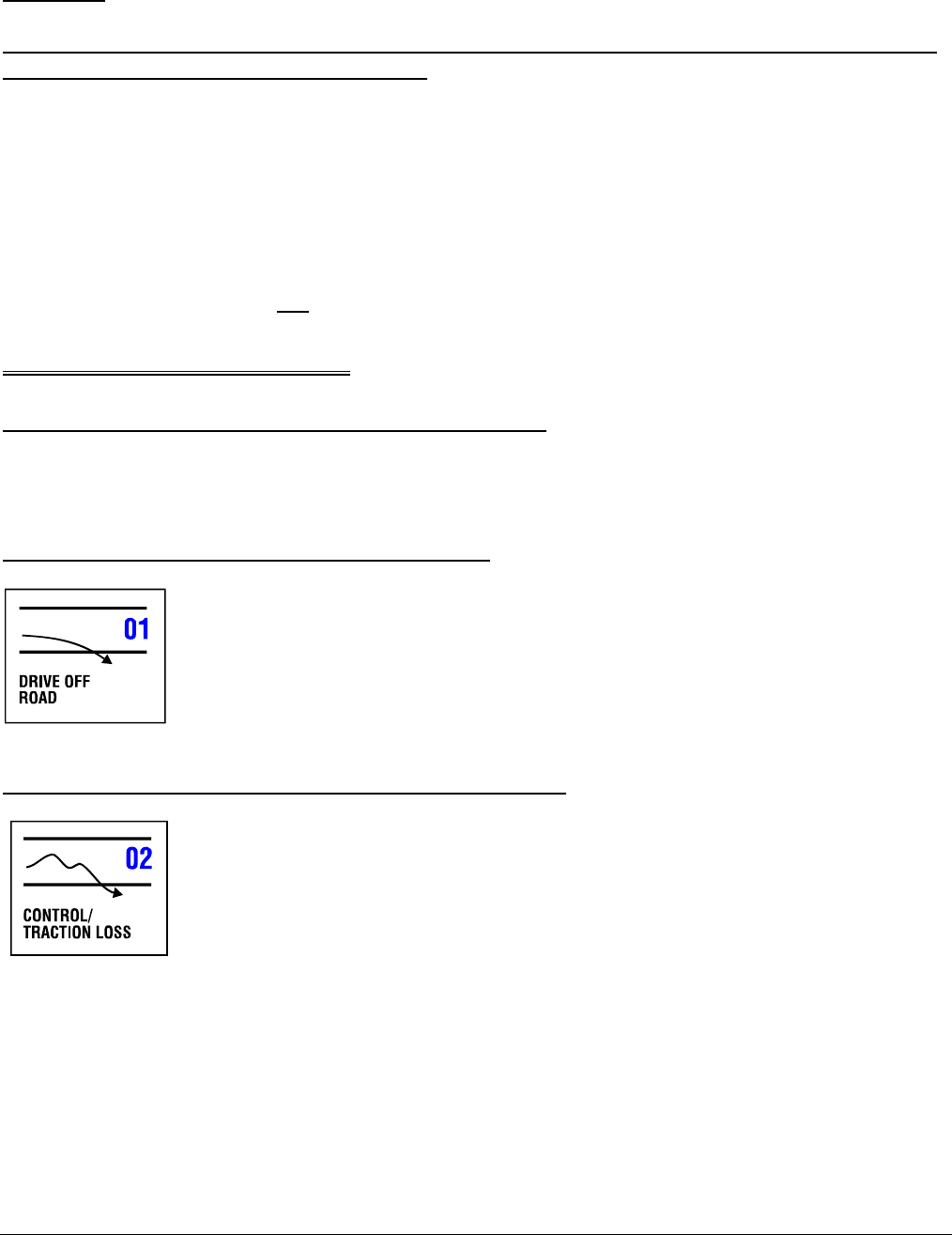
PC23
Remarks:
The Crash Type is a numeric value assigned by selecting the Crash Category and the Crash
Configuration on the next screens/pages. The number can be directly entered or edited here,
however, the two-step process of selecting the Crash Category And Crash Configuration is
preferred to visualize the crash scenario.
The first harmful event may include a collision between a vehicle and some object,
accompanied by property damage or human injury. The object may be another vehicle, a
person, an animal, a fixed object, the road surface or the ground. If the first collision is a
rollover, the impact is with the ground or road surface. The collision may also involve plowing
into soft ground, if severe vehicle deceleration results in damage or injury. A road departure
without damage or injury is not defined as a harmful event.
Category I. Single Driver
Configuration A. Right Roadside Departure
The vehicle departed the right side of the road with the first harmful event occurring off the
road.
01 Right Roadside Departure: Drive Off Road
x
02 Right Roadside Departure: Control/Traction Loss
Use Right Roadside Departure: Control/Traction when there is evidence
that the vehicle lost traction or "got away" from the driver in some other way
(e.g., the vehicle spun off the road as a result of surface conditions,
oversteer phenomena or mechanical malfunctions). If doubt exists, use
Right Roadside Departure, Drive Off Road. If the control/traction loss
occurs as a result of an avoidance of something in the road, see
remarks for CRASH TYPE 03 (Right Roadside Departure: Avoid Collision With Vehicle,
Pedestrian, Animal) and 04 (Right Roadside Departure: Specifics Other) to establish
which attribute applies.
2015 691

PC23
03 Right Roadside Departure: Avoid Collision With Vehicle, Pedestrian, Animal
Use Right Roadside Departure: Avoid Collision With Vehicle,
Pedestrian, Animal when the vehicle departed the road to avoid
something on the road. Phantom vehicle situations, pedestrians,
bicyclists, and other cyclists and non-motorists are included here.
04 Right Roadside Departure: Specifics Other
Use Right Roadside Departure: Specifics Other if the vehicle departed the
road to avoid something on the road other than a vehicle, pedestrian or
animal. Also use "Specifics Other" for crashes involving a driverless
in-transport vehicle.
05 Right Roadside Departure: Specifics Unknown
Use Right Roadside Departure: Specifics Unknown if the vehicle departed
the right side of the road for unknown reasons.
Configuration B. Left Roadside Departure
06 Left Roadside Departure: Drive Off Road
Use Left Roadside Departure: Drive Off Road when the vehicle departed
the road under a controlled situation (e.g., the driver was distracted, fell
asleep, intentionally departed, etc.)
07 Left Roadside Departure: Control/Traction Loss
Use Left Roadside Departure: Control/Traction Loss if there is evidence
that the vehicle lost traction or “got away” from the driver in some other way
(e.g., the vehicle spun off the road as a result of surface conditions,
oversteer phenomena or mechanical malfunctions.) If doubt exists, use Left
Roadside Departure, Drive Off Road. If the control/traction loss occurs
as a result of an avoidance of something in the road, see remarks for
CRASH TYPE 08 (Left Roadside Departure: Avoid Collision With Vehicle, Pedestrian,
Animal) and 09 (Left Roadside Departure: Specifics Other) to establish which attribute
applies
692 2015
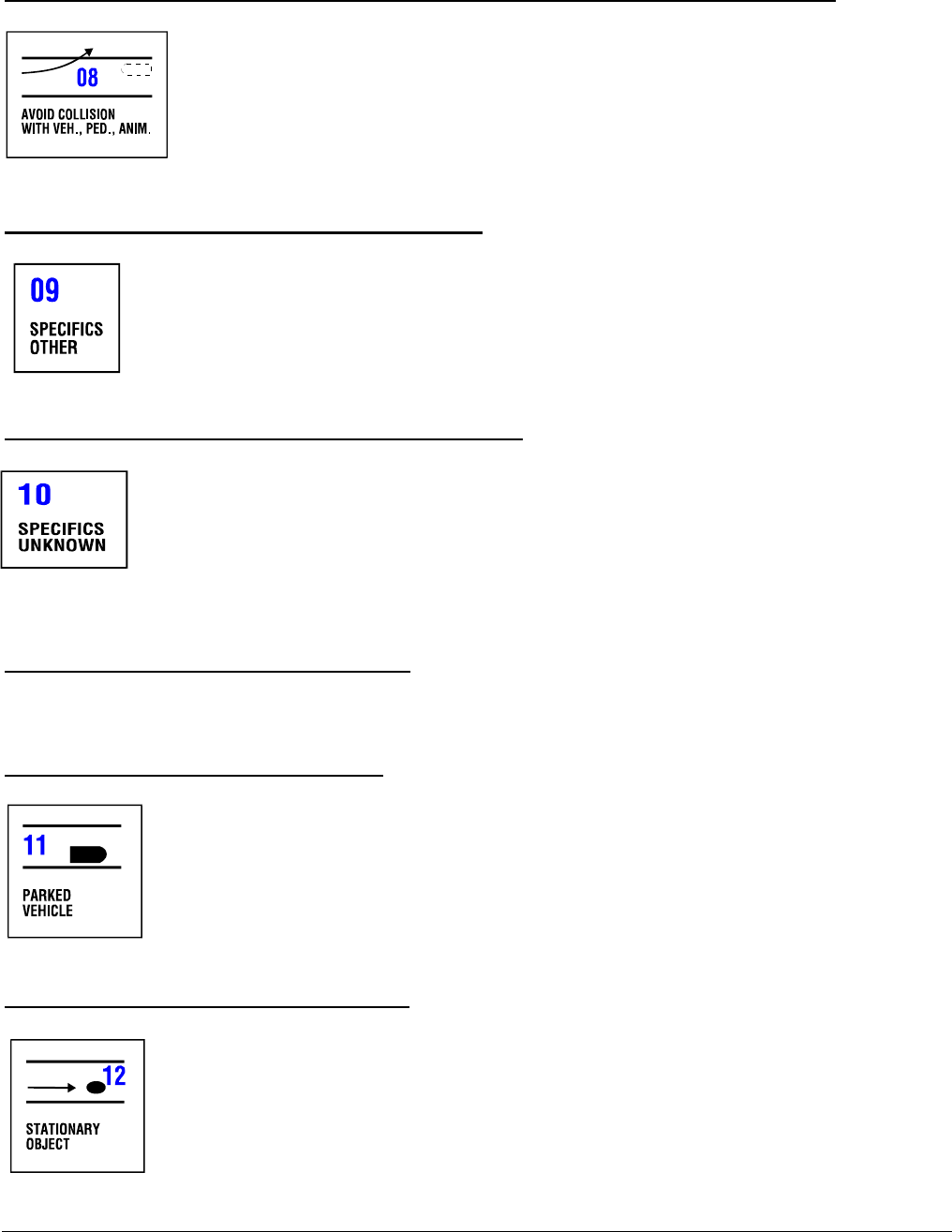
PC23
08 Left Roadside Departure: Avoid Collision With Vehicle, Pedestrian, Animal
Use Left Roadside Departure: Avoid Collision With Vehicle,
Pedestrian, Animal when the vehicle departed the road to avoid something
on the road. Phantom vehicle situations, pedestrians, bicyclists, and other
cyclists and non-motorists are included here.
09 Left Roadside Departure: Specifics Other
Use Left Roadside Departure: Specifics Other if the vehicle departed the road
to avoid something on the road other than a vehicle, pedestrian or animal. Also,
use “Specifics Other” for crashes involving a driverless in-transport vehicle.
10 Left Roadside Departure: Specifics Unknown
Use Left Roadside Departure: Specifics Unknown if the vehicle departed the
left side of the road for unknown reasons.
Configuration C. Forward Impact
The vehicle struck an object on the road or off the end of a trafficway while moving forward.
11 Forward Impact: Parked Vehicle
Use Forward Impact: Parked Vehicle if the crash involves impact with a
parked vehicle on either side of the road. For cases involving a parked vehicle
opening a door into moving traffic or extended mirrors into the travel lane use
15 (Forward Impact: Specifics Other).
12 Forward Impact: Stationary Object
Use Forward Impact: Stationary Object if the crash involves impact with a
stationary object on either side of the road.
2015 693
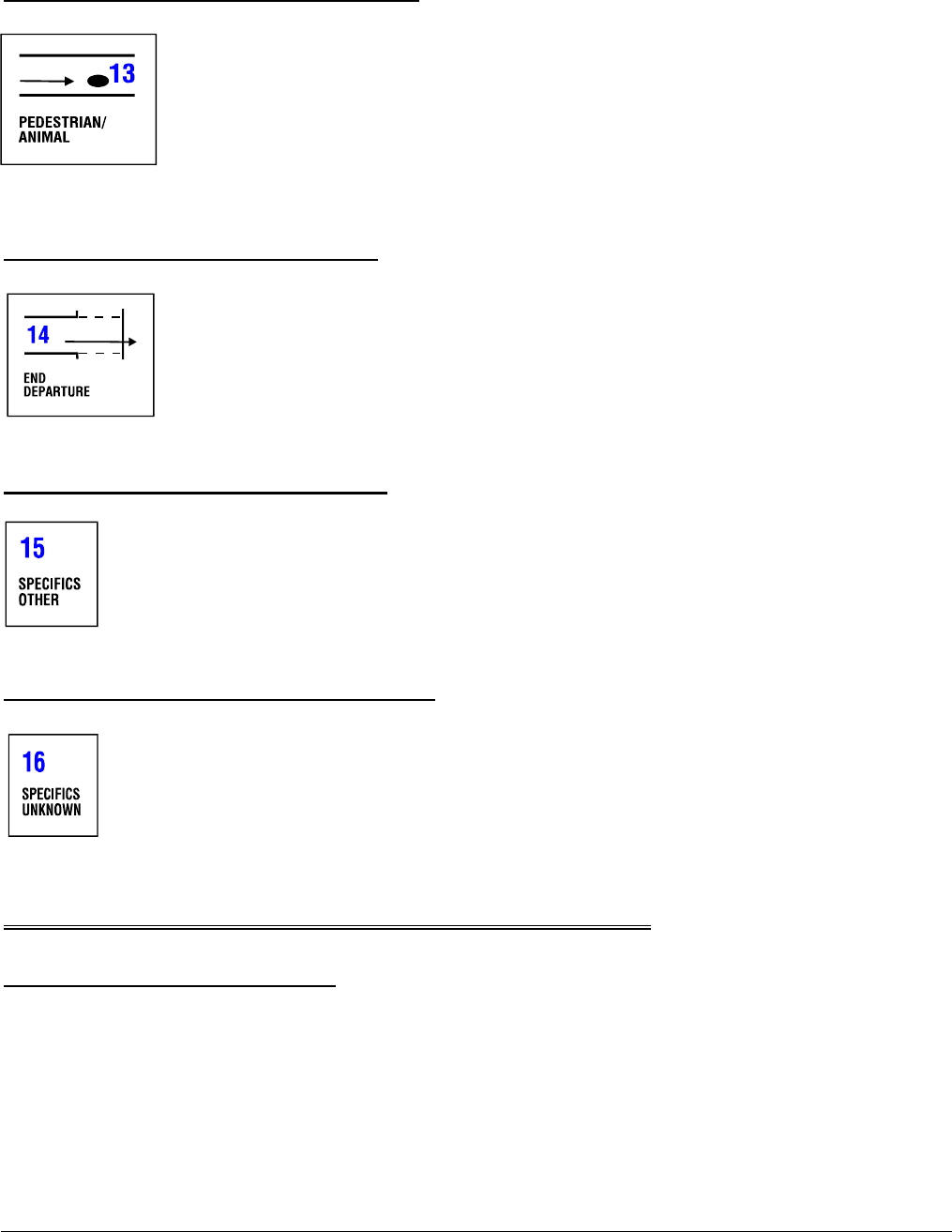
PC23
13 Forward Impact: Pedestrian/Animal
Use Forward Impact: Pedestrian/Animal if the first harmful event involves
impact with a pedestrian or animal on either side of the road. Pedestrians,
bicyclists, and other cyclists and non-motorists are included here. Vehicle
plane of contact is NOT a consideration. However, if a vehicle is backing
up when it contacts a non-motorist select CRASH TYPE 92 (Backing,
Etc.: Backing Vehicle).
14 Forward Impact: End Departure
Use Forward Impact: End Departure when the vehicle ran off the end of the
road and crashed into something.
15 Forward Impact: Specifics Other
Use Forward Impact: Specifics Other for impacted (striking or struck) trains and
non-stationary objects on the road. Also use “Specifics Other” for crashes involving
a driverless in-transport vehicle. Use this attribute for cases involving a parked
vehicle opening a door into moving traffic or extended mirrors into the travel lane.
16 Forward Impact: Specifics Unknown
Use Forward Impact: Specifics Unknown when the PAR indicates a single driver
was involved in a forward impact collision, but no further classification is possible.
Category II. Same Trafficway, Same Direction
Configuration D. Rear-End
The front of the overtaking vehicle impacted the rear of the other vehicle. Note, even if the
rear-impacted vehicle had started to make a turn, code here (not in Category IV - Change in
Trafficway, Vehicle Turning).
694 2015
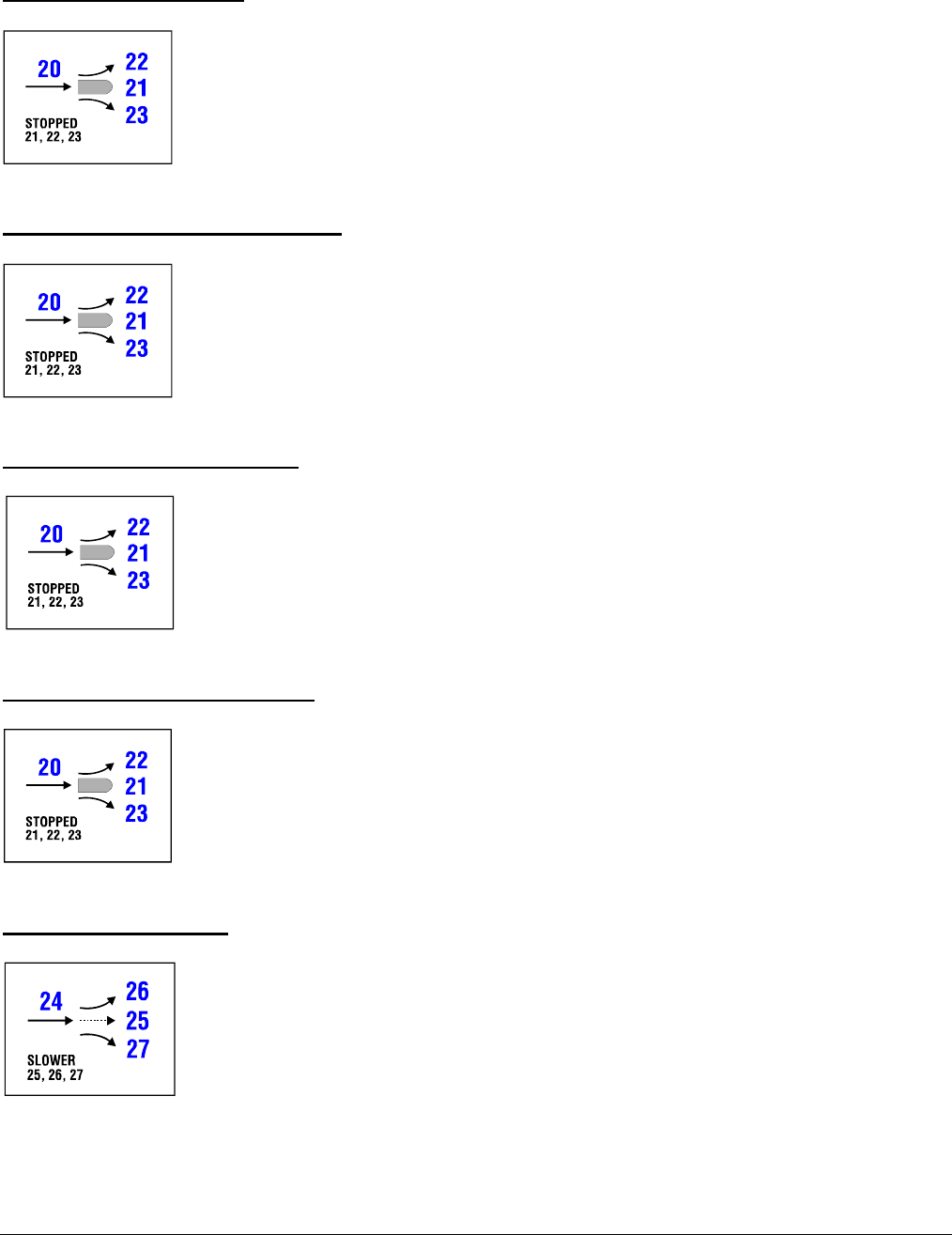
PC23
20 Rear-End: Stopped
Use Rear-End: Stopped for a vehicle that impacts another vehicle from
the rear when the impacted vehicle was stopped in the trafficway.
21 Rear-End: Stopped, Straight
Use Rear-End: Stopped, Straight for a rear-impacted vehicle that was
stopped in the trafficway, and was intending to proceed straight ahead.
22 Rear-End: Stopped, Left
Use Rear-End: Stopped, Left for a rear-impacted vehicle that was
stopped in the trafficway, intending to make a left turn.
23 Rear-End: Stopped, Right
Use Rear-End: Stopped, Right for a rear-impacted vehicle that was
stopped in the trafficway, intending to make a right turn.
24 Rear-End: Slower
Use Rear-End: Slower for a vehicle that impacts another vehicle from the
rear when the impacted vehicle was going slower than the striking vehicle.
2015 695
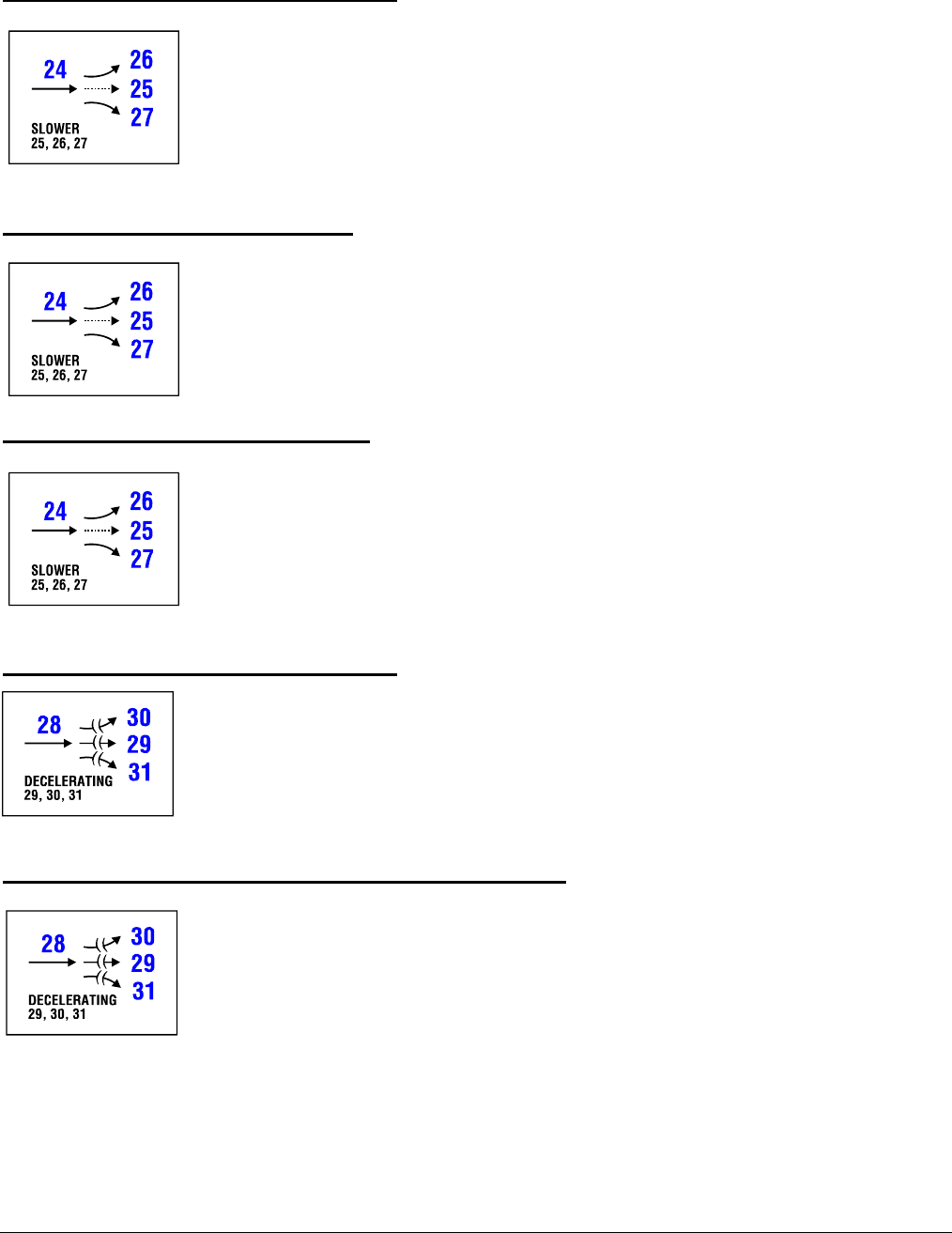
PC23
25 Rear-End: Slower, Going Straight
Use Rear-End: Slower, Going Straight for a rear-impacted vehicle that
was going slower than the other vehicle while proceeding straight ahead.
26 Rear-End: Slower, Going Left
Use Rear-End: Slower, Going Left for a rear-impacted vehicle that was
going slower than the other vehicle while intending to turn left.
27 Rear-End: Slower, Going Right
Use Rear-End: Slower, Going Right for a rear-impacted vehicle that was
going slower than the other vehicle while intending to turn right.
28 Rear-End: Decelerating (Slowing)
Use Rear-End: Decelerating (Slowing) for a vehicle which impacts
another vehicle from the rear when the impacted vehicle was slowing down.
29 Rear-End: Decelerating (Slowing), Going Straight
Use Rear-End: Decelerating (Slowing), Going Straight for a
rear-impacted vehicle that was slowing down while proceeding straight
ahead.
696 2015
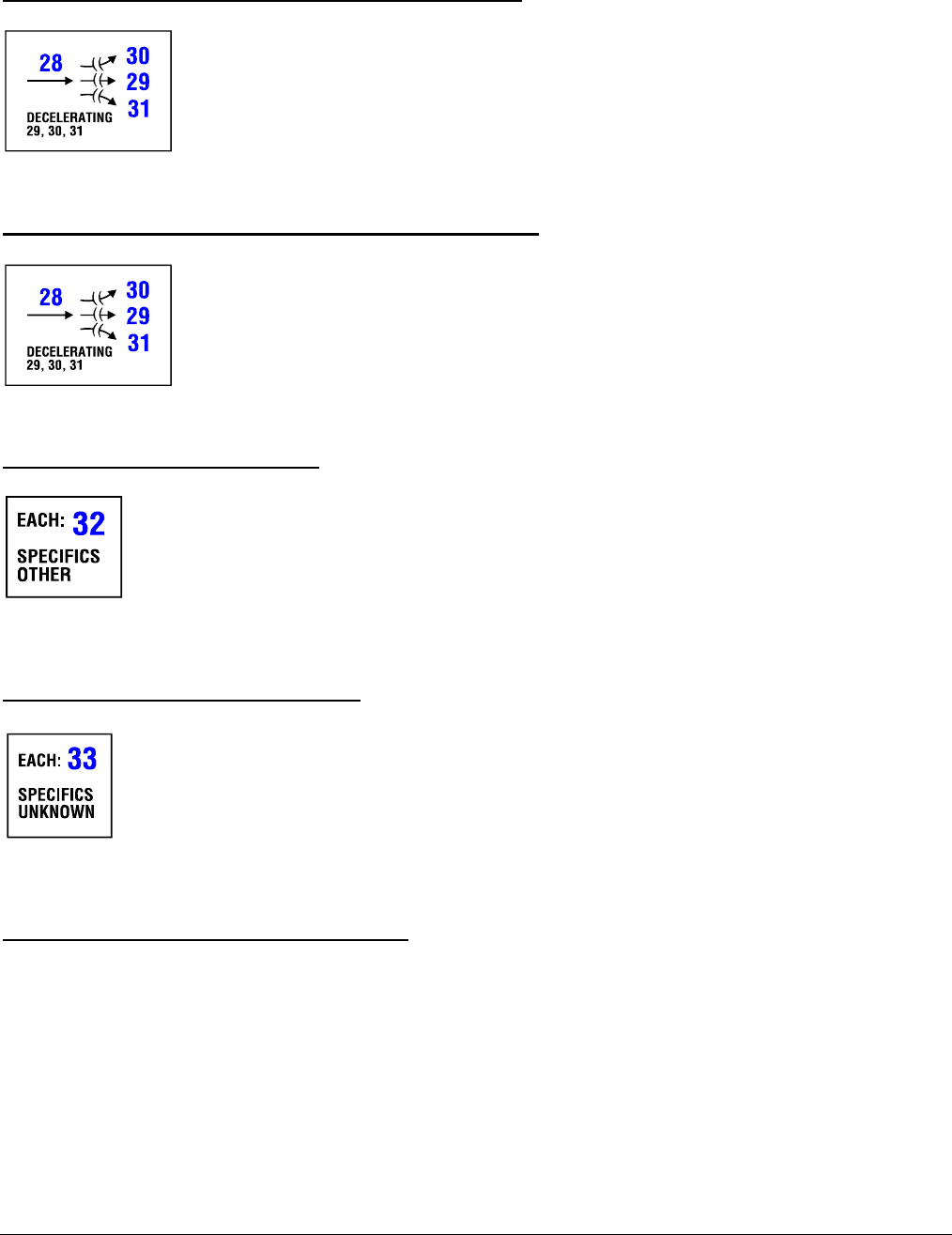
PC23
30 Rear-End: Decelerating (Slowing), Going Left
Use Rear-End: Decelerating (Slowing), Going Left for a rear-impacted
vehicle that was slowing down while intending to turn left.
31 Rear-End: Decelerating (Slowing), Going Right
Use Rear-End: Decelerating (Slowing), Going Right for a rear-impacted
vehicle that was slowing down while intending to turn right.
32 Rear-End: Specifics Other
Use Rear-End: Specifics Other for rear-end collisions which cannot be
described in “20-31.” Enter “Specifics Other” for crashes involving a driverless
in-transport vehicle.
33 Rear-End: Specifics Unknown
Use Rear-End: Specifics Unknown when the PAR indicates a rear-end collision
occurred, but no further classification is possible.
Configuration E. Forward Impact
The front of the overtaking vehicle impacted the rear of the other vehicle, following a steering
maneuver around a noninvolved vehicle or object.
2015 697
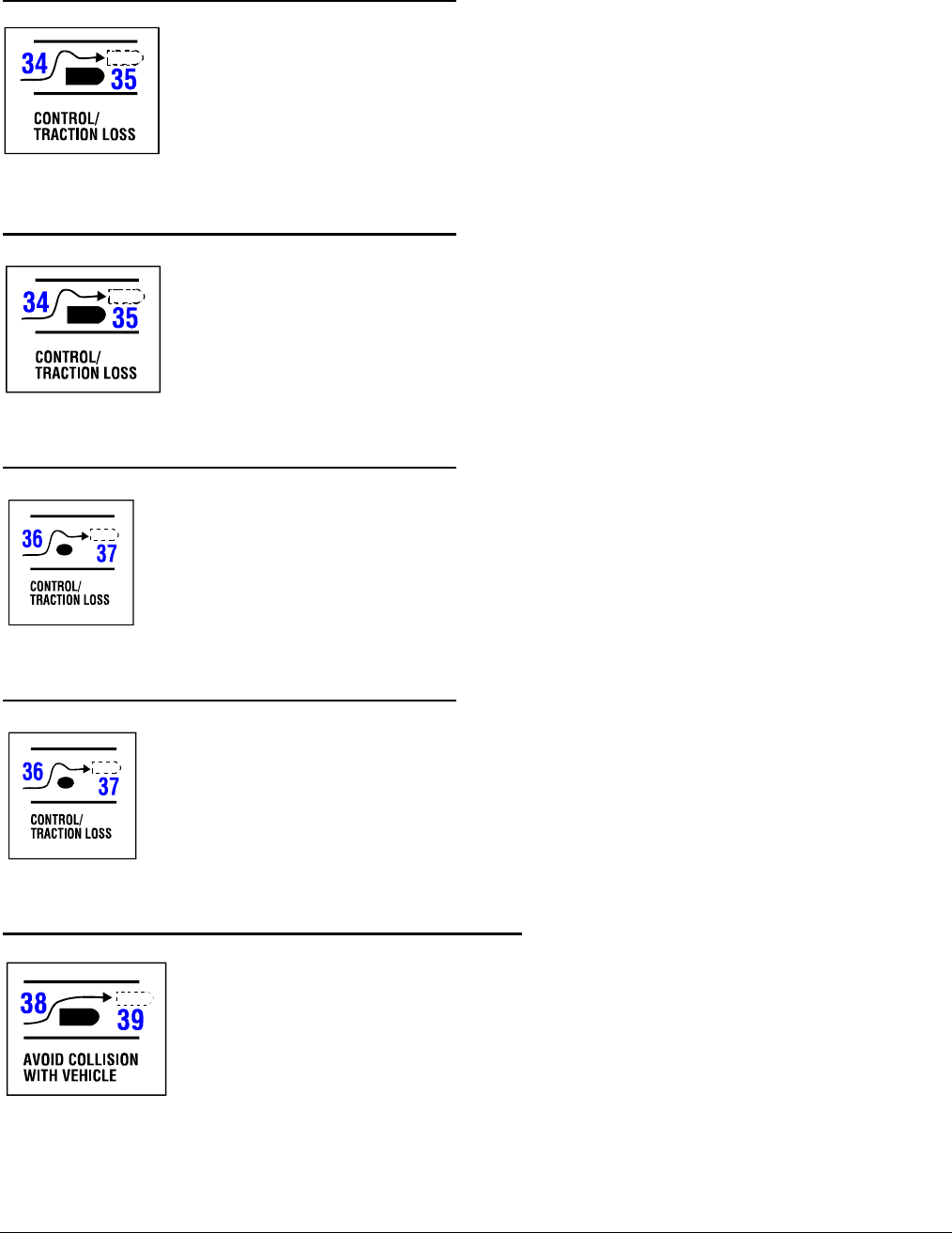
PC23
34 Forward Impact: Control/Traction Loss
Use Forward Impact: Control/Traction Loss for a vehicle that's frontal
area impacts another vehicle due to loss of control or traction (during a
aneuver to avoid a collision with a non-involved vehicle) while both are
traveling on the same trafficway in the same direction.
35 Forward Impact: Control/Traction Loss
Use Forward Impact: Control/Traction Loss for a vehicle that is impacted
by the frontal area of another vehicle due to loss of control or traction (during
a maneuver to avoid a collision with a non-involved vehicle) while both are
traveling on the same trafficway in the same direction.
36 Forward Impact: Control/Traction Loss
Use Forward Impact: Control/Traction Loss for a vehicle that's frontal area
impacts another vehicle due to loss of control or traction (during a maneuver to
avoid a collision with an object) while both are traveling on the same trafficway
in the same direction.
37 Forward Impact: Control/Traction Loss
Use Forward Impact: Control/Traction Loss for a vehicle that is impacted by
the frontal area of another vehicle due to loss of control or traction (during a
maneuver to avoid a collision with an object) while both are traveling on the
same trafficway in the same direction.
38 Forward Impact: Avoid Collision with Vehicle
Use Forward Impact: Avoid Collision with Vehicle for a vehicle that
struck the rear of another vehicle with its front plane while maneuvering to
avoid collision with a non-involved vehicle, when loss of control or traction
was not a factor, and both were traveling on the same trafficway, in the
same direction.
698 2015
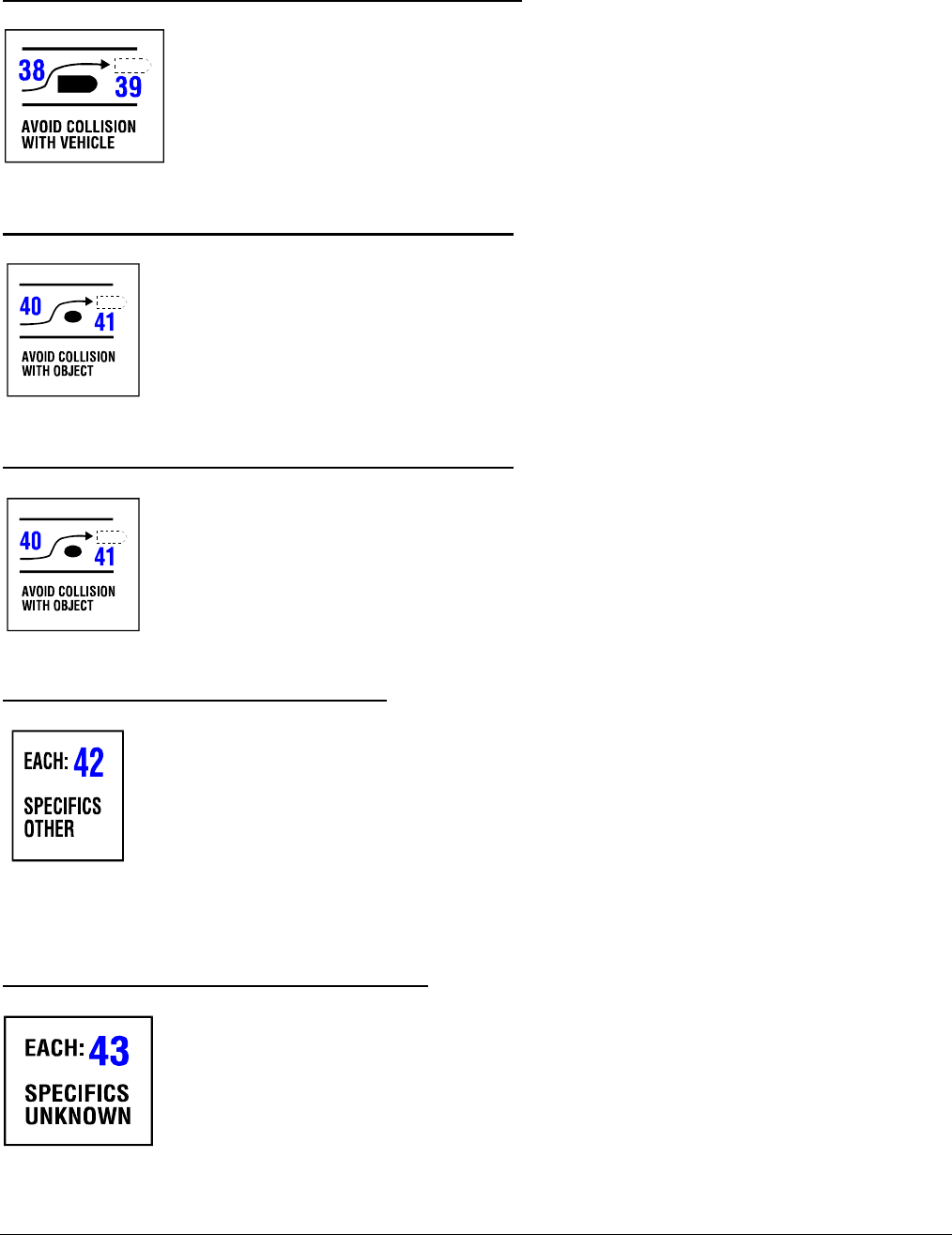
PC23
39 Forward Impact: Avoid Collision with Vehicle
Use Forward Impact: Avoid Collision with Vehicle for a vehicle that was
impacted by the frontal area of another vehicle which was maneuvering to
avoid a collision with a non-involved vehicle, when loss of control or traction
was not a
factor, and both were traveling on the same trafficway, in the same direction.
40 Forward Impact: Avoid Collision with Object
Use Forward Impact: Avoid Collision with Object for a vehicle that struck
the rear of another vehicle with its front plane while maneuvering to avoid
collision with an object, when loss of control or traction was not a factor, and
both were traveling on the same trafficway, in the same direction.
41 Forward Impact: Avoid Collision with Object
Use Forward Impact: Avoid Collision with Object for a vehicle that was
impacted by the frontal area of another vehicle that was maneuvering to avoid
a collision with an object, when loss of control or traction was not a factor, and
both were traveling on the same trafficway, in the same direction.
42 Forward Impact: Specifics Other
Use Forward Impact: Specifics Other (for both vehicles) for a forward impact
collision that occurred while both vehicles were traveling on the same trafficway,
in the same direction, and the striking vehicle was attempting to avoid a vehicle
or an object that cannot be described by “34 - 40.”
Also, use this code for crashes involving a driverless in-transport vehicle that
would otherwise qualify for this configuration.
43 Forward Impact: Specifics Unknown
Use Forward Impact: Specifics Unknown when the PAR indicates that a
forward impact collision occurred while both vehicles were traveling on the
same trafficway and in the same direction, but no further classification was
possible.
2015 699

PC23
Configuration F. Sideswipe/Angle
The two vehicles are involved in an impact involving the side of one or both vehicles.
The following four attributes, Sideswipe/Angle, straight ahead on left, Sideswipe/Angle,
straight ahead on left/right, Sideswipe/Angle, changing lanes to the right and
Sideswipe/Angle, changing lanes to the left identify relative vehicle positions (left versus
right) and lane of travel intentions (straight ahead versus changing lanes). From these four
codes, four combinations are permitted. They are:
1. 44 (Sideswipe/Angle, straight ahead on left) and 45 (Sideswipe/Angle,
straight ahead on left/right).
2. 46 (Sideswipe/Angle, changing lanes to the right) and 45 (Sideswipe/Angle,
straight ahead on left/right).
3. 45 (Sideswipe/Angle, straight ahead on left/right) and 47 (Sideswipe/Angle,
changing lanes to the left).
4. 46 (Sideswipe/Angle, changing lanes to the right) and 47 (Sideswipe/Angle,
changing lanes to the left).
When used in combination, these codes refer to a sideswipe or angle collision that involved a
vehicle to the left of a vehicle to the right where:
1. neither vehicle (Sideswipe/Angle, straight ahead on left and
Sideswipe/Angle, straight ahead on left/right) intended to change its lane;
2. the vehicle on the left (Sideswipe/Angle, changing lanes to the right) was
changing lanes to the right, and the vehicle on the right (Sideswipe/Angle,
straight ahead on left/right) was not intending to change its lane;
3. the vehicle on the left (Sideswipe/Angle, straight ahead on left/right) was not
intending to change its lane, and the vehicle on the right (Sideswipe/Angle,
changing lanes to the left) was changing lanes to the left, and
4. the vehicle on the left (Sideswipe/Angle, changing lanes to the right) was
changing lanes to the right, and the vehicle on the right (Sideswipe/Angle,
changing lanes to the left) was changing lanes to the left.
In addition, when:
1. the right sides of the two vehicles impact following a 180 degree rotation of the
vehicle on the right, or
2. the left sides of the two vehicles impact following a 180 degree rotation of the
vehicle on the left.
Select the appropriate combination depending upon:
1. their positions (i.e., left versus right) and
2. the intended lane of travel (straight ahead versus changing lanes) of their drivers.
700 2015
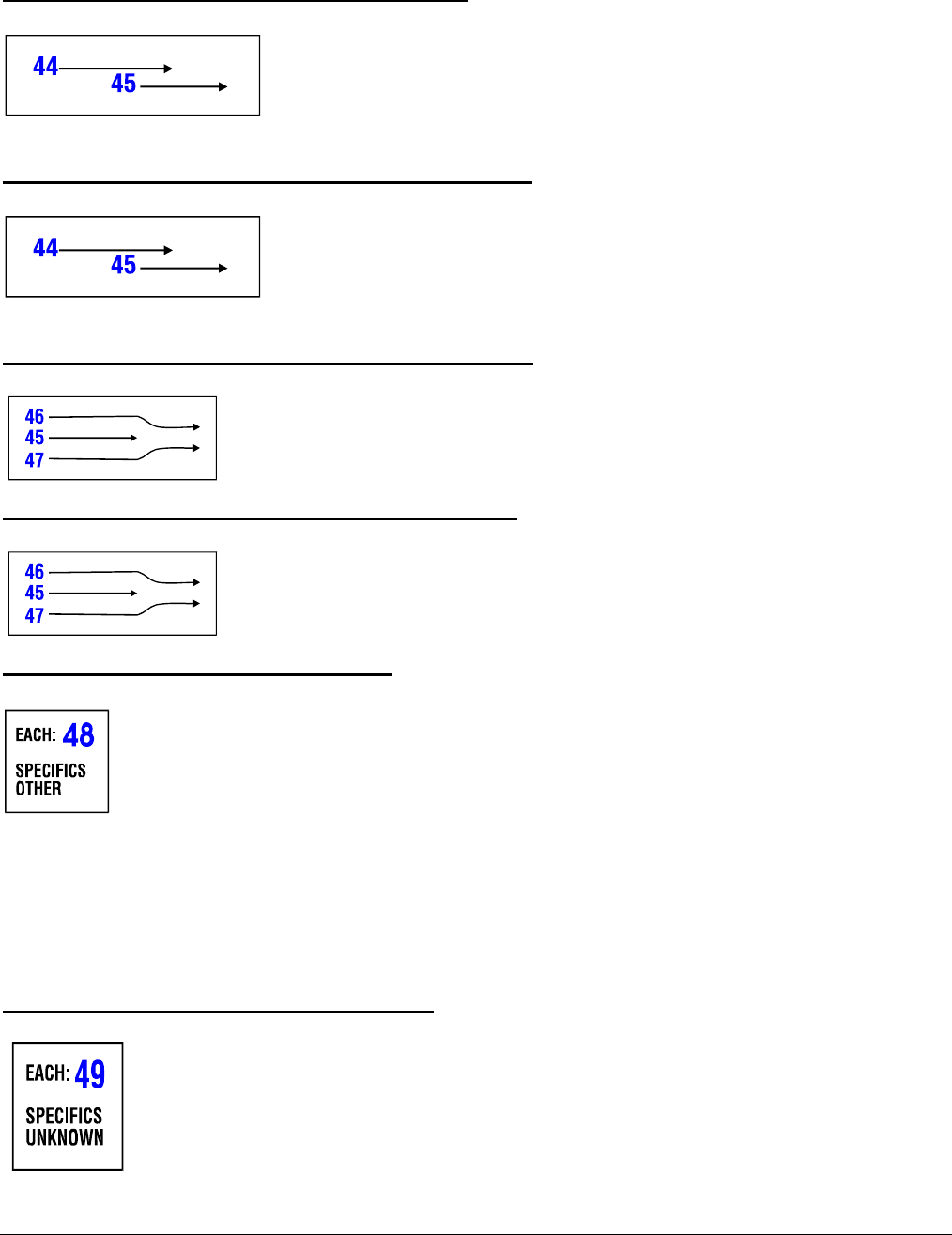
PC23
44 Sideswipe/Angle: Straight Ahead on Left
See discussion under Configuration F. Sideswipe/Angle, above for
an explanation of when this attribute applies.
45 Sideswipe/Angle: Straight Ahead on Left/Right
See discussion under Configuration F. Sideswipe/Angle, above for
an explanation of when this attribute applies.
46 Sideswipe/Angle: Changing Lanes to the Right
See discussion under Configuration F. Sideswipe/Angle, above for an
explanation of when this attribute applies.
47 Sideswipe/Angle: Changing Lanes to the Left
See discussion under Configuration F. Sideswipe/Angle, above for an
explanation of when this attribute applies.
48 Sideswipe/Angle: Specifics Other
Use Sideswipe/Angle: Specifics Other if one vehicle was behind the other prior
to a sideswipe/angle collision occurring while both vehicles were traveling on the
same trafficway and in the same direction.
For example, use this code when two vehicles are on the same trafficway and
going the same direction, and one loses control and is struck in the side by the front of the
other vehicle. However, if one vehicle rotates such that the impact is front to front, then use
code “98” (Other crash type).
Use Sideswipe/Angle: Specifics Other for crashes involving a driverless in-transport vehicle.
49 Sideswipe/Angle: Specifics Unknown
Use Sideswipe/Angle: Specifics Unknown for sideswipe/angle collisions that
occur while both vehicles are traveling on the same trafficway and in the same
direction, when no further classification is possible.
2015 701
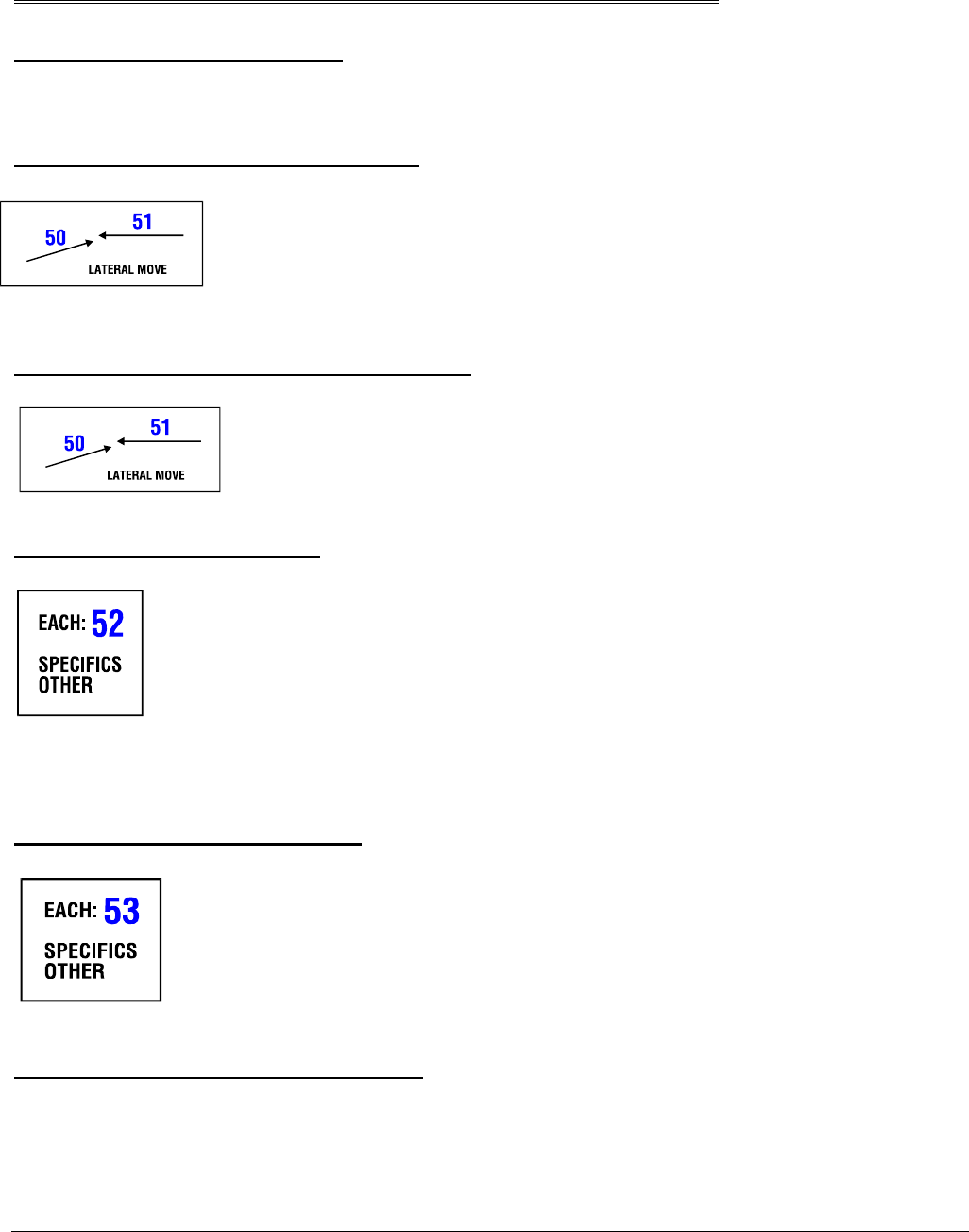
PC23
Category III. Same Trafficway, Opposite Direction
Configuration G. Head-On
The frontal area of one vehicle impacted the frontal area of another.
50 Head-On: Lateral Move (Left/Right)
Use Head-On: Lateral Move (Left/Right) for a vehicle that LEAVES ITS
LANE [moves laterally (sideways)] immediately before colliding head-on
with another vehicle, when the vehicles are traveling on the same
trafficway in opposite directions.
51 Head-On: Lateral Move (Going Straight)
Use Head-On: Lateral Move (Going Straight) for a vehicle that collides
head-on with another vehicle which has IMMEDIATELY LEFT ITS LANE
(moved laterally), when the vehicles are traveling on the same trafficway
in opposite directions.
52 Head-On: Specifics Other
Use Head-On: Specifics Other for a head-on collision that cannot be described
by “50-51”, when the vehicles are traveling on the same trafficway in opposite
directions. Clarification: Enter “52” for both vehicles involved in a head-on
collision when one is traveling the wrong way on a one way roadway.
Enter “Specifics Other” for crashes involving a driverless in-transport vehicle.
53 Head-On: Specifics Unknown
Use Head-On: Specifics Unknown when the PAR indicates a head-on
collision occurred between two vehicles traveling on the same trafficway in
opposite directions, when no further classification is possible.
Configuration H. Forward Impact
The frontal area of one vehicle impacted the frontal area of another following a steering
maneuver around a noninvolved vehicle or an object.
702 2015
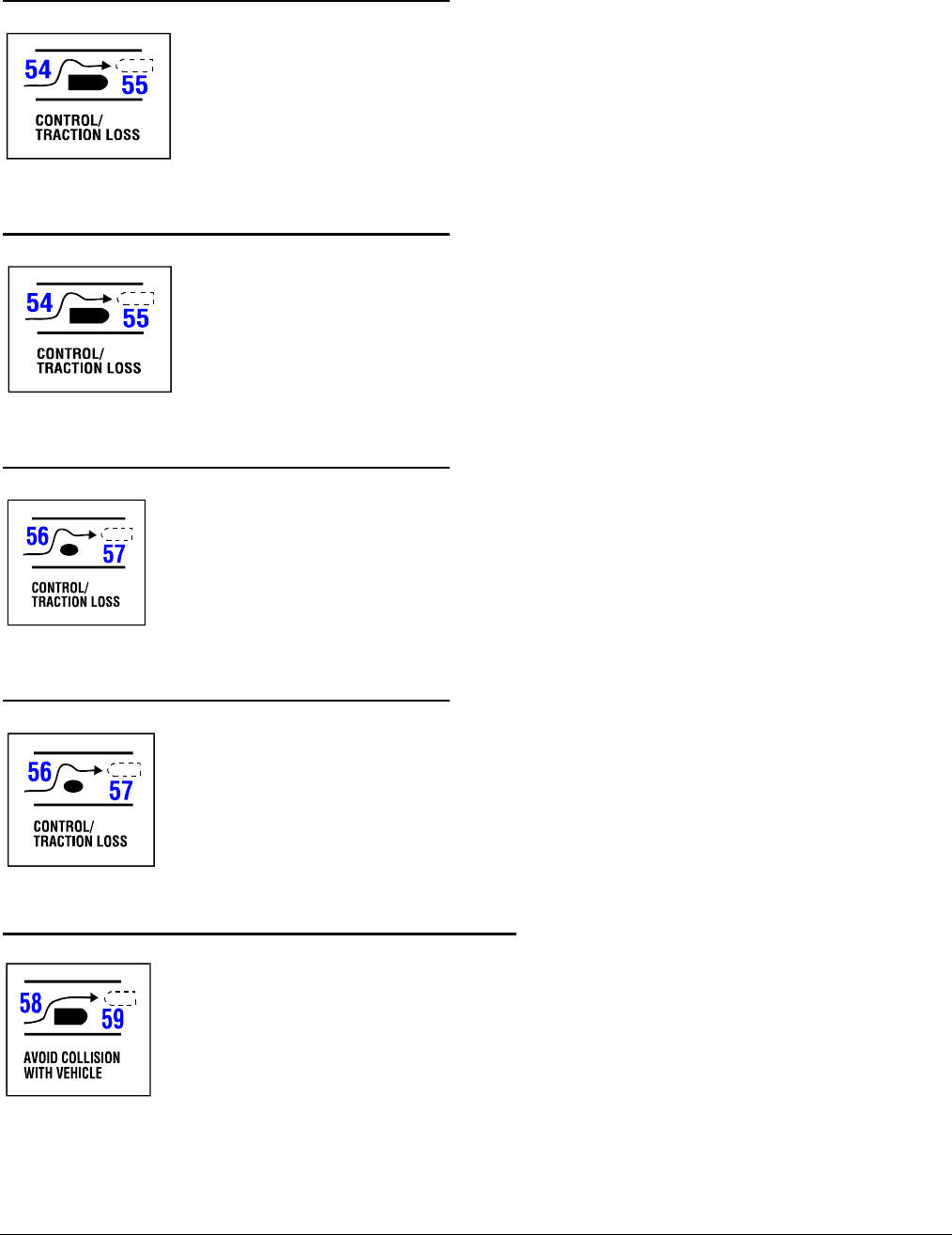
PC23
54 Forward Impact: Control/Traction Loss
Use Forward Impact: Control/Traction Loss for a vehicle whose frontal
area impacts another vehicle due to loss of control or traction (during a
maneuver to avoid a collision with a third vehicle) while the vehicles are
traveling on the same trafficway in opposite directions.
55 Forward Impact: Control/Traction Loss
Use Forward Impact: Control/Traction Loss for a vehicle that is impacted
by the frontal area of another vehicle due to loss of control or traction
(during a maneuver to avoid a collision with a third vehicle) while the
vehicles are traveling on the same trafficway in opposite directions.
56 Forward Impact: Control/Traction Loss
Use Forward Impact: Control/Traction Loss for a vehicle whose frontal area
impacts another vehicle due to loss of control or traction (during a maneuver to
avoid a collision with an object) while the vehicles are traveling on the same
trafficway in opposite directions.
57 Forward Impact: Control/Traction Loss
Use Forward Impact: Control/Traction Loss for a vehicle that is impacted
by the frontal area of another vehicle due to loss of control or traction (during
a maneuver to avoid a collision with an object) while the vehicles are traveling
on the same trafficway in opposite directions.
58 Forward Impact: Avoid Collision with Vehicle
Use Forward Impact: Avoid Collision with Vehicle for a vehicle whose
frontal area impacts another vehicle while maneuvering to avoid a collision
with a non-involved vehicle, when loss of control or traction was not a factor,
and the vehicles were traveling on the same trafficway, in opposite directions.
2015 703
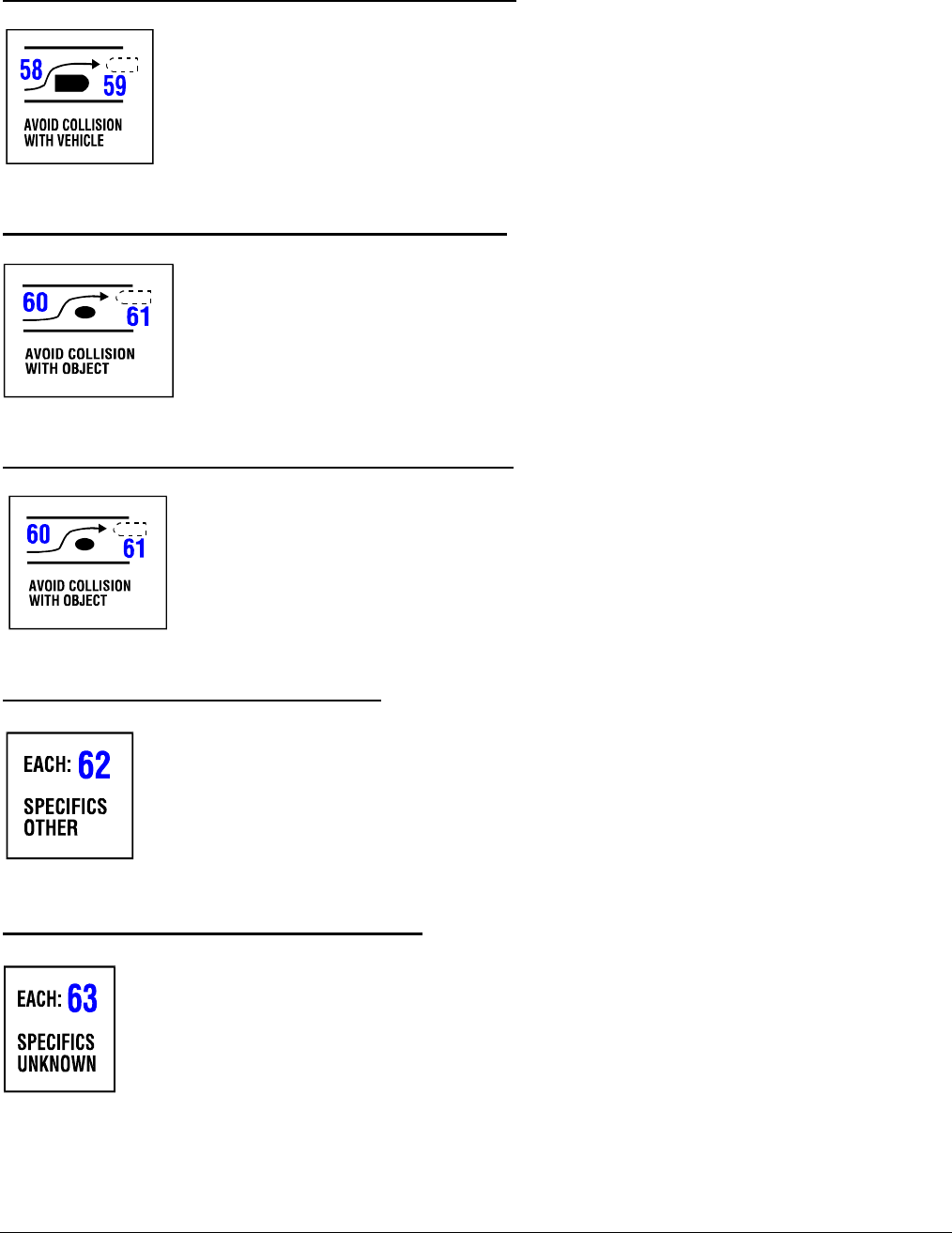
PC23
59 Forward Impact: Avoid Collision with Vehicle
Use Forward Impact: Avoid Collision with Vehicle for a vehicle that was
impacted by the frontal area of another vehicle which was maneuvering to
avoid collision with a non-involved vehicle, when loss of control or traction
was not a factor, and the vehicles were traveling on the same trafficway, in
opposite directions.
60 Forward Impact: Avoid Collision with Object
Use Forward Impact: Avoid Collision with Object for a vehicle that struck
the front of another vehicle with the frontal plane while maneuvering to
avoid collision with an object, when loss of control or traction was not a
factor, and the vehicles were traveling on the same trafficway, in opposite
directions.
61 Forward Impact: Avoid Collision with Object
Use Forward Impact: Avoid Collision with Object for a vehicle that was
impacted by the frontal area of another vehicle that was maneuvering to
avoid collision with an object, when loss of control or traction was not a
factor, and the vehicles were traveling on the same trafficway, in opposite
directions.
62 Forward Impact: Specifics Other
Use Forward Impact: Specifics Other for forward impact collisions occurring
while the vehicles were traveling on the same trafficway in opposite directions
that cannot be described by “54-61”. Enter “Specifics Other” for crashes
involving a "driverless in-transport vehicle."
63 Forward Impact: Specifics Unknown
Use Forward Impact: Specifics Unknown when the PAR indicates a forward
impact collision occurred while the vehicles were traveling on the same trafficway
in opposite directions, but no further classification is possible.
704 2015
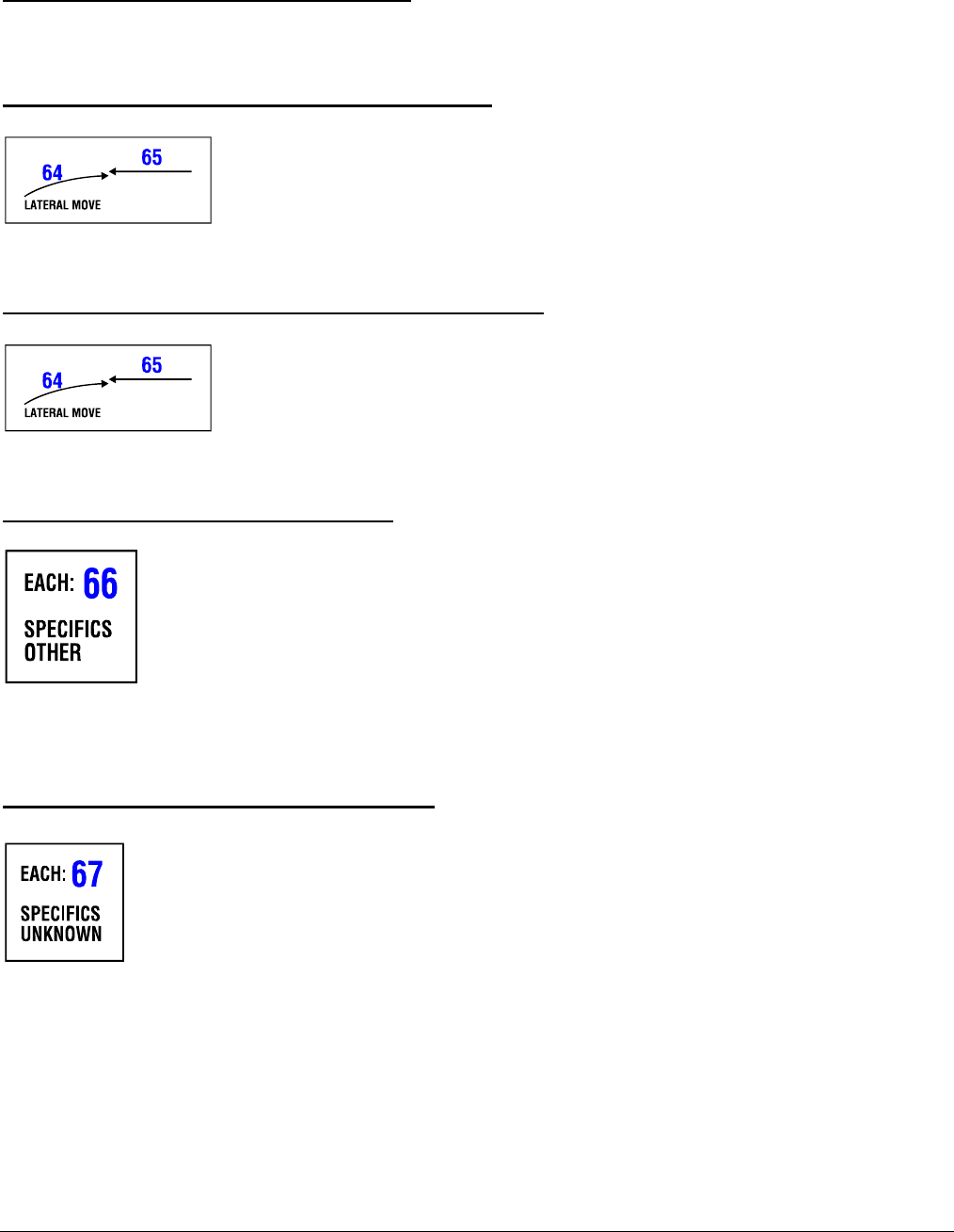
PC23
Configuration I. Sideswipe/Angle
The two vehicles are involved in an impact involving the side of one or both vehicles.
64 Sideswipe/Angle: Lateral Move (Left/Right)
Use Sideswipe/Angle: Lateral Move (Left/Right) identifies the vehicle
which infringed upon the other vehicle (code “65”) in a Category III,
Configuration I collision; i.e., enter “64” for the vehicle which left its lane
(moved laterally) leading to the collision.
65 Sideswipe/Angle: Lateral Move (Going Straight)
Use Sideswipe/Angle: Lateral Move (Going Straight) for the vehicle
that was infringed upon by the other vehicle (code “64”) in a Category
III, Configuration I collision.
66 Sideswipe/Angle: Specifics Other
Use Sideswipe/Angle: Specifics Other for sideswipe/angle collisions
occurring while both vehicles were traveling on the same trafficway in opposite
directions that cannot be described by “64-65”. Enter “Specifics Other” for
crashes involving a “driverless in-transport vehicle.” However, if one vehicle
rotates such that the impact is front to front or front to rear, and did not result
from a steering maneuver around a noninvolved vehicle or an object (category
H) then use code 98 (Other Crash Type).
67 Sideswipe/Angle: Specifics Unknown
Use Sideswipe/Angle: Specifics Unknown when the PAR indicates a
sideswipe/angle collision occurred while both vehicles were traveling on the
same trafficway in opposite directions, but no further classification is possible.
2015 705
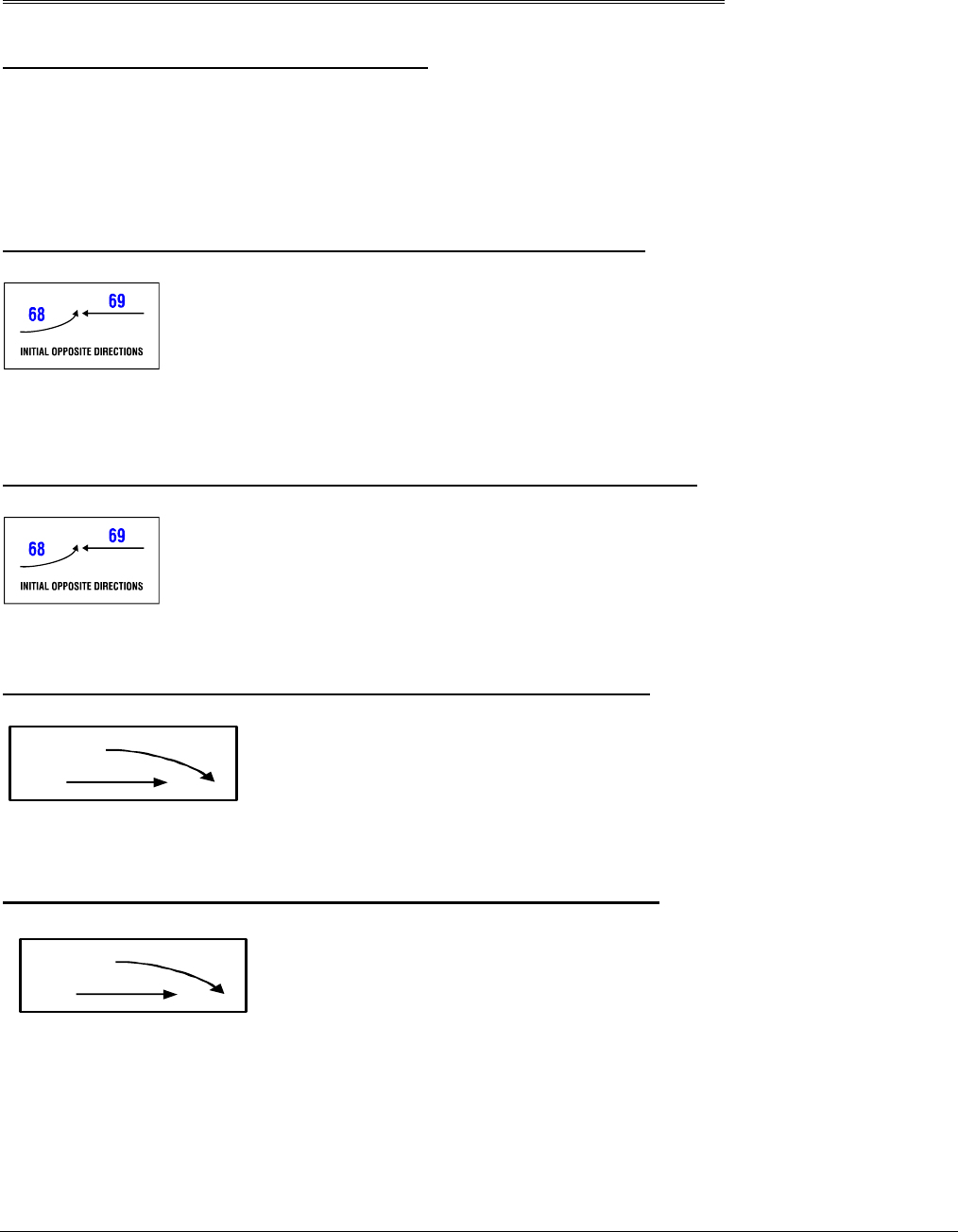
PC23
Category IV. Changing Trafficway, Vehicle Turning
Configuration J. Turn Across Path
The two vehicles were initially on the same trafficway when one vehicle tried to turn onto
another trafficway, a driveway or parking lot and pulled in front of the other vehicle. Vehicles
making a "U" turn are identified in Category VI. Miscellaneous.
68 Turn Across Path: Initial Opposite Directions (Left/Right)
Use Turn Across Path: Initial Opposite Directions (Left/Right) identifies
the vehicle which turned across the path of another vehicle (Turn Across
Path: Initial Opposite Directions [Going Straight]) in a Category IV,
Configuration J collision, in which the vehicles were initially traveling in
opposite directions.
69 Turn Across Path: Initial Opposite Directions (Going Straight)
Use Turn Across Path: Initial Opposite Directions (Going Straight) for a
vehicle involved in a collision in which another vehicle (Turn Across Path:
Initial Opposite Directions [Left/Right]) across its Path, and in which the
vehicles were initially traveling in opposite directions.
70 Turn Across Path: Initial Same Directions (Turning Right)
Use Turn Across Path: Initial Same Directions (Turning Right) for
70 a vehicle that turned right, across the path of another vehicle (Turn
71 Across Path: Initial Same Directions [Going Straight]), when both
vehicles were initially traveling in the same direction.
71 Turn Across Path: Initial Same Directions (Going Straight)
Turn Across Path: Initial Same Directions (Going Straight) for a
70 vehicle whose path was crossed by a vehicle turning right (Turn
Across Path: Initial Same Directions (Turning Right), when both
vehicles were initially traveling in the same direction.
71
706 2015
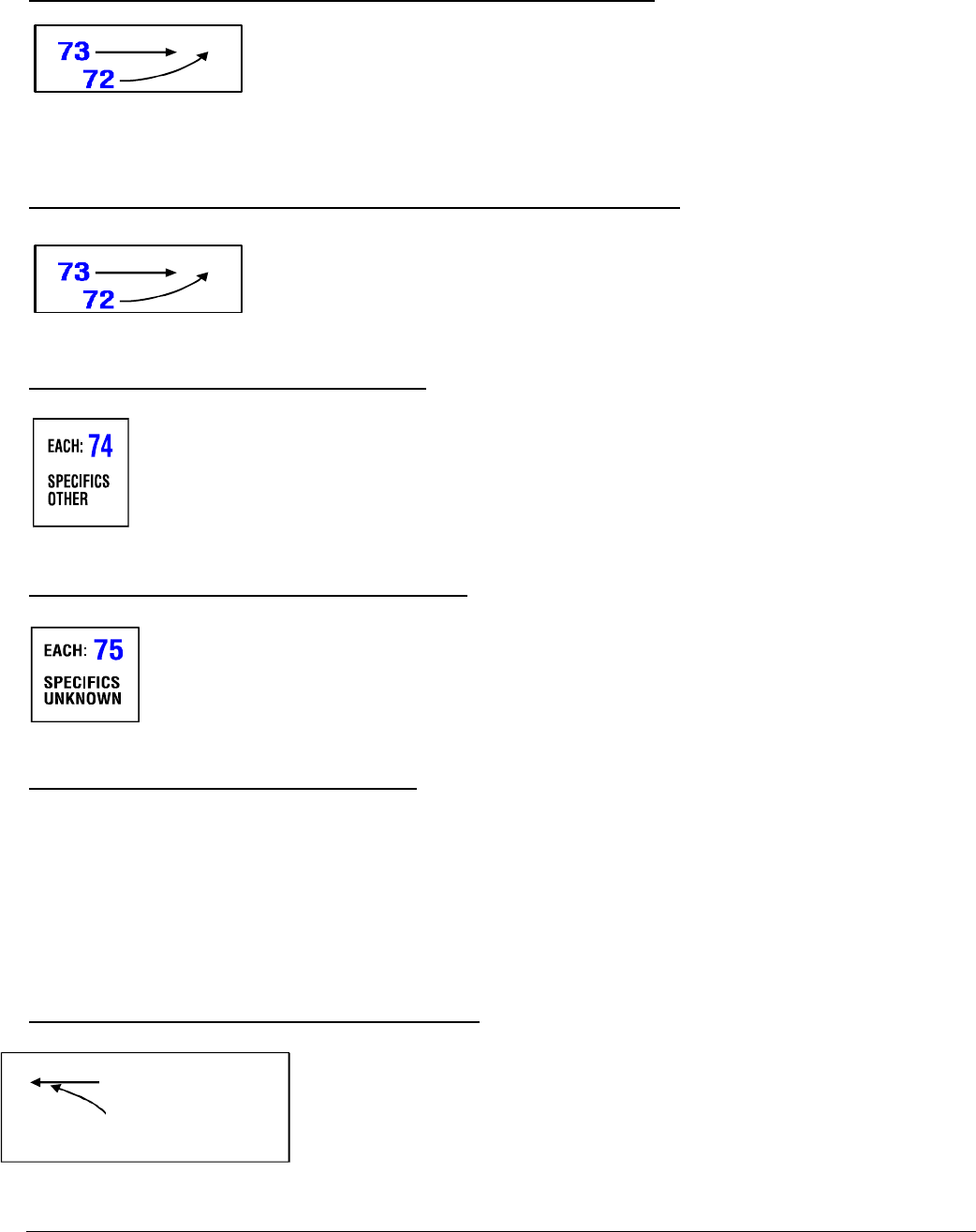
PC23
72 Turn Across Path: Initial Same Directions (Turning Left)
Use Turn Across Path: Initial Same Directions (Turning Left) for a
vehicle that turned left, across the path of another vehicle (Turn
Across Path: Initial Same Directions [Going Straight]), when both
vehicles were initially traveling in the same direction.
73 Turn Across Path: Initial Same Directions (Going Straight)
Use Turn Across Path: Initial Same Directions (Going Straight)” for
a vehicle whose path was crossed by a vehicle turning left (Turn
Across Path: Initial Same Directions [Turning Left]), when both
vehicles were initially traveling in the same direction.
74 Turn Across Path: Specifics Other
Use Turn Across Path: Specifics Other for collisions in which one vehicle turned
across another's path, which cannot be described by “68-72”. Enter “Specifics
Other” for crashes involving a driverless in-transport vehicle.
75 Turn Across Path: Specifics Unknown
Use Turn Across Path: Specifics Unknown when the PAR indicates one
vehicle turned across another's path, causing a collision, but no further
classification is possible.
Configuration K. Turn Into Path
The two vehicles were initially on different trafficways when one attempted to turn into the
same trafficway as the other vehicle. For the purposes of Crash Typing, “trafficway” as used
here includes a driveway or parking lot.
Note: the focus of this configuration is on the turning maneuver from one trafficway to another
and not on the vehicles' plane of contact.
76 Turn Into Same Direction (Turning Left)
Use Turn Into Same Direction (Turning Left) for a vehicle that
turned left, into the path of another vehicle (Turn Into Same
Direction [Going Straight]), so that both vehicles were traveling
in the same direction at the time of the collision.
77
76
TURN INTO SAME DIRECTION
2015 707
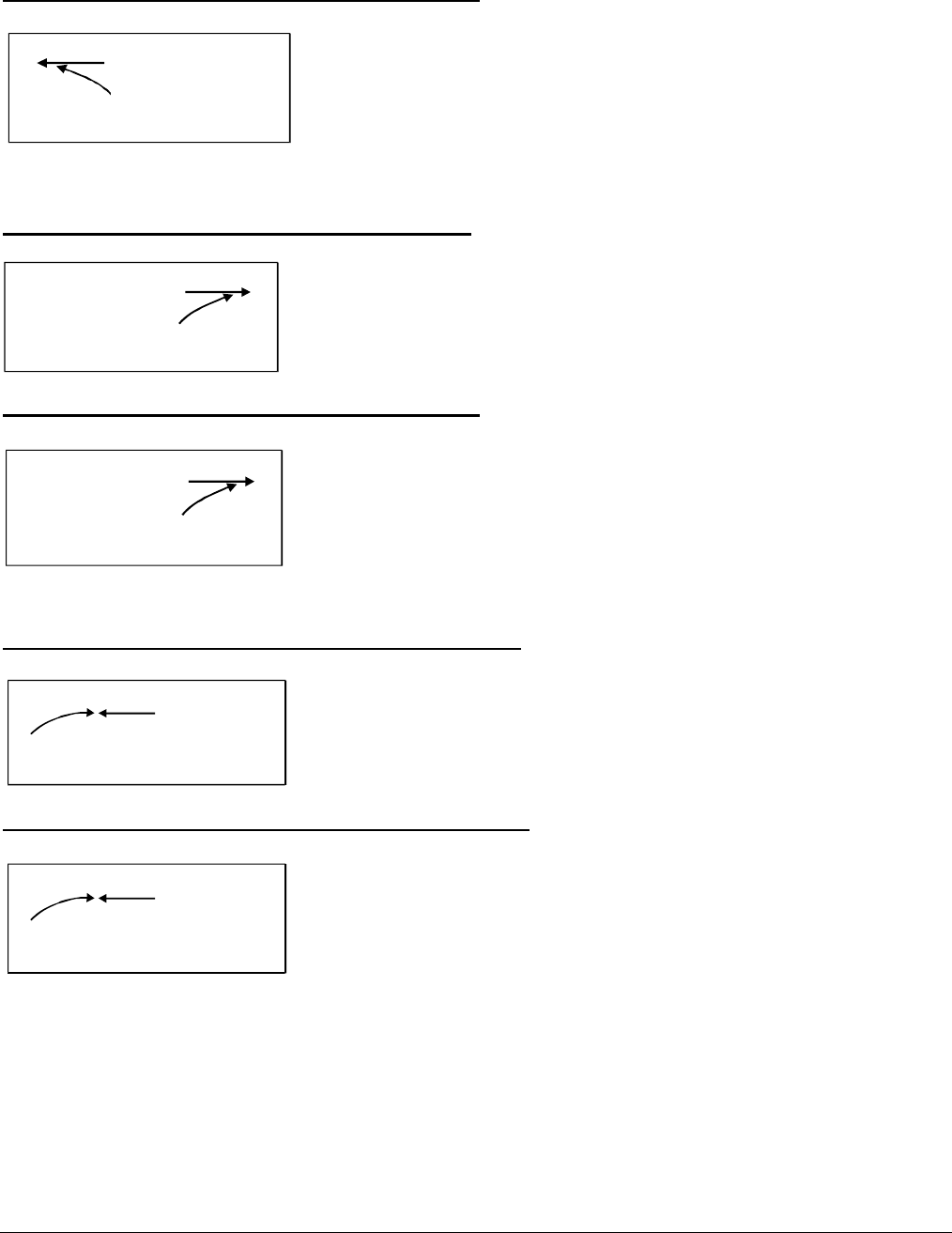
PC23
77 Turn Into Same Direction (Going Straight)
Use Turn Into Same Direction (Going Straight) for a vehicle
involved in a collision in which another vehicle (Turn Into Same
Direction [Turning Left]) turned left, into its path, so that both
vehicles were traveling in the same direction at the time of the
collision.
77
76
TURN INTO SAME DIRECTION
78 Turn Into Same Direction (Turning Right)
79
78
TURN INTO SAME DIRECTION
Use Turn Into Same Direction (Turning Right) for a vehicle
that turned right, into the path of another vehicle (Turn Into
Same Direction [Going Straight]), so that both vehicles were
traveling in the same direction at the time of the collision.
79 Turn Into Same Direction (Going Straight)
79
78
TURN INTO SAME DIRECTION
Use Turn Into Same Direction (Going Straight) for a vehicle
involved in a collision in which another vehicle (Turn Into Same
Direction [Turning Right]) turned right, into its path, so that
both vehicles were traveling in the same direction at the time of
the collision.
80 Turn Into Opposite Directions (Turning Right)
81
TURN INTO OPPOSITE DIRECTIONS
Use Turn Into Opposite Directions (Turning Right) for a Into
Opposite Directions [Going Straight]), so that the vehicles
were traveling in opposite directions at the time of the collision.
80
81 Turn Into Opposite Directions (Going Straight)
vehicle involved in a collision in which another vehicle (Turn
81
80
TURN INTO OPPOSITE DIRECTIONS
Use Turn Into Opposite Directions (Going Straight) for a
Into Opposite Directions [Turning Right]) turned right, into its
path, so that the vehicles were traveling in opposite directions at
the time of the collision.
708 2015

PC23
82 Turn Into Opposite Directions (Turning Left)
83
TURN INTO OPPOSITE DIRECTIONS
Use Turn Into Opposite Directions (Turning Left) for a
vehicle that turned left, into the path of another vehicle (Turn
Into Opposite Directions [Going Straight]), so that the
vehicles were traveling in opposite directions at the time of the
collision.
82
Turn Into Opposite Directions (Turning Left) is used when the driver's vehicle was in the act
of making a left turn (e.g., from a driveway, parking lot or intersection). Do not confuse this
situation with “Configuration L - Straight Paths.” The driver's intended path is the prime
concern.
83 Turn Into Opposite Directions (Going Straight)
Use Turn Into Opposite Directions (Going Straight) for a
vehicle involved in a collision in which another vehicle (Turn Into
Opposite Directions [Turning Left]) turned left, into its path, so
that the vehicles were traveling in opposite directions at the time
of the collision.
TURN INTO OPPOSITE DIRECTIONS
83
82
84 Turn Into Path: Specifics Other
Use Turn Into Path: Specifics Other for collisions in which one vehicle turned
across another's path, which cannot be described by “76-83”. Enter “Specifics
Other” for crashes involving a driverless in-transport vehicle.
85 Turn Into Path: Specifics Unknown
Use Turn Into Path: Specifics Unknown when the PAR indicates one vehicle
turned
into another's path, causing a collision, but no further classification is possible.
Category V. Intersecting Paths (Vehicle Damage)
Configuration L. Straight Paths
The two vehicles were proceeding (or attempting to proceed) straight ahead.
2015 709
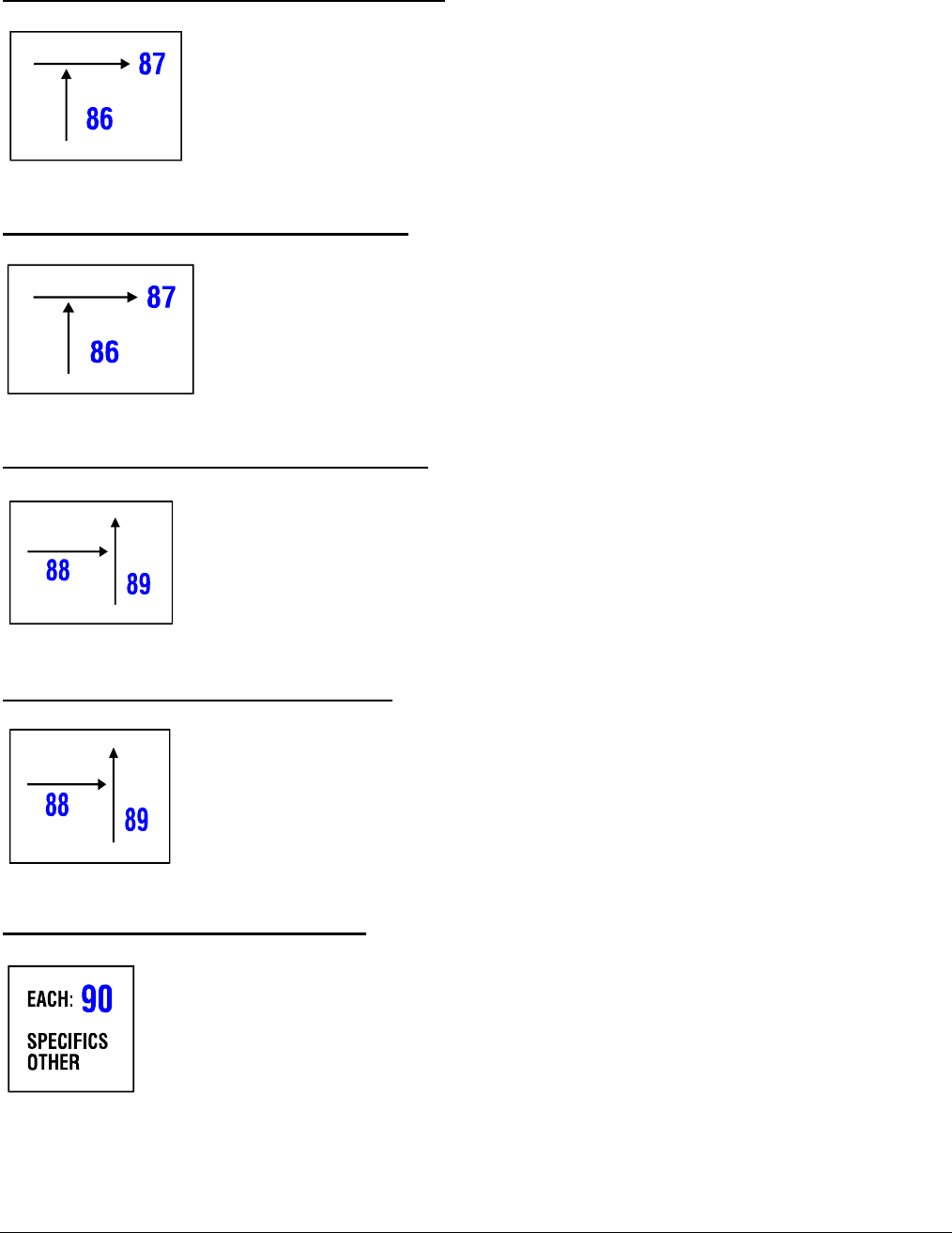
PC23
86 Straight Paths: Striking from the Right
Use Straight Paths: Striking from the Right for a vehicle that strikes the
right side of another vehicle (code “87”) from the right when both vehicles
were going straight at the time of the collision, i.e., right side damage to 87,
front damage to 86.
87 Straight Paths: Struck on the Right
Use Straight Paths: Struck on the Right for a vehicle that is struck on
the right side by another vehicle (Straight Paths: Striking from the
Right) from the right when both vehicles were going straight at the time of
the collision, i.e., right side damage to 87, front damage to 86.
88 Straight Paths: Striking from the Left
Use Straight Paths: Striking from the Left for a vehicle that strikes
another vehicle (Straight Paths: Struck on the Left) from the left when
both vehicles were going straight at the time of the collision, i.e., left side
damage to 89, front damage to 88.
89 Straight Paths: Struck on the Left
Use Straight Paths: Struck on the Left for a vehicle that is struck on the
left side by another vehicle (Straight Paths: Striking from the Left) from
the left when both vehicles were going straight at the time of the collision,
i.e., left side damage to 89, front damage to 88.
90 Straight Paths: Specifics Other
Use Straight Paths: Specifics Other for collisions in which two vehicles, both
going straight, collide when their paths intersect, which cannot be described by
“86-89”. Enter “Specifics Other” for crashes involving a driverless in-transport
vehicle.
710 2015

PC23
91 Straight Paths: Specifics Unknown
Use Straight Paths: Specifics Unknown when the PAR indicates two
vehicles, both going straight, collided when their paths intersected, but no
further classification is possible.
Category VI. Miscellaneous
Configuration M. Backing, Etc.
One of the two vehicles involved was a backing vehicle, regardless of its location on the
trafficway or the damage location on the vehicles.
Any crash configuration that cannot be described in Category I. through V. is included here.
92 Backing, Etc.: Backing Vehicle
Use Backing, Etc.: Backing Vehicle for a backing vehicle which was
involved with another vehicle object or non-motorist. If both vehicles
were backing then code 92 for both vehicles. If the vehicle was
driverless and rolling backwards use 98 (Other Crash Type).
93 Backing, Etc.: Other Vehicle
Use Backing, Etc.: Other Vehicle for the in-transport vehicle that was
involved with the backing vehicle (code 92). Attribute 93 can only
apply when there are two motor vehicles in-transport.
98 Other Crash Type
Other Crash Type is used for those events and collisions that do not
reasonably fit any of the specified types. This code includes (but is not
limited to): rollovers on the road; U-turns; crashes initiated by objects set-
in-motion by an in-transport motor vehicle; third or subsequent vehicles
involved in a crash; or the second involved vehicle, when the first harmful
event involves a vehicle-to-object collision or a non-collision.
2015 711
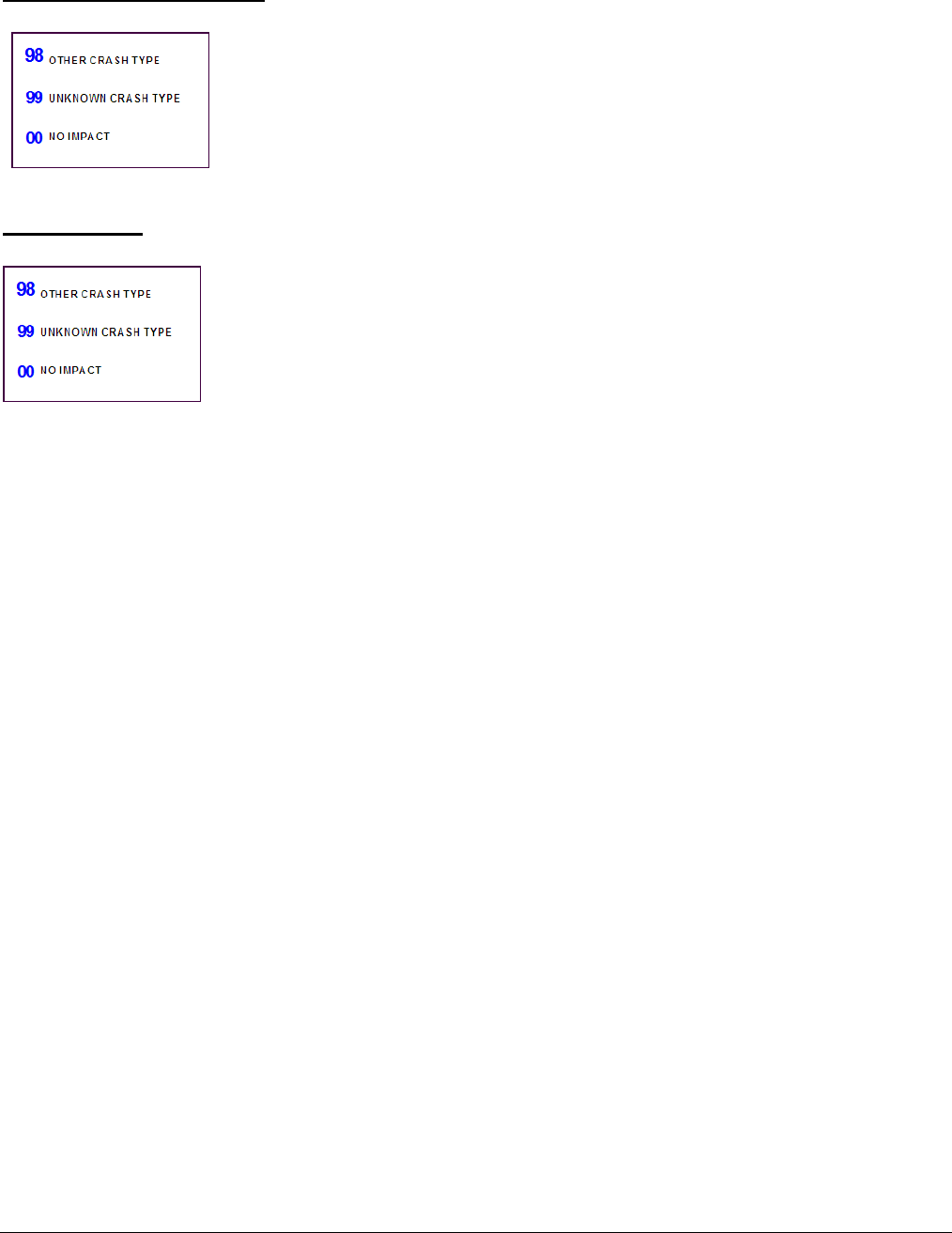
PC23
99 Unknown Crash Type
Use Unknown Crash Type when the crash category or configuration is
unknown.
00 No Impact
No Impact identifies the non-collision events fire, immersion, gas
inhalation, jackknife, injured in vehicle, pavement surface irregularity,
other non-collision, thrown or falling object, cargo equipment loss or shift,
or fell/jumped from vehicle. Rollovers on the road should be coded Other
Crash Type.
The following crash types require clarification:
No impact identifies non-collision events (i.e., fire, immersion, gas inhalation, jackknife, non-
collision injury, other non-collision or non-collision - no details). Rollovers on the road should
be coded as Other Crash Type.
Right roadside departure, drive off road and Left roadside departure, drive off road are
used when the vehicle departed the road under a controlled situation (e.g., the driver was
distracted, fell asleep, intentionally departed, etc.).
Right roadside departure, control/traction loss and Left roadside departure,
control/traction loss are used if there is some evidence that the vehicle lost traction or in
some other manner “got away” from the driver (i.e., the vehicle spun off the road as a result of
surface conditions, oversteer phenomena or mechanical malfunctions). If doubt exists, use
Right roadside departure, drive off road or Left roadside departure, drive off road
respectively.
Right roadside departure; avoid collision with vehicle, pedestrian, animal and Left
roadside departure; avoid collision with vehicle, pedestrian, animal are used when the
vehicle departed the road as a result of avoiding something in the road. “Phantom” situations
are included here.
Right roadside departure, specifics other and Left roadside departure, specifics other
are used for any other stationary or nonstationary objects if the avoidance characteristics of
codes “03” or “08” are present.
712 2015

PC23
Forward impact, parked vehicle, Forward impact, stationary object, and Forward impact,
pedestrian/animal involves an impact with an object that can be located on either side of the
road.
Forward impact, stationary object includes a hole in the road, an overhead object (e.g.,
overpass) or an object projecting over the road edge (e.g., support column of elevated
railway).
Forward impact, pedestrian/animal is used when a pedestrian, non-motorist or animal is
involved with the first harmful event. Vehicle plane of contact is not a consideration.
Forward impact, specifics other is used for impacted (striking or struck) trains and
nonstationary objects on the road.
Sideswipe/Angle, straight ahead on left, Sideswipe/Angle, straight ahead on left/right,
Sideswipe/Angle, changing lanes to the right, and Sideswipe/Angle, changing lanes to
the left identify relative vehicle positions (left versus right) and lane of travel intentions (straight
ahead versus changing lanes).
From these four codes, four combinations are permitted. They are:
1. “44” and “45”,
2. “46” and “45”,
3. “45” and “47”, and
4. “46” and “47”.
When used as a combination these codes refer to a sideswipe or angle collision which
involved a vehicle to the left of a vehicle to the right where:
1. neither vehicle (codes “44” and “45”) intended to change its lane;
2. the vehicle on the left (code “46”) was changing lanes to the right, and the
vehicle on the right (code “45”) was not intending to change its lane;
3. the vehicle on the left (code “45” ) was not intending to change its lane, and
the vehicle on the right (code “47”) was changing lanes to the left; and
4. the vehicle on the left (code “46”) was changing lanes to the right, and the
vehicle on the right (code “47”) was changing lanes to the left.
In addition, when:
1. the right sides of the two vehicles impact following a 180 degree rotation of
the vehicle on the right, or
2. the left sides of the two vehicles impact following a 180 degree rotation of the
vehicle on the left; select the appropriate combination (“44-45”, “46-45”,
“45-47” or “46-47”) depending upon:
2015 713

PC23
3. their positions (i.e., left versus right), and
4. the intended lane of travel (straight ahead versus changing lanes) of their
drivers.
Sideswipe/Angle, specifics other is used if one vehicle was behind the other prior to their
Category II, Configuration F collision. For example, use this code when two vehicles are on the
same trafficway and going the same direction, and one loses control and is struck in the side
by the front of the other vehicle. However, if one vehicle rotates such that the impact is front to
front, then use code "98" (Other crash type).
Sideswipe/Angle, lateral move-infringing vehicle identifies the vehicle that infringed upon
the other (code 65) in a Category III, Configuration I collision.
Codes 68 through 85 (Turn Across Path and Turn Into Path) are used in Configurations J
and K where the vehicle's action is the controlling factor, and the plane of contact is irrelevant.
Left Turn Into Opposite Direction is used when the driver's vehicle was in the act of making
a left turn (e.g., from a driveway, parking lot or intersection). Do not confuse this situation with
Configuration L. Straight Paths. The driver's intended path is the prime concern.
Codes 86 through 89 (Straight Paths) must not be confused with crash types in Configuration
K. Turn Into Path. For these codes the vehicles are proceeding (or attempting to proceed)
straight ahead, usually at a junction.
Other Crash Type is used for those events and collisions that do not reasonably fit any of the
specified types. This code includes (but is not limited to): rollovers on the road; U-turns;
crashes initiated by objects set-in-motion by an in-transport motor vehicle; third or subsequent
vehicles involved in a crash; or the second involved vehicle when the first harmful event
involved a vehicle-to-object collision.
Consistency Checks:
IF THEN
(253P) RELATION TO TRAFFICWAY equals
03,
CRASH TYPE should equal 06-10, 98 or
99 for the in-transport vehicles involved
in the first harmful event.
(3B1P) CRASH TYPE equals 21-23, TRAVEL SPEED must equal 000 for this
vehicle.
(3B2P)
(3B3P)
CRASH TYPE equals 20, 24, 28, 34,
36, 38, 40, 50-54, 56, 58 or 60,
CRASH TYPE equals 21-23, 25-27,
29-31, 35, 37, 39 or 41,
AREA OF IMPACT-INITIAL CONTACT
POINT must equal 12 for this vehicle.
AREAS OF IMPACT-INITIAL CONTACT
POINT must equal 6 for this vehicle.
714 2015

PC23
IF THEN
(3B4P)
(3B5P)
(3B6P)
(3B7P)
(3BAP)
(3BCP)
(3BDP)
(3BEP)
(3BFP)
(3C00)
(3C10)
(3C20)
(3C30)
(3C40)
PRE-EVENT MOVEMENT (PRIOR
TO RECOGNITION OF CRITICAL
EVENT) equals 10,
PRE-EVENT MOVEMENT (PRIOR
TO RECOGNITION OF CRITICAL
EVENT) equals 11,
CRASH TYPE equals 87,
CRASH TYPE equals 89,
UNIT TYPE equals 1, and DRIVER
PRESENCE equals 0,
CRASH TYPE equals 34, 36, 38, 40,
54, 56, 58 or 60,
CRASH TYPE equals 46, 47, and
ATTEMPTED AVOIDANCE
MANEUVER equals 01 or 99,
CRASH TYPE equals 01 or 06, and
ATTEMPTED AVOIDANCE
MANEUVER equals 01,
PRE-EVENT MOVEMENT (PRIOR
TO RECOGNITION OF CRITICAL
EVENT) equals 08 or 09,
CRASH TYPE equals 68, 72, 76 or
82,
CRASH TYPE equals 70, 78 or 80,
this vehicle is involved in the First
Harmful Event and its CRASH TYPE
equals 29-31,
PRE-EVENT MOVEMENT (PRIOR
TO RECOGNITION OF CRITICAL
EVENT) equals 12,
CRASH TYPE equals 46,
CRASH TYPE must not equal 44-69,
71-73, 76, 77, 79, 81-83, 86-92.
CRASH TYPE must not equal 44-67,
69-71, 73, 77-81, 83, 86-92.
AREAS OF IMPACT-INITIAL CONTACT
POINT must equal 01-05, 81-83 for this
vehicle.
AREAS OF IMPACT-INTIAL CONTACT
POINT must equal 07-11, 61-63 for this
vehicle.
CRASH TYPE must equal 00, 04, 09,
15, 32, 42, 48, 52, 62, 66, 74, 84, 90,
93 or 98.
DRIVER MANEUVERED TO AVOID
must not equal 00.
PRE-EVENT MOVEMENT (PRIOR TO
RECONITION OF CRITICAL EVENT)
must not equal 01.
PRE-IMPACT STABILITY should not
equal 2-5 or 7.
CRASH TYPE must not equal 46 or 47.
PRE-EVENT MOVEMENT (PRIOR TO
RECOGNITION OF CRITICAL EVENT)
should equal 11 or 98.
PRE-EVENT MOVEMENT (PRIOR TO
RECOGNITION OF CRITICAL EVENT)
should equal 10 or 98.
this vehicle’s PRE-EVENT MOVEMENT
(PRIOR TO RECOGNITION OF
CRITICAL EVENT) should equal 02.
CRASH TYPE should equal 98.
PRE-EVENT MOVEMENT (PRIOR TO
RECOGNITION OF CRITICAL EVENT)
should equal 06, 15, 16, or
ATTEMPTED AVOIDANCE
MANEUVER should equal 07, 09 or 12.
2015 715

PC23
IF THEN
(3C50)
(3C60)
(3C70)
(3C80)
(3D00)
(3D10)
(3D50)
(3D60)
(426P)
(427P)
(428P)
(429P)
(42BP)
(77AP)
CRASH TYPE equals 92,
CRASH TYPE equals 25-27, 29-31,
PRE-EVENT MOVEMENT (PRIOR
TO RECOGNITION OF CRITICAL
EVENT) equals 13,
CRASH TYPE equals 47,
CRASH TYPE equals 20-49, and
ATTEMPTED AVOIDANCE
MANEUVER equals 00, 01,
CRASH TYPE equals 50-67, and
ATTEMPTED AVOIDANCE
MANEUVER equals 00, 01,
PRE-IMPACT STABILITY equals 1,
CRASH TYPE equals 46 or 47,
MANNER OF COLLISION equals 02,
MANNER OF COLLISION equals 06,
CRASH TYPE equals 20-91,
NUMBER OF VEHICLE FORMS
SUBMITTED equals 001,
there is only one vehicle involved in
the First Harmful Event where UNIT
TYPE equals 1,
CRASH TYPE equals 14,
PRE-EVENT MOVEMENT (PRIOR TO
RECOGNITION OF CRITICAL EVENT)
should equal 08, 09, 13, 98, 99.
PRE-EVENT MOVEMENT (PRIOR TO
RECOGNITION OF CRITICAL EVENT)
should not equal 05 or 07.
CRASH TYPE should equal 92 or 98.
PRE-EVENT MOVEMENT (PRIOR TO
RECOGNITION OF CRITICAL EVENT)
should equal 06, 15, 16, or
ATTEMPTED AVOIDANCE
MANEUVER should equal 06, 08 or 11.
CRITICAL EVENT – PRECRASH
(EVENT) should not equal 12-14, 54,
66-68, 71-73 or 80-85.
CRITICAL EVENT – PRECRASH
(EVENT) should not equal 12-14, 51-53,
60, 61, 65, 66, 70, 71, 80-85 or 87-92.
CRASH TYPE should not equal 02, 07,
34, 36, 54 or 56.
PRE-EVENT MOVEMENT (PRIOR TO
RECOGNITION OF CRITICAL EVENT)
should not equal 01.
CRASH TYPE must not equal
64-67 for the vehicles involved in the first
harmful event.
CRASH TYPE must not equal 20-43 or
50-53 for the vehicles involved in the first
harmful event.
NUMBER OF VEHICLE FORMS
SUBMITTED must be greater than 001.
CRASH TYPE must equal 00, 01-16, 92,
98, 99.
the number of vehicles where CRASH
TYPE is coded 00, 1-16, 92, 93 or 99
(excluding from the vehicles being
counted, those where CRASH TYPE
equals 98) must not equal 0 or be
greater than 1.
RELATION TO JUNCTION (b) must not
equal 02.
716 2015

IF
(77BP) CRASH TYPE equals 68-91,
(77CP) CRASH TYPE equals 14,
(9BAP)
(9BCP)
(9BDP)
MANNER OF COLLISION equals 07,
and PRE-EVENT MOVEMENT
(PRIOR TO RECOGNITION OF
CRITICAL EVENT) equals 10 or 11
for neither one of the vehicles involved
in the first harmful event,
MANNER OF COLLISION equals 08,
and PRE-EVENT MOVEMENT
(PRIOR TO RECOGNITION OF
CRITICAL EVENT) equals 10 or 11
for neither one of the vehicles involved
in the first harmful event,
MANNER OF COLLISION equals 01,
(A3C0) FIRST HARMFUL EVENT equals
02-07,16, 44, 51, 72,
(A3D0)
(A3E0)
FIRST HARMFUL EVENT equals
01-07, 16, 44, 51, 72,
CRASH TYPE equals 13,
(A480) CRASH TYPE equals 00,
(A4A0) CRASH TYPE equals 01-16,
(A4B0) CRASH TYPE equals 01-10 or 14,
(A4B2) CRASH TYPE equals 11,
(A4B3) CRASH TYPE equals 12 or 13,
(A4B4) CRASH TYPE equals 12 or 13,
PC23
THEN
RELATION TO JUNCTION (b) should
not equal 01.
RELATION TO JUNCTION (b) should
equal 01, 03, 19.
CRASH TYPE should equal 44-49,
98, 99 for the vehicles involved in the
first harmful event.
CRASH TYPE should equal 64-67,
98, 99 for the vehicles involved in the
first harmful event.
CRASH TYPE should not equal 44-49
for the vehicles involved in the first
harmful event.
CRASH TYPE must equal 00 for the
vehicle involved in the first harmful
event.
CRASH TYPE must not equal 20-91.
FIRST HARMFUL EVENT must equal
08, 09, 11, 15 or 49.
FIRST HARMFUL EVENT must equal
02-07, 16, 44, 51, 72.
FIRST HARMFUL EVENT must not
equal 12.
RELATION TO TRAFFICWAY must
not equal 01, 02, 07 or 11. If the first
harmful event occurs on a different
road than the road it departed, see 98
(Other Crash Type).
RELATION TO TRAFFICWAY must
not equal 01, 03, 04, 05, 08, 10 or 11.
RELATION TO TRAFFICWAY must
not equal 03, 05, 08 or 10.
RELATION TO TRAFFICWAY should
not equal 4 unless the First Harmful
Event occurs in a bicycle lane.
2015 717

PC23
IF THEN
(A4BP) FIRST HARMFUL EVENT equals 54
or 55,
CRASH TYPE must equal 98 for the
vehicles involved in the first harmful
event.
(A4DP) CRASH TYPE equals 20-91, FIRST HARMFUL EVENT must equal
12.
(A4EP) CRASH TYPE equals 11, FIRST HARMFUL EVENT must equal
14.
(A60F) FIRST HARMFUL EVENT equals 14, CRASH TYPE must equal 01-11, 14,
15, 92, 98, 99.
(A61F) FIRST HARMFUL EVENT equals
08, 09, 11, 15, 49, and RELATION TO
CRASH TYPE should equal 13 for the
vehicle involved in the first harmful
TRAFFICWAY equals 01, 02, 07, 11,
and PRE-EVENT MOVEMENT
event.
(PRIOR TO RECOGNITION OF
CRITICAL EVENT) is not equal to 00,
13 for the vehicle involved in the first
harmful event,
(A61G) the FIRST HARMFUL EVENT equals
08, and PERSON TYPE equals 05,
and NON-MOTORIST LOCATION AT
CRASH TYPE should not equal 13 for
this vehicle.
THE TIME OF CRASH equals 21, 22,
24, 25, 28, and the NUMBER OF
MOTOR VEHICLE STRIKING NON-
MOTORIST is involved in the first
harmful event,
(A61H) the FIRST HARMFUL EVENT equals
09, and PERSON TYPE equals 06,
07, and NON-MOTORIST LOCATION
CRASH TYPE should not equal 13 for
this vehicle.
AT THE TIME OF CRASH equals 21,
22, 24, 25, 28, and the NUMBER OF
MOTOR VEHICLE STRIKING NON-
MOTORIST is involved in the first
harmful event,
(A61J) the FIRST HARMFUL EVENT equals
15, and PERSON TYPE equals 08,
and NON-MOTORIST LOCATION AT
CRASH TYPE should not equal 13 for
this vehicle.
THE TIME OF CRASH equals 21, 22,
24, 25, 28, and the NUMBER OF
MOTOR VEHICLE STRIKING NON-
MOTORIST is involved in the first
harmful event,
718 2015

PC23
IF THEN
(A61K) the FIRST HARMFUL EVENT equals
49, and PERSON TYPE equals 04,
and NON-MOTORIST LOCATION AT
THE TIME OF CRASH equals 21, 22,
24, 25, 28, and the NUMBER OF
MOTOR VEHICLE STRIKING NON-
MOTORIST is involved in the first
harmful event,
(A620) CRASH TYPE equals 06-10, and
TRAFFICWAY DESCRIPTION equals
3,
(A62F) FIRST HARMFUL EVENT equals 18,
43 or 73, and RELATION TO
TRAFFICWAY equals 01 or 11,
(A63F) FIRST HARMFUL EVENT equals 01,
(A65F) FIRST HARMFUL EVENT equals 14,
and RELATED FACTORS - PERSON
(MV OCCUPANT) LEVEL equals 32
or 89 for an occupant of the parked
vehicle involved in the first harmful
event,
(A66F) FIRST HARMFUL EVENT equals 14,
and CRASH TYPE equals 01-10 or
14,
(A67F) FIRST HARMFUL EVENT equals 14,
and CRASH TYPE equals 15,
(AZ2P) FIRST HARMFUL EVENT does not
equal 02-07, 16, 44, 51, 72, and
CRITICAL EVENT-PRECRASH
(EVENT) equals 14, and
ATTEMPTED AVOIDANCE
MANEUVER equals 01,
(B13P) CRASH TYPE equals 20-49, and
ATTEMPTED AVOIDANCE
MANEUVER equals 00-01,
CRASH TYPE should not equal 13 for
this vehicle.
RELATION TO TRAFFICWAY should
equal 03.
CRASH TYPE should equal 12 or 15 for
the vehicle involved in the first harmful
event.
CRASH TYPE should equal 01-10,
98, 99 for the vehicle involved in the first
harmful event.
CRASH TYPE should equal 15, 92 or
98 for the in-transport vehicle
involved in the First Harmful Event.
RELATED FACTORS - PERSON (MV
OCCUPANT) LEVEL must not equal
32 or 89 for any occupant of the
parked vehicle involved in the First
Harmful Event.
RELATED FACTORS - PERSON (MV
OCCUPANT) LEVEL should equal 32
or 89 for an occupant of the parked
vehicle.
CRASH TYPE must equal 14 for the
vehicle involved in the first harmful
event.
CRITICAL EVENT-PRECRASH
(EVENT) should not equal 12-14, 54,
66-68, 71-73 or 80-85.
2015 719

PC23
IF THEN
(B15P) CRITICAL EVENT-PRECRASH
(EVENT) equals 91, and
ATTEMPTED AVOIDANCE
CRASH TYPE should equal 15.
(B16P) MANEUVER equals 00, 01,
CRITICAL EVENT-PRECRASH
(EVENT) equals 90, and
ATTEMPTED AVOIDANCE
CRASH TYPE should equal 12 or 15.
MANEUVER equals 01, and the
vehicle is involved in the first harmful
event,
(BZ80) MANNER OF COLLISION equals 00, CRASH TYPE must equal 00, 01-16, 92,
98, 99 for the vehicle in the first harmful
event.
(BZ90)
(BZ91)
CRASH TYPE equals 01-05, and
PRE-IMPACT LOCATION is not equal
to 0 or 5,
CRASH TYPE equals 06-10, and
PRE-IMPACT LOCATION is not equal
to 0 or 5,
at least one SEQUENCE OF EVENTS
prior to the first harmful event must
equal 63.
at least one SEQUENCE OF EVENTS
prior to the first harmful event must
equal 64.
(FA1F) CRASH TYPE for all in-transport vehicles not involved in the first harmful event
must equal 98.
(FP2F) UNIT TYPE equals 1, and CRASH TYPE equals blank, case status is flawed.
(V533)
(V700)
CRASH TYPE equals 03, 08, 38, 40,
58 or 60,
ROLLOVER equals 2,
ATTEMPTED AVOIDANCE
MANEUVER must not equal 00 or 01.
CRASH TYPE should equal 01-10, 14,
98 or 99 for this vehicle.
(V79P) ROLLOVER equals 2, and FIRST
HARMFUL EVENT equals 01, CRASH TYPE must equal 01-10, 14, 15
or 98 for the vehicle involved in the first
harmful event.
720 2015
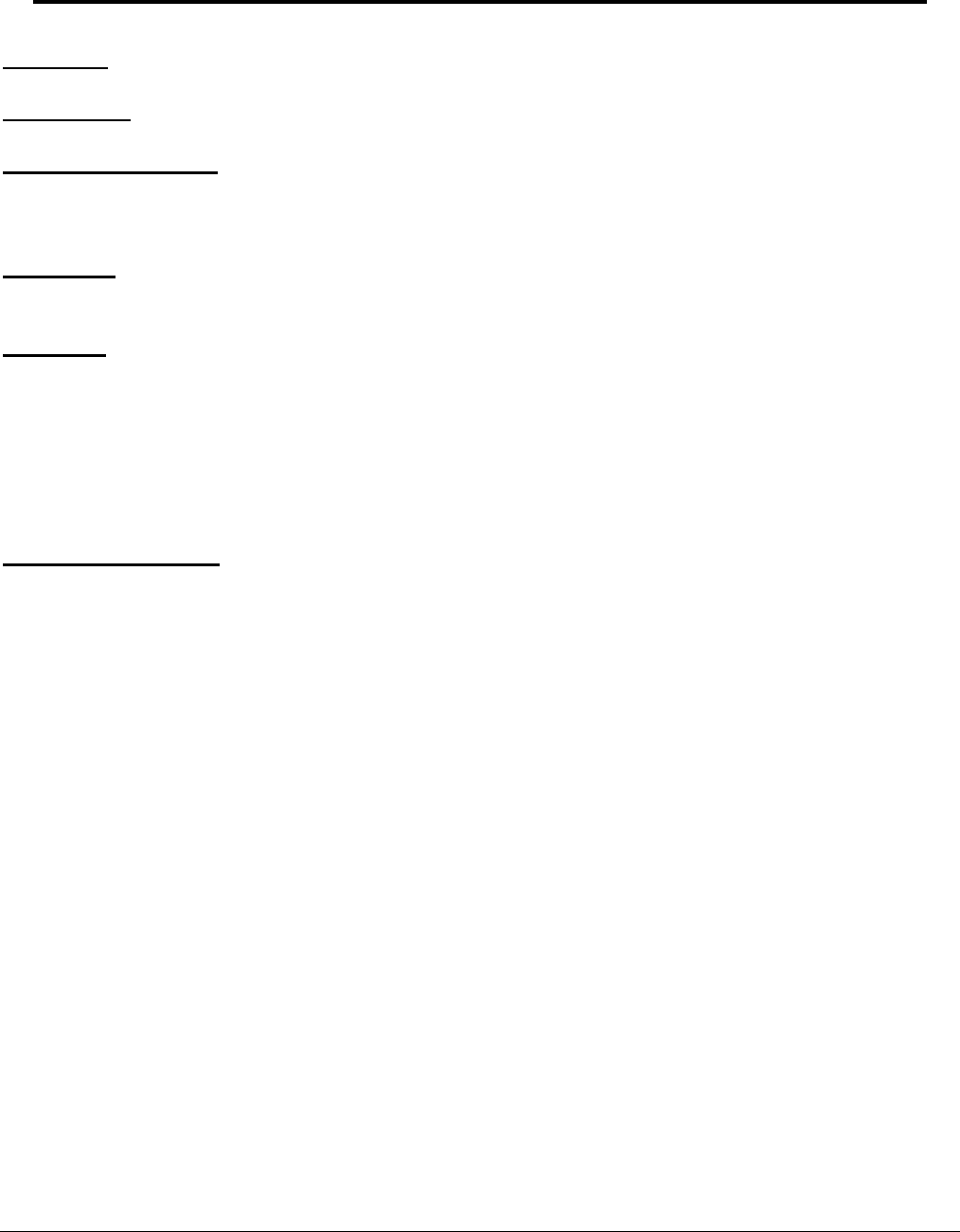
P3
VEHICLE NUMBER – PERSON LEVEL (MV OCCUPANT)
FORMAT: 3 numeric
SAS NAME: Vehicle.VEH_NO; Person.VEH_NO; Parkwork.VEH_NO
ELEMENT VALUES:
001-999
Definition: This element identifies the vehicle number associated with this motor vehicle
occupant.
Remarks:
001-999 is used for motor vehicle occupants (In-Transport, Parked/Stopped Off Roadway/
Working Motor Vehicles and Motor Vehicles in Motion Outside the Trafficway).
Persons ejected or who fall from a motor vehicle in-transport are still considered occupants of
that vehicle for the duration of the unstabilized situation.
Consistency Check:
IF THEN
(CSI5) VEHICLE NUMBER at the Perso
Level is greater than 000,
n VEHICLE NUMBER at the Person Level
must equal a VEHICLE NUMBER at the
Vehicle Level.
2015 721
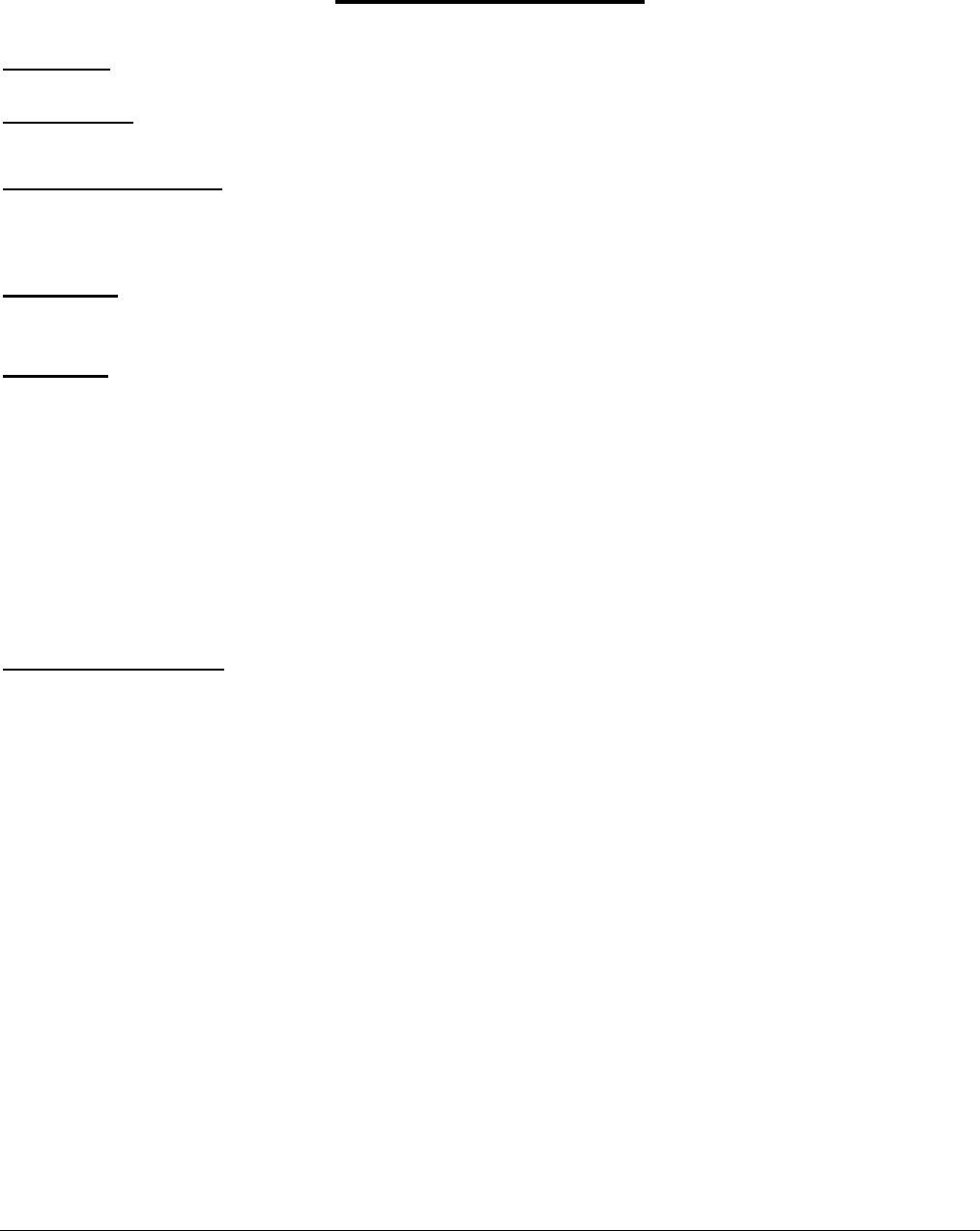
2015 723
P4/NM3
PERSON NUMBER
FORMAT: 3 numeric
SAS NAME: Person.PER_NO
ELEMENT VALUES:
001-999 Assigned Number/ Computer Assigned
Definition: This element identifies a number for the motor vehicle occupant in consecutive
order for the vehicle they occupied.
Remarks:
Person Number is assigned using the PAR's person number.
Person Level (Motor Vehicle Occupant) must be numbered consecutively beginning with “001”
for each motor vehicle occupant. Drivers do not have to be “001.” Numbers must not be
skipped.
Person Level (Not a Motor Vehicle Occupant) must be numbered consecutively beginning with
“001” for persons not in motor vehicles. Numbers must not be skipped.
Consistency Check:
IF THEN
(CSI6) For each VEHICLE NUMBER, PERSON NUMBERS must be consecutive,
beginning with 001 and with no gaps.

2015 725
P5/NM5
AGE
FORMAT: 3 numeric
SAS NAME: Person.Age
ELEMENT VALUES:
Blank
000 Less than One Year
001-120 Actual Age*
998 Not Reported
999 Unknown
Definition: This element identifies the persons age, in years, with respect to the person's last
birthday.
Remarks:
If the case materials do not show the age of injured or uninjured drivers or passengers and
there is no other information about age, e.g., in the narrative/diagram, then use 998 (Not
Reported).
998 (Not Reported)
If a state’s crash report manual instructs to leave blank data blocks that are not applicable,
then a blank in those data blocks are NOT considered “Not Reported”.
Code 998 (Not Reported) in these two situations:
1. No field or coding block exists on the state’s crash report to provide the information
to code this element AND no other information is available to code the element (e.g.,
narrative, diagram, case materials)
2. A field or coding block exists on the state’s crash report that would provide the
information needed to code this element, but it has been left blank, AND no other
information is available to code the element (e.g., narrative, diagram, case
materials).
* Values greater than “094” are unlikely occurrences, and they will raise an error flag.
* Values greater than “120” are not permitted.
999 (Unknown) is used if the investigating officer indicates that this occupant’s age is
unknown.

726 2015
P5/NM5
FARS SPECIAL INSTRUCTION:
For drivers, verify age with data on Licensing File. Licensing data takes precedence over
crash report data.
Consistency Checks:
IF
(7P0F) PERSON TYPE equals 01,
(8P0P) PERSON TYPE equals 01, and AGE
is less than 008,
(8P1P) PERSON TYPE equals 01, and AGE
is less than 008,
(9L0F) PERSON TYPE equals 01, and
RELATED FACTORS-DRIVER
LEVEL equals 12,
(D060) NON-CDL LICENSE STATUS equals
1-4, 6, or COMMERCIAL MOTOR
VEHICLE LICENSE STATUS equals
1-8, and PERSON TYPE equals 01,
(D620) NON-CDL LICENSE TYPE equals 7,
(D630) NON-CDL LICENSE TYPE equals 2,
(D640) AGE equals 014-017, and PERSON
TYPE equals 01,
(D650) AGE equals 018-120, and PERSON
TYPE equals 01,and NON-CDL
LICENSE STATUS does not equal 0,
(P010) PERSON TYPE equals 01,
(P020) PERSON TYPE equals 02, 03, 09,
and RESTRAINT SYSTEM/HELMET
USE equals 04, 10-12,
(P180) PERSON TYPE equals 01, and AGE
is less than 009,
(P1A0) AGE is less than 012, and INJURY
SEVERITY equals 4,
THEN
AGE must not be less than 002.
BODY TYPE must not equal 01-12,
14-17, 19-22, 28-33, 39-42, 45, 48-52,
55, 58-67, 71, 72, 78-83, 89, 92, 93.
BODY TYPE should equal 88, 91.
SEX must equal 2, and AGE must be
greater than 012.
AGE should not be less than 015.
AGE (for the driver) should equal
014-016.
AGE (for the driver) should equal
015-017.
NON-CDL LICENSE TYPE should equal
2, 7.
NON-CDL LICENSE TYPE should equal
1.
AGE should not be less than 012.
AGE should be less than 010, or equal
to 998 or 999.
BODY TYPE should not equal 90.
FATAL INJURY AT WORK should equal
0.
(U120) UNLIKELY: AGE should not be greater than 094, unless equal to 998, 999.
(U360) UNLIKELY: HIT-AND-RUN equals 0 or 9, and AGE equals 999.

2015 727
P5/NM5
Consistency Check (FARS Only):
IF THEN
(5W0P) RELATED FACTORS-PERSON
LEVEL equals 18,
SEX must equal 2, and AGE must be
greater than 012.

2015 729
P6/NM6
SEX
FORMAT: 1 numeric
SAS NAME: Person.Sex
ELEMENT VALUES:
1 Male
2 Female
8 Not Reported
9 Unknown
Definition: This element identifies the sex of the person involved in the crash
Remarks:
If the case materials do not show the sex of injured or uninjured drivers or passengers and
there is no other information about sex, e.g., in the narrative/diagram, then use 8 (Not
Reported).
8 (Not Reported)
If a state’s crash report manual instructs to leave blank data blocks that are not applicable,
then a blank in those data blocks are NOT considered “Not Reported”.
Code 8 (Not Reported) in these two situations:
1. No field or coding block exists on the state’s crash report to provide the information
to code this element AND no other information is available to code the element (e.g.,
narrative, diagram, case materials)
2. A field or coding block exists on the state’s crash report that would provide the
information needed to code this element, but it has been left blank, AND no other
information is available to code the element (e.g., narrative, diagram, case
materials).
9 (Unknown) is used if the investigating officer indicates that this occupant’s sex is unknown.
Consistency Checks:
IF THEN
(9L0F) PERSON TYPE equals 01, and
RELATED FACTORS-DRIVER
LEVEL equals 12,
SEX must equal 2, and AGE must be
greater than 012.

730 2015
P6/NM6
IF THEN
(U340) UNLIKELY: HIT-AND-RUN equals 0 or 9, and SEX equals 9.
Consistency Checks (FARS Only):
IF THEN
(5W0P) RELATED FACTORS-PERSON
LEVEL equals 18,
SEX must equal 2, and AGE must be
greater than 012.
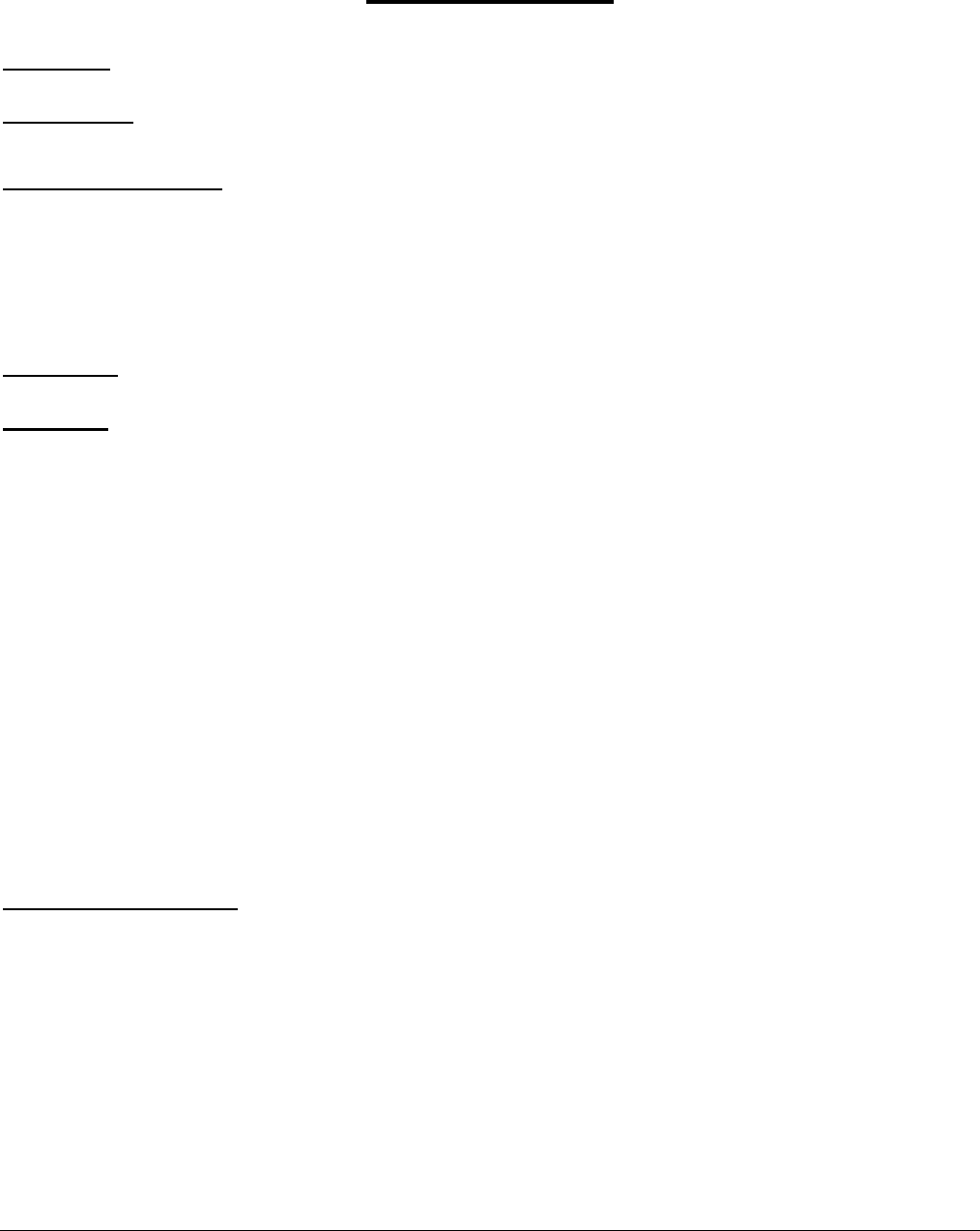
2015 731
P7
PERSON TYPE
FORMAT: 2 numeric
SAS NAME: Person.PER_TYP
ELEMENT VALUES:
01 Driver of a Motor Vehicle In-Transport
02 Passenger of a Motor Vehicle In-Transport
03 Occupant of a Motor Vehicle Not In-Transport
09 Unknown Occupant Type in a Motor Vehicle In-Transport
Definition: This element describes the role of this person involved in the crash.
Remarks:
An involved person in a crash must maintain Person Type during the crash. Once the
unstabilized situation begins, a driver, passenger or non-motorist/non-occupant cannot change
Person Type until the accident stabilizes.
If a person is entering or exiting a vehicle before the unstabilized situation begins, try to
determine if the person has successfully changed type before control is lost. (e.g., a pedestrian
getting into an automobile that begins to move, a passenger stepping off of a bus as it begins
to pull away, etc.).
Attributes 01, 02 and 09 are used for occupants of a motor vehicle in-transport. This includes
occupants of motor vehicles that are in motion outside the trafficway.
09 (Unknown Occupant Type in a Motor Vehicle In-Transport) is used when it cannot be
determined if the person was the driver or passenger, but it is known that the person was an
occupant of a motor vehicle in-transport.
Consistency Checks:
IF THEN
(1Q0F) PERSON TYPE equals 01, and SEATING POSITION must not equal
BODY TYPE equals 80-83, 88, 89, 12-55, 99.
(2M0F) PERSON TYPE equals 01, SEATING POSITION must not equal
21-55.
(2Q0F) PERSON TYPE equals 02, 03, 09, SEATING POSITION must not equal
and BODY TYPE equals 01, 02, 04, 31-50.
08, 10, 17, 31-33, 39-41, 45, 48, 90,
91,

732 2015
P7
IF
(3H0F) DRIVER PRESENCE equals 1,
(3M0F) PERSON TYPE equals 01,
(3P0F) PERSON TYPE equals 03-08, 10, 19
(3Q0F) PERSON TYPE equals 02, 03, 09,
and BODY TYPE equals 01-16, 17,
19, 20, 22, 28-33, 39, 41, 42, 50-52,
55, 58, 59, 65, 80-83, 88-92, 94, 95,
97,
(4H0F) DRIVER PRESENCE equals 0, 9,
(4Q0F) PERSON TYPE equals 02, 03, 09,
and BODY TYPE equals 80-83,
88, 89,
(4Q1F) PERSON TYPE equals 02, 03, and
BODY TYPE equals 21,
(570F) FIRST HARMFUL EVENT equals
05, 06,
(5M0F) PERSON TYPE equals 01,
(5M0G) SPECIAL USE equals 06, and
PERSON TYPE equals 02 or 09,
(5N0F) PERSON TYPE equals 02,
(5Q0F) PERSON TYPE equals 02, and
BODY TYPE equals 50-52, 55, 58,
59,
(5Z0F) SEQUENCE OF EVENTS equals 08,
(6Q0F) PERSON TYPE equals 02, 03, 09,
and BODY TYPE equals 60-67,
71, 72, 78, 79,
THEN
there must be one and only one Person
Level form for that vehicle with PERSON
TYPE equal to 01, or there must be no
Person Level form for that vehicle with
PERSON TYPE equal to 01 and at least
two Person Level forms for that vehicle
with PERSON TYPE equal to 09.
RESTRAINT SYSTEM/HELMET USE
must not equal 04, 10-12.
INJURY SEVERITY should not equal 6.
SEATING POSITION must not equal 50.
there must not be a Person Level form
for that vehicle with PERSON TYPE
equal to 01.
SEATING POSITION must not equal 12,
14-19, 22-50.
SEATING POSITION must not equal 50,
52.
at least one PERSON TYPE equal to
01-03, 09 must have INJURY
SEVERITY equal to 1-5 or blank.
all RELATED FACTORS-PERSON
LEVEL must equal 00.
RELATED FACTORS - PERSON (MV
OCCUPANT) LEVEL should equal 86 or
92.
RELATED FACTORS-PERSON LEVEL
(MV Occupant) must not equal 21, 26,
28, 29, 33, 37, 40-42, 44, 45, 47, 51-53,
57-70, 72-78, 80-83, 91.
SEATING POSITION must not equal
11, 21-50, 98, 99.
at least one person must have PERSON
TYPE equal to 05, 10.
SEATING POSITION must not equal
31-49.

P7
IF THEN
(7M0F) PERSON TYPE equals 03, and
SEATING POSITION does not equal
11,
RELATED FACTORS-PERSON LEVEL
(MV Occupant) must not equal 21, 26,
28, 29, 33, 37, 40-42, 44, 45, 47, 51-53,
57-70, 72-78, 80-83, 91.
(7M1F)
(7P0F)
(7Q0F)
PERSON TYPE equals 03, and
SEATING POSITION is not equal to
11 or 13, and INJURY SEVERITY
does not equal 4,
PERSON TYPE equals 01,
PERSON TYPE equals 09, and
BODY TYPE equals 50-52, 55, 58,
59,
DRUG TEST STATUS must not equal 8,
any DRUG TEST TYPE must not equal
6, and any DRUG TEST RESULTS
must not equal 095.
AGE must not be less than 002.
SEATING POSITION must not equal
12-50, 52-54.
(7Z0F) any SEQUENCE OF EVENTS equals
05, 06,
at least one occupant of this vehicle
(PERSON TYPES 01, 02, 09) must have
INJURY SEVERITY equal to 1-5, or
blank.
(8P0P) PERSON TYPE equals 01, and AGE
is less than 008,
BODY TYPE must not equal 01-12,
14-17, 19-22, 28-33, 39-42, 45, 48-52,
55, 58-67, 71, 72, 78-83, 89, 92, 93.
(8P1P) PERSON TYPE equals 01, and AGE
is less than 008,
BODY TYPE should equal 88, 91.
(9A5P)
(9B7P)
(CL0P)
PERSON TYPE equals 03,
UNIT TYPE equals 2-4,
PERSON TYPE equals 09,
UNIT TYPE must equal 2-4.
PERSON TYPE of all occupants of this
vehicle must equal 03.
RELATED FACTORS-PERSON LEVEL
(MV Occupant) must not equal 21, 26,
28, 29, 33, 37, 40-42, 44, 45, 47, 51, 52,
56-70, 72-78, 80-83, 91.
(D060) NON-CDL LICENSE STATUS equals
1-4, 6, or COMMERCIAL MOTOR
AGE should not be less than 015.
(D090)
VEHICLE LICENSE STATUS equals
1-8, and PERSON TYPE equals 01,
VIOLATIONS CHARGED equals
11-19, and PERSON TYPE equals
01, 03,
POLICE REPORTED ALCOHOL
INVOLVEMENT should equal 1, or
POLICE REPORTED DRUG
(D640)
(D650)
AGE equals 014-017, and PERSON
TYPE equals 01,
AGE equals 018-120, and PERSON
TYPE equals 01,and NON-CDL
LICENSE STATUS does not equal 0,
INVOLVEMENT should equal 1.
NON-CDL LICENSE TYPE should equal
2, 7.
NON-CDL LICENSE TYPE should equal
1.
(FP0F) PERSON TYPE is blank, case status is flawed.
(P010) PERSON TYPE equals 01, AGE should not be less than 012.
2015 733

734 2015
P7
IF THEN
(P01F)
(P020)
(P030)
PERSON TYPE equals 01-03, 09,
and RESTRAINT SYSTEM/HELMET
USE equals 01-04, 08, 10-12, and
BODY TYPE does not equal 80-89,
PERSON TYPE equals 02, 03, 09,
and RESTRAINT SYSTEM/HELMET
USE equals 04, 10-12,
PERSON TYPE equals 01,
EJECTION should equal 0 or 7.
AGE should be less than 010, or equal
to 998 or 999.
SEATING POSITION should not equal
12-19.
(P040) PERSON TYPE equals 02, 09, SEATING POSITION should not equal
11.
(P071)
(P072)
PERSON TYPE equals 02, 04-08, 10,
and INJURY SEVERITY does not
equal 4,
PERSON TYPE equals 02, 03, and
INJURY SEVERITY equals 0, and
ALCOHOL TEST RESULT equals
996,
ALCOHOL TEST STATUS should not
equal 9, ALCOHOL TEST TYPE should
not equal 99, and ALCOHOL TEST
RESULT should not equal 999.
POLICE REPORTED ALCOHOL
INVOLVEMENT should equal 0, 8.
(P073)
(P074)
(P075)
(P130)
PERSON TYPE equals 02, 04-08, 10,
and INJURY SEVERITY does not
equal 4,
PERSON TYPE equals 02, 04-08, 10,
and INJURY SEVERITY does not
equal 4,
PERSON TYPE equals 02, 04-08, 10
or 19, and INJURY SEVERITY does
not equal 4,
BODY TYPE equals 60-67, 71, 72,
78, 79, and PERSON TYPE equals
01, 03, and INJURY SEVERITY
DRUG TEST STATUS should not equal
9, and any DRUG TEST TYPE should
not equal 9, and any DRUG TEST
RESULTS should not equal 999.
ALCOHOL TEST STATUS must not
equal 8, ALCOHOL TEST TYPE must
not equal 95, and ALCOHOL TEST
RESULT must not equal 995.
DRUG TEST STATUS must not equal 8,
any DRUG TEST TYPE must not equal
6, and any DRUG TEST RESULTS must
not equal 095.
FATAL INJURY AT WORK should equal
1.
(P180)
equals 4,
PERSON TYPE equals 01, and AGE
is less than 009,
BODY TYPE should not equal 90.

2015 735
P8/NM8
INJURY SEVERITY
FORMAT: 1 numeric
SAS NAME: Person.Inj_Sev
ELEMENT VALUES:
0 No Apparent Injury (O)
1 Possible Injury (C)
2 Suspected Minor Injury (B)
3 Suspected Serious Injury (A)
4 Fatal Injury (K)
5 Injured, Severity Unknown
6 Died Prior to Crash*
9 Unknown
Definition: This element describes the severity of the injury to this person in the crash.
Remarks:
Enter the police reported injury severity for this person (i.e., occupant, pedestrian or non-
motorist). Most jurisdictions use the KABCO injury coding scheme.
K = Killed
A = Incapacitating Injury
B = Non-incapacitating Injury
C = Possible Injury
O = No Injury
If the police report contains a detailed description of the injuries but does not translate the
injuries into the KABCO codes, use the police method for doing so. For example, injuries that
are considered to be of an incapacitating nature are classified as “A”, Non-incapacitating-
evident injuries are classified as “B”, and possible injuries are “C”. Property damage only (i.e.,
no injury) is classified as “O”.
As a general rule, if the PAR is “blank” where the injury severity is assessed and the person
was at the scene during the police investigation, enter 0 (No Injury [O]). If the PAR is “blank”
and the person was not present during the police investigation, enter 9 (Unknown).
0 (No Apparent Injury) is a situation where there is no reason to believe that the person
received any bodily harm from the motor vehicle crash. There is no physical evidence of injury
and the person does not report any change in normal function. Prior to 2013, this attribute was
known as “0 - No Injury”.

736 2015
P8/NM8
1 (Possible Injury) is any injury reported or claimed that is not a fatal injury, suspected serious
injury or suspected minor injury. Examples include: momentary loss of consciousness, claim
of injury limping, complaint of pain or nausea. Possible injuries are those which are reported
by the person or are indicated by his/her behavior, but no wounds or injuries are readily
evident.
2 (Suspected Minor Injury) is any injury that is evident at the scene of the crash, other than
fatal or serious injuries. Examples include lump on the head, abrasions, bruises, minor
lacerations (cuts on the skin surface with minimal bleeding and no exposure of deeper
tissue/muscle). This does not include momentary unconsciousness. (See 1 (Possible Injury)).
Prior to 2013, this attribute was known as “2 - Non-Incapacitating Evident Injury”.
3 (Suspected Serious Injury) is any injury other than fatal which results in one or more of the
following:
Severe laceration resulting in exposure of underlying tissues/muscle/organs or resulting
in significant loss of blood
Broken or distorted extremity (arm or leg)
Crush injuries
Suspected skull, chest or abdominal injury other than bruises or minor lacerations
Significant burns (second and third degree burns over 10% or more of the body)
Unconsciousness when taken from the crash scene
Paralysis
This does not include limping (the injury cannot be seen). (See 1 (Possible Injury)). Prior to
2013, this attribute was known as “3 - Incapacitating Injury”.
4 (Fatal Injury) A fatal injury is any injury that results in death within 30 days after the motor
vehicle crash in which the injury occurred. If the person did not die at the scene but died within
30 days of the motor vehicle crash in which the injury occurred, the injury classification should
be changed from the attribute previously assigned to the attribute 4 (Fatal Injury).
6 (Died Prior To Crash) refers to non-motor vehicle fatalities that are involved in a motor
vehicle crash; e.g., a heart attack victim, a homicide victim, a suicide or person involved in a
legal intervention that is involved in a motor vehicle traffic crash.
This attribute is used only if the police explicitly states the person died prior to the crash and
the police report indicates the person died as a result of natural causes (e.g., heart attack),
disease, drug overdose or alcohol poisoning, suicide, homicide and legal intervention.
This attribute also applies if the police report indicates that the person died as a result of
natural causes (e.g., heart attack) or disease but is silent about the time of on-set or if on-set is
the result of injuries sustained in the crash.

2015 737
P8/NM8
In suicide incidents, use the following criteria:
1. If the only fatality is the suicide victim and it can be ascertained that the crash was a
suicide, do not code the case.
2. If other fatalities occur, code the case as appropriate. The suicide victim’s Injury
Severity should be coded 6 (Died Prior to Crash) if the death occurred at the time of
the crash (or prior) or 0 (No Apparent Injury) if the death occurred after the crash.
This attribute does not apply if the police report specifically states that the cause of death is a
result of crash-related injury or that on-set occurred after the crash.
* This value is an unlikely occurrence and will raise an edit flag
FARS SPECIAL INSTRUCTION:
Each case must have at least one Person Level form with Injury Severity attribute 4 (Fatal
injury). See Definition: ANSI D16.1; 2.3.1 and 2.3.2
Consistency Checks:
IF THEN
(1R0P) SEATING POSITION equals 51, and INJURY SEVERITY must not equal 0, 9.
BODY TYPE equals 50-52, 55, 58,
59,
(1R1P) If DIED AT SCENE/EN ROUTE INJURY SEVERITY must equal 4.
equals 7, 8,
(1U1F) INJURY SEVERITY equals 4, DEATH DATE must not equal
88888888.
(1U2F) INJURY SEVERITY equals 4, DEATH TIME must not equal 8888.
(2U1F) INJURY SEVERITY is not equal to 4, DEATH DATE must equal 88888888.
(2U2F) INJURY SEVERITY is not equal to 4, DEATH TIME must equal 8888.
(2U3F) INJURY SEVERITY equals 3, TRANSPORTED TO FIRST MEDICAL
FACILITY BY should not equal 0.
(3P0F) PERSON TYPE equals 03-08, 10, 19, INJURY SEVERITY should not equal 6.
(4V1F) INJURY SEVERITY equals 4, DEATH DATE and DEATH TIME for this
person must be within 720 hours of the
CRASH DATE and CRASH TIME.
(570F) FIRST HARMFUL EVENT equals at least one PERSON TYPE equal to
05, 06, 01-03, 09 must have INJURY
SEVERITY equal to 1-5, or blank.
(7E0P) INJURY SEVERITY equals 4, DEATH CERTIFICATE NUMBER must
NOT equal 0000-00-000000.
(7E1P) INJURY SEVERITY equals 4, RACE must not equal 00.
(7E2P) INJURY SEVERITY equals 4, HISPANIC ORIGIN must not equal 00.

738 2015
P8/NM8
IF THEN
(7E3P) INJURY SEVERITY does not equal 4, RACE AND HISPANIC ORIGIN must
equal 00.
(7E3P) INJURY SEVERITY does not equal 4, RACE AND HISPANIC ORIGIN must
equal 00.
(7F0P) DEATH CERTIFICATE NUMBER is INJURY SEVERITY must equal 4.
not blank or 0000-00-000000,
(7F1P) RACE equals 00, INJURY SEVERITY must not equal 4.
(7F2P) HISPANIC ORIGIN equals 00, INJURY SEVERITY must not equal 4.
(7F3P) RACE is not equal to 00, and INJURY SEVERITY must equal 4.
HISPANIC ORIGIN is not equal to 00,
(7M1F) PERSON TYPE equals 03, and DRUG TEST STATUS must not equal 8,
(7R0P)
SEATING POSITION is not equal to
11 or 13, and INJURY SEVERITY
does not equal 4,
FATAL INJURY AT WORK equals
any DRUG TEST TYPE must not equal
6, and any DRUG TEST RESULTS
must not equal 095.
INJURY SEVERITY must equal 4.
0, 1, 9,
(7W0P) FATAL INJURY AT WORK equals 8, INJURY SEVERITY must not equal 4.
(7Z0F) any SEQUENCE OF EVENTS equals at least one occupant of this vehicle
05, 06, (PERSON TYPES 01, 02, 09) must have
INJURY SEVERITY equal to 1-5, or
blank.
(FP8F) INJURY SEVERITY is blank, case status is flawed.
(P071) PERSON TYPE equals 02, 04-08, 10, ALCOHOL TEST STATUS should not
and INJURY SEVERITY does not equal 9, ALCOHOL TEST TYPE should
equal 4, not equal 99, and ALCOHOL TEST
RESULT should not equal 999.
(P072) PERSON TYPE equals 02, 03, and POLICE REPORTED ALCOHOL
INJURY SEVERITY equals 0, and INVOLVEMENT should equal 0, 8.
ALCOHOL TEST RESULT equals
996,
(P073) PERSON TYPE equals 02, 04-08, 10, DRUG TEST STATUS should not equal
and INJURY SEVERITY does not 9, and any DRUG TEST TYPE should
equal 4, not equal 9, and any DRUG TEST
RESULTS should not equal 999.
(P074) PERSON TYPE equals 02, 04-08, 10, ALCOHOL TEST STATUS must not
and INJURY SEVERITY does not equal 8, ALCOHOL TEST TYPE must
equal 4, not equal 95, and ALCOHOL TEST
RESULT must not equal 995.
(P075) PERSON TYPE equals 02, 04-08, 10 DRUG TEST STATUS must not equal 8,
or 19, and INJURY SEVERITY does any DRUG TEST TYPE must not equal
not equal 4, 6, and any DRUG TEST RESULTS must
not equal 095.
(P090) INJURY SEVERITY equals 0, TRANSPORTED TO FIRST MEDICAL
FACILITY BY must equal 0.

2015 739
P8/NM8
IF THEN
(P130) BODY TYPE equals 60-67, 71, 72, FATAL INJURY AT WORK should equal
78, 79, and PERSON TYPE equals 1.
01, 03, and INJURY SEVERITY
equals 4,
(P1A0) AGE is less than 012, and INJURY FATAL INJURY AT WORK should equal
SEVERITY equals 4, 0.
(P300) POLICE REPORTED ALCOHOL ALCOHOL TEST STATUS should not
INVOLVEMENT equals 1, and equal 0, 1.
INJURY SEVERITY equals 4,
(P53P) INJURY SEVERITY equals 0-3, 5, 6, DIED AT SCENE/EN ROUTE must
equal 0.
(U160) UNLIKELY: INJURY SEVERITY equals 6.
(U350) UNLIKELY: INJURY SEVERITY equals 1-6, and SEATING POSITION equals
98.
Consistency Checks (GES Only):
IF THEN
(5A4P) FINAL STRATUM equals 1, there should exist:
1) at least one vehicle where BODY
TYPE equals 01-49, and UNIT TYPE
equals 1, and VEHICLE REMOVAL
equals 2, and INJURY SEVERITY
equals 4 for at least one occupant of that
vehicle; or
2) one and only one vehicle where
BODY TYPE equals 01-49, and UNIT
TYPE equals 1, and VEHICLE
REMOVAL equals 2, and INJURY
SEVERITY equals 3 for at least one
occupant of that vehicle; or
3) 2 or more vehicles where BODY
TYPE equals 01-49, and UNIT TYPE
equals 1, and at least 2 vehicles where
BODY TYPE equals 01-49, and UNIT
TYPE equals 1, and VEHICLE
REMOVAL equals 2, and INJURY
SEVERITY equals 3 for at least one
occupant of a vehicle where BODY
TYPE equals 01-49, and UNIT TYPE
equals 1, and VEHICLE REMOVAL
equals 2.

740 2015
P8/NM8
IF THEN
(5A5P) FINAL STRATUM equals 5,
(5A6P) FINAL STRATUM equals 2,
(5A7P) FINAL STRATUM equals 3,
(5A8P) FINAL STRATUM equals 4,
(5A9P) FINAL STRATUM equals 4, and
INJURY SEVERITY equals 1,
Consistency Check (FARS Only):
IF
there should exist at least one vehicle
where BODY TYPE equals 01-49, and
UNIT TYPE equals 1, and VEHICLE
REMOVAL equals 2, and INJURY
SEVERITY equals 1, 2, 3 or 5 for at
least one occupant of that vehicle.
there 1) should exist at least one vehicle
where UNIT TYPE equals 1, and
VEHICLE REMOVAL equals 2; or 2)
INJURY SEVERITY should equal
1-5 for at least one person in the crash.
INJURY SEVERITY must equal 2-4 for
at least one person in the crash.
INJURY SEVERITY must not equal 2-4
for any person in the crash.
there should exist no vehicles where
BODY TYPE equals 60-79, and UNIT
TYPE equals 1.
THEN
(4U0F) Each original submission must have at least one Person Level form with INJURY
SEVERITY coded 4.

2015 741
P9
SEATING POSITION
FORMAT: 2 numeric
SAS NAME: Person.Seat_Pos
ELEMENT VALUES:
11 Front Seat, Left Side
12 Front Seat, Middle
13 Front Seat, Right Side
18 Front Seat, Other
19 Front Seat, Unknown
21 Second Seat, Left Side
22 Second Seat, Middle
23 Second Seat, Right Side
28 Second Seat, Other
29 Second Seat, Unknown
31 Third Seat, Left Side
32 Third Seat, Middle
33 Third Seat, Right Side
38 Third Seat, Other
39 Third Seat, Unknown
41 Fourth Seat, Left Side
42 Fourth Seat, Middle
43 Fourth Seat, Right Side
48 Fourth Seat, Other
49 Fourth Seat, Unknown
50 Sleeper Section of Cab (Truck)
51 Other Passenger in enclosed passenger or cargo area
52 Other Passenger in unenclosed passenger or cargo area
53 Other Passenger in passenger or cargo area, unknown whether or not enclosed
54 Trailing Unit
55 Riding on Exterior of Vehicle
98 Not Reported
99 Unknown
Definition: This element identifies the location of this person in or on the vehicle.
Remarks:
Seating Position is determined by the location of the occupant in relation to the seat row and
the forward longitudinal axis of the vehicle.

742 2015
P9
More than one person may be assigned the same seating position; however, this is allowed
only when a person is sitting on someone’s lap (e.g., child on mother’s lap).
If the PAR does not specifically state that one person was on the lap of another, then see the
discussion below under 18 (Front Seat, Other), 28 (Second Seat, Other), 38 (Third Seat,
Other) and 48 (Fourth Seat, Other).
In seating rows designated for only two passengers, use 11 (Front Seat, Left Side), 13 (Front
Seat, Right Side), 21 (Second Seat, Left Side), 23 (Second Seat, Right Side), 31 (Third
Seat, Left Side), 33 (Third Seat, Right Side), 41 (Fourth Seat, Left Side), 43 (Fourth Seat,
Right Side) or 51 (Other Passenger in enclosed passenger or cargo area).
11 (Front Seat, Left Side) is typically thought of as the driver seating position. This is
also used for an assumed driver of a hit-and-run vehicle unless evidence indicates a different
position for the person or persons. Note: For motorcycle occupants, see passage below.
18 (Front Seat, Other), 28 (Second Seat, Other), 38 (Third Seat, Other) and 48 (Fourth
Seat, Other) are used to record the position of someone sitting on the floor or lying across the
seat. In addition, enter these attributes when two or more persons are sitting abreast of one
another in the same seating location (as opposed to on or in someone’s lap), since only one
occupant can be assigned the seat’s position. If the PAR provides enough specific
information, and only one person was using a restraint, then assign the seat position to the
person using the restraint, If no restraint was used, or both people were sharing a restraint,
then assign the seat position to the older person.
18 (Front Seat, Other) is used if the only seat in the front seating area is a driver’s seat (e.g.,
bucket, pedestal, etc.), and the occupant was in the area but not in the seat. This situation
could occur because of vehicle design or seat removal. The same logic applies to other seat
areas.
50 (Sleeper Section of Cab [Truck]) is used if the occupant’s vehicle is a medium or heavy
truck and has a cab sleeper, and this occupant is in the sleeper section at the time of the
crash.
51 (Other Passenger in Enclosed Passenger or Cargo Area) is used when an occupant is
in the fifth or higher numbered seat row, in an enclosed area where no defined seating exists
or using a fold-down type seat in its folded-down position. This attribute is also used for bus
passengers in undetermined seating (not driver) and for bus occupants that fall from an open
door.
Note: Persons in treatment compartment of an ambulance, code as 51 (Other Passenger in
Enclosed Passenger or Cargo Area). (See examples under Related Factors - Person (MV
Occupant) Level attribute 92 (Person in Ambulance Treatment Compartment).)
Enter 52 (Other Passenger in Unenclosed Passenger or Cargo area) when an occupant is
in the fifth or higher numbered seat area, in an unenclosed area where no defined seating

2015 743
P9
exists or using a fold-down type seat in its folded-down position. Examples include passenger
riding in an open pickup bed, top of open double-decker bus, etc.
If seating in the vehicle is longitudinal rather than lateral, use the basic idea of a vehicle interior
being divided laterally into roughly equal thirds and visualize lateral rows of seats to determine
what seat position is the best descriptor.
If seating in the vehicle is longitudinal rather than lateral, use the basic idea of a vehicle interior
being divided laterally into roughly equal thirds and visualize lateral rows of seats to determine
what seat position is the best descriptor.
For rearward facing seats, use the basic idea described in the previous paragraph to describe
the occupant’s seat position.
If a seat row has more than three designated seat positions, the occupants should have their
positions assigned as usual for the left and right positions, while the two center positions would
be entered as Other (i.e., 18 (Front Seat, Other), 28 (Second Seat, Other), 38 (Third Seat,
Other), 48 (Fourth Seat, Other) or 51 (Other Passenger in Enclosed Passenger or Cargo
Area)) depending upon the seat row.
For BODY TYPE 80-90 (e.g., Motorcycles, ATV/ATC) enter the driver as 11 (Front Seat,
Left Side); sidecar passengers as 13 (Front Seat, Right Side); any seated passengers
behind the driver as 21 (Second Seat, Left Side) and a passenger on the lap of the driver (in
front of) as 11 (Front Seat, Left Side). 55 (Riding on Exterior of Vehicle) is applicable to a
motorcycle or ATC occupant riding on the fenders or handlebars.
54 (Trailing Unit) is used when an occupant is in or on a trailing unit (i.e., Vehicle Trailing, for
this occupant’s vehicle must be coded 1, one or more trailing units).
55 (Riding on Exterior of Vehicle) is used when an occupant is riding on a fender, the boot of
a convertible, etc.
If the case materials do not show the seating row of a passenger and there is no other
information about seating position, e.g., in the narrative/diagram, then use 98 (Not Reported).
98 (Not Reported)
If a state’s crash report manual instructs to leave blank data blocks that are not applicable,
then a blank in those data blocks are NOT considered “Not Reported”.
Code 98 (Not Reported) in these two situations:
1. No field or coding block exists on the state’s crash report to provide the information
to code this element AND no other information is available to code the element (e.g.,
narrative, diagram, case materials)

744 2015
P9
2. A field or coding block exists on the state’s crash report that would provide the
information needed to code this element, but it has been left blank, AND no other
information is available to code the element (e.g., narrative, diagram, case
materials).
99 (Unknown) is used if the investigating officer indicates that this occupant’s seating position
is unknown.
Consistency Checks:
IF THEN
(1Q0F)
(1R0P)
(2M0F)
PERSON TYPE equals 01, and BODY
TYPE equals 80-83, 88, 89,
SEATING POSITION equals 51, and
BODY TYPE equals 50-52, 55, 58, 59,
PERSON TYPE equals 01,
SEATING POSITION must not equal
12-55, 99.
INJURY SEVERITY must not equal 0, 9.
SEATING POSITION must not equal
21-55.
(2Q0F) PERSON TYPE equals 02, 03, 09,
and BODY TYPE equals 01, 02, 04,
08, 10, 17, 31-33, 39-41, 45, 48, 90,
SEATING POSITION must not equal
31-50.
91,
(3Q0F) PERSON TYPE equals 02, 03, 09,
and BODY TYPE equals 01-17,19, 20,
22, 28-33, 39, 41, 42, 50-52, 55, 58,
SEATING POSITION must not equal 50.
59, 65, 80-83, 88-92, 94, 95, 97,
(3R0P) AIR BAG DEPLOYED does not equal
00, 98 or 99,
SEATING POSITION should not equal
12, 22, 32, 41-55.
(3S0P)
(4Q0F)
SEATING POSITION equals 55,
PERSON TYPE equals 02, 03, 09,
and BODY TYPE equals 80-83, 88,
89,
EJECTION must equal 8.
SEATING POSITION must not equal 12,
14-19, 22-50.
(4Q1F)
(4R0P)
(5Q0F)
(6Q0F)
PERSON TYPE equals 02, 03, and
BODY TYPE equals 21,
SEATING POSITION equals 54,
PERSON TYPE equals 02, and BODY
TYPE equals 50-52, 55, 58, 59,
PERSON TYPE equals 02, 03, 09,
and BODY TYPE equals 60-67, 71,
72, 78, 79,
SEATING POSITION must not equal 50,
52.
VEHICLE TRAILING must not equal 0.
SEATING POSITION must not equal
11, 21-50, 98, 99.
SEATING POSITION must not equal
31-49.
(7M0F) PERSON TYPE equals 03, and
SEATING POSITION does not equal
11,
RELATED FACTORS-PERSON LEVEL
(MV Occupant) must not equal 21, 26,
28, 29, 33, 37, 40-42, 44, 45, 47, 51-53,
57-70, 72-78, 80-83, 91.

2015 745
P9
IF THEN
(7M1F) PERSON TYPE equals 03, and DRUG TEST STATUS must not equal 8,
(7Q0F)
SEATING POSITION is not equal to
11 or 13, and INJURY SEVERITY
does not equal 4,
PERSON TYPE equals 09, and BODY
any DRUG TEST TYPE must not equal
6, and any DRUG TEST RESULTS
must not equal 095.
SEATING POSITION must not equal
TYPE equals 50-52, 55, 58, 59, 12-50, 52-54.
(BP0P) MODEL YEAR is greater than 1999, AIR BAG DEPLOYED should not equal
and BODY TYPE does not equal 00.
50-52, 58-66, 71-79, 80-83, 88-93, 95,
97, and SEATING POSITION equals
11, 13, 18, 19,
(P030) PERSON TYPE equals 01, SEATING POSITION should not equal
12-19.
(P040) PERSON TYPE equals 02, 09, SEATING POSITION should not equal
11.
(P060) SEATING POSITION equals 18, 28, RESTRAINT SYSTEM/HELMET USE
38, 48, 50-55, should not equal 01, 03.
(P094) EJECTION equals 8, SEATING POSITION must equal 55, or
BODY TYPE must equal 80-83, 88, 89.
(P210) AIR BAG DEPLOYED equals 28, SEATING POSITION should equal 13.
(P230) SEATING POSITION equals 21, 23, AIR BAG DEPLOYED should equal 00.
28, 29, 31, 33, 38 or 39, and BODY
TYPE equals 50-97,
(P260) SEATING POSITION equals 18-19, AIR BAG DEPLOYED should equal 00,
99.
(P290) AIR BAG DEPLOYED equals 01-03, SEATING POSITION should equal 11,
07-09, 20, 28, and BODY TYPE 13, 21, 23, 31 or 33.
equals 01-49, and MODEL YEAR
equals 1998 or newer,
(P320) SEATING POSITION equals 22, 23, RESTRAINT SYSTEM/HELMET USE
31-53, must not equal 05, 16, 17, 19, 29.
(P330) RESTRAINT SYSTEM/HELMET USE SEATING POSITION should equal
equals 00, 50-55.
(P340) SEATING POSITION equals 50, RESTRAINT SYSTEM/HELMET USE
52-55, should equal 00.
(U130) UNLIKELY: SEATING POSITION equals 41-43, 48.
(U350) UNLIKELY: INJURY SEVERITY equals 1-6, and SEATING POSITION equals
98.
(V320) BODY TYPE equals 50-52, 55, 58-66, AIR BAG DEPLOYED should equal 00.
71-79, and SEATING POSITION does
not equal 11, 13, 98,
(V950) VEHICLE MODEL YEAR is less than RESTRAINT SYSTEM/HELMET USE
1994, and SEATING POSITION should not equal 01, 03, and BODY
equals 31, 33, 39, TYPE should equal 12, 15, 16, 19-21.
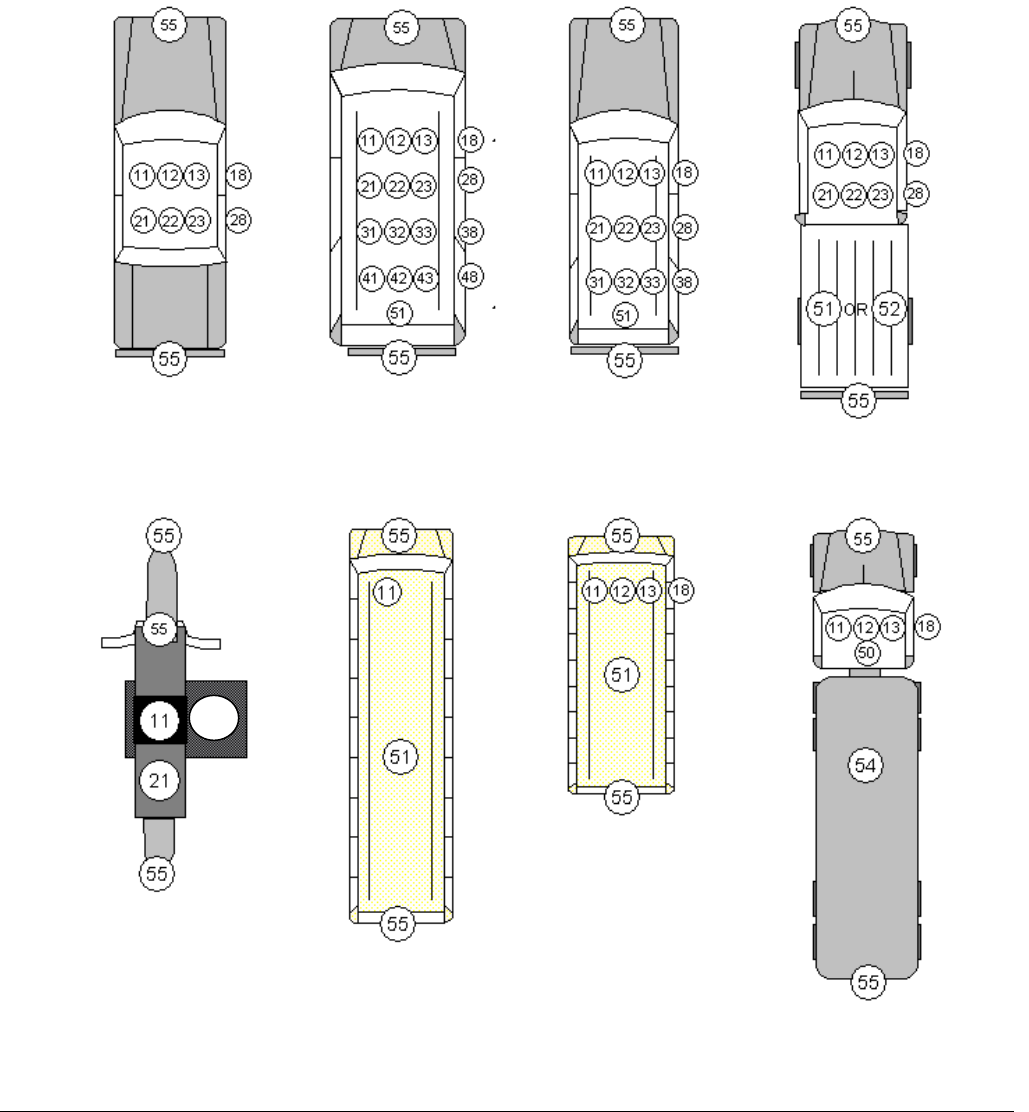
746 2015
P9
PICKUP/SINGLE TRUCK
(ENCLOSED OR
C
AR VAN
SU
V
U
NEN
C
L
O
S
ED BED
)
MOTORCYCLE BUS VAN-BASED SEMI WITH
BUS ONE TRAILER
13
* For van-based buses with a BODY TYPE 21 (Large Van), use the actual seating position if
known, or use code “51” for the 2nd, 3rd & 4th rows, if actual seating position is not known.

2015 747
P10
RESTRAINT SYSTEM/HELMET USE
FORMAT: 2 numeric
SAS NAME: Person.REST_USE
ELEMENT VALUES:
00 Not Applicable
07 None Used
03 Shoulder and Lap Belt Used
01 Shoulder Belt Only Used
02 Lap Belt Only Used
08 Restraint Used - Type Unknown
10 Child Restraint System - Forward Facing
11 Child Restraint System - Rear Facing
12 Booster Seat
04 Child Restraint Type Unknown
05 DOT-Compliant Motorcycle Helmet
16 Helmet, Other than DOT-Compliant Motorcycle Helmet
19 Helmet, Unknown if DOT-Compliant
17 No Helmet
29 Unknown if Helmet Worn
97 Other
98 Not Reported
99 Unknown
Definition: This element records the restraint equipment in use by the occupant, or the
helmet in use by a motorcyclist, at the time of the crash.
Remarks:
Code this element regardless of whether the vehicle is equipped with manual systems,
automatic belts or harnesses, air bags, or any combination of these. Whether the restraint was
manual or automatic will be determined via the VIN. Even if the VIN is unknown, use this rule.
The child restraints/booster seats take precedence over the belt use. For a child in a child
restraint system not using the 5-point harness or in a booster not using the belt restraint code
the child restraint system or booster and indicate mis-use.
00 (Not Applicable) is used when the case material indicates that no restraint was available in
the seat position of this occupant. Use this attribute for persons who are riding in the sleeper
section of the cab of a truck, for persons who are riding on the exterior of the vehicle, and for
persons in unenclosed cargo areas, such as a bed of a pickup truck.

748 2015
P10
07 (None Used) is used when the case materials indicate that the occupant did not use a
restraint. In order to code this value, the case materials first have to indicate that there was a
restraint available and that the occupant of that seat position did not use the available restraint.
In the case of a motorcycle occupant without a helmet, use 17 (No Helmet).
03 (Shoulder and Lap Belt Used) is used when the occupant restraint system consists of
both the shoulder belt and lap belt portions and is connected to a buckle.
01 (Shoulder Belt Only Used) is used for a two-part occupant restraint system and only the
shoulder belt portion is connected to a buckle.
Example:
You are coding a driver in the vehicle that is indicated by the PAR to have an automatic
shoulder harness and a manual belt. The police state that the shoulder harness was
used at the time of the crash, but the lap belt was not. Code as 01 (Shoulder Belt
Only Used).
02 (Lap Belt Only Used) is used when the occupant is using a lap safety belt either because
the motor vehicle is equipped only with a lap belt or because the shoulder belt is not in use.
Note: The presence of an air bag system does not mean that there are no active belts present.
In fact, most air bag equipped vehicles also have some belt restraint system installed in the
seat positions protected by the air bags.
08 (Restraint Used - Type Unknown) is used when the investigating officer indicates that
some type of restraint was in use but the type of restraint is not clear.
The attribute scheme on some PARs may offer a choice, such as “seatbelt/harness” or
“lap/shoulder” but does not distinguish between “lap belt only,” “shoulder belt only,” or
“combination lap and shoulder belt.” If your PAR has such a coding scheme and the officer
checks. e.g.; “seat belt/harness,” then the attribute should be 08 (Restraint Used - Type
Unknown) unless the narrative clarifies which type of restraint was used.
10 (Child Restraint System -Forward Facing) is used when a child passenger is seated in a
forward facing child safety seat. This does not imply correct use or placement of the seat.
11 (Child Restraint System - Rear Facing) is used when a child passenger is seated in a
rearward facing child safety seat. This does not imply correct use or placement of the seat.
12 (Booster Seat) is used when a child passenger is seated in a “belt-positioning seat” that
positions a child on a vehicle seat to improve the fit of the child in a lap and shoulder seat belt
system.
Motorcycle helmets that are compliant with Federal Motor Vehicle Safety Standards typically
weigh approximately 3 pounds, have an inner liner at least one-inch thick of firm polystyrene
foam, have an inside label that states the manufacturer, model and date of manufacture, and
have a DOT sticker on the back of the helmet.

2015 749
P10
05 (DOT-Compliant Motorcycle Helmet) is a motorcycle helmet that is compliant with
Federal Motor Vehicle Safety Standards. It must be specifically indicated to be “DOT-
Compliant” in the case materials to code this attribute, otherwise use 19 (Helmet, Unknown if
DOT-Compliant).
16 (Helmet, Other than DOT-Compliant Motorcycle Helmet) is a motorcycle helmet that is
not a DOT-compliant helmet. This also would include bicycle helmets, skateboard helmets and
novelty helmets.
19 (Helmet, Unknown if DOT-Compliant). A motorcycle helmet was indicated to be worn by
the motorcycle rider, but the investigating officer did not identify if it is a DOT-compliant
motorcycle helmet.
17 (No Helmet) is used when the investigating officer indicates that the occupant of a
motorcycle was not wearing a helmet.
29 (Unknown if Helmet Worn) is used when the case materials specifically indicate helmet
use is unknown for a motorcycle, moped, ATV/ATC, or snowmobile occupant.
97 (Other) is used when the case materials indicated that some other type of restraint not
listed was being used at the time of the crash.
If the case materials do not show the restraint system or helmet use of injured or uninjured
driver or passengers and there is no other information about restraint system or helmet use,
e.g., in the narrative/diagram, then use 98 (Not Reported).
If a PAR data element is coded with the attribute “Other” but the officer does not specify
what this refers to:
1. Code 97 (Other) if the PAR attribute choices can be matched to or include all the
attributes in FARS/GES.
2. Code 98 (Not Reported) if the PAR choices cannot be matched to or include all
the attributes in FARS/GES.
98 (Not Reported)
If a state’s crash report manual instructs to leave blank data blocks that are not applicable,
then a blank in those data blocks are NOT considered “Not Reported”.
Code 98 (Not Reported) in these two situations:
1. No field or coding block exists on the state’s crash report to provide the information
to code this element AND no other information is available to code the element (e.g.,
narrative, diagram, case materials)
2. A field or coding block exists on the state’s crash report that would provide the
information needed to code this element, but it has been left blank, AND no other

750 2015
P10
information is available to code the element (e.g., narrative, diagram, case
materials).
99 (Unknown) is used when the investigating officer indicates that the restraint system use
was unknown for vehicle occupants other than motorcycle, moped, ATV/ATC, or snowmobile
occupants.
FARS SPECIAL INSTRUCTION:
Prior to 2007, this data element was called “Restraint” System Use before being changed to
“Protection System Use.” In 2010, this element was changed to Restraint System/Helmet Use
to align with MMUCC.
Guidelines When Police and EMS/M.E. Differ:
Occasionally, information from EMS personnel or medical examiners (M.E.) includes
statements about protection/restraint use or presence. If these people were in a position to
have information when the investigating officer(s) could not (e.g., EMS arrived and removed
victims from vehicles before police arrived or the medical examiner reports definite indications
of belt usage), then the EMS/M.E. assessment may override the PAR assessment of Restraint
System/Helmet Use. Make sure to note the arrival times of Police and EMS before
making a decision.
Rules of thumb are as follows, unless you have information to the contrary:
If the M.E./EMS report that a restraint was used but the PAR/Police report “NOT USED” or
“UNKNOWN,” then accept the EMS/M.E. assessment. On the other hand, if the M.E./EMS
report “NOT USED” but the PAR/Police report that a restraint was used, then try to verify the
police assessment that a restraint was used. If the PAR/Police report that a restraint was used
or was not used but the M.E./EMS report “UNKNOWN,” then accept the Police assessment.
Note: Beginning in 2013, this element’s attributes for collecting data on motorcycle helmets
were modified to conform to the 4th edition of the MMUCC guideline.
Consistency Checks:
IF THEN
(2R0P) RESTRAINT SYSTEM/HELMET USE BODY TYPE must not equal 80-83,
equals 00-04, 07-12, 88, 89, 90, 91.
(2R1P) ANY INDICATION OF MIS-USE OF RESTRAINT SYSTEM/HELMET USE
RESTRAINT SYSTEM /HELMET USE must equal 01-05, 08-12, 19, 97.
equals 1,
(2S0P) RESTRAINT SYSTEM/HELMET USE AIR BAG DEPLOYED should equal 00.
equals 05, 16, 17, 19 or 29,

2015 751
P10
IF THEN
(2S1P) RESTRAINT SYSTEM/HELMET USE ANY INDICATION OF MIS-USE OF
equals 07, 16 or 17, RESTRAINT SYSTEM/HELMET USE
must equal 0.
(3M0F) PERSON TYPE equals 01, RESTRAINT SYSTEM/HELMET USE
must not equal 04, 10-12.
(981P) BODY TYPE equals 80-83, 88, 89, RESTRAINT SYSTEM/HELMET USE
90, 91, must equal 05, 16, 17, 19, 29, 97, 98.
(982P) BODY TYPE does not equal 80-83, RESTRAINT SYSTEM/HELMET USE
88, 89, 90, 91, must not equal 05, 16, 17, 19, 29.
(D570) any VIOLATIONS CHARGED equals not all occupants of this vehicle should
83, have RESTRAINT SYSTEM/HELMET
USE equal to 01-05, 08, 10-12, 16, 19.
(P01F) PERSON TYPE equals 01-03, 09, and EJECTION should equal 0 or 7.
RESTRAINT SYSTEM/HELMET USE
equals 01-04, 08, 10-12, and BODY
TYPE does not equal 80-89,
(P020) PERSON TYPE equals 02, 03, 09, AGE should be less than 010, or equal
and RESTRAINT SYSTEM/HELMET to 998 or 999.
USE equals 04, 10-12,
(P050) EJECTION equals 1, RESTRAINT SYSTEM/HELMET USE
should not equal 01-04, 08, 10-12.
(P060) SEATING POSITION equals 18, 28, RESTRAINT SYSTEM/HELMET USE
38, 48, 50-55, should not equal 01, 03.
(P310) EJECTION equals 1-3, and BODY RESTRAINT SYSTEM/HELMET USE
TYPE does not equal 90, 91, 97, must not equal 05, 16, 17, 19, 29.
(P320) SEATING POSITION equals 22, 23, RESTRAINT SYSTEM/HELMET USE
31-53, must not equal 05, 16, 17, 19, 29.
(P330) RESTRAINT SYSTEM/HELMET USE SEATING POSITION should equal
equals 00, 50-55.
(P340) SEATING POSITION equals 50, RESTRAINT SYSTEM/HELMET USE
52-55, should equal 00.
(U170) UNLIKELY: RESTRAINT SYSTEM/HELMET USE equals 01.
(V050) RESTRAINT SYSTEM/HELMET USE BODY TYPE must equal 80-83, 88-91.
equals 05, 16, 17, 19, 29,
(V950) VEHICLE MODEL YEAR is less than RESTRAINT SYSTEM/HELMET USE
1994, and SEATING POSITION should not equal 01, 03, and BODY
equals 31, 33, 39, TYPE should equal 12, 15, 16, 19-21.
Consistency Check (FARS Only):
IF THEN
(U520) UNLIKELY: RESTRAINT SYSTEM/HELMET USE equals 98.
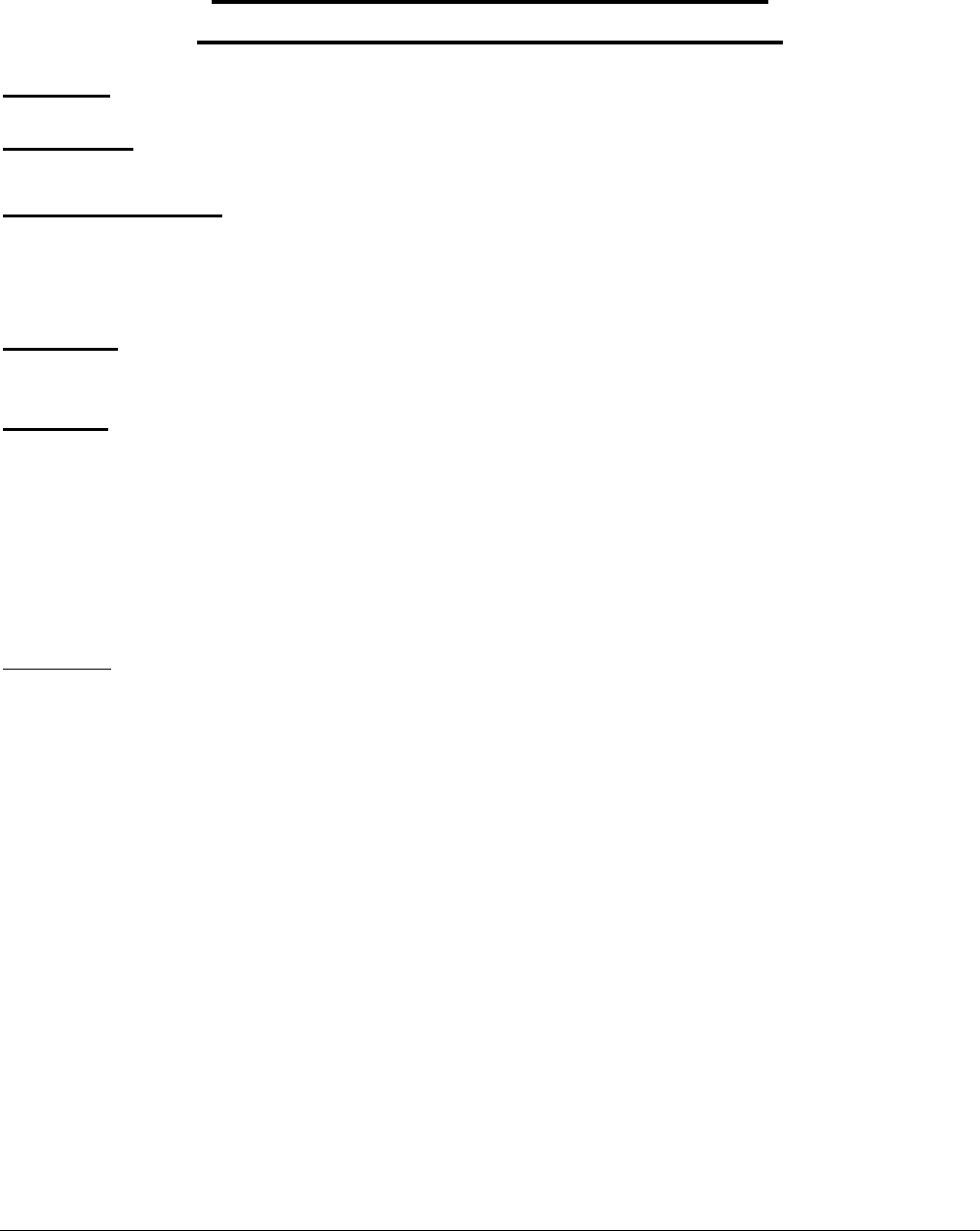
2015 753
P11
ANY INDICATION OF MIS-USE OF
RESTRAINT SYSTEM/HELMET USE
FORMAT: 1 numeric
SAS NAME: Person.REST_MIS
ELEMENT VALUES:
0 No
1 Yes
Definition: This element indicates any mis-use of the restraint system or helmet used by this
person.
Remarks:
0 (No) is used when the case materials indicate that the restraints or helmet use were not mis-
used. Also, included in 0 (No) is Unknown. If the investigating officer states that the restraints
were being used but it couldn’t be determined if they were mis-used use this attribute
1 (Yes) is used when the case materials indicate that the restraints or helmet use were mis-
used at the time of the crash.
Examples:
The investigating officer states in the crash report that the driver of Vehicle 1 had the
shoulder belt portion of the seatbelt behind his back.
The investigating officer states the operator of the motorcycle had the helmet on
backwards.
The investigating officer states in the crash report that two persons were secured in one
restraint.
The investigating officer states the child was in a booster seat but not using the vehicles
restraint system.
The investigating officer states the child restraint system was properly secured however
the child was not using the 5-point harness system.
The investigating officer states the child restraint system was not properly secured in
the vehicle.
An indication of 1 (Yes) requires a positive response in the case materials, if not default to 0
(No).

754 2015
P11
Consistency Checks:
IF THEN
(2R1P)
(2S1P)
ANY INDICATION OF MIS-USE OF
RESTRAINT SYSTEM /HELMET USE
equals 1,
RESTRAINT SYSTEM/HELMET USE
equals 07, 16 or 17,
RESTRAINT SYSTEM/HELMET USE
must equal 01-05, 08-12, 19, 97.
ANY INDICATION OF MIS-USE OF
RESTRAINT SYSTEM/HELMET USE
must equal 0.

2015 755
P12
AIR BAG DEPLOYED
FORMAT: 2 numeric
SAS NAME: Person.AIR_BAG
ELEMENT VALUES:
00 Not Applicable
01 Deployed-Front
02 Deployed-Side (door, seatback)
03 Deployed-Curtain (roof)
07 Deployed-Other (knee, air belt, etc.)
08 Deployed-Combination
09 Deployment-Unknown Location
20 Not Deployed
28 Switched Off
98 Not Reported
99 Deployment Unknown
Definition: This element is used to record air bag availability and deployment for this person
as reported in the case materials.
Remarks:
Code this element regardless of the motor vehicle’s Body Type or the age of the motor vehicle.
00 (Not Applicable) is used when the case materials indicate there was no air bag available
for this person. Examples include any of the following terms.
Not Applicable, No Air bag, Not Equipped, Not Present, None, Not
available/Unavailable, Not Installed
20 (Not Deployed) is used only if the available information indicates the vehicle is equipped
with an air bag (air bags) for this occupant’s position, but it (they) did not deploy in this crash.
01 (Deployed-Front), 02 (Deployed-Side), 03 (Deployed-Curtain), 07 (Deployed-Other), 08
(Deployed-Combination), and 09 (Deployment-Unknown Location) are used only if you
have indication in the available information that an air bag deployed for this occupant’s seat
position (not for others in the vehicle.) There may be multiple air bags available for this
occupant’s seat position. 01 (Deployed-Front), 02 (Deployed-Side) and 03 (Deployed-
Curtain) are used if case materials indicate that at least one air bag deployed for this person
from only one of these directions. 08 (Deployed-Combination) is used if case materials
indicate that air bags deployed from more than one direction (e.g., SIDE and FRONT) for this

756 2015
P12
seat position. 09 (Deployment-Unknown Location) is used if an air bag did deploy for this
person, but the origin of the air bag is not known.
28 (Switched Off) is used when the case materials indicate that any air bag for this occupant’s
position was manually switched off and did not deploy. This attribute takes precedence over
all other codes for this seating position.
98 (Not Reported)
If a state’s crash report manual instructs to leave blank data blocks that are not applicable,
then a blank in those data blocks are NOT considered “Not Reported”.
Code 98 (Not Reported) in these two situations:
1. No field or coding block exists on the state’s crash report to provide the information
to code this element AND no other information is available to code the element (e.g.,
narrative, diagram, case materials)
2. A field or coding block exists on the state’s crash report that would provide the
information needed to code this element, but it has been left blank, AND no other
information is available to code the element (e.g., narrative, diagram, case
materials).
99 (Deployment Unknown) is used if the investigating officer indicates that deployment of an
air bag was unknown. This attribute includes both situations where it is unknown if an air bag
was available and situations where it is identified that it is unknown if an available air bag
deployed. This attribute would be applicable to hit and run vehicles that are not identified.
Consistency Checks:
IF THEN
(2S0P) RESTRAINT SYSTEM/HELMET USE AIR BAG DEPLOYED should equal 00.
equals 05, 16, 17, 19 or 29,
(2U0P) BODY TYPE equals 80-83, 88-91, AIR BAG DEPLOYED should equal 00.
(3R0P) AIR BAG DEPLOYED does not equal SEATING POSITION should not equal
00, 98 or 99, 12, 22, 32, 41-55.
(BP0P) MODEL YEAR is greater than 1999, AIR BAG DEPLOYED should not equal
and BODY TYPE does not equal 00.
50-52, 58-66, 71-79, 80-83, 88-93, 95,
97, and SEATING POSITION equals
11, 13, 18, 19,
(P210) AIR BAG DEPLOYED equals 28, SEATING POSITION should equal 13.
(P230) SEATING POSITION equals 21, 23, AIR BAG DEPLOYED should equal 00.
28, 29, 31, 33, 38 or 39, and BODY
TYPE equals 50-97,

2015 757
P12
IF THEN
(P260) SEATING POSITION equals 18, 19, AIR BAG DEPLOYED should equal 00,
99.
(P290) AIR BAG DEPLOYED equals 01-03, SEATING POSITION should equal 11,
07-09, 20, 28, and BODY TYPE 13, 21, 23, 31 or 33.
equals 01-49, and MODEL YEAR
equals 1998 or newer,
(V320) BODY TYPE equals 50-52, 55, 58-66, AIR BAG DEPLOYED should equal 00.
71-79, and SEATING POSITION does
not equal 11, 13, 98,

2015 759
P13
EJECTION
FORMAT: 1 numeric
SAS NAME: Person.Ejection
ELEMENT VALUES:
0 Not Ejected
1 Totally Ejected
2 Partially Ejected
3 Ejected - Unknown Degree
7 Not Reported
8 Not Applicable
9 Unknown if Ejected
Definition: This element describes the ejection status and degree of ejection for this person,
excluding motorcycle occupants.
Remarks:
Ejection refers to situations where forces from an accident cause occupants to be totally
or partially thrown from the vehicle (including the bed of pickup trucks) during the course of the
crash. This includes occupants of jeeps, go carts, snowmobiles, three- or four-wheel ATVs.
Note: This variable excludes occupants of motorcycles.
Partial ejection refers to those instances where some part but not all of an occupant’s body is,
at some time during the crash sequence, outside the occupant compartment.
0 (Not Ejected) is used if the case materials specifically so state for a given occupant. Use this
attribute for occupants of a hit-and-run vehicle, unless the case materials specifically indicate
that an ejection occurred.
If the case materials do not show the ejection status of uninjured drivers or passengers and
there is no other information about ejection, e.g., in the narrative/diagram, then use 7 (Not
Reported).
1 (Totally Ejected) is used when the occupant's body is entirely outside the vehicle but may
be in contact with the vehicle. This includes occupants who are not initially in the seating
compartment of the vehicle (e.g., pickup beds, boot of a convertible and persons riding on
open tailgates).
2 (Partially Ejected) refers to those instances where some part but not all of an occupant's
body is, at some time during the crash sequence, outside the occupant compartment. This
does not apply to occupants who are not initially in the seating compartment of the vehicle

760 2015
P13
(e.g., pickup beds, boot of a convertible and persons riding on open tailgates), since any
ejection for them is coded as 1 (Totally Ejected).
3 (Ejected - Unknown Degree) is used when the case materials indicate that an occupant is
ejected but fails to discriminate between total and partial ejection.
7 (Not Reported)
If a state’s crash report manual instructs to leave blank data blocks that are not applicable,
then a blank in those data blocks are NOT considered “Not Reported”.
Code 7 (Not Reported) in these two situations:
1. No field or coding block exists on the state’s crash report to provide the information
to code this element AND no other information is available to code the element (e.g.,
narrative, diagram, case materials)
2. A field or coding block exists on the state’s crash report that would provide the
information needed to code this element, but it has been left blank, AND no other
information is available to code the element (e.g., narrative, diagram, case
materials).
8 (Not Applicable) is used for persons who are riding on the exterior of a vehicle or for
motorcycle occupants. Exterior of the vehicle includes running boards, roof, fenders and
bumpers, but not the bed of pickup trucks, open tail gate or boot of a convertible.
Enter 9 (Unknown if Ejected) when the case materials specifically indicate unknown.
Consistency Checks:
IF THEN
(3S0P) SEATING POSITION equals 55, EJECTION must equal 8.
(4S0P) BODY TYPE equals 80-82, 83, 88, 89, EJECTION must equal 8.
(6S0P) EJECTION equals 1, EXTRICATION must not equal 1, 9.
(BA0P) EJECTION equals 0, 7, 8 or 9, EJECTION PATH must equal 0.
(BB0P) EJECTION equals 1-3, EJECTION PATH must equal 1-9.
(BF0F) PERSON TYPE equals 04-08, 10, 19, EJECTION must equal 8.
(P01F) PERSON TYPE equals 01-03, 09, and EJECTION should equal 0 or 7.
RESTRAINT SYSTEM/HELMET USE
equals 01-04, 08, 10-12, and BODY
TYPE does not equal 80-89,
(P050) EJECTION equals 1, RESTRAINT SYSTEM/HELMET USE
should not equal 01-04, 08, 10-12.
(P094) EJECTION equals 8, SEATING POSITION must equal 55, or
BODY TYPE must equal 80-83, 88, 89.
(P310) EJECTION equals 1-3, and BODY RESTRAINT SYSTEM/HELMET USE
TYPE does not equal 90, 91, 97, must not equal 05, 16, 17, 19, 29.

2015 761
P14
EJECTION PATH
(FARS Only)
FORMAT: 1 numeric
SAS Name: Person.EJ_PATH
ELEMENT VALUES:
0 Ejection Path Not Applicable
1 Through Side Door Opening
2 Through Side Window
3 Through Windshield
4 Through Back Window
5 Through Back Door/Tailgate Opening
6 Through Roof Opening (sun-roof, convertible top down)
7 Through Roof (convertible top up)
8 Other Path (e.g., back of pick-up truck)
9 Ejection Path Unknown
Definition: This element identifies the path by which this person was ejected from the vehicle.
Remarks:
0 (Ejection Path Not Applicable) is used when the element EJECTION is coded 0 (Not
Ejected), 7 (Not Reported), 8 (Not Applicable) or 9 (Unknown if Ejected). This attribute is
an auto-fill in MDE.
9 (Ejection Path Unknown) is used for ejected occupants when:
1. No field or coding block exists on the state’s crash report to provide information
to code ejection path AND no other information is available to code the element
(e.g., narrative, diagram, case materials); or
2. a field or coding block exists on the state’s crash report that would provide the
information needed to code ejection path, but it has been left blank, AND no other
information is available to code the element (e.g., narrative, diagram, case
materials); or
3. the police indicate ejection path is unknown.
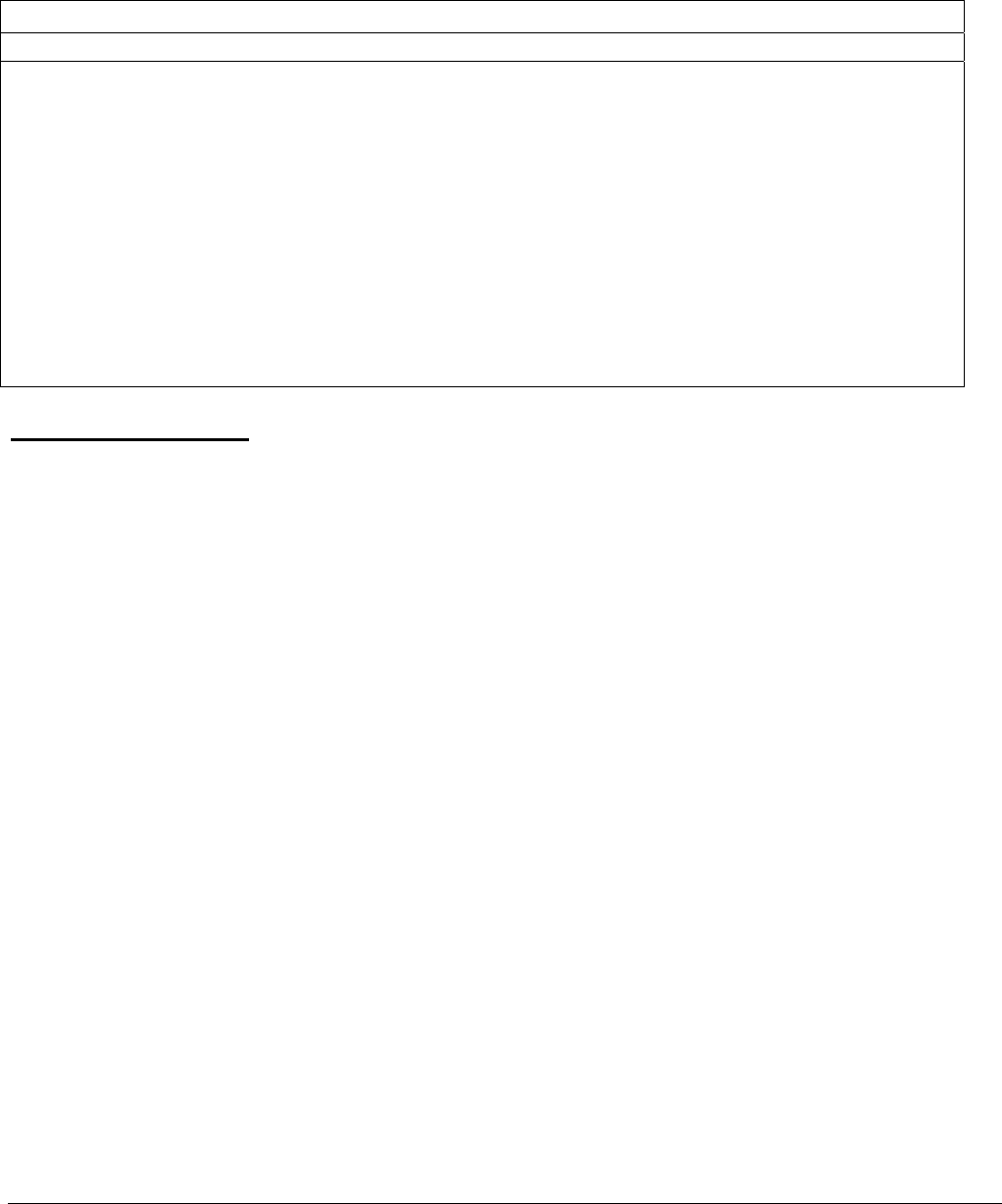
762 2015
P14
Use the following table as a guideline:
Ejection Path Guidelines
Path Guideline
1.
2.
3.
4.
5.
6.
7.
8.
9.
Through side door opening all side doors
Through side window all side windows, bus side windows
Through windshield front windshield only
Through back window standard rear window, back window of bronco, van
Through back door/tailgate
opening
station wagon tailgate, back door of truck, back door of
bronco, van
Through roof opening (sun-roof, convertible top down) t-top, targa top
Through roof (convertible top up)
Other path (back of pick-up truck) torn-off roof, car cut in half
Ejection Path Unknown driver’s side, unspecified; passenger’s side
unspecified.
Consistency Checks:
IF THEN
(BA0P)
(BB0P)
EJECTION equals 0, 7, 8 or 9,
EJECTION equals 1-3,
EJECTION PATH must equal 0.
EJECTION PATH must equal 1-9.
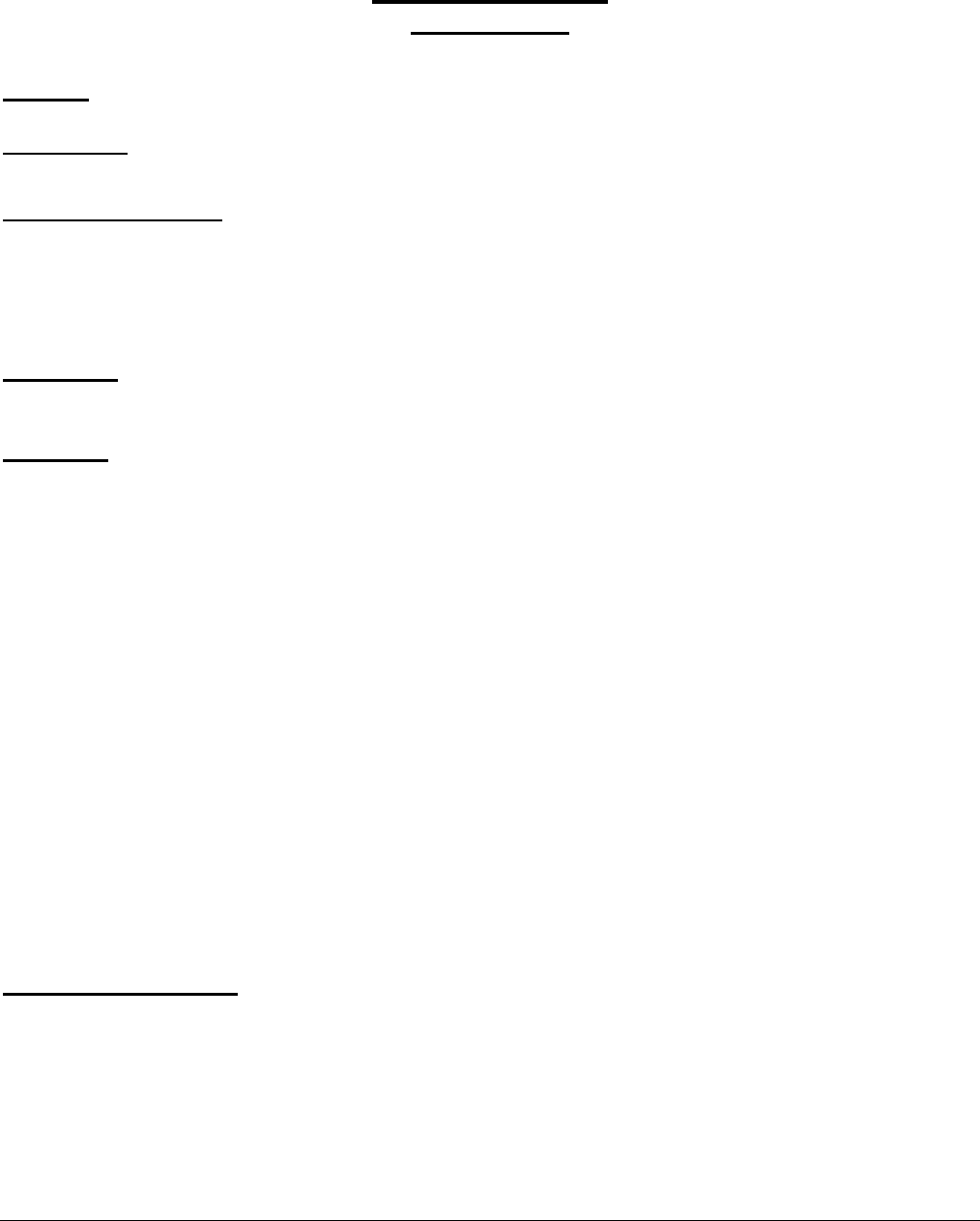
2015 763
P15
EXTRICATION
(FARS Only)
Format: 1 numeric
SAS Name: Person.EXTRICAT
ELEMENT VALUES:
0 Not Extricated or Not Applicable
1 Extricated
9 Unknown
Definition: This element identifies if equipment or other force was used to remove this person
from the vehicle.
Remarks:
Extrication refers to the use of equipment or other force to remove persons from the vehicles;
i.e., more than just lifting or carrying person out of wreckage.
0 (Not Extricated or Not Applicable) is used when no information is provided in the crash
report regarding extrication for this occupant. (i.e., assume that EXTRICATION is not
applicable.) This field is not applicable to motorcycle and ATV/ATC riders.
1 (Extricated) is used when the police officer uses the word “extricated” to indicate occupant
removal. Use of the term “extricated” is sufficient information to use 1 (Extricated) even if no
mention of equipment is made. The only exception to this is if the analyst knows the officer
used the term “extrication” not as intended for the purpose of this element. If the officer uses
the term “pinned” or “wedged” or something similar, then the officer must indicate that
equipment was used to remove the occupant in order to attribute 1 (Extricated).
9 (Unknown) is to be used when the officer states that the occupant is “pinned” or “wedged,”
etc., and suggests that the occupant may have been removed with force, but does not make it
clear whether equipment was used or not.
Consistency Checks:
IF THEN
(5S0P) BODY TYPE equals 80-83, 88, 89 or EXTRICATION must equal 0.
90,
(6S0P) EJECTION equals 1, EXTRICATION must not equal 1, 9.

2015 765
P16/NM15
POLICE REPORTED ALCOHOL INVOLVEMENT
FORMAT: 1 numeric
SAS NAME: Person.DRINKING
ELEMENT VALUES:
0 No (Alcohol Not Involved)
1 Yes (Alcohol Involved)
8 Not Reported
9 Unknown (Police Reported)
Definition: This data element reflects only the judgment of law enforcement as to whether
alcohol was involved or not for this person.
Remarks:
The phrase “alcohol involved” means that alcohol is present in the person or presumed to be
present by the police. Consequently, this data element may not agree with the alcohol test
results for this person. Involvement is not an indication that alcohol was in any way a cause of
the crash.
If the case materials indicate that open or unopened alcoholic beverages were found in the
vehicle, then this information does not by itself constitute involvement unless the police
indicate that this was the basis for a determination of involvement. If the case materials
indicate that a preliminary breath test (PBT) was given and the officer’s judgment contradicts
the preliminary test, the officer’s judgment will be the determining factor.
0 (No [Alcohol Not Involved]) applies if the judgment of law enforcement is that alcohol
is not present.
In some circumstances it is possible for the police to give sufficient information in the report
fields (such as contributing circumstances, driver/pedestrian condition, alcohol presence or
use, alcohol test, etc.) or narrative to indicate that they believe alcohol is not involved without
specifically mentioning “no” alcohol. In such cases, use 0 (No [Alcohol Not Involved]).
However, if there is any question that the officer’s position on alcohol involvement is “no
alcohol” because of lack of information, then use 8 (Not Reported).
1 (Yes [Alcohol Involved]) applies only if the judgment of the law enforcement is that alcohol
was present. For example, the police indicate alcohol involvement via:
a specific data element on the police report form such as Driver Condition,
the police charge the driver with an alcohol-related offense,

766 2015
P16/NM15
the police mention in the narrative section of the report that the person had been
drinking,
the police report has a positive BAC test result (BAC>.00).
Some PARs have a block labeled “Alcohol/Drugs.” If use is indicated, and it cannot be
determined which was used (e.g., narrative, arrest/charged section, etc.), then assume alcohol
is present. If the police report indicates that a driver was charged with DWI/DUI (driving while
intoxicated, driving while impaired or driving under the influence), and no clarification is offered
to indicate if the DWI/DUI was alcohol related or other drug related (e.g., a specific data
element; mentioned in the narrative section; BAC results), then assume alcohol presence.
8 (Not Reported) applies when law enforcement makes no mention of alcohol involvement in
either narrative or data fields. For example, there is a specific location on the police report for
assessment of alcohol but the investigating officer fails to make either a positive or negative
assessment by leaving the field blank. Also use 8 (Not Reported) if no block exists on the
PAR for reporting alcohol presence and no other information is available.
There are instances when the police do not indicate in the PAR whether alcohol was involved
or not, but they do mention that a test was given or ordered. For example, the police may only
say that an evidential test was ordered for a driver without indicating that they suspected
alcohol or providing a result. The use of passive alcohol sensors (PAS) may also be mentioned
as used by the police, without mention of the result. Use 8 (Not Reported) for these instances.
9 (Unknown [Police Reported]) applies when law enforcement indicates in either narrative or
data fields that alcohol involvement is “unknown” for this person. In general, crash reports
have blocks to indicate either positive or negative alcohol involvement. However if a crash
report has a provision for the investigating officer to respond “unknown involvement,” then
enter this attribute. Also enter this attribute for hit-and-run drivers or passengers unless clear
evidence to the contrary exists.
FARS SPECIAL INSTRUCTION:
Important Guidelines:
Do not change the coding of this element because a positive alcohol test is obtained
from the coroner, medical examiner or state toxicology lab. A positive or negative
BAC test submitted from the toxicology lab or coroner directly to the FARS analyst is
not evidence of the officer’s judgment.
The police accident report, including any supplemental reports or direct contact with
the police are the only valid sources.
When Police-Reported Alcohol Involvement is 8 (Not Reported) or 9 (Unknown [Police
Reported]), Method of Alcohol by Police Determination attributes “1-8” are allowed. However,
this should only happen when the method is stated by the police, but the involvement is not
mentioned at all or stated as unknown.

2015 767
Consistency Checks:
IF
(4X4F) any CONDITION (IMPAIRMENT) AT
TIME OF CRASH (D23) equals 09,
(D090) VIOLATIONS CHARGED equals
11-19, and PERSON TYPE equals 01,
03,
(P072) PERSON TYPE equals 02, 03, and
INJURY SEVERITY equals 0, and
ALCOHOL TEST RESULT equals
996,
(P110) METHOD OF ALCOHOL
DETERMINATION BY POLICE equals
1-5, 8,
(P200) POLICE REPORTED ALCOHOL
INVOLVEMENT equals 8, 9,
(P300) POLICE REPORTED ALCOHOL
INVOLVEMENT equals 1, and
INJURY SEVERITY equals 4,
P16/NM15
THEN
POLICE REPORTED ALCOHOL
INVOLVEMENT (P16), or POLICE
REPORTED DRUG INVOLVEMENT
(P19) should equal 1 for this person.
POLICE REPORTED ALCOHOL
INVOLVEMENT should equal 1, or
POLICE REPORTED DRUG
INVOLVEMENT should equal 1.
POLICE REPORTED ALCOHOL
INVOLVEMENT should equal 0, 8.
POLICE REPORTED ALCOHOL
INVOLVEMENT should equal 0, 1.
METHOD OF ALCOHOL DETERMIN-
ATION BY POLICE should equal 9.
ALCOHOL TEST STATUS should not
equal 0, 1.

2015 769
P17/NM16
METHOD OF ALCOHOL DETERMINATION BY POLICE
(FARS Only)
FORMAT: 1 numeric
SAS NAME: Person.ALC_DET
ELEMENT VALUES:
1 Evidential Test (breath, blood, urine)
2 Preliminary Breath Test (PBT)
3 Behavioral
4 Passive Alcohol Sensor (PAS)
5 Observed
8 Other (e.g., Saliva test)
9 Not Reported
Definition: This element describes the method by which the police made the determination as
to whether alcohol was involved or not for this person.
Remarks:
This variable is coded for each person involved in the crash. The Police Accident Report (PAR)
and supplements are the source of information.
The purpose of this variable is to record the method by which the police made the
determination as to whether alcohol was involved or not.
It is used primarily when the Police-Reported Alcohol Involvement variable is coded as 0 (No
[Alcohol Not Involved]) or 1 (Yes [Alcohol Involved]).
Whenever Police-Reported Alcohol Involvement is 0 (No [Alcohol Not Involved]), try to find
out how the police knew this. When Police-Reported Alcohol Involvement is 1 (Yes [Alcohol
Involved]), try to determine how the police knew this.
If Police-Reported Alcohol Involvement is 8 (Not Reported) or 9 (Unknown [Police
Reported]), then Method of Alcohol Determination by Police is 9 (Not Reported). If more than
one method is used by the police to determine alcohol involvement choose the method the
police refer to when they record their assessment. If more than one method is used and they
do not state which method was the basis for their alcohol determination, code the highest-
ranking method used from the hierarchy (the highest ranking is “1”; the lowest is “5”).
1 (Evidential Test [breath, blood, urine]) is used if Police-Reported Alcohol Involvement is 0
(No [Alcohol Not Involved]) or 1 (Yes [Alcohol Involved]) and the police indicate that they

770 2015
P17/NM16
ordered an evidential test and their determination of alcohol involvement was based on the
results of that test.
An evidential test can be a breath test on a state-approved breath test device, a blood test, or
a urine test. No other tests are considered evidential.
Ordering a test is not the same as knowing the results of that test. In order to code that
the police determined their opinion based on an evidential test, there must be
information that the officer had received the test results. If they haven’t received test
results (e.g., results are pending), then their method of determination of alcohol or drug
presence was made using some method other than an evidential test.
2 (Preliminary Breath Test [PBT]) is used if Police-Reported Alcohol Involvement is 0 (No
[Alcohol Not Involved]) or 1 (Yes [Alcohol Involved]) and the police indicate that alcohol
involvement was based upon the results of a preliminary breath test, or PBT. Preliminary
breath testing devices are not yet considered evidential tests, but merely as tools for the police
to help them determine whether alcohol is present or not. Many PBTs only indicate whether
alcohol is present in the breath by pass (green) or fail (red) lights. Other PBTs indicate the
approximate BAC in numbers. Some PBTs are of evidential quality in some States. But if the
device was used only as a preliminary test and not the evidential test, then this value should
be coded.
The key to coding this is the definite indication by the police that a PBT was used and was
the basis (or the clinching evidence) that a driver had been drinking or not.
3 (Behavioral) is used if Police-Reported Alcohol Involvement is 0 (No [Alcohol Not
Involved]) or 1 (Yes [Alcohol Involved]) and the police indicate that the basis for that alcohol
assessment was the behavior by the driver during a field sobriety test.
Examples of field sobriety tests include the gaze nystagmus test, walking in a straight line, one
leg stand, etc.
Do not confuse 3 (Behavioral) with 5 (Observed).
4 (Passive Alcohol Sensor [PAS]) is used if Police-Reported Alcohol Involvement is 0 (No
[Alcohol Not Involved]) or 1 (Yes [Alcohol Involved]) and the police indicate that alcohol
involvement was based upon the results of a passive alcohol sensor, or “sniffer.”
The PAS devices available and in use by police are devices that look like flashlights and when
held within 6 inches of the driver’s mouth will detect alcohol in the breath while the driver is
talking. The PAS is not considered an evidential test nor a PBT. It is not really a test, but a
detector or an extension of the police officer’s senses. The PAS devices are usually
PASS/FAIL indicators with a red light indicating alcohol on the breath.
The key to coding this attribute is the indication by the police that a PAS was used and was the
basis for coding 0 (No) or 1 (Yes) for Police-Reported Alcohol Involvement.

2015 771
P17/NM16
5 (Observed) is used if Police-Reported Alcohol Involvement is 0 (No [Alcohol Not
Involved]) or 1 (Yes [Alcohol Involved]) and the police indicate that the basis for their alcohol
assessment was some observation of the driver. Do Not Confuse 5 (Observed) with 3
(Behavioral).
Examples of observations would be:
smelling alcohol on the driver’s breath
staggering, slurring of speech
the driver admitting he had been drinking
other observations described by the police that would not be considered field sobriety
tests
Be careful not to simply assume that this is the appropriate code when some other method
may have been used (e.g., breath test, PBT, PAS).
8 (Other [e.g., Saliva test]) is used if Police-Reported Alcohol Involvement is 0 (No [Alcohol
Not Involved]) or 1 (Yes [Alcohol Involved]) and the police indicate that the basis for alcohol
determination was something other than the codes “1, 2, 3, 4 and 5” described above.
Examples of Other methods include:
1. results of a saliva test
2. results of other tissue tests
The key to coding this data element is the description by the police of some other method of
alcohol determination that does not fall into codes “1-5.”
If a PAR data element is coded with the attribute “Other” but the officer does not specify
what this refers to:
1. Code 8 (Other [e.g., Saliva test]) if the PAR attribute choices can be matched to or
include all the attributes in FARS/GES.
2. Code 9 (Not Reported) if the PAR choices cannot be matched to or include all the
attributes in FARS/GES.
See the paragraph on the following page regarding Witness Statements.
9 (Not Reported) is coded if Police-Reported Alcohol Involvement is 8 (Not Reported) or 9
(Unknown [Police Reported]). It is also coded if Police-Reported Alcohol Involvement is 0
(No [Alcohol Not Involved]) or 1 (Yes [Alcohol Involved]) and there is no indication in the
police report or any documents as to how the police made the alcohol assessment.
See the paragraph below on Witness Statements.

772 2015
P17/NM16
Witness Statements:
Witness Statements may or may not be used by the police to make a determination of alcohol
involvement. If the police did use witness statements alone to make a determination of alcohol
involvement, use 8 (Other).
If the police mention, but did not use witness statements and there is no other indication of
how a determination was made, use 9 (Not Reported).
There are instances when the police do not indicate in the PAR whether alcohol was involved
or not, but they do mention that a test was given or ordered.
FOR EXAMPLE: The police may only say that an evidential test was ordered for a driver
without indicating that they suspected alcohol or what the result was. The use of passive
alcohol sensors (PAS) may also be mentioned as used by the police, without mention of the
result.
Codes 1-8 may be used for Method Of Alcohol Determination by Police when Police-Reported
Alcohol Involvement is coded as 8 (Not Reported) or 9 (Unknown [Police Reported]), if this
fits the case.
This should only happen when the method is stated by the police, but the involvement is not
mentioned at all or stated as unknown.
Consistency Checks:
IF THEN
(P110) METHOD OF ALCOHOL POLICE REPORTED ALCOHOL
DETERMINATION BY POLICE equals INVOLVEMENT should equal 0, 1.
1-5, 8,
(P200) POLICE REPORTED ALCOHOL METHOD OF ALCOHOL
INVOLVEMENT equals 8, 9, DETERMINATION BY POLICE should
equal 9.
(U681) UNLIKELY: METHOD OF ALCOHOL DETERMINATION BY POLICE equals 8.

2015 773
P18/NM17
ALCOHOL TEST
FORMAT: 3 sets, 1 set, 1 numeric, 1 set, 2 numeric, 1 set, 3 numeric
SAS NAME: Person.ALC_STATUS, Person.ATST_TYP, Person.ALC_RES
ELEMENT VALUES:
GES FARS
Subfield 1 – Test Status
0 0 Test Not Given
1 1 Test Refused
2 2 Test Given
8 8 Not Reported
9 9 Unknown if Tested
Subfield 2 – Test Type
00 00 Test Not Given
01 01 Blood
02
10
02
10
Breath Test (AC)
Preliminary Breath Test (PBT)
03 03 Urine
XX 04 Vitreous
XX 05 Blood Plasma/Serum
XX 06 Blood Clot
XX 07 Liver
08 08 Other Test Type
98 98 Unknown Test Type
95 95 Not Reported
99 99 Unknown if Tested
Subfield 3 – Test Result
000-939 000- Actual Value
939
940 940 .94 or Greater
996 996 Test Not Given
997 997 AC Test Performed, Results Unknown
998
995
998
995
Positive Reading with No Actual Value
Not Reported
999 999 Unknown if Tested
Definition for Alcohol Test Status: This element identifies if an alcohol (ethanol) test was
given to this person.

774 2015
P18/NM17
Definition for Alcohol Test Type: This element identifies the type of the alcohol (ethanol)
test that was used for this person.
Definition for Alcohol Test Result: This element identifies the alcohol (ethanol) test result
for this person.
Remarks:
When completing this element, you must have the data to fill ALL three subfields. Otherwise,
leave all three subfields blank until all the data has been acquired to complete all three
subfields.
For alcohol tests that were initiated but not completed because of a contaminated or
insufficient sample, code:
Test Status as 2 (Test Given)
the applicable Test Type,
and code Test Results as 997(AC Test Performed, Results Unknown).
In a circumstance where the crash report provides results from a lower order test (e.g.,
breath or urine) and blood was also drawn to be tested, but blood test results will not be
received, it is preferred that we record the known result from the breath or urine test
rather than 997 (AC Test Performed, Results Unknown).
Subfield 1 – Test Status indicates whether or not a test was performed on this person to
detect the presence of alcohol (ethanol).
0 (Test Not Given) is used when the case materials indicate an alcohol test was not given.
Most states’ practice is that “live” non-drivers are not routinely tested for alcohol.
Consequently, for live non-drivers MDE will auto-fill Test Status, Test Type, and Test
Result as Test Not Given. If you happen to obtain an alcohol test result for a “live” non-
driver, enter Test Status as Test Given and the appropriate test type and results.
1 (Test Refused) is used when the case materials indicate an alcohol test was refused.
2 (Test Given) is used when the case materials indicate an alcohol test was given.
8 (Not Reported)
If a state’s crash report manual instructs to leave blank data blocks that are not applicable,
then a blank in those data blocks are NOT considered “Not Reported”.
Code 8 (Not Reported) in these two situations:
1. No field or coding block exists on the state’s crash report to provide the information
to code this element AND no other information is available to code the element (e.g.,
narrative, diagram, case materials)

2015 775
P18/NM17
2. A field or coding block exists on the state’s crash report that would provide the
information needed to code this element, but it has been left blank, AND no other
information is available to code the element (e.g., narrative, diagram, case
materials).
9 (Unknown if Tested) is used when the case materials specifically indicated “Unknown if
Tested.”
Subfield 2
If more than one type of test is performed on the same person, a Blood Test is preferred over
other tests. The exception is if you have information that casts clear doubt on the validity or
reliability of the Blood Test when you have results from a test of another type. For example,
the blood test was spoiled or contaminated. In such a case, record the Test Type for the test
with the valid result. Other situations where this may occur include information that:
the test was performed on a live victim unreasonably long after the crash; or
the lab, coroner, or medical examiner expresses doubt in their result from a blood test.
*Note: The attributes Vitreous, Blood Plasma/Serum, Blood Clot, and Liver are not included in
GES as the source document (e.g. Coroner Report, Toxicology Screening) where these Test
Types would be used are not available in a GES sampled PAR.
CODING HIERARCHY: When more than one alcohol test exists, use the following hierarchy:
01 (Blood), 05 (Blood Plasma/Serum), 02 (Breath Test [AC]), 04 (Vitreous), 03 (Urine), 06
(Blood Clot), 07(Liver), 10 (Preliminary Breath Test [PBT]), 08 (Other Test Type).
(Attributes 04-07 do not apply for GES coding purposes.)
In a circumstance where the crash report identifies results from a test (e.g., breath or
urine) but blood was also drawn to be tested, but blood test results will not be received,
it is preferred that we record the known result from the breath or urine test rather than
997 (AC Test Performed, Results Unknown).
01 (Blood) is used when the case materials indicate this was the type of test used to obtain a
BAC.
Note that there are test types for 01 (Blood), 05 (Blood Plasma/Serum) and 06 (Blood Clot).
If the Coroner, Medical Examiner, or State Lab reports that the test was a “blood” test (whole
blood), this most likely does not refer to Blood Plasma or Blood Clot, but you should try to
verify this. If the test was performed on blood, or if you know the results are already converted
to a BLOOD ALCOHOL CONCENTRATION (BAC), then code TEST TYPE as 01 (Blood).
Breath is used when the case materials indicate this was the type of test used to obtain a
BAC.
Breath is used if you have a result from an evidential breath test (a breath test performed on a
State-approved breath test device). Usually, results from a Preliminary Breath Test (PBT)

776 2015
P18/NM17
device are not considered evidential. Some PBTs are of evidential quality in some States; but if
the device was used only as a preliminary test and not an evidential test, then do not use code
02 (Breath Test [AC]).
03 (Urine) is used when the case materials indicate this was the type of test used to
obtain a BAC.
08 (Other Test Type) is used when the case materials indicate a type of test used to obtain a
BAC was recorded as “Other” or is indicated to be of a type other than the available attributes.
This attribute would not apply to behavioral tests (field sobriety) or observations.
If a PAR data element is coded with the attribute “Other” but the officer does not specify
what this refers to:
1. Code 08 (Other Test Type) if the PAR attribute choices can be matched to or
include all the attributes in FARS/GES.
2. Code 95 (Not Reported) if the PAR choices cannot be matched to or include all
the attributes in FARS/GES.
10 (Preliminary Breath Test [PBT]) is used when the case materials indicate this was the
type of test used to obtain a BAC and no other test is available. Update Test Type and
corresponding Result if a PBT is followed by an evidential test, other than a PBT. A breath,
blood or urine test will take precedence over a PBT result unless you have information that
casts clear doubt on the validity or reliability of the Evidential Test AND you have a valid PBT
result to record.
Example 1: You only receive a PBT with an actual value
Code Test Type “10 – PBT” and Test Result “the actual value received”
Example 2: You only receive a PBT with a “negative” result returned
Code Test Type “10 – PBT” and Test Result “000”
Example 3: You only receive a PBT with “positive” result, but no actual value
Code Test Type “10 – PBT” and Test Result code “998 - Positive Reading With No
Actual Value”
Example 4: You receive a PBT with an actual value of .10% and a blood test (whole blood)
from the lab of .08%
Code Test Type “01 – Blood” and Test Result .080
Example 5: You receive a PBT with an actual value of .10% and a breath test both from
the police of .08%
Code Test Type “02 – Breathalyzer (BAC)” and Test Result .080
Example 6: You receive a PBT with an actual value of .10% from the police and a blood
test (whole blood) from the state lab indicating a “contaminated” sample.
Code Test Type “10 – PBT” and Test Result .010

2015 777
P18/NM17
98 (Unknown Test Type) is used when the case materials indicate a test was given and the
type of test is reported as unknown or pending and the type is unobtainable.
95 (Not Reported)
If a state’s crash report manual instructs to leave blank data blocks that are not applicable,
then a blank in those data blocks are NOT considered “Not Reported”.
Code 95 (Not Reported) in these two situations:
1. No field or coding block exists on the state’s crash report to provide the information
to code this element AND no other information is available to code the element (e.g.,
narrative, diagram, case materials)
2. A field or coding block exists on the state’s crash report that would provide the
information needed to code this element, but it has been left blank, AND no other
information is available to code the element (e.g., narrative, diagram, case
materials).
99 (Unknown if Tested) is used when the case materials specifically indicated “Unknown if
Tested.”
Subfield 3
Beginning in 2015, all three decimal places will be coded in this field. If three decimal
places are not available, code the first two digits and zero fill the remaining place. For
example, a reported BAC of .09 becomes .090.
Prior to 2015, a TEST RESULT of .01 was a low probability and would raise an error flag.
For this reason, any BAC test result reported in 3 decimal places would have been truncated,
not rounded.
997 (AC Test Performed, Results Unknown) refers to alcohol content tests that were
performed but the results are reported as unknown or pending and are unobtainable (includes
a “Contaminated Sample” or “Insufficient Sample”). AC Test Performed, Results Unknown can
be used for any Test Type.
FARS SPECIAL INSTRUCTION:
As a general coding guideline, do not prematurely use Test Result “AC Test Performed,
Results Unknown.” It is recommended that you leave the information blank for drivers
and non-motorists until the test results are received from the state lab, coroner or police.
You need to be reasonably certain that you will never receive the test results to use
attribute “997” at the time of the initial coding and case entry.
995 (Not Reported)
If a state’s crash report manual instructs to leave blank data blocks that are not applicable,
then a blank in those data blocks are NOT considered “Not Reported”.

778 2015
P18/NM17
Code 995 (Not Reported) in these two situations:
1. No field or coding block exists on the state’s crash report to provide the information
to code this element AND no other information is available to code the element (e.g.,
narrative, diagram, case materials)
2. A field or coding block exists on the state’s crash report that would provide the
information needed to code this element, but it has been left blank, AND no other
information is available to code the element (e.g., narrative, diagram, case
materials).
FARS SPECIAL INSTRUCTION:
Prior to 2009, the Alcohol Test Result code “95” represented an alcohol test result that
was not provided because the test was refused. This situation was identified using the
element value “95 – Test Refused”. This element value was dropped in 2009 and the
code “95” was reintroduced in 2010 as the element value “995 – Not Reported”.
999 (Unknown if Tested) is used when the case materials specifically indicated “Unknown if
Tested.”
998 (Positive Reading with No Actual Value) can be used for any Test Type code where the
result is indicated to be positive without a numeric value to record. This should only be used
when a final test result is returned as “positive” with no actual result to record. This can occur
when a screening test is used and it is the only test result available. Some PBTs only indicate
whether alcohol is present in the breath by positive (green) or negative (red) lights. Other
PBTs indicate the approximate BAC in numbers. 998 (Positive Reading with No Actual
Value) should be used when a PBT result only indicates “positive” for alcohol, with no actual
BAC value. A negative PBT result should be interpreted as .000.
Before recording this value make sure that this is the final test result and no actual value was
available from a follow-up confirmatory test.
FARS SPECIAL INSTRUCTION:
Prior to 2006, this attribute read “PBT Positive Reading with No Actual Value” and
was used strictly for recording test results for Preliminary Breath Test devices.
State Law versus Practice: You may be aware that your State laws require testing of certain
classes of crash victims. However, you may also know that the practice in your State is that
the law is not observed. In such cases, you are not bound only by what the law says. You
may consider State practices in your coding decisions.
Example 1: Your state law may require all fatalities to be tested for BAC, but you know that
this does not happen in your State and you are unable to locate alcohol test information for this
person:

2015 779
P18/NM17
In such a case, you cannot rely on the law for your coding decisions. Therefore, you
should use 999 (Unknown If Tested) rather than 997 (AC Test Performed, Results
Unknown), or 996 (Test Not Given). (Test Status equals 9 (Unknown if Tested) and
Test Type equals 99 (Unknown if Tested)).
Example 2: Most states’ practice is that “live” non-drivers are not routinely tested for alcohol.
Consequently, for live non-drivers when there is no mention of a test ordered by the police in
the Police Accident Report (PAR):
Code Test Status as 0 (Test Not Given) and MDE will auto-fill Test Type as 00 (Test
Not Given) and Test Result as 996 (Test Not Given). However, if you happen to
obtain an alcohol test result later, you may enter the appropriate test type and results.
Computed Estimates of BACs:
An expert may calculate an estimate of what the BAC would have been at the time of the crash
(i.e., toxicologist uses the lapse time from crash and the victim’s weight to calculate the BAC).
You may accept these results if the following are all true:
Results were reported by someone with the authority in your state to make this
determination; and
the result is considered official in your state; and
you can support the result with official documentation or it is reported on the PAR (may
vary from state-to-state).
Consistency Checks:
IF THEN
(5T7P) ALCOHOL TEST STATUS equals 0, ALCOHOL TEST TYPE must equal 00,
1, and ALCOHOL TEST RESULT must
equal 996.
(5T8P) ALCOHOL TEST STATUS equals 9, ALCOHOL TEST TYPE must equal 99,
and ALCOHOL TEST RESULT must
equal 999.
(5T9P) ALCOHOL TEST STATUS equals 2, ALCOHOL TEST TYPE must equal
01-10, 95, 98, and ALCOHOL TEST
RESULT must equal 000-940, 997, 998.
(5TCP) ALCOHOL TEST STATUS equals 8, ALCOHOL TEST TYPE must equal 95,
and ALCOHOL TEST RESULT must
equal 995.
(P071) PERSON TYPE equals 02, 04-08, 10, ALCOHOL TEST STATUS should not
and INJURY SEVERITY does not equal 9, ALCOHOL TEST TYPE should
equal 4, not equal 99, and ALCOHOL TEST
RESULT should not equal 999.

780 2015
P18/NM17
IF THEN
(P074) PERSON TYPE equals 02, 04-08, 10, ALCOHOL TEST STATUS must not
and INJURY SEVERITY does not equal 8, ALCOHOL TEST TYPE must
equal 4, not equal 95, and ALCOHOL TEST
RESULT must not equal 995.
(P080) ALCOHOL TEST RESULTS should not equal 340-940.
(P300) POLICE REPORTED ALCOHOL ALCOHOL TEST STATUS should not
INVOLVEMENT equals 1, and equal 0, 1.
INJURY SEVERITY equals 4,

2015 781
P19/NM18
POLICE REPORTED DRUG INVOLVEMENT
FORMAT: 1 numeric
SAS NAME: Person.DRUGS
ELEMENT VALUES:
0 No (Drugs Not Involved)
1 Yes (Drugs Involved)
8 Not Reported
9 Unknown (Police Reported)
Definition: This data element reflects only the judgment of law enforcement as to whether
drugs were involved or not for this person.
Remarks:
This data element reflects only the judgment of law enforcement as to whether drugs were
involved or not for this person.
The phrase “drug involvement” means that drugs are present in the person or presumed to be
present by the police. This includes prescription and over-the-counter medications, as well as
illicit substances (e.g., marijuana, cocaine, heroin, etc.). It is not an indication that the drug
usage was in any way a cause of the crash.
If case materials indicate that drugs were found in the vehicle, then this information does not
by itself constitute involvement unless the police indicate that this was the basis for a
determination of involvement.
Some PARs have a block labeled “Alcohol/Drugs.” If use is indicated, and it cannot be
determined which was used (e.g., narrative, arrest/charged section, etc.), then assume
alcohol, not drugs. If the police report indicates that a driver was charged with DWI (driving
while intoxicated or driving while impaired) and no clarification is offered to indicate if the DWI
was alcohol related or drug related (e.g., a specific data element, mentioned in the narrative
section, BAC results), then interpret as alcohol presence .
0 (No [Drugs Not Involved]) applies if the judgment of law enforcement is that drugs are not
present.
In some circumstances it is possible for the police to give sufficient information in the report
fields (such as contributing circumstances, driver/pedestrian condition, substance use, drug
test, etc.) or narrative to indicate that they believe drugs are not involved without specifically
mentioning no drugs. In such cases, you may use 0 (No [Drugs Not Involved]). However, if

782 2015
P19/NM18
there is any question that the officer’s position on drug involvement is No because of a lack of
information, then it is best to use 8 (Not Reported).
1 (Yes [Drugs Involved]) applies only if the police assessment is that drugs were present.
For example the police indicate drug involvement via:
a specific data element on the police report form such as Driver Condition,
the police charge the driver with an drug related offense,
the police mention in the narrative section of the report that the person had been
under the influence of a drug
the police report has a positive test result reported for drugs
8 (Not Reported) applies when law enforcement makes no mention of drug involvement in
either narrative or data fields. For example, there is a specific location on the police report for
assessment of drugs but the investigating officer fails to make either a positive or negative
assessment by leaving the field blank. Also use 8 (Not Reported) if no block exists on the
PAR for reporting drug presence and no other information is available.
There are instances when law enforcement do not indicate in the PAR whether drugs were
involved or not, but they do mention that a test was given or ordered. For example, the police
may only say that an evidential test was ordered for a driver without indicating that they
suspected drugs or providing a result. Use 8 (Not Reported) for these instances.
9 (Unknown [Police Reported]) applies when law enforcement indicate in either narrative or
data fields that drug involvement is “unknown” for this person. In general, police reports have
blocks to indicate either positive or negative drug involvement. However, if a crash report has
a provision for the investigating officer to respond “unknown involvement,” then enter this
attribute. Also enter this attribute for hit-and-run drivers unless clear evidence to the contrary
exists.
FARS SPECIAL INSTRUCTION:
Important Guidelines:
Do not change the coding of this element because a positive drug test is obtained from
the coroner, medical examiner or state toxicology lab. A positive or negative test result
submitted from the toxicology lab or coroner directly to the FARS analyst is not
evidence of the officer’s judgment.
The crash report, including any supplemental reports or direct contact with law
enforcement, are the only valid sources.
When Police Reported Drug Involvement is 8 (Not Reported) or 9 (Unknown [Police
Reported]), all Method of Drug Determination attributes are allowed. However, this should
only happen when the method is stated by the police, but the involvement is not mentioned at
all or stated as unknown.

P19/NM18
2015 783
Consistency Checks:
IF
(4X4F) any CONDITION (IMPAIRMENT) AT
TIME OF CRASH (D23) equals 09,
(BQ0P) METHOD OF DRUG DETERMIN-
ATION BY POLICE equals 8,
(BR0P) METHOD OF DRUG DETERMIN-
ATION BY POLICE equals 1-7,
(D090) VIOLATIONS CHARGED equals
11-19, and PERSON TYPE equals 01,
03,
(P140) POLICE REPORTED DRUG
INVOLVEMENT equals 8, 9,
(P150) POLICE REPORTED DRUG
INVOLVEMENT equals 1,
(P160) POLICE REPORTED DRUG
INVOLVEMENT equals 1, and
METHOD OF DRUG DETERMIN-
ATION BY POLICE equals 2,
(P170) METHOD OF DRUG DETERMIN-
ATION BY POLICE equals 1-7,
THEN
POLICE REPORTED ALCOHOL
INVOLVEMENT (P16), or POLICE
REPORTED DRUG INVOLVEMENT
(P19) should equal 1 for this person.
POLICE REPORTED DRUG
INVOLVEMENT must equal 0, 1, 8, 9.
POLICE REPORTED DRUG
INVOLVEMENT must equal 0, 1, 8.
POLICE REPORTED ALCOHOL
INVOLVEMENT should equal 1, or
POLICE REPORTED DRUG
INVOLVEMENT should equal 1.
METHOD OF DRUG DETERMINATION
BY POLICE should equal 8.
DRUG TEST STATUS should not equal
0.
not all DRUG TEST RESULTS should
equal 001.
POLICE REPORTED DRUG
INVOLVEMENT should equal 0, 1.
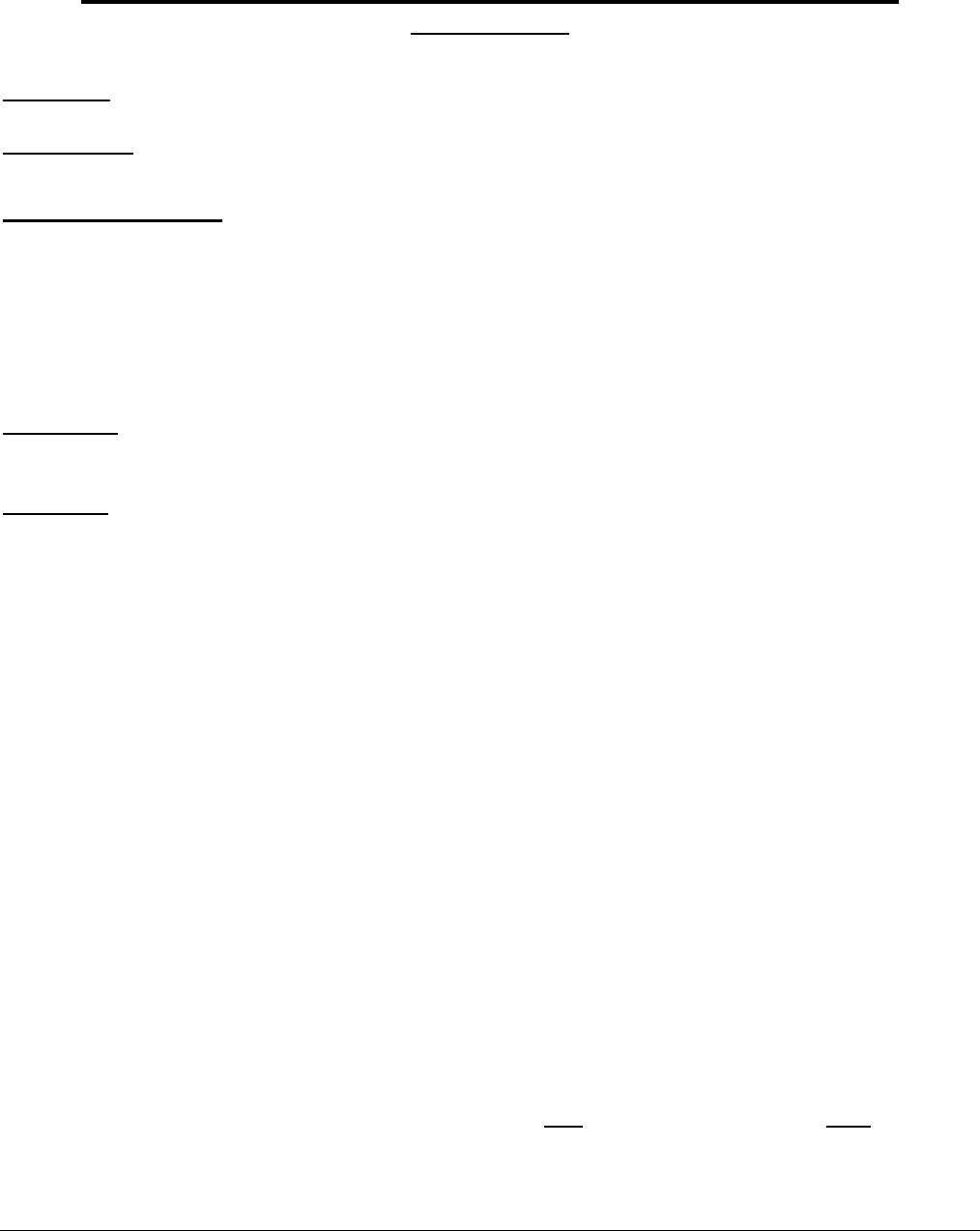
2015 785
P20/NM19
METHOD OF DRUG DETERMINATION BY POLICE
(FARS Only)
FORMAT: 1 numeric
SAS NAME: Person.DRUG_DET
ELEMENT VALUES:
1 Evidential Test (Blood, Urine)
2 Drug Recognition Technician (DRT) determination
3 Behavioral
7 Other
8 Not Reported
Definition: This element identifies the method by which the police made the determination as
to whether drugs were involved or not for this person.
Remarks:
This element is coded for each person involved in the crash. The Police Accident Report
(PAR) and supplements are the source of information.
The purpose of this element is to record the method by which the police made the
determination as to whether drugs were involved or not.
It is used primarily when the Police Reported Drug Involvement element is coded as 0 (No
[Drugs Not Involved]) or 1 (Yes [Drugs Involved]).
Whenever Police Reported Drug Involvement is 0 (No [Drugs Not Involved]), try to find out
how the police knew this. When Police Reported Drug Involvement is 1 (Yes [Drugs
Involved]), try to determine how the police knew this.
If Police Reported Drug Involvement is 8 (Not Reported) or 9 (Unknown [Police Reported]),
then Method of Drug Determination by Police is 8 (Not Reported). If more than one method is
used by the police to determine drug involvement choose the method the police refer to when
they record their assessment. If more than one method is used and they do not state which
method was the basis for their determination, code the highest-ranking method used from the
hierarchy (the highest ranking is “1”; the lowest is “7”).
1 (Evidential Test [Blood, Urine]) is used if Police Reported Drug Involvement is 0 (No
[Drugs Not Involved]) or 1 (Yes [Drugs Involved]) and the police indicate that they ordered
an evidential test and their determination of drug involvement was based on the results of that
test.

786 2015
P20/NM19
Ordering a test is not the same as knowing the results of that test. In order to code that
the police determined their opinion based on an evidential test, there must be
information that the officer had received the test results. If they haven’t received test
results (e.g., results are pending), then their method of determination of alcohol or drug
presence was made using some method other than an evidential test.
2 (Drug Recognition Technician [DRT] determination) is used if Police Reported Drug
Involvement is 0 (No [Drugs Not Involved]) or 1 (Yes [Drugs Involved]) and the police
indicate that drug involvement was based upon the results of expert opinion of a person
trained to evaluate a person for drug use.
The key to coding this is the definite indication by the police that a DRT was used and was the
basis (or the clinching evidence) that a driver had been using drugs or not.
3 (Behavioral) is used if Police Reported Drug Involvement is 0 (No [Drugs Not Involved]) or
1 (Yes [Drugs Involved]) and the police indicate that the basis for that drug assessment was
the behavior by the driver during their contact with the person such as a field sobriety test.
7 (Other) is used if Police Reported Drug Involvement is 0 (No [Drugs Not Involved]) or 1
(Yes [Drugs Involved]) and the police indicate that the basis for Drug determination was
something other than the codes “1, 2, or 3” described above.
Examples of 7 (Other) include:
1. Observations of drugs or drug use paraphernalia
2. Detecting the odor of marijuana
3. Admission by the person that they used drugs
If a PAR data element is coded with the attribute “Other” but the officer does not specify
what this refers to:
1. Code 7 (Other) if the PAR attribute choices can be matched to or include all the
attributes in FARS/GES.
2. Code 8 (Not Reported) if the PAR choices cannot be matched to or include all the
attributes in FARS/GES.
8 (Not Reported) is coded if Police-Reported Drug Involvement is 8 (Not Reported) or 9
(Unknown [Police Reported]). It is also coded if Police-Reported Drug Involvement is 0 (No
[Drugs Not Involved]) or 1 (Yes [Drugs Involved]) and there is no indication in the police
report or any documents as to how the police made the drug assessment.
Witness Statements:
Witness Statements may or may not be used by the police to make a determination of drug
involvement. If the police did use witness statements alone to make a determination of drug
involvement, use 7 (Other).

2015 787
P20/NM19
If the police mention, but did not use witness statements and there is no other indication of
how a determination was made, use 8 (Not Reported).
There are instances when the police do not indicate in the PAR whether drugs were involved
or not, but they do mention that a test was given or ordered.
FOR EXAMPLE: The police may only say that an evidential test was ordered for a driver
without indicating that they suspected drugs or what the result was.
Codes 1-7 may be used for Method Of Drug Determination by Police when Police Reported
Drug Involvement is coded as 8 (Not Reported) or 9 (Unknown [Police Reported]), if this fits
the case.
This should only happen when the method is stated by the police, but the Involvement is not
mentioned at all or stated as unknown.
Consistency Checks:
IF THEN
(BQ0P)
(BR0P)
(P140)
(P160)
METHOD OF DRUG DETERMIN-
ATION BY POLICE equals 8,
METHOD OF DRUG DETERMIN-
ATION BY POLICE equals 1-7,
POLICE REPORTED DRUG
INVOLVEMENT equals 8, 9,
POLICE REPORTED DRUG
INVOLVEMENT equals 1, and
METHOD OF DRUG DETERMIN-
POLICE REPORTED DRUG
INVOLVEMENT must equal 0, 1, 8, 9.
POLICE REPORTED DRUG
INVOLVEMENT must equal 0, 1, 8.
METHOD OF DRUG DETERMINATION
BY POLICE should equal 8.
not all DRUG TEST RESULTS should
equal 001.
(P170)
ATION BY POLICE equals 2,
METHOD OF DRUG DETERMIN-
ATION BY POLICE equals 1-7,
POLICE REPORTED DRUG
INVOLVEMENT should equal 0, 1.

P21/NM20
DRUG TEST
FORMAT: 1 set 1 numeric; 3 sets, 1 numeric, 3 numeric
SAS NAME: Person.DSTATUS, Person.DRUGTST1, Person.DRUGTST2,
Person.DRUGTST3, Person.DRUGRES1, Person.DRUGRES2, Person.DRUGRES3
ELEMENT VALUES:
GES FARS
Subfield 1 – Test Status
0 0 Test Not Given
1 1 Test Refused
2 2 Test Given
8 8 Not Reported
9 9 Unknown if Tested
Subfield 2 – Test Type
0 0 Test Not Given
1 1 Blood
2 2 Urine
3 3 Both: Blood and Urine Tests
7 7 Unknown Test Type
8 8 Other Test Type
6 6 Not Reported
9 9 Unknown if Tested
Subfield 3 – Test Result**
000 000 Test Not Given
001 001 Tested, No Drugs Found/Negative
XXX 100-295 Narcotic*
XXX 300-395 Depressant*
XXX 400-495 Stimulant*
XXX 500-595 Hallucinogen*
XXX 600-695 Cannabinoid*
XXX 700-795 Phencyclidine (PCP)*
XXX 800-895 Anabolic Steroid*
XXX 900-995 Inhalant*
XXX 996 Other Drug
997 997 Tested for Drugs, Results Unknown
998 998 Tested for Drugs, Drugs Found, Type Unknown/Positive
095 095 Not Reported
999 999 Unknown If Tested
* See Specific Drug Listings
** Test Result does not include Aspirin, Nicotine or Ethanol.
Alcohols reported other than ethanol would be classified under 996
2015 789

P21/NM20
(Other Drug). In addition, exclude drugs explicitly indicated to
have been administered after the crash. See Remarks below.
Remarks:
When completing this element, you must have the data to fill ALL three subfields. Otherwise,
leave all three subfields blank until all the data has been acquired to complete all three
subfields.
For drug tests that were initiated but not completed because of a contaminated or insufficient
sample, code:
Test Status as 2 (Test Given)
the applicable Test Type,
and code Test Results as 997(Tested for Drugs, Results Unknown).
Subfield 1 - Drug Test Status
Definition for Drug Test Status: This element identifies if a chemical test for the presence of
drugs was given to this person.
0 (Test Not Given) is used when the case materials indicate a drug test was not given. If Test
Status is 0 (Test Not Given) then Test Type and Test Result will also be 0 (Test Not Given)
and 000 (Test Not Given).
Most states’ practice is that “live” non-drivers are not routinely tested for drugs.
Consequently, for live non-drivers MDE will auto-fill Test Status, Test Type, and Test
Result as Test Not Given. If you happen to obtain a drug test result for a “live” non-
driver, enter Test Status as Test Given and the appropriate test type and results.
1 (Test Refused) is used when the case materials indicate a drug test was refused. If Test
Status is 1 (Test Refused) then Test Type and Test Result will be 0 (Test Not Given) and 000
(Test Not Given).
2 (Test Given) is used when the case materials indicate a drug test was given.
8 (Not Reported)
If a state’s crash report manual instructs to leave blank data blocks that are not applicable,
then a blank in those data blocks are NOT considered “Not Reported”.
Code 8 (Not Reported) in these two situations:
1. No field or coding block exists on the state’s crash report to provide the information
to code this element AND no other information is available to code the element (e.g.,
narrative, diagram, case materials)
2. A field or coding block exists on the state’s crash report that would provide the
information needed to code this element, but it has been left blank, AND no other
790 2015

P21/NM20
information is available to code the element (e.g., narrative, diagram, case
materials).
9 (Unknown if Tested) is used when the case materials specifically indicated “Unknown if
Tested.”
Subfield 2 Drug Test Type: You may record up to 3 separate drug test types and their
corresponding result.
Definition for Drug Test Type: This element identifies the type of chemical test for the
presence of drugs that was used for this person.
1 (Blood) is used when the case materials indicate this was the type of test used to detect the
presence of drugs.
2 (Urine) is used when the case materials indicate this was the type of test used to detect the
presence of drugs.
3 (Both: Blood and Urine Tests) is used when the case materials indicate this testing
combination was used to detect the presence of drugs. Typically this would be found on a
toxicology report.
7 (Unknown Test Type) is used when the case materials indicate a test was given and the
type of test is reported as unknown or pending and the type is unobtainable.
8 (Other Test Type) is used when the case materials indicate a type of test used to detect the
presence of drugs was recorded as “Other” or is indicated to be of a type other than the
available attributes.
If a PAR data element is coded with the attribute “Other” but the officer does not specify
what this refers to:
1. Code 8 (Other Test Type) if the PAR attribute choices can be matched to or
include all the attributes in FARS/GES.
2. Code 6 (Not Reported) if the PAR choices cannot be matched to or include all the
attributes in FARS/GES.
6 (Not Reported)
If a state’s crash report manual instructs to leave blank data blocks that are not applicable,
then a blank in those data blocks are NOT considered “Not Reported”.
Code 6 (Not Reported) in these two situations:
1. No field or coding block exists on the state’s crash report to provide the information
to code this element AND no other information is available to code the element (e.g.,
narrative, diagram, case materials)
2015 791

P21/NM20
2. A field or coding block exists on the state’s crash report that would provide the
information needed to code this element, but it has been left blank, AND no other
information is available to code the element (e.g., narrative, diagram, case
materials).
9 (Unknown if Tested) is used when the case materials specifically indicated “Unknown if
Tested.”
Subfield 3 - Drug Test Result
Definition for Drug Test Result: This element identifies the result of a chemical test for the
presence of drugs for this person.
**NOTE: This element excludes Nicotine, Aspirin and Ethanol. In addition, exclude
drugs explicitly indicated to have been administered after the crash. Alcohols reported
other than ethanol would be classified under 996 (Other Drug).
FARS SPECIAL INSTRUCTION:
You may record up to 3 separate drug test results and their corresponding test type.
Use the translation table to assign the three-digit code. If the drug is not on the list, use
996 (Other Drug), except for confirmed as “post crash” administered. Caffeine and
mild analgesics are coded 996 (Other Drug). When four or more drugs are present,
use the categories as a hierarchy (ex. narcotics (100-295) over depressants (300-395)
over stimulants (400-495), etc.)
000 (Test Not Given) is used when the case materials indicate a drug test was not given. If
Test Status is 0 (Test Not Given) then Test Type and Test Result will also be 0 (Test Not
Given) and 000 (Test Not Given).
001 (Tested, No Drugs Found/Negative) is used when the case materials indicate that a test
for the presence of drugs was “negative” or that no drugs were found.
997 (Tested for Drugs, Results Unknown) refers to drug tests that were performed but the
results are reported as unknown or pending and are unobtainable. 997 (Tested for Drugs,
Results Unknown) can be used for any Test Type.
FARS SPECIAL INSTRUCTION:
As a general coding guideline, do not prematurely use Test Result 997 (Tested for
Drugs, Results Unknown). It is recommended that you leave the information blank
until the test results are received from the state lab, coroner or police. You need to be
reasonably certain that you will never receive the test results to use attribute “997” at
the time of the initial coding and case entry. Examples of this situation would be if the
test results are returned indicating a “Contaminated Sample” or “Insufficient Sample.”
792 2015

P21/NM20
998 (Tested for Drugs, Drugs Found, Type Unknown/Positive) can be used for any Test
Type code where the result is indicated to be positive without an actual drug identified to
record.
This should only be used when a final test result is returned as “positive” with no actual result
to record. This can occur when a screening test is used and it is the only test result available.
Before recording this value make sure that this is the final test result and no actual value was
available from a follow-up confirmatory test.
095 (Not Reported)
If a state’s crash report manual instructs to leave blank data blocks that are not applicable,
then a blank in those data blocks are NOT considered “Not Reported”.
Code 095 (Not Reported) in these two situations:
1. No field or coding block exists on the state’s crash report to provide the information
to code this element AND no other information is available to code the element (e.g.,
narrative, diagram, case materials)
2. A field or coding block exists on the state’s crash report that would provide the
information needed to code this element, but it has been left blank, AND no other
information is available to code the element (e.g., narrative, diagram, case
materials).
999 (Unknown if Tested) is used when the case materials specifically indicated “Unknown if
Tested.”
Consistency Checks:
IF THEN
(7M1F) PERSON TYPE equals 03, and DRUG TEST STATUS must not equal 8,
(BT1P)
SEATING POSITION is not equal to
11 or 13, and INJURY SEVERITY
does not equal 4,
DRUG TEST STATUS equals 0, 1,
any DRUG TEST TYPE must not equal
6, and any DRUG TEST RESULTS
must not equal 095.
all DRUG TEST TYPE must equal 0,
and all DRUG TEST RESULT should
equal 000 for this person.
(BT2P) DRUG TEST STATUS equals 8, DRUG TEST TYPE 1 must equal 6, and
DRUG TEST RESULT 1 must equal
095, and remaining DRUG TEST
TYPES and DRUG TEST RESULTS
must be 0 filled.
2015 793

P21/NM20
IF
(BT3P) DRUG TEST STATUS equals 2,
(BT6P) DRUG TEST STATUS equals 9,
(BT7P) DRUG TEST STATUS equals 2, and
DRUG TEST RESULT one equals
001, 095, 100-295, 300-395, 400-495,
500-595, 600-695, 700-795, 800-895,
900-995, 996, 997, 998,
THEN
at least one DRUG TEST TYPE must
equal 1-8, and one corresponding
DRUG TEST RESULT must equal 001,
095, 100-295, 300-395, 400-495,
500-595, 600-695, 700-795, 800-895,
900-995, 996-998.
DRUG TEST TYPE 1 must equal 9, and
DRUG TEST RESULT 1 must equal
999, and remaining DRUG TEST
TYPES and DRUG TEST RESULTS
must be 0 filled.
DRUG TEST RESULT two and three
must not equal 999.
(BT8P) More than one of the same DRUG TEST RESULT values must not be coded for
(BT9P)
(P073)
(P075)
(P150)
(P160)
the same person except for 000, 996.
DRUG TEST RESULT 1 equals 000,
001, 997, 998, 095, or 999,
PERSON TYPE equals 02, 04-08, 10,
and INJURY SEVERITY does not
equal 4,
PERSON TYPE equals 02, 04-08, 10
or 19, and INJURY SEVERITY does
not equal 4,
POLICE REPORTED DRUG
INVOLVEMENT equals 1,
POLICE REPORTED DRUG
INVOLVEMENT equals 1, and
METHOD OF DRUG DETERMIN-
DRUG TEST RESULT 2 and DRUG
TEST RESULT 3 must equal 000.
DRUG TEST STATUS should not equal
9, and any DRUG TEST TYPE should
not equal 9, and any DRUG TEST
RESULTS should not equal 999.
DRUG TEST STATUS must not equal 8,
any DRUG TEST TYPE must not equal
6, and any DRUG TEST RESULTS must
not equal 095.
DRUG TEST STATUS should not equal
0.
not all DRUG TEST RESULTS should
equal 001.
ATION BY POLICE equals 2,
794 2015

P21/NM20
EXAMPLES FOR INTERPRETING DRUG TESTS
IF YOU HAVE:
A. Both Blood and Urine tests and
the results are the same for both.
Example: Blood – Fentanyl
Urine – Fentanyl
GUIDELINES:
Status Type 1
2 3
Result 1
151
Type 2
0
Result 2
000
Type 3
0
B. Both Blood and Urine tests and
the results are different for both.
Example: Blood – Hexobarbital
Urine – Cocaine
Status
2
Type 1
1
Result 1
333
Type 2
2
Result 2
407
Type 3
0
C. Both Blood and Urine tests and
the results are given but not
linked to either tests.
Example: Results – Codeine and
Ibogaine
Status
2
Type 1
6
Result 1
128
Type 2
6
Result 2
509
Type 3
0
D. Blood or Urine tests and other
test, such as vitreous.
Example: Blood – Diazepam
Vitreous – Cocaine
Status
2
Type 1
1
Result 1
321
Type 2
8
Result 2
407
Type 3
0
E. Urine test only and the results:
Example: Urine –
Benzodiazepines
Status
2
Type 1
2
Result 1
304
Type 2
0
Result 2
000
Type 3
0
F. Vitreous and other tests only.
Example: Vitreous –
Amphetamine and Verapamil
Status
2
Type 1
8
Result 1
401
Type 2
8
Result 2
996
Type 3
0
G. Not tested for drugs. Status
0
Type 1
0
Result 1
000
Type 2
0
Result 2
000
Type 3
0
H. Not Reported for drugs Status
8
Type 1
6
Result 1
095
Type 2
0
Result 2
000
Type 3
0
I. Unknown if tested for drugs. Status
9
Type 1
9
Result 1
999
Type 2
0
Result 2
000
Type 3
0
J. Tested for Drugs, Results
Unknown.
Example: Blood test – Yes
Results – Unavailable
Status
2
Type 1
1
Result 1
997
Type 2
0
Result 2
000
Type 3
0
K. Tested for Drugs, Drugs
Found, Type of Drug Unknown.
Example: Urine test – Yes
Drugs found – Yes
Status
2
Type 1
2
Result 1
998
Type 2
0
Result 2
000
Type 3
0
2015 795
Result 3
000
Result 3
000
Result 3
000
Result 3
000
Result 3
000
Result 3
000
Result 3
000
Result 3
000
Result 3
000
Result 3
000
Result 3
000

P21/NM20
Alphabetical Drug Index
Acetaminophen + Codeine 100
Acetorphine 101
Acetyl-alpha-methylfentanyl 102
Acetyldihydrocodeine 103
Acetylmethadol 104
Aerosols (hydrocarbon) 940
Alfentanil 105
Allylprodine 106
Alpha, Beta-dihydroxy-alpha-
androstane 828
Alphacetylmethadol 220
Alpha-Ethyltryptamine 523
Alpha-meprodine 109
Alpha-methyl-alpha-beta-dihy-
droxy-alpha-androstane 829
Alpha-methyl-beta-beta-dihy-
droxy-alpha-androstane 830
Alpha-methyl-beta-beta-
dihydroxy-androstene 831
Alpha-methyl-delta 1-
dihydrotestosterone 832
Alpha-Methylfentanyl 107
Alpha-methyl-
hydroxynandrolone 833
Alphamethythiofentanyl 108
Alpha-methyltryptamine 534
Alphamethadol 110
Alphaprodine 111
Alprazolam 300
Aminorex 428
Amobarbital 301
Amobarbital & non-controlled
active ingred. 378
Amobarbital suppository
dosage form 388
Amphetamine 401
Amphetamine Sulfate 400
Amphetamine Variants 500
Amyl Nitrite 921
Anabolic Steroid, Type
Unknown 895
Androstanedione 834
Androstenediol 835
Androstenedione 836
Anesthetic Gases 920
Anileridine 112
APC + Codeine 113
Aprobarbital 379
Aspirin + Codeine 114
Barbital 302
Barbiturates 303
Barbituric Acid Derivative 380
Benzethidine 115
Benzodiazepines 304
Benzoylecgonine 402
Benzphetamine 403
Benzylfentanyl 305
Benzylmorphine 117
Beta, beta-dihydroxy-alpha-
androstane 837
Beta-hydroxy-3-methylfentanyl 221
Beta-hydroxyfentanyl 118
Beta-meprodine 120
Betacetylmethadol 119
Betamethadol 121
Betaprodine 122
Bezitramide 123
Bolasterone 838
Boldenone 800
Bromo-dimethoxyamphetamine 524
Bromo-dimethoxyphenethylamine 525
Bromazepam 306
Bufotenine 501
Buprenorphine 124
Butabarbital (secbutabarbital) 307
Butalbital 308
Butobarbital (butethal) 389
Butorphanol 218
Butly Nitrite 923
Calusterone 839
Camazepam 309
“Cannabinoid, Type Unknown” 695
Carbamate 310
Carfentanil 125
Carisoprodol 376
Cathine (Norpseudoephedrine) 404
Cathinone 429
Chloral betaine 311
Chloral Hydrate 312
Chlordiazepoxide 313
Chlorhexadol 314
2015 797

P21/NM20
Alphabetical Drug Index
Chloroform 926
Chlorotestosterone 801
Chlorphentermine 405
Clobazam 315
Clonazepam 316
Clonitazene 126
Clorazepate Dipotassium 317
Clortermine 406
Clostebol 827
Clotiazepam 318
Cloxazolam 319
Coca Leaves 430
Cocaine 407
Codeine 128
Codeine combiniation product
90 mg/du 240
Codeine preparations – 200 mg/
100 ml or 100 gm 241
Codeine & Isoquinoline 222
Codeine methylbromide 127
Codeine-N-oxide 223
Cyprenorphine 129
Dehydrochloromethyltestosterone 803
Delorazepam 320
Delta 1-dihydrotestosterone 840
Delta 9 600
“Depressants, Type Unknown” 395
Desomorphine 130
Dexfenfluramine 383
Dextroamphetamine 408
Dextromoramide 131
Dextropropoxyphene
(dosage forms) 224
Diampromide 133
Diazepam 321
Dichloralphenazone 431
Diethylpropion 409
Diethylthiambutene 134
Diethyltryptamine (DET) 503
Difenoxin 135
Difenoxin 1 mg/25ug AtSO4/du 242
Difenoxion preparations –
0.5 mg/25 ug AtSO4/du 243
Dihydrocodeine 136
Dihydrocodeine combination
product 90 mg/du 244
Dihydrocodeine preparations
10 mg/100 ml or 100 gm 245
Dihydroetrophine 226
Dihydromorphine 137
Dihydrotestosterone 804
Dimenoxadol 138
Dimepheptanol (Racemethadol) 139
Dimethoxyamphetamine (DMA) 504
Dimethoxyethylamphetamine 535
Dimethoxy-(n)-propyl-
thiophenethylamine 536
Dimethylthiambutene 140
Dimethyltryptamine (DMT) 505
Dioxaphetyl Butyrate 141
Diphenoxylate 142
Diphenoxylate preparations
2.5 mg/25 ug AtSO4 246
Dipipanone 143
Diprenorphine 227
Diprenorphine Hydrochloride 144
Dronabinol 507
Drostanolone 805
Drotebanol 145
Ecgonine 410
Embutramide 390
Estazolam 322
Ethchlorvynol 323
Ether 925
Ethinamate 324
Ethyl Ioflazepate 325
Ethylmorphine combination
product 15 mg/du 247
Ethylmorphine preparations 100
mg/100 ml or 100 gm 248
Ethylamine 700
Ethylestrenol 806
Ethylmethylthiambutene 146
Ethylmorphine 147
Etonitazene 148
Etorphine 149
Etoxeridine 150
Fencamfamin 411
Fenethylline 412
798 2015

P21/NM20
Alphabetical Drug Index
Fenfluramine 413
Fenproporex 414
Fentanyl 151
Fiorinal + Codeine 152
Fiorinal 326
Fludiazepam 327
Flunitrazepam 328
Fluoxymesterone 807
Flurazepam 384
Formebulone (Formebolone) 808
Frying Pan Lubricants 944
Furazabol 841
Furethidine 153
Gamma Hydroxybutyric (GHB) 377
Gamma Hydroxybutyric Acid
preparations 391
Glass Chillers 943
Glutethimide 330
Hair spray 941
Halazepam 331
“Hallucinogens, Type Unknown” 595
Haloxazolam 332
Hashish 602
Hashish Oil 601
Heroin (Diacetylmorphine) 154
Hexobarbital 333
Hydrocodone 155
Hydrocodone & isoquinoline
alkaloid<15 mg/du 249
Hydrocodone combination
product<15 mg/du 250
Hydromorphinol 156
Hydromorphone 157
Hydroxy-Nortestosterone 842
Hydroxypethidine 158
Hydroxytestosterone 843
Hydroxyzine 334
Ibogaine 509
“Inhalants, Type Unknown” 995
Insecticides 942
Isomethadone 159
Ketamine 522
Ketazolam 335
Ketobemidone 160
Lacquer Thinners 904
Levo-alphacetylmethadol 228
Levomoramide 161
Levophenacylmorphan 162
Levomethorphan 163
Levorphanol 229
Levorphanol Tartrate 164
Lisdexamfetamine 436
Loprazolam 336
Lorazepam 337
Lormetazepam 338
Lysergic Acid 511
Lysergic Acid Amide 527
Lysergic Acid Diethylamide (LSD) 528
Marijuana/Marihuana 603
Marinol 604
Mazindol 415
Mebutamate 339
Mecloqualone 340
Medazepam 341
Mefenorex 416
Meperidine (Pethidine) 165
Meperidine intermediate-A 251
Meperidine intermediate-B 252
Meperidine intermediate-C 253
Mephobarbital
(Methylphenobarbital) 342
Meprobamate 343
Mescaline 512
Mestanolone 844
Mesterolone 809
Metazocine 166
Methadone 167
Methadone intermediate 254
Methamphetamine 417
Methandienone 810
Methandranone 811
Methandriol 812
Methandrostenolone 813
Methaqualone 344
Metharbital 345
Methcathinone 432
Methenolone 814
Methohexital 346
2015 799

P21/NM20
Alphabetical Drug Index
Methoxyamphetamine (PMA) 514
Methoxy-Methylenedioxy-
amphetamine 437
Methoxy-NN-disopropyltrypta-
mine 537
Methylaminorex 442
Methyldesorphine 168
Methyldienolone 845
Methyldihydromorphine 169
Methyl-dimethoxyamphetamine 530
Methylenedioxy-N-
ethylamphetamine 531
Methylenedioxyamphetamine
(MDA) 515
Methylenedioxymetham-
phetamine (MDMA) 513
Methylfentanyl 170
Methylone 435
Methlphenidate 418
Methyl-phenyl-
propionoxypiperidine (MPPP) 171
Methyltestosterone 815
Methylthiofentanyl 230
Methyltrienolone 846
Methyprylon 347
Metopon 172
Mibolerone 816
Midazolam 348
Modafinil 433
Moramide - intermediate 173
Morpheridine 174
Morphine 177
Morphine combination product/
50 mg/100 ml or gm 255
Morphine methylbromide 176
Morphine methylsulfonate 175
Morphine-N-oxide 231
Myrophine 178
Nabilone 516
Nalorphine 179
Nandrolone 817
“Narcotics, Type Unknown” 295
N-Benzylpiperazine 439
N-Ethyl-1-phenylcyclohexy-
lamine 533
N-Ethyl-3piperdyl benzilate 508
N-Ethylamphetamine 419
N-Hydroxymethylenedioxy-
amphetamine 538
Nicocodeine 180
Nicomorphine 181
Nimetazepam 349
Nitrazepam 350
Nitrous Oxide 924
N-Methylpiperidyl benzilate 539
N, N-Dimethylamphetamine
(Dimethylamphetamine) 438
Noracymethadol 182
Norandrostenediol 847
Norandrostenedione 848
Norbolethone 849
Norclostebol 850
Nordiazepam 351
Norethandrolone 818
Norlevorphanol 183
Normethadone 184
Normethandrolone 851
Normorphine 185
Norpipanone 186
Opium 187
Opium combination product
25 mg/du 256
Opium extract 232
Opium fluid extract 233
Opium, granulated 258
Opium Poppy 234
Opium, powdered 259
Opium preparations – 100 mg/
100 ml or 100 gm 257
Opium Tincture 235
Oripavine 260
“Other” 996
Oxandrolone 819
Oxazepam 352
Oxazolam 353
Oxycodone 189
Oxymesterone 820
Oxymetholone 821
Oxymorphone 188
800 2015

P21/NM20
Alphabetical Drug Index
Paint and Paint Removers 902
Para-fluorofentanyl 190
Parahexyl (Synhexyl) 701
Paraldehyde 354
Paregoric 191
Parepectolin 192
“PCP, Type Unknown” 795
Pemoline 420
Pentazocine 193
Pentobarbital 355
Pentobarbital & noncontrolled
active ingred. 393
Pentobarbital suppository
dosage form 394
Petrichloral 356
“Petroleum Products (gasoline,
kerosene)” 903
Peyote 517
Phenadoxone 195
Phenampromide 196
Phenanthrine 197
Phenazocine 198
Phencyclidine 702
Phencyclidine Analogs 703
Phenylcyclohexyl-Pyrrolidine 709
Phenylethyl-phenyl-
acetoxypiperidine (PEPAP) 236
Phencyclohexylamine 357
Phendimetrazine 421
Phenmetrazine 422
Phenobarbital 358
Phenomorphan 199
Phenoperidine 200
Phentermine 423
Phenylacetone (P2P) 518
Phenylcyclohexylamine 704
Pholcodine 202
Piminodine 203
Pinazepam 359
Piperidinocyclohexane-
carbonitrile (PCC) 705
Pipradrol 424
Piritramide 204
Plastic Cement (airplane glue) 901
Poppy Straw 237
Poppy Straw Concentrate 238
Prazepam 360
Pregabalin 396
Proheptazine 205
Properidine 206
Propiram 207
Propoxyphene (Dextropropoxy-
phene, bulk (non-dosage
forms)) 208
Propylhexedrine 425
Psilocybin 519
Psilocyn 520
Pyrovalerone 426
“Pyrrolidine (PCPy, PHP, TCPy)” 706
Quazepam 361
Racemethorphan 209
Racemoramide 210
Racemorphan 211
Remifentanil 239
Secobarbital 362
Secobarbital & noncontrolled
active ingred. 397
Secobarbital suppository
dosage form 398
Sibutramine 385
SPA 427
Stanolone 822
Stanozolol 823
Stenbolone 852
Stimulant compounds
previously excepted 440
“Stimulants, Type Unknown” 495
Sufentanil 212
Sulfondiethylmethane 363
Sulfonethylmethane 364
Sulfonmethane 365
Talbutal 366
Temazepam 367
Tested; Drugs Found; type 998
Tested; Results unknown 997
Testolactone 824
Testosterone 825
Tetrahydrocannabinols (THC) 605
2015 801

802 2015
P21/NM20
Alphabetical Drug Index
Tetrahydrogestrinone 853
Tetrazepam 368
Thebacon 213
Thebaine 214
Thenylfentanyl 369
Thiamylal 370
Thienylcyclohexyl]piperidine 708
Thienyl Cyclohexyl Pyrrolidine 710
Thiofentanyl 215
Thiopental(Pentothal) 371
Thiophene 707
Tiletamine/Zolazepam (Telazol) 372
Tilidine 216
Traizolam 373
Trenbolone 826
Trimeperidine 217
Trimethoxy amphetamine 521
Tybamate 374
Unknown If Tested For Drugs 999
Vinbarbital 434
Volatile Solvents (toluene) 900
Zaleplon 386
Zolpidem 387
Zopiclone 399

2015 803
P21/NM20
Drugs by Category Type
100-295 NARCOTICS 146 Ethylmethylthiambutene
100 Acetaminophen + Codeine
101 Acetorphine
102 Acetyl-alpha-methylfentanyl
103 Acetyldihydrocodeine
104 Acetylmethadol
105 Alfentanil
106 Allylprodine
107 Alpha-Methylfentanyl
108 Alphamethythiofentanyl
109 Alpha-meprodine
110 Alphamethadol
111 Alphaprodine
112 Anileridine
113 APC + Codeine
114 Aspirin + Codeine
117 Benzylmorphine
118 Beta-hydroxyfentanyl
119 Betacetylmethadol
120 Beta-meprodine
121 Betamethadol
122 Betaprodine
123 Bezitramide
124 Buprenorphine
125 Carfentanil
126 Clonitazene
127 Codeine methylbromide
128 Codeine
129 Cyprenorphine
130 Desomorphine
131 Dextromoramide
133 Diampromide
134 Diethylthiambutene
135 Difenoxin
136 Dihydrocodeine
137 Dihydromorphine
138 Dimenoxadol
139 Dimepheptanol (Racemethadol)
140 Dimethylthiambutene
141 Dioxaphetyl Butyrate
142 Diphenoxylate
143 Dipipanone
144 Diprenorphine Hydrochloride
145 Drotebanol
147 Ethylmorphine
148 Etonitazene
149 Etorphine
150 Etoxeridine
151 Fentanyl
152 Fiorinal + Codeine
153 Furethidine
154 Heroin (Diacetylmorphine)
155 Hydrocodone
156 Hydromorphinol
157 Hydromorphone
158 Hydroxypethidine
159 Isomethadone
160 Ketobemidone
161 Levomoramide
162 Levophenacylmorphan
163 Levomethorphan
164 Levorphanol Tartrate
165 Meperidine (Pethidine)
166 Metazocine
167 Methadone
168 Methyldesorphine
169 Methyldihydromorphine
170 Methylfentanyl
171 Methyl-phenyl-propionoxypiperidine
(MPPP )
172 Metopon
173 Moramide - intermediate
174 Morpheridine
175 Morphine methylsulfonate
176 Morphine methylbromide
177 Morphine
178 Myrophine
179 Nalorphine
180 Nicocodeine
181 Nicomorphine
182 Noracymethadol
183 Norlevorphanol
184 Normethadone
185 Normorphine
186 Norpipanone
187 Opium
188 Oxymorphone
189 Oxycodone

804 2015
P21/NM20
Drugs by Category Type
190 Para-fluorofentanyl
191 Paregoric
192 Parepectolin
193 Pentazocine
195 Phenadoxone
196 Phenampromide
197 Phenanthrine
198 Phenazocine
199 Phenomorphan
200 Phenoperidine
202 Pholcodine
203 Piminodine
204 Piritramide
205 Proheptazine
206 Properidine
207 Propiram
208 Propoxyphene (Dextropropoxy-
phene, bulk (non-dosage forms))
209 Racemethorphan
210 Racemoramide
211 Racemorphan
212 Sufentanil
213 Thebacon
214 Thebaine
215 Thiofentanyl
216 Tilidine
217 Trimeperidine
218 Butorphanol
220 Alphacetylmethadol
221 Beta-Hydroxy-3-methylfentanyl
222 Codeine & Isoquinoline
223 Codeine-N-oxide
224 Dextropropoxyphene (dosage forms)
226 Dihydroetrophine
227 Diprenorphine
228 Levo-alphacetylmethadol
229 Levorphanol
230 Methylthiofentanyl
231 Morphine-N-oxide
232 Opium extract
233 Opium Fluid Extract
234 Opium Poppy
235 Opium Tincture
236 Phenylethyl-phenyl-
acetoxypiperidine (PEPAP)
237 Poppy Straw
238 Poppy Straw Concentrate
239 Remifentanil
240 Codeine combination product
90 mg/du
241 Codeine preparations –
200 mg/100 ml or 100 gm
242 Difenoxin 1 mg/25ug AtSO4/du
243 Difenoxin preparations –
0.5 mg/25 ug AtSO4/du
244 Dihydrocodeine combination product
90 mg/du
245 Dihydrocodeine preparations
10 mg/100 ml or 100 gm
246 Diphenoxylate preparations
2.5 mg/25 ug AtSO4
247 Ethylmorphine combination product
15 mg/du
248 Ethylmorphine preparations
100 mg/100 ml or 100 gm
249 Hydrocodone & isoquinoline
alkaloid<15 mg/du
250 Hydrocodone combination
product<15 mg/du
251 Meperidine intermediate-A
252 Meperidine intermediate-B
253 Meperidine intermediate-C
254 Methadone intermediate
255 Morphine combination product/
50 mg/100 ml or gm
256 Opium combination product
25 mg/du
257 Opium preparations – 100 mg/
100 ml or/100 gm
258 Opium, granulated
259 Opium, powdered
260 Oripavine
295 “Narcotics, Type Unknown”
300-399 DEPRESSANTS
300 Alprazolam
301 Amobarbital
302 Barbital
303 Barbiturates

2015 805
P21/NM20
Drugs by Category Type
304 Benzodiazepines
305 Benzylfentanyl
306 Bromazepam
307 Butabarbital (secbutabarbital)
308 Butalbital
309 Camazepam
310 Carbamate
311 Chloral betaine
312 Chloral Hydrate
313 Chlordiazepoxide
314 Chlorhexadol
315 Clobazam
316 Clonazepam
317 Clorazepate Dipotassium
318 Clotiazepam
319 Cloxazolam
320 Delorazepam
321 Diazepam
322 Estazolam
323 Ethchlorvynol
324 Ethinamate
325 Ethyl Ioflazepate
326 Fiorinal
327 Fludiazepam
328 Flunitrazepam
330 Glutethimide
331 Halazepam
332 Haloxazolam
333 Hexobarbital
334 Hydroxyzine
335 Ketazolam
336 Loprazolam
337 Lorazepam
338 Lormetazepam
339 Mebutamate
340 Mecloqualone
341 Medazepam
342 Mephobarbital
(Methylphenobarbital)
343 Meprobamate
344 Methaqualone
345 Metharbital
346 Methohexital
347 Methyprylon
348 Midazolam
349 Nimetazepam
350 Nitrazepam
351 Nordiazepam
352 Oxazepam
353 Oxazolam
354 Paraldehyde
355 Pentobarbital
356 Petrichloral
357 Phencyclohexylamine
358 Phenobarbital
359 Pinazepam
360 Prazepam
361 Quazepam
362 Secobarbital
363 Sulfondiethylmethane
364 Sulfonethylmethane
365 Sulfonmethane
366 Talbutal
367 Temazepam
368 Tetrazepam
369 Thenylfentanyl
370 Thiamylal
371 Thiopental (Pentothal)
372 Tiletamine/ Zolazepam (Telazol)
373 Traizolam
374 Tybamate
376 Carisoprodol
377 Gamma-Hydroxybutyric Acid (GHB)
378 Amobarbital & non-controlled active
ingred.
379 Aprobarbital
380 Barbituric Acid Derivative
383 Dexfenfluramine
384 Flurazepam
385 Sibutramin
386 Zaleplon
387 Zolpidem
388 Amobarbital suppository dosage
form
389 Butobarbital (butethal)
390 Embutramide
391 Gamma Hydroxybutyric Acid
preparations
393 Pentobarbital & noncontrolled active
ingred.

806 2015
P21/NM20
Drugs by Category Type
394 Pentobarbital suppository dosage
form
395 “Depressants, Type Unknown”
396 Pregabalin
397 Secobarbital & noncontrolled active
ingred.
398 Secobarbital suppository dosage
form
399 Zopiclone
400-495 STIMULANTS
400 Amphetamine Sulfate
401 Amphetamine
402 Benzoylecgonine
403 Benzphetamine
404 Cathine (Norpseudoephedrine)
405 Chlorphentermine
406 Clortermine
407 Cocaine
408 Dextroamphetamine
409 Diethylpropion
410 Ecgonine
411 Fencamfamin
412 Fenethylline
413 Fenfluramine
414 Fenproporex
415 Mazindol
416 Mefenorex
417 Methamphetamine
418 Methylphenidate
419 N-Ethylamphetamine
420 Pemoline
421 Phendimetrazine
422 Phenmetrazine
423 Phentermine
424 Pipradrol
425 Propylhexedrine
426 Pyrovalerone
427 SPA
428 Aminorex
429 Cathinone
430 Coca Leaves
431 Dichloralphenazone
432 Methcathinone
433 Modafinil
434 Vinbarbital
435 Methylone
436 Lisdexamfetamine
437 Methoxy-Methylenedioxyamphetamine
438 N, N-Dimethylamphetamine
(Dimethylamphetamine)
439 N-Benzylpiperazine
440 Stimulant compounds previously
excepted
495 “Stimulants, Type Unknown”
500-595 HALLUCINOGENS
500 Amphetamine Variants
501 Bufotenine
503 Diethyltryptamine (DET)
504 Dimethoxyamphetamine (DMA)
505 Dimethyltryptamine (DMT)
506 DMA
507 Dronabinol
508 N-Ethyl-3piperdyl benzilate
509 Ibogaine
511 Lysergic Acid
512 Mescaline
513 Methylenedioxymethamphetamine
(MDMA)
514 Methoxyamphetamine (PMA)
515 Methylenedioxyamphetamine (MDA)
516 Nabilone
517 Peyote
518 Phenylacetone (P2P)
519 Psilocybin
520 Psilocyn
521 Trimethoxy amphetamine
522 Ketamine
523 Alpha-Ethyltryptamine
524 Bromo-dimethoxyamphetamine
525 Bromo-dimethoxyphenethylamine
527 Lysergic Acid Amide
528 Lysergic Acid Diethylamide (LSD)
529 Methylaminorex
530 Meth-dimethoxyamphetamine
531 Methylenedioxy-N-
ethylamphetamine

P21/NM20
Drugs by Category Type
533 N-Ethyl-1-phenylcyclohexylamine 807 Fluoxymesterone
534 Alpha-methyltryptamine 808 Formebulone (Formebolone)
535 Dimethoxyethylamphetamine 809 Mesterolone
536 Dimethoxy-(n)- 810 Methandienone
propylthiophenethylamine 811 Methandranone
537 Methoxy-NN-diisopropyltryptamine 812 Methandriol
538 N-Hydroxymethylenedioxy-amphetamine 813 Methandrostenolone
539 N-Methylpiperidyl benzilate 814 Methenolone
595 “Hallucinogens, Type Unknown” 815 Methyltestosterone
816 Mibolerone
600-695 CANNABINOID 817 Nandrolone
818 Norethandrolone
600 Delta 9 819 Oxandrolone
601 Hashish Oil 820 Oxymesterone
602 Hashish 821 Oxymetholone
603 Marijuana/Marihuana 822 Stanolone
604 Marinol 823 Stanozolol
605 Tetrahydrocannabinols (THC) 824 Testolactone
695 “Cannabinoid, Type Unknown” 825 Testosterone
826 Trenbolone
827 Clostebol
700-795 PCP 828 Alpha, Beta-dihydroxy-alpha-
androstane
700 Ethylamine 829 Alpha-methyl-alpha-beta-
701 Parahexyl (Synhexyl) dihydroxy-alpha-androstane
702 Phencyclidine 830 Alpha-methyl-beta-beta-
703 Phencyclidine Analogs dihydroxy-alpha-androstane
704 Phenylcyclohexylamine 831 Alpha-methyl-beta-beta-
705 Piperidinocyclohexane-carbonitrile dihydroxy-androstene
(PCC) 832 Alpha-methyl-delta 1-
706 “Pyrrolidine (PCPy, PHP,TCPy) ” dihydrotestosterone
707 Thiophene 833 Alpha-methyl-hydroxynandrolone
708 Thienyl Cyclohexyl/piperidine 834 Androstanedione
709 Phenylcyclohexyl-Pyrrolidine 835 Androstenediol
710 Thienyl Cyclohexyl Pyrrolidine 836 Androstenedione
795 “PCP, Type Unknown” 837 Beta, beta-dihydroxy-alpha-
androstane
800-895 ANABOLIC STEROIDS 838 Bolasterone
839 Calusterone
800
801 Boldenone
Chlorotestosterone 840
841 Delta 1-dihydrotestosterone
Furazabol
803
804
805
Dehydrochloromethyltestosterone
Dihydrotestosterone
Drostanolone
842
843
844
Hydroxy-Nortestosterone
Hydroxytestosterone
Mestanolone
806 Ethylestrenol 845 Methyldienolone
2015 807

P21/NM20
Drugs by Category Type
846 Methyltrienolone
847 Norandrostenediol
848 Norandrostenedione
849 Norbolethone
850 Norclostebol
851 Normethandrolone
852 Stenbolone
853 Tetrahydrogestrinone
854 Boldione
855 Desoxymethyltestosterone
856 Dienedione
895 “Anabolic Steroid, Type
Unknown”
900-995 INHALANT
900 Volatile Solvents (toluene)
901 Plastic Cement (airplane glue)
902 Paint and Paint Removers
903 “Petroleum Products (gasoline,
kerosene)”
904 Lacquer Thinners
920 Anesthetic Gases
921 Amyl Nitrite
923 Butly Nitrite
924 Nitrous Oxide
925 Ether
926 Chloroform
940 Aerosols (hydrocarbon gases)
941 Hair spray
942 Insecticides
943 Glass Chillers
944 Frying Pan Lubricants
945 Cyclohexl Nitrite
946 Enflurane
947 Halothane
995 “Inhalants, Type Unknown”
996 OTHER,
997 TESTED; RESULTS UNKNOWN
998 TESTED; DRUGS FOUND; TYPE
UNKNOWN
999 UNKNOWN IF TESTED FOR DRUG
808 2015

2015 809
P22/NM21
TRANSPORTED TO FIRST MEDICAL FACILITY BY
FORMAT: 1 numeric
SAS NAME: Person.Hospital
ELEMENT VALUES:
0 Not Transported
1 EMS Air
5 EMS Ground
3 EMS Unknown Mode
2 Law Enforcement
4 Transported Unknown Source
6 Other
8 Not Reported
9 Unknown
Definition: This element identifies the method of transportation this person was provided to
receive treatment at the first hospital or medical facility.
Remarks:
Medical Facility refers to an injury treatment facility. The treatment facility is the first medical
facility to which the person is taken. Use appropriate attribute, even if the person dies en route
to the treatment facility. A morgue is not an injury treatment facility.
0 (Not Transported) is used for victims who are dead on the scene and for those who are not
taken (or do not go) to a treatment facility or hospital for treatment. For example, an uninjured
occupant rides along with an injured person to a treatment facility. 0 (Not Transported) would
be used if the person did not go to a treatment facility directly from the scene, but was
transported at a later time for injuries sustained in this crash.
If a person is moved from the crash scene by emergency services personnel (EMS,
Rescue Squad, fire department, law enforcement) as part of the transport process,
consider the person as transported. For example, an injured person that is driven by
emergency services to a location to be air lifted should be coded as 1 (EMS Air).
There can also be situations where a person leaves the crash scene (e.g. walks for help)
or is moved from a crash scene by a party other than emergency services. For example,
in a remote or inaccessible location a private citizen drives an injured person to an
accessible location before obtaining help and acquiring emergency services assistance
from this new location. Consider these situations as 0 (Not Transported) for treatment
even if the person was eventually transported for treatment from this new location.

810 2015
P22/NM21
1 (EMS Air) includes any air transport device. This code would be used any time air transport
was used for this person. For example, If there is an indication that both air and ground
transportation were used, code 1 (EMS Air).
5 (EMS Ground) includes transport by private and county/city-owned ambulance or rescue
squad vehicles.
3 (EMS Unknown Mode) is used when a person is transported to a treatment facility by EMS,
but the mode of transportation is not known.
2 (Law Enforcement) includes transport by state, county or local law enforcement agency
vehicles.
4 (Transported Unknown Source) is used if you know the person was transported to a
treatment facility, but you do not know the source.
6 (Other) includes transport by private citizens or individuals who drive themselves to the
hospital or treatment facility. May be indicated on your crash report as “POV”
(Privately/Personally Owned Vehicle).
If a PAR data element is coded with the attribute “Other” but the officer does not specify
what this refers to:
1. Code 6 (Other) if the PAR attribute choices can be matched to or include all the
attributes in FARS/GES.
2. Code 8 (Not Reported) if the PAR choices cannot be matched to or include all the
attributes in FARS/GES.
8 (Not Reported)
If a state’s crash report manual instructs to leave blank data blocks that are not applicable,
then a blank in those data blocks are NOT considered “Not Reported”.
Code 8 (Not Reported) in these two situations:
1. No field or coding block exists on the state’s crash report to provide the information
to code this element AND no other information is available to code the element (e.g.,
narrative, diagram, case materials)
2. A field or coding block exists on the state’s crash report that would provide the
information needed to code this element, but it has been left blank, AND no other
information is available to code the element (e.g., narrative, diagram, case
materials).
9 (Unknown) is used when it is reported as “unknown” whether or not this victim was taken (or
went) to a hospital/treatment facility for treatment.

P22/NM21
2015 811
FARS SPECIAL INSTRUCTION:
Prior to 2007, this element was called “Taken to Hospital or Treatment Facility” and only
recorded whether or not the person was transported for treatment. After 2007, this element’s
name was changed to “Transported for Treatment By”. Beginning in 2010, this element's
name is changed to "Transported to Medical Facility By” and indicates if the person was
transported for treatment, and if transported, the source of transport. Beginning in 2013, this
element’s name was changed to “Transported to First Medical Facility By” to match the revised
4th Edition of MMUCC. It indicates the source of transport to the first medical facility receiving
the patient injured in the crash.
GES SPECIAL INSTRUCTION:
This data element is not related to GES sampling.
Consistency Checks:
IF THEN
(2U3F) INJURY SEVERITY equals 3, TRANSPORTED TO FIRST MEDICAL
FACILITY BY should not equal 0.
(A551) EMS TIME AT HOSPITAL equals TRANSPORTED TO FIRST MEDICAL
8888, 9997, 9998, FACILITY BY should not equal 1, 3, 5 for
any PERSON.
(P090) INJURY SEVERITY equals 0, TRANSPORTED TO FIRST MEDICAL
FACILITY BY must equal 0.
(P091) TRANSPORTED TO FIRST EMS TIME AT HOSPITAL should not
MEDICAL FACILITY BY equals 1, 3, equal 8888, 9997, 9998.
5,
(P093) all persons TRANSPORTED TO NOTIFICATION TIME EMS, ARRIVAL
FIRST MEDICAL FACILITY BY TIME EMS, EMS TIME AT HOSPITAL
equals 2, 4, must equal 8888.
(P50P) DIED AT SCENE/EN ROUTE equals TRANSPORTED TO FIRST MEDICAL
7, FACILITY BY must equal 0.
(P51P) DIED AT SCENE/EN ROUTE equals TRANSPORTED TO FIRST MEDICAL
8, FACILITY BY must equal 1-6.

812 2015
P22/NM21
Consistency Checks (FARS Only):
IF
(P520) CRASH DATE and DEATH DATE are
the same, and CRASH TIME and
DEATH TIME are the same,
(P52P) DIED AT SCENE/EN ROUTE equals
9,
(P55P) TRANSPORTED TO FIRST
MEDICAL FACILITY BY equals 9,
THEN
TRANSPORTED TO FIRST MEDICAL
FACILITY BY should equal 0, and DIED
AT SCENE/EN ROUTE should equal 7.
TRANSPORTED TO FIRST MEDICAL
FACILITY BY must equal 8 or 9.
DIED AT SCENE/EN ROUTE must
equal 0, 9.
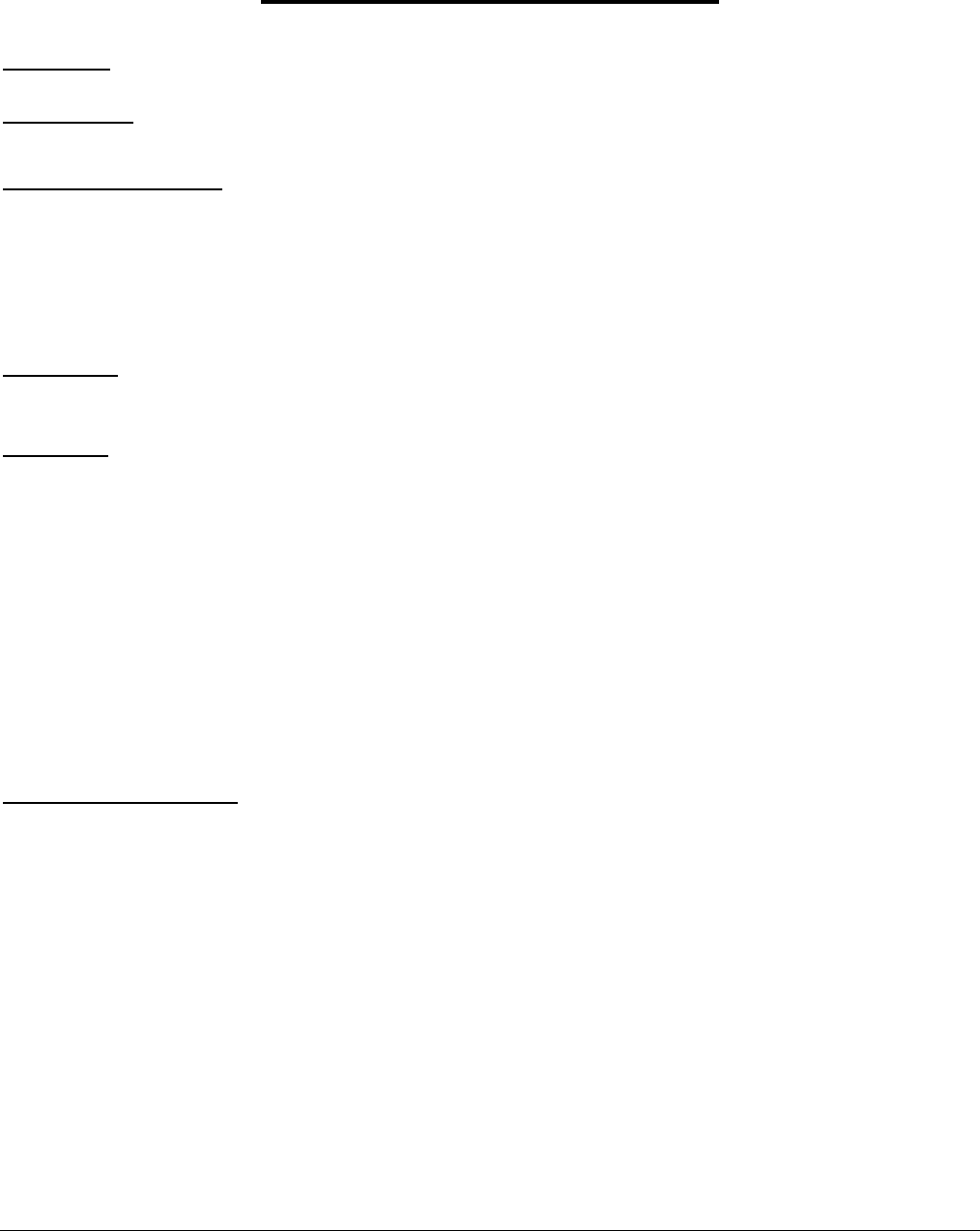
2015 813
P23/NM22
DIED AT SCENE/EN ROUTE
FORMAT: 1 numeric
SAS NAME: Person.DOA
ELEMENT VALUES:
0 Not Applicable
7 Died at Scene
8 Died En Route
9 Unknown
Definition: This element identifies if this person died at the scene of the crash or en route to a
hospital or treatment facility.
Remarks:
0 (Not Applicable) is used for non-fatalities and victims dying at locations other than the
scene or en route (e.g., hospital, at home, etc.).
7 (Died at Scene) is used for victims who are dead on the scene of the crash.
8 (Died En Route) is used for victims who die en route to a hospital or treatment facility by
EMS or other transport.
9 (Unknown) is used when you know the victim is a fatality, but you don’t know if they died at
the scene, en route, or at another location (e.g., home).
Consistency Checks:
IF THEN
(1R1P) If DIED AT SCENE/EN ROUTE INJURY SEVERITY must equal 4.
equals 7, 8,
(P50P) DIED AT SCENE/EN ROUTE equals TRANSPORTED TO FIRST MEDICAL
7, FACILITY BY must equal 0.
(P510) EMS TIME AT HOSPITAL equals DIED AT SCENE/EN ROUTE should not
8888, 9997, 9998, equal 8 for any PERSON.
(P51P) DIED AT SCENE/EN ROUTE equals TRANSPORTED TO FIRST MEDICAL
8, FACILITY BY must equal 1-6.
(P56P) DIED AT SCENE/EN ROUTE equals DEATH TIME should be within 30
7, minutes of the CRASH TIME.

814 2015
P23/NM22
IF
(P530) EMS TIME AT HOSPITAL equals
9996,
(P53P) INJURY SEVERITY equals 0-3, 5, 6,
(P54P) DIED AT SCENE/EN ROUTE equals
8,
Consistency Checks (FARS Only):
IF
(P520) CRASH DATE and DEATH DATE are
the same, and CRASH TIME and
DEATH TIME are the same,
(P52P) DIED AT SCENE/EN ROUTE equals
9,
(P55P) TRANSPORTED TO FIRST
MEDICAL FACILITY BY equals 9,
THEN
DIED AT SCENE/EN ROUTE must
equal 8 for at least one person.
DIED AT SCENE/EN ROUTE must
equal 0.
EMS TIME AT HOSPITAL should not
equal 8888, 9997, 9998.
THEN
TRANSPORTED TO FIRST MEDICAL
FACILITY BY should equal 0, and DIED
AT SCENE/EN ROUTE should equal 7.
TRANSPORTED TO FIRST MEDICAL
FACILITY BY must equal 8 or 9.
DIED AT SCENE/EN ROUTE must
equal 0, 9.

2015 815
P24/NM23
DEATH DATE
FORMAT: 2 sets of 2 numeric, 1 set of 4 numeric
SAS NAME: Person.DEATH_DA; Person.DEATH_MO; Person.DEATH_YR
ELEMENT VALUES:
Month:
88 Not Applicable (Non-fatal)
01-12
99 Unknown
Day:
88 Not Applicable (Non-fatal)
01-31
99 Unknown
Year:
8888 Not Applicable (Non-fatal)
Actual Year of Death
9999 Unknown
Definition: This element records the month, day and year of this person’s death.
Remarks:
The death must occur within thirty 24-hour time periods from time of the crash in order to be an
applicable FARS death.
This element, although it contains three (3) pieces of information should, be treated as one
element. Therefore, never leave any one portion blank when another is not.
Normally, the medical examiner or coroner is source of data for death date. If there are no data
inconsistencies or errors, use the official death date as recorded on the Death Certificate. Do
not change the official death date without good cause.
Consistency Checks:
IF THEN
(1U1F) INJURY SEVERITY equals 4, DEATH DATE must not equal
88888888.
(1V0P) DEATH MONTH or DAY equals 88, or all must equal 8’s.
DEATH YEAR equals 8888,

816 2015
P24/NM23
IF THEN
(2U1F) INJURY SEVERITY is not equal to 4, DEATH DATE must equal 88888888.
(2V0P) DEATH DAY is 01-31, and DEATH DEATH DAY must be a valid day for
MONTH is 01-12, DEATH MONTH.
(3U0P) DEATH DATE equals CRASH DATE, DEATH TIME must not be less than
and CRASH TIME is not equal to CRASH TIME.
9999,
(4V1F) INJURY SEVERITY equals 4, DEATH DATE and DEATH TIME for this
person must be within 720 hours of the
CRASH DATE and CRASH TIME.
(4V2F) CRASH MONTH equals 12, and DEATH YEAR must equal CRASH
DEATH MONTH equals 01, YEAR plus 1.
(4V3F) CRASH MONTH equals 12, DEATH MONTH must equal 01, 12, 88,
99.
(4V4F) CRASH MONTH equals 02-11, and DEATH MONTH must equal CRASH
DEATH MONTH is not equal to 88 or MONTH or CRASH MONTH plus 1.
99,
(4V5F) CRASH MONTH equals 01, and DEATH MONTH must equal CRASH
DEATH MONTH is not equal to 88 or MONTH or CRASH MONTH plus 1 or
99, CRASH MONTH plus 2.
(4V6P) DEATH MONTH is not equal to DEATH DAY and DEATH YEAR must
blanks, not equal blanks.
(4V7P) DEATH DAY is not equal to blanks, DEATH MONTH and DEATH YEAR
must not equal blanks.
(4V8P) DEATH YEAR is not equal to blanks, DEATH MONTH and DEATH DAY must
not equal blanks.
(6V0P) DEATH DATE must not be less than CRASH DATE.
(7V0F) DEATH YEAR equals 9999, CRASH MONTH must not be 01-11.
(8V0P) DEATH YEAR equals 9999, DEATH MONTH and DEATH DAY must
equal 99.
(9V0P)
Consiste
DEATH MONTH equals 99, DEATH DAY must equal 99.
IF
ncy Checks (FARS Only):
THEN
(P520) CRASH DATE and DEATH DATE are TRANSPORTED TO FIRST MEDICAL
the same, and CRASH TIME AND FACILITY BY should equal 0, and DIED
DEATH TIME are the same, AT SCENE/EN ROUTE should equal 7.

P25/NM24
2015 817
DEATH TIME
FORMAT: 4 numeric
SAS NAME: Person.DEATH_HR; Person.DEATH_MN; Person.DEATH_TM
ELEMENT VALUES:
8888 Not Applicable (Non-fatal)
0000-2359 Valid Military Time
0099-2399 Known Hour but Unknown Minutes
9999 Unknown
Definition: This element identifies the hour and minute of this person’s death utilizing the 24-
hour clock format.
Remarks:
If minutes are unknown, code the actual hour and “99” for the minutes. One minute after
midnight is coded 0001.”
Normally, the medical examiner or coroner is source of data for death time. If there are no data
inconsistencies or errors, use the official death time as recorded on the Death Certificate. Do
not change the official death time without good cause.
If it is known that the person died at the scene and the official death time or “pronounced death
time” (on the Death Certificate) is known to be in error, or is greater than 30 minutes after the
crash time then CRASH TIME is the appropriate DEATH TIME to be used.
How to Code Midnight:
In general, code midnight as 0000. However, there may be confusion over which day midnight
falls into. Crash Time is recorded between 00:00-23:59. Midnight is coded as 00:00 to
represent the beginning of a new day. This may not be the practice followed in your sources.
Therefore, you have to determine which part of the day is being considered in your sources.
End of Day
If your data sources give you a Crash Date and are consistent in talking about the end of that
day, when they give the time of the crash as “midnight,” “12:00-midnight,” “24:00” or “00:00,”
then you should code Crash Time as 2359.

818 2015
P25/NM24
Beginning of Day
If your sources give a Crash Date and are consistent in referring to the beginning or early
moments of that day when they give a crash time, code midnight as 0000.
Consistency Checks:
IF THEN
(1U2F) INJURY SEVERITY equals 4, DEATH TIME must not equal 8888.
(2U2F) INJURY SEVERITY is not equal to 4, DEATH TIME must equal 8888.
(3U0P) DEATH DATE equals CRASH DATE, DEATH TIME must not be less than
and CRASH TIME is not equal to CRASH TIME.
9999,
(4V1F) INJURY SEVERITY equals 4, DEATH DATE and DEATH TIME for this
person must be within 720 hours of the
CRASH DATE and CRASH TIME.
(P56P) DIED AT SCENE/EN ROUTE equals DEATH TIME should be within 30
7, minutes of the CRASH TIME.
Consistency Checks (FARS Only):
IF THEN
(P520) CRASH DATE and DEATH DATE are TRANSPORTED TO FIRST MEDICAL
the same, and CRASH TIME AND FACILITY BY should equal 0, and DIED
DEATH TIME are the same, AT SCENE/EN ROUTE should equal 7.

2015 819
P26
RELATED FACTORS – PERSON (MV OCCUPANT) LEVEL
FORMAT: 2 numeric occurring 3 times
SAS NAME: Person.P_SF1, Person.P_SF2, Person.P_SF3
ELEMENT VALUES:
00 None
05 Interfering With Driver
*08 Mentally Challenged
09 Construction/Maintenance/Utility Worker
*18 Mother of Dead Fetus/Mother of Infant Born Post Crash
21 Overloading or Improper Loading of Vehicle With Passengers or Cargo
*26 Following Improperly
89 Parked Motor Vehicle With Equipment Extending into the Travel Lane
*28 Improper Lane Usage
*29 Intentional Illegal Driving on Road Shoulder, in Ditch, on Sidewalk or on Median
32 Opening Vehicle Closure into Moving Traffic or While Vehicle is in Motion
*33 Passing Where Prohibited by Posted Signs, Pavement Markings or School Bus
Displaying Warning Not to Pass
*37 Traveling on Prohibited Trafficways
*40 Passing Through or Around Barrier
*41 Failure to Observe Warnings or Instructions on Vehicles Displaying Them
*42 Failure to Signal Intentions
*44 Driving Too Fast for Conditions or in Excess of Posted Maximum
*45 Driving Less Than Posted Minimum
*47 Making Right Turn From Left-Turn Lane, Left Turn From Right-Turn Lane
*51 Operator Inexperience
*52 Unfamiliar with Roadway
56 Non-Driver Flees Scene
*57 Improper Tire Pressure
*59 Overcorrecting
Vision Obscured By:
*60 Rain, Snow, Fog, Smoke, Sand, Dust
*61 Reflected Glare, Bright Sunlight, Headlights
*62 Curve, Hill, or Other Design Features (including traffic signs, embankment)
*63 Building, Billboard, Other Structures
*64 Trees, Crops, Vegetation
*65 Motor Vehicle (including load)
*66 Parked Vehicle
*67 Splash or Spray of Passing Vehicle
*68 Inadequate Lighting System
*69 Obstructing Angles on Vehicle
*70 Mirrors

P26
*72 Other Visual Obstruction
Skidding, Swerving Sliding, Due To:
*73 Severe Crosswind
*74 Wind From Passing Truck
*75 Slippery or Loose Surface
*76 Tire Blowout or Flat
*77 Debris or Objects in Road
*78 Ruts, Holes, Bumps in Road
*80 Vehicle in Road
*81 Phantom Vehicle
*82 Pedestrian, Pedal Cyclists, or Other Non-Motorist
*83 Ice, Snow, Slush, Water, Sand, Dirt, Oil, Wet Leaves on Road
Other Factors:
86 Emergency Services Personnel
87 Police or Law Enforcement Officer
*88 Seat Back Not in Normal Upright Position, Seat Back Reclined
91 Portable Electronic Devices
92 Person in Ambulance Treatment Compartment
99 Unknown
*FARS ONLY ATTRIBUTES
Definition: This element identifies factors related to motor vehicle occupants other than
drivers expressed by the investigating officer.
Remarks:
Code information provided by the investigating officer associated with this person from
the narrative, contributing factors/circumstances field, or citations/violations section of
the case materials.
In addition to passengers in motor vehicles in-transport (Unit Type 1), this element
includes any occupants in motor vehicles that are not in-transport (Unit Types 2, 3, 4).
The attributes that are applicable to each is limited by Person Type (P7).
The following lists those related factors that may be used for each PERSON TYPE (P7):
Person Valid Related Factors
Type
01 00
02 00, 05, 08, 09, 18, 32, 56, 86-89, 92, 99
03 00, 05, 08, 09, 18, 21, 26, 28, 29, 32, 33, 37, 40-42, 44, 45, 47, 51, 52, 56-70,
72-78, 80-83, 86-89, 91, 92, 99
09 00, 05, 08, 09,18, 32, 86-89, 92, 99
820 2015

2015 821
P26
For forms with PERSON TYPE 01 (Driver of a Motor Vehicle In-Transport), zero-fill all three
fields. The related factors for drivers are captured in the Related Factors-Driver Level.
CODING HIERARCY: When more than three attributes apply, select the attributes that have
not been previously captured under other related elements.
00 (None) is used when no applicable related factors are noted in the case materials.
Zero-fill all fields. Also, use 00 (None) to complete the remaining fields when you will be
recording less than three related factors. DO NOT leave any remaining fields blank.
05 (Interfering With Driver) is used when the case materials identify that the occupant of
a motor vehicle in-transport was interfering with the driver.
Examples include:
Obstructing the driver’s view.
Striking the driver with their body or other object.
Rambunctious individuals who cause the driver to be inattentive, even without touching
the driver or controls in the vehicle.
A motorcycle passenger (or other cyclist) shifting their weight or affecting the driver's
control.
*08 (Mentally Challenged) is used when the case materials identify the occupant of the
motor vehicle has a documented mental illness or intellectual disorder noted by the officer.
09 (Construction/Maintenance/Utility Worker) is used if the case materials identify this
person was an occupant of a working motor vehicle. This includes highway
department, contractor or utility company personnel.
18 (Mother of Dead Fetus/Mother of Infant Born Post Crash) is used when the case
materials identify that this occupant is the mother of a fetus that died in or as a result of
this crash or it is identified that this occupant gave birth after the crash whether the
child survives or not. Note that for crash classification purposes, a fetus is considered
to be part of a pregnant woman rather than a separate individual and, thus, is not
counted as a separate occupant in the crash.
21 (Overloading or Improper Loading of Vehicle with Passengers or Cargo) is used
when the case materials identify this occupant improperly loaded the vehicle occupants
or cargo into or on the vehicle. This may only be used on the PERSON TYPE 03
(Occupant of a Motor Vehicle Not In-Transport) and in SEATING POSITION 11 (Front
Seat, Left Side).
Examples include:
The vehicle had more than 3 passengers in the front seat.
There were persons riding on the exterior of the vehicle.

P26
The vehicle was carrying occupants that were sitting or standing on the rails,
tailgate of a pickup or improperly sitting in the bed of a pickup.
More than one person secured in a belt restraint.
An unsecured or uncovered load violation.
The vehicle's trunk was open with extra large cargo protruding.
The case materials state the vehicle was overweight, over length or illegally or
improperly oversize.
*26 (Following Improperly) is used when the case materials identify this occupant
followed too closely. This may only be used on the Person Form for the occupant that
is PERSON TYPE 03 (Occupant of a Motor Vehicle Not In-Transport) and in SEATING
POSITION 11 (Front Seat, Left Side) in a working motor vehicle.
Examples include:
Following a fire truck too closely.
Failure to maintain a safe passing distance between trucks.
Following another vehicle in a caravan too closely to allow entry by a merging vehicle.
Following too close, generally. Also code for cases where the case materials
document the vehicle was following too closely for weather conditions.
89 (Parked Motor Vehicle with Equipment Extending into the Travel Lane) is used when
the case materials identify this occupant parked a vehicle but extended equipment (e.g.,
extended mirrors) attached to the vehicle was still in the travel lane. This may only be
used on the Person Form for the occupant that is PERSON TYPE 03 (Occupant of a
Motor Vehicle Not In-Transport) and in SEATING POSITION 11 (Front Seat, Left Side).
NOTE: This should not be used for loads of vehicles extending into the travel lane such as
attached trailers or oversized cargo. In these cases the vehicle is in-transport and not parked.
*28 (Improper Lane Usage) is used when the case materials identify this occupant failed
to properly keep their vehicle in the appropriate lane of travel. This attribute does not
apply to vehicles that run off the roadway or that cross the median. Also do not use
this value for a vehicle that leaves its lane because of a previous impact or at the
direction of a flagman or police officer. This may only be used on the Person Form for
the occupant that is PERSON TYPE 03 (Occupant of a Motor Vehicle Not In-Transport)
and in SEATING POSITION 11 (Front Seat, Left Side) in a working motor vehicle.
Examples include:
A vehicle that “drove left of center” striking an oncoming vehicle (includes both
crossing a painted centerline and failing to maintain the proper side of a two-lane
roadway with no painted centerline.)
A vehicle that goes straight in a turn lane.
A vehicle that was using more than one lane on its side of a multi-lane highway.
Trucks, buses, or slow vehicles failing to keep right for faster moving traffic.
822 2015

2015 823
P26
For situations where the vehicle is on the wrong side as a result of a passing maneuver,
see 33 (Passing Where Prohibited by Posted Signs, Pavement Markings, or School Bus
Displaying Warning Not to Pass).
*29 (Intentional Illegal Driving on Road Shoulder, In Ditch, on Sidewalk or on Median) is
used when the case materials identify this occupant was intentionally illegally driving in
a location off of the roadway (e.g. shoulder, median, roadside, etc.) This attribute
should not be used when the vehicle enters one of these locations as part of an
avoidance maneuver or as a result of a critical or harmful event. Also do not use this value
for a vehicle that leaves its lane at the direction of a flagman or police officer. This may
only be used on the Person Form for the occupant that is PERSON TYPE 03 (Occupant
of a Motor Vehicle Not In-Transport) and in SEATING POSITION 11 (Front Seat, Left
Side) in a working motor vehicle.
32 (Opening Vehicle Closure into Moving Traffic or While Vehicle is in Motion) is used
when the case materials identify this occupant improperly opened their door into moving
traffic.
Examples include:
An occupant opens a side door into moving traffic.
An occupant opening the door at a stop light.
An occupant of a parked motor vehicle opening a door into the travel lane.
*33 (Passing Where Prohibited by Posted Signs, Pavement Markings or School Bus
Displaying Warning Not to Pass) is used when the case materials identify this occupant
passed improperly by executing a passing maneuver where prohibited as designated by
traffic controls or rules of the road. This may only be used on the Person Form for the
occupant that is PERSON TYPE 03 (Occupant of a Motor Vehicle Not In-Transport) and
in SEATING POSITION 11 (Front Seat, Left Side) in a working motor vehicle.
Examples include:
A vehicle passing stopped a school bus.
A vehicle crossing over the solid line to pass another vehicle.
Passing a vehicle stopped to allow a pedestrian movement.
*37 (Traveling on Prohibited Trafficways) is used when the case materials identify this
occupant was driving on an open trafficway that prohibited travel for the kind of vehicle
they were operating. For example, driving a truck where prohibited, or operating a
vehicle with hazardous materials cargo where prohibited. For trucks or slower vehicles
using the left lane when prohibited, use 28 (Improper Lane Usage). This may only be
used on the Person Form for the occupant that is PERSON TYPE 03 (Occupant of a
Motor Vehicle Not In-Transport) and in SEATING POSITION 11 (Front Seat, Left Side) in
a working motor vehicle.

P26
*40 (Passing Through or Around Barrier) is used when the case materials identify this
occupant drove out of our around a "demarcated" area. This may only be used on the
Person Form for the occupant that is PERSON TYPE 03 (Occupant of a Motor Vehicle
Not In-Transport) and in SEATING POSITION 11 (Front Seat, Left Side) in a working
motor vehicle. For example, a working vehicle backing out of the closed portion of the
work zone into an open travel lane.
*41 (Failure to Observe Warnings or Instructions on Vehicles Displaying Them) is used
when the case materials identify this occupant failed to heed warnings or follow
instructions displayed on other vehicles. This may only be used on the Person Form
for the occupant that is PERSON TYPE 03 (Occupant of a Motor Vehicle Not In-
Transport) and in SEATING POSITION 11 (Front Seat, Left Side) in a working motor
vehicle.
Examples include:
Construction instructions such as arrows directing traffic mounted on a vehicle
Instructions on or warnings by emergency vehicles (ambulances, fire trucks, police cars)
Failure to observe a wide right-turn warning on trucks or buses
Failure to heed hazard lights on a disabled vehicle or a school bus arm
*42 (Failure to Signal Intentions) is used when the case materials identify this occupant
failed to signal their intentions. This attribute includes a failure to signal by either lamp
turn signal or hand. This may only be used on the Person Form for the occupant that is
PERSON TYPE 03 (Occupant of a Motor Vehicle Not In-Transport) and in SEATING
POSITION 11 (Front Seat, Left Side) in a working motor vehicle.
*44 (Driving Too Fast for Conditions or In Excess of Posted Maximum) is used when the
case materials identify this occupant was operating the vehicle too fast for certain road
conditions or exceeding the posted speed limit. This may only be used on the Person
Form for the occupant that is PERSON TYPE 03 (Occupant of a Motor Vehicle Not In-
Transport) and in SEATING POSITION 11 (Front Seat, Left Side) in a working motor
vehicle.
*45 (Driving Less Than Posted Minimum) is used when the case materials identify this
occupant was driving too slowly, or so as to impede traffic. This may only be used on the
Person Form for the occupant that is PERSON TYPE 03 (Occupant of a Motor Vehicle
Not In-Transport) and in SEATING POSITION 11 (Front Seat, Left Side) in a working
motor vehicle.
*47 (Making Right Turn from Left-Turn Lane, Left Turn From Right-Turn Lane) is used
when the case materials identify this occupant was making an improper turn from a turn
lane. To distinguish from 28 (Improper Lane Usage), police officer must indicate the
occupant’s intention to turn to use this attribute. This may only be used on the Person
Form for the occupant that is PERSON TYPE 03 (Occupant of a Motor Vehicle Not In-
Transport) and in SEATING POSITION 11 (Front Seat, Left Side) in a working motor
vehicle.
824 2015

P26
2015 825
*51 (Operator Inexperience) is used when the case materials identify this occupant lacks
experience operating the vehicle they were in at the time of the crash. Should be
expressed by officer, driver or passenger and not presumed based on age, rental status
or state of residence. This may only be used on the Person Form for the occupant that
is PERSON TYPE 03 (Occupant of a Motor Vehicle Not In-Transport) and in SEATING
POSITION 11 (Front Seat, Left Side) in a working motor vehicle.
Examples include:
A new/young recently licensed driver
A driver inexperienced in the operation of a large truck or bus (based on the
judgment of the police officer)
A person driving a rental car where they are unfamiliar with the vehicle
The driver parks the vehicle where parking is illegal because they are
inexperienced.
*52 (Unfamiliar with Roadway) is used when the case materials identify this occupant is
unfamiliar with the area/location where they were when the crash occurred. Should be
expressed by officer, driver or passenger and not presumed based on age, rental status
or state of residence. This may only be used on the Person Form for the occupant that
is PERSON TYPE 03 (Occupant of a Motor Vehicle Not In-Transport) and in SEATING
POSITION 11 (Front Seat, Left Side) in a working motor vehicle.
Examples include:
A driver from out-of-state is unfamiliar with area.
A driver operating on a new stretch of road or section of road altered because of
construction and/or detour.
The driver parks the vehicle where parking is illegal because they are unfamiliar
with the location.
56 (Non-Driver Flees Scene) is used when the case materials identify that this non-
driver left the scene of a Hit-and-Run crash.
Examples include:
A passenger of motor vehicle in-transport fled scene on foot.
Occupant of an involved parked vehicle leaves by driving their vehicle from the scene.
An involved motor vehicle in-transport is driven away by a passenger in that vehicle
*57 (Improper Tire Pressure) is used when the case materials identify that improper tire
pressure was present in one or more tires of this vehicle. Improper tire pressure is not
a defect, but rather the irresponsibility of the person. This may only be used on the
Person Form for the occupant that is PERSON TYPE 03 (Occupant of a Motor Vehicle

P26
Not In-Transport) and in SEATING POSITION 11 (Front Seat, Left Side) in a working
motor vehicle.
*59 (Overcorrecting) is used when the case materials identify this occupant
“overcorrected” based on the judgment of the police officer. This must be stated by the
officer in the narrative or PAR field to be coded. Overcorrecting and Oversteering are
technically different but this attribute may be selected for a PAR reported combination
of the two (e.g. overcorrecting/ oversteering). This may only be used on the Person
Form for the occupant that is PERSON TYPE 03 (Occupant of a Motor Vehicle Not In-
Transport) and in SEATING POSITION 11 (Front Seat, Left Side) in a working motor
vehicle.
Vision Obscured By:
The following set of attributes identifies visual obstructions noted in the case materials.
These attributes may only be used on the Person Form for the occupant that is PERSON
TYPE 03 (Occupant of a Motor Vehicle Not In-Transport) and in SEATING POSITION 11
(Front Seat, Left Side) in a working motor vehicle.
*60 (Rain, Snow, Fog, Smoke, Sand, Dust)
*61 (Reflected Glare, Bright Sunlight or Headlights)
*62 (Curve, Hill or Other Design Features [including traffic signs, embankment])
*63 (Building, Billboard or Other Structures)
*64 (Trees, Crops or Vegetation)
*65 (Motor Vehicle [including load])
Examples include:
A car stopped on the roadway.
A tractor-trailer in-transport on the road.
A school bus stopped for the purpose of loading and/or unloading children.
*66 (Parked Vehicle)
*67 (Splash or Spray of a Passing Vehicle)
*68 (Inadequate Lighting System)
*69 (Obstructing Angles on the Vehicle) is used when the case materials identify
obstructing angles on this person's vehicle. This attribute should not to be confused with visual
obstructions from other vehicles. (See 65 (Motor Vehicle [including load]) and 66 (Vision
Obscured by Parked Vehicle).
826 2015

2015 827
P26
*70 (Mirrors) is used when the case materials identify that vision was obscured by any
mirrors attached to or within a motor vehicle (e.g., rear view mirror, side mirror, etc.).
*72 (Other Visual Obstruction) is used when the case materials identify that vision was
obscured something other than previously listed. For example, a trailer that has been
left parked on the side of the road by a truck or vehicle.
Skidding, Swerving, Sliding Due To:
This set of attributes is applicable to the occupant that attempted to avoid one of the
following or whose ability to control the vehicle was affected by one of the following.
These attributes may only be used on the Person Form for the occupant that is PERSON
TYPE 03 (Occupant of a Motor Vehicle Not In-Transport) and in SEATING POSITION 11
(Front Seat, Left Side) in a working motor vehicle.
*73 (Severe Crosswind) is used when the case materials identify this occupant’s ability
to control the vehicle was affected by severe crosswinds.
*74 (Wind From Passing Truck) is used when the case materials identify this occupant’s
ability to control the vehicle was affected by winds produced by a passing truck.
*75 (Slippery or Loose Surface) is used when the case materials identify this occupant’s
ability to control the vehicle was affected by the surface composition of the roadway
and/or the condition of that composition. Not to be used when the surface is slippery
due to environment conditions such as rain, ice, or snow (see 83 (Ice, Snow, Slush,
Water, Sand, Dirt, Oil or Wet Leaves on Road).
Examples include:
A slippery surface that is old or worn resulting in loose gravel on the roadway.
Blacktop that is slick as a newly paved surface.
*76 (Tire Blowout or Flat) is used when the case materials identify this occupant’s ability
to control the vehicle was affected by a tire blowout or flat.
*77 (Debris or Objects in Road) is used when the case materials identify this driver
attempted to avoid or lost control as a result of debris in the road. Examples would
include: nails, glass, trash cans, tire retread, trash, dead animals, pile of sand, barricades,
etc.
*78 (Ruts, Holes, Bumps in Road) is used when the case materials identify this driver
attempted to avoid or lost control as a result of a road surface anomalies such as ruts,
holes, dips or bumps.
*80 (Vehicle in Road) is used when the case materials identify this driver attempted to
avoid or lost control as a result of another vehicle in the road. This includes both contact
and non-contact vehicles that remain at the scene.

P26
*81 (Phantom Vehicle) is used when the case materials identify this driver attempted to
avoid or lost control as a result of a non-contact vehicle that left the scene as described by
the police officer.
*82 (Pedestrian, Pedal Cyclist, or Other Non-Motorist) is used when the case materials
identify this driver attempted to avoid or lost control as a result of a pedestrian, a pedal
cyclist (bicyclist) or other type of non-motorist.
*83 (Ice, Snow, Slush, Water, Sand, Dirt, Oil or Wet Leaves on Road) is used when the
case materials identify this occupant’s ability to control the vehicle was affected by a
substance on the roadway that caused the roadway to be slick, which may interfere with the
traction of the vehicle. This attribute does not include part of the roadway composition.
For cases involving roadway composition issues, see 75 (Slippery or Loose Surface).
Other Factors:
86 (Emergency Services Personnel) is used when the case materials identify that this
person was a fire fighter, wrecker service worker, or Emergency Medical Service (EMS)
personnel. This includes personnel located in the cab and in the treatment
compartment of an ambulance.
Note: for persons identifiable as EMS personnel located in the ambulance treatment
compartment, also use RELATED FACTORS - PERSON (MV OCCUPANT) attribute 92
(Person in Ambulance Treatment Compartment).
87 (Police or Law Enforcement Officer) is used when the case materials identify that this
person was a police or law enforcement officer working at the time of the crash. The
officer may be affiliated at the Federal, State, or local law enforcement level. This would
also include: military and park police, border patrol, and all other sworn law
enforcement officers.
*88 (Seat Back Not in Normal Upright Position, Seat Back Reclined) is used when the
case materials identify that this occupant’s seat back was not in a normal, safe
driving/seating position prior to the crash.
91 (Portable Electronic Devices) is used when the case materials identify that this
occupant had an electronic device (Cell phone, MP3 Player, PDA, etc.) in the vehicle that
was somehow related to the crash occurrence.
92 (Person in Ambulance Treatment Compartment) is used when the case materials
identify that this occupant was located in the ambulance treatment compartment. For
example: patients, EMS personnel, and other person accompanying patient.
Note: for persons identifiable as EMS personnel also use RELATED FACTORS - PERSON
(MV OCCUPANT) attribute 86 (Emergency Services Personnel).
828 2015

2015 829
P26
99 (Unknown) is used when the circumstances surrounding the crash are unknown and
reported as “unknown” by the investigating officer. In these circumstances, nine-fill all fields. If
99 (Unknown) is used for any field, ALL fields must be 99 (Unknown). DO NOT leave any
remaining fields blank. Also use this attribute for known occupants in a Hit and Run
vehicle when no factors are identified or reported by the officer for this occupant.
*FARS ONLY ATTRIBUTES
Consistency Checks:
IF THEN
(1W0P) any RELATED FACTORS-PERSON all factors must equal 99.
LEVEL equals 99,
(2W0P) any RELATED FACTORS-PERSON all factors must equal blanks.
LEVEL equals blanks,
(3W0P) any RELATED FACTORS-PERSON all subsequent factors must equal 00.
LEVEL equals 00,
(4W0P) A RELATED FACTORS-PERSON LEVEL (MV Occupant) between 05 and 92
(5N0F)
can be used only once per person form.
PERSON TYPE equals 02,
(580F)
(5M0G)
FIRST HARMFUL EVENT equals 14,
and RELATED FACTORS- PERSON
(MV OCCUPANT) LEVEL does not
equal 32, 89 for at least one occupant
in the not in-transport motor vehicle
involved in the first harmful event,
SPECIAL USE equals 06, and
PERSON TYPE equals 02 or 09,
(7M0F) PERSON TYPE equals 03, and
SEATING POSITION does not equal
11,
(A65F) FIRST HARMFUL EVENT equals 14,
and RELATED FACTORS - PERSON
(MV OCCUPANT) LEVEL equals 32
or 89 for an occupant of the parked
vehicle involved in the first harmful
event,
RELATED FACTORS-PERSON LEVEL
(MV Occupant) must not equal 21, 26,
28, 29, 33, 37, 40-42, 44, 45, 47, 51-53,
57-70, 72-78, 80-83, 91.
RELATION TO TRAFFICWAY should
not equal 01.
RELATED FACTORS-PERSON (MV
OCCUPANT) LEVEL should equal 86 or
92.
RELATED FACTORS-PERSON LEVEL
(MV Occupant) must not equal 21, 26,
28, 29, 33, 37, 40-42, 44, 45, 47, 51-53,
57-70, 72-78, 80-83, 91.
CRASH TYPE should equal 15, 92 or
98 for the in-transport vehicle
involved in the First Harmful Event.

P26
IF THEN
(A66F) FIRST HARMFUL EVENT equals 14,
and CRASH TYPE equals 01-10 or
14,
(A67F) FIRST HARMFUL EVENT equals 14,
and CRASH TYPE equals 15,
(CL0P) PERSON TYPE equals 09,
Consistency Check (FARS Only):
IF
(5W0P) RELATED FACTORS-PERSON
LEVEL equals 18,
RELATED FACTORS - PERSON (MV
OCCUPANT) LEVEL must not equal
32 or 89 for any occupant of the
parked vehicle involved in the First
Harmful Event.
RELATED FACTORS - PERSON (MV
OCCUPANT) LEVEL should equal 32
or 89 for an occupant of the parked
vehicle.
RELATED FACTORS-PERSON LEVEL
(MV Occupant) must not equal 21, 26,
28, 29, 33, 37, 40-42, 44, 45, 47, 51, 52,
56-70, 72-78, 80-83, 91.
THEN
SEX must equal 2, and AGE must be
greater than 012.
830 2015

P4/NM3
PERSON NUMBER
FORMAT: 3 numeric
SAS NAME: Person.PER_NO
ELEMENT VALUES:
001-999 Assigned Number
Definition: This element identifies a number for persons that are not in a motor vehicle in
consecutive order.
Remarks:
This elements values and remarks are identical to Person Level (MV Occupant) Level element
P4. Please see page 723 for remarks.
Consistency Checks:
(CSI6) For each VEHICLE NUMBER, PERSON NUMBERS must be consecutive,
beginning with 001 and with no gaps.
(CSI7) PERSON NUMBERS for persons not in motor vehicles must be consecutive,
beginning with 001 and with no gaps.
2015 831
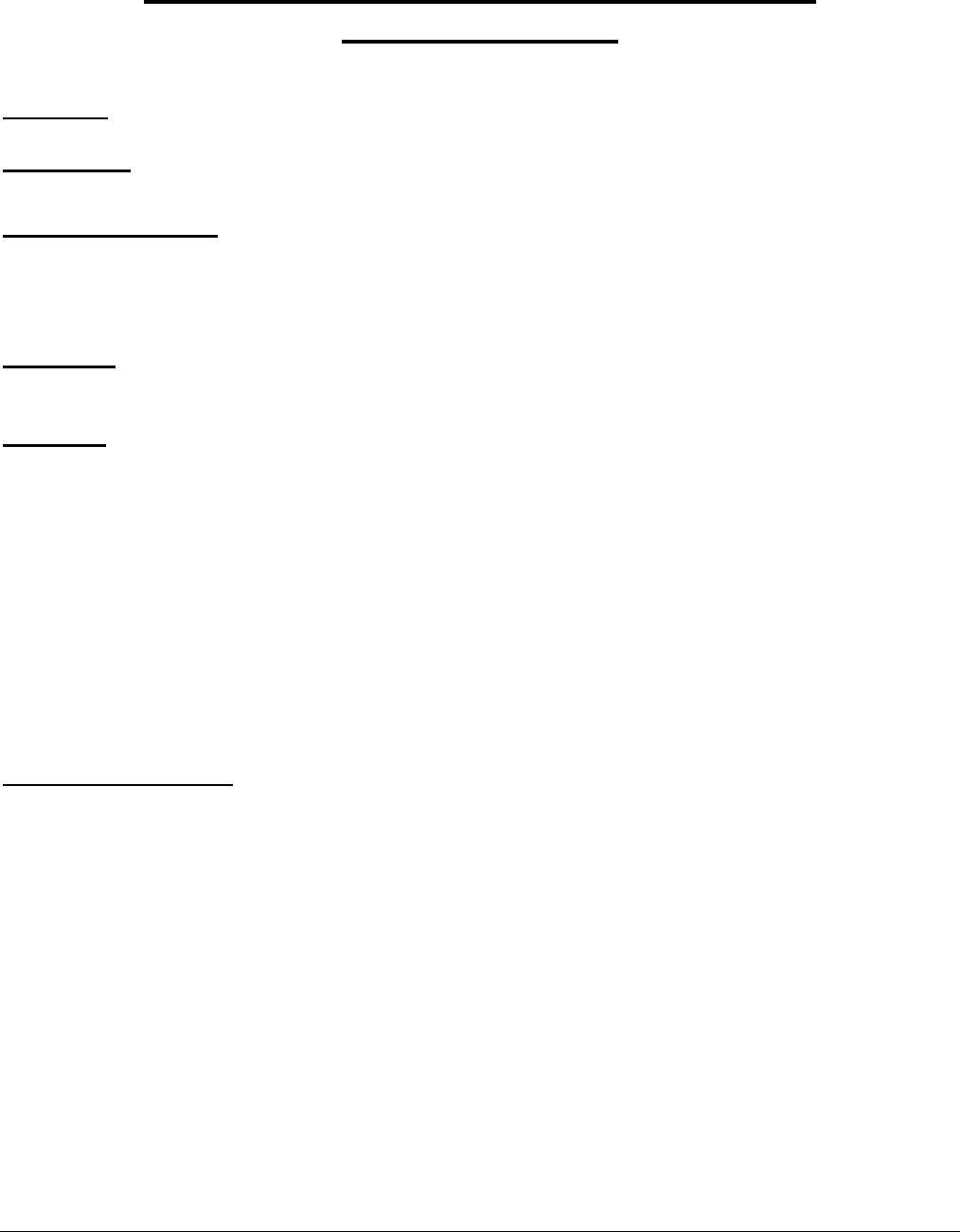
NM4
NUMBER OF MOTOR VEHICLE STRIKING
NON-MOTORIST
FORMAT: 3 numeric
SAS NAME: Person.STR_VEH
ELEMENT VALUES:
001-998 Assigned Vehicle Number
999 Unknown
Definition: This data element captures the in-transport vehicle that made contact with this
non-motorist.
Remarks:
This only applies to those non-motorists who are not occupants of a motor vehicle. If a non-
motorist is contacted by a parked or working motor vehicle that was propelled by an in-
transport vehicle, record the vehicle number of the in-transport vehicle.
In cases where more than one vehicle makes contact with a non-occupant, code the number of
the vehicle that caused the most significant injury. If uncertain, code the number of the vehicle
that made contact first.
999 (Unknown) is used when the investigating officer indicates that it is unknown which
vehicle struck the non-motorist.
Consistency Checks:
IF THEN
(050P)
(060P)
PERSON TYPE equals 04-08, 19, and
NUMBER OF VEHICLE FORMS
SUBMITTED equals 001,
NUMBER OF MOTOR VEHICLE
STRIKING NON-MOTORIST is not
equal to 000, 999,
NUMBER OF MOTOR VEHICLE
STRIKING NON-MOTORIST must equal
001.
the NUMBER OF MOTOR VEHICLE
STRIKING NON-MOTORIST must equal
some VEHICLE NUMBER in the case,
and the UNIT TYPE must equal 1.
2015 833

NM4
IF THEN
(A612) PERSON TYPE equals 04, and
NUMBER OF MOTOR VEHICLE
STRIKING NON-MOTORIST
equals___,
(A613) PERSON TYPE equals 05, and
NUMBER OF MOTOR VEHICLE
STRIKING NON-MOTORIST
equals___,
(A614) PERSON TYPE equals 06, and
NUMBER OF MOTOR VEHICLE
STRIKING NON-MOTORIST
equals___,
(A615) PERSON TYPE equals 07, and
NUMBER OF MOTOR VEHICLE
STRIKING NON-MOTORIST
equals___,
(A616) PERSON TYPE equals 08, and
NUMBER OF MOTOR VEHICLE
STRIKING NON-MOTORIST
equals___,
(A617) PERSON TYPE equals 10, and
NUMBER OF MOTOR VEHICLE
STRIKING NON-MOTORIST
equals___,
(A618) PERSON TYPE equals 19, and
NUMBER OF MOTOR VEHICLE
STRIKING NON-MOTORIST
equals___,
(A619) the total count of PERSON TYPES is
equal to 05 for the vehicle in
NUMBER OF MOTOR VEHICLE
STRIKING NON-MOTORIST is ____,
(A61A) the total count of PERSON TYPES is
equal to 08 for the vehicle in
NUMBER OF MOTOR VEHICLE
STRIKING NON-MOTORIST is ____,
(A61B) the total count of PERSON TYPES is
equal to 10 for the vehicle in
NUMBER OF MOTOR VEHICLE
STRIKING NON-MOTORIST is ____,
at least one SEQUENCE OF EVENTS
must equal 10 or 49 for that vehicle
number in the CRASH EVENTS table.
at least one SEQUENCE OF EVENTS
must equal 08 for that vehicle number
in the CRASH EVENTS table.
at least one SEQUENCE OF EVENTS
must equal 09 for that vehicle number
in the CRASH EVENTS table.
at least one SEQUENCE OF EVENTS
must equal 09 for that vehicle number
in the CRASH EVENTS table.
at least one SEQUENCE OF EVENTS
must equal 15 for that vehicle number
in the CRASH EVENTS table.
at least one SEQUENCE OF EVENTS
must equal 08 for that vehicle number
in the CRASH EVENTS table.
at least one SEQUENCE OF EVENTS
must equal 99 for that vehicle number
in the CRASH EVENTS table.
the number of events equal to 08 in
the CRASH EVENTS table should
equal ____ for that vehicle.
the number of events equal to 15 in
the CRASH EVENTS table should
equal ____ for that vehicle.
the number of events equal to 08 in
the CRASH EVENTS table should
equal ____ for that vehicle.
834 2015

NM4
IF THEN
(A61G) the FIRST HARMFUL EVENT equals
08, and PERSON TYPE equals 05, and
NON-MOTORIST LOCATION AT THE
TIME OF CRASH equals 21, 22, 24, 25,
28, and the NUMBER OF MOTOR
VEHICLE STRIKING NON-MOTORIST
is involved in the FIRST HARMFUL
EVENT,
(A61H) the FIRST HARMFUL EVENT equals
09, and PERSON TYPE equals 06, 07,
and NON-MOTORIST LOCATION AT
THE TIME OF CRASH equals 21, 22,
24, 25, 28, and the NUMBER OF
MOTOR VEHICLE STRIKING NON-
MOTORIST is involved in the FIRST
HARMFUL EVENT,
(A61J) the FIRST HARMFUL EVENT equals
15, and PERSON TYPE equals 08, and
NON-MOTORIST LOCATION AT THE
TIME OF CRASH equals 21, 22, 24, 25,
28 and the NUMBER OF MOTOR
VEHICLE STRIKING NON-MOTORIST
is involved in the FIRST HARMFUL
EVENT,
(A61K) the FIRST HARMFUL EVENT equals
49, and PERSON TYPE equals 04, and
NON-MOTORIST LOCATION AT THE
TIME OF CRASH equals 21, 22, 24, 25,
28, and the NUMBER OF MOTOR
VEHICLE STRIKING NON-MOTORIST
is involved in the first harmful event,
(PB30) PEDESTRIAN/BIKE TYPING -
PEDESTRIAN CRASH TYPE equals
220,
(PB31) PEDESTRIAN/BIKE TYPING -
BICYCLIST CRASH TYPE equals 147,
157 or 357,
CRASH TYPE should not equal 13 for
this vehicle.
CRASH TYPE should not equal 13 for
this vehicle.
CRASH TYPE should not equal 13 for
this vehicle.
CRASH TYPE should not equal 13 for
this vehicle.
at least one DRIVER PRESENCE must
equal 0 for the vehicle number identified
in this person’s NUMBER OF MOTOR
VEHICLE STRIKING NON-MOTORIST.
at least one DRIVER'S VISION
OBSCURED BY must equal 06 for the
vehicle number identified in this person’s
NUMBER OF MOTOR VEHICLE
STRIKING NON-MOTORIST.
2015 835

NM4
IF THEN
(PB32) PEDESTRIAN/BIKE TYPING -
PEDESTRIAN CRASH TYPE equals
742,
at least one DRIVER'S VISION
OBSCURED BY must not equal 00 or 95
for the vehicle number identified in this
person’s NUMBER OF MOTOR
VEHICLE STRIKING NON-MOTORIST.
(PB40) PEDESTRIAN/BIKE TYPING -
BICYCLIST CRASH TYPE equals 600,
at least one PRE-EVENT MOVEMENT
(PRIOR TO RECOGNITION OF
CRITICAL EVENT) must equal 08, 09,
or 13 for the vehicle number identified in
this person’s NUMBER OF MOTOR
VEHICLE STRIKING NON-MOTORIST.
(PB41) PEDESTRIAN/BIKE TYPING -
BICYCLIST CRASH TYPE equals 215,
PRE-EVENT MOVEMENT (PRIOR TO
RECOGNITION OF CRITICAL EVENT)
must equal 08 or 09 for the vehicle
number identified in this person’s
NUMBER OF MOTOR VEHICLE
STRIKING NON-MOTORIST.
(PB42) PEDESTRIAN/BIKE TYPING -
BICYCLIST CRASH TYPE equals 111,
211 or 212,
at least one PRE-EVENT MOVEMENT
(PRIOR TO RECOGNITION OF
CRITICAL EVENT) must equal 11 or 17
for the vehicle number identified in this
person’s NUMBER OF MOTOR
VEHICLE STRIKING NON-MOTORIST.
(PB43) If PEDESTRIAN/BIKE TYPING -
BICYCLIST CRASH TYPE equals 112,
151, 213, 214, 217 or 218,
PRE-EVENT MOVEMENT (PRIOR TO
RECOGNITION OF CRITICAL EVENT)
must equal 10 or 17 for the vehicle
number identified in this person’s
NUMBER OF MOTOR VEHICLE
STRIKING NON-MOTORIST.
(PB45) PEDESTRIAN/BIKE TYPING -
PEDESTRIAN CRASH TYPE equals
781 or 782,
PRE-EVENT MOVEMENT (PRIOR TO
RECOGNITION OF CRITICAL EVENT)
must equal 11 or 17 for the vehicle
number identified in this person’s
NUMBER OF MOTOR VEHICLE
STRIKING NON-MOTORIST.
(PB46) PEDESTRIAN/BIKE TYPING -
BICYCLIST CRASH TYPE equals 221-
225,
PRE-EVENT MOVEMENT (PRIOR TO
RECOGNITION OF CRITICAL EVENT)
should equal 01 for the vehicle number
identified in this person’s NUMBER OF
MOTOR VEHICLE STRIKING NON-
MOTORIST.
836 2015

NM4
IF THEN
(PB49) PERSON TYPE equals 05 or 08, and
PRE-EVENT MOVEMENT (PRIOR TO
RECOGNITION OF CRITICAL EVENT)
equals 13 for the vehicle number
identified in this person’s NUMBER OF
MOTOR VEHICLE STRIKING NON-
at least one PEDESTRIAN/BIKE
TYPING -PEDESTRIAN CRASH TYPE
should equal 211-214 or 219.
MOTORIST,
(PB50) PERSON TYPE equals 05 or 08, and
PRE-EVENT MOVEMENT (PRIOR TO
RECOGNITION OF CRITICAL EVENT)
equals 10-12 or 16 for the vehicle
number identified in this person’s
NUMBER OF MOTOR VEHICLE
at least one PEDESTRIAN/BIKE
TYPING -PEDESTRIAN CRASH TYPE
should equal 460, 465, 510, 781, 782,
791, 792, 794, 795 or 799.
STRIKING NON-MOTORIST,
(PB52) PERSON TYPE equals 06 or 07, and
PRE-EVENT MOVEMENT (PRIOR TO
RECOGNITION OF CRITICAL EVENT)
equals 13 for the vehicle number
identified in this person’s NUMBER OF
MOTOR VEHICLE STRIKING NON-
at least one PEDESTRIAN/BIKE
TYPING -BICYCLIST CRASH TYPE
should equal 610.
MOTORIST,
(PB56) PEDESTRIAN/BIKE TYPING -
PEDESTRIAN CRASH TYPE equals
791, 792, 794, 795,
PRE-EVENT MOVEMENT (PRIOR TO
RECOGNITION OF CRITICAL EVENT)
must equal 10 or 17 for the vehicle
number identified in this person’s
NUMBER OF MOTOR VEHICLE
STRIKING NON-MOTORIST.
(PBA0) PEDESTRIAN/ BIKE TYPING - CRASH
TYPE - BICYCLE equals 111, 211, 212,
and VEHICLE NUMBER - VEHICLE
LEVEL equals NUMBER OF MOTOR
VEHICLE STRIKING NON-MOTORIST,
PRE-EVENT MOVEMENT (PRIOR TO
RECOGNITION OF CRITICAL EVENT)
should equal 11.
(PBA1) PEDESTRIAN/ BIKE TYPING - CRASH
TYPE - BICYCLE equals 112, 151, 213,
214, 217 or 218, and VEHICLE
NUMBER - VEHICLE LEVEL equals
NUMBER OF MOTOR VEHICLE
PRE-EVENT MOVEMENT (PRIOR TO
RECOGNITION OF CRITICAL EVENT)
should equal 10.
STRIKING NON-MOTORIST,
2015 837
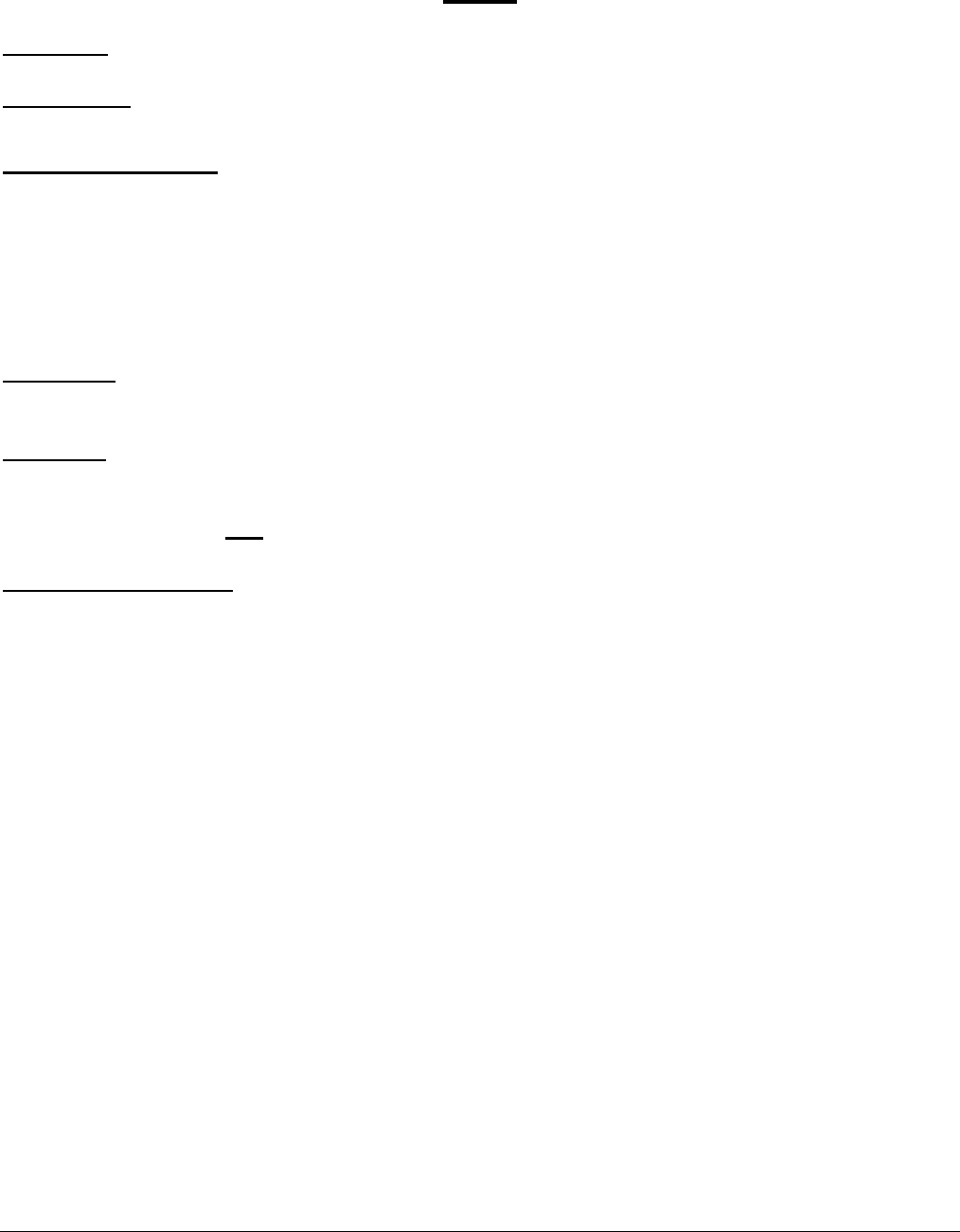
P5/NM5
AGE
FORMAT: 3 numeric
SAS NAME: Person.Age
ELEMENT VALUES:
Blank
000 Less than One Year
001-120 Actual Age*
998 Not Reported
999 Unknown
Definition: This element identifies the persons age, in years, with respect to the person's last
birthday.
Remarks:
This elements values and remarks are identical to Person Level (MV Occupant) Level element
P5. Please see page 725 for remarks.
Consistency Checks:
IF THEN
(5W0P) RELATED FACTORS-PERSON SEX must equal 2, and AGE must be
LEVEL equals 18, greater than 012.
(7P0F) PERSON TYPE equals 01, AGE must not be less than 002.
(8P1P) PERSON TYPE equals 01, and AGE BODY TYPE should equal 88, 91.
is less than 008,
(9L0F) PERSON TYPE equals 01, and SEX must equal 2, and AGE must be
RELATED FACTORS-DRIVER greater than 012.
LEVEL equals 12,
(D060) NON-CDL LICENSE STATUS equals AGE should not be less than 015.
1-4, 6, or COMMERCIAL MOTOR
VEHICLE LICENSE STATUS equals
1-8, and PERSON TYPE equals 01,
(D620) NON-CDL LICENSE TYPE equals 7, AGE (for the driver) should equal
014-016.
(D630) NON-CDL LICENSE TYPE equals 2, AGE (for the driver) should equal
015-017.
(D640) AGE equals 014-017, and PERSON NON-CDL LICENSE TYPE should
TYPE equals 01, equal 2, 7.
2015 839

P5/NM5
IF THEN
(D650) AGE equals 018-120, and PERSON NON-CDL LICENSE TYPE should
TYPE equals 01,and NON-CDL equal 1.
LICENSE STATUS does not equal 0,
(P010) PERSON TYPE equals 01 AGE should not be less than 012.
(P020) PERSON TYPE equals 02, 03, 09, AGE should be less than 010, or equal
and PROTECTION SYSTEM USE to 999.
equals 04, 10-12,
(P180) PERSON TYPE equals 01, and AGE BODY TYPE should not equal 90.
is less than 009,
(P1A0) AGE is less than 012, and INJURY FATAL INJURY AT WORK should
SEVERITY equals 4, equal 0.
(U120) UNLIKELY: AGE should not be greater than 094, unless equal to 998, 999.
(U360) UNLIKELY: HIT-AND-RUN equals 0 or 9, and AGE equals 999.
840 2015

P6/NM6
SEX
FORMAT: 1 numeric
SAS NAME: Person.Sex
ELEMENT VALUES:
1 Male
2 Female
8 Not Reported
9 Unknown
Definition: This element identifies the sex of the person involved in the crash.
Remarks:
This elements values and remarks are identical to Person Level (MV Occupant) Level element
P6. Please see page 729 for remarks.
Consistency Checks:
IF THEN
(5W0P)
(9L0F)
RELATED FACTORS-PERSON
LEVEL equals 18,
PERSON TYPE equals 01, and
RELATED FACTORS-DRIVER
LEVEL equals 12,
SEX must equal 2, and AGE must be
greater than 012.
SEX must equal 2, and AGE must be
greater than 012.
(U340) UNLIKELY: HIT-AND-RUN equals 0 or 9, and SEX equals 9.
2015 841

NM7
PERSON TYPE
FORMAT: 2 numeric
SAS NAME: Person.PER_TYP
ELEMENT VALUES:
04 Occupant of a Non-Motor Vehicle Transport Device
05 Pedestrian
06 Bicyclist
07 Other Cyclist
08 Person on Personal Conveyances
10 Persons In/On Buildings
19 Unknown Type of Non-Motorist
Definition: This element describes the role of this person involved in the crash.
Remarks:
04 (Occupant of a Non-Motor Vehicle Transport Device) refers to persons riding in an
animal-drawn conveyance, on an animal, or injured occupants of railway trains, etc.
05 (Pedestrian) is used for all pedestrians except for those in/on personal conveyances (See
08 (Persons on Personal Conveyances) below) and in buildings. A pedestrian pushing a
vehicle should be coded Pedestrian.
06 (Bicyclist) is used for a two-wheel, non-motorized cycle. Includes all persons (operator and
passengers) on a bicycle.
07 (Other Cyclist) is used for unicycles and tricycles.
08 (Person on Personal Conveyances): This attribute should be used for pedestrians using
personal conveyances. A personal conveyance is a device, other than a transport device,
used by a pedestrian for personal mobility assistance or recreation. These devices can be
motorized or human powered, but not propelled by pedaling.
Inclusions:
1) Rideable toys 2) Motorized rideable toys
— Roller Skates, In-Line — Motorized skateboard
skates — Motorized toy car
— Skateboards 3) Devices for personal mobility
— Skates assistance
— Baby carriage — Segway-style devices
— Scooters — Motorized and non-motorized
— Toy Wagons wheelchairs
2015 843

NM7
— Handicapped scooters — Minibike
Exclusions: — “Pocket” motorcycles
— Golf cart — Motor scooters
— Low Speed Vehicles (LSVs) — Moped
— Go-carts
Wheelchair: use the term, “wheelchair” as follows:
“Wheelchair - A mobility aid, usable indoors, and designed for and used by individuals with
mobility impairments, whether operated manually or powered.” Therefore all wheelchair users,
motorized or not, are 08 (Persons on Personal Conveyances).
RATIONALE:
Some states have passed legislation to classify operators of motorized wheelchairs as
“pedestrians” and others as “motor vehicles.” Also, there seems to be an increase in the
variety of forms these devices take (if not in the actual number in use). Some resemble 3-
wheeled scooters; others small four-wheel carts; still others look like the typical human-
powered wheelchair. They are in use by individuals who are unable to walk, who have limited
walking ability, or who need to avoid walking for reasons of health or stamina. Since these
devices simply supply a form of assisted “walking” for such persons, their legitimate users may
be seen as “other persons on personal conveyances” just as other non-motorists moving along
a sidewalk, walking with or against traffic on the edge of a road, crossing the roadway, or
turning into a driveway.
10 (Persons In/On Buildings) is used for a person inside of or on a building who is struck by
a motor vehicle. 10 (Persons In/On Buildings) takes precedence over attributes “05-08.”
19 (Unknown Type of Non-Motorist) is used only when it cannot be determined which
attribute is applicable for persons not in motor vehicles.
Consistency Checks:
IF THEN
(050P) PERSON TYPE equals 04-08, 19, NUMBER OF MOTOR VEHICLE
and NUMBER OF VEHICLE FORMS STRIKING NON-MOTORIST must equal
SUBMITTED equals 001, 001.
(1M1F) RELATED FACTORS-PERSON PERSON TYPE should equal 08.
LEVEL equals 13,
(1N0F) PERSON TYPE equals 06, RELATED FACTORS-PERSON LEVEL
(Not a MV Occupant) must not equal 09,
13, 69, 70, 86, 90.
(1N1F) PERSON TYPE equals 10, RELATED FACTORS-PERSON LEVEL
(Not a MV Occupant) must not equal 09,
21, 37, 40-42, 51, 52, 56, 57, 60-70,
72-78, 80-83, 90, 91.
844 2015

NM7
IF THEN
(1P2F) PERSON TYPE equals 10, NON-MOTORIST LOCATION AT TIME
OF CRASH must equal 25.
(1P3F) PERSON TYPE equals 10, NON-MOTORIST ACTION/CIRCUM-
STANCES must not equal 01-12, 16,
and NON-MOTORIST CONTRIBUTING
CIRCUMSTANCES must not equal
01-20.
(1P4F) PERSON TYPE equals 04, NON-MOTORIST ACTION/CIRCUM-
STANCES must not equal 04, 12.
(1P5F) PERSON TYPE equals 06-08, 19, NON-MOTORIST ACTION/CIRCUM-
STANCES must not equal 04.
(1P7F) PERSON TYPE equals 04, NON-MOTORIST ACTION/CIRCUM-
STANCES should not equal 10, 11.
(1P8F) PERSON TYPE equals 06, 07, NON-MOTORIST ACTION/CIRCUM-
STANCES should not equal 10-12.
(1P9F) PERSON TYPE equals 08, NON-MOTORIST ACTION/CIRCUM-
STANCES should not equal 11.
(1P0G) PERSON TYPE equals 05, NON-MOTORIST CONTRIBUTING
CIRCUMSTANCES must not equal 07,
08, 10, 13-18, 20.
(1P1G) PERSON TYPE equals 19, NON-MOTORIST ACTION/CIRCUM-
STANCES should not equal 11, 12.
(1P3G) PERSON TYPE equals 04, 06, 07, NON-MOTORIST CONTRIBUTING
CIRCUMSTANCES should not equal 04.
(1P4G) PERSON TYPE equals 04, 06-08, 19, NON-MOTORIST CONTRIBUTING
CIRCUMSTANCES should not equal 05.
(1P5G) PERSON TYPE equals 08, NON-MOTORIST CONTRIBUTING
CIRCUMSTANCES should not equal 20.
(1P6G) PERSON TYPE equals 04, 06-08, 19, CONDITION (IMPAIRMENT) AT TIME
OF CRASH must not equal 03.
(1P7G) PERSON TYPE equals 05-07, 19, CONDITION (IMPAIRMENT) AT TIME
OF CRASH should not equal 04.
(1P8G) PERSON TYPE equals 10, CONDITION (IMPAIRMENT) AT TIME
OF CRASH should not equal 01-10, 96.
(3P0F) PERSON TYPE equals 03-08, 10, 19, INJURY SEVERITY should not equal 6.
(550F) FIRST HARMFUL EVENT equals 08, at least one person must have PERSON
TYPE equal 05, 10.
(560F) FIRST HARMFUL EVENT equals 09, at least one person must have PERSON
TYPE equal to 06, 07.
(590F) FIRST HARMFUL EVENT equals 15, at least one Person Level form must
have a PERSON TYPE of 08.
(5Z0F) SEQUENCE OF EVENTS equals 08, at least one person must have PERSON
TYPE equal to 05, 10.
(6Z0F) SEQUENCE OF EVENTS equals 09, at least one person must have PERSON
TYPE equal to 06, 07.
2015 845

NM7
IF
(880F) RELATED FACTORS-CRASH LEVEL
equals 16,
(890F) RELATED FACTORS-CRASH LEVEL
equals 15,
(8M0F) PERSON TYPE equals 04,
(8Q0F) PERSON TYPE equals 08,
(8T0F) any NON-MOTORIST SAFETY
EQUIPMENT equals 2,
(8Z0F) any SEQUENCE OF EVENTS equals
15,
(9M0F) PERSON TYPE equals 05,
(9P0F) PERSON TYPE equals 04-08, 10, 19,
(A612) PERSON TYPE equals 04, and
NUMBER OF MOTOR VEHICLE
STRIKING NON-MOTORIST
equals___,
(A613) PERSON TYPE equals 05, and
NUMBER OF MOTOR VEHICLE
STRIKING NON-MOTORIST
equals___,
(A614) PERSON TYPE equals 06, and
NUMBER OF MOTOR VEHICLE
STRIKING NON-MOTORIST
equals___,
(A615) PERSON TYPE equals 07, and
NUMBER OF MOTOR VEHICLE
STRIKING NON-MOTORIST
equals___,
(A616) PERSON TYPE equals 08, and
NUMBER OF MOTOR VEHICLE
STRIKING NON-MOTORIST
equals___,
(A617) PERSON TYPE equals 10, and
NUMBER OF MOTOR VEHICLE
STRIKING NON-MOTORIST
equals___,
THEN
there must be a Person Level (Not a MV
Occupant) form with PERSON TYPE
equal to 04-08, 19.
there must be a Person Level (Not a MV
Occupant) form with PERSON TYPE
equal to 04-08, 10, 19.
RELATED FACTORS-PERSON LEVEL
(Not a MV Occupant) must not equal 13,
86, 90.
RELATED FACTORS-PERSON LEVEL
must not equal 09, 86, 90.
PERSON TYPE should equal 06-08.
at least one Person Level (Not a MV
Occupant) form must have a PERSON
TYPE code of 08.
RELATED FACTORS-PERSON LEVEL
(Not a MV Occupant) must not equal 13,
21, 26, 40, 42, 51, 52, 57, 68-70, 73-83,
88.
EXTRICATION must not equal 1, 9.
at least one SEQUENCE OF EVENTS
must equal 10 or 49 for that vehicle
number in the CRASH EVENTS table.
at least one SEQUENCE OF EVENTS
must equal 08 for that vehicle number
in the CRASH EVENTS table.
at least one SEQUENCE OF EVENTS
must equal 09 for that vehicle number
in the CRASH EVENTS table.
at least one SEQUENCE OF EVENTS
must equal 09 for that vehicle number
in the CRASH EVENTS table.
at least one SEQUENCE OF EVENTS
must equal 15 for that vehicle number
in the CRASH EVENTS table.
at least one SEQUENCE OF EVENTS
must equal 08 for that vehicle number
in the CRASH EVENTS table.
846 2015

NM7
IF
(A618) PERSON TYPE equals 19, and
NUMBER OF MOTOR VEHICLE
STRIKING NON-MOTORIST
equals___,
(A619) the total count of PERSON TYPES
is equal to 05 for the vehicle in
NUMBER OF MOTOR VEHICLE
STRIKING NON-MOTORIST is ____,
(A61A) the total count of PERSON TYPES
is equal to 08 for the vehicle in
NUMBER OF MOTOR VEHICLE
STRIKING NON-MOTORIST is ____,
(A61B) the total count of PERSON TYPES
is equal to 10 for the vehicle in
NUMBER OF MOTOR VEHICLE
STRIKING NON-MOTORIST is ____,
(A61G) the FIRST HARMFUL EVENT equals
08, and PERSON TYPE equals 05,
and NON-MOTORIST LOCATION AT
THE TIME OF CRASH equals 21, 22,
24, 25, 28, and the NUMBER OF
MOTOR VEHICLE STRIKING NON-
MOTORIST is involved in the first
harmful event,
(A61H) the FIRST HARMFUL EVENT equals
09, and PERSON TYPE equals 06,
07, and NON-MOTORIST LOCATION
AT THE TIME OF CRASH equals 21,
22, 24, 25, 28, and the NUMBER OF
MOTOR VEHICLE STRIKING NON-
MOTORIST is involved in the first
harmful event,
(A61J) the FIRST HARMFUL EVENT equals
15, and PERSON TYPE equals 08,
and NON-MOTORIST LOCATION AT
THE TIME OF CRASH equals 21, 22,
24, 25, 28, and the NUMBER OF
MOTOR VEHICLE STRIKING NON-
MOTORIST is involved in the first
harmful event,
THEN
at least one SEQUENCE OF EVENTS
must equal 99 for that vehicle number
in the CRASH EVENTS table.
the number of events equal to 08 in
the CRASH EVENTS table should
equal ____ for that vehicle.
the number of events equal to 15 in
the CRASH EVENTS table should
equal ____ for that vehicle.
the number of events equal to 08 in
the CRASH EVENTS table should
equal ____ for that vehicle.
CRASH TYPE should not equal 13 for
this vehicle.
CRASH TYPE should not equal 13 for
this vehicle.
CRASH TYPE should not equal 13 for
this vehicle.
2015 847

NM7
IF THEN
(A61K) the FIRST HARMFUL EVENT equals
49, and PERSON TYPE equals 04,
and NON-MOTORIST LOCATION AT
THE TIME OF CRASH equals 21, 22,
24, 25, 28, and the NUMBER OF
MOTOR VEHICLE STRIKING NON-
MOTORIST is involved in the first
harmful event,
(BF0F) PERSON TYPE equals 04-08, 10, 19,
(CK0P) PERSON TYPE equals 07,
(CM0P) PERSON TYPE equals 19,
CRASH TYPE should not equal 13 for
this vehicle.
EJECTION must equal 8.
RELATED FACTORS-PERSON LEVEL
(Not a MV Occupant) must not equal 09,
13, 69, 70, 86, 87, 90.
RELATED FACTORS-PERSON LEVEL
(Not a MV Occupant) must not equal 13,
69, 70, 90.
(FP0F) PERSON TYPE is blank, case status is flawed.
(FP9F) PERSON TYPE equals 05, 06, 07, 08 and the PEDESTRIAN/BIKE - CRASH
TYPE equals blank, case status is flawed.
(P071) PERSON TYPE equals 02, 04-08, 10, ALCOHOL TEST STATUS should not
and INJURY SEVERITY does not equal 9, ALCOHOL TEST TYPE should
equal 4, not equal 99, and ALCOHOL TEST
RESULT should not equal 999.
(P073) PERSON TYPE equals 02, 04-08, 10, DRUG TEST STATUS should not equal
and INJURY SEVERITY does not 9 and any DRUG TEST TYPE should
equal 4, not equal 9, and any DRUG TEST
RESULTS should not equal 999.
(P074) PERSON TYPE equals 02, 04-08, 10, ALCOHOL TEST STATUS must not
and INJURY SEVERITY does not equal 8, ALCOHOL TEST TYPE must
equal 4, not equal 95, and ALCOHOL TEST
RESULT must not equal 995.
(P075) PERSON TYPE equals 02, 04-08, 10
or 19, and INJURY SEVERITY does
DRUG TEST STATUS must not equal 8,
any DRUG TEST TYPE must not equal
not equal 4, 6, and any DRUG TEST RESULTS must
not equal 095.
(PB22) SCHOOL BUS RELATED equals 1, PEDESTRIAN/BIKE TYPING - CRASH
and PERSON TYPE equals 05 or 08, TYPE - PEDESTRIAN should equal 342.
(PB23) PEDESTRIAN/BIKE TYPING - SCHOOL BUS RELATED should equal
CRASH TYPE - PEDESTRIAN equals 1.
342, and PERSON TYPE equals 05
or 08,
(PB24) PERSON TYPE equals 05 or 08, and PEDESTRIAN/BIKE TYPING - CRASH
NON-MOTORIST LOCATION AT TYPE - PEDESTRIAN should equal 230,
TIME OF CRASH equals 14, 16, 20, 320, 410, 420, 430, 440, 459, 510, 520,
21, 22, 24 or 25, 590, 830 or 890.
848 2015

NM7
IF THEN
(PB25) PERSON TYPE equals 05 or 08, and
NON-MOTORIST CONTRIBUTING
CIRCUMSTANCES equals 01-03 or
09,
PEDESTRIAN/BIKE TYPING - CRASH
TYPE - PEDESTRIAN should equal 690,
710, 730, 741, 742, 760, 770, 781, 782,
791, 792, 794, 795 or 799.
(PB26) NON-MOTORIST CONTRIBUTING
CIRCUMSTANCES equals 02, and
PERSON TYPE equals 06 or 07,
PEDESTRIAN/BIKE TYPING - CRASH
TYPE - BICYCLIST should equal 142,
144, 147, 153, 155, 156, 157, 159, 311,
312, 313, 318, 319 or 357.
(PB27)
(PB28)
(PB29)
(PB36)
NON-MOTORIST ACTION/CIRCUM-
STANCES equals 05, and PERSON
TYPE equals 05 or 08,
NON-MOTORIST ACTION/CIRCUM-
STANCES equals 06, and PERSON
TYPE equals 05 or 08,
NON-MOTORIST ACTION/CIRCUM-
STANCES equals 04, and PERSON
TYPE equals 05 or 08,
PEDESTRIAN/BIKE TYPING -
CRASH TYPE - PEDESTRIAN equals
250,
PEDESTRIAN/BIKE TYPING - CRASH
TYPE - PEDESTRIAN should equal 410
or 420.
PEDESTRIAN/BIKE TYPING - CRASH
TYPE - PEDESTRIAN should equal 430
or 440.
PEDESTRIAN/BIKE TYPING - CRASH
TYPE - PEDESTRIAN should equal 410,
420, 430, 440 or 459.
PERSON TYPE must equal 08.
(PB49) PERSON TYPE equals 05 or 08, and
PRE-EVENT MOVEMENT (PRIOR
TO RECOGNITION OF CRITICAL
EVENT) equals 13 for the vehicle
number identified in this person’s
NUMBER OF MOTOR VEHICLE
at least one PEDESTRIAN/BIKE
TYPING - CRASH TYPE -
PEDESTRIAN should equal 211-214 or
219.
STRIKING NON-MOTORIST,
(PB50) PERSON TYPE equals 05 or 08, and
PRE-EVENT MOVEMENT (PRIOR
TO RECOGNITION OF CRITICAL
EVENT) equals 10-12 or 16 for the
vehicle number identified in this
at least one PEDESTRIAN/BIKE
TYPING - CRASH TYPE -
PEDESTRIAN should equal 460, 465,
510, 781, 782, 791, 792, 794, 795 or
799.
person’s NUMBER OF MOTOR
VEHICLE STRIKING NON-
MOTORIST.
(PB52) PERSON TYPE equals 06 or 07, and
PRE-EVENT MOVEMENT (PRIOR
TO RECOGNITION OF CRITICAL
EVENT) equals 13 for the vehicle
number identified in this person’s
NUMBER OF MOTOR VEHICLE
at least one PEDESTRIAN/BIKE
TYPING - CRASH TYPE - BICYCLIST
should equal 610.
STRIKING NON-MOTORIST,
(PB59) NON-MOTORIST ACTION/CIRCUM-
STANCES equals 16, and PERSON
TYPE equals 05 or 08,
PEDESTRIAN/BIKE TYPING - CRASH
TYPE - PEDESTRIAN should equal 459.
2015 849

NM7
IF THEN
(PB60) PERSON TYPE equals 05 or 08, and
DRIVER PRESENCE equals 0 for the
motor vehicle which strikes the non-
motorist,
PEDESTRIAN/BIKE TYPING - CRASH
TYPE - PEDESTRIAN should equal 220.
850 2015

P8/NM8
INJURY SEVERITY
FORMAT: 1 numeric
SAS NAME: Person.Inj_Sev
ELEMENT VALUES:
0 No Apparent Injury (O)
1 Possible Injury (C)
2 Suspected Minor Injury (B)
3 Suspected Serious Injury (A)
4 Fatal Injury (K)
5 Injured, Severity Unknown
6 Died Prior to Crash*
9 Unknown
Definition: This element describes the severity of the injury to this person in the crash.
Remarks:
This elements values and remarks are identical to Person Level (MV Occupant) Level element
P8. Please see page 733 for remarks.
Consistency Checks:
IF THEN
(1R0P) SEATING POSITION equals 51, and INJURY SEVERITY must not equal 0, 9.
BODY TYPE equals 50-52, 55, 58,
59,
(1R1P) If DIED AT SCENE/EN ROUTE INJURY SEVERITY must equal 4.
equals 7, 8,
(1U1F) INJURY SEVERITY equals 4, DEATH DATE must not equal
88888888.
(1U2F) INJURY SEVERITY equals 4, DEATH TIME must not equal 8888.
(2U1F) INJURY SEVERITY is not equal to 4, DEATH DATE must equal 88888888.
(2U2F) INJURY SEVERITY is not equal to 4, DEATH TIME must equal 8888.
(2U3F) INJURY SEVERITY equals 3, TRANSPORTED TO FIRST MEDICAL
FACILITY BY should not equal 0.
(3P0F) PERSON TYPE equals 03-08, 10, 19, INJURY SEVERITY should not equal 6.
(4U0F) Each original submission must have at least one Person Level form with INJURY
SEVERITY coded 4.
2015 851

P8/NM8
IF
(4V1F) INJURY SEVERITY equals 4,
(7E0P) INJURY SEVERITY equals 4,
(7E1P) INJURY SEVERITY equals 4,
(7E2P) INJURY SEVERITY equals 4,
(7E3P) INJURY SEVERITY does not equal 4,
(7F0P) DEATH CERTIFICATE NUMBER is
not blank or 0000-00-000000,
(7F1P) RACE equals 00,
(7F2P) HISPANIC ORIGIN equals 00,
(7F3P) RACE is not equal to 00, and
HISPANIC ORIGIN is not equal to 00,
(7R0P) FATAL INJURY AT WORK equals 0,
1, 9,
(7W0P) FATAL INJURY AT WORK equals 8
THEN
DEATH DATE and DEATH TIME for this
person must be within 720 hours of the
CRASH DATE and CRASH TIME.
DEATH CERTIFICATE NUMBER must
NOT equal 0000-00-000000.
RACE must not equal 00.
HISPANIC ORIGIN must not equal 00.
RACE AND HISPANIC ORIGIN must
equal 00.
INJURY SEVERITY must equal 4.
INJURY SEVERITY must not equal 4.
INJURY SEVERITY must not equal 4.
INJURY SEVERITY must equal 4.
INJURY SEVERITY must equal 4.
INJURY SEVERITY must not equal 4.
(FP8F) INJURY SEVERITY is blank, case status is flawed.
(P071) PERSON TYPE equals 02, 04-08, 10, ALCOHOL TEST STATUS should not
and INJURY SEVERITY does not equal 9, ALCOHOL TEST TYPE should
equal 4, not equal 99, and ALCOHOL TEST
RESULT should not equal 999.
(P072) PERSON TYPE equals 02, 03, and POLICE REPORTED ALCOHOL
INJURY SEVERITY equals 0, and INVOLVEMENT should equal 0, 8.
ALCOHOL TEST RESULT equals
996,
(P073) PERSON TYPE equals 02, 04-08, 10, DRUG TEST STATUS should not equal
and INJURY SEVERITY does not 9 and any DRUG TEST TYPE should
equal 4, not equal 9, and any DRUG TEST
RESULTS should not equal 999.
(P1A0) AGE is less than 012, and INJURY FATAL INJURY AT WORK should equal
SEVERITY equals 4, 0.
(P090) INJURY SEVERITY equals 0, TRANSPORTED TO FIRST MEDICAL
FACILITY BY must equal 0.
(P130) BODY TYPE equals 60-67, 71, 72, FATAL INJURY AT WORK should equal
78, 79, and PERSON TYPE equals 1.
01, 03, and INJURY SEVERITY
equals 4,
(P300) POLICE REPORTED ALCOHOL ALCOHOL TEST STATUS should not
INVOLVEMENT equals 1, and equal 0, 1.
INJURY SEVERITY equals 4,
(P53P) INJURY SEVERITY equals 0-3, 5, 6, DIED AT SCENE/EN ROUTE must
equal 0.
852 2015

P8/NM8
IF THEN
(U160) UNLIKELY: INJURY SEVERITY equals 6.
(U350) UNLIKELY: INJURY SEVERITY equals 1-6, and SEATING POSITION equals
98.
Consistency Check (GES Only):
IF THEN
(5A4P) FINAL STRATUM equals 1, there should exist:
1) at least one vehicle where BODY
TYPE equals 01-49, and UNIT TYPE
equals 1, and VEHICLE REMOVAL
equals 2, and INJURY SEVERITY
equals 4 for at least one occupant of that
vehicle; or
(5A5P)
(5A6P)
FINAL STRATUM equals 5,
FINAL STRATUM equals 2,
2) one and only one vehicle where
BODY TYPE equals 01-49, and UNIT
TYPE equals 1, and VEHICLE
REMOVAL equals 2, and INJURY
SEVERITY equals 3 for at least one
occupant of that vehicle; or
3) 2 or more vehicles where BODY
TYPE equals 01-49, and UNIT TYPE
equals 1, and at least 2 vehicles where
BODY TYPE equals 01-49, and UNIT
TYPE equals 1, and VEHICLE
REMOVAL equals 2, and INJURY
SEVERITY equals 3 for at least one
occupant of a vehicle where BODY
TYPE equals 01-49, and UNIT TYPE
equals 1, and VEHICLE REMOVAL
equals 2.
there should exist at least one vehicle
where BODY TYPE equals 01-49, and
UNIT TYPE equals 1, and VEHICLE
REMOVAL equals 2, and INJURY
SEVERITY equals 1, 2, 3 or 5 for at
least one occupant of that vehicle.
there 1) should exist at least one vehicle
where UNIT TYPE equals 1, and
VEHICLE REMOVAL equals 2; or 2)
INJURY SEVERITY should equal
1-5 for at least one person in the crash.
2015 853

P8/NM8
IF THEN
(5A7P)
(5A8P)
(5A9P)
FINAL STRATUM equals 3,
FINAL STRATUM equals 4,
FINAL STRATUM equals 4, and
INJURY SEVERITY equals 1,
INJURY SEVERITY must equal 2-4 for
at least one person in the crash.
INJURY SEVERITY must not equal 2-4
for any person in the crash.
there should exist no vehicles where
BODY TYPE equals 60-79, and UNIT
TYPE equals 1.
Consistency Check (FARS Only):
IF THEN
(4U0F) Each original submission must have at least one Person Level form with INJURY
SEVERITY coded 4.
854 2015

NM9
PEDESTRIAN/BIKE TYPING
FORMAT: Elements Completed in MDE
SAS NAME: Various
Definition: This element describes, through a series of on-screen prompts, the sequence of
events and precipitating actions leading to crashes between motor vehicles and pedestrians or
bicyclists.
Remarks:
Pedestrian and Bicycle Crash Type describes the pre-crash actions of the involved parties to
better define the sequence of events and precipitating actions leading to crashes between
motor vehicles and pedestrians or bicyclists.
During the 1970s, the National Highway Traffic Safety Administration developed
methodologies for typing pedestrian and bicycle crashes. In the 1990s, the methodologies
were applied to more than 8,000 pedestrian and bicycle crashes in six States. The results
provided a representative summary of the distribution of crash types experienced by
pedestrians and bicyclists and, over time, this method has evolved and was refined.
Pedestrian/Bike typing is offered as a tool to help overcome hindrances to the development of
effective countermeasures to prevent bicyclist and pedestrian crashes
In FARS and GES, Pedestrian and Bicycle Crash Typing is accomplished through a software
application so that by simply following on-screen prompts and clicking on choices, the
analyst/coder successfully enters data into the file without actually doing any coding.
Since data input is software driven, elements, attributes and remarks are not presented here in
the printed manual. The data entry system automatically presents the application at the
appropriate time when a non-motorist with an appropriate person type is entered.
The Pedestrian/Bike Typing application is presented for the following person types:
Pedestrian,
Persons on Personal Conveyances,
Bicyclist,
Other Cyclist.
2015 855

NM9
Consistency Checks:
IF THEN
(1PK2) NON-MOTORIST LOCATION AT SIDEWALK PRESENT must equal 1.
TIME OF CRASH equals 21,
(1PK3) NON-MOTORIST LOCATION AT MARKED CROSSWALK PRESENT must
TIME OF CRASH equals 01 or 10, equal 1.
(FP9F) PERSON TYPE equals 05, 06, 07, 08 and the PEDESTRIAN/ CRASH TYPE
(PB00)
equals blank, case status is flawed.
PEDESTRIAN/BIKE TYPING -
CRASH TYPE - PEDESTRIAN equals
110-910,
at least one SEQUENCE OF EVENTS
for the striking vehicle must equal 08 or
15.
(PB02) PEDESTRIAN/BIKE TYPING -
CRASH TYPE - BICYCLIST equals
111-980,
at least one SEQUENCE OF EVENTS
for the striking vehicle must equal 09.
(PB04) PEDESTRIAN/BIKE TYPING -
CRASH TYPE - PEDESTRIAN for a
person involved in the first harmful
event equals 211, 212, 461, 465, 680,
830, 890, 900 or 910,
RELATION TO JUNCTION (b) must not
equal 02. Note: this edit is restricted to
vehicles which are involved in only one
event with pedestrian(s).
(PB05)
(PB06)
PEDESTRIAN/BIKE TYPING -
CRASH TYPE - PEDESTRIAN for a
person involved in the first harmful
event equals 311, 312 or 313,
PEDESTRIAN/BIKE TYPING -
CRASH TYPE - PEDESTRIAN equals
730,
RELATION TO TRAFFICWAY must
equal 01 or 11. Note: this edit is
restricted to vehicles which are involved
in only one event with pedestrian(s).
TRAFFIC CONTROL DEVICE for the
striking vehicle must equal 01-03.
(PB07) PEDESTRIAN/BIKE TYPING -
CRASH TYPE - BICYCLE for a
person involved in the first harmful
event equals 311, 312, 313, 321, 322
or 323,
RELATION TO JUNCTION (b) must
equal 04 or 08. Note: this edit is
restricted to vehicles which are involved
in only one event with bicyclist(s)
(PB08) PEDESTRIAN/BIKE TYPING -
CRASH TYPE - BICYCLIST for a
person involved in the first harmful
event equals 141-144, 147, 151-157
or 159,
RELATION TO JUNCTION (b) must
equal 02 or 03. Note: this edit is
restricted to vehicles which are involved
in only one event with bicyclist(s).
(PB09) PEDESTRIAN/BIKE TYPING -
CRASH TYPE - BICYCLIST equals
141, 143, 151-158, 217 or 218,
TRAFFIC CONTROL DEVICE for the
striking vehicle must not equal 00.
(PB10) PEDESTRIAN/BIKE TYPING -
CRASH TYPE - BICYCLIST equals
151, 156, 157, 217 or 218,
TRAFFIC CONTROL DEVICE for the
striking vehicle must equal 01-04.
856 2015

NM9
IF THEN
(PB11)
(PB12)
(PB15)
(PB16)
(PB17)
(PB18)
(PB19)
(PB20)
(PB21)
(PB22)
(PB23)
(PB24)
PEDESTRIAN/BIKE TYPING -
CRASH TYPE - BICYCLIST equals
143 or 154,
PEDESTRIAN/BIKE TYPING -
CRASH TYPE - PEDESTRIAN for a
person involved in the first harmful
event equals 510, 520 or 590,
PEDESTRIAN/BIKE TYPING -
CRASH TYPE - PEDESTRIAN equals
910,
PEDESTRIAN/BIKE TYPING -
CRASH TYPE - BICYCLIST equals
142, 144, 147, 153, 155, 156, 157,
159, 311, 312, 313, 318, 319 or 357,
PEDESTRIAN/BIKE TYPING -
CRASH TYPE - PEDESTRIAN for a
person involved in the first harmful
event equals 211-214 or 219,
PEDESTRIAN/BIKE TYPING -
CRASH TYPE - PEDESTRIAN equals
742,
NON-MOTORIST ACTION/CIRCUM-
STANCES equals 08,
PEDESTRIAN/BIKE TYPING -
CRASH TYPE - PEDESTRIAN equals
510, 520 or 590,
PEDESTRIAN/BIKE TYPING -
CRASH TYPE - BICYCLIST equals
160,
SCHOOL BUS RELATED equals 1,
and PERSON TYPE equals 05 or 08,
PEDESTRIAN/BIKE TYPING -
CRASH TYPE - PEDESTRIAN equals
342, and PERSON TYPE equals 05
or 08,
PERSON TYPE equals 05 or 08, and
NON-MOTORIST LOCATION AT
TIME OF CRASH equals 14, 16, 20,
21, 22, 24 or 25,
TRAFFIC CONTROL DEVICE for the
striking vehicle must equal 01-04,08, 20,
21, 28 or 29.
RELATION TO TRAFFICWAY must not
equal 01 or 11. Note: this edit is
restricted to vehicles which are involved
in only one event with pedestrian(s).
NON-MOTORIST ACTION/CIRCUM-
STANCES must equal 03.
at least one NON-MOTORIST
CONTRIBUTING CIRCUMSTANCES
must equal 02.
PRE-EVENT MOVEMENT (PRIOR TO
RECOGNITION OF CRITICAL EVENT)
must equal 08, 09, 13 or 97. Note: this
edit is restricted to vehicles which are
involved in only one event with
pedestrian(s).
at least one NON-MOTORIST
CONTRIBUTING CIRCUMSTANCES
must equal 01.
PEDESTRIAN/BIKE TYPING - CRASH
TYPE - PEDESTRIAN must not equal
510, 520, 590, 830 or 890.
at least one NON-MOTORIST ACTION/
CIRCUMSTANCES must equal 02.
TRAFFIC CONTROL DEVICE for the
striking vehicle should equal 00.
PEDESTRIAN/BIKE TYPING - CRASH
TYPE - PEDESTRIAN should equal 342.
SCHOOL BUS RELATED should equal
1.
PEDESTRIAN/BIKE TYPING - CRASH
TYPE - PEDESTRIAN should equal 230,
320, 410, 420, 430, 440, 459, 510, 520,
590, 830 or 890.
2015 857

NM9
IF THEN
(PB25) PERSON TYPE equals 05 or 08, and
NON-MOTORIST LOCATION AT
TIME OF CRASH equals 01-03 or 09,
PEDESTRIAN/BIKE TYPING - CRASH
TYPE - PEDESTRIAN should equal 690,
710, 730, 741, 742, 760, 770, 781, 782,
791, 792, 794, 795 or 799.
(PB26) NON-MOTORIST CONTRIBUTING
CIRCUMSTANCES equals 02, and
PERSON TYPE equals 06 or 07,
PEDESTRIAN/BIKE TYPING - CRASH
TYPE - BICYCLIST should equal 142,
144, 147, 153, 155, 156, 157, 159, 311,
312, 313, 318, 319 or 357.
(PB27)
(PB28)
(PB29)
(PB30)
NON-MOTORIST ACTION/CIRCUM-
STANCES equals 05, and PERSON
TYPE equals 05 or 08,
NON-MOTORIST ACTION/CIRCUM-
STANCES equals 06, and PERSON
TYPE equals 05 or 08,
NON-MOTORIST ACTION/CIRCUM-
STANCES equals 04, and PERSON
TYPE equals 05 or 08,
PEDESTRIAN/BIKE TYPING -
CRASH TYPE - PEDESTRIAN equals
220,
PEDESTRIAN/BIKE TYPING - CRASH
TYPE - PEDESTRIAN should equal 410
or 420.
PEDESTRIAN/BIKE TYPING - CRASH
TYPE - PEDESTRIAN should equal 430
or 440.
PEDESTRIAN/BIKE TYPING - CRASH
TYPE - PEDESTRIAN should equal 410,
420, 430, 440 or 459.
at least one DRIVER PRESENCE must
equal 0 for the vehicle number identified
in this person’s NUMBER OF MOTOR
VEHICLE STRIKING NON-MOTORIST.
(PB31) PEDESTRIAN/BIKE TYPING -
CRASH TYPE - BICYCLIST equals
147, 157 or 357,
at least one DRIVER'S VISION
OBSCURED BY must equal 06 for the
vehicle number identified in this person’s
NUMBER OF MOTOR VEHICLE
STRIKING NON-MOTORIST.
(PB32) PEDESTRIAN/BIKE TYPING -
CRASH TYPE - PEDESTRIAN equals
742,
at least one DRIVER'S VISION
OBSCURED BY must not equal 00 or 95
for the vehicle number identified in this
person’s NUMBER OF MOTOR
VEHICLE STRIKING NON-MOTORIST.
(PB33) PEDESTRIAN/BIKE TYPING -
CRASH TYPE - BICYCLIST equals
156,
DRIVER'S VISION OBSCURED BY for
the striking vehicle must not equal 06.
(PB34) NUMBER OF FORMS SUBMITTED
FOR PERSONS NOT IN MOTOR
VEHICLES equals 01, and FIRST
HARMFUL EVENT equals 08, and
RELATION TO JUNCTION (b) equals
02,
PEDESTRIAN/ BIKE TYPING - CRASH
TYPE - PEDESTRIAN must not equal
320, 330, 360, 680, 830, 890, 900, or
910.
858 2015

NM9
IF THEN
(PB35) NUMBER OF FORMS SUBMITTED
FOR PERSONS NOT IN MOTOR
VEHICLES equals 01, and FIRST
HARMFUL EVENT equals 08, and
RELATION TO JUNCTION (b) equals
02,
PEDESTRIAN/ BIKE TYPING - CRASH
LOCATION - PEDESTRIAN must equal
1.
(PB36) PEDESTRIAN/BIKE TYPING -
CRASH TYPE - PEDESTRIAN equals
250,
PERSON TYPE must equal 08.
(PB37) PEDESTRIAN/BIKE TYPING -
CRASH TYPE - PEDESTRIAN equals
311, 312 or 313,
at least one NON-MOTORIST ACTION/
CIRCUMSTANCES must equal 08 or 10.
(PB38) PEDESTRIAN/BIKE TYPING -
CRASH TYPE - PEDESTRIAN equals
410 or 420, and PEDESTRIAN/BIKE
TYPING - PEDESTRIAN POSITION
at least one NON-MOTORIST
ACTION/CIRCUMSTANCES must equal
05.
(PB39)
does not equal 5,
PEDESTRIAN/BIKE TYPING -
CRASH TYPE - PEDESTRIAN equals
430 or 440, and PEDESTRIAN/BIKE
TYPING - PEDESTRIAN POSITION
at least one NON-MOTORIST
ACTION/CIRCUMSTANCES must equal
06.
(PB40)
does not equal 5,
PEDESTRIAN/BIKE TYPING -
CRASH TYPE - BICYCLE equals
610,
at least one PRE-EVENT MOVEMENT
(PRIOR TO RECOGNITION OF
CRITICAL EVENT) must equal 08, 09 or
13 for the vehicle number identified in
this person’s NUMBER OF MOTOR
VEHICLE STRIKING NON-MOTORIST.
(PB41) PEDESTRIAN/BIKE TYPING -
CRASH TYPE - BICYCLIST equals
215,
PRE-EVENT MOVEMENT (PRIOR TO
RECOGNITION OF CRITICAL EVENT)
must equal 08 or 09 for the vehicle
number identified in this person’s
NUMBER OF MOTOR VEHICLE
STRIKING NON-MOTORIST.
(PB42) PEDESTRIAN/BIKE TYPING -
CRASH TYPE - BICYCLIST equals
111, 211 or 212,
at least one PRE-EVENT MOVEMENT
(PRIOR TO RECOGNITION OF
CRITICAL EVENT) must equal 11 or 17
for the vehicle number identified in this
person’s NUMBER OF MOTOR
VEHICLE STRIKING NON-MOTORIST.
2015 859

NM9
IF THEN
(PB43) PEDESTRIAN/BIKE TYPING -
CRASH TYPE - BICYCLIST equals
112, 151, 213, 214, 217 or 218,
PRE-EVENT MOVEMENT (PRIOR TO
RECOGNITION OF CRITICAL EVENT)
must equal 10 or 17 for the vehicle
number identified in this person’s
NUMBER OF MOTOR VEHICLE
STRIKING NON-MOTORIST.
(PB44) PEDESTRIAN/BIKE TYPING -
CRASH TYPE - PEDESTRIAN equals
240,
EMERGENCY MOTOR VEHICLE USE
should equal 2-6 at least one.
(PB45) PEDESTRIAN/BIKE TYPING -
CRASH TYPE - PEDESTRIAN equals
781 or 782,
PRE-EVENT MOVEMENT (PRIOR TO
RECOGNITION OF CRITICAL EVENT)
must equal 11 or 17 for the vehicle
number identified in this person’s
NUMBER OF MOTOR VEHICLE
STRIKING NON-MOTORIST.
(PB46) PEDESTRIAN/BIKE TYPING -
CRASH TYPE - BICYCLIST equals
221-225,
PRE-EVENT MOVEMENT (PRIOR TO
RECOGNITION OF CRITICAL EVENT)
should equal 01 for the vehicle number
identified in this person’s NUMBER OF
MOTOR VEHICLE STRIKING NON-
MOTORIST.
(PB49) PERSON TYPE equals 05 or 08, and
PRE-EVENT MOVEMENT (PRIOR
TO RECOGNITION OF CRITICAL
EVENT) equals 13 for the vehicle
number identified in this person’s
NUMBER OF MOTOR VEHICLE
at least one PEDESTRIAN/BIKE TYPING
- CRASH TYPE - PEDESTRIAN should
equal 211-214 or 219.
STRIKING NON-MOTORIST,
(PB50) PERSON TYPE equals 05 or 08, and
PRE-EVENT MOVEMENT (PRIOR
TO RECOGNITION OF CRITICAL
EVENT) equals 10-12 or 16 for the
vehicle number identified in this
at least one PEDESTRIAN/BIKE TYPING
- CRASH TYPE - PEDESTRIAN should
equal 460, 465, 510, 781, 782, 791, 792,
794, 795 or 799.
person’s NUMBER OF MOTOR
VEHICLE STRIKING NON-
MOTORIST,
(PB52) PERSON TYPE equals 06 or 07, and
PRE-EVENT MOVEMENT (PRIOR
TO RECOGNITION OF CRITICAL
EVENT) equals 13 for the vehicle
number identified in this person’s
NUMBER OF MOTOR VEHICLE
at least one PEDESTRIAN/BIKE TYPING
- CRASH TYPE - BICYCLIST should
equal 610.
STRIKING NON-MOTORIST,
860 2015

NM9
IF THEN
(PB56)
(PB59)
(PB60)
(PB61)
(PB62)
(PB63)
(PB66)
(PB67)
(PB68)
(PB69)
(PB70)
(PB71)
(PB72)
PEDESTRIAN/BIKE TYPING -
CRASH TYPE - BICYCLIST equals
791, 792, 794, 795,
NON-MOTORIST ACTION/CIRCUM-
STANCES equals 16, and PERSON
TYPE equals 05 or 08,
PERSON TYPE equals 05 or 08, and
DRIVER PRESENCE equals 0 for the
motor vehicle which strikes the non-
motorist,
PEDESTRIAN/BIKE TYPING -
CRASH TYPE - PEDESTRIAN equals
220,
PEDESTRIAN/BIKE TYPING -
CRASH TYPE - PEDESTRIAN equals
220,
PEDESTRIAN/BIKE TYPING -
CRASH TYPE - PEDESTRIAN equals
230,
PEDESTRIAN/ BIKE TYPING -
CRASH LOCATION - PEDESTRIAN
equals 1,
PEDESTRIAN/ BIKE TYPING -
CRASH LOCATION - PEDESTRIAN
equals 2,
PEDESTRIAN/ BIKE TYPING -
CRASH LOCATION - PEDESTRIAN
equals 3,
PEDESTRIAN/ BIKE TYPING -
CRASH LOCATION - PEDESTRIAN
equals 4,
PEDESTRIAN/ BIKE TYPING -
CRASH LOCATION - PEDESTRIAN
equals 9,
PEDESTRIAN/ BIKE TYPING -
CRASH LOCATION - BICYLE equals
1,
PEDESTRIAN/ BIKE TYPING -
CRASH LOCATION - BICYLE equals
2,
PRE-EVENT MOVEMENT (PRIOR TO
RECOGNITION OF CRITICAL EVENT)
must equal 10 or 17 for the vehicle
number identified in this person’s
NUMBER OF MOTOR VEHICLE
STRIKING NON-MOTORIST.
PEDESTRIAN/BIKE TYPING - CRASH
TYPE - PEDESTRIAN should equal 459.
PEDESTRIAN/BIKE TYPING - CRASH
TYPE - PEDESTRIAN should equal 220.
DRIVER PRESENCE should equal 0 for
the motor vehicle striking the non-
motorist.
at least one NON-MOTORIST ACTION/
CIRCUMSTANCES PRIOR TO CRASH
must equal 12.
at least one RELATED FACTORS -
CRASH LEVEL should equal 19 or 23.
NON-MOTORIST LOCATION AT TIME
OF CRASH must equal 01, 02, 03, 09, 16
or 22.
NON-MOTORIST LOCATION AT TIME
OF CRASH must equal 10, 11, 13, 14,
16, 20-25, 28, 98, 99.
NON-MOTORIST LOCATION AT TIME
OF CRASH must equal 10, 11, 13, 14,
16, 20-24, 28, 98, 99.
NON-MOTORIST LOCATION AT TIME
OF CRASH must equal 24, 25, 98, 99.
NON-MOTORIST LOCATION AT TIME
OF CRASH must equal 16, 22, 24, 98 or
99.
NON-MOTORIST LOCATION AT TIME
OF CRASH must equal 01, 02, 03, 09, 16
or 22.
NON-MOTORIST LOCATION AT TIME
OF CRASH must equal 10, 11, 13, 14,
16, 20, 21, 22, 23, 24, 25, 28, 98, 99.
2015 861

NM9
(PB73)
(PB74)
(PB75)
(PB76)
(PB77)
(PB78)
(PB79)
(PB80)
(PB81)
(PB82)
(PB83)
(PB84)
(PB85)
(PB86)
(PB87)
(PB88)
IF
PEDESTRIAN/ BIKE TYPING -
CRASH LOCATION - BICYLE equals
3,
PEDESTRIAN/ BIKE TYPING -
CRASH LOCATION - BICYLE equals
4,
PEDESTRIAN/ BIKE TYPING -
CRASH LOCATION - BICYLE equals
9,
PEDESTRIAN/ BIKE TYPING -
PEDESTRIAN POSITION equals 01,
PEDESTRIAN/ BIKE TYPING -
PEDESTRIAN POSITION equals 02,
PEDESTRIAN/ BIKE TYPING -
PEDESTRIAN POSITION equals 03,
PEDESTRIAN/ BIKE TYPING -
PEDESTRIAN POSITION equals 04,
PEDESTRIAN/ BIKE TYPING -
PEDESTRIAN POSITION equals 05,
PEDESTRIAN/ BIKE TYPING -
PEDESTRIAN POSITION equals 06,
PEDESTRIAN/ BIKE TYPING -
PEDESTRIAN POSITION equals 07
or 08,
PEDESTRIAN/ BIKE TYPING -
PEDESTRIAN POSITION equals 09,
PEDESTRIAN/ BIKE TYPING -
BICYCLIST POSITION equals 1,
PEDESTRIAN/ BIKE TYPING -
BICYCLIST POSITION equals 2,
PEDESTRIAN/ BIKE TYPING -
BICYCLIST POSITION equals 3,
PEDESTRIAN/ BIKE TYPING -
BICYCLIST POSITION equals 4,
PEDESTRIAN/ BIKE TYPING -
BICYCLIST POSITION equals 5 or 6,
THEN
NON-MOTORIST LOCATION AT TIME
OF CRASH must equal 10, 11, 13, 14,
16, 20, 21, 22, 23, 24, 28, 98, 99.
NON-MOTORIST LOCATION AT TIME
OF CRASH must equal 24, 25, 98, 99.
NON-MOTORIST LOCATION AT TIME
OF CRASH must equal 16, 22, 24, 98 or
99.
NON-MOTORIST LOCATION AT TIME
OF CRASH must equal 03 or 16.
NON-MOTORIST LOCATION AT TIME
OF CRASH must equal 01, 02 or 10.
NON-MOTORIST LOCATION AT TIME
OF CRASH must equal 11, 13.
NON-MOTORIST LOCATION AT TIME
OF CRASH must equal 14, 16, 20, 98 or
99.
NON-MOTORIST LOCATION AT TIME
OF CRASH must equal 21, 23, 24, 98 or
99.
NON-MOTORIST LOCATION AT TIME
OF CRASH must equal 20, 22, 28, 98 or
99.
NON-MOTORIST LOCATION AT TIME
OF CRASH must equal 25.
NON-MOTORIST LOCATION AT TIME
OF CRASH must equal 09, 20, 22, 28, 98
or 99.
NON-MOTORIST LOCATION AT TIME
OF CRASH must equal 03, 09, 11 or 13.
NON-MOTORIST LOCATION AT TIME
OF CRASH must equal 14, 16 or 20.
NON-MOTORIST LOCATION AT TIME
OF CRASH must equal 01, 02, 10, 21,
23, 98 or 99.
NON-MOTORIST LOCATION AT TIME
OF CRASH must equal 24.
NON-MOTORIST LOCATION AT TIME
OF CRASH must equal 25.
862 2015

NM9
IF THEN
(PB89) PEDESTRIAN/ BIKE TYPING -
BICYCLIST POSITION equals 8,
(PB90)
(PB91)
PEDESTRIAN/ BIKE TYPING -
BICYCLIST POSITION equals 9,
PEDESTRIAN/ BIKE TYPING -
CRASH LOCATION - PEDESTRIAN
(PB92)
equals 1,
PEDESTRIAN/ BIKE TYPING -
CRASH LOCATION - PEDESTRIAN
(PB93)
equals 2,
PEDESTRIAN/ BIKE TYPING -
CRASH LOCATION - PEDESTRIAN
(PB94)
equals 3,
PEDESTRIAN/ BIKE TYPING -
CRASH LOCATION - PEDESTRIAN
(PB95)
equals 4,
PEDESTRIAN/ BIKE TYPING -
CRASH LOCATION - PEDESTRIAN
(PB96)
equals 9,
PEDESTRIAN/ BIKE TYPING -
CRASH LOCATION - BICYLE equals
1,
(PB97) PEDESTRIAN/ BIKE TYPING -
CRASH LOCATION - BICYLE equals
3,
(PB98) PEDESTRIAN/ BIKE TYPING -
CRASH LOCATION - BICYLE equals
4,
(PB99) PEDESTRIAN/ BIKE TYPING -
CRASH LOCATION-BICYLE equals
9,
(PBA0) PEDESTRIAN/ BIKE TYPING -
CRASH TYPE - BICYCLE equals 111,
211, 212, and VEHICLE NUMBER -
VEHICLE LEVEL equals NUMBER
OF MOTOR VEHICLE STRIKING
NON-MOTORIST,
NON-MOTORIST LOCATION AT TIME
OF CRASH must equal 20, 22, 28, 98 or
99.
NON-MOTORIST LOCATION AT TIME
OF CRASH must equal 22, 98 or 99.
PEDESTRIAN/ BIKE TYPING -
PEDESTRIAN POSITION must equal 01,
02 or 09.
PEDESTRIAN/ BIKE TYPING -
PEDESTRIAN POSITION must equal 03,
04, 05, 06, 07, 08 or 09.
PEDESTRIAN/ BIKE TYPING -
PEDESTRIAN POSITION must equal 02,
03, 04, 05, 06 or 09.
PEDESTRIAN/ BIKE TYPING -
PEDESTRIAN POSITION must equal 07,
08 or 09.
PEDESTRIAN/ BIKE TYPING -
PEDESTRIAN POSITION must equal 02,
05 or 09.
PEDESTRIAN/ BIKE TYPING -
BICYCLIST POSITION must equal 1, 2,
3, 8 or 9.
PEDESTRIAN/ BIKE TYPING -
BICYCLIST POSITION must equal 1, 2,
3, 4, 8 or 9.
PEDESTRIAN/ BIKE TYPING -
BICYCLIST POSITION must equal 4, 5,
6 or 9.
PEDESTRIAN/ BIKE TYPING -
BICYCLIST POSITION must equal 9.
PRE-EVENT MOVEMENT (PRIOR TO
RECOGNITION OF CRITICAL EVENT)
should equal 11.
2015 863

NM9
IF THEN
(PBA1) PEDESTRIAN/ BIKE TYPING -
CRASH TYPE - BICYCLE equals 112,
151, 213, 214, 217 or 218, and
VEHICLE NUMBER - VEHICLE
PRE-EVENT MOVEMENT (PRIOR TO
RECOGNITION OF CRITICAL EVENT)
should equal 10.
LEVEL equals NUMBER OF MOTOR
VEHICLE STRIKING NON-
MOTORIST,
864 2015

NM10
NON-MOTORIST LOCATION AT TIME OF CRASH
FORMAT: 2 numeric
SAS NAME: Person.LOCATION
ELEMENT VALUES:
01 At Intersection-In Marked Crosswalk
02 At Intersection-Unmarked / Unknown if Marked Crosswalk
03 At Intersection-Not In Crosswalk
09 At Intersection-Unknown Location
10 Not At Intersection-In Marked Crosswalk
11 Not At Intersection-On Roadway, Not in Marked Crosswalk
13 Not At Intersection-On Roadway, Crosswalk Availability Unknown
14 Parking Lane/Zone
16 Bicycle Lane
20 Shoulder/Roadside
21 Sidewalk
22 Median/Crossing Island
23 Driveway Access
24 Shared-Use Path
25 Non-Trafficway Area
28 Other
98 Not Reported
99 Unknown Location
Definition: This element identifies the location of the non-motorist with respect to the roadway
at the time of the crash.
Remarks:
"At intersection” means: The person is on a roadway (travel lane) either (1) in the intersection,
(2) in an area between a crosswalk and the perimeter of the intersection, or (3) in a crosswalk
(whether marked or unmarked)adjacent to an intersection. If there are no crosswalks, “at
intersection” means only the intersection, which is the area embraced within the prolongation
of the lateral curb lines or, if none, the lateral boundary lines of the roadways.
Crosswalk is (1) that part of a roadway at an intersection included within the connections of the
lateral lines of the sidewalks on opposite sides of the highway measured from the curbs or, in
the absence of curbs, from the edges of the traversable roadway, and in the absence of a
sidewalk on one side of the highway, that part of the highway included within the extension of
the lateral line of the existing sidewalk to the side of the highway without the sidewalk, with
such extension forming a right angle to the centerline of the highway; or (2) Any portion of a
roadway at an intersection or elsewhere distinctly indicated for pedestrian crossing by lines or
2015 865
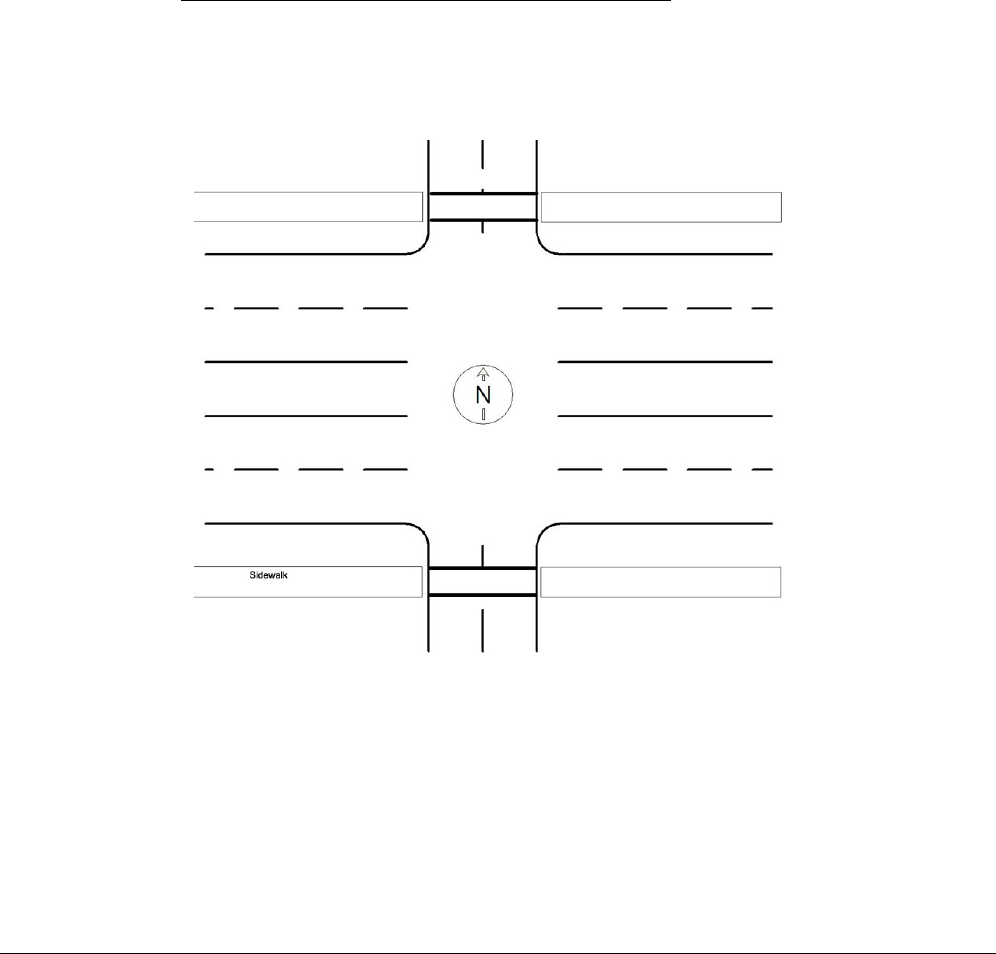
NM10
other markings on the surface of the roadway placed in accordance with the provisions in the
Manual of Uniform Traffic Control Devices.
Intersection is an area that (1) contains a crossing or connection of two or more roadways not
classified as driveway access (2) is embraced within the prolongation of the lateral curb lines,
or, if none, the lateral boundary lines of the roadways.
01 (At Intersection-In Marked Crosswalk) is used when a person is in that portion of a
roadway at an intersection that is distinctly indicated for pedestrian crossing by lines or other
markings on the surface of the roadway. This attribute includes shared-use path crossings.
This does not include crosswalks located in mid-blocks.
02 (At Intersection-In Unmarked/Unknown if Marked Crosswalk) is used when the person
is “at intersection” within the prolongations of the sidewalk edges but there are no lines or other
markings on the surface of the roadway (unmarked crosswalk). There must be a sidewalk or
improved path present on one side of the leg of the trafficway that this person is crossing for
there to be an unmarked crosswalk. If there are no sidewalks, there are no crosswalks. If it is
unknown if the crosswalk is marked or unmarked, default to unmarked.
In a 4 four-way intersection with sidewalks running along the East/West trafficway and no
sidewalks on the North/South trafficway, the intersection area would only have 2 crosswalks.
The two that allow crossing of the North/South trafficway.
03 (At Intersection-Not In Crosswalk) refers to a person in a travel lane that is not using an
available crosswalk or there is not a crosswalk at this location.
866 2015

NM10
09 (At Intersection-Unknown Location) is used when a person is known to be at an
intersection, but it cannot be determined whether the person was in a crosswalk area (marked
or unmarked) or the intersection.
10 (Not At Intersection-In Marked Crosswalk) is used when a person is in the portion of the
roadway, not at an intersection, that is distinctly indicated for pedestrian crossing by lines or
other markings on the surface of the roadway. (i.e., the case identifies a mid-block crosswalk
exists and the person is using it.) This attribute includes shared-use path crossings.
11 (Not At Intersection-On Roadway, Not in Marked Crosswalk) is used when a person is
in the portion of the roadway, not at an intersection, and either:
(1) the case identifies a mid-block crosswalk exists and the person is not using it, or
(2) there is not a crosswalk at this location (e.g., the person is jaywalking when a mid-block
crosswalk is available), or
(3) the person is crossing at a location where a mid-block crosswalk would not be expected
to exist (e.g., a rural roadway or interstate).
13 (Not At Intersection - On Roadway, Crosswalk Availability Unknown) is used when it
cannot be determined if a crosswalk was available. (e.g., there is some information (possibly
conflicting) that leads you to believe that there may be a mid-block crosswalk at this location,
but there is not sufficient information about the location to be able to make a determination.)
14 (Parking Lane/Zone) refers to a person in an area on the roadway, or next to the roadway,
on which parking is permitted in marked or unmarked spaces. This includes curbside and edge
of roadway parking (for example, legal residential parking, city-street parking, etc.). Sometimes
a strip of roadway can be designated for parking at certain hours of the day (parking lane) and
for regular travel at other hours (travel lane). This code should NOT be used during hours
when parking is NOT permitted (see 11 (Not At Intersection-On Roadway, Not in Marked
Crosswalk)).
16 (Bicycle Lane) is used when a person is adjacent to travel lanes in a bikeway which has
been designated for preferential or exclusive use by pedalcyclists through striping, signage, or
pavement markings. This attribute includes pedalcyclists in a marked bicycle lane in an
intersection (i.e., do not use 03 (At Intersection-Not In Crosswalk)). For persons other than
pedalcyclists in a marked bicycle lane in an intersection, use 03 (At Intersection-Not in
Crosswalk). If you do not know if there is a marked bike lane through the intersection then
default to 03 (At Intersection-Not In Crosswalk).
20 (Shoulder/Roadside) - Shoulder is that part of a trafficway contiguous with the roadway for
emergency use, for accommodation of stopped motor vehicles, and lateral support of the
roadway structure. Roadside is the outermost part of the trafficway from the property line or
other boundary in to the edge of the first road. For persons on a sidewalk on the roadside
select 21 (Sidewalk).
21 (Sidewalk) is any improved surface primarily constructed for use by pedestrians. Do not
select this attribute for sidewalks within a 23 (Driveway Access), 22 (Median/Crossing
Island), 25 (Non-Trafficway Area).
2015 867

NM10
22 (Median/Crossing Island) is used when a person is in a median or crossing island. Median
is an area of trafficway between parallel roads separating travel in opposite directions. A
median should be four or more feet wide. Crossing Island is a cement or grassy area in the
middle of a trafficway. This attribute excludes crosswalk areas that pass through a median,
crossing or traffic island (i.e., select 01 (At Intersection-In Marked Crosswalk), 02 (At
Intersection-In Unmarked/Unknown if Marked Crosswalk), or 10 (Not At Intersection-In
Marked Crosswalk).)
23 (Driveway Access) is a portion of the trafficway at the end of a driveway providing access
to property adjacent to a trafficway. This includes the driveway crossing which is the portion of
the driveway access where a sidewalk or shared-use path crosses over the driveway access.
24 (Shared-Use Path) is used when a person on a bikeway physically separated from
motorized vehicular traffic by an open space or barrier and either within the highway right-of-
way or an independent right-of-way. Shared-Use Paths will also be used by pedestrians,
skaters, wheelchairs, joggers and other non-motorized users. Shared-use path crossings are
coded under 01 (At Intersection-In Marked Crosswalk) or 10 (Not At Intersection-In
Marked Crosswalk).
25 (Non-Trafficway Area) is not physically located on any land way open to the public as a
matter of right or custom for moving persons or property from one place to another. For
example: a person in a parking lot, a yard, a person in a closed portion of a work zone, or in a
house
28 (Other) is used when a person is at a location stated in the case materials that is not
reflected in the listed attributes for this data element. These would be persons within the
trafficway (i.e., not element value 25 (Non-Trafficway Area)). Examples include central
islands of rotary intersections, gores, separators or directional/channelizing islands.
If a PAR data element is coded with the attribute “Other” but the officer does not specify
what this refers to:
1. Code 28 (Other) if the PAR attribute choices can be matched to or include all the
attributes in FARS/GES.
2. Code 98 (Not Reported) if the PAR choices cannot be matched to or include all
the attributes in FARS/GES.
98 (Not Reported)
If a state’s crash report manual instructs to leave blank data blocks that are not applicable,
then a blank in those data blocks are NOT considered “Not Reported”.
Code 98 (Not Reported) in these two situations:
1. No field or coding block exists on the state’s crash report to provide the information
to code this element AND no other information is available to code the element (e.g.,
narrative, diagram, case materials)
868 2015

NM10
2. A field or coding block exists on the state’s crash report that would provide the
information needed to code this element, but it has been left blank, AND no other
information is available to code the element (e.g., narrative, diagram, case
materials).
99 (Unknown Location) is used when the case materials state that the location of the non-
motorist was unknown at the time of the crash.
*Note: In 2011, GES adopted the FARS element format. Prior to 2011 the GES Non-Motorist
Location at Time of Crash data element contained one additional attributes - 0 (Motor Vehicle
Occupant).
Consistency Checks:
IF
(1P2F) PERSON TYPE equals 10,
(1P9G) NON-MOTORIST LOCATION AT THE
TIME OF CRASH equals 20,
(1P0H) NON-MOTORIST LOCATION AT THE
TIME OF CRASH equals 21,
(1P1H) NON-MOTORIST LOCATION AT THE
TIME OF CRASH equals 22,
(1P2H) NON-MOTORIST LOCATION AT THE
TIME OF CRASH equals 23,
(1P3H) NON-MOTORIST LOCATION AT THE
TIME OF CRASH equals 24,
(1P4H) NON-MOTORIST LOCATION AT THE
TIME OF CRASH equals 25,
(1P5H) NON-MOTORIST LOCATION AT THE
TIME OF CRASH equals 28, 98, 99,
(1P6H) NON-MOTORIST LOCATION AT THE
TIME OF CRASH equals 16,
(1P7H) NON-MOTORIST LOCATION AT THE
TIME OF CRASH equals 21,
THEN
NON-MOTORIST LOCATION AT TIME
OF CRASH must equal 25.
NON-MOTORIST CONTRIBUTING
CIRCUMSTANCES must not equal
02-04, 15.
NON-MOTORIST CONTRIBUTING
CIRCUMSTANCES must not equal
02-04, 07-10, 15, 16, 20.
NON-MOTORIST CONTRIBUTING
CIRCUMSTANCES must not equal 01,
02, 04, 07, 08, 11, 15, 20.
NON-MOTORIST CONTRIBUTING
CIRCUMSTANCES must not equal 12,
15.
NON-MOTORIST CONTRIBUTING
CIRCUMSTANCES must not equal 01,
03, 04, 10, 11.
NON-MOTORIST CONTRIBUTING
CIRCUMSTANCES must not equal
01-04, 10-12, 15-17, 20.
NON-MOTORIST CONTRIBUTING
CIRCUMSTANCES should not equal 01,
03, 04, 10-12, 15, 16, 20.
NON-MOTORIST CONTRIBUTING
CIRCUMSTANCES should not equal 04,
16.
NON-MOTORIST CONTRIBUTING
CIRCUMSTANCES should not equal 01,
05, 11, 12, 17.
2015 869

NM10
IF THEN
(1P8H)
(1P9H)
(1PH0)
(1PK2)
(1PK3)
(440F)
(450F)
(460F)
(470F)
(480F)
(490F)
(530F)
(531F)
NON-MOTORIST LOCATION AT THE
TIME OF CRASH equals 23,
NON-MOTORIST LOCATION AT THE
TIME OF CRASH equals 24,
NON-MOTORIST LOCATION AT THE
TIME OF CRASH equals 25,
NON-MOTORIST LOCATION AT
TIME OF CRASH equals 21,
NON-MOTORIST LOCATION AT
TIME OF CRASH equals 01 or 10,
FIRST HARMFUL EVENT equals
08, 09, 15, and RELATION TO
TRAFFICWAY equals 01,
FIRST HARMFUL EVENT equals
08, 09, 15, and RELATION TO
TRAFFICWAY equals 07,
FIRST HARMFUL EVENT equals
08, 09, 15, and RELATION TO
TRAFFICWAY equals 02,
FIRST HARMFUL EVENT equals
08, 09, 15, and RELATION TO
TRAFFICWAY equals 03, 08, 10,
FIRST HARMFUL EVENT equals
08, 09, 15, and RELATION TO
TRAFFICWAY equals 04, 06,
FIRST HARMFUL EVENT equals
08, 09, 15, and RELATION TO
TRAFFICWAY equals 05,
FIRST HARMFUL EVENT equals
08, 09, 15, and RELATION TO
TRAFFICWAY equals 99,
FIRST HARMFUL EVENT equals
08, 09, 15, and RELATION TO
TRAFFICWAY equals 11,
NON-MOTORIST CONTRIBUTING
CIRCUMSTANCES should not equal 02.
NON-MOTORIST CONTRIBUTING
CIRCUMSTANCES should not equal 02,
05, 12, 15, 16.
NON-MOTORIST CONTRIBUTING
CIRCUMSTANCES should not equal
07-09.
SIDEWALK PRESENT must equal 1.
MARKED CROSSWALK PRESENT
must equal 1.
there must be at least one Person Level
(Not a MV Occupant) form with NON-
MOTORIST LOCATION AT TIME OF
CRASH equal to 01-03, 09-11, 13, 16,
23, 98 or 99.
there must be at least one Person Level
(Not a MV Occupant) form with NON-
MOTORIST LOCATION AT TIME OF
CRASH equal to 14.
there must be at least one Person Level
(Not a MV Occupant) form with NON-
MOTORIST LOCATION AT TIME OF
CRASH equal to 02, 20.
there must be at least one Person Level
(Not a MV Occupant) form with NON-
MOTORIST LOCATION AT TIME OF
CRASH equal to 20, 22, 98, 99.
there must be at least one Person Level
(Not a MV Occupant) form with NON-
MOTORIST LOCATION AT TIME OF
CRASH equal to 09, 16, 20, 21, 24, 25,
28, 98, 99.
there must be at least one Person Level
(Not a MV Occupant) form with NON-
MOTORIST LOCATION AT TIME OF
CRASH equal to 24, 25.
there must be at least one Person Level
(Not a MV Occupant) form with NON-
MOTORIST LOCATION AT TIME OF
CRASH equal to 09, 98, 99.
there must be at least one Person Level
(Not a MV Occupant) form with NON-
MOTORIST LOCATION AT TIME OF
CRASH equal to 11.
870 2015

NM10
IF THEN
(A61G) the FIRST HARMFUL EVENT equals
08, and PERSON TYPE equals 05,
and NON-MOTORIST LOCATION AT
THE TIME OF CRASH equals 21, 22,
24, 25, 28, and the NUMBER OF
MOTOR VEHICLE STRIKING NON-
MOTORIST is involved in the first
harmful event,
(A61H) the FIRST HARMFUL EVENT equals
09, and PERSON TYPE equals 06,
07, and NON-MOTORIST LOCATION
AT THE TIME OF CRASH equals 21,
22, 24, 25, 28, and the NUMBER OF
MOTOR VEHICLE STRIKING NON-
MOTORIST is involved in the first
harmful event,
(A61J) the FIRST HARMFUL EVENT equals
15, and PERSON TYPE equals 08,
and NON-MOTORIST LOCATION AT
THE TIME OF CRASH equals 21, 22,
24, 25, 28, and the NUMBER OF
MOTOR VEHICLE STRIKING NON-
MOTORIST is involved in the first
harmful event,
(A61K) the FIRST HARMFUL EVENT equals
49, and PERSON TYPE equals 04,
and NON-MOTORIST LOCATION AT
THE TIME OF CRASH equals 21, 22,
24, 25, 28, and the NUMBER OF
MOTOR VEHICLE STRIKING NON-
MOTORIST is involved in the first
harmful event,
(PB24) PERSON TYPE equals 05 or 08, and
NON-MOTORIST LOCATION AT
TIME OF CRASH equals 14, 16, 20,
21, 22, 24 or 25,
(PB25) PERSON TYPE equals 05 or 08, and
NON-MOTORIST LOCATION AT
TIME OF CRASH equals 01-03 or 09,
(PB66) PEDESTRIAN/ BIKE TYPING -
CRASH LOCATION - PEDESTRIAN
equals 1,
(PB67) PEDESTRIAN/ BIKE TYPING -
CRASH LOCATION - PEDESTRIAN
equals 2,
CRASH TYPE should not equal 13 for
this vehicle.
CRASH TYPE should not equal 13 for
this vehicle.
CRASH TYPE should not equal 13 for
this vehicle.
CRASH TYPE should not equal 13 for
this vehicle.
PEDESTRIAN/BIKE TYPING - CRASH
TYPE - PEDESTRIAN should equal 230,
320, 410, 420, 430, 440, 459, 510, 520,
590, 830 or 890.
PEDESTRIAN/BIKE TYPING - CRASH
TYPE - PEDESTRIAN should equal 690,
710, 730, 741, 742, 760, 770, 781, 782,
791, 792, 794, 795 or 799.
NON-MOTORIST LOCATION AT TIME
OF CRASH must equal 01, 02, 03, 09 or
22.
NON-MOTORIST LOCATION AT TIME
OF CRASH must equal 10, 11, 13, 14,
16, 20-25, 28, 98, 99.
2015 871

NM10
IF
(PB68) PEDESTRIAN/ BIKE TYPING -
CRASH LOCATION - PEDESTRIAN
equals 3,
(PB69) PEDESTRIAN/ BIKE TYPING -
CRASH LOCATION - PEDESTRIAN
equals 4,
(PB70) PEDESTRIAN/ BIKE TYPING -
CRASH LOCATION - PEDESTRIAN
equals 9,
(PB71) PEDESTRIAN/ BIKE TYPING -
CRASH LOCATION - BICYLE equals
1,
(PB72) PEDESTRIAN/ BIKE TYPING -
CRASH LOCATION - BICYLE equals
2,
(PB73) PEDESTRIAN/ BIKE TYPING -
CRASH LOCATION - BICYLE equals
3,
(PB74) PEDESTRIAN/ BIKE TYPING -
CRASH LOCATION - BICYLE equals
4,
(PB75) PEDESTRIAN/ BIKE TYPING -
CRASH LOCATION - BICYLE equals
9,
(PB76) PEDESTRIAN/ BIKE TYPING -
PEDESTRIAN POSITION equals 1,
(PB77) PEDESTRIAN/ BIKE TYPING -
PEDESTRIAN POSITION equals 2,
(PB78) PEDESTRIAN/ BIKE TYPING -
PEDESTRIAN POSITION equals 3,
(PB79) PEDESTRIAN/ BIKE TYPING -
PEDESTRIAN POSITION equals 4,
(PB80) PEDESTRIAN/ BIKE TYPING -
PEDESTRIAN POSITION equals 5,
(PB81) PEDESTRIAN/ BIKE TYPING -
PEDESTRIAN POSITION equals 6,
(PB82) PEDESTRIAN/ BIKE TYPING -
PEDESTRIAN POSITION equals 7 or
8,
(PB83) PEDESTRIAN/ BIKE TYPING -
PEDESTRIAN POSITION equals 9,
THEN
NON-MOTORIST LOCATION AT TIME
OF CRASH must equal 10, 11, 13, 14,
16, 20-24, 28, 98, 99.
NON-MOTORIST LOCATION AT TIME
OF CRASH must equal 24, 25, 98, 99.
NON-MOTORIST LOCATION AT TIME
OF CRASH must equal 16, 22, 24, 98 or
99.
NON-MOTORIST LOCATION AT TIME
OF CRASH must equal 01, 02, 03, 09,
16 or 22.
NON-MOTORIST LOCATION AT TIME
OF CRASH must equal 10, 11, 13, 14,
16, 20, 21, 22, 23, 24, 25, 28, 98, 99.
NON-MOTORIST LOCATION AT TIME
OF CRASH must equal 10, 11, 13, 14,
16, 20, 21, 22, 23, 24, 28, 98, 99.
NON-MOTORIST LOCATION AT TIME
OF CRASH must equal 24, 25, 98, 99.
NON-MOTORIST LOCATION AT TIME
OF CRASH must equal 16, 22, 24, 98 or
99.
NON-MOTORIST LOCATION AT TIME
OF CRASH must equal 03.
NON-MOTORIST LOCATION AT TIME
OF CRASH must equal 01, 02 or 10.
NON-MOTORIST LOCATION AT TIME
OF CRASH must equal 11, 13.
NON-MOTORIST LOCATION AT TIME
OF CRASH must equal 14, 16, 20, 98 or
99.
NON-MOTORIST LOCATION AT TIME
OF CRASH must equal 21, 23, 24, 98 or
99.
NON-MOTORIST LOCATION AT TIME
OF CRASH must equal 20, 22, 28, 98 or
99.
NON-MOTORIST LOCATION AT TIME
OF CRASH must equal 25
NON-MOTORIST LOCATION AT TIME
OF CRASH must equal 09, 20, 22, 28,
98 or 99.
872 2015

NM10
IF THEN
(PB84)
(PB85)
(PB86)
(PB87)
(PB88)
(PB89)
PEDESTRIAN/ BIKE TYPING -
BICYCLIST POSITION equals 1,
PEDESTRIAN/ BIKE TYPING -
BICYCLIST POSITION equals 2,
PEDESTRIAN/ BIKE TYPING -
BICYCLIST POSITION equals 3,
PEDESTRIAN/ BIKE TYPING -
BICYCLIST POSITION equals 4,
PEDESTRIAN/ BIKE TYPING -
BICYCLIST POSITION equals 5 or 6,
PEDESTRIAN/ BIKE TYPING -
BICYCLIST POSITION equals 8,
NON-MOTORIST LOCATION AT TIME
OF CRASH must equal 03, 09, 11 or 13.
NON-MOTORIST LOCATION AT TIME
OF CRASH must equal 14, 16 or 20.
NON-MOTORIST LOCATION AT TIME
OF CRASH must equal 01, 02, 10, 21,
23, 98 or 99.
NON-MOTORIST LOCATION AT TIME
OF CRASH must equal 24.
NON-MOTORIST LOCATION AT TIME
OF CRASH must equal 25.
NON-MOTORIST LOCATION AT TIME
OF CRASH must equal 20, 22, 28, 98 or
99.
(PB90)
(U150)
PEDESTRIAN/ BIKE TYPING -
BICYCLIST POSITION equals 9,
UNLIKELY: NON-MOTORIST LOCATI
NON-MOTORIST LOCATION AT TIME
OF CRASH must equal 22, 98 or 99.
ON AT TIME OF CRASH equals 16, 25.
2015 873

NM11
NON-MOTORIST ACTION/CIRCUMSTANCES
FORMAT: 2 numeric. Select all that apply.
SAS NAME: nmprior.MPR_ACT
ELEMENT VALUES:
01 Going To or From School (K-12)
02 Waiting to Cross Roadway
03 Crossing Roadway
04 Jogging/Running
05 Movement Along Roadway with Traffic (In or Adjacent to Travel Lane)
06 Movement Along Roadway Against Traffic (In or Adjacent to Travel Lane)
16 Movement Along Roadway - Direction Unknown
08 In Roadway - Other (Working, Playing, etc.)
09 Adjacent to Roadway (e.g., Shoulder, Median)
10 Working in Trafficway (Incident Response)
11 Entering/Exiting Parked or Stopped Vehicle
12 Disabled Vehicle Related (Working on, Pushing, Leaving/Approaching)
14 Other (Specify:)
98 Not Reported
99 Unknown
Definition: This element describes the action(s) of the non-motorist at the time of their
involvement in the crash.
Remarks:
Select all that apply.
01 (Going To or From School [K-12]) includes person age 5-18 or an adult supervising
persons age 5 - 18 going to or from a school for any reason. Examples are going to a school
dance, sports practice or extracurricular activities.
02 (Waiting to Cross Roadway) is used when the non-motorist is near the curb or the
roadway edge waiting to cross a roadway anywhere along the roadway. If the pedestrian
began to cross the roadway, stopped, and then was struck select 03 (Crossing the
Roadway). For person's adjacent to the roadway where their intent to cross is not identified,
use 09 (Adjacent to Roadway).
03 (Crossing Roadway) is used when the non-motorist was moving across or in the travel
lanes with the goal of crossing the roadway.
04 (Jogging/Running) is used when the pedestrian was running or jogging.
2015 875

NM11
05 (Movement Along Roadway with Traffic [In or Adjacent to Travel Lane]) is used when
the non-motorist was moving in the same direction as the flow of traffic, either in the travel lane
or adjacent to it (e.g. jogging or walking on shoulder or roadside). This also includes situations
where the person's action/intent was traveling along the roadway. For example a person
stopped momentarily when they were struck (e.g., to tie shoes, talk on cell phone) or someone
that moved out into the path of a vehicle to avoid an obstacle along the roadside. This may
include the roadway edge, shoulder (paved or unpaved), sidewalk, roadside, median or
driveway access, etc.
06 (Movement Along Roadway Against Traffic [In or Adjacent to Travel Lane]) is used
when the non-motorist was moving in the opposite direction of the flow of traffic (facing
oncoming vehicles), either in the travel lane or adjacent to it. (e.g. jogging or walking on
shoulder or roadside.) This also includes situations where the person's action/intent was
traveling along the roadway. For example a person stopped momentarily when they were
struck (e.g., to tie shoes, talk on cell phone) or someone that moved out into the path of a
vehicle to avoid an obstacle along the roadside. This may include the roadway edge, shoulder
(paved or unpaved), sidewalk, roadside, median, or driveway access, etc.
16 (Movement Along Roadway - Direction Unknown) is used when the non-motorist was
moving in or adjacent to a travel lane but their direction with respect to the flow of traffic is
unknown. (e.g. jogging or walking on shoulder or roadside.) This may include the roadway
edge, shoulder (paved or unpaved), sidewalk, roadside, median, or driveway access, etc.
08 (In Roadway - Other [Working, Playing, Etc.]) is used when the non-motorist was in the
roadway but not crossing it. Examples include conducting maintenance, playing in the
roadway, operating a snow blower or lawn care equipment, or lying in the roadway. For cases
involving a non-motorist working within a closed portion of a work zone area, use attribute 14
(Other).
09 (Adjacent to Roadway [e.g., Shoulder, Median]) is used when the non-motorist was not
moving and not in the roadway but in an area immediately adjacent to the roadway, such as a
median, shoulder or sidewalk.
10 (Working in Trafficway [Incident Response]) is used when the non-motorist was in the
roadway as part of an official response to an incident, such as a firefighter moving between an
emergency vehicle and a crash involved vehicle.
11 (Entering/Exiting Parked/Stopped Vehicle) is used when a pedestrian was adjacent to a
stopped or parked vehicle and in the process of getting into or had just exited that stopped or
parked vehicle. This does not include crashes involving pedestrians performing other actions
such as crossing the roadway to/from a parked vehicle or other movements that occurred after
the pedestrian exited the vehicle.
12 (Disabled Vehicle Related [Working on, Pushing, Leaving/Approaching]) is used when
the pedestrian was outside of a disabled vehicle for any of a number of reasons, including
working on it, pushing it, leaving it, or approaching it.
876 2015

NM11
14 (Other [Specify:]) is used when the actions or circumstances stated in the case materials
do not reflect the listed attributes for this data element. This includes non-motorists working
within a closed portion of a work zone area.
*Note: for attributes with a “Specify:” designation, a fill-in text box will open in MDE. This text
box should be used to provide additional detail about the attribute selection. Please include a
specific reason for this selection.
98 (Not Reported)
If a state’s crash report manual instructs to leave blank data blocks that are not applicable,
then a blank in those data blocks are NOT considered “Not Reported”.
Code 98 (Not Reported) in these two situations:
1. No field or coding block exists on the state’s crash report to provide the information
to code this element AND no other information is available to code the element (e.g.,
narrative, diagram, case materials)
2. A field or coding block exists on the state’s crash report that would provide the
information needed to code this element, but it has been left blank, AND no other
information is available to code the element (e.g., narrative, diagram, case
materials).
99 (Unknown) is used when the case materials state that the action or circumstances of the
non-motorist prior to the crash was unknown.
Consistency Checks:
IF
(1P3F) PERSON TYPE equals 10,
(1P4F) PERSON TYPE equals 04,
(1P5F) PERSON TYPE equals 06-08, 19,
(1P7F) PERSON TYPE equals 04,
(1P8F) PERSON TYPE equals 06, 07,
THEN
NON-MOTORIST ACTION/CIRCUM-
STANCES must not equal 01-12, 16,
and NON-MOTORIST CONTRIBUTING
CIRCUMSTANCES must not equal
01-20.
NON-MOTORIST ACTION/CIRCUM-
STANCES must not equal 04, 12.
NON-MOTORIST ACTION/CIRCUM-
STANCES must not equal 04.
NON-MOTORIST ACTION/CIRCUM-
STANCES should not equal 10, 11.
NON-MOTORIST ACTION/CIRCUM-
STANCES should not equal
10-12.
2015 877

NM11
IF THEN
(1P9F)
(1P1G)
(4X5F)
PERSON TYPE equals 08,
PERSON TYPE equals 19,
NON-MOTORIST ACTION/CIRCUM-
STANCES is selected 04,
NON-MOTORIST ACTION/CIRCUM-
STANCES should not equal 11.
NON-MOTORIST ACTION/CIRCUM-
STANCES should not equal 11, 12.
NON-MOTORIST ACTION/CIRCUM-
STANCES attributes 05, 06 or 16 should
also be selected.
(4X7F)
(PB15)
any NON-MOTORIST ACTION/
CIRCUMSTANCES equals 98 or 99,
PEDESTRIAN/BIKE TYPING -
CRASH TYPE - PEDESTRIAN equals
910,
only that one code and no other must be
coded for this person.
NON-MOTORIST ACTION/ CIRCUM-
STANCES must equal 03.
(PB19) NON-MOTORIST ACTION/CIRCUM-
STANCES equals 08,
PEDESTRIAN/BIKE TYPING - CRASH
TYPE - PEDESTRIAN must not equal
510, 520, 590, 830 or 890.
(PB20) PEDESTRIAN/BIKE TYPING -
CRASH TYPE - PEDESTRIAN equals
510, 520 or 590,
at least one NON-MOTORIST ACTION/
CIRCUMSTANCES must equal 02.
(PB27)
(PB28)
(PB29)
(PB37)
NON-MOTORIST ACTION/CIRCUM-
STANCES equals 05, and PERSON
TYPE equals 05 or 08,
NON-MOTORIST ACTION/CIRCUM-
STANCES equals 06, and PERSON
TYPE equals 05 or 08,
NON-MOTORIST ACTION/CIRCUM-
STANCES equals 04, and PERSON
TYPE equals 05 or 08,
PEDESTRIAN/BIKE TYPING -
CRASH TYPE - PEDESTRIAN equals
311, 312 or 313,
PEDESTRIAN/BIKE TYPING - CRASH
TYPE - PEDESTRIAN should equal 410
or 420.
PEDESTRIAN/BIKE TYPING - CRASH
TYPE - PEDESTRIAN should equal 430
or 440.
PEDESTRIAN/BIKE TYPING - CRASH
TYPE - PEDESTRIAN should equal 410,
420, 430, 440 or 459.
at least one NON-MOTORIST ACTION/
CIRCUMSTANCES must equal 08 or 10.
(PB38) PEDESTRIAN/BIKE TYPING -
CRASH TYPE - PEDESTRIAN equals
410 or 420,
at least one NON-MOTORIST ACTION/
CIRCUMSTANCES must equal 05.
(PB39) PEDESTRIAN/BIKE TYPING -
CRASH TYPE - PEDESTRIAN equals
430 or 440,
at least one NON-MOTORIST ACTION/
CIRCUMSTANCES must equal 06.
(PB58) NON-MOTORIST ACTION/CIRCUMSTANCES must not equal 05, 06 or 16 in
combination.
(PB59)
(PB62)
NON-MOTORIST ACTION/
CIRCUMSTANCES equals 16, and
PERSON TYPE equals 05 or 08,
PEDESTRIAN/BIKE TYPING -
CRASH TYPE - PEDESTRIAN equals
220,
PEDESTRIAN/BIKE TYPING - CRASH
TYPE - PEDESTRIAN should equal 459.
at least one NON-MOTORIST ACTION/
CIRCUMSTANCES must equal 12.
878 2015

NM11
IF THEN
(PB64) any NON-MOTORIST ACTION/
CIRCUMSTANCES equals 03 or 09,
the NON-MOTORIST ACTION/
CIRCUMSTANCES must not also equal
05, 06 or 16 for this person.
2015 879

NM12
NON-MOTORIST CONTRIBUTING CIRCUMSTANCES
FORMAT: 2 numeric. Select all that apply.
SAS NAME: nmcrash.MTM_CRSH
ELEMENT VALUES:
00 None Noted
01 Dart-Out
11 Dash
02 Failure to Yield Right-Of-Way
03 Failure to Obey Traffic Signs, Signals or Officer
04 In Roadway Improperly (Standing, Lying, Working, Playing, etc.)
05 Entering/Exiting Parked or Stopped Vehicle
06 Inattentive (Talking, Eating, etc.)
07 Improper Turn/Merge
08 Improper Passing
09 Wrong-Way Riding or Walking
10 Riding on Wrong Side of Road
12 Improper Crossing of Roadway or Intersection (Jaywalking)
13 Failing to Have Lights on When Required
14 Operating Without Required Equipment
15 Improper or Erratic Lane Changing
16 Failure to Keep in Proper Lane or Running Off Road
17 Making Improper Entry to or Exit from Trafficway
18 Operating in Other Erratic, Reckless, Careless or Negligent Manner
19 Not Visible (Dark Clothing, No Lighting, etc.)
20 Passing with Insufficient Distance or Inadequate Visibility or Failing to Yield to
Overtaking Vehicle
21 Other (Specify:)
99 Unknown
Definition: This element describes the action(s) and/or circumstances of the non-motorist that
law enforcement indicated may have contributed to the crash.
Remarks:
00 (None Noted) is used when no contributing circumstances or improper actions are noted by
the officer for this non-motorist. “Not Reported” is coded here. If this attribute is used no other
attribute may be selected.
01 (Dart-Out) is used when a person entered the roadway and was involved in a collision with
a vehicle where the driver's view of the person was blocked until an instant before impact. A
2015 881

NM12
dart-out can only occur if there is some documented visual obstruction (e.g., parked vehicle,
building or vegetation).
11 (Dash) is used when a person ran into the roadway and was involved in a collision with a
vehicle. There is no mention in the case materials that the driver’s view of the person was
obstructed. The case materials should state that the person ran.
Examples of proper use include:
A person's activity prior to the crash is jogging or running, but just prior to the impact the
non-motorist darted into the roadway.
Children seen playing in a front yard, who suddenly run into the road to retrieve an
object associated with their play (e.g. a ball).
02 (Failure to Yield Right-of-Way) is used when a person fails to yield the right-of-way as
indicated in the case materials. A citation need not be issued, only that a failure to yield by
the person was represented on the PAR through the crash description, diagram, and or coded
boxes.
Examples include:
Failure to yield when exiting a driveway.
Mid-block crossings not at a crosswalk.
Not clearing an intersection before the light turns green for crossing traffic.
Failure to yield at an intersection not controlled by a stop sign or flashing red lights.
A bicyclist which stopped at the stop sign, but did not realize it was a two way stop
rather than a 4-way stop control and proceeded into the intersection without yielding to
traffic on the through trafficway.
Failure to obey a traffic control device is coded as 03 (Failure to Obey Traffic Signs, Signals or
Officer).
03 (Failure to Obey Traffic Signs, Signals or Officer) is used when a person fails to obey a
traffic control device as indicated in the case materials. Examples include: person does not
obey traffic signs, traffic control devices (including pedestrian signals), traffic officers or safety
zones; or passes around railroad gates.
04 (In Roadway Improperly [Standing, Lying, Working, Playing, etc.]) is used when a
person was indicated to have been in the roadway improperly other than making an improper
crossing as in code 12 (Improper Crossing of Roadway or Intersection [Jaywalking]).
Examples include:
Playing in the road before the vehicle arrived. The person must not have just run into
the roadway after a ball, which would be coded 01 (Dart-Out) or 11 (Dash).
Working in the road other than because of the requirement of his/her job, (e.g.,
someone walking backwards into the roadway with a snow blower or lawn care
equipment).
In the street voluntarily, such as a civilian directing traffic at the scene of a crash.
882 2015

NM12
Attempting to hail a cab, flag down assistance, or flag down a transit bus between
designated stops.
Sitting, getting up, asleep/unconscious, kneeling, etc.
05 (Entering/Exiting Parked or Stopped Vehicle) is used when a pedestrian was adjacent to
a stopped or parked vehicle and in the process of getting into or had just exited that stopped or
parked vehicle. This does not include crashes involving pedestrians performing other actions
such as crossing the roadway to/from a parked vehicle or other movements that occurred after
the pedestrian exited the vehicle.
06 (Inattentive [Talking, Eating, etc.]) is used when the case materials specifically state a
person is inattentive, lost in thought or distracted. Examples include using any electronic
devices (cell phone, video game, e-reader), using earbuds on a music player while jogging,
chatting with a neighbor, caring for a baby in a stroller, admiring a garden, etc.
07 (Improper Turn/Merge) is used when the case materials indicate the bicyclist/operator
made an improper turn or merge. Examples of an improper turn include too wide right or left
turns, making a right turn from the left lane, a left turn from the right lane or unsafe U-turns. An
example of an improper merge is when the bicycle lane ends and the bicyclist merges into the
path of a vehicle without leaving sufficient space.
08 (Improper Passing) is used when the case materials indicate the bicyclist/operator made
an improper passing maneuver. The bicyclist/operator may be passing a motor vehicle or
another bicyclist. Actions include passing on the right, and where prohibited by signs,
pavement markings, or a stopped school bus, (i.e., mainly violations as designated by traffic
controls). Improper passing which is based on faulty judgment errors such as insufficient
distance, or inadequate visibility are captured by 20 (Passing with Insufficient Distance or
Inadequate Visibility or Failing to Yield to Overtaking Vehicle).
09 (Wrong-Way Riding or Walking) is used when a person was identified in the case
materials to have been traveling the wrong way.
10 (Riding on Wrong Side of Road) is used when a bicyclist was identified in the case
materials to have been traveling on the wrong side of the road.
12 (Improper Crossing of Roadway or Intersection [Jaywalking]) is used when a person is
engaged in crossing a road but is not doing so properly. This includes mid-block crossings
outside a crosswalk and crossing at an intersection by cutting on a diagonal through it. The
officer’s representation of either circumstance on the diagram or in the narrative substantiates
the use of this attribute. The person may be engaged in other activities such as the
continuation of jogging/running or a "sudden or impulsive" dart, run, etc. This attribute should
not be used in conjunction with 04 (In Roadway Improperly [Standing, Lying, Working,
Playing, etc.]).
13 (Failing to Have Lights on When Required) is used when the case materials indicate the
operator of a bicycle, animal-drawn conveyance or personal conveyance failed to have lights
2015 883

NM12
on when required. This also includes not having lights available to turn on, and may be used
with 14 (Operating Without Required Equipment).
14 (Operating Without Required Equipment) is used when the case materials indicate that
the bicycle, animal-drawn conveyance or person conveyance, was being operated without the
proper equipment such as headlights, taillights, etc. Helmet use is captured under NM13 Non-
Motorist Safety Equipment.
15 (Improper or Erratic Lane Changing) is used when a bicyclist, operator of horse-drawn
vehicle, roller blader, or skateboard rider was weaving in and out of traffic. This includes
maneuvering between vehicles and in-and-out of a bike lane.
16 (Failure to Keep in Proper Lane or Running Off Road) is used when a bicyclist/operator
fails to stay in the proper lane or runs off the road. For example, a bicyclist fails to keep in
bicycle lane or operator of horse-drawn vehicle goes straight in a turn lane. This includes
running into a median or drifting into a parking lane.
18 (Operating in Other Erratic, Reckless, Careless or Negligent Manner) is used when
explicitly stated in the case materials. Examples include bicyclists doing wheelies, attempting
to grab on to a vehicle for motion (“skitching”), or skateboard racing.
19 (Not Visible [Dark Clothing, No Lighting, etc.]) is used when the non-motorist was not
visible to the motorist because of blocked views, insufficient lighting or other reasons such as
clothing which blends in with the surroundings at any time of the day (camouflage) or dark
clothing in the rain at night. The officer must indicate that the non-motorist was not visible.
20 (Passing with Insufficient Distance or Inadequate Visibility or Failing to Yield to
Overtaking Vehicle) is used when an improper passing maneuver is indicated in the case
materials for the non-motorist. This indicates passing violations based on faulty judgment. This
may be used in conjunction with 08 (Improper Passing) if both apply.
21 (Other, Specify:) is used when the case materials state that an action(s)/circumstances(s)
by the non-motorist may have contributed to the crash, but are not listed in these attributes.
Examples include being pushed into the roadway, falling from a bicycle, traveling on a
prohibited roadway.
*Note: for attributes with a “Specify:” designation, a fill-in text box will open in MDE. This text
box should be used to provide additional detail about the attribute selection. Please include a
specific reason for this selection.
99 (Unknown) is used when the officer indicated unknown in the case material’s contributing
circumstances field or the narrative and no other information is available. If this attribute is
used no other attribute may be selected.
884 2015

NM12
Consistency Checks:
IF
(0PB1) PEDESTRIAN/BIKE TYPING -
CRASH TYPE - PEDESTRIAN equals
741,
(1N4F) any NON-MOTORIST SAFETY
EQUIPMENT equals 5,
(1P3F) PERSON TYPE equals 10,
(1P0G) PERSON TYPE equals 05,
(1P3G) PERSON TYPE equals 04, 06, 07,
(1P4G) PERSON TYPE equals 04, 06-08, 19,
(1P5G) PERSON TYPE equals 08,
(1P9G) NON-MOTORIST LOCATION AT THE
TIME OF CRASH equals 20,
(1P0H) NON-MOTORIST LOCATION AT THE
TIME OF CRASH equals 21,
(1P1H) NON-MOTORIST LOCATION AT THE
TIME OF CRASH equals 22,
(1P2H) NON-MOTORIST LOCATION AT THE
TIME OF CRASH equals 23,
(1P3H) NON-MOTORIST LOCATION AT THE
TIME OF CRASH equals 24,
(1P4H) NON-MOTORIST LOCATION AT THE
TIME OF CRASH equals 25,
(1P5H) NON-MOTORIST LOCATION AT THE
TIME OF CRASH equals 28, 98, 99,
(1P6H) NON-MOTORIST LOCATION AT THE
TIME OF CRASH equals 16,
THEN
at least one NON-MOTORIST
CONTRIBUTING CIRCUMSTANCES
must equal 11.
NON-MOTORIST CONTRIBUTING
CIRCUMSTANCES should not equal 13.
NON-MOTORIST ACTION/CIRCUM-
STANCES must not equal 01-12, 16,
and NON-MOTORIST CONTRIBUTING
CIRCUMSTANCES must not equal
01-20.
NON-MOTORIST CONTRIBUTING
CIRCUMSTANCES must not equal 07,
08, 10, 13-18, 20.
NON-MOTORIST CONTRIBUTING
CIRCUMSTANCES should not equal 04.
NON-MOTORIST CONTRIBUTING
CIRCUMSTANCES should not equal 05.
NON-MOTORIST CONTRIBUTING
CIRCUMSTANCES should not equal 20.
NON-MOTORIST CONTRIBUTING
CIRCUMSTANCES must not equal
02-04, 15.
NON-MOTORIST CONTRIBUTING
CIRCUMSTANCES must not equal
02-04, 07-10, 15, 16, 20.
NON-MOTORIST CONTRIBUTING
CIRCUMSTANCES must not equal 01,
02, 04, 07, 08, 11, 15, 20.
NON-MOTORIST CONTRIBUTING
CIRCUMSTANCES must not equal 12,
15.
NON-MOTORIST CONTRIBUTING
CIRCUMSTANCES must not equal 01,
03, 04, 10, 11.
NON-MOTORIST CONTRIBUTING
CIRCUMSTANCES must not equal
01-04, 10-12, 15-17, 20.
NON-MOTORIST CONTRIBUTING
CIRCUMSTANCES should not equal 01,
03, 04, 10-12, 15, 16, 20.
NON-MOTORIST CONTRIBUTING
CIRCUMSTANCES should not equal 04,
16.
2015 885

NM12
IF THEN
(1P7H) NON-MOTORIST LOCATION AT THE
TIME OF CRASH equals 21,
NON-MOTORIST CONTRIBUTING
CIRCUMSTANCES should not equal 01,
05, 11, 12, 17.
(1P8H)
(1P9H)
NON-MOTORIST LOCATION AT THE
TIME OF CRASH equals 23,
NON-MOTORIST LOCATION AT THE
TIME OF CRASH equals 24,
NON-MOTORIST CONTRIBUTING
CIRCUMSTANCES should not equal 02.
NON-MOTORIST CONTRIBUTING
CIRCUMSTANCES should not equal 02,
05, 12, 15, 16.
(1PH0) NON-MOTORIST LOCATION AT THE
TIME OF CRASH equals 25,
NON-MOTORIST CONTRIBUTING
CIRCUMSTANCES should not equal
07-09.
(4X8F)
(PB16)
any NON-MOTORIST
CONTRIBUTING CIRCUMSTANCES
equals 00 or 99,
PEDESTRIAN/BIKE TYPING -
CRASH TYPE - BICYCLIST equals
142, 144, 147, 153, 155, 156, 157,
159, 311, 312, 313, 318, 319 or 357,
only that one code and no other must be
coded for this person.
at least one NON-MOTORIST
CONTRIBUTING CIRCUMSTANCES
must equal 02.
(PB18)
(PB26)
PEDESTRIAN/BIKE TYPING -
CRASH TYPE - PEDESTRIAN equals
742,
NON-MOTORIST CONTRIBUTING
CIRCUMSTANCES equals 02, and
PERSON TYPE equals 06 or 07,
at least one NON-MOTORIST
CONTRIBUTING CIRCUMSTANCES
must equal 01.
PEDESTRIAN/BIKE TYPING - CRASH
TYPE - BICYCLIST should equal 142,
144, 147, 153, 155, 156, 157, 159, 311,
312, 313, 318, 319 or 357.
886 2015
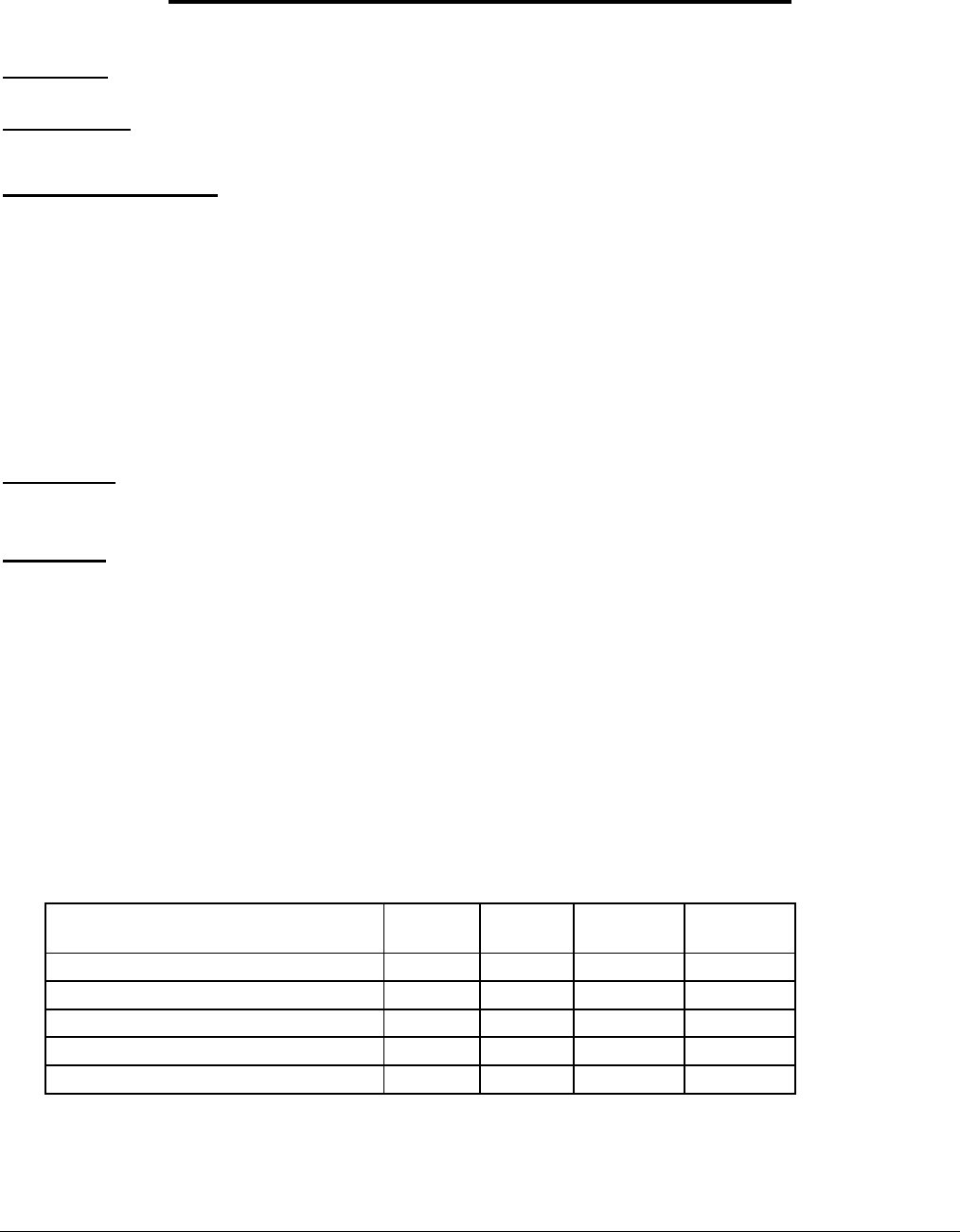
NM13
NON-MOTORIST SAFETY EQUIPMENT
FORMAT: 1 numeric. Select all that apply.
SAS NAME: Safety.MSAFEQMT
ELEMENT VALUES:
1 None Used
2 Helmet
3 Reflective Clothing (jacket, backpack, etc.)
4 Protective Pads (elbows, knees, shins, etc.)
5 Lighting
7 Other Safety Equipment
8 Not Reported
9 Unknown if Used
Definition: This element indicates the safety equipment that was used by the non-motorist
involved in the crash.
Remarks:
Select all that apply.
The applicable attribute may be determined using various items in the case materials
such as a crash report field, the officer narrative, a fatal crash supplement, etc. Each
attribute may only be coded once per person, e.g., a person on rollerblades using elbow
and knee pads with four pads covering the two different body regions would only be
coded one time. If any non-motorist safety equipment equals 1 (None Used), 8 (Not
Reported), or 9 (Unknown if Used), only that one code and no other must be coded for
this person.
Use the following NM13 Worksheet to determine proper coding of this element:
Was an item that qualifies for
this FARS/GES Attribute USED? Yes No
Not
Reported Unknown
Helmet
Reflective Clothing
Protective Pads
Lighting
Other Safety Equipment
2015 887

NM13
Worksheet Instructions:
Code any types of safety equipment with worksheet values equal to
“Yes”. For example, if “Helmet” and “Protective Pads” are “Yes” in
the worksheet, code as 2 (Helmet) and 4 (Protective Pads).
To code 1 (None Used), all of the worksheet values must be “No”.
To code 8 (Not Reported), all of the worksheet values must be some
combination consisting of “No”, “Not Reported”, or “Unknown”. The
worksheet must not contain:
○ any “Yes” responses,
○ all “No” responses,
○ all “Unknown” responses.
To code 9 (Unknown if Used), all of the worksheet values must be
“Unknown”.
1 (None Used) is used when the case materials specifically state that the non-motorist was not
wearing or carrying any type of safety equipment, or the NM13 Worksheet results in a “No”
for all five attribute responses. For example, do not use this attribute to code “not
visible” or “dark clothing”.
2 (Helmet) is used when the case materials indicate that the non-motorist was wearing a
safety helmet. The non-motorist does not have to be riding a bicycle at the time of the crash to
use this attribute. This includes all helmets (e.g., bicycle helmet, motorcycle helmet,
racing helmets, etc.).
3 (Reflective Clothing [jacket, backpack, etc.]) is used when the case materials indicate that
the non-motorist was wearing or carrying some type of reflective item. The emphasis is on the
reflective property of the clothing or carried item and does not include devices which give off
light under their own power (e.g., flashlights). The item can be reflective tape affixed to
regular clothing, special reflective clothing, a reflective device that is worn or a reflective device
that is carried. It can be made by the non-motorist and does not have to be specially designed
as a safety device.
Do not code bicycle reflectors here. This code is used only for clothing or equipment
that is worn or carried. Code bicycle reflectors under 7 (Other Safety Equipment).
4 (Protective Pads [elbows, knees, shins, etc.]) is used when the case materials indicate
the non-motorist was wearing padded, shaped attachments to protect specific areas of the
body (elbows, knees, shins, etc.) from injury.
5 (Lighting) is used when a non-motorist uses a light on his/her person or on a pedalcycle or
personal conveyance for safety purposes, to include flashlights.
7 (Other Safety Equipment) is used when the case materials indicate that the non-motorist
was using safety equipment but it does not fit into the listed attributes (e.g., bicycle reflectors
and flags, reflectors and triangles on a buggy, eye wear/face shields, and rollerblade
888 2015

NM13
stoppers). Any clothing that is non-reflective but considered to be safety equipment (hi-glo
orange clothing) should be coded using this attribute.
If a PAR data element is coded with the attribute “Other” but the officer does not specify what
this refers to:
1. Consider this “Other Safety Equipment” in the worksheet if the PAR attribute choices
and definitions can be matched to or include all the attributes “Helmet”, “Reflective
Clothing”, “Protective Pads”, “Lighting”, and “Other Safety Equipment” in
FARS/GES.
2. Consider this “Not Reported” in the worksheet if the PAR choices cannot be matched to
or include all the attributes in FARS/GES.
8 (Not Reported)
If a state’s crash report manual instructs to leave blank data blocks that are not applicable,
then a blank in those data blocks are NOT considered “Not Reported”.
Code 8 (Not Reported) in these two situations:
1. No field or coding block exists on the state’s crash report to provide the information to
code this element AND no other information is available to code the element (e.g.,
narrative, diagram, case materials)
2. A field or coding block exists on the state’s crash report that would provide the
information needed to code this element, but it has been left blank, AND no other
information is available to code the element (e.g., narrative, diagram, case materials).
9 (Unknown If Used) is used if the NM13 Worksheet results in an “Unknown” for all five
attribute responses or if the investigating officer indicates that it is unknown if any of the
types of safety equipment was used.
Consistency Checks:
IF THEN
(1N4F) any NON-MOTORIST SAFETY NON-MOTORIST CONTRIBUTING
EQUIPMENT equals 5, CIRCUMSTANCES should not equal
13.
(4X9F) any NON-MOTORIST SAFETY only that one code and no other must be
EQUIPMENT equals 1 or 8 or 9, coded for this person.
(8T0F) any NON-MOTORIST SAFETY PERSON TYPE should equal 06-08.
EQUIPMENT equals 2,
2015 889
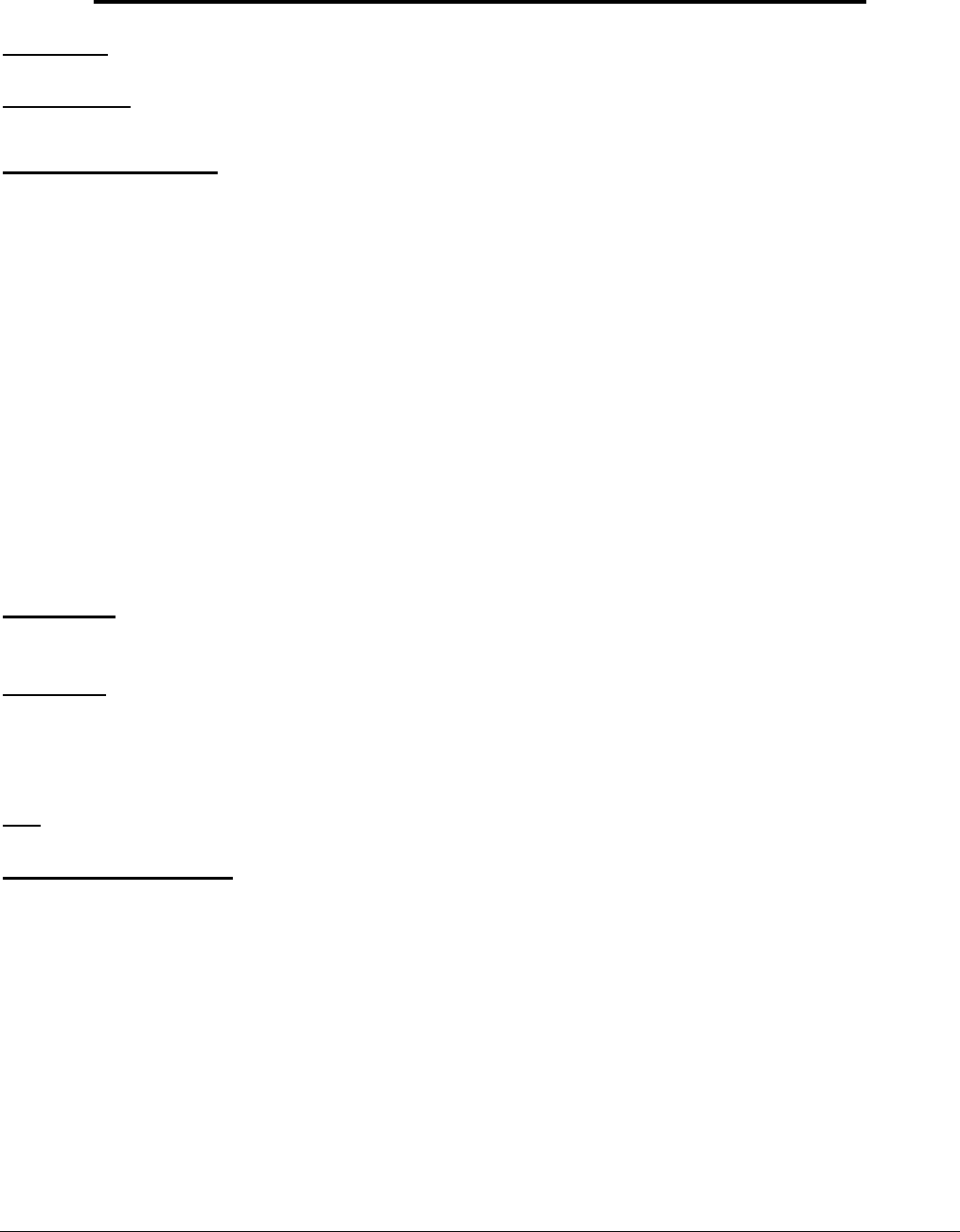
D23/NM14
CONDITION (IMPAIRMENT) AT TIME OF CRASH
FORMAT: 2 numeric. Select all that apply.
SAS NAME: Nmimpair.NMIMPAIR
ELEMENT VALUES:
00 None/Apparently Normal
01 Ill, Blackout
02 Asleep or Fatigued
03 Walking with a Cane or Crutches, etc.
04 Paraplegic Or Restricted To Wheelchair
05 Impaired Due To Previous Injury
06 Deaf
07 Blind
08 Emotional (depressed, angry, disturbed, etc)
09 Under the Influence of Alcohol, Drugs or Medication
10 Physical Impairment – No Details
96 Other Physical Impairment
98 Not Reported
99 Unknown If Impaired
Definition: This element attempts to identify any physical impairment to this non-motorist
which may have contributed to the cause of the crash.
Remarks:
Select all that apply.
This elements values and remarks are identical to Driver Level element D23. Please see page
563 for remarks.
Consistency Checks:
IF THEN
(1P6G) PERSON TYPE equals 04, 06-08, 19, CONDITION (IMPAIRMENT) AT TIME
OF CRASH must not equal 03.
(1P7G) PERSON TYPE equals 05-07, 19, CONDITION (IMPAIRMENT) AT TIME
OF CRASH should not equal 04.
(1P8G) PERSON TYPE equals 10, CONDITION (IMPAIRMENT) AT TIME
OF CRASH should not equal 01-10, 96.
2015 891

D23/NM14
IF THEN
(4X3F) any CONDITION (IMPAIRMENT) AT only that one code and no other must be
TIME OF CRASH (NM14) equals 00 coded for this person.
or 98 or 99,
(4X6F) any CONDITION (IMPAIRMENT) AT POLICE REPORTED ALCOHOL
TIME OF CRASH (NM14) equals 09, INVOLVEMENT (NM15) or POLICE
REPORTED DRUG INVOLVEMENT
(NM18) must equal 1 for this person.
(U590) UNLIKELY: any CONDITION (IMPAIRMENT) AT TIME OF CRASH (NM14)
equals 05 or 07.
892 2015

P16/NM15
POLICE REPORTED ALCOHOL INVOLVEMENT
FORMAT: 1 numeric
SAS NAME: Person.DRINKING
ELEMENT VALUES:
0 No (Alcohol Not Involved)
1 Yes (Alcohol Involved)
8 Not Reported
9 Unknown (Police Reported)
Definition: This data element reflects only the judgment of law enforcement as to whether
alcohol was involved or not for this person.
Remarks:
This elements values and remarks are identical to Person Level (MV Occupant) Level element
P16. Please see page 765 for remarks.
Consistency Checks:
IF
(4X6F) any CONDITION (IMPAIRMENT) AT
TIME OF CRASH (NM14) equals 09,
(D090) VIOLATIONS CHARGED equals
11-19, and PERSON TYPE equals 01,
03,
(P072) PERSON TYPE equals 02, 03, and
INJURY SEVERITY equals 0, and
ALCOHOL TEST RESULT equals
996,
(P110) METHOD OF ALCOHOL DETERMIN-
ATION BY POLICE equals 1-5, 8,
(P200) POLICE REPORTED ALCOHOL
INVOLVEMENT equals 8, 9,
(P300) POLICE REPORTED ALCOHOL
INVOLVEMENT equals 1, and
INJURY SEVERITY equals 4,
THEN
POLICE REPORTED ALCOHOL
INVOLVEMENT (NM15) or POLICE
REPORTED DRUG INVOLVEMENT
(NM18) must equal 1 for this person.
POLICE REPORTED ALCOHOL
INVOLVEMENT should equal 1, or
POLICE REPORTED DRUG
INVOLVEMENT should equal 1.
POLICE REPORTED ALCOHOL
INVOLVEMENT should equal 0, 8.
POLICE REPORTED ALCOHOL
INVOLVEMENT should equal 0, 1.
METHOD OF ALCOHOL DETERMIN-
ATION BY POLICE should equal 9.
ALCOHOL TEST STATUS should not
equal 0, 1.
2015 893

P17/NM16
METHOD OF ALCOHOL DETERMINATION BY POLICE
(FARS Only)
FORMAT: 1 numeric
SAS NAME: Person.ALC_DET
ELEMENT VALUES:
1 Evidential Test (breath, blood, urine)
2 Preliminary Breath Test (PBT)
3 Behavioral
4 Passive Alcohol Sensor (PAS)
5 Observed
8 Other (e.g., Saliva test)
9 Not Reported
Definition: This element describes the method by which the police made the determination as
to whether alcohol was involved or not for this person.
Remarks:
This elements values and remarks are identical to Person Level (MV Occupant) Level element
P17. Please see page 769 for remarks.
Consistency Checks:
IF THEN
(P110)
(P200)
METHOD OF ALCOHOL
DETERMINATION BY POLICE equals
1-5, 8,
POLICE REPORTED ALCOHOL
INVOLVEMENT equals 8, 9,
POLICE REPORTED ALCOHOL
INVOLVEMENT should equal 0, 1.
METHOD OF ALCOHOL
DETERMINATION BY POLICE should
equal 9.
(U681) UNLIKELY: METHOD OF ALCOHOL DETERMINATION BY POLICE equals 8.
2015 895

P18/NM17
ALCOHOL TEST
FORMAT: 3 sets, 1 set, 1 numeric, 1 set, 2 numeric, 1 set, 3 numeric
SAS NAME: Person.ALC_STATUS, Person.ATST_TYP, Person.ALC_RES
ELEMENT VALUES:
SAS
GES FARS
Subfield 1 – Test Status
0 0 Test Not Given
1 1 Test Refused
2 2 Test Given
8 8 Not Reported
9 9 Unknown if Tested
Subfield 2 – Test Type
00 00 Test Not Given
01 01 Blood
02 02 Breathalyzer “BAC”
10 10 Preliminary Breath Test (PBT)
03 03 Urine
XX 04 Vitreous
XX 05 Blood Plasma/Serum
XX 06 Blood Clot
XX 07 Liver
08 08 Other Test Type
98 98 Unknown Test Type
95 95 Not Reported
99 99 Unknown if Tested
Subfield 3 – Test Result
00-939 00-939 Actual Value
940 940 .94 or Greater
996 996 Test Not Given
997 997 AC Test Performed, Results Unknown
998 998 Positive Reading With No Actual Value
995 995 Not Reported
999 999 Unknown if Tested
Definition for Alcohol Test Status: This element identifies if an alcohol (ethanol) test was
given to this person.
2015 897

P18/NM17
Definition for Alcohol Test Type: This element identifies the type of the alcohol (ethanol)
test that was used for this person.
Definition for Alcohol Test Result: This element identifies the alcohol (ethanol) test result
for this person.
Remarks:
This elements values and remarks are identical to Person Level (MV Occupant) Level element
P18. Please see page 773 for remarks.
Consistency Checks:
IF
(5T7P) ALCOHOL TEST STATUS equals 0,
1,
(5T8P) ALCOHOL TEST STATUS equals 9,
(5T9P) ALCOHOL TEST STATUS equals 2,
(5TCP) ALCOHOL TEST STATUS equals 8,
(P071) PERSON TYPE equals 02, 04-08, 10,
and INJURY SEVERITY does not
equal 4,
(P072) PERSON TYPE equals 02, 03, and
INJURY SEVERITY equals 0, and
ALCOHOL TEST RESULT equals
996,
(P074) PERSON TYPE equals 02, 04-08, 10,
and INJURY SEVERITY does not
equal 4,
THEN
ALCOHOL TEST TYPE must equal 00,
and ALCOHOL TEST RESULT must
equal 996.
ALCOHOL TEST TYPE must equal 99,
and ALCOHOL TEST RESULT must
equal 999.
ALCOHOL TEST TYPE must equal
01-10, 95, 98, and ALCOHOL TEST
RESULT must equal 000-940, 997, 998.
ALCOHOL TEST TYPE must equal 95,
and ALCOHOL TEST RESULT must
equal 995.
ALCOHOL TEST STATUS should not
equal 9, ALCOHOL TEST TYPE should
not equal 99, and ALCOHOL TEST
RESULT should not equal 999.
POLICE-REPORTED ALCOHOL
INVOLVEMENT should equal 0, 8.
ALCOHOL TEST TYPE must equal 00,
and ALCOHOL TEST RESULT must not
equal 995.
(P080) ALCOHOL TEST RESULTS should not equal 340-940.
(P300) POLICE REPORTED ALCOHOL ALCOHOL TEST STATUS should not
INVOLVEMENT equals 1, and equal 0, 1.
INJURY SEVERITY equals 4,
898 2015

P19/NM18
POLICE REPORTED DRUG INVOLVEMENT
FORMAT: 1 numeric
SAS NAME: Person.DRUGS
ELEMENT VALUES:
0 No (Drugs Not Involved)
1 Yes (Drugs Involved)
8 Not Reported
9 Unknown (Police Reported)
Definition: This data element reflects only the judgment of law enforcement as to whether
drugs were involved or not for this person.
Remarks:
This elements values and remarks are identical to Person Level (MV Occupant) Level element
P19. Please see page 781 for remarks.
Consistency Checks:
IF
(4X6F) any CONDITION (IMPAIRMENT) AT
TIME OF CRASH (NM14) equals 09,
(BQ0P) METHOD OF DRUG DETERMIN-
ATION BY POLICE equals 8,
(BR0P) METHOD OF DRUG DETERMIN-
ATION BY POLICE equals 1-7,
(D090) VIOLATIONS CHARGED equals
11-19, and PERSON TYPE equals 01,
03,
(P140) POLICE REPORTED DRUG
INVOLVEMENT equals 8, 9,
(P150) POLICE REPORTED DRUG
INVOLVEMENT equals 1,
(P160) POLICE REPORTED DRUG
INVOLVEMENT equals 1, and
METHOD OF DRUG DETERMIN-
ATION BY POLICE equals 2,
THEN
POLICE REPORTED ALCOHOL
INVOLVEMENT (NM15), or POLICE
REPORTED DRUG INVOLVEMENT
(NM18) must equal 1 for this person.
POLICE REPORTED DRUG
INVOLVEMENT must equal 0, 1, 8, 9.
POLICE REPORTED DRUG
INVOLVEMENT must equal 0, 1, 8.
POLICE REPORTED ALCOHOL
INVOLVEMENT should equal 1, or
POLICE REPORTED DRUG
INVOLVEMENT should equal 1.
METHOD OF DRUG DETERMINATION
BY POLICE should equal 8.
DRUG TEST STATUS should not equal
0.
not all DRUG TEST RESULTS should
equal 001.
2015 899

P19/NM18
IF THEN
(P170) METHOD OF DRUG DETERMIN- POLICE REPORTED DRUG
ATION BY POLICE equals 1-7, INVOLVEMENT should equal 0, 1.
900 2015

P20/NM19
METHOD OF DRUG DETERMINATION BY POLICE
(FARS Only)
FORMAT: 1 numeric
SAS NAME: Person.DRUG_DET
ELEMENT VALUES
1 Evidential Test (Blood, Urine)
2 Drug Recognition Technician (DRT) determination
3 Behavioral
7 Other
8 Not Reported
Definition: This element identifies the method by which the police made the determination as
to whether drugs were involved or not for this person.
Remarks:
This elements values and remarks are identical to Person Level (MV Occupant) Level element
P20. Please see page 785 for remarks.
Consistency Checks:
IF THEN
(BQ0P) METHOD OF DRUG DETERMIN- POLICE REPORTED DRUG
ATION BY POLICE equals 8, INVOLVEMENT must equal 0, 1, 8, 9.
(BR0P) METHOD OF DRUG DETERMIN- POLICE REPORTED DRUG
ATION BY POLICE equals 1-7, INVOLVEMENT must equal 0, 1, 8.
(P140) POLICE REPORTED DRUG METHOD OF DRUG DETERMINATION
INVOLVEMENT equals 8, 9, BY POLICE should equal 8.
(P160) POLICE REPORTED DRUG not all DRUG TEST RESULTS should
INVOLVEMENT equals 1, and equal 001.
METHOD OF DRUG DETERMIN-
ATION BY POLICE equals 2,
(P170) METHOD OF DRUG DETERMIN- POLICE REPORTED DRUG
ATION BY POLICE equals 1-7, INVOLVEMENT should equal 0, 1.
2015 901

P21/NM20
DRUG TEST
FORMAT: 3 sets: 2 sets, 1 numeric; 1 set, 3 numeric
SAS NAME: Person.DSTATUS, Person.DRUGTST1, Person.DRUGTST2,
Person.DRUGTST3, Person.DRUGRES1, Person.DRUGRES2, Person.DRUGRES3
ELEMENT VALUES:
GES FARS
Subfield 1 – Test Status
0 0 Test Not Given
1 1 Test Refused
2 2 Test Given
8 8 Not Reported
9 9 Unknown if Tested
Subfield 2 – Test Type
0 0 Test Not Given
1 1 Blood
2 2 Urine
3 3 Both: Blood and Urine Tests
7 7 Unknown Test Type
8 8 Other Test Type
6 6 Not Reported
9 9 Unknown if Tested
Subfield 3 – Test Result
000 000 Test Not Given
001 001 Tested, No Drugs Found/Negative
XXX 100-295 Narcotic*
XXX 300-395 Depressant*
XXX 400-495 Stimulant*
XXX 500-595 Hallucinogen*
XXX 600-695 Cannabinoid*
XXX 700-795 Phencyclidine (PCP)*
XXX 800-895 Anabolic Steroid*
XXX 900-995 Inhalant*
XXX 996 Other Drug
997 997 Test for Drug, Results Unknown
998 998 Tested for Drugs, Drugs Found, Type Unknown/Positive
095 095 Not Reported
999 999 Unknown If Tested
* See Specific Drug Listings
** Test Result does not include Aspirin, Nicotine or Ethanol.
Alcohols reported other than ethanol would be classified under
2015 903

P21/NM20
996 (Other Drug). In addition, exclude drugs explicitly indicated to
have been administered after the crash. See Remarks below.
Definition for Drug Test Status: This element identifies if a chemical test for the presence of
drugs was given to this person.
Definition for Drug Test Type: This element identifies the type of chemical test for the
presence of drugs that was used for this person.
Definition for Drug Test Result: This element identifies the result of a chemical test for the
presence of drugs for this person.
Remarks:
This elements values and remarks are identical to Person Level (MV Occupant) Level element
P21. Please see page 789 for remarks.
See Alphabetical and Numerical List of Drugs under element P21. Also reference “Examples
for Interpreting Drug Tests” under element P21.
Consistency Checks:
IF
(7M1F) PERSON TYPE equals 03, and
SEATING POSITION is not equal to
11 or 13, and INJURY SEVERITY
does not equal 4,
(BT1P) DRUG TEST STATUS equals 0, 1,
(BT2P) DRUG TEST STATUS equals 8,
(BT3P) DRUG TEST STATUS equals 2,
(BT6P) DRUG TEST STATUS equals 9,
THEN
DRUG TEST STATUS must not equal 8,
any DRUG TEST TYPE must not equal
6, and any DRUG TEST RESULTS
must not equal 095.
all DRUG TEST TYPE must equal 0,
and all DRUG TEST RESULT must
equal 000.
DRUG TEST TYPE 1 must equal 6, and
DRUG TEST RESULT 1 must equal 095
and remaining DRUG TEST TYPES and
DRUG TEST RESULTS must be 0 filled.
at least one DRUG TEST TYPE must
equal 1-8, and one corresponding
DRUG TEST RESULT must equal 001,
095, 100-295, 300-395, 400-495, 500-
595, 600-695, 700-795, 800-895, 900-
995, 996-998.
DRUG TEST TYPE 1 must equal 9, and
DRUG TEST RESULT 1 must equal 999
and remaining DRUG TEST TYPES and
DRUG TEST RESULTS must be 0 filled.
904 2015

IF
(BT7P) DRUG TEST STATUS equals 2, and
DRUG TEST RESULT one equals
001, 095, 100-295, 300-395, 400-495,
500-595, 600-695, 700-795, 800-895,
900-995, 996, 997, 998,
P21/NM20
THEN
DRUG TEST RESULT two and three
must not equal 999.
(BT8P) More than one of the same DRUG TEST RESULT values must not be coded for
(BT9P)
(P073)
(P075)
(P150)
(P160)
the same person except for 000, 996.
DRUG TEST RESULT 1 equals 000,
001, 997, 998, 095, or 999,
PERSON TYPE equals 02, 04-08, 10,
and INJURY SEVERITY does not
equal 4,
PERSON TYPE equals 02, 04-08, 10
or 19, and INJURY SEVERITY does
not equal 4,
POLICE REPORTED DRUG
INVOLVEMENT equals 1,
POLICE REPORTED DRUG
INVOLVEMENT equals 1, and
METHOD OF DRUG DETERMIN-
DRUG TEST RESULT 2 and DRUG
TEST RESULT 3 must equal 000.
DRUG TEST STATUS should not equal
9, and any DRUG TEST TYPE should
not equal 9, and any DRUG TEST
RESULTS should not equal 999.
DRUG TEST STATUS must not equal 8,
any DRUG TEST TYPE must not equal
6, and any DRUG TEST RESULTS must
not equal 095.
DRUG TEST STATUS should not equal
0.
not all DRUG TEST RESULTS should
equal 001.
ATION BY POLICE equals 2,
2015 905

P22/NM21
TRANSPORTED TO FIRST MEDICAL FACILITY BY
FORMAT: 1 numeric
SAS NAME: Person.Hospital
ELEMENT VALUES:
0 Not Transported
1 EMS Air
5 EMS Ground
3 EMS Unknown Mode
2 Law Enforcement
4 Transported Unknown Source
6 Other
8 Not Reported
9 Unknown
Definition: This element identifies the method of transportation this person was provided to
receive treatment at the first hospital or medical facility.
Remarks:
This elements values and remarks are identical to Person Level (MV Occupant) Level element
P22. Please see page 809 for remarks.
Consistency Checks:
IF THEN
(2U3F) INJURY SEVERITY equals 3, TRANSPORTED TO FIRST MEDICAL
FACILITY BY should not equal 0.
(A551) EMS TIME AT HOSPITAL equals TRANSPORTED TO FIRST MEDICAL
8888, 9997, 9998, FACILITY BY should not equal 1, 3, 5 for
any PERSON.
(P090) INJURY SEVERITY equals 0, TRANSPORTED TO FIRST MEDICAL
FACILITY BY must equal 0.
(P091) TRANSPORTED TO FIRST EMS TIME AT HOSPITAL should not
MEDICAL FACILITY BY equals 1, 3, equal 8888, 9997, 9998.
5,
(P093) all persons TRANSPORTED TO NOTIFICATION TIME EMS, ARRIVAL
FIRST MEDICAL FACILITY BY TIME EMS, EMS TIME AT HOSPITAL
equals 2, 4, must equal 8888.
(P50P) DIED AT SCENE/EN ROUTE equals TRANSPORTED TO FIRST MEDICAL
7, FACILITY BY must equal 0.
2015 907

P22/NM21
IF
(P51P) DIED AT SCENE/EN ROUTE equals
8,
Consistency Checks (FARS Only):
IF
(P520) CRASH DATE and DEATH DATE are
the same, and CRASH TIME AND
DEATH TIME are the same,
(P52P) DIED AT SCENE/EN ROUTE equals
9,
(P55P) TRANSPORTED TO FIRST
MEDICAL FACILITY BY equals 9,
THEN
TRANSPORTED TO FIRST MEDICAL
FACILITY BY must equal 1-6.
THEN
TRANSPORTED TO FIRST MEDICAL
FACILITY BY should equal 0, and DIED
AT SCENE/EN ROUTE should equal 7.
TRANSPORTED TO FIRST MEDICAL
FACILITY BY must equal 8 or 9.
DIED AT SCENE/EN ROUTE must
equal 0, 9.
908 2015

P23/NM22
DIED AT SCENE/EN ROUTE
(FARS Only)
FORMAT: 1 numeric
SAS NAME: Person.DOA
ELEMENT VALUES:
0 Not Applicable
7 Died at Scene
8 Died En Route
9 Unknown
Definition: This element identifies if this person died at the scene of the crash or en route to a
hospital or treatment facility.
Remarks:
This elements values and remarks are identical to Person Level (MV Occupant) Level element
P23. Please see page 813 for remarks.
Consistency Checks:
IF THEN
(1R1P) If DIED AT SCENE/EN ROUTE INJURY SEVERITY must equal 4.
equals 7, 8,
(P50P) DIED AT SCENE/EN ROUTE equals TRANSPORTED TO FIRST MEDICAL
7, FACILITY BY must equal 0.
(P510) EMS TIME AT HOSPITAL equals DIED AT SCENE/EN ROUTE should not
8888, 9997, 9998, equal 8 for any PERSON.
(P51P) DIED AT SCENE/EN ROUTE equals TRANSPORTED TO FIRST MEDICAL
8, FACILITY BY must equal 1-6.
(P530) EMS TIME AT HOSPITAL equals DIED AT SCENE/EN ROUTE must
9996, equal 8 for at least one person.
(P53P) INJURY SEVERITY equals 0-3, 5, 6, DIED AT SCENE/EN ROUTE must
equal 0.
(P54P) DIED AT SCENE/EN ROUTE equals EMS TIME AT HOSPITAL should not
8, equal 8888, 9997, 9998.
(P56P) DIED AT SCENE/EN ROUTE equals DEATH TIME should be within 30
7, minutes of the CRASH TIME.
2015 909

P23/NM22
Consistency Checks (FARS Only):
IF
(P520) CRASH DATE and DEATH DATE are
the same, and CRASH TIME AND
DEATH TIME are the same,
(P52P) DIED AT SCENE/EN ROUTE equals
9,
(P55P) TRANSPORTED TO FIRST
MEDICAL FACILITY BY equals 9,
THEN
TRANSPORTED TO FIRST MEDICAL
FACILITY BY should equal 0, and DIED
AT SCENE/EN ROUTE should equal 7.
TRANSPORTED TO FIRST MEDICAL
FACILITY BY must equal 8 or 9.
DIED AT SCENE/EN ROUTE must
equal 0, 9.
910 2015

P24/NM23
DEATH DATE
(FARS Only)
FORMAT: 2 sets of 2 numeric, 1 set of 4 numeric
SAS NAME: Person.DEATH_DA; Person.DEATH_MO; Person.DEATH_YR
ELEMENT VALUES:
Month:
88 Not Applicable (Non-fatal)
01-12
99 Unknown
Day:
88 Not Applicable (Non-fatal)
01-31
99 Unknown
Year:
8888 Not Applicable (Non-fatal)
Actual Year of Death
9999 Unknown
Definition: This element records the month, day and year of this person’s death.
Remarks:
This elements values and remarks are identical to Person Level (MV Occupant) Level element
P24. Please see page 815 for remarks.
Consistency Check:
IF THEN
(1U1F) INJURY SEVERITY equals 4, DEATH DATE must not equal
88888888.
(1V0P) DEATH MONTH or DAY equals 88, or all must equal 8’s.
DEATH YEAR equals 8888,
(2U1F) INJURY SEVERITY is not equal to 4, DEATH DATE must equal 88888888.
(2V0P) DEATH DAY is 01-31, and DEATH DEATH DAY must be a valid day for
MONTH is 01-12, DEATH MONTH.
(3U0P) DEATH DATE equals CRASH DATE, DEATH TIME must not be less than
and CRASH TIME is not equal to CRASH TIME.
9999,
2015 911

P24/NM23
IF
(4V1F) INJURY SEVERITY equals 4,
(4V2F)
(4V3F)
CRASH MONTH equals 12, and
DEATH MONTH equals 01,
CRASH MONTH equals 12,
(4V4F)
(4V5F)
(4V6P)
(4V7P)
CRASH MONTH equals 02-11, and
DEATH MONTH is not equal to 88 or
99,
CRASH MONTH equals 01, and
DEATH MONTH is not equal to 88 or
99,
DEATH MONTH is not equal to
blanks,
DEATH DAY is not equal to blanks,
(4V8P) DEATH YEAR is not equal to blanks,
THEN
DEATH DATE and DEATH TIME for this
person must be within 720 hours of the
CRASH DATE and CRASH TIME.
DEATH YEAR must equal CRASH
YEAR plus 1.
DEATH MONTH must equal 01, 12, 88,
99.
DEATH MONTH must equal CRASH
MONTH or CRASH MONTH plus 1.
DEATH MONTH must equal CRASH
MONTH or CRASH MONTH plus 1 or
CRASH MONTH plus 2.
DEATH DAY and DEATH YEAR must
not equal blanks.
DEATH MONTH and DEATH YEAR
must not equal blanks.
DEATH MONTH and DEATH DAY must
not equal blanks.
(6V0P) DEATH DATE must not be less than CRASH DATE.
(7V0F) DEATH YEAR equals 9999,
(8V0P) DEATH YEAR equals 9999,
(9V0P) DEATH MONTH equals 99,
(P56P) DIED AT SCENE/EN ROUTE equals
7,
Consistency Check (FARS Only):
IF
(P520) CRASH DATE and DEATH DATE are
the same, and CRASH TIME and
DEATH TIME are the same,
CRASH MONTH must not be 01-11.
DEATH MONTH and DEATH DAY must
equal 99.
DEATH DAY must equal 99.
DEATH TIME should be within 30
minutes of the CRASH TIME.
THEN
TRANSPORTED TO FIRST MEDICAL
FACILITY BY should equal 0, and DIED
AT SCENE/EN ROUTE should equal 7.
912 2015
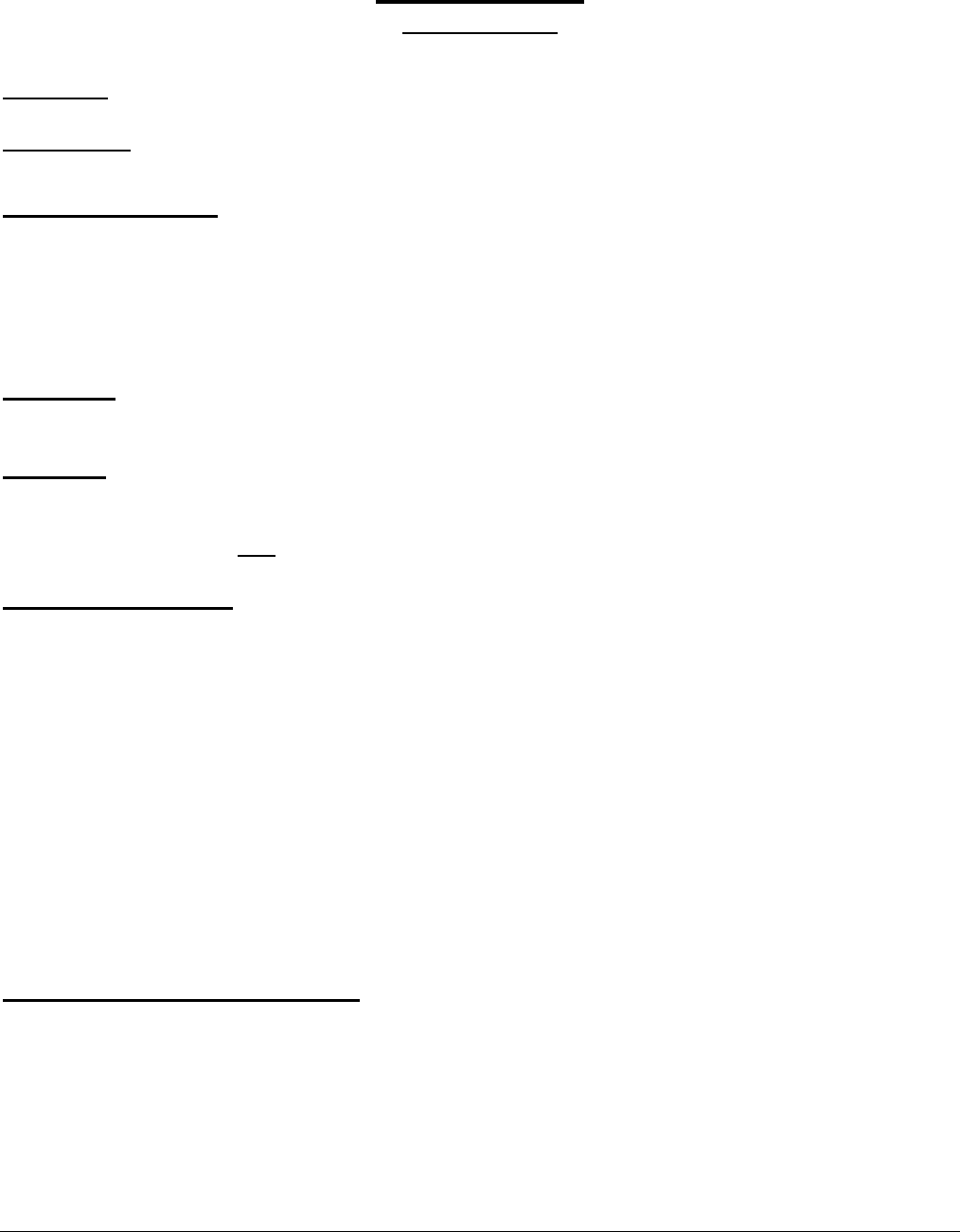
P25/NM24
DEATH TIME
(FARS Only)
FORMAT: 4 numeric
SAS NAME: Person.DEATH_HR; Person.DEATH_MN; Person.DEATH_TM
ELEMENT VALUES:
8888 Not Applicable (Non-fatal)
0000-2359 Valid Military Time
0099-2399 Known Hour but Unknown Minutes
9999 Unknown
Definition: This element identifies the hour and minute of this person’s death utilizing the 24-
hour clock format.
Remarks:
This elements values and remarks are identical to Person Level (MV Occupant) Level element
P25. Please see page 817 for remarks.
Consistency Checks:
IF
(1U2F) INJURY SEVERITY equals 4,
(2U2F) INJURY SEVERITY is not equal to 4,
(3U0P) DEATH DATE equals CRASH DATE,
and CRASH TIME is not equal to
9999,
(4V1F) INJURY SEVERITY equals 4,
(P56P) DIED AT SCENE/EN ROUTE equals
7,
Consistency Check (FARS Only):
IF
(P520) CRASH DATE and DEATH DATE are
the same, and CRASH TIME AND
DEATH TIME are the same,
THEN
DEATH TIME must not equal 8888.
DEATH TIME must equal 8888.
DEATH TIME must not be less than
CRASH TIME.
DEATH DATE and DEATH TIME for this
person must be within 720 hours of the
CRASH DATE and CRASH TIME.
DEATH TIME should be within 30
minutes of the CRASH TIME.
THEN
TRANSPORTED TO FIRST MEDICAL
FACILITY BY should equal 0, and DIED
AT SCENE/EN ROUTE should equal 7.
2015 913

NM25
RELATED FACTORS – PERSON (NOT A MOTOR VEHICLE
OCCUPANT) LEVEL
FORMAT: 2 numeric occurring 3 times
SAS NAME: Person.P_SF1, Person.P_SF2, Person.P_SF3
ELEMENT VALUES:
00 None
*08 Mentally Challenged
09 Construction/Maintenance/Utility Worker
13 Motorized Wheelchair Rider
*18 Mother of Dead Fetus/ Mother of Infant Born Post Crash
*21 Overloading or Improper Loading of Vehicle With Passengers or Cargo
*26 Following Improperly
*37 Traveling on Prohibited Trafficways
*40 Passing Through or Around Barrier
*41 Failure to Observe Warnings or Instructions on Vehicles Displaying Them
*42 Failure to Signal Intentions
*51 Operator Inexperience
*52 Unfamiliar with Roadway
56 Non-Driver Flees Scene
*57 Improper Tire Pressure
Vision Obscured By:
*60 Rain, Snow, Fog, Smoke, Sand, Dust
*61 Reflected Glare, Bright Sunlight, Headlights
*62 Curve, Hill, or Other Design Features (including traffic signs, embankment)
*63 Building, Billboard, Other Structures
*64 Trees, Crops, Vegetation
*65 Motor Vehicle (including load)
*66 Parked Vehicle
*67 Splash or Spray of Passing Vehicle
*68 Inadequate Lighting System
*69 Obstructing Angles on Vehicle
*70 Mirrors
*72 Other Visual Obstruction
Skidding, Swerving, Sliding Due To:
*73 Severe Crosswind
*74 Wind From Passing Truck
*75 Slippery or Loose Surface
*76 Tire Blowout or Flat
*77 Debris or Objects in Road
2015 915

NM25
*78 Ruts, Holes, Bumps in Road
*80 Vehicle in Road
*81 Phantom Vehicle
*82 Pedestrian, Pedal Cyclists, or Other Non-Motorist
*83 Ice, Snow, Slush, Water, Sand, Dirt, Oil, Wet Leaves on Road
Other Non-Motorist Factors:
86 Emergency Services Personnel
87 Police or Law Enforcement Officer
90 Non-Motorist Pushing a Vehicle
91 Portable Electronic Devices
99 Unknown
*FARS ONLY ATTRIBUTES
Definition: This element identifies factors related to persons not in a motor vehicle expressed
by the investigating officer.
Remarks:
Code information provided by the investigating officer associated with this person from
the narrative, contributing factors/circumstances field, or citations/violations section of
the case materials.
This is a nominal list only and does NOT imply a hierarchy. However, if more than three
factors apply to this non-motorist, capture those which cannot be collected elsewhere
in the data.
The following lists those related factors that may be used for each person type (NM7):
Person Valid Related Factors
Type
04 00, 08, 09, 18, 21, 26, 37, 40-42, 51, 52, 56, 57, 60-70, 72-78, 80-83, 87, 91,
99
05 00, 08, 09, 18, 37, 41, 56, 60-67, 72, 86-87, 90, 91, 99
06 00, 08, 18, 21, 26, 37, 40-42, 51, 52, 56, 57, 60-68, 72-78, 80-83, 87, 91, 99
07 00, 08, 18, 21, 26, 37, 40-42, 51, 52, 56, 57, 60-68, 72-78, 80-83, 91, 99
08 00, 08, 13, 18, 21, 26, 37, 40-42, 51, 52, 56, 57, 60-70, 72-78, 80-83, 87, 91,
99
10 00, 08, 13, 18, 26, 86, 87, 99
19 00, 08, 09, 18, 21, 26, 37, 40-42, 51, 52, 56, 57, 60-68, 72-78, 80-83, 86, 87,
91, 99
00 (None) is used when no applicable related factors are noted in the crash report. Zero-
fill all fields. Also, use 00 (None) to complete the remaining fields when you will be recording
less than three non-motorist related factors. DO NOT leave any remaining fields blank.
916 2015

NM25
*08 (Mentally Challenged) is used when the case materials identify that the non-motorist
has a documented mental illness or intellectual disorder noted by the officer.
09 (Construction/Maintenance/Utility Worker) is used when the case materials identify
that this was a non-motorist working with the highway department, a contractor or a
utility company at the time of the crash.
13 (Motorized Wheelchair Rider) is used when the case materials identify the non-
motorist is in a motorized wheelchair (personal conveyance).
*18 (Mother of Dead Fetus/Mother of Infant Born Post Crash) is used when the case
materials identify that this non-motorist is the mother of a fetus that died in or as a
result of this crash or it is identified that this non-motorist gave birth after the crash
whether the child survives or not. Note that for crash classification purposes, a fetus is
considered to be part of a pregnant woman rather than a separate individual and, thus,
is not counted as a separate person in the crash.
*21 (Overloading or Improper Loading of Vehicle with Passengers or Cargo) is used
when the case materials describe more than one non-motorist is occupying one seating
position at the time of the crash. For example, overloading a bicycle with a passenger
riding on the handlebars.
*26 (Following Improperly) is used when the case materials identify that this non-
motorist was following a bicyclist, motor vehicle, non-motor vehicle transport device or
person on a personal conveyance too closely as to create a dangerous situation.
Examples include:
A non-motorist (bicyclist, skateboard rider, roller blader, etc.) that attempts to
grab on to a motor vehicle that is in-transport.
A bicyclist is following a vehicle so closely that as it passes or takes an
avoidance maneuver around one vehicle going in the same direction as the
bicyclist, the bicyclist strikes the rear of the vehicle it was attempting to pass or
the rear of a another vehicle in the adjacent lane also going the same direction.
*37 (Traveling on Prohibited Trafficways) is used when the case materials identify that
this non-motorist was traveling on an open trafficway that prohibited travel for their mode
of transportation. This applies to all forms of pedestrian travel (skateboard riders, roller
bladers, etc.), as well as horseback riders, carriages, bicyclists, etc.
*40 (Passing Through or Around Barrier) is used when the case materials identify this
non-motorist was traveling through or around a "demarcated" area to be in a prohibited
area (street closed for a parade, construction, sidewalk closed, etc.).
2015 917

NM25
*41 (Failure to Observe Warnings or Instructions on Vehicles Displaying Them) is used
when the case materials identify this non-motorist failed to heed warnings or follow
instructions displayed on other vehicles.
Examples include:
A non-motorist failed to follow construction instructions (e.g., arrows directing traffic
mounted on a vehicle) or instructions on emergency vehicles (ambulances, fire trucks,
police cars).
A non-motorist failed to observe right-turn warning on a truck or buses.
A bicyclist failed to heed hazard lights on a disabled vehicle.
A child failed to walk around the school bus arm that was extended into the travel
lane that permitted the bus driver to see the child in the roadway.
*42 (Failure to Signal Intentions) is used when the case materials identify this non-
motorist failed to signal their intentions as required. This attribute includes a failure to
signal by either lamp turn signal or hand.
*51 (Operator Inexperience) is used when the case materials identify this non-motorist’s
(horseback rider, skate boarder, bicyclist without training wheels, etc.) lack of
experience contributed to their involvement. Should be expressed by officer and not
presumed based on age.
*52 (Unfamiliar with Roadway) is used when the case materials identify this non-
motorist’s (horseback rider, skate boarder, bicyclist without training wheels, etc.) lack
of familiarity with the area/location where the crash occurred contributed to their
involvement. Should be expressed by officer and not presumed based on age.
56 (Non-Driver Flees Scene) is used when the case materials identify this non-motorist
left the scene of a Hit-and-Run crash.
Examples Include:
A bicyclist clipped by a vehicle that runs off the road and overturns, leaves the scene on
their bike.
A pedestrian is pushing an occupied wheelchair, which is struck by a motor
vehicle. The pedestrian panics and flees the scene.
*57 (Improper Tire Pressure) is used when the case materials identify that improper tire
pressure was present on one or more tires of a bicycle, non-motor vehicle transport
device or personal conveyance in use by this non-motorist. It signifies that improper tire
pressure is not a defect, but rather the irresponsibility of this person.
Vision Obscured By:
The following set of attributes identifies visual obstructions noted in the case materials
applicable to this non-motorist.
918 2015

NM25
*60 (Rain, Snow, Fog, Smoke, Sand, Dust)
*61 (Reflected Glare, Bright Sunlight or Headlights)
*62 (Curve, Hill or Other Design Features [including traffic signs, embankment])
*63 (Building, Billboard or Other Structures)
*64 (Trees, Crops or Vegetation)
*65 (Motor Vehicle [including load])
Examples include:
A car stopped on the roadway.
A tractor-trailer in-transport on the road.
A school bus stopped for the purpose of loading and/or unloading children.
*66 (Parked Vehicle)
*67 (Splash or Spray of a Passing Vehicle)
*68 (Inadequate Lighting System)
*69 (Obstructing Angles on the Vehicle) is used when the case materials identify
obstructing angles on this person's vehicle. This attribute should not to be confused with visual
obstructions from other vehicles. (See 65 (Motor Vehicle [including load]) and 66 (Parked
Vehicle).
*70 (Mirrors) is used when the case materials identify that this non-motorist’s vision
was obscured by any type of mirror.
*72 (Other Visual Obstruction) is used when the case materials identify that this non-
motorist’s vision was obscured by something other than previously listed. For
example, a trailer that has been left parked on the side of the road by a truck or vehicle.
Skidding, Swerving, Sliding Due To:
This set of attributes is applicable to the non-motorist that attempted to avoid one of the
following or whose control loss was related to one of the following.
*73 (Severe Crosswind) is used when the case materials identify this non-motorist’s
control loss was related to severe crosswinds.
*74 (Wind From Passing Truck) is used when the case materials identify this non-
motorist’s control loss was related to winds produced by a passing truck.
2015 919

NM25
*75 (Slippery or Loose Surface) is used when the case materials identify this non-
motorist’s control loss was related to the surface composition of the roadway and/or
the condition of that composition. Not to be used when the surface is slippery due to
environment conditions such as rain, ice or snow (see 83 (Ice, Snow, Slush, Water,
Sand, Dirt, Oil or Wet Leaves on Road).
Examples include:
A slippery surface that is old or worn resulting in loose gravel on the roadway.
Blacktop that is slick as a newly paved surface.
*76 (Tire Blowout or Flat) is used when the case materials identify this non-motorist’s
control loss was related to a tire blowout or flat.
*77 (Debris or Objects in Road) is used when the case materials identify this non-
motorist attempted to avoid or lost control as a result of debris in the road. Examples
would include: nails, glass, trash cans, tire retread, trash, dead animals, pile of sand,
barricades, etc.
*78 (Ruts, Holes, Bumps in Road) is used when the case materials identify this non-
motorist attempted to avoid or lost control as a result of a road surface anomalies such
as ruts, holes, dips or bumps.
*80 (Vehicle in Road) is used when the case materials identify this non-motorist
attempted to avoid or lost control as a result of another vehicle in the road. This
includes both contact and non-contact vehicles that remain at the scene.
*81 (Phantom Vehicle) is used when the case materials identify this non-motorist
attempted to avoid or lost control as a result of a non-contact vehicle that left the scene as
described by the police officer.
*82 (Pedestrian, Pedal Cyclist, or Other Non-Motorist) is used when the case materials
identify this non-motorist attempted to avoid or lost control as a result of a pedestrian, a
pedal cyclist (bicyclist) or other type of non-motorist.
*83 (Ice, Snow, Slush, Water, Sand, Dirt, Oil or Wet Leaves on Road) is used when the
case materials identify this non-motorist’s control loss was related to a substance on the
roadway that caused the roadway to be slick, which may interfere with the traction of the
vehicle. This attribute does not include part of the roadway composition. For cases
involving roadway composition issues, see 75 (Slippery or Loose Surface).
Other Non-Motorist Factors:
86 (Emergency Services Personnel) is used when the case materials identify that this
non-motorist was a fire fighter, wrecker service worker or Emergency Medical Service
(EMS) personnel.
920 2015

NM25
87 (Police or Law Enforcement Officer) is used when the case materials identify that this
non-motorist was a police or law enforcement officer working at the time of the crash.
The officer may be affiliated at the Federal, State or local law enforcement level. This
would also include: military and park police, border patrol officers and all other sworn
law enforcement officers.
90 (Non-Motorist Pushing a Vehicle) is used when the case materials identify the non-
motorist was pushing a vehicle.
91 (Portable Electronic Devices) is used when the case materials identify that this non-
motorist was using an electronic device (Cell phone, MP3 Player, PDA, etc.) that was
somehow related to the crash occurrence.
99 (Unknown) is used when the circumstances surrounding the crash are unknown and
reported as “unknown” by the investigating officer. In these circumstances, nine-fill all fields. If
99 (Unknown) is used for any field, ALL fields must be 99 (Unknown). DO NOT leave any
remaining fields blank.
Consistency Checks:
IF THEN
(1M1F) RELATED FACTORS-PERSON PERSON TYPE should equal 08.
LEVEL equals 13,
(1N0F) PERSON TYPE equals 06, RELATED FACTORS-PERSON LEVEL
(Not a MV Occupant) must not equal 09,
13, 69, 70, 86, 90.
(1N1F) PERSON TYPE equals 10, RELATED FACTORS-PERSON LEVEL
(Not a MV Occupant) must not equal 09,
21, 37, 40-42, 51, 52, 56, 57, 60-70,
72-78, 80-83, 90, 91.
(1W0P) any RELATED FACTORS-PERSON all factors must equal 99.
LEVEL equals 99,
(2W0P) any RELATED FACTORS-PERSON all factors must equal blanks.
LEVEL equals blanks,
(3W0P) any RELATED FACTORS-PERSON all subsequent factors must equal 00.
LEVEL equals 00,
(4W1P) A RELATED FACTORS-PERSON LEVEL (Not a MV Occupant) between 08 and
91 can be used only once per person form.
(8M0F) PERSON TYPE equals 04, RELATED FACTORS-PERSON LEVEL
(Not a MV Occupant) must not equal 13,
86, 90.
(8Q0F) PERSON TYPE equals 08, RELATED FACTORS-PERSON LEVEL
must not equal 09, 86, 90.
2015 921

NM25
IF THEN
(9M0F) PERSON TYPE equals 05, RELATED FACTORS-PERSON LEVEL
(Not a MV Occupant) must not equal 13,
21, 26, 40, 42, 51, 52, 57, 68-70, 73-83,
88.
(CK0P) PERSON TYPE equals 07, RELATED FACTORS-PERSON LEVEL
(Not a MV Occupant) must not equal 09,
13, 69, 70, 86, 87, 90.
(CM0P) PERSON TYPE equals 19, RELATED FACTORS-PERSON LEVEL
(Not a MV Occupant) must not equal 13,
69, 70, 90.
Consistency Check (FARS Only):
IF THEN
(5W0P) RELATED FACTORS-PERSON SEX must equal 2, and AGE must be
LEVEL equals 18, greater than 012.
922 2015

2015 925
SP1
DEATH CERTIFICATE NUMBER
(FARS Only)
FORMAT: Element Completed in MDE
SAS NAME: Person.CERT_NO
ELEMENT VALUES:
0s Not Applicable (not a fatality)
Any Numeric Characters
9s Unknown
Definition: This element identifies the four digit GSA code for the City where the death
occurred, the two digit state number and the six digit sequence number from the death
certificate as assigned by the State Vital Statistics or Vital Records Department.
Remarks:
Code the sequence number from the death certificate as assigned by your State Vital Statistics
Department. The sequence number is six digits in length and is part of the State File Number.
The format for coding the numbers is as follows:
First four digits _ _ _ _ City (where death occurred)
Next two digits _ _ State (where death occurred)
Last six digits _ _ _ _ _ _ Sequence Number (as assigned by State Vital Statistics
Department)
If this person is not a fatality, zero-fill this element.
Use GSA codes for the City and State where the death occurred according to the death
certificate. These are the same GSA codes you use for the City variables in the Crash Level
Form:
0000 Not a fatality or death not within city limits and no location code is available
0001-9996 GSA Geographical Location Codes
9997 Other (Death within city limits, but no GSA code available for this city)
9999 Unknown (City where death occurred cannot be found on death certificate).
The State codes are the same those you use for variables C1, V1, D1, PC1, P1 and NM1:
00 Not a fatality 30 Montana
01 Alabama -
02 Alaska -

SP1
- -
- -
- -
- -
29 Missouri 56 Wyoming
If the fatal crash occurred in your State, but the death occurred in a hospital of another State,
please attempt to obtain the death certificate from that State and code the City and State
where the death occurred.
If a person dies at the crash scene, code the appropriate city code or location code for the
crash location. Code “0000” if the location is not within a city, and no geographical location
code is available.
If the location is not within a city, but a geographical location code is available, use the location
code.
If a person is transported by EMS and dies en-route or at the hospital, use the city code for the
hospital’s location.
Code the exact sequence number as indicated on the death certificate. If the sequence
number is less than six-digits long (e.g., it is 12345 (five digits)) right-justify your coded number
and zero-fill the first (and/or second digit) (e.g., _0_ _1_ _2_ _3_ _4_ _5_).
Note that if you receive a copy of the death certificate from the Medical Examiner or Coroner, it
may not contain the sequence number. The sequence number needed is the one assigned by
your State Vital Statistics or Vital Records Department, which is subsequently sent to the
National Center for Health Statistics. In those instances, leave the sequence number blank
until you are able to obtain it in a follow-up effort with your Vital Statistics Department.
If the sequence number contains a letter in it (e.g., N12345), simply ignore the letter and code
the numbers only (right-justified), (e.g., _0_ _1_ _2_ _3_ _4_ _5_).
If the death certificate number cannot be obtained, “9-fill” this element.
If the death certificate number can be obtained, but is not yet received, leave this element
blank until the number is available.
Consistency Checks:
IF THEN
(7E0P) INJURY SEVERITY equals 4, DEATH CERTIFICATE NUMBER must
NOT equal 0000-00-000000.
(7F0P) DEATH CERTIFICATE NUMBER is INJURY SEVERITY must equal 4.
not blank or 0000-00-000000,
926 2015

SP2
FATAL INJURY AT WORK
(FARS Only)
FORMAT: 1 numeric
SAS NAME: Person.WORK_INJ
ELEMENT VALUES:
0 No
1 Yes
8 Not Applicable (not a fatality)
9 Unknown
Definition: This element indicates if the death certificate identified this person as being "at work"
at the time of the crash.
Remarks:
THIS ELEMENT DOES NOT APPEAR ON THE CODING FORMS. It is presented on-screen by
the M.D.E. System.
THE DEATH CERTIFICATE ALSO INDICATES WHETHER THE VICTIM WAS ON-THE-JOB AT
THE TIME OF FATAL INJURY.
0 (No) is used if the injury was not at work.
1 (Yes) is used if the injury was on the job.
8 (Not Applicable (not a fatality)) is used if the victim was not a fatality use.
9 (Unknown) is used if the death certificate does not indicate whether the injury was at work or if
you do not have access to death certificate information
FATAL INJURY AT WORK SHOULD ONLY BE DETERMINED FROM THE DEATH
CERTIFICATE, NOT FROM ANY OTHER SOURCE. HOWEVER, IT IS NOT NECESSARY TO
HAVE A COPY OF THE DEATH CERTIFICATE.
Consistency Checks:
IF THEN
(7R0P) FATAL INJURY AT WORK equals INJURY SEVERITY must equal 4.
0, 1, 9,
(7W0P) FATAL INJURY AT WORK equals 8, INJURY SEVERITY must not equal 4.
2015 927

SP2
IF THEN
(P1A0)
(P130)
AGE is less than 012, and INJURY
SEVERITY equals 4,
BODY TYPE equals 60-67, 71, 72,
78, 79, and PERSON TYPE equals
01, 03, and INJURY SEVERITY
equals 4,
FATAL INJURY AT WORK should equal
0.
FATAL INJURY AT WORK should equal
1.
928 2015

2015 929
SP3
RACE/HISPANIC ORIGIN
(FARS Only)
FORMAT: 2 numeric
SAS NAME: Person.RACE, Person.HISPANIC
ELEMENT VALUES:
Detail Race:
00 Not a Fatality (not applicable)
01 White
02 Black
03 American Indian (includes Aleuts and Eskimos)
04 Chinese
05 Japanese
06 Hawaiian (includes part-Hawaiian)
07 Filipino
18 Asian Indian
19 Other Indian (includes South and Central America, any others, except American or
Asian Indians)
28 Korean
38 Samoan
48 Vietnamese
58 Guamanian
68 Other Asian or Pacific Islander
78 Asian or Pacific Islander, No Specific (individual) Race
97 Multiple Races (Individual races not specified; ex. “mixed” )
98 All Other Races
99 Unknown
Hispanic Origin:
00 Not a Fatality (not applicable)
01 Mexican
02 Puerto Rican
03 Cuban
04 Central or South American
05 European Spanish
06 Hispanic, Origin not Specified or Other Origin
07 Non-Hispanic
99 Unknown
Definition: This element indicates the race and Hispanic origin of this person from the death
certificate.

SP3
Remarks:
Race and Hispanic Origin should be obtained from the death certificate only.
THIS ELEMENT DOES NOT APPEAR ON THE CODING FORMS: It is presented on-screen
by the M.D.E. System.
Both RACE and HISPANIC ORIGIN are coded for fatal victims only (INJURY SEVERITY on
this person must be Fatal Injury). If INJURY SEVERITY is coded other than Fatal Injury on
the Person Level, the M.D.E. System will automatically enter “00’s” in both the RACE and
HISPANIC ORIGIN fields.
In general, the actual race will be written literally (i.e., white, black, Chinese, etc.) on the death
certificate. Hispanic Origin comes directly from a check box. Within that box, if Hispanic Origin
is “yes” a specific location (i.e., Cuba, Puerto Rico or Mexico) is indicated.
For translating the entries on the death certificate, refer to the table, “Detail Race and Hispanic
Origin for FARS.” This table is based on the guidelines provided by the Center for Disease
Control (CDC). The only exception is Hawaiian. Any race with Hawaiian is coded Hawaiian
(See Hawaiian).
DETAIL RACE
01 (White) should be coded for persons listed as White, Mexican, Puerto Rican, Cuban and
Caucasian for race.
06 (Hawaiian [includes part Hawaiian]) should be coded for any person listed as Hawaiian,
even if another race is listed as well.
19 (Other Indian) includes South and Central America and any other Indians, except
American or Asian Indians.
68 (Other Asian or Pacific Islander) is used when an “Other Asian” or “Pacific Island” race is
specified, and it is other than 04 (Chinese), 05 (Japanese), 06 (Hawaiian), 07 (Filipino), 18
(Asian Indian), 28 (Korean), 38 (Samoan), 48 (Vietnamese), or 58 (Guamanian).
78 (Asian or Pacific Islander, No Specific [individual] Race) is used when the death
certificate or report lists “Asian” for race.
97 (Multiple Races) is used when the death certificate indicates more than one race without
specifying the individual races (e.g., “mixed,” “multiple races,” “multi-racial,” etc.)
98 (All Other Races) is used if an individual race listed on the death certificate or report is not
found on the translation table
930 2015

2015 931
SP3
If more than one race is listed on the death certificate or report, code the race entry listed first.
An example is “American Indian/White,” which should be coded 03 (American Indian). Again,
06 (Hawaiian) is the exception. (See 06 (Hawaiian).)
HISPANIC ORIGIN
06 (Hispanic Origin Not Specified, or Other Origin). This includes when you know they are
Hispanic, but the specific origin is not specified (e.g., Hispanic, Latino, Latin American, South
American).
99 (Unknown). This person could be Hispanic, or not. You don’t have enough information to
determine whether or not they are Hispanic. (E.g., all you know is that Race is “White,” “Black,”
“European,” or “Indian,” and no other information is provided.)
If you receive a listing from the Vital Statistics Department, be sure you request a translation
table for the code structure. For FARS, we tried to match the coding structure to the National
Center for Health Statistics (NCHS) coding structure for these elements; however, it was
necessary to modify NCHS’s structure slightly in order to be consistent with other FARS
codes. (Reference: National Center for Health Statistics. Documentation for the Mortality
Public Use Data Set, 1999. Available at URL:
http://www.cdc.gov/nchs/data/dvs/Mort99doc.pdf.
Consistency Checks:
IF THEN
(7E1P) INJURY SEVERITY equals 4, RACE must not equal 00.
(7E2P) INJURY SEVERITY equals 4, HISPANIC ORIGIN must not equal 00.
(7E3P) INJURY SEVERITY does not equal 4, RACE AND HISPANIC ORIGIN must
equal 00.
(7F1P) RACE equals 00, INJURY SEVERITY must not equal 4.
(7F2P) HISPANIC ORIGIN equals 00, INJURY SEVERITY must not equal 4.
(7F3P) RACE is not equal to 00, and INJURY SEVERITY must equal 4.
HISPANIC ORIGIN is not equal to 00,
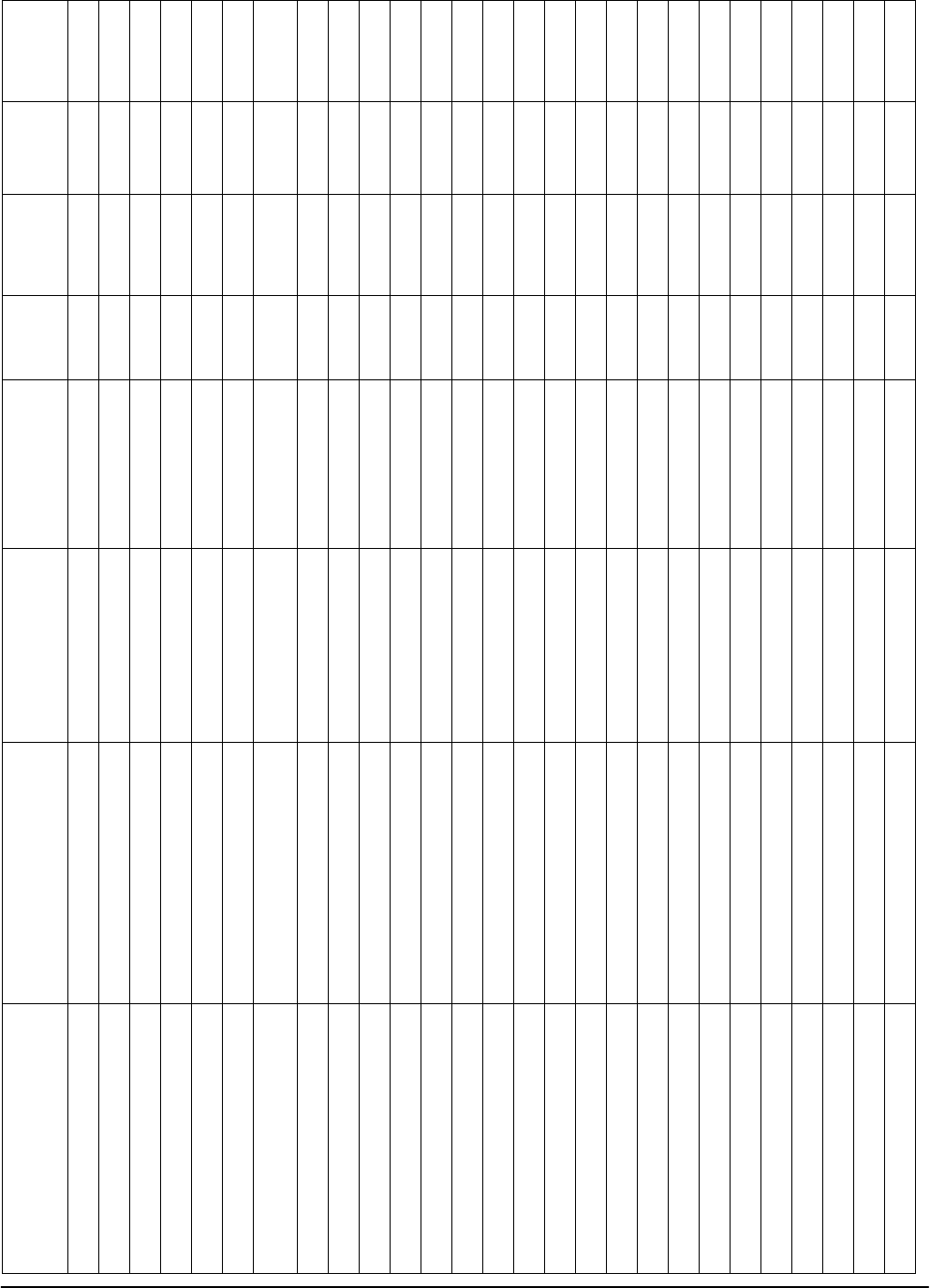
DETAIL RACE AND HISPANIC ORIGIN FOR FARS
Race (CDC) Ancestry/
Ethnicity (CDC) Country Region CDC
Race*
CDC
Ethnic*
FARS
Detail
Race
FARS
Hispanic
Origin
Aryan 1 -- 01 99
Asian Asian 9 22 78 07
Asian Indian Asian Indian 9 21 18 07
Asiatic 9 -- 78 07
Assyrian Assyrian 1 22 01 07
Athapaskan 3 -- 03 07
Australian Australian Australia Australasia &
Pacific 1 20 01 07
Austrian Austrian Austria Europe 1 16 01 07
Azerbiajan Europe -- -- 01 07
Azores Azorean Azores Europe 1 19 01 07
Bahamian Bahamian Bahamas 6 99 98 07
Bahrain Bahrain Middle East -- 22 01 07
Baleanc Islands -- 05 01 05
Bangladeshi Bangladesh Bangladesh Asia 9 21 68 07
Barbados -- -- 02 07
Basque Basque 1 05 01 05
Bavarian Bavarian 1 16 01 07
Belgian Belgium Europe -- 16 01 07
Belizian Belizian Belize Central America 6 04 98 04
Belorussian, Byelorussian Belarus Europe -- 18 01 07
Bengali Bengali 6 21 98 07
Benin Benin Africa -- 24 99 07
Bermudan Bermuda -- 15 99 07
Bhutanese Bhutan Asia -- 21 68 07
Bilatian Bilatian Africa 2 24 02 07
Black Black 2 24 02 07
Blanc 1 -- 01 99
* SEE NATIONAL CENTER FOR HEALTH STATISTICS (NCHS) CODES
932 2015
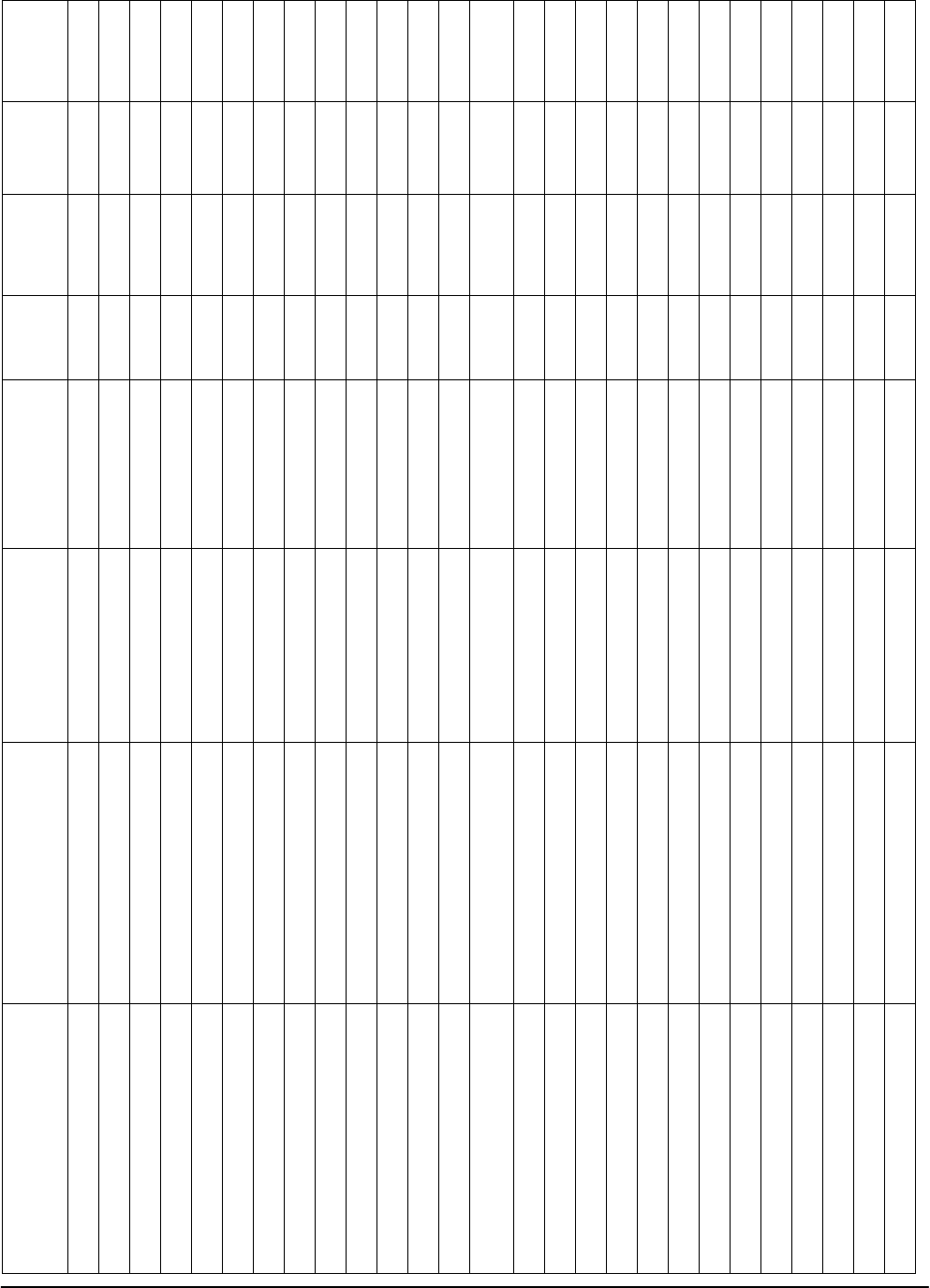
DETAIL RACE AND HISPANIC ORIGIN FOR FARS
Race (CDC) Ancestry/
Ethnicity (CDC) Country Region CDC
Race*
CDC
Ethnic*
FARS
Detail
Race
FARS
Hispanic
Origin
Bohemian Bohemian 1 18 01 07
Bolivian Bolivia (Boliviano) Bolivia South America 1 04 01 04
Boricua (Borinquano) -- 05 99 05
Bosnia-Herzegovna Europe -- -- 01 07
Botswana Botswana Africa -- 24 99 07
Brava (Bravo) 1 -- 01 99
Brazilian Brazilian Brazil South America 1 15 01 04
British -- 08 99 07
British Honduran (See Belize) 0 -- 98 04
Brown 2 -- 02 99
Brunei Asia -- -- 68 07
Bulgarian Bulgaria Europe -- 18 01 07
Burkina Faso Africa -- -- 99 07
Burmese Burmese Burma (Also
Myanmar) Asia 9 20 68 07
Burundi Burundi Africa -- 24 99 07
Cajun Cajun 1 15 01 07
California -- 05 99 05
Cambodian Cambodian Cambodia Asia 9 20 68 07
Cameroon Cameroon Africa -- 24 99 07
Canadian Canadian Canada North America 1 15 01 07
Canadian Indian 3 -- 03 07
Canadian Mexican 3 -- 03 01
Canary Islands -- 05 99 05
Cantonese -- 20 78 07
Cape Verde Cape Verdean Cape Verde Africa 2 24 02 07
Carib 6 -- 98 99
Castillan -- 05 01 05
* SEE NATIONAL CENTER FOR HEALTH STATISTICS (NCHS) CODES
2015 933
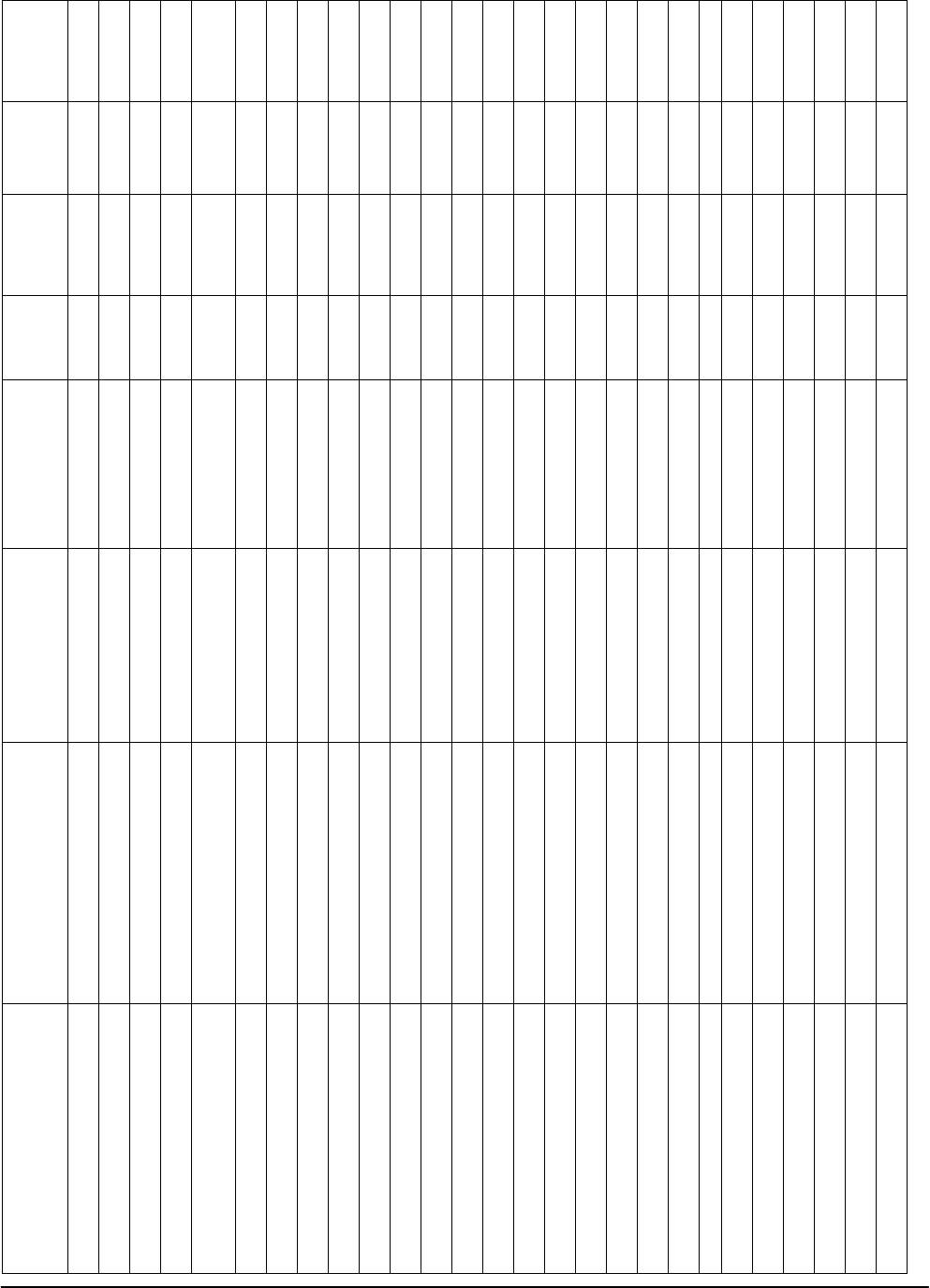
DETAIL RACE AND HISPANIC ORIGIN FOR FARS
Race (CDC) Ancestry/
Ethnicity (CDC) Country Region CDC
Race*
CDC
Ethnic*
FARS
Detail
Race
FARS
Hispanic
Origin
Catalonia -- 05 01 05
Caucasian Caucasian 1 99 01 07
Cayman Islands -- -- 99 99
Celltic -- 08 01 07
Central African Republic Central African
Republic Africa -- 24 02 07
Central European -- 99 99 99
Centroamericano -- 04 99 04
Ceylonese Ceylonese 9 21 68 07
Chad Chad Africa -- 24 99 07
Chamorro Chamorro 9 20 68 07
Chicano Chicano 1 01 01 01
Chicano/Mex/American 1 -- 01 01
Chile (Chilano) Chile South American -- 04 01 04
Chinese Chinese China Asia 4 20 04 07
Chinese/White 4 -- 04 99
Colombian Colombia (Colombiano) Colombia South America 1 04 01 04
Colored 2 -- 02 99
Comoros Africa -- -- 99 07
Congolese Congo (Republic of) Africa -- 24 99 07
Costa Rican Costa Rica (Constarricense) Costa Rica Central America 1 04 01 04
Creole Creole 1 16 01 99
Croatian Croatia Europe -- 19 01 07
Crucian 1 -- 01 99
Cuban Cuban Cuba 1 03 01 03
Cypriot Cyprus Europe -- 22 01 07
Czechoslovakian Czechoslovakian Czech Republic Europe 1 18 01 07
Dahomey Africa -- 24 02 07
* SEE NATIONAL CENTER FOR HEALTH STATISTICS (NCHS) CODES
934 2015
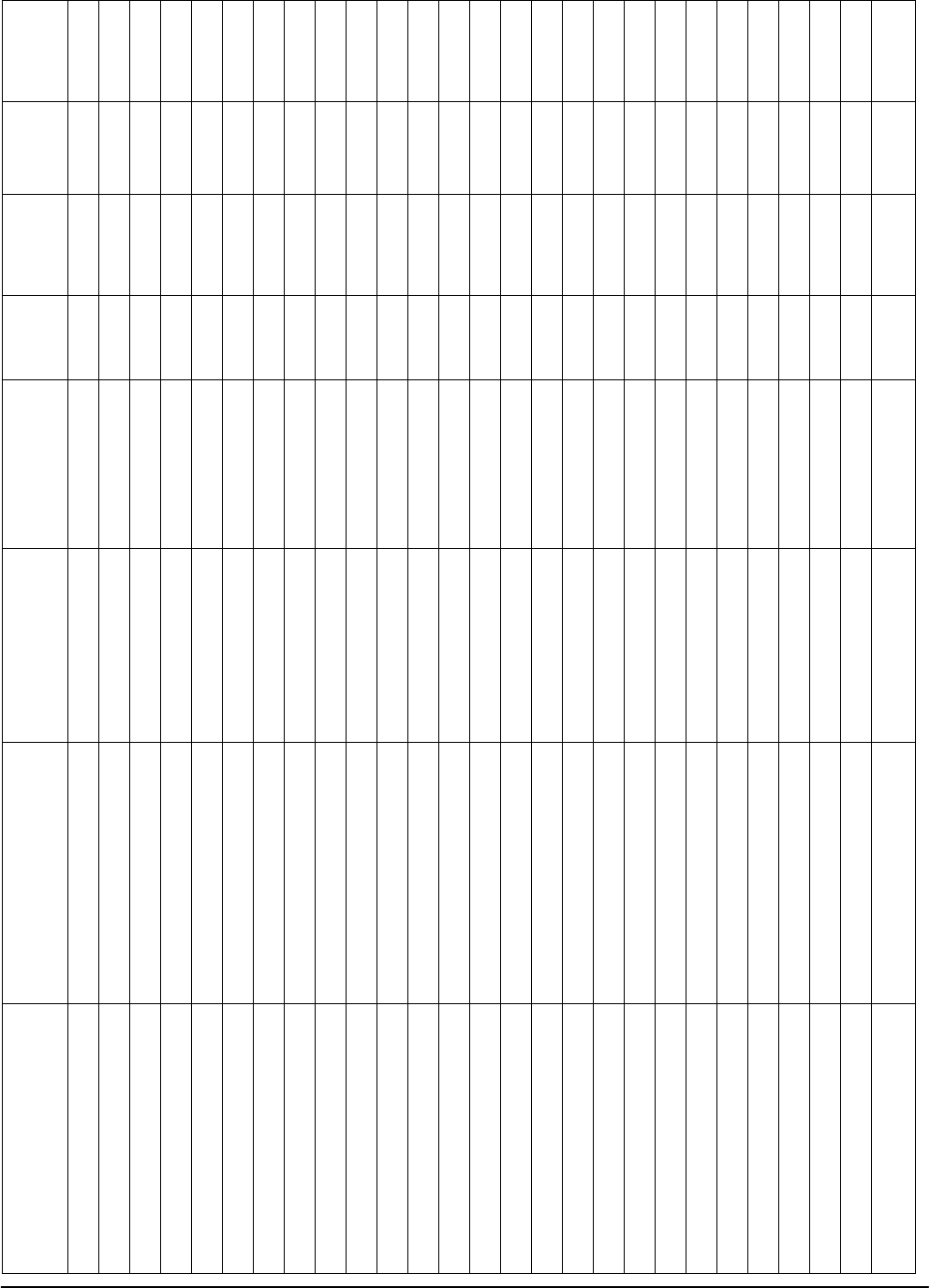
DETAIL RACE AND HISPANIC ORIGIN FOR FARS
Race (CDC) Ancestry/
Ethnicity (CDC) Country Region CDC
Race*
CDC
Ethnic*
FARS
Detail
Race
FARS
Hispanic
Origin
Danish Danish Denmark Europe 1 12 01 07
Djibouti Africa -- -- 99 07
Dominica -- -- 99 99
Dominican Dominican Republic Dominican Republic 2 04 02 04
Dutch Netherlands Europe -- 16 01 07
Dutch East Indian 9 -- 68 99
East Indian East Indian 9 20 68 07
Eastern European -- 18 99 07
Ebian 1 -- 01 99
Ecuadorian Ecuador (Ecuatoriano) Ecuador South America 1 04 01 04
Egyptian Egyptian Egypt North Africa 1 23 01 07
El Salvador El Salvador Central America -- 04 98 04
English English 1 08 01 07
England Europe -- -- 99 99
English-French Europe 1 -- 01 07
English-Irish Europe 1 -- 01 07
Equatorial Guinea Equatorial Guinea Africa -- 24 99 07
Eritrean Eritrea Africa 2 -- 02 07
Eskimo, Eskimoan Eskimo, Eskimoan 3 07 03 07
Espana, (Espanol) -- 05 01 05
Estonian Estonia Europe -- 18 01 07
Ethiopia(n) Ethiopian Ethiopia Africa 2 24 02 07
Eurasian Eurasian 9 22 78 99
European European 1 99 01 99
Falkland Islands Falkland Islands South America -- 04 01 07
Fernando PO -- 05 99 05
Fijan Fijan Fiji Australasia &
Pacific 9 20 68 07
* SEE NATIONAL CENTER FOR HEALTH STATISTICS (NCHS) CODES
2015 935
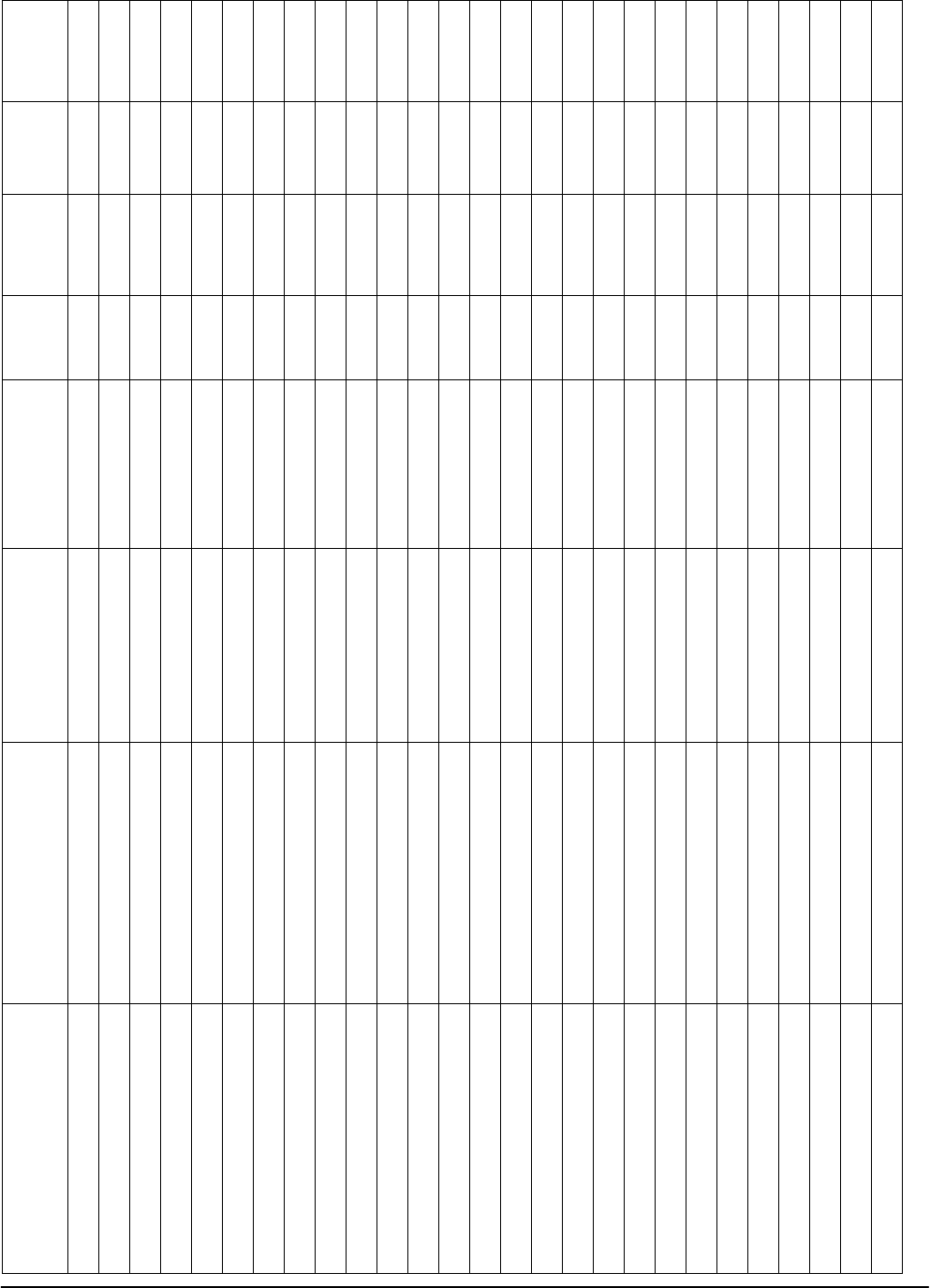
DETAIL RACE AND HISPANIC ORIGIN FOR FARS
Race (CDC) Ancestry/
Ethnicity (CDC) Country Region CDC
Race*
CDC
Ethnic*
FARS
Detail
Race
FARS
Hispanic
Origin
Filipino Filipino Philippines Asia 8 20 07 07
Finnish Finnish Finland Europe 1 17 01 07
Flemish Europe -- 16 01 07
Franco American -- 11 99 07
French French France Europe 1 11 01 07
French Canadian French Canadian 1 15 01 07
French Guiana -- -- 99 99
French Indian (American) French Indian 3 07 03 07
French Indian (India) 9 -- 18 07
French Polynesia -- -- 68 07
Gabonese Gabon Africa -- 24 99 07
Galapagos Islands -- 04 01 04
Gambian Gambia Africa -- 24 99 07
Georgian Georgia Europe -- 18 01 07
German German Germany Europe 1 10 01 07
Ghanaian Ghanaian Ghana Africa 2 24 02 07
Gilbertese 9 -- 68 07
Great Russian -- 18 01 07
Greek Greek Greece Europe 1 19 01 07
Greenland Greenland -- 15 99 07
Grenada -- -- 02 07
Guadeloupe -- -- 99 99
Guamanian Guamanian Guam 9 20 58 07
Guatemalan Guatemala (Guatemalteco) Guatemala Central America 6 04 98 04
Guinean Guinea Africa -- 24 99 07
Guinea-Bissau Africa -- -- 99 07
Guyanese Guyanaq Guyana South America 0 15 99 07
* SEE NATIONAL CENTER FOR HEALTH STATISTICS (NCHS) CODES
936 2015
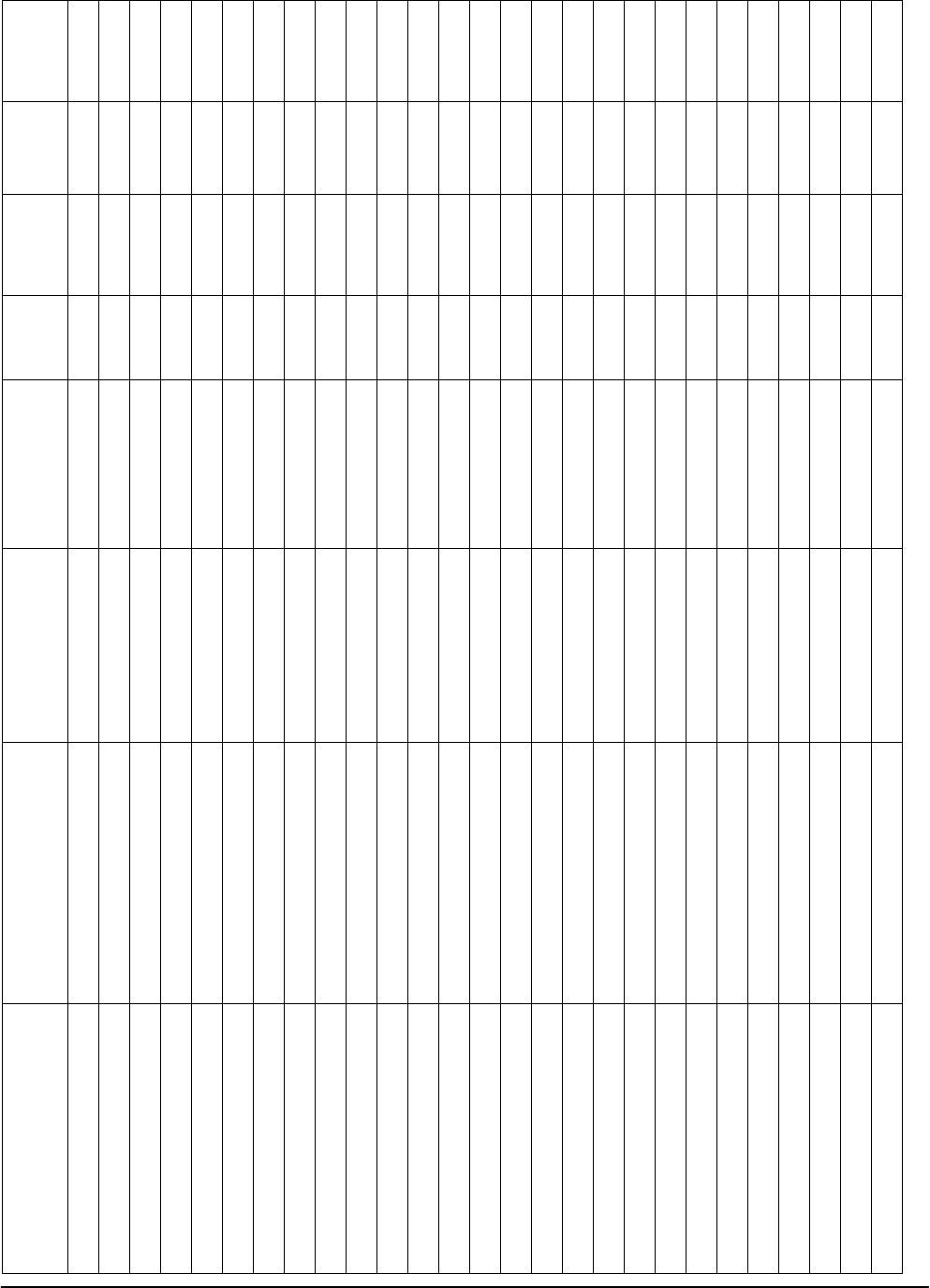
DETAIL RACE AND HISPANIC ORIGIN FOR FARS
Race (CDC) Ancestry/
Ethnicity (CDC) Country Region CDC
Race*
CDC
Ethnic*
FARS
Detail
Race
FARS
Hispanic
Origin
Gypsy Gypsy 1 22 01 07
Haitian Haitian Haiti 2 15 02 07
Hamitic 2 -- 02 07
Hawaiian Hawaiian 7 20 06 07
Hawaiian/Part Hawaiian 7 -- 06 07
Hebrew Hebrew 1 22 01 07
Hindu Hindu 9 21 78 07
Hispanic Hispanio 1 05 01 06
Hmong Hmong 9 20 68 07
Honduran Honduras (Hondureno) Honduras Central America 6 04 98 04
Hong Kong Hong Kong Asia -- 20 78 07
Hungarian Hungarian Hungary Europe 1 18 01 07
Iberian (Ibero) -- 05 01 05
Icelandic Icelandic Iceland Europe 1 17 01 07
India 9 -- 18 07
Indian (From India) Indian (From India) India Asia 9 21 18 07
Indian (American) 3 -- 03 07
Indian (Argentina) 6 -- 98 04
Indian (AM,AK,CN,MX) 3 -- 03 99
Indo-Aryan 9 -- 78 07
Indonesian Indonesian Indonesia Asia 9 20 68 07
Iran(ian) Iranian Iran Middle East 1 22 01 07
Iraqi Iraqi Iraq Middle East 1 22 01 07
Irish Irish Ireland Europe 1 09 01 07
Islamic 1 -- 01 07
Israelite Israeli Israel Middle East 1 22 01 07
Italian Italian Italy Europe 1 14 01 07
* SEE NATIONAL CENTER FOR HEALTH STATISTICS (NCHS) CODES
2015 937
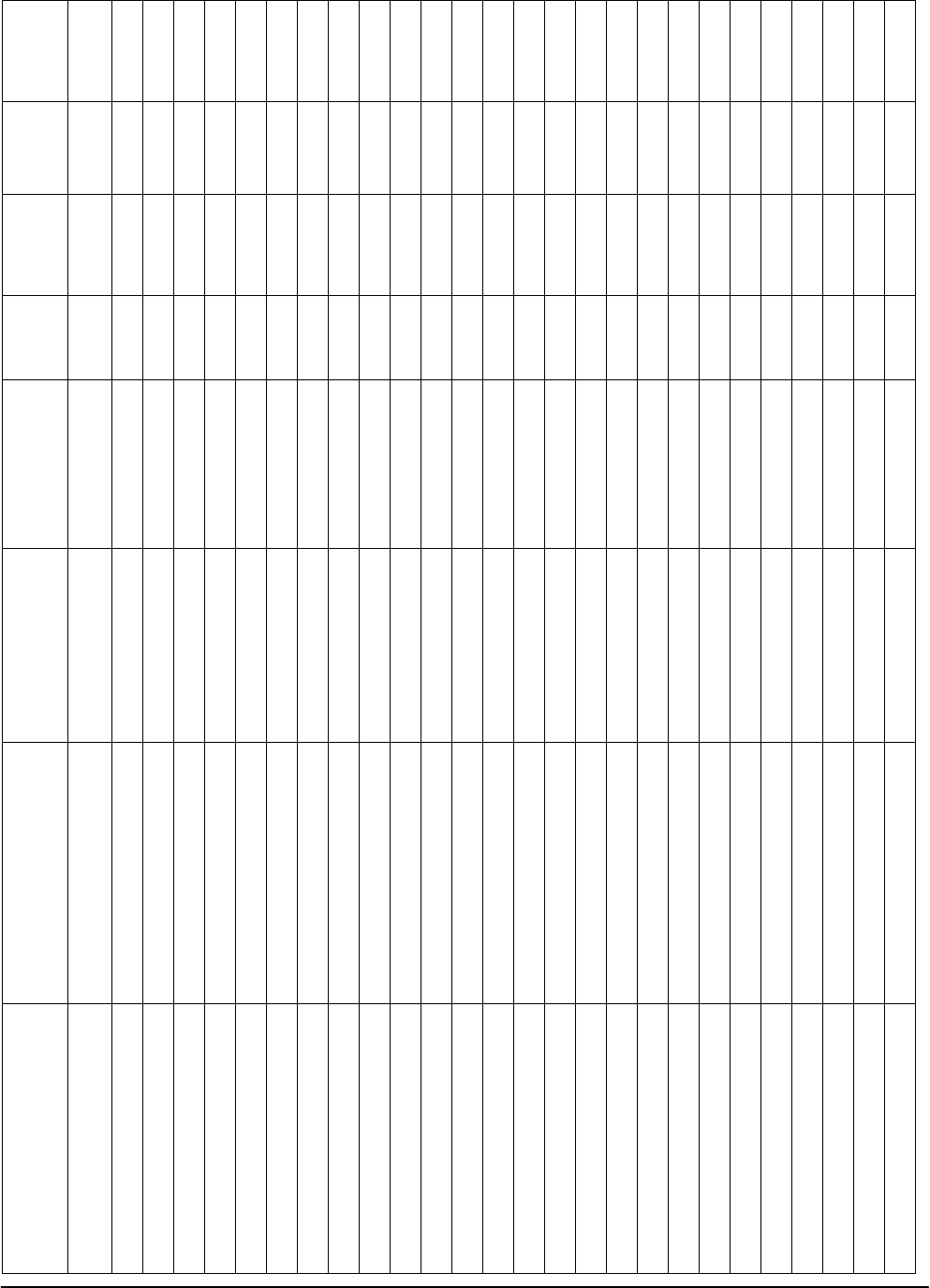
DETAIL RACE AND HISPANIC ORIGIN FOR FARS
Race (CDC) Ancestry/
Ethnicity (CDC) Country Region CDC
Race*
CDC
Ethnic*
FARS
Detail
Race
FARS
Hispanic
Origin
Ivory Coast Ivory Coast/Cote
D’Ivoire Africa -- 24 02 07
Jackson (Jack) White 6 -- 98 99
Jamaican Jamaican Jamaica 2 15 02 07
Japanese Japanese Japan Asia 5 20 05 07
Java Javanese 9 20 68 07
Jew Jewish 1 99 01 99
Jordanian Jordanian Jordan Middle East 1 22 01 07
Kashmirian -- 21 99 07
Kazakhstan Asia -- -- 68 07
Kenyan Kenyan Kenya Africa 2 24 02 07
Kiribati -- -- 99 99
Korean Korean Korea-North Asia 9 20 28 07
Korean Korean Korea-South Asia 9 20 28 07
Kuwaitian Kuwaiti Kuwait Middle East 1 22 01 07
Kyrgyzstan Asia -- -- 68 07
Ladina 1 -- 01 99
La Raza -- 05 01 01
Laotian Laotian Laos Asia 9 20 68 07
Latin American American 1 05 01 06
Latino -- 05 01 06
Latvian Latvian Latvia Europe 1 18 01 07
Lebonese Lebonese Lebanon Middle East 1 22 01 07
Lesotho Lesotho Africa -- 24 99 07
Liberian Liberian Liberia Africa 2 24 02 07
Libyan Libyan Libya North Africa 1 23 01 07
Liechtenstein Europe -- -- 01 07
Lithuanian Lithuanian Lithuania Europe 1 18 01 07
* SEE NATIONAL CENTER FOR HEALTH STATISTICS (NCHS) CODES
938 2015
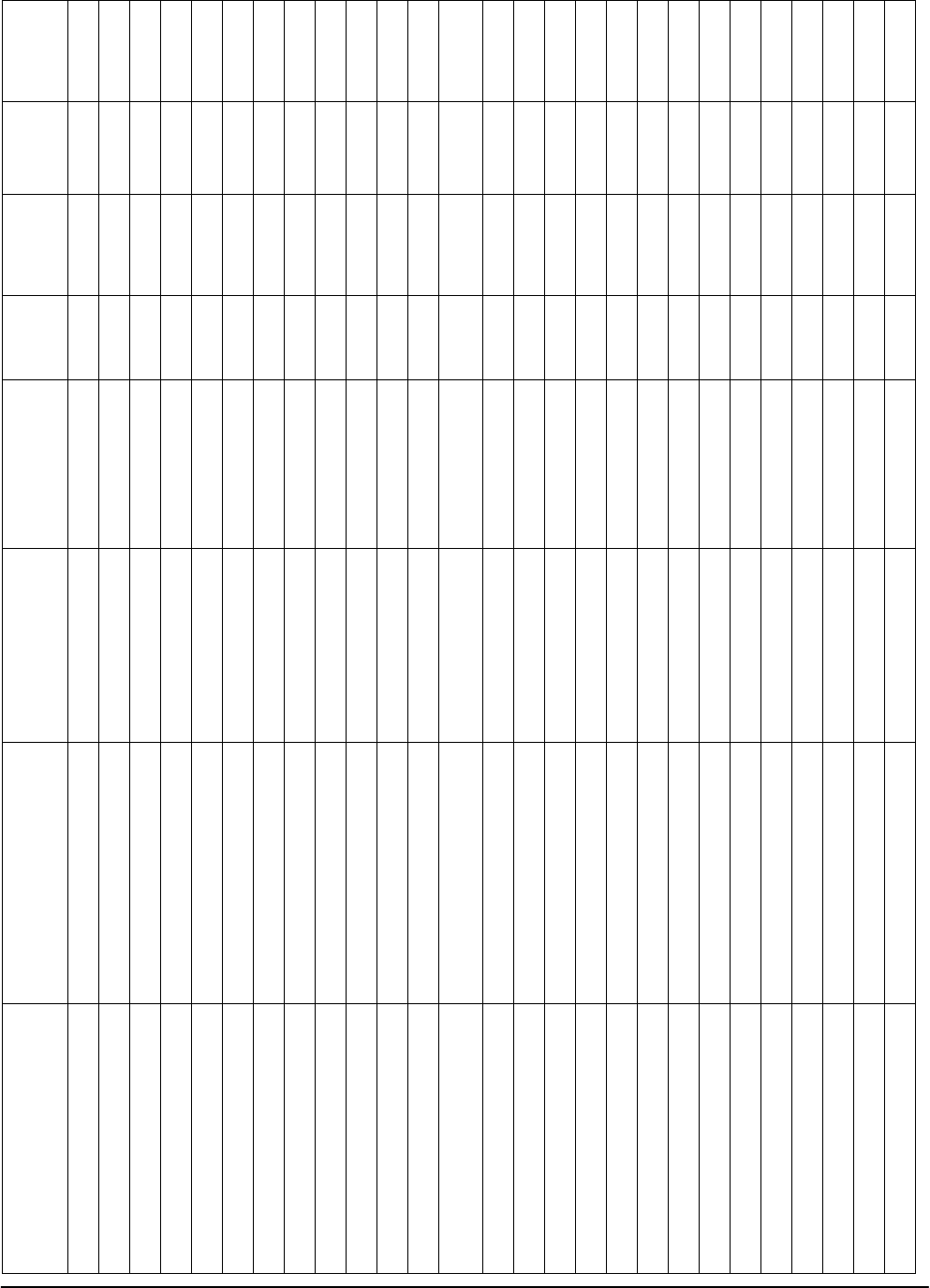
DETAIL RACE AND HISPANIC ORIGIN FOR FARS
Race (CDC) Ancestry/
Ethnicity (CDC) Country Region CDC
Race*
CDC
Ethnic*
FARS
Detail
Race
FARS
Hispanic
Origin
Luxembourg Europe -- -- 01 07
Macau -- -- 04 07
Macedonia Europe -- -- 01 07
Madagascan Madagascar Africa -- 24 99 07
Majorca -- 05 99 05
Malawian Malawi Malawi Africa 2 24 02 07
Malayan Malaysian Malaysia Asia 9 20 68 07
Maldives Asia -- -- 99 07
Mali Mali Africa -- 24 99 07
Mallorca (Mallorquin) -- 05 99 05
Maltese Maltese Malta Europe 1 19 01 07
Maori Maori 9 20 68 07
Marshallese Marshall Islands Australasia &
Pacific 9 -- 68 07
Marshenese 1 -- 01 99
Martinique -- -- 02 07
Mauritian Mauritanian Mauritania Africa 1 24 01 07
Mauritius Mauritius Africa -- 24 99 07
Mediterranean 1 -- 01 99
Melanesian Melanesian 9 20 68 07
Mestizo 6 -- 03 04
Mestizo-Inca 6 -- 03 04
Mexican Mexican (Mexicano) Mexico North America 1 01 01 01
Mexican Indian 3 -- 03 01
Mexican American -- 01 99 01
Micronesian Micronesian 9 20 68 07
Mixed Mixed 6 99 98 99
Mohammed Ali 6 -- 98 07
* SEE NATIONAL CENTER FOR HEALTH STATISTICS (NCHS) CODES
2015 939
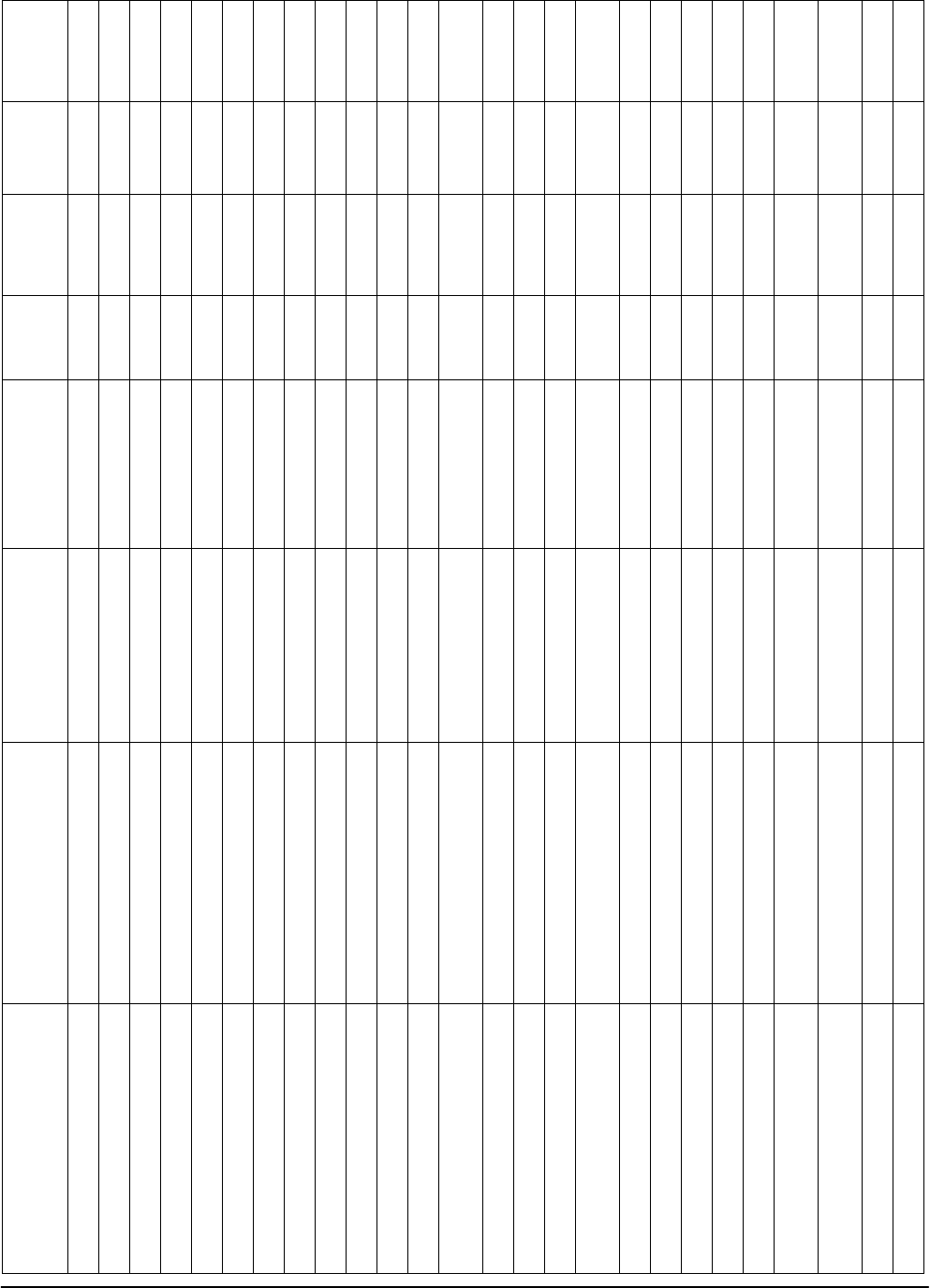
DETAIL RACE AND HISPANIC ORIGIN FOR FARS
Race (CDC) Ancestry/
Ethnicity (CDC) Country Region CDC
Race*
CDC
Ethnic*
FARS
Detail
Race
FARS
Hispanic
Origin
Mohammedan (Moslem) 1 -- 01 07
Moldova Europe -- -- 01 07
Monaco Europe -- -- 01 07
Mongolian Mongolian Mongolia Asia -- 20 68 07
Montenegro -- -- 01 07
Moor(ish) 6 -- 98 07
Morroccan Morroccan Morocco North Africa 1 23 01 07
Moslem -- 99 99 99
Mugandan 2 -- 02 99
Mullato 2 -- 02 99
Muslim Muslim 1 99 01 99
Mozambique Africa -- -- 02 07
Myanmar (also
Burma) Asia -- -- 68 07
Namibia Africa -- -- 02 07
Nassau 2 -- 02 99
Native American -- 07 03 07
Nauru Australasia &
Pacific -- -- 78 07
Negro Negro 2 24 02 07
Negro/Indian 2 -- 02 07
Nepalese Nepali Nepal Asia 9 21 68 07
Netherlands Europe -- -- 01 07
Netherlands Antilles -- -- 99 99
New Caledonia Australasia &
Pacific -- -- 78 07
New Zelander New Zealand Australasia &
Pacific -- 20 99 07
Newfoundland -- 15 01 07
Nicaraguan Nicaragua (Nicaraguense) Nicaragua Central America 6 04 98 04
* SEE NATIONAL CENTER FOR HEALTH STATISTICS (NCHS) CODES
940 2015
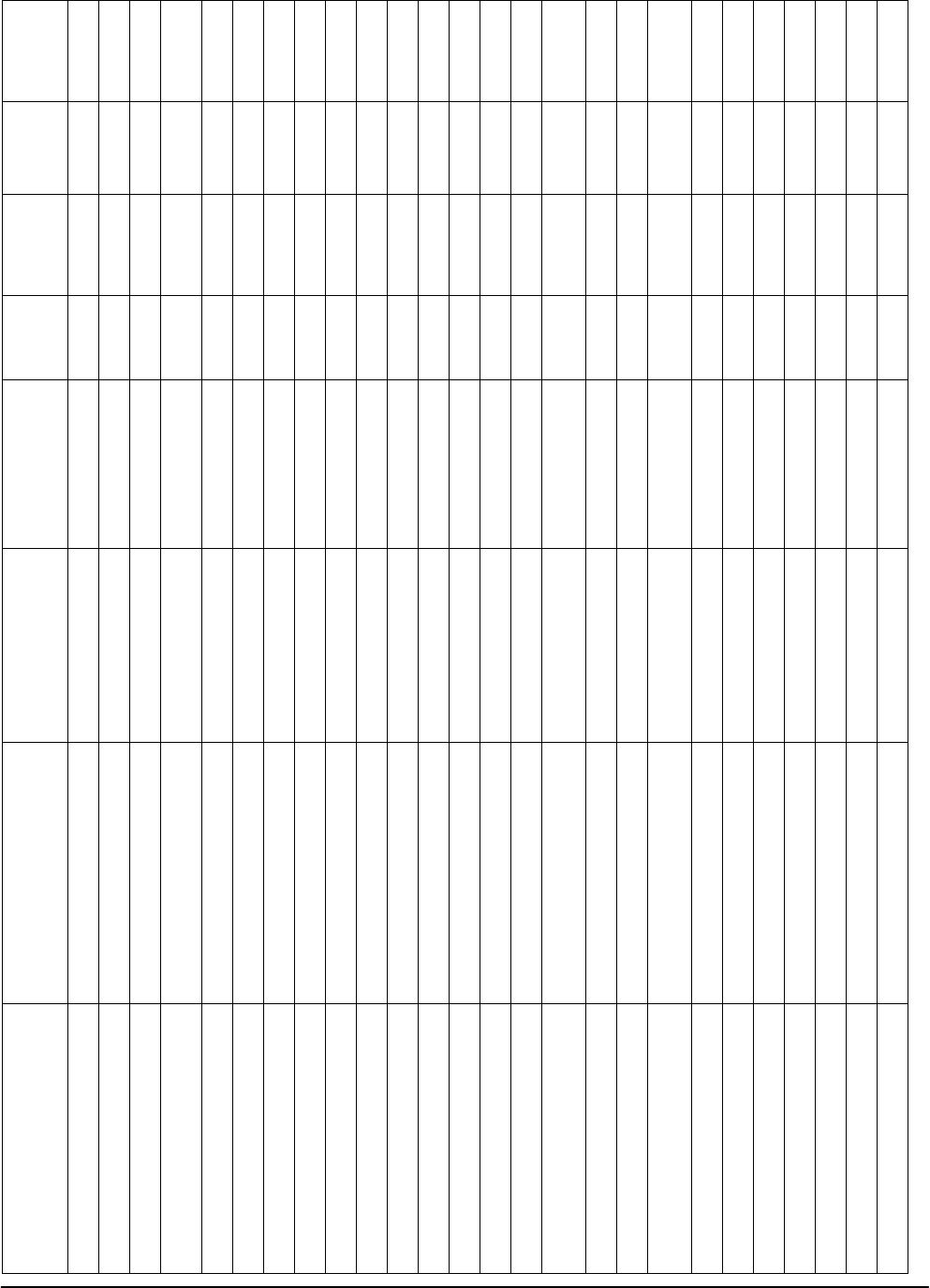
DETAIL RACE AND HISPANIC ORIGIN FOR FARS
Race (CDC) Ancestry/
Ethnicity (CDC) Country Region CDC
Race*
CDC
Ethnic*
FARS
Detail
Race
FARS
Hispanic
Origin
Niger Niger Africa -- 24 02 07
Nipponese (Nipon) Nipponese 5 20 05 07
Nigerian Nigerian Nigeria Africa 2 24 02 07
Nordic Nordic (Icelandic) 1 17 01 07
North American -- 15 99 99
Northern Ireland Europe -- -- 01 07
Norwegian Norwegian Norway Europe 1 12 01 07
Nubian 2 -- 02 07
Occidental 1 -- 01 99
Octaroon 2 -- 02 99
Okinawan Okinawan 5 20 05 07
Oman Middle East -- -- 01 07
Oriental -- 20 78 07
Pacific Islander -- 20 78 07
Pakistani Pakistani Pakistan Asia 9 21 18 07
Palauan Palau Australasia &
Pacific 9 -- 68
Palestinian Palestinian 1 22 01 07
Panamanian Panama (Panameno) Panama Central America 6 04 98 04
Papua New Guinea Australasia &
Pacific -- -- 99 07
Paraguay (Paraguayo) Paraguay South America -- 04 98 04
Parsi 1 -- 01 99
Pennsylvania Dutch -- 10 01 07
Persian Persian 1 22 01 07
Peruvian Peru (Peruano) Peru South American 1 04 01 07
Philipino Philipino Philippines Asia 8 20 07 07
Polish Polish Poland Europe 1 13 01 07
* SEE NATIONAL CENTER FOR HEALTH STATISTICS (NCHS) CODES
2015 941
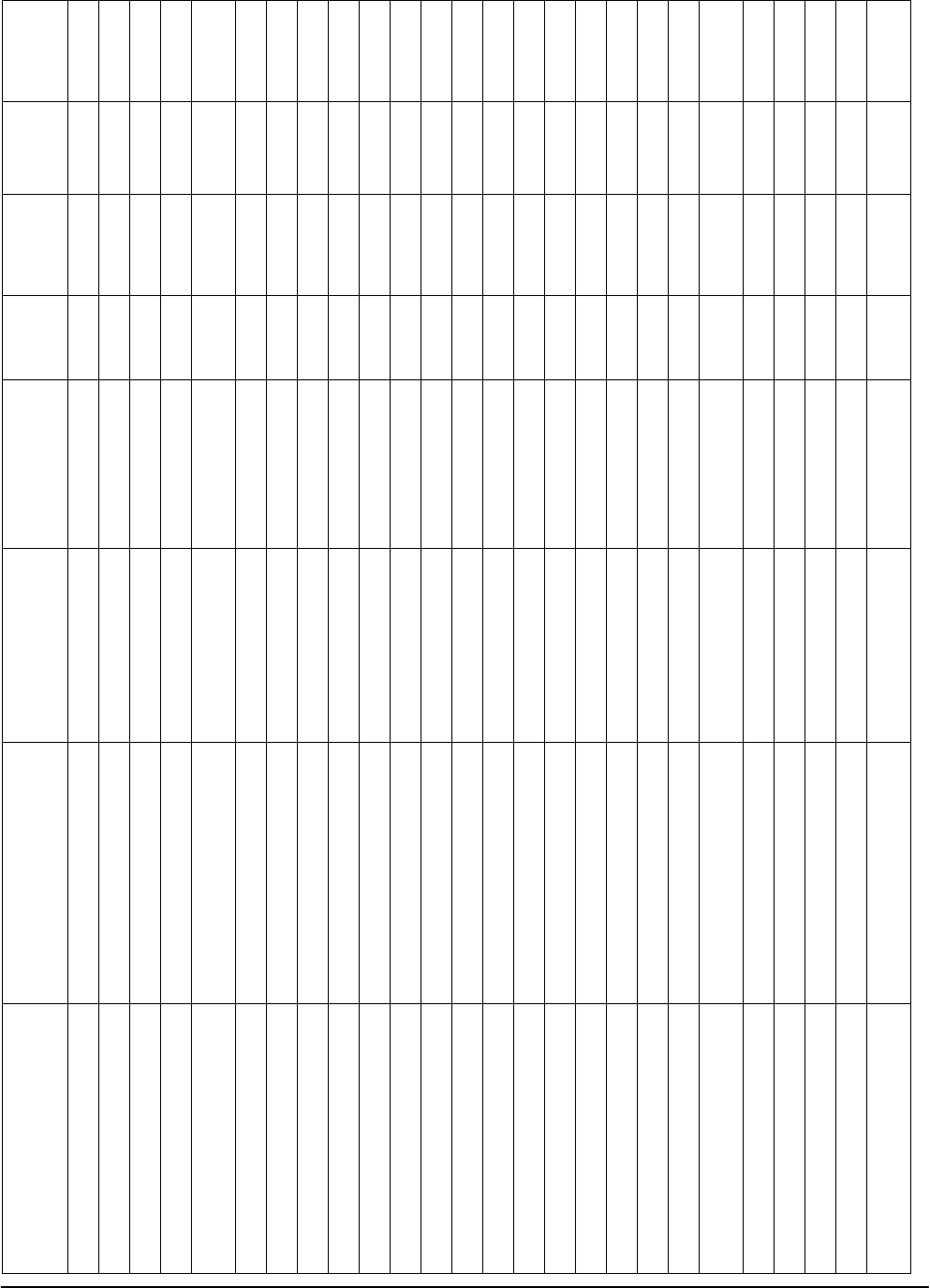
DETAIL RACE AND HISPANIC ORIGIN FOR FARS
Race (CDC) Ancestry/
Ethnicity (CDC) Country Region CDC
Race*
CDC
Ethnic*
FARS
Detail
Race
FARS
Hispanic
Origin
Polynesian Polynesian 9 20 68 07
Ponapean 9 -- 68 07
Portuguese Portuguese Portugal Europe 1 19 01 07
Prussia -- 10 01 07
Puerto Rican Puerto Rican
(Puertorriqueno) Puerto Rico 1 02 01 02
Punjabi Punjabi 9 20 68 07
Qatar Qatar Middle East -- 22 99 07
Quadroon 2 -- 02 99
Red Red 3 07 03 07
Rhodesian Rhodesia -- 24 02 07
Reunion Africa -- -- 99 07
Romanian Romania Europe 1 -- 01 07
Romany -- 22 99 07
Rotanese 9 -- 68 99
Rumanian -- 18 99 07
Russian Russian Russia Europe 1 18 01 07
Rwanda Rwanda Africa -- 24 02 07
Ryukyan 5 -- 05 07
Salpanese 9 -- 68 99
Salvadorian Salvadoreno 6 04 98 04
Samoa(n) Samoan American Samoa Australasia &
Pacific 9 20 38 07
Saint Kitts-Nevis -- -- 02 07
Saint Lucia -- -- 02 07
Saint Vincent -- -- 02 07
San Marino -- -- 01 07
Sao Tome and
Principe Africa -- -- 02 07
* SEE NATIONAL CENTER FOR HEALTH STATISTICS (NCHS) CODES
942 2015
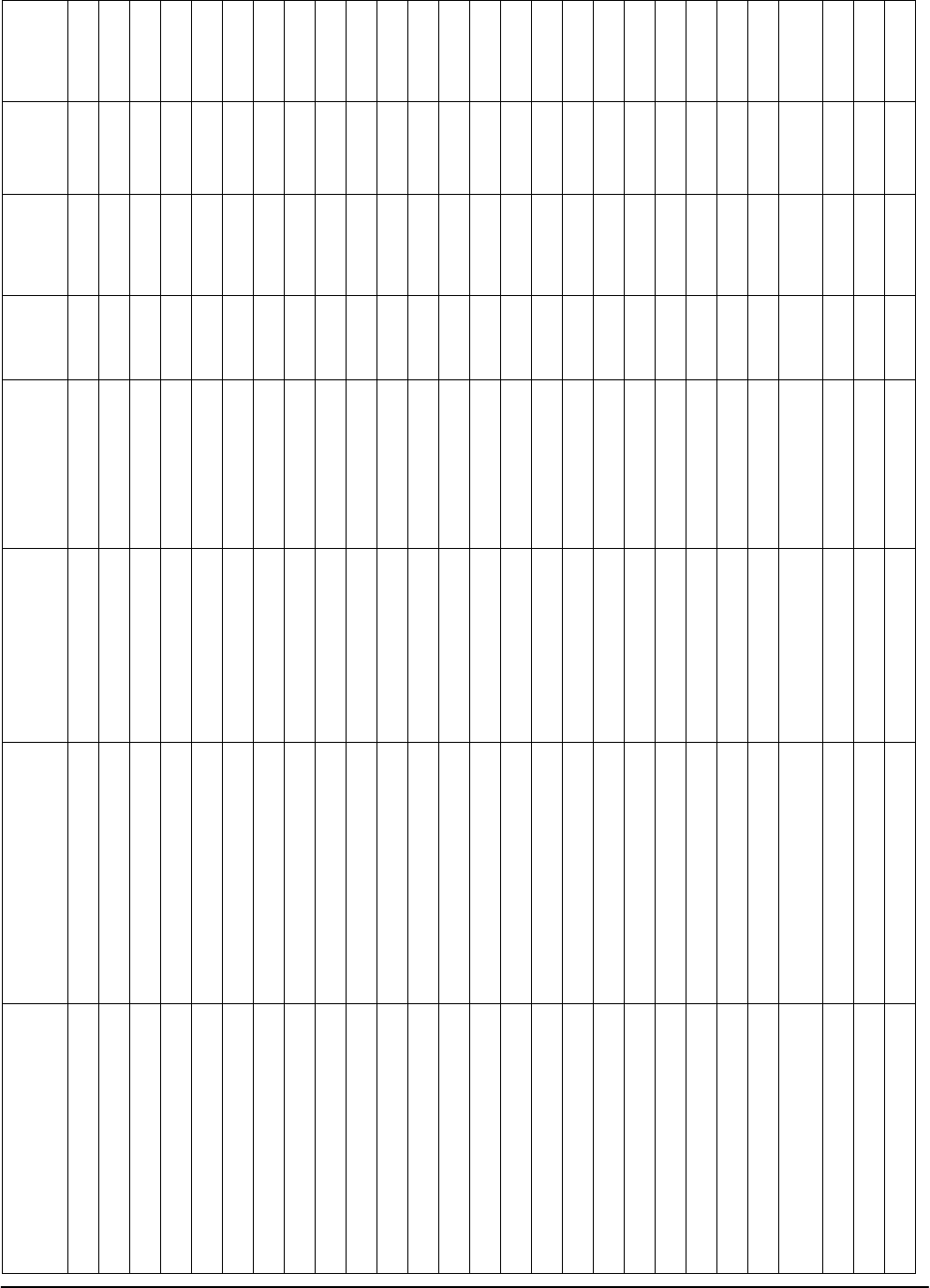
DETAIL RACE AND HISPANIC ORIGIN FOR FARS
Race (CDC) Ancestry/
Ethnicity (CDC) Country Region CDC
Race*
CDC
Ethnic*
FARS
Detail
Race
FARS
Hispanic
Origin
Saudia-Arabian Saudi Arabian Saudi Arabia Middle East 1 22 01 07
Saxon(y) 1 -- 01 07
Scandinavian Scandinavian 1 12 01 07
Scotch Scottish Scotland Europe 1 08 01 07
Scotch-Irish -- 08 01 07
Selawik 3 -- 03 07
Semitic 1 -- 01 99
Senegal Africa -- -- 02 07
Serbian Serbian Serbia Europe 1 19 01 07
Serbo-Croation -- 19 01 07
Servian 1 -- 01 99
Seychelloise Seychelles Africa 2 -- 02 07
Siamese Siamese 9 20 68 07
Sicilian Sicilian 1 14 01 07
Sierra Leone Sierra Leone Africa -- 24 02 07
Sikh Sikhs 9 21 68 07
Singaporean Singapore Asia -- 20 68 07
Singhalease Singhalease 9 21 68 07
Sino Burman 4 -- 04 07
Slovakian Slovak Slovakia Europe 1 18 01 07
Sloavic (Slovenian) Slovenia Europe -- 19 01 07
Slovikian -- 19 01 07
Slovish -- 19 01 07
Solomon Islands Australasia &
Pacific -- -- 68 07
Somalian Somalia Africa -- 24 99 07
South African South Africa Africa -- 24 99 07
South American 1 -- 01 06
* SEE NATIONAL CENTER FOR HEALTH STATISTICS (NCHS) CODES
2015 943

DETAIL RACE AND HISPANIC ORIGIN FOR FARS
Race (CDC) Ancestry/
Ethnicity (CDC) Country Region CDC
Race*
CDC
Ethnic*
FARS
Detail
Race
FARS
Hispanic
Origin
Southern European -- 19 01 99
Spanish Spain (Spaniard) Spain Europe 1 05 01 05
Sri Lanka Asia -- 68 07
Sudanese Sudanese Sudan North Africa 2 23 02 07
Sunni 1 -- 01 07
Swaziland -- 24 02 07
Swedish Swedish Sweden 1 12 01 07
Swiss Switzerland Europe -- 16 01 07
Syrian Syrian Syria Middle East 1 22 01 07
Tahitian 9 -- 68 07
Taimskin 3 -- 03 99
Taiwanese Taiwanese Taiwan Asia 4 20 04 07
Tajikistan Asia -- -- 68 07
Tamil-Ceylonese 9 -- 68 07
Tamil-Malayan 9 -- 68 07
Tanzanian Tanzanian Tanzania Africa 2 24 02 07
Teutonic 1 -- 01 07
Thai Thai Thailand Asia 9 20 68 07
Tibetan Tibet 9 -- 68 07
Togolese Togo Africa -- 24 02 07
Tongan Tonga Australasia &
Pacific 9 -- 68 07
Triguano 6 -- 98 99
Trinidadian Trinidadian Trinidad and Tobago 2 15 02 07
Tunisian Tunisian Tunisia North Africa 1 23 01 07
Turk Turkish Turkey Middle East 1 22 01 07
Turkmenistan Asia -- -- 68 07
* SEE NATIONAL CENTER FOR HEALTH STATISTICS (NCHS) CODES
944 2015
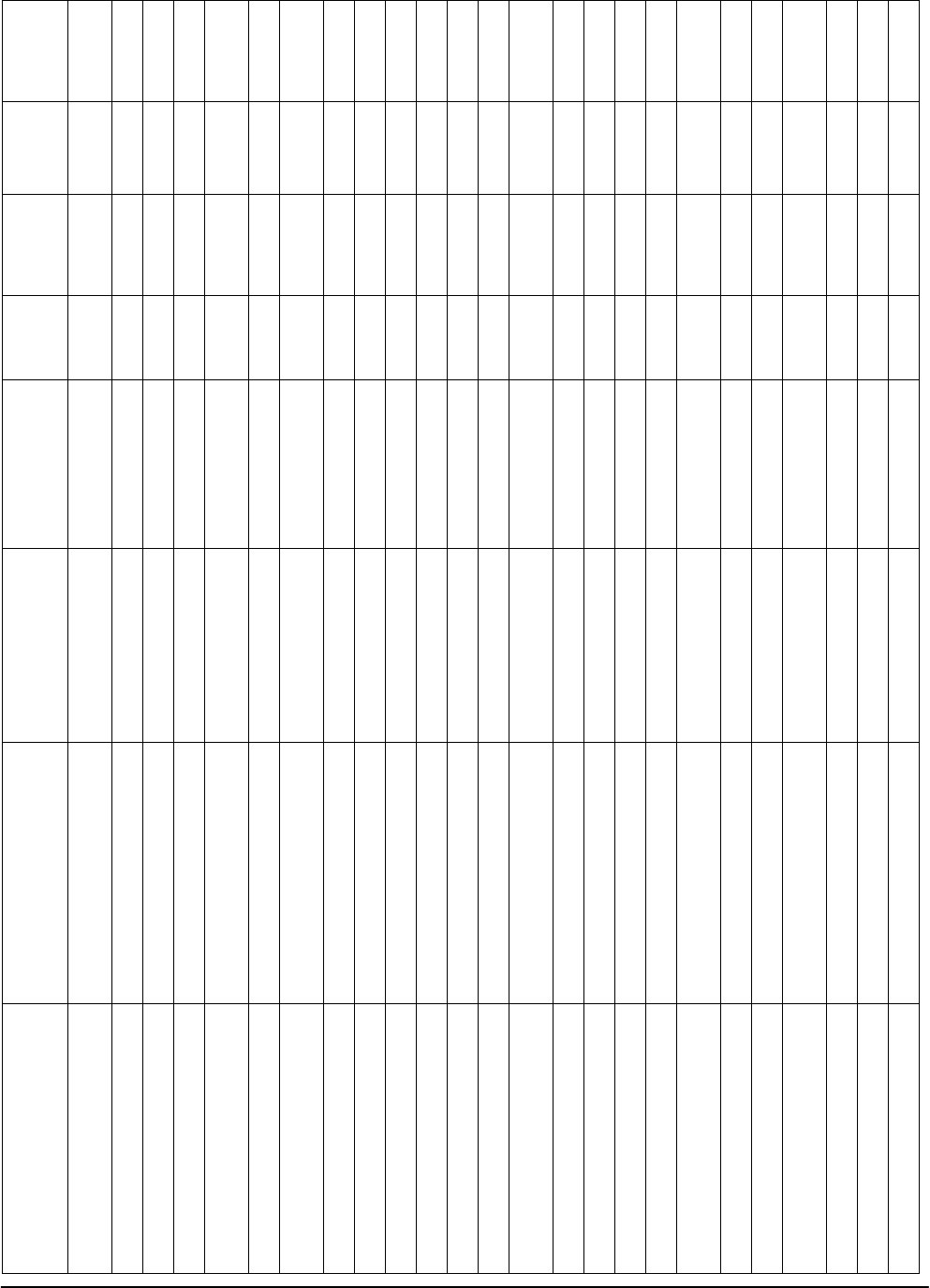
DETAIL RACE AND HISPANIC ORIGIN FOR FARS
Race (CDC) Ancestry/
Ethnicity (CDC) Country Region CDC
Race*
CDC
Ethnic*
FARS
Detail
Race
FARS
Hispanic
Origin
Tuvalu Australasia &
Pacific -- -- 68 07
Ubontilian 9 -- 68 07
Ugandan Ugandan Uganda Africa 2 24 02 07
Ukrainian Ukrainian Ukraine Europe 1 18 01 07
United Arab
Emirates Middle East -- -- 01 07
United Kingdom -- 08 99 07
United States of
America North America -- -- 99 99
Unknown or Blank Unknown 0 99 99 99
Upper Volta Africa -- 24 99 07
Uruguay (Uruguayo) Uruguay South America -- 04 01 04
Ute 3 -- 03 07
Uzbekistan Asia -- -- 68 07
Valencian -- 05 01 05
Vanuatu Australasia &
Pacific -- -- 68 07
Venezuela(n) Venezuela (Venezolano) Venezuela South America 1 04 01 04
Vietnam(ese) Vietnamese Vietnam Asia 9 20 48 07
Viking -- 12 01 07
W 1 -- 01 99
Welsh Welsh Wales (United
Kindom) Europe 1 08 01 07
West Indies (Indian) West Indian 2 15 02 07
Western Sahara Africa -- -- 99 99
Western Samoa Australasia &
Pacific -- -- 38 07
White White 1 99 01 99
White Russian -- 18 01 07
Wiam (White American) 1 -- 01 99
* SEE NATIONAL CENTER FOR HEALTH STATISTICS (NCHS) CODES
2015 945
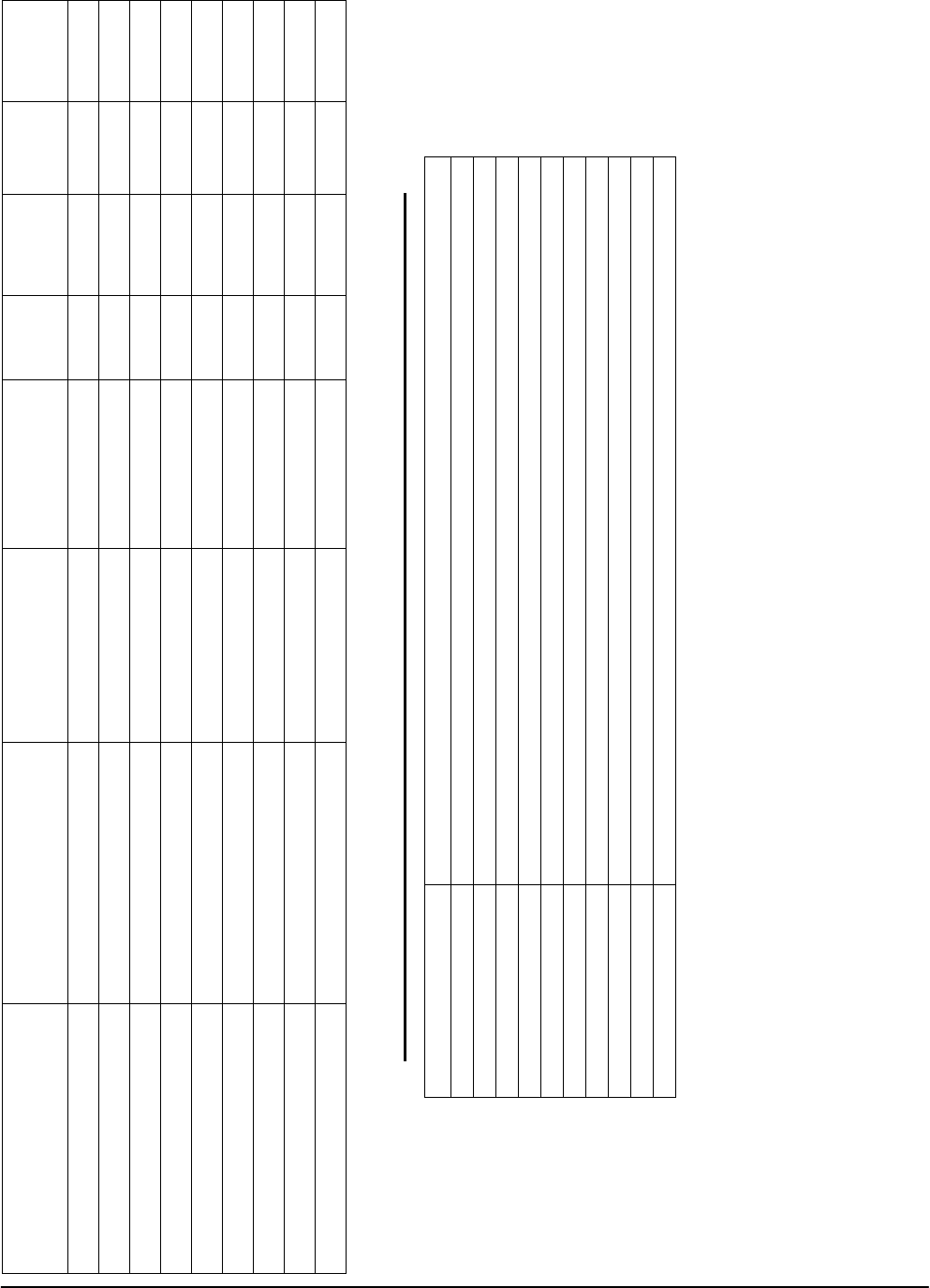
DETAIL RACE AND HISPANIC ORIGIN FOR FARS
Race (CDC) Ancestry/
Ethnicity (CDC) Country Region CDC
Race*
CDC
Ethnic*
FARS
Detail
Race
FARS
Hispanic
Origin
Yapanes 9 -- 68 07
Yellow -- 20 78 07
Yemen Yemen Middle East -- 22 99 07
Yugoslavian Yugoslavian Yugoslavia Europe 1 19 01 07
Zaire Zaire Africa -- 24 02 07
Zambian Zambia Africa -- 24 02 07
Zanzibar -- 24 02 07
Zimbabwe Africa -- -- 02 07
Zoroastrian 1 -- 01 07
NCHS (NATIONAL CENTER FOR HEALTH STATISTICS) RACE CODES
CDC RACE CODE RACE DISCRIPTION
0 Unknown/Blank
1 White/Mexican/Puerto Rican, Other Caucasian
2 Black
3 Indian (American, Canadian, Alaskan, Aleut/Eskimo)
4 Chinese
5 Japanese
6 Other Non-White
7 Hawaiian/Part Hawaiian
8 Filipino
9 Asian/Pacific Island Other
* SEE NATIONAL CENTER FOR HEALTH STATISTICS (NCHS) CODES
946 2015
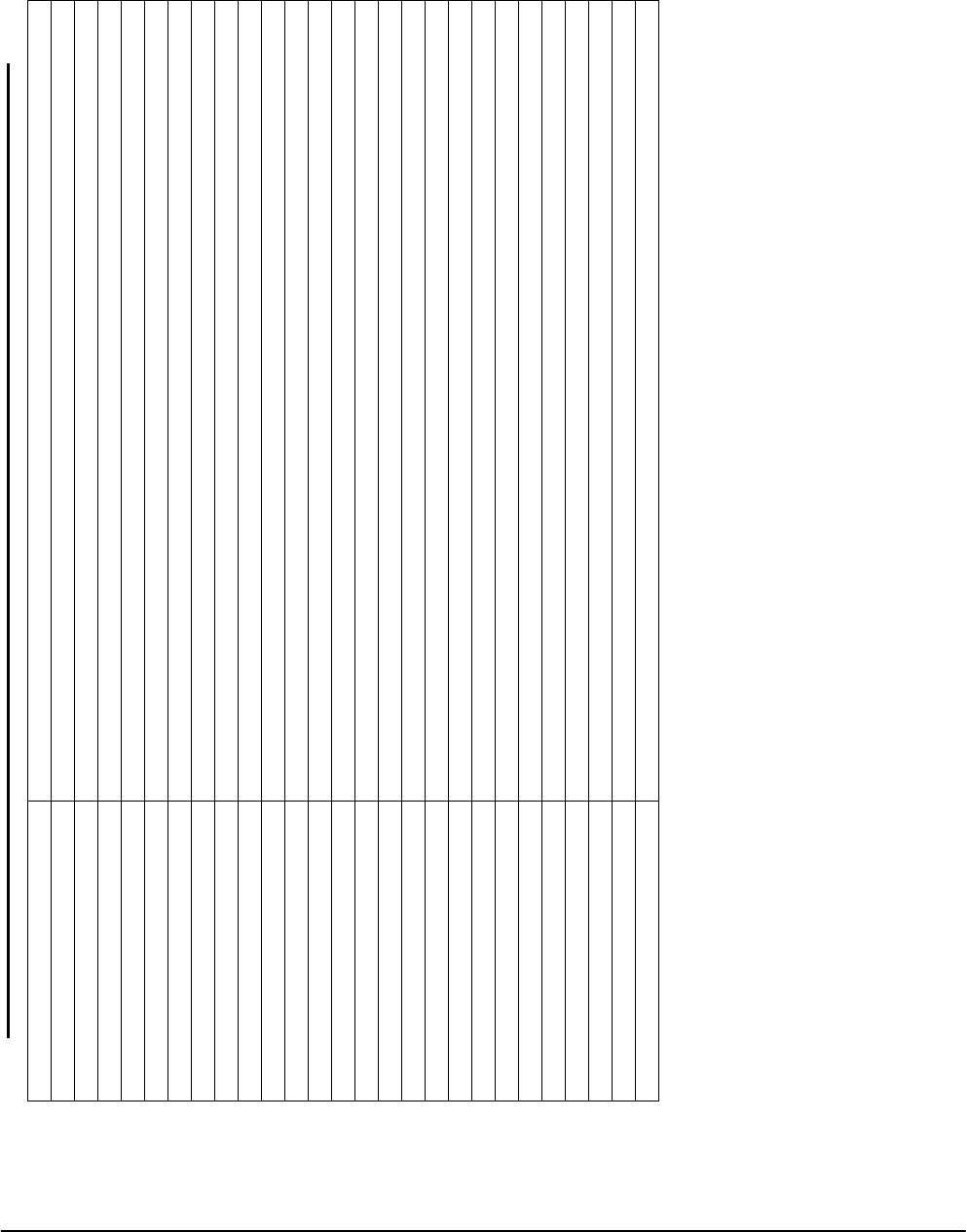
DETAIL RACE AND HISPANIC ORIGIN FOR FARS
NCHS (NATIONAL CENTER FOR HEALTH STATISTICS) ANCESTRY CODES
CDC ANCESTORY CODE ANCESTRY/ETHNICITY DESCRIPTION
01 Mexican
02 Puerto Rican
03 Cuban
04 Central or South American
05 Other & Unknown Spanish
06 “American”
07 Indian (American, Alaskan, Canadian or Mexican Indian, Eskimo & Aleut)
08 English, Scottish, Welsh, Scotch-Irish
09 Irish
10 German
11 French
12 Norwegian, Swedish, Danish
13 Polish
14 Italian
15 Other North, Central and South American or Canadian
16 Other Western European
17 Other Northern European
18 Other Eastern European
19 Other Southern European (Excluding Spain)
20 Southwest Asian & Pacific Islander
21 South Central Asian
22 Other Asian
23 North African
24 Other African
99 Unknown
Blank Blank
* SEE NATIONAL CENTER FOR HEALTH STATISTICS (NCHS) CODES
2015 947

2015 949
APPENDIX
2015 CONSISTENCY
CHECKS
The following pages contain Consistency Checks,
Intraconsistency Checks and Special
Processing Rules.
It is arranged in alpha/numeric order.
All questions concerning the FARS/NASS GES Coding
Manual and coding issues should be directed to
codingquestions@nisrinc.com

ERROR CODE
050P
060P
0PB1
170F
1A0P
1A1P
1C0P
1D0P
1D0Q
1F1P
1G0P
1H0F
ERROR TEST
If PERSON TYPE equals 04-08, 19, and NUMBER OF
VEHICLE FORMS SUBMITTED equals 001, then NUMBER OF
MOTOR VEHICLE STRIKING NON-MOTORIST must equal
001.
If NUMBER OF MOTOR VEHICLE STRIKING NON-MOTORIST
is not equal to 000, 999, then the NUMBER OF MOTOR
VEHICLE STRIKING NON-MOTORIST must equal some
VEHICLE NUMBER in the case, and the UNIT TYPE must
equal 1.
If PEDESTRIAN/BIKE TYPING - CRASH TYPE - PEDESTRIAN
equals 741, then at least one NON-MOTORIST
CONTRIBUTING CIRCUMSTANCES must equal 11.
If MONTH equals current month, then DAY must be at least 2
days prior to current day or 99.
If RELATED FACTORS-CRASH LEVEL equals 14, then
NUMBER OF VEHICLE FORMS SUBMITTED must be greater
than 001.
If RELATED FACTORS-CRASH LEVEL equals 05, then
ROADWAY SURFACE CONDITIONS must equal 06 for at least
one vehicle.
If the MODEL YEAR is not equal to 9998 or 9999, then the
MODEL YEAR must not be greater than CRASH YEAR plus
ONE.
If SPECIAL USE equals 01, then BODY TYPE must equal
02-09, 12, 14-21, 28, 29, 49, 99.
If SPECIAL USE equals 00-03, then EMERGENCY MOTOR
VEHICLE USE must equal 0.
If RELATION TO JUNCTION (b) does not equal 02, 03, then the
second TRAFFICWAY IDENTIFIER should be blank.
If one RELATED FACTORS-VEHICLE LEVEL equals 99, then
both factors must equal 99.
If DRIVER PRESENCE equals 0, 9, then PREVIOUS
SPEEDING CONVICTIONS must be blank.
950 2015

2015 951
ERROR CODE
1H1F
1H2F
1H3F
1H4F
1H6F
1H7F
1H8F
1H9F
1HAF
1HBF
1HCF
1HDF
1HEF
1HFF
1HGF
ERROR TEST
If DRIVER PRESENCE equals 0, 9, then DRIVER’S LICENSE
STATE must be blank.
If DRIVER PRESENCE equals 0, 9, then LICENSE COMPLI-
ANCE WITH CLASS OF VEHICLE must be blank.
If DRIVER PRESENCE equals 0, 9, then NON-CDL LICENSE
STATUS and COMMERCIAL MOTOR VEHICLE LICENSE
STATUS must be blank.
If DRIVER PRESENCE equals 0, 9, then COMPLIANCE WITH
LICENSE RESTRICTIONS must be blank.
If DRIVER PRESENCE equals 0, 9, then VIOLATIONS
CHARGED must be blank.
If DRIVER PRESENCE equals 0, 9, then PREVIOUS
RECORDED CRASHES must be blank.
If DRIVER PRESENCE equals 0, 9, then PREVIOUS
RECORDED SUSPENSIONS must be blank.
If DRIVER PRESENCE equals 0, 9, then PREVIOUS DWI
CONVICTIONS must be blank.
If DRIVER PRESENCE equals 0, 9, then PREVIOUS OTHER
MOVING VIOLATION CONVICTIONS must be blank.
If DRIVER PRESENCE equals 0, 9, then DATE OF LAST
CRASH, SUSPENSION, CONVICTION must be blank.
If DRIVER PRESENCE equals 0, 9, then DATE OF FIRST
CRASH, SUSPENSION, CONVICTION must be blank.
If DRIVER PRESENCE equals 0, 9, then DRIVER HEIGHT
(feet and inches) must equal blank.
If DRIVER PRESENCE equals 0, 9, then DRIVER WEIGHT
must equal blank.
If DRIVER PRESENCE equals 0, 9, then SPEEDING RELATED
must be blank.
If DRIVER PRESENCE equals 0 or 9, then DRIVER LICENSE
NUMBER must equal blank.

ERROR CODE
1HJF
1I0P
1J0P
1J1P
1J2P
1K0P
1L0P
1L2P
1L4P
1L5P
1M1F
1N0F
1N1F
ERROR TEST
If DRIVER'S VISION OBSCURED BY equals 95, then DRIVER
PRESENCE must equal 0 or 9.
If DRIVER’S LICENSE STATE equals 99, then NON-CDL
LICENSE STATUS must not equal 0-4, 6, and COMMERCIAL
MOTOR VEHICLE LICENSE STATUS must not equal 00-08.
If any counter equals 99, then all counters must equal 99.
If any counter equals 99, then DATE OF LAST CRASH,
SUSPENSION, CONVICTION must equal 999999.
If any counter equals 99, then DATE OF FIRST CRASH,
SUSPENSION, CONVICTION must equal 999999.
If DRIVER’S LICENSE STATE equals 99, then LICENSE
COMPLIANCE WITH CLASS OF VEHICLE must not equal 0-3.
If any RELATED FACTORS-DRIVER LEVEL equals blanks,
then all RELATED FACTORS-DRIVER LEVEL must equal
blanks.
If any DRIVER’S VISION OBSCURED BY equals 00 or 95 or
99, then only that one code and no other must be coded for this
vehicle.
If any DRIVER’S VISION OBSCURED BY equals 09, then at
least one CONTRIBUTING CIRCUMSTANCES, MOTOR
VEHICLE must equal 97.
If any DRIVER’S VISION OBSCURED BY equals 10, then at
least one CONTRIBUTING CIRCUMSTANCES, MOTOR
VEHICLE must equal 07 or 08 or 09.
If RELATED FACTORS-PERSON LEVEL (Not a MV Occupant)
equals 13, then PERSON TYPE should equal 08.
If PERSON TYPE equals 06, then RELATED FACTORS-
PERSON LEVEL (Not a MV Occupant) must not equal 09, 13,
69, 70, 86, 90.
If PERSON TYPE equals 10, then RELATED FACTORS-
PERSON LEVEL must not equal 09, 21, 37, 40-42, 51, 52,
56, 57, 60-70, 72-78, 80-83, 90, 91.
952 2015

2015 953
ERROR CODE
1N4F
1P2F
1P3F
1P4F
1P5F
1P7F
1P8F
1P9F
1P0G
1P1G
1P3G
1P4G
1P5G
1P6G
ERROR TEST
If any NON-MOTORIST SAFETY EQUIPMENT equals 5, then
NON-MOTORIST CONTRIBUTING CIRCUMSTANCES should
not equal 13.
If PERSON TYPE equals 10, then NON-MOTORIST LOCATION
AT TIME OF CRASH must equal 25.
If PERSON TYPE equals 10, then NON-MOTORIST
ACTION/CIRCUMSTANCES must not equal 01-12, 16, and
NON-MOTORIST CONTRIBUTING CIRCUMSTANCES must
not equal 01-20.
If PERSON TYPE equals 04, then NON-MOTORIST ACTION/
CIRCUMSTANCES must not equal 04, 12.
If PERSON TYPE equals 06-08, 19, then NON-MOTORIST
ACTION/CIRCUMSTANCES must not equal 04.
If PERSON TYPE equals 04, then NON-MOTORIST ACTION/
CIRCUMSTANCES should not equal 10, 11.
If PERSON TYPE equals 06, 07, then NON-MOTORIST
ACTION/CIRCUMSTANCES should not equal 10-12.
If PERSON TYPE equals 08, then NON-MOTORIST ACTION/
CIRCUMSTANCES should not equal 11.
If PERSON TYPE equals 05, then NON-MOTORIST
CONTRIBUTING CIRCUMSTANCES must not equal 07, 08, 10,
13-18, 20.
If PERSON TYPE equals 19, then NON-MOTORIST ACTION/
CIRCUMSTANCES should not equal 11, 12.
If PERSON TYPE equals 04, 06, 07, then NON-MOTORIST
CONTRIBUTING CIRCUMSTANCES should not equal 04.
If PERSON TYPE equals 04, 06-08, 19, then NON-MOTORIST
CONTRIBUTING CIRCUMSTANCES should not equal 05.
If PERSON TYPE equals 08, then NON-MOTORIST
CONTRIBUTING CIRCUMSTANCES should not equal 20.
If PERSON TYPE equals 04, 06-08, 19, then CONDITION
(IMPAIRMENT) AT TIME OF CRASH must not equal 03.

ERROR CODE
1P7G
1P8G
1P9G
1P0H
1P1H
1P2H
1P3H
1P4H
1P5H
1P6H
1P7H
ERROR TEST
If PERSON TYPE equals 05-07, 19, then CONDITION
(IMPAIRMENT) AT TIME OF CRASH should not equal 04.
If PERSON TYPE equals 10, then CONDITION (IMPAIRMENT)
AT TIME OF CRASH should not equal 01-10, 96.
If NON-MOTORIST LOCATION AT THE TIME OF CRASH
equals 20, then NON-MOTORIST CONTRIBUTING
CIRCUMSTANCES must not equal 02-04, 15.
If NON-MOTORIST LOCATION AT THE TIME OF CRASH
equals 21, then NON-MOTORIST CONTRIBUTING
CIRCUMSTANCES must not equal 02-04, 07-10, 15, 16, 20.
If NON-MOTORIST LOCATION AT THE TIME OF CRASH
equals 22, then NON-MOTORIST CONTRIBUTING
CIRCUMSTANCES must not equal 01, 02, 04, 07, 08, 11,15,
20.
If NON-MOTORIST LOCATION AT THE TIME OF CRASH
equals 23, then NON-MOTORIST CONTRIBUTING
CIRCUMSTANCES must not equal 12, 15.
If NON-MOTORIST LOCATION AT THE TIME OF CRASH
equals 24, then NON-MOTORIST CONTRIBUTING
CIRCUMSTANCES must not equal 01, 03, 04, 10, 11.
If NON-MOTORIST LOCATION AT THE TIME OF CRASH
equals 25, then NON-MOTORIST CONTRIBUTING
CIRCUMSTANCES must not equal 01-04, 10-12, 15-17, 20.
If NON-MOTORIST LOCATION AT THE TIME OF CRASH
equals 28, 98, 99, then NON-MOTORIST CONTRIBUTING
CIRCUMSTANCES should not equal 01, 03, 04, 10-12, 15, 16,
20.
If NON-MOTORIST LOCATION AT THE TIME OF CRASH
equals 16, then NON-MOTORIST CONTRIBUTING
CIRCUMSTANCES should not equal 04, 16.
If NON-MOTORIST LOCATION AT THE TIME OF CRASH
equals 21, then NON-MOTORIST CONTRIBUTING
CIRCUMSTANCES should not equal 01, 05, 11, 12, 17.
954 2015

2015 955
ERROR CODE
1P8H
1P9H
1PH0
1PK2
1PK3
1Q0F
1R0P
1R1P
1T0P
1U1F
1U2F
1V0P
1W0P
1Y0P
ERROR TEST
If NON-MOTORIST LOCATION AT THE TIME OF CRASH
equals 23, then NON-MOTORIST CONTRIBUTING
CIRCUMSTANCES should not equal 02.
If NON-MOTORIST LOCATION AT THE TIME OF CRASH
equals 24, then NON-MOTORIST CONTRIBUTING
CIRCUMSTANCES should not equal 02, 05, 12, 15, 16.
If NON-MOTORIST LOCATION AT THE TIME OF CRASH
equals 25, then NON-MOTORIST CONTRIBUTING
CIRCUMSTANCES should not equal 07-09.
If NON-MOTORIST LOCATION AT TIME OF CRASH equals 21,
then SIDEWALK PRESENT must equal 1.
If NON-MOTORIST LOCATION AT TIME OF CRASH equals 01
or 10, then MARKED CROSSWALK PRESENT must equal 1.
If PERSON TYPE equals 01, and BODY TYPE equals 80-83,
88, 89, then SEATING POSITION must not equal 12-55, 99.
If SEATING POSITION equals 51, and BODY TYPE equals
50-52, 55, 58, 59, then INJURY SEVERITY must not equal 0, 9.
If DIED AT SCENE/EN ROUTE equals 7, 8, then INJURY
SEVERITY must equal 4.
If SPEED LIMIT for every vehicle is greater than 55, and not
equal to 98 or 99, then LAND USE AND FUNCTIONAL
SYSTEM (a) should not equal 2 or 6, and LAND USE AND
FUNCTIONAL SYSTEM (b) should not equal 06, 07 or 96.
If INJURY SEVERITY equals 4, then DEATH DATE must not
equal 88888888.
If INJURY SEVERITY equals 4, then DEATH TIME must not
equal 8888.
If DEATH MONTH or DAY equals 88, or DEATH YEAR equals
8888, then all must equal 8’s.
If any RELATED FACTORS-PERSON LEVEL equals 99, then
all factors must equal 99.
If RELATION TO JUNCTION (b) equals 06, then RAIL GRADE
CROSSING IDENTIFIER must not equal 0000000.

ERROR CODE
1Z0N
1Z1N
1Z1P
1Z2P
200P
210P
220P
2300
250P
251P
252P
253P
ERROR TEST
SEQUENCE OF EVENTS for this vehicle should not include
more than one occurrence of 01. Please see SEQUENCE OF
EVENTS remarks for 01 (Rollover/Overturn) to confirm coding.
SEQUENCE OF EVENTS for this vehicle should not equal 01,
67 consecutively or 67, 01 consecutively.
If any SEQUENCE OF EVENTS equals 66, then ROADWAY
GRADE should equal 6 for this vehicle.
If any SEQUENCE OF EVENTS equals 01 and (BODY TYPE
equals 01-79, 82, 90-99 or any RELATED FACTORS-VEHICLE
LEVEL equals 30), then ROLLOVER must equal 1, 2 or 9.
If CITY is greater than 0000 and less than 9997, and COUNTY
is greater than 000 and less than 997, then COUNTY and CITY
must be valid codes for the STATE.
If CITY is greater than 0000 and less than 9997, then COUNTY
must not equal 999.
If LIGHT CONDITION equals 4, and STATE is not equal to 02,
then CRASH TIME must equal 0300-0900, 9999.
If LIGHT CONDITION equals 5, and STATE is not equal to 02,
then CRASH TIME must equal 1600-2200, 9999.
If RELATION TO JUNCTION (b) equals 01, 02, 04, 06, 07,
16-19, 98, 99, and RELATION TO TRAFFICWAY equals 03,
then TRAFFICWAY DESCRIPTION should equal 2, 3 for at
least one vehicle involved in the first harmful event.
If RELATION TO TRAFFICWAY equals 98, 99, then TYPE OF
INTERSECTION should equal 98, 99.
If RELATION TO TRAFFICWAY equals 01, 02, 03, 04, 07, 08,
10, 11, 98 or 99, then UNIT TYPE for VEHICLE NUMBER
(OTHER VEHICLE) involved in the first harmful event must not
equal 3.
If RELATION TO TRAFFICWAY equals 03, then CRASH TYPE
should equal 06-10, 98 or 99 for the in-transport vehicles
involved in the first harmful event.
956 2015

2015 957
ERROR CODE
254P
255P
256P
257P
260P
2B0P
2D0P
2F0F
2G0P
2H0F
2H1F
2I0P
2J0P
ERROR TEST
If RELATION TO TRAFFICWAY equals 01, and RELATION TO
JUNCTION (b) equals 20, then TRAFFICWAY DESCRIP-TION
must equal 6 for at least one vehicle involved in the first harmful
event.
If RELATION TO TRAFFICWAY equals 01 or 11, then UNIT
TYPE for VEHICLE NUMBER (THIS VEHICLE) involved in the
first harmful event must equal 1.
If RELATION TO TRAFFICWAY equals 01 or 11, then UNIT
TYPE for VEHICLE NUMBER (OTHER VEHICLE) involved in
the first harmful event should equal 1 or 4.
If RELATION TO TRAFFICWAY equals 05, then UNIT TYPE for
VEHICLE NUMBER (OTHER VEHICLE) involved in the first
harmful event must equal 1, 3 or 4.
If ROUTE SIGNING equals 1, then NATIONAL HIGHWAY
SYSTEM must equal 1.
If JACKKNIFE equals 1-3, then VEHICLE TRAILING must not
equal 0, 9.
If SPECIAL USE equals 02, then BODY TYPE should equal
15, 16, 19-21, 28, 29, 45, 48, 50-52, 55, 58, 59.
If NUMBER OF OCCUPANTS equals 00, then DRIVER
PRESENCE must equal 0.
If either RELATED FACTORS-VEHICLE LEVEL equals blanks,
then the other factor must also equal blanks.
If DRIVER PRESENCE equals 0, 9, then RELATED FACTORS-
DRIVER LEVEL must not equal 04, 08, 12, 13, 15, 16, 19, 52,
53, 58, 59, 73, 74, 77-88.
If UNIT TYPE equals 1 and DRIVER PRESENCE equals 0 or 9,
then DRIVER’S VISION OBSCURED BY must equal 95.
If DRIVER’S LICENSE STATE equals 99, then COMPLIANCE
WITH LICENSE RESTRICTIONS must not equal 0-3.
If all counters are not blanks and PREVIOUS RECORDED
CRASHES is not equal to 98 and any counter are not equal to
00, 99, then DATE OF LAST CRASH, SUSPENSION,
CONVICTION must not equal 000000, 999999.

ERROR CODE
2J1P
2K0P
2L0P
2M0F
2Q0F
2R0P
2R1P
2S0P
2S1P
2U0P
2U0Q
2U1F
2U2F
ERROR TEST
If all counters are not blanks and PREVIOUS RECORDED
CRASHES is not equal to 98, and any counter are not equal to
00, 99, then DATE OF FIRST CRASH, SUSPENSION,
CONVICTION must not equal 000000, 999999.
DATE OF FIRST CRASH, SUSPENSION, CONVICTION must
be less than or equal to DATE OF LAST CRASH, SUSPEN-
SION, CONVICTION.
If any RELATED FACTORS-DRIVER LEVEL equals 99, then all
RELATED FACTORS-DRIVER LEVEL must equal 99.
If PERSON TYPE equals 01, then SEATING POSITION must
not equal 21-55.
If PERSON TYPE equals 02, 03, 09, and BODY TYPE equals
01, 02, 04, 08, 10, 17, 31-33, 39-41, 45, 48, 90, 91, then
SEATING POSITION must not equal 31-50.
If RESTRAINT SYSTEM/HELMET USE equals 00-04, 07-12,
then BODY TYPE must not equal 80-83, 88, 89, 90, 91.
If ANY INDICATION OF MIS-USE OF RESTRAINT SYSTEM/
HELMET USE equals 1, then RESTRAINT SYSTEM/HELMET
USE must equal 01-05, 08-12, 19, 97.
If RESTRAINT SYSTEM/HELMET USE equals 05, 16, 17, 19 or
29, then AIR BAG DEPLOYED should equal 00.
If RESTRAINT SYSTEM/HELMET USE equals 07, 16 or 17,
then ANY INDICATION OF MIS-USE OF RESTRAINT
SYSTEM/HELMET USE must equal 0.
If BODY TYPE equals 80-83, 88-91, then AIR BAG DEPLOYED
should equal 00.
If BODY TYPE equals 80-83, 88, 89, then AREAS OF IMPACT -
INITIAL CONTACT POINT should not equal 14.
If INJURY SEVERITY is not equal to 4, then DEATH DATE must
equal 88888888.
If INJURY SEVERITY is not equal to 4, then DEATH TIME must
equal 8888.
958 2015

2015 959
ERROR CODE
2U3F
2V0P
2W0P
2Z0F
300P
320P
330P
340P
341P
350P
351P
360P
ERROR TEST
If INJURY SEVERITY equals 3, then TRANSPORTED TO
FIRST MEDICAL FACILITY BY should not equal 0.
If DEATH DAY is 01-31, and DEATH MONTH is 01-12, then
DEATH DAY must be a valid day for DEATH MONTH.
If any RELATED FACTORS-PERSON LEVEL equals blanks,
then all factors must equal blanks.
If any SEQUENCE OF EVENTS equals 12, 14, 45, 54, 55, then
NUMBER OF VEHICLE FORMS SUBMITTED must be greater
than 001.
If NATIONAL HIGHWAY SYSTEM equals 0, 9, then LAND USE
AND FUNCTIONAL SYSTEM (b) must not equal 01.
If LAND USE AND FUNCTIONAL SYSTEM (b) equals 01, and
ROUTE SIGNING does not equal 7, then NATIONAL HIGHWAY
SYSTEM must equal 1.
If NATIONAL HIGHWAY SYSTEM equals 0, 9, then ROUTE
SIGNING must not equal 1.
If ROUTE SIGNING equals 1, then the first position of
TRAFFICWAY IDENTIFIER #1 must be “I” and the second
position must be “-”.
If the first position of TRAFFICWAY IDENTIFIER #1 equals “I”
and the second position equals “-”, then ROUTE SIGNING must
equal 1 or 7.
If ROUTE SIGNING equals 2, then the first two positions of
TRAFFICWAY IDENTIFIER #1 must be “US” and the third
position must be “-”.
If the first two positions of TRAFFICWAY IDENTIFIER #1 equals
“US” and third position equals “-”, then ROUTE SIGNING must
equal 2 or 7.
If ROUTE SIGNING equals 3, then the first two positions of
TRAFFICWAY IDENTIFIER #1 must be “SR” and the third
position must be “-”.

ERROR CODE
361P
362P
3A0P
3B0P
3B1P
3B2P
3B3P
3B4P
3B5P
3B6P
3B7P
3BAP
3BCP
ERROR TEST
If the first two positions of TRAFFICWAY IDENTIFIER #1 equals
“SR” and third position equals “-”, then ROUTE SIGNING must
equal 3 or 7.
If ROUTE SIGNING equals 4, then the first two positions of
TRAFFICWAY IDENTIFIER #1 must be “CR” and the third
position must be “-”.
If SPECIAL USE equals 07, then BODY TYPE must equal
60-64, 66, 67, 71, 72, 78, 79, 99.
If JACKKNIFE equals 2, 3, then TRAVEL SPEED must not
equal 000.
If CRASH TYPE equals 21-23, then TRAVEL SPEED must
equal 000 for this vehicle.
If CRASH TYPE equals 20, 24, 28, 34, 36, 38, 40, 50-54, 56, 58
or 60, then AREAS OF IMPACT-INITIAL CONTACT POINT
must equal 12 for this vehicle.
If CRASH TYPE equals 21-23, 25-27, 29-31, 35, 37, 39 or 41,
then AREAS OF IMPACT-INITIAL CONTACT POINT must
equal 6 for this vehicle.
If PRE-EVENT MOVEMENT (PRIOR TO RECOGNITION OF
CRITICAL EVENT) equals 10, then CRASH TYPE must not
equal 44-69, 71-73, 76, 77, 79, 81-83, 86-92.
If PRE-EVENT MOVEMENT (PRIOR TO RECOGNITION OF
CRITICAL EVENT) equals 11, then CRASH TYPE must not
equal 44-67, 69-71, 73, 77-81, 83, 86-92.
If CRASH TYPE equals 87, then AREAS OF IMPACT-INITIAL
CONTACT POINT must equal 01-05, 81-83 for this vehicle.
If CRASH TYPE equals 89, then AREAS OF IMPACT-INTIAL
CONTACT POINT must equal 07-11, 61-63 for this vehicle.
If UNIT TYPE equals 1, and DRIVER PRESENCE equals 0,
then CRASH TYPE must equal 00, 04, 09, 15, 32, 42, 48, 52,
62, 66, 74, 84, 90, 93 or 98.
If CRASH TYPE equals 34, 36, 38, 40, 54, 56, 58 or 60, then
DRIVER MANEUVERED TO AVOID must not equal 00.
960 2015

2015 961
ERROR CODE
3BDP
3BEP
3BFP
3BGP
3BHP
3C00
3C0P
3C10
3C1P
3C1Q
3C20
3C2P
ERROR TEST
If CRASH TYPE equals 46, 47, and ATTEMPTED AVOIDANCE
MANEUVER equals 01 or 99, then PRE-EVENT MOVEMENT
(PRIOR TO RECONITION OF CRITICAL EVENT) must not
equal 01.
If CRASH TYPE equals 01 or 06, and ATTEMPTED
AVOIDANCE MANEUVER equals 01, then PRE-IMPACT
STABILITY should not equal 2-5 or 7.
If PRE-EVENT MOVEMENT (PRIOR TO RECOGNITION OF
CRITICAL EVENT) equals 08 or 09, then CRASH TYPE must
not equal 46 or 47.
If PRE-EVENT MOVEMENT (PRIOR TO RECOGNITION OF
CRITICAL EVENT) equals 00, then DRIVER PRESENCE must
equal 0 or 9.
If ATTEMPTED AVOIDANCE MANEUVER does not equal
02-12, 98, then PRE -IMPACT STABILITY should not
equal 7.
If CRASH TYPE equals 68, 72, 76 or 82, then PRE-EVENT
MOVEMENT (PRIOR TO RECOGNITION OF CRITICAL
EVENT) should equal 11 or 98.
If UNIT TYPE equals 1, and EXTENT OF DAMAGE equals 6,
then VEHICLE REMOVAL should equal 2, 8, 9.
If CRASH TYPE equals 70, 78 or 80, then PRE-EVENT
MOVEMENT (PRIOR TO RECOGNITION OF CRITICAL
EVENT) should equal 10 or 98.
If EXTENT OF DAMAGE equals 0, 2, then VEHICLE REMOVAL
must not equal 2.
If EXTENT OF DAMAGE equals 0, 2, then VEHICLE REMOVAL
should equal 3 or 5.
If this vehicle is involved in the first harmful event and its
CRASH TYPE equals 29-31, then this vehicle’s PRE-EVENT
MOVEMENT (PRIOR TO RECOGNITION OF CRITICAL
EVENT) should equal 02.
If VEHICLE REMOVAL equals 2, then EXTENT OF DAMAGE
must equal 6, 8, 9.

ERROR CODE
3C30
3C3P
3C40
3C50
3C60
3C70
3C80
3CA0
3D00
3D0P
3D10
ERROR TEST
If PRE-EVENT MOVEMENT (PRIOR TO RECOGNITION OF
CRITICAL EVENT) equals 12, then CRASH TYPE should equal
98.
If EXTENT OF DAMAGE equals 6, then VEHICLE REMOVAL
must not equal 3.
If CRASH TYPE equals 46, then PRE-EVENT MOVEMENT
(PRIOR TO RECOGNITION OF CRITICAL EVENT) should
equal 06, 15, 16, or ATTEMPTED AVOIDANCE MANEUVER
should equal 07, 09 or 12.
If CRASH TYPE equals 92, then PRE-EVENT MOVEMENT
(PRIOR TO RECOGNITION OF CRITICAL EVENT) should
equal 08, 09, 13, 98, 99.
If CRASH TYPE equals 25-27, 29-31, then PRE-EVENT
MOVEMENT (PRIOR TO RECOGNITION OF CRITICAL
EVENT) should not equal 05 or 07.
If PRE-EVENT MOVEMENT (PRIOR TO RECOGNITION OF
CRITICAL EVENT) equals 13, then CRASH TYPE should equal
92 or 98.
If CRASH TYPE equals 47, then PRE-EVENT MOVEMENT
(PRIOR TO RECOGNITION OF CRITICAL EVENT) should
equal 06, 15, 16, or ATTEMPTED AVOIDANCE MANEUVER
should equal 06, 08 or 11.
If EXTENT OF DAMAGE for this vehicle equals 0, then
DAMAGED AREAS must equal 15.
If CRASH TYPE equals 20-49, and ATTEMPTED AVOIDANCE
MANEUVER equals 00, 01, then CRITICAL EVENT –
PRECRASH (EVENT) should not equal 12-14, 54, 66-68, 71-73
or 80-85.
If SPECIAL USE for any vehicle equals 02, then SCHOOL BUS
RELATED must equal 1.
If CRASH TYPE equals 50-67, and ATTEMPTED AVOIDANCE
MANEUVER equals 00-01, then CRITICAL EVENT –
PRECRASH (EVENT) should not equal 12-14, 51-53, 60, 61,
65, 66, 70, 71, 80-85 or 87-92.
962 2015

2015 963
ERROR CODE
3D50
3D60
3D70
3DB0
3E00
3G0P
3H0F
3I1P
3I2P
3I3P
3I4P
3I5P
ERROR TEST
If PRE-IMPACT STABILITY equals 1, then CRASH TYPE
should not equal 02, 07, 34, 36, 54 or 56.
If CRASH TYPE equals 46 or 47, then PRE-EVENT
MOVEMENT (PRIOR TO RECOGNITION OF CRITICAL
EVENT) should not equal 01.
If CRITICAL EVENT – PRECRASH (EVENT) equals 01-04, then
CONTRIBUTING CIRCUMSTANCES, MOTOR VEHICLE must
not equal 00.
If any CONTRIBUTING CIRCUMSTANCES, MOTOR VEHICLE
equal 00 or 98 or 99, then only that one code and no other must
be coded for this vehicle.
If CRITICAL EVENT – PRECRASH (EVENT) equals 65-68 or
70-73, then RELATION TO JUNCTION (b) should not equal 01
or 18.
If the first RELATED FACTORS-VEHICLE LEVEL equals 00,
then the other factor must also equal 00.
If DRIVER PRESENCE equals 1, then there must be one and
only one Person Level form for that vehicle with PERSON TYPE
equal to 01, or there must be no Person Level form for that
vehicle with PERSON TYPE equal to 01, and at least two
Person Level forms for that vehicle with PERSON TYPE equal
to 09.
If DRIVER’S LICENSE STATE equals 99, then all driver history
counters PREVIOUS RECORDED CRASHES must equal 99.
If DRIVER’S LICENSE STATE equals 99, then all driver history
counters PREVIOUS RECORDED SUSPENSIONS AND
REVOCATIONS must equal 99.
If DRIVER’S LICENSE STATE equals 99, then all driver history
counters PREVIOUS DWI CONVICTIONS must equal 99.
If DRIVER’S LICENSE STATE equals 99, then all driver history
counters PREVIOUS SPEEDING CONVICTIONS must equal
99.
If DRIVER’S LICENSE STATE equals 99, then all driver history
counters PREVIOUS OTHER MOVING VIOLATION
CONVICTIONS must equal 99.

ERROR CODE
3J0P
3J1P
3K0P
3L0P
3M0F
3P0F
3Q0F
3R0P
3S0P
3U0P
3W0P
420P
ERROR TEST
If all counters equal 00, then DATE OF LAST CRASH,
SUSPENSION, CONVICTION must equal 000000.
If all counters equal 00, then DATE OF FIRST CRASH,
SUSPENSION, CONVICTION must equal 000000.
DATE OF LAST CRASH, SUSPENSION, CONVICTION must
be less than or equal to CRASH DATE.
If any RELATED FACTORS-DRIVER LEVEL equals 00, then all
remaining RELATED FACTORS-DRIVER LEVEL must equal
00.
If PERSON TYPE equals 01, then RESTRAINT SYSTEM/
HELMET USE must not equal 04, 10-12.
If PERSON TYPE equals 03-08, 10, 19, then INJURY
SEVERITY should not equal 6.
If PERSON TYPE equals 02, 03, 09, and BODY TYPE equals
01-17, 19, 20, 22, 28-33, 39, 41, 42, 50-52, 55, 58, 59, 65,
80-83, 88-92, 94, 95, 97, then SEATING POSITION must not
equal 50.
If AIR BAG DEPLOYED does not equal 00, 98 or 99, then
SEATING POSITION should not equal 12, 22, 32, 41-55.
If SEATING POSITION equals 55, then EJECTION must equal
8.
If DEATH DATE equals CRASH DATE, and CRASH TIME is not
equal to 9999, then DEATH TIME must not be less than CRASH
TIME.
If any RELATED FACTORS-PERSON LEVEL equals 00, then
all subsequent factors must equal 00.
If MANNER OF COLLISION equals 07, 08, then there must be
at least two vehicle forms with AREAS OF IMPACT-INITIAL
CONTACT POINT equal to 01-05, 07-11, 61-63, 81-83, 98, 99.
964 2015

2015 965
ERROR CODE
421P
422P
423P
424P
425P
426P
427P
428P
429P
ERROR TEST
If MANNER OF COLLISION equals 01, then AREAS OF
IMPACT-INITIAL CONTACT POINT for one vehicle in the first
harmful event must equal 12, and AREAS OF IMPACT- INITIAL
CONTACT POINT for the other vehicle in the first harmful event
must equal 06.
If MANNER OF COLLISION equals 02, then AREAS OF
IMPACT-INITIAL CONTACT POINT for one vehicle in the first
harmful event must equal 12, and AREAS OF IMPACT- INITIAL
CONTACT POINT for the other vehicle in the first harmful event
must equal 12.
If MANNER OF COLLISION equals 06, then AREAS OF
IMPACT-INITIAL CONTACT POINT for one vehicle in the first
harmful event must equal 01, 11, 12, 98, 99, and AREAS OF
IMPACT- INITIAL CONTACT POINT for the other vehicle in the
first harmful event must equal 01-05, 07-11, 61-63, 81-83, 98,
99.
If MANNER OF COLLISION equals 09, then AREAS OF
IMPACT- CONTACT POINT for one vehicle in the first harmful
event must equal 06, and AREAS OF IMPACT- INITIAL
CONTACT POINT for the other vehicle in the first harmful event
must equal 01-05, 07-11, 61-63, 98, 99.
If MANNER OF COLLISION equals 10, then AREAS OF
IMPACT-INITIAL CONTACT POINT for one vehicle in the first
harmful event must equal 06, and AREAS OF IMPACT- INITIAL
CONTACT POINT for the other vehicle in the first harmful event
must equal 06, 98, 99.
If MANNER OF COLLISION equals 02, then CRASH TYPE
must not equal 64-67 for the vehicles involved in the first harmful
event.
If MANNER OF COLLISION equals 06, then CRASH TYPE
must not equal 20-43 or 50-53 for the vehicles involved in the
first harmful event.
If CRASH TYPE equals 20-91, then NUMBER OF VEHICLE
FORMS SUBMITTED must be greater than 001.
If NUMBER OF VEHICLE FORMS SUBMITTED equals 001,
then CRASH TYPE must equal 00, 01-16, 92, 98, 99.

ERROR CODE
42AP
42BP
42CP
431P
432P
440F
450F
460F
470F
ERROR TEST
If NUMBER OF MOTOR VEHICLES FORMS SUBMITTED
equals 001, and RELATION TO TRAFFICWAY equals 02, 04,
06-08, and ATTEMPTED AVOIDANCE MANEUVER equals 00
or 01, then CRITICAL EVENT - PRECRASH (EVENT) should
equal 01-06, 08-14 or 19.
If there is only one vehicle involved in the First Harmful Event
where UNIT TYPE equals 1, then the number of vehicles where
CRASH TYPE is coded 00, 1-16, 92, 93 or 99 (excluding from
the vehicles being counted, those where CRASH TYPE equals
98) must not equal 0 or be greater than 1.
If there are two vehicles involved in the FIRST HARMFUL
EVENT, then those two vehicles’ CRASH TYPES must belong
to the same CRASH TYPE Configuration.
If NUMBER OF VEHICLE FORMS SUBMITTED equals 02 and
UNDERRIDE/OVERRIDE equals 1-8 9 for one vehicle, then
UNDERRIDE/OVERRIDE for the other vehicle must equal 0.
If NUMBER OF VEHICLE FORMS SUBMITTED equals 01,
UNDERRIDE/OVERRIDE must equal 0.
If FIRST HARMFUL EVENT equals 08, 09, 15, and RELATION
TO TRAFFICWAY equals 01, then there must be at least one
Person Level (Not a MV Occupant) form with NON-MOTORIST
LOCATION AT TIME OF CRASH equal to 01-03, 09-11, 13, 16,
23, 98 or 99.
If FIRST HARMFUL EVENT equals 08, 09, 15, and RELATION
TO TRAFFICWAY equals 07, then there must be at least one
Person Level (Not a MV Occupant) form with NON-MOTORIST
LOCATION AT TIME OF CRASH equal to 14.
If FIRST HARMFUL EVENT equals 08, 09, 15, and RELATION
TO TRAFFICWAY equals 02, then there must be at least one
Person Level (Not a MV Occupant) form with NON-MOTORIST
LOCATION AT TIME OF CRASH equal to 02, 20.
If FIRST HARMFUL EVENT equals 08, 09, 15, and RELATION
TO TRAFFICWAY equals 03, 08, 10, then there must be at least
one Person Level (Not a MV Occupant) form with NON-
MOTORIST LOCATION AT TIME OF CRASH equal to 20, 22,
98, 99.
966 2015

2015 967
ERROR CODE
480F
490F
4A0P
4C1P
4C2P
4C3P
4C4P
4C5P
4C6P
4C7P
ERROR TEST
If FIRST HARMFUL EVENT equals 08, 09, 15, and RELATION
TO TRAFFICWAY equals 04, 06, then there must be at least
one Person Level (Not a MV Occupant) form with NON-
MOTORIST LOCATION AT TIME OF CRASH equal to 09, 16,
20, 21, 24, 25, 28, 98, 99.
If FIRST HARMFUL EVENT equals 08, 09, 15, and RELATION
TO TRAFFICWAY equals 05, then there must be at least one
Person Level (Not a MV Occupant) form with NON-MOTORIST
LOCATION AT TIME OF CRASH equal to 24, 25.
If BODY TYPE equals 80-83, 88, 89, then SPECIAL USE must
not equal 01-03, 06, 07.
If NUMBER OF OCCUPANTS is 01-96, and BODY TYPE
equals 01-05, 07-09, 14, 15, 17, 19, 94, 95, 97, and VEHICLE
TRAILING does NOT equal 0, then NUMBER OF OCCUPANTS
must not be greater than 20.
If NUMBER OF OCCUPANTS is 01-96, and BODY TYPE
equals 06, 11, 16, and VEHICLE TRAILING does NOT equal 0,
then NUMBER OF OCCUPANTS must not be greater than 22.
If NUMBER OF OCCUPANTS is 01-96, and BODY TYPE
equals 12, and VEHICLE TRAILING does NOT equal 0, then
NUMBER OF OCCUPANTS must not be greater than 25.
If NUMBER OF OCCUPANTS is 01-96, and BODY TYPE
equals 80-83, 88, 89, and VEHICLE TRAILING does NOT equal
0, then NUMBER OF OCCUPANTS must not be greater than 5.
If NUMBER OF OCCUPANTS is 01-96, and BODY TYPE
equals 42, 73, and VEHICLE TRAILING does NOT equal 0, then
NUMBER OF OCCUPANTS must not be greater than 30.
If NUMBER OF OCCUPANTS is 01-96, and BODY TYPE
equals 60-65, 71, 72, 79, and VEHICLE TRAILING does NOT
equal 0, then NUMBER OF OCCUPANTS must not be greater
than 55.
If NUMBER OF OCCUPANTS is 01-96, and BODY TYPE
equals 66, and VEHICLE TRAILING does NOT equal 0, then
NUMBER OF OCCUPANTS must not be greater than 77.

ERROR CODE
4C8P
4C9P
4C0P
4D0P
4F1P
4F2P
4F3P
4F4P
4F5P
4F6P
4F7P
ERROR TEST
If NUMBER OF OCCUPANTS is 01-96, and BODY TYPE
equals 91, and VEHICLE TRAILING does NOT equal 0, then
NUMBER OF OCCUPANTS must not be greater than 10.
If NUMBER OF OCCUPANTS is 01-96, and BODY
TYPE equals 90, and VEHICLE TRAILING does NOT equal 0,
then NUMBER OF OCCUPANTS must not be greater than 20.
If NUMBER OF OCCUPANTS is 01-96, and BODY TYPE
equals 99, and VEHICLE TRAILING does NOT equal 0, then
NUMBER OF OCCUPANTS must not be greater than 10.
If SPECIAL USE equals 03, then BODY TYPE must equal 21,
28, 29, 50-52, 55, 58, 59.
If NUMBER OF OCCUPANTS is less than 97, and BODY TYPE
equals 01-05, 07-10, 13, 17, 80-83, 88-90, 91-95, 97, and
VEHICLE TRAILING equals 0, then NUMBER OF OCCUPANTS
must not be greater than 15.
If NUMBER OF OCCUPANTS is 01-96, and BODY TYPE
equals 06, 11, and VEHICLE TRAILING equals 0, then
NUMBER OF OCCUPANTS must not be greater than 22.
If NUMBER OF OCCUPANTS is 01-96, and BODY TYPE
equals 12, and VEHICLE TRAILING equals 0, then NUMBER
OF OCCUPANTS must not be greater than 25.
If NUMBER OF OCCUPANTS is 01-96, and BODY TYPE
equals 80-83, 88, 89, and VEHICLE TRAILING equals 0, then
NUMBER OF OCCUPANTS must not be greater than 5.
If NUMBER OF OCCUPANTS is 01-96, and BODY TYPE
equals 15, 16, 42, 73, and VEHICLE TRAILING equals 0, then
NUMBER OF OCCUPANTS must not be greater than 30.
If NUMBER OF OCCUPANTS is 01-96, and BODY TYPE
equals 60-65, 71, 72, 79, and VEHICLE TRAILING equals 0,
then NUMBER OF OCCUPANTS must not be greater than 55.
If NUMBER OF OCCUPANTS is 01-96, and BODY TYPE
equals 66, and VEHICLE TRAILING equals 0, then NUMBER
OF OCCUPANTS must not be greater than 50.
968 2015

2015 969
ERROR CODE
4F8P
4F9P
4F9Q
4F0P
4G0P
4H0F
4H1P
4H2P
4H3P
4H4P
4H5P
4H6P
4H7P
ERROR TEST
If NUMBER OF OCCUPANTS is 01-96, and BODY TYPE
equals 91, and VEHICLE TRAILING equals 0, then NUMBER
OF OCCUPANTS must not be greater than 10.
If NUMBER OF OCCUPANTS is 01-96, and BODY TYPE
equals 90, and VEHICLE TRAILING equals 0, then NUMBER
OF OCCUPANTS must not be greater than 20.
If NUMBER OF OCCUPANTS is less than 97, and BODY TYPE
equals 06, 11, 12, 14-16, 19, and VEHICLE TRAILING equals 0
then NUMBER OF OCCUPANTS should not be greater than 15.
If NUMBER OF OCCUPANTS is 01-96, and BODY TYPE
equals 99, and VEHICLE TRAILING equals 0, then NUMBER
OF OCCUPANTS must not be greater than 10.
A RELATED FACTORS-VEHICLE LEVEL between 30 and 44
can be used only once per vehicle form.
If DRIVER PRESENCE equals 0, 9, then there must not be a
Person Level form for that vehicle with PERSON TYPE equal
to 01.
If DRIVER HEIGHT/INCHES is less than 12, then DRIVER
HEIGHT/FEET must not be blank.
If DRIVER HEIGHT/INCHES is greater than 11, then DRIVER
HEIGHT/FEET must equal 0.
If DRIVER HEIGHT/FEET is 2-8, then DRIVER HEIGHT/
INCHES must equal 00-11.
If DRIVER HEIGHT/FEET equals 9, then DRIVER HEIGHT/
INCHES must equal 99.
If DRIVER HEIGHT/INCHES equals 99, then DRIVER HEIGHT/
FEET must equal 9.
If DRIVER HEIGHT/INCHES equals 98, then DRIVER
HEIGHT/FEET must equal 0.
If DRIVER HEIGHT/FEET is 0, then DRIVER HEIGHT/INCHES
must equal 24-96, 98.

ERROR CODE
4J0P
4K0P
4K1P
4K2P
4K3P
4L0P
4N1P
4N2P
4N3P
4N4P
4N5P
ERROR TEST
If all counters are not blanks, and the sum of all counters less
than 98 is equal to 1, then DATE OF LAST CRASH,
SUSPENSION, CONVICTION must equal DATE OF FIRST
CRASH, SUSPENSION, CONVICTION.
If Month of DATE OF LAST CRASH, SUSPENSION,
CONVICTION equals 00, then Year (of same) must equal 0000.
If Year of DATE OF LAST CRASH, SUSPENSION, CONVIC-
TION equals 0000, then Month (of same) must equal 00.
If Month of DATE OF FIRST CRASH, SUSPENSION,
CONVICTION equals 00, then Year (of same) must equal 0000.
If Year of DATE OF FIRST CRASH, SUSPENSION,
CONVICTION equals 0000, then Month (of same) must equal
00.
If any RELATED FACTORS-DRIVER LEVEL equals 39 for
this vehicle, then TRAFFIC CONTROL DEVICE should not
equal 00 for this vehicle.
If VEHICLE CONFIGURAION does not equal 00, then MOTOR
CARRIER IDENTIFICATION NUMBER must not equal
00-000000000.
If MOTOR CARRIER IDENTIFICATION NUMBER equals
00-000000000, then VEHICLE CONFIGURATION must equal
00.
If MOTOR CARRIER IDENTIFICATION NUMBER (Identification
Number) equals 000000000, then MOTOR CARRIER
IDENTIFICATION NUMBER (Issuing Authority) must equal 00.
If MOTOR CARRIER IDENTIFICATION NUMBER does not
equal 00-000000000, then BODY TYPE must equal 21, 28, 31,
40, 45, 48-52, 55, 58-64, 66, 67, 71, 72, 78, 79, 92, 93, 99, or
HM2 must equal 2.
If BODY TYPE does not equal 21, 28, 31, 40, 45, 48-52, 55,
58-64, 66, 67, 71, 72, 78, 92, 93, or HM2 does not equal 2, then
MOTOR CARRIER IDENTIFICATION NUMBER must equal
00-000000000, 99-999999999.
970 2015

2015 971
ERROR CODE
4N6P
4N7P
4NAP
4NBP
4NCP
4Q0F
4Q1F
4R0P
4S0P
4S1P
4U0F
ERROR TEST
If MOTOR CARRIER IDENTIFICATION NUMBER equals
77-777777777, then BODY TYPE should equal 28, 45, 48-52,
55, 58-64, 66, 67, 71, 72, 78, 93, or HM1 should equal 2.
If MOTOR CARRIER IDENTIFICATION NUMBER (Identification
Number) equals 888888888 or 777777777 or 999999999, then
MOTOR CARRIER IDENTIFICATION NUMBER (Issuing
Authority) should be filled respectively as 88 or 77 or 99.
If MOTOR CARRIER IDENTIFICATION NUMBER (Issuing
Authority) equals 01-58, 95, 96, then MOTOR CARRIER
IDENTIFICATION NUMBER (Identification Number) should not
equal 888888888, 777777777, 999999997, 999999999.
If MOTOR CARRIER IDENTIFICATION NUMBER (Issuing
Authority) 01-58, 95, 96, then MOTOR CARRIER
IDENTIFICATION NUMBER (Identification Number) must not
equal 000000000.
If MOTOR CARRIER IDENTIFICATION NUMBER (Issuing
Authority) is 00 or 77 or 88 or 99, then MOTOR CARRIER
IDENTIFICATION NUMBER (Identification Number) must be
filled respectively as 000000000 or 777777777 or 88888888 or
999999999.
If PERSON TYPE equals 02, 03, 09, and BODY TYPE equals
80-83, 88, 89, then SEATING POSITION must not equal 12,
14-19, 22-50.
If PERSON TYPE equals 02, 03, and BODY TYPE equals 21,
then SEATING POSITION must not equal 50, 52.
If SEATING POSITION equals 54, then VEHICLE TRAILING
must not equal 0.
If BODY TYPE equals 80-82, 83, 88, 89, then EJECTION must
equal 8.
If BODY TYPE equals 80-83, 88, 89, and HM1 does not equal 1
then COMPLIANCE WITH CDL ENDORSEMENTS MUST equal
0.
Each original submission must have at least one Person Level
form with INJURY SEVERITY coded 4.

ERROR CODE
4V1F
4V2F
4V3F
4V4F
4V5F
4V6P
4V7P
4V8P
4W0P
4W1P
4X2F
4X3F
4X4F
ERROR TEST
If INJURY SEVERITY equals 4, then DEATH DATE and DEATH
TIME for this person must be within 720 hours of the CRASH
DATE and CRASH TIME.
If CRASH MONTH equals 12, and DEATH MONTH equals 01,
then DEATH YEAR must equal CRASH YEAR plus 1.
If CRASH MONTH equals 12, then DEATH MONTH must equal
01, 12, 88, 99.
If CRASH MONTH equals 02-11, and DEATH MONTH is not
equal to 88 or 99, then DEATH MONTH must equal CRASH
MONTH or CRASH MONTH plus 1.
If CRASH MONTH equals 01, and DEATH MONTH is not equal
to 88, or 99, then DEATH MONTH must equal CRASH MONTH
or CRASH MONTH plus 1 or CRASH MONTH plus 2.
If DEATH MONTH is not equal to blanks, then DEATH DAY and
DEATH YEAR must not equal blanks.
If DEATH DAY is not equal to blanks, then DEATH MONTH and
DEATH YEAR must not equal blanks.
If DEATH YEAR is not equal to blanks, then DEATH MONTH
and DEATH DAY must not equal blanks.
A RELATED FACTORS-PERSON LEVEL (MV Occupant)
between 05 and 92 can be used only once per person form.
A RELATED FACTORS-PERSON LEVEL (Not a MV Occupant)
between 08 and 91 can be used only once per person form.
If any CONDITION (IMPAIRMENT) AT TIME OF CRASH (D23)
equals 00 or 98 or 99, then only that one code and no other
must be coded for this driver.
If any CONDITION (IMPAIRMENT) AT TIME OF CRASH
(NM14) equals 00 or 98 or 99, then only that one code and no
other must be coded for this person.
If any CONDITION (IMPAIRMENT) AT TIME OF CRASH (D23)
equals 09, then POLICE REPORTED ALCOHOL
INVOLVEMENT (P16) or POLICE REPORTED DRUG
INVOLVEMENT (P19) should equal 1 for this person.
972 2015

2015 973
ERROR CODE
4X5F
4X6F
4X7F
4X8F
4X9F
4Z0P
4Z1P
500F
510F
520F
530F
ERROR TEST
If NON-MOTORIST ACTION/CIRCUMSTANCES is selected 04,
then NON-MOTORIST ACTION/CIRCUMSTANCES attributes
05 or 06 or 16 should also be selected.
If any CONDITION (IMPAIRMENT) AT TIME OF CRASH
(NM14) equals 09, then POLICE REPORTED ALCOHOL
INVOLVEMENT (NM15) or POLICE REPORTED DRUG
INVOLVEMENT (NM18) should equal 1 for this person.
If any NON-MOTORIST ACTION/CIRCUMSTANCES equals 98
or 99, then only that one code and no other must be coded for
this person.
If any NON-MOTORIST CONTRIBUTING CIRCUMSTANCES
equals 00 or 99, then only that one code and no other must be
coded for this person.
If any NON-MOTORIST SAFETY EQUIPMENT equals 1 or 8 or
9, then only that one code and no other must be coded for this
person.
If SEQUENCE OF EVENTS equals 02, then FIRE
OCCURRENCE for this vehicle must equal 1.
If UNIT TYPE equals 1 and FIRE OCCURRENCE equals 1,
then at least one SEQUENCE OF EVENTS must equal 02.
If FIRST HARMFUL EVENT equals 01-11, 14, 15-21 23-26,
30-35, 44-53, 57-59, 72,73, then MANNER OF COLLISION
must not equal 01, 02, 06-11, 98, 99.
If FIRST HARMFUL EVENT equals 12, 54, 55, then MANNER
OF COLLISION must not equal 00.
If FIRST HARMFUL EVENT equals 10, then TRAFFIC
CONTROL DEVICE must not equal 01-04, 07-09, 20-50,
98 for the vehicle involved in the first harmful event.
If FIRST HARMFUL EVENT equals 08, 09, 15, and RELATION
TO TRAFFICWAY equals 99, then there must be at least one
Person Level (Not a MV Occupant) form with NON-MOTORIST
LOCATION AT TIME OF CRASH equal to 09, 98, 99.

ERROR CODE
531F
540F
550F
560F
570F
580F
590F
5A0P
5A1P
5A2P
5A3P
ERROR TEST
If FIRST HARMFUL EVENT equals 08, 09, 15, and RELATION
TO TRAFFICWAY equals 11, then there must be at least one
Person Level (Not a MV Occupant) form with NON-MOTORIST
LOCATION AT TIME OF CRASH equal to 11.
If FIRST HARMFUL EVENT equals 02, then the vehicle involved
in the first harmful event must have FIRE OCCURRENCE equal
to 1.
If FIRST HARMFUL EVENT equals 08, then at least one person
must have PERSON TYPE equal 05, 10.
If FIRST HARMFUL EVENT equals 09, then at least one person
must have PERSON TYPE equal to 06, 07.
If FIRST HARMFUL EVENT equals 05, 06, then at least one
PERSON TYPE equal to 01-03, 09 must have INJURY
SEVERITY equal to 1-5, or blank.
If FIRST HARMFUL EVENT equals 14, and RELATED
FACTORS - PERSON (MV OCCUPANT) LEVEL does not equal
32, 89 for at least one occupant in the not in-transport motor
vehicle involved in the first harmful event, then RELATION TO
TRAFFICWAY should not equal 01.
If FIRST HARMFUL EVENT equals 15, then at least one Person
Level form must have a PERSON TYPE of 08.
If BODY TYPE equals 80, 81, 83, 88, 89, and any RELATED
FACTORS - VEHICLE LEVEL does not equal 30, then
ROLLOVER must equal 0.
If BODY TYPE equals 60-79, and UNIT TYPE equals 1, then
FINAL STRATUM should not equal 1, 3, 5 or 6.
If FINAL STRATUM equals 2, then there must exist at least one
vehicle where BODY TYPE equals 60-79, and UNIT TYPE
equals 1.
If FINAL STRATUM equals 1, 5 or 6, then there should exist at
least one vehicle where BODY TYPE equals 01-49, and UNIT
TYPE equals 1, and VEHICLE REMOVAL equals 2.
974 2015

2015 975
ERROR CODE
5A4P
5A5P
5A6P
5A7P
5A8P
5A9P
5B0P
5B0Q
ERROR TEST
If FINAL STRATUM equals 1, then there should exist:
1) at least one vehicle where BODY TYPE equals 01-49, UNIT
TYPE equals 1, and VEHICLE REMOVAL equals 2, and
INJURY SEVERITY equals 4 for at least one occupant of that
vehicle; or
2) one and only one vehicle where BODY TYPE equals
01-49, and UNIT TYPE equals 1, and VEHICLE REMOVAL
equals 2, and INJURY SEVERITY equals 3 for at least one
occupant of that vehicle; or
3) 2 or more vehicles where BODY TYPE equals 01-49, and
UNIT TYPE equals 1, and at least 2 vehicles where BODY
TYPE equals 01-49, and UNIT TYPE equals 1, and VEHICLE
REMOVAL equals 2, and INJURY SEVERITY equals 3 for at
least one occupant of a vehicle where BODY TYPE equals
01-49, and UNIT TYPE equals 1, and VEHICLE REMOVAL
equals 2.
If FINAL STRATUM equals 5, then there should exist at least
one vehicle where BODY TYPE equals 01-49, and UNIT TYPE
equals 1, and VEHICLE REMOVAL equals 2, and INJURY
SEVERITY equals 1, 2, 3 or 5 for at least one occupant of that
vehicle.
If FINAL STRATUM equals 2, then there 1) should exist at least
one vehicle where UNIT TYPE equals 1, and VEHICLE
REMOVAL equals 2; or 2) INJURY SEVERITY should equal 1-5
for at least one person in the crash.
If FINAL STRATUM equals 3, then INJURY SEVERITY must
equal 2-4 for at least one person in the crash.
If FINAL STRATUM equals 4, then INJURY SEVERITY must not
equal 2-4 for any person in the crash.
If FINAL STRATUM equals 4, and INJURY SEVERITY equals 1,
then there should exist no vehicles where BODY TYPE equals
60-79, and UNIT TYPE equals 1.
If JACKKNIFE equals 0 and BODY TYPE equals 66, then
VEHICLE TRAILING must not equal 1-4.
If JACKKNIFE equals 0, then VEHICLE TRAILING must equal
0, 5, 6 or 9.

ERROR CODE
5D0P
5F0F
5I0P
5I1P
5J0P
5K0P
5L0F
5L1F
5M0F
5M0G
5N0F
5Q0F
ERROR TEST
If SPECIAL USE equals 04, then BODY TYPE must equal
01-12, 15-17, 19-22, 28-33, 39-41, 45, 48-50, 55, 58, 59, 60-64,
66, 67, 71, 72, 78, 79, 90, 99.
If NUMBER OF OCCUPANTS equals 00-95, and BODY TYPE
does not equal 50-52, 55, 58, 59, then the number of Person
Level forms for that vehicle must be equal to the NUMBER OF
OCCUPANTS.
If NON-CDL LICENSE STATUS equals 0, then COMPLIANCE
WITH LICENSE RESTRICTIONS must not equal 1-3, 9.
If NON-CDL LICENSE STATUS for this person equals 9, then
COMMERCIAL MOTOR VEHICLE LICENSE STATUS should
equal 99.
If the sum of all counters less than 98 is greater than fifteen,
then DATE OF LAST CRASH, SUSPENSION, CONVICTION
must not equal DATE OF FIRST CRASH, SUSPENSION,
CONVICTION.
The Year of DATE OF FIRST CRASH, SUSPENSION,
CONVICTION must be within five years of the Year of CRASH
DATE.
If RELATED FACTORS-DRIVER LEVEL equals 20, then
DRIVER PRESENCE must not equal 1, 9.
If RELATED FACTORS-DRIVER LEVEL equals 04, 08, 12, 13,
15, 16, 19, 52, 53, 58, 59, 73, 74, 77-88, then DRIVER
PRESENCE must not equal 0 or 9.
If PERSON TYPE equals 01, then all RELATED FACTORS-
PERSON LEVEL (MV Occupant) must equal 00.
If SPECIAL USE equals 06, and PERSON TYPE equals 02 or
09, then RELATED FACTORS – PERSON (MV OCCUPANT)
LEVEL should equal 86 or 92.
If PERSON TYPE equals 02, then RELATED FACTORS-
PERSON LEVEL must not equal 21, 26, 28, 29, 33, 37, 40-42,
44, 45, 47, 51-53, 57-70, 72-78, 80-83, 91.
If PERSON TYPE equals 02, and BODY TYPE equals 50-52,
55, 58, 59, then SEATING POSITION must not equal 11, 21-50,
98, 99.
976 2015

2015 977
ERROR CODE
5S0P
5T7P
5T8P
5T9P
5TCP
5W0P
5Y0F
5Z0F
610P
640F
641F
642F
650P
ERROR TEST
If BODY TYPE equals 80-83, 88, 89 or 90, then EXTRICATION
must equal 0.
If ALCOHOL TEST STATUS equals 0, 1, then ALCOHOL TEST
TYPE must equal 00, and ALCOHOL TEST RESULT must
equal 996.
If ALCOHOL TEST STATUS equals 9, then ALCOHOL TEST
TYPE and ALCOHOL TEST RESULT must equal 999.
If ALCOHOL TEST STATUS equals 2, then ALCOHOL TEST
TYPE must equal 01-10, 95, 98, and ALCOHOL TEST RESULT
must equal 000-940, 997, 998.
If ALCOHOL TEST STATUS equals 8, then ALCOHOL TEST
TYPE must equal 95 and ALCOHOL TEST RESULT must equal
995.
If RELATED FACTORS-PERSON LEVEL equals 18, then SEX
must equal 2, and AGE must be greater than 012.
If FIRST HARMFUL EVENT equals 08, 09, 15, then NUMBER
OF FORMS SUBMITTED FOR PERSONS NOT IN MOTOR
VEHICLES must not equal 00.
If SEQUENCE OF EVENTS equals 08, then at least one person
must have PERSON TYPE equal to 05, 10.
If TRAFFIC CONTROL DEVICE equals 00, then DEVICE
FUNCTIONING must equal 0.
If TRAFFIC CONTROL DEVICE equals 23 for any vehicle, then
RELATED FACTORS-CRASH LEVEL should equal 21.
If RELATED FACTORS-CRASH LEVEL equals 21, then
TRAFFIC CONTROL DEVICE should not equal 00 for every
vehicle.
If TRAFFIC CONTROL DEVICE equals 00 for every vehicle,
then RELATED FACTORS-CRASH LEVEL should not equal 21.
If TRAFFIC CONTROL DEVICE equals 65 for any vehicle, then
RAIL GRADE CROSSING IDENTIFIER must not equal
0000000.

ERROR CODE
660P
660Q
661P
670F
671F
6A1P
6D0P
6G0P
6G0Q
6H0P
6H1P
6I0P
6K0P
ERROR TEST
If TRAFFIC CONTROL DEVICE is not equal to 00, then DEVICE
FUNCTIONING must not equal 0.
If TRAFFIC CONTROL DEVICE does not equal 97, then it is
unlikely that DEVICE FUNCTIONING equals 8.
If TRAFFIC CONTROL DEVICE equals 97, the DEVICE
FUNCTIONING must equal 8.
If FIRST HARMFUL EVENT equals 12, 14, 45, 54, 55, then
NUMBER OF VEHICLE FORMS SUBMITTED must be greater
than 001.
If the only harmful event in SEQUENCE OF EVENTS for this
vehicle equals 02 or 04, then CRITICAL EVENT – PRECRASH
(EVENT) must equal 98.
If UNDERRIDE/OVERRIDE equals 1-8, then BODY TYPE must
not equal 80-83, 88-91.
If SPECIAL USE equals 05, then BODY TYPE must equal
01-12, 14-17, 19-22, 28-33, 39-41, 45, 48, 49, 55, 58-64,
66, 67, 71, 72, 78-82, 88-91, 94, 95, 97-99.
If RELATED FACTORS-VEHICLE LEVEL equals 32, then
REGISTRATION STATE must not equal 00, 92.
If any RELATED FACTORS - VEHICLE LEVEL equals 30, then
BODY TYPE must equal 80 for this vehicle.
If DRIVER PRESENCE equals 0, 9, then DRIVER’S ZIP CODE
must be blank.
If DRIVER PRESENCE equals 0, 9, then CONDITION
(IMPAIRMENT) AT TIME OF CRASH (D23) must be blank.
If NON-CDL LICENSE STATUS equals 9, and COMMERCIAL
MOTOR VEHICLE LICENSE STATUS equals 00, then COMPLI-
ANCE WITH LICENSE RESTRICTIONS must not equal 1-3.
If VIOLATION CHARGED equals 71, then RELATED
FACTORS-DRIVER LEVEL must not equal 19.
978 2015

2015 979
ERROR CODE
6L0P
6Q0F
6S0P
6V0P
6Z0F
730P
740P
750P
770P
772P
773P
773Q
775P
776P
778P
ERROR TEST
If COMPLIANCE WITH LICENSE RESTRICTIONS equals 1,
and RELATED FACTORS-DRIVER LEVEL equals 19, then
LICENSE COMPLIANCE WITH CLASS OF VEHICLE must
equal 3.
If PERSON TYPE equals 02, 03, 09, and BODY TYPE equals
60-67, 71, 72, 78, 79, then SEATING POSITION must not equal
31-49.
If EJECTION equals 1, then EXTRICATION must not equal 1, 9.
DEATH DATE must not be less than CRASH DATE.
If SEQUENCE OF EVENTS equals 09, then at least one person
must have PERSON TYPE equal to 06, 07.
If RELATION TO JUNCTION (b) equals 07, then RELATION TO
TRAFFICWAY must not equal 04-07, 10, 11, 99.
If RELATION TO JUNCTION (b) equals 07, then TRAFFICWAY
DESCRIPTION must equal 2, 3 for at least one vehicle.
If RELATION TO JUNCTION (b) equals 07, then RAIL GRADE
CROSSING IDENTIFIER must equal 0000000.
If RELATION TO TRAFFICWAY equals 07, then RELATION TO
JUNCTION must equal 01, 03, 08, 19, 98, 99.
If RELATION TO TRAFFICWAY equals 07, then RELATION TO
JUNCTION (a) must not equal 1.
If RELATION TO JUNCTION (b) equals 01, then RELATION TO
JUNCTION (a) must equal 0.
If RELATION TO JUNCTION(b) equals 04, 06, 07, or 16, then
RELATION TO JUNCTION (a) should not equal 1.
If RELATION TO JUNCTION (b) equals 17 or 18 or 19, then
RELATION TO JUNCTION (a) must equal 1.
If RELATION TO JUNCTION (b) equals 01, 04-08, 16-19, then
TYPE OF INTERSECTION must equal 1.
If RELATION TO JUNCTION (b) equals 01, 04-08, 16-20, then
TYPE OF INTERSECTION must equal 01.

ERROR CODE
77AP
77BP
77CP
77DP
780P
781P
782P
783P
784P
7B0F
7D0P
7E0P
7E1P
7E2P
7E3P
ERROR TEST
If CRASH TYPE equals 14, then RELATION TO JUNCTION (b)
must not equal 02.
If CRASH TYPE equals 68-91, then RELATION TO JUNCTION
(b) should not equal 01.
If CRASH TYPE equals 14, then RELATION TO JUNCTION (b)
should equal 01, 03, 19.
If RELATION TO TRAFFICWAY equals 07, and RELATION TO
JUNCTION (a) equals 1, then RELATION TO JUNCTION (b)
should not equal 03, 08.
If RELATION TO TRAFFICWAY equals 10, then RELATION TO
JUNCTION (b) must not equal 02, 04, 08.
If TYPE OF INTERSECTION equals 02-07, 10, then
TRAFFICWAY IDENTIFIER (b) should not be blank.
If TYPE OF INTERSECTION equals 02-07, 10, then
RELATION TO JUNCTION (b) must equal 02, 03.
If RELATION TO JUNCTION (b) equals 98, 99, then TYPE OF
INTERSECTION should equal 01, 98, 99.
If TYPE OF INTERSECTION equals 01, then RELATION TO
JUNCTION (b) must not equal 02, 03.
If JACKKNIFE equals 2, 3, then DRIVER PRESENCE must
equal 1.
If SPECIAL USE equals 06, then BODY TYPE must equal 11,
14-17, 19, 21, 22, 28, 29, 40, 41, 45, 48, 49, 61, 62, 64, 79, 97,
99.
If INJURY SEVERITY equals 4, then DEATH CERTIFICATE
NUMBER must NOT equal 0000-00-000000.
If INJURY SEVERITY equals 4, then RACE must not equal 00.
If INJURY SEVERITY equals 4, then HISPANIC ORIGIN must
not equal 00.
If INJURY SEVERITY does not equal 4, then RACE AND
HISPANIC ORIGIN must equal 00.
980 2015

2015 981
ERROR CODE
7F0P
7F1P
7F2P
7F3P
7I0P
7K0P
7K1P
7L0P
7M0F
7M1F
7P0F
7Q0F
7R0P
ERROR TEST
If DEATH CERTIFICATE NUMBER is not blank or 0000-00-
000000, then INJURY SEVERITY must equal 4.
If RACE equals 00, then INJURY SEVERITY must not equal 4.
If HISPANIC ORIGIN equals 00, then INJURY SEVERITY must
not equal 4.
If RACE is not equal to 00, and HISPANIC ORIGIN is not equal
to 00, then INJURY SEVERITY must equal 4.
If COMPLIANCE WITH LICENSE RESTRICTIONS equals 1,
and RELATED FACTORS-DRIVER LEVEL equals 19, then
NON-CDL LICENSE STATUS must equal 6.
If any VIOLATIONS CHARGED equals 71, then NON-CDL
LICENSE STATUS must equal 0, 1, 2, or COMMERCIAL
MOTOR VEHICLE LICENSE STATUS must equal 01, 02, 05.
VIOLATIONS CHARGED code 99 must not be used more than
once per driver.
Any RELATED FACTORS-DRIVER LEVEL can be used only
once per driver form.
If PERSON TYPE equals 03, then RELATED FACTORS-
PERSON LEVEL (MV Occupant) must not equal 21, 26, 28, 29,
33, 37, 40-42, 44, 45, 47, 51-53, 57-70, 72-78, 80-83, 91.
If PERSON TYPE equals 03, and SEATING POSITION is not
equal to 11 or 13, and INJURY SEVERITY does not equal 4,
then DRUG TEST STATUS must not equal 8, any DRUG TEST
TYPE must not equal 6, and any DRUG TEST RESULTS
must not equal 095.
If PERSON TYPE equals 01, then AGE must not be less than
002.
If PERSON TYPE equals 09, and BODY TYPE equals 50-52,
55, 58, 59, then SEATING POSITION must not equal 12-50,
52-54.
If FATAL INJURY AT WORK equals 0, 1, 9, then INJURY
SEVERITY must equal 4.

ERROR CODE
7V0F
7W0P
7Z0F
840P
850P
860P
870P
880F
890F
8D0P
8I0P
8J0P
8J1P
8J2P
ERROR TEST
If DEATH YEAR equals 9999, then CRASH MONTH must not
be 01-11.
If FATAL INJURY AT WORK equals 8, then INJURY SEVERITY
must not equal 4.
If any SEQUENCE OF EVENTS equals 05, 06, then at least one
occupant of this vehicle (PERSON TYPES 01, 02, 09) must
have INJURY SEVERITY equal to 1-5, or blank.
If any RELATED FACTORS-CRASH LEVEL equals 99, then all
RELATED FACTORS-CRASH LEVEL must equal 99.
If the first RELATED FACTORS-CRASH LEVEL equals 00, then
all RELATED FACTORS-CRASH LEVEL must be 00.
If the second equals 00, then the third must also.
If any RELATED FACTORS-CRASH LEVEL is blank, then all
RELATED FACTORS-CRASH LEVEL must be blanks.
A RELATED FACTORS-CRASH LEVEL 01-07, 13-28 can be
used only once per crash.
If RELATED FACTORS-CRASH LEVEL equals 16, then there
must be a Person Level (Not a MV Occupant) form with
PERSON TYPE equal to 04-08, 19.
If RELATED FACTORS-CRASH LEVEL equals 15, then there
must be a Person Level (Not a MV Occupant) form with
PERSON TYPE equal to 04-08, 10, 19.
If SPECIAL USE equals 08, then BODY TYPE must not equal
60-64, 66, 67, 71, 72, 78, 79, 99.
If NON-CDL LICENSE STATUS equals 0-4, 9, then RELATED
FACTORS-DRIVER LEVEL must not equal 19.
If NON-CDL LICENSE TYPE equals 0, then NON-CDL
LICENSE STATUS must equal 0.
If NON-CDL LICENSE STATUS equals 0, then NON-CDL
LICENSE TYPE must equal 0.
If RELATED FACTORS-DRIVER LEVEL equals 73, 74, then
COMPLIANCE WITH LICENSE RESTRICTIONS must equal 2.
982 2015

2015 983
ERROR CODE
8K0P
8L0P
8L8Q
8L8R
8L8S
8L8T
8L8U
8L8V
8L8X
8L9P
ERROR TEST
If VIOLATIONS CHARGED equals 07, 08, then HIT-AND-RUN
must not equal 0.
If LICENSE COMPLIANCE WITH CLASS OF VEHICLE equals
0-2, 9, then RELATED FACTORS-DRIVER LEVEL must not
equal 19.
If AREAS OF IMPACT (THIS VEHICLE) equals 18 or 19 in the
CRASH EVENTS, then the corresponding event in that row
must not equal 12 or 55.
If the CRASH EVENTS event equals 54, then AREAS OF
IMPACT (THIS VEHICLE) must equal 18 or 19 in that row.
If AREAS OF IMPACT (THIS VEHICLE) equals 18 or 19 in the
CRASH EVENTS and the corresponding event in that row
equals 14, 45 or 54, then RELATED FACTORS-CRASH LEVEL
must equal 14.
If RELATED FACTORS-CRASH LEVEL equals 14, then there
must exist at least one event in the CRASH EVENTS where
AREAS OF IMPACT (THIS VEHICLE or OTHER VEHICLE)
equals 18 or 19 and the corresponding event in that row equals
14, 45 or 54.
If AREAS OF IMPACT (THIS VEHICLE) equals 18 or 19 in the
CRASH EVENTS and the corresponding event in that row
equals 08, 09, 15, 49, then RELATED FACTORS-CRASH
LEVEL must equal 15.
If RELATED FACTORS-CRASH LEVEL equals 15, then there
must exist at least one event in the CRASH EVENTS where
AREAS OF IMPACT (THIS VEHICLE) equals 18 or 19, and the
corresponding event in that row equals 08-10, 15, 18 or 49.
If AREAS OF IMPACT (THIS VEHICLE) equals 18, then there
should be a previous event involving that vehicle where the
CRASH EVENTS event equals 60.
If BODY TYPE does not equal 80-83, 88-91, and the CRASH
EVENTS event equals 54, and the corresponding AREAS OF
IMPACT (THIS VEHICLE) equals 19 in that row, then there
should be a previous event with CRASH EVENTS event equal
to 18 or 73 involving that vehicle.

ERROR CODE
8M0F
8P0P
8P1P
8Q0F
8T0F
8V0P
8Z0F
900P
901P
920P
921P
ERROR TEST
If PERSON TYPE equals 04, then RELATED FACTORS-
PERSON LEVEL (Not a MV Occupant) must not equal 13, 86,
90.
If PERSON TYPE equals 01, and AGE is less than 008, then
BODY TYPE must not equal 01-12, 14-17, 19-22, 28-33, 39-42,
45, 48-52, 55, 58-67, 71, 72, 78-83, 89, 92, 93.
If PERSON TYPE equals 01, and AGE is less than 008, then
BODY TYPE should equal 88, 91.
If PERSON TYPE equals 08, then RELATED FACTORS-
PERSON LEVEL must not equal 09, 86, 90.
If any NON-MOTORIST SAFETY EQUIPMENT equals 2, then
PERSON TYPE should equal 06-08.
If DEATH YEAR equals 9999, then DEATH MONTH and
DEATH DAY must equal 99.
If any SEQUENCE OF EVENTS equals 15, then at least one
Person Level (Not a MV Occupant) form must have a PERSON
TYPE code of 08.
If VEHICLE IDENTIFICATION NUMBER (VIN) does not equal
0’s, 8’s or 9’s, and VEHICLE MODEL YEAR is a valid year and
greater than or equal to 1980 and VEHICLE MODEL YEAR
equals ______, then the 10th digit of the valid VEHICLE
IDENTIFICATION NUMBER (VIN) should equal _______
(contact Headquarters for VIN Assistance).
If any VEHICLE IDENTIFICATION NUMBER (VIN) that does
not equal 0’s,8’s or 9’s, then VEHICLE IDENTIFICATION
NUMBER (VIN) must be unique within a crash.
If any one of the fields MAKE, MODEL, BODY TYPE, and
MODEL YEAR, equals Not Reported [MAKE (97), MODEL
(997), BODY TYPE (98), and MODEL YEAR (9998)], then the
other three must also equal Not Reported.
If MAKE is not 97, 98, 99, and equals ___, and MODEL equals
___, then MODEL YEAR must equal ___, or CRASH YEAR plus
1.
984 2015

2015 985
ERROR CODE
930P
960P
981P
982P
990P
9A2P
9A3P
9A5P
9B3P
9B4P
9B5P
9B7P
9B9P
ERROR TEST
If any one of the fields MAKE, MODEL, BODY TYPE, and
MODEL YEAR, does not equal Not Reported [MAKE (97),
MODEL (997), BODY TYPE (98), and MODEL YEAR (9998)],
THEN the other three must also not be coded as Not Reported.
If MAKE is not 98, 99, and equals ___, and MODEL equals ___,
then BODY TYPE must equal ___.
If BODY TYPE equals 80-83, 88, 89, 90, 91, then RESTRAINT
SYSTEM/HELMET USE must equal 05, 16, 17, 19, 29, 97, 98.
If BODY TYPE does not equal 80-83, 88, 89, 90, 91, then
RESTRAINT SYSTEM/HELMET USE must not equal 05, 16,
17, 19, 29.
If any counter equals 99, then all counters and DATE OF LAST
CRASH, SUSPENSION, CONVICTION and DATE OF FIRST
CRASH, SUSPENSION, CONVICTION must equal 9999.
If UNIT TYPE equals 2, 3, then REGISTERED VEHICLE
OWNER must equal 6.
If UNIT TYPE equals 2-4, then DRIVER PRESENCE must
equal 0.
If PERSON TYPE equals 03, then UNIT TYPE must equal 2-4.
If UNDERRIDE/OVERRIDE equals 7, then there must be at
least one vehicle with UNIT TYPE equal to 1.
If UNDERRIDE/OVVERIDE equals 8, then there must at least
one vehicle with UNIT TYPE equal 2-4.
If UNIT TYPE equals 2, 3, then UNDERRIDE/OVERRIDE must
equal 0.
If UNIT TYPE equals 2-4, then PERSON TYPE of all occupants
of this vehicle must equal 03.
If any SEQUENCE OF EVENTS equals 55, then there must be
at least one other vehicle with UNIT TYPE equal to 1.

ERROR CODE
9BAP
9BCP
9BDP
9C0P
9C1P
9C4P
9C5P
9J0P
9K0P
9M0F
9P0F
9V0P
ERROR TEST
If MANNER OF COLLISION equals 07, and PRE-EVENT
MOVEMENT (PRIOR TO RECOGNITION OF CRITICAL
EVENT) equals 10 or 11 for neither one of the vehicles involved
in the first harmful event, then CRASH TYPE should equal
44-49, 98, 99 for the vehicles involved in the first harmful event.
If MANNER OF COLLISION equals 08, and PRE-EVENT
MOVEMENT (PRIOR TO RECOGNITION OF CRITICAL
EVENT) equals 10 or 11 for neither one of the vehicles involved
in the first harmful event, then CRASH TYPE should equal
64-67, 98, 99 for the vehicles involved in the first harmful event.
If MANNER OF COLLISION equals 01, then CRASH TYPE
should not equal 44-49 for the vehicles involved in the first
harmful event.
If FIRST HARMFUL EVENT equals 55, then there must be at
least one vehicle with UNIT TYPE equal to 1.
If UNIT TYPE equals 4, then RELATED FACTORS-VEHICLE
LEVEL must not equal 39.
If UNIT TYPE equals 1, and DRIVER PRESENCE equals 0 or 9,
then DRIVER MANEUVERED TO AVOID must only equal 95.
If DRIVER MANEUVERED TO AVOID equals 95, then DRIVER
PRESENCE must equal 0 or 9.
If LICENSE COMPLIANCE WITH CLASS OF VEHICLE equals
0-1, then COMPLIANCE WITH LICENSE RESTRICTIONS must
not equal 1-3, 9.
If HM2 equals 2, then REGISTRATION STATE must not equal
00.
If PERSON TYPE equals 05, then RELATED FACTORS-
PERSON LEVEL (Not a MV Occupant) must not equal 13, 21,
26, 40, 42, 51, 52, 57, 68-70, 73-83, 88.
If PERSON TYPE equals 04-08, 10, 19, then EXTRICATION
must not equal 1, 9.
If DEATH MONTH equals 99, then DEATH DAY must equal 99.
986 2015

2015 987
ERROR CODE
A010
A020
A030
A040
A041
A042
A050
A060
A070
A080
A090
A100
A110
ERROR TEST
If STATE equals 02, and LIGHT CONDITION equals 4, then
CRASH TIME should equal 0300-1000, 9999.
If STATE equals 02, and LIGHT CONDITION equals 5, then
CRASH TIME should equal 1500-2359, 9999.
If CRASH MONTH equals 05-09, then ATMOSPHERIC CONDI-
TIONS should not equal 03, 04, 11, 12.
If CRASH MONTH equals 05-09, then ROADWAY SURFACE
CONDITIONS should not equal 03, 04, 10.
If CRASH MONTH equals 05-09, then SEQUENCE OF
EVENTS, FIRST HARMFUL EVENT, MOST HARMFUL EVENT
should not equal 48.
If CRASH EVENTS-SEQUENCE OF EVENTS equals 17, 19-21,
23-26, 30-35, 38-43, 52, 53, 57 for a vehicle, then at least one
previous CRASH EVENTS-SEQUENCE OF EVENTS should
equal 63, 64, 71 or 79 for that vehicle.
If CRASH TIME equals 0900-1600, then LIGHT CONDITION
should not equal 2-6.
If CRASH TIME equals 2300-0400, then LIGHT CONDITION
should not equal 1, 4, 5, 9.
If NOTIFICATION TIME EMS is not 8888, 9998 or 9999, then
NOTIFICATION TIME EMS should not be more than 120
minutes later than CRASH TIME.
If DRIVER PRESENCE equals 0, and FIRST HARMFUL EVENT
equals 12, and NUMBER OF VEHICLE FORMS SUBMITTED
equals 002, then one RELATED FACTORS-DRIVER LEVEL
should equal 20.
If NUMBER OF VEHICLE FORMS SUBMITTED is greater than
001, then there should be at least one vehicle with TRAVEL
SPEED of 001-151, 997-999, or blanks.
If FIRST HARMFUL EVENT is not equal to 02, 04, 05, 10, 16,
18, then there should be one vehicle with TRAVEL SPEED of
001-151, 997-999, or blanks.
If FIRST HARMFUL EVENT equals 10, then LAND USE AND
FUNCTIONAL SYSTEM (b) should not equal 01-03.

ERROR CODE
A11A
A12A
A131
A13A
A141
A14A
A150
A15A
A160
A170
A180
A190
A1A0
ERROR TEST
If FUNCTIONAL SYSTEM (b) equals 01, then OWNERSHIP
must equal 01 or 31.
If either FUNCTIONAL SYSTEM (b) or OWNERSHIP equals
96, then both must equal 96.
If RELATION TO JUNCTION (b) equals 02, 04, 06, 16, 17, or
20, then RELATION TO TRAFFICWAY must equal 01.
If LAND USE (a) equals 6, then FUNCTIONAL SYSTEM (b)
must equal 96.
If RELATION TO JUNCTION (b) equals 18, then RELATION TO
TRAFFICWAY must equal 01 or 11.
If FUNCTIONAL SYSTEM (b) equals 96, then LAND USE a
must equal 6.
If LAND USE AND FUNCTIONAL SYSTEM (b) equals 01, 02,
and RELATION TO JUNCTION (a) equals 0, then RELATION
TO JUNCTION should not equal 02-04, 06, 08.
If FUNCTIOAL SYSTEM (b) equals 99, then LAND USE (a)
should equal 9, OWNERSHIP should equal 99, and
NATIONAL HIGHWAY SYSTEM should equal 9.
If LAND USE AND FUNCTIONAL SYSTEM (b) equals 01-06,
then ROADWAY SURFACE TYPE should equal 1, 2, 8 or 9 for
at least one vehicle.
If ROADWAY SURFACE TYPE equals 3-5 for every vehicle,
then LAND USE AND FUNCTIONAL SYSTEM (b) should not
equal 01-06.
If LAND USE AND FUNCTIONAL SYSTEM (b) equals 01, then
SPECIAL JURISDICTION should not equal 1-5, 8, 9.
If LAND USE AND FUNCTIONAL SYSTEM (b) equals 02, then
SPECIAL JURISDICTION should not equal 4.
If ROADWAY SURFACE CONDITIONS equals 01 for a vehicle
involved in the first harmful event, then ATMOSPHERIC
CONDITIONS should not equal 02-04, 11, 12.
988 2015

2015 989
ERROR CODE
A1B0
A1C0
A1E0
A1E1
A200
A210
A220
A230
A240
A250
A270
A280
ERROR TEST
If TRAFFIC CONTROL DEVICE equals 20, 21 for a vehicle
involved in the first harmful event, then RELATION TO
JUNCTION (b) should not equal 01, 18.
If ROADWAY SURFACE CONDITIONS equals 01, then
DRIVER'S VISION OBSCURED BY should not equal 08.
If RELATION TO JUNCTION (b) equals 19, then RELATION TO
TRAFFICWAY must not equal 01, 05, 11, 98, 99.
If RELATION TO JUNCTION (b) equals 20, then RELATION TO
TRAFFICWAY must equal 01.
If RELATION TO JUNCTION (b) equals 07, then LAND USE
AND FUNCTIONAL SYSTEM (b) should not equal 06, 07 or
96.
If LAND USE AND FUNCTIONAL SYSTEM (b) equals 01, 02,
and RELATION TO JUNCTION (a) equals 0, then TRAFFIC
CONTROL DEVICE should not equal 01-04, 07, 20, 23, 40, 50,
65.
If LAND USE AND FUNCTIONAL SYSTEM (b) equals 01, 02,
and RELATION TO JUNCTION (a) equals 0, then SPEED LIMIT
should not equal 05-40 for any vehicle.
If SEQUENCE OF EVENTS equals 10, then LAND USE AND
FUNCTIONAL SYSTEM (b) should not equal 01-03.
If LAND USE AND FUNCTIONAL SYSTEM (b) equals 01, and
RELATION TO JUNCTION (a) equals 0, then TRAVEL SPEED
should not equal 005-040 for any vehicle.
If LAND USE AND FUNCTIONAL SYSTEM (b) equals 01-03,
and RELATION TO JUNCTION (a) equals 1, and RELATION
TO JUNCTION (b) does not equal 03, 05, 20, then TOTAL
LANES IN ROADWAY should not equal 1 for the vehicles
involved in the first harmful event.
If any VIOLATIONS CHARGED equals 31-35, 37, then
TRAFFIC CONTROL DEVICE should equal 01-20, 98.
If ROUTE SIGNING equals 1, then SPECIAL JURISDICTION
should not equal 1-5, 8, 9.

ERROR CODE
A290
A291
A292
A293
A294
A300
A310
A320
A330
A350
A360
A370
ERROR TEST
If ROUTE SIGNING equals 1 and RELATION TO JUNCTION (a)
equals 0, then RELATION TO JUNCTION (b) should not equal
02-04, 06, 08, 16.
If RELATION TO JUNCTION (b) equals 07, then ROUTE
SIGNING should not equal 5, 6.
If any TRAFFICWAY DESCRIPTION, TOTAL LANES IN
ROADWAY, ROADWAY ALIGNMENT, ROADWAY GRADE,
ROADWAY SURFACE TYPE, or ROADWAY SURFACE
CONDITIONS equals 0, 00, then all must equal 0, 00, and
SPEED LIMIT must equal 00 for this vehicle.
If WORK ZONE equals 1-3, and RELATION TO JUNCTION (b)
equals 02, 03, then TRAFFIC CONTROL DEVICE should equal
01-03, 20, 40, 97 or 98 for the vehicle(s) involved in the first
harmful event.
If WORK ZONE equals 1-3, and RELATION TO JUNCTION (b)
equals 01, 04, 05, 08, 17-19, then TRAFFIC CONTROL
DEVICE should equal 00, 21, 28, 40, 50, 97 or 98 for the
vehicle(s) involved in the first harmful event.
If ROUTE SIGNING equals 1, then TRAFFICWAY
DESCRIPTION should equal 2, 3, 6 for at least one vehicle.
If ROUTE SIGNING equals 1 and RELATION TO JUNCTION (a)
equals 0, then TOTAL LANES IN ROADWAY should not equal 1
for any vehicle.
If ROUTE SIGNING equals 1 and RELATION TO JUNCTION (a)
equals 0, then SPEED LIMIT should not equal 05-40 for any
vehicle.
If ROUTE SIGNING equals 1, 2, then ROADWAY SURFACE
TYPE should equal 1, 2, 8 for at least one vehicle.
If ROUTE SIGNING equals 1, then FIRST HARMFUL EVENT
should not equal 10.
If RELATION TO JUNCTION (b) equals 07, then ROUTE
SIGNING should not equal 4.
If FIRST HARMFUL EVENT equals 99, then MANNER OF
COLLISION should not equal 00, 01-11.
990 2015

2015 991
ERROR CODE
A380
A390
A3C0
A3D0
A3E0
A3G0
A3H0
A3I0
A3J0
A3K0
A41A
ERROR TEST
If FIRST HARMFUL EVENT equals 01 and this vehicle is
involved in the first harmful event and BODY TYPE does not
equal 80-89 for this vehicle, and RELATION TO TRAFFICWAY
equals _____, then LOCATION OF ROLLOVER should equal
_____ respectively.
If FIRST HARMFUL EVENT equals 17, 19-21, 23-26, 30-35,
38-43, 52, 53, 57, then RELATION TO TRAFFICWAY should
not equal 01, 02, 07, 11.
If FIRST HARMFUL EVENT equals 02-07, 16, 44, 51, 72, then
CRASH TYPE must equal 00 for the vehicle involved in the first
harmful event.
If FIRST HARMFUL EVENT equals 01-07, 16, 44, 51, 72, then
CRASH TYPE must not equal 20-91.
If CRASH TYPE equals 13, then FIRST HARMFUL EVENT
must equal 08, 09, 11, 15 or 49.
If INTERSTATE HIGHWAY equals 1, RELATION TO
JUNCTION (a) equals 1, and RELATION TO JUNCTION (b) is
not equal to 03 or 05 or 20, then TOTAL LANES IN ROADWAY
should not equal 1 for at least one vehicle involved in the first
harmful event.
If INTERSTATE HIGHWAY equals 1, RELATION TO
JUNCTION (a) equals 1, and RELATION TO JUNCTION (b) is
not equal to 03 or 05 or 20, then TRAFFICWAY DESCRIPTION
should not equal 4 for at least one vehicle involved in the first
harmful event.
If INTERSTATE HIGHWAY equals 1, then RELATION TO
JUNCTION (b) should not equal 02, 04, 06, 08 or 16.
If INTERSTATE HIGHWAY equals 1, RELATION TO
JUNCTION (a) equals 1, and RELATION TO JUNCTION (b) is
not equal to 03 or 05 or 20, then SPEED LIMIT should not equal
01-40 for at least one vehicle involved in the first harmful event.
If FIRST HARMFUL EVENT equals 10, then INTERSTATE
HIGHWAY should not equal 1.
If FIRST HARMFUL EVENT equals 02, 04, 07, 16, 44 or 54,
then CRITICAL EVENT - PRECRASH (EVENT) should equal
98 for the vehicles involved in the FIRST HARMFUL EVENT.

ERROR CODE
A420
A421
A430
A440
A470
A480
A481
A482
A490
A491
A492
A493
A494
ERROR TEST
If FIRST HARMFUL EVENT equals 10, then RELATION TO
JUNCTION (b) should equal 06.
If FIRST HARMFUL EVENT equals 24, 25, 30, 33, 34, 35, 40,
46, 52, 57, 59, then RELATION TO TRAFFICWAY should equal
03, 04, 08 or 10.
If PRE-EVENT MOVEMENT (PRIOR TO RECOGNITION OF
CRITICAL EVENT) equals 10-11 for a vehicle involved in the
first harmful event, then RELATION TO JUNCTION (b) should
not equal 01, 18.
If RELATION TO JUNCTION (b) equals 06, then TRAFFIC
CONTROL DEVICE should equal 65 for any vehicle involved in
the first harmful event.
If WORK ZONE equals 0, and TRAFFICWAY DESCRIPTION
equals 1-3, 5, then TOTAL LANES IN ROADWAY should not
equal 1.
If CRASH TYPE equals 00, then FIRST HARMFUL EVENT
must equal 02-07, 16, 44, 51, 72.
If TRAFFICWAY DESCRIPTION equals 6, and RELATION TO
JUNCTION (b) does not equal 02, 03, then TOTAL LANES IN
ROADWAY should equal 1, 2, 8, 9.
If TRAFFICWAY DESCRIPTION equals 4 or 6, then TOTAL
LANES IN ROADWAY should not equal 5-7.
If TRAFFICWAY DESCRIPTION equals 2, 3, 5, then
ROADWAY SURFACE TYPE should not equal 4, 5, 7.
If TRAFFICWAY DESCRIPTION equals 2 or 3, then TOTAL
LANES IN ROADWAY should not equal 7.
If TRAFFICWAY DESCRIPTION equals 2, 3, 5, 6, then SPEED
LIMIT must not equal 00.
If TRAFFICWAY DESCRIPTION equals 2, 3, 5, then SPEED
LIMIT should be greater than 15.
If TRAFFICWAY DESCRIPTION equals 6, then ROADWAY
GRADE should not equal 3, 4.
992 2015
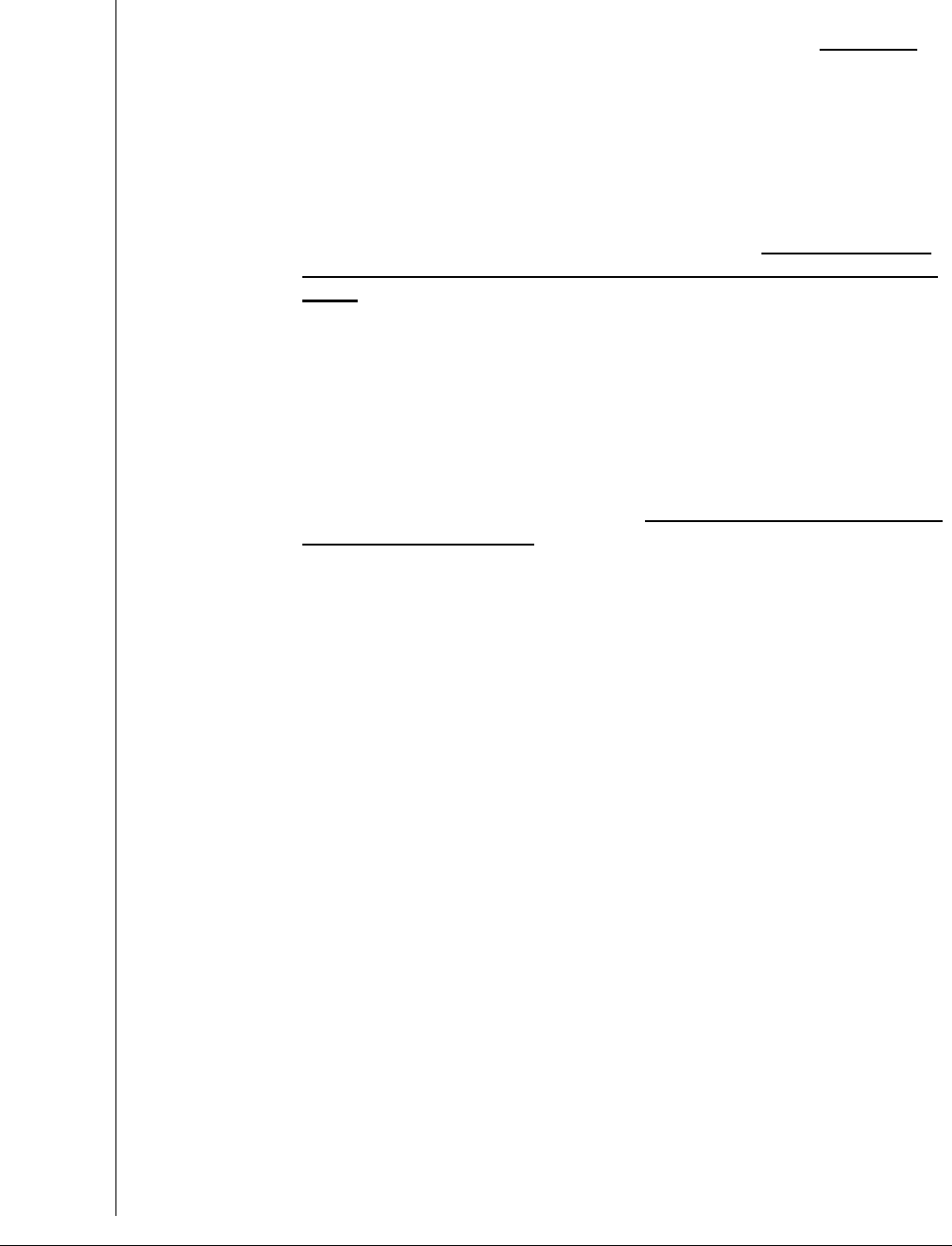
2015 993
ERROR CODE
A495
A4A0
A4B0
A4B2
A4B3
A4B4
A4BP
A4C0
A4D0
A4D1
A4DP
A4EP
A500
ERROR TEST
If TRAFFICWAY DESCRIPTION equals 0, then the first event in
SEQUENCE OF EVENTS for this vehicle should not equal 63,
64, 69 or 71.
If CRASH TYPE equals 01-16, then FIRST HARMFUL EVENT
must not equal 12.
If CRASH TYPE equals 01-10 or 14, then RELATION TO
TRAFFICWAY must not equal 01, 02, 07 or 11. If the FHE occurs
on a different road than the road it departed, see 98 (Other Crash
Type).
If CRASH TYPE equals 11, then RELATION TO TRAFFICWAY
must not equal 01, 03, 04, 05, 08, 10 or 11.
If CRASH TYPE equals 12 or 13, then RELATION TO
TRAFFICWAY must not equal 03, 05, 08 or 10.
If CRASH TYPE equals 12 or 13, then RELATION TO
TRAFFICWAY should not equal 04 unless the First Harmful Event
occurs in a bicycle lane.
If FIRST HARMFUL EVENT equals 54 or 55, then CRASH
TYPE must equal 98 for the vehicles involved in the first harmful
event.
If RELATION TO JUNCTION (b) equals 04, then at least one
PRE-EVENT MOVEMENT (PRIOR TO RECOGNITION OF
CRITICAL EVENT) for the vehicles involved in the first harmful
event should equal 10, 11, 13 or 98.
If PRE-EVENT MOVEMENT (PRIOR TO RECOGNITION OF
CRITICAL EVENT) equals 14, then ROADWAY ALIGNMENT
must equal 2-4.
If PRE-EVENT MOVEMENT (PRIOR TO RECOGNITION OF
CRITICAL EVENT) equals 01, then ROADWAY ALIGNMENT
should not equal 2-4.
If CRASH TYPE equals 20-91, then FIRST HARMFUL EVENT
must equal 12.
If CRASH TYPE equals 11, then FIRST HARMFUL EVENT must
equal 14.
If TOTAL LANES IN ROADWAY equals 3-7, then ROADWAY
SURFACE TYPE should not equal 4, 5, 7.

ERROR CODE
A510
A520
A521
A540
A550
A551
A560
A60F
A610
A611
ERROR TEST
If any AMOSPHERIC CONDITIONS equals 02-04, 11, 12, then
ROADWAY SURFACE CONDITIONS should not equal 01,
07, 08, 99 for any vehicle.
If SEQUENCE OF EVENTS equals 10, then TRAFFIC
CONTROL DEVICE should not equal 01-09, 20-29, 40-50, 98.
If any SEQUENCE OF EVENTS equals 46, then SPEED LIMIT
should equal 05-55, 98 or 99 for this vehicle.
If NOTIFICATION TIME EMS is not 8888, 9998, or 9999, and
ARRIVAL TIME EMS is not 8888, 9997, 9998, 9999, then
ARRIVAL TIME EMS should not be more than 120 minutes later
than NOTIFICATION TIME EMS.
If ARRIVAL TIME EMS is not 8888, 9997, 9998, or 9999, and
EMS TIME AT HOSPITAL is not 8888, 9997, 9998, 9999, then
EMS TIME AT HOSPITAL should not be more than 60 minutes
later than ARRIVAL TIME EMS.
If EMS TIME AT HOSPITAL equals 8888, 9997, 9998, then
TRANSPORTED TO FIRST MEDICAL FACILITY BY should not
equal 1, 3, 5 for any PERSON.
If NOTIFICATION TIME EMS is not 8888, 9998, or 9999, and
EMS TIME AT HOSPITAL is not 8888, 9997, 9998, 9999, then
EMS TIME AT HOSPITAL should not be more than 180 minutes
later than NOTIFICATION TIME EMS.
If FIRST HARMFUL EVENT equals 14, then CRASH TYPE
should equal 01-11, 14, 15, 92, 98, 99 for the in-transport
vehicle involved in the first harmful event.
If RELATION TO TRAFFICWAY equals 01, and RELATION TO
JUNCTION (b) equals 05, then TRAFFICWAY DESCRIPTION
should equal 6 for at least one vehicle involved in the first
harmful event.
If TRAFFICWAY DESCRIPTION equals 6 for at least one
vehicle involved in the first harmful event, then RELATION TO
JUNCTION (b) should equal 02, 03, 05, 17-20.
994 2015

2015 995
ERROR CODE
A61F
A61G
A61H
A61J
A61K
A612
A613
ERROR TEST
If FIRST HARMFUL EVENT equals 08, 09, 11, 15, 49, and
RELATION TO TRAFFICWAY equals 01, 02, 07, 11, and PRE-
EVENT MOVEMENT (PRIOR TO RECOGNITION OF
CRITICAL EVENT) is not equal to 00, 13 for the vehicle involved
in the first harmful event, then CRASH TYPE should equal 13
for the vehicle involved in the first harmful event.
If the FIRST HARMFUL EVENT equals 08, and PERSON TYPE
equals 05, and NON-MOTORIST LOCATION AT THE TIME OF
CRASH equals 21, 22, 24, 25, 28, and the NUMBER OF
MOTOR VEHICLE STRIKING NON-MOTORIST is involved in
the first harmful event, then CRASH TYPE should not equal 13
for this vehicle.
If the FIRST HARMFUL EVENT equals 09, and PERSON TYPE
equals 06, 07, and NON-MOTORIST LOCATION AT THE TIME
OF CRASH equals 21, 22, 24, 25, 28, and the NUMBER OF
MOTOR VEHICLE STRIKING NON-MOTORIST is involved in
the first harmful event, then CRASH TYPE should not equal 13
for this vehicle.
If the FIRST HARMFUL EVENT equals 15, and PERSON TYPE
equals 08, and NON-MOTORIST LOCATION AT THE TIME OF
CRASH equals 21, 22, 24, 25, 28, and the NUMBER OF
MOTOR VEHICLE STRIKING NON-MOTORIST is involved in
the first harmful event, then CRASH TYPE should not equal 13
for this vehicle.
If the FIRST HARMFUL EVENT equals 49, and PERSON TYPE
equals 04, and NON-MOTORIST LOCATION AT THE TIME OF
CRASH equals 21, 22, 24, 25, 28, and the NUMBER OF
MOTOR VEHICLE STRIKING NON-MOTORIST is involved in
the first harmful event, then CRASH TYPE should not equal 13
for this vehicle.
If PERSON TYPE equals 04, and NUMBER OF MOTOR
VEHICLE STRIKING NON-MOTORIST equals___, then at
least one SEQUENCE OF EVENTS must equal 10 or 49 for
that vehicle number in the CRASH EVENTS table.
If PERSON TYPE equals 05, and NUMBER OF MOTOR
VEHICLE STRIKING NON-MOTORIST equals___, then at
least one SEQUENCE OF EVENTS must equal 08 for that
vehicle number in the CRASH EVENTS table.

ERROR CODE
A614
A615
A616
A617
A618
A619
A61A
A61B
A620
ERROR TEST
If PERSON TYPE equals 06, and NUMBER OF MOTOR
VEHICLE STRIKING NON-MOTORIST equals___, then at
least one SEQUENCE OF EVENTS must equal 09 for that
vehicle number in the CRASH EVENTS table.
If PERSON TYPE equals 07, and NUMBER OF MOTOR
VEHICLE STRIKING NON-MOTORIST equals___, then at
least one SEQUENCE OF EVENTS must equal 09 for that
vehicle number in the CRASH EVENTS table.
If PERSON TYPE equals 08, and NUMBER OF MOTOR
VEHICLE STRIKING NON-MOTORIST equals___, then at
least one SEQUENCE OF EVENTS must equal 15 for that
vehicle number in the CRASH EVENTS table.
If PERSON TYPE equals 10, and NUMBER OF MOTOR
VEHICLE STRIKING NON-MOTORIST equals___, then at
least one SEQUENCE OF EVENTS must equal 08 for that
vehicle number in the CRASH EVENTS table.
If PERSON TYPE equals 19, and NUMBER OF MOTOR
VEHICLE STRIKING NON-MOTORIST equals___, then at
least one SEQUENCE OF EVENTS must equal 99 for that
vehicle number in the CRASH EVENTS table.
If the total count of PERSON TYPES is equal to 05 for the
vehicle in NUMBER OF MOTOR VEHICLE STRIKING NON-
MOTORIST is ____, then the number of events equal to 08 in
the CRASH EVENTS table should equal ____ for that
vehicle.
If the total count of PERSON TYPES is equal to 08 for the
vehicle in NUMBER OF MOTOR VEHICLE STRIKING NON-
MOTORIST is ____, then the number of events equal to 15 in
the CRASH EVENTS table should equal ____ for that
vehicle.
If the total count of PERSON TYPES is equal to 10 for the
vehicle in NUMBER OF MOTOR VEHICLE STRIKING NON-
MOTORIST is ____, then the number of events equal to 08 in
the CRASH EVENTS table should equal ____ for that
vehicle.
If CRASH TYPE equals 06-10, and TRAFFICWAY
DESCRIPTION equals 3, then RELATION TO TRAFFICWAY
should equal 03.
996 2015

2015 997
ERROR CODE
A62F
A63F
A65F
A66F
A67F
A700
A720
A770
A780
A790
A800
ERROR TEST
If FIRST HARMFUL EVENT equals 18, 43, or 73, and
RELATION TO TRAFFICWAY equals 01 or 11, then CRASH
TYPE should equal 12 or 15 for the vehicle involved in the first
harmful event.
If FIRST HARMFUL EVENT equals 01, then CRASH TYPE
should equal 01-10, 98, 99 for the vehicle involved in the first
harmful event.
If FIRST HARMFUL EVENT equals 14, and RELATED
FACTORS - PERSON (MV OCCUPANT) LEVEL equals 32 or
89 for an occupant of the parked vehicle involved in the
FIRST HARMFUL EVENT, then CRASH TYPE should equal
15, 92 or 98 for the in-transport vehicle involved in the First
Harmful Event.
If FIRST HARMFUL EVENT equals 14 and CRASH TYPE equals
01-10 or 14, then RELATED FACTORS - PERSON (MV
OCCUPANT) LEVEL must not equal 32 or 89 for any occupant of
the parked vehicle involved in the FIRST HARMFUL EVENT.
If FIRST HARMFUL EVENT equals 14 and CRASH TYPE equals
15, then RELATED FACTORS - PERSON (MV OCCUPANT) LEVEL
should equal 32 or 89 for an occupant of the parked vehicle.
If SPEED LIMIT is greater than 65 for every vehicle, then
ROUTE SIGNING should equal 1-4.
If LAND USE AND FUNCTIONAL SYSTEM (b) equals 01, 02,
then TRAFFICWAY DESCRIPTION should equal 2, 3, 6 for at
least one vehicle.
If FIRST HARMFUL EVENT equals 46, then TRAFFIC
CONTROL DEVICE should equal 01-04 for the vehicle involved
in the first harmful event.
If FIRST HARMFUL EVENT equals 46, then TRAFFIC
CONTROL DEVICE should not equal 00 for the vehicle involved
in the first harmful event.
If FIRST HARMFUL EVENT equals 46, then RELATION TO
JUNCTION (b) should not equal 01, 07.
If FIRST HARMFUL EVENT equals 46, then RELATION TO
TRAFFICWAY should not equal 01, 02, 05, 07, 11.

ERROR CODE
A801
A810
A820
A830
A840
A850
A860
A881
A882
A883
A890
A900
A910
ERROR TEST
If FIRST HARMFUL EVENT equals 12, then RELATION TO
TRAFFICWAY must not equal 5.
If FIRST HARMFUL EVENT equals 46, and RELATION TO
JUNCTION (a) equals 1, and RELATION TO JUNCTION (b)
does not equal 02, 03, 05, then LAND USE AND FUNCTIONAL
SYSTEM (b) should not equal 01.
If FIRST HARMFUL EVENT equals 46, and RELATION TO
JUNCTION (a) equals 1 and RELATION TO JUNCTION (b)
does not equal 02, 03, 05, then ROUTE SIGNING should not
equal 1.
If FIRST HARMFUL EVENT equals 46, then SPEED LIMIT
should be less than 55 for the vehicle involved in the first
harmful event.
If ROUTE SIGNING equals 7, then LAND USE AND
FUNCTIONAL SYSTEM (b) should equal 01-03.
If LAND USE AND FUNCTIONAL SYSTEM (b) equals 02, and
ROUTE SIGNING equals 2, then NATIONAL HIGHWAY
SYSTEM should equal 1.
If NATIONAL HIGHWAY SYSTEM equals 1, then LAND USE
AND FUNCTIONAL SYSTEM (b) should equal 01-03.
If RELATION TO TRAFFICWAY equals 11, then TRAFFICWAY
DESCRIPTION should equal 5 for at least one vehicle.
If RELATION TO TRAFFICWAY equals 07, then ROUTE
SIGNING should not equal 1.
If RELATION TO TRAFFICWAY equals 07, then LAND USE
AND FUNCTIONAL SYSTEM (b) should not equal 01.
If RELATION TO JUNCTION equals 01, then TRAFFIC
CONTROL DEVICE should not equal 01-03 for any vehicle
involved in the first harmful event.
If SPEED LIMIT equals 60, 65 for every vehicle, then LAND
USE AND FUNCTIONAL SYSTEM (b) should not equal 04-07
or 96.
If LAND USE AND FUNCTION SYSTEM (b) equals 04-07 or
96, then NATIONAL HIGHWAY SYSTEM should equal 0, 9.
998 2015

2015 999
ERROR CODE
A920
A930
A940
A945
A950
A955
A960
A961
A965
A970
A975
AB1P
ERROR TEST
If NATIONAL HIGHWAY SYSTEM equals 0, 9, then LAND USE
AND FUNCTIONAL SYSTEM (b) should not equal 02, and
ROUTE SIGNING should not equal 2.
If INTERSTATE HIGHWAY equals 1 and RELATION TO
JUNCTION (a) equals 1, and RELATION TO JUNCTION (b) is
not equal to 03 or 05 or 20, then TRAFFIC CONTROL DEVICE
should not equal 01-03, 20, 23 or 65 for at least one vehicle
involved in the first harmful event.
If STATE NUMBER equals 02, 11, 52,, then maximum SPEED
LIMIT (not including 98 or 99) should equal 55.
If STATE NUMBER equals 15, then maximum SPEED LIMIT
(not including 98 or 99) should equal 60.
If STATE NUMBER equals 09, 10, 25, 34, 36, 41, 43, 44, 50,
55,then maximum SPEED LIMIT (not including 98 or 99) should
equal 65.
If STATE NUMBER equals 01, 05, 06, 12, 13, 17, 18, 19, 21, 24,
26, 27, 28, 29, 33, 37, 39, 42, 45, 47, 51, 53, 54,then maximum
SPEED LIMIT (not including 98 or 99) should equal 70.
If STATE NUMBER equals 04, 08, 16, 20, 22, 23, 31, 35, 38, 40,
48, 49, 56,then maximum SPEED LIMIT (not including 98 or 99)
should equal 75.
If STATE NUMBER equals 30, 32, 46, then maximum SPEED
LIMIT (not including 98 or 99) should equal 80.
If PSU equals 06, 13, 16, 17, 24, 27, 28, 29, 45, 50, 52, then
maximum SPEED LIMIT (not including 98 or 99) should equal
65.
If PSU equals 03, 07, 09, 10, 11, 12, 14, 15, 18, 19, 21, 22, 23,
25, 30, 32, 33, 35, 36, 37, 38, 40, 41, 42, 43, 44, 46, 48, 51, 53,
54, 55, 56, 57, 59, 60, then maximum SPEED LIMIT (not
including 98 or 99) should equal 70.
If PSU equals 01, 02, 04, 05, 20, 26, 31, 34, 39, 47, 49, 58, then
maximum SPEED LIMIT (not including 98 or 99) should equal
75.
If VEHICLE CONFIGURATION equals 01, then CARGO BODY
TYPE must NOT equal 22.

ERROR CODE
AC0A
AC1A
AD0P
AE0P
AE1P
AF1P
AF2P
AH0P
AH1P
AH2P
AK00
AL0P
AL1P
AL2P
AL3P
ERROR TEST
If RELATION TO JUNCTION (b) equals 02, 03, then the second
TRAFFICWAY IDENTIFIER should not be all blank.
If FIRST HARMFUL EVENT equals 54, then MANNER OF
COLLISION should equal 11.
If VEHICLE CONFIGURATION equals 04, 06-08, then VEHICLE
TRAILING must not equal 0.
If VEHICLE CONFIGURATION equals 05 and CARGO BODY
TYPE does not equal 12, then VEHICLE TRAILING must equal
0.
If VEHICLE CONFIGURATION equals 05-08, then BODY TYPE
must equal 66.
If VEHICLE CONFIGURATION equals 20, then CARGO BODY
TYPE must equal 22.
If VEHICLE CONFIGURATION equals 20, 21, then BODY TYPE
must equal 20, 21, 50-52, 55, 58, 59.
If VEHICLE CONFIGURATION does not equal 00, 99, then
BODY TYPE should equal 15, 16, 21, 28, 31, 40, 41, 45, 48-52,
55, 58-64, 66, 67, 71, 72, 78, 92, 93, or HM2 must equal 2.
If BUS USE equals 08, then BODY TYPE must equal 21, 22,
28, 29, 50-59.
If BUS USE equals 06, then BODY TYPE should equal 21 or 52
or 55.
If CARGO BODY TYPE equals 22, 96, then JACKKNIFE should
equal 0.
If CARGO BODY TYPE equals 22, then BODY TYPE must
equal 21, 50-52, 55, 58, 59.
If SEQUENCE OF EVENTS equals 51, 62, 70, then VEHICLE
TRAILING must not equal 0.
If SEQUENCE OF EVENTS equals 45, then WORK ZONE
should equal 1-4.
If UNIT TYPE equals 2-4, then MOST HARMFUL EVENT must
not equal 54 for this vehicle.
1000 2015

2015 1001
ERROR CODE
AL4P
AL5P
AL6P
AL7P
AL8P
AM0P
AM1P
AM2P
AQ0P
AR0P
AS0P
AT00
AT10
ERROR TEST
If there is one and only one parked vehicle (UNIT TYPE equals
2 or 3) in the crash, then MOST HARMFUL EVENT for the
parked vehicle must not equal 14.
If UNIT TYPE equals 1, then at least one event in the
SEQUENCE OF EVENTS must equal the MOST HARMFUL
EVENT.
If MOST HARMFUL EVENT equals __, and UNIT TYPE equals
1, then at least one event in the SEQUENCE OF EVENTS must
equal ___.
If UNIT TYPE equals 2-4, then MOST HARMFUL EVENT
should not equal 04-07, 16, 51, 72.
If SEQUENCE OF EVENTS equals 51, 70, then JACKKNIFE
must equal 2, 3.
If CARGO BODY TYPE does not equal 00, 99, then BODY
TYPE should equal 15, 16, 21, 28, 31, 40, 41, 45, 48-52, 55,
58-64, 66, 67, 71, 72, 78, 92, 93, or HM2 must equal 2.
If FIRST HARMFUL EVENT equals 54 or 73, or SEQUENCE OF
EVENTS equals 54, 73 for any vehicle, then one RELATED
FACTORS-CRASH LEVEL must equal 14.
If any SEQUENCE OF EVENTS equals 25 or 57, then
TRAFFICWAY DESCRIPTION should equal 3, 6.
If REGISTRATION STATE equals 00, 92, then REGISTERED
VEHICLE OWNER must equal 0, 5, 6.
If SPECIAL USE equals 04, then REGISTERED VEHICLE
OWNER must not equal 0, 1-2, 4.
If RELATED FACTORS-VEHICLE LEVEL equals 32, then
REGISTERED VEHICLE OWNER must not equal 0.
An ATMOSPHERIC CONDITIONS 01-08, 10-12, 98, 99 can be
used only once per crash.
If first ATMOSPHERIC CONDITIONS equals 99, then second
ATMOSPHERIC CONDITIONS must equal 00.

ERROR CODE
AT20
AT30
AT40
AV0P
AZ1P
AZ20
AZ2P
AZ30
AZ50
AZ5P
AZ60
AZ6P
ERROR TEST
If first ATMOSPHERIC CONDITIONS equals 01-08, 10-12, 99,
then second ATMOSPHERIC CONDITIONS must not equal 99.
First ATMOSPHERIC CONDITIONS must not equal 00.
If the first ATMOSPHERIC CONDITIONS equals 01, then the
second ATMOSPHERIC CONDITIONS must equal 00 or 10.
If REGISTERED VEHICLE OWNER equals 3, 4, then
REGISTRATION STATE must not equal 99.
If UNIT TYPE equals 1, and FIRE OCCURRENCE equals 1,
then at least one SEQUENCE OF EVENTS must equal 02.
If UNIT TYPE equals 1, and DRIVER PRESENCE equals 0 or 9,
then PRE-EVENT MOVEMENT (PRIOR TO RECOGNITION OF
CRITICAL EVENT) must equal 00.
If FIRST HARMFUL EVENT does not equal 02-07, 16, 44, 51,
72, and CRITICAL EVENT-PRECRASH (EVENT) equals 14,
and ATTEMPTED AVOIDANCE MANEUVER equals 01, then
CRASH TYPE must equal 14 for the vehicle involved in the first
harmful event.
If PRE-EVENT MOVEMENT (PRIOR TO RECOGNITION OF
CRITICAL EVENT) equals 00, then ATTEMPTED AVOIDANCE
MANEUVER must equal 00.
If PRE-EVENT MOVEMENT (PRIOR TO RECOGNITION OF
CRITICAL EVENT) equals 00, then PRE-IMPACT STABILITY
must equal 0.
If CRITICAL EVENT-PRECRASH (EVENT) equals 70-73 for a
vehicle involved in the first harmful event, then RELATION TO
JUNCTION (b) should equal 04 or 08.
If PRE-IMPACT STABILITY equals 0, then PRE-EVENT
MOVEMENT (PRIOR TO RECOGNITION OF CRITICAL
EVENT) must equal 00.
If any DRIVER MANEUVERED TO AVOID equals 00, then
PRE-EVENT MOVEMENT (PRIOR TO RECOGNITION OF
CRITICAL EVENT) must not equal 17.
1002 2015

2015 1003
ERROR CODE
AZ70
AZ7P
AZ80
AZA0
AZBP
AZCP
AZDQ
AZEP
B10P
B13P
ERROR TEST
If PRE-IMPACT LOCATION equals 0, then PRE-EVENT
MOVEMENT (PRIOR TO RECOGNITION OF CRITICAL
EVENT) must equal 00.
If any DRIVER MANEUVERED TO AVOID equals 00 or 95 or
98 or 99, then only that one code and no other must be coded
for this vehicle.
If PRE-EVENT MOVEMENT (PRIOR TO RECOGNITION OF
CRITICAL EVENT) equals 00, then PRE-IMPACT LOCATION
must equal 0.
If PRE-EVENT MOVEMENT (PRIOR TO RECOGNITION OF
CRITICAL EVENT) equals 05 or 07, then TRAVEL SPEED
should equal 000 for this vehicle.
If any DRIVER MANEUVERED TO AVOID equals 03, then
CRITICAL EVENT – PRECRASH (EVENT) should equal
87-89.
If any DRIVER MANEUVERED TO AVOID equals 05, then
CRITICAL EVENT – PRECRASH (EVENT) should equal
80-85.
If DRIVER MANEUVERED TO AVOID equals 04, then
NUMBER OF VEHICLE FORMS SUBMITTED must be greater
than 001.
If any DRIVER MANEUVERED TO AVOID equals 01, then
CRITICAL EVENT – PRECRASH (EVENT) should equal
90-92.
If PRE-EVENT MOVEMENT (PRIOR TO RECOGNITION OF
CRITICAL EVENT) does not equal 17, and ATTEMPTED
AVOIDANCE MANUEVER equals 01, then DRIVER
MANEUVERED TO AVOID should equal 00.
If CRASH TYPE equals 20-49, and ATTEMPTED AVOIDANCE
MANEUVER equals 00-01, then CRITICAL EVENT-PRECRASH
(EVENT) should not equal 12-14, 54, 66-68, 71-73 or 80-85.

ERROR CODE
B15P
B16P
B17P
BA0P
BB0P
BF0F
BI0P
BJ0P
BJ1P
BJ2P
BJ3P
BJ4P
BJ7P
ERROR TEST
If CRITICAL EVENT-PRECRASH (EVENT) equals 91, and
ATTEMPTED AVOIDANCE MANEUVER equals 00, 01, and the
vehicle is involved in the first harmful event, then CRASH TYPE
should equal 15.
If CRITICAL EVENT-PRECRASH (EVENT) equals 90, and
ATTEMPTED AVOIDANCE MANEUVER equals 01, and the
vehicle is involved in the first harmful event, then CRASH TYPE
should equal 12 or 15.
If CONDITION (IMPAIRMENT) AT TIME OF CRASH (D23)
equals 09 for this driver, then CRITICAL EVENT:
PRECRASH (EVENT) should not equal 08 for this driver’s
vehicle.
If EJECTION equals 0, 7, 8 or 9, then EJECTION PATH must
equal 0.
If EJECTION equals 1-3, then EJECTION PATH must equal 1-9.
If PERSON TYPE equals 04-08, 10, 19, then EJECTION must
equal 8.
If DRIVER’S LICENSE STATE equals 99, then COMPLIANCE
WITH CDL ENDORSEMENTS must not equal 1, 2.
If DRIVER PRESENCE equals 0, 9, then COMPLIANCE
WITH CDL ENDORSEMENTS must be blank.
If UNIT TYPE equals 1, and DRIVER PRESENCE equals 0 or 9,
then DRIVER DISTRACTED BY must equal 16.
If UNIT TYPE equals 1, and DRIVER PRESENCE equals 1,
then DRIVER DISTRACTED BY must not equal 16 or blank.
If UNIT TYPE equals 1, and DRIVER DISTRACTED BY equals
16, then DRIVER PRESENCE must equal 0 or 9.
If any DRIVER DISTRACTED BY equals 03, then NUMBER OF
OCCUPANTS must be greater than 01.
If any DRIVER DISTRACTED BY equals 00 or 01 or 16 or 17 or
18 or 19 or 92 or 93 or 96 or 99, then only that one code and no
other must be used.
1004 2015

2015 1005
ERROR CODE
BK0P
BL0P
BN0P
BP0P
BQ0P
BR0P
BT1P
BT2P
BT3P
BT6P
ERROR TEST
If LICENSE COMPLIANCE WITH CLASS OF VEHICLE equals
1, then COMPLIANCE WITH CDL ENDORSEMENTS must not
equal 1-3, 9.
If COMPLIANCE WITH CDL ENDORSEMENTS equals 1, and
any RELATED FACTORS-DRIVER LEVEL equals 19, then
LICENSE COMPLIANCE WITH CLASS OF VEHICLE must
equal 3.
If DRIVER PRESENCE equals 0, 9, then COMMERCIAL
MOTOR VEHICLE LICENSE STATUS must be blank.
If MODEL YEAR is greater than 1999, and BODY TYPE does
not equal 50-52, 58-66, 71-79, 80-83, 88-93, 95, 97 and
SEATING POSITION equals 11, 13, 18, 19 then AIRBAG
DEPLOYED should not equal 00.
If METHOD OF DRUG DETERMINATION BY POLICE equals 8,
then POLICE-REPORTED DRUG INVOLVEMENT must equal
0, 1, 8, 9.
If METHOD OF DRUG DETERMINATION BY POLICE equals
1-7, then POLICE-REPORTED DRUG INVOLVEMENT must
equal 0, 1, 8.
If DRUG TEST STATUS equals 0, 1, then all DRUG TEST
TYPE must equal 0, and all DRUG TEST RESULT must equal
000.
If DRUG TEST STATUS equals 8, then DRUG TEST TYPE 1
must equal 6, and all DRUG TEST RESULT 1 must equal 095
and remaining DRUG TEST TYPES and DRUG TEST
RESULTS must be 0 filled.
If DRUG TEST STATUS equals 2, then at least one DRUG
TEST TYPE must equal 1-8, and one corresponding DRUG
TEST RESULT must equal 001, 095, 100-295, 300-395, 400-
495, 500-595, 600-695, 700-795, 800-895, 900-995, 996-998.
If DRUG TEST STATUS equals 9, then all DRUG TEST TYPE
must equal 9, and DRUG TEST TYPE 1 must equal 9, and all
DRUG TEST RESULT 1 must equal 999 and remaining DRUG
TEST TYPES and DRUG TEST RESULTS must be 0 filled.

ERROR CODE
BT7P
BT8P
BT9P
BY0P
BZ10
BZ20
BZ40
BZ50
BZ60
BZ70
BZ80
BZ90
ERROR TEST
If DRUG TEST STATUS equals 2, and DRUG TEST RESULT
one equals 001, 095, 100-295, 300-395, 400-495, 500-595, 600-
695, 700-795, 800-895, 900-995, 996, 997, 998, then DRUG
TEST RESULT two and three must not equal 999.
More than one of the same DRUG TEST RESULT values must
not be coded for the same person except for 000, 996.
If DRUG TEST RESULT 1 equals 000, 001, 997, 998, 095, or
999, then DRUG TEST RESULT 2 and DRUG TEST RESULT 3
must equal 000.
DRIVER’S ZIP CODE must be a valid code, blanks, 00000 or
99999.
If CRITICAL EVENT- PRECRASH (EVENT) equals 53, then
AREAS OF IMPACT-INITIAL CONTACT POINT should not
equal 12 for this vehicle.
If CRITICAL EVENT-PRECRASH (EVENT) equals 51, 52, then
AREAS OF IMPACT-INITIAL CONTACT POINT should not
equal 06 for this vehicle.
If CRITICAL EVENT - PRECRASH (EVENT) equals 01, then at
least one SEQUENCE OF EVENTS must equal 61 for this
vehicle.
If CRITICAL EVENT - PRECRASH (EVENT) equals 12, and
PRE-IMPACT LOCATION is not equal to 5, then at least one
SEQUENCE OF EVENTS must equal 64 for this vehicle.
If CRITICAL EVENT - PRECRASH (EVENT) equals 13, and
PRE-IMPACT LOCATION is not equal to 5, then at least one
SEQUENCE OF EVENTS must equal 63 for this vehicle.
If CRITICAL EVENT - PRECRASH (EVENT) equals 14, then at
least one SEQUENCE OF EVENTS must equal 71 for this
vehicle.
If MANNER OF COLLISION equals 00, then PRECRASH –
CRASH TYPE must equal 00, 01-16, 92, 98, 99 for the vehicle
in the first harmful event.
If CRASH TYPE equals 01-05, and PRE-IMPACT LOCATION is
not equal to 0 or 5, then at least one SEQUENCE OF EVENTS
prior to the first harmful event must equal 63.
1006 2015

2015 1007
ERROR CODE
BZ91
CB0P
CC0P
CG0P
CI0P
CJ00
CK0P
CL0P
CM0P
CSI1
CSI2
CSI3
ERROR TEST
If CRASH TYPE equals 06-10, and PRE-IMPACT LOCATION is
not equal to 0 or 5, then at least one SEQUENCE OF EVENTS
prior to the first harmful event must equal 64.
If REGISTERED VEHICLE OWNER equals 6, then DRIVER
PRESENCE must equal 0.
If COMMERCIAL MOTOR VEHICLE LICENSE STATUS equals
00, 99, then COMPLIANCE WITH CDL ENDORSEMENTS must
not equal 1.
If LICENSE COMPLIANCE WITH CLASS OF VEHICLE equals
0, then COMPLIANCE WITH CDL ENDORSEMENTS must not
equal 1, 3.
If VEHICLE TRAILING equals 1-4, then JACKKNIFE must not
equal 0.
If PREVIOUS RECORDED CRASHES equals 98, then
DRIVER’S LICENSE STATE should equal 09, 13, 28, 30, 35,
49.
If PERSON TYPE equals 07, then RELATED FACTORS-
PERSON LEVEL (Not a MV Occupant) must not equal 09, 13,
69, 70, 86-87, 90.
If PERSON TYPE equals 09, then RELATED FACTORS-
PERSON LEVEL (MV Occupant) must not equal 21, 26, 28, 29,
33, 37, 40-42, 44, 45, 47, 51, 52, 56-70, 72-78, 80-83, 91.
If PERSON TYPE equals 19, then RELATED FACTORS-
PERSON LEVEL (Not a MV Occupant) must not equal 13,
69, 70, 90.
NUMBER OF VEHICLE FORMS must equal the actual number
of Vehicle Level forms for this case.
There must be exactly one Driver Level form corresponding to
each Vehicle Level form.
NUMBER OF MOTOR VEHICLE OCCUPANT FORMS
SUBMITTED must equal the actual number of Person Level
(Motor Vehicle Occupant) forms for this case.

ERROR CODE
CSI4
CSI5
CSI6
CSI7
D010
D020
D030
D040
D050
D060
D080
D090
ERROR TEST
NUMBER OF FORMS SUBMITTED FOR PERSONS NOT IN
MOTOR VEHICLES must equal the actual number of persons
not in motor vehicles in this case.
If VEHICLE NUMBER at the Person Level is greater than 000,
then VEHICLE NUMBER at the Person Level must equal a
VEHICLE NUMBER at the Vehicle Level.
For each VEHICLE NUMBER, PERSON NUMBERS must be
consecutive, beginning with 001 and with no gaps.
PERSON NUMBERS for persons not in motor vehicles must be
consecutive, beginning with 001 and with no gaps.
If DRIVER’S LICENSE STATE equals 96, 97, then PREVIOUS
RECORDED CRASHES should equal 99.
If DRIVER’S LICENSE STATE equals 96, 97, then PREVIOUS
RECORDED SUSPENSIONS AND REVOCATIONS should
equal 99.
If DRIVER’S LICENSE STATE equals 96, 97, then PREVIOUS
DWI CONVICTIONS should equal 99.
If DRIVER’S LICENSE STATE equals 96, 97, then PREVIOUS
SPEEDING CONVICTIONS should equal 99.
If DRIVER’S LICENSE STATE equals 96, 97, then PREVIOUS
OTHER MOVING VIOLATION CONVICTIONS should equal 99.
If NON-CDL LICENSE STATUS equals 1-4, 6, or COMMER-
CIAL MOTOR VEHICLE LICENSE STATUS equals 1-8, and
PERSON TYPE equals 01, then AGE should not be less than
015.
If VIOLATION CHARGED equals 01-06, 09, 31-69, 81-91, 98,
then RELATED FACTORS-DRIVER LEVEL should not all equal
00, 99.
If VIOLATIONS CHARGED equals 11-19, and PERSON TYPE
equals 01, 03, then POLICE-REPORTED ALCOHOL
INVOLVEMENT should equal 1, or POLICE-REPORTED DRUG
INVOLVEMENT should equal 1.
1008 2015

2015 1009
ERROR CODE
D091
D092
D093
D100
D110
D120
D130
D140
D150
D160
D180
D260
ERROR TEST
DRIVER LICENSE NUMBER must not equal the VEHICLE
LICENSE PLATE NUMBER for the vehicle driven.
If any DRIVER LICENSE NUMBER that does not equal 0’s or
9’s, then DRIVER LICENSE NUMBER must be unique within
a crash.
IF Any VEHICLE LICENSE PLATE NUMBER that does not
equal 0000000000 , 9999999999 or 9999999998, then
VEHICLE LICENSE PLATE NUMBER must be unique within
a crash.
If NON-CDL LICENSE STATUS equals 9, then all driver history
counters PREVIOUS RECORDED CRASHES should equal 99.
If NON-CDL LICENSE STATUS equals 9, then all driver history
counters PREVIOUS RECORDED SUSPENSIONS AND
REVOCATIONS should equal 99.
If NON-CDL LICENSE STATUS equals 9, then all driver history
counters PREVIOUS DWI CONVICTIONS should equal 99.
If NON-CDL LICENSE STATUS equals 9, then all driver history
counters PREVIOUS SPEEDING CONVICTIONS should equal
99.
If NON-CDL LICENSE STATUS equals 9, then all driver history
counters PREVIOUS OTHER MOVING VIOLATION
CONVICTIONS should equal 99.
If the sum of all counters less than 98 is greater than five but
less than fifteen, then DATE OF LAST CRASH, SUSPENSION,
CONVICTION should not equal DATE OF FIRST CRASH,
SUSPENSION, CONVICTION.
If NON-CDL LICENSE STATUS does not equal 9, or COMMER-
CIAL MOTOR VEHICLE LICENSE STATUS does not equal 99,
then DRIVER’S ZIP CODE should not equal 99999.
If DRIVER LICENSE STATE equals 95-97, then DRIVER ZIP
CODE should not equal 99999.
If NON-CDL LICENSE STATUS equals 9, or COMMERCIAL
MOTOR VEHICLE LICENSE STATUS equals 99, then
COMPLIANCE WITH LICENSE RESTRICTIONS should not
equal 0.

ERROR CODE
D270
D280
D300
D310
D320
D330
D340
D350
D380
D390
D400
D410
ERROR TEST
If BODY TYPE equals 50-52, 55, 63, 66, 72, or HM1 equals 2,
then COMMERCIAL MOTOR VEHICLE LICENSE STATUS
should not equal 00.
If VEHICLE CONFIGURATION equals 05-08, 21, or HM1 equals
2, then COMMERCIAL MOTOR VEHICLE LICENSE STATUS
should not equal 00.
If HM2 equals 2, then COMMERCIAL MOTOR VEHICLE
LICENSE STATUS should not equal 00 or 99.
If HM2 equals 2, then COMPLIANCE WITH CDL ENDORSE-
MENTS should equal 1-3.
If DRIVER’S LICENSE STATE does not equal 93-99, then
DRIVER’S ZIP CODE should equal 9999 or be a valid zip code
for DRIVER’S LICENSE STATE.
If DRIVER PRESENCE equals 0, and REGISTRATION STATE
is not equal to 00, 92, 99, then REGISTERED VEHICLE
OWNER should equal 3-6.
If NON-CDL LICENSE STATUS equals 1-4, 6, 9, or
COMMERCIAL MOTOR VEHICLE LICENSE STATUS equals
01-08, 99, then LICENSE COMPLIANCE WITH CLASS OF
VEHICLE should not equal 0.
If VIOLATIONS CHARGED equals 71, then NON-CDL LICENSE
STATUS should not equal 0, 3, 6, 9.
If NON-CDL LICENSE STATUS equals 9, then LICENSE
COMPLIANCE WITH CLASS OF VEHICLE should equal 1, 9.
If NON-CDL LICENSE STATUS equals 0, then LICENSE
COMPLIANCE WITH CLASS OF VEHICLE should not equal
2, 3, 8, 9.
If NON-CDL LICENSE STATUS equals 0-4, then LICENSE
COMPLIANCE WITH CLASS OF VEHICLE should not equal
3, 8, 9.
If LICENSE COMPLIANCE WITH CLASS OF VEHICLE equals
0, then COMPLIANCE WITH CDL ENDORSEMENTS should
not equal 1-3, 9.
1010 2015

2015 1011
ERROR CODE
D420
D430
D440
D450
D460
D470
D480
D500
D530
D560
D570
D580
D5A0
ERROR TEST
If COMMERCIAL MOTOR VEHICLE LICENSE STATUS equals
0, then COMPLIANCE WITH CDL ENDORSEMENTS should
not equal 1-3.
If COMPLIANCE WITH CDL ENDORSEMENTS equals
1-3, then COMMERCIAL MOTOR VEHICLE LICENSE STATUS
should not equal 00.
If COMMERCIAL MOTOR VEHICLE LICENSE STATUS equals
00, then BODY TYPE should not equal 50-52, 55, 63, 66, 72,
and HM2 should not equal 2.
If COMMERCIAL MOTOR VEHICLE LICENSE STATUS equals
00, then VEHICLE CONFIGURATION should not equal 05-08,
21, and HM2 should not equal 2.
If COMMERCIAL MOTOR VEHICLE LICENSE STATUS equals
9, then COMPLIANCE WITH CDL ENDORSEMENTS should
equal 0, 3, 9.
If any RELATED FACTORS-DRIVER LEVEL equals 37, then at
least one RELATED FACTORS-CRASH LEVEL should equal
20.
If DRIVER’S LICENSE STATE equals 09, 13, 28, 30, 35, 49,
then PREVIOUS RECORDED CRASHES should equal 98.
If VIOLATIONS CHARGED equals 05, then at least one
RELATED FACTORS-CRASH LEVEL should equal 20.
If any VIOLATIONS CHARGED equals 36 for a vehicle involved
in the first harmful event, then RELATION TO JUNCTION (b)
should equal 06.
If VIOLATIONS CHARGED equals 66, then BODY TYPE should
equal 80-83, 88, 89.
If any VIOLATIONS CHARGED equal 83, then not all occupants
of this vehicle should have RESTRAINT SYSTEM/HELMET
USE equal 01-05, 08, 10-12, 16, 19.
If VIOLATIONS CHARGED equals 85, then HM1 should equal
2.
If VIOLATIONS CHARGED equals 21-25, 29, then SPEEDING
RELATED must equal 2-5.

ERROR CODE
D5B0
D5E0
D600
D610
D620
D630
D640
D650
D680
D690
D700
D710
D730
ERROR TEST
If any VIOLATIONS CHARGED equals 11-13, 18, 19, then at
least one CONDITION (IMPAIRMENT) AT TIME OF CRASH
(D23) should equal 09.
If any VIOLATIONS CHARGED equals 00 or 97, then only that
one code and no other must be coded for this driver.
If DRIVER HEIGHT/INCHES is greater than 11, then DRIVER
HEIGHT/INCHES should not be less than 48.
If DRIVER HEIGHT/FEET is not blank, then DRIVER
HEIGHT/FEET should not be less than 3.
If NON-CDL LICENSE TYPE equals 7, then AGE (for the driver)
should equal 014-016.
If NON-CDL LICENSE TYPE equals 2, then AGE (for the driver)
should equal 015-017.
If AGE equals 014-017, and PERSON TYPE equals 01, then
NON-CDL LICENSE TYPE should equal 2, 7.
If AGE equals 018-120, and PERSON TYPE equals 01, and
NON-CDL LICENSE STATUS does not equal 0, then NON-CDL
LICENSE TYPE should equal 1.
If NON-CDL LICENSE TYPE does not equal 0, 9, then NON-
CDL LICENSE STATUS should not equal 0, 9.
If NON-CDL LICENSE TYPE equals 2, 7, and COMPLIANCE
WITH LICENSE RESTRICTIONS equals 2, then RELATED
FACTORS-DRIVER LEVEL should equal 73, 74.
If NON-CDL LICENSE TYPE equals 1, and COMPLIANCE
WITH LICENSE RESTRICTIONS equals 2, then RELATED
FACTORS-DRIVER LEVEL should equal 74.
If DRIVER’S LICENSE STATE equals 02, 04, 09, 15, 20, 30, 38,
40, 56, then NON-CDL LICENSE TYPE should not equal 2.
If RELATED FACTORS-DRIVER LEVEL equals 73, then
COMPLIANCE WITH LICENSE RESTRICTIONS should equal
2, and NON-CDL LICENSE TYPE should equal 2, 7.
1012 2015

2015 1013
ERROR CODE
E01P
E02P
E03P
E04P
E05P
E06P
E07P
E08P
FA0F
FA1F
FD0F
FP0F
FP1F
FP2F
FP3F
FP4F
ERROR TEST
If NOTIFICATION TIME EMS equals 9998, then ARRIVAL TIME
EMS must equal 9998, and EMS TIME AT HOSPITAL must
equal 8888 or 9998.
If ARRIVAL TIME EMS equals 9998, then EMS TIME AT
HOSPITAL must equal 8888 or 9998.
If ARRIVAL TIME EMS equals 8888, then NOTIFICATION
TIME EMS and EMS TIME AT HOSPITAL must equal 8888.
If NOTIFICATION TIME EMS equals 8888, then ARRIVAL TIME
EMS and EMS TIME AT HOSPITAL must equal 8888.
If EMS TIME AT HOSPITAL equals 9997, then ARRIVAL TIME
EMS must equal 9997.
If ARRIVAL TIME EMS equals 9997, then EMS TIME AT
HOSPITAL must equal 9997.
If ARRIVAL TIME EMS equals 9997, then NOTIFICATION
TIME EMS must not equal 8888, 9998.
If NOTIFICATION TIME EMS is not 8888, 9998, and EMS TIME
AT HOSPITAL is not 8888, 9996, 9997, 9998, then ARRIVAL
TIME EMS must not equal 9997 or 9998.
If FIRST HARMFUL EVENT equals blank, case status is flawed.
CRASH TYPE for all in-transport vehicles not involved in the first
harmful event must equal 98.
If DRIVER PRESENCE is blank, case status is flawed.
If PERSON TYPE is blank, case status is flawed.
If AREAS OF IMPACT - INITIAL CONTACT POINT equals
blank, case status is flawed.
If UNIT TYPE equals 1, and CRASH TYPE equals blank, case
status is flawed.
If UNIT TYPE is blank, case status is flawed.
If CRASH DATE is blank, case status is flawed.
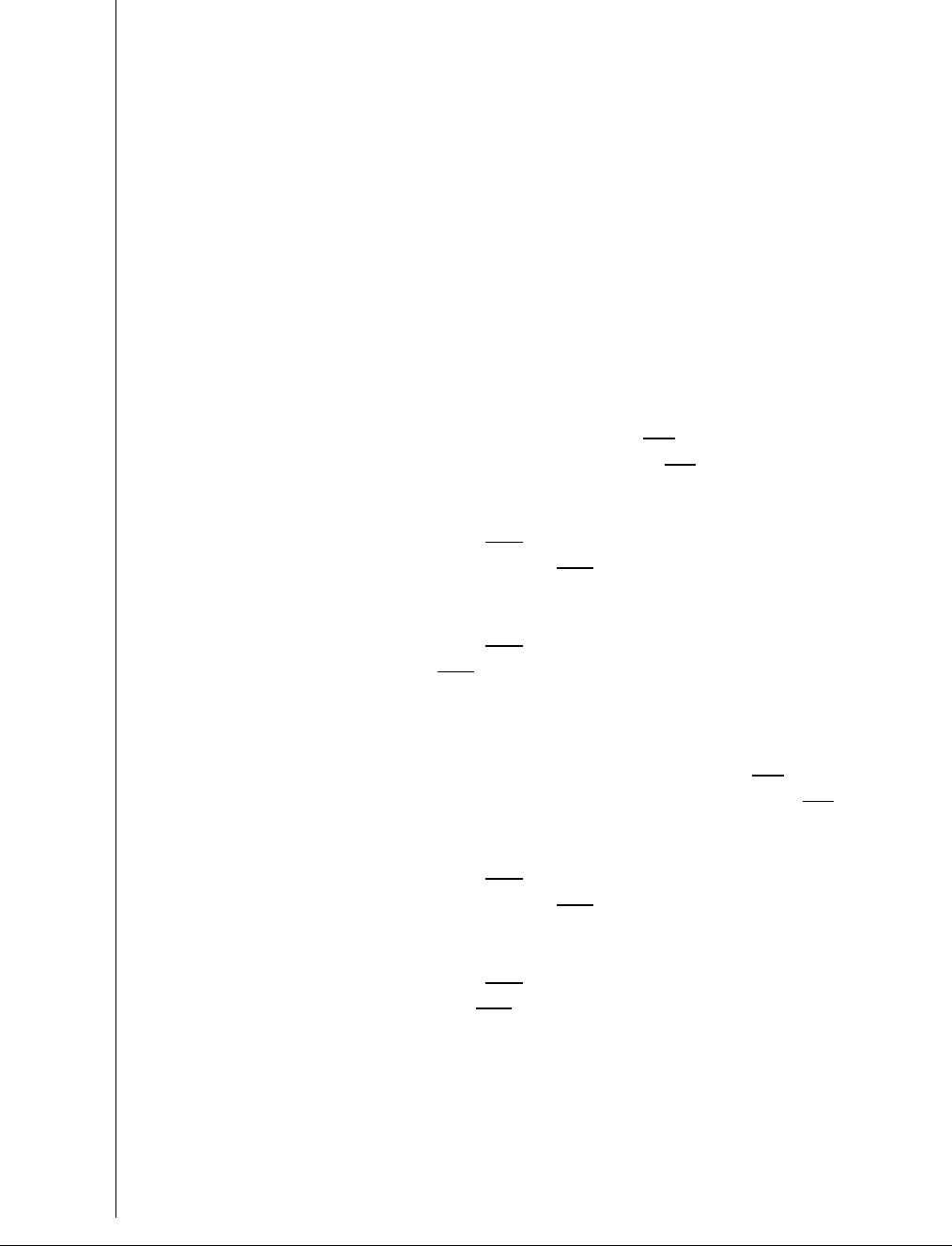
ERROR CODE
FP5F
FP6F
FP7F
FP8F
FP9F
G01P
G02P
G03P
G04P
G05P
G06P
G07P
G08P
ERROR TEST
If CRASH TIME is blank, case status is flawed.
If UNIT TYPE equals 1, and CRITICAL EVENT – PRECRASH
(CATEGORY) equals blank, case status is flawed.
If UNIT TYPE equals 1, and CRITICAL EVENT – PRECRASH
(EVENT) equals blank, case status is flawed.
If INJURY SEVERITY is blank, case status is flawed.
If PERSON TYPE equals 05, 06, 07, 08 and the PEDESTRIAN/
BIKE - CRASH TYPE equals blank, case status is flawed.
If STATE is ____ and GLOBAL POSITION - LATITUDE
(degrees) is not equal to 77, 88, 99, then LATITUDE (degrees)
must be equal to, or greater than ( 1d ) and LATITUDE
(degrees) must not be greater than ( 2d ).
If STATE is ____ and GLOBAL POSITION - LATITUDE
(degrees) equals ( 1d ), then LATITUDE (minutes) must be
equal to, or greater than ( 1s ).
If STATE is ____ and GLOBAL POSITION - LATITUDE
(degrees) equals ( 2d ), then LATITUDE (minutes) must not be
greater than ( 2s ).
If STATE is ____ and GLOBAL POSITION - LONGITUDE
(degrees) is not equal to 777, 888, 999, then LONGITUDE
(degrees) must be equal to, or greater than, ( 3d ) and
LONGITUDE (degrees) must not be greater than ( 4d ).
If STATE is ____ and GLOBAL POSITION - LONGITUDE
(degrees) equals ( 3d ), then LONGITUDE (minutes) must be
equal to, or greater than ( 3s ).
If STATE is ____ and GLOBAL POSITION - LONGITUDE
(degrees) equals ( 4d ), then LONGITUDE (minutes) must not
be greater than ( 4s ).
If any part of GLOBAL POSITION - LATITUDE (degrees,
minutes or seconds) is all 8’s, then all parts of LATITUDE must
be all 8’s.
If any part of GLOBAL POSITION - LONGITUDE (degrees,
minutes or seconds) is all 8’s, then all parts of LONGITUDE
must be all 8’s.
1014 2015

2015 1015
ERROR CODE
G09P
G10P
G11P
G12P
G0AP
G0BP
P010
P01F
P020
P030
P040
P050
ERROR TEST
If any part of GLOBAL POSITION - LATITUDE (degrees,
minutes or seconds) is all 9’s, then all parts of LATITUDE must
be all 9’s.
If any part of GLOBAL POSITION - LONGITUDE (degrees,
minutes or seconds) is all 9’s, then all parts of LONGITUDE
must be all 9’s.
If any part of GLOBAL POSITION - LATITUDE (degrees,
minutes or seconds) is blank, then all parts of LATITUDE must
be blank.
If any part of GLOBAL POSITION - LONGITUDE (degrees,
minutes or seconds) is blank, then all parts of LONGITUDE must
be blank.
If any part of GLOBAL POSITION - LONGITUDE (degrees,
minutes or seconds) is all 7’s, then all parts of LONGITUDE
must be all 7’s.
If any part of GLOBAL POSITION - LATITUDE (degrees,
minutes or seconds) is all 7’s, then all parts of LATITUDE must
be all 7’s.
If PERSON TYPE equals 01, then AGE should not be less than
012.
If PERSON TYPE equals 01-03, 09, and RESTRAINT SYSTEM/
HELMET USE equals 01-04, 08, 10-12, and BODY TYPE does
not equal 80-89, then EJECTION should equal 0 or 7.
If PERSON TYPE equals 02, 03, 09, and RESTRAINT
SYSTEM/HELMET USE equals 04, 10-12, then AGE should be
less than 010, or equal to 998 or 999.
If PERSON TYPE equals 01, then SEATING POSITION should
not equal 12-19.
If PERSON TYPE equals 02, 09, then SEATING POSITION
should not equal 11.
If EJECTION equals 1, then RESTRAINT SYSTEM/HELMET
USE should not equal 01-04, 08, 10-12.

ERROR CODE
P060
P071
P072
P073
P074
P075
P080
P090
P091
P093
P094
ERROR TEST
If SEATING POSITION equals 18, 28, 38, 48, 50-55, then
RESTRAINT SYSTEM/HELMET USE should not equal 01, 03.
If PERSON TYPE equals 02, 04-08, 10, and INJURY
SEVERITY does not equal 4, then ALCOHOL TEST STATUS
should not equal 9, and ALCOHOL TEST TYPE should not
equal 99, and ALCOHOL TEST RESULT should not equal 999.
If PERSON TYPE equals 02, 03, and INJURY SEVERITY
equals 0, and ALCOHOL TEST RESULT equals 996, then
POLICE-REPORTED ALCOHOL INVOLVEMENT should equal
0, 8.
If PERSON TYPE equals 02, 04-08, 10, and INJURY
SEVERITY does not equal 4, then DRUG TEST STATUS
should not equal 9, and any DRUG TEST TYPE should not
equal 9, and any DRUG TEST RESULTS should not equal 999.
If PERSON TYPE equals 02, 04-08, 10, and INJURY
SEVERITY does not equal 4, then ALCOHOL TEST STATUS
must not equal 8, ALCOHOL TEST TYPE must not equal 95,
and ALCOHOL TEST RESULT must not equal 995.
If PERSON TYPE equals 02, 04-08, 10 or 19, and INJURY
SEVERITY does not equal 4, then DRUG TEST STATUS must
not equal 8, any DRUG TEST TYPE must not equal 6, and any
DRUG TEST RESULTS must not equal 095.
ALCOHOL TEST RESULTS should not equal 340-940.
If INJURY SEVERITY equals 0, then TRANSPORTED TO
FIRST MEDICAL FACILITY BY must equal 0.
If TRANSPORTED TO FIRST MEDICAL FACILITY BY equals 1,
3, 5, then EMS TIME AT HOSPITAL should not equal 8888,
9997, 9998.
If all persons TRANSPORTED TO FIRST MEDICAL FACILITY
BY equals 2, 4, then NOTIFICATION TIME EMS, ARRIVAL
TIME EMS, EMS TIME AT HOSPITAL must equal 8888.
If EJECTION equals 8, then SEATING POSITION must equal
55, or BODY TYPE must equal 80-83, 88, 89.
1016 2015

2015 1017
ERROR CODE
P110
P130
P140
P150
P160
P170
P180
P1A0
P200
P210
P230
P260
P290
ERROR TEST
If METHOD OF ALCOHOL DETERMINATION BY POLICE
equals 1-5, 8, then POLICE-REPORTED ALCOHOL INVOLVE-
MENT should equal 0, 1.
If BODY TYPE equals 60-67, 71, 72, 78, 79, and PERSON
TYPE equals 01, 03, and INJURY SEVERITY equals 4, then
FATAL INJURY AT WORK should equal 1.
If POLICE-REPORTED DRUG INVOLVEMENT equals 8, 9,
then METHOD OF DRUG DETERMINATION BY POLICE
should equal 8.
If POLICE-REPORTED DRUG INVOLVEMENT equals 1, then
DRUG TEST STATUS should not equal 0.
If POLICE-REPORTED DRUG INVOLVEMENT equals 1, and
METHOD OF DRUG DETERMINATION BY POLICE equals 2,
then not all DRUG TEST RESULTS should equal 001.
If METHOD OF DRUG DETERMINATION BY POLICE equals
1-7, then POLICE-REPORTED DRUG INVOLVEMENT should
equal 0, 1.
If PERSON TYPE equals 01, and AGE is less than 009, then
BODY TYPE should not equal 90.
If AGE is less than 012, and INJURY SEVERITY equals 4, then
FATAL INJURY AT WORK should equal 0.
If POLICE-REPORTED ALCOHOL INVOLVEMENT equals 8, 9,
then METHOD OF ALCOHOL DETERMINATION BY POLICE
should equal 9.
If AIR BAG DEPLOYED equals 28, then SEATING POSITION
should equal 13.
If SEATING POSITION equals 21, 23, 28, 29, 31, 33, 38 or 39,
and BODY TYPE equals 50-97, then AIR BAG DEPLOYED
should equal 00.
If SEATING POSITION equals 18,19, then AIR BAG
DEPLOYED should equal 00, 99.
If AIR BAG DEPLOYED equals 01-03, 07-09, 20, 28, and BODY
TYPE equals 01-49, and MODEL YEAR equals 1998 or newer,
then SEATING POSITION should equal 11, 13, 21, 23, 31 or 33.

ERROR CODE
P300
P310
P320
P330
P340
P50P
P510
P51P
P520
P52P
P530
P53P
P54P
P55P
ERROR TEST
If POLICE-REPORTED ALCOHOL INVOLVEMENT equals 1,
and INJURY SEVERITY equals 4, then ALCOHOL TEST
STATUS should not equal 0, 1.
If EJECTION equals 1-3, and BODY TYPE does not equal 90,
91, 97, then RESTRAINT SYSTEM/HELMET USE must not
equal 05, 16, 17, 19, 29.
If SEATING POSITION equals 22, 23, 31-53, then RESTRAINT
SYSTEM/HELMET USE must not equal 05, 16, 17, 19, 29.
If RESTRAINT SYSTEM/HELMET USE equals 00, then
SEATING POSITION should equal 50-55.
If SEATING POSITION equals 50, 52-55, then RESTRAINT
SYSTEM/HELMET USE should equal 00.
If DIED AT SCENE/EN ROUTE equals 7, then TRANSPORTED
TO FIRST MEDICAL FACILITY BY must equal 0.
If EMS TIME AT HOSPITAL equals 8888, 9997, 9998, then
DIED AT SCENE/EN ROUTE should not equal 8 for any
PERSON.
If DIED AT SCENE/EN ROUTE equals 8, then TRANSPORTED
TO FIRST MEDICAL FACILITY BY must equal 1-6.
If CRASH DATE and DEATH DATE are the same, and CRASH
TIME and DEATH TIME are the same, then TRANSPORTED
TO FIRST MEDICAL FACILITY BY should equal 0, and DIED
AT SCENE/EN ROUTE should equal 7.
If DIED AT SCENE/EN ROUTE equals 9, then TRANSPORTED
TO FIRST MEDICAL FACILITY BY must equal 8 or 9.
If EMS TIME AT HOSPITAL equals 9996, then DIED AT
SCENE/EN ROUTE must equal 8 for at least one person.
If INJURY SEVERITY equals 0-3, 5, 6, then DIED AT SCENE/
EN ROUTE must equal 0.
If DIED AT SCENE/EN ROUTE equals 8, then EMS TIME AT
HOSPITAL should not equal 8888, 9997, 9998.
If TRANSPORTED TO FIRST MEDICAL FACILITY BY equals 9,
then DIED AT SCENE/EN ROUTE must equal 0, 9.
1018 2015

2015 1019
ERROR CODE
P56P
PB00
PB02
PB04
PB05
PB06
PB07
PB08
PB09
PB10
ERROR TEST
If DIED AT SCENE/EN ROUTE equals 7, then DEATH TIME
should be within 30 minutes of the CRASH TIME.
If PEDESTRIAN/BIKE TYPING - CRASH TYPE - PEDESTRIAN
equals 110-910, then at least one SEQUENCE OF EVENTS for
the striking vehicle must equal 08 or 15.
If PEDESTRIAN/BIKE TYPING - CRASH TYPE - BICYCLIST
equals 111-980, then at least one SEQUENCE OF EVENTS for
the striking vehicle must equal 09.
If PEDESTRIAN/BIKE TYPING - CRASH TYPE - PEDESTRIAN
for a person involved in the first harmful event equals 211, 212,
461, 465, 680, 830, 890, 900 or 910, then RELATION TO
JUNCTION (b) must not equal 02. Note: this edit is restricted to
vehicles which are involved in only one event with pedestrian(s).
If PEDESTRIAN/BIKE TYPING - CRASH TYPE - PEDESTRIAN
for a person involved in the first harmful event equals 311, 312
or 313, then RELATION TO TRAFFICWAY must equal 01 or 11.
Note: this edit is restricted to vehicles which are involved in only
one event with pedestrian(s).
If PEDESTRIAN/BIKE TYPING - CRASH TYPE - PEDESTRIAN
equals 730, then TRAFFIC CONTROL DEVICE for the striking
vehicle must equal 01-03.
If PEDESTRIAN/BIKE TYPING - CRASH TYPE - BICYCLE for
a person involved in the first harmful event equals 311, 312,
313, 321, 322 or 323, then RELATION TO JUNCTION (b) must
equal 04 or 08. Note: this edit is restricted to vehicles which are
involved in only one event with bicyclist(s).
If PEDESTRIAN/BIKE TYPING - CRASH TYPE - BICYCLIST for
a person involved in the first harmful event equals 141-144, 147,
151-157 or 159, then RELATION TO JUNCTION (b) must equal
02 or 03. Note: this edit is restricted to vehicles which are
involved in only one event with bicyclist(s).
If PEDESTRIAN/BIKE TYPING - CRASH TYPE - BICYCLIST
equals 141, 143, 151-158, 217 or 218, then TRAFFIC
CONTROL DEVICE for the striking vehicle must not equal 00.
If PEDESTRIAN/BIKE TYPING - CRASH TYPE - BICYCLIST
equals 151, 156, 157, 217 or 218, then TRAFFIC CONTROL
DEVICE for the striking vehicle must equal 01-04.

ERROR CODE
PB11
PB12
PB15
PB16
PB17
PB18
PB19
PB20
PB21
PB22
ERROR TEST
If PEDESTRIAN/BIKE TYPING - CRASH TYPE - BICYCLIST
equals 143 or 154, then TRAFFIC CONTROL DEVICE for the
striking vehicle must equal 01-04, 08, 20, 21, 28 or 29.
If PEDESTRIAN/BIKE TYPING - CRASH TYPE - PEDESTRIAN
for a person involved in the first harmful event equals 510, 520
or 590, then RELATION TO TRAFFICWAY must not equal 01 or
11. Note: this edit is restricted to vehicles which are involved in
only one event with pedestrian(s).
If PEDESTRIAN/BIKE TYPING - CRASH TYPE - PEDESTRIAN
equals 910, then NON-MOTORIST ACTION/CIRCUM-
STANCES must equal 03.
If PEDESTRIAN/BIKE TYPING - CRASH TYPE - BICYCLIST
equals 142, 144, 147, 153, 155, 156, 157, 159, 311, 312, 318,
319 or 357, then at least one NON-MOTORIST
CONTRIBUTING CIRCUMSTANCES must equal 02.
If PEDESTRIAN/BIKE TYPING - CRASH TYPE - PEDESTRIAN
for a person involved in the first harmful event equals 211-214 or
219, then PRE-EVENT MOVEMENT (PRIOR TO RECOG-
NITION OF CRITICAL EVENT) must equal 08, 09, 13 or 97.
Note: this edit is restricted to vehicles which are involved in only
one event with pedestrian(s).
If PEDESTRIAN/BIKE TYPING - CRASH TYPE - PEDESTRIAN
equals 742, then at least one NON-MOTORIST
CONTRIBUTING CIRCUMSTANCES must equal 01.
If NON-MOTORIST ACTION/CIRCUMSTANCES equals 08,
then PEDESTRIAN/BIKE TYPING - CRASH TYPE -
PEDESTRIAN must not equal 510, 520, 590, 830 or 890.
If PEDESTRIAN/BIKE TYPING - CRASH TYPE - PEDESTRIAN
equals 510, 520 or 590, then at least one NON-MOTORIST
ACTION/CIRCUMSTANCES must equal 02.
If PEDESTRIAN/BIKE TYPING - CRASH TYPE - BICYCLIST
equals 160, then TRAFFIC CONTROL DEVICE for the striking
vehicle should equal 00.
If SCHOOL BUS RELATED equals 1, and PERSON TYPE
equals 05 or 08, then PEDESTRIAN/BIKE TYPING - CRASH
TYPE - PEDESTRIAN should equal 342.
1020 2015

2015 1021
ERROR CODE
PB23
PB24
PB25
PB26
PB27
PB28
PB29
PB30
ERROR TEST
If PEDESTRIAN/BIKE TYPING - CRASH TYPE - PEDESTRIAN
equals 342, and PERSON TYPE equals 05 or 08, then
SCHOOL BUS RELATED should equal 1.
If PERSON TYPE equals 05 or 08, and NON-MOTORIST
LOCATION AT TIME OF CRASH equals 14, 16, 20, 21, 22,
24 or 25, then PEDESTRIAN/BIKE TYPING - CRASH TYPE -
PEDESTRIAN should equal 230, 320, 410, 420, 430, 440, 459,
510, 520, 590, 830 or 890.
If PERSON TYPE equals 05 or 08, and NON-MOTORIST
LOCATION AT TIME OF CRASH equals 01-03 or 09, then
PEDESTRIAN/BIKE TYPING - CRASH TYPE - PEDESTRIAN
should equal 690, 710, 730, 741, 742, 760, 770, 781, 782, 791,
792, 794, 795 or 799.
If NON-MOTORIST CONTRIBUTING CIRCUMSTANCES
equals 02, and PERSON TYPE equals 06 or 07, then
PEDESTRIAN/BIKE TYPING - CRASH TYPE - BICYCLIST
should equal 142, 144, 147, 153, 155, 156, 157, 159, 311, 312,
313, 318, 319 or 357.
If NON-MOTORIST ACTION/CIRCUMSTANCES equals 05, and
PERSON TYPE equals 05 or 08, then PEDESTRIAN/BIKE
TYPING - CRASH TYPE - PEDESTRIAN should equal 410 or
420.
If NON-MOTORIST ACTION/CIRCUMSTANCES equals 06, and
PERSON TYPE equals 05 or 08, then PEDESTRIAN/BIKE
TYPING - CRASH TYPE - PEDESTRIAN should equal 430 or
440.
If NON-MOTORIST ACTION/CIRCUMSTANCES equals 04, and
PERSON TYPE equals 05 or 08, then PEDESTRIAN/BIKE
TYPING - CRASH TYPE - PEDESTRIAN should equal 410,
420, 430, 440 or 459.
If PEDESTRIAN/BIKE TYPING - CRASH TYPE - PEDESTRIAN
equals 220, then at least one DRIVER PRESENCE must equal
0 for the vehicle number identified in this person’s NUMBER OF
MOTOR VEHICLE STRIKING NON-MOTORIST.

ERROR CODE
PB31
PB32
PB33
PB34
PB35
PB36
PB37
PB38
PB39
ERROR TEST
If PEDESTRIAN/BIKE TYPING - CRASH TYPE - BICYCLIST
equals 147, 157 or 357, then at least one DRIVER'S VISION
OBSCURED BY must equal 06 for the vehicle number identified
in this person’s NUMBER OF MOTOR VEHICLE STRIKING
NON-MOTORIST.
If PEDESTRIAN/BIKE TYPING - CRASH TYPE - PEDESTRIAN
equals 742, then at least one DRIVER'S VISION OBSCURED
BY must not equal 00 or 95 for the vehicle number identified in
this person’s NUMBER OF MOTOR VEHICLE STRIKING NON-
MOTORIST.
If PEDESTRIAN/BIKE TYPING - CRASH TYPE - BICYCLIST
equals 156, then DRIVER'S VISION OBSCURED BY for the
striking vehicle must not equal 06.
If NUMBER OF FORMS SUBMITTED FOR PERSONS NOT IN
MOTOR VEHICLES equals 01, and FIRST HARMFUL EVENT
equals 08, and RELATION TO JUNCTION (b) equals 02, then
PEDESTRIAN/ BIKE TYPING - CRASH TYPE - PEDESTRIAN
must not equal 320, 330, 360, 680, 830, 890, 900, or 910.
If NUMBER OF FORMS SUBMITTED FOR PERSONS NOT IN
MOTOR VEHICLES equals 01, and FIRST HARMFUL EVENT
equals 08, and RELATION TO JUNCTION (b) equals 02, then
PEDESTRIAN/ BIKE TYPING - CRASH LOCATION -
PEDESTRIAN must equal 1.
If PEDESTRIAN/BIKE TYPING - CRASH TYPE - PEDESTRIAN
equals 250, then PERSON TYPE must equal 08.
If PEDESTRIAN/BIKE TYPING - CRASH TYPE - PEDESTRIAN
equals 311, 312 or 313, then at least one NON-MOTORIST
ACTION/CIRCUMSTANCES must equal 08 or 10.
If PEDESTRIAN/BIKE TYPING - CRASH TYPE - PEDESTRIAN
equals 410 or 420, and PEDESTRIAN/BIKE TYPING -
PEDESTRIAN POSITION does not equal 5, then at least one
NON-MOTORIST ACTION/CIRCUMSTANCES must equal 05.
If PEDESTRIAN/BIKE TYPING - CRASH TYPE - PEDESTRIAN
equals 430 or 440, and PEDESTRIAN/BIKE TYPING -
PEDESTRIAN POSITION does not equal 5, then at least one
NON-MOTORIST ACTION/CIRCUMSTANCES must equal 06.
1022 2015

2015 1023
ERROR CODE ERROR TEST
PB40 If PEDESTRIAN/BIKE TYPING - CRASH TYPE - BICYCLIST
equals 610, then at least one PRE-EVENT MOVEMENT
(PRIOR TO RECOGNITION OF CRITICAL EVENT) must equal
08, 09, or 13 for the vehicle number identified in this person’s
NUMBER OF MOTOR VEHICLE STRIKING NON-MOTORIST.
PB41 If PEDESTRIAN/BIKE TYPING - CRASH TYPE - BICYCLIST
equals 215, then PRE-EVENT MOVEMENT (PRIOR TO
RECOGNITION OF CRITICAL EVENT) must equal 08 or 09 for
the vehicle number identified in this person’s NUMBER OF
MOTOR VEHICLE STRIKING NON-MOTORIST.
PB42 If PEDESTRIAN/BIKE TYPING - CRASH TYPE - BICYCLIST
equals 111, 211 or 212, then PRE-EVENT MOVEMENT (PRIOR
TO RECOGNITION OF CRITICAL EVENT) must equal 11 or 17
for the vehicle number identified in this person’s NUMBER OF
MOTOR VEHICLE STRIKING NON-MOTORIST.
PB43 If PEDESTRIAN/BIKE TYPING - CRASH TYPE - BICYCLIST
equals 112, 151, 213, 214, 217 or 218, then PRE-EVENT
MOVEMENT (PRIOR TO RECOGNITION OF CRITICAL
EVENT) must equal 10 or 17 for the vehicle number identified in
this person’s NUMBER OF MOTOR VEHICLE STRIKING NON-
MOTORIST.
PB44 If PEDESTRIAN/BIKE TYPING - CRASH TYPE - PEDESTRIAN
equals 240, then EMERGENCY MOTOR VEHICLE USE should
equal 2-6 for at least one vehicle.
PB45 If PEDESTRIAN/BIKE TYPING - CRASH TYPE - PEDESTRIAN
equals 781 or 782, then PRE-EVENT MOVEMENT (PRIOR TO
RECOGNITION OF CRITICAL EVENT) should equal 11 or 17
for the vehicle number identified in this person’s NUMBER OF
MOTOR VEHICLE STRIKING NON-MOTORIST.
PB46 If PEDESTRIAN/BIKE TYPING - CRASH TYPE - BICYCLIST
equals 221-225, then PRE-EVENT MOVEMENT (PRIOR TO
RECOGNITION OF CRITICAL EVENT) should equal 01 for the
vehicle number identified in this person’s NUMBER OF MOTOR
VEHICLE STRIKING NON-MOTORIST.

ERROR CODE
PB49
PB50
PB52
PB56
PB58
PB59
PB60
PB61
ERROR TEST
If PERSON TYPE equals 05 or 08, and PRE-EVENT
MOVEMENT (PRIOR TO RECOGNITION OF CRITICAL
EVENT) equals 13 for the vehicle number identified in this
person’s NUMBER OF MOTOR VEHICLE STRIKING NON-
MOTORIST, then at least one PEDESTRIAN/BIKE TYPING -
CRASH TYPE - PEDESTRIAN should equal 211-214 or 219.
If PERSON TYPE equals 05 or 08, and PRE-EVENT
MOVEMENT (PRIOR TO RECOGNITION OF CRITICAL
EVENT) equals 10-12 or 16 for the vehicle number identified in
this person’s NUMBER OF MOTOR VEHICLE STRIKING NON-
MOTORIST, then at least one PEDESTRIAN/BIKE TYPING -
CRASH TYPE - PEDESTRIAN should equal 460, 465, 510, 781,
782, 791, 792, 794, 795 or 799.
If PERSON TYPE equals 06 or 07, and PRE-EVENT
MOVEMENT (PRIOR TO RECOGNITION OF CRITICAL
EVENT) equals 13 for the vehicle number identified in this
person’s NUMBER OF MOTOR VEHICLE STRIKING NON-
MOTORIST, then at least one PEDESTRIAN/BIKE TYPING -
CRASH TYPE - BICYCLIST should equal 610.
If PEDESTRIAN/BIKE TYPING - CRASH TYPE - PEDESTRIAN
equals 791, 792, 794, 795, then PRE-EVENT MOVEMENT
(PRIOR TO RECOGNITION OF CRITICAL EVENT) must equal
10 or 17 for the vehicle number identified in this person’s
NUMBER OF MOTOR VEHICLE STRIKING NON-MOTORIST.
NON-MOTORIST ACTION/CIRCUMSTANCES must not equal
05, 06 or 16 in combination.
If NON-MOTORIST ACTION/CIRCUMSTANCES equals 16, and
PERSON TYPE equals 05 or 08, then PEDESTRIAN/BIKE
TYPING - CRASH TYPE - PEDESTRIAN should equal 459.
If PERSON TYPE equals 05 or 08, and DRIVER PRESENCE
equals 0 for the motor vehicle which strikes the non-motorist,
then PEDESTRIAN/BIKE TYPING - CRASH TYPE -
PEDESTRIAN should equal 220.
If PEDESTRIAN/BIKE TYPING - CRASH TYPE - PEDESTRIAN
equals 220, then DRIVER PRESENCE should equal 0 for the
motor vehicle striking the non-motorist.
1024 2015

2015 1025
ERROR CODE
PB62
PB63
PB64
PB66
PB67
PB68
PB69
PB70
PB71
PB72
ERROR TEST
If PEDESTRIAN/BIKE TYPING - CRASH TYPE - PEDESTRIAN
equals 220, then at least one NON-MOTORIST
ACTION/CIRCUMSTANCES must equal 12.
If PEDESTRIAN/BIKE TYPING - CRASH TYPE - PEDESTRIAN
equals 230, then at least one RELATED FACTOR - CRASH
LEVEL should equal 19 or 23.
If any NON-MOTORIST ACTION/CIRCUMSTANCES equals 03
or 09, then the NON-MOTORIST ACTION/CIRCUMSTANCES
must not also equal 05, 06 or 16 for this person.
If PEDESTRIAN/ BIKE TYPING - CRASH LOCATION -
PEDESTRIAN equals 1, then NON-MOTORIST LOCATION AT
TIME OF CRASH must equal 01, 02, 03, 09, 16 or 22.
If PEDESTRIAN/ BIKE TYPING - CRASH LOCATION -
PEDESTRIAN equals 2, then NON-MOTORIST LOCATION AT
TIME OF CRASH must equal 10, 11, 13, 14, 16, 20-25, 28, 98,
99.
If PEDESTRIAN/ BIKE TYPING - CRASH LOCATION -
PEDESTRIAN equals 3, then NON-MOTORIST LOCATION AT
TIME OF CRASH must equal 10, 11, 13, 14, 16, 20-24, 28, 98,
99.
If PEDESTRIAN/ BIKE TYPING - CRASH LOCATION -
PEDESTRIAN equals 4, then NON-MOTORIST LOCATION AT
TIME OF CRASH must equal 24, 25, 98, 99.
If PEDESTRIAN/ BIKE TYPING - CRASH LOCATION -
PEDESTRIAN equals 9, then NON-MOTORIST LOCATION AT
TIME OF CRASH must equal 16, 22, 24, 98 or 99.
If PEDESTRIAN/ BIKE TYPING - CRASH LOCATION - BICYLE
equals 1, then NON-MOTORIST LOCATION AT TIME OF
CRASH must equal 01, 02, 03, 09, 16 or 22.
If PEDESTRIAN/ BIKE TYPING - CRASH LOCATION - BICYLE
equals 2, then NON-MOTORIST LOCATION AT TIME OF
CRASH must equal 10, 11, 13, 14, 16, 20, 21, 22, 23, 24, 25,
28, 98, 99.

ERROR CODE
PB73
PB74
PB75
PB76
PB77
PB78
PB79
PB80
PB81
PB82
PB83
ERROR TEST
If PEDESTRIAN/ BIKE TYPING - CRASH LOCATION - BICYLE
equals 3, then NON-MOTORIST LOCATION AT TIME OF
CRASH must equal 10, 11, 13, 14, 16, 20, 21, 22, 23, 24, 28,
98, 99.
If PEDESTRIAN/ BIKE TYPING - CRASH LOCATION - BICYLE
equals 4, then NON-MOTORIST LOCATION AT TIME OF
CRASH must equal 24, 25, 98, 99.
If PEDESTRIAN/ BIKE TYPING - CRASH LOCATION - BICYLE
equals 9, then NON-MOTORIST LOCATION AT TIME OF
CRASH must equal 16, 22, 24, 98 or 99.
If PEDESTRIAN/ BIKE TYPING - PEDESTRIAN POSITION
equals 01, then NON-MOTORIST LOCATION AT TIME OF
CRASH must equal 03 or 16.
If PEDESTRIAN/ BIKE TYPING - PEDESTRIAN POSITION
equals 02, then NON-MOTORIST LOCATION AT TIME OF
CRASH must equal 01, 02 or 10.
If PEDESTRIAN/ BIKE TYPING - PEDESTRIAN POSITION
equals 03, then NON-MOTORIST LOCATION AT TIME OF
CRASH must equal 11, 13.
If PEDESTRIAN/ BIKE TYPING - PEDESTRIAN POSITION
equals 04, then NON-MOTORIST LOCATION AT TIME OF
CRASH must equal 14, 16, 20, 98 or 99.
If PEDESTRIAN/ BIKE TYPING - PEDESTRIAN POSITION
equals 05, then NON-MOTORIST LOCATION AT TIME OF
CRASH must equal 21, 23, 24, 98 or 99.
If PEDESTRIAN/ BIKE TYPING - PEDESTRIAN POSITION
equals 06, then NON-MOTORIST LOCATION AT TIME OF
CRASH must equal 20, 22, 28, 98 or 99.
If PEDESTRIAN/ BIKE TYPING - PEDESTRIAN POSITION
equals 07 or 08, then NON-MOTORIST LOCATION AT TIME
OF CRASH must equal 25.
If PEDESTRIAN/ BIKE TYPING - PEDESTRIAN POSITION
equals 09, then NON-MOTORIST LOCATION AT TIME OF
CRASH must equal 09, 20, 22, 28, 98 or 99.
1026 2015

2015 1027
ERROR CODE
PB84
PB85
PB86
PB87
PB88
PB89
PB90
PB91
PB92
PB93
PB94
ERROR TEST
If PEDESTRIAN/ BIKE TYPING - BICYCLIST POSITION equals
1, then NON-MOTORIST LOCATION AT TIME OF CRASH
must equal 03, 09, 11 or 13.
If PEDESTRIAN/ BIKE TYPING - BICYCLIST POSITION equals
2, then NON-MOTORIST LOCATION AT TIME OF CRASH
must equal 14, 16 or 20.
If PEDESTRIAN/ BIKE TYPING - BICYCLIST POSITION equals
3, then NON-MOTORIST LOCATION AT TIME OF CRASH
must equal 01, 02, 10, 21, 23, 98 or 99.
If PEDESTRIAN/ BIKE TYPING - BICYCLIST POSITION equals
4, then NON-MOTORIST LOCATION AT TIME OF CRASH
must equal 24.
If PEDESTRIAN/ BIKE TYPING - BICYCLIST POSITION equals
5 or 6, then NON-MOTORIST LOCATION AT TIME OF CRASH
must equal 25.
If PEDESTRIAN/ BIKE TYPING - BICYCLIST POSITION equals
8, then NON-MOTORIST LOCATION AT TIME OF CRASH
must equal 20, 22, 28, 98 or 99.
If PEDESTRIAN/ BIKE TYPING - BICYCLIST POSITION equals
9, then NON-MOTORIST LOCATION AT TIME OF CRASH
must equal 22, 98 or 99.
If PEDESTRIAN/ BIKE TYPING - CRASH LOCATION -
PEDESTRIAN equals 1, then PEDESTRIAN/ BIKE TYPING -
PEDESTRIAN POSITION must equal 01, 02 or 09.
If PEDESTRIAN/ BIKE TYPING - CRASH LOCATION -
PEDESTRIAN equals 2, then PEDESTRIAN/ BIKE TYPING -
PEDESTRIAN POSITION must equal 03, 04, 05, 06, 07, 08 or
09.
If PEDESTRIAN/ BIKE TYPING - CRASH LOCATION -
PEDESTRIAN equals 3, then PEDESTRIAN/ BIKE TYPING -
PEDESTRIAN POSITION must equal 02, 03, 04, 05, 06, or 09.
If PEDESTRIAN/ BIKE TYPING - CRASH LOCATION -
PEDESTRIAN equals 4, then PEDESTRIAN/ BIKE TYPING -
PEDESTRIAN POSITION must equal 07, 08 or 09.

ERROR CODE
PB95
PB96
PB97
PB98
PB99
PBA0
PBA1
PC30
PC40
PC50
U010
ERROR TEST
If PEDESTRIAN/ BIKE TYPING - CRASH LOCATION -
PEDESTRIAN equals 9, then PEDESTRIAN/ BIKE TYPING -
PEDESTRIAN POSITION must equal 02, 05 or 09.
If PEDESTRIAN/ BIKE TYPING - CRASH LOCATION - BICYLE
equals 1, then PEDESTRIAN/ BIKE TYPING - BICYCLIST
POSITION must equal 1, 2, 3, 8 or 9.
If PEDESTRIAN/ BIKE TYPING - CRASH LOCATION - BICYLE
equals 3, then PEDESTRIAN/ BIKE TYPING - BICYCLIST
POSITION must equal 1, 2, 3, 4, 8 or 9.
If PEDESTRIAN/ BIKE TYPING - CRASH LOCATION - BICYLE
equals 4, then PEDESTRIAN/ BIKE TYPING - BICYCLIST
POSITION must equal 4, 5, 6 or 9.
If PEDESTRIAN/ BIKE TYPING - CRASH LOCATION-BICYLE
equals 9, then PEDESTRIAN/ BIKE TYPING - BICYCLIST
POSITION must equal 9.
If PEDESTRIAN/ BIKE TYPING - CRASH TYPE - BICYCLE
equals 111, 211, 212, and VEHICLE NUMBER - VEHICLE
LEVEL equals NUMBER OF MOTOR VEHICLE STRIKING
NON-MOTORIST, then PRE-EVENT MOVEMENT (PRIOR TO
RECOGNITION OF CRITICAL EVENT) should equal 11.
If PEDESTRIAN/ BIKE TYPING - CRASH TYPE - BICYCLE
equals 112, 151, 213, 214, 217 or 218, and VEHICLE NUMBER
- VEHICLE LEVEL equals NUMBER OF MOTOR VEHICLE
STRIKING NON-MOTORIST, then PRE-EVENT MOVEMENT
(PRIOR TO RECOGNITION OF CRITICAL EVENT) should
equal 10.
If PRE-IMPACT LOCATION for a vehicle involved in the first
harmful event equals 4, 5, and RELATION TO JUNCTION (b)
does not equal 04, 05, then RELATION TO TRAFFICWAY
should not equal 01 or 11.
If PRE-IMPACT LOCATION for a vehicle involved in the first
harmful event equals 1-3, 6, then RELATION TO TRAFFICWAY
should equal 01 or 11.
If PRE-IMPACT LOCATION equals 2, then TOTAL LANES IN
ROADWAY should not equal 1.
UNLIKELY: SPECIAL JURISDICTION equals 02-04, 06.
1028 2015

2015 1029
ERROR CODE
U020
U030
U040
U050
U060
U070
U080
U120
U130
U150
U160
U170
U210
U220
U230
U240
U250
U260
ERROR TEST
UNLIKELY: FIRST HARMFUL EVENT equals 02, 04, 06, 51, 72.
UNLIKELY: FIRST HARMFUL EVENT equals 12, 55, and
MANNER OF COLLISION equals 10, 11.
UNLIKELY: REGISTRATION STATE equals 97.
UNLIKELY: SPECIAL USE equals 04, 08.
UNLIKELY: TRAVEL SPEED should equal 98 or 99.
UNLIKELY: More than one vehicle with HIT-AND-RUN equal to
1.
If BODY TYPE does not equal 21, 28, 29, 50-59, then
UNLIKELY: SPECIAL USE equals 02 or 03.
UNLIKELY: AGE should not be greater than 094, unless equal
to 998, 999.
UNLIKELY: SEATING POSITION equals 41-43, 48.
UNLIKELY: NON-MOTORIST LOCATION AT TIME OF CRASH
equals 16, 25.
UNLIKELY: INJURY SEVERITY equals 6.
UNLIKELY: RESTRAINT SYSTEM/HELMET USE equals 01.
UNLIKELY: PREVIOUS RECORDED CRASHES is greater than
8 and less than 98.
UNLIKELY: PREVIOUS RECORDED SUSPENSIONS AND
REVOCATIONS is greater than 10 and less than 98.
UNLIKELY: PREVIOUS DWI CONVICTIONS is greater than 8
and less than 98.
UNLIKELY: PREVIOUS SPEEDING CONVICTIONS is greater
than 8 and less than 98.
UNLIKELY: PREVIOUS OTHER MOVING VIOLATION
CONVICTIONS is greater than 8 and less than 98.
UNLIKELY: DRIVER HEIGHT is less than 3 feet or greater than
7 feet, verify data.

ERROR CODE
U280
U290
U340
U350
U360
U370
U390
U410
U420
U430
U440
U450
U460
U470
U480
U490
U510
U520
U530
ERROR TEST
UNLIKELY: DRIVER HEIGHT is less than 36 inches or greater
than 84 inches, verify data.
UNLIKELY: DRIVER WEIGHT is less than 50 lbs. or greater
than 399 lbs., verify data.
UNLIKELY: HIT-AND-RUN equals 0 or 9, and SEX equals 9.
UNLIKELY: INJURY SEVERITY equals 1-6, and SEATING
POSITION equals 98.
UNLIKELY: HIT-AND-RUN equals 0 or 9, and AGE equals 999.
UNLIKELY: EXTENT OF DAMAGE equals 8 if STATE
NUMBER does not equal 48, 49, 53.
UNLIKELY: LIGHT CONDITION equals 8.
UNLIKELY: DRIVER’S LICENSE STATE equals 98.
UNLIKELY: SPECIAL USE equals 98.
UNLIKELY: VEHICLE REMOVAL equals 8.
UNLIKELY: VIOLATIONS CHARGED equals 97.
UNLIKELY: REGISTRATON STATE equals 91.
UNLIKELY: VEHICLE MODEL equals 997.
UNLIKELY: BODY TYPE equals 98.
UNLIKELY: VEHICLE MAKE equals 97.
UNLIKELY: GVWR/GVCR equals 8 and VEHICLE MODEL
YEAR is greater than 1980 and not equal to 9998 or 9999 and
VEHICLE IDENTIFICATION NUMBER does not equal 0’s, 8’s or
9’s.
UNLIKELY: VEHICLE MODEL YEAR equals 9998.
UNLIKELY: RESTRAINT SYSTEM/HELMET USE equals 98.
UNLIKELY: any CONDITION (IMPAIRMENT) AT TIME OF
CRASH (D23) equals 03, 05 or 07.
1030 2015

2015 1031
ERROR CODE
U590
U640
U651
U652
U680
U681
U682
U683
U684
U685
V010
V011
V020
V031
V032
ERROR TEST
UNLIKELY: CONDITION (IMPAIRMENT) AT TIME OF CRASH
(NM14) equals 05 or 07.
UNLIKELY: FIRST HARMFUL EVENT equals 99.
UNLIKELY: SEQUENCE OF EVENTS equals 62, 60
consecutively.
UNLIKELY: SEQUENCE OF EVENTS equals 01, 58 or 58, 01
consecutively.
UNLIKELY: MOTOR CARRIER IDENTIFICATION NUMBER
(Identification Number) equals 999999997.
UNLIKELY: METHOD OF ALCOHOL DETERMINATION BY
POLICE equals 8.
UNLIKELY: CRITICAL EVENT: PRECRASH (EVENT) equals
08 for this vehicle and CONDITION (IMPAIRMENT) AT TIME
OF CRASH (D23) does not equal 01 for this vehicle’s driver.
UNLIKELY: LAND UE (a) equals 8.
UNLIKELY: FUNCTIONAL SYSTEM (b) equals 98.
UNLIKELY: LAND USE and FUNCTIONAL SYSTEM (a/b)
equals 9, 99.
MODEL YEAR should not be less than 1940.
If VEHICLE MODEL YEAR is less than 1950, then VEHICLE
IDENTIFICATION NUMBER must equal 0s.
If VEHICLE TRAILING equals 1, then BODY TYPE should not
equal 50-52, 55, 80-83, 88-91.
If RELATED FACTORS-VEHICLE LEVEL equals 39, then
BODY TYPE should not equal 01, 12, 13, 32, 33, 42, 50-52, 55,
58, 59, 65, 73, 80-83, 88-92.
If RELATED FACTORS-VEHICLE LEVEL equals 40, then
BODY TYPE should not equal 01, 12, 13, 32, 33, 42, 50-52, 55,
58, 59, 60-67, 71-73, 78, 80-83, 88-93.

ERROR CODE
V050
V051
V052
V053
V054
V055
V056
V057
V058
V059
V060
V061
V070
V090
V100
V16P
ERROR TEST
If RESTRAINT SYSTEM/ HELMET USE equals 05, 16, 17, 19,
29, then BODY TYPE must equal 80-83, 88-91.
If BUS USE equals 01, then BODY TYPE should equal 21 or 50
or 55.
If BUS USE equals 04, then BODY TYPE should equal 51.
If BUS USE equals 05, then BODY TYPE should equal 12, 16,
21, 51, 55 or 58.
If BUS USE equals 07, then BODY TYPE should equal 21, 22,
29, 50-59.
If BUS USE equals 00, then BODY TYPE must not equal 50-59.
If SPECIAL USE equals 02, then BUS USE should equal 01.
If SPECIAL USE equals 03, then BUS USE should equal 04-07,
99.
If EMERGENCY MOTOR VEHICLE USE equals 2-6, then
SPECIAL USE should equal 04-08, 13.
If BUS USE equals 01, then SPECIAL USE must equal 02.
If SPECIAL USE equals 04, then REGISTRATION STATE
should equal 94.
If BUS USE equals 04-07, then SPECIAL USE must equal 03.
If HM1 equals 2, then REGISTRATION STATE should not equal
92.
If HM1 equals 2, then COMMERCIAL MOTOR VEHICLE
LICENSE STATUS should equal 06, 99.
If HM1 equals 2, and RELATED FACTORS-DRIVER LEVEL
does not equal 19, then COMMERCIAL MOTOR VEHICLE
LICENSE STATUS should not equal 01, 02, 05.
If RELATED FACTORS-DRIVER LEVEL equals 88, then
VEHICLE TRAILING must not equal 0, 9.
1032 2015

2015 1033
ERROR CODE
V170
V180
V190
V200
V210
V220
V230
V240
V250
V260
V270
V280
ERROR TEST
If NUMBER OF OCCUPANTS is less than 97, and VEHICLE
TRAILING equals 0, and BODY TYPE equals 01-05, 07-09,
14, 15, 17, 19, 94, 95, 97, then NUMBER OF OCCUPANTS
should not be greater than 8.
If NUMBER OF OCCUPANTS is less than 97, and VEHICLE
TRAILING equals 0, and BODY TYPE equals 06, 11, then
NUMBER OF OCCUPANTS should not be greater than 12.
If NUMBER OF OCCUPANTS is 01-96, and VEHICLE
TRAILING equals 0, and BODY TYPE equals 12, then
NUMBER OF OCCUPANTS should not be greater than 15.
If NUMBER OF OCCUPANTS is 01-96, and VEHICLE
TRAILING equals 0, and BODY TYPE equals 80-83, 88, 89,
then NUMBER OF OCCUPANTS should not be greater than 2.
If NUMBER OF OCCUPANTS is 01-96, and VEHICLE
TRAILING equals 0, and BODY TYPE equals 15, 16, 42, 73,
then NUMBER OF OCCUPANTS should not be greater than 12.
If NUMBER OF OCCUPANTS is 01-96, and VEHICLE
TRAILING equals 0, and BODY TYPE equals 60-65, 71, 72, 79,
then NUMBER OF OCCUPANTS should not be greater than 12.
If NUMBER OF OCCUPANTS is 01-96, and VEHICLE
TRAILING equals 0, and BODY TYPE equals 66, then
NUMBER OF OCCUPANTS should not be greater than 5.
If NUMBER OF OCCUPANTS is 01-96, and VEHICLE
TRAILING equals 0, and BODY TYPE equals 91, then
NUMBER OF OCCUPANTS should not be greater than 2.
If NUMBER OF OCCUPANTS is 01-96, and VEHICLE
TRAILING equals 0, and BODY TYPE equals 90, then
NUMBER OF OCCUPANTS should not be greater than 8.
If NUMBER OF OCCUPANTS is, 01-96, and VEHICLE
TRAILING equals 0, and BODY TYPE equals 99, then
NUMBER OF OCCUPANTS should not be greater than 5.
Possible error in VIN character types or number of characters.
Possible error in VIN digit check.

ERROR CODE
V290
V300
V320
V330
V340
V350
V360
V370
V380
V390
V400
ERROR TEST
If BODY TYPE equals 90, then NUMBER OF OCCUPANTS
should equal 01.
Possible error in VIN Production Number.
If BODY TYPE equals 50-52, 55, 58-66, 71-79 and SEATING
POSITION does not equal 11,13, 98, then AIR BAG
DEPLOYED should equal 00.
If SCHOOL BUS RELATED equals 1, then BODY TYPE of at
least one of the involved vehicles should equal 50 (School Bus)
or SPECIAL USE for at least one involved vehicle should equal
02 - Vehicle Used as School Bus, and BUS USE for at least one
vehicle should equal 01.
If NUMBER OF OCCUPANTS is 01-96, and BODY TYPE
equals 01-05, 07-09, 14, 15, 17, 19, 97, and VEHICLE
TRAILING does NOT equal 0, then NUMBER OF OCCUPANTS
should not be greater than 8.
If NUMBER OF OCCUPANTS is 01-96, and BODY TYPE
equals 06, 11, 16, and VEHICLE TRAILING does NOT equal 0,
then NUMBER OF OCCUPANTS should not be greater than 12.
If NUMBER OF OCCUPANTS is 01-96, and BODY TYPE
equals 12, and VEHICLE TRAILING does NOT equal 0, then
NUMBER OF OCCUPANTS should not be greater than 15.
If NUMBER OF OCCUPANTS is 01-96, and BODY TYPE
equals 80-83, 88, 89, and VEHICLE TRAILING does NOT equal
0, then NUMBER OF OCCUPANTS should not be greater than
02.
If NUMBER OF OCCUPANTS is 01-96, and BODY TYPE
equals 42, 73, and VEHICLE TRAILING does NOT equal 0, then
NUMBER OF OCCUPANTS should not be greater than 12.
If NUMBER OF OCCUPANTS is 01-96, and BODY TYPE
equals 60-65, 71, 72, 79, and VEHICLE TRAILING does NOT
equal 0, then NUMBER OF OCCUPANTS should not be greater
than 12.
If NUMBER OF OCCUPANTS is 01-96, and BODY TYPE
equals 66, and VEHICLE TRAILING does NOT equal 0, then
NUMBER OF OCCUPANTS should not be greater than 5.
1034 2015

2015 1035
ERROR CODE
V410
V420
V430
V440
V46P
V470
V47P
V502
V503
V504
V505
V506
V507
V50P
ERROR TEST
If NUMBER OF OCCUPANTS is less than 01-96, and BODY
TYPE equals 91, and VEHICLE TRAILING does NOT equal 0,
then NUMBER OF OCCUPANTS should not be greater than 2.
If NUMBER OF OCCUPANTS is 01-96, and BODY TYPE
equals 90, and VEHICLE TRAILING does NOT equal 0, then
NUMBER OF OCCUPANTS should not be greater than 8.
If NUMBER OF OCCUPANTS is 01-96, and BODY TYPE
equals 98, 99, and VEHICLE TRAILING does NOT equal 0, then
NUMBER OF OCCUPANTS should not be greater than 5.
If BODY TYPE equals 50, then SCHOOL BUS RELATED
should equal 1.
If VEHICLE CONFIGURATION equals 21, then BODY TYPE
must equal 21, 50-52, 55, 58, 59.
If VEHICLE CONFIGURATION equals 01, then CARGO BODY
TYPE should be 01-05, 07, 12, 96-98.
If VEHICLE CONFIGURATION equals 21, then CARGO BODY
TYPE must equal 22.
If GVWR/GCWR equals 0, and HM1 equals 1, then VEHICLE
CONFIGURATION and CARGO BODY TYPE must equal 00.
If GVWR/GCWR equals 1, then HM2 should equal 2, or
VEHICLE CONFIGURATION should equal 20.
If GVWR/GCWR equals 1, then BODY TYPE should equal
01-22, 28-39, 41-49.
If GVWR/GCWR equals 9, then BODY TYPE should not equal
61-63, 66, 67.
If BODY TYPE equals 60, then GVWR/GCWR should equal 2.
If BODY TYPE equals 01-21, 28-30, 32-39, 45-49, then
GVWR/GCWR should equal 0, 1.
If BODY TYPE equals 61, 62, 67, 71, and VEHICLE
CONFIGURATION does not equal 04, then GVWR/GCWR must
equal 2, 9. (See GVWR/GCWR Remarks on how to use VIN
Decoder to determine GVWR.)

ERROR CODE
V51P
V531
V532
V533
V535
V538
V540
V550
V560
V56P
V570
V57P
V580
ERROR TEST
If BODY TYPE equals 63, 66, 72, then GVWR/GCWR must
equal 3. (See GVWR/GCWR Remarks on how to use VIN
Decoder to determine GVWR.)
If BUS USE equals 01, 04-07, 98, then VEHICLE
CONFIGURATION should equal 20, 21, and CARGO BODY
TYPE should equal 22.
If VEHICLE CONFIGURATION equals 01, 02, 04-08, 19, 21,
then GVWR/GCWR should not equal 0 or 1.
If CRASH TYPE equals 03, 08, 38, 40, 58 or 60, then
ATTEMPTED AVOIDANCE MANEUVER must not equal 00 or
01.
If ATTEMPTED AVOIDANCE MANEUVER equals 00, then
PRE-EVENT MOVEMENT (PRIOR TO RECOGNITION OF
CRITICAL EVENT) must equal 00.
If JACKKNIFE equals 2, then PRE-EVENT MOVEMENT
(PRIOR TO RECOGNITION OF CRITICAL EVENT) must not
equal 04, 05, 07-09 or 13 for this vehicle.
If BODY TYPE equals 42, 65, 73, and HM1 equals 1, then
GVWR/GCWR should equal 0.
If REGISTRATION STATE equals 93, 94, then REGISTERED
VEHICLE OWNER should equal 3, 4.
If SPECIAL USE equals 04, then REGISTERED VEHICLE
OWNER should equal 3, and REGISTRATION STATE should
equal 94.
If VEHICLE CONFIGURATION equals 10, then BODY TYPE
must equal 01-22, 28-49.
If HM1 equals 2, then REGISTERED VEHICLE OWNER should
not equal 0, 1, 2, 4.
If VEHICLE CONFIGURATION equals 05, then CARGO BODY
TYPE must equal 12, 96, and BODY TYPE must equal 66.
If HM1 equals 2, then REGISTERED VEHICLE OWNER should
equal 3.
1036 2015

2015 1037
ERROR CODE
V58P
V590
V59Q
V592
V593
V59P
V600
V60P
V61P
V620
V62P
V630
V640
V64P
ERROR TEST
If VEHICLE CONFIGURATION equals 04, then BODY TYPE
must not equal 66.
If RELATED FACTORS-VEHICLE LEVEL equals 32, then
REGISTERED VEHICLE OWNER should equal 1-3.
If ATTEMPTED AVOIDANCE MANEUVER equals 99, then
DRIVER MANEUVERED TO AVOID should equal 00, 98 or 99.
If RELATED FACTORS-VEHICLE LEVEL equals 37, then
REGISTRATION STATE should not equal 00, 92.
If RELATED FACTORS-VEHICLE LEVEL equals 37, then
REGISTERED VEHICLE OWNER should not equal 0.
If VEHICLE CONFIGURATION equals 06, then BODY TYPE
must equal 66, and VEHICLE TRAILING must equal 1.
If REGISTERED VEHICLE OWNER equals 9, then
REGISTRATION STATE should equal 99.
If VEHICLE CONFIGURATION equals 07, then BODY TYPE
must equal 66, and VEHICLE TRAILING must equal 2.
If VEHICLE CONFIGURATION equals 08, then BODY TYPE
must equal 66, and VEHICLE TRAILING must equal 3.
If CRASH MONTH is between January and March, then the
VEHICLE MODEL YEAR should NOT be greater than the
CRASH YEAR unless it equals 9998 or 9999 (contact Coding
Assistance).
If CARGO BODY TYPE equals 01-12, 97, 98, and VEHICLE
IDENTIFICATION NUMBER does not equal Not Reported or
Unknown, then GVWR/GCWR must equal 2, 3.
If REGISTRATION STATE equals 00, 92, then REGISTERED
VEHICLE OWNER should NOT equal 5.
If VEHICLE CONFIGURATION does not equal 00, 99, then
BODY TYPE should not equal 28, 30, 42, 45, 48, 49.
If BODY TYPE equals 50-59, 60-64, 66-72, 78, then
GVWR/GCWR must not equal 0-1.

ERROR CODE
V65P
V660
V670
V68P
V700
V74P
V750
V75P
V760
V76P
V770
V77P
V780
V78P
ERROR TEST
If GVWR/GCWR equals 2, 3, then VEHICLE CONFIGURATION
must not equal 00 and CARGO BODY TYPE must not equal 00.
If CARGO BODY TYPE does not equal 00, 99, then BODY
TYPE should not equal 28, 30, 42, 45, 48, 49.
If REGISTERED VEHICLE OWNER equals 1, 2, then
REGISTRATION STATE should NOT equal 99.
If CARGO BODY TYPE equals 12, then VEHICLE TRAILING
must equal 5.
If ROLLOVER equals 2, then CRASH TYPE should equal
01-10, 14, 98 or 99 for this vehicle.
If UNIT TYPE equals 1, and ROLLOVER equals 1, 2, 9, or
LOCATION OF ROLLOVER equals 1-7, 9, then at least one
SEQUENCE OF EVENTS must equal 01 for this vehicle.
If UNDERRIDE/OVERRIDE equals 1-3, then FIRST HARMFUL
EVENT or at least one SEQUENCE OF EVENTS (for this
vehicle) should equal 12, 55.
If ROLLOVER is not blank, then LOCATION OF ROLLOVER
must not be blank.
If UNDERRIDE/OVERRIDE equals 4-6, then FIRST HARMFUL
EVENT or at least one SEQUENCE OF EVENTS (for this
vehicle) should equal 14, 45.
If ROLLOVER is blank, then LOCATION OF ROLLOVER must
be blank.
If UNDERRIDE/OVERRIDE equals 7, then at least one
SEQUENCE OF EVENTS (for this vehicle) must equal 12, 55.
If ROLLOVER equals 1, 2, 9, then LOCATION OF ROLLOVER
must equal 1-7, 9.
If UNDERRIDE/OVERRIDE equals 8, then at least one
SEQUENCE OF EVENTS (for this vehicle) must equal 14, 45.
If ROLLOVER equals 0, then LOCATION OF ROLLOVER must
equal 0.
1038 2015

2015 1039
ERROR CODE
V790
V79P
V800
V810
V840
V850
V860
V870
V880
V890
V900
V910
V915
ERROR TEST
If BODY TYPE equals 20, then VEHICLE CONFIGURATION
should equal 00, and CARGO BODY TYPE should equal 00.
If ROLLOVER equals 2, and FIRST HARMFUL EVENT equals
01, then CRASH TYPE must equal 01-10, 14, 15 or 98 for the
vehicle involved in the first harmful event.
If BODY TYPE equals 21, 22, 28, 29, then VEHICLE
CONFIGURATION should equal 00, 04, 10, 20, 21, 99, and
CARGO BODY TYPE should equal 00, 01, 22, 99.
If BODY TYPE equals 67, and VEHICLE TRAILING equals 1-4,
then VEHICLE CONFIGURATION should equal 04, and
CARGO BODY TYPE should equal 01, 03, 04, 09.
If BODY TYPE equals 50-59, then VEHICLE CONFIGURATION
should equal 21, and CARGO BODY TYPE should equal 22.
If BODY TYPE equals 60, then VEHICLE CONFIGURATION
should equal 01, 03, 04, and CARGO BODY TYPE should equal
01.
If HIT-AND-RUN equals 0, and BODY TYPE equals 61-64, then
VEHICLE CONFIGURATION should equal 01, 02, 04, and
CARGO BODY TYPE should equal 01-10, 12, 96-98.
If BODY TYPE equals 65, then VEHICLE CONFIGURATION
should equal 00, and CARGO BODY TYPE should equal 00.
If HIT-AND-RUN equals 0, and BODY TYPE equals 66, then
VEHICLE CONFIGURATION should equal 05-08,19, and
CARGO BODY TYPE should equal 01-04, 06-12, 96-98.
If BODY TYPE equals 71, 72, then VEHICLE CONFIGURATION
should equal 19, and CARGO BODY TYPE should equal 01-04,
08, 10, 96-98.
If BODY TYPE equals 73, then VEHICLE CONFIGURATION
should equal 00, and CARGO BODY TYPE should equal 00.
If BODY TYPE equals 78, then VEHICLE CONFIGURATION
should equal 19, and CARGO BODY TYPE should equal 98.
If BODY TYPE equals 67, and VEHICLE TRAILING equals 0,
then VEHICLE CONFIGURATION should equal 01, and
CARGO BODY TYPE should equal 97.

ERROR CODE
V920
V922
V930
V940
V941
V950
V960
V961
V980
V981
V982
V983
V984
ERROR TEST
If BODY TYPE equals 79, then VEHICLE CONFIGURATION
should equal 99, and CARGO BODY TYPE should equal 99.
If MAKE equals 98, 99, and MODEL equals ___, then MODEL
YEAR should equal ___.
If VEHICLE CONFIGURATION equals 00, or CARGO BODY
TYPE equals 00, then BODY TYPE should not equal 50-64,
66-72, 78, 79.
If HM1 equals 2, then VEHICLE CONFIGURATION should not
equal 00, 99 and CARGO BODY TYPE should not equal 00, 99.
If BODY TYPE equals 90 or 91, then VEHICLE LICENSE
PLATE NUMBER should equal 0000000000.
If vehicle MODEL YEAR is less than 1994, and SEATING
POSITION equals 31, 33, 39, then RESTRAINT
SYSTEM/HELMET USE should not equal 01, 03, and BODY
TYPE should equal 12, 15, 16, 19-21.
If REGISTRATION STATE equals 99, then REGISTERED
VEHICLE OWNER should equal 5, 6, 9.
If MAKE equals 98, 99, and MODEL equals ___, then BODY
should equal ___.
If BODY TYPE equals 50-52, 55, 58-64, 66, 67, 71, 72, 78, 93,
or HM1 equals 2, then MOTOR CARRIER IDENTIFICATION
NUMBER must not equal 00-000000000.
If VEHICLE CONFIGURATION equals 00, then MOTOR
CARRIER IDENTIFICATION NUMBER should equal 00-
000000000.
If MOTOR CARRIER IDENTIFICATION NUMBER does not
equal 00-000000000, then VEHICLE CONFIGURATION should
not equal 00.
If VEHICLE TRAILING equals 3, then STATE should equal 04,
08, 16, 18, 20, 30-32, 38-41, 46, 49.
If STATE does not equal 04, 08, 16, 18, 20, 30-32, 38-41, 46,
49, then VEHICLE TRAILING should not equal 3.
1040 2015

2015 1041
ERROR CODE
V985
V986
V990
V991
V992
V993
V994
V995
V997
V998
VA00
VA10
VA20
VA30
VA40
ERROR TEST
If VEHICLE TRAILING equals 5, then VEHICLE CONFIGURA-
TION should not equal 00, 10, 19-21.
If VEHICLE TRAILING equals 3, then PSU should equal 29, 30,
31, 64, 73, 74, 75, 76, 77, 78, 94.
If any SEQUENCE OF EVENTS equals 61, then
CONTRIBUTING CIRCUMSTANCES, MOTOR VEHICLE
should not equal 00.
If VEHICLE TRAILING equals 0, then VEHICLE CONFIGUR-
ATION must not equal 04, 06-08.
If VEHICLE TRAILING equals 1, then VEHICLE CONFIGUR-
ATION must not equal 01, 02, 05, 07 or 08.
If VEHICLE TRAILING equals 2, then VEHICLE CONFIGUR-
ATION must not equal 01, 02, 05, 06 or 08.
If VEHICLE TRAILING equals 3, then VEHICLE CONFIGUR-
ATION must not equal 01, 02, 05-07.
If VEHICLE TRAILING equals 4, then VEHICLE CONFIGUR-
ATION must not equal 01, 02, 05-08.
If VEHICLE TRAILING equals 6, then VEHICLE CONFIGUR-
ATION must not equal 04, 06-08.
If VEHICLE TRAILING equals 9, then VEHICLE CONFIGUR-
ATION must not equal 04-07 or 08.
If HM1 equals 1, then HM2, HM5 must equal 0, HM4 must equal
00 and HM3 must equal 0000.
If HM1 equals 2, then HM2, HM5 must not equal 0, HM4 must
not equal 00 and HM3 must not equal 0000.
If any of HM2, HM5 equals 0, or HM4 equals 00 or HM3 equals
0000, then HM1 must equal 1.
If any of HM2, HM5 does not equal 0, or HM4 does not equal
00, or HM3 does not equal 0000, than HM1 must equal 2.
If HM5 equals 2, then HM3 should not equal 8888 or HM4
should not equal 88.

ERROR CODE
VA50
VA60
VA70
VB60
VB70
VBA0
VH06
VH10
VH20
VH25
VH70
VH75
VH80
VH81
VH82
ERROR TEST
If HM3 equals 8888, and HM4 equals 88, then HM5 should not
equal 2.
If HM3 does not equal 0000, 8888, or HM4 does not equal 00,
88, then HM2 should equal 2.
If GVWR/GCWR equals 1, and HM2 equals 2, then VEHICLE
CONFIGURATION must equal 10.
If PRE-IMPACT STABILITY equals 0, then PRE-IMPACT
LOCATION must equal 0.
If PRE-IMPACT STABILITY is not equal to 0, then PRE-IMPACT
LOCATION must not equal 0.
If PRE-IMPACT LOCATION equals 1, then PRE-IMPACT
STABILITY should equal 1, 2 or 9.
If BODY TYPE equals 82, then RELATED FACTORS-VEHICLE
LEVEL must not equal 30.
If PRE-IMPACT LOCATION equals 0, then ATTEMPTED
AVOIDANCE MANEUVER must equal 00.
If ATTEMPTED AVOIDANCE MANEUVER equals 00, then
PRE-IMPACT LOCATION must equal 0.
If UNIT TYPE equals 4, then REGISTERED VEHICLE OWNER
should not equal 6, 9.
If UNIT TYPE equals 2-4, then elements V15, V24, V31 must all
be left blank.
If UNIT TYPE equals 4, then VEHICLE CONFIGURATION
should not equal 05, 20, 21, 10.
If UNIT TYPE equals 4, then CARGO BODY TYPE should not
equal 06, 07, 11, 12, 22.
If any DAMAGED AREAS equals 15 or 99, then only that one
values must be coded.
If EXTENT OF DAMAGE for this vehicle equals 2, 4, 6, then
DAMAGED AREAS must not equal 15.
1042 2015

2015 1043
ERROR CODE ERROR TEST
VH83 If the only harmful SEQUENCE OF EVENTS for this vehicle
equals 04-06, then DAMAGED AREAS should equal 15.
VH84 If the only harmful SEQUENCE OF EVENTS for this vehicle
equals 01-03, 16, 44, 51, 72, then DAMAGED AREAS should
not equal 15.
VH85 If AREAS OF IMPACT-INITIAL CONTACT POINT equals
61-63, then DAMAGED AREAS should include at least one of
the codes 07-11, or DAMAGED AREAS should equal 15.
VH86 If AREAS OF IMPACT-INITIAL CONTACT POINT equals
81-83, then DAMAGED AREAS should include at least one of
the codes 01-05, or DAMAGED AREAS should equal 15.
VH87 If HIT-AND-RUN equals 0, and AREAS OF IMPACT-INITIAL
CONTACT POINT equals 01-14, then the corresponding code
should be included in DAMAGED AREAS or DAMAGED AREAS
should equal 15.
VH88 If UNIT TYPE equals 1, and VEHICLE REMOVAL equals 2, and
BODY TYPE equals 01-49 or 60-79, then STRATUM should not
equal 4.
VH89 If UNIT TYPE equals 1, and VEHICLE REMOVAL equals 2, and
BODY TYPE equals 01-49, then STRATUM should not equal 3.
VH90 If UNIT TYPE equals 1, and VEHICLE REMOVAL equals 2, and
BODY TYPE equals 01-49 or 60-79, then FINAL STRATUM
must not equal 4.
VH91 If UNIT TYPE equals 1, and VEHICLE REMOVAL equals 2, and
BODY TYPE equals 01-49, then FINAL STRATUM must not
equal 3.

DOT HS 812 296
July 2016
12495-071216-v2
















































































